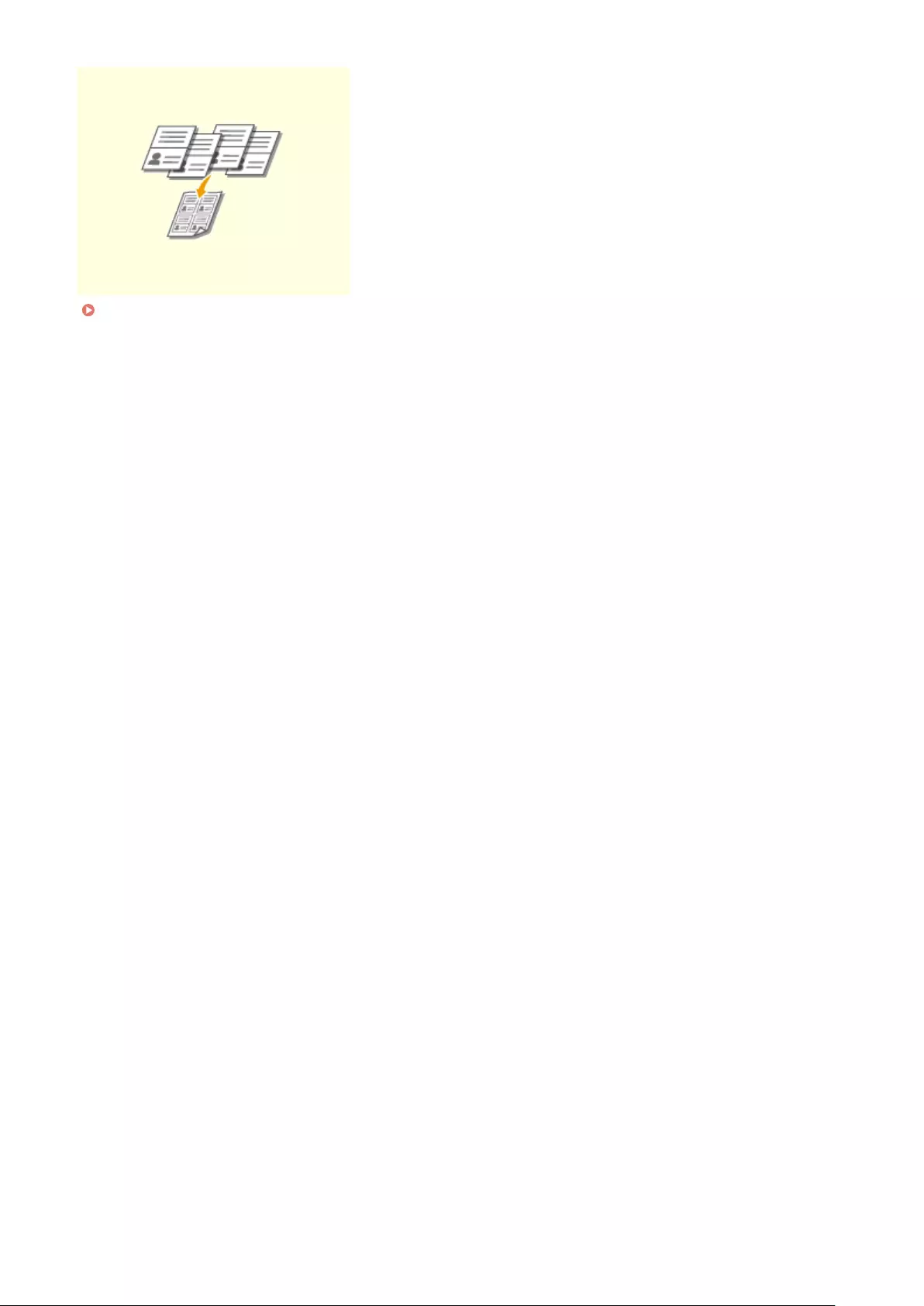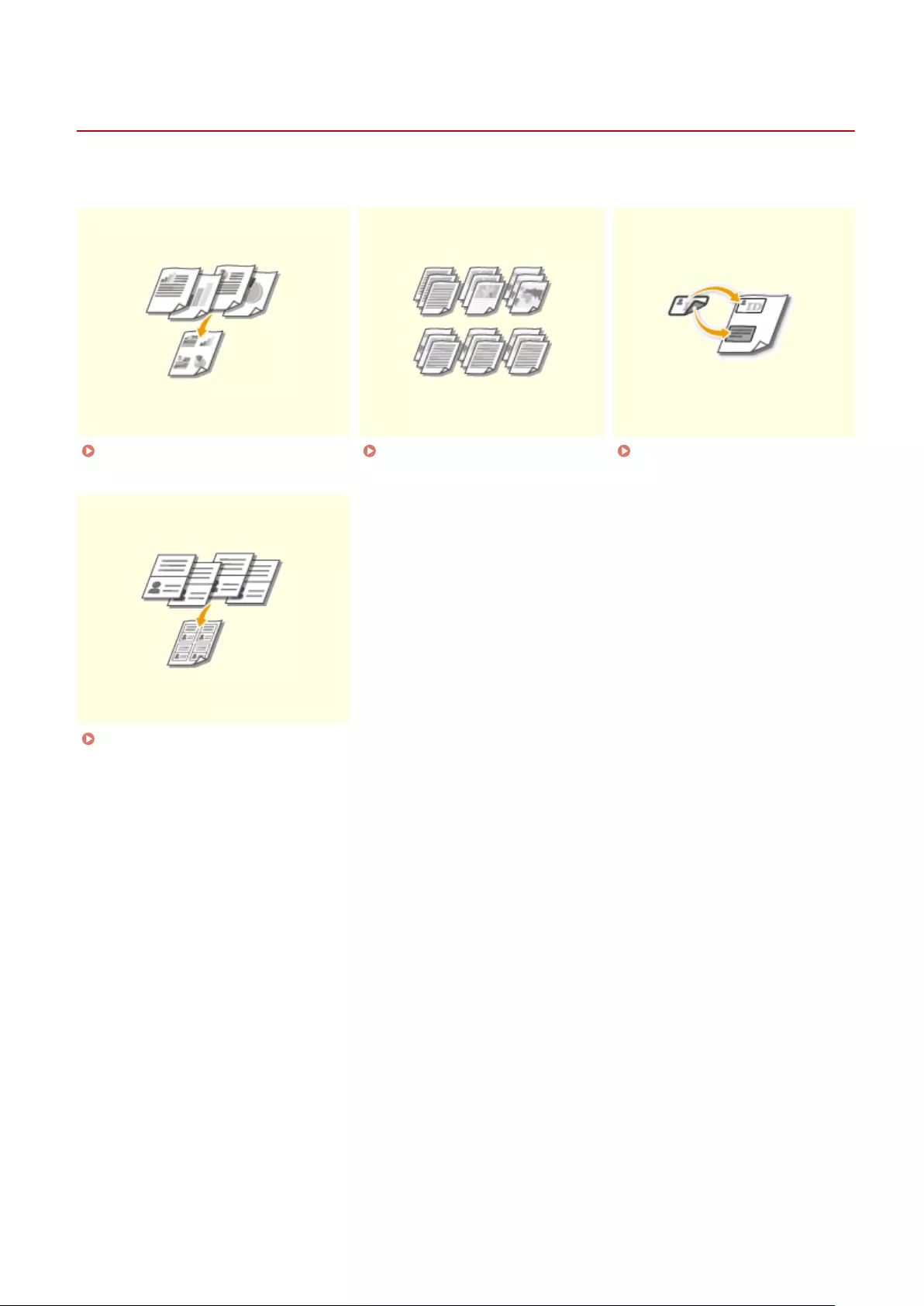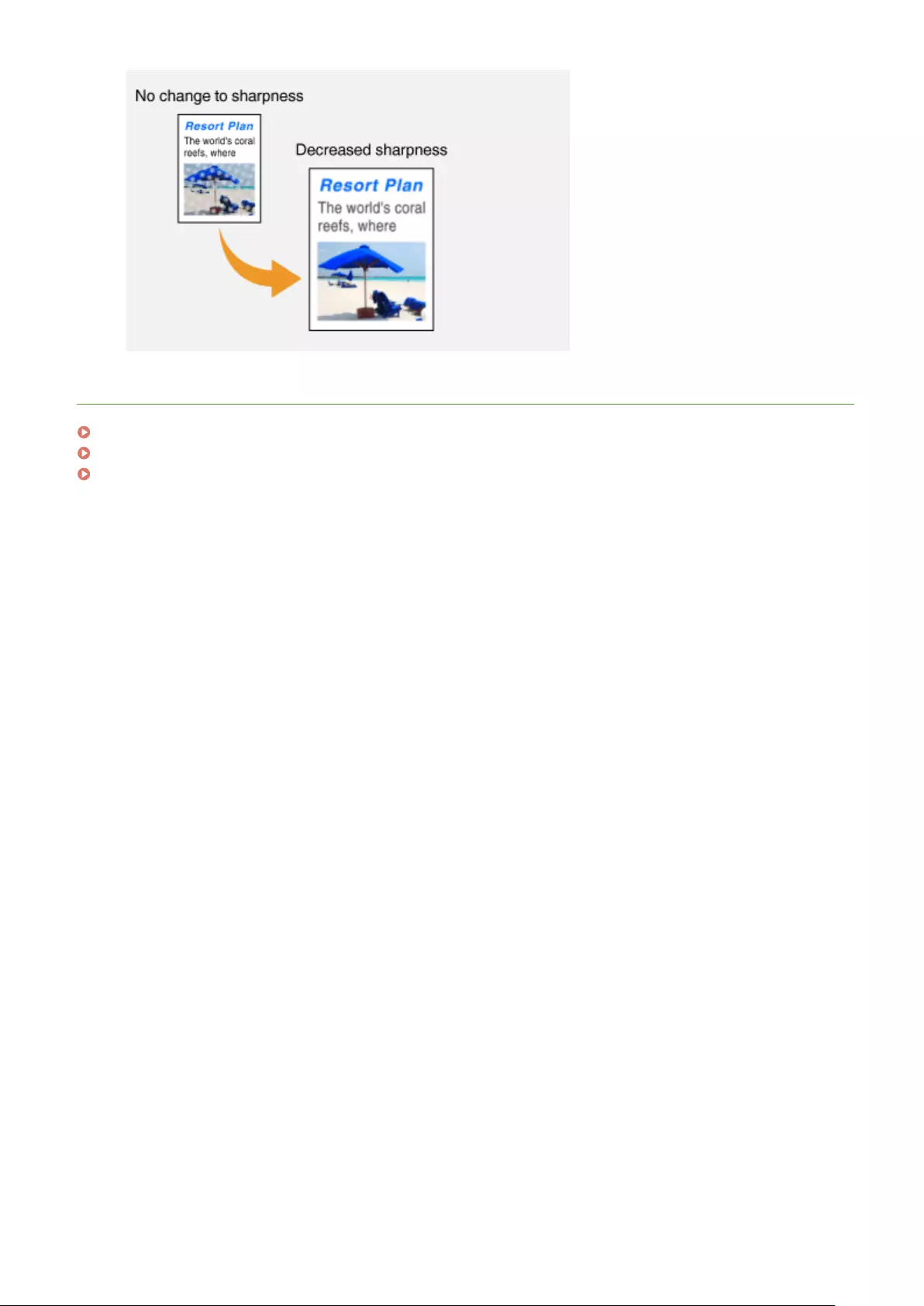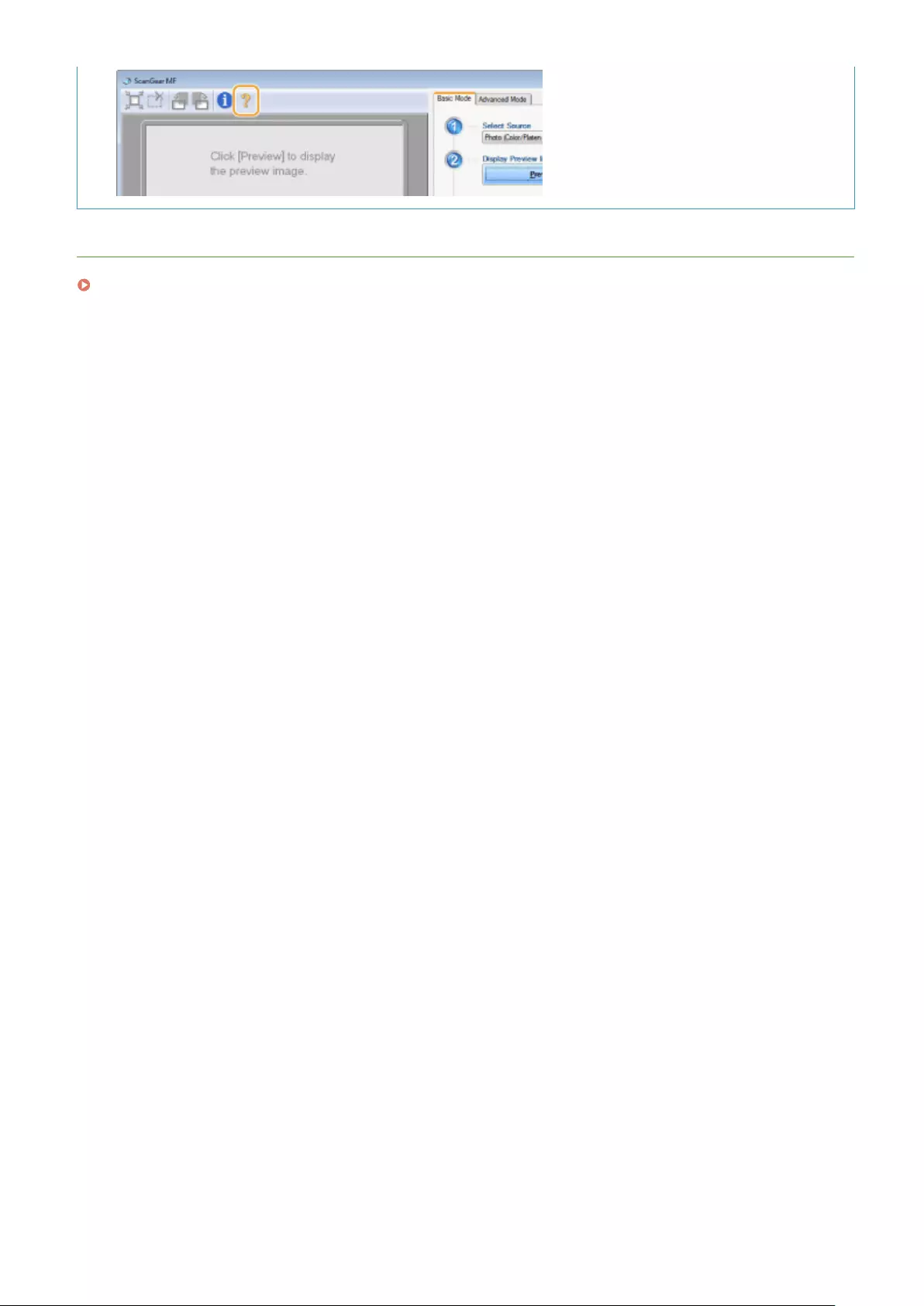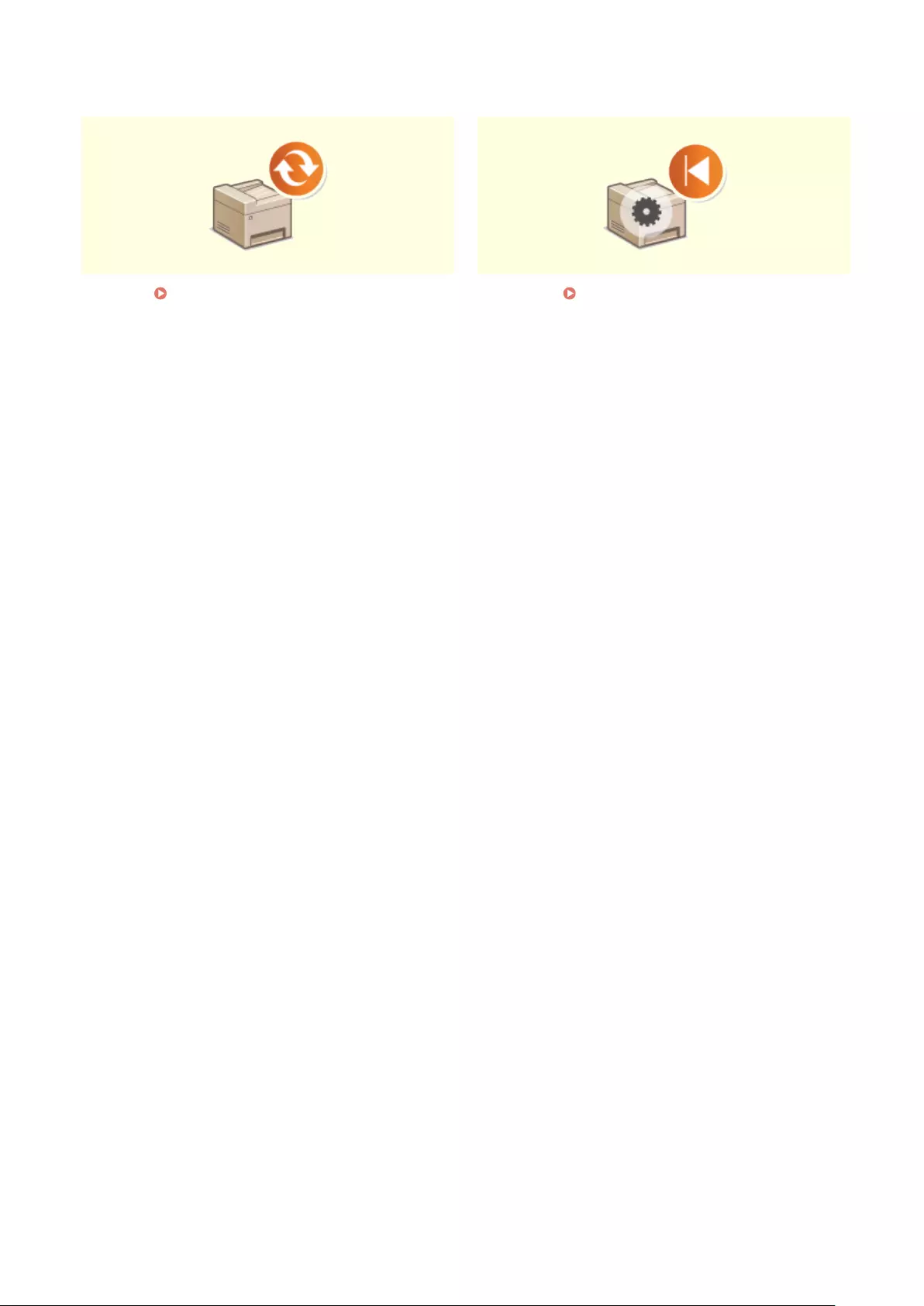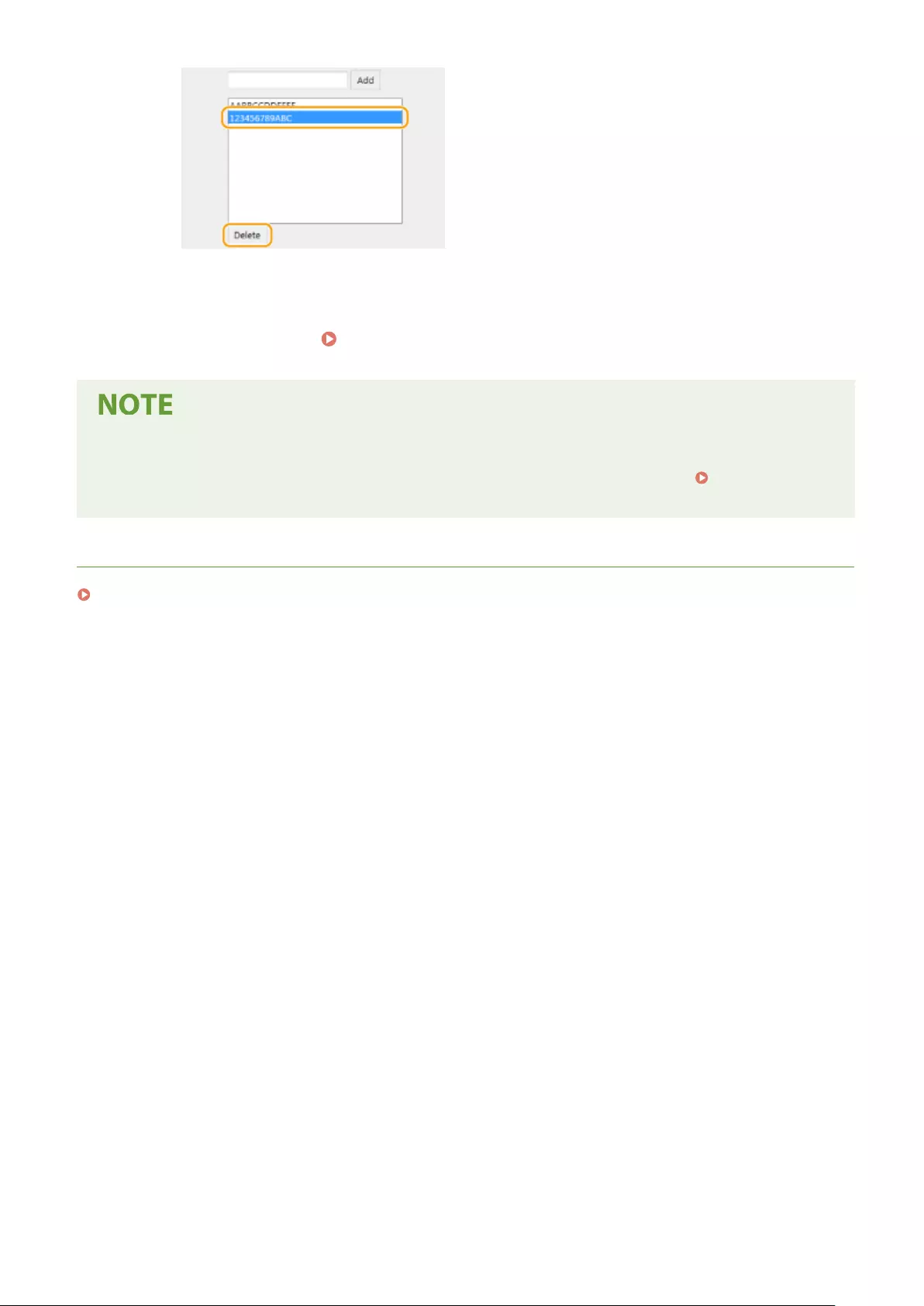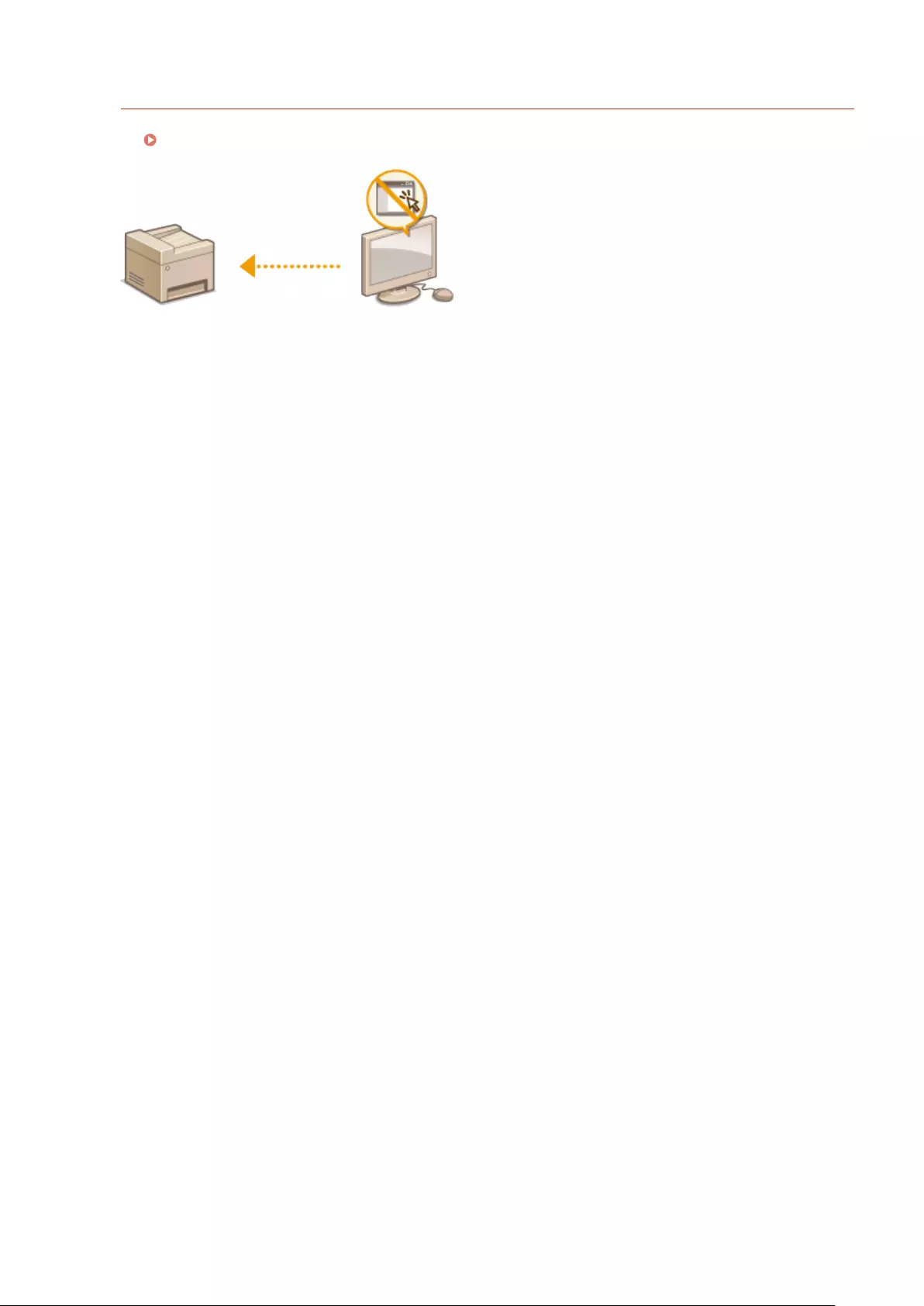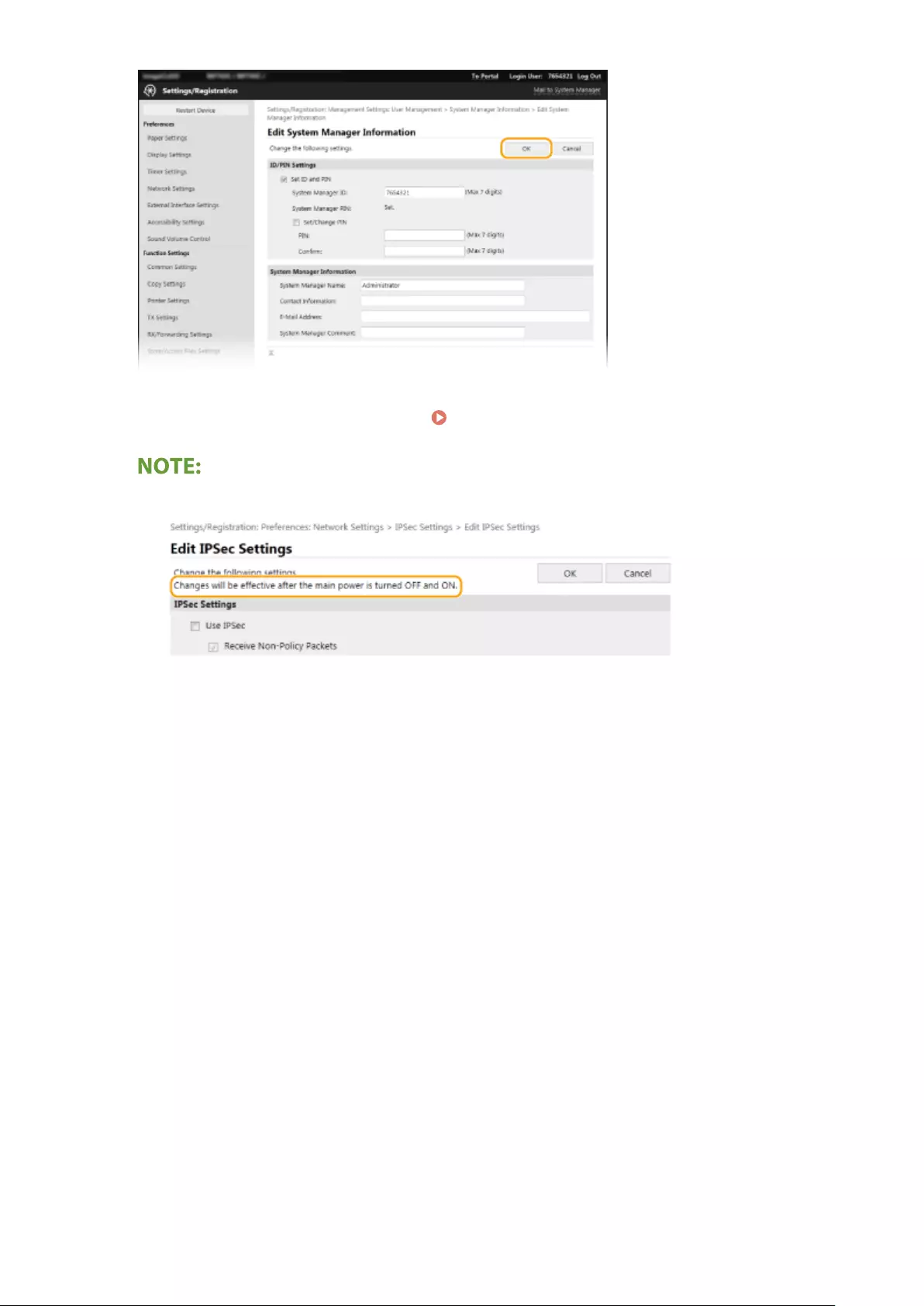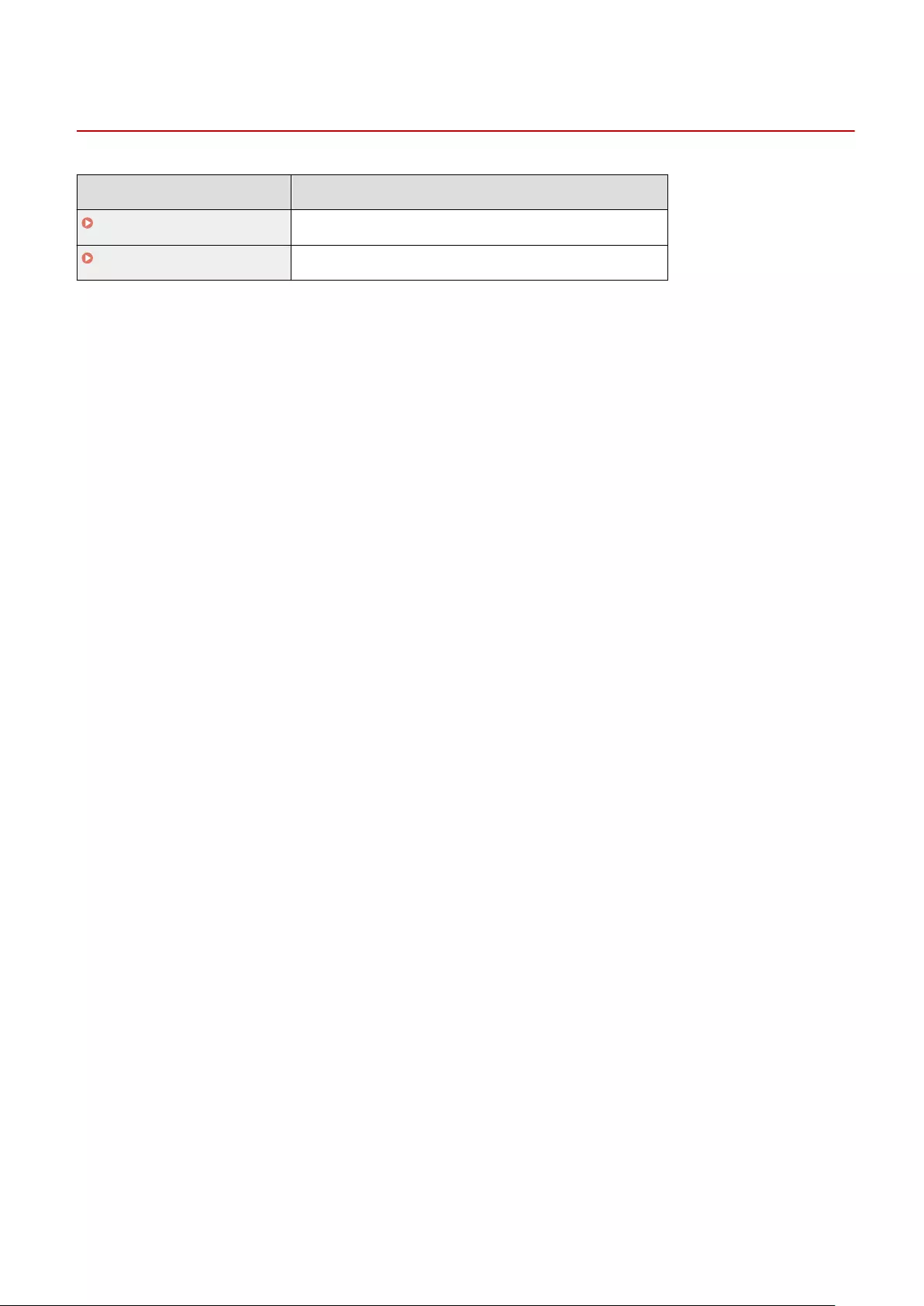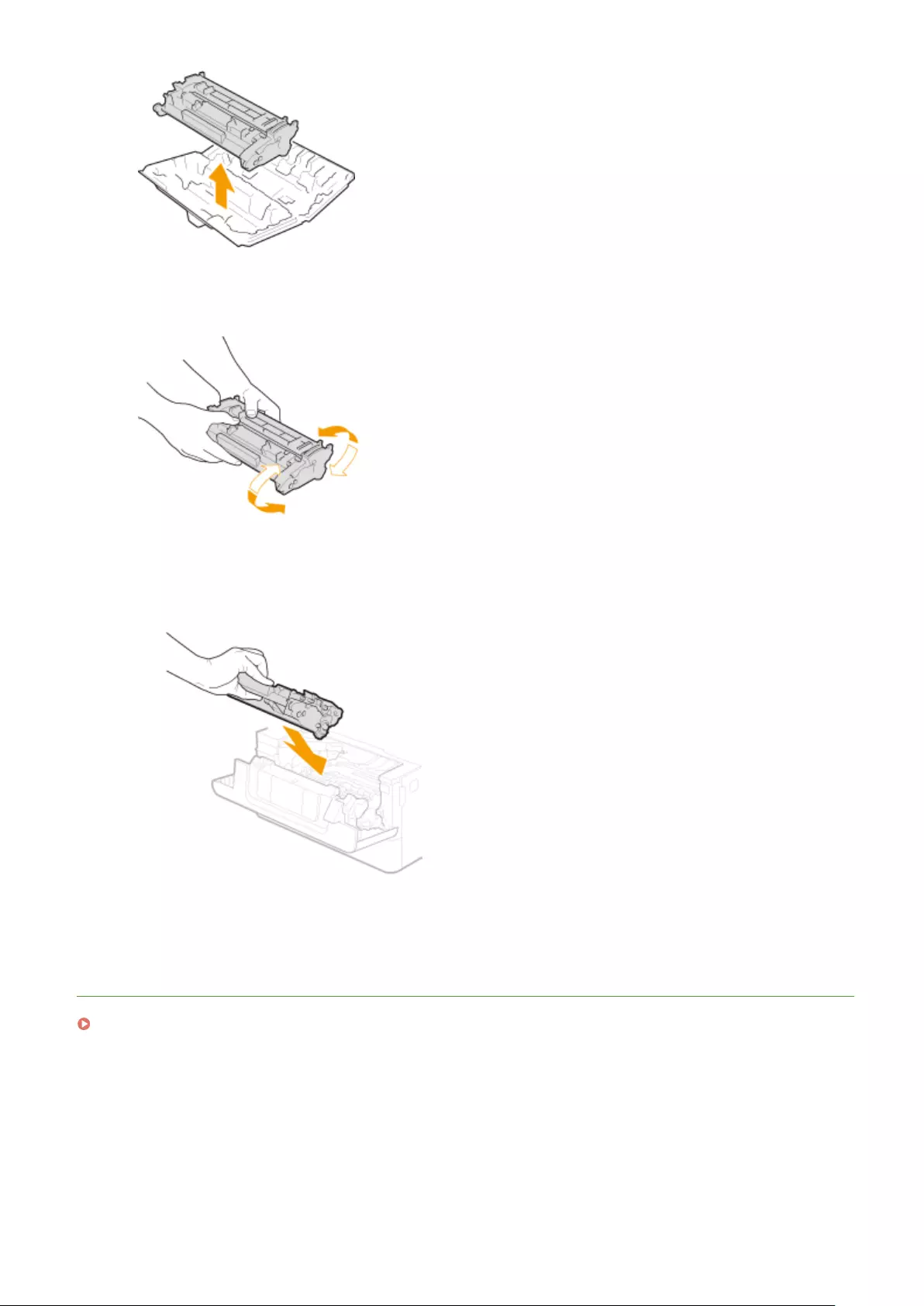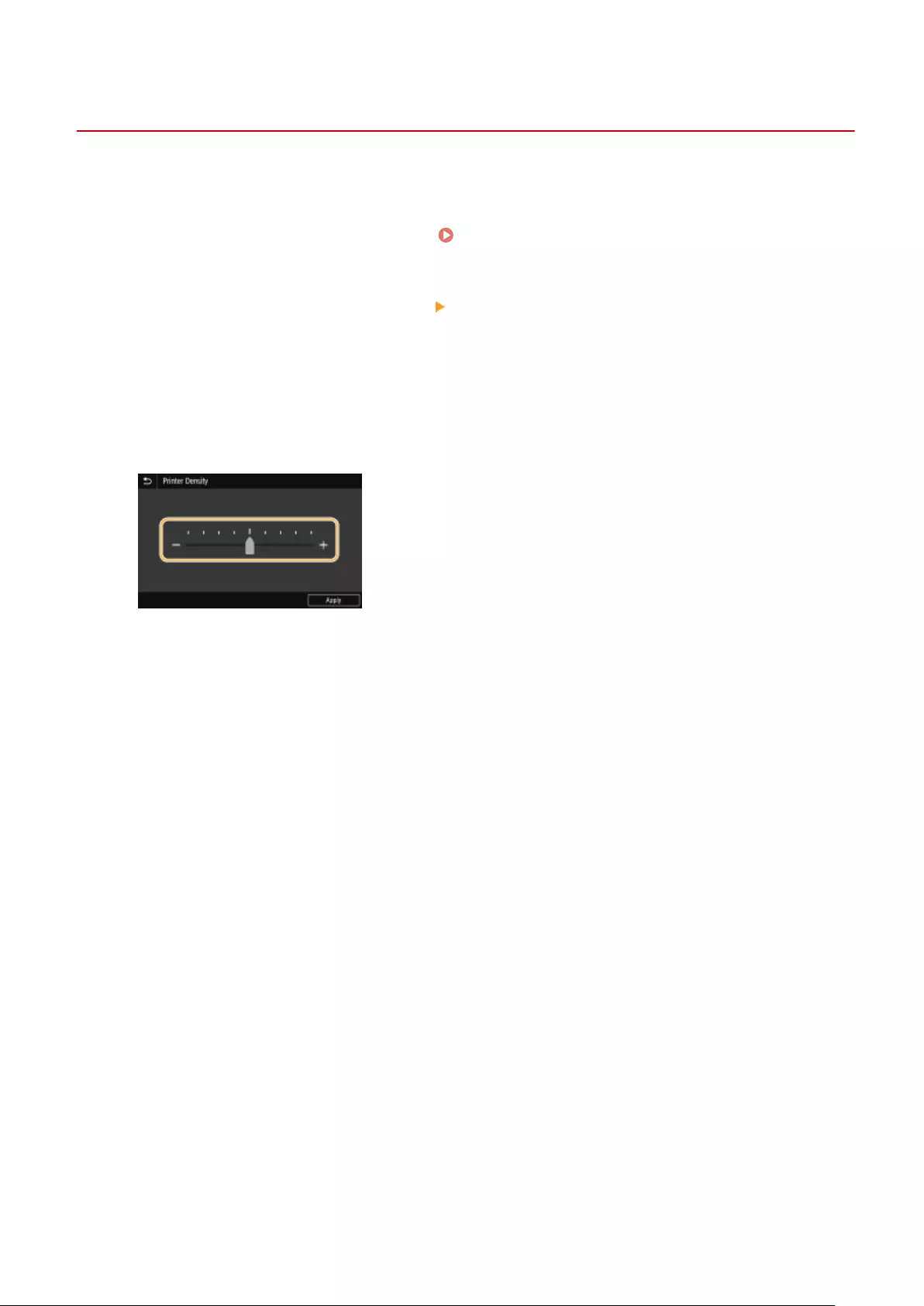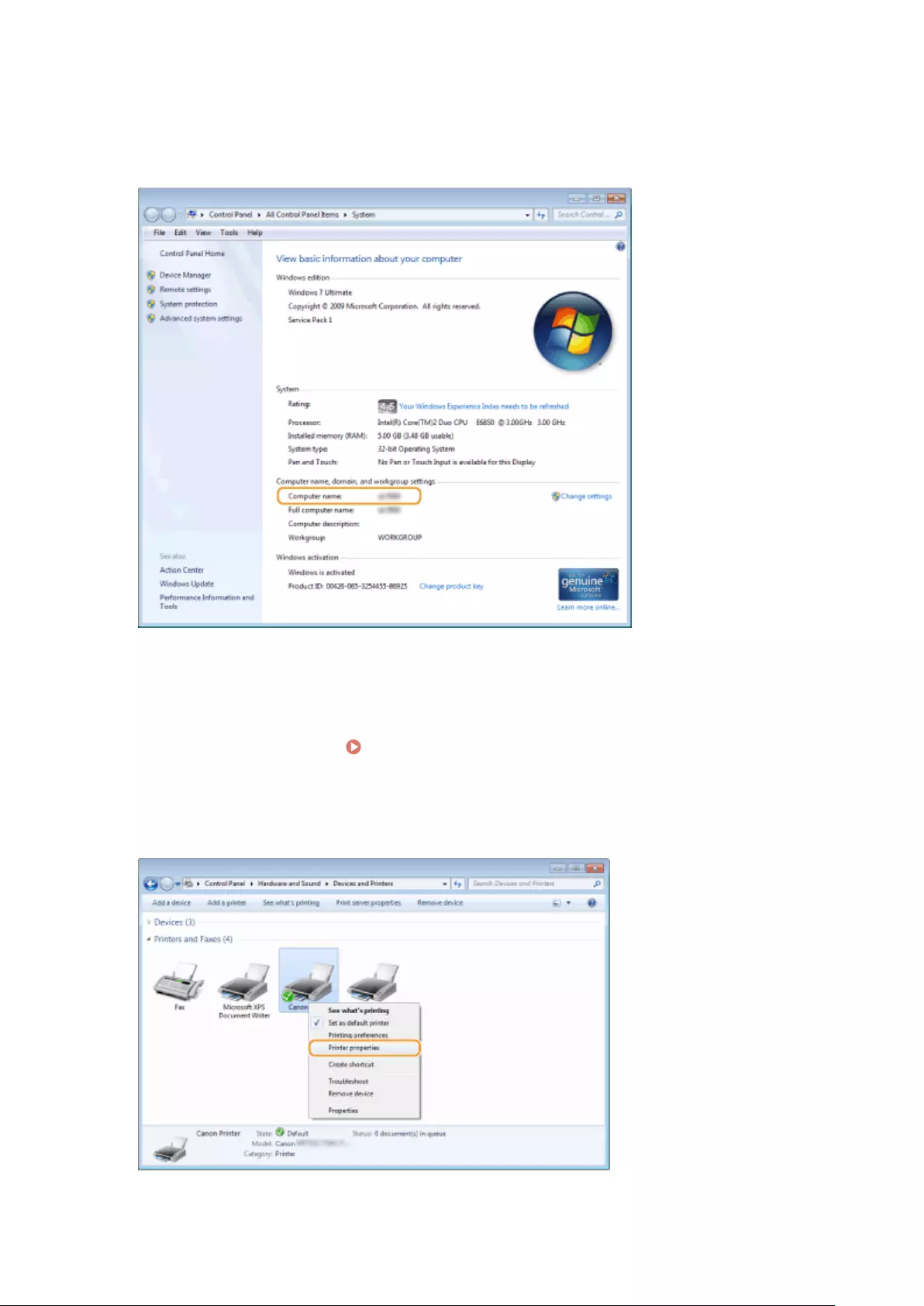Table of Contents
- Contents
- Setting Up
- Main Functions
- Preparations Required Before Use
- Preventing Unauthorized Access
- Setting Up Using the Setup Guide
- Setting the Date/Time
- Setting Up the Network Environment
- Installing Drivers
- Configuring Initial Settings for Fax Functions
- Configuring Scan Settings
- Basic Operations
- Parts and Their Functions
- Turning ON the Machine
- Using the Operation Panel
- Logging in to the Machine
- Placing Originals
- Loading Paper
- Loading Paper in the Paper Drawer
- Loading Paper in the Multi-Purpose Tray
- Loading Envelopes
- Loading Preprinted Paper
- Specifying Paper Size and Type
- Specifying Paper Size and Type in the Paper Drawer
- Specifying Paper Size and Type in the Multi-Purpose Tray
- Registering Default Paper Settings for the Multi-Purpose Tray
- Registering a Custom Paper Size
- Limiting the Paper Sizes Displayed
- Automatically Selecting an Appropriate Paper Source for Each Function
- Customizing the Display
- Changing the Default Settings for Functions
- Setting Sounds
- Entering Sleep Mode
- Registering Destinations
- Using a USB Memory Device
- Copying
- Faxing
- Printing
- Scanning
- Linking with Mobile Devices
- Managing the Machine
- Setting Access Privileges
- Configuring the Network Security Settings
- Restricting the Machine's Functions
- Increasing the Security of Documents
- Managing the Machine from a Computer (Remote UI)
- Updating the Firmware
- Initializing Settings
- Setting Menu List
- Maintenance
- Troubleshooting (FAQ)
- Appendix
- SIL OPEN FONT LICENSE
Canon X 1238i User Manual
Displayed below is the user manual for X 1238i by Canon which is a product in the Multifunctionals category. This manual has pages.
Related Manuals

1238iF / 1238i
User's Guide
USRMA-5240-00 2020-05 en Copyright CANON INC. 2020

Contents
Setting Up ............................................................................................................................................................ 3
Main Functions ......................................................................................................................................................... 4
Preparations Required Before Use ............................................................................................................................. 6
Preventing Unauthorized Access ................................................................................................................................ 8
Setting Up Using the Setup Guide ............................................................................................................................ 10
Setting the Date/Time ............................................................................................................................................. 12
Setting Up the Network Environment ...................................................................................................................... 14
Selecting Wired LAN or Wireless LAN ..................................................................................................................... 16
Connecting to a Wired LAN .................................................................................................................................. 17
Connecting to a Wireless LAN ............................................................................................................................... 18
Setting Up Connection Using WPS Push Button Mode ....................................................................................... 20
Setting Up Connection Using WPS PIN Code Mode ........................................................................................... 22
Setting Up Connection by Selecting a Wireless Router ....................................................................................... 24
Setting Up Connection by Specifying Detailed Settings ...................................................................................... 27
Checking the SSID and Network Key ............................................................................................................... 30
Setting IP Addresses ........................................................................................................................................... 31
Setting IPv4 Address ..................................................................................................................................... 32
Setting IPv6 Addresses .................................................................................................................................. 35
Viewing Network Settings .................................................................................................................................... 38
Conguring Settings for Communication with a Computer ...................................................................................... 40
Conguring Printing Protocols and WSD Functions ........................................................................................... 41
Conguring Printer Ports ............................................................................................................................... 44
Setting Up Print Server .................................................................................................................................. 48
Conguring the Machine for Your Network Environment ......................................................................................... 51
Conguring Ethernet Settings ........................................................................................................................ 52
Changing the Maximum Transmission Unit ...................................................................................................... 54
Setting a Wait Time for Connecting to a Network .............................................................................................. 55
Conguring DNS .......................................................................................................................................... 56
Conguring SMB .......................................................................................................................................... 60
Conguring WINS ......................................................................................................................................... 62
Registering LDAP Servers .............................................................................................................................. 64
Monitoring and Controlling the Machine with SNMP ......................................................................................... 69
Other Network Settings ................................................................................................................................. 73
Installing Drivers .................................................................................................................................................... 77
Conguring Initial Settings for Fax Functions ........................................................................................................... 78
Deciding Which Fax Receive Mode to Use .............................................................................................................. 79
Registering the Fax Number and Unit Name .......................................................................................................... 80
Selecting the Receive Mode .................................................................................................................................. 81
Connecting the Telephone Line ............................................................................................................................ 82
Conguring Scan Settings ....................................................................................................................................... 83
Preparing to Use the Machine as a Scanner ........................................................................................................... 84
Procedure for Setting to Send E-Mail/Send and Receive I-Fax ................................................................................... 85
Conguring Basic E-Mail Settings .................................................................................................................... 86
I

Conguring E-Mail/I-Fax Communication Settings ............................................................................................ 89
Procedure for Setting a Shared Folder as a Save Location ........................................................................................ 93
Setting a Shared Folder as a Save Location ....................................................................................................... 94
Procedure for Setting a FTP Server as a Save Location ............................................................................................. 97
Basic Operations ........................................................................................................................................ 100
Parts and Their Functions ...................................................................................................................................... 104
Front Side ........................................................................................................................................................ 105
Back Side ......................................................................................................................................................... 107
Interior ........................................................................................................................................................... 109
Feeder ............................................................................................................................................................ 110
Multi-Purpose Tray ........................................................................................................................................... 111
Paper Drawer ................................................................................................................................................... 112
Operation Panel ............................................................................................................................................... 113
Turning ON the Machine ....................................................................................................................................... 115
Turning OFF the Machine ................................................................................................................................... 116
Turning OFF the Machine by Remote Operation ............................................................................................. 117
Powering OFF at a Fixed Time ...................................................................................................................... 118
Restarting the Machine ..................................................................................................................................... 120
Using the Operation Panel .................................................................................................................................... 122
Basic Screens ................................................................................................................................................... 123
Home Screen ............................................................................................................................................. 124
<Status Monitor> Screen ............................................................................................................................. 127
Message Display ......................................................................................................................................... 129
Basic Operation ................................................................................................................................................ 130
Entering Text ................................................................................................................................................... 133
Logging in to the Machine ..................................................................................................................................... 135
Placing Originals ................................................................................................................................................... 137
Loading Paper ....................................................................................................................................................... 141
Loading Paper in the Paper Drawer .................................................................................................................... 143
Loading Paper in the Multi-Purpose Tray ............................................................................................................. 148
Loading Envelopes ............................................................................................................................................ 151
Loading Preprinted Paper .................................................................................................................................. 153
Specifying Paper Size and Type .......................................................................................................................... 157
Specifying Paper Size and Type in the Paper Drawer ....................................................................................... 158
Specifying Paper Size and Type in the Multi-Purpose Tray ................................................................................ 160
Registering Default Paper Settings for the Multi-Purpose Tray ......................................................................... 162
Registering a Custom Paper Size .................................................................................................................. 164
Limiting the Paper Sizes Displayed ................................................................................................................ 166
Automatically Selecting an Appropriate Paper Source for Each Function ............................................................ 167
Customizing the Display ........................................................................................................................................ 168
Customizing the Home Screen ........................................................................................................................... 169
Registering Frequently Used Settings .................................................................................................................. 172
Changing the Default Settings for Functions .......................................................................................................... 174
Setting Sounds ...................................................................................................................................................... 176
II

Entering Sleep Mode ............................................................................................................................................. 178
Registering Destinations ....................................................................................................................................... 180
Registering Destinations in the Address Book ...................................................................................................... 182
Registering Multiple Destinations as a Group ................................................................................................. 185
Editing the Registered Destinations in the Address Book ................................................................................. 187
Using a USB Memory Device .................................................................................................................................. 188
Copying .............................................................................................................................................................. 191
Copy Basic Features Screen ................................................................................................................................... 193
Basic Copy Operations ........................................................................................................................................... 195
Canceling Copies .............................................................................................................................................. 200
Checking the Copying Status and Log ................................................................................................................. 201
Enhancing and Adjusting Copy Quality ................................................................................................................... 203
Selecting the Type of Original for Copying ........................................................................................................... 204
Adjusting Sharpness for Copying (Sharpness) ...................................................................................................... 205
Erasing Dark Borders When Copying (Erase Frame) ............................................................................................... 206
Useful Copy Functions ........................................................................................................................................... 207
Copying Multiple Documents onto One Sheet (N on 1) .......................................................................................... 208
Collating Copies by Page ................................................................................................................................... 209
Making ID Card Copies ...................................................................................................................................... 210
Making Passport Copies .................................................................................................................................... 211
Faxing .................................................................................................................................................................. 214
Fax Basic Features Screen ...................................................................................................................................... 217
Basic Operations for Sending Faxes ....................................................................................................................... 218
Canceling Sending Faxes ................................................................................................................................... 226
Receiving Faxes .................................................................................................................................................... 227
Useful Functions When Sending ............................................................................................................................. 230
Recalling Previously Used Settings for Sending (Recall Settings) ............................................................................. 231
Sending a Fax after a Phone Call (Manual Sending) ............................................................................................... 234
Saving a Copy of a Sent Original ......................................................................................................................... 236
Various Receiving Methods .................................................................................................................................... 238
Saving Received Documents into the Machine (Memory Reception) ........................................................................ 239
Forwarding the Received Documents Automatically ............................................................................................... 241
Checking Status and Log for Sent and Received Documents .................................................................................... 244
Sending Faxes from Your Computer (PC Fax) .......................................................................................................... 246
Sending PC Faxes ............................................................................................................................................. 247
Using Internet Fax (I-Fax) ...................................................................................................................................... 249
Sending I-Faxes ................................................................................................................................................ 250
Receiving I-Faxes .............................................................................................................................................. 257
Printing .............................................................................................................................................................. 259
Printing from a Computer ..................................................................................................................................... 260
Canceling Prints ............................................................................................................................................... 262
III

Checking the Printing Status and Log .................................................................................................................. 264
Various Printing Methods ...................................................................................................................................... 266
Printing a Document Secured by a PIN (Secure Print) ............................................................................................ 267
Printing via Secure Print .............................................................................................................................. 268
Printing from a USB Memory Device (Memory Media Print) .................................................................................... 271
Scanning ........................................................................................................................................................... 280
Scan Basic Features Screen .................................................................................................................................... 282
Basic Operations for Scanning Originals ................................................................................................................ 285
Scanning and Saving to a Computer .................................................................................................................... 286
Saving Data to a USB Memory Device .................................................................................................................. 288
Sending Data by E-Mail/Saving Data to a Shared Folder or FTP Server ..................................................................... 292
Canceling Sending Documents ........................................................................................................................... 302
Checking Status and Log for Scanned Originals .................................................................................................... 303
Scanning Clearly ................................................................................................................................................... 305
Adjusting Image Quality .................................................................................................................................... 306
Adjusting Density ............................................................................................................................................. 307
Adjusting Sharpness When Scanning (Sharpness) ................................................................................................. 308
Useful Scanning Functions .................................................................................................................................... 310
Enhancing the Security of Electronic Files ............................................................................................................ 311
Adjusting Balance between File Size and Image Quality (Data Size) ......................................................................... 314
Conguring a File Name .................................................................................................................................... 315
Recalling Previously Used Settings for Sending/Saving (Recall Settings) ................................................................... 316
Specifying E-Mail Settings .................................................................................................................................. 319
Using Your Computer to Scan (Remote Scan) .......................................................................................................... 322
Scanning Documents from an Application ........................................................................................................... 323
Using ScanGear MF ........................................................................................................................................... 325
Using WSD ....................................................................................................................................................... 326
Scanning Originals Using WSD (WSD Scan) .................................................................................................... 328
Linking with Mobile Devices ............................................................................................................ 332
Connecting with Mobile Devices ............................................................................................................................ 333
Connecting via a Wireless LAN Router (LAN Connection) ........................................................................................ 334
Connecting Directly (Access Point Mode) ............................................................................................................. 336
Utilizing the Machine through Applications ........................................................................................................... 339
Using AirPrint ....................................................................................................................................................... 341
Printing with AirPrint ........................................................................................................................................ 346
Scanning with AirPrint ....................................................................................................................................... 349
Faxing with AirPrint .......................................................................................................................................... 351
If AirPrint Cannot Be Used ................................................................................................................................. 353
Using Google Cloud Print ....................................................................................................................................... 354
Printing with Default Print Service (Android) .......................................................................................................... 356
Managing the Machine by the Remote Control ....................................................................................................... 357
IV

Managing the Machine ........................................................................................................................ 360
Setting Access Privileges ....................................................................................................................................... 362
Setting the System Manager ID and PIN .............................................................................................................. 363
Setting the Department ID Management ............................................................................................................. 365
Setting a Remote UI PIN .................................................................................................................................... 371
LDAP Server Authentication ............................................................................................................................... 373
Conguring the Network Security Settings ............................................................................................................ 377
Restricting Communication by Using Firewalls ..................................................................................................... 379
Specifying IP Addresses for Firewall Settings .................................................................................................. 380
Specifying MAC Addresses for Firewall Settings .............................................................................................. 383
Changing Port Numbers .................................................................................................................................... 386
Setting a Proxy ................................................................................................................................................. 387
Conguring the Key and Certicate for TLS .......................................................................................................... 389
Generating the Key and Certicate for Network Communication ...................................................................... 392
Generating a Key and Certicate Signing Request (CSR) ................................................................................... 395
Registering the Key and Certicate for Network Communication ...................................................................... 398
Conguring IPSec Settings ................................................................................................................................. 400
Conguring IEEE 802.1X Authentication Settings .................................................................................................. 407
Restricting the Machine's Functions ...................................................................................................................... 411
Restricting Access to Address Book and Sending Functions .................................................................................... 413
Restricting Use of the Address Book ............................................................................................................. 414
Limiting Available Destinations ..................................................................................................................... 416
Restricting the Fax Sending Functions ........................................................................................................... 418
Restricting Printing from a Computer .................................................................................................................. 420
Restricting USB Functions .................................................................................................................................. 421
Disabling HTTP Communication ......................................................................................................................... 423
Disabling Remote UI ......................................................................................................................................... 424
Increasing the Security of Documents .................................................................................................................... 425
Generating a Device Signature Key ..................................................................................................................... 426
Managing the Machine from a Computer (Remote UI) ............................................................................................ 427
Starting Remote UI ........................................................................................................................................... 428
Checking the Status and Logs ............................................................................................................................ 431
Setting Up Menu Options from Remote UI ........................................................................................................... 437
Registering Destinations from Remote UI ............................................................................................................ 440
Security Policy .................................................................................................................................................. 444
Importing/Exporting the Setting Data ................................................................................................................. 450
Updating the Firmware ......................................................................................................................................... 453
Initializing Settings ............................................................................................................................................... 455
Setting Menu List ...................................................................................................................................... 458
<Preferences> ....................................................................................................................................................... 459
<Display Settings> ............................................................................................................................................ 460
<English Keyboard Layout> ................................................................................................................................ 466
<Timer/Energy Settings> ................................................................................................................................... 467
V

<Network> ....................................................................................................................................................... 472
<External Interface> .......................................................................................................................................... 487
<Accessibility> .................................................................................................................................................. 488
<Adjustment/Maintenance> .................................................................................................................................. 489
<Adjust Image Quality> ..................................................................................................................................... 490
<Maintenance> ................................................................................................................................................ 499
<Function Settings> .............................................................................................................................................. 500
<Common> ...................................................................................................................................................... 501
<Copy> ............................................................................................................................................................ 507
<Printer> ......................................................................................................................................................... 509
<Send> ............................................................................................................................................................ 534
<Receive/Forward> ........................................................................................................................................... 547
<Store/Access Files> .......................................................................................................................................... 554
<Secure Print> .................................................................................................................................................. 560
<Set Destination> .................................................................................................................................................. 561
<Management Settings> ....................................................................................................................................... 562
<User Management> ........................................................................................................................................ 563
<Device Management> ...................................................................................................................................... 564
<License/Other> ............................................................................................................................................... 567
<Data Management> ........................................................................................................................................ 569
<Security Settings> ........................................................................................................................................... 571
Maintenance ................................................................................................................................................. 574
Regular Cleaning .................................................................................................................................................. 576
Cleaning the Exterior ........................................................................................................................................ 577
Cleaning the Platen Glass .................................................................................................................................. 578
Cleaning the Feeder .......................................................................................................................................... 579
Cleaning the Fixing Assembly ............................................................................................................................. 582
Replacing the Toner Cartridge ............................................................................................................................... 583
Checking the Remaining Amount of Consumables .................................................................................................. 587
Adjusting Image Quality ....................................................................................................................................... 588
Adjusting the Gradation and Density for Copy Jobs ............................................................................................... 589
Adjusting Values for Text Color Reproducibility ..................................................................................................... 591
Adjusting Print Density ...................................................................................................................................... 593
Adjusting Print Position ..................................................................................................................................... 594
Viewing the Counter Value .................................................................................................................................... 596
Printing Reports and Lists ..................................................................................................................................... 597
Replacement Parts ................................................................................................................................................ 602
Troubleshooting (FAQ) .......................................................................................................................... 605
Appendix ........................................................................................................................................................... 607
Third Party Software ............................................................................................................................................. 609
VI

Feature Highlights ................................................................................................................................................ 610
Going Green and Saving Money ......................................................................................................................... 611
Improving Eciency ......................................................................................................................................... 613
Going Digital .................................................................................................................................................... 615
So Much More .................................................................................................................................................. 617
Specications ....................................................................................................................................................... 619
Main Unit ........................................................................................................................................................ 620
Feeder ............................................................................................................................................................ 623
Available Paper ................................................................................................................................................ 624
Cassette Feeding Module-AH ............................................................................................................................. 627
Copy Card Reader-F .......................................................................................................................................... 628
Fax Function .................................................................................................................................................... 629
Scan Function .................................................................................................................................................. 630
Printer Functions .............................................................................................................................................. 631
Management Functions ..................................................................................................................................... 633
System Environment ......................................................................................................................................... 635
Network Environment ....................................................................................................................................... 637
Options ................................................................................................................................................................ 638
Optional Equipment .......................................................................................................................................... 639
System Options ................................................................................................................................................ 641
Manuals and Their Contents .................................................................................................................................. 643
Using User's Guide ................................................................................................................................................ 644
Screen Layout of User's Guide ............................................................................................................................ 645
Viewing User's Guide ........................................................................................................................................ 648
Basic Windows Operations .................................................................................................................................... 649
Notice .................................................................................................................................................................. 657
VII

Setting Up
Setting Up ............................................................................................................................................................... 3
Main Functions ...................................................................................................................................................... 4
Preparations Required Before Use ....................................................................................................................... 6
Preventing Unauthorized Access .......................................................................................................................... 8
Setting Up Using the Setup Guide ...................................................................................................................... 10
Setting the Date/Time ......................................................................................................................................... 12
Setting Up the Network Environment ............................................................................................................... 14
Selecting Wired LAN or Wireless LAN .............................................................................................................. 16
Connecting to a Wired LAN ............................................................................................................................. 17
Connecting to a Wireless LAN ......................................................................................................................... 18
Setting Up Connection Using WPS Push Button Mode ............................................................................. 20
Setting Up Connection Using WPS PIN Code Mode .................................................................................. 22
Setting Up Connection by Selecting a Wireless Router ............................................................................. 24
Setting Up Connection by Specifying Detailed Settings ............................................................................ 27
Checking the SSID and Network Key ........................................................................................................ 30
Setting IP Addresses ....................................................................................................................................... 31
Setting IPv4 Address ................................................................................................................................ 32
Setting IPv6 Addresses ............................................................................................................................ 35
Viewing Network Settings ............................................................................................................................... 38
Conguring Settings for Communication with a Computer ............................................................................ 40
Conguring Printing Protocols and WSD Functions ................................................................................. 41
Conguring Printer Ports ......................................................................................................................... 44
Setting Up Print Server ............................................................................................................................ 48
Conguring the Machine for Your Network Environment ............................................................................... 51
Conguring Ethernet Settings ................................................................................................................. 52
Changing the Maximum Transmission Unit ............................................................................................. 54
Setting a Wait Time for Connecting to a Network .................................................................................... 55
Conguring DNS ...................................................................................................................................... 56
Conguring SMB ...................................................................................................................................... 60
Conguring WINS .................................................................................................................................... 62
Registering LDAP Servers ......................................................................................................................... 64
Monitoring and Controlling the Machine with SNMP ............................................................................... 69
Other Network Settings ........................................................................................................................... 73
Installing Drivers ................................................................................................................................................. 77
Conguring Initial Settings for Fax Functions ................................................................................................... 78
Deciding Which Fax Receive Mode to Use ....................................................................................................... 79
Setting Up
1

Registering the Fax Number and Unit Name .................................................................................................. 80
Selecting the Receive Mode ............................................................................................................................ 81
Connecting the Telephone Line ...................................................................................................................... 82
Conguring Scan Settings ................................................................................................................................... 83
Preparing to Use the Machine as a Scanner ................................................................................................... 84
Procedure for Setting to Send E-Mail/Send and Receive I-Fax ......................................................................... 85
Conguring Basic E-Mail Settings ............................................................................................................ 86
Conguring E-Mail/I-Fax Communication Settings ................................................................................... 89
Procedure for Setting a Shared Folder as a Save Location .............................................................................. 93
Setting a Shared Folder as a Save Location .............................................................................................. 94
Procedure for Setting a FTP Server as a Save Location ................................................................................... 97
Setting Up
2

Setting Up
6FR5-000
Before using the functions of the machine, the environmental conditions must be set in advance. To begin with, check
the sequences of ow required to complete the setup, and then perform the actual settings. Preparations Required
Before Use(P. 6)
●The functions installed on the machine vary depending on the model you purchased. Before using the
machine, see Main Functions(P. 4) and check the available functions.
Conguring Initial Settings of the Machine (Setup Guide)
●You can easily congure the initial settings required to use the machine, such as date, time, and network
settings, by following the on-screen guidance. Setting Up Using the Setup Guide(P. 10)
Setting Up
3

Main Functions
6FR5-001
This manual covers all the functions of the model series you purchased. Before getting started, check which functions
are available on the model you purchased.
: With function : Without function
Function 1238iF 1238i
Copy
Print
Fax
Scan
2-sided printing
Forward received faxes
Send scanned data (e-Mail/SMB/FTP)
Wired LAN connection
Wireless LAN connection
USB connection
Remote UI
Keys and Certicates
Linking with Mobile Devices
Display Touch panel Touch panel
Feeder Feeder (2-sided scanning) Feeder (2-sided scanning)
Default System Manager ID 7654321 7654321
Default System Manager PIN 7654321 7654321
Department ID Management
Application Library
Cassette Feeding Module-AH Optional Optional
TELEPHONE 6 KIT Optional
Copy Card Reader-F Optional Optional
Setting Up
4

Preparations Required Before Use
6FR5-002
Set up the machine following steps 1 to 5 in order. For more information about a particular step, click on the link to go
to the corresponding section. In addition, to use the machine safely, also check Preventing Unauthorized
Access(P. 8) .
Step 1 Setting Up Using the Setup Guide(P. 10)
Step 2 Setting Up the Network Environment(P. 14)
●Congure the network settings that are not covered in the Setup Guide. If you do not need
to use the Setup Guide, congure the network settings from here.
Step 3 Installing Drivers(P. 77)
Step 4 Conguring Initial Settings for Fax Functions(P. 78)
Step 5 Conguring Scan Settings(P. 83)
Setting Up
6

Setting from the Remote UI
●When the network environment settings are complete, you can eciently set the machine from a computer
using Remote UI. Starting Remote UI(P. 428)
Importing data from another machine to save time
●As long as the model is the same, you can save setting data registered on another Canon printer/
multifunction machine to a computer (export) and load the setting data to this machine (import).
Importing/Exporting the Setting Data(P. 450)
Setting Up
7

Preventing Unauthorized Access
6FR5-003
This section describes the security measures on how to prevent unauthorized access from the external network. This is
a must-read for all users and administrators before using this machine, other printers, and multifunction machines
connected to the network. In recent years, a printer/multifunction machine connected to the network can offer you a
variety of useful functions, such as printing from a computer, operating from a computer using the remote function,
and sending scanned documents via the Internet. On the other hand, it is essential to take security measures to
reduce the security risk for information leakage, as a printer/multifunction machine has become more exposed to
threats, such as unauthorized access and theft, when it is connected to the network. This section explains necessary
settings you need to specify to prevent unauthorized access before using a printer/multifunction machine connected
to the network.
Security Measures to Prevent Unauthorized Access from the External Network
Assigning a Private IP Address(P. 8)
Using Firewall to Restrict Transmission(P. 9)
Specifying the TLS Encrypted Communication (P. 9)
Setting PIN to Manage Information Stored in the Multifunction Machine(P. 9)
Assigning a Private IP Address
An IP address is a numerical label assigned to each device participating in a computer network. A "global IP address" is
used for the communication connecting to the Internet, and a "private IP address" is used for the communication
within a local area network, such as a LAN in the company. If a global IP address is assigned, your printer/
multifunction machine is open to the public and can be accessed via the Internet. Thus, the risk of information leakage
due to unauthorized access from external network increases. On the other hand, if a private IP address is assigned,
your printer/multifunction machine is closed to a local area network and can be accessed by only users on your local
area network, such as a LAN in the company.
Global IP Address
Can be accessed from the external network
Private IP Address
Can be accessed from the users within a local area network
Basically, assign a private IP address to your printer/multifunction machine. Make sure to conrm the IP address,
assigned to the printer/multifunction machine you are using, is a private IP address or not. A private IP address is
found in one of the following ranges.
Ranges for Private IP addresses
●From 10.0.0.0 to 10.255.255.255
●From 172.16.0.0 to 172.31.255.255
●From 192.168.0.0 to 192.168.255.255
For information on how to conrm the IP address, see Setting IPv4 Address(P. 32) .
●If a global IP address is assigned to a printer/multifunction machine, you can create a network environment
to reduce the risk of unauthorized access by installing security software, such as a rewall that prevents
Setting Up
8

access from the external networks. If you want to assign a global IP address to and use a printer/
multifunction machine, contact your network administrator.
Using Firewall to Restrict Transmission
A rewall is a system that prevents unauthorized access from the external networks and protects against attacks/
intrusions to a local area network. You can use a rewall on your network environment to block access from the
external network that appears to be dangerous, by restricting communication from specied IP address of the
external network. The function installed to a Canon printer/multifunction machine enables you to set up the IP
address lter. For information on how to set up an IP address lter, see Specifying IP Addresses for Firewall
Settings(P. 380) .
Specifying the TLS Encrypted Communication
For information on the TLS Encrypted Communication, see Conguring the Network Security Settings(P. 377) ,
and on the procedures to specify, see Conguring the Key and Certicate for TLS(P. 389) .
Setting PIN to Manage Information Stored in the Multifunction Machine
If a malicious third party attempts to gain unauthorized access to a printer/multifunction machine, setting PIN to
information stored in the machine will reduce the risk of information leakage. Canon printers/multifunction machines
enable you to protect various type of information by setting PIN.
Setting PIN to Each Function
●Setting PIN for Using Remote UI
For more information, see Setting a Remote UI PIN(P. 371) .
●Setting PIN for the System Manager Settings
For more information, see Setting the System Manager ID and PIN(P. 363) .
●Address Book PIN
For more information on setting a PIN, see Restricting Use of the Address Book(P. 414) .
Listed above are some examples of security measures for preventing unauthorized access. For more information on
the other security measures, see Managing the Machine(P. 360) and take necessary security measures for
preventing unauthorized access to suit your environment.
Setting Up
9

Setting Up Using the Setup Guide
6FR5-004
1660-009
When the machine is turned on ( Turning ON the Machine(P. 115) ) for the rst time, the Setup Guide starts up to
assist you to congure the initial settings of the machine by following the on-screen guidance. In the Setup Guide, the
setting screens are displayed in the following order.
Step 1 Setting the Display Language and the Country or Region
Set the language to be displayed on the operation panel screen or in reports, as well as the
country or region where the machine will be used.
1Select a language.
2Select <Yes>.
3Select a country or region.
Step 2 Setting the Date and Time
Adjust the machine's date/time.
1Select a time zone.
What is UTC?
●Coordinated Universal Time (UTC) is the primary time standard by which the
world regulates clocks and time. The correct UTC time zone setting is required
for Internet communications.
2Enter the date and time, and select <Apply>.
●Tap the entry eld, and enter the date and time.
Step 3 Setting the Access Security Measures
Set a PIN to access the Remote UI. Because the Remote UI can be used to change the machine
settings from a computer, setting of a PIN is recommended.
1Select <Yes>.
●If you select <No>, PIN is not set, and the Setup Guide proceeds to step 4.
●You can also set the access security measure of the Remote UI later. Setting
a Remote UI PIN(P. 371)
2Enter a PIN, and then select <Apply>.
3Enter the same PIN, and then select <Apply>.
Step 4 Setting the Wireless LAN
Congure the settings to connect to the network using the wireless LAN.
1Select <Yes>.
●If you select <No>, wireless LAN is not set, and the Setup Guide proceeds to
step 5.
2Select <OK>.
Setting Up
10

3Select the setting method.
●For more information about the wireless LAN settings, see Connecting to a
Wireless LAN(P. 18) .
Step 5 Viewing Application Library
The one-touch button referred to as "Application Library" is provided in the Home screen. You
can read the description of each function.
1To nish the Setup Guide, select <End>.
➠When the Setup Guide is complete, the Home screen appears.
Setting Up
11

Setting the Date/Time
6FR5-005
Set the date and time for the machine. The date and time are used as the reference for the functions specifying the
time, therefore, they need to be set accurately.
Setting the Time Zone(P. 12)
Setting the Current Date and Time(P. 12)
Setting the Daylight Saving Time(P. 13)
Setting the Time Zone
If the time zone setting is changed, the values set in <Current Date/Time Settings> are also changed accordingly.
1Select <Menu> in the Home screen. Home Screen(P. 124)
2Select <Preferences> <Timer/Energy Settings> <Date/Time Settings> <Time
Zone>.
3Select the time zone.
What is UTC?
●Coordinated Universal Time (UTC) is the primary time standard by which the world regulates clocks and
time. Time differences exist depending on the country or area where the machine is used. The correct UTC
time zone setting is required for Internet communications.
Setting the Current Date and Time
1Select <Menu> in the Home screen. Home Screen(P. 124)
2Select <Preferences> <Timer/Energy Settings> <Current Date/Time Settings>.
3Enter the date and time.
●Tap the entry eld, and enter the date and time.
Setting Up
12

4Select <Apply>.
●Set <Time Zone> before setting the current date and time. If the <Time Zone> setting is changed later, the
current date and time are also changed accordingly.
●The display format of the date and time can be changed, respectively.
<Date Format>(P. 468)
<Time Format>(P. 468)
Setting the Daylight Saving Time
If daylight saving time is enabled, specify the dates from which and to which daylight saving time is in effect.
1Select <Menu> in the Home screen. Home Screen(P. 124)
2Select <Preferences> <Timer/Energy Settings> <Date/Time Settings> <Daylight
Saving Time Settings>.
3Select <Off> or <On> in <Daylight Saving Time>.
●When you select <On>, select <Start Date> and <End Date>, and set the month and day for each item. To set
the day, specify "what day of which week."
4Select <Apply>.
Setting Up
13

Setting Up the Network Environment
6FR5-006
When connecting the machine to a wired or wireless local area network (LAN), you need to set an IP address unique to
the selected network. Select "wired" or "wireless" depending on your communication environment and networking
devices. For specic IP address settings, contact your Internet service provider or Network Administrator.
●If the machine is connected to an unsecured network, your personal information might be leaked to a third
party.
●The machine cannot connect to both wired and wireless LANs at the same time.
●The machine does not come with a LAN cable or router. Have them ready as necessary.
●For more information about your networking devices, see the instruction manuals for the devices or contact
your manufacturer.
◼Before You Start
Follow these steps to connect the machine to a network.
Check your computer settings.
●Make sure that the computer is correctly connected to the network. For more
information, see the instruction manuals for the devices you are using, or contact the
device manufacturers.
●Make sure that the network settings have been completed on the computer. If the
network has not been set up properly, you will not be able to use the machine on the
network, even if you perform the rest of the procedure below.
●Depending on the network, you may need to change settings for the communication
method or the Ethernet type ( Conguring Ethernet Settings(P. 52) ). For more
information, contact your Internet service provider or Network Administrator.
●To check the MAC address of the machine.
Viewing the MAC Address for Wired LAN(P. 38)
Viewing the MAC Address and Information for Wireless LAN(P. 39)
Setting Up
14

●To connect to an IEEE 802.1X network, see Conguring IEEE 802.1X
Authentication Settings(P. 407) .
Select wired or wireless LAN.
Selecting Wired LAN or Wireless LAN(P. 16)
Connect to a wired or wireless LAN.
●Proceed to the section that corresponds to the setting you selected in step 2.
Connecting to a Wired LAN(P. 17)
Connecting to a Wireless LAN(P. 18)
Set the IP address as necessary.
●At the time of purchase, the machine is set to automatically acquire an IP address.
Change this setting if you want to use a specic IP address. Setting IP
Addresses(P. 31)
LINKS
Conguring Settings for Communication with a Computer(P. 40)
Conguring the Machine for Your Network Environment(P. 51)
Setting Up
15

Selecting Wired LAN or Wireless LAN
6FR5-007
After you decide on wired or wireless LAN to connect the machine to the computer, select wired LAN or wireless LAN
using the operation panel. Note that if you change the setting from <Wired LAN> to <Wireless LAN> or vice versa, you
will need to uninstall the drivers installed on your computer and then reinstall them. For more information, see the
manuals for the relevant drivers on the online manual website.
1Select <Menu> in the Home screen. Home Screen(P. 124)
2Select <Preferences> <Network>.
●If the login screen appears, enter the correct ID and PIN. Logging in to the Machine(P. 135)
3Select <Select Wired/Wireless LAN>.
4Select <Wired LAN> or <Wireless LAN>.
LINKS
Setting Up the Network Environment(P. 14)
Connecting to a Wired LAN(P. 17)
Connecting to a Wireless LAN(P. 18)
Setting Up
16

Connecting to a Wired LAN
6FR5-008
Connect the machine to a computer via a router. Use a LAN cable to connect the machine to the router.
1Connect a LAN cable.
●Connect the machine to a router by using a LAN cable.
●Push the connector in until it clicks into place.
2Wait for several minutes.
➠The IP address is set automatically.
●You can set the IP address manually. Setting IP Addresses(P. 31)
LINKS
Setting Up the Network Environment(P. 14)
Setting Up
17

Connecting to a Wireless LAN
6FR5-009
Wireless routers (or access points) connect the machine to a computer via radio waves. If your wireless router is
equipped with Wi-Fi Protected Setup (WPS), conguring your network is automatic and easy. If your networking
devices do not support automatic conguration, or if you want to specify authentication and encryption settings in
detail, you need to manually set up the connection. Make sure that your computer is correctly connected to the
network.
Setting Up Connection Using WPS(P. 18)
Manually Setting Up Connection(P. 19)
Risk of information leak
●Use wireless LAN connection at your own discretion and at your own risk. If the machine is connected to an
unsecured network, your personal information might be leaked to a third party because radio waves used in
wireless communication can go anywhere nearby, even beyond walls.
Wireless LAN security
●The wireless LAN function of this machine supports WEP, WPA-PSK, and WPA2-PSK. For the wireless security
compatibility of your wireless router, see the instruction manuals for your networking devices or contact
your manufacturer.
Required devices for wireless LAN connection
●The machine does not come with a wireless router. Have the router ready as necessary.
Setting Up Connection Using WPS
When using WPS, two modes are available: push button mode and PIN code mode.
◼Push Button Mode
Find the WPS mark shown below on the package of your wireless router. Also make sure that there is a WPS button on
your networking device. Setting Up Connection Using WPS Push Button Mode(P. 20)
Setting Up
18

◼PIN Code Mode
Some WPS routers do not support the push button mode. If WPS PIN code mode is mentioned on the package or in
the instruction manuals of your networking device, set up the connection by entering the PIN code. Setting Up
Connection Using WPS PIN Code Mode(P. 22)
●If the wireless router is set to use WEP authentication, you may not be able to set up connection using WPS.
Manually Setting Up Connection
When manually setting up a wireless connection, you can either select a wireless router or manually enter the required
information. Regardless of the method, make sure that you have the required setup information, including the SSID
and network key. Checking the SSID and Network Key(P. 30)
◼Selecting a Wireless Router
Select this setup option if you need to manually set up the connection but want to complete the setup as easily as
possible. Setting Up Connection by Selecting a Wireless Router(P. 24)
◼Manually Entering the Setup Information
If you want to specify security settings in detail, such as authentication and encryption settings, manually enter the
SSID and network key to set up the connection. Setting Up Connection by Specifying Detailed Settings(P. 27)
LINKS
Setting Up the Network Environment(P. 14)
Selecting Wired LAN or Wireless LAN(P. 16)
Setting Up
19

Setting Up Connection Using WPS Push Button Mode
6FR5-00A
1660-00J
If your wireless router supports WPS push button mode, you can easily set up a connection with a WPS button.
●How to operate the wireless router may vary on each device. See the instruction manuals for your
networking device for help.
1Select <Menu> in the Home screen. Home Screen(P. 124)
2Select <Preferences> <Network>.
●If the login screen appears, enter the correct ID and PIN. Logging in to the Machine(P. 135)
3Select <Wireless LAN Settings>.
●If the <Do you want to enable the wireless LAN?> message is displayed, select <Yes>.
4Read the message that is displayed, and select <OK>.
5Select <WPS Push Button Mode>.
6Select <Yes>.
7Press and hold the WPS button on the wireless router.
●The button must be pressed within 2 minutes after selecting <Yes> in step 6.
●Depending on the networking device, you may need to press and hold the button for 2 seconds or longer.
See the instruction manuals for your networking device for help.
If an error message is displayed during setup
●Select <Close> and return to step 5.
Setting Up
20

8Wait until message <Connected.> is displayed.
9Select <Close>.
➠Wait several minutes until the IP address and other items are set automatically.
Signal strength
●When more than one wireless router is available for connection, the machine connects to the device
with the strongest signal. Signal strength is measured using RSSI (Received Signal Strength Indication).
●You can set the IP address manually. Setting IP Addresses(P. 31)
●While the machine is connected to the wireless LAN, the Wi-Fi icon is displayed in the Home screen or
the Basic Features screen of each function. Basic Screens(P. 123)
Reducing power consumption
●You can set the machine to enter <Power Save Mode> based on signals emitted from the wireless router.
<Power Save Mode>(P. 473)
If the IP address of the machine has changed
●In a DHCP environment, the IP address of the machine may be changed automatically. If this happens, the
connection is maintained as long as the machine and the computer belong to the same subnet.
LINKS
Connecting to a Wireless LAN(P. 18)
Setting Up
21

Setting Up Connection Using WPS PIN Code Mode
6FR5-00C
If your wireless router supports WPS PIN code mode, generate a PIN code with the machine and register the code to
the networking device.
●How to operate the wireless router may vary on each device. See the instruction manuals for your
networking device for help.
From a Computer
1Access your wireless router from a computer and display the screen for entering a
WPS PIN code.
●For more information, see the instruction manuals for your networking device.
From the Operation Panel
2Select <Menu> in the Home screen. Home Screen(P. 124)
3Select <Preferences> <Network>.
●If the login screen appears, enter the correct ID and PIN. Logging in to the Machine(P. 135)
4Select <Wireless LAN Settings>.
●If the <Do you want to enable the wireless LAN?> message is displayed, select <Yes>.
5Read the message that is displayed, and select <OK>.
6Select <WPS PIN Code Mode>.
7Select <Yes>.
➠The PIN code is generated and shown on the display.
From a Computer
8Register the generated PIN code to the wireless router.
●Register the PIN code on the setup screen displayed in step 1.
Setting Up
22

●The PIN code must be registered within 10 minutes after selecting <Yes> in step 7.
If an error message is displayed during setup
●Select <Close> and return to step 6.
From the Operation Panel
9Wait until the message <Connected.> is displayed.
10 Select <Close>.
➠Wait several minutes until the IP address and other items are set automatically.
Signal strength
●When more than one wireless router is available for connection, the machine connects to the device
with the strongest signal. Signal strength is measured using RSSI (Received Signal Strength Indication).
●You can set the IP address manually. Setting IP Addresses(P. 31)
●While the machine is connected to the wireless LAN, the Wi-Fi icon is displayed in the Home screen or
the Basic Features screen of each function. Basic Screens(P. 123)
Reducing power consumption
●You can set the machine to enter <Power Save Mode> based on signals emitted from the wireless router.
<Power Save Mode>(P. 473)
If the IP address of the machine has changed
●In a DHCP environment, the IP address of the machine may be changed automatically. If this happens, the
connection is maintained as long as the machine and the computer belong to the same subnet.
LINKS
Connecting to a Wireless LAN(P. 18)
Setting Up
23

Setting Up Connection by Selecting a Wireless Router
6FR5-00E
You can search the wireless routers (or access points) available for connection and select one from the display of the
machine. For the network key, enter a WEP key or PSK. Before selecting a wireless router, check and write down the
required setup information, including the SSID and network key ( Checking the SSID and Network Key(P. 30) ).
Security settings
●If the wireless connection is set up by selecting a wireless router, the WEP authentication method is set to
<Open System> or the WPA/WPA2 encryption method is set to <Auto> (AES-CCMP or TKIP). If you want to
select <Shared Key> for WEP authentication or <AES-CCMP> for WPA/WPA2 encryption, you need to set up
the connection using <Enter Manually>. Setting Up Connection by Specifying Detailed Settings(P. 27)
1Select <Menu> in the Home screen. Home Screen(P. 124)
2Select <Preferences> <Network>.
●If the login screen appears, enter the correct ID and PIN. Logging in to the Machine(P. 135)
3Select <Wireless LAN Settings>.
●If the <Do you want to enable the wireless LAN?> message is displayed, select <Yes>.
4Read the message that is displayed, and select <OK>.
5Select <SSID Settings>.
6Select <Select Access Point>.
➠The machine starts searching for available wireless routers.
●If a message is displayed telling that no access point can be found, check the network settings. For more
information, see "Troubleshooting (FAQ)" on the online manual website.
7Select a wireless LAN router.
●Select the router whose SSID matches the one that you have written down, and select <Next> <OK>.
Setting Up
24

To view details of security settings
●Select the wireless LAN router, and select <Details>. To return to the original screen, select .
If your wireless router is not found
●Check whether the machine is properly installed and ready to connect to the network. For more
information, see "Troubleshooting (FAQ)" on the online manual website.
8Enter the network key that you have written down.
●Enter the network key, and select <Apply>.
●On how to enter text, see Entering Text(P. 133) .
9Select <Yes>.
If an error message is displayed during setup
●Select <Close>, check whether the network key is correct, and return to step 5.
10 Wait until message <Connected.> is displayed.
11 Select <Close>.
➠Wait several minutes until the IP address and other items are set automatically.
Signal strength
●When more than one wireless router is available for connection, the machine connects to the device
with the strongest signal. Signal strength is measured using RSSI (Received Signal Strength Indication).
●You can set the IP address manually. Setting IP Addresses(P. 31)
●While the machine is connected to the wireless LAN, the Wi-Fi icon is displayed in the Home screen or
the Basic Features screen of each function. Basic Screens(P. 123)
Reducing power consumption
●You can set the machine to enter <Power Save Mode> based on signals emitted from the wireless router.
<Power Save Mode>(P. 473)
Setting Up
25

Setting Up Connection by Specifying Detailed Settings
6FR5-00F
If you want to specify the security settings in detail or cannot establish the wireless connection using the other
procedures, manually enter all the required information for the wireless LAN connection. Before specifying detailed
settings, check and write down the required information, including the SSID, network key, and wireless security
protocols. Checking the SSID and Network Key(P. 30)
1Select <Menu> in the Home screen. Home Screen(P. 124)
2Select <Preferences> <Network>.
●If the login screen appears, enter the correct ID and PIN. Logging in to the Machine(P. 135)
3Select <Wireless LAN Settings>.
●If the <Do you want to enable the wireless LAN?> message is displayed, select <Yes>.
4Read the message that is displayed, and select <OK>.
5Select <SSID Settings> <Enter Manually>.
6Enter the SSID that you have written down.
●Enter the SSID, and select <Apply>.
●On how to enter text, see Entering Text(P. 133) .
7Specify the security settings based on the information that you have written down.
●If you do not need to specify the security settings, select <None>.
Using WEP
1Select <WEP>.
2Select an authentication method.
Setting Up
27

<Open System>
Sets open system authentication, which is also called "open authentication."
<Shared Key>
Uses the WEP key as a password.
When <Open System> is selected
●When connecting to a wireless LAN, the machine experiences an authentication error if the shared key
authentication is set on the wireless router. If this happens, the machine automatically changes the
setting to <Shared Key> and retries the connection.
3Select the WEP key you want to edit.
●Select the WEP key (1 to 4), and select <Edit>.
●Up to four WEP keys can be registered.
4Enter the network key that you have written down.
●Enter the network key, and select <Apply>.
5Select the desired WEP key.
●Select the WEP key you have edited, and select <Register>.
Using WPA-PSK or WPA2-PSK
1Select <WPA/WPA2-PSK>.
2Select an encryption method.
<Auto>
Sets the machine to automatically select AES-CCMP or TKIP to match the setting of the wireless router.
<AES-CCMP>
Sets AES-CCMP as the encryption method.
3Enter the network key that you have written down.
●Enter the network key, and select <Apply>.
Setting Up
28

8Select <Yes>.
If an error message is displayed during setup
●Select <Close>, check whether the specied settings are correct, and return to step 5.
9Wait until message <Connected.> is displayed.
10 Select <Close>.
➠Wait several minutes until the IP address and other items are set automatically.
Signal strength
●When more than one wireless router is available for connection, the machine connects to the device
with the strongest signal. Signal strength is measured using RSSI (Received Signal Strength Indication).
●You can set the IP address manually. Setting IP Addresses(P. 31)
●While the machine is connected to the wireless LAN, the Wi-Fi icon is displayed in the Home screen or
the Basic Features screen of each function. Basic Screens(P. 123)
Reducing power consumption
●You can set the machine to enter <Power Save Mode> based on signals emitted from the wireless router.
<Power Save Mode>(P. 473)
If the IP address of the machine has changed
●In a DHCP environment, the IP address of the machine may be changed automatically. If this happens, the
connection is maintained as long as the machine and the computer belong to the same subnet.
LINKS
Connecting to a Wireless LAN(P. 18)
Setting Up
29

Checking the SSID and Network Key
6FR5-00H
When manually setting up a wireless connection, you need to specify the SSID and network key of your wireless router.
The SSID and network key may be indicated on these networking devices. Check your devices and write down the
necessary information before setting up the connection. For more information, see the instruction manuals for your
networking devices or contact your manufacturer.
SSID A name given for identifying a specic wireless LAN. Some other terms used for SSID include
"access point name" and "network name."
Network Key A keyword or password used for encrypting data or authenticating a network. Some other
terms used for network key include "encryption key," "WEP key," "WPA/WPA2 passphrase,"
and "preshared key (PSK)."
Wireless Security Protocols
(Authentication/Encryption)
When manually setting up a wireless connection by specifying detailed settings, you need to
specify security settings. Check the following information:
●Security types (WEP/WPA-PSK/WPA2-PSK)
●Authentication method (Open System/Shared Key)
●Encryption method (TKIP/AES-CCMP)
◼Checking the SSID and Network Key from a Computer
The SSID or the network key may have been changed. If you do not know the SSID or the network key, you can check
them by using the "Canon MF/LBP Wireless Setup Assistant." Download the "Canon MF/LBP Wireless Setup Assistant"
from the Canon website (https://global.canon/), and start it up from a computer connected to a wireless LAN.
●If no access point is displayed on the screen after startup of the "Canon MF/LBP Wireless Setup Assistant,"
check if the setup is completed both on the computer and the wireless LAN router.
LINKS
Connecting to a Wireless LAN(P. 18)
Setting Up Connection by Selecting a Wireless Router(P. 24)
Setting Up Connection by Specifying Detailed Settings(P. 27)
Setting Up
30

Setting IP Addresses
6FR5-00J
Connecting the machine to a network requires a unique network IP address. Two versions of IP addresses are
available: IPv4 and IPv6. Congure these settings depending on the network environment. To use IPv6 addresses, you
need to properly congure the IPv4 address settings.
Setting IPv4 Address(P. 32)
Setting IPv6 Addresses(P. 35)
Setting Up
31

Setting IPv4 Address
6FR5-00K
1660-00W
The machine's IPv4 address can be either assigned automatically by a dynamic IP
addressing protocol, such as DHCP, or entered manually. When connecting the
machine to a wired LAN, make sure that the connectors of the LAN cable are rmly
inserted into the ports ( Connecting to a Wired LAN(P. 17) ). You can test the
network connection if necessary.
Setting IPv4 Address(P. 32)
Testing the Network Connection(P. 33)
Setting IPv4 Address
1Select <Menu> in the Home screen. Home Screen(P. 124)
2Select <Preferences> <Network>.
●If the login screen appears, enter the correct ID and PIN. Logging in to the Machine(P. 135)
3Select <TCP/IP Settings> <IPv4 Settings> <IP Address Settings>.
4Congure IP address settings.
<Auto Acquire>
Select to automatically assign an IP address via DHCP protocol. When <On> is displayed, automatic
addressing is enabled.
<Manually Acquire>
Select to congure the IP address settings by manually entering an IP address. In order to select this option,
the automatic acquirement must be set to <Off>.
<Check Settings>
Select when you want to view the current IP address settings.
Automatically assigning an IP address
1Select <Auto Acquire>.
2Select <On> in <Auto Acquire>, and select <Select Protocol>.
3Select <DHCP>.
Setting Up
32

If you do not want to use DHCP/BOOTP/RARP to assign an IP address
●Select <Off>. If you select <DHCP> when these services are unavailable, the machine will waste time
and communications resources searching the network for these services.
4Check that <Auto IP> is set to <On>.
●If <Off> is selected, change the setting to <On>.
5Select <Apply>.
●IP addresses assigned via DHCP override the address obtained via Auto IP.
Manually entering an IP address
1Select <Auto Acquire>, and select <Off> in <Auto Acquire> <Apply> <OK>.
2Select <Manually Acquire>.
3Enter <IP Address>, <Subnet Mask>, and <Gateway Address>, and select <Apply>.
5Select <OK>.
6Restart the machine. Restarting the Machine(P. 120)
Checking whether the settings are correct
●Make sure that the Remote UI screen can be displayed with your computer ( Starting Remote
UI(P. 428) ). If a computer is not available, you can check the connection by using the operation panel (
Testing the Network Connection(P. 33) ).
When you have changed the IP address after installing the printer driver
●When the MFNP port is used, the connection is maintained as long as the machine and the computer belong
to the same subnet; therefore, you do not need to add a new port. When the standard TCP/IP port is used,
you need to add a new port. Conguring Printer Ports(P. 44)
*If you do not know which port is used, see Checking the Printer Port(P. 654) .
Testing the Network Connection
1Select <Menu> in the Home screen. Home Screen(P. 124)
2Select <Preferences> <Network>.
●If the login screen appears, enter the correct ID and PIN. Logging in to the Machine(P. 135)
Setting Up
33

3Select <TCP/IP Settings> <IPv4 Settings> <PING Command>.
4Enter the IPv4 address of another device on the network, and select <Apply>.
➠If a proper connection has been established, <Received response from the host.> is displayed.
LINKS
Setting IPv6 Addresses(P. 35)
Viewing Network Settings(P. 38)
Conguring WINS(P. 62)
Setting Up
34

Setting IPv6 Addresses
6FR5-00L
The IPv6 addresses of the machine can be congured via the Remote UI. Before
setting IPv6 addresses, check the IPv4 address settings ( Viewing IPv4
Settings(P. 38) ). You need to set the correct IPv4 settings to use IPv6 addresses.
Note that the scan function that uses the scanner driver or MF Scan Utility is not
available in an IPv6 environment. The machine can use the following multiple IPv6
addresses:
Type Description
Link-local address An address that is only valid within a subnet or link and cannot be used to communicate with
devices beyond a router. A link-local address is automatically set when the IPv6 function of the
machine is enabled.
Manual address An address that is entered manually. When using this address, specify the prex length and default
router address.
Stateless address An address that is generated automatically using the MAC address of the machine and the network
prex that is advertised by the router. Stateless addresses are discarded when the machine is
restarted (or turned ON).
Stateful address An address obtained from a DHCP server using DHCPv6.
●For more information about the basic operations to be performed when setting the machine from the
Remote UI, see Setting Up Menu Options from Remote UI(P. 437) .
1Start the Remote UI and log in to System Manager Mode. Starting Remote
UI(P. 428)
2Click [Settings/Registration] on the Portal page. Remote UI Screen(P. 429)
3Select [Network Settings] [IPv6 Settings].
4Click [Edit].
5Select the [Use IPv6] check box and congure the required settings.
Setting Up
35

[Use IPv6]
Select the check box to enable IPv6 on the machine. When not using IPv6, clear the check box.
[Stateless Address 1]
Select the check box when using a stateless address. When not using a stateless address, clear the check box.
[Use Manual Address]
When you want to manually enter an IPv6 address, select the check box and enter the IP address, prex
length, and default router address in the corresponding text boxes.
[IP Address]
Enter an IPv6 address. Addresses that start with "ff" (or multicast address) cannot be entered.
[Prex Length]
Enter a number that indicates how many bits are available for the network address.
[Default Router Address]
Specify the IPv6 address of the default router as necessary. Addresses that start with "ff" (or multicast
address) cannot be entered.
[Use DHCPv6]
Select the check box when using a stateful address. When not using DHCPv6, clear the check box.
6Click [OK].
7Restart the machine. Restarting the Machine(P. 120)
Checking whether the settings are correct
●Make sure that the Remote UI screen can be displayed with your computer by using the IPv6 address of the
machine. Starting Remote UI(P. 428)
Setting Up
36

Selecting settings from the operation panel
●IPv6 settings can also be accessed from <Menu> in the Home screen. <IPv6 Settings>(P. 477)
When you have changed the IP address after installing the printer driver
●You need to add a new port. Conguring Printer Ports(P. 44)
LINKS
Setting IPv4 Address(P. 32)
Viewing Network Settings(P. 38)
Setting Up
37

Viewing Network Settings
6FR5-00R
Viewing IPv4 Settings(P. 38)
Viewing IPv6 Settings(P. 38)
Viewing the MAC Address for Wired LAN(P. 38)
Viewing the MAC Address and Information for Wireless LAN(P. 39)
●The IP address is not correctly congured if it is displayed as "0.0.0.0".
●Connecting the machine to a switching hub or bridge may result in a connection failure even when the IP
address is correctly congured. This problem can be solved by setting a certain interval before the machine
starts communicating. Setting a Wait Time for Connecting to a Network(P. 55)
●You can print a list of the current network settings. User Data List/System Manager Data List(P. 600)
Viewing IPv4 Settings
<Status Monitor> <Network Information> <IPv4> Select the setting to view Check the
settings
Viewing IPv6 Settings
<Status Monitor> <Network Information> <IPv6> Select the setting to view Check the
settings
Viewing the MAC Address for Wired LAN
1Select <Menu> in the Home screen. Home Screen(P. 124)
2Select <Preferences> <Network>.
●If the login screen appears, enter the correct ID and PIN. Logging in to the Machine(P. 135)
3Select <Ethernet Driver Settings>.
➠The MAC address is displayed.
Setting Up
38

Viewing the MAC Address and Information for Wireless LAN
1Select <Menu> in the Home screen. Home Screen(P. 124)
2Select <Preferences> <Network>.
●If the login screen appears, enter the correct ID and PIN. Logging in to the Machine(P. 135)
3Select <Wireless LAN Settings>.
4Read the message that is displayed, and select <OK>.
5Select <Connection Information>.
6Select the setting to view.
Viewing security information
●To view WEP and WPA/WPA2-PSK information, select <Security Settings>.
Viewing from the <Status Monitor> screen
●<Wireless LAN Status> and <Latest Error Information> can be viewed from <Status Monitor>.
<Status Monitor> <Network Information> <Network Connection Type> Select the setting to view
LINKS
Connecting to a Wireless LAN(P. 18)
Setting IPv4 Address(P. 32)
Setting IPv6 Addresses(P. 35)
Conguring DNS(P. 56)
Setting Up
39

Conguring Settings for Communication with a
Computer
6FR5-00S
Specify the protocol and port when operating the machine from a computer via the network. Before conguring the
machine for printing or faxing from a computer, perform the basic setup procedures. For more information, see the
manuals for the relevant drivers on the online manual website.
Conguring Printing Protocols and WSD Functions(P. 41)
Conguring Printer Ports(P. 44)
Setting Up Print Server(P. 48)
●Protocols explained here are rules for delivering document data between a computer and the machine, and
can be selected according to intended purposes or the network environment.
●Ports are gateways for passing data between network devices. If a communication failure occurs in the
network connection, the port settings may be the cause of the problem.
Setting Up
40

Conguring Printing Protocols and WSD Functions
6FR5-00U
Congure the protocols that are used for printing documents from a networked computer.
●For more information about the basic operations to be performed when setting the machine from the
Remote UI, see Setting Up Menu Options from Remote UI(P. 437) .
1Start the Remote UI and log in to System Manager Mode. Starting Remote
UI(P. 428)
2Click [Settings/Registration] on the Portal page. Remote UI Screen(P. 429)
3Click [Network Settings].
4Congure printing protocols.
Conguring LPD or RAW
1Select [LPD Settings] or [RAW Settings] [Edit].
2Congure the settings as necessary.
[Use LPD Printing]
Select the check box to print via LPD. When not using LPD printing, clear the check box.
[Use RAW Printing]
Select the check box to print via RAW. When not using RAW printing, clear the check box.
[RX Timeout]
Set a value as the restart wait time for data reception. If data reception does not resume within the set
time, printing is canceled.
3Click [OK].
Setting Up
41

Conguring WSD
1Select [WSD Settings] [Edit].
2Congure the settings as necessary.
[Use WSD Printing]
Select the check box to print via WSD. When not using WSD printing, clear the check box.
[Use WSD Browsing]
Select the check box to obtain information about the machine from a computer via WSD. This check box is
automatically selected when the [Use WSD Printing] check box is selected.
[Use WSD Scanning]
WSD scanning enables you to scan documents to a computer without installing the scanner driver. Select
the check box to scan documents via WSD. When not using WSD scanning, clear the check box.
[Use Computer Scanning]
Select the check box to use WSD scanning by operating the machine with the operation panel. This check
box can only be selected when the [Use WSD Scanning] check box is selected. To perform scanning, select
<Scan> in the Home screen and specify a WSD-connected computer as a scan destination ( Scanning
and Saving to a Computer(P. 286) ).
[Use Multicast Discovery]
Select the check box to set the machine to reply to multicast discovery messages. If the check box is
cleared, the machine stays in sleep mode even when multicast discovery messages are owing on the
network.
3Click [OK].
5Restart the machine. Restarting the Machine(P. 120)
Selecting settings from the operation panel
●LPD, RAW, and WSD settings can also be accessed from <Menu> in the Home screen.
<LPD Settings>(P. 479)
<RAW Settings>(P. 479)
<WSD Settings>(P. 479)
Setting up WSD network devices
●The WSD network devices can be added from the printer folder. Open the printer folder ( Displaying the
Printer Folder(P. 649) ) click [Add a device] or [Add a printer] and follow the on-screen instructions. For
Setting Up
42

more information about how to install the driver for the WSD network, see the manuals for the relevant
drivers on the online manual website.
To change the port number
●The same port number used for the machine and a computer must be used for printing protocol.
Conguring Printer Ports(P. 44)
Changing Port Numbers(P. 386)
LINKS
Conguring Printer Ports(P. 44)
Setting Up
43

Conguring Printer Ports
6FR5-00W
Printing errors can occur when the IP address of the machine has been changed, or when a printer has been added via
the Windows printer folder. These errors are typically caused by incorrect printer port settings. For example, an
incorrect port number or port type may have been specied. In such situations, your attempt to print fails because the
document data cannot reach the machine. To x this type of problem, congure the printer port settings on the
computer.
●To perform the following procedure, log in to your computer with an administrator account.
1Open the printer folder. Displaying the Printer Folder(P. 649)
2Right-click the driver icon for this machine, and click [Printer properties] or
[Properties].
3Click the [Ports] tab and congure the required settings.
Adding a port
If you have changed the IP address of the machine or you have selected an incorrect port while installing
drivers from the Windows printer folder, add a new port. There are two types of port: "MFNP Port" and
"Standard TCP/IP Port." Select the port type according to your environment.
MFNP Port
(only for IPv4 environment)
This is a port that allows the IP address of the machine to be detected automatically.
Even if the IP address of the machine is changed, the connection is maintained,
provided that the machine and the computer are in the same subnet. You do not need
to add a new port every time the IP address is changed. If you are using the machine
in an IPv4 environment, you should normally select this type of port.
●You can add an MFNP port only when you installed the driver from the provided
CD-ROM/DVD-ROM, or when you downloaded and installed the printer driver or
the fax driver from the Canon website.
Setting Up
44

Standard TCP/IP Port This is a standard Windows port. When you use this type of port, you need to add a
new port every time that the IP address of the machine is changed. Select this type of
port when you are using the machine in an IPv6 environment and when you cannot
add an MFNP port.
Adding an MFNP port
1Click [Add Port].
2Select [Canon MFNP Port] in [Available port types] and click [New Port].
3Select [Auto Detect] and select the machine when it is detected, and then click [Next].
If the machine is not detected
●Click [Refresh]. If the problem persists, select [IP address] or [MAC address], enter the IP address or
MAC address of the machine ( Viewing Network Settings(P. 38) ) and then click [Next].
4Click [Add] [Finish].
5Click [Close].
Adding a standard TCP/IP port
1Click [Add Port].
2Select [Standard TCP/IP Port] in [Available port types] and click [New Port].
3Click [Next].
4Enter the IP address or the DNS name of the machine, and click [Next].
●The [Port Name] is entered automatically. If necessary, you can change it.
Setting Up
45

●When the next screen is displayed, follow the instructions on the screen.
*When you select the [Device Type], select [Canon Network Printing Device with P9100] under [Standard].
5Click [Finish].
6Click [Close].
Changing the port type or number
If the printing protocol (LPD or RAW) has been changed on the machine side ( Conguring Printing
Protocols and WSD Functions(P. 41) ) or the port number has been changed ( Changing Port
Numbers(P. 386) ), the corresponding settings on the computer must also be congured. This operation is
not needed for WSD ports.
MFNP port
1Click [Congure Port].
2Under [Protocol Type], select [RAW] or [LPR], and change the [Port Number].
3Click [OK].
Standard TCP/IP port
1Click [Congure Port].
2Under [Protocol], select [Raw] or [LPR].
Setting Up
46

●If you selected [Raw], change the [Port Number].
●If you selected [LPR], enter "lp" in [Queue Name].
3Click [OK].
Deleting ports
1Select the port you want to delete, and click [Delete Port].
●You cannot delete a port currently congured as the printer port. To delete this port, select a different
port and click [Apply] to congure it as the new printer port, and then delete the original port.
2Click [OK].
4Click [Close].
LINKS
Setting Up Print Server(P. 48)
Setting Up
47

Setting Up Print Server
6FR5-00X
With a print server, you can reduce the load on the computer that you print from. The print server also makes it
possible to install the drivers on each computer over the network, which saves you the trouble of installing the drivers
on each computer by using the provided CD-ROM/DVD-ROM. To set up a computer on the network as a print server,
congure the settings for sharing the printer.
●To perform the following procedure, log in to your computer with an administrator account.
●You may be unable to install drivers over the network depending on the operating system and the bit
architecture (32-bit or 64-bit) of the print server and client computers.
●When implementing a print server in a domain environment, consult your Network Administrator.
To carry out Department ID Management when using a print server
●"Canon Driver Information Assist Service" must be added during the printer driver installation. For more
information, see the manuals for the relevant drivers on the online manual website.
1Open the printer folder. Displaying the Printer Folder(P. 649)
2Right-click the printer driver icon for this machine and click [Printer properties] or
[Properties].
3Click the [Sharing] tab, select [Share this printer], and enter the share name of the
machine.
●Click the [Change Sharing Options] button if displayed.
4Install additional drivers as necessary.
●This operation is required if you want to install the drivers in other computers running a different bit
architecture via the print server.
Setting Up
48

1Click [Additional Drivers].
2Select the check box for the bit architecture that other computers are running, and click [OK].
●Select additional drivers from the following, according to the operating system of the print server.
Print server Select the check box for
32-bit operating systems [x64]
64-bit operating systems [x86] under [Processor]
●If you do not know whether your Windows operating system is a 32-bit or 64-bit version, see
Checking the Bit Architecture(P. 652) .
3Insert the provided CD-ROM/DVD-ROM into the drive on the computer, click [Browse] to specify the folder
that contains the drivers, and then click [OK].
●If the print server runs a 32-bit operating system, select [intdrv] [UFRII] [uk_eng] [x64]
[Driver] folders on the provided CD-ROM/DVD-ROM.
●If the print server runs a 64-bit operating system, select [intdrv] [UFRII] [uk_eng] [32BIT]
[Driver] folders on the provided CD-ROM/DVD-ROM.
4Follow the on-screen instructions to install additional drivers.
5Click [OK].
◼Installing the Drivers on a Computer via the Print Server
1Locate the shared printer in the print server. Displaying Shared Printers in the
Print Server(P. 650)
2Double-click the shared printer.
Setting Up
49

Conguring the Machine for Your Network
Environment
6FR5-00Y
The conguration of a network varies depending on the purpose of the network. The machine has been designed to
be compatible with as many network congurations as possible, and it is equipped with a variety of technologies.
Consult your Network Administrator and set a conguration to suit your network environment.
Conguring Ethernet Settings(P. 52)
Changing the Maximum Transmission Unit(P. 54)
Setting a Wait Time for Connecting to a Network(P. 55)
Conguring DNS(P. 56)
Conguring SMB(P. 60)
Conguring WINS(P. 62)
Registering LDAP Servers(P. 64)
Monitoring and Controlling the Machine with SNMP(P. 69)
Other Network Settings(P. 73)
Setting Up
51

Conguring Ethernet Settings
6FR5-010
Ethernet is a standard for communicating data in a local area network (LAN). You can
set the communication mode and the Ethernet type. In general, the machine can be
used without changing the defaults ( <Ethernet Driver Settings>(P. 483) ), but
you can change these settings to suit your network environment.
1Select <Menu> in the Home screen. Home Screen(P. 124)
2Select <Preferences> <Network>.
●If the login screen appears, enter the correct ID and PIN. Logging in to the Machine(P. 135)
3Select <Ethernet Driver Settings>.
4Select whether to congure Ethernet settings automatically or manually.
●If auto-detection is enabled, the machine detects and automatically sets the Ethernet communication mode
and the type that can be used.
Conguring Ethernet settings automatically
Select <On> in <Auto Detect>.
Conguring Ethernet settings manually
1Select <Off> in <Auto Detect>.
2<Communication Mode> select the communication mode.
<Half Duplex>
Alternately sends and receives communication data. Select when the machine is connected to a
networking device using half duplex.
Setting Up
52

<Full Duplex>
Simultaneously sends and receives communication data. Use this setting for most environments.
3<Ethernet Type> select the Ethernet type.
4Select <Apply>.
5Select <OK>.
6Restart the machine. Restarting the Machine(P. 120)
LINKS
Changing the Maximum Transmission Unit(P. 54)
Setting a Wait Time for Connecting to a Network(P. 55)
Setting Up
53

Changing the Maximum Transmission Unit
6FR5-011
In most Ethernet networks, the maximum size of a packet that can be sent is 1500 bytes. A packet refers to a chunk of
data into which the original data is divided before being sent. The maximum transmission unit (MTU) may vary on each
network. Change the settings of the machine as necessary. For more information, contact your Network Administrator.
1Select <Menu> in the Home screen. Home Screen(P. 124)
2Select <Preferences> <Network>.
●If the login screen appears, enter the correct ID and PIN. Logging in to the Machine(P. 135)
3Select <TCP/IP Settings> <MTU Size>.
4Select the MTU.
5Select <OK>.
6Restart the machine. Restarting the Machine(P. 120)
LINKS
Conguring Ethernet Settings(P. 52)
Setting a Wait Time for Connecting to a Network(P. 55)
Setting Up
54

Setting a Wait Time for Connecting to a Network
6FR5-012
When a network is designed to enjoy redundant connectivity with multiple switching hubs or bridges, it must have a
mechanism to prevent packets from looping. One effective solution is to dene the role of each switch port. However,
communication may still be disrupted for several tens of seconds immediately after you change the way that network
devices are connected, or if you add a new device. If this type of problem occurs, set a wait time for connecting to the
network.
1Select <Menu> in the Home screen. Home Screen(P. 124)
2Select <Preferences> <Network>.
●If the login screen appears, enter the correct ID and PIN. Logging in to the Machine(P. 135)
3Select <Wait Time for Conn. at Startup>.
4Enter the waiting time required to start a communication with the network, and
select <Apply>.
LINKS
Conguring Ethernet Settings(P. 52)
Changing the Maximum Transmission Unit(P. 54)
Setting Up
55

Conguring DNS
6FR5-013
DNS (Domain Name System) provides a service for name resolution that associates a host (or domain) name with an IP
address. Congure the DNS, mDNS, or DHCP option settings as necessary. Note that the procedures for conguring
DNS are different for IPv4 and IPv6.
●For more information about the basic operations to be performed when setting the machine from the
Remote UI, see Setting Up Menu Options from Remote UI(P. 437) .
1Start the Remote UI and log in to System Manager Mode. Starting Remote
UI(P. 428)
2Click [Settings/Registration] on the Portal page. Remote UI Screen(P. 429)
3Click [Network Settings].
4Congure DNS settings.
Conguring IPv4 DNS
1Select [IPv4 Settings] [Edit].
2Congure IPv4 DNS settings.
Setting Up
56

[DHCP Option Settings]
[Acquire Host Name]
Select the check box to enable Option 12 to obtain the host name from the DHCP server.
[DNS Dynamic Update]
Select the check box to enable Option 81 to dynamically update the DNS records through the DHCP
server.
[Acquire DNS Server Address]
Select the check box to enable Option 6 to obtain a DNS server address from the DHCP server.
[Acquire Domain Name]
Select the check box to enable Option 15 to obtain a domain name from the DHCP server.
[Acquire WINS Server Address]
Select the check box to enable Option 44 to obtain a WINS server address from the DHCP server.
[Acquire SMTP Server Address]
Select the check box to enable Option 69 to obtain an SMTP server address from the DHCP server.
[Acquire POP Server Address]
Select the check box to enable Option 70 to obtain a POP3 server address from the DHCP server.
[DNS Settings]
[Primary DNS Server Address]
Enter the IP address of a DNS server.
[Secondary DNS Server Address]
Enter the IP address of a secondary DNS server, if any.
[Host Name]
Enter alphanumeric characters for the host name of the machine that is to be registered to the DNS
server.
[Domain Name]
Enter alphanumeric characters for the name of the domain the machine belongs to, such as
"example.com."
[DNS Dynamic Update]
Select the check box to dynamically update the DNS records whenever the machine's IP address is
changed. When specifying the interval between updates, enter the time in hours in the [DNS
Dynamic Update Interval] text box.
Setting Up
57

[mDNS Settings]
[Use mDNS]
Adopted by Bonjour, mDNS (multicast DNS) is a protocol for associating a host name with an IP
address without using DNS. Select the check box to enable mDNS and enter the mDNS name in the
[mDNS Name] text box.
3Click [OK].
Conguring IPv6 DNS
1Select [IPv6 Settings] [Edit].
2Congure IPv6 DNS settings.
●The [Use IPv6] check box must be selected to congure the settings. Setting IPv6 Addresses(P. 35)
[DHCP Option Settings]
[Acquire DNS Server Address]
Select the check box to enable Option 23 to obtain a DNS server address from the DHCP server.
[Acquire Domain Name]
Select the check box to enable Option 24 to obtain a domain name from the DHCP server.
[DNS Settings]
[Primary DNS Server Address]
Enter the IP address of a DNS server. Addresses that start with "ff" (or multicast address) cannot be
entered.
[Secondary DNS Server Address]
Enter the IP address of a secondary DNS server, if any. Addresses that start with "ff" (or multicast
address) cannot be entered.
[Use Same Host Name/Domain Name as IPv4]
Select the check box to use the same host and domain names as in IPv4.
[Host Name]
Enter alphanumeric characters for the host name of the machine that is to be registered to the DNS
server.
[Domain Name]
Setting Up
58

Enter alphanumeric characters for the name of the domain the machine belongs to, such as
"example.com."
[DNS Dynamic Update]
Select the check box to dynamically update the DNS records whenever the machine's IP address is
changed. To specify the type(s) of addresses you want to register to the DNS server, select the
check box for [Register Manual Address], [Register Stateful Address], or [Register Stateless
Address]. To specify the interval between updates, enter the time in hours in the [DNS Dynamic
Update Interval] text box.
[mDNS Settings]
[Use mDNS]
Adopted by Bonjour, mDNS (multicast DNS) is a protocol for associating a host name with an IP
address without using DNS. Select the check box to enable mDNS.
[Use Same mDNS Name as IPv4]
Select the check box to use the same mDNS name as in IPv4. To set a different name, clear the
check box and enter the mDNS name in the [mDNS Name] text box.
3Click [OK].
5Restart the machine. Restarting the Machine(P. 120)
Selecting settings from the operation panel
●DNS settings can also be accessed from <Menu> in the Home screen. <DNS Settings>(P. 477)
LINKS
Setting IPv4 Address(P. 32)
Setting IPv6 Addresses(P. 35)
Viewing Network Settings(P. 38)
Setting Up
59

Conguring SMB
6FR5-014
Server Message Block (SMB) is a protocol for sharing resources, such as les and
printers, with more than one device in a network. The machine uses SMB to store
scanned documents into a shared folder. Depending on your network, you may have
to set the NetBIOS name and workgroup name.
NetBIOS Name
In a Windows network that uses NetBIOS, NetBIOS names are used for identifying network-connected
computers as well as for le sharing and other network services. Most computers use the computer name as
the NetBIOS name.
Workgroup Name
Workgroup name is a name for grouping multiple computers so that basic network functions, such as le
sharing, become available in a Windows network. Specify the workgroup name to identify the group that the
machine belongs to.
●For more information about the basic operations to be performed when setting the machine from the
Remote UI, see Setting Up Menu Options from Remote UI(P. 437) .
1Start the Remote UI and log in to System Manager Mode. Starting Remote
UI(P. 428)
2Click [Settings/Registration] on the Portal page. Remote UI Screen(P. 429)
3Select [Network Settings] [SMB Settings].
4Click [Edit].
5Specify the required settings.
Setting Up
60

[NetBIOS Name]
Enter alphanumeric characters for the NetBIOS name of the machine.
[Workgroup Name]
Enter alphanumeric characters for the name of the workgroup that the machine belongs to.
●NetBIOS names or workgroup names that start with an asterisk (*) cannot be registered to a WINS server.
6Click [OK].
7Restart the machine. Restarting the Machine(P. 120)
LINKS
Conguring WINS(P. 62)
Setting Up
61

Conguring WINS
6FR5-015
Windows Internet Name Service (WINS) is a name resolution service that associates a NetBIOS name (a computer or
printer name in an SMB network) with an IP address. To enable WINS, the WINS server must be specied.
●In order to specify WINS server settings, NetBIOS name and workgroup name are required to be set.
Conguring SMB(P. 60)
●The function is not available in an IPv6 network.
●For more information about the basic operations to be performed when setting the machine from the
Remote UI, see Setting Up Menu Options from Remote UI(P. 437) .
1Start the Remote UI and log in to System Manager Mode. Starting Remote
UI(P. 428)
2Click [Settings/Registration] on the Portal page. Remote UI Screen(P. 429)
3Select [Network Settings] [WINS Settings].
4Click [Edit].
5Select the [WINS Resolution] check box, and specify the required settings.
[WINS Resolution]
Select the check box to use WINS for name resolution. When not using WINS, clear the check box.
[WINS Server Address]
Enter the IP address of the WINS server.
Setting Up
62

●If the IP address of the WINS server is obtained from a DHCP server, the obtained IP address overrides the
IP address entered in the [WINS Server Address] text box.
6Click [OK].
7Restart the machine. Restarting the Machine(P. 120)
Selecting settings from the operation panel
●WINS settings can also be accessed from <Menu> in the Home screen. <WINS Settings>(P. 479)
LINKS
Setting IPv4 Address(P. 32)
Setting Up
63

Registering LDAP Servers
6FR5-016
If an LDAP server is implemented in the network, you can search the server for fax
numbers or e-mail addresses, and then specify them as destinations or register
them in the Address Book. Note also that if send function authentication ( LDAP
Server Authentication(P. 373) ) is enabled, you must register the server used for
authentication. You can register a maximum of ve LDAP servers each for searching
and for authentication to the machine. Register LDAP servers via the Remote UI.
●For more information about the basic operations to be performed when setting the machine from the
Remote UI, see Setting Up Menu Options from Remote UI(P. 437) .
1Start the Remote UI and log in to System Manager Mode. Starting Remote
UI(P. 428)
2Click [Settings/Registration] on the Portal page. Remote UI Screen(P. 429)
3Click [LDAP Server Settings].
4Click [Register New Server] for [LDAP Server (For Search)] or [LDAP Server (For
Authentication)].
●LDAP server registration needs to be performed separately either for searching or for authentication. To use
an LDAP server for searching for fax and e-mail destinations, register it for searching, and to use it for
authenticating sending of e-mail or faxes, register it for authenticating.
To edit registered server information
●Click a text link under [Server Name] for the edit screen.
To delete registered server information
●Click [Delete] on the right of the server name you want to delete click [OK].
5Register the LDAP server.
Register the server used for searches
Register the server for searching for fax or e-mail destinations.
Setting Up
64

[Server Name]
Enter the name to be assigned to the LDAP server.
[Server Address]
Enter the IP address of the LDAP server or enter alphanumeric characters for the host name of the server
(example: ldap.example.com).
[Server Address] and DNS
●To prevent errors from occurring when searching for destinations, make sure to check the following:
- If the host name is entered for [Server Address], make sure that a DNS server is available in the network.
- If the IP address is entered for [Server Address], check whether the DNS server supports only forward
lookup. If the server supports only forward lookup, select [Do Not Use] or [Use] for [Login Information]. If
you select [Use (Security Authentication)], make sure that the DNS server supports reverse lookup.
[Position to Start Search]
Specify the node in the directory information tree (DIT) that you want to start search from. Leaving the text box
blank sets the machine to start search from an arbitrary node selected automatically.
●When specifying the node, enter "DC=," followed by a host name (a dot-delimited character string in the
Active Directory domain name), and separate each of the entries with a comma. If the domain name is
"john.example.com," for example, enter "DC=john,DC=example,DC=com."
[Use TLS]
Select the check box to encrypt communication with the LDAP server using TLS.
●This is enabled only when [Use] or [Use (Security Authentication)] is selected in [Login Information].
[Port Number]
Enter the port number used for communicating with the LDAP server.
[Search Timeout]
Specify how long the machine searches.
Setting Up
65

[Login Information]
Select [Do Not Use], [Use], or [Use (Security Authentication)] depending on the type of authentication
implemented by the LDAP server. When [Use] or [Use (Security Authentication)] is selected, the user name and
password must be specied.
[Do Not Use] Select not to authenticate the machine using the login information.
[Use] Select to authenticate the machine using the login information.
[Use (Security Authentication)]
Select to use data obtained by Kerberos, a network authentication protocol, for the
authentication password. If this setting is selected, the clock of the machine needs to be
synchronized with that of the LDAP server.
[Display Authentication Screen When Searching]
Select the check box to require the user to enter the user name and password when a search is requested. If the
[Use Same Authentication Information as When Send Operation Started] check box is selected, the user name
and password used for authentication when sending faxes or scans are also used here. If the check box is
cleared, authentication is carried out using the information entered in [User Name] and [Password].
[Use Same Authentication Information as When Send Operation Started]
Set whether the authentication information when the fax or scan function was used is also used when
searching. This check box is normally displayed selected; however, it is only valid when the [Display
Authentication Screen When Searching] check box is selected.
[User Name]
Enter the user name of the machine that was registered to the LDAP server.
●When [Use] is selected for [Login Information], enter the user name in the form "(domain name)\(user
name)" (example: domain1\user1).
●When [Use (Security Authentication)] is selected, enter the user name only (example: user1).
[Set/Change Password]
To specify or change the password, select the check box and enter alphanumeric characters in the [Password]
text box.
[Domain Name]
When [Use (Security Authentication)] is selected for [Login Information], enter alphanumeric characters for the
directory tree name in Active Directory (example: example.com).
[Conrm TLS Certicate for LDAP Server Access]
Select the check box to verify the certicate when encrypting communication with the LDAP server using TLS.
Also, select the [Add CN to Verication Items] check box as necessary.
Registering the authentication server
If the use of the fax and scan functions is restricted, register the server used for authentication.
Setting Up
66

[Server Name]
Enter the name to be assigned to the LDAP server.
[Server Address]
Enter the IP address of the LDAP server or enter alphanumeric characters for the host name of the server
(example: ldap.example.com).
[Server Address] and DNS
●To prevent errors from occurring when searching for destinations, make sure to check the following:
- If the host name is entered for [Server Address], make sure that a DNS server is available in the network.
- If the IP address is entered for [Server Address], check whether the DNS server supports only forward
lookup. If the server supports only forward lookup, select [Use] for [Login Information]. If you select [Use
(Security Authentication)], make sure that the DNS server supports reverse lookup.
[Position to Start Search]
Specify the node in the directory information tree (DIT) that you want to start search from. Leaving the text box
blank sets the machine to start search from an arbitrary node selected automatically.
●When specifying the node, enter "DC=," followed by a host name (a dot-delimited character string in the
Active Directory domain name), and separate each of the entries with a comma. If the domain name is
"john.example.com," for example, enter "DC=john,DC=example,DC=com."
[Use TLS]
Select the check box to encrypt communication with the LDAP server using TLS.
●This is enabled only when [Use] is selected in [Login Information].
[Port Number]
Enter the port number used for communicating with the LDAP server.
[Authentication/Attribute Acquisition Timeout]
Specify how long authentication and attribute acquisition can continue.
Setting Up
67

[User Name Attribute]
Enter the attribute name, to be compared with a user name entered during authentication, consisting of
alphanumeric characters (Example: "sAMAccountName").
●Not required if [Use (Security Authentication)] is selected in [Login Information].
[E-Mail Address Attribute]
Enter the attribute name, to be used for obtaining an e-mail address from the authentication server, consisting
of alphanumeric characters (Example: "mail").
[Login Information]
Select [Use] or [Use (Security Authentication)] depending on the type of authentication implemented by the
LDAP server.
[Use] Select to authenticate the machine using the System Manager ID.
[Use (Security Authentication)]
Select to use data obtained by Kerberos, a network authentication protocol, for the
authentication password. If this setting is selected, the clock of the machine needs to be
synchronized with that of the LDAP server.
[Use System Manager ID]
If [Use] is selected in [Login Information], this species whether authentication using the system manager ID is
used. To use the system manager ID, select the check box and specify the user name and password used for
authentication. If you deselect the check box, logins are anonymous (no user name).
[User Name]
Enter the user name of the machine that was registered to the LDAP server in the form "(domain name)\(user
name)" (example: domain1\user1).
[Set/Change Password]
To specify or change the password, select the check box and enter alphanumeric characters in the [Password]
text box.
[Domain Name]
When [Use (Security Authentication)] is selected for [Login Information], enter alphanumeric characters for the
directory tree name in Active Directory (example: example.com).
[Conrm TLS Certicate for LDAP Server Access]
Select the check box to verify the certicate when encrypting communication with the LDAP server using TLS.
Also, select the [Add CN to Verication Items] check box as necessary.
6Click [OK].
LINKS
Conguring SNTP(P. 73)
Basic Operations for Sending Faxes(P. 218)
Basic Operations for Scanning Originals(P. 285)
LDAP Server Authentication(P. 373)
Setting Up
68

Monitoring and Controlling the Machine with SNMP
6FR5-017
Simple Network Management Protocol (SNMP) is a protocol for monitoring and controlling communication devices in a
network by using Management Information Base (MIB). The machine supports SNMPv1 and security-enhanced
SNMPv3. You can check the status of the machine from a computer when you print documents or use the Remote UI.
You can enable either SNMPv1 or SNMPv3, or both at the same time. Specify the settings for each version to suit your
network environment and the purpose of use.
SNMPv1
SNMPv1 uses information called "community" to dene the scope of SNMP communication. Because this
information is exposed to the network in plain text, your network will be vulnerable to attacks. If you want to
ensure network security, disable SNMPv1 and use SNMPv3.
SNMPv3
With SNMPv3, you can implement network device management that is protected by robust security features.
Note that TLS must be enabled for the Remote UI before conguring SNMPv3 ( Conguring the Key and
Certicate for TLS(P. 389) ).
●The machine does not support the trap notication feature of SNMP.
●To change the port number of SNMP, see Changing Port Numbers(P. 386) .
●SNMP management software, when installed on a computer on the network, enables you to congure,
monitor, and control the machine remotely from the computer. For more information, see the instruction
manuals for your management software.
●For more information about the basic operations to be performed when setting the machine from the
Remote UI, see Setting Up Menu Options from Remote UI(P. 437) .
1Start the Remote UI and log in to System Manager mode. Starting Remote
UI(P. 428)
2Click [Settings/Registration] on the Portal page. Remote UI Screen(P. 429)
3Select [Network Settings] [SNMP Settings].
4Click [Edit].
Setting Up
69

5Specify SNMPv1 settings.
●If you do not need to change SNMPv1 settings, proceed to the next step.
[Use SNMPv1]
Select the check box to enable SNMPv1. You can specify the rest of SNMPv1 settings only when this check box
is selected.
[Use Community Name 1]/[Use Community Name 2]
Select the check box to specify a community name. If you do not need to specify a community name, clear
the check box.
[Community Name]
Enter alphanumeric characters for the name of the community.
[MIB Access Permission]
For each community, select [Read/Write] or [Read Only] for the access privileges to MIB objects.
[Read/Write] Permits both viewing and changing the values of MIB objects.
[Read Only] Permits only viewing the values of MIB objects.
[Use Dedicated Community]
Dedicated Community is a preset community, intended exclusively for Administrators using Canon software,
such as iW Management Console. Select the check box to use Dedicated Community, and specify [MIB Access
Permission]. If you do not need to use Dedicated Community, clear the check box.
6Specify SNMPv3 settings.
●If you do not need to change SNMPv3 settings, proceed to the next step.
Setting Up
70

[Use SNMPv3]
Select the check box to enable SNMPv3. You can specify the rest of SNMPv3 settings only when this check box
is selected.
[Enable User]
Select the check box to enable [User Settings 1]/[User Settings 2]/[User Settings 3]. To disable user settings,
clear the corresponding check box.
[User Name]
Enter alphanumeric characters for the user name.
[MIB Access Permission]
Select [Read/Write] or [Read Only] for the access privileges to MIB objects.
[Read/Write] Permits both viewing and changing the values of MIB objects.
[Read Only] Permits only viewing the values of MIB objects.
[Security Settings]
Select [Authentication On/Encryption On], [Authentication On/Encryption Off], or [Authentication Off/
Encryption Off] for the desired combination of authentication and encryption settings.
[Authentication Algorithm]
If you have selected [Authentication On/Encryption On] or [Authentication On/Encryption Off] in [Security
Settings], select the appropriate authentication algorithm for your network environment.
[Encryption Algorithm]
If you have selected [Authentication On/Encryption On] in [Security Settings], select the appropriate
encryption algorithm for your network environment.
[Set/Change Password]
To set or change the password, select the check box and enter alphanumeric characters for the password in
the [Authentication Password] or [Encryption Password] text box. For conrmation, enter the same password
in the [Conrm] text box. Passwords can be set independently for authentication and encryption algorithms.
7Specify Printer Management Information Acquisition Settings.
Setting Up
71

●With SNMP, the printer management information, such as printing protocols and printer ports, can be
monitored and obtained regularly from a computer on the network.
[Acquire Printer Management Information from Host]
Select the check box to enable monitoring of the printer management information of the machine via SNMP.
To disable monitoring of the printer management information, clear the check box.
8Click [OK].
9Restart the machine. Restarting the Machine(P. 120)
Disabling SNMPv1
●If SNMPv1 is disabled, some of the functions of the machine become unavailable, such as obtaining machine
information via the printer driver.
Using the operation panel
●You can enable or disable the SNMP settings from <Menu>. <SNMP Settings>(P. 481)
Enabling Both SNMPv1 and SNMPv3
●If both versions of SNMP are enabled, it is recommended that MIB access permission in SNMPv1 be set to
[Read Only]. MIB access permission can be set independently in SNMPv1 and SNMPv3 (and for each user in
SNMPv3). Selecting [Read/Write] (full access permission) in SNMPv1 negates the robust security features
that characterize SNMPv3 because most of the machine settings can then be controlled with SNMPv1.
LINKS
Conguring the Key and Certicate for TLS(P. 389)
Setting Up
72

Other Network Settings
6FR5-018
Congure the following items according to your network environment.
Conguring FTP PASV Mode(P. 73)
Conguring SNTP(P. 73)
Monitoring the Machine from the Device Management Systems(P. 74)
Conguring FTP PASV Mode
PASV is an FTP communication mode used for le transfer. To connect to an FTP server through a rewall, you must
use PASV mode. First check that the PASV mode is set on the FTP server.
●Whether PASV mode is used for FTP depends on your network environment and the settings on the FTP
server to which data is being sent. For more information, contact your Network Administrator.
<Menu> <Preferences> <Network> <TCP/IP Settings> <Use FTP PASV Mode> <On>
<OK> Restart the machine
Conguring SNTP
Simple Network Time Protocol (SNTP) enables you to adjust the system clock by using the time server on the network.
If SNTP is used, the time server is checked at the specied intervals; therefore, the correct time can always be
maintained. The time is adjusted based on Coordinated Universal Time (UTC), so specify the time zone setting before
conguring SNTP ( Setting the Date/Time(P. 12) ). SNTP settings can be specied via the Remote UI.
●The SNTP of the machine supports both NTP (version 3) and SNTP (versions 3 and 4) servers.
●For more information about the basic operations to be performed when setting the machine from the
Remote UI, see Setting Up Menu Options from Remote UI(P. 437) .
1Start the Remote UI and log in to System Manager Mode. Starting Remote
UI(P. 428)
2Click [Settings/Registration] on the Portal page. Remote UI Screen(P. 429)
3Select [Network Settings] [SNTP Settings].
4Click [Edit].
Setting Up
73

5Select the [Use SNTP] check box and specify the required settings.
[Use SNTP]
Select the check box to use SNTP for synchronization. If you do not want to use SNTP, clear the check box.
[NTP Server Name]
Enter the IP address of the NTP or the SNTP server. If DNS is available on the network, you can enter a host
name (or FQDN) consisting of alphanumeric characters instead (example: ntp.example.com).
[Polling Interval]
Specify the interval between one synchronization and the next.
6Click [OK].
7Restart the machine. Restarting the Machine(P. 120)
Testing communication with the NTP/SNTP server
●You can view communication status with the registered server by clicking [Settings/Registration] [Network
Settings] [Check NTP Server] in [SNTP Settings]. If a proper connection has been established, the result is
displayed as shown below. Note that this operation does not adjust the system clock.
Monitoring the Machine from the Device Management Systems
You can facilitate the collection and management of various information about networked devices by implementing
device management software, such as iW Management Console*, into the network. Information such as device
settings and error logs is retrieved and distributed via the server computer. If the machine is connected to such a
network, iW Management Console searches the network for the machine by using protocols such as Service Location
Protocol (SLP) to gather information from the machine, such as power supply status information. SLP settings can be
specied via the Remote UI. This section also describes the procedure to congure settings for communication
between the machine and plug-ins for iW Management Console.
Setting Up
74

*For more information about iW Management Console, contact your local authorized Canon dealer.
To use iW Management Console plug-ins
●You need to enable the settings of the dedicated port and the SNMP settings. As for the SNMP settings, set
[MIB Access Permission] to [Read/Write] for both SNMPv1 and SNMPv3.
<Use Dedicated Port>(P. 482)
Monitoring and Controlling the Machine with SNMP(P. 69)
Remote UI Operations
●For more information about the basic operations to be performed when setting the machine from the
Remote UI, see Setting Up Menu Options from Remote UI(P. 437) .
◼Conguring SLP Communication with Device Management Software
1Start the Remote UI and log in to System Manager Mode. Starting Remote
UI(P. 428)
2Click [Settings/Registration] on the Portal page. Remote UI Screen(P. 429)
3Click [Network Settings].
4Specify SLP settings.
Specifying multicast device discovery
1Select [Multicast Discovery Settings] [Edit].
2Select the [Respond to Discovery] check box and specify the required settings.
[Respond to Discovery]
Select the check box to set the machine to respond to device management software multicast discovery
packets and enable monitoring by device management software.
●To change the port number for multicast discovery, see Changing Port Numbers(P. 386) .
Setting Up
75

[Scope Name]
To include the machine into a specic scope, enter alphanumeric characters for the scope name.
3Click [OK].
Notifying a device management software of the power status of the machine
1Select [Sleep Mode Notication Settings] [Edit].
2Select the [Notify] check box and specify the required settings.
[Notify]
Select the check box to notify a device management software of the power status of the machine. When
[Notify] is selected, you can expect the machine to avoid unnecessary communication during sleep mode
and reduce the total power consumption.
[Port Number]
Change the port number for this function according to the network environment.
[Number of Routers to Traverse]
Specify how many routers the notication packets can pass through.
[Notication Interval]
Specify how often the machine noties a device management software of its power status.
3Click [OK].
5Restart the machine. Restarting the Machine(P. 120)
◼Conguring Settings for Communication between the Machine and Plug-ins
You can specify the settings to enable communication between the machine and iW Management Console plug-ins.
Use of plug-ins allows you to manage the machine's settings from iW Management Console.
<Menu> <Preferences> <Network> <Device Settings Management> <On>
Setting Up
76

Installing Drivers
6FR5-019
Install the various drivers and associated software on your computer.
1Make the necessary preparation before proceeding with the installation.
●Install the optional devices on the main unit in advance. Optional Equipment(P. 639)
●If the machine is supplied with a CD-ROM/DVD-ROM, insert the CD-ROM/DVD-ROM into the drive on the
computer.
●You can download drivers and software you are going to use from the Canon website (https://global.canon/).
●When new versions of drivers and software become available, they will be uploaded to the Canon website.
You can download them as necessary after checking their system requirements.
●Depending on your machine or environmental conditions, some functions may not be available.
●Some of the drivers are not supported depending on the OS. For more information about the supported
status of the latest OS, see the Canon website.
2Proceed with the installation.
●For more information about the installation procedure, see the manuals for the drivers and software you are
going to use.
●Installation of drivers is impossible if sending and receiving of the IP address are not permitted in [Firewall
Settings]. For more information, see Specifying IP Addresses for Firewall Settings(P. 380) .
●If sending and receiving of the IP address of the computer on which drivers are installed become disabled by
[Firewall Settings], it is no longer possible to perform printing or send faxes from that computer.
Setting Up
77

Conguring Initial Settings for Fax Functions
6FR5-01A
1660-01J
Follow steps 1 to 4 described below to congure the fax settings. First, determine which receive mode best suits your
intended use, and then follow the on-screen instructions to congure the settings. For more information about a
particular step, click on the link to go to the corresponding section.
Step 1 Deciding Which Fax Receive Mode to Use(P. 79)
Step 2 Registering the Fax Number and Unit Name(P. 80)
Step 3 Selecting the Receive Mode(P. 81)
Step 4 Connecting the Telephone Line(P. 82)
Setting Up
78

Deciding Which Fax Receive Mode to Use
6FR5-01C
Before conguring the fax settings, determine which receive mode best suits your intended use.
Intended use Receive mode
Use fax only/Never use telephone <Auto>
This setting is for when you want to use the machine exclusively for receiving faxes,
and you do not want to use the telephone or optional handset.
Mostly use telephone/Almost never use fax <Manual>
Connect your telephone or handset to the machine. This setting is for when you
mostly want to use the telephone. You can receive incoming faxes manually.
Use both fax and telephone Use answering machine <Answering Machine>
Connect your answering machine. Callers can
record a message if they call while you are away
from the telephone. The machine automatically
receives incoming faxes.
Use standard telephone or
handset
<Fax/Tel (Auto Switch)>
Connect your telephone or handset. The machine
automatically receives incoming faxes, and the
telephone rings for incoming calls.
●Depending on the type of telephone connected to it, the machine may not be able to send or receive faxes
properly.
●You may be able to manually set receive modes other than those described above, depending on your
country or region.
Receiving Faxes(P. 227)
»Continue to Registering the Fax Number and Unit Name(P. 80)
LINKS
Receiving Faxes(P. 227)
Setting Up
79

Registering the Fax Number and Unit Name
6FR5-01E
Register the fax number and unit name of your machine. This information is printed at the top of each page sent from
the machine.
1Select <Menu> in the Home screen. Home Screen(P. 124)
2Select <Function Settings> <Common> <Fax Setup Guide>.
3Select <Set Up Now>.
4Select <Next>.
5Enter the fax number, and select <Apply>.
6Select <Next>.
7Enter the unit name (such as a user name or company name), and select <Apply>.
●On how to enter text, see Entering Text(P. 133) .
➠When the unit name has been registered, the RX mode setting screen is displayed.
»Continue to Selecting the Receive Mode(P. 81)
LINKS
Receiving Faxes(P. 227)
Setting Up
80

Selecting the Receive Mode
6FR5-01F
Select the receive mode that suits your intended use beforehand ( Deciding Which Fax Receive Mode to
Use(P. 79) ).
1Select <Next>.
2Select the receive mode.
●Select <Yes> or <No> to select the receive mode for the operations you intend to carry out.
●You may be able to manually set receive modes other than those described below, depending on your
country or region. Receiving Faxes(P. 227)
To set the receive mode to <Auto>
Select <No>.
To set the receive mode to <Answering Machine>
Select <Yes> <Yes>.
To set the receive mode to <Fax/Tel (Auto Switch)>
Select <Yes> <No> <Yes>.
To set the receive mode to <Manual>
Select <Yes> <No> <No>.
3Select <Apply>.
➠When the RX mode has been set, the telephone line connection method is displayed.
»Continue to Connecting the Telephone Line(P. 82)
LINKS
Receiving Faxes(P. 227)
Setting Up
81

Connecting the Telephone Line
6FR5-01H
1660-01S
Connect the telephone line to the machine.
1Connect the telephone line to the machine.
●Connect the included telephone cable to the telephone line jack on the machine ( ) and the telephone line
jack on the wall.
●If you are using a telephone or answering machine, connect it to the external telephone jack ( ).
●If you are using an optional handset, connect it to the handset jack ( ).
●If you are connecting an external telephone with fax functions, set up the telephone to receive faxes
manually.
2Select <End> after the telephone line has been connected.
3Select <Yes>.
If the machine does not automatically set the type of telephone line
Follow the procedure below to set the type of telephone line. If you are not sure of the type of phone line you
are using, contact your local telephone company. <Select Line Type> may not be available depending on the
country where you are using the machine.
<Menu> <Function Settings> <Send> <Fax Settings> <Set Line> <Select Line Type>
Select the type of telephone line
LINKS
Basic Operations for Sending Faxes(P. 218)
Receiving Faxes(P. 227)
Setting Up
82

Conguring Scan Settings
6FR5-01J
To send scanned originals directly by e-mail or I-Fax or save them to shared folders or FTP server, you need to
congure the network. The Send Function Setting Tool, an application that is included with the machine, will assist you
with the required setup. Set the necessary conguration depending on your purpose and network environment.
Saving to a Computer
Preparing to Use the Machine as a Scanner(P. 84)
Scanning to E-mail or I-Fax
Procedure for Setting to Send E-Mail/Send and Receive I-Fax(P. 85)
Scanning to Shared Folders
Procedure for Setting a Shared Folder as a Save Location(P. 93)
Saving to FTP Server
Procedure for Setting a FTP Server as a Save Location(P. 97)
LINKS
System Environment(P. 635)
Scan Function(P. 630)
Setting Up
83

Preparing to Use the Machine as a Scanner
6FR5-01K
To use this machine with a computer, you must complete preparations in advance, including installation of software to
the computer. To connect this machine in Windows via a network, you need to register this machine in "MF Network
Scanner Selector". When the machine and your computer are connected via USB, you only need to install the software
(step 1 below).
●The scan function is not available if the machine and your computer are connected in an IPv6 environment.
Use IPv4 or a USB connection.
1Install the scanner driver and software. Installing Drivers(P. 77)
2Click in the system tray.
3Select the check box for the machine, and click [OK].
Setting Up
84

Procedure for Setting to Send E-Mail/Send and Receive
I-Fax
6FR5-01L
Before conguring the machine for scanning to e-mail, check the setup ow shown below.
Make sure that the machine and the computer are correctly connected.
Connecting to a Wireless LAN(P. 18)
Connecting to a Wired LAN(P. 17)
Make sure that you have the following information:
●The IP address of the machine. Viewing Network Settings(P. 38)
●An e-mail address to be registered as a destination.
●Information about the e-mail server, including the SMTP server name, port
numbers, whether authentication is required, and the user name and password
for authentication.
●For more information about the e-mail server settings, contact your Internet
service provider or Network Administrator.
Make sure that the computer meets the system requirements for the Send
Function Setting Tool (sending e-mail).
●System requirements for the Send Function Setting Tool System
Environment(P. 635)
●Also make sure that <Use HTTP> and <Use Remote UI> are set to <On>.
Disabling HTTP Communication(P. 423)
Disabling Remote UI(P. 424)
Set the machine conguration.
●Conguring Basic E-Mail Settings Conguring Basic E-Mail Settings(P. 86)
●Conguring I-Fax Receiving Settings Conguring E-Mail/I-Fax
Communication Settings(P. 89)
●Conguring Detailed E-Mail/I-Fax Communication Settings (Authentication,
Encryption, etc.) Conguring E-Mail/I-Fax Communication Settings(P. 89)
Setting Up
85

Conguring Basic E-Mail Settings
6FR5-01R
This section describes how to congure the e-mail settings by using the Send Function Setting Tool. With the Send
Function Setting Tool, you can also register e-mail addresses to the Address Book.
●The Send Function Setting Tool helps you congure the basic settings for sending e-mails. Instead of the
Send Function Setting Tool, you can use the Remote UI to congure more detailed settings such as the
settings for POP authentication before sending or for encrypted communication. Conguring E-Mail/I-
Fax Communication Settings(P. 89)
1Start the Send Function Setting Tool.
Using a Web browser
Enter "http://<the IP address of the machine>/sendsupport_login.html" in the address eld of a Web browser,
and press the [ENTER] key.
Using the CD-ROM/DVD-ROM
1Insert the provided CD-ROM/DVD-ROM into the drive on the computer.
●Select a language and click [OK] if you are prompted to do so.
2Click [Start Software Programs].
●If the [Software Programs/Manuals Setup] screen is not displayed, see Displaying the [Software
Programs/Manuals Setup] Screen(P. 651) .
●If [AutoPlay] is displayed, click [Run MInst.exe].
3Click [Start] for [Send Function Setting Tool].
4Click [Next].
●If you want to view "Send Setting Guide," click [How to Set].
●If the screen that cancels the Windows rewall is displayed, click [Yes].
5Select the machine from [Device List] and click [Next].
Setting Up
86

If the machine is not displayed in [Device List]
●Click [Search Again]. If the problem persists, click [Search by IP Address], enter the IP address of the
machine, and then click [OK].
6Conrm the settings and click [OK].
2Click [Start].
●If the login screen is displayed, enter the appropriate ID and PIN in the corresponding text boxes, and then
click [Logon].
3Click [Send to E-mail Settings].
●If the screen prompting you to enter the Address Book PIN is displayed, enter the PIN for the Address Book,
and click [OK]. Restricting Use of the Address Book(P. 414)
4Specify the required settings.
[Registration]
[Favorites Number]
Setting Up
87

With the Send Function Setting Tool, you can register an e-mail address into <Favorites> in the Address
Book. Select a number from the drop-down list.
[Name for Favorites Number]
Enter the name for identifying the destination to be registered. Set a name that will be easy for you to
nd later in the Address Book.
[Send Destination Settings]
[Destination E-mail Address]
Enter the e-mail address that you want to send your scanned originals to.
[SMTP Server Settings]
[SMTP Server]
Enter the SMTP server name.
[SMTP Authentication]
Click the [Not Set] or [Set] radio button to match the authentication settings of the SMTP server. When
[Set] is selected, enter the user name in the [User Name] text box and password in the [Password] text
box.
Authentication methods for sending e-mails
●To prevent e-mail transmissions by unauthorized users, the machine supports SMTP authentication (SMTP
AUTH) and POP before SMTP. For more information about the required authentication method, contact
your Internet service provider or Network Administrator.
●POP before SMTP authentication can only be congured by using the Remote UI. Conguring E-Mail/I-
Fax Communication Settings(P. 89)
5Click [Next].
6Conrm the settings and click [Register].
7Restart the machine. Restarting the Machine(P. 120)
Additional settings may be required depending on the network you are using. For more information, contact
your Internet service provider or Network Administrator.
●To enable TLS for e-mailing, see Conguring E-Mail/I-Fax Communication Settings(P. 89) .
●To change port numbers, see Changing Port Numbers(P. 386) .
LINKS
Procedure for Setting to Send E-Mail/Send and Receive I-Fax(P. 85)
Specifying E-Mail Settings(P. 319)
Registering Destinations(P. 180)
Setting Up
88

Conguring E-Mail/I-Fax Communication Settings
6FR5-01S
Use the Remote UI to congure the detailed send and receive settings, such as the settings for using the machine to
send and receive I-Faxes and the settings for POP authentication and encryption of communication before you send e-
mail or I-Faxes. Contact your provider or network administrator for the required settings.
●For more information about the basic operations to be performed when setting the machine from the
Remote UI, see Setting Up Menu Options from Remote UI(P. 437) .
1Start the Remote UI and log in to System Manager Mode. Starting Remote
UI(P. 428)
2Click [Settings/Registration] on the Portal page. Remote UI Screen(P. 429)
3Select [TX Settings] [E-Mail/I-Fax Settings].
4Click [Edit].
5Specify the required settings.
[SMTP Server]
Enter alphanumeric characters as the SMTP server name (or IP address) for sending e-mail and I-Faxes.
[E-Mail Address]
Enter alphanumeric characters for the e-mail address that you want to use for the machine.
[POP Server]
Enter alphanumeric characters as the SMTP server name or IP address for sending e-mail and I-Faxes.
[User Name]
Enter alphanumeric characters as the user name for the specied e-mail account when a POP3 server is used.
[Set/Change Password]
To set or change the password when a POP3 server is used, select the check box and enter alphanumeric
characters in [Password].
Setting Up
89

Specify the settings required for I-Fax reception
[POP RX]
Select the check box to receive I-Faxes.
[POP Interval]
This sets the interval (in minutes) used for automatically connecting to the POP3 server. If there are any I-Fax
documents on the server, they are automatically received and printed.
To disable automatic reception
●Set [POP Interval] to [0]. When [0] is set, you receive I-Faxes manually. Receiving I-Faxes
Manually(P. 257)
Conguring Pop Authentication before Sending
POP before SMTP authentication prevents unauthorized users from using e-mail and I-Faxes by performing
user authentication on the POP3 server.
[Use POP Authentication Before Sending]
To use the POP3 server for authentication before you send e-mail or I-Faxes, select the check box.
[Use APOP Authentication]
Select the check box to use APOP to encrypt the password during the authentication process.
Conguring SMTP authentication
If you congure SMTP authentication (SMTP AUTH), user identication by user name and password is
performed at the time of sending e-mail or I-Fax.
Setting Up
90

[Use SMTP Authentication (SMTP AUTH)]
To enable authentication on the SMTP server, select the check box and enter alphanumeric characters in the
[User Name] text box.
[Set/Change Password]
To specify or change the password, enter alphanumeric characters in the [Password] text box.
Conguring encrypted communication
You can congure encryption of communication with an SMTP or POP3 server.
[Use TLS for SMTP]
Select the check box to use TLS for encrypting communication with the SMTP server. Select the check box for
[Verify Certicate] or [Add CN to Verication Items] depending on your needs.
[Use TLS for POP]
Select the check box to encrypt communication with the POP3 server using TLS. Select the [Verify Certicate]
and [Add CN to Verication Items] check boxes as required.
6Click [OK].
7Restart the machine. Restarting the Machine(P. 120)
●Depending on the network you are using, you may need to change the SMTP or POP3 port setting (
Changing Port Numbers(P. 386) ). For more information, contact your Internet service provider or Network
Administrator.
Setting Up
91

Procedure for Setting a Shared Folder as a Save
Location
6FR5-01U
Before conguring the machine for scanning to shared folders, check the setup ow shown below.
Make sure that the machine and the computer are correctly connected.
Connecting to a Wireless LAN(P. 18)
Connecting to a Wired LAN(P. 17)
Make sure that you have the following information:
●The IP address of the machine. Viewing Network Settings(P. 38)
●The name of the computer where the shared folder is located. Checking the
Computer Name(P. 653)
●Path to and the name of the shared folder (If access restrictions are set to the
folder, the user name and password information is also needed).
●For instructions on how to create a new shared folder, see "Send Setting Guide".
Make sure that the computer meets the system requirements for the Send
Function Setting Tool.
●System requirements for the Send Function Setting Tool System
Environment(P. 635)
●Also make sure that <Use HTTP> and <Use Remote UI> are set to <On>.
Disabling HTTP Communication(P. 423)
Disabling Remote UI(P. 424)
Set the machine conguration. Setting a Shared Folder as a Save
Location(P. 94)
Setting Up
93

Setting a Shared Folder as a Save Location
6FR5-01W
The feature of scanning to shared folders is also called "Scan to SMB" because the feature uses Server Message Block
(SMB), a Windows-specic technology. SMB is a protocol for sharing resources, such as les and printers, with more
than one device in a network ( Conguring SMB(P. 60) ). To congure the machine for saving your scanned
documents into a shared folder in the network via SMB, specify the location of the shared folder from a computer in
advance. This section describes how to specify the save location by using the Send Function Setting Tool.
●You can also use the Remote UI to specify the location of the shared folder as save destination by registering
the folder to the Address Book. Registering Destinations in the Address Book from Remote UI.
Registering Destinations from Remote UI(P. 440)
1Start the Send Function Setting Tool.
Using a Web browser
Enter "http://<the IP address of the machine>/sendsupport_login.html" in the address eld of a Web browser,
and press the [ENTER] key.
Using the CD-ROM/DVD-ROM
1Insert the provided CD-ROM/DVD-ROM into the drive on the computer.
●Select a language and click [OK] if you are prompted to do so.
2Click [Start Software Programs].
●If the [Software Programs/Manuals Setup] screen is not displayed, see Displaying the [Software
Programs/Manuals Setup] Screen(P. 651) .
●If [AutoPlay] is displayed, click [Run MInst.exe].
3Click [Start] for [Send Function Setting Tool].
4Click [Next].
●If you want to view "Send Setting Guide," click [How to Set].
●If the screen that cancels the Windows rewall is displayed, click [Yes].
5Select the machine from [Device List] and click [Next].
Setting Up
94

If the machine is not displayed in [Device List]
●Click [Search Again]. If the problem persists, click [Search by IP Address], enter the IP address of the
machine, and then click [OK].
6Conrm the settings and click [OK].
2Click [Start].
●If the login screen is displayed, enter the appropriate ID and PIN in the corresponding text boxes, and then
click [Logon].
3Click [Store to Shared Folder Settings].
●If the screen prompting you to enter the Address Book PIN is displayed, enter the PIN for the Address Book,
and click [OK]. Restricting Use of the Address Book(P. 414)
4Specify the required settings.
[Registration]
Setting Up
95

[Favorites Number]
With the Send Function Setting Tool, you can register a shared folder for saving scanned documents
into <Favorites> in the Address Book. Select a number from the drop-down list.
[Name for Favorites Number]
Enter the name for identifying the destination to be registered. Set a name that will be easy for you to
nd later in the Address Book.
[Store Destination Settings]
[Protocol]
The protocol that is used for sending scanned documents to a shared folder is displayed.
[Computer Name of Store Destination]
Enter the name or the IP address of the computer where the shared folder is located.
[Shared Folder Name on Store Destination Computer]
Enter the name of (or path to) the shared folder. For example, if the shared folder is a subfolder named
"share" and is contained in the [Public] folder in drive C (path: C:\users\public\share), enter
"users\public\share."
[Status of Settings for Shared Folder]
[Access Restriction to Shared Folder]
Click the [Not Set] or [Set] radio button to match the access restrictions set to the shared folder. When
[Set] is selected, enter the user name in the [Registered User Name] text box and password in the
[Password to Access] text box.
5Click [Next].
6Conrm the settings and click [Register].
7Restart the machine. Restarting the Machine(P. 120)
LINKS
Procedure for Setting a Shared Folder as a Save Location(P. 93)
Basic Operations for Scanning Originals(P. 285)
Setting Up
96

Procedure for Setting a FTP Server as a Save Location
6FR5-01X
Before conguring the machine for scanning to FTP Server, check the setup ow shown below.
Make sure that the machine and the computer are correctly connected.
Connecting to a Wireless LAN(P. 18)
Connecting to a Wired LAN(P. 17)
Make sure that you have the following information:
●The IP address of the machine. Viewing Network Settings(P. 38)
●FTP server name.
●Path to the FTP server and folder name.
●User name, password (only if set).
●If the path, folder name, user name, password, etc. for the FTP server are
unknown, contact you Network Administrator.
●To change the FTP port number. Changing Port Numbers(P. 386)
Check whether you need to use PASV mode.
●If a rewall is installed between the machine and the FTP server, you must set
PASV mode. Conguring FTP PASV Mode(P. 73)
●Also make sure that <Use HTTP> and <Use Remote UI> are set to <On>.
Disabling HTTP Communication(P. 423)
Disabling Remote UI(P. 424)
Register the FTP server address.
Registering Destinations from Remote UI(P. 440)
Setting Up
97

Basic Operations
Basic Operations ............................................................................................................................................ 100
Parts and Their Functions ................................................................................................................................. 104
Front Side ..................................................................................................................................................... 105
Back Side ...................................................................................................................................................... 107
Interior ......................................................................................................................................................... 109
Feeder .......................................................................................................................................................... 110
Multi-Purpose Tray ....................................................................................................................................... 111
Paper Drawer ............................................................................................................................................... 112
Operation Panel ........................................................................................................................................... 113
Turning ON the Machine ................................................................................................................................... 115
Turning OFF the Machine ............................................................................................................................. 116
Turning OFF the Machine by Remote Operation .................................................................................... 117
Powering OFF at a Fixed Time ................................................................................................................ 118
Restarting the Machine ................................................................................................................................ 120
Using the Operation Panel ............................................................................................................................... 122
Basic Screens ................................................................................................................................................ 123
Home Screen ......................................................................................................................................... 124
<Status Monitor> Screen ........................................................................................................................ 127
Message Display .................................................................................................................................... 129
Basic Operation ............................................................................................................................................ 130
Entering Text ................................................................................................................................................ 133
Logging in to the Machine ................................................................................................................................ 135
Placing Originals ............................................................................................................................................... 137
Loading Paper .................................................................................................................................................... 141
Loading Paper in the Paper Drawer .............................................................................................................. 143
Loading Paper in the Multi-Purpose Tray ...................................................................................................... 148
Loading Envelopes ....................................................................................................................................... 151
Loading Preprinted Paper ............................................................................................................................ 153
Specifying Paper Size and Type .................................................................................................................... 157
Specifying Paper Size and Type in the Paper Drawer ............................................................................. 158
Specifying Paper Size and Type in the Multi-Purpose Tray ..................................................................... 160
Registering Default Paper Settings for the Multi-Purpose Tray .............................................................. 162
Registering a Custom Paper Size ........................................................................................................... 164
Limiting the Paper Sizes Displayed ........................................................................................................ 166
Automatically Selecting an Appropriate Paper Source for Each Function ............................................... 167
Basic Operations
98

Customizing the Display ................................................................................................................................... 168
Customizing the Home Screen ..................................................................................................................... 169
Registering Frequently Used Settings ........................................................................................................... 172
Changing the Default Settings for Functions .................................................................................................. 174
Setting Sounds ................................................................................................................................................... 176
Entering Sleep Mode ......................................................................................................................................... 178
Registering Destinations .................................................................................................................................. 180
Registering Destinations in the Address Book .............................................................................................. 182
Registering Multiple Destinations as a Group ........................................................................................ 185
Editing the Registered Destinations in the Address Book ...................................................................... 187
Using a USB Memory Device ............................................................................................................................. 188
Basic Operations
99

Basic Operations
6FR5-01Y
This chapter describes basic operations, such as how to use the operation panel or how to load the paper, that are
frequently performed to use the functions of the machine.
◼Parts and Their Functions
This section describes the exterior and interior parts of the machine and their functions, as well as how to use the keys
on the operation panel and how to view the display. Parts and Their Functions(P. 104)
◼Turning ON the Machine
This section describes how to turn the machine ON and OFF. Turning ON the Machine(P. 115)
◼Using the Operation Panel
This section describes how to use the display for tasks such as selecting items and adjusting settings. Also, it describes
how to enter characters and numbers. Using the Operation Panel(P. 122)
◼Logging in to the Machine
This section describes how to log in when a login screen is displayed. Logging in to the Machine(P. 135)
Basic Operations
100

◼Placing Originals
This section describes how to place originals on the platen glass and in the feeder. Placing Originals(P. 137)
◼Loading Paper
This section describes how to load the paper into the paper drawer and multi-purpose tray. Loading Paper(P. 141)
◼Customizing the Display
This section describes how to rearrange buttons or create shortcut buttons in order to make it easier to use screens
shown in the display. Customizing the Display(P. 168)
◼Changing the Default Settings for Functions
This section describes how to change the setting that is displayed initially when a function is selected. Changing the
Default Settings for Functions(P. 174)
Basic Operations
101

◼Setting Sounds
This section describes how to adjust the volume of various machine sounds, such as those produced when fax sending
is complete or when an error occurs. Setting Sounds(P. 176)
◼Entering Sleep Mode
This section describes how to set the sleep mode. Entering Sleep Mode(P. 178)
◼Registering Destinations
This section describes how to register destinations for sending faxes or scanned documents. Registering
Destinations(P. 180)
◼Using a USB Memory Device
This section describes about the available USB memory devices and how to insert/remove the USB memory device.
Using a USB Memory Device(P. 188)
Basic Operations
102

Basic Operations
103

Parts and Their Functions
6FR5-020
This section describes the parts of the machine (exterior, front and back side, and interior) and how they function. In
addition to describing the parts of the machine used for such basic operations as loading paper and replacing the
toner cartridges, this section also describes the keys on the operation panel and display. Read this section for tips on
how to use the machine properly.
Front Side(P. 105)
Back Side(P. 107)
Interior(P. 109)
Feeder(P. 110)
Multi-Purpose Tray(P. 111)
Paper Drawer(P. 112)
Operation Panel(P. 113)
Basic Operations
104

Front Side
6FR5-021
Feeder
Automatically feeds originals into the machine for scanning. When two or more sheets of original are loaded
in the feeder, originals can be scanned continuously. Feeder(P. 110)
Operation panel
The operation panel consists of keys such as Home key, Stop key, a display, and status indicators. You can
perform all the operations and specify settings from the operation panel.
Operation Panel(P. 113)
Basic Screens(P. 123)
Lift handles
Hold the lift handles when carrying the machine. When relocating the machine, do not attempt to move it
yourself. Instead, contact your local authorized Canon dealer.
Ventilation slots
Air inside the machine is vented out to cool down the inside of the machine. Note that placing objects in front
of the ventilation slots prevents ventilation.
Basic Operations
105

Paper stopper
Open the paper stopper when you want to prevent paper from falling out of the output tray.
Front cover
Open the front cover when replacing toner cartridges or removing jammed paper from inside the machine.
Procedure for Replacing the Toner Cartridge(P. 585)
Interior(P. 109)
USB port (for USB device connection)
Use this port to connect a third-party USB memory device or USB keyboard. Connecting a USB memory
device allows you to print data from the memory device or store scanned originals on the memory device.
Printing from a USB Memory Device (Memory Media Print)(P. 271)
Sending Data by E-Mail/Saving Data to a Shared Folder or FTP Server(P. 292)
Power switch
Turns the power ON or OFF. To restart the machine, turn OFF the machine, wait for at least 10 seconds, and
turn it back ON.
Output tray
Printed paper is output to the output tray.
Paper drawer
Load the type of paper you frequently use into the paper drawer. Loading Paper in the Paper
Drawer(P. 143)
Multi-purpose tray
Load the paper into the multi-purpose tray when you want to temporarily use a type of paper different from
that which is loaded in the paper drawer. Loading Paper in the Multi-Purpose Tray(P. 148)
Platen glass
When scanning books, originals of heavy or thin paper and other originals that cannot be scanned using the
feeder, place them on the platen glass. Placing Originals(P. 137)
Speaker
Emits sounds produced by the machine, such as fax tones and warning tones.
Basic Operations
106

Back Side
6FR5-022
Rear cover
Open the rear cover when clearing paper jams. For more information, see "Troubleshooting (FAQ)" on the
online manual website.
Ventilation slots
Air from inside the machine is vented out to cool down the inside of the machine. Note that placing objects in
front of the ventilation slots prevents ventilation.
Rating label
The label shows the serial number, which is needed when making inquiries about the machine.
Power socket
Connect the power cord.
Telephone line jack
Connect a telephone cable when connecting the machine to a telephone line. Connecting the Telephone
Line(P. 82)
External telephone jack
Connect your telephone or answering machine. Connecting the Telephone Line(P. 82)
Handset jack
Connect an optional handset.
USB port (for USB device connection)
Use this port to connect devices such as a third-party USB keyboard.
Basic Operations
107

Interior
6FR5-023
Transport guide (at the back)
If there is a paper jam inside the machine, raise the transport guide toward the front of the machine to
remove the jammed paper. For more information, see "Troubleshooting (FAQ)" on the online manual
website.
Transport guide (at the front)
If there is a paper jam inside the machine, raise the transport guide toward the back of the machine to
remove the jammed paper. For more information, see "Troubleshooting (FAQ)" on the online manual
website.
Duplex transport guide
If paper has jammed during 2-sided printing, lower the duplex transport guide to remove the jammed paper.
For more information, see "Troubleshooting (FAQ)" on the online manual website.
Basic Operations
109

Feeder
6FR5-024
Feeder cover
Open when clearing paper jams. For more information, see "Troubleshooting (FAQ)" on the online manual
website.
Slide guides
Adjust these guides to match the width of original.
Original supply tray
Automatically feeds originals into the machine for scanning. When two or more sheets of original are loaded
in the feeder, originals can be scanned continuously. Placing Originals(P. 137)
Original output tray
Scanned originals are output here.
Document feed scanning area
Originals loaded in the feeder are automatically fed to the scanning area to be scanned.
●Do not place any objects in the original output area. Doing so may cause damage to the originals.
●Regularly clean the feeder and platen glass in order to obtain proper print results. Regular
Cleaning(P. 576)
Basic Operations
110

Multi-Purpose Tray
6FR5-025
Paper guides
Adjust the paper guides to exactly the width of the loaded paper to ensure that paper is fed straight into the
machine. Press the lock release lever that is indicated with an arrow in the illustration to release the lock and
slide the paper guides.
Paper tray
Pull out the paper tray when loading paper.
Tray extension
Open the tray extension when loading large paper.
LINKS
Loading Paper in the Multi-Purpose Tray(P. 148)
Basic Operations
111

Paper Drawer
6FR5-026
Paper guides
Adjust the paper guides to exactly the size of the loaded paper to ensure that paper is fed straight into the
machine. Press the lock release levers that are indicated with arrows in the illustrations to release the locks
and slide the paper guides.
Paper level indicator
Indicates the remaining amount of paper. The mark moves downward as the remaining amount of paper
decreases.
LINKS
Loading Paper in the Paper Drawer(P. 143)
Basic Operations
112

Operation Panel
6FR5-027
●The angle of the operation panel can be adjusted. Adjust it to an angle that is most comfortable for
viewing the panel. Adjusting the Angle(P. 114)
Display
You can view the progress of the machine and error statuses. The display is also a touch panel, so you can
specify settings by touching the screen directly.
Basic Screens(P. 123)
Basic Operation(P. 130)
Sound Volume key
Press to adjust volume. Setting Sounds(P. 176)
Energy Saver key
Press to put the machine into the sleep mode. The key lights up green when the machine is in the sleep
mode. Press the key again to exit sleep mode. Entering Sleep Mode(P. 178)
Data indicator
Blinks while an operation is being performed, such as data transmission or printing. Lights up when there
are documents waiting to be processed.
Error indicator
Blinks or lights up when an error such as a paper jam occurs.
Home key
Press to display the Home screen, which provides access to the setting menu and functions such as copy and
scan.
Home Screen(P. 124)
Basic Operations
113

Turning ON the Machine
6FR5-028
This section describes how to turn ON the machine.
1Make sure that the power plug is rmly inserted into a power outlet.
2Press the power switch.
➠The Start screen appears. Operation Panel(P. 113)
●You can select the screen that is displayed rst after the machine is turned ON. <Default Screen After
Startup/Restoration>(P. 460)
LINKS
Turning OFF the Machine(P. 116)
Restarting the Machine(P. 120)
Basic Operations
115

Turning OFF the Machine
6FR5-029
This section describes how to turn OFF the machine.
1Press the power switch.
●It may take some time for the machine to completely shut down. Do not unplug the power cord until the
display turns off.
●To restart the machine, wait for at least 10 seconds after the machine is turned OFF.
●You can also turn OFF the machine from a computer. Turning OFF the Machine by Remote
Operation(P. 117)
●You can specify the time for each day of the week and congure a setting to automatically turn OFF the
machine. Powering OFF at a Fixed Time(P. 118)
Basic Operations
116

Turning OFF the Machine by Remote Operation
6FR5-02A
You can turn OFF the machine from a computer on the same network without going to where the machine is installed.
1Start the Remote UI and log in to System Manager Mode. Starting Remote
UI(P. 428)
2Click [Settings/Registration] on the Portal page. Remote UI Screen(P. 429)
3Select [Device Management] [Remote Shutdown].
4Check [Device Status] to make sure that no functions are being processed, and click
[Execute].
5Click [OK].
Restarting the machine by remote operation
●You can restart the machine by clicking [Restart Device] on the [Settings/Registration] screen of the Remote
UI. Restarting the Machine(P. 120)
Basic Operations
117

Powering OFF at a Fixed Time
6FR5-02C
You can make a setting so that the power is automatically tuned OFF at a specied time on each day of the week. This
allows you to avoid useless power consumption that may occur due to failure to turn OFF the power. By default, this
function is disabled.
●For information about the basic operation to set up the machine from Remote UI, see Setting Up Menu
Options from Remote UI(P. 437) .
1Start the Remote UI and log in to System Manager Mode. Starting Remote
UI(P. 428)
2Click [Settings/Registration] on the Portal page. Remote UI Screen(P. 429)
3Select [Timer Settings] [Edit].
4Select the check box for [Set Auto Shutdown Weekly Timer], and set the time to turn
OFF the power.
[Set Auto Shutdown Weekly Timer]
Selecting the check box allows you to set the time to turn OFF the power on each day of the week.
Basic Operations
118

[Sunday] to [Saturday]
Enter the desired time to turn OFF the power. For any day of the week, leaving the time eld blank means
that the auto shutdown function is disabled for that day.
5Click [OK].
If the power is not turned OFF automatically at the specied time*
●When the Data indicator is lit up or blinking
●When the menu screen or Check Counter screen is displayed
●When settings data is being imported/exported
●When the rmware is being updated
●When <Control Condensation> is set to <On>
*If the power cannot be turned OFF automatically at the specied time, a retry will be performed up to ten times at intervals
of one minute. If the power cannot be turned OFF even after ten retries, auto shutdown will be impossible for that day.
Basic Operations
119

Restarting the Machine
6FR5-02E
Depending on the setting items that have been changed, you may need to make the changes effective by restarting
the machine. This section describes how to restart the machine.
Restarting the Machine by an Operation on the Main Unit(P. 120)
Restarting the Machine by Remote Operation(P. 120)
Restarting the Machine by an Operation on the Main Unit
1Press the power switch.
●It may take some time for the machine to completely shut down.
➠When the machine shuts down, the display or Energy Saver key of the operation panel turns off.
2Wait at least 10 seconds after the shutdown, then press the power switch again.
➠The machine starts.
Restarting the Machine by Remote Operation
1Start the Remote UI and log in to System Manager Mode. Starting Remote
UI(P. 428)
2Click [Settings/Registration] on the Portal page. Remote UI Screen(P. 429)
3Click [Restart Device] in the menu on the left side of the screen.
Basic Operations
120

4Check [Device Status] to make sure that no functions are being processed, and click
[Execute].
5Click [OK].
➠A restart process begins. Communication remains disconnected until the main unit has restarted.
Basic Operations
121

Using the Operation Panel
6FR5-02F
You can use the display and keys of the operation panel to congure machine settings or operate functions. This
section describes basic usage of the display and keys.
Basic Screens(P. 123)
Basic Operation(P. 130)
Entering Text(P. 133)
●If you want to invert the light and dark parts of the display: <Invert Screen Colors>(P. 488)
●If you want to adjust the brightness of the display: <Brightness>(P. 488)
LINKS
Operation Panel(P. 113)
Basic Operations
122

Basic Screens
6FR5-02H
The Home screen or settings screen appears on the display, allowing you to initiate functions such as copy and scan.
You can also use the display to check information such as error messages and the machine's operation status. The
screen is also a touch panel, so you can perform operations by touching the screen directly.
Home Screen(P. 124)
<Status Monitor> Screen(P. 127)
Message Display(P. 129)
●You can customize the Home screen by rearranging frequently used buttons for easier access to the
respective functions. Customizing the Display(P. 168)
To Know How to Operate
●On some screens, the <?> button allows you to view the descriptions of functions or how to operate.
Basic Operations
123

Home Screen
6FR5-02J
The Home screen is displayed when the power is turned ON or by pressing on the operation panel. Use this screen
to specify settings for and register functions.
Change page
Use this to view another page in the Home screen. You can also
ick sideways to change pages.
<Check Counter>
Displays the total volume of printouts. Viewing the Counter
Value(P. 596)
<Log Out>
Use this button to log out from the machine.
<Status Monitor>
Press to check the printing status, to view the usage history, or
to view the network settings such as the IP address of the
machine. You can also check the status of the machine, such as
the remaining amount of paper and the amount remaining in
the toner cartridges, or whether any errors that occurred.
<Status Monitor> Screen(P. 127)
Wi-Fi icon
Displayed when the machine is connected to a wireless LAN.
User name/ID
The name or ID of the logged in user is displayed.
<Copy>
Use this button to start copying. Copying(P. 191)
<Fax>
Use this button to send a fax from the machine.
Faxing(P. 214)
<Scan>
Scans an original and converts it into an electronic le. You can
save scanned les on your computer or send them via e-mail.
Scanning(P. 280)
<Memory Media Print>
Basic Operations
124

Prints les stored in a USB memory device. Printing from a
USB Memory Device (Memory Media Print)(P. 271)
<Secure Print>
Use this function to print a secure document. Printing a
Document Secured by a PIN (Secure Print)(P. 267)
<Menu>
<Function Settings>, <Preferences>, and many other machine
settings start from this button. Setting Menu List(P. 458)
<Address Book>
Use this to register or edit the destinations for e-mails and
faxes. You can also display a registered destination when
sending an e-mail or fax. Registering Destinations(P. 180)
<Application Library Guide>
Displays a description of Application Library.
<Paper Settings>
This button is used for specifying the size and type of paper
loaded in the paper drawer and multi-purpose tray.
Specifying Paper Size and Type(P. 157)
<Mobile Portal>
Use this to establish a connection to a mobile device.
Connecting with Mobile Devices(P. 333)
<Home Screen Settings>
Allows you to change the order that Home screen buttons are
displayed in. Customizing the Home Screen(P. 169)
<Update Firmware>
Allows you to update the rmware via the Internet. Updating
the Firmware(P. 453)
<ID Card Copy>
Use this function to copy the front and back sides of a driver's
license or other card onto the same side of one sheet of paper.
Making ID Card Copies(P. 210)
<Passport Copy>
Allows you to copy multiple passports onto one sheet.
Making Passport Copies(P. 211)
Basic Operations
125

<Operation Guide>
Press to view operation guidance and error causes/solutions.
Application Library button
You can use these buttons to perform convenient functions by a
one-touch operation. For more information, see the manual for
Application Library on the online manual website.
<uniFLOW Online Setup>
You can check the usage status of the device and the user by
linking to cloud service. For more information, see the Canon
website.
Shortcut buttons
Display "Favorite Settings" that are registered to Copy, Fax, and
Scan. Adding Buttons to the Home Screen(P. 169)
LINKS
Customizing the Home Screen(P. 169)
Basic Operations
126

<Status Monitor> Screen
6FR5-02K
When you press <Status Monitor>, a screen appears in which you can check the progress of documents as well as the
status of the machine and network setting information.
<Error Information/Notication>
Displays the details of any errors that occurred. For more information, see "Troubleshooting (FAQ)" on the
online manual website.
<Device Information>
Displays the status of the machine.
<Paper Information>
Displays whether paper is loaded in each paper source.
<Cartridge Information>
Displays the amount of toner remaining in the toner cartridges. Other internal parts may reach the end of
their lifetime before the toner runs out.
<Secure Print Memory Usage>
Displays the amount of memory currently used for storing secured document data. Printing a
Document Secured by a PIN (Secure Print)(P. 267)
<Version Information>
Displays rmware version information.
<Serial Number>
Displays the serial number of the machine.
Basic Operations
127

Status and logs of copied, printed, and sent/received documents
Displays the current status of the selected item. The <Copy/Print Job> screen is shown below as an example.
<Network Information>
Displays the network settings such as the IP address of the machine and status such as the condition of
wireless LAN communications. Viewing Network Settings(P. 38)
IP Address
Displays the IPv4 address of the machine.
●You can specify whether to display the IP address on the <Status Monitor> screen by setting <Display IP
Address>. <Display IP Address>(P. 465)
<Rmv. Mem. Media>
Used to safely remove a USB memory device. This is only displayed when a USB memory device is connected
to the machine. Remove the USB Memory Device(P. 188)
Basic Operations
128

Message Display
6FR5-02L
Messages are displayed on the screen in situations such as when paper runs out or when the expiration of the toner
cartridge lifetime is reached. For more information, see "Troubleshooting (FAQ)" on the online manual website.
When an Error Occurs
In some cases when an error occurs, instructions on how to respond to the error are displayed. Follow the on-
screen instructions to solve the problem. The screen displayed when a paper jam occurs is shown below as an
example.
Basic Operations
129

Basic Operation
6FR5-02R
The display is a touch panel, allowing you to operate directly on the screen.
Avoid the following actions.
●The display may malfunction or be damaged.
-Pressing forcefully
- Pressing with pointed objects (ngernails, ballpoint pen, pencil, etc.)
- Operating with wet/soiled hands
- Operating the display while an object is placed on it
●Before using the touch panel display, peel off the protective lm from the display.
Tap
Touch the screen lightly and quickly. Use for selecting or nalizing items.
Flick
Flick with the nger on the display. The effect of icking varies depending on the screen. For instance, icking in
the Home screen moves you one page in the direction of the ick.
◼Selecting Items
Tap an item name or button to make a selection.
Basic Operations
130

If an item is mistakenly touched
●Slide your nger away then release it from the screen to cancel the selection.
To return to the previous screen
●Tap to return to the previous screen.
◼Scrolling the Screen
The scroll bar appears on the screen when there is still information that is undisplayed. If the scroll bar is displayed,
ick the screen to scroll in the direction of the ick. Note that the scroll bar only appears while the screen is being
touched.
◼Changing the Setting Value
Tap <+>/<-> to adjust the setting on the scale. You can also adjust a setting by icking the slider left or right.
Basic Operations
131

●You can change a variety of display-related settings, such as the display language: <Display
Settings>(P. 460)
●You can change the screen that is automatically displayed when the machine remains idle for a specied
length of time: <Function After Auto Reset>(P. 469)
●You can change various settings about the operability such as screen brightness: <Accessibility>(P. 488)
Basic Operations
132

Entering Text
6FR5-02S
When entering text or a number, use the keyboard displayed on the screen. The numeric keys are displayed on the
screen to enter only numbers.
Switching the Type of Character
Tap <a> or <1/#> to switch the type of character that is entered.
●To enter upper case characters, tap .
Deleting Text
One character is deleted each time is tapped. Holding down allows you to delete successive
characters.
Moving the Cursor (Entering a Space)
Tap or to move the cursor. To enter a space, move the cursor to the end of the text, and tap .
When the Numeric Keys are Displayed
When you are supposed to enter only a numeric value, the numeric keys are displayed on the screen. Tap
numeric keys to enter the numeric value.
Value range
●The values in ( ) displayed the entry box are the enterable value range.
Basic Operations
133

When buttons other than the numeric keys are displayed
●When <+>/<-> or / are displayed, you can tap the buttons to increase or decrease the numeric
value or move the cursor.
Entering Characters Using a USB Keyboard
You can connect a keyboard to the USB port for USB devices on the Front Side(P. 105) or Back Side(P. 107) and
enter text from the keyboard. Even while the keyboard is connected, you can enter text from the operation panel.
●Some keys on the USB keyboard, such as the [Backspace], [Home] and [End] keys, cannot be used. When
keys that cannot be used are pressed, nothing is entered or changed.
●To delete text, press the [Delete] key.
●Pressing the [RETURN/ENTER] key completes text entry in the same way as selecting <Apply>.
●You can specify the type of keyboard layout (US layout or UK layout). <English Keyboard Layout>(P. 466)
●You can disconnect the USB keyboard from the machine at any time. No special operation is required to
disconnect it.
●Depending on the display language, you may not be able to enter some characters correctly.
●The USB keyboard may not operate correctly depending on its type.
Basic Operations
134

Logging in to the Machine
6FR5-02U
If Department ID Management is enabled or System Manager IDs are enabled, you must log in before using the
machine. You also need to log in if use of the fax and scan functions is restricted.
Department ID Management Login(P. 135)
Logging in to Authorized Send(P. 135)
Department ID Management Login
When the login screen appears, use the procedure below to enter the Department ID and PIN.
●When <Insert the card.> is displayed, see Copy Card Reader-F(P. 639) .
1Enter the ID.
1Select <Department ID> or <System Manager ID>.
2Enter the ID.
●If no PIN is registered, proceed to step 3.
2Enter the PIN.
1Select <PIN>.
2Enter the PIN.
3Select <Log In>.
➠The login screen will be changed to the Home screen.
●After you nish using the machine, select <Log Out> to display the login screen.
Logging in to Authorized Send
If the Send function authorization setting ( LDAP Server Authentication(P. 373) ) is enabled, the Authorized Send
login screen appears when the fax or scan function is used.
Basic Operations
135

1Enter your user name.
1Select <User Name>.
2Enter your user name.
●On how to enter text, see Entering Text(P. 133) .
2Enter the password.
1Select <Password>.
2Enter the password.
3Select <Server Name>, and select the server for your authentication.
●Select the LDAP server where your user name and password are registered.
4Select <Log In>.
➠The login screen switches to the fax or scan function Home screen.
●After you nish using the machine, select <Log Out> to display the login screen.
If the <Select Logout Type> screen appears
●If you are logged in to both Authorized Send and Department ID Management, a dialog box appears in
which you can select the items you want to log out of. In the case where you want to log out of Authorized
Send (fax or scan function) while remaining logged in to Department ID Management, select <Log Out
from Authenticated Sending>. In any other cases, select <Log Out from All Authenticated Functions>.
LINKS
Setting the Department ID Management(P. 365)
Setting the System Manager ID and PIN(P. 363)
Basic Operations
136

Placing Originals
6FR5-02W
Place originals on the platen glass or in the feeder. Use the platen glass when scanning thick or bound documents
such as books. You can load two or more sheets of originals in the feeder so that they can be scanned continuously.
For information on loadable sizes, etc., see Main Unit(P. 620) or Feeder(P. 623) .
Placing Originals on the Platen Glass(P. 138)
Placing Originals in the Feeder(P. 138)
Use originals that are completely dry
●When placing originals, make sure that any glue, ink, or correction uid on the originals has completely
dried.
To avoid paper jams
●Do not place the following types of originals in the feeder as this may cause paper jams:
- Wrinkled or creased paper
-Carbon paper
- Curled or rolled paper
- Coated paper
- Torn paper
- Onion skin or thin paper
- Stapled or clipped originals
- Paper printed by a thermal transfer printer
- Transparencies
To scan originals more accurately
●Originals placed in the feeder are scanned while being fed into the machine. On the other hand, originals
placed on the platen glass remain in a xed position while they are scanned. To ensure more accurate
scanning results, placing originals on the platen glass is recommended.
To scan tracing paper or transparencies
●To scan transparent originals (for example, tracing paper or transparencies), place them on the platen glass.
Basic Operations
137

Placing Originals on the Platen Glass
1Open the feeder.
2Place the original face down on the platen glass.
●Align the corner of the original with the top-left corner of the platen glass.
●To scan transparent originals (for example, tracing paper or transparencies), cover them with plain white
paper.
3Gently close the feeder.
➠The machine is ready to scan the document.
When scanning is complete
●Remove the original from the platen glass.
Placing Originals in the Feeder
1Open the original supply tray.
Basic Operations
138

2Spread the slide guides apart.
●Slide the slide guides outward until they are slightly farther apart than the actual original width.
3Fan the original stack and align the edges.
●Fan the original stack in small batches, and align the edges by lightly tapping the stack on a at surface a few
times.
4Place the original(s) face up in the feeder.
●Place the original(s) in the landscape orientation.
●Make sure that the original stack does not exceed the load limit line ( ).
●Do not load originals of various sizes at the same time.
●If originals are loaded so that they exceed the load limit line, scanning may stop or a paper jam may occur.
5Align the slide guides against the edges of the original.
●Slide the slide guides inward until they are aligned securely against the edges of the original.
Basic Operations
139

➠The machine is ready to scan the original.
Align the slide guides securely against the edges of the original
●Slide guides that are too loose or too tight can cause misfeeds or paper jam.
While originals are being scanned
●Do not add or remove originals.
When scanning is complete
●Remove the scanned originals from beneath the feeder to prevent paper jams.
Basic Operations
140

Loading Paper
6FR5-02X
You can load the paper into the paper drawer or multi-purpose tray. Load the paper you usually use into the paper
drawer. The paper drawer is convenient when using large amounts of paper. Use the multi-purpose tray when you
temporarily use a size or type of paper that is not loaded in the paper drawer. See Available Paper(P. 624) for
available paper sizes and types.
About Paper
Precautions for Paper(P. 141)
Storing the Paper Printed with the Machine(P. 142)
How to Load Paper
Loading Paper in the Paper Drawer(P. 143)
Loading Paper in the Multi-Purpose Tray(P. 148)
Loading Envelopes(P. 151)
Loading Preprinted Paper(P. 153)
Conguring the Settings for the Loaded Paper
Specifying Paper Size and Type(P. 157)
Precautions for Paper
Do not use the following types of paper:
●A paper jam or printing error may occur.
- Wrinkled or creased paper
- Curled or rolled paper
- Torn paper
- Damp paper
- Very thin paper
- Thin coarse paper
- Paper printed by a thermal transfer printer
- Back side of paper printed by a thermal transfer printer
- Highly textured paper
- Glossy paper
Notes on use of paper
●Only use paper that has fully acclimatized to the environment in which the machine is installed. Using paper
that has been stored under different temperature or humidity conditions may cause paper jams or result in
poor print quality.
Basic Operations
141

Paper handling and storage
●It is recommended that you use paper as soon as possible after unwrapping. Paper remaining unused
should be covered with the original wrapping paper and stored on a at surface.
●Keep the paper wrapped in its original package to protect the paper from moisture or dryness.
●Do not store the paper in such a way that may cause it to curl or fold.
●Do not store the paper vertically or do not stack too much paper.
●Do not store the paper in direct sunlight, or in a place subject to high humidity, dryness, or drastic changes
in temperature or humidity.
When printing on paper that has absorbed moisture
●Steam may emit from the paper output area, or water droplets may form around the paper output area.
There is nothing unusual about any of these occurrences, which occur when the heat generated from xing
toner on the paper causes moisture in the paper to evaporate (most likely to occur at low room
temperatures).
Storing the Paper Printed with the Machine
When handling/storing the paper printed with the machine, take the following precautions.
◼How to Store the Printed Paper
●Store on a at surface.
●Do not store together with articles made of PVC (polyvinyl chloride) such as clear folders. Toner may melt, resulting
in the paper's sticking to PVC articles.
●Take care that the paper does not get folded or creased. Toner may peel off.
●To store over a long period of time (two years or longer), store in binders or equivalent.
●When the paper is stored over a long period of time, it may become discolored and thus the print may seem to have
undergone a change of color.
●Do not store in a place where the temperature is high.
◼Precautions When Applying Adhesive
●Always use insoluble adhesive.
●Before applying adhesive, perform a test using a printout no longer required.
●When putting adhesive-applied paper sheets one over another, make sure that the adhesive is completely dried out.
LINKS
Registering a Custom Paper Size(P. 164)
Basic Operations
142

Loading Paper in the Paper Drawer
6FR5-02Y
1660-02Y
Load the paper that you usually use in the paper drawer. When you want to print on paper that is not loaded in the
paper drawer, load the paper in the multi-purpose tray. Loading Paper in the Multi-Purpose Tray(P. 148)
Loading Regular Size Paper(P. 143)
Loading Custom Size Paper(P. 145)
●When loading A5 size paper in the paper drawer of the main unit, see Loading Custom Size
Paper(P. 145) .
●When you want to load A5 size paper in the optional cassette feeding module in the landscape orientation,
see Loading Regular Size Paper(P. 143) . If you want to use the portrait orientation, load paper by
following the procedure for Loading Custom Size Paper(P. 145) .
●When using A6 size paper, see Loading Custom Size Paper(P. 145) and load it in the portrait orientation.
Landscape orientation Portrait orientation
●Follow the procedure below when loading paper into the optional cassette feeding module.
Loading Regular Size Paper
To load paper whose size is found in the paper size markings on the paper drawer, use the following procedure. For
paper whose size is not found in the paper size markings, see Loading Custom Size Paper(P. 145) .
1Pull out the paper drawer.
Basic Operations
143

●Make sure to hold the paper drawer with both hands, and pull it out gently. Otherwise, you may damage
the paper drawer by dropping it, if it slides out too easily.
2Adjust the positions of the paper guides to the paper size you want to use.
●While pressing the lock release lever, move the paper guide to align the projection to the appropriate paper
size marking.
3Load the paper so that the edge of the paper stack is aligned against the paper guide
on the rear side of the paper drawer.
●Load the paper with the print side face down.
●Fan the paper stack well, and tap it on a at surface to align the edges of the paper stack.
Do not exceed the load limit line when loading paper
●Make sure that the paper stack does not exceed the load limit line ( ). Loading too much paper can
cause paper jams.
●When loading paper with a logo, see Loading Preprinted Paper(P. 153) .
4Insert the paper drawer into the machine.
●When you insert the paper drawer with <Notify to Check Paper Settings> set to <On>, a conrmation screen
is displayed. <Notify to Check Paper Settings>(P. 565)
Basic Operations
144

»Continue to Specifying Paper Size and Type in the Paper Drawer(P. 158)
When changing the paper size or type
●The factory default settings for paper size and type are <A4> and <Plain 2>, respectively. If you load a
different size or type of paper into the machine, make sure to change the settings. If you do not change
the settings, the machine cannot print properly.
Printing on the Back Side of Printed Paper (Manual 2-Sided Printing)
●You can print on the back side of printed paper. Flatten any curls on the printed paper and insert it into the
paper drawer with the print side face down or into the multi-purpose tray ( Loading Paper in the Multi-
Purpose Tray(P. 148) ) with the print side face up.
- When using the multi-purpose tray, load one sheet of paper each time you print.
- You can use only the paper printed with this machine.
- You cannot print on the side that has previously been printed on.
- If the printouts look faded, set the target paper source to <On> in <Manual Back Side Print (2-Sided Only)>.
<Manual Back Side Print (2-Sided Only)>(P. 492)
-If you are using A5 size paper, the reverse side may not be printed correctly.
Loading Custom Size Paper
To load custom size paper or other paper whose size is not found in the paper size markings on the paper drawer, use
the following procedure.
1Pull out the paper drawer.
●Make sure to hold the paper drawer with both hands, and pull it out gently. Otherwise, you may damage
the paper drawer by dropping it, if it slides out too easily.
2Spread the paper guides apart.
●Press the lock release lever to slide the paper guides outward.
Basic Operations
145

3Load the paper so that the edge of the paper stack is aligned against the front side of
the paper drawer.
●Load the paper with the print side face down.
●Fan the paper stack well, and tap it on a at surface to align the edges of the paper stack.
Do not exceed the load limit line when loading paper
●Make sure that the paper stack does not exceed the load limit line ( ). Loading too much paper can
cause paper jams.
●When loading paper with a logo, see Loading Preprinted Paper(P. 153) .
4Align the paper guides against the edges of the paper.
●Press the lock release lever and slide the paper guides inward until they are aligned securely against the
edges of the paper.
Basic Operations
146

Align the paper guides securely against the edges of the paper
●Paper guides that are too loose or too tight can cause misfeeds or paper jams.
5Insert the paper drawer into the machine.
●When you insert the paper drawer with <Notify to Check Paper Settings> set to <On>, a conrmation screen
is displayed. <Notify to Check Paper Settings>(P. 565)
»Continue to Specifying Paper Size and Type in the Paper Drawer(P. 158)
When changing the paper size or type
●The factory default settings for paper size and type are <A4> and <Plain 2>, respectively. If you load a
different size or type of paper into the machine, make sure to change the settings. If you do not change
the settings, the machine cannot print properly.
Printing on the Back Side of Printed Paper (Manual 2-Sided Printing)
●You can print on the back side of printed paper. Flatten any curls on the printed paper and insert it into the
paper drawer with the print side face down or into the multi-purpose tray ( Loading Paper in the Multi-
Purpose Tray(P. 148) ) with the print side face up.
- When using the multi-purpose tray, load one sheet of paper each time you print.
- You can use only the paper printed with this machine.
- You cannot print on the side that has previously been printed on.
- If the printouts look faded, set the target paper source to <On> in <Manual Back Side Print (2-Sided Only)>.
<Manual Back Side Print (2-Sided Only)>(P. 492)
-If you are using A5 size paper, the reverse side may not be printed correctly.
LINKS
Available Paper(P. 624)
Basic Operations
147

Loading Paper in the Multi-Purpose Tray
6FR5-030
1660-030
When you want to print on paper that is not loaded in the paper drawer, load the paper in the multi-purpose tray.
Load the paper that you usually use in the paper drawer. Loading Paper in the Paper Drawer(P. 143)
Make sure to insert the paper drawer
●The machine only prints when the paper drawer is inserted, even if paper is loaded in the multi-purpose
tray. An error message is displayed if you attempt to print without inserting the paper drawer.
When loading A5/A6 size paper
●When setting the paper size, make sure the current paper orientation. Specifying Paper Size and Type in
the Multi-Purpose Tray(P. 160)
●When using A6 size paper, load it in the portrait orientation.
Landscape orientation Portrait orientation
1Open the cover.
●Hold the left and right side handles, and open the cover.
2Pull out the paper tray and the tray extension.
●Pull out the tray extension when loading large paper.
Basic Operations
148

3Spread the paper guides apart.
●Press the lock release lever to slide the paper guides outward.
4Insert the paper into the multi-purpose tray until the paper stops.
●Load the paper with the print side face up.
●Fan the paper stack well, and tap it on a at surface to align the edges of the paper stack.
Do not exceed the load limit guide when loading paper
●Make sure that the paper stack does not exceed the load limit guide ( ). Loading too much paper can
cause paper jams.
●When loading envelopes or paper with a logo, see Loading Envelopes(P. 151) or Loading Preprinted
Paper(P. 153) .
Basic Operations
149

5Align the paper guides against the edges of the paper.
●Press the lock release lever and slide the paper guides inward until they are aligned securely against the
edges of the paper.
Align the paper guides securely against the edges of the paper
●Paper guides that are too loose or too tight can cause misfeeds or paper jams.
»Continue to Specifying Paper Size and Type in the Multi-Purpose Tray(P. 160)
Printing on the Back Side of Printed Paper (Manual 2-Sided Printing)
●You can print on the back side of printed paper. Flatten any curls on the printed paper and insert it into the
paper drawer ( Loading Paper in the Paper Drawer(P. 143) ) with the print side face down or into the
multi-purpose tray with the print side face up.
- When using the multi-purpose tray, load one sheet of paper each time you print.
- You can use only the paper printed with this machine.
- You cannot print on the side that has previously been printed on.
- If the printouts look faded, set the target paper source to <On> in <Manual Back Side Print (2-Sided Only)>.
<Manual Back Side Print (2-Sided Only)>(P. 492)
-If you are using A5 size paper, the reverse side may not be printed correctly.
LINKS
Available Paper(P. 624)
Basic Operations
150

Loading Envelopes
6FR5-031
Make sure to atten any curls on envelopes before loading them. Also pay attention to the orientation of envelopes
and which side is face up. You cannot load envelopes in the paper drawer.
Before Loading Envelopes(P. 151)
In the Multi-Purpose Tray(P. 152)
●This section describes how to load envelopes in the orientation you want, as well as procedures that you
need to complete before loading envelopes. For a description of the general procedure for loading
envelopes in the multi-purpose tray, see Loading Paper in the Multi-Purpose Tray(P. 148) .
Before Loading Envelopes
Follow the procedure below to prepare the envelopes before loading.
1Close the ap of each envelope.
2Flatten them to release any remaining air, and make sure that the edges are pressed
tightly.
3Loosen any stiff corners of the envelopes and atten any curls.
4Align the edges of the envelopes on a at surface.
Basic Operations
151

In the Multi-Purpose Tray
Load the envelopes Monarch, COM10, DL, or ISO-C5 in portrait orientation (with the short edge toward the machine),
with the non-glued side (front side) face up. You cannot print on the reverse side of envelopes.
●Load the envelopes so that the edge with the ap is toward the left side as shown in the illustration.
Basic Operations
152

Loading Preprinted Paper
6FR5-032
When you use paper that has been preprinted with a logo, pay attention to the orientation of the paper when loading.
Load the paper properly so that printing is performed on the correct side of the paper with a logo.
Making 1-Sided Printouts on Paper with Logos(P. 153)
Making 2-Sided Printouts on Paper with Logos(P. 155)
●This section mainly describes how to load preprinted paper with the proper facing and orientation. For a
description of the general procedure for loading paper in the paper drawer or multi-purpose tray, see
Loading Paper in the Paper Drawer(P. 143) or Loading Paper in the Multi-Purpose Tray(P. 148) .
Making 1-Sided Printouts on Paper with Logos
Printing on Paper with Logos in Portrait Orientation
When loading paper in the paper drawer
Load the paper with the logo side (the side to print the document) face down.
When loading paper in the multi-purpose tray
Load the paper with the logo side (the side to print the document) face up.
Basic Operations
153

Printing on Paper with Logos in Landscape Orientation
When loading paper in the paper drawer
Load the paper with the logo side (the side to print the document) face down.
When loading paper in the multi-purpose tray
Load the paper with the logo side (the side to print the document) face up.
Basic Operations
154

Making 2-Sided Printouts on Paper with Logos
Printing on Paper with Logos in Portrait Orientation
When loading paper in the paper drawer
Load the paper with the front logo side (the side to print the rst page of the document) face up.
When loading paper in the multi-purpose tray
Load the paper with the front logo side (the side to print the rst page of the document) face down.
Basic Operations
155

Printing on Paper with Logos in Landscape Orientation
When loading paper in the paper drawer
Load the paper with the front logo side (the side to print the rst page of the document) face up.
When loading paper in the multi-purpose tray
Load the paper with the front logo side (the side to print the rst page of the document) face down.
The <Switch Paper Feed Method> setting
●When you print on preprinted paper, you need to change the facing of the paper to load each time you
perform 1-sided and 2-sided printing. However, if <Switch Paper Feed Method> is set to <Print Side Priority>,
the facing that you use for loading preprinted paper for 2-sided printing (logo side face down) can also be
used for 1-sided printing. This setting is especially useful if you frequently perform both 1-sided and 2-sided
printing. <Switch Paper Feed Method>(P. 502)
Basic Operations
156

Specifying Paper Size and Type
6FR5-033
You must specify the paper size and type settings to match the paper that is loaded. Make sure to change the paper
settings when you load the paper that is different from the previously loaded paper.
Specifying Paper Size and Type in the Paper Drawer(P. 158)
Specifying Paper Size and Type in the Multi-Purpose Tray(P. 160)
Registering Default Paper Settings for the Multi-Purpose Tray(P. 162)
Registering a Custom Paper Size(P. 164)
Limiting the Paper Sizes Displayed(P. 166)
Automatically Selecting an Appropriate Paper Source for Each Function(P. 167)
●If the setting does not match the size and type of loaded paper, a paper jam or printing error may occur.
Basic Operations
157

Specifying Paper Size and Type in the Paper Drawer
6FR5-034
1Select <Paper Settings> in the Home screen. Home Screen(P. 124)
2Select the target paper drawer.
●When the optional cassette feeding module is installed, its paper drawer is also displayed.
3Select the paper size.
●If the loaded paper size is not displayed, select <Other Sizes>.
When loading custom size paper
1Select <Custom>.
2Specify the length of the <X> side and <Y> side.
●Select <X> or <Y>, and enter the length of each side using the numeric keys.
●If you register the paper size you use frequently on buttons <S1> to <S3>, you can call them up with
one touch. Registering a Custom Paper Size(P. 164)
3Select <Apply>.
When loading A5 size paper
Basic Operations
158

●In the landscape orientation, select <A5>. In the portrait orientation, select <A5R>.
Landscape orientation Portrait orientation
4Select the paper type.
LINKS
Loading Paper in the Paper Drawer(P. 143)
Limiting the Paper Sizes Displayed(P. 166)
Available Paper(P. 624)
<Notify to Check Paper Settings>(P. 565)
Basic Operations
159

Specifying Paper Size and Type in the Multi-Purpose
Tray
6FR5-035
The screen shown here is displayed when paper is loaded in the multi-purpose tray. Follow the on-screen instructions
to specify settings that match the size and type of the loaded paper.
If the screen shown above is not displayed when paper is loaded
●If you always load the same paper in the multi-purpose tray, you can skip the paper setting operations by
registering the paper size and type as the default setting. When the default setting is registered, however,
the screen shown above is not displayed. To display the screen, select <Specify When Loading Paper> (
Registering Default Paper Settings for the Multi-Purpose Tray(P. 162) ).
1Select the paper size.
●If the loaded paper size is not displayed, select <Other Sizes>.
When loading custom size paper
1Select <Custom>.
2Specify the length of the <X> side and <Y> side.
●Select <X> or <Y>, and enter the length of each side using the numeric keys.
●If you register the paper size you use frequently on buttons <S1> to <S3>, you can call them up with
one touch. Registering a Custom Paper Size(P. 164)
Basic Operations
160

Registering Default Paper Settings for the Multi-
Purpose Tray
6FR5-036
You can register default paper settings for the multi-purpose tray. Registering default settings can save yourself the
effort of having to specify the settings each time you load the same paper into the multi-purpose tray.
●After the default paper setting is registered, the paper setting screen is not displayed when paper is loaded,
and the same setting is always used. If you load a different paper size or type without changing the paper
settings, the machine may not print properly. To avoid this problem, select <Specify When Loading Paper> in
step 3, and then load the paper.
1Select <Paper Settings> in the Home screen. Home Screen(P. 124)
2Select multi-purpose tray.
3Select the paper size.
●If the loaded paper size is not displayed, select <Other Sizes>.
Registering a custom paper size
1Select <Custom>.
2Specify the length of the <X> side and <Y> side.
●Select <X> or <Y>, and enter the length of each side using the numeric keys.
Basic Operations
162

●If you register the paper size you use frequently on buttons <S1> to <S3>, you can call them up with
one touch. Registering a Custom Paper Size(P. 164)
3Select <Apply>.
4Select the paper type.
LINKS
Loading Paper in the Multi-Purpose Tray(P. 148)
Limiting the Paper Sizes Displayed(P. 166)
Available Paper(P. 624)
Basic Operations
163

Registering a Custom Paper Size
6FR5-037
You can register up to three frequently used custom paper sizes.
1Select <Paper Settings> in the Home screen. Home Screen(P. 124)
2Select <Register Custom Paper>.
3Select the registration number.
Deleting a setting
●Select the registered number, and then select <Delete> <Yes>.
4Specify the length of the <X> side and <Y> side.
●Select <X> or <Y>, and enter the length of each side using the numeric keys.
Changing the display name of a registration number
●Select <Name>, enter the display name, and then select <Apply>.
5Select <Apply>.
Setting to the registered custom size
The paper sizes that are registered in the procedure above can be called when <Custom> is selected on the
paper size selection screen for the paper drawer or multi-purpose tray.
LINKS
Basic Operations
164

Limiting the Paper Sizes Displayed
6FR5-038
You can ensure that only frequently used paper sizes are shown in the screen for selecting the paper size setting.
1Select <Paper Settings> in the Home screen. Home Screen(P. 124)
2Select <Select Frequently Used Paper Sizes>.
3Select the paper source you want to limit the paper sizes to be displayed for.
●When the optional cassette feeding module is installed, its paper drawer is also displayed.
4Clear the check boxes for paper sizes you do not want displayed.
●Ensure that only the check boxes for frequently used paper sizes are selected.
●Paper sizes that are not selected can be viewed by selecting <Other Sizes> in the paper size setting
selection screen.
5Select <Apply>.
LINKS
Specifying Paper Size and Type in the Paper Drawer(P. 158)
Specifying Paper Size and Type in the Multi-Purpose Tray(P. 160)
Registering Default Paper Settings for the Multi-Purpose Tray(P. 162)
Basic Operations
166

Automatically Selecting an Appropriate Paper Source
for Each Function
6FR5-039
Enable or disable the automatic paper source selection feature for each paper source. If this feature is set to <On>, the
machine automatically selects a paper source that is loaded with paper of the appropriate size for each print job. Also,
when the paper in the selected paper source runs out, this feature enables continuous printing by switching from that
paper source to another that is loaded with the same paper size.
1Select <Menu> in the Home screen. Home Screen(P. 124)
2Select <Function Settings> <Common> <Paper Feed Settings>.
3Select <Paper Source Auto Selection>.
4Select the target function.
●When the target function is report/list printing or memory media print, select <Other>.
5For each paper source to which you want to apply the automatic paper source
selection feature, select <On>.
●When the optional cassette feeding module is installed, its paper drawer is also displayed.
●Always specify <On> for at least one of the paper drawers. If you select <Off> for all the drawers, then you
cannot nish the setting procedure.
6Select <Apply>.
Basic Operations
167

Customizing the Display
6FR5-03A
In order to make the Home screen easier to use, you can customize it. In addition, you can work more eciently by
registering your favorite settings to the Basic Features screen for each function.
Customizing the Home Screen
You can rearrange buttons that are displayed in the Home screen. In addition, you can customize the Home
screen to make it easier to select functions by adding shortcut buttons. Customizing the Home
Screen(P. 169)
Registering "Favorite Settings"
To make it possible to quickly call up the same settings for Copy, Fax, and Scan, you can register them as your
favorite settings. You can add registered setting combinations to the Home screen as shortcut buttons.
Registering Frequently Used Settings(P. 172)
Basic Operations
168

Customizing the Home Screen
6FR5-03C
You can add/delete shortcut buttons displayed in the Home screen according to your application or a preferred
arrangement. You can also change the order that they are displayed in.
Adding Buttons to the Home Screen(P. 169)
Changing the Arrangement of Buttons(P. 170)
Adding Buttons to the Home Screen
You can add shortcut buttons to the Home screen for frequently used functions such as <Copy>, <Fax>, and <Scan>.
For example, you can carry out tasks more quickly and eciently by assigning a sequence of settings (e.g. "Scan both
sides of an original, save it as a highly compressed PDF le and send it via e-mail") to a single button.
●The settings to be added as a shortcut button must be registered beforehand as Favorite Settings.
Registering Frequently Used Settings(P. 172)
1Select <Home Screen Settings> in the Home screen. Home Screen(P. 124)
●If the login screen appears, enter the correct ID and PIN. Logging in to the Machine(P. 135)
2Select <Select Button to Display>.
3Select the function with the Favorite Settings you want to add as a button.
4Select the check box for all settings to be displayed in the Home screen and select
<Apply>.
Removing registered buttons
Basic Operations
169

●Clear the check box for the name of the button you want to remove and then select <Apply>. Once you
remove a registered button, a space appears where the button was displayed in the Home screen. If
necessary, delete the space.
5Read the message that is displayed, and select <OK>.
➠A button for the newly selected settings is added to the Home screen.
●If the Home screen is full and no more settings can be registered, delete registered buttons and spaces
in <Home Screen Settings>.
Changing the Arrangement of Buttons
To make the buttons easier to use, you can rearrange the buttons however you like. For instance, you can put the most
frequently used functions rst, or arrange the function buttons together with shortcut buttons for Favorite Settings.
You can also insert a blank (space) instead of a button to make it easier to view the Home screen.
1Select <Home Screen Settings> in the Home screen. Home Screen(P. 124)
●If the login screen appears, enter the correct ID and PIN. Logging in to the Machine(P. 135)
2Select <Set Display Order>.
3Select the button to move.
●The selected button is highlighted. Tap the selected button again to deselect it.
4Select <Move Left> or <Move Right>.
●The button moves as many times as you tapped.
●A long touch on <Move Left> or <Move Right> moves the selected button continuously.
Inserting a blank
●When <Insert Blank> is selected, a blank is inserted on the left side of the selected button.
●If the button at the end is selected, a blank is inserted even if <Move Right> is selected.
Deleting a blank
●Select the blank to be deleted, and select <Del. Blank>.
Basic Operations
170

Registering Frequently Used Settings
6FR5-03E
If you register your frequently used settings as "favorite settings," you can quickly call up the same settings every time
you make copies, send a fax, or scan. In addition, if you register complicated settings as "favorite settings," you can
quickly call them up for ease of operation. You can also assign registered setting combinations to a shortcut button
displayed in the Home screen. This section describes how to register frequently used settings and how to call them up
when making a copy.
Registering Settings(P. 172)
Recalling Registered Settings(P. 173)
●You can also register a fax or scan destination in the frequently used settings, however, it cannot be
changed once it is registered. To change a registered destination, delete the settings and then register them
again.
Registering Settings
1Select <Copy> in the Home screen. Home Screen(P. 124)
2Change the values for the settings you want to register. Basic Copy
Operations(P. 195)
3Select <Other Settings> <Favorite Settings>.
4Select unregistered settings, and select <Register>.
●To change the content of a registered setting, select that setting and select <Edit>.
5Check the details of the settings to be registered, and select <Register>.
●To change the value of a setting to be registered, select the setting.
●To rename the setting, select <Name>. On how to enter text, see Entering Text(P. 133) .
Basic Operations
172

6Select whether to register the settings as a shortcut button.
●If you select <Yes>, a message appears. Check the message and then select <OK>. The registered setting
combination is added to the Home screen as a shortcut button.
●If the Home screen is full and the shortcut button cannot be added, use <Home Screen Settings> to delete
registered buttons or blanks. Customizing the Home Screen(P. 169)
●Registered settings are retained even when the machine is turned OFF.
●If you want to delete a registered setting, select <Copy> <Other Settings> <Favorite Settings> select
the settings, and select <Delete> <Yes>.
Recalling Registered Settings
Simply select the setting combination that suits your purpose from the favorite settings.
<Copy> <Other Settings> <Favorite Settings> Select the setting combination to be recalled,
and select <Apply>
●Once you have recalled the setting combination, you can also change the copy settings as needed.
LINKS
Basic Copy Operations(P. 195)
Basic Operations for Sending Faxes(P. 218)
Basic Operations for Scanning Originals(P. 285)
Basic Operations
173

Changing the Default Settings for Functions
6FR5-03F
The default settings are the settings that are displayed whenever you turn ON the machine, or when you select
<Reset>. If you change these default settings to match the operations that you perform frequently, you can eliminate
the need to specify the same settings every time you perform an action.
◼Copy
For information about changeable setting items, see <Change Default Settings (Copy)>(P. 507) .
<Menu> <Function Settings> <Copy> <Change Default Settings (Copy)> Select the setting
Change the default value of the selected item <Apply>
◼FAX
For information about changeable setting items, see <Fax Settings>(P. 540) .
<Menu> <Function Settings> <Send> <Fax Settings> <Change Default Settings (Fax)>
Select the setting Change the default value of the selected item <Apply>
◼Memory Media Print
For information about changeable setting items, see <Access Stored Files Settings>(P. 556) .
<Menu> <Function Settings> <Store/Access Files> <Common Settings> <Access Stored
Files Settings> <Change Default Settings (Memory Media Print)> Select the setting Change
the default value of the selected item <Apply>
◼USB Memory
For information about changeable setting items, see <USB Memory Settings>(P. 554) .
<Menu> <Function Settings> <Store/Access Files> <Common Settings> <Scan and Store
Settings> <USB Memory Settings> <Change Default Settings (USB Memory)> Select the
setting Change the default value of the selected item <Apply>
◼E-Mail
For information about changeable setting items, see <E-Mail Settings>(P. 535) .
Basic Operations
174

<Menu> <Function Settings> <Send> <Scan and Send Settings> <E-Mail Settings>
<Change Default Settings (E-Mail)> Select the setting Change the default value of the
selected item <Apply>
◼I-Fax
For information about changeable setting items, see <I-Fax Settings>(P. 537) .
<Menu> <Function Settings> <Send> <Scan and Send Settings> <I-Fax Settings>
<Change Default Settings (I-Fax)> Select the setting Change the default value of the selected
item <Apply>
◼Shared Folder/FTP Server
For information about changeable setting items, see <File Settings>(P. 538) .
<Menu> <Function Settings> <Send> <Scan and Send Settings> <File Settings> <Change
Default Settings (File)> Select the setting Change the default value of the selected item
<Apply>
●If you select <Initialize> on each setting screen, you can restore the default settings.
LINKS
Basic Copy Operations(P. 195)
Basic Operations for Sending Faxes(P. 218)
Printing from a USB Memory Device (Memory Media Print)(P. 271)
Basic Operations for Scanning Originals(P. 285)
Basic Operations
175

Setting Sounds
6FR5-03H
The machine produces sounds in a variety of situations, such as when fax sending is complete or when a paper jam or
error occurs. You can set the volume of each of these sounds individually.
◼Adjusting <Fax Volume>
1Press the ( ) key.
2Adjust the volume, and select <Apply>.
●To mute the sound, move the cursor all the way to the left.
◼Adjusting <Other Volume Set.>
1Press the ( ) key.
●For the model without fax functionality, proceed to step 3.
2Select <Other Volume Set.>.
3Select a setting.
Setting Description Action
<Ring Tone> Sound produced when an incoming fax
is received
Go to step 4.
<TX Done Tone> Sound produced when fax sending is
complete
<RX Done Tone> Sound produced when fax receiving is
complete
<Scanning Done Tone> Sound produced when fax original
scanning is complete
Basic Operations
176

Setting Description Action
<Entry Tone> Conrmation sound each time a key on
the operation panel or button on the
display is pressed
Select <On> (produce a tone) or <Off>
(not produce a tone), and then go to
step 5.
<Invalid Entry Tone> Sound produced when an invalid key
operation is performed, such as when
you enter a number outside the valid
setting range
<Restock Supplies Tone> Sound produced when a toner
cartridge is almost empty
<Warning Tone> Sound produced when a paper jam or
other error occurs
<Job Done Tone> Sound produced when an operation
such as copying or scanning is
complete
<Energy Saver Alert> Sound produced when the machine
enters or exits sleep mode
<Original in Feeder Detection Tone> Sound produced when an original is
loaded in the feeder
4Adjust the volume, and select <Apply>.
●To mute the sound, move the cursor all the way to the left.
End sound only for error
In <Sound Only When Error Occurs>, select <On>, and select <Apply>.
5Select <Apply> <Apply>.
Basic Operations
177

Entering Sleep Mode
6FR5-03J
The sleep mode function reduces the amount of power consumed by the machine by disabling power ow to the
operation panel. If no operations will be performed on the machine for a while, such as during a lunch break, you can
save power simply by pressing on the operation panel.
When in sleep mode
●When the machine enters sleep mode, lights up yellow green.
Situations in which the machine does not enter sleep mode
●When the machine is in operation
●When the Data indicator is lit up or blinking
●When the machine is performing an operation such as adjustment or cleaning
●When a paper jam occurs
●When the receiver of the external telephone or the optional handset is off the hook
●When the machine is set such that the fax incoming ring will not sound
●When the menu screen is displayed
●When a job is waiting to be scanned to a USB memory device or to a computer
●When an error message is displayed on the screen (There are some exceptions. The machine sometimes
enters sleep mode when an error message is displayed.)
●When the machine is communicating with an LDAP server, etc.
●When the SSID/network key screen for Direct Connection is displayed
●When settings are being imported or exported
Changing the Auto Sleep Time Value
Auto Sleep Time is a function that automatically puts the machine into the sleep mode if it remains idle for a
specied length of time. We recommend using the factory default settings ( <Timer/Energy
Settings>(P. 467) ) to reduce power usage. If you want to change the amount of time that elapses before the
machine enters the auto sleep mode, perform the procedure below.
Basic Operations
178

<Menu> <Preferences> <Timer/Energy Settings> <Auto Sleep Time> Set the amount of
time that elapses before the machine automatically enters sleep mode <Apply>
Changing the Sleep Mode Setting to the Specied Time
You can congure a setting so that the machine is placed into the sleep mode at the specied time. You can also
congure a setting so that the sleep mode is released at the specied time.
<Menu> <Preferences> <Timer/Energy Settings> Select <Auto Sleep Daily Timer> or <Sleep
Mode Exit Time Settings> Select <On> in <Set This Function>, and enter the time <Apply>
Exiting Sleep Mode
You can press or any other key on the operation panel to exit the sleep mode.
●You can also tap the display to exit sleep mode.
●If an external telephone or the optional handset is connected, the machine exits sleep mode when
you take the receiver off the hook.
Basic Operations
179

Registering Destinations
6FR5-03K
1660-03J
You can register frequently used fax/scan destinations in the Address Book and
easily select them when needed ( Registering Destinations in the Address
Book(P. 182) ). Destinations can be searched alphabetically, from lists in the Address
Book, or by entering three-digit numbers (coded dial numbers). You can also specify
destinations more quickly by using the following features.
◼Favorites
Registering a lot of addresses in the Address Book makes it dicult to nd the destination you need. To avoid this
situation, register frequently used destinations as Favorites. Destinations registered in Favorites can be searched from
the < > in the Address Book.
◼Group Dial
You can select multiple destinations that have already been registered and register them together as a group. You can
send faxes or e-mails to multiple destinations at the same time. Groups can also be registered in Favorites.
Registering Multiple Destinations as a Group(P. 185)
◼Index
The registered destinations are classied into indexes depending on the initial character or the type of address.
Changing indexes allows you to perform a destination search quickly. Tap / or ick the target index sideways to
change the display.
<All>
Displays all the destinations registered in the Address Book.
< >
Displays a list of destinations registered in Favorites.
< >
Displays destinations for faxes.
< >
Displays destinations for e-mails.
< >
Displays destinations for I-Faxes.
Basic Operations
180

< >
Displays destinations for shared folders and FTP servers. Registration of destinations is performed from the
computer.
Setting a Shared Folder as a Save Location(P. 94)
Registering Destinations from Remote UI(P. 440)
< >
Displays a list of destinations registered in Group Dial.
<A-Z>/<0-9>/<ABC> to <YZ>
Displays destinations with recipient names whose rst characters correspond to the characters of the selected
index.
●Use the computer to register a shared folder or FTP server as the destination for scans.
Setting a Shared Folder as a Save Location(P. 94)
Registering Destinations from Remote UI(P. 440)
●You can save the Address Book as a le on your computer (although you cannot use the computer to edit
the Address Book). You can also import a saved Address Book from the computer to the machine.
Importing/Exporting the Setting Data(P. 450)
●You can print a list of destinations registered in the Address Book. Address Book List(P. 599)
●If your oce has an LDAP server installed, you can make search to nd user information on the server and
register it in the Address Book. You need to specify the settings for connecting to an LDAP server
beforehand. Registering LDAP Servers(P. 64)
Basic Operations
181

Registering Destinations in the Address Book
6FR5-03L
This section describes how to register destinations from the operation panel. You can also use the Remote UI to
register destinations. Registering Destinations from Remote UI(P. 440)
1Select <Address Book> in the Home screen. Home Screen(P. 124)
2Select <Register Dest.>
●If a screen appears prompting you to enter a PIN, enter the PIN for the Address Book and select <Apply>.
Restricting Use of the Address Book(P. 414)
3Select the type of address to register.
Registering destinations with the LDAP server
If your oce has an LDAP server installed, you can make search to nd user information on the server and
register it in the Address Book.
●To make registration from the LDAP server, you need to specify the settings for connecting to the LDAP
server beforehand. Registering LDAP Servers(P. 64)
1Select <LDAP Server>.
2Select the LDAP server you are using.
3Select conditions for user information to be searched.
●Name, fax numbers, e-mail addresses, organization names, and organization unit are available criteria
for searching destinations.
4Enter the search target character string, and select <Apply>.
●On how to enter text, see Entering Text(P. 133) .
●To specify multiple search criteria, repeat steps 3 and 4.
5Select <Search Method>.
Basic Operations
182

6Select conditions to display the search result.
<Using All Conditions Below>
Searches and displays the users that meet all the search criteria specied in steps 3 and 4.
<Using Some Conditions Below>
If users that meet even one of the criteria specied in steps 3 and 4 are found, displays all those users.
7Select <Start Search>.
➠The users meeting your search criteria are displayed.
●If the authentication screen appears when you select <Start Search>, enter the user name of the
machine and the password registered in the LDAP server, and select <Apply>. Registering LDAP
Servers(P. 64)
8Select a user you want to register in the Address Book.
9Select <Apply>.
➠The user name and the fax number or e-mail address registered on the LDAP server of the selected
user are registered in the Address Book.
Registering destinations from recall settings
If recall settings are provided, you can select <Recall Settings> and register the destinations.
4Select <Name>.
●Registering <Name> is optional. If you register <Name>, the destination can be searched alphabetically.
5Enter the name, and select <Apply>.
●On how to enter text, see Entering Text(P. 133) .
6Select <Fax Number>, <E-Mail Address>, or <I-Fax Address>.
7Enter the destination, and select <Apply>.
Making detailed settings (only when registered for fax)
After selecting <Set Details>, a screen similar to the following is displayed.
Basic Operations
183
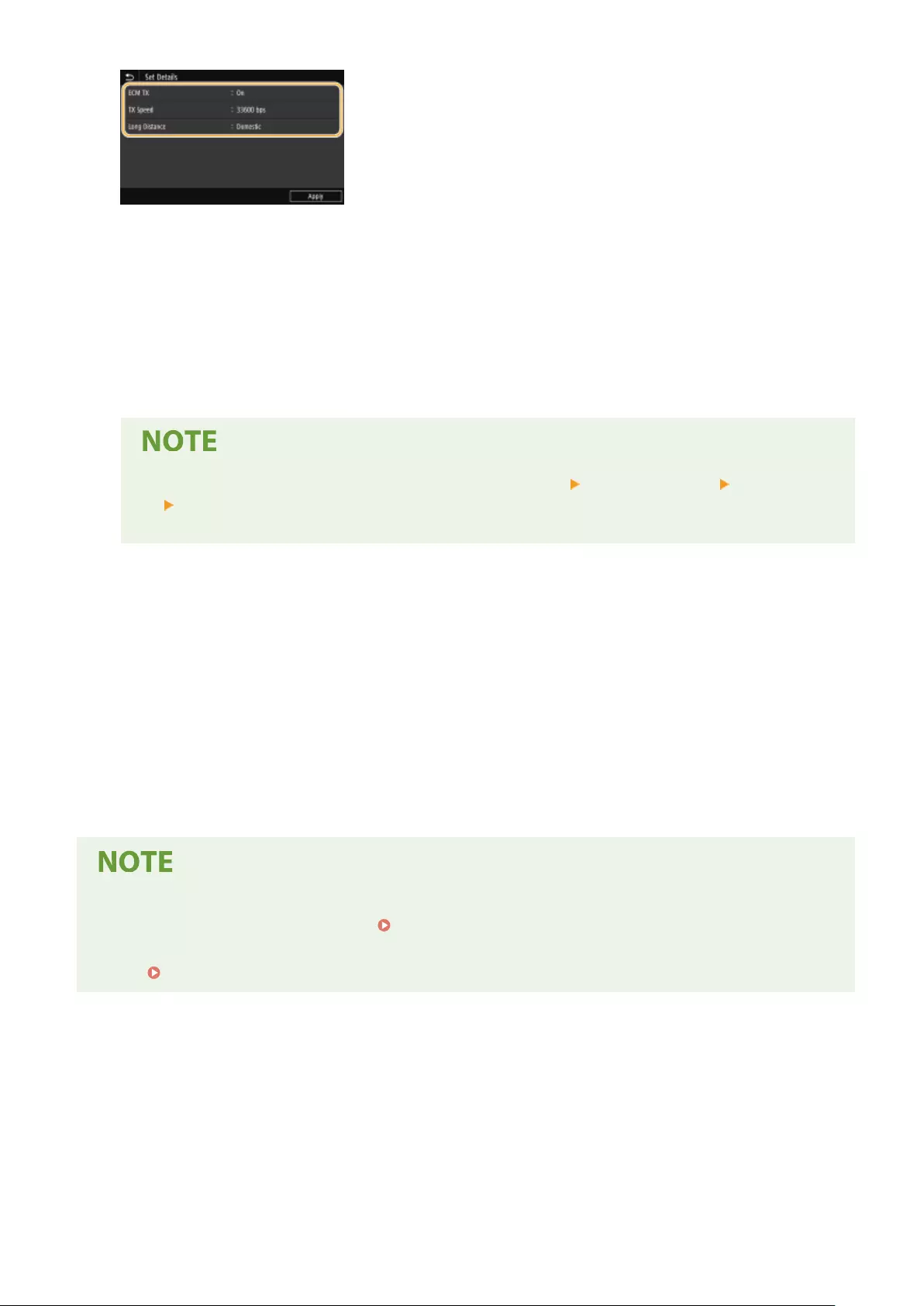
<ECM TX>
If an error occurs in an image that is being sent, the error is checked and corrected to prevent an improper
image from being sent when setting <On>.
<TX Speed>
If it takes time for transmissions to start, such as when there is a poor telephone connection, you can adjust the
transmission start speed downward.
<Long Distance>
Specify <International (1)> to <International (3)> according to the transmission conditions when registering
overseas fax numbers.
●You can also specify <ECM TX> and <TX Speed> from <Menu> <Function Settings> <Send>
<Fax Settings>. However, settings made from <Address Book> are enabled for the detailed settings
of destinations registered in the Address Book.
8Select <Register As>.
9Select <Favorites> or <Coded Dial>.
●If you select <Coded Dial>, select the destination number, or select <Use Numeric Keys> and enter the
destination number.
10 Select <Apply>.
●You can make a group of destinations already registered in the Address Book and register it as one
destination. For more information, see Registering Multiple Destinations as a Group(P. 185) .
●When you want to change or delete items of information about destinations registered in the Address Book,
see Editing the Registered Destinations in the Address Book(P. 187) .
Basic Operations
184
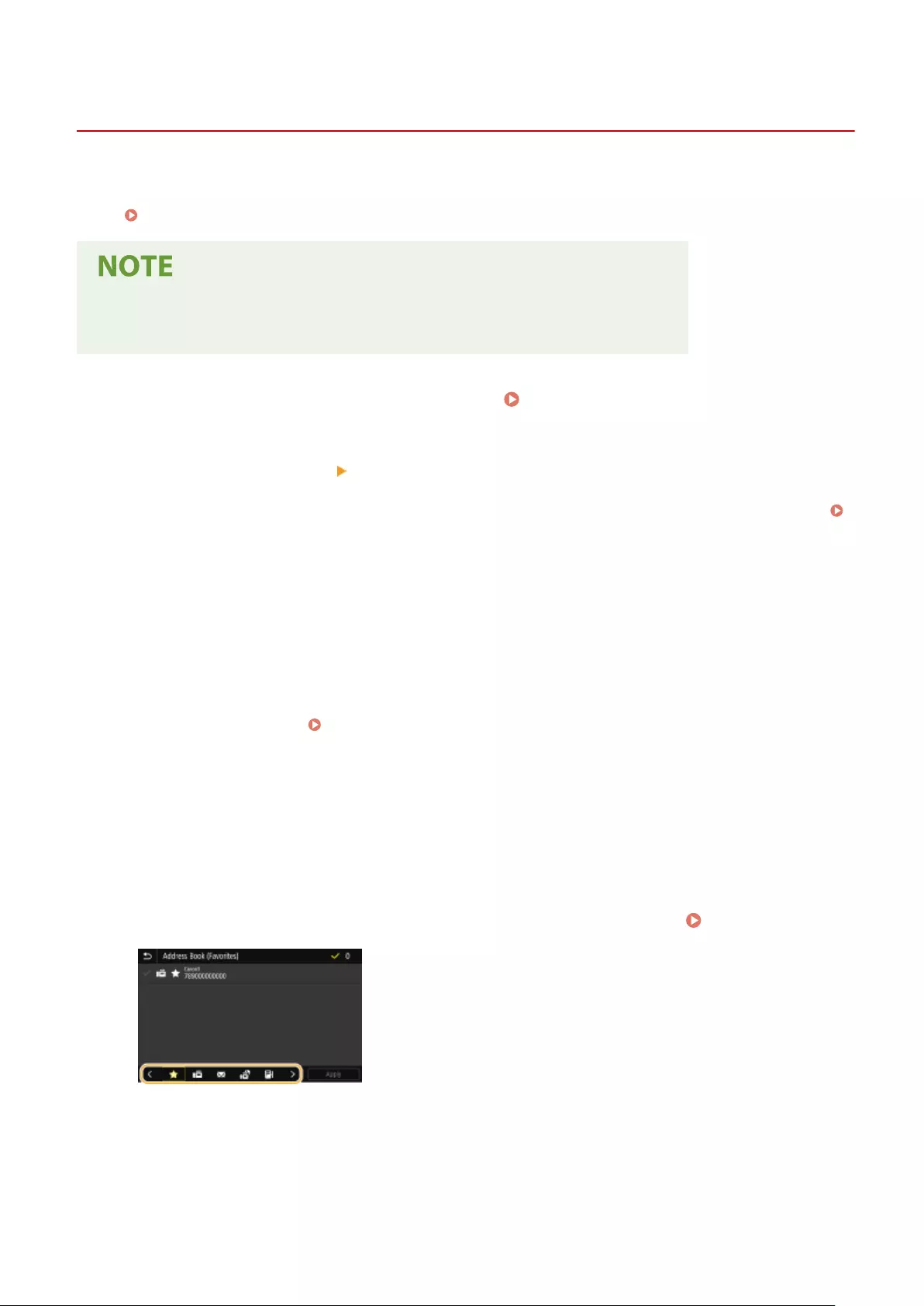
Registering Multiple Destinations as a Group
6FR5-03R
You can select multiple destinations that have already been registered and register them together as a group. This
section describes how to register a group from the operation panel. You can also use the Remote UI to register a
group. Registering Destinations from Remote UI(P. 440)
●Only destinations of the same type of address can be registered in the same group.
●Shared folders or FTP servers cannot be registered in a group as destinations.
1Select <Address Book> in the Home screen. Home Screen(P. 124)
2Select <Register Dest.> <Group>.
●If a screen appears prompting you to enter a PIN, enter the PIN for the Address Book and select <Apply>.
Restricting Use of the Address Book(P. 414)
3Select <Name>.
●Registering <Name> is optional. If you register <Name>, the destination can be searched alphabetically.
4Enter the name, and select <Apply>.
●On how to enter text, see Entering Text(P. 133) .
5Select <Destination>.
6Select <Add>.
7Select the index containing the destination you want to register. Index(P. 180)
8Select the destination, and then select <Apply>.
Basic Operations
185

9Repeat steps 6 to 8 until you have registered all of the destinations that you want to
register, and then select <Apply>.
To view information about the destination
●Select the target destination, and select <Details>.
To remove a destination from the group
●Select the destination that you want to remove from the group, and select <Delete> <Yes>.
10 Select <Register As>.
11 Select <Favorites> or <Coded Dial>.
●If you select <Coded Dial>, select the destination number, or select <Use Numeric Keys> and enter the
destination number.
12 Select <Apply>.
Basic Operations
186
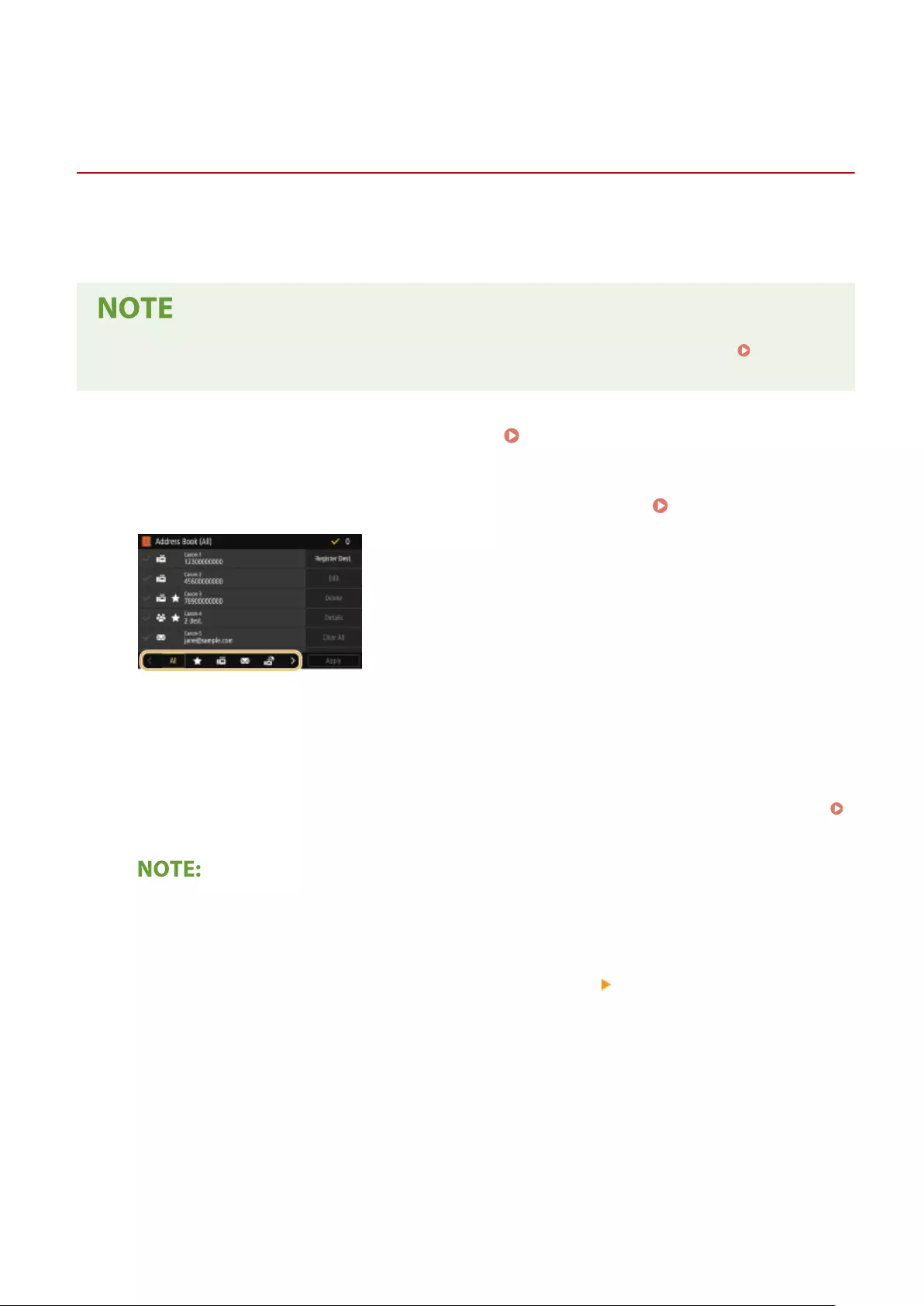
Editing the Registered Destinations in the Address
Book
6FR5-03S
You can change your settings, such as changing a registered fax number or name, changing the type of destination
registered as a fax number to an e-mail destination, changing a coded dial number, and adding or deleting group
destinations. You can also delete destinations or groups.
●If you delete a destination from the Address Book, it is also deleted from the favorite settings. Registering
Frequently Used Settings(P. 172)
1Select <Address Book> in the Home screen. Home Screen(P. 124)
2Select the index containing the destination you want to edit. Index(P. 180)
3Select the destination, and select <Edit>.
●To clear selection of a destination, select again the destination with a check mark. When multiple destinations
are selected, you can deselect all of them in batch by <Clear All>.
●If a screen appears prompting you to enter a PIN, enter the PIN for the Address Book and select <Apply>.
Restricting Use of the Address Book(P. 414)
To check destination details
●Select a destination of which the details you want to check, and select <Details>.
To delete destinations
●Select the destination you want to delete, and then select <Delete> <Yes>.
4After editing the necessary items, select <Apply>.
Basic Operations
187
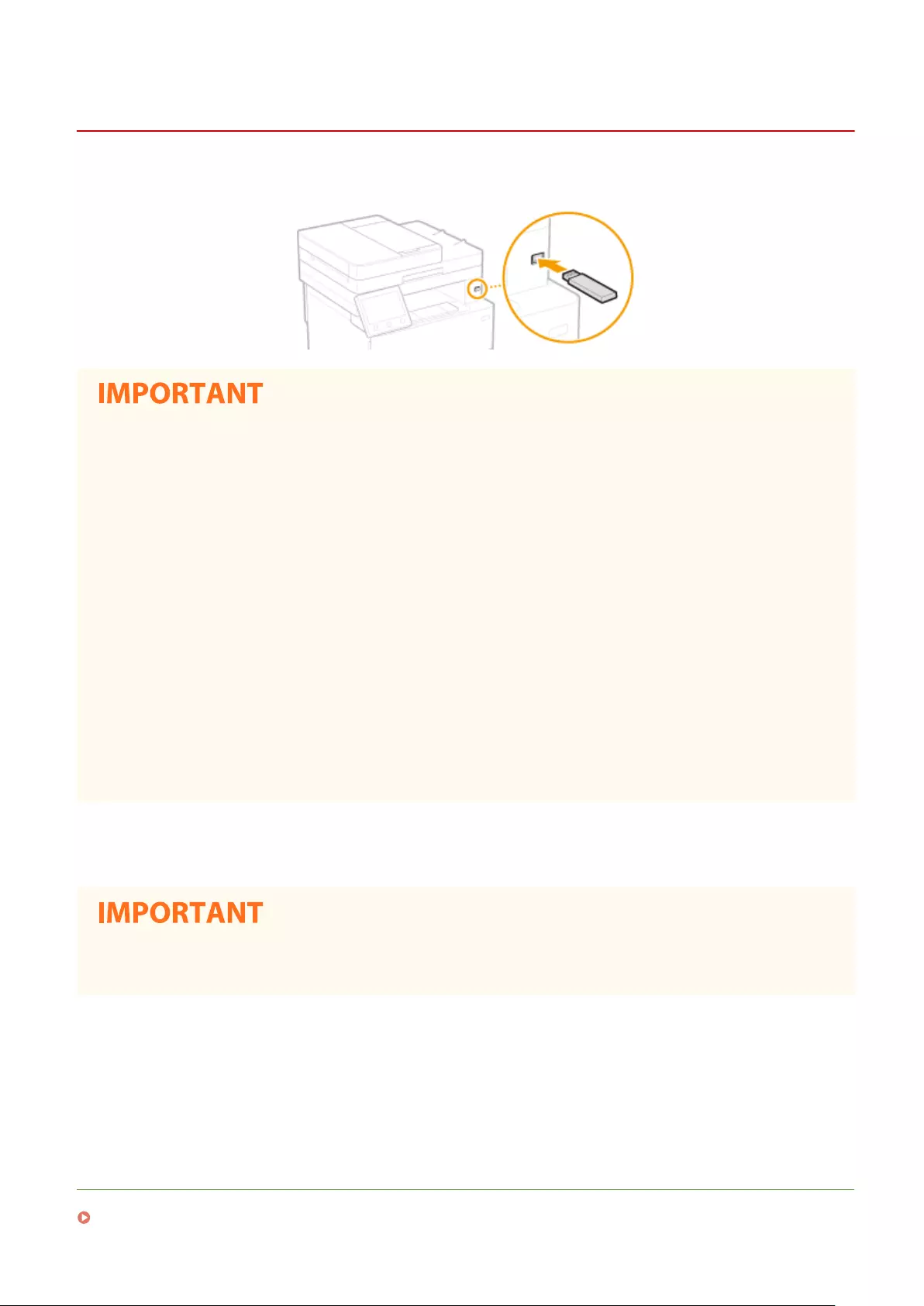
Using a USB Memory Device
6FR5-03U
When using a USB memory, insert it into the USB port on the machine.
Before using a USB memory device
●The supported formats of USB memory device are FAT16 and FAT32.
The following devices and uses are not supported:
●USB memory devices that have security functions installed
●USB memory devices that do not meet the USB standards
●Memory card readers connected via USB
●USB memory devices that are used with extension cables
●USB memory devices used via a USB hub
Handling of USB memory devices
●Make sure that the USB memory device is correctly oriented before inserting it. If you attempt to insert it in
incorrect orientation, the memory device and the machine may be damaged.
●Do not remove, bump or otherwise move the USB memory device while data is being imported or exported.
Also, do not turn OFF the machine while processing is in progress.
●You may not be able to save data properly on some USB memory devices.
◼Remove the USB Memory Device
●Always use the following procedure when removing USB memory devices. Using other methods to remove
USB memory devices may result in damage to the device and the machine.
1Select <Status Monitor>.
2Select <Rmv. Mem. Media>.
➠Wait until the <The memory media can be safely removed.> message is displayed.
3Disconnect the USB memory device.
LINKS
Printing from a USB Memory Device (Memory Media Print)(P. 271)
Basic Operations
188

Copying
Copying ................................................................................................................................................................ 191
Copy Basic Features Screen .............................................................................................................................. 193
Basic Copy Operations ...................................................................................................................................... 195
Canceling Copies .......................................................................................................................................... 200
Checking the Copying Status and Log .......................................................................................................... 201
Enhancing and Adjusting Copy Quality ............................................................................................................ 203
Selecting the Type of Original for Copying ................................................................................................... 204
Adjusting Sharpness for Copying (Sharpness) .............................................................................................. 205
Erasing Dark Borders When Copying (Erase Frame) ..................................................................................... 206
Useful Copy Functions ....................................................................................................................................... 207
Copying Multiple Documents onto One Sheet (N on 1) ................................................................................. 208
Collating Copies by Page .............................................................................................................................. 209
Making ID Card Copies ................................................................................................................................. 210
Making Passport Copies ............................................................................................................................... 211
Copying
190
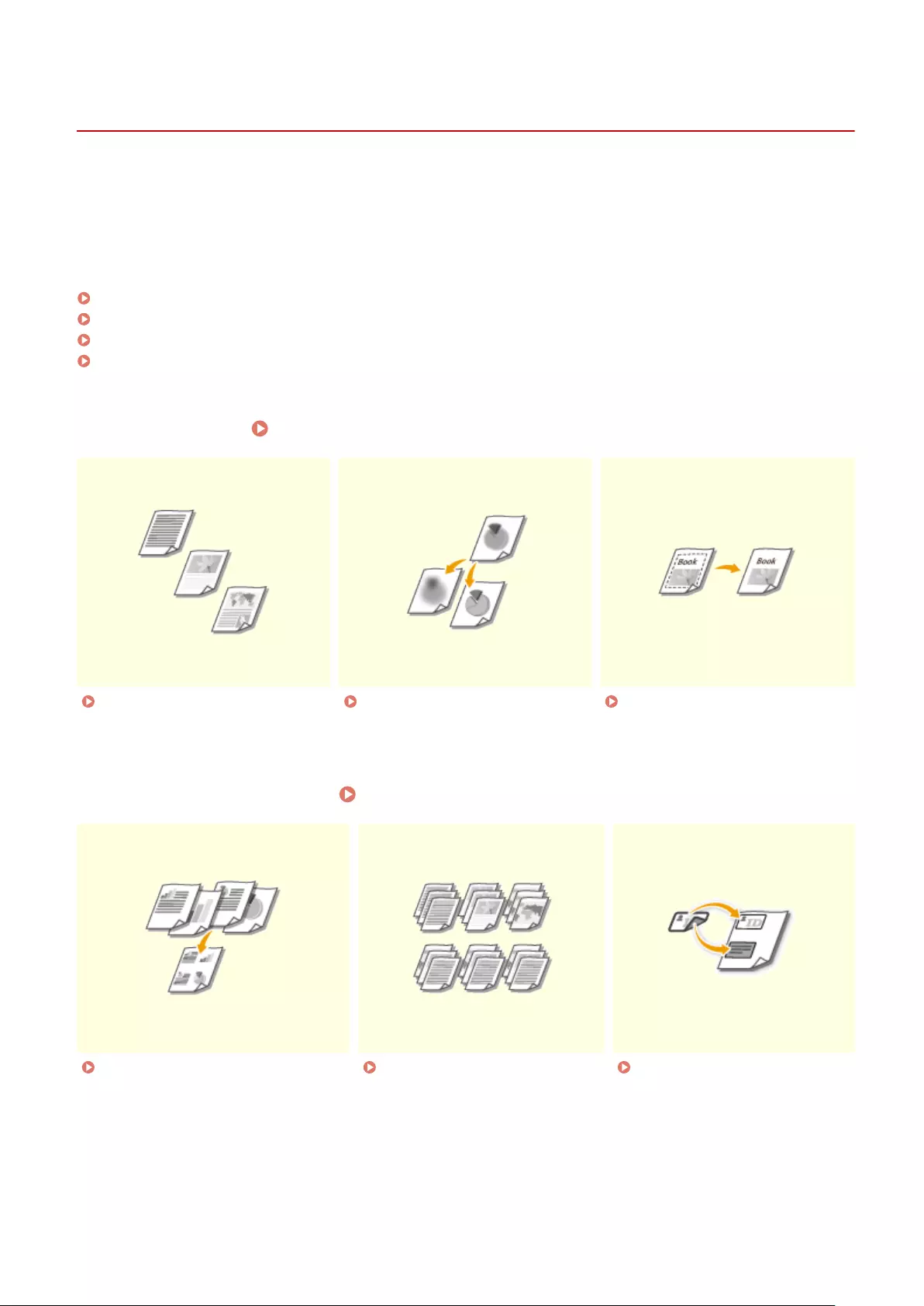
Copying
6FR5-03W
1660-03S
This chapter describes basic copy operations and various useful copy functions.
◼Using Basic Operations
Copy Basic Features Screen(P. 193)
Basic Copy Operations(P. 195)
Canceling Copies(P. 200)
Checking the Copying Status and Log(P. 201)
◼Enhancing Quality Enhancing and Adjusting Copy Quality(P. 203)
Selecting the Type of Original for
Copying(P. 204)
Adjusting Sharpness for Copying
(Sharpness)(P. 205)
Erasing Dark Borders When
Copying (Erase Frame)(P. 206)
◼Using Useful Copy Functions Useful Copy Functions(P. 207)
Copying Multiple Documents onto
One Sheet (N on 1)(P. 208)
Collating Copies by Page(P. 209) Making ID Card Copies(P. 210)
Copying
191
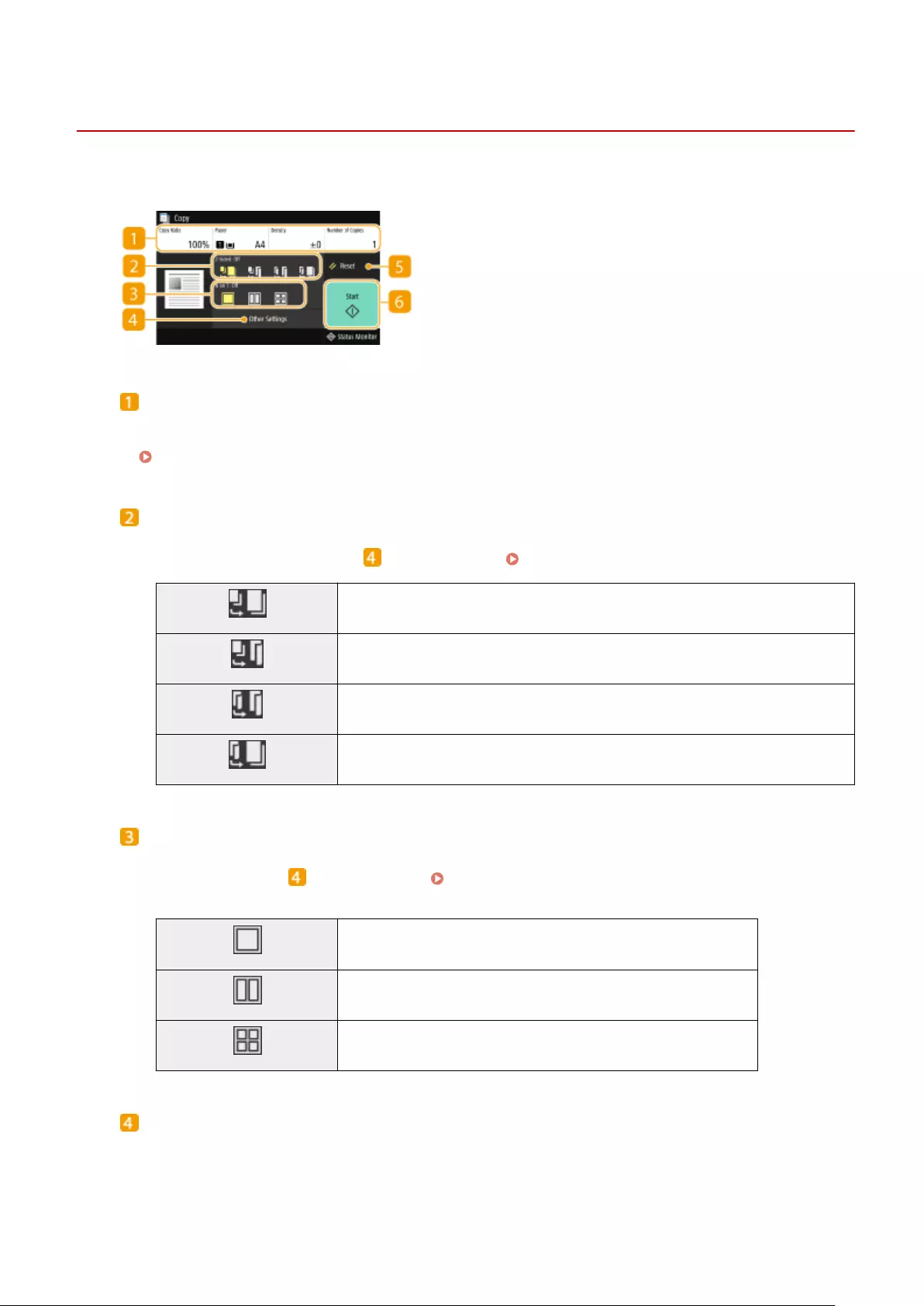
Copy Basic Features Screen
6FR5-03X
When you select <Copy> in the Home screen, the Copy Basic Features screen appears.
Current setting status and setting buttons
The setting status, such as copy ratio, copy paper, and number of copies, are displayed. To copy correctly, be
sure to check the settings displayed here. When you want to change a setting, select the desired setting item.
Basic Copy Operations(P. 195)
<2-Sided>
You can select a combination of 1-sided copying and 2-sided copying for the original and printout paper.
Specify the detailed settings from <Other Settings>. Basic Copy Operations(P. 195)
Scans one side of an original and prints the scanned data on one side of the paper.
Scans one side of an original and prints the scanned data on both sides of the paper.
Scans both sides of an original and prints the scanned data on both sides of the paper.
Scans both sides of an original and prints the scanned data on one side of the paper.
<N on 1>
You can select an "N on 1" pattern to arrange multi-page originals on the same side of one sheet. Specify the
detailed settings from <Other Settings>. Copying Multiple Documents onto One Sheet (N on 1)
(P. 208)
Does not apply N on 1.
Prints data for two consecutive pages on one side of a sheet of paper.
Prints data for four consecutive pages on one side of a sheet of paper.
<Other Settings>
You can call the detailed settings or favorite settings that are not displayed in the Copy Basic Features screen.
Copying
193

<Reset>
You can collectively restore the default settings.
<Start>
Use this button to start copying.
Copying
194
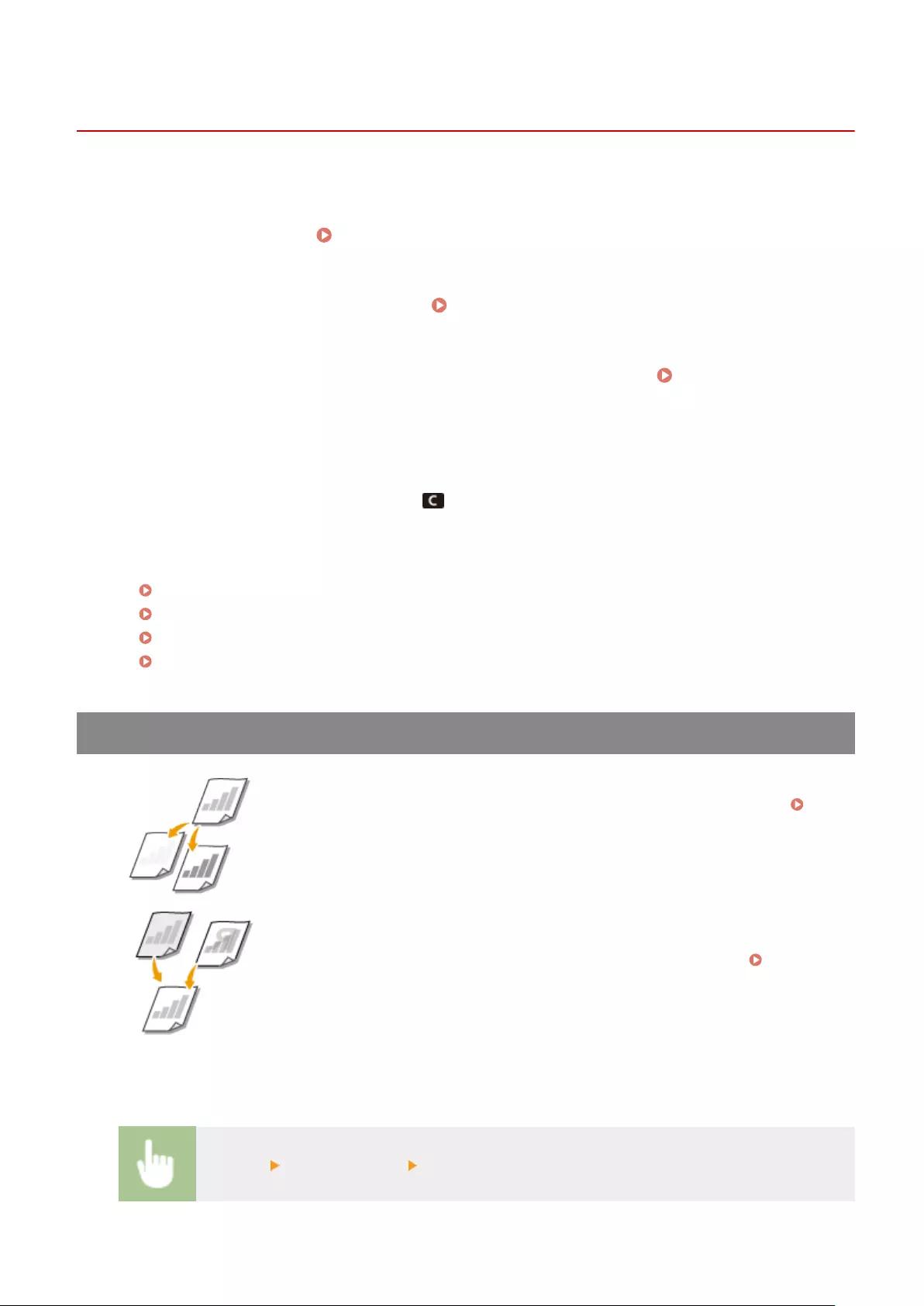
Basic Copy Operations
6FR5-03Y
This section describes the basic operation procedure used to copy an original.
1Place the original(s). Placing Originals(P. 137)
2Select <Copy> in the Home screen. Home Screen(P. 124)
3Select <Number of Copies> in the Copy Basic Features screen. Copy Basic Features
Screen(P. 193)
4Enter the number of copies, and select <Close>.
●If you have entered an incorrect value, use to clear it.
5Specify the copy settings as necessary.
Adjusting Density
2-Sided Copying
Enlarging or Reducing
Selecting Copy Paper
Adjusting Density
Adjust the density of the scan if the text or images in an original are excessively light
or dark. For example, you can sharpen text and lines written using a pencil.
Adjusting Entire Density(P. 195)
Adjust the background density. You can make a clear copy of originals with colored
backgrounds, or originals such as a newspaper that is printed on thin paper on
which text or images on the other side are visible through the paper. Adjusting
the Background Density(P. 196)
◼Adjusting Entire Density
<Density> Adjust the density <Close>
Copying
195
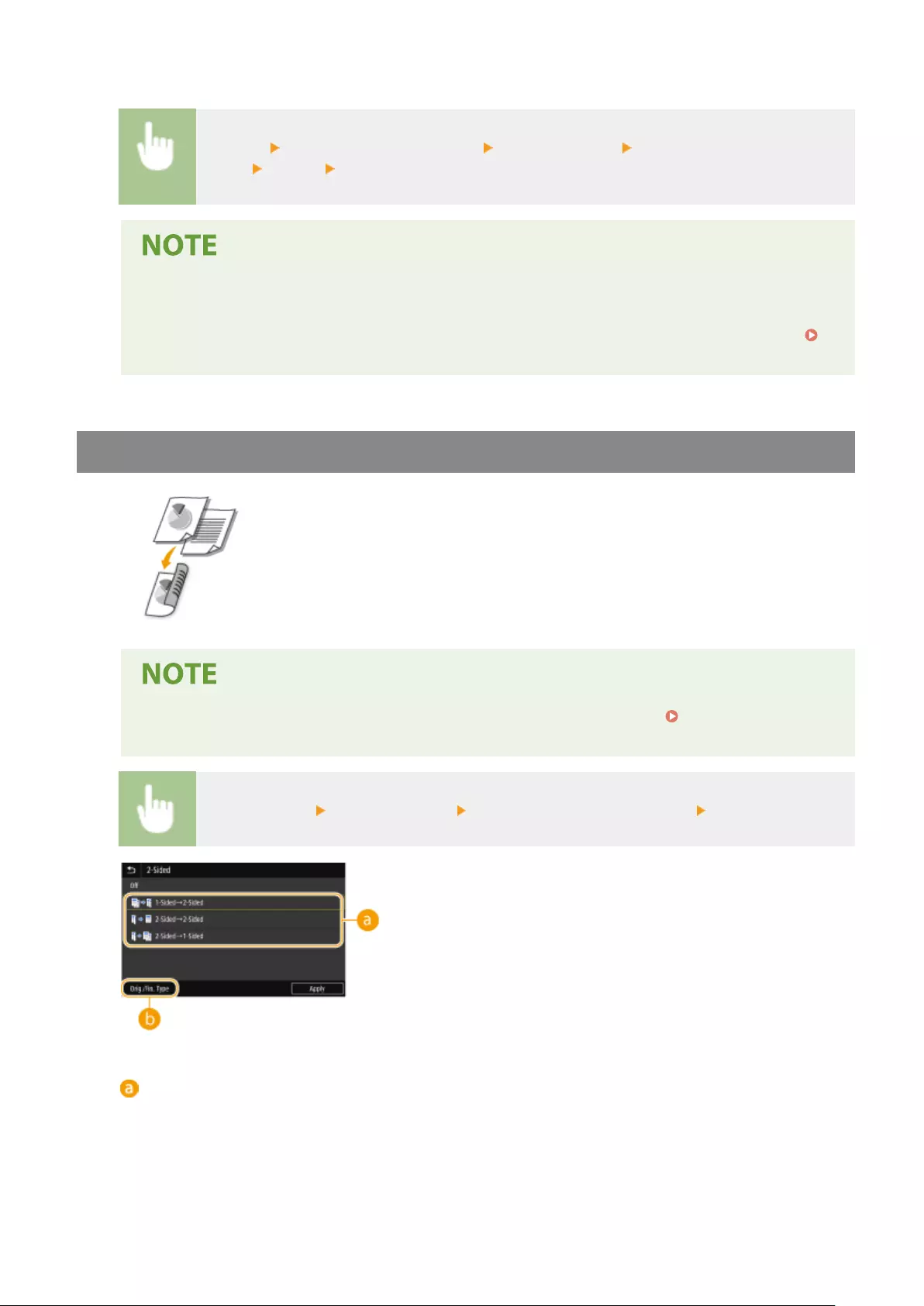
◼Adjusting the Background Density
<Density> <Adjust Background Density> <Adjust (Manual)> Adjust the background
density <Apply> <Close>
●Depending on the original color, portions other than the background may be affected.
●When you set <Adjust Background Density> to <Auto>, automatic adjustment is performed so that
the background color becomes white. In this case, <Original Type> is automatically set to <Text> (
Selecting the Type of Original for Copying(P. 204) ).
2-Sided Copying
You can copy two pages of an original on both sides of the paper. You can also copy
a 2-sided original on both sides of the paper, or on two sheets of paper.
●<2-Sided Printing> may not be available with some sizes and types of paper. Available
Paper(P. 624)
<Other Settings> <2-Sided Printing> Select the type of 2-sided copying <Apply>
Types of 2-sided copying
The illustration below shows the types of 2-sided copying.
<1-Sided->2-Sided> <2-Sided->2-Sided> <2-Sided->1-Sided>
Copying
196
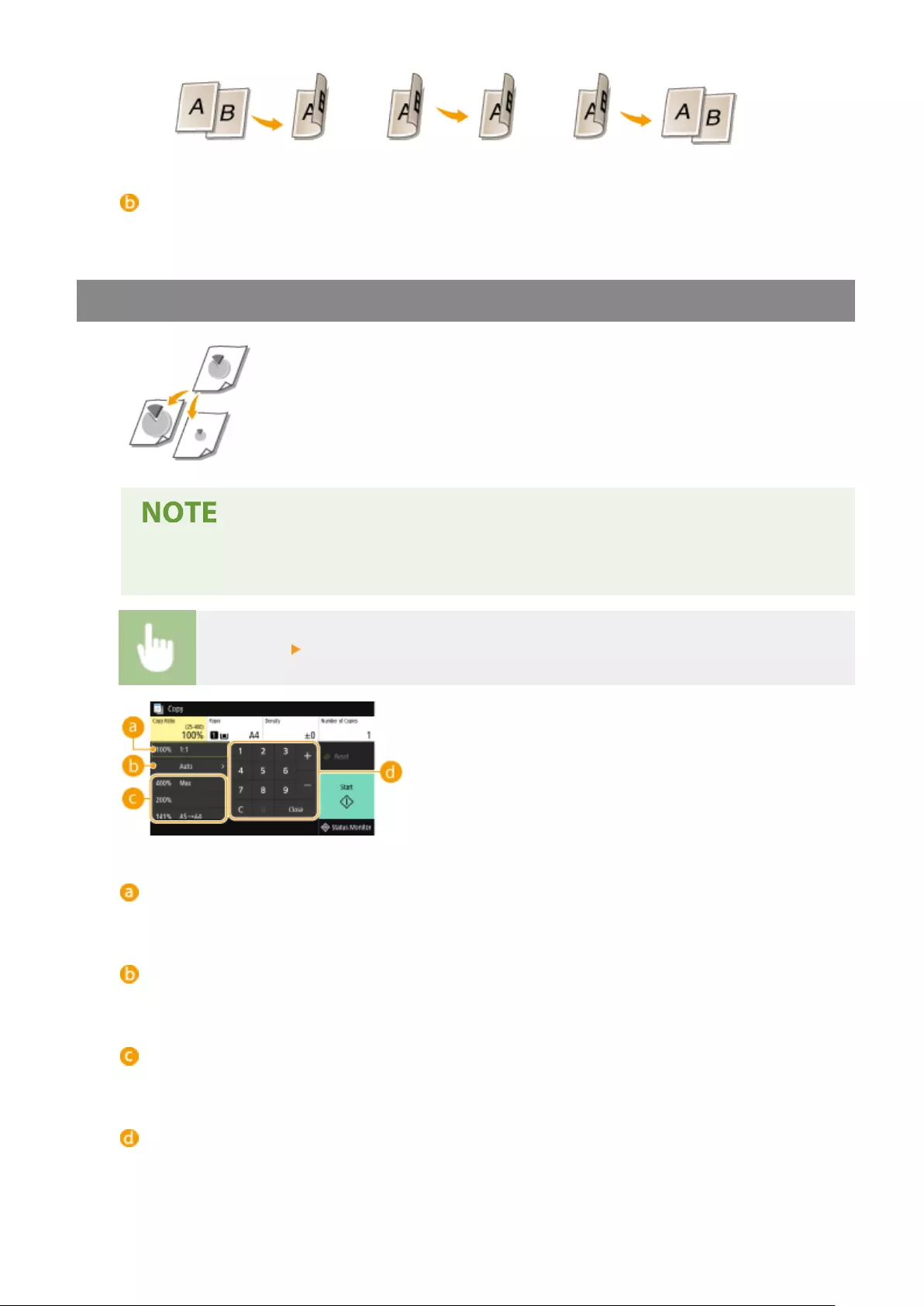
<Orig./Fin. Type>
Specify the original orientation, opening type, and nishing type.
Enlarging or Reducing
You can enlarge or reduce copies by using a preset copy ratio such as <A5->A4>, or
by setting a custom copy ratio in increments of 1 %.
●If you make a setting for <N on 1> after setting the copy ratio, the setting of reduction ratio in <N on
1> takes priority.
<Copy Ratio> Select the copy ratio
<100% 1:1>
Makes copies at copy ratio 100 %.
<Auto>
Makes copies by automatically enlarging/reducing the original image to t the specied paper size.
Preset copy ratio
Select a copy ratio.
Numeric keys
You can set any copy ratio from 25 % to 400 % in 1 % increments.
Copying
197
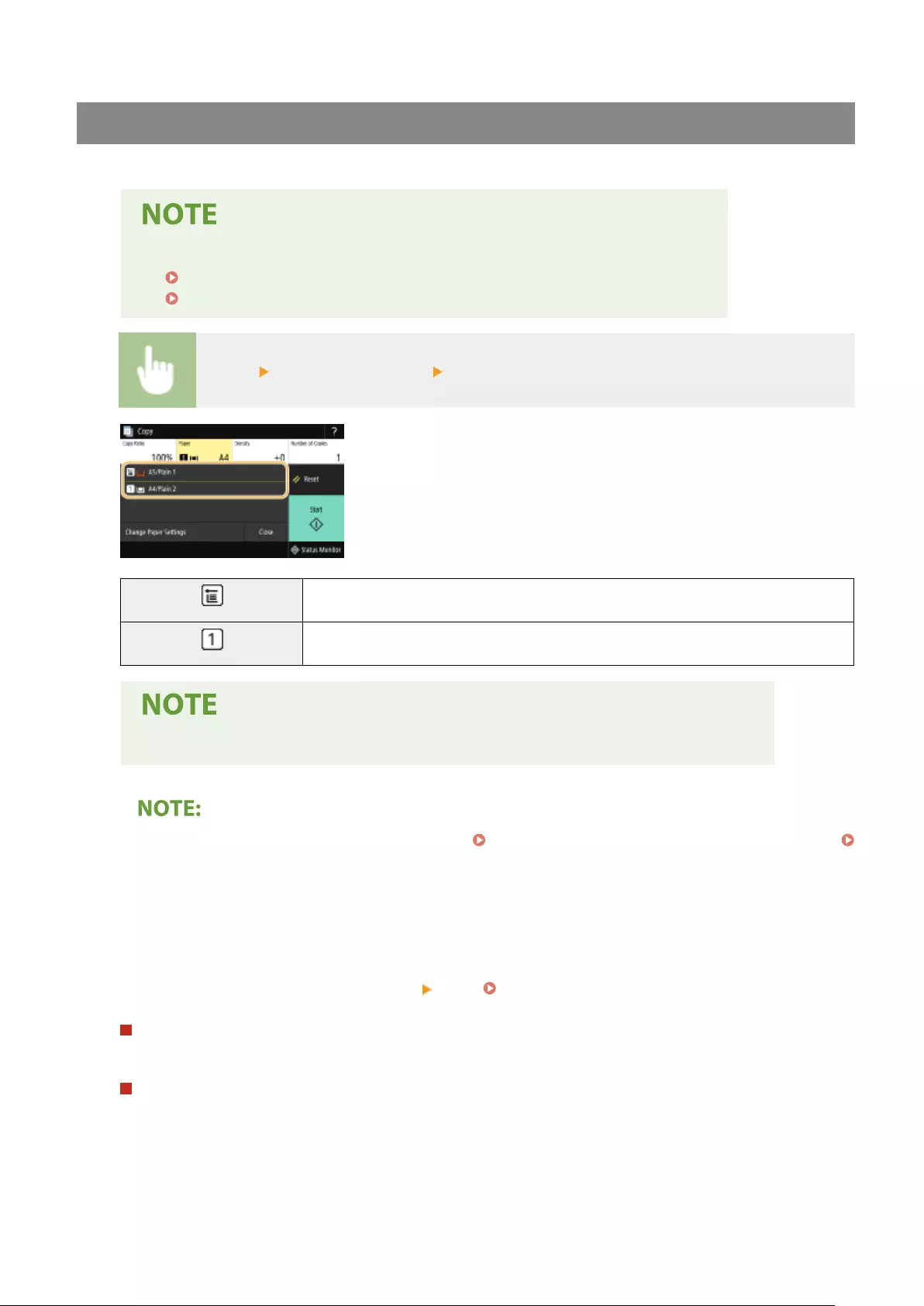
Selecting Copy Paper
Specify the paper source that contains the paper to use for printing out copies.
●You must rst specify the size and type of paper that is loaded in the paper source.
Specifying Paper Size and Type(P. 157)
Loading Paper(P. 141)
<Paper> Select the paper source <Close>
Uses the paper that is loaded in the multi-purpose tray to make copies.
Uses the paper that is loaded in the paper drawer (Drawer 1) of the machine to make copies.
●When the optional cassette feeding module is installed, its paper drawer is also displayed.
●For information about other copy settings, see Enhancing and Adjusting Copy Quality(P. 203) or
Useful Copy Functions(P. 207) .
6Select <Start>.
➠Copying starts.
●If you want to cancel, select <Cancel> <Yes>. Canceling Copies(P. 200)
When placing originals in the feeder in step 1
The original is automatically scanned.
When placing originals on the platen glass in step 1
For 2-sided copying or N on 1 copying, the screen prompting you to load the next original is displayed.
1Place the next original on the platen glass, and select <Scan Next Original>.
●You can also specify <Density> and <Original Type> separately for each original.
Copying
198
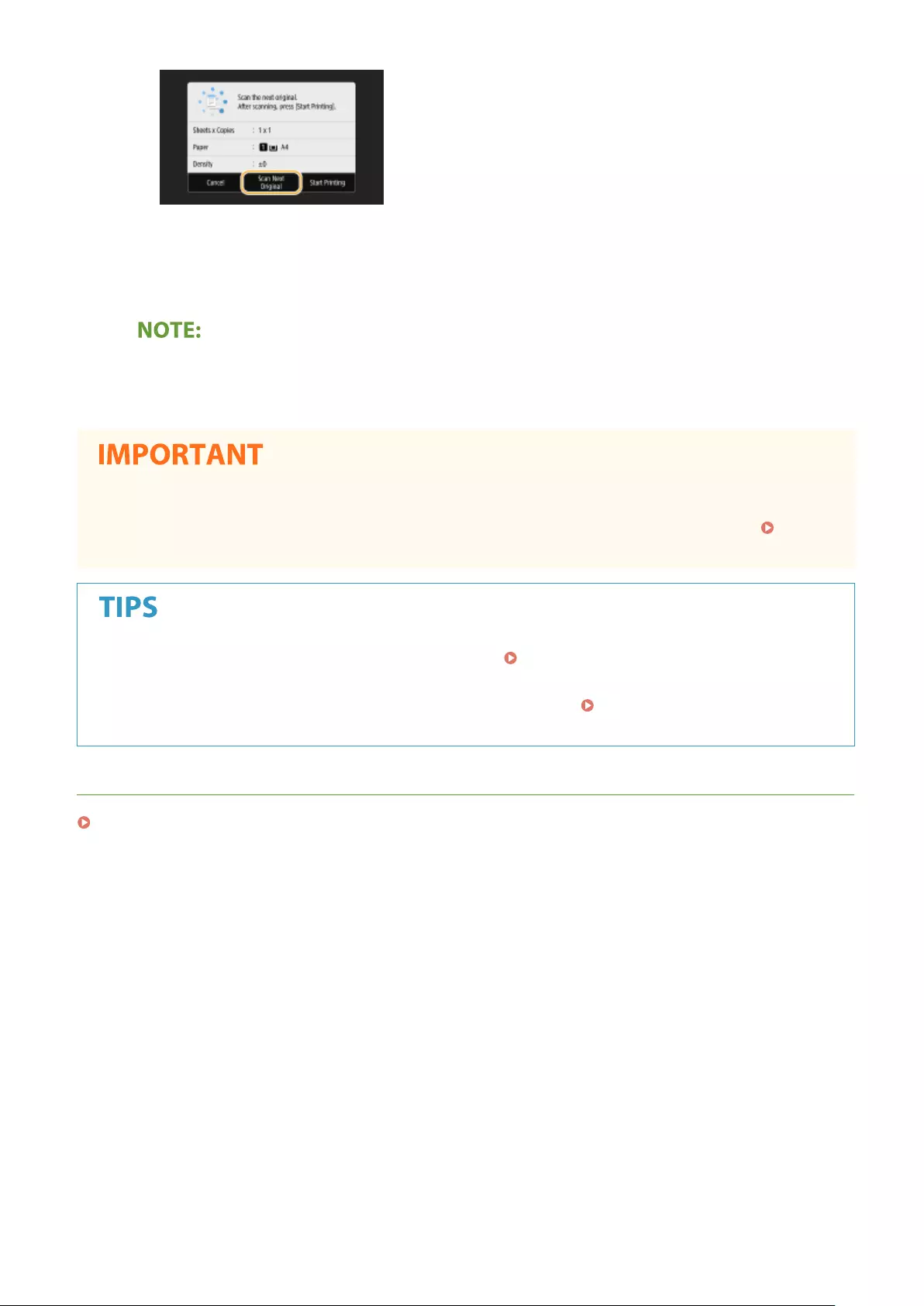
●Repeat this step until you nish scanning the entire original.
2Select <Start Printing>.
●When the <Paper Settings and Loaded Size Mismatch> or <The memory is full. Scanning will be canceled.
Do you want to print?> message is shown in the display, there is a possibility that copying cannot be
performed properly. For more information, see "Troubleshooting (FAQ)" on the online manual website.
When copying originals with text or images that extend to the edges of the page
●The edges of the original might not be copied. For more information about the scan margins, see Main
Unit(P. 620) .
●If you always want to make copies with the same settings: Changing the Default Settings for
Functions(P. 174)
●If you want to register a combination of settings to use when needed: Registering Frequently Used
Settings(P. 172)
LINKS
Checking the Copying Status and Log(P. 201)
Copying
199
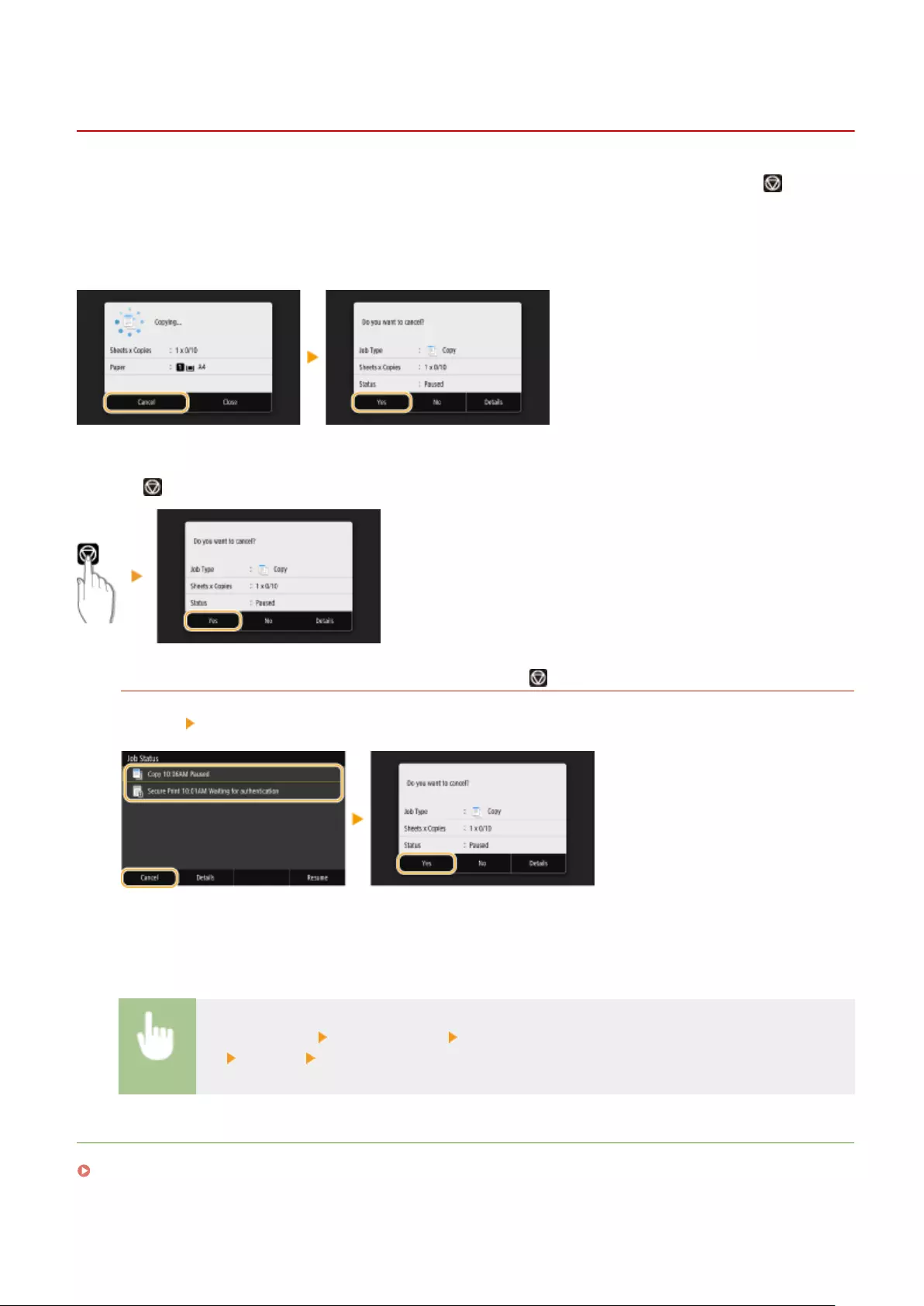
Canceling Copies
6FR5-040
If you want to cancel copying immediately after selecting <Start>, select <Cancel> on the screen or press on the
operation panel. You can also cancel copying after checking the copy status.
◼Select <Cancel> on the Screen That is Displayed While Copying
◼Press to Cancel
If the Screen Displays a List of Documents When is Pressed
Originals have been scanned and are waiting to be printed. Select a copy document to be canceled, and select
<Cancel> <Yes>.
◼Check the copy job status before canceling
<Status Monitor> <Copy/Print Job> Select the copy document in the <Copy/Print Job Status>
tab <Cancel> <Yes>
LINKS
Basic Copy Operations(P. 195)
Copying
200
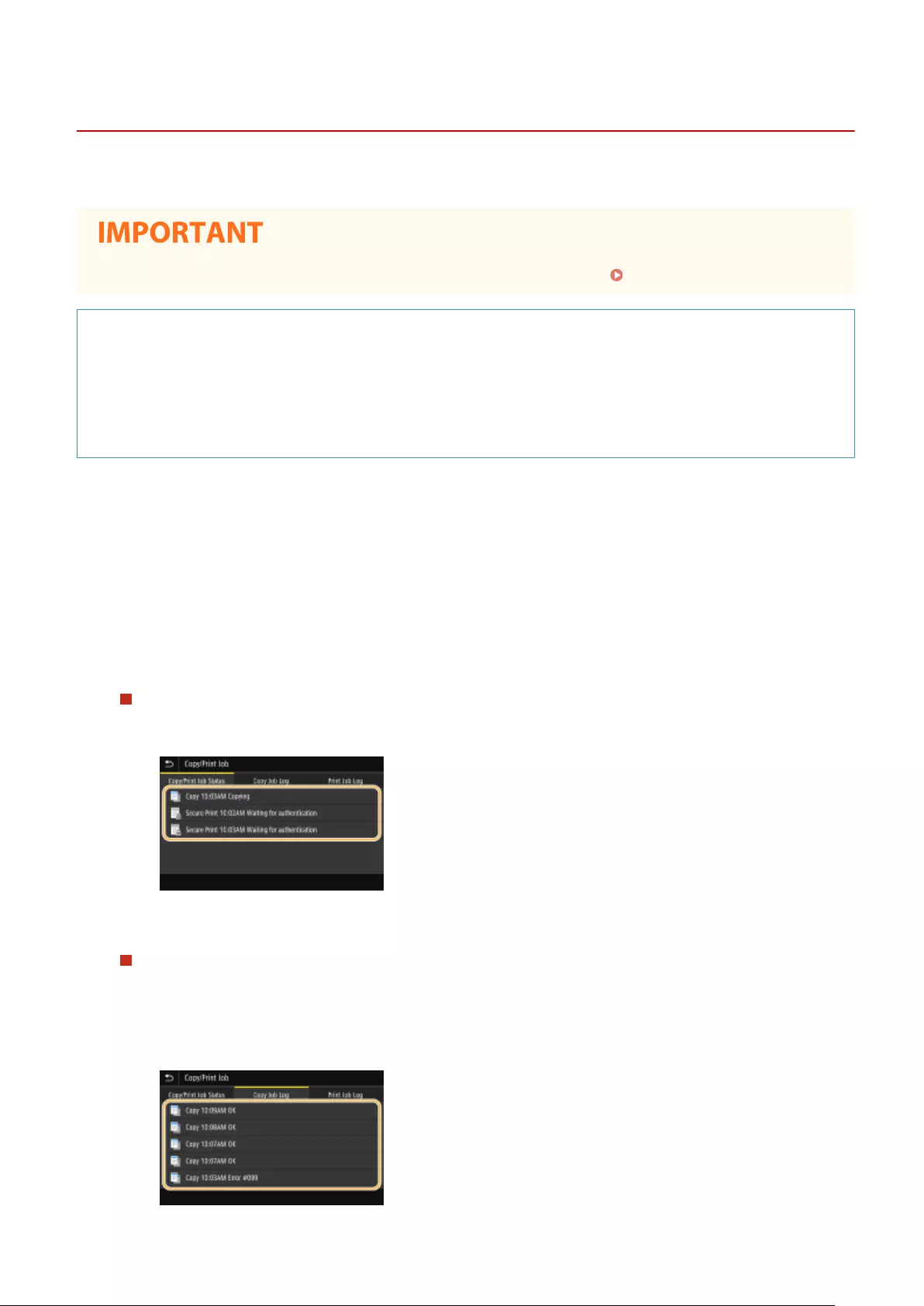
Checking the Copying Status and Log
6FR5-041
You can check the current copy statuses and the logs for copied documents.
●When <Display Job Log> is set to <Off>, you cannot check the copy job log. <Display Job Log>(P. 565)
Useful in the Following Cases
●When some long time has already passed after scanning of your original to be copied but printing of the
document has not started yet, you may want to see the waiting list of the documents waiting to be printed.
●When you cannot nd your printouts that you thought had been copied, you may want to see whether an
error has occurred.
1Select <Status Monitor>.
2Select <Copy/Print Job>.
3Check the copy statuses and logs.
To check the copy statuses
1Select the document whose status you want to check in the <Copy/Print Job Status> tab.
➠Displays detailed information about the document.
To check the copy logs
1Select the document whose log you want to check in the <Copy Job Log> tab.
●<OK> is displayed when a document was copied successfully, and <Error> is displayed when a
document failed to be copied because it was canceled or there was some error.
Copying
201
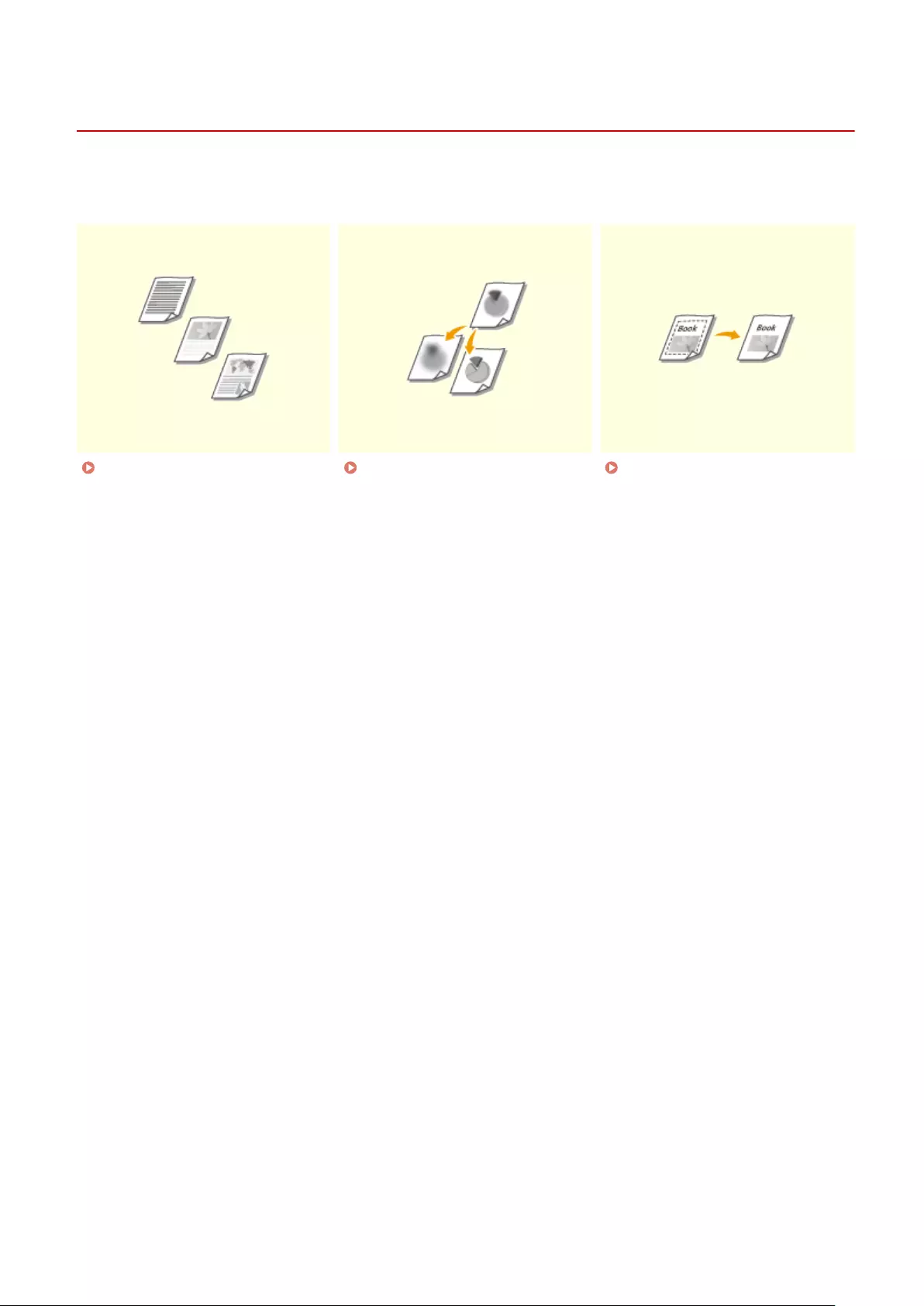
Enhancing and Adjusting Copy Quality
6FR5-042
You can improve the copy quality by specifying more detailed settings, such as selecting the optimum image quality,
erasing unnecessary shadows, etc.
Selecting the Type of Original for
Copying(P. 204)
Adjusting Sharpness for Copying
(Sharpness)(P. 205)
Erasing Dark Borders When
Copying (Erase Frame)(P. 206)
Copying
203
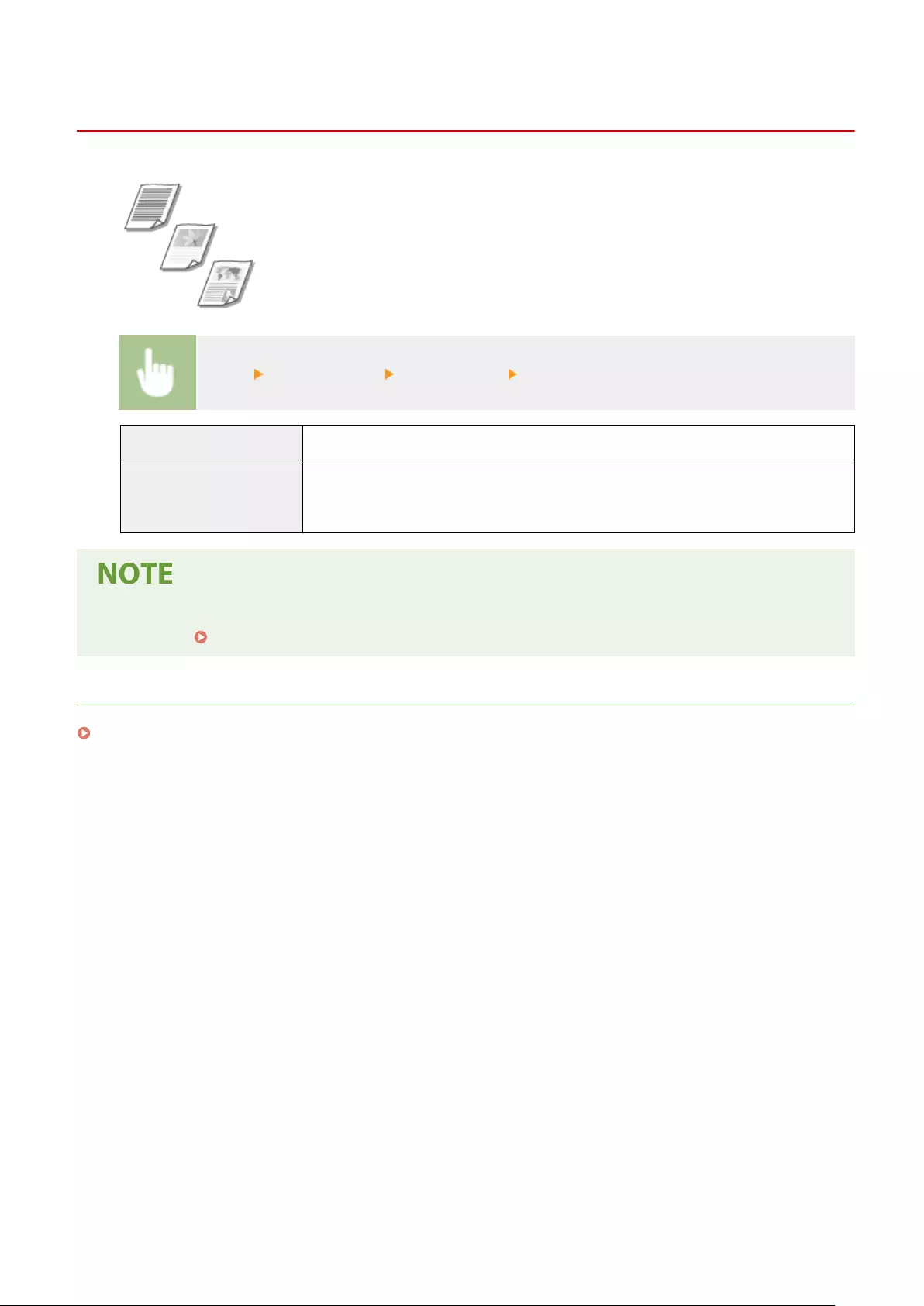
Selecting the Type of Original for Copying
6FR5-043
You can select the optical image quality for the copy depending on the original type,
such as text-only documents, documents with charts and graphs, or magazine
photos.
<Copy> <Other Settings> <Original Type> Select the original type
<Text/Photo> Suitable when copying documents that contain both text and photos.
<Text/Photo (High Quality)>
Suitable when making a high quality copy of documents that contain both text and photos.
You can also adjust the level of priority given to the quality of the text or photos. Adjust the
setting on the scale, and select <Apply>.
●If a setting other than <Text> is specied, <Adjust Background Density> is automatically set to <Adjust
(Manual)>. Basic Copy Operations(P. 195)
LINKS
Basic Copy Operations(P. 195)
Copying
204
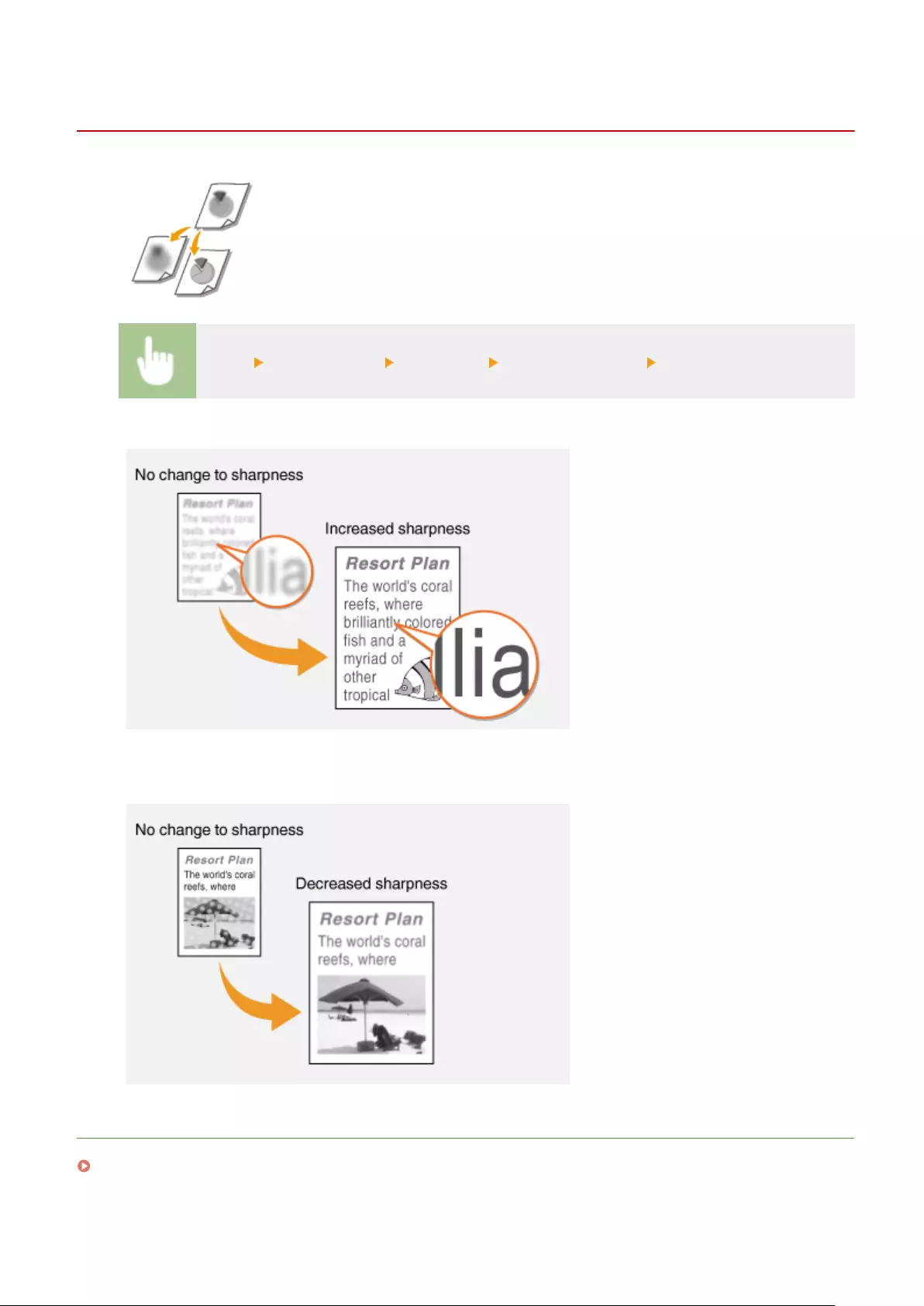
Adjusting Sharpness for Copying (Sharpness)
6FR5-044
You can adjust sharpness of the copied image. Increase the sharpness to sharpen
blurred text and lines, or decrease the sharpness to improve the appearance of
magazine photos.
<Copy> <Other Settings> <Sharpness> Adjust the sharpness <Apply>
Example: If you want to sharpen text and lines written in pencil
Example: If you want to improve the appearance of magazine photos
LINKS
Basic Copy Operations(P. 195)
Copying
205
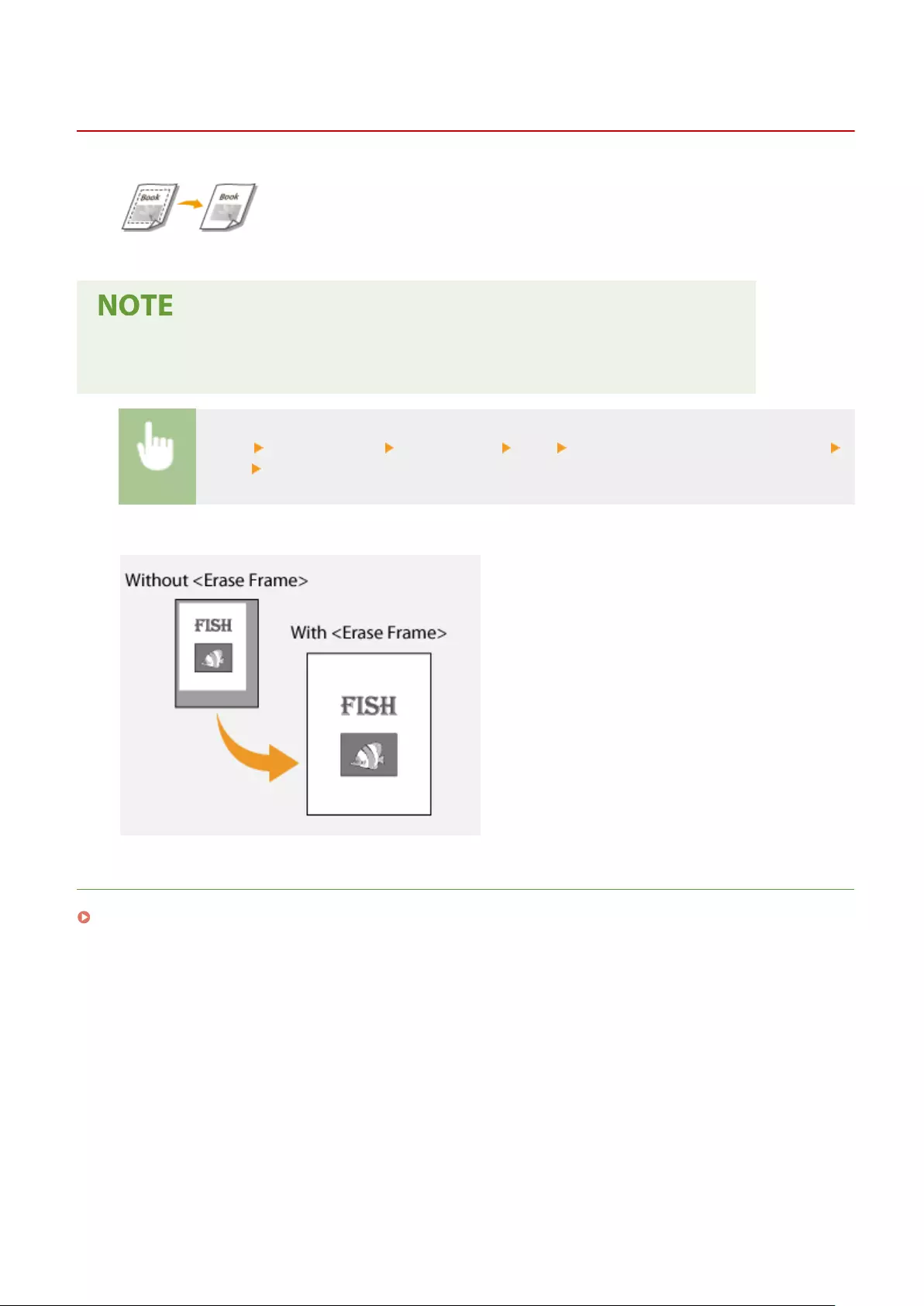
Erasing Dark Borders When Copying (Erase Frame)
6FR5-045
When copying originals that are smaller than the output paper size, frame lines may
appear around the edges in the copied image. When copying facing pages from
thick book, dark borders may appear. <Erase Frame> enables you to erase these
frame lines and dark borders.
●The width of the frame to erase is increased or decreased relative to the <Copy Ratio> setting.
●<Erase Frame> is not available when using <N on 1>.
<Copy> <Other Settings> <Erase Frame> <On> Specify the width of the frame to erase
<Next> Select the original size on the <Scan Size> screen
Example: If you want to erase the dark borders and frame lines
LINKS
Basic Copy Operations(P. 195)
Copying
206
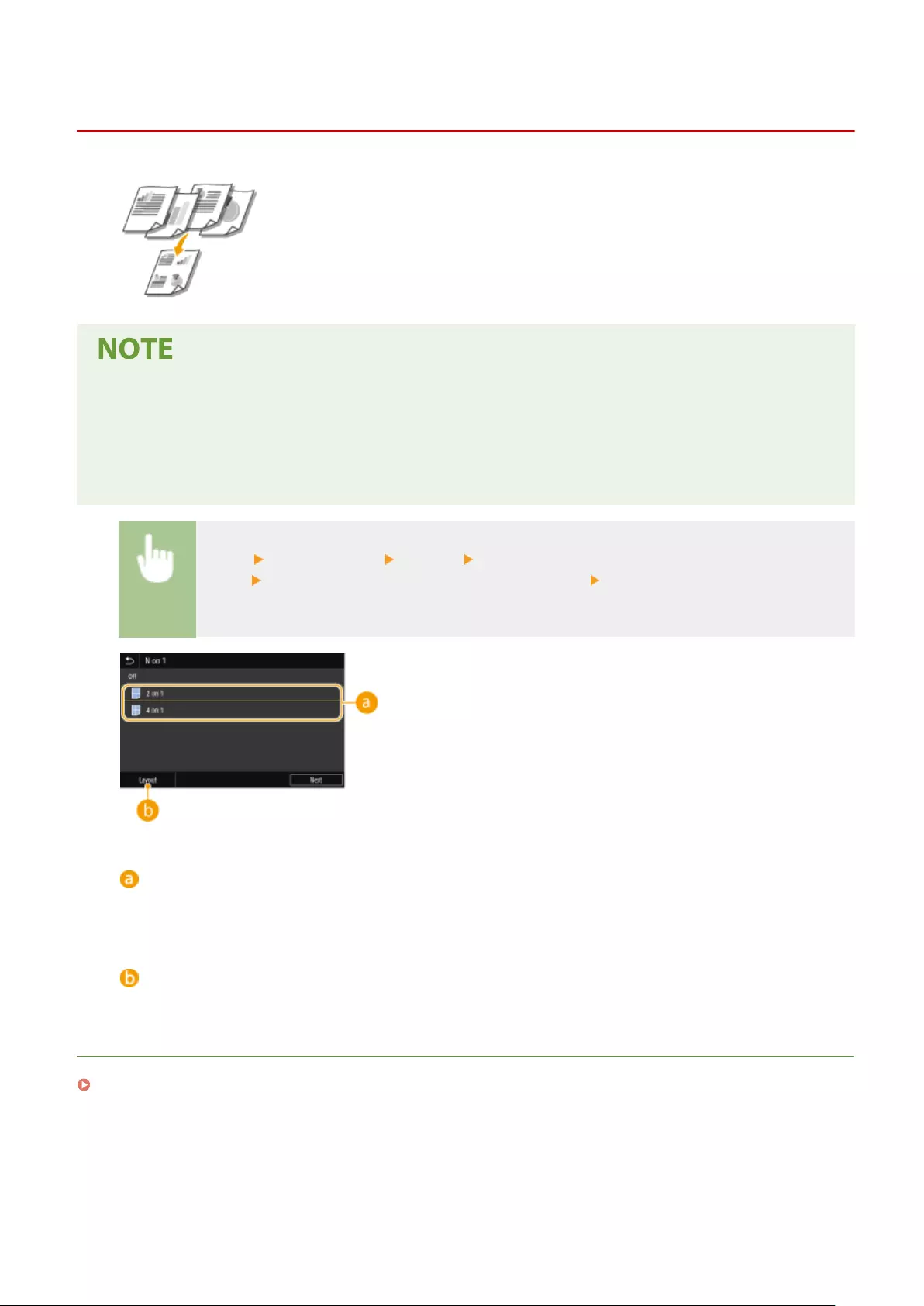
Copying Multiple Documents onto One Sheet (N on 1)
6FR5-047
You can reduce the size of a multiple-page original and arrange all pages on one side
of the paper. You can save the number of sheets as the document can be copied on
fewer pages than those of the original.
●Using <N on 1> reduces the copy ratio automatically (the copy ratio is displayed on the screen). If the
copying process has not started, you can further reduce the image size by lowering the numeric value that is
automatically displayed. But the edges of the original might not be copied if you increase it.
●<N on 1> is not available when using <Erase Frame>.
●When you copy multiple originals onto one page, margins may be created in the copied image.
<Copy> <Other Settings> <N on 1> Select the number of pages to be combined, and select
<Next> Select the original size on the <Scan Size> screen On the <Output Size> screen, select
the paper source that contains the paper you want to use
Number of pages to be combined
Select the number of pages to be combined on one side of paper. For example, <4 on 1> means that "a four-
page original can be combined on a single sheet."
<Layout>
Specify how to arrange the originals on the page.
LINKS
Basic Copy Operations(P. 195)
Copying
208
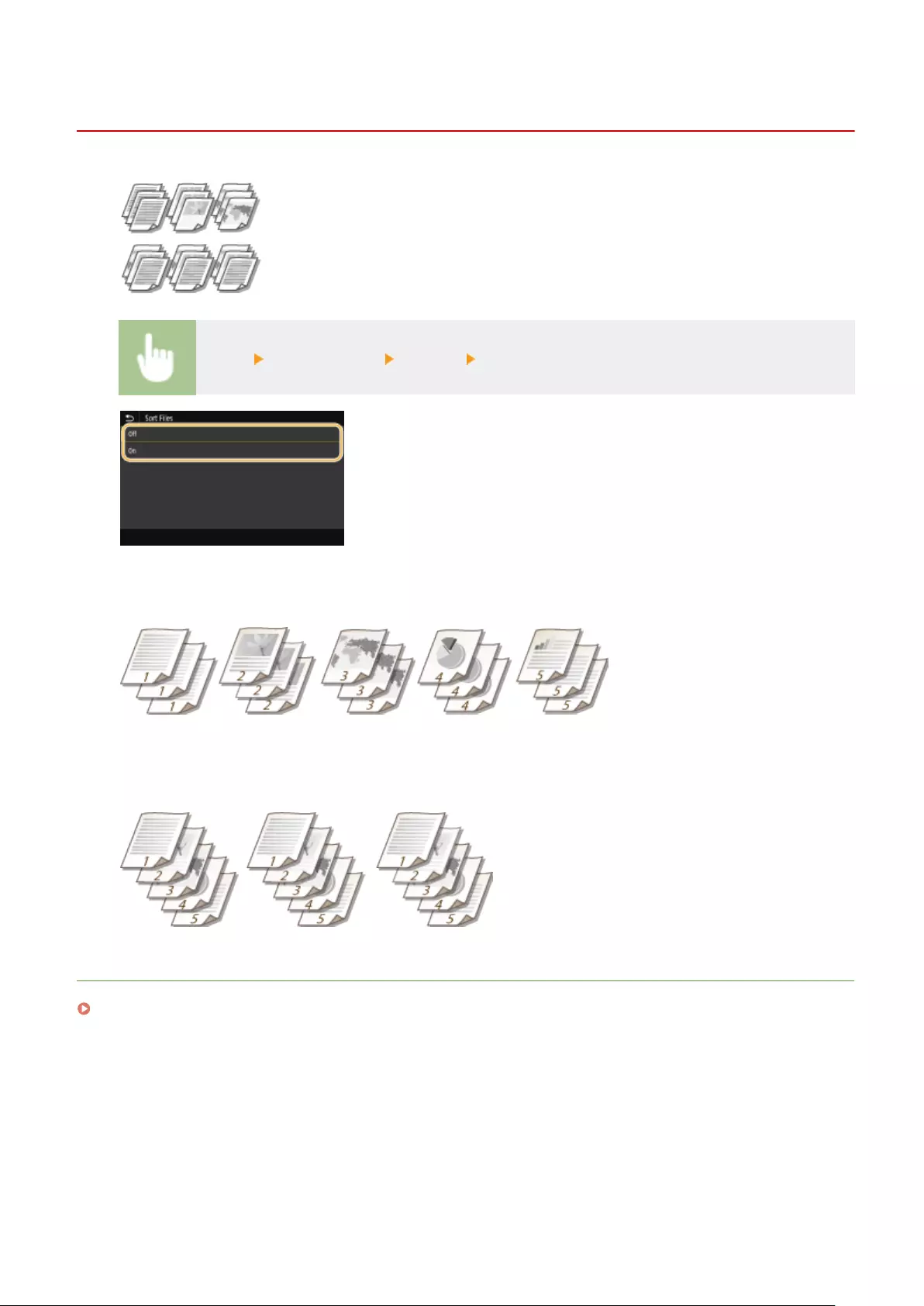
Collating Copies by Page
6FR5-048
When preparing multiple copies of multi-page originals, set <Collate> to <On> to
collate copies in sequential page order. This function is useful when preparing
handouts for meetings or presentations.
<Copy> <Other Settings> <Collate> <On>
<Off>
The copies are grouped by page and not collated. For example, if you are making three copies of a ve-page
original, the printouts will be arranged in the following page order: 1, 1, 1, 2, 2, 2, 3, 3, 3, 4, 4, 4, 5, 5, 5.
<On>
The copies are grouped into complete sets in sequential page order. For example, if you are making three
copies of a ve-page original, the printouts will be arranged in the following page order: 1, 2, 3, 4, 5, 1, 2, 3, 4, 5,
1, 2, 3, 4, 5.
LINKS
Basic Copy Operations(P. 195)
Copying
209
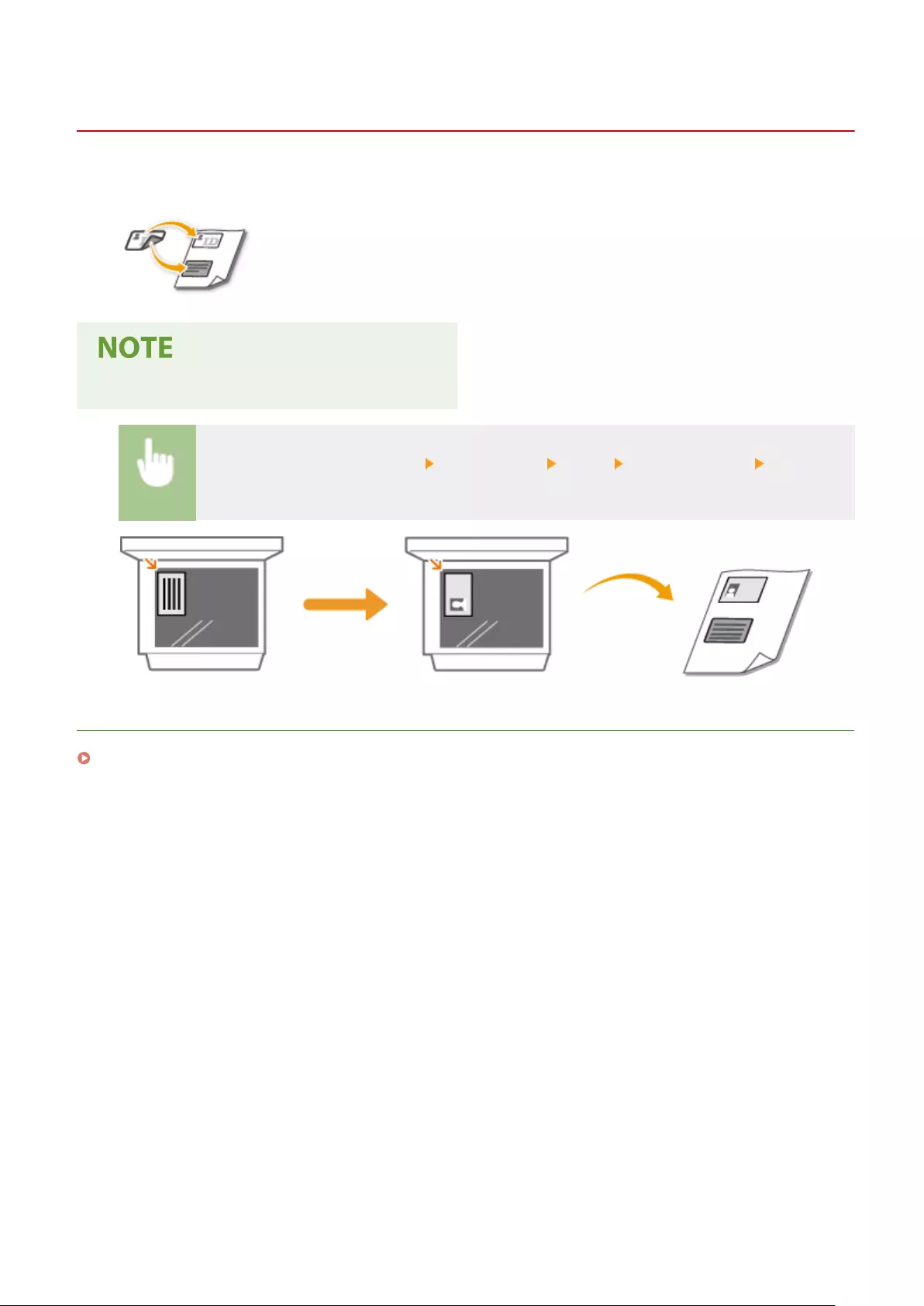
Making ID Card Copies
6FR5-049
1660-048
You can use <ID Card Copy> to copy the front and back sides of a card onto the same
side of a page. This function is useful when copying a driver's license or ID card.
●<Copy Ratio> is automatically set to <100% 1:1>.
Place the card on the platen glass <ID Card Copy> <Start> Turn the card over <Scan Next
Original>
LINKS
Basic Copy Operations(P. 195)
Copying
210
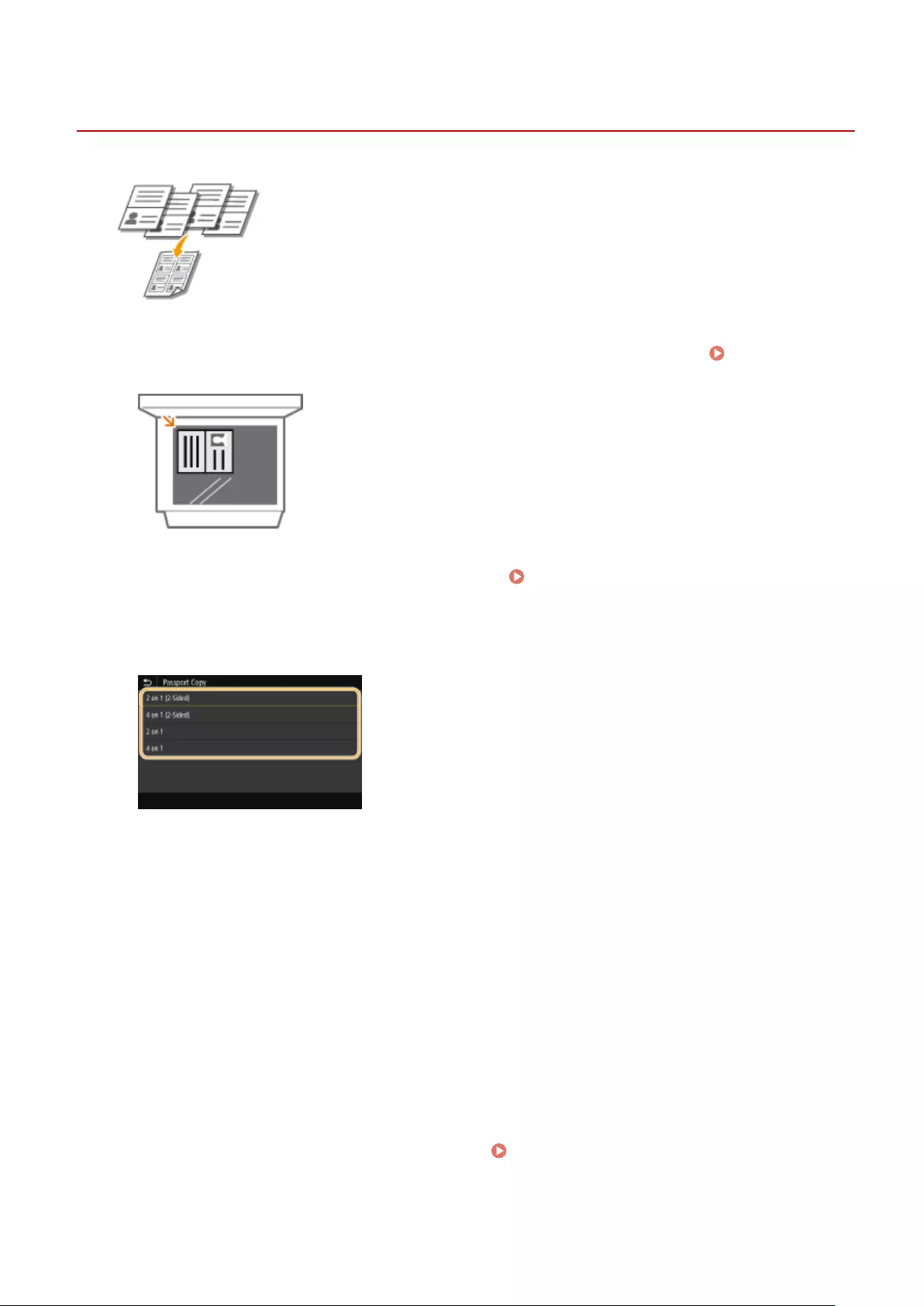
Making Passport Copies
6FR5-04A
You can copy multiple passports onto one sheet.
1Place the passport with the desired pages open on the platen glass. Placing
Originals(P. 137)
2Select <Passport Copy> in the Home screen. Home Screen(P. 124)
3Select the layout.
<2 on 1 (2-Sided)>
Copies four facing pages of passports onto one side of paper in total. Copies eight facing pages of passports
onto both sides of paper in total.
<4 on 1 (2-Sided)>
Copies eight facing pages of passports onto one side of paper in total. Copies 16 facing pages of passports
onto both sides of paper in total.
<2 on 1>
Copies four facing pages of passports onto one side of paper in total.
<4 on 1>
Copies eight facing pages of passports onto one side of paper in total.
4Select the paper source that contains the paper you want to use.
5Congure the copy settings as necessary. Basic Copy Operations(P. 195)
Copying
211

6Select <Start>.
➠The rst passport is scanned.
7Place the next passport on the platen glass, and select <Scan Next Original>.
●You can also specify <Density> separately for each passport.
●Repeat this step until you nish scanning all of the passports.
8Select <Start Printing>.
LINKS
Basic Copy Operations(P. 195)
Copying
212

Faxing
Faxing ................................................................................................................................................................... 214
Fax Basic Features Screen ................................................................................................................................. 217
Basic Operations for Sending Faxes ................................................................................................................. 218
Canceling Sending Faxes .............................................................................................................................. 226
Receiving Faxes ................................................................................................................................................. 227
Useful Functions When Sending ....................................................................................................................... 230
Recalling Previously Used Settings for Sending (Recall Settings) .................................................................. 231
Sending a Fax after a Phone Call (Manual Sending) ...................................................................................... 234
Saving a Copy of a Sent Original ................................................................................................................... 236
Various Receiving Methods .............................................................................................................................. 238
Saving Received Documents into the Machine (Memory Reception) ............................................................. 239
Forwarding the Received Documents Automatically ...................................................................................... 241
Checking Status and Log for Sent and Received Documents ......................................................................... 244
Sending Faxes from Your Computer (PC Fax) .................................................................................................. 246
Sending PC Faxes ......................................................................................................................................... 247
Using Internet Fax (I-Fax) ................................................................................................................................. 249
Sending I-Faxes ............................................................................................................................................ 250
Receiving I-Faxes .......................................................................................................................................... 257
Faxing
213
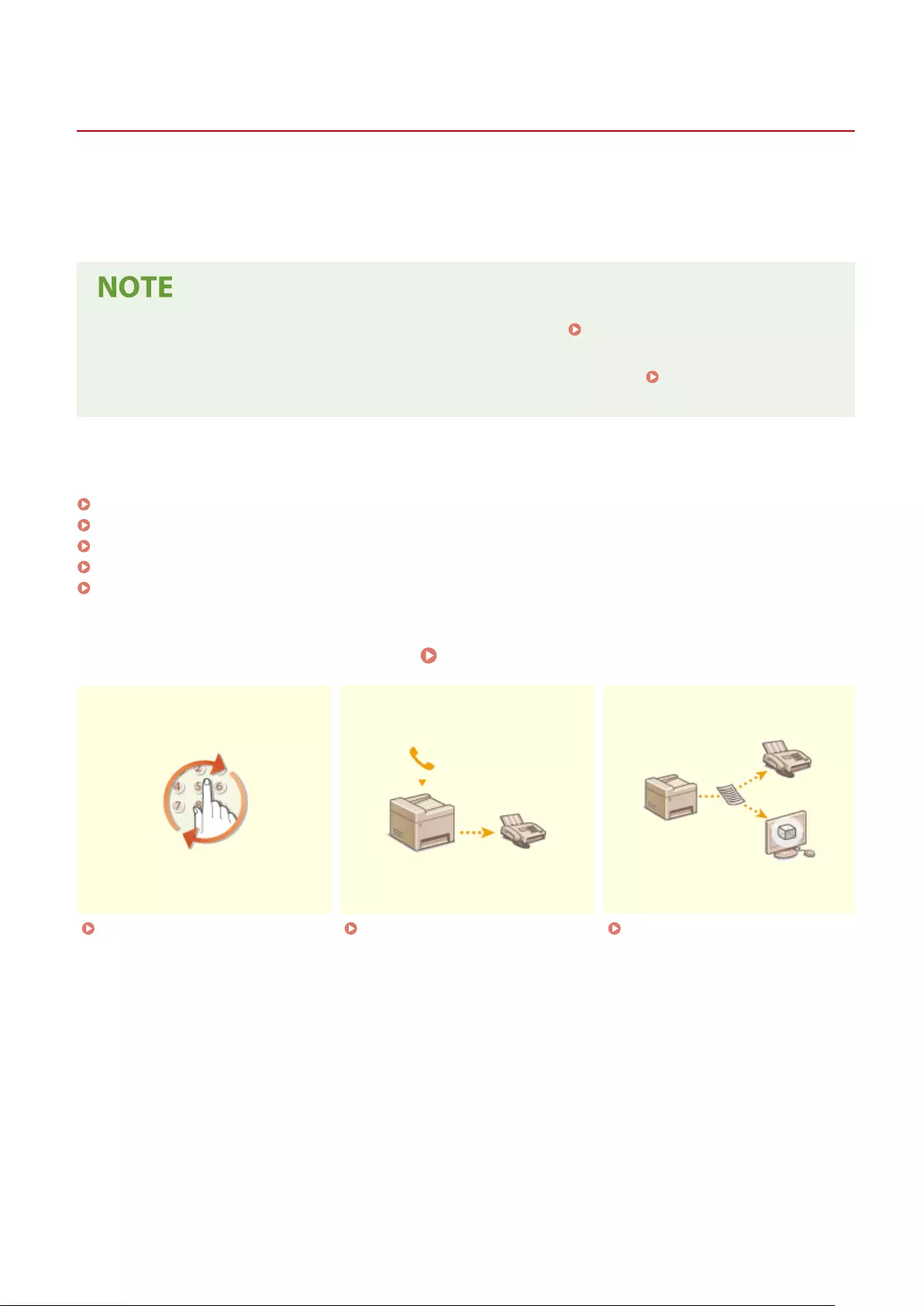
Faxing
6FR5-04C
1660-049
This chapter describes fax settings, basic fax operations and various other useful functions to suit your needs, such as
PC Fax to send documents directly from computers, Address Book to specify destinations easily, and Forwarding to
receive faxes even when you are out of the oce.
●You need to complete some procedures before using fax functions. Conguring Initial Settings for Fax
Functions(P. 78)
●You need to register destinations in the Address Book before using this feature. Registering
Destinations(P. 180)
◼Using Basic Operations
Fax Basic Features Screen(P. 217)
Basic Operations for Sending Faxes(P. 218)
Canceling Sending Faxes(P. 226)
Receiving Faxes(P. 227)
Checking Status and Log for Sent and Received Documents(P. 244)
◼Using Useful Functions When Sending Useful Functions When Sending(P. 230)
Recalling Previously Used
Settings for Sending (Recall
Settings)(P. 231)
Sending a Fax after a Phone Call
(Manual Sending)(P. 234)
Saving a Copy of a Sent
Original(P. 236)
Faxing
214
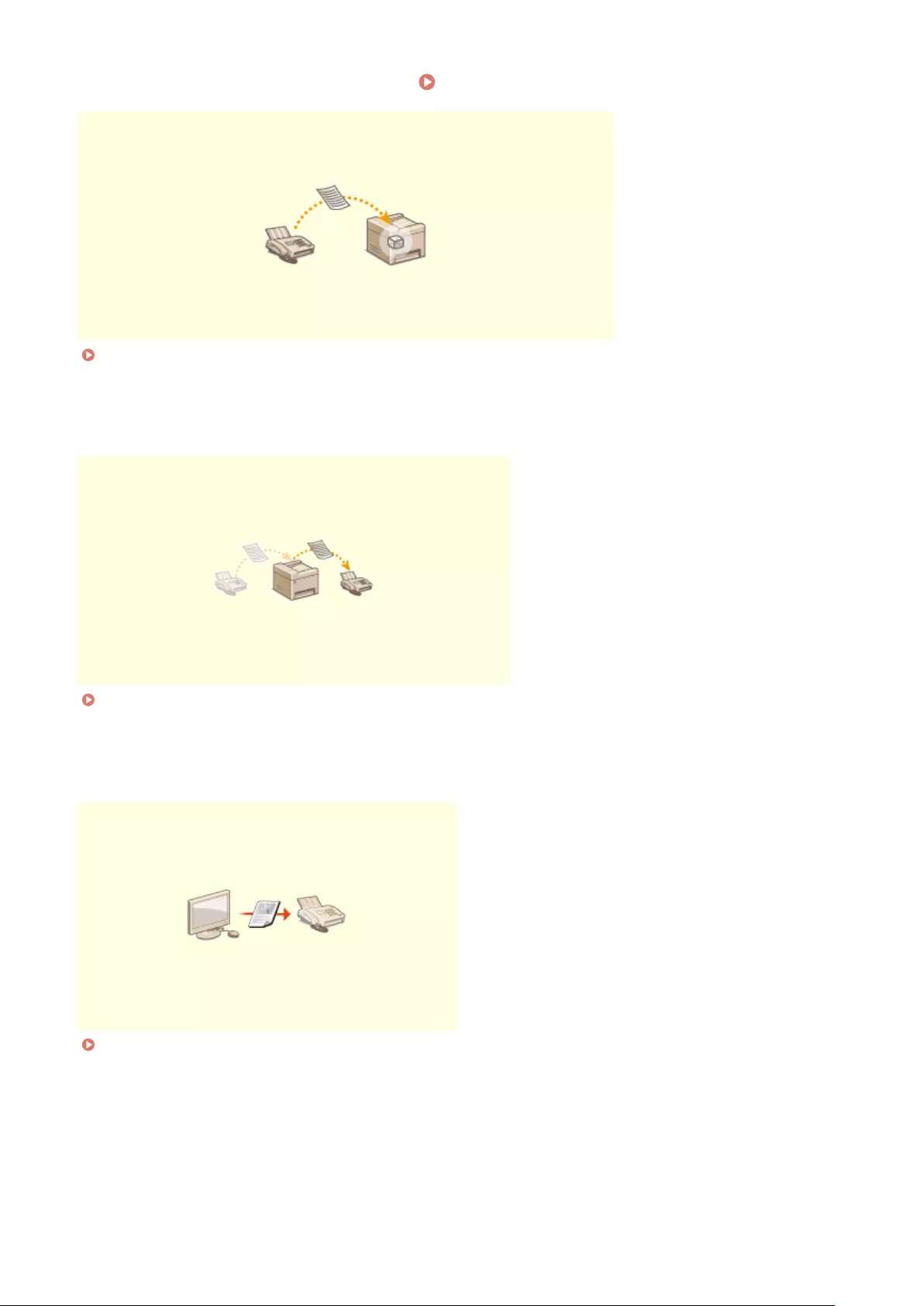
◼Receiving According to Your Purposes Various Receiving Methods(P. 238)
Saving Received Documents into the Machine (Memory Reception)(P. 239)
◼Forwarding All the Received Documents
Forwarding the Received Documents Automatically(P. 241)
◼Sending Faxes Directly from Your Computer
Sending Faxes from Your Computer (PC Fax)(P. 246)
Faxing
215

Fax Basic Features Screen
6FR5-04E
Selecting <Fax> in the Home screen displays the FAX Basic Features screen that appears when you sending faxes.
<Enter Dest.> tab
Select this tab to directly enter a destination.
<Specify Destination> tab
Select this tab to search for an LDAP server, enter a coded dial, or specify a destination using the recall
settings.
Basic Operations for Sending Faxes(P. 218)
Recalling Previously Used Settings for Sending (Recall Settings)(P. 231)
<TX/RX Settings> tab
Select this tab to specify the scanning settings. You can change the RX mode ( Deciding Which Fax
Receive Mode to Use(P. 79) ) of the machine.
<Conrm Destination>
You can check the name and fax number of specied destinations as well as the number of specied
destinations. You can also change the fax number or cancel specication of destinations.
<Address Book>
Specify destinations registered in the Address Book.
<Reset>
You can collectively restore the default settings.
<Start>
Use this button to start faxing.
Faxing
217
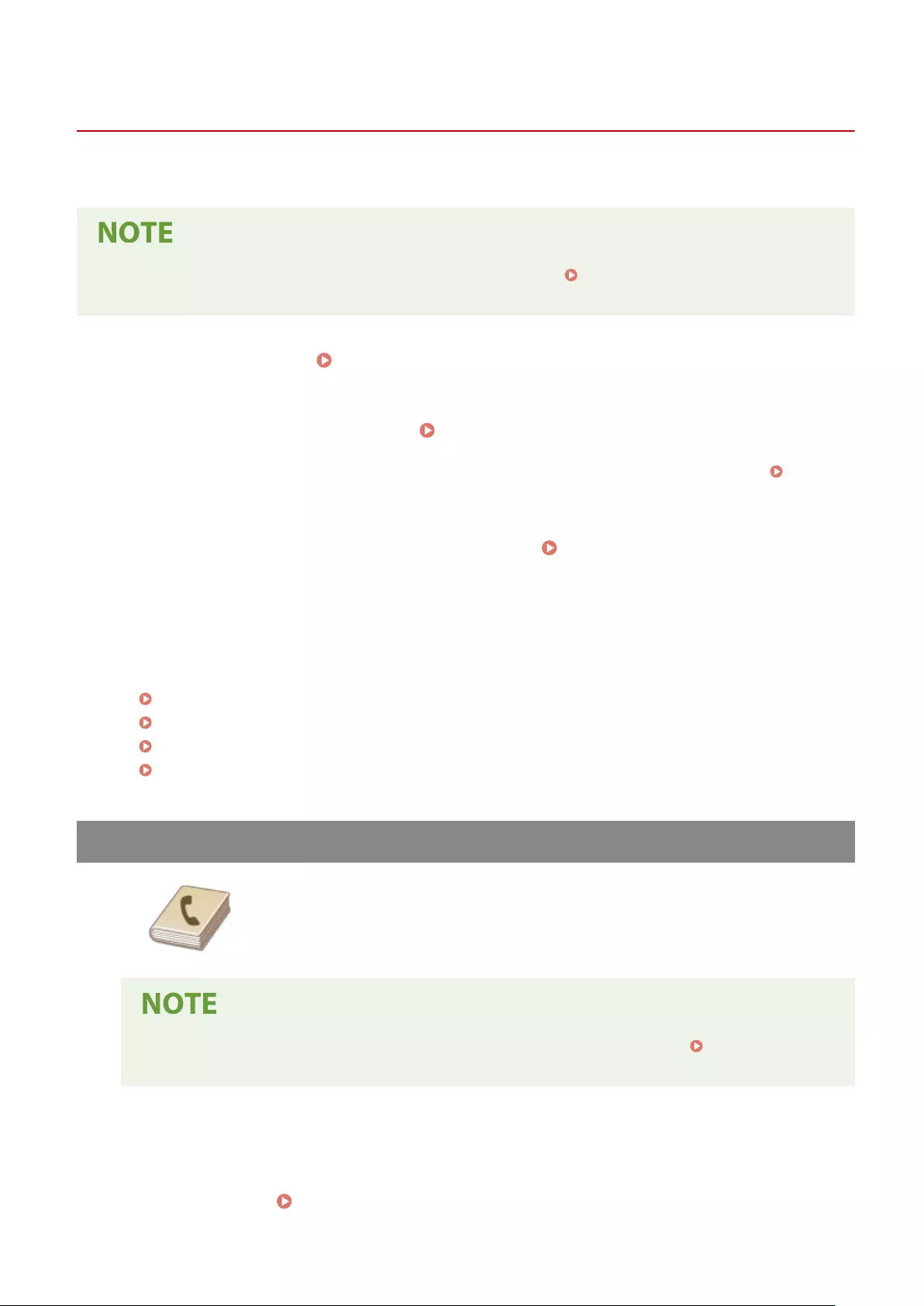
Basic Operations for Sending Faxes
6FR5-04F
This section describes the basic operation procedure used to fax an original.
●You need to complete some procedures before using fax functions. Conguring Initial Settings for Fax
Functions(P. 78)
1Place the original(s). Placing Originals(P. 137)
2Select <Fax> in the Home screen. Home Screen(P. 124)
●If the login screen appears, specify the user name, the password, and the authentication server. Logging
in to Authorized Send(P. 135)
3Select <Reset> in the Fax Basic Features screen. Fax Basic Features Screen(P. 217)
●If the destinations set by the previous user are still selected, this can cause transmission errors. Always reset
the settings before sending.
4Specify the destination.
Specifying from Address Book
Specifying from Coded Dial Numbers
Entering Destinations Directly
Specifying Destinations in an LDAP Server
Specifying from Address Book
The Address Book enables you to specify a destination by selecting from a list of
registered destinations or by searching by name for destinations with recipient
names.
●You need to register destinations in the Address Book before using this feature. Registering
Destinations(P. 180)
1Select <Address Book>.
2Select an index. Index(P. 180)
Faxing
218
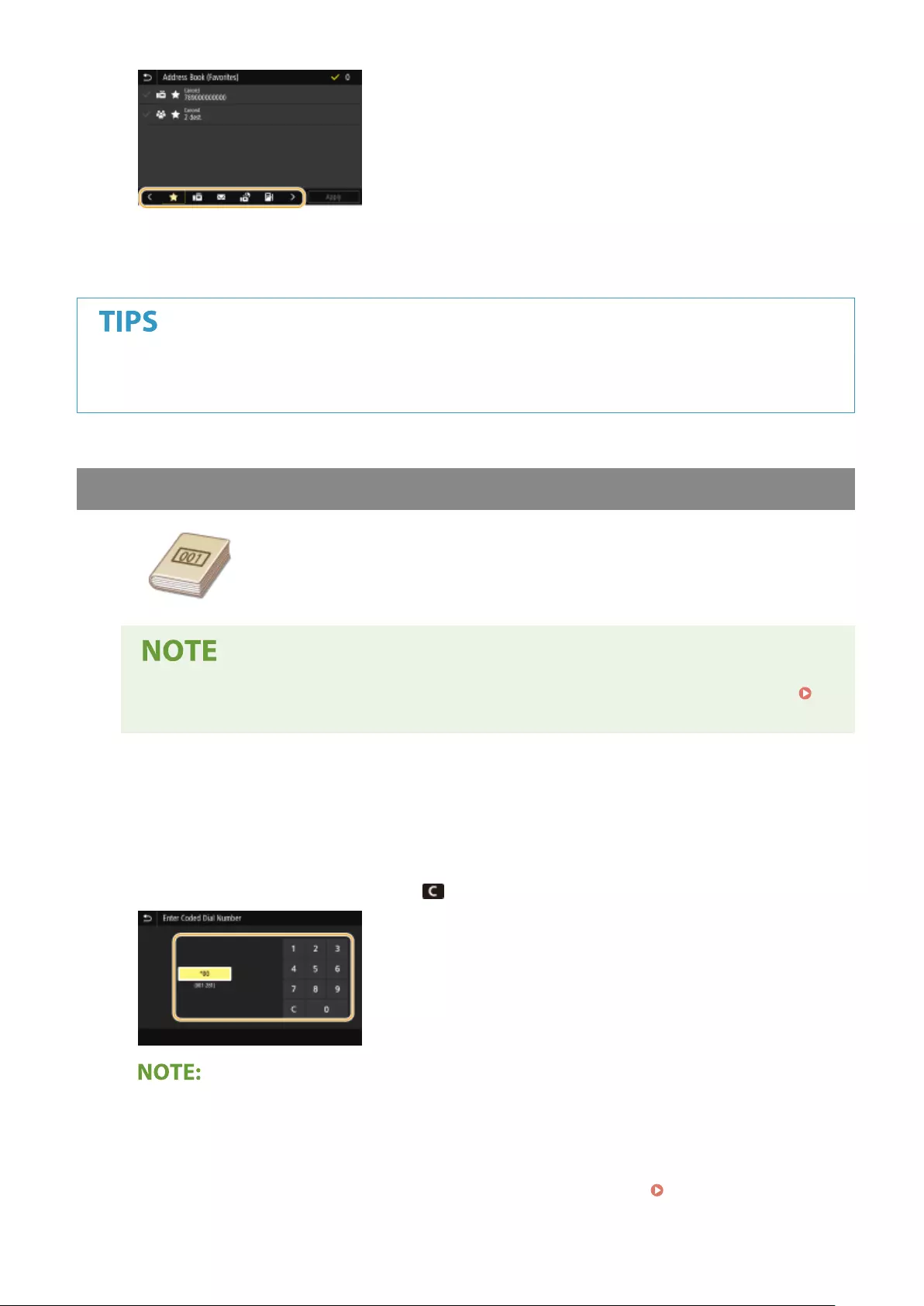
3Select the check box for the desired destination, and select <Apply>.
●If a destination is selected from <Address Book> in the Home screen, the Fax Basic Features screen can be
displayed while the selected destination remains being specied.
Specifying from Coded Dial Numbers
Three-digit numbers (coded dial numbers) are assigned to addresses in the Address
Book. You can specify an address simply by entering its coded dial number.
●To use coded dial numbers, the destination must be registered in the Address Book beforehand.
Registering Destinations(P. 180)
1Select <Coded Dial> in the <Specify Destination> tab.
2Enter a three-digit number.
●If you have entered an incorrect value, use to clear it.
If a conrmation screen appears
●When <Conrm When Coded Dial TX> is set to <On>, a screen is displayed that shows the destination and
the name for the number. (For Group Dial, the destination name and the number of destinations are
shown.) Check the contents and if everything is correct, select <OK>. To specify a different destination,
select <Cancel> and then re-enter the three-digit coded dial number. Displaying Destinations in
Address Book(P. 416)
Faxing
219
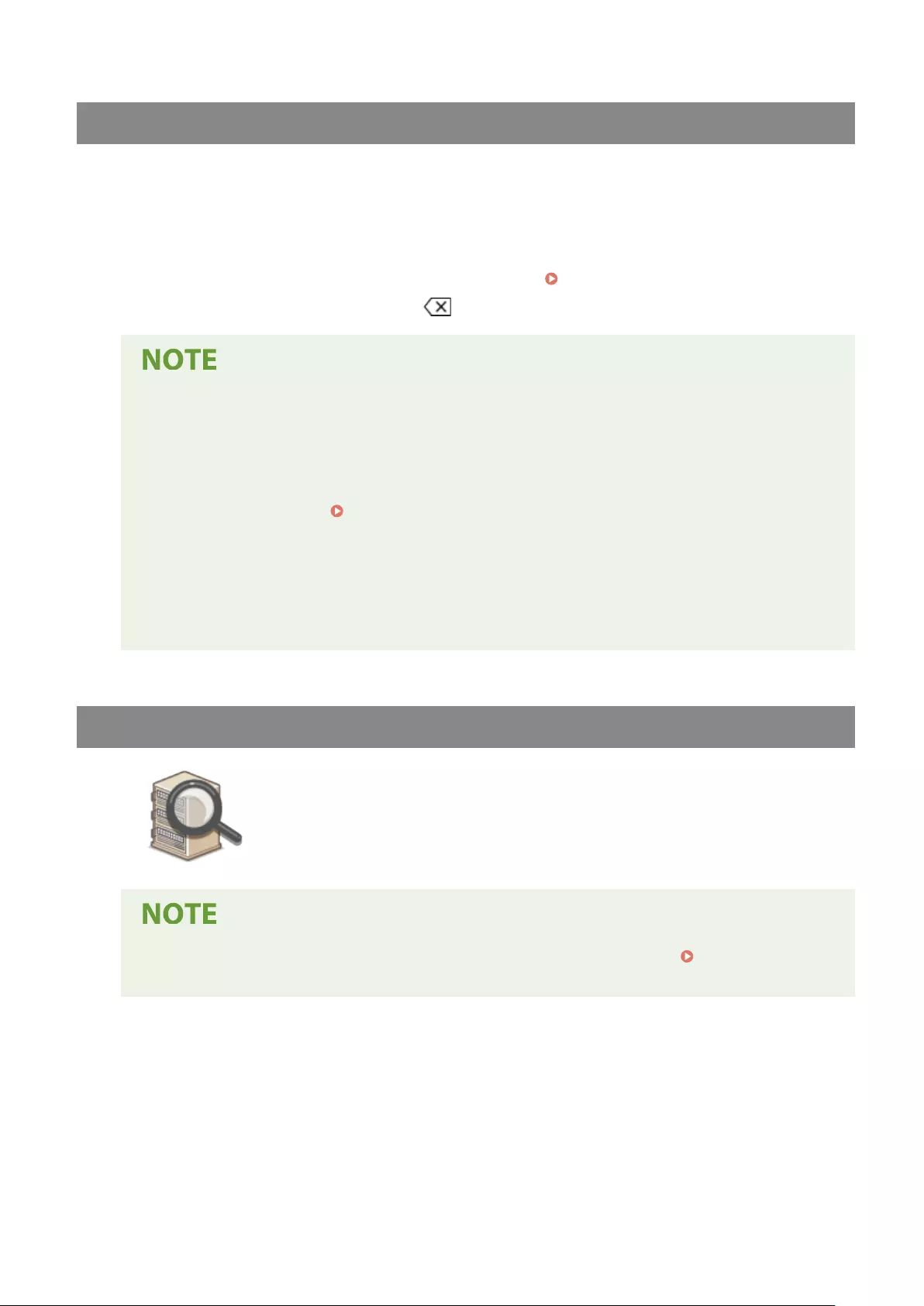
Entering Destinations Directly
For a destination that is not registered in the Address Book, specify it by entering a fax number.
1Enter the fax number in the <Enter Dest.> tab.
●If your machine is connected to a PBX (Private Branch Exchange), select <R> before entering the destination.
If <R> is not available, you need to register the R-key settings. <R-Key Setting>(P. 543)
●If you have entered an incorrect value, use to clear it.
Adding a destination
●To enter a second or subsequent destination, select <Next Dest.>.
If a conrmation screen appears
●When <Conrm Entered Fax Number> is set to <On>, the input screen reappears so that you can
conrm the destination ( Conrming the Entered Fax Number(P. 418) ). Enter the destination
again.
Sending a fax abroad
●Enter the international access code, the country code, and the fax number to specify the destination.
If you are not able to successfully connect to a recipient, select <Pause> and insert a pause between
numbers.
Specifying Destinations in an LDAP Server
If your oce has an LDAP server installed, you can specify a destination using user
information in the server. Access the LDAP server via the machine to search for the
appropriate user information and specify it as destination.
●You need to specify the settings for connecting to an LDAP server beforehand. Registering LDAP
Servers(P. 64)
1Select <LDAP Server> in the <Specify Destination> tab.
2Select the LDAP server you are using.
3Select conditions for user information to be searched.
Faxing
220
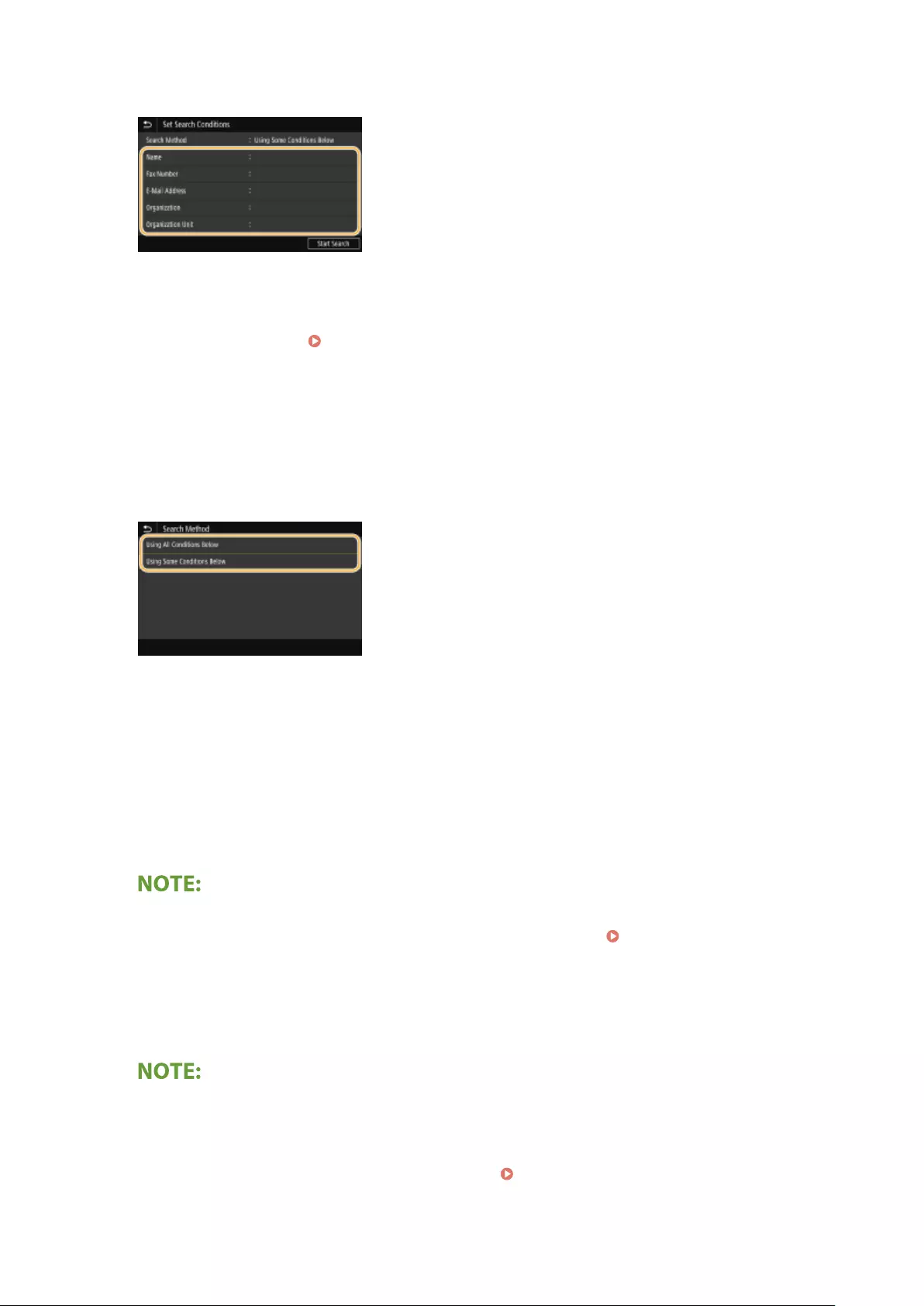
●Name, fax numbers, e-mail addresses, organization names, and organization unit are available criteria for
searching destinations.
4Enter the search target character string, and select <Apply>.
●On how to enter text, see Entering Text(P. 133) .
●To specify multiple search criteria, repeat steps 3 and 4.
5Select <Search Method>.
6Select conditions to display the search result.
<Using All Conditions Below>
Searches and displays the users that meet all the search criteria specied in steps 3 and 4.
<Using Some Conditions Below>
If users that meet even one of the criteria specied in steps 3 and 4 are found, displays all those users.
7Select <Start Search>.
➠The users meeting your search criteria are displayed.
●If the authentication screen appears when you select <Start Search>, enter the user name of the machine
and the password registered in the LDAP server, and select <Apply>. Registering LDAP Servers(P. 64)
8Select the check box for the user that you want to specify as destination, and select
<Apply>.
Adding a destination
●To send a fax to multiple destinations at a time (sequential broadcast), repeat the appropriate steps to
enter all destinations.
●You can also recall previously used destinations. Recalling Previously Used Settings for Sending
(Recall Settings)(P. 231)
Faxing
221
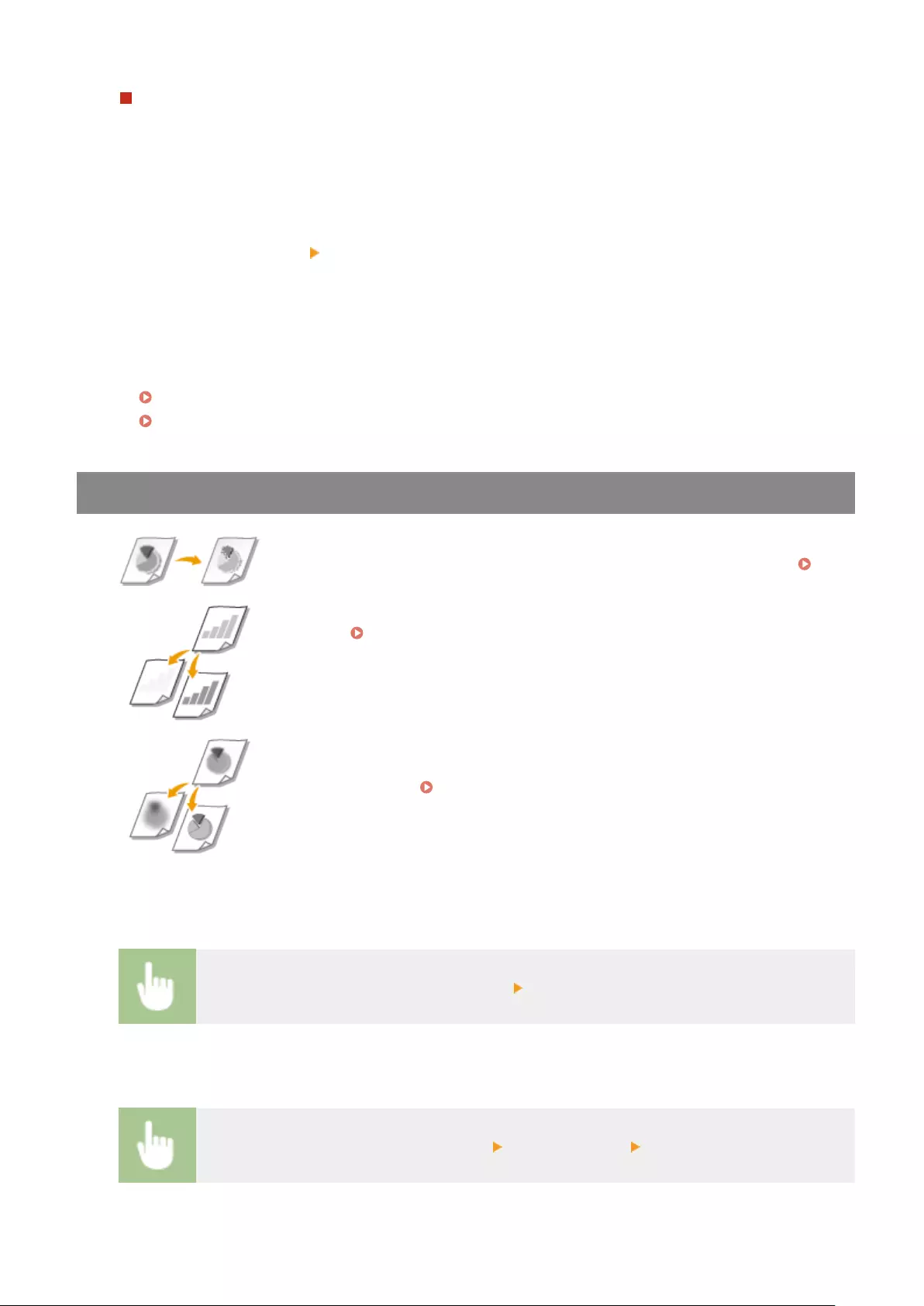
To delete destinations
If you specied multiple destinations, you can delete destinations as necessary.
1Select <Conrm Destination>.
2Select the check box for the destination to be deleted, and select <Remove from Dest.>.
●If you select the Group Dial check box, you can view the destinations registered in the group by
selecting <Details> <Destination>.
3Select <Yes>.
5Specify the scanning settings as necessary.
Adjusting Image Quality
Scanning 2-Sided Originals
Adjusting Image Quality
You can select the resolution suitable for your original type. The higher the
resolution is, the clearer the image becomes, but the longer it takes to send.
Selecting Resolution(P. 222)
You can adjust the density of the fax if the text or images in an original are too light
or dark. Adjusting Density(P. 222)
You can adjust the sharpness of the image. Increase the sharpness to sharpen
blurred text and lines, or decrease the sharpness to improve the appearance of
magazine photos. Adjusting Sharpness(P. 223)
◼Selecting Resolution
Select <Resolution> in the <TX/RX Settings> tab Select the resolution
◼Adjusting Density
Select <Density> in the <TX/RX Settings> tab Adjust the density <Apply>
Faxing
222
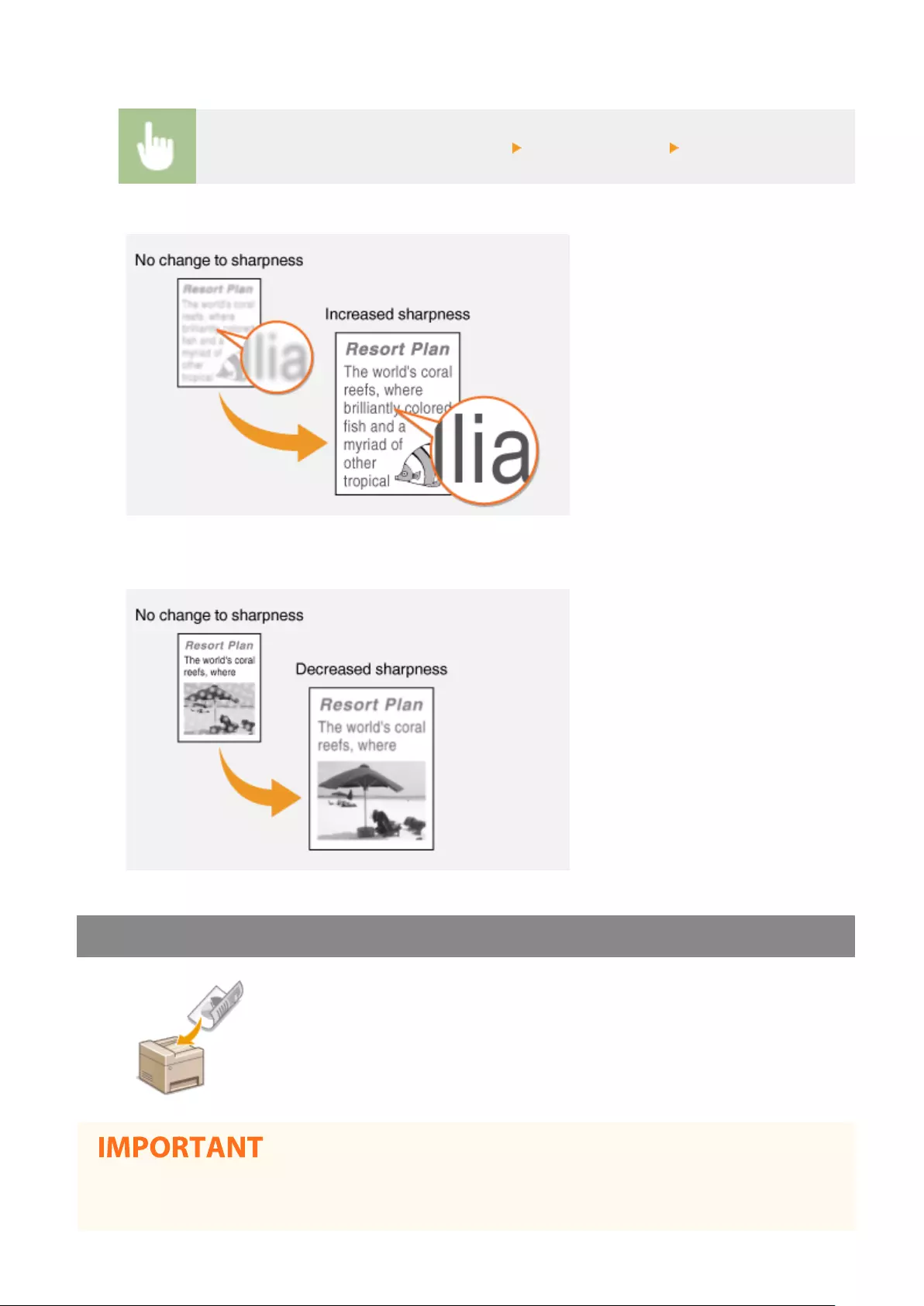
◼Adjusting Sharpness
Select <Sharpness> in the <TX/RX Settings> tab Adjust the sharpness <Apply>
Example: If you want to sharpen text and lines written in pencil
Example: If you want to improve the appearance of magazine photos
Scanning 2-Sided Originals
The machine can automatically scan the front and back sides of originals in the
feeder.
●The machine cannot scan both sides of originals automatically when the originals are placed on the platen
glass or when the machine is set to Manual Sending.
Faxing
223
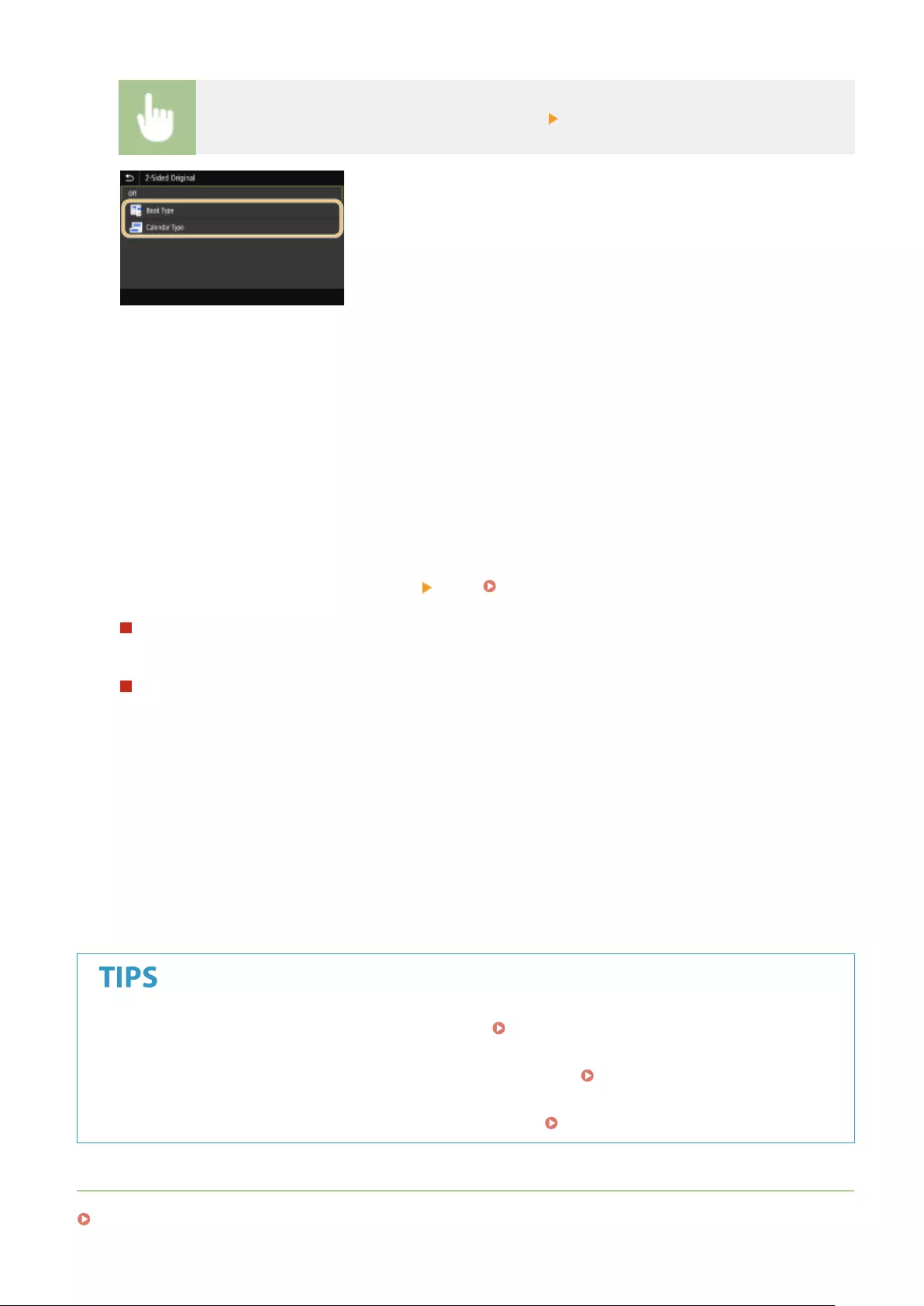
Select <2-Sided Original> in the <TX/RX Settings> tab Select <Book Type> or <Calendar Type>
<Book Type>
Select for originals whose images on the front and back sides face the same direction.
<Calendar Type>
Select for originals whose images on the front and back sides face in opposite directions.
6Select <Start>.
●If the <Conrm Destination> screen is displayed, check whether the destination is correct, and then select
<Start Scanning>.
➠Scanning of the original starts.
●If you want to cancel, select <Cancel> <Yes>. Canceling Sending Faxes(P. 226)
When placing originals in the feeder in step 1
When scanning is complete, the faxes are sent.
When placing originals on the platen glass in step 1
When scanning is complete, follow the procedure below.
1Select the original size.
●When there is only one page to be scanned, proceed to step 3.
2Place the next original on the platen glass, and select <Scan Next>.
●Repeat this step until you nish scanning all of the pages.
3Select <Start Sending>.
➠The faxes are sent.
●If you always want to send faxes with the same settings: Changing the Default Settings for
Functions(P. 174)
●If you want to register a combination of settings to use when needed: Registering Frequently Used
Settings(P. 172)
●If you want to sound an alarm when the handset is off the hook: <Off-Hook Alarm>(P. 540)
LINKS
Canceling Sending Faxes(P. 226)
Faxing
224
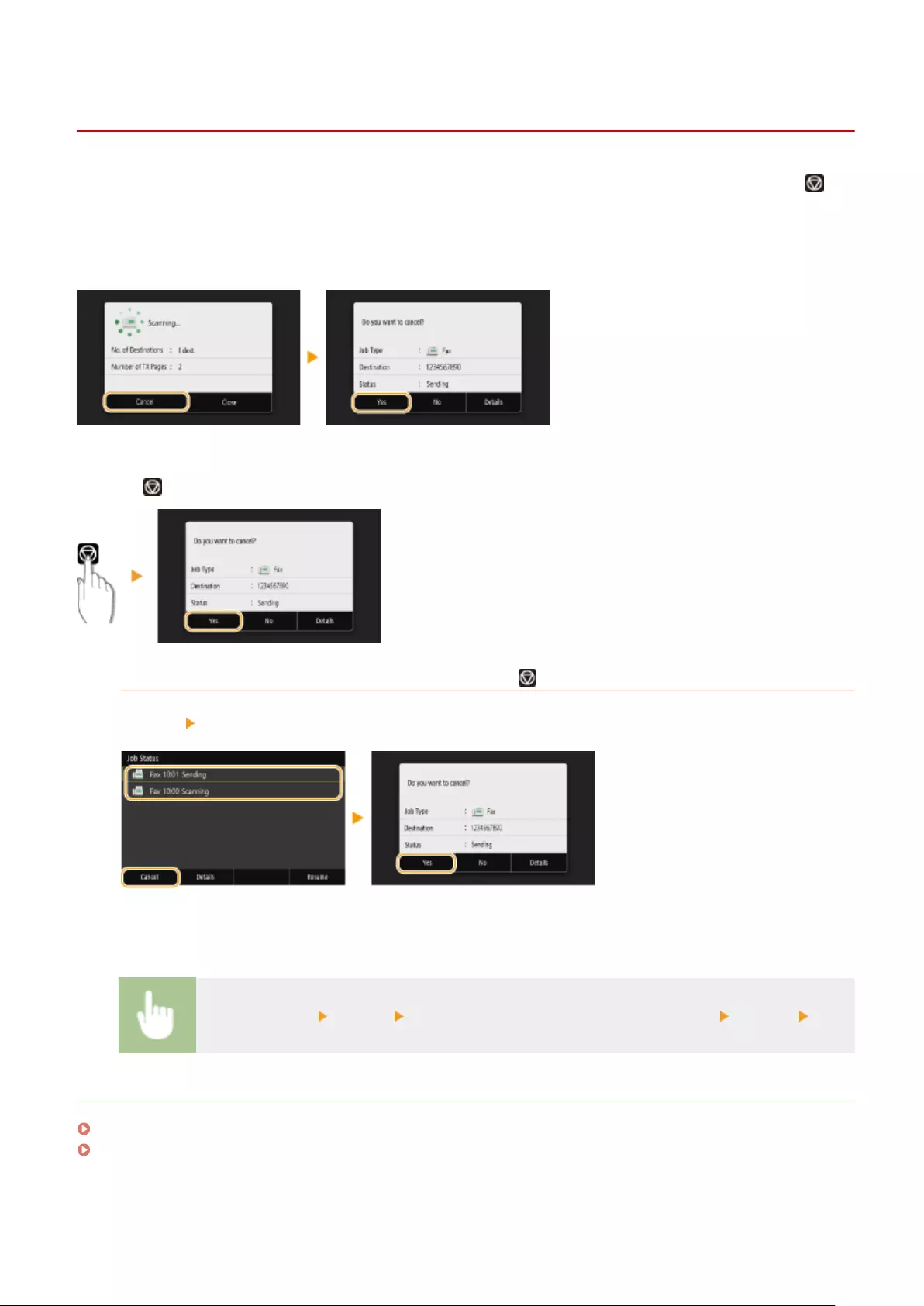
Canceling Sending Faxes
6FR5-04H
If you want to cancel sending faxes immediately after selecting <Start>, select <Cancel> on the display or press on
the operation panel. You can also cancel sending faxes after checking the fax status.
◼Select <Cancel> on the screen during fax transmission
◼Press to cancel
If the screen displays a list of documents when is pressed
Originals have been scanned and are waiting to be processed. Select the document to cancel, and select
<Cancel> <Yes>.
◼Check the transmission status before canceling
<Status Monitor> <TX Job> Select the document in the <TX Job Status> tab <Cancel> <Yes>
LINKS
Basic Operations for Sending Faxes(P. 218)
Checking Status and Log for Sent and Received Documents(P. 244)
Faxing
226
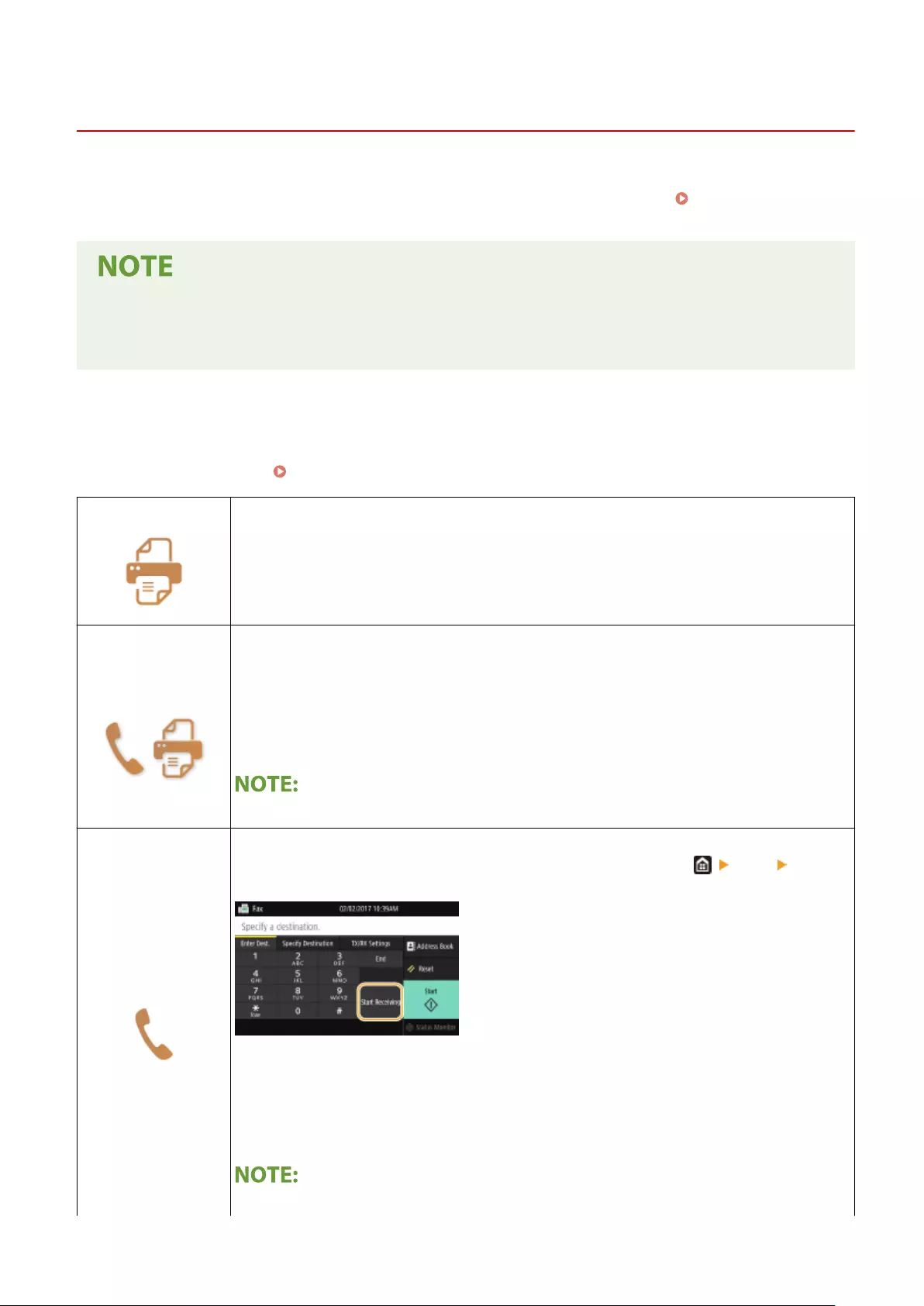
Receiving Faxes
6FR5-04J
This section describes the methods for receiving faxes and how to set up the machine to receive faxes. You need to
complete some procedures for using fax functions before specifying the receiving settings. Conguring Initial
Settings for Fax Functions(P. 78)
●The machine can print received fax documents on A4 or Letter size paper. If received fax documents are
printed on other paper sizes, a portion of the page may not be printed or a page may be printed on two
separate sheets of paper.
◼Methods for Receiving Faxes
The machine provides the following receiving methods. Select the method that best suits your needs and then set it up
by following the procedure in Setting Up the Machine to Receive Faxes(P. 228) .
<Auto>
Dedicated to receiving faxes
The machine receives faxes automatically. Even if someone makes a call to you, you cannot
talk to the caller.
<Fax/Tel (Auto
Switch)>
When the call is a fax
The machine receives the fax automatically.
When the call is a telephone call
An incoming call rings. Pick up the handset to answer the call.
●You need to connect your telephone or the optional handset to the machine beforehand.
<Manual>
When the call is a fax
An incoming call rings. Pick up the handset. If you hear a beep, select <Fax> <Start
Receiving> to receive faxes.
When the call is a telephone call
An incoming call rings. Pick up the handset. If you do not hear a beep, start your
conversation.
●You need to connect your telephone or the optional handset to the machine beforehand.
Faxing
227
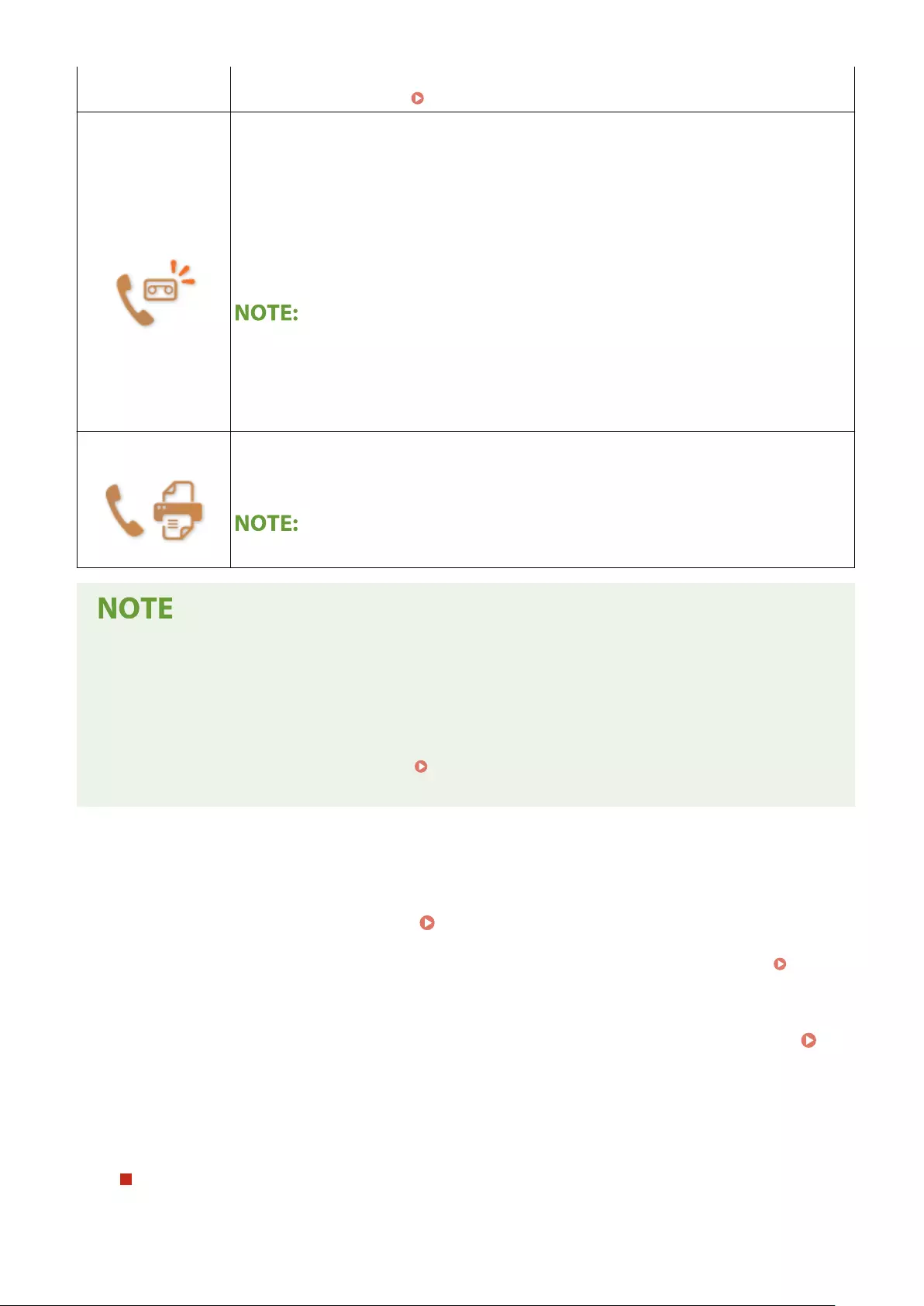
●You can set the machine to automatically receive faxes when an incoming call rings within
a specied timeframe. <Switch to Auto RX>(P. 550)
<Answering
Machine>
When the call is a fax
After an incoming call rings, the machine receives the fax automatically.
When the call is a telephone call
The answering machine activates, enabling the caller to leave a message. If you pick up the
handset before the answering machine starts recording a message, you can talk with the
caller.
●You need to connect your answering machine to the machine beforehand.
●Set the answering machine to answer after a few rings.
●We recommend that you add approximately 4 seconds of silence at the beginning of the
message or set the maximum recording time to 20 seconds.
<Net Switch> The machine distinguishes between fax and telephone calls. This mode is only available for
certain countries and requires a subscription to a network switch service.
●You need to connect your telephone or the optional handset to the machine beforehand.
●Depending on the type of telephone connected to it, the machine may not be able to send or receive faxes
properly.
●If you are connecting an external telephone with fax functions, set the telephone to not receive faxes
automatically.
●If you pick up the telephone handset and hear a beep, the call is a fax. You can receive the fax just by using
the telephone to enter a specic ID number. Using a Telephone to Receive Faxes (Remote Reception)
(P. 229)
◼Setting Up the Machine to Receive Faxes
1Select <Fax> in the Home screen. Home Screen(P. 124)
●If the login screen appears, specify the user name, the password, and the authentication server. Logging
in to Authorized Send(P. 135)
2Select <RX Mode> in the <TX/RX Settings> tab of the Fax Basic Features screen. Fax
Basic Features Screen(P. 217)
3Select the receiving method.
When selecting <Fax/Tel (Auto Switch)>
Specify the following three settings as necessary. When the setting is complete, select <Apply>.
Faxing
228
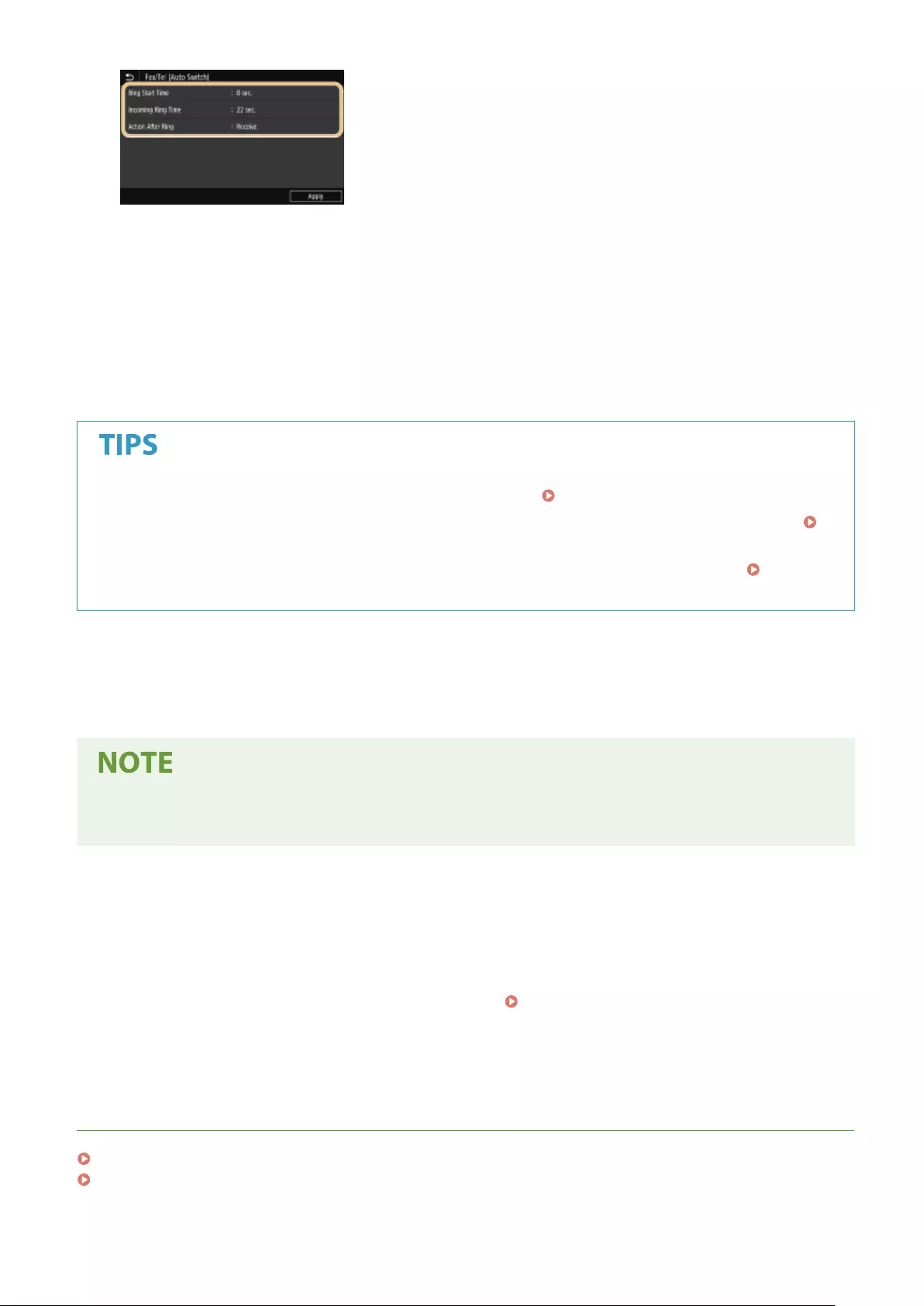
<Ring Start Time>
Enables you to specify the duration during which the machine determines whether an incoming call is a fax or a
telephone call.
<Incoming Ring Time>
Enables you to specify the duration during which an incoming call rings for a telephone call.
<Action After Ring>
Enables you to specify how the machine operates if you do not pick up the handset while an incoming call is
ringing. Select <End> to disconnect the call or <Receive> to receive an incoming fax.
●If you want to print received documents on both sides of paper: <Print on Both Sides>(P. 549)
●If you want to print information, such as reception date and time, at the bottom of received documents:
<Print RX Page Footer>(P. 552)
●If you want to continue printing even when the amount remaining in the toner cartridge is low: <Continue
Print. When Cart. Low>(P. 548)
◼Using a Telephone to Receive Faxes (Remote Reception)
When you pick up the telephone and get a fax signal, you do not need to go to the machine to receive the fax. Just
enter a specic ID number with the telephone, and you can start receiving the fax.
●When the telephone is not directly connected with the machine, the remote reception function is not
available.
1When an incoming call rings, pick up the telephone handset.
2If you hear a beep, enter the ID number for Remote Reception with the telephone.
●For more information about setting the ID number, see <Remote RX>(P. 550) .
3Hang up the handset.
LINKS
Checking Status and Log for Sent and Received Documents(P. 244)
Various Receiving Methods(P. 238)
Faxing
229
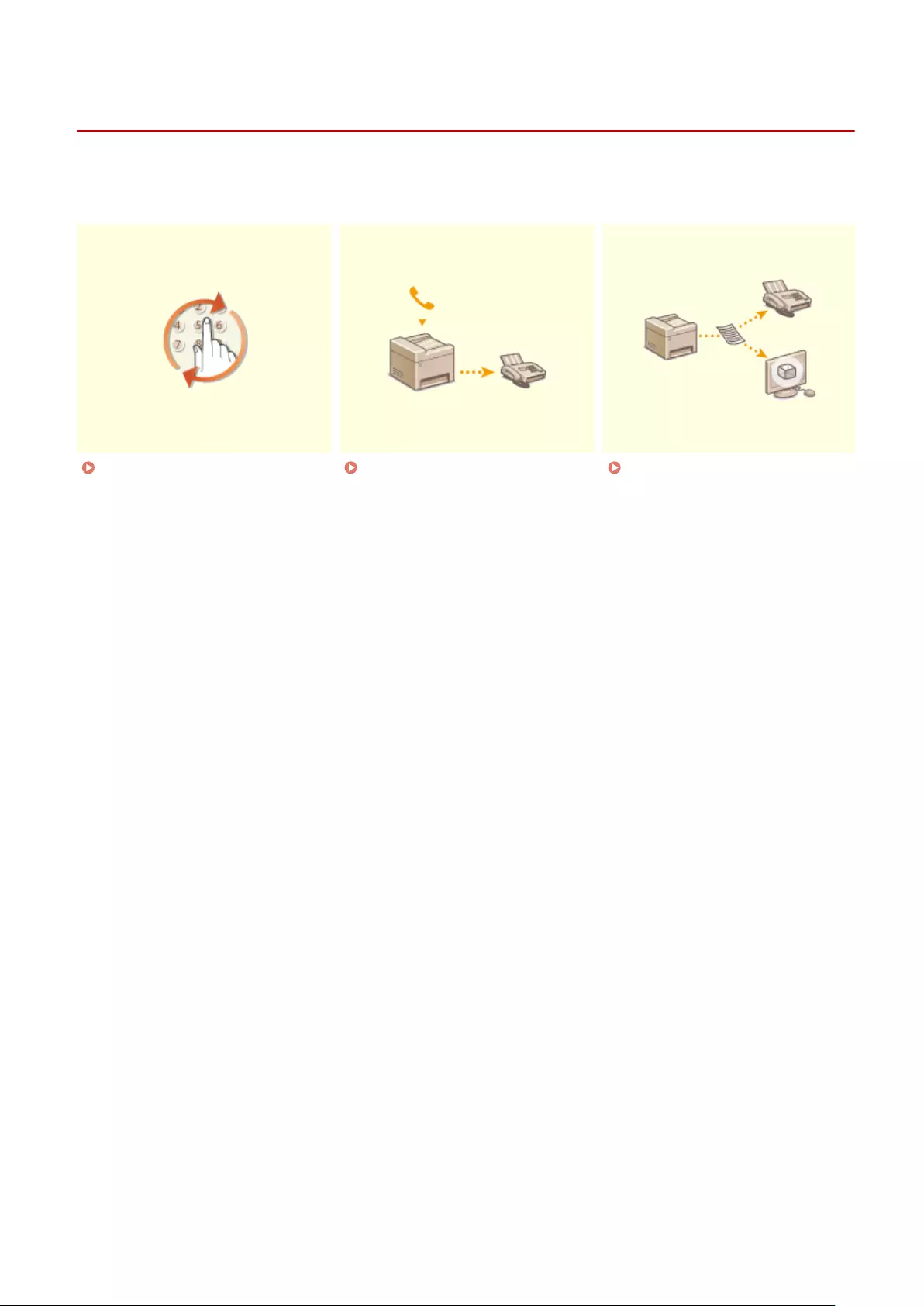
Useful Functions When Sending
6FR5-04K
This section describes how to forward a fax again to a previously specied destination, how to send a fax after a phone
call, and how to save a copy of a fax document.
Recalling Previously Used
Settings for Sending (Recall
Settings)(P. 231)
Sending a Fax after a Phone Call
(Manual Sending)(P. 234)
Saving a Copy of a Sent
Original(P. 236)
Faxing
230
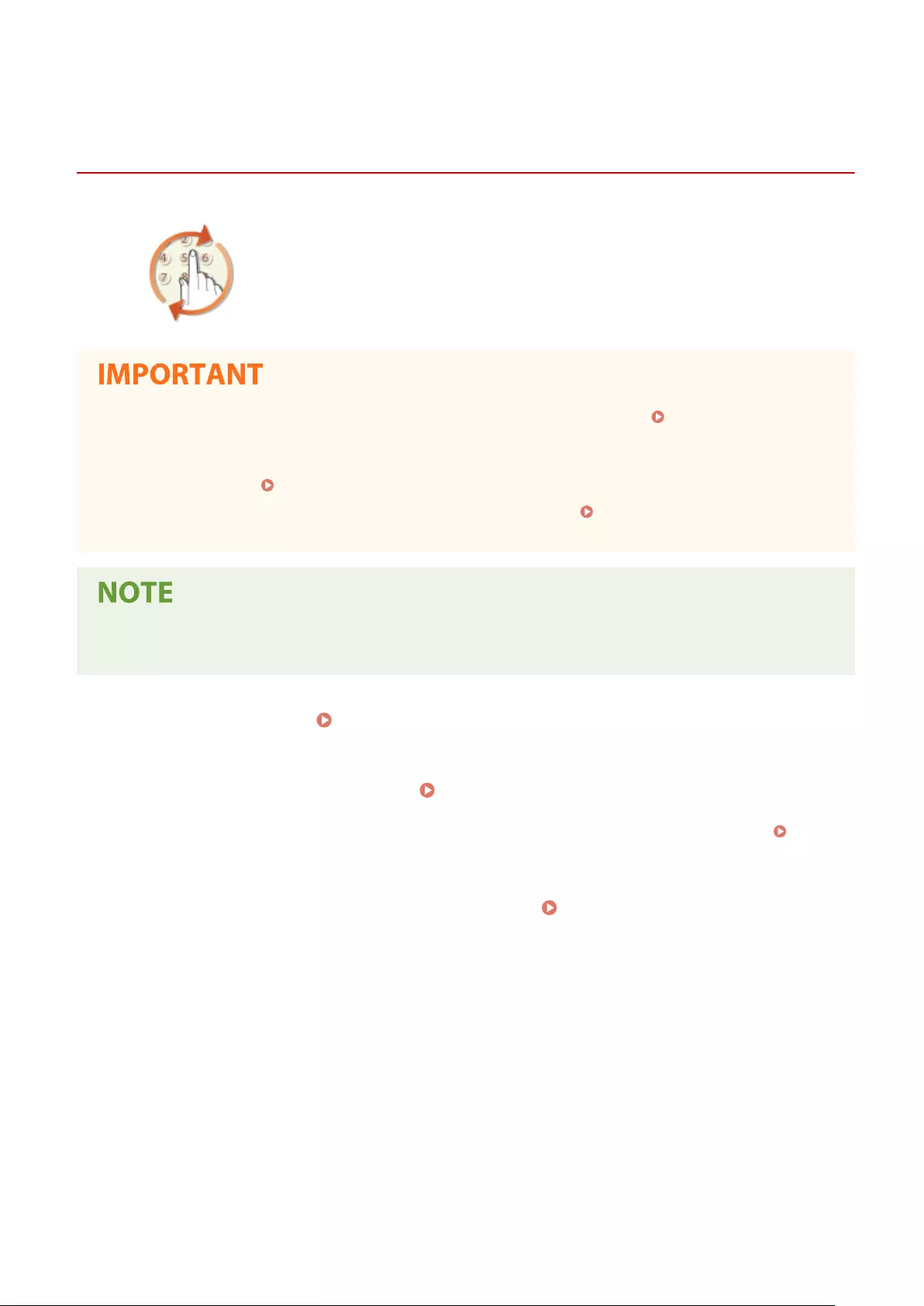
Recalling Previously Used Settings for Sending (Recall
Settings)
6FR5-04L
You can recall the destinations specied in the past. When you specify a previously
used destination, the machine also sets the same fax settings such as density you
used the last time you sent documents to that destination.
●When <Restrict Resending from Log> is set to <On>, you cannot use this feature. Disabling Use of
Previously Used Destinations(P. 416)
●Turning OFF the machine or setting <Restrict New Destinations> to <On> deletes the past destinations, and
disables this feature. Restricting New Destinations that Can Be Specied(P. 416)
●The destinations in Manual Sending are not available for this feature. Sending a Fax after a Phone Call
(Manual Sending)(P. 234)
●When you specify a destination using this feature, any destinations that you have already specied are
deleted.
1Place the original(s). Placing Originals(P. 137)
2Select <Fax> in the Home screen. Home Screen(P. 124)
●If the login screen appears, specify the user name, the password, and the authentication server. Logging
in to Authorized Send(P. 135)
3Select <Reset> in the Fax Basic Features screen. Fax Basic Features Screen(P. 217)
●If the destinations set by the previous user are still selected, this can cause transmission errors. Always reset
the settings before sending.
4Select <Recall Settings> in the <Specify Destination> tab.
5Select the destination.
●When you transmit to multiple destinations, only the address specied for the rst transmission is displayed
in the log, but all the destinations are specied.
Faxing
231
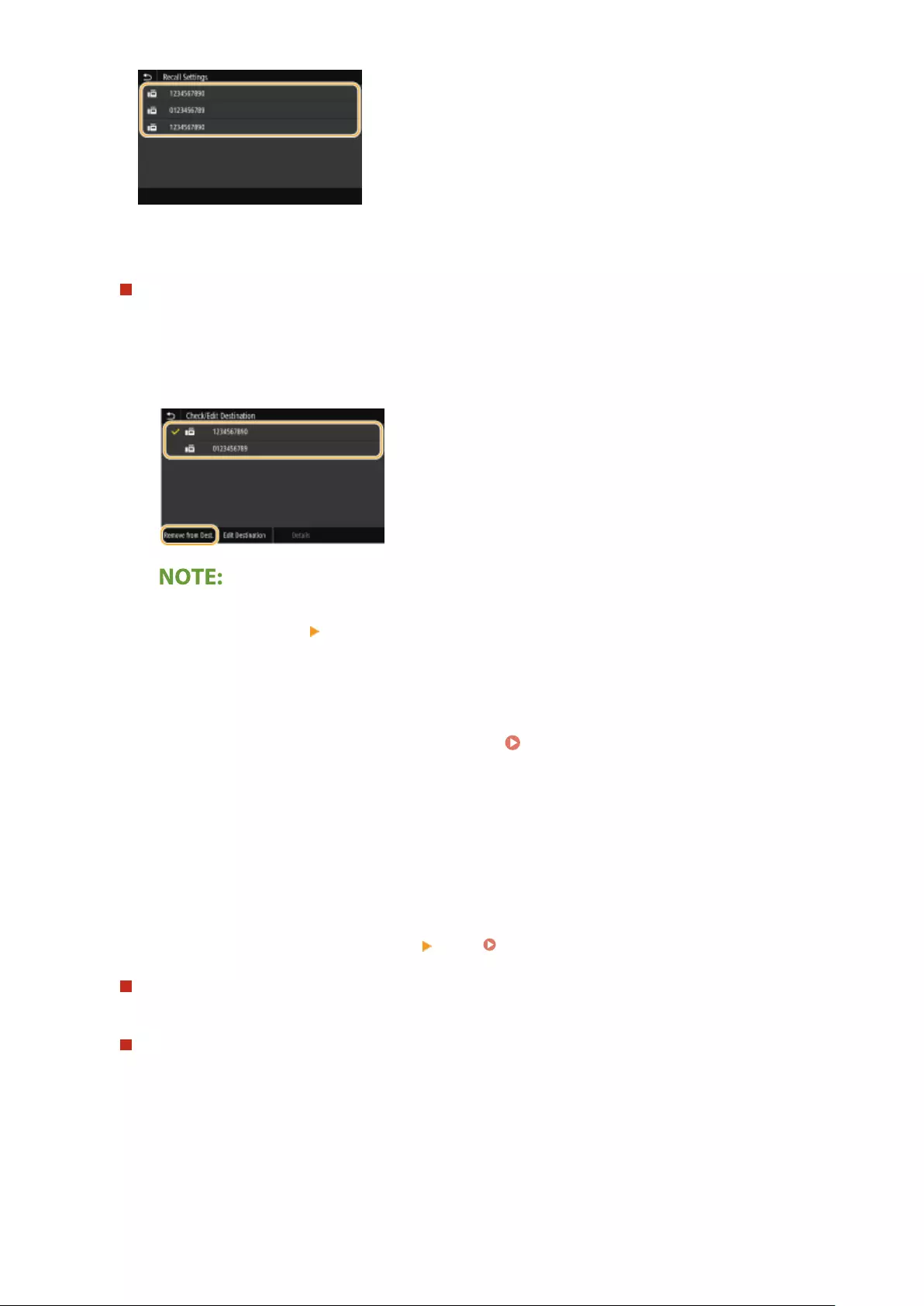
➠The selected destination and the fax settings used at the time are specied. You can also change the
settings before sending.
To delete destinations
When you transmitted to multiple destinations, you can delete destinations as necessary.
1Select <Conrm Destination>.
2Select the check box for the destination to be deleted, and select <Remove from Dest.>.
●If you select the Group Dial check box, you can view the destinations registered in the group by
selecting <Details> <Destination>.
3Select <Yes>.
6Specify the scanning settings as necessary. Basic Operations for Sending
Faxes(P. 218)
7Select <Start>.
●If the <Conrm Destination> screen is displayed, check whether the destination is correct, and then select
<Start Scanning>.
➠Scanning of the original starts.
●If you want to cancel, select <Cancel> <Yes>. Canceling Sending Faxes(P. 226)
When placing originals in the feeder in step 1
When scanning is complete, the faxes are sent.
When placing originals on the platen glass in step 1
When scanning is complete, follow the procedure below.
1Select the original size.
●When there is only one page to be scanned, proceed to step 3.
2Place the next original on the platen glass, and select <Scan Next>.
●Repeat this step until you nish scanning all of the pages.
Faxing
232
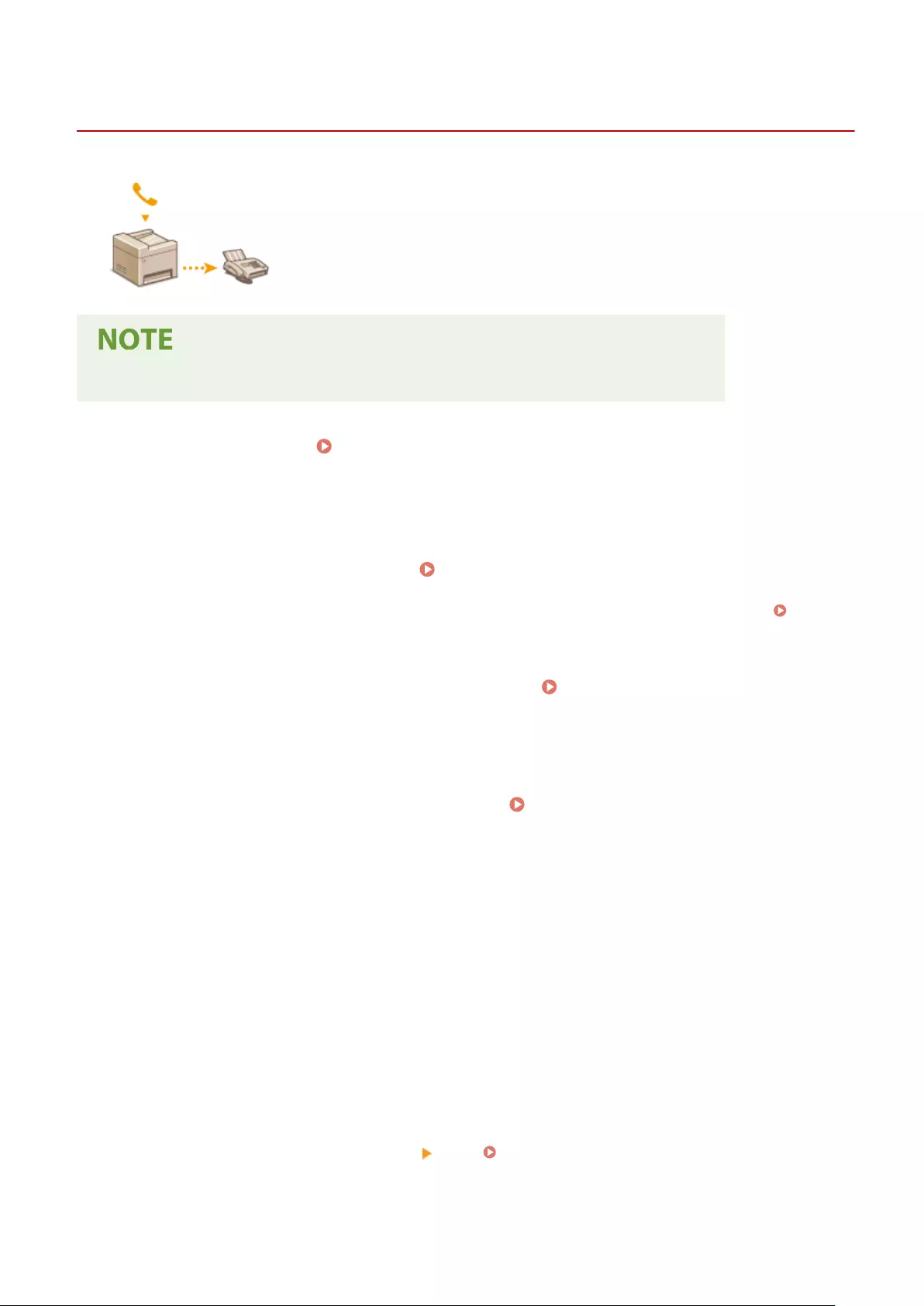
Sending a Fax after a Phone Call (Manual Sending)
6FR5-04R
You can send faxes manually at the end of a phone conversation. When you hear a
beep over the phone, it means the recipient is trying to receive your faxes. Select
<Start> to send your faxes.
●You need to connect your telephone or the optional handset to the machine beforehand.
1Place the original(s). Placing Originals(P. 137)
●The machine cannot automatically scan both sides of the originals in Manual Sending.
●When the original is placed on the platen glass, only one page can be sent.
2Select <Fax> in the Home screen. Home Screen(P. 124)
●If the login screen appears, specify the user name, the password, and the authentication server. Logging
in to Authorized Send(P. 135)
3Select <Reset> in the Fax Basic Features screen. Fax Basic Features Screen(P. 217)
●If the destinations set by the previous user are still selected, this can cause transmission errors. Always reset
the settings before sending.
4Specify the scanning settings as necessary. Basic Operations for Sending
Faxes(P. 218)
5Dial the recipient's fax number.
6Ask the recipient to set their fax machine to receive your faxes.
●If you hear a beep, proceed to step 7.
7Select <Start>.
●If you place the original on the platen glass, select the original size.
➠Scanning of the original starts.
●If you want to cancel, select <Cancel> <Yes>. Canceling Sending Faxes(P. 226)
8Hang up the handset.
Faxing
234
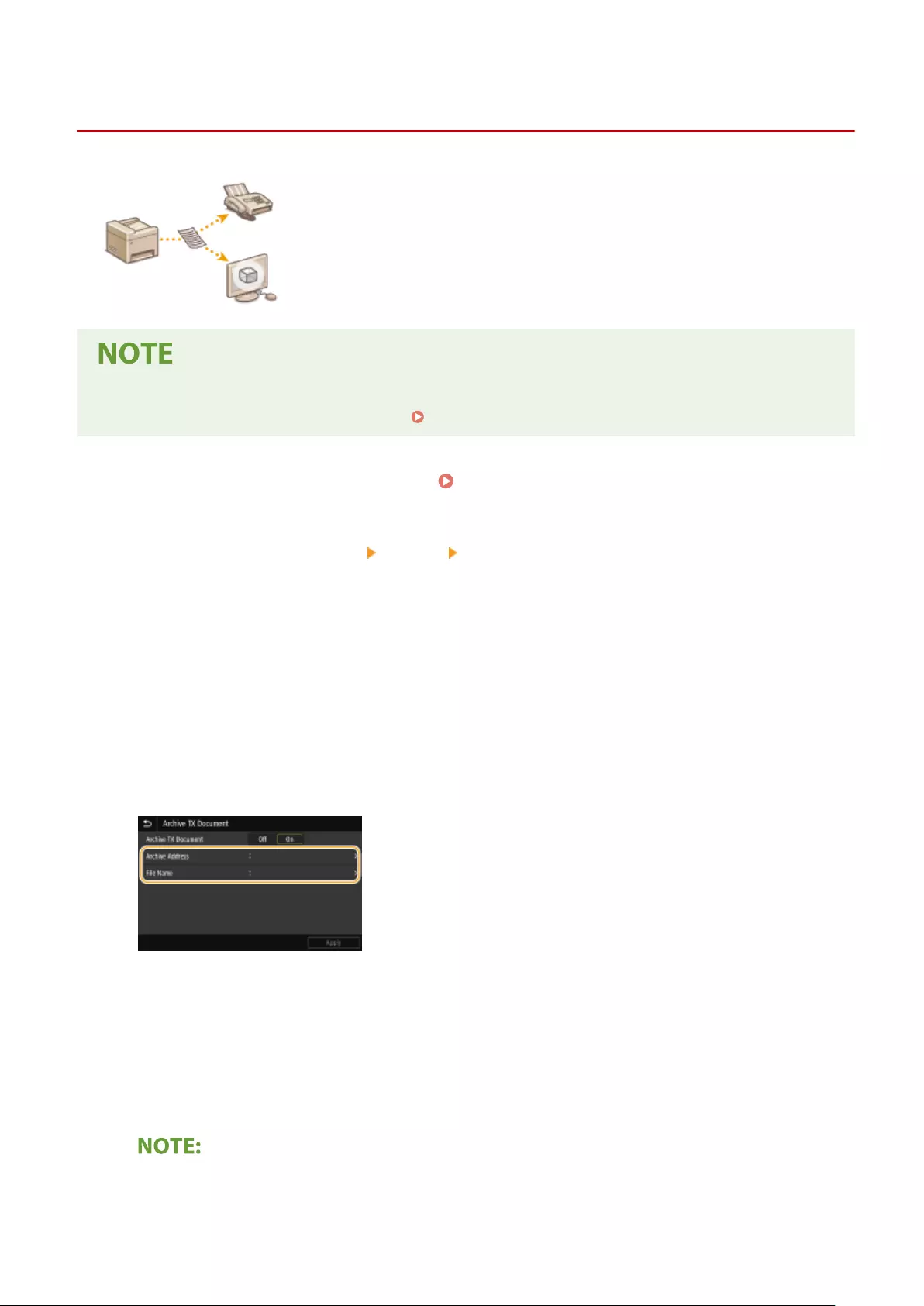
Saving a Copy of a Sent Original
6FR5-04S
In addition to the address specied when the fax is sent, you can also send faxed
documents to a preset storage address for archiving. This is useful for keeping a log
of what has been sent. You can specify a fax number, an e-mail address, a shared
folder on the computer, an FTP server or an I-Fax as the storage address.
●Only destinations in the Address Book can be specied as a storage address. To use the Address Book, the
destination must be registered beforehand. Registering Destinations(P. 180)
1Select <Menu> in the Home screen. Home Screen(P. 124)
2Select <Function Settings> <Send> <Fax Settings>.
3Select <Archive TX Document>.
4Select <On> in <Archive TX Document>.
●When not using the function for archiving sent documents, select <Off>.
5Congure storage of sent documents.
<Archive Address>
Specify the storage destination of sent documents. In the Address Book, select the check box for the
destination to use as the storage location, and select <Apply>.
<File Name>
You can specify a character string to be used in the le name when sending a document by E-mail/I-fax or
when saving to a shared folder/FTP server. The le name is automatically assigned based on the following
format: arbitrary character string_communication management number (four digits)_sent date and
time_document number (three digits).le extension name.
●When not specifying <File Name>, you can use the following format for le name: communication
management number (four digits)_sent date and time_document number (three digits).le extension
name.
Faxing
236

6Select <Apply>.
Faxing
237
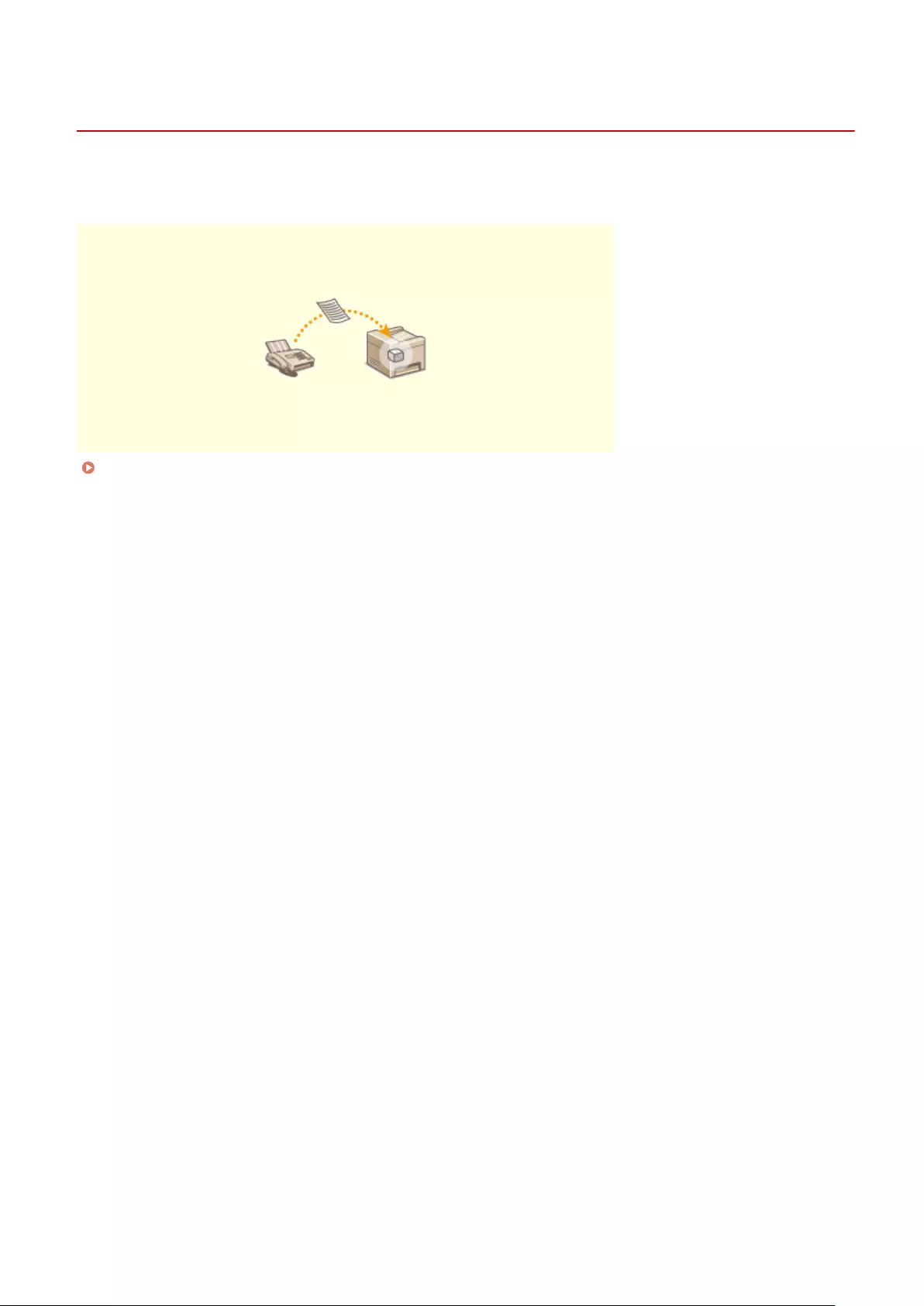
Various Receiving Methods
6FR5-04U
You can store received faxes in the machine's memory without printing them. You can reduce fax paper waste by
checking the detailed information of fax documents and only printing necessary documents.
Saving Received Documents into the Machine (Memory Reception)(P. 239)
Faxing
238
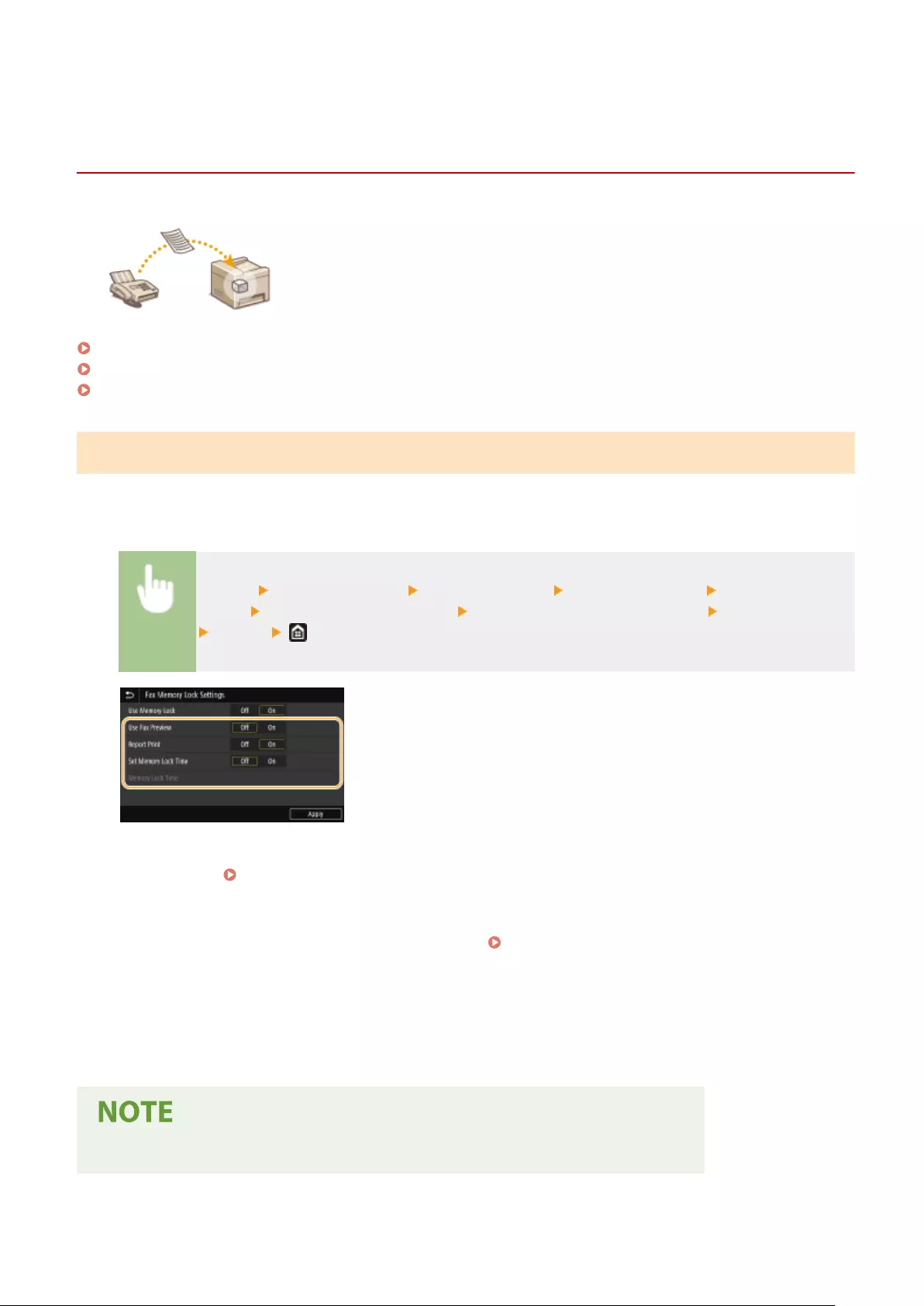
Saving Received Documents into the Machine (Memory
Reception)
6FR5-04W
You can store received faxes into memory of the machine, and then print them later.
This feature can prevent unauthorized persons from seeing condential documents
unintentionally.
Storing Documents into Memory(P. 239)
Printing Documents in Memory(P. 240)
Checking/Forwarding/Deleting Documents in Memory(P. 240)
Storing Documents into Memory
To store received documents into memory, set <Use Memory Lock> to <On>. You can congure a setting to enable you
to preview received documents using the Remote UI. You can also specify a setting to activate the Memory Reception
function only during a specied period of time of the day.
<Menu> <Function Settings> <Receive/Forward> <Common Settings> <Set Fax/I-Fax
Inbox> <Fax Memory Lock Settings> Select <On> in <Use Memory Lock> Specify each setting
<Apply>
<Use Fax Preview>
Specify whether to preview received documents stored in memory. Select <On> to preview the documents using
the Remote UI. Checking Current Status of Received Documents(P. 432)
<Report Print>
Enables you to print RX Result reports every time documents are stored into memory. To print reports, select
<On>. You also need to set <RX Result Report> to <On>. RX Result Report(P. 599)
<Set Memory Lock Time>
Specify whether to activate the Memory Reception function only during a specic time frame of the day. Select
<On> to activate the Memory Reception function only during a time frame specied in <Memory Lock Time>.
<Memory Lock Time>
Set the time to start and end the Memory Reception function.
●You cannot specify <Use Fax Preview> and <Set Memory Lock Time> at the same time.
Faxing
239
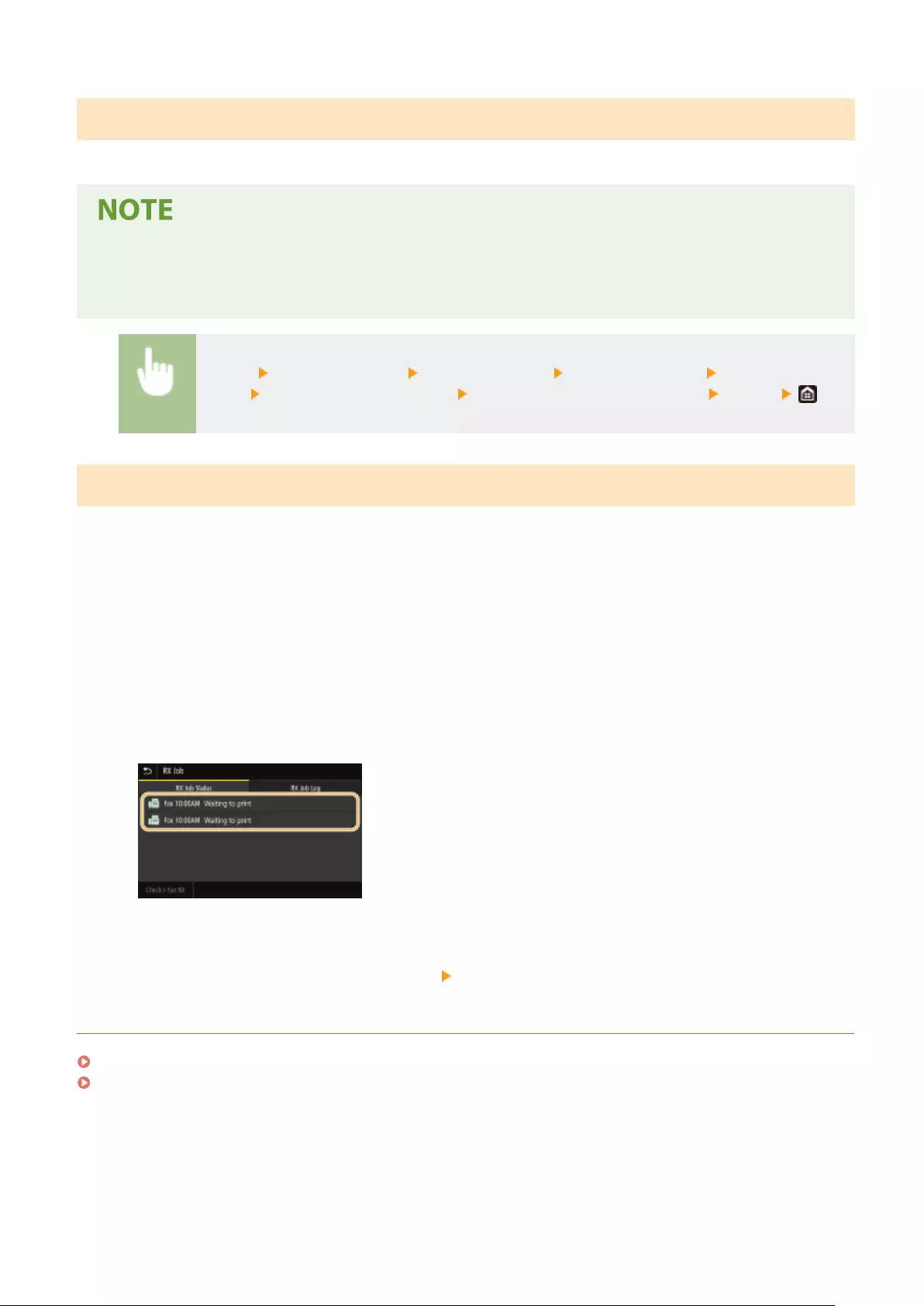
Printing Documents in Memory
To print received documents in memory, set <Use Memory Lock> to <Off>. All the documents in memory are printed.
●You cannot select a specic document for printing.
●If a time for the feature to deactivate has been specied, the documents are automatically printed at the
specied time.
<Menu> <Function Settings> <Receive/Forward> <Common Settings> <Set Fax/I-Fax
Inbox> <Fax Memory Lock Settings> Select <Off> in <Use Memory Lock> <Apply>
Checking/Forwarding/Deleting Documents in Memory
You can check an outline of each document stored in memory, including sender fax numbers and number of pages
sent. You can also select and forward a document stored in memory, and delete an unnecessary document, if any.
1Select <Status Monitor>.
2Select <RX Job>.
3In the <RX Job Status> tab, select the document you want to check/forward/delete.
➠Displays detailed information about the document.
●To forward the document, select <Forward>, and specify the appropriate destination.
●To delete the document, select <Delete> <Yes>.
LINKS
Receiving Faxes(P. 227)
Checking Status and Log for Sent and Received Documents(P. 244)
Faxing
240
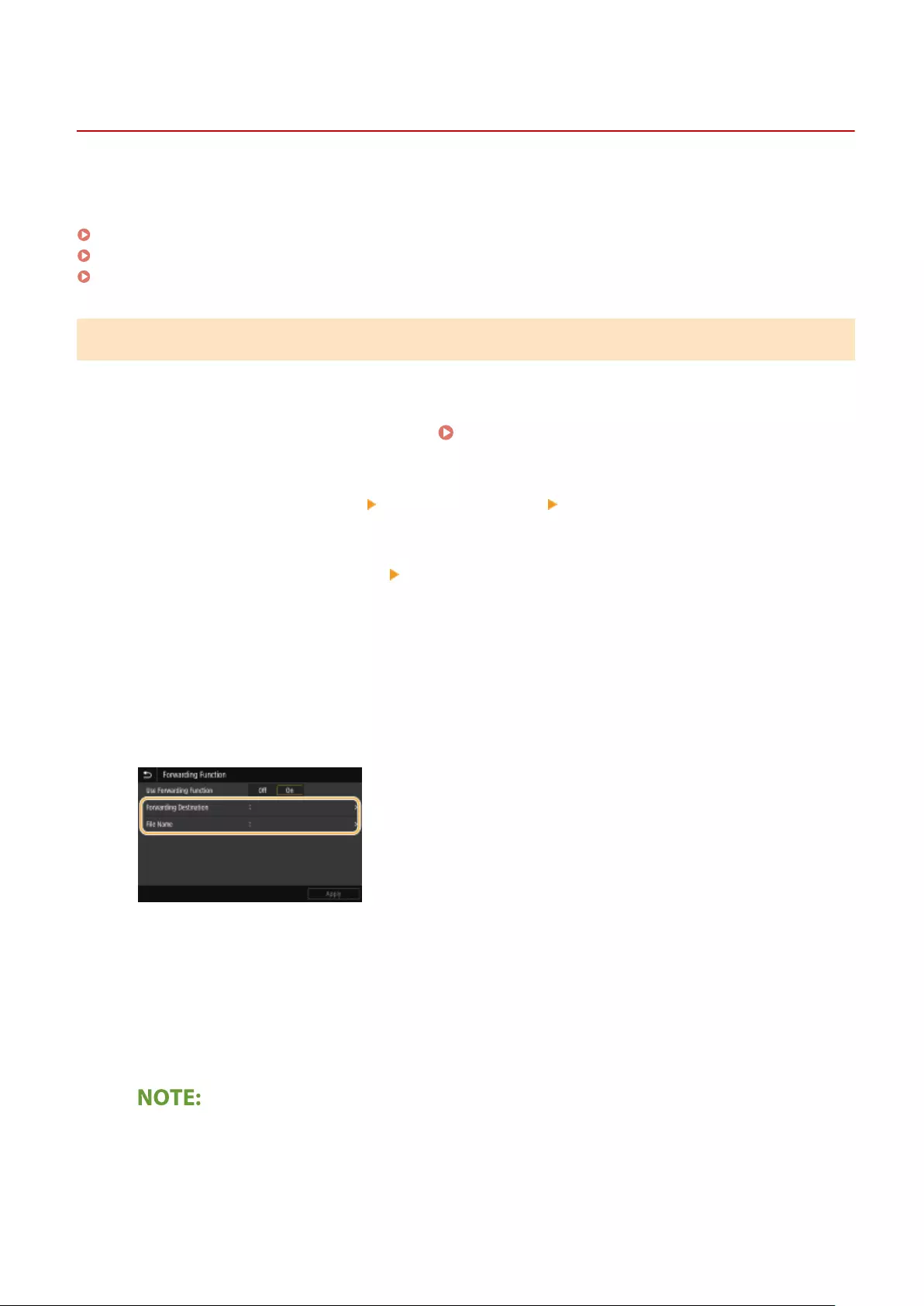
Forwarding the Received Documents Automatically
6FR5-04X
The machine can forward all the received documents to specied destinations. Even if you are out of the oce, you
can receive fax information anytime, anywhere.
Specifying Settings for Documents to be Forwarded Automatically(P. 241)
Printing Documents to be Forwarded(P. 242)
Printing/Resending/Deleting Documents that Failed to be Forwarded(P. 242)
Specifying Settings for Documents to be Forwarded Automatically
While the Forwarding feature is activated, all the documents to be received are automatically forwarded.
1Select <Menu> in the Home screen. Home Screen(P. 124)
2Select <Function Settings> <Receive/Forward> <Fax Settings>.
3Select <Forwarding Settings> <Forwarding Function>.
4Select <On> in <Use Forwarding Function>.
●When not using the forwarding function, select <Off>.
5Congure the forwarding settings.
<Forwarding Destination>
Specify a forwarding destination. In the Address Book, select the check box for a destination to which to
forward, and select <Apply>.
<File Name>
You can specify a character string to be used in the le name when sending a document by E-mail/I-fax or
when saving to a shared folder/FTP server. The le name is automatically assigned based on the following
format: arbitrary character string_communication management number (four digits)_sent date and
time_document number (three digits).le extension name.
●When not specifying <File Name>, you can use the following format for le name: communication
management number (four digits)_sent date and time_document number (three digits).le extension
name.
Faxing
241
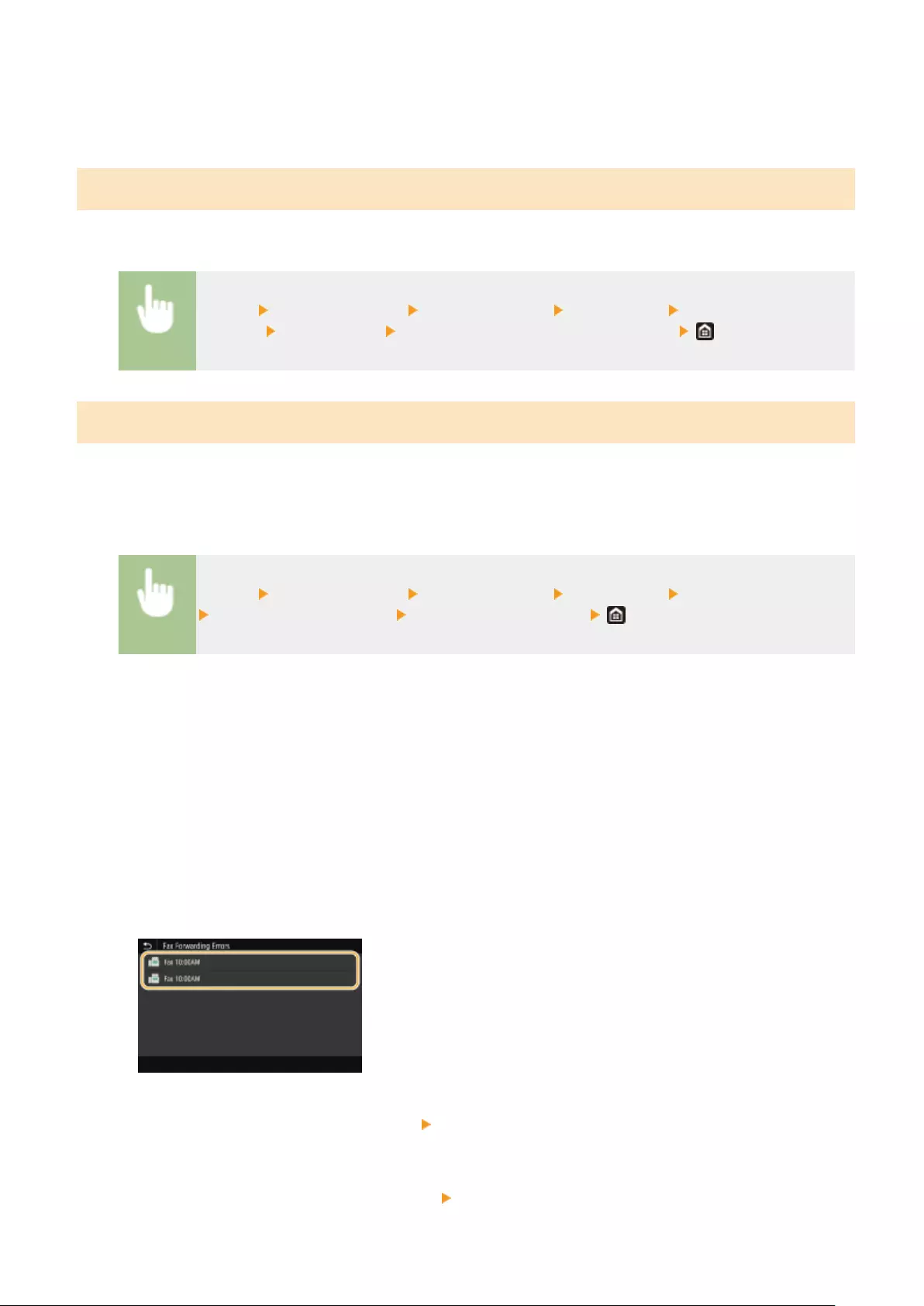
6Select <Apply>.
Printing Documents to be Forwarded
If you want to check the documents to be forwarded for yourself, you can set the machine to print the documents
whenever they are forwarded, or to print only the documents that failed to be forwarded.
<Menu> <Function Settings> <Receive/Forward> <Fax Settings> <Forwarding
Settings> <Print Images> Select <On> or <Only When Error Occurs>
Printing/Resending/Deleting Documents that Failed to be Forwarded
You can store documents that failed to be forwarded in memory, and print, resend, or delete them later.
◼Storing Documents that Failed to be Forwarded in Memory
<Menu> <Function Settings> <Receive/Forward> <Fax Settings> <Forwarding Settings>
<Store Images in Memory> <Only When Error Occurs>
◼Printing/Resending/Deleting Documents Stored in Memory
1Select <Status Monitor>.
2Select <Fax Forwarding Errors>.
3Select the document you want to print/resend/delete.
➠Displays detailed information about the document.
●To print the document, select <Print> <Yes>.
●To resend the document, select <Forward>, select the check box for the target destination, and then
select <Apply>.
●To delete the document, select <Delete> <Yes>.
Faxing
242
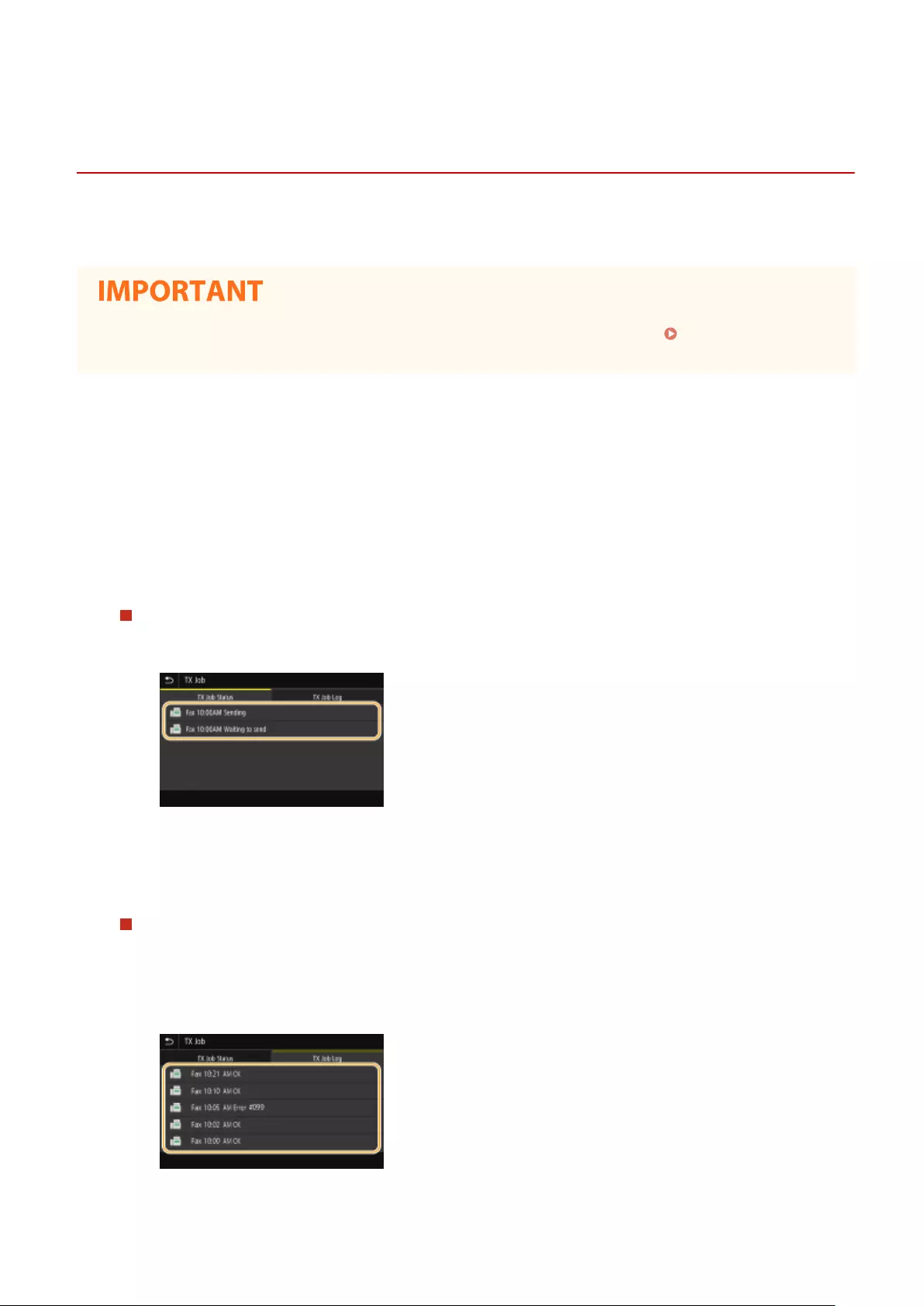
Checking Status and Log for Sent and Received
Documents
6FR5-04Y
The statuses and communication logs for sent and received fax and I-Fax documents can be checked separately for
sending and receiving.
●When <Display Job Log> is set to <Off>, you cannot check the communication logs. <Display Job
Log>(P. 565)
1Select <Status Monitor>.
2Select <TX Job> or <RX Job>.
3Check the statuses and communication logs for sent and received documents.
To check the statuses for sent and received documents
1Select the document whose status you want to check in the <TX Job Status> or <RX Job Status> tab.
➠Displays detailed information about the document.
●If you specied multiple destinations, the number of specied destinations is displayed on the
screen. To check the details of specied multiple destinations, select <Destination>.
To check the communication logs for sent and received documents
1Select the document whose log you want to check in the <TX Job Log> or <RX Job Log> tab.
●<OK> is displayed when a document was sent or received successfully, and <Error> is displayed when
a document failed to be sent or received because it was canceled or there was some error.
➠Displays detailed information about the document.
Faxing
244

When a three-digit number is shown in the case of <Error>
●This number represents an error code. For more information, see "Troubleshooting (FAQ)" on the
online manual website.
Registering the destination of the sent document to the Address Book
●For a document sent to a destination not registered in the Address Book, you can register that
destination to the Address Book by selecting <Regst to Add Book> on the details screen.
LINKS
Basic Operations for Sending Faxes(P. 218)
Canceling Sending Faxes(P. 226)
Receiving Faxes(P. 227)
Sending I-Faxes(P. 250)
Receiving I-Faxes(P. 257)
Printing Reports and Lists(P. 597)
Faxing
245
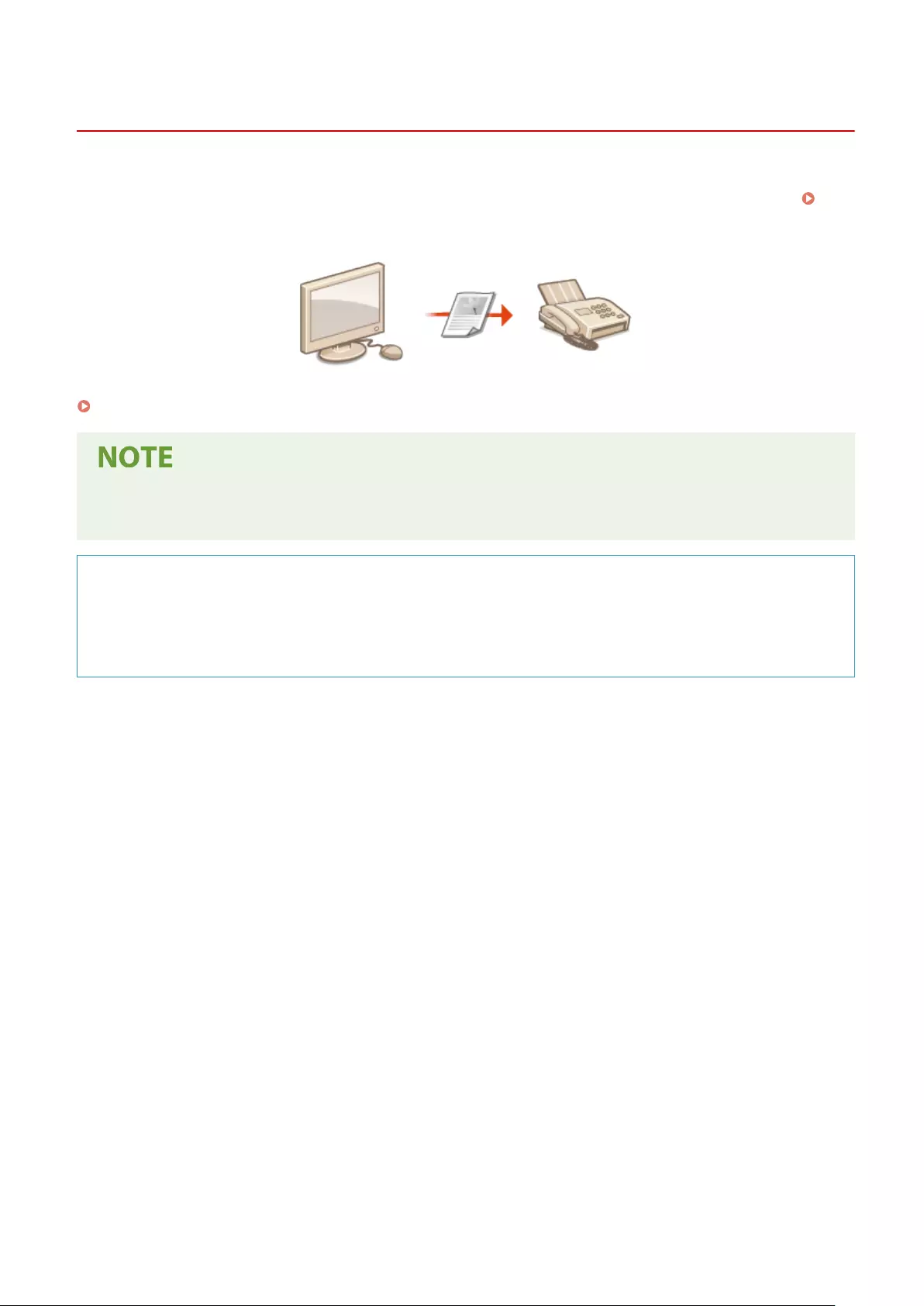
Sending Faxes from Your Computer (PC Fax)
6FR5-050
You can send fax documents created on your computer application directly from your computer. This feature
eliminates the need to print documents for faxing and saves paper. You need to specify the basic fax settings (
Conguring Initial Settings for Fax Functions(P. 78) ) and install the fax driver on your computer. For more
information about how to install the fax driver, see the manuals for the relevant drivers on the online manual website.
Sending PC Faxes(P. 247)
●Depending on the operating system and the version of the fax driver you are using, the fax driver screens in
this manual may differ from your screens.
About the Fax Driver Help
●Clicking [Help] on the fax driver screen displays the Help screen. On this screen you can see information that
is not in the User's Guide, including information about driver features such as registering frequently used
settings and how to set up those features.
Faxing
246
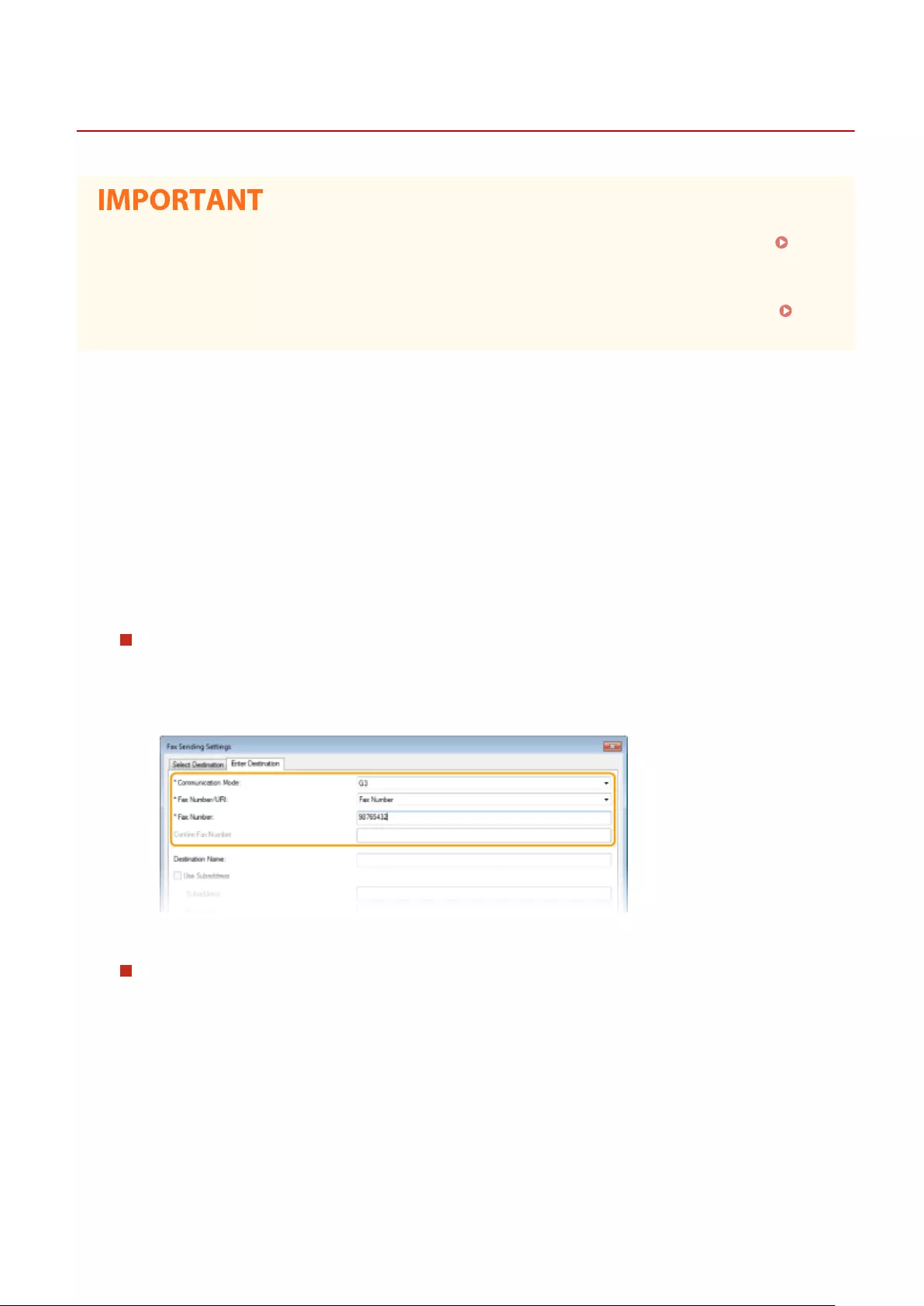
Sending PC Faxes
6FR5-051
●When <Allow Fax Driver TX> is set to <Off> on the machine, you cannot send faxes from computers.
Restricting Fax Sending from a Computer(P. 418)
●You need to enable Department ID Management on the fax driver you are using if Department ID
Management is enabled on the machine. For more information, click [Help] on the fax driver screen.
Setting the Department ID Management(P. 365)
1Open a document in an application and display the print dialog box.
●How to display the print dialog box differs for each application. For more information, see the instruction
manual for the application you are using.
2Select the fax driver for this machine, and click [Print].
3Specify the destination.
To specify only one destination
1Click the [Enter Destination] tab.
2Set the communication mode and fax number (or URI).
To specify multiple destinations at once
1Click the [Select Destination] tab.
2Click [Add Destination].
3Set the communication mode and fax number (or URI), and click [OK].
Faxing
247
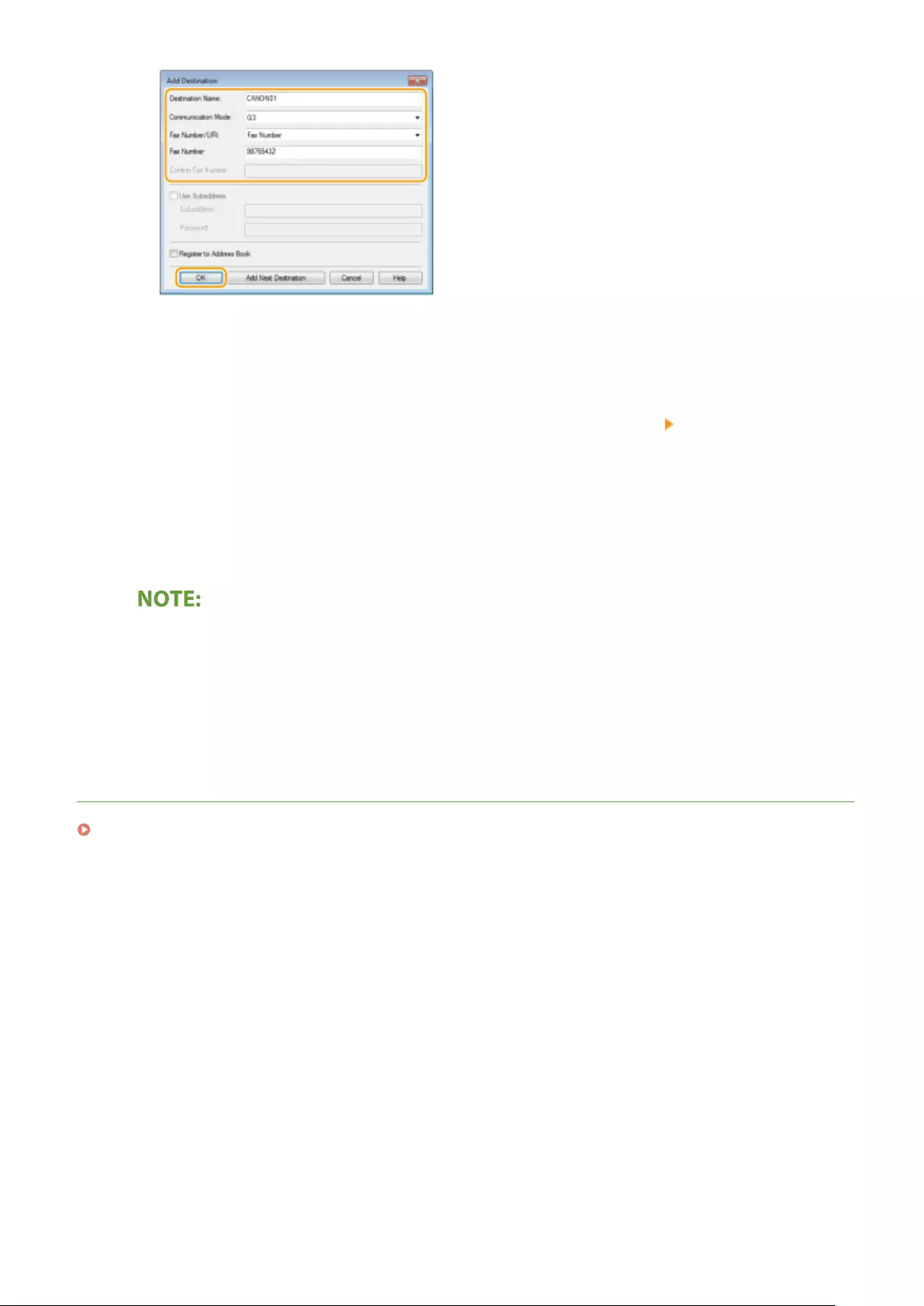
4Repeat steps 2 and 3 to add concurrent destinations.
●You can also add a destination by clicking [Add Next Destination] in step 3.
●If you need to specify a number to dial an outside line, select [Detailed Settings] [Add Outside Dialing
Prex to G3/G4/IP Fax Number] and enter the number in [Outside Dialing Prex]. The specied number is
added to the beginning of the fax number when the machine dials.
●To make it easier to specify destinations using the Address Book.
●Selecting [Store Sent Fax Information and Image] enables you to store the logs for sending documents and
check detailed information of a sent document along with its image, including destinations and number of
pages. For more information, click [Help] on the fax driver screen.
●When the [Conrm Fax Number] or [Conrm URI] eld is active, also enter the appropriate number in the
eld. The setting of whether to conrm entered numbers can be changed in the fax driver screen. For
more information, click [Help] on the fax driver screen.
4Click [Send] to send the document.
LINKS
When Printing or Sending from the Windows Store App(P. 656)
Faxing
248
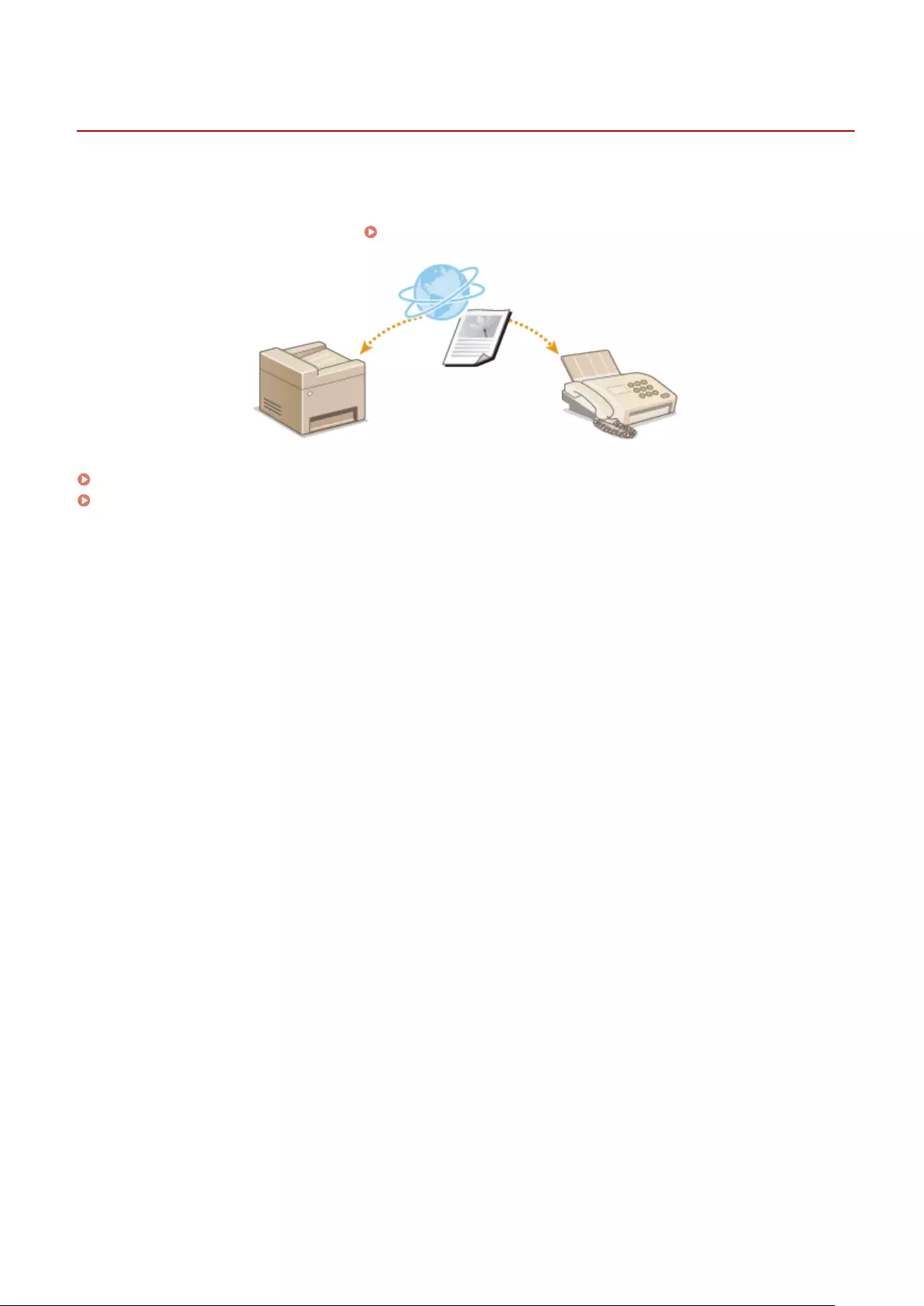
Using Internet Fax (I-Fax)
6FR5-052
The Internet Fax (I-Fax) function allows you to send and receive faxes over the Internet. Originals are sent attached as
TIFF images les to e-mail. Since a telephone connection is not used, you can send faxes to distant locations and send
documents with many pages without worrying about communications charges. Some advance preparation is required,
such as specifying the mail server settings. Procedure for Setting to Send E-Mail/Send and Receive I-Fax(P. 85)
Sending I-Faxes(P. 250)
Receiving I-Faxes(P. 257)
Faxing
249
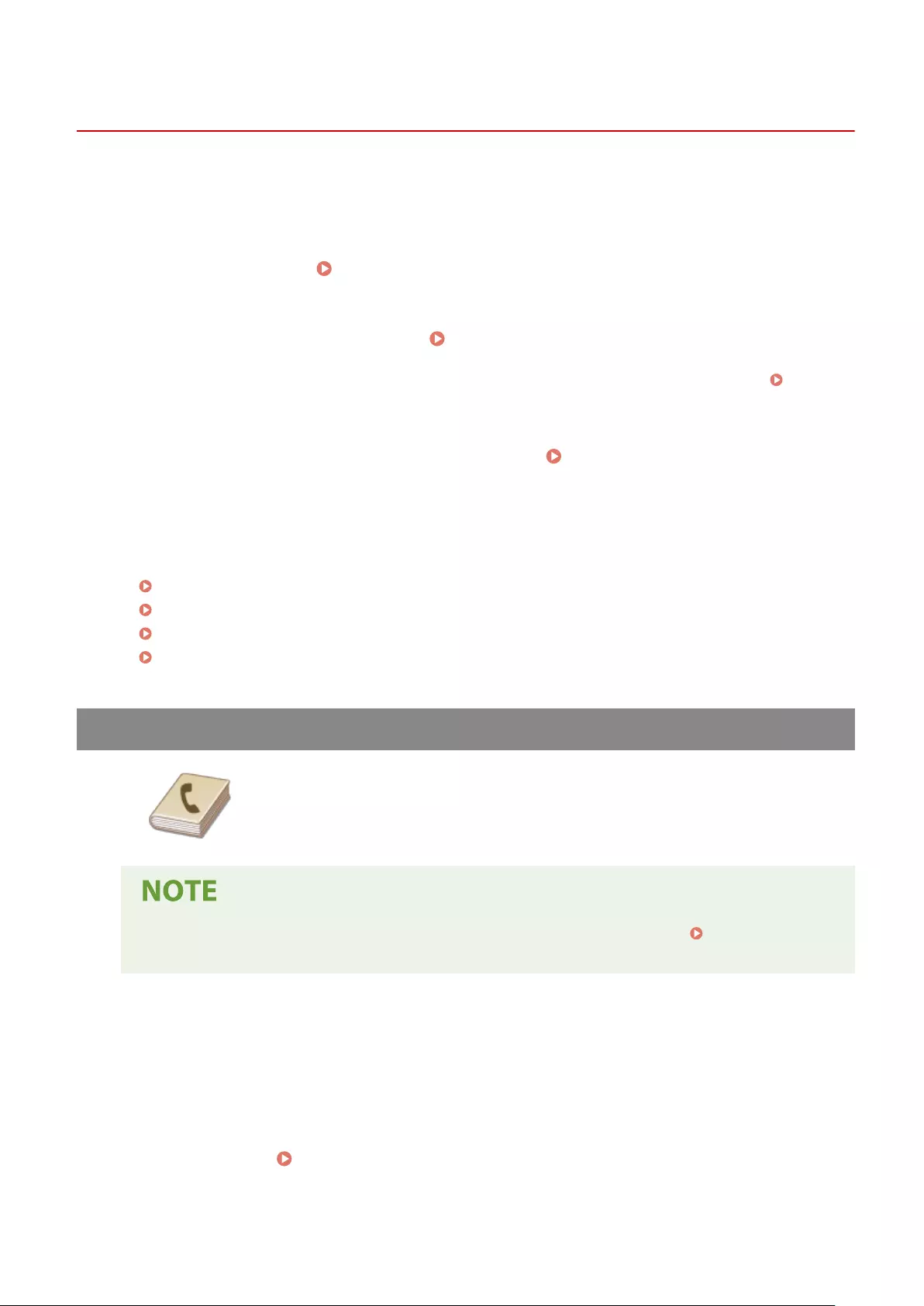
Sending I-Faxes
6FR5-053
To send a fax to a computer or another I-Fax-compatible device, specify an e-mail address instead of a fax number as
the destination. If you send an I-Fax to a computer, it is sent as an e-mail attachment in TIFF format. And in the same
way as when you send e-mail to a computer, you can specify multiple destinations and specify Cc and Bcc destinations.
1Place the original(s). Placing Originals(P. 137)
2Select <Scan> in the Home screen. Home Screen(P. 124)
●If the login screen appears, specify the user name, the password, and the authentication server. Logging
in to Authorized Send(P. 135)
3Select <I-Fax> in the Scan Basic Features screen. Scan Basic Features Screen(P. 282)
4Specify the destination.
Specifying from Address Book
Specifying from Coded Dial Numbers
Entering Destinations Directly
Specifying Destinations in an LDAP Server
Specifying from Address Book
The Address Book enables you to specify a destination by selecting from a list of
registered destinations or by searching by name for destinations with recipient
names.
●You need to register destinations in the Address Book before using this feature. Registering
Destinations(P. 180)
1Select <Address Book> in the <Specify Destination> tab.
2Select <To>.
3Select an index. Index(P. 180)
Faxing
250
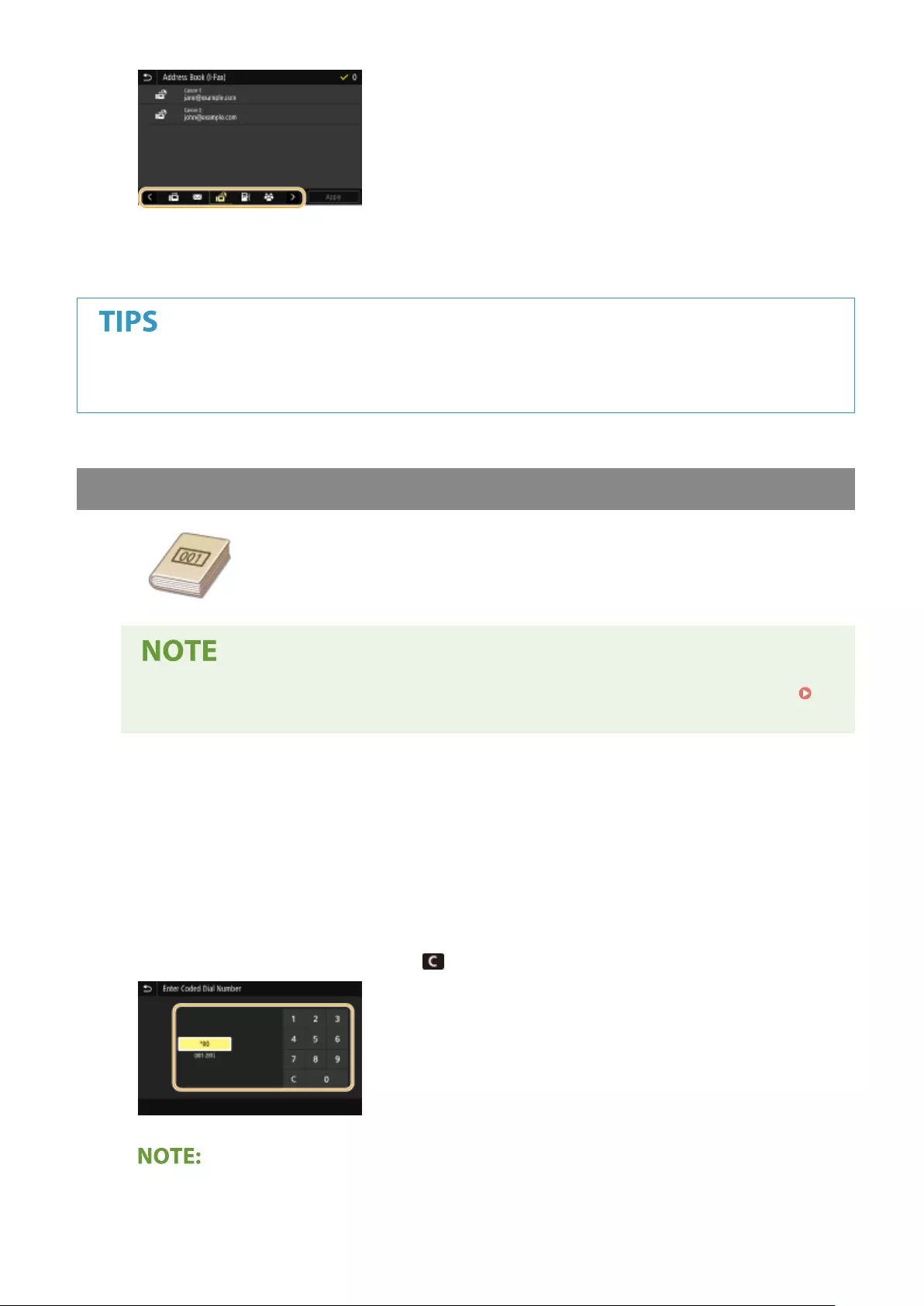
4Select the check box for the desired destination, and select <Apply>.
●If a destination is selected from <Address Book> in the Home screen, the Basic Features screen for I-Fax
sending can be displayed while the selected destination remains being specied.
Specifying from Coded Dial Numbers
Three-digit numbers (coded dial numbers) are assigned to addresses in the Address
Book. You can specify an address simply by entering its coded dial number.
●To use coded dial numbers, the destination must be registered in the Address Book beforehand.
Registering Destinations(P. 180)
1Select <Coded Dial> in the <Specify Destination> tab.
2Select <To>.
3Enter a three-digit number.
●If you have entered an incorrect value, use to clear it.
If a conrmation screen appears
Faxing
251
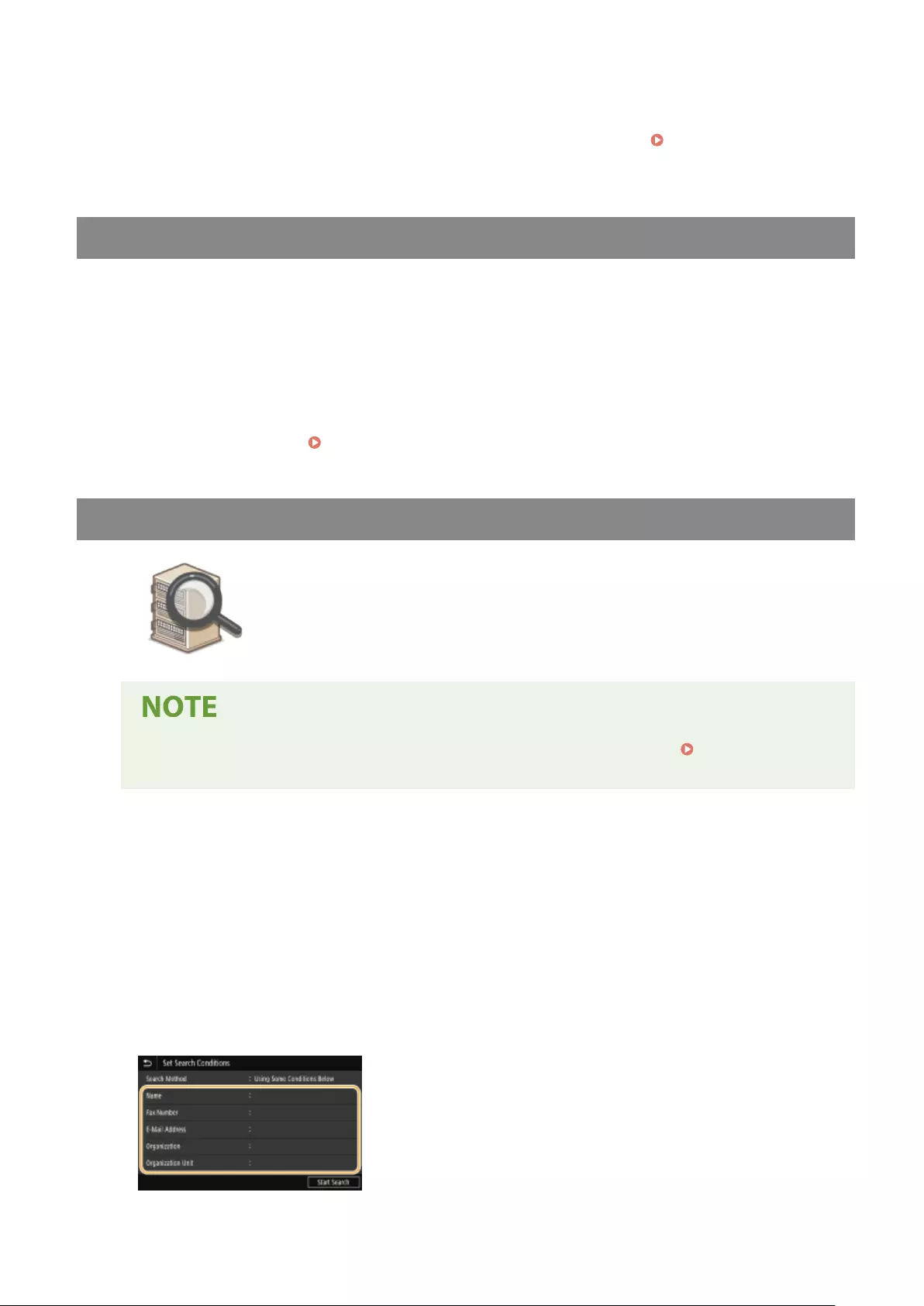
●When <Conrm When Coded Dial TX> is set to <On>, a screen is displayed that shows the destination and
the name for the number. (For Group Dial, the destination name and the number of destinations are
shown.) Check the contents and if everything is correct, select <OK>. To specify a different destination,
select <Cancel> and then re-enter the three-digit coded dial number. Displaying Destinations in
Address Book(P. 416)
Entering Destinations Directly
For a destination that is not registered in the Address Book, specify it by entering an I-Fax address.
1Select <Use Keyboard> in the <Specify Destination> tab.
2Enter the I-Fax address, and select <Apply>.
●On how to enter text, see Entering Text(P. 133) .
Specifying Destinations in an LDAP Server
If your oce has an LDAP server installed, you can specify a destination using user
information in the server. Access the LDAP server via the machine to search for the
appropriate user information and specify it as destination.
●You need to specify the settings for connecting to an LDAP server beforehand. Registering LDAP
Servers(P. 64)
1Select <LDAP Server> in the <Specify Destination> tab.
2Select the LDAP server you are using.
3Select conditions for user information to be searched.
●Name, fax numbers, e-mail addresses, organization names, and organization unit are available criteria for
searching destinations.
Faxing
252
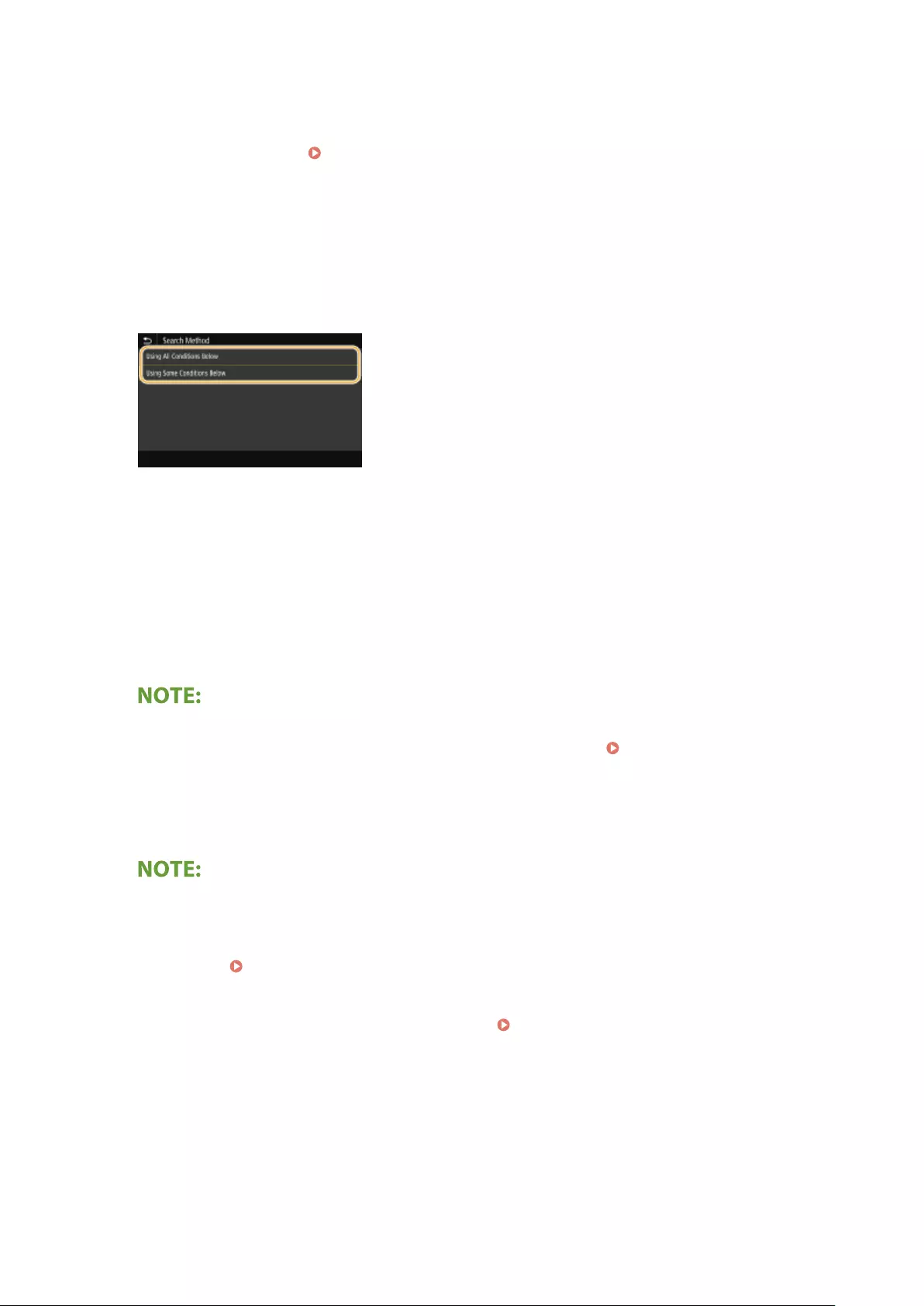
4Enter the search target character string, and select <Apply>.
●On how to enter text, see Entering Text(P. 133) .
●To specify multiple search criteria, repeat steps 3 and 4.
5Select <Search Method>.
6Select conditions to display the search result.
<Using All Conditions Below>
Searches and displays the users that meet all the search criteria specied in steps 3 and 4.
<Using Some Conditions Below>
If users that meet even one of the criteria specied in steps 3 and 4 are found, displays all those users.
7Select <Start Search>.
➠The users meeting your search criteria are displayed.
●If the authentication screen appears when you select <Start Search>, enter the user name of the machine
and the password registered in the LDAP server, and select <Apply>. Registering LDAP Servers(P. 64)
8Select the check box for the user that you want to specify as destination, and select
<Apply>.
If a screen on which a destination is already specied appears
●You can only send to your own e-mail address. To send to other destinations, you must congure the send
function authentication settings so that e-mail transmission is not restricted. Contact your administrator
for details. LDAP Server Authentication(P. 373) .
Specifying destinations from the transmission records
●You can also recall previously used destinations. Recalling Previously Used Settings for Sending/
Saving (Recall Settings)(P. 316)
5Specify multiple destinations, including Cc/Bcc destinations, as necessary.
●Select the method used to specify destinations in the <Specify Destination> tab, and then specify the
destination.
Faxing
253
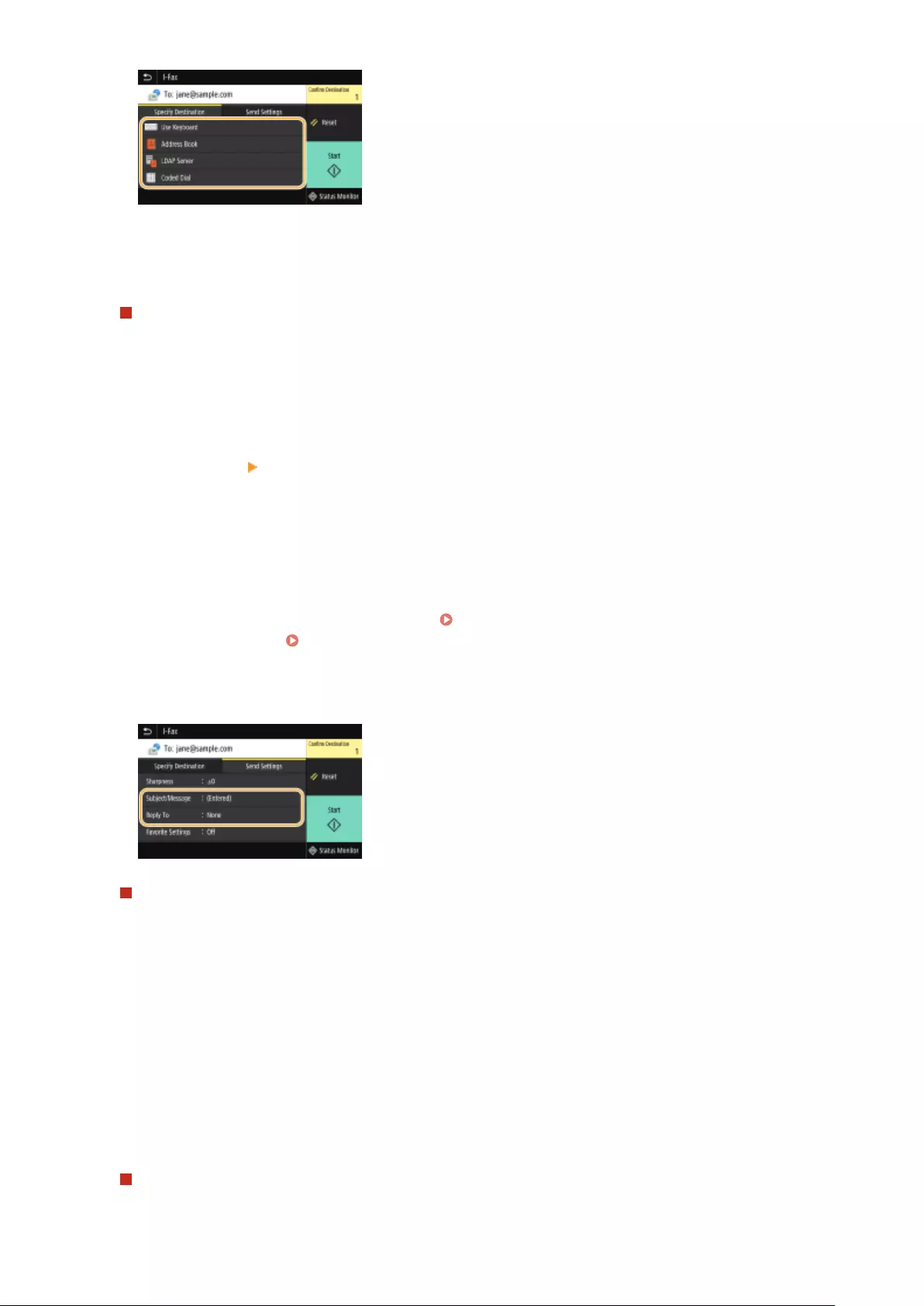
●If you selected <LDAP Server> or <Specify Myself as Destination>, the destination is specied in the <To>
eld.
●<Cc> and <Bcc> addresses can only be selected using <Address Book> or <Coded Dial>.
To delete destinations
If you specied multiple destinations, you can delete destinations as necessary.
1Select <Conrm Destination>.
2Select the check box for the destination to be deleted, and select <Remove from Dest.>.
●If you select the Group check box, you can view the destinations registered in the group by selecting
<Details> <Destination>.
3Select <Yes>.
6Specify the scanning settings as necessary.
●For more information about each setting, see Sending Data by E-Mail/Saving Data to a Shared Folder or
FTP Server(P. 292) or Scanning Clearly(P. 305) .
7Specify the subject, message, and reply-to address for the e-mail as necessary.
To specify subject/message
1Select <Subject/Message> in the <Send Settings> tab.
2Select <Subject>
3Enter the subject, and select <Apply>.
4Select <Message>.
5Enter the message, and select <Apply>.
6Select <Apply>.
To specify reply-to address
Specify the reply-to address when you want to notify the recipient of an e-mail address different from that of
the machine as the reply-to address. Select the target reply-to address from the destinations registered in the
Faxing
254

Address Book, and specify it. If the destination has not been registered in the Address Book, see
Registering Destinations(P. 180) .
1Select <Reply To> in the <Send Settings> tab.
2Select <Specify from Address Book>.
3Select the check box for the desired reply-to address, and select <Apply>.
●The reply-to address that can be specied is always one of the e-mail addresses registered in the
Address Book.
8Select <Start>.
●If the <Conrm Destination> screen is displayed, check whether the destination is correct, and then select
<Start Scanning>.
➠Scanning of the original starts.
●If you want to cancel, select <Cancel> <Yes>. Canceling Sending Faxes(P. 226)
When placing originals in the feeder in step 1
When scanning is complete, the I-Faxes are sent.
When placing originals on the platen glass in step 1
When scanning is complete, follow the procedure below.
1If there are additional pages of originals to be scanned, place the next original on the platen glass,
and select <Scan Next Original>.
●Repeat this step until you nish scanning all of the pages.
●When there is only one page to be scanned, proceed to the next step.
2Select <Start Sending>.
➠The I-Faxes are sent.
If the <SMTP Authentication> screen appears
●Enter the user name and password, and select <Apply>.
File name of a sent document
●The le name of a sent document is automatically assigned based on the following format: communication
management number (four digits)_sent date and time_document number (three digits).le extension
name. An arbitrary character string can be added in front of the le name. Conguring a File
Name(P. 315)
If a Send Error Occurs
Error notications are sometimes sent to the e-mail address set to the machine. If you leave it as-is, it may
result in an insucient remaining capacity of mailbox depending on your mail server. It is recommended that
you clear the mailbox periodically.
Faxing
255
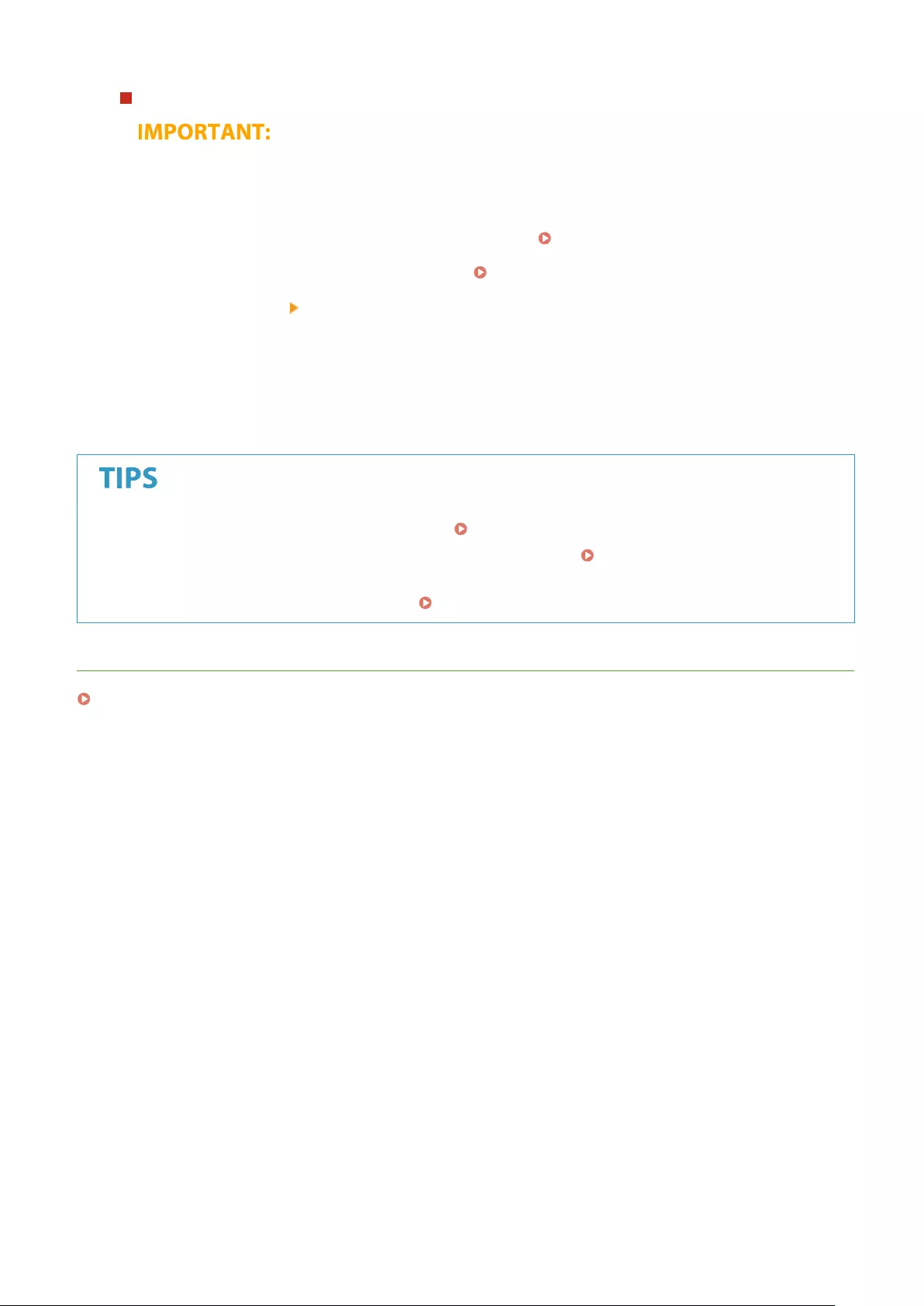
To clear the mailbox
●When the mailbox is cleared, all e-mail in the server mailbox is deleted. When you specify the e-mail
account that you use usually, you should rst check whether any e-mail in the mailbox needs to be kept.
1Start the Remote UI and log in to System Manager Mode. Starting Remote UI(P. 428)
2Click [Settings/Registration] on the Portal page. Remote UI Screen(P. 429)
3Select [TX Settings] [E-Mail/I-Fax Settings].
4Click [Clear] in [Clear Mail Box].
5Read the message that is displayed, and click [OK].
➠E-mail is deleted from the mailbox.
●If you always want to send with the same settings: Changing the Default Settings for Functions(P. 174)
●If you want to register a combination of settings to use when needed: Registering Frequently Used
Settings(P. 172)
●If you want to specify the I-Fax sender name: <Register Unit Name>(P. 535)
LINKS
Checking Status and Log for Sent and Received Documents(P. 244)
Faxing
256
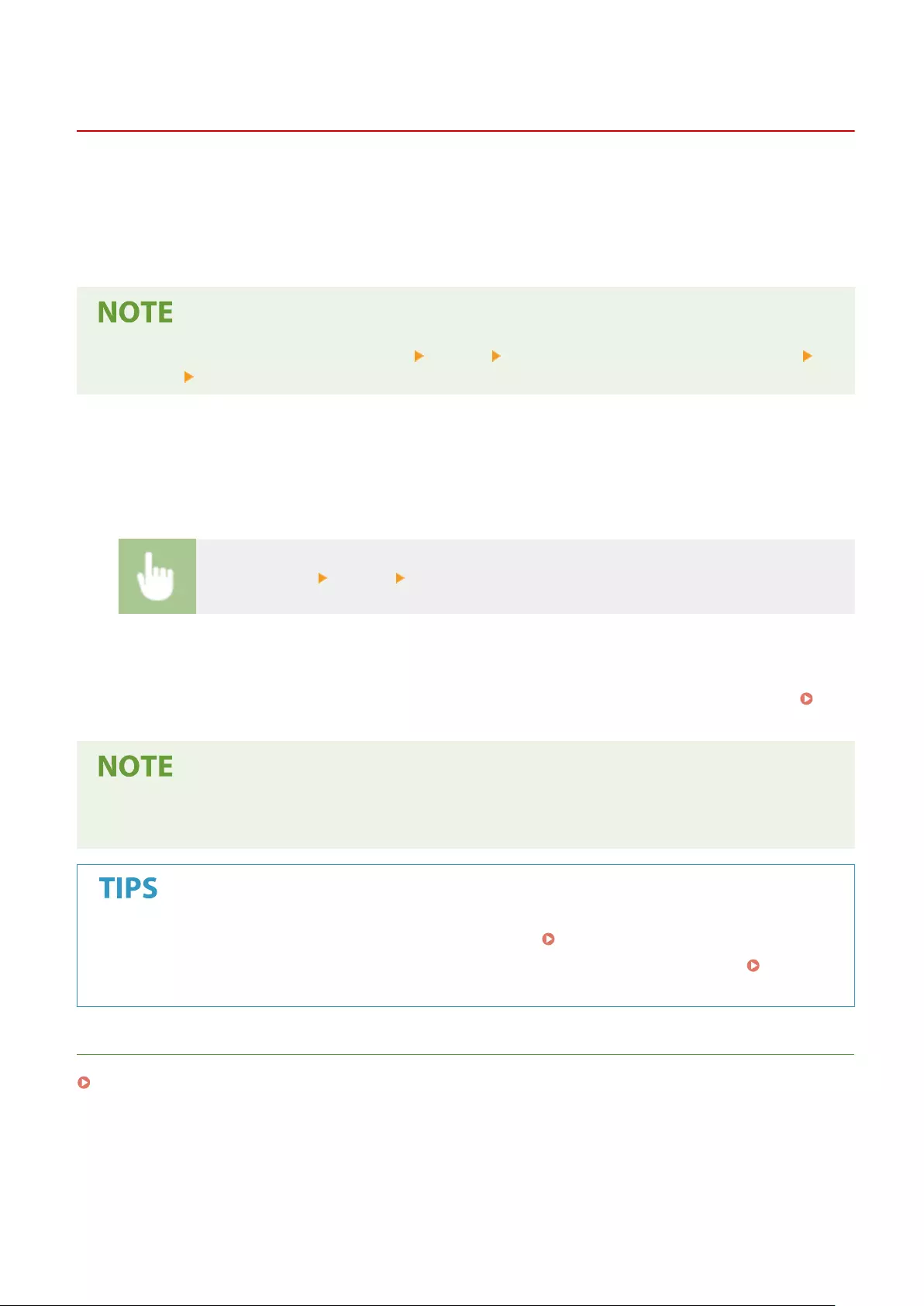
Receiving I-Faxes
6FR5-054
◼When an I-Fax Arrives
When an I-Fax arrives, the Data indicator on the operation panel blinks. After the I-Fax is completely received, the
document is printed out automatically and the indicator goes out.
●To cancel reception, select <Status Monitor> <RX Job> select a document in the <RX Job Status> tab
<Delete> <Yes>.
◼Receiving I-Faxes Manually
If you want to connect to the server before receiving I-Faxes automatically, or if you want to congure the machine so
that it does not receive I-Faxes automatically, use the method below to receive I-Faxes manually. If there is a document
on the server, printing begins.
<Status Monitor> <RX Job> <Check I-Fax RX>
◼Printout Paper
Regardless of the received document size, incoming I-Faxes are printed at the size specied in <RX Print Size>. <RX
Print Size>(P. 548)
●If paper of the size specied in <RX Print Size> is not loaded in the paper drawer, the <No Paper> error
message is displayed. For more information, see "Troubleshooting (FAQ)" on the online manual website.
●If you want to print received documents on both sides of paper: <Print on Both Sides>(P. 548)
●If you want to continue printing even when the amount remaining in the toner cartridge is low: <Continue
Print. When Cart. Low>(P. 548)
LINKS
Checking Status and Log for Sent and Received Documents(P. 244)
Faxing
257

Printing
Printing ................................................................................................................................................................ 259
Printing from a Computer ................................................................................................................................ 260
Canceling Prints ........................................................................................................................................... 262
Checking the Printing Status and Log ........................................................................................................... 264
Various Printing Methods ................................................................................................................................. 266
Printing a Document Secured by a PIN (Secure Print) ................................................................................... 267
Printing via Secure Print ........................................................................................................................ 268
Printing from a USB Memory Device (Memory Media Print) ......................................................................... 271
Printing
258
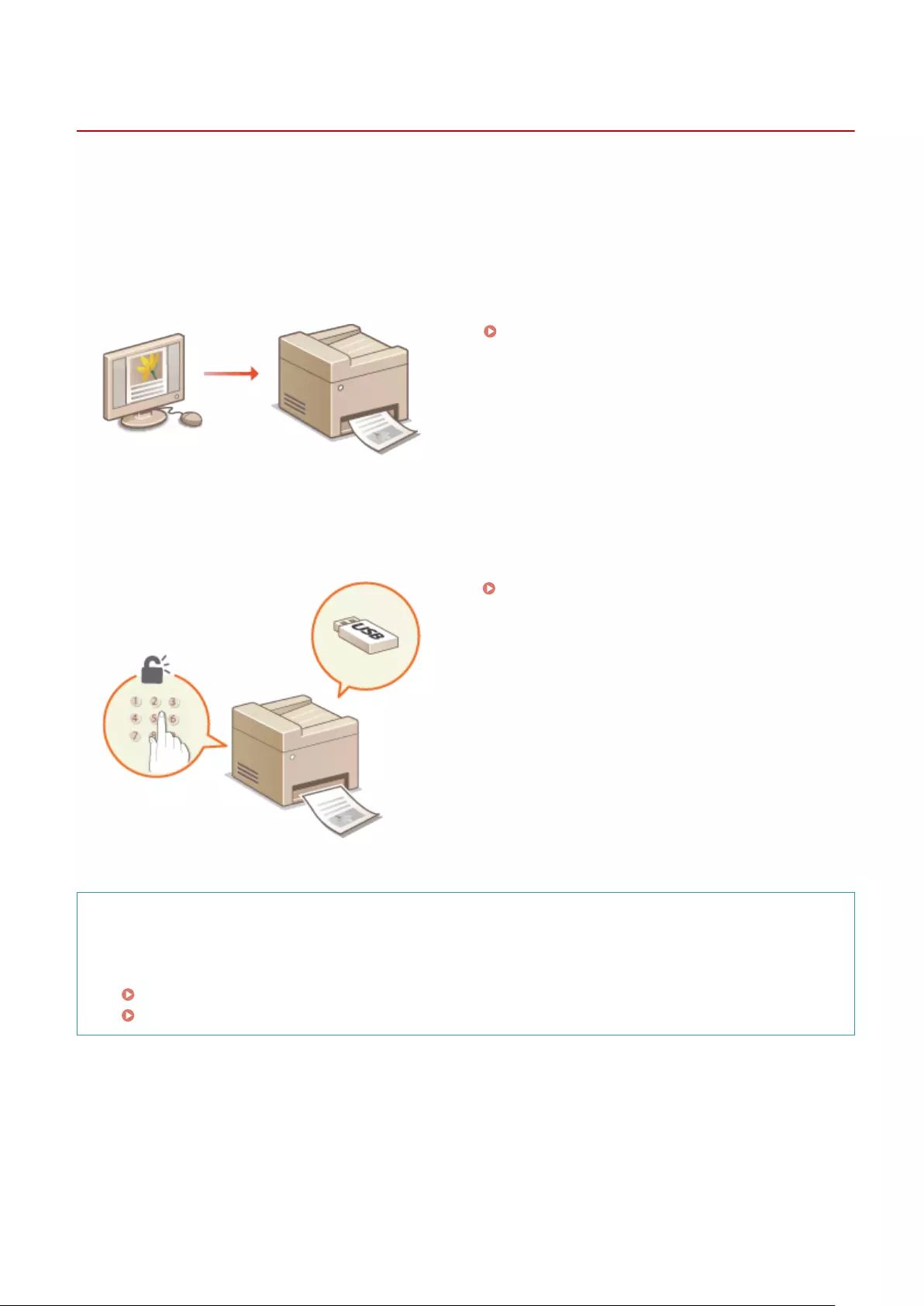
Printing
6FR5-055
There are many ways to use the machine as a printer. You can print documents on your computer by using the printer
driver or print image les from a USB memory device. Make full use of the print functions to suit your needs.
◼Printing from a Computer
You can print a document made on your computer by using the printer driver.
Printing from a Computer(P. 260)
◼Useful Functions When Printing
You can assign a PIN to the print data to enhance security or directly print les stored in a USB memory device.
Various Printing Methods(P. 266)
Printing from Mobile Devices
●Linking mobile devices such as smartphones or tablets to this machine provides a quick and easy way to
print photos and web pages. The machine also supports Google Cloud Print™.
Linking with Mobile Devices(P. 332)
Using Google Cloud Print(P. 354)
Printing
259
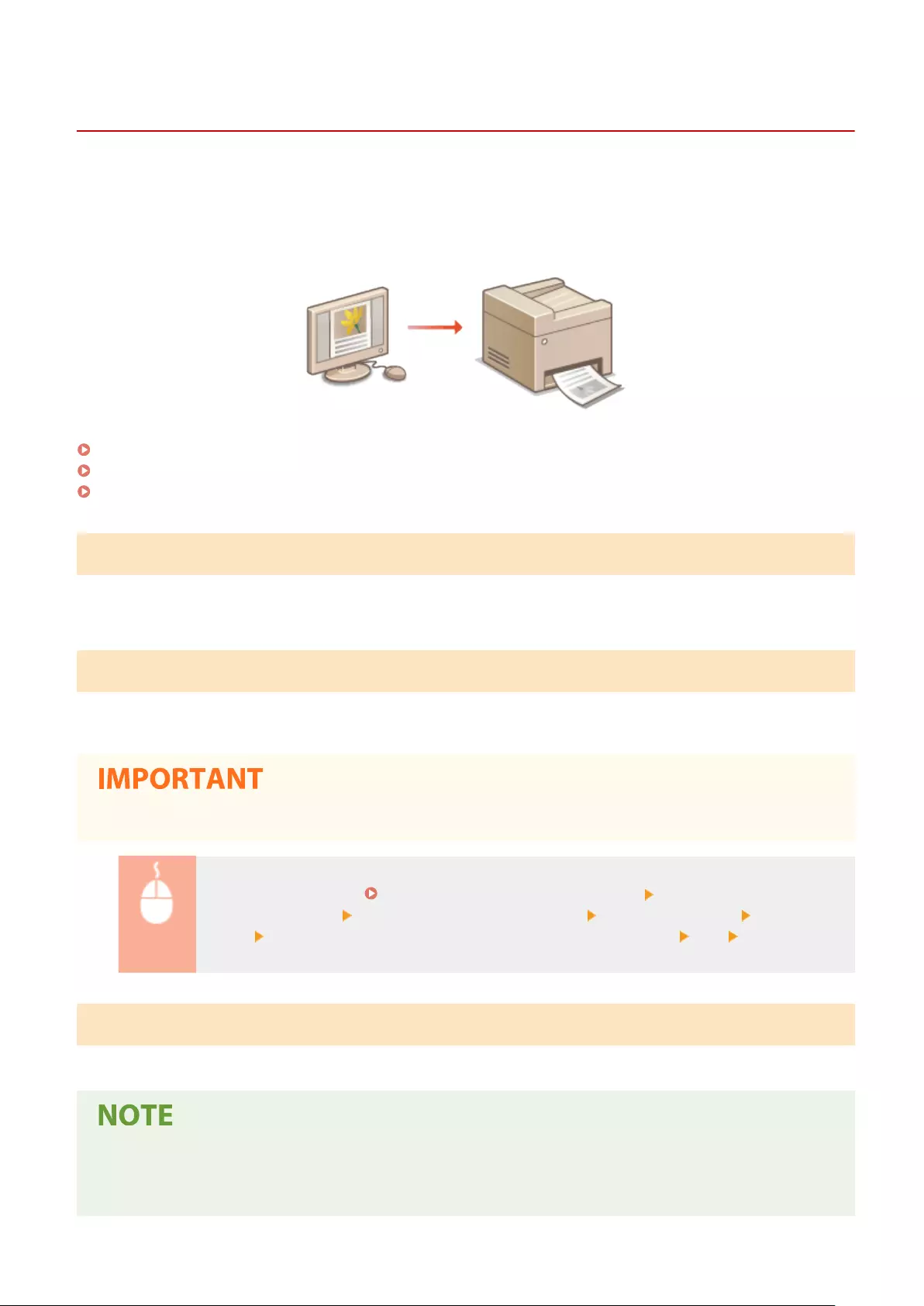
Printing from a Computer
6FR5-056
You can print a document made with an application on your computer by using the printer driver. There are useful
settings on the printer driver, such as enlarging/reducing and 2-sided printing, that enable you to print your
documents in various ways. Before you can use this function, you need to complete some procedures, such as
installing the printer driver on your computer. For more information, see the manuals for the relevant drivers on the
online manual website.
About the Printer Driver Help(P. 260)
To Use the Optional Items(P. 260)
Basic Printing Operations(P. 260)
About the Printer Driver Help
Clicking [Help] on the printer driver screen displays the Help screen. On this screen, you can see the detailed
descriptions that are not in the User's Guide.
To Use the Optional Items
If the optional cassette feeding module is attached to the machine after installation of the printer driver, perform the
following operation on the printer driver.
●To perform the following procedure, log in to your computer with an administrator account.
Open the printer folder ( Displaying the Printer Folder(P. 649) ) Right-click the printer driver
icon for this machine [Printer properties] or [Properties] [Device Settings] tab [Paper
Source] Select [1-Cassette Feeding Unit] in [Optional Drawer/Cassette] [OK] [OK]
Basic Printing Operations
This section describes how to print a document on your computer by using the printer driver.
Paper settings on the machine
●Normally, it is necessary to specify the paper size and type for the paper loaded in each paper source before
proceeding to printing.
Printing
260
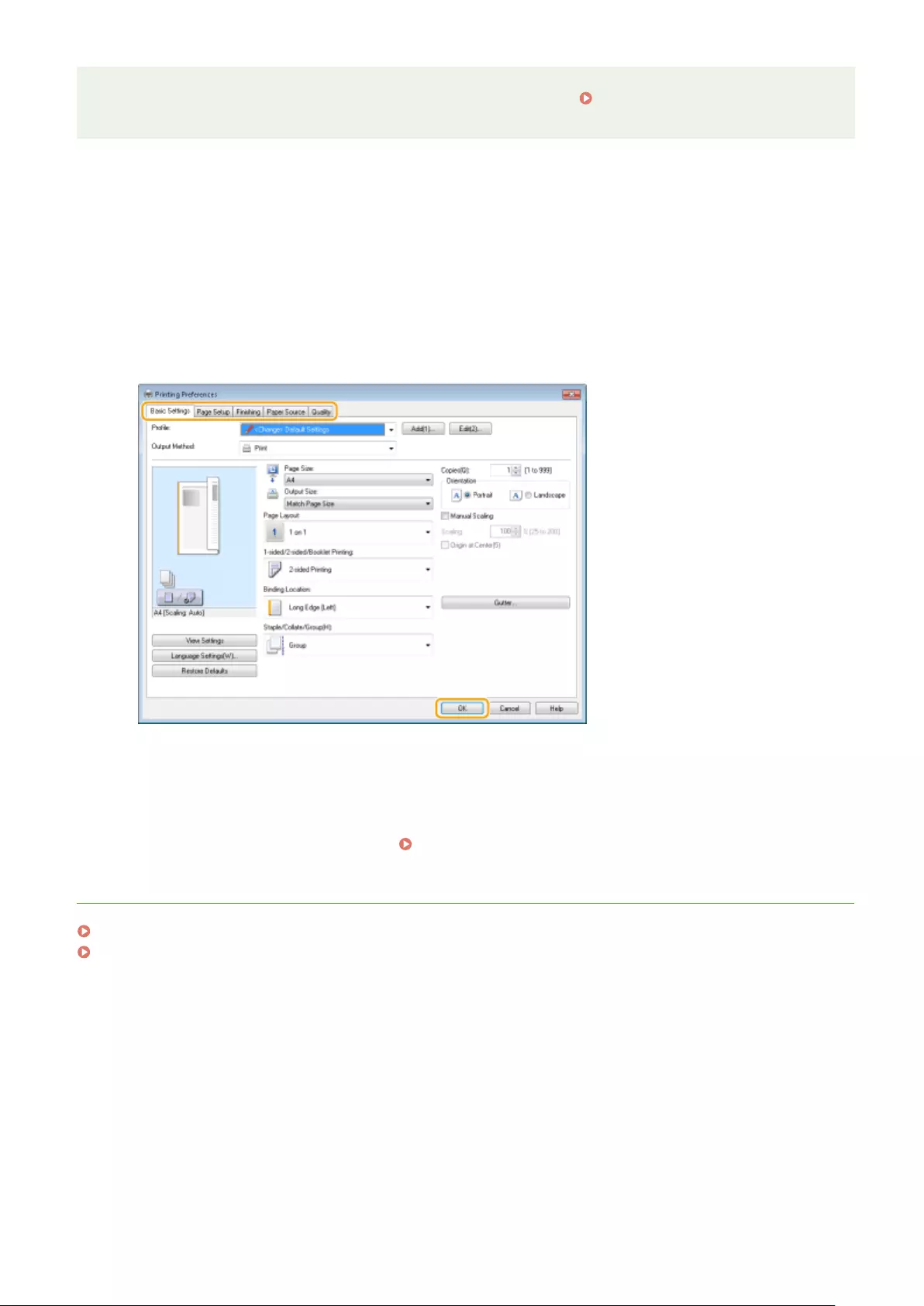
●By setting <Prioritize Driver Settings When Printing> to <On>, you can print from the paper source specied
in the printer driver, regardless of the paper settings on the machine. <Prioritize Driver Settings When
Printing>(P. 509)
1Open a document in an application and display the print dialog box.
2Select the printer driver for this machine, and click [Preferences] or [Properties].
3Specify the print settings as necessary, and click [OK].
●Switch the tab according to the settings.
4Click [Print] or [OK].
➠Printing starts.
●If you want to cancel printing, see Canceling Prints(P. 262) .
LINKS
Checking the Printing Status and Log(P. 264)
When Printing or Sending from the Windows Store App(P. 656)
Printing
261
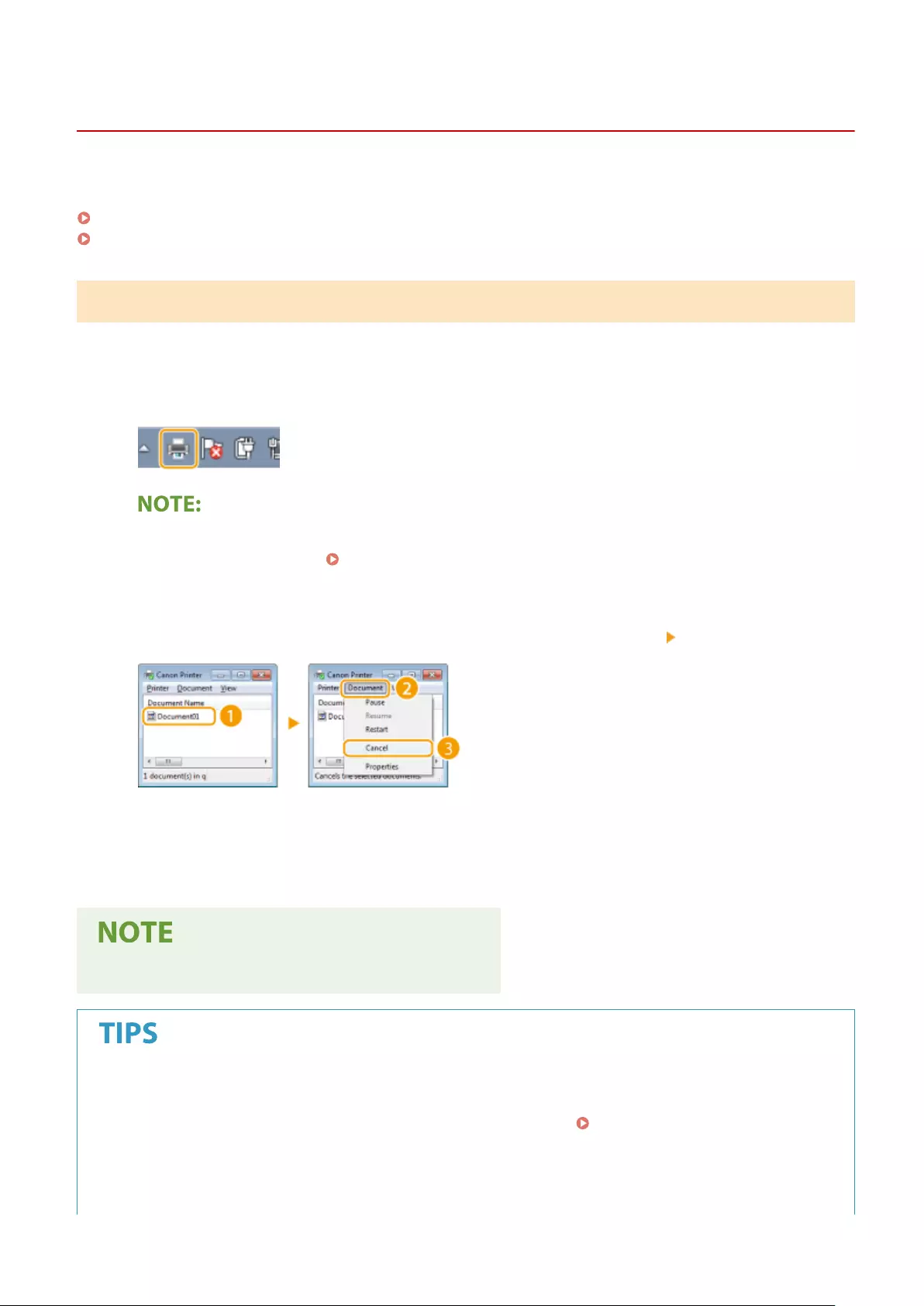
Canceling Prints
6FR5-057
You can cancel printing from your computer or on the operation panel of the machine.
From a Computer(P. 262)
From the Operation Panel(P. 263)
From a Computer
You can cancel printing from the printer icon displayed on the system tray on the desktop.
1Double-click the printer icon.
When the printer icon is not displayed
●Open the printer folder ( Displaying the Printer Folder(P. 649) ), right-click the printer driver icon for
this machine, and click [See what's printing] (or double-click the icon of the printer driver for this machine).
2Select the document you want to cancel, and click [Document] [Cancel].
3Click [Yes].
➠Printing of the selected document is canceled.
●Several pages may be output after you cancel printing.
Canceling from the Remote UI
●You can cancel printing from the [Job Status] page on the Remote UI: Checking Current Status of Print
Documents(P. 431)
Canceling from an application
●On some applications, a screen like shown below appears. You can cancel printing by clicking [Cancel].
Printing
262
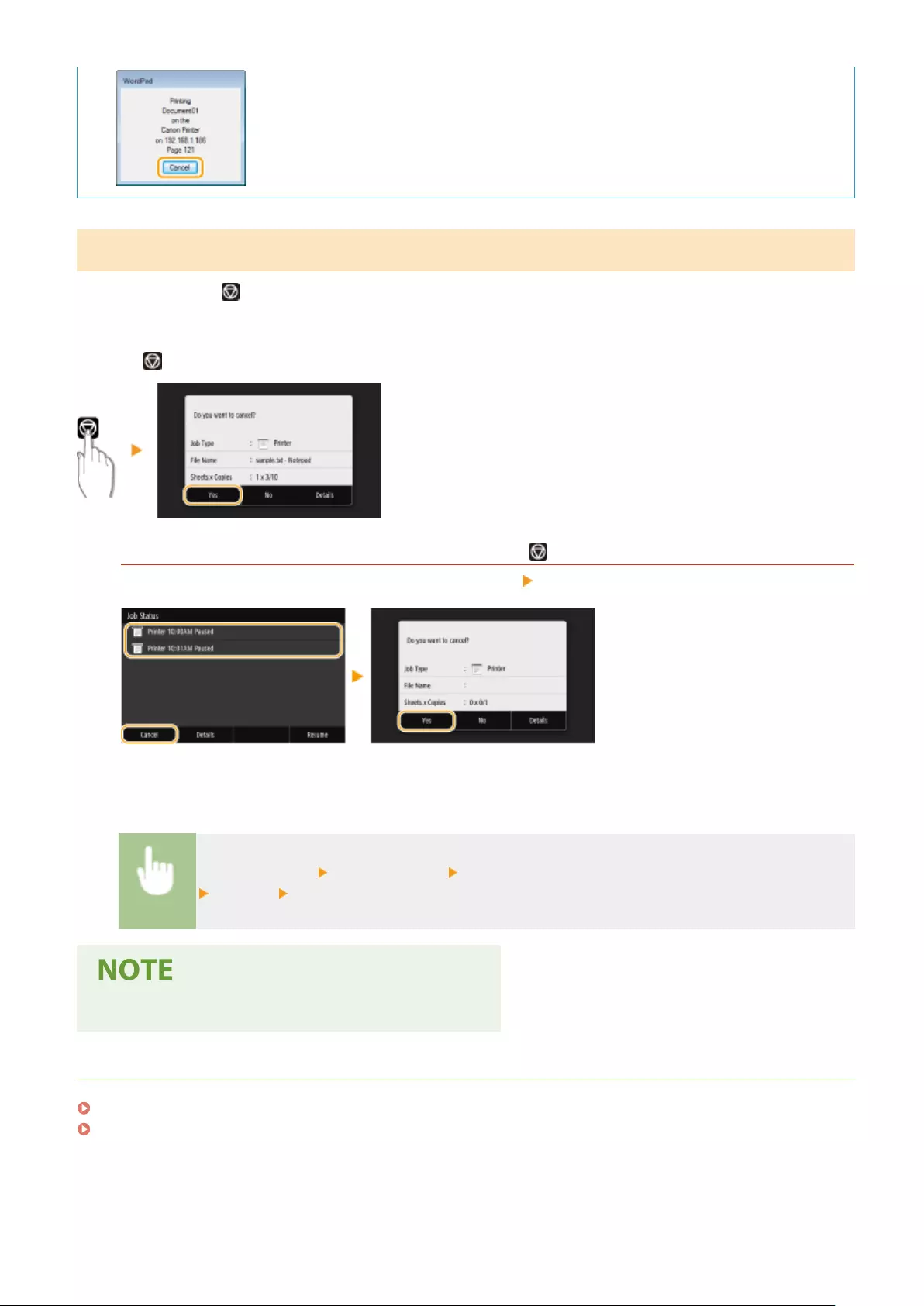
From the Operation Panel
Cancel printing using or <Status Monitor>.
◼Press to Cancel
If the Screen Displays a List of Documents When is Pressed
Select the document you want to cancel, and select <Cancel> <Yes>.
◼Check the Print Job Status Before Canceling
<Status Monitor> <Copy/Print Job> Select the document in the <Copy/Print Job Status> tab
<Cancel> <Yes>
●Several pages may be output after you cancel printing.
LINKS
Basic Printing Operations(P. 260)
Checking the Printing Status and Log(P. 264)
Printing
263
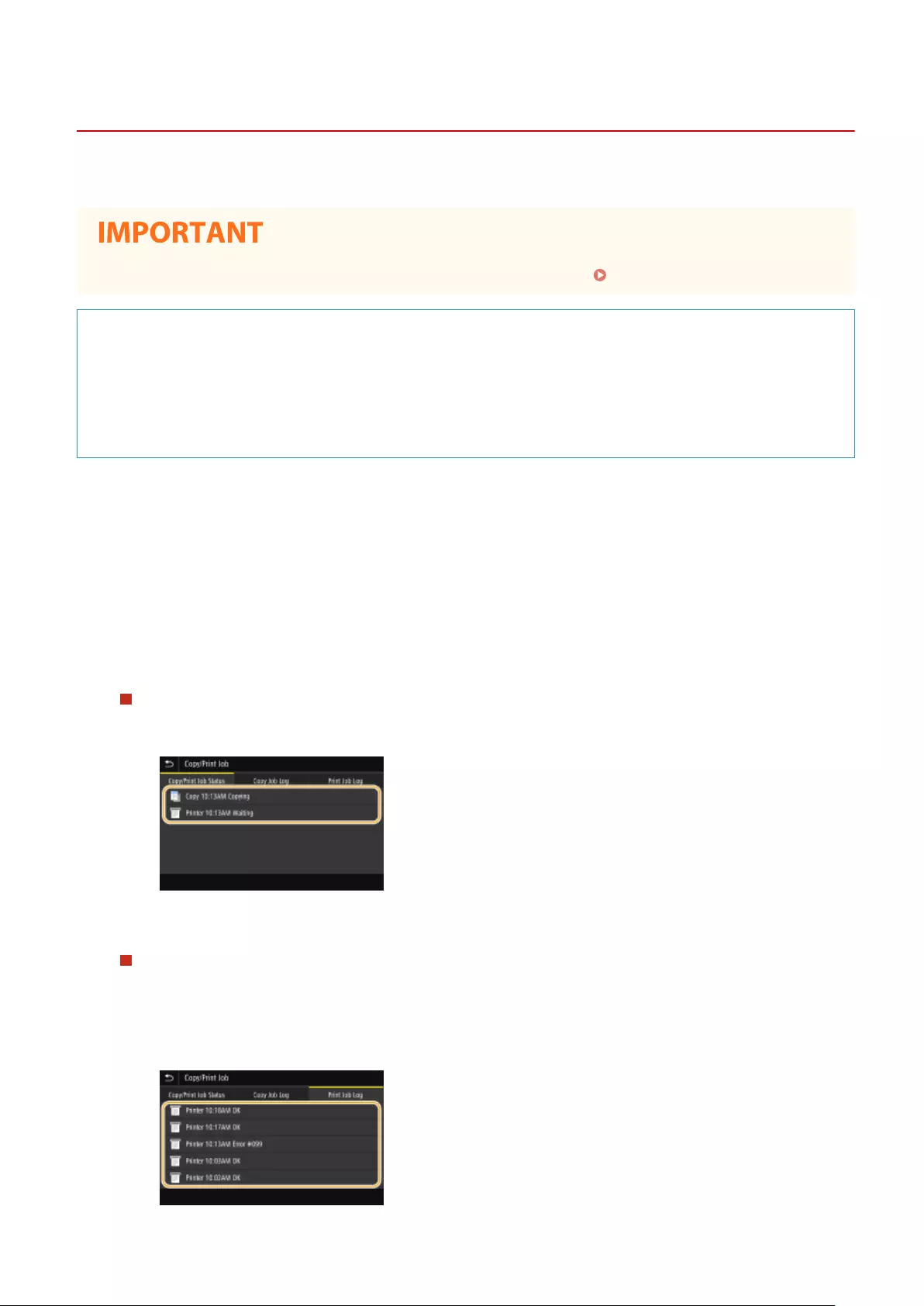
Checking the Printing Status and Log
6FR5-058
You can check the current print statuses and the logs for printed documents.
●When <Display Job Log> is set to <Off>, you cannot check the print logs. <Display Job Log>(P. 565)
Useful in the Following Cases
●When your documents are not printed for a long time, you may want to see the waiting list of the
documents waiting to be printed.
●When you cannot nd your printouts that you thought had been printed, you may want to see whether an
error has occurred.
1Select <Status Monitor>.
2Select <Copy/Print Job>.
3Check the print statuses and logs.
To check the print statuses
1Select the document whose status you want to check in the <Copy/Print Job Status> tab.
➠Displays detailed information about the document.
To check the print logs
1Select the document whose log you want to check in the <Print Job Log> tab.
●<OK> is displayed when a document was printed successfully, and <Error> is displayed when a
document failed to be printed because it was canceled or there was some error.
Printing
264

➠Displays detailed information about the document.
●The displayed document name or user name may not reect the actual document or user name.
When a three-digit number is shown in the case of <Error>
●This number represents an error code. For more information, see "Troubleshooting (FAQ)" on the
online manual website.
LINKS
Basic Printing Operations(P. 260)
Canceling Prints(P. 262)
Printing
265
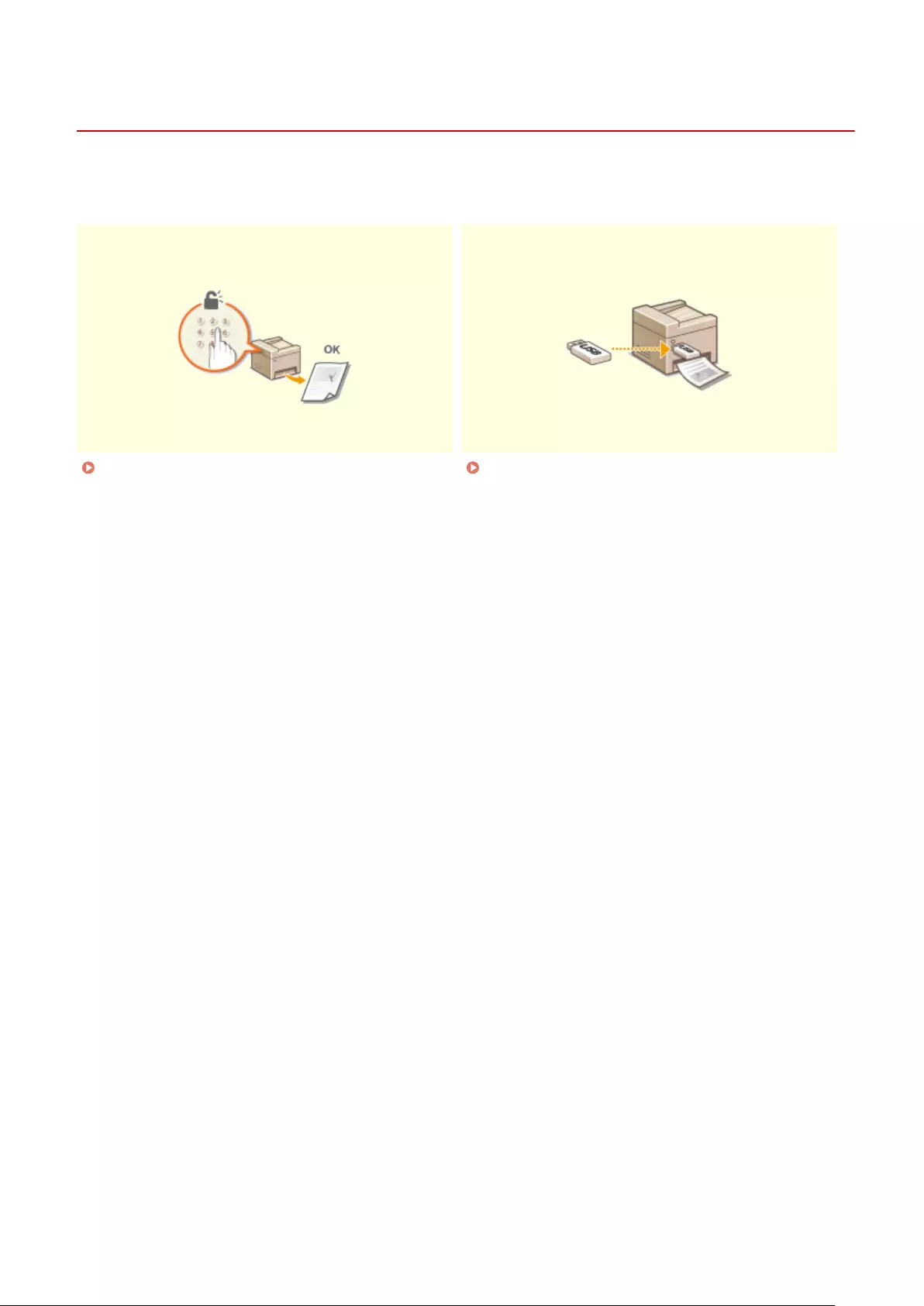
Various Printing Methods
6FR5-059
This section describes how to print a document by adding a PIN, and how to print a le stored on a USB memory
device without using the printer driver.
Printing a Document Secured by a PIN (Secure
Print)(P. 267)
Printing from a USB Memory Device (Memory
Media Print)(P. 271)
Printing
266
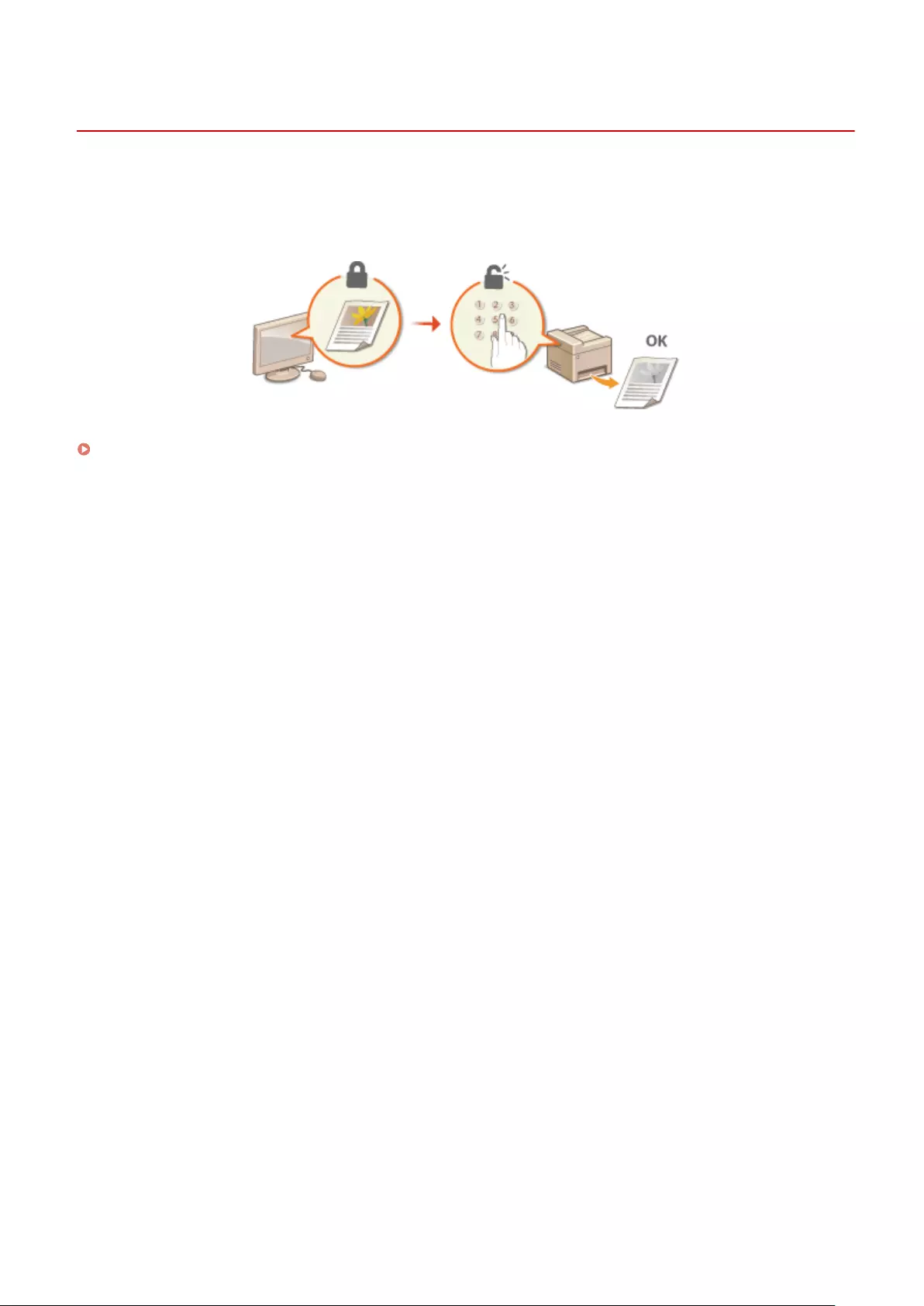
Printing a Document Secured by a PIN (Secure Print)
6FR5-05A
By setting a PIN to a document when printing from a computer, the document is held in the memory of the machine,
and is not printed until the correct PIN is entered on the operation panel of the machine. This function is called "Secure
Print," and the document that is protected by a PIN is called a "secured document." Using Secure Print keeps printouts
of condential documents from being left unattended.
Printing via Secure Print(P. 268)
Printing
267
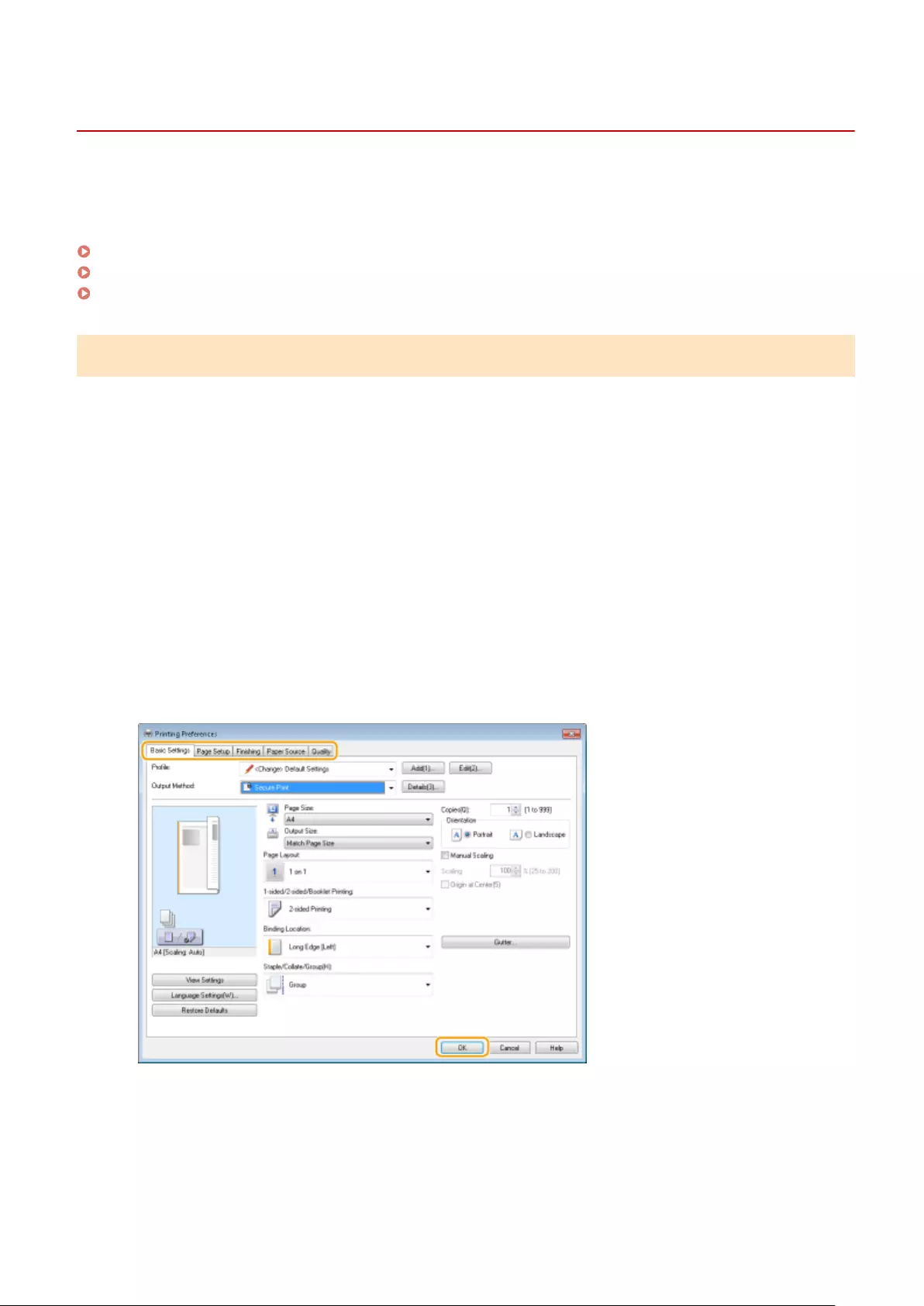
Printing via Secure Print
6FR5-05C
This section describes how to print a document from an application as a secured document. The rst part of this
section describes how to send a secured document to the machine, and the second part of this section describes how
to print the secured document on the machine.
Sending a Secured Document from a Computer to the Machine(P. 268)
Printing Out Secured Documents(P. 269)
Changing the Valid Time Period for Secured Documents(P. 270)
Sending a Secured Document from a Computer to the Machine
1Open a document in an application and display the print dialog box.
2Select the printer driver for this machine, and click [Preferences] or [Properties].
3Select [Secured Print] in [Output Method].
➠The [Information] pop-up screen is displayed. Check the message, and click [Yes] or [No].
4Specify the print settings as necessary, and click [OK].
●Switch the tab according to the settings.
5Click [Print] or [OK].
➠After the secured document is sent to the machine, it is held in the memory of the machine waiting to be
printed.
Printing
268
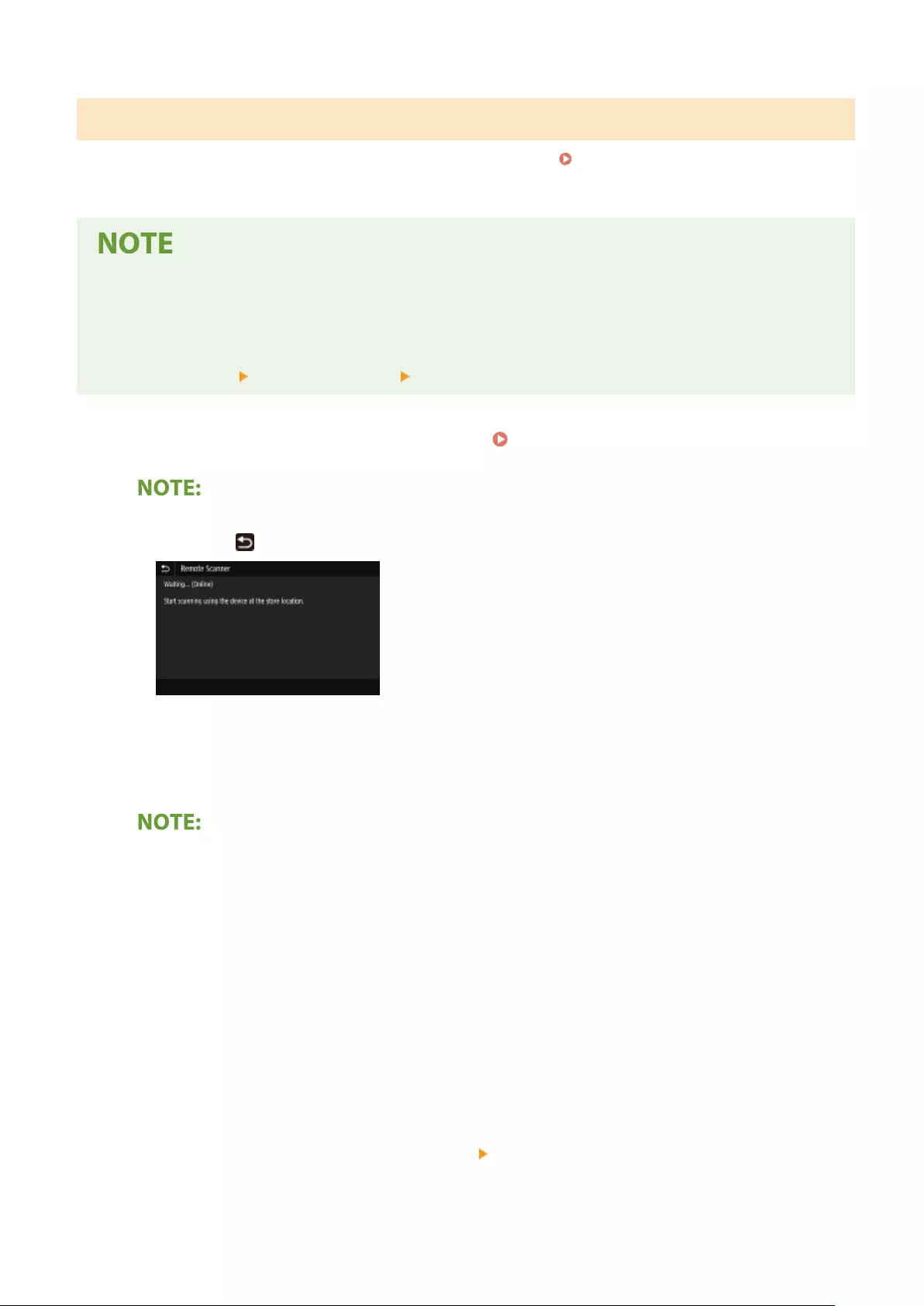
Printing Out Secured Documents
Prints secured documents sent to the machine. After a valid time period ( Changing the Valid Time Period for
Secured Documents(P. 270) ) has elapsed, the secured document will be deleted from the memory of the machine
and can no longer be printed.
●If secured documents are left unprinted, they occupy the memory and may prevent the machine from
printing even ordinary (not secured) documents. Make sure that you print your secured documents as soon
as you can.
●You can check how much memory is being used for secured documents.
<Status Monitor> <Device Information> <Secure Print Memory Usage>
1Select <Secure Print> in the Home screen. Home Screen(P. 124)
●You cannot proceed to the next step if the <Remote Scanner> screen shown below is displayed. In this
case, select to close the screen, and select <Secure Print>.
2Select the check box for the secured document to print, and select <Start>.
●You can select multiple documents that have the same PIN.
If a screen for user selection is displayed
●If secured documents from two or more users are stored in memory, the screen for user selection is
displayed prior to the screen for le selection. Select your user name.
Deleting a secured document
●You can collectively delete multiple documents. Select the check box for the secured document to delete,
and select <Delete>.
3Enter the PIN, and select <Apply>.
●When you select multiple documents with different PINs in step 2, a message is displayed. Select <Close>,
and select the secured documents again in step 2.
➠Printing starts.
●If you want to cancel printing, select <Cancel> <Yes>.
Printing
269
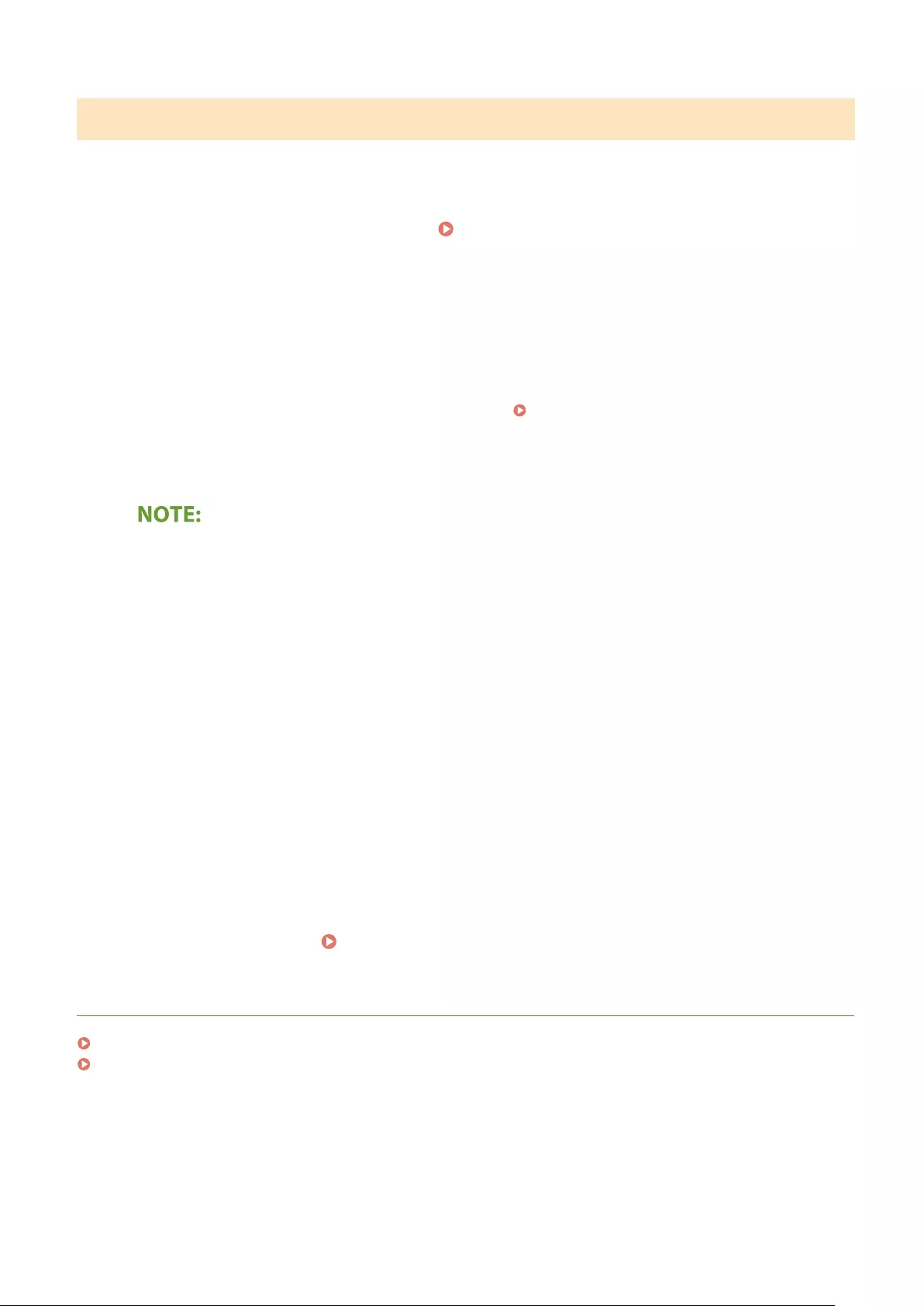
Changing the Valid Time Period for Secured Documents
You can change the valid time period from the time secured document data is sent to the machine until the time it is
deleted within a certain period of time.
1Select <Menu> in the Home screen. Home Screen(P. 124)
2Select <Function Settings>.
3Select <Secure Print>.
●If the login screen appears, enter the correct ID and PIN. Logging in to the Machine(P. 135)
4Select <Secure Print Deletion Time>.
When <Secure Print Deletion Time> cannot be selected
●Set <Use Secure Print> to <On>.
Disabling Secure Print
●Set <Use Secure Print> to <Off>, and then restart the machine.
5Specify how long the machine holds secured documents, and select <Apply>.
●The secured document is deleted from the memory of the machine unless it is printed before the time
specied here elapses.
6Select <Apply>.
7Select <OK>.
8Restart the machine. Restarting the Machine(P. 120)
LINKS
Checking the Printing Status and Log(P. 264)
Restricting Printing from a Computer(P. 420)
Printing
270
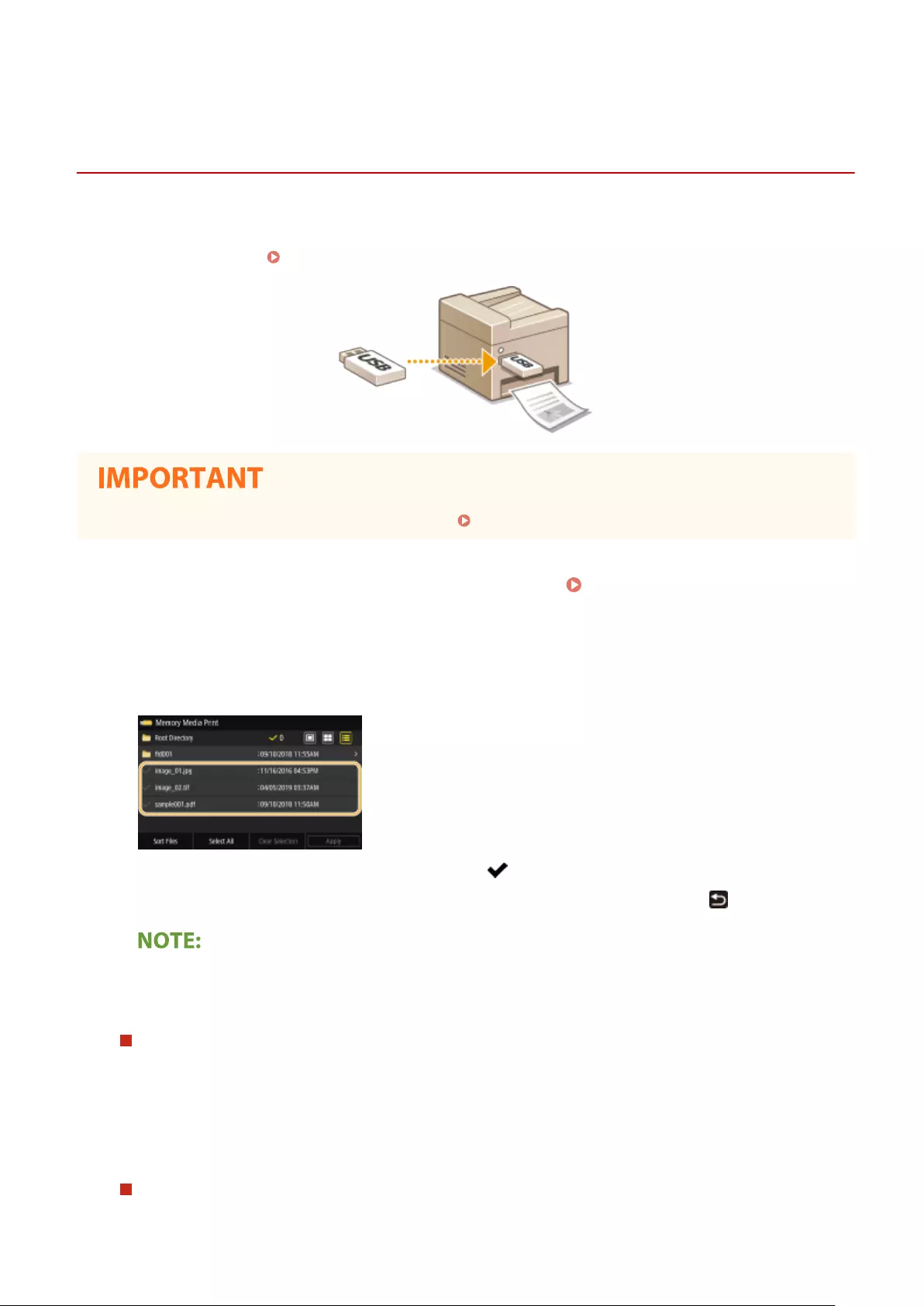
Printing from a USB Memory Device (Memory Media
Print)
6FR5-05E
You can print les directly by connecting a USB memory device to the machine. Using this function, you can print
without using a computer. For more information about the available USB memory devices and how to insert/remove
the USB memory device, see Using a USB Memory Device(P. 188) .
●It is necessary to set <Use Print Function> to <On>. <Memory Media Settings>(P. 559)
1Select <Memory Media Print> in the Home screen. Home Screen(P. 124)
2Select the check box for the le to print.
●You can select multiple les.
●To clear a selection, select the le you have selected ( ) again.
●Selecting a folder displays its contents. To return to the folder in the upper level, select .
●Folders and les in a level deeper than the fth directory are not displayed.
●When you move to another folder, the previous le selections will be cleared.
To select all les
1Select <Select All>.
●To clear all selections, select <Clear Selection>.
2If le types are mixed, select <JPEG/TIFF Files> or <PDF Files>.
To change the le display method
You can select the le display method from "Preview"/"Thumbnail"/"Details."
Printing
271
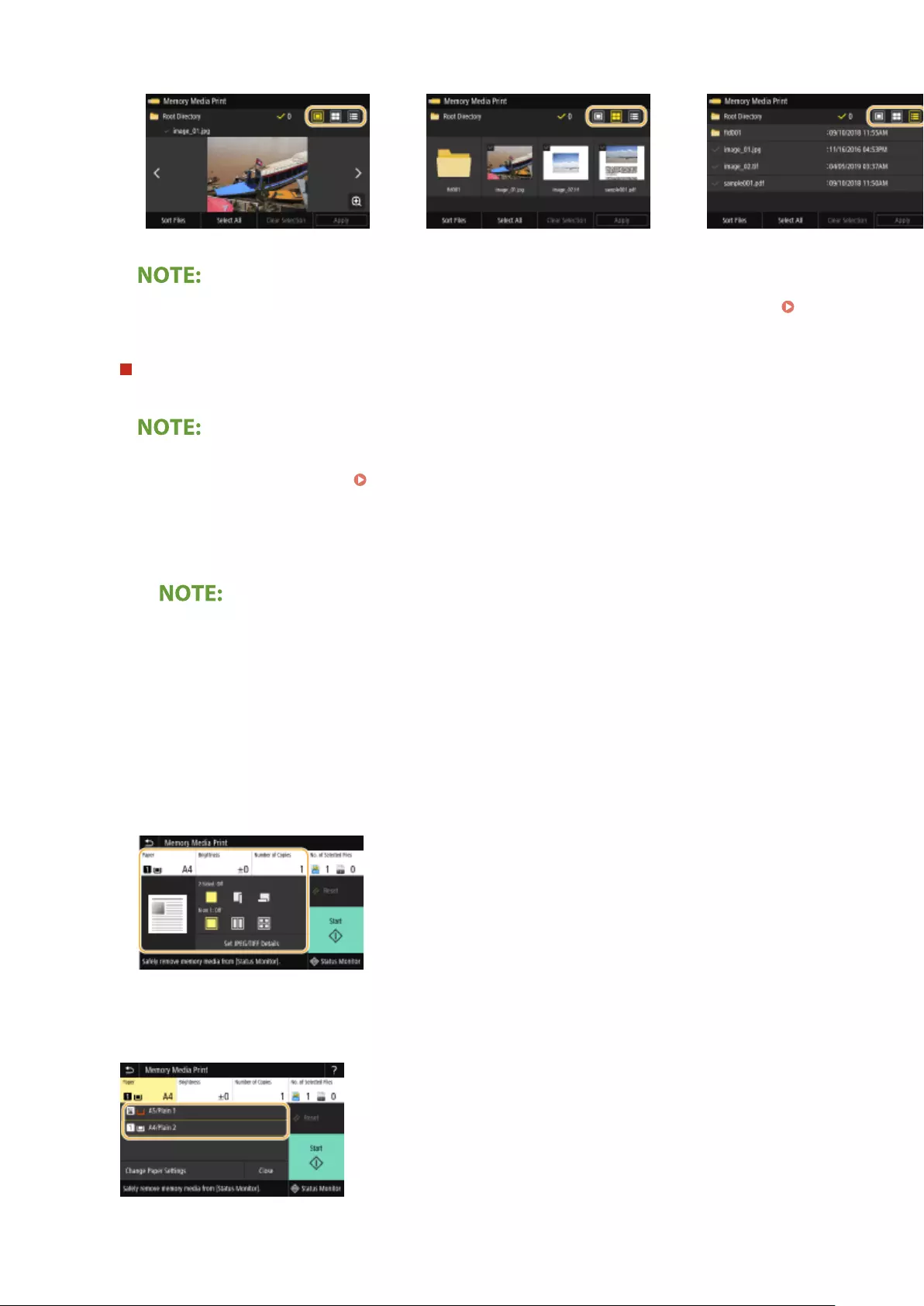
Preview Thumbnail Details
●You can specify the le display method used to display the <Memory Media Print> screen. <Default
Display Settings>(P. 557)
To change the le sort order
You can change the sort order of the les in a USB memory device.
●You can specify a sort setting such as <Name (Ascending)> or <Date/Time (Ascending)> as the default
setting for the le sort order. <File Sort Default Settings>(P. 558)
1Select <Sort Files>.
2Select the criteria for le sorting.
●When you select <Date/Time (Ascending)> or <Date/Time (Descending)>, les are sorted based on the
modication dates and time of the les.
3Select <Apply>.
4Specify the print settings as necessary.
●You can select <Reset> to restore all the default print settings.
<Paper>
Select the paper source that contains the paper to use for printing.
Printing
272
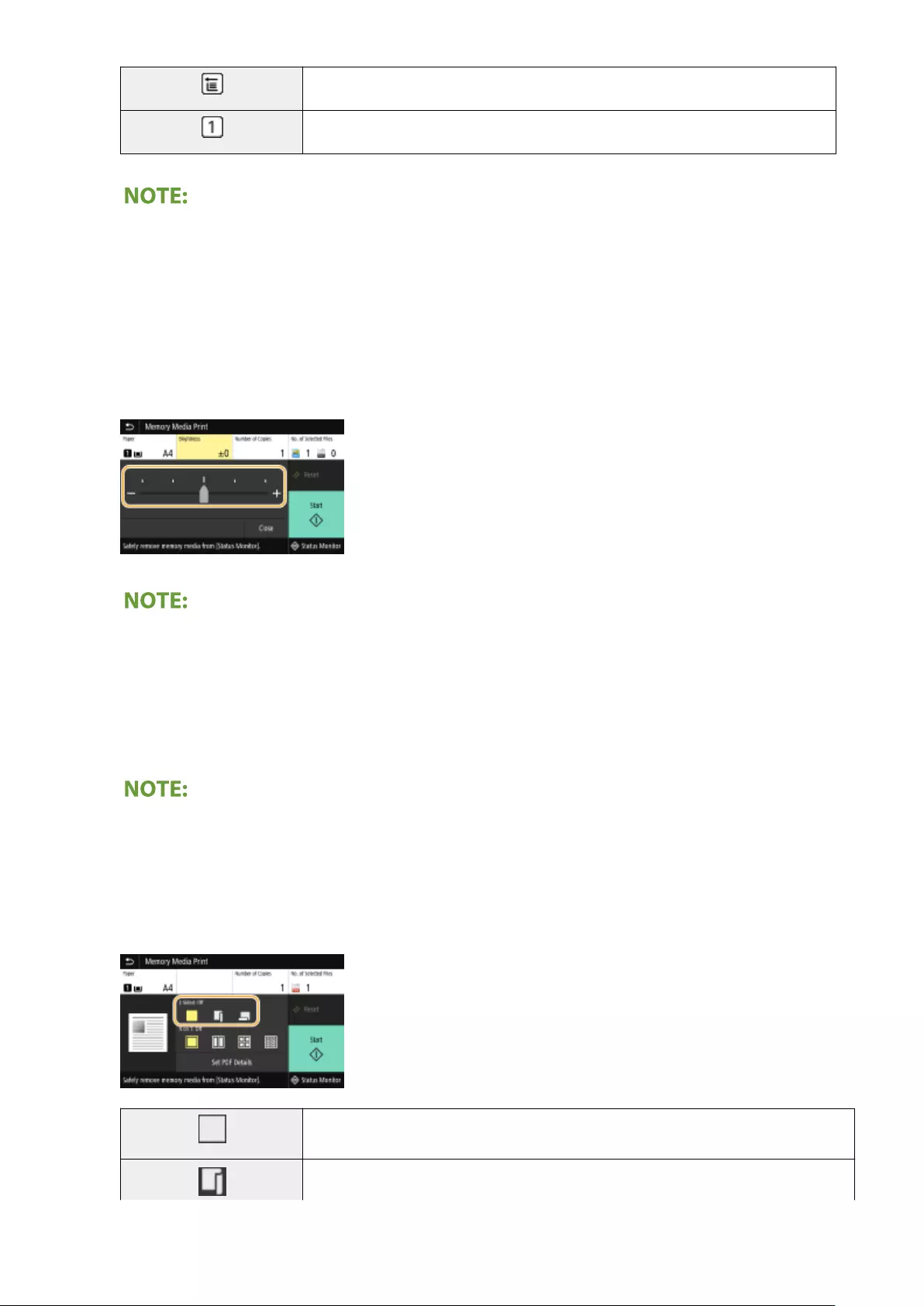
Uses the paper that is loaded in the multi-purpose tray to print les.
Uses the paper that is loaded in the paper drawer (Drawer 1) of the machine to print les.
●When the optional cassette feeding module is installed, its paper drawer is also displayed.
●When specifying other print settings, select <Close>.
<Brightness>
●<Brightness> is not available for printing PDF les.
You can adjust the brightness of images.
●When specifying other print settings, select <Close>.
<Number of Copies>
Enter the number of copies.
●When specifying other print settings, select <Close>.
<2-Sided Printing>
You can select 1-sided printing or 2-sided printing.
Prints on one side of paper.
Prints on both sides of paper in such a way that the printed pages are opened horizontally
when bound.
Printing
273
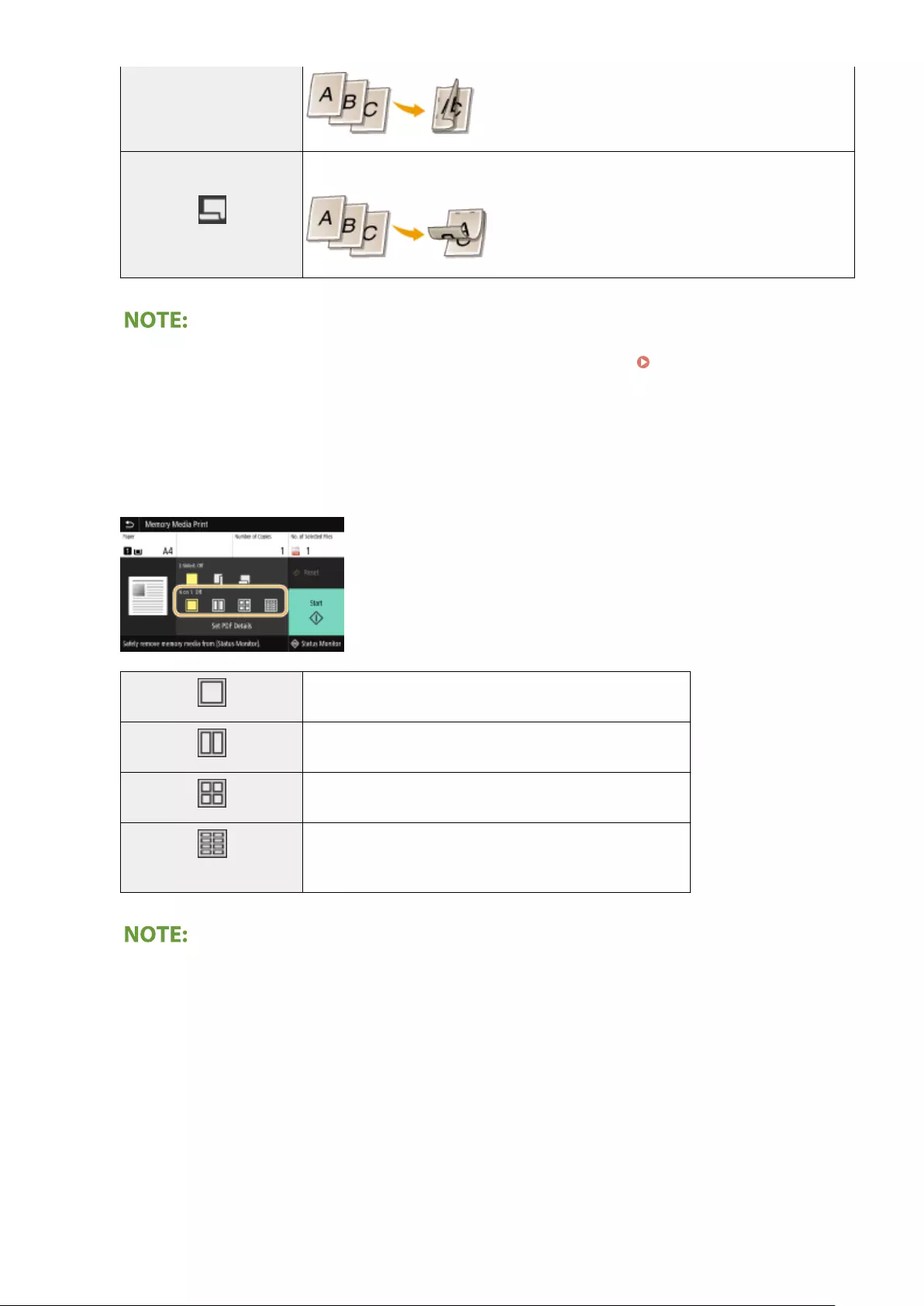
Prints on both sides of paper in such a way that the printed pages are opened vertically
when bound.
●<2-Sided Printing> may not be available with some sizes or types of paper. Available Paper(P. 624)
<N on 1>
●<N on 1> is not available for printing TIFF les.
You can select an "N on 1" pattern to print multiple pages of image data on one side of a sheet of paper.
Does not apply N on 1.
Prints two pages of image data on one side of a sheet of paper.
Prints four pages of image data on one side of a sheet of paper.
(PDF only)
Prints eight pages of image data on one side of a sheet of paper.
●For a PDF le, you can print 9 or 16 pages of image data on one side of a sheet of paper by using <N on 1>
under <Set PDF Details>.
<Set JPEG/TIFF Details>
You can change the print settings for JPEG and TIFF images.
Printing
274
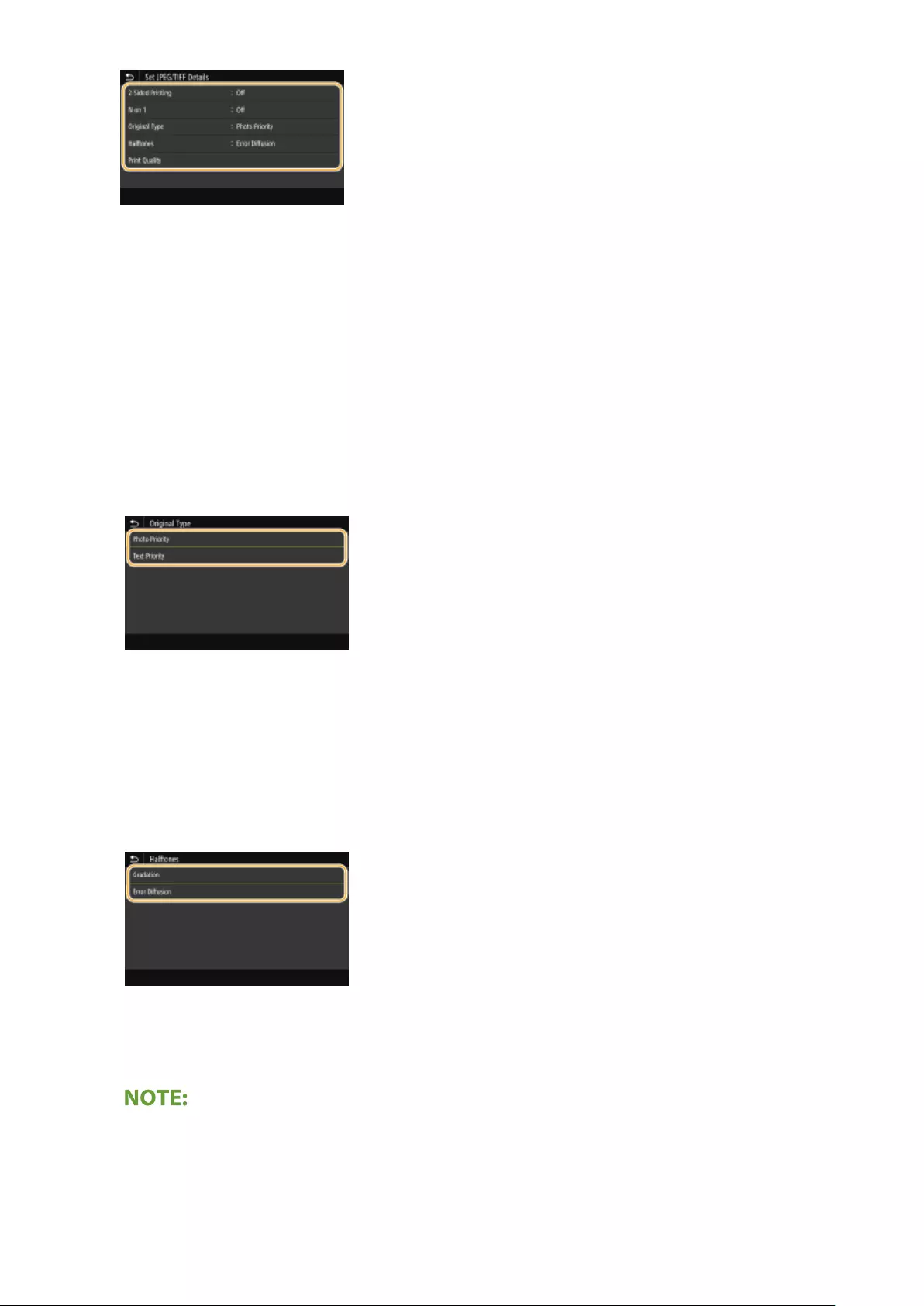
<2-Sided Printing>
You can make 2-sided printouts. Select the binding position.
<N on 1> (JPEG les only)
Prints data for multiple pages of image data on the same side of a sheet of paper. You can specify the number
of pages to print on one side of a sheet of paper. For example, to print four pages on one side of a sheet of
paper, select <4 on 1>.
<Original Type>
You can select the type of original depending on the image to print.
<Photo Priority>
Gives priority to printing photo images smoothly.
<Text Priority>
Gives priority to printing text clearly.
<Halftones>
You can select the printing method used to reproduce halftones (the intermediate range between the lighter
and darker areas of an image) for optimal image quality.
<Gradation>
Prints images with ne gradation, such as digital camera images, with a smooth nish.
<Error Diffusion>
This mode is suitable for printing data with text and thin lines and the curved lines of CAD data, etc.
●The stability of the texture and xed toner may be reduced when <Error Diffusion> is used.
<Print Quality>
Printing
275
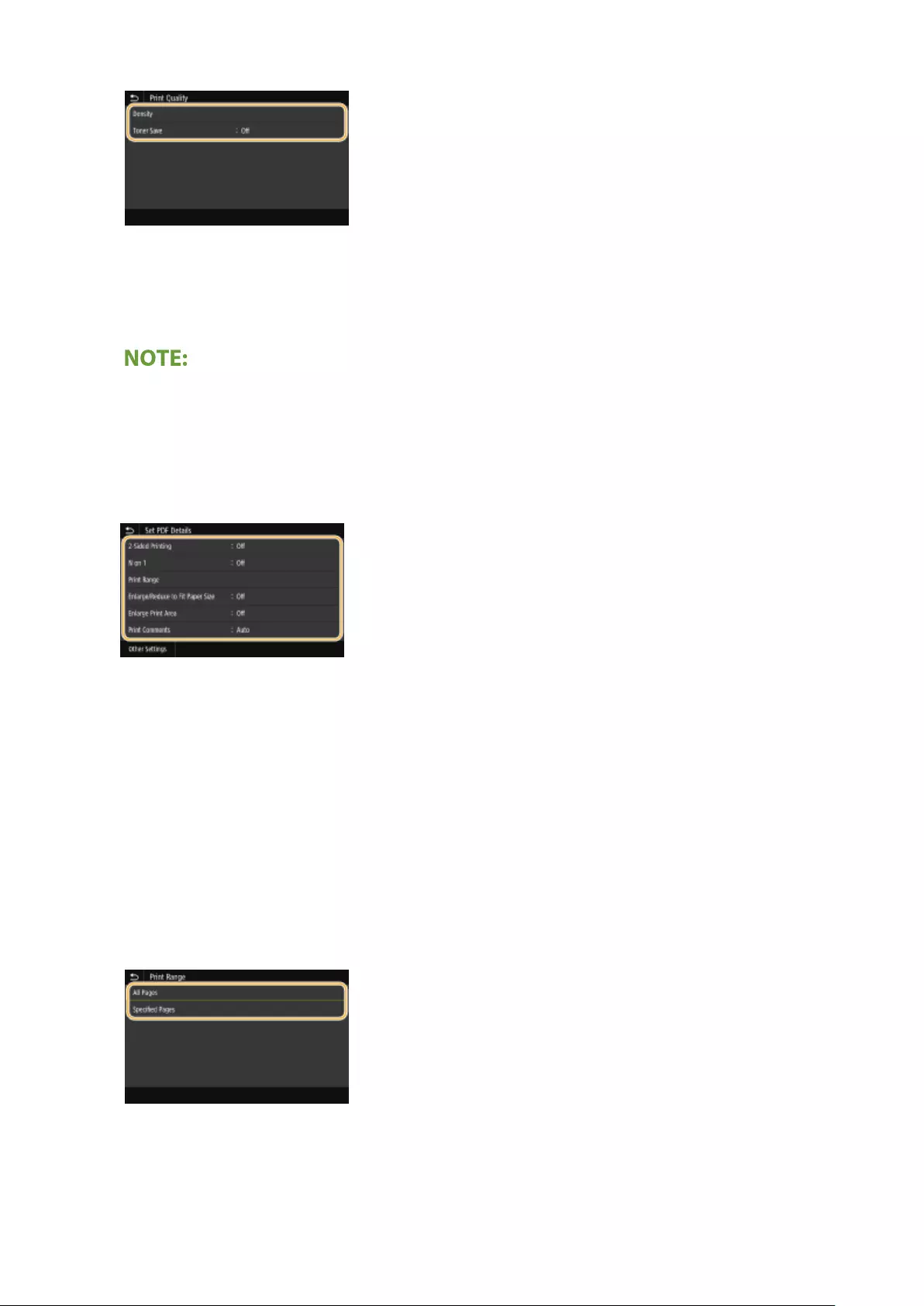
You can change settings related to print quality.
<Density>
Adjusts the density for printing.
<Toner Save>
Selecting <On> prints in toner saving mode. Select <On> when you want to check the layout or other
appearance characteristics before proceeding to nal printing of a large job.
●When <Toner Save> is set to <On>, <Density> is not available.
<Set PDF Details>
You can change the print settings for PDFs.
<2-Sided Printing>
You can make 2-sided printouts. Select the binding position.
<N on 1>
Prints data for multiple pages of image data on the same side of a sheet of paper. You can specify the number
of pages to print on one side of a sheet of paper. For example, to print four pages on one side of a sheet of
paper, select <4 on 1>.
<Print Range>
Specify pages you want to print.
<All Pages>
Prints all pages.
<Specied Pages>
Specify the range of pages you want to print. Enter the desired value in each of <Start Page> and <End Page>,
and select <Apply>.
Printing
276
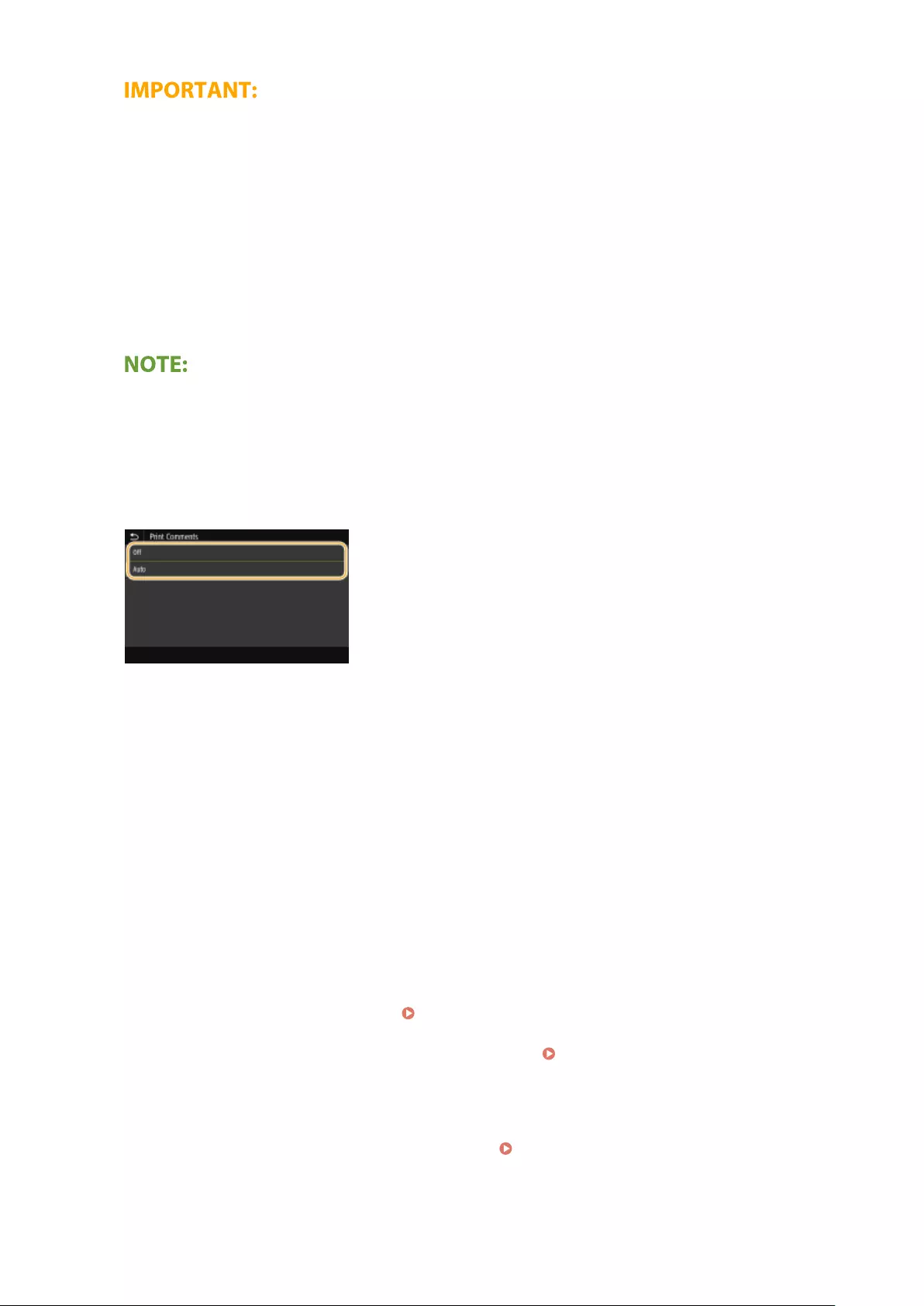
●When the specied page range does not match any of the pages of the PDF le, printing is not performed.
<Enlarge/Reduce to Fit Paper Size>
Specify whether to enlarge or reduce the original according to the print range of paper. Note that size
enlargement/reduction will not affect the aspect ratio of the original.
<Enlarge Print Area>
Specify whether to extend the print range to the paper size.
●If you set to <On>, part of print data may not be printed in edge areas or paper may be partly smudged
depending on the document.
<Print Comments>
This setting species whether to print annotations in the PDF le.
<Off>
Prints no annotations.
<Auto>
Prints only those annotations that are specied to be printed in the PDF le.
<Password to Open Document>
You can print password protected PDF les by entering the password required to open them. Enter the
password, and select <Apply>.
<Other Settings>
<Halftones>
You can select the printing method used to reproduce halftones (the intermediate range between the lighter
and darker areas of an image) for optimal image quality. You can make this setting for each of the types of
image contained in one document. See <Halftones>(P. 528) for the description of the setting.
<Grayscale Conversion>
Specify the way of printing color data in black and white. See <Grayscale Conversion>(P. 529) for the
description of the setting.
<Print Quality>
<Density>
Adjust the toner density to be used for printing. See <Density>(P. 511) for the description of the setting.
<Toner Save>
Printing
277
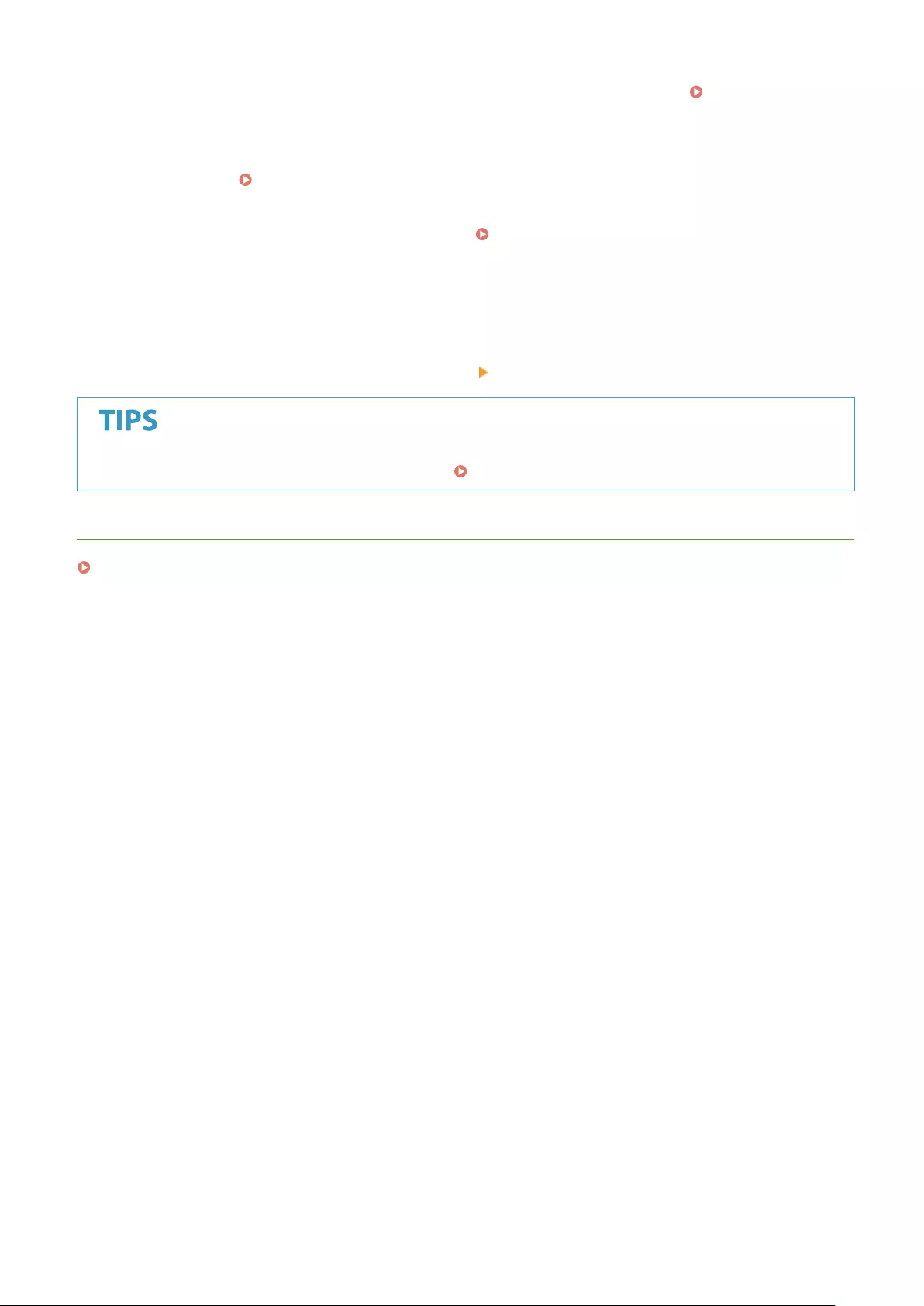
Selecting <On> prints in toner saving mode. Select <On> when you want to check the layout or other
appearance characteristics before proceeding to nal printing of a large job. See <Toner Save>(P. 512)
for the description of the setting.
<Image Renement>
Enable or disable the smoothing mode in which the edges of characters and graphics are smoothly
printed. See <Image Renement>(P. 512) for the description of the setting.
<Resolution>
Specify the resolution to process print data. See <Resolution>(P. 512) for the description of the setting.
5Select <Start>.
➠Printing starts.
●If you want to cancel printing, select <Cancel> <Yes>.
●If you always want to print with the same settings: Memory Media Print(P. 174)
LINKS
<Store/Access Files>(P. 554)
Printing
278

Scanning
Scanning .............................................................................................................................................................. 280
Scan Basic Features Screen ............................................................................................................................... 282
Basic Operations for Scanning Originals ......................................................................................................... 285
Scanning and Saving to a Computer ............................................................................................................. 286
Saving Data to a USB Memory Device ........................................................................................................... 288
Sending Data by E-Mail/Saving Data to a Shared Folder or FTP Server ......................................................... 292
Canceling Sending Documents ..................................................................................................................... 302
Checking Status and Log for Scanned Originals ........................................................................................... 303
Scanning Clearly ................................................................................................................................................ 305
Adjusting Image Quality ............................................................................................................................... 306
Adjusting Density ......................................................................................................................................... 307
Adjusting Sharpness When Scanning (Sharpness) ........................................................................................ 308
Useful Scanning Functions ............................................................................................................................... 310
Enhancing the Security of Electronic Files ..................................................................................................... 311
Adjusting Balance between File Size and Image Quality (Data Size) .............................................................. 314
Conguring a File Name ............................................................................................................................... 315
Recalling Previously Used Settings for Sending/Saving (Recall Settings) ....................................................... 316
Specifying E-Mail Settings ............................................................................................................................. 319
Using Your Computer to Scan (Remote Scan) .................................................................................................. 322
Scanning Documents from an Application .................................................................................................... 323
Using ScanGear MF ...................................................................................................................................... 325
Using WSD .................................................................................................................................................... 326
Scanning Originals Using WSD (WSD Scan) ............................................................................................ 328
Scanning
279
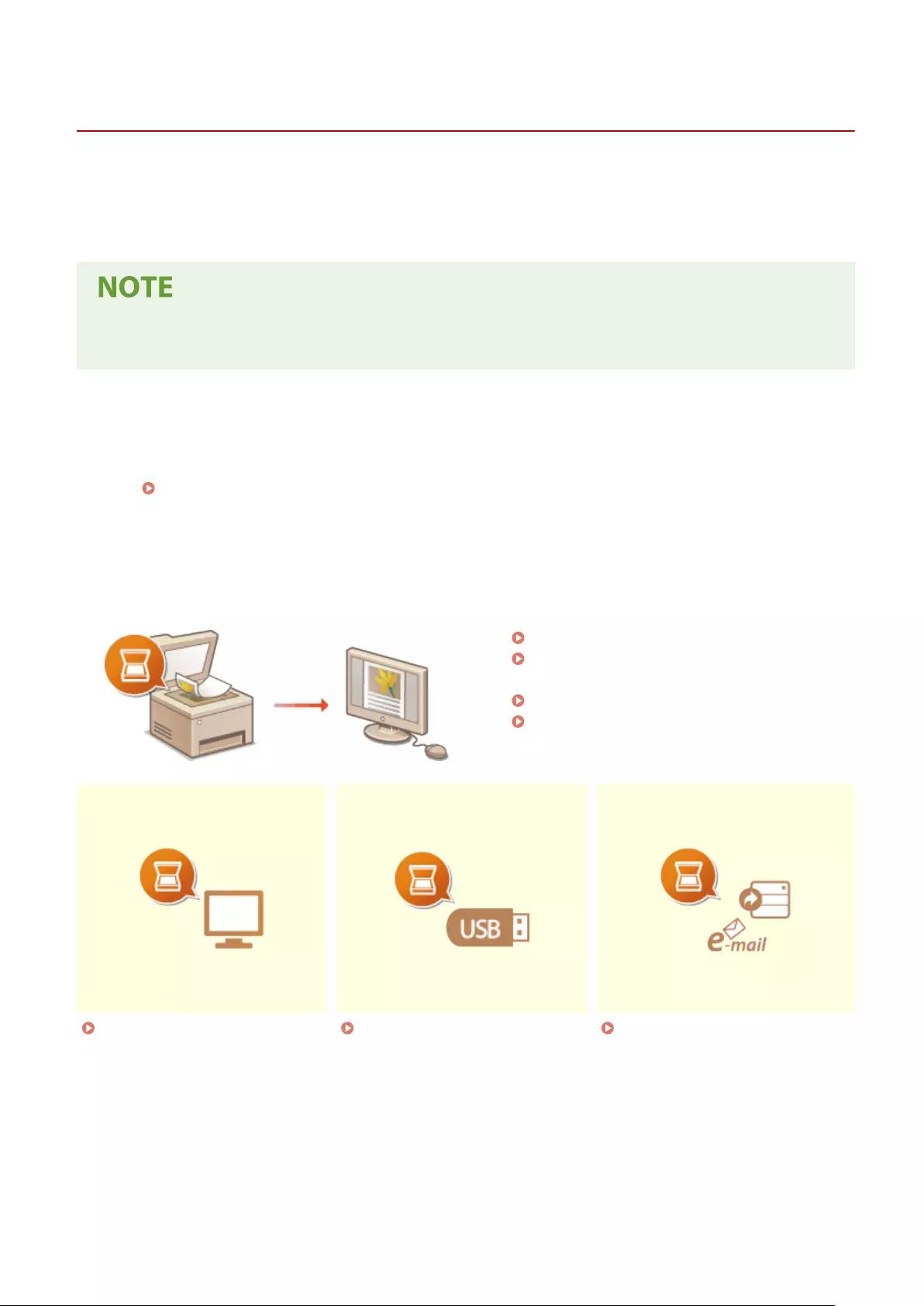
Scanning
6FR5-05F
1660-05E
You can scan original documents by using the operation panel of the machine or an application on a computer.
Whichever way you use, the scanned originals are converted into electronic le formats such as PDFs. Use the scan
function to convert large-volume paper documents into les so that you can organize them easily.
●Depending on the operating system and the version of the scanner driver or applications you are using, the
screens in this manual may differ from your screens.
◼Using the Machine with a Computer
To use this machine with a computer, you must complete preparations in advance, including installation of software to
a computer. To connect the machine to your computer via a network, you must register the machine to the installed
software. Preparing to Use the Machine as a Scanner(P. 84)
◼Using the Scanner
You can scan and save originals to your computer by using the operation panel of the machine. You can also save
originals to a USB memory device or send them as e-mail attachments.
Scan Basic Features Screen(P. 282)
Basic Operations for Scanning
Originals(P. 285)
Canceling Sending Documents(P. 302)
Checking Status and Log for Scanned
Originals(P. 303)
Scanning and Saving to a
Computer(P. 286)
Saving Data to a USB Memory
Device(P. 288)
Sending Data by E-Mail/Saving
Data to a Shared Folder or FTP
Server(P. 292)
◼Enhancing Quality
You can nd instructions on how to resolve problems such as "blurry photos" or "text unreadable due to too deep
color of the paper."
Scanning
280
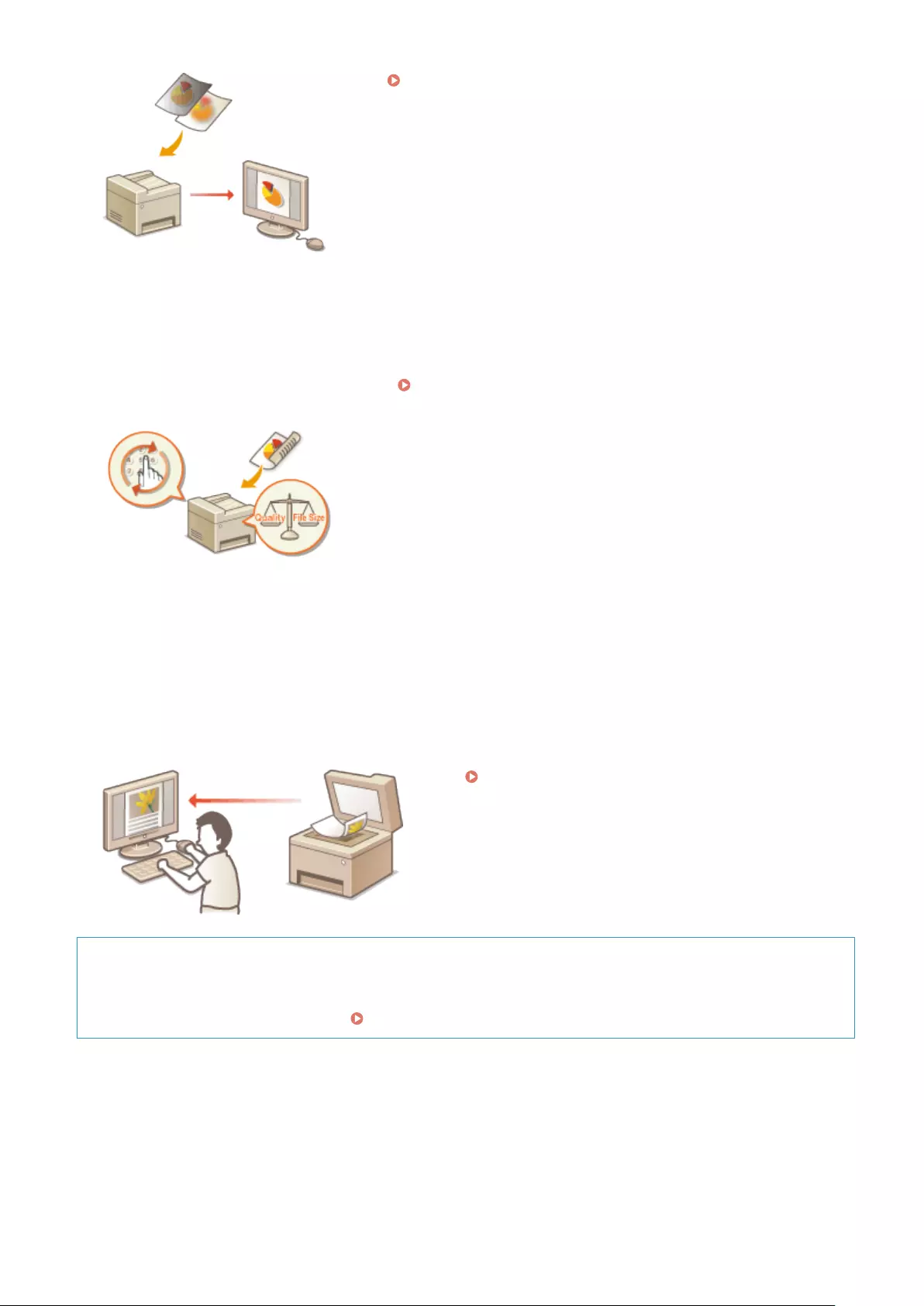
Scanning Clearly(P. 305)
◼Eciently, Reliably
You can nd instructions on how to enhance eciency when sending data and descriptions of useful settings.
Useful Scanning Functions(P. 310)
◼Scanning from a Computer
You can scan originals placed on the machine from a computer. The scanned originals are saved to the computer. You
can scan using MF Scan Utility (included with the machine), or with other applications such as an image-processing or
word-processing application.
Using Your Computer to Scan (Remote Scan)(P. 322)
Scanning from Mobile Devices
●Linking mobile devices such as smartphones or tablets to this machine provides a quick and easy way to
scan originals set on this machine. Linking with Mobile Devices(P. 332)
Scanning
281
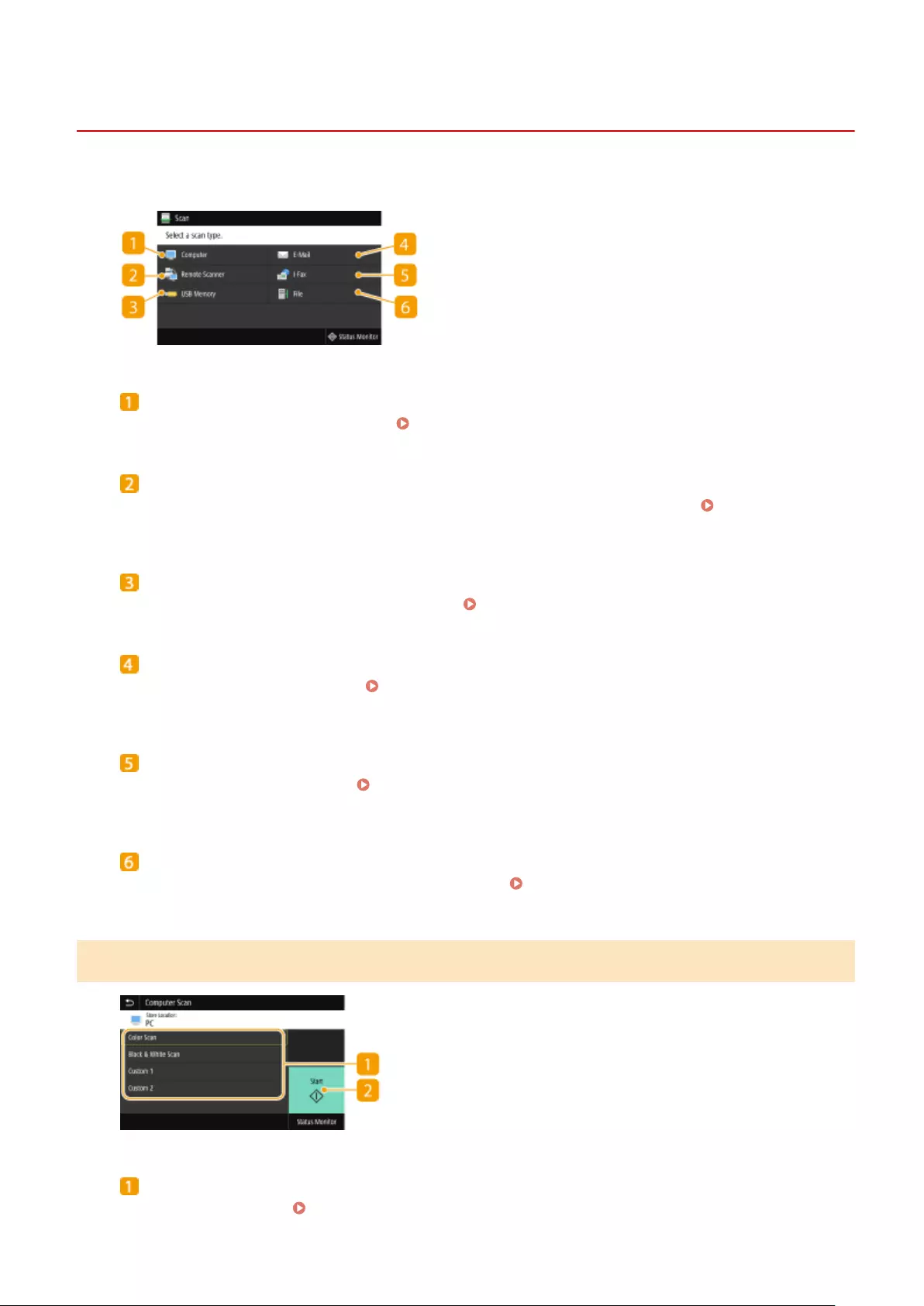
Scan Basic Features Screen
6FR5-05H
When you select <Scan> in the Home screen, the Scan Basic Features screen appears.
<Computer>
Saves the scanned data to a computer. Basic Features Screen for Computer Scanning(P. 282)
<Remote Scanner>
Puts the machine into the online status when originals are scanned from a computer. Using Your
Computer to Scan (Remote Scan)(P. 322)
<USB Memory>
Saves the scanned data to a USB memory device. Basic Features Screen for USB Scanning(P. 283)
<E-Mail>
Sends the scanned data by e-mail. Basic Features Screen for E-Mail Sending/I-Fax Sending/File
Saving(P. 283)
<I-Fax>
Sends the scanned data by I-Fax. Basic Features Screen for E-Mail Sending/I-Fax Sending/File
Saving(P. 283)
<File>
Saves the scanned data to a shared folder or FTP server. Basic Features Screen for E-Mail Sending/I-Fax
Sending/File Saving(P. 283)
Basic Features Screen for Computer Scanning
Scan type
Select the scan setting. Scanning and Saving to a Computer(P. 286)
Scanning
282
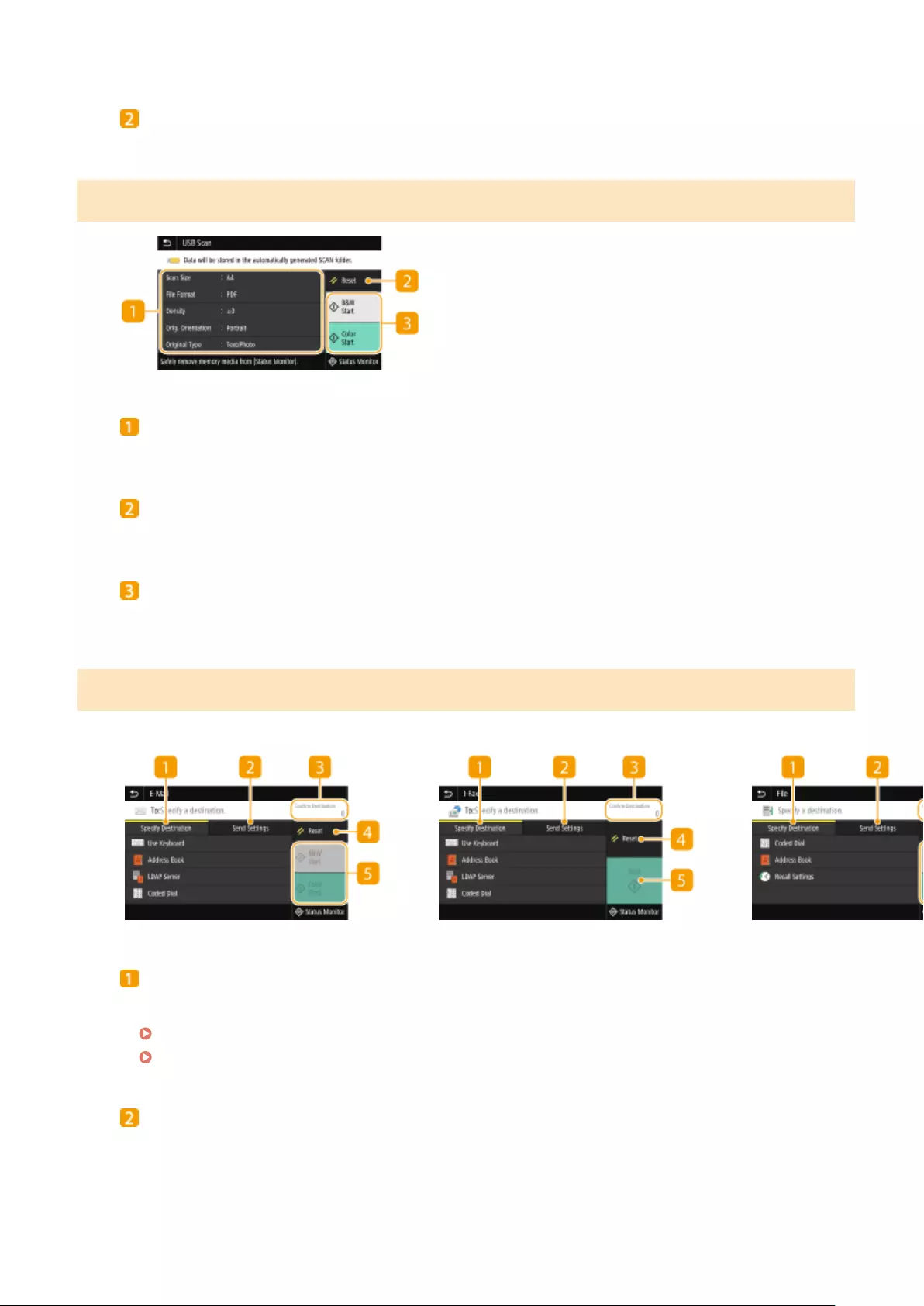
<Start>
Use this button to start scanning.
Basic Features Screen for USB Scanning
Send Settings
The original is scanned based on the settings specied here.
<Reset>
You can collectively restore the default settings.
<Start>
Use this button to start scanning. Selecting <B&W> starts black and white scanning. Selecting <Color> starts
color scanning.
Basic Features Screen for E-Mail Sending/I-Fax Sending/File Saving
E-Mail Sending I-Fax Sending File Saving
<Specify Destination> tab
Select this tab to search for a destination in the Address Book or an LDAP server, enter a coded dial, or
specify a destination using the recall settings.
Sending Data by E-Mail/Saving Data to a Shared Folder or FTP Server(P. 292)
Recalling Previously Used Settings for Sending/Saving (Recall Settings)(P. 316)
<Send Settings> tab
Select this tab to specify the scanning settings.
Scanning
283

<Conrm Destination>
You can check or change the name and address of the specied destination as well as the number of
destinations.
<Reset>
You can collectively restore the default settings.
<Start>
Use this button to start scanning. Selecting <B&W> starts black and white scanning. Selecting <Color> starts
color scanning.
Scanning
284
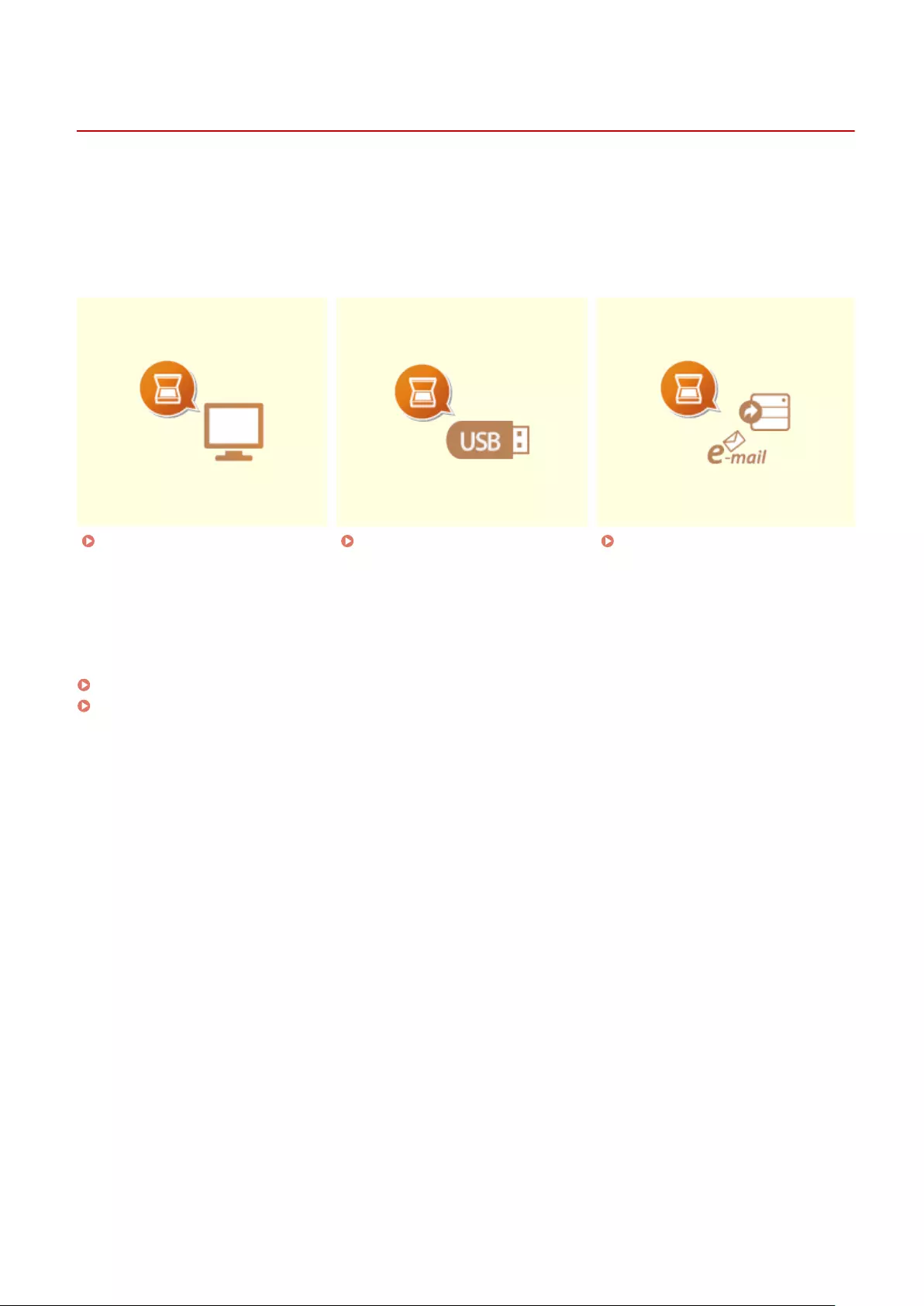
Basic Operations for Scanning Originals
6FR5-05J
1660-05H
This section describes the basic procedures for scanning originals.
◼Scanning
Scanning and Saving to a
Computer(P. 286)
Saving Data to a USB Memory
Device(P. 288)
Sending Data by E-Mail/Saving
Data to a Shared Folder or FTP
Server(P. 292)
◼Operating Jobs
Canceling Sending Documents(P. 302)
Checking Status and Log for Scanned Originals(P. 303)
Scanning
285
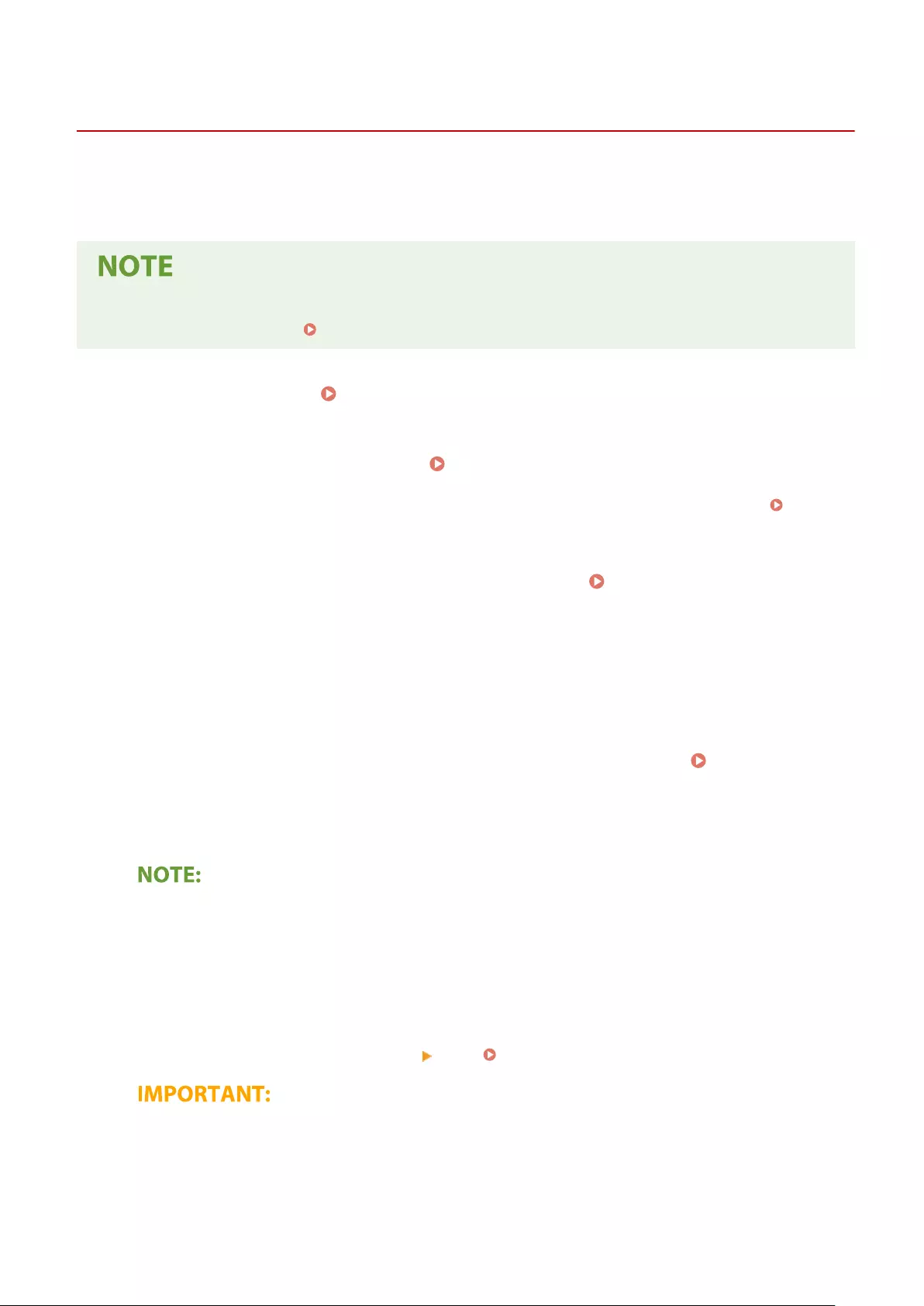
Scanning and Saving to a Computer
6FR5-05K
You can perform the task of "scanning an original and saving it to a computer" from the operation panel of the
machine. Select the computer to be used as the save destination and the settings such as the scanning color (color or
black and white).
●When a network-connected computer is specied as the save destination, you must register the machine to
that computer beforehand. Preparing to Use the Machine as a Scanner(P. 84)
1Place the original(s). Placing Originals(P. 137)
2Select <Scan> in the Home screen. Home Screen(P. 124)
●If the login screen appears, specify the user name, the password, and the authentication server. Logging
in to Authorized Send(P. 135)
3Select <Computer> in the Scan Basic Features screen. Scan Basic Features
Screen(P. 282)
●If only a computer connected to the machine via USB is used, proceed to step 5.
4Select the destination computer.
5Select the scan type in the Computer Scan Basic Features screen. Basic Features
Screen for Computer Scanning(P. 282)
●The scan types and settings that are displayed can be conrmed and changed by using MF Scan Utility. For
more information, click [Instructions] on MF Scan Utility.
●If you are a macOS user, see the manuals for the relevant drivers or software on the online manual
website.
6Select <Start>.
➠Scanning of the original starts.
●If you want to cancel, select <Cancel> <Yes>. Canceling Sending Documents(P. 302)
●You cannot scan while the ScanGear MF is displayed. Close the screen before scanning.
Scanning
286
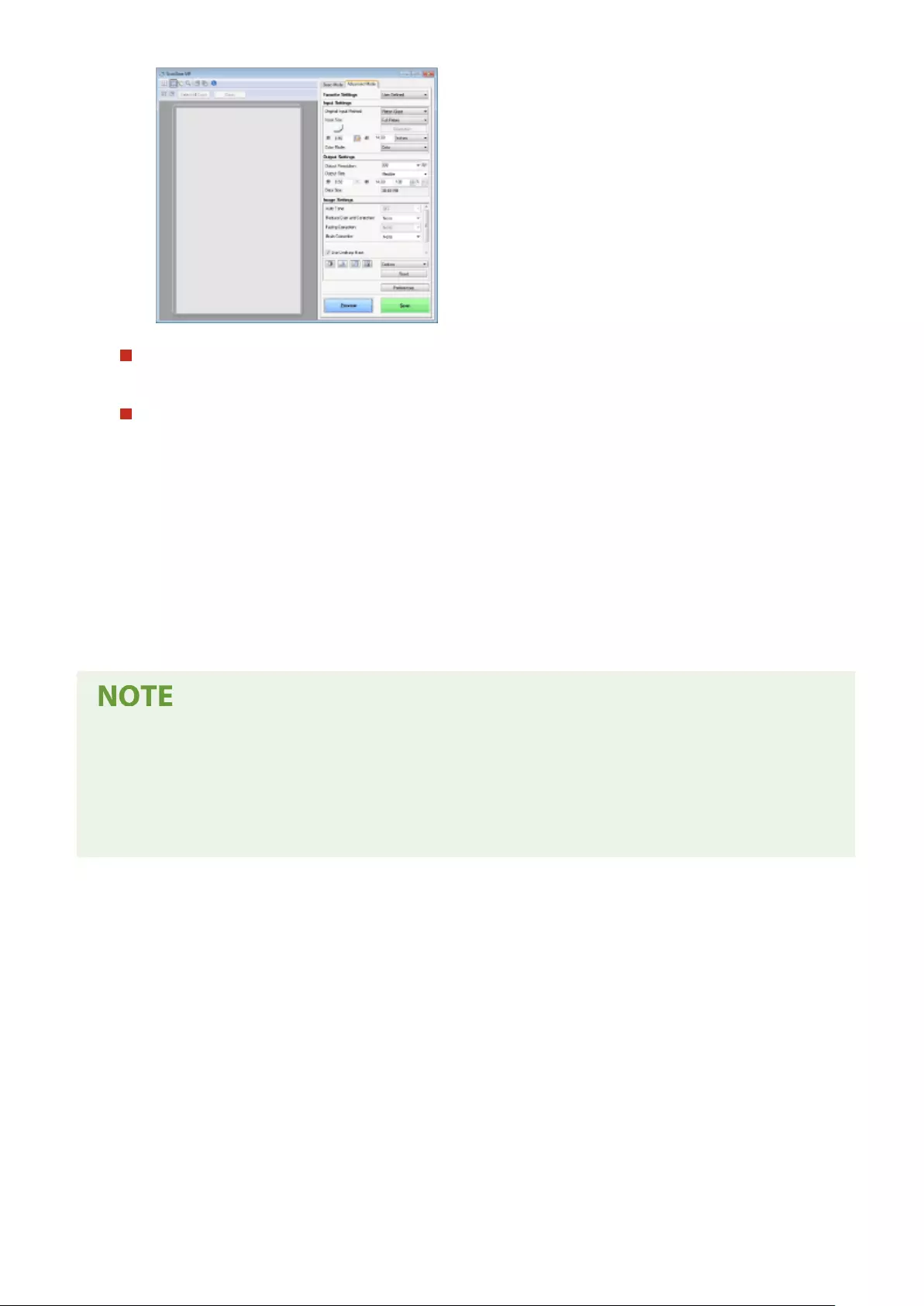
When placing originals in the feeder in step 1
When scanning is complete, the save destination folder is displayed on the computer.
When placing originals on the platen glass in step 1
When scanning is complete, follow the procedure below (except if you selected JPEG as a le format).
1If there are additional pages of originals to be scanned, place the next original on the platen glass, and
select <Scan Next>.
●Repeat this step until you nish scanning all of the pages.
●When there is only one page to be scanned, proceed to the next step.
2Select <Finish>.
➠The save destination folder is displayed on the computer.
About the save destination folder
●By default, the scanned data is saved to the My Documents folder. A subfolder named with the scanning
date is created, and the data is saved to that folder.
●You can change the save destination from the MF Scan Utility. For more information, click [Instructions] on
MF Scan Utility.
Scanning
287

Saving Data to a USB Memory Device
6FR5-05L
This section describes how to scan the original and save the scanned data to a USB memory device. For more
information about the available USB memory devices and how to insert/remove the USB memory device, see Using
a USB Memory Device(P. 188) .
●It is necessary to set <Use Scan Function> to <On>. <Memory Media Settings>(P. 559)
1Place the original(s). Placing Originals(P. 137)
2Select <Scan> in the Home screen. Home Screen(P. 124)
●If the login screen appears, specify the user name, the password, and the authentication server. Logging
in to Authorized Send(P. 135)
3Select <USB Memory> in the Scan Basic Features screen. Scan Basic Features
Screen(P. 282)
4Specify the scanning settings as necessary.
Specifying the Scanning Size of the Original
Selecting a File Format
Specifying Orientation of Your Original
Scanning 2-Sided Originals
Specifying the Scanning Size of the Original
You can specify the scanning size of your original.
<Scan Size> Select the original size
Scanning
288
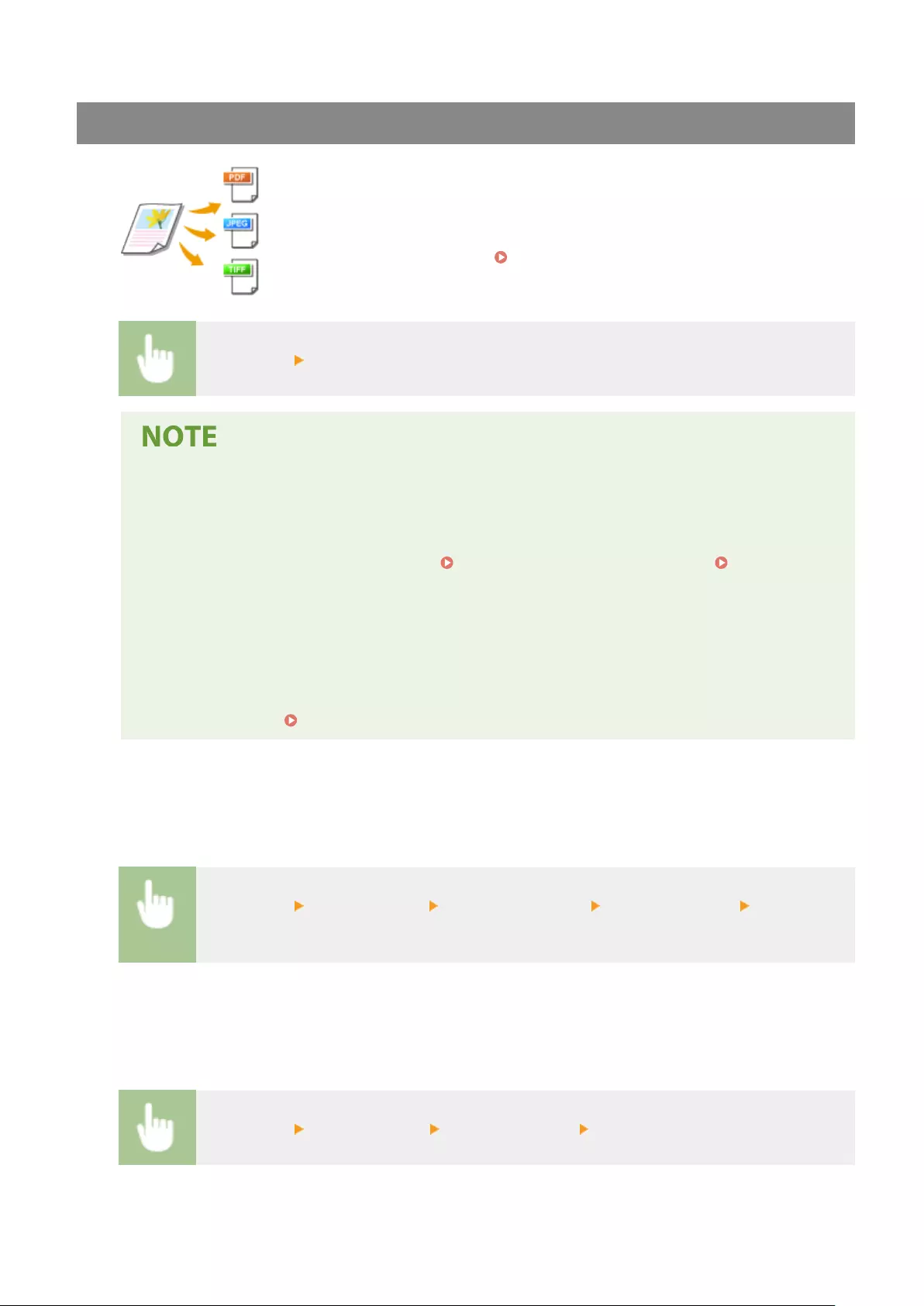
Selecting a File Format
You can select the le format to which originals are scanned from PDF/JPEG/TIFF. For
PDF, you can select Compact PDF that reduces the data size or the PDF format that
enables a text search by including text data scanned with OCR (optical character
recognition). You can also create a PDF le with enhanced security by encrypting
data or adding the signature. Enhancing the Security of Electronic Files(P. 311)
<File Format> Select a le format
●If you select JPEG in <File Format> and try to scan an original from the platen glass, you can only scan
one page. To scan a multiple-page original all at once, use the feeder. Each page of the original is
saved as a separate le. If you select TIFF or PDF, you can scan multiple-page originals either from the
platen glass or from the feeder. In this case, whether the original is to be saved as a single le or each
page as a separate le can be specied in Dividing a PDF File by Page(P. 289) or Dividing a TIFF
File by Page(P. 289) .
●<PDF (Compact)> and <PDF (Compact/OCR)> compress photos and illustrations on originals more
than <PDF> and <PDF (OCR)>. The le will be smaller, but the image quality of some originals or the
number of originals that can be scanned at once may be lower.
●In <PDF (Compact/OCR)> and <PDF (OCR)> you can congure the settings so that the machine
automatically detects the original direction during scanning based on the direction of the text read by
the OCR function. <OCR (Text Searchable) Settings>(P. 505)
◼Dividing a PDF File by Page
Specify whether to convert the original with multiple pages into a single PDF le or create a separate PDF le for
each page. This setting can be congured for each PDF format.
<File Format> <Set PDF Details> Select the PDF format <Divide into Pages> Select <Off> or
<On>
◼Dividing a TIFF File by Page
Specify whether to convert the original with multiple pages into a single TIFF le or create a separate TIFF le
for each page.
<File Format> <Set TIFF Details> <Divide into Pages> Select <Off> or <On>
Scanning
289
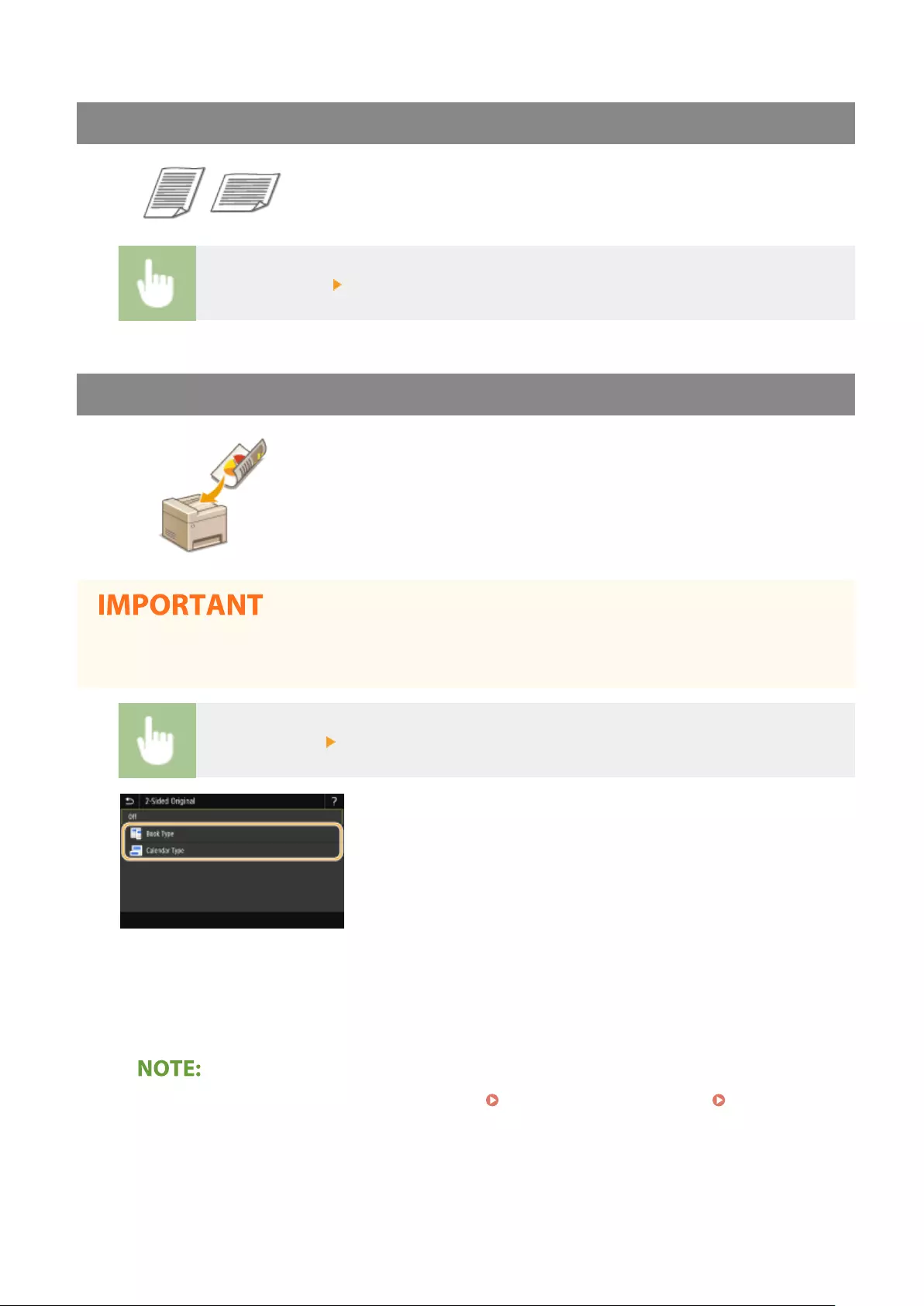
Specifying Orientation of Your Original
You can specify portrait or landscape orientation.
<Orig. Orientation> Select the original orientation
Scanning 2-Sided Originals
The machine can automatically scan the front and back sides of originals in the
feeder.
●The machine cannot scan both sides of originals automatically when the originals are placed on the platen
glass.
<2-Sided Original> Select <Book Type> or <Calendar Type>
<Book Type>
Select for originals whose images on the front and back sides face the same direction.
<Calendar Type>
Select for originals whose images on the front and back sides face in opposite directions.
●For information about other scan settings, see Scanning Clearly(P. 305) or Adjusting Balance
between File Size and Image Quality (Data Size)(P. 314) .
5Select <Start>.
➠Scanning of the original starts.
Scanning
290
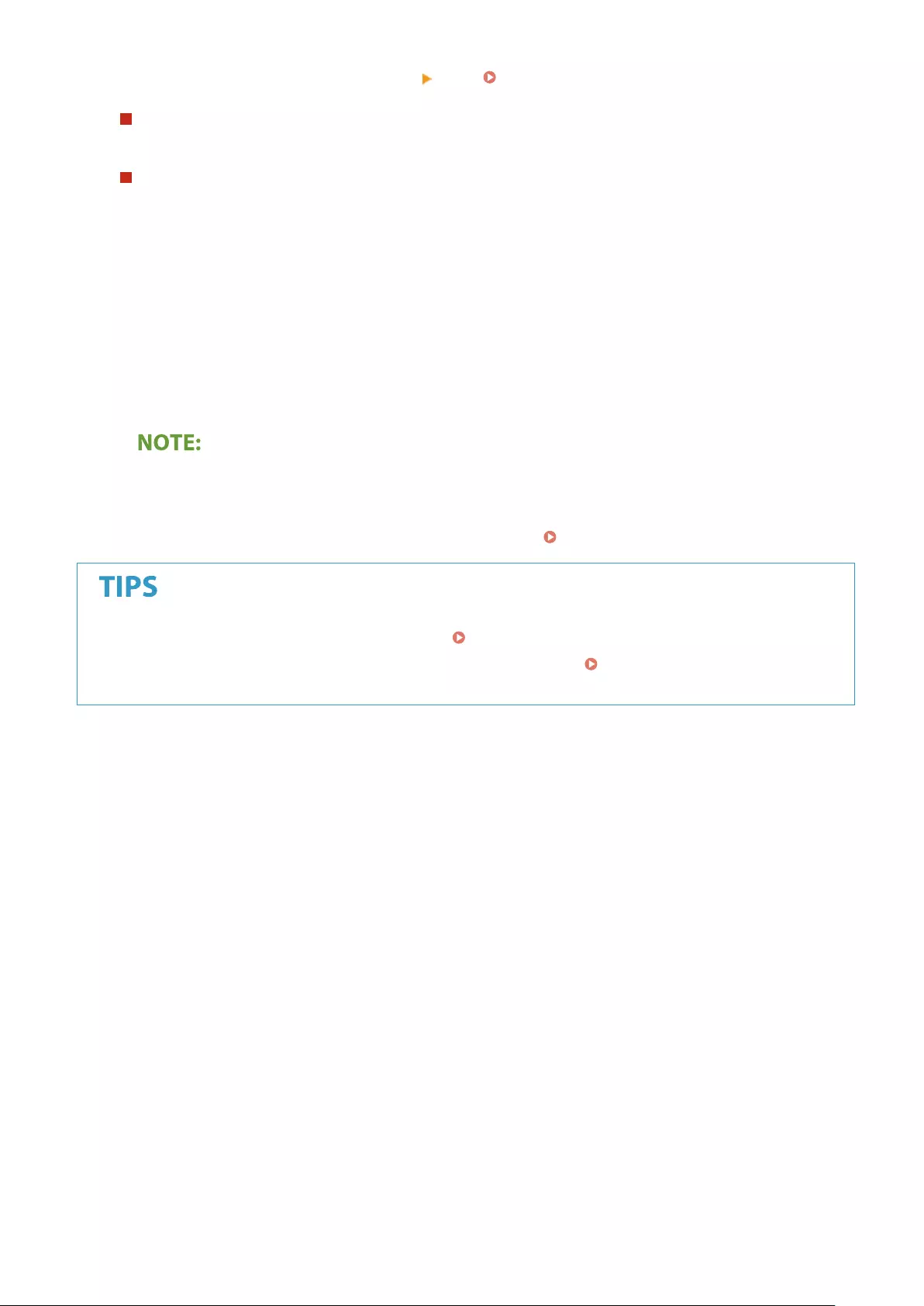
●If you want to cancel, select <Cancel> <Yes>. Canceling Sending Documents(P. 302)
When placing originals in the feeder in step 1
When scanning is complete, the saving process starts.
When placing originals on the platen glass in step 1
When scanning is complete, follow the procedure below (except if you selected JPEG as a le format).
1If there are additional pages of originals to be scanned, place the next original on the platen glass, and
select <Scan Next>.
●Repeat this step until you nish scanning all of the pages.
●When there is only one page to be scanned, proceed to the next step.
2Select <Finish>.
➠The saving process starts.
●A new folder is created on the USB memory device, and the scanned document is stored in that folder. The
le name of a scanned document is automatically assigned based on the following format: the characters
SCAN followed by a four-digit number.le extension name. The character string "SCAN" in the le name
can be replaced with a different arbitrary character string ( Conguring a File Name(P. 315) ).
●If you always want to scan with the same settings: Changing the Default Settings for Functions(P. 174)
●If you want to register a combination of settings to use when needed: Registering Frequently Used
Settings(P. 172)
Scanning
291
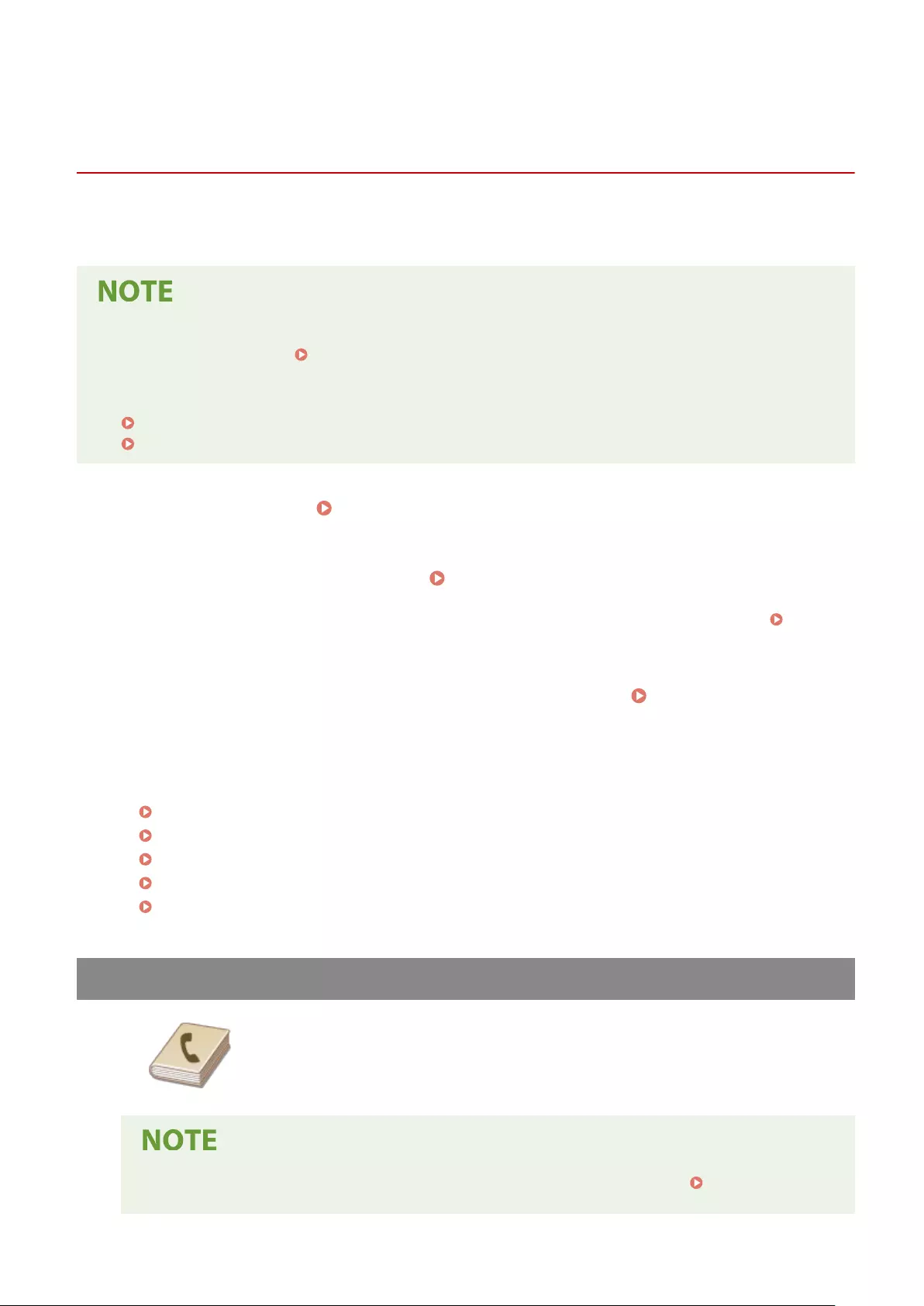
Sending Data by E-Mail/Saving Data to a Shared Folder
or FTP Server
6FR5-05R
This section describes the procedures for scanning originals and sending the scanned data directly from the machine
by attaching it to an e-mail or saving it to a shared folder or FTP server.
●Before you can send the data directly by e-mail, you need to complete certain procedures, such as specifying
the e-mail server settings. Procedure for Setting to Send E-Mail/Send and Receive I-Fax(P. 85)
●Before you can save the data to a shared folder or FTP server, you need to complete certain procedures,
such as specifying the location to save the scanned originals to.
Procedure for Setting a Shared Folder as a Save Location(P. 93)
Procedure for Setting a FTP Server as a Save Location(P. 97)
1Place the original(s). Placing Originals(P. 137)
2Select <Scan> in the Home screen. Home Screen(P. 124)
●If the login screen appears, specify the user name, the password, and the authentication server. Logging
in to Authorized Send(P. 135)
3Select <E-Mail> or <File> in the Scan Basic Features screen. Scan Basic Features
Screen(P. 282)
4Specify the destination.
Specifying from Address Book
Specifying from Coded Dial Numbers
Entering Destinations Directly (E-Mail Sending)
Specifying Destinations in an LDAP Server
Specifying from the Address Book on a Mobile Device (E-Mail Sending)
Specifying from Address Book
The Address Book enables you to specify a destination by selecting from a list of
registered destinations or by searching by name for destinations with recipient
names.
●You need to register destinations in the Address Book before using this feature. Registering
Destinations(P. 180)
Scanning
292
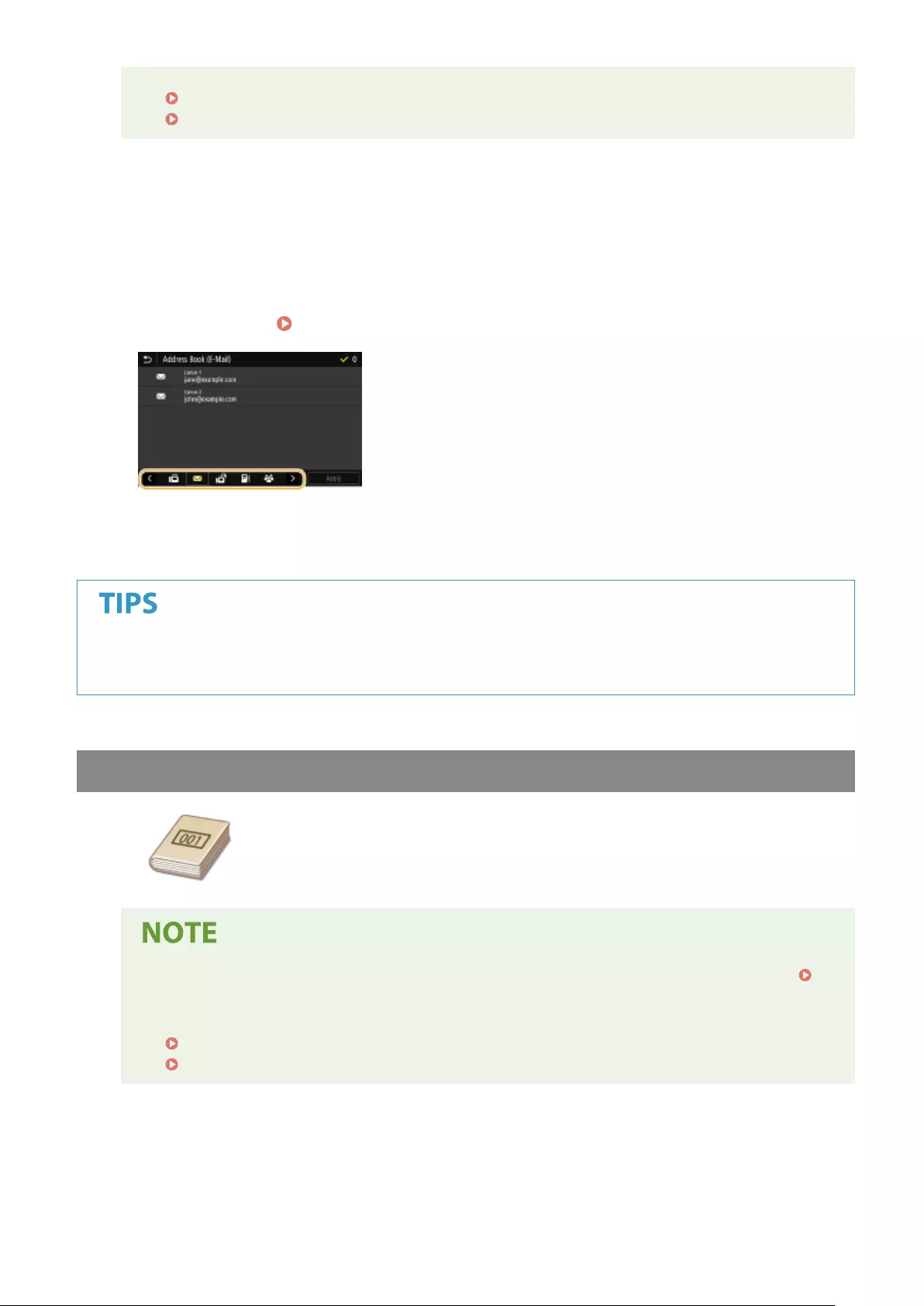
●Register the shared folder or FTP server address from a computer.
Setting a Shared Folder as a Save Location(P. 94)
Registering Destinations from Remote UI(P. 440)
1Select <Address Book> in the <Specify Destination> tab.
2Select <To>.
3Select an index. Index(P. 180)
4Select the check box for the desired destination, and select <Apply>.
●If a destination is selected from <Address Book> in the Home screen, the Basic Features screen for e-mail
sending or le saving can be displayed while the selected destination remains being specied.
Specifying from Coded Dial Numbers
Three-digit numbers (coded dial numbers) are assigned to addresses in the Address
Book. You can specify an address simply by entering its coded dial number.
●To use coded dial numbers, the destination must be registered in the Address Book beforehand.
Registering Destinations(P. 180)
●Register the shared folder or FTP server address from a computer.
Setting a Shared Folder as a Save Location(P. 94)
Registering Destinations from Remote UI(P. 440)
1Select <Coded Dial> in the <Specify Destination> tab.
2Select <To>.
Scanning
293
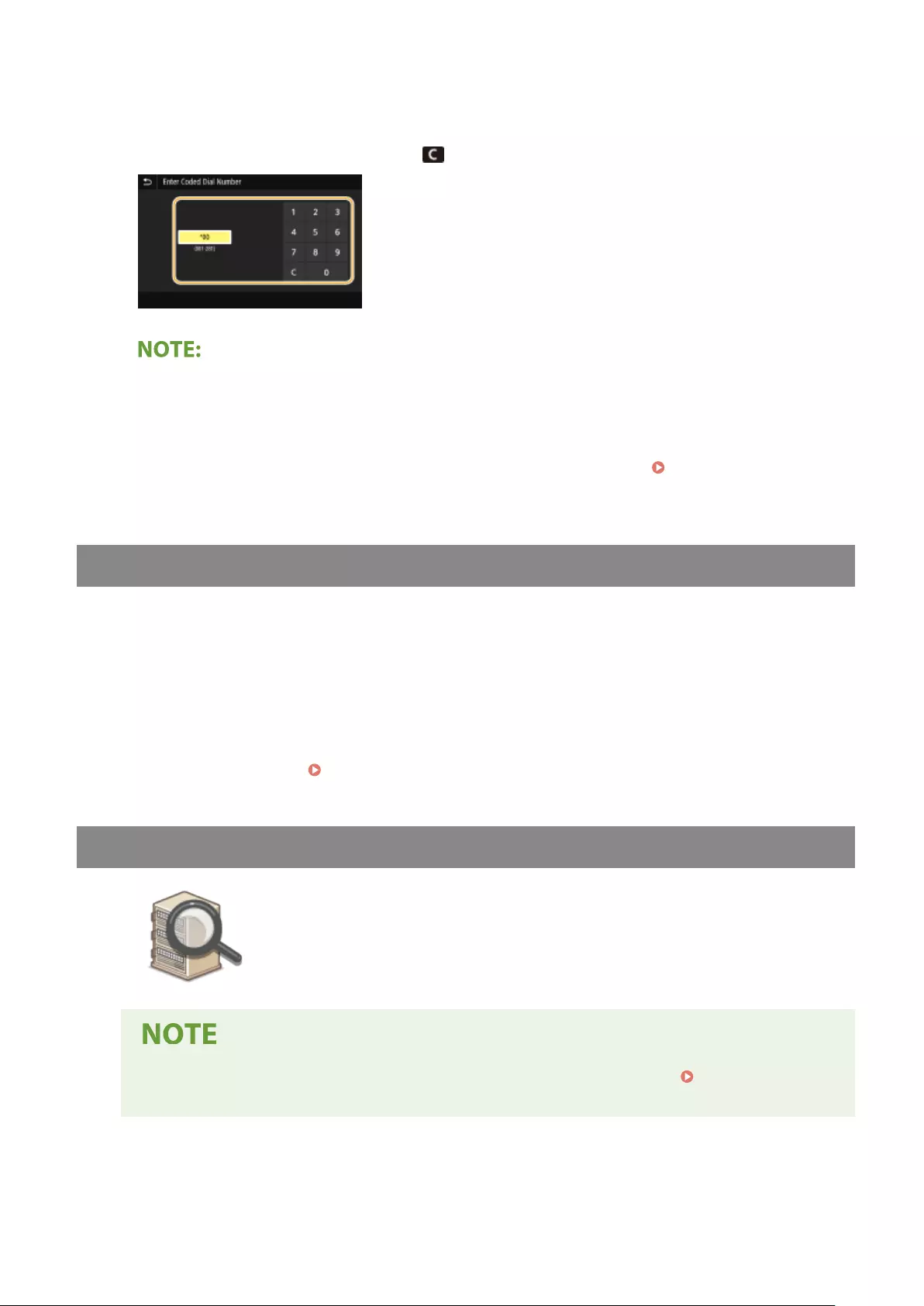
3Enter a three-digit number.
●If you have entered an incorrect value, use to clear it.
If a conrmation screen appears
●When <Conrm When Coded Dial TX> is set to <On>, a screen is displayed that shows the destination and
the name for the number. (For Group Dial, the destination name and the number of destinations are
shown.) Check the contents and if everything is correct, select <OK>. To specify a different destination,
select <Cancel> and then re-enter the three-digit coded dial number. Displaying Destinations in
Address Book(P. 416)
Entering Destinations Directly (E-Mail Sending)
For a destination that is not registered in the Address Book, specify it by entering an e-mail address.
1Select <Use Keyboard> in the <Specify Destination> tab.
2Enter the e-mail address, and select <Apply>.
●On how to enter text, see Entering Text(P. 133) .
Specifying Destinations in an LDAP Server
If your oce has an LDAP server installed, you can specify a destination using user
information in the server. Access the LDAP server via the machine to search for the
appropriate user information and specify it as destination.
●You need to specify the settings for connecting to an LDAP server beforehand. Registering LDAP
Servers(P. 64)
1Select <LDAP Server> in the <Specify Destination> tab.
Scanning
294
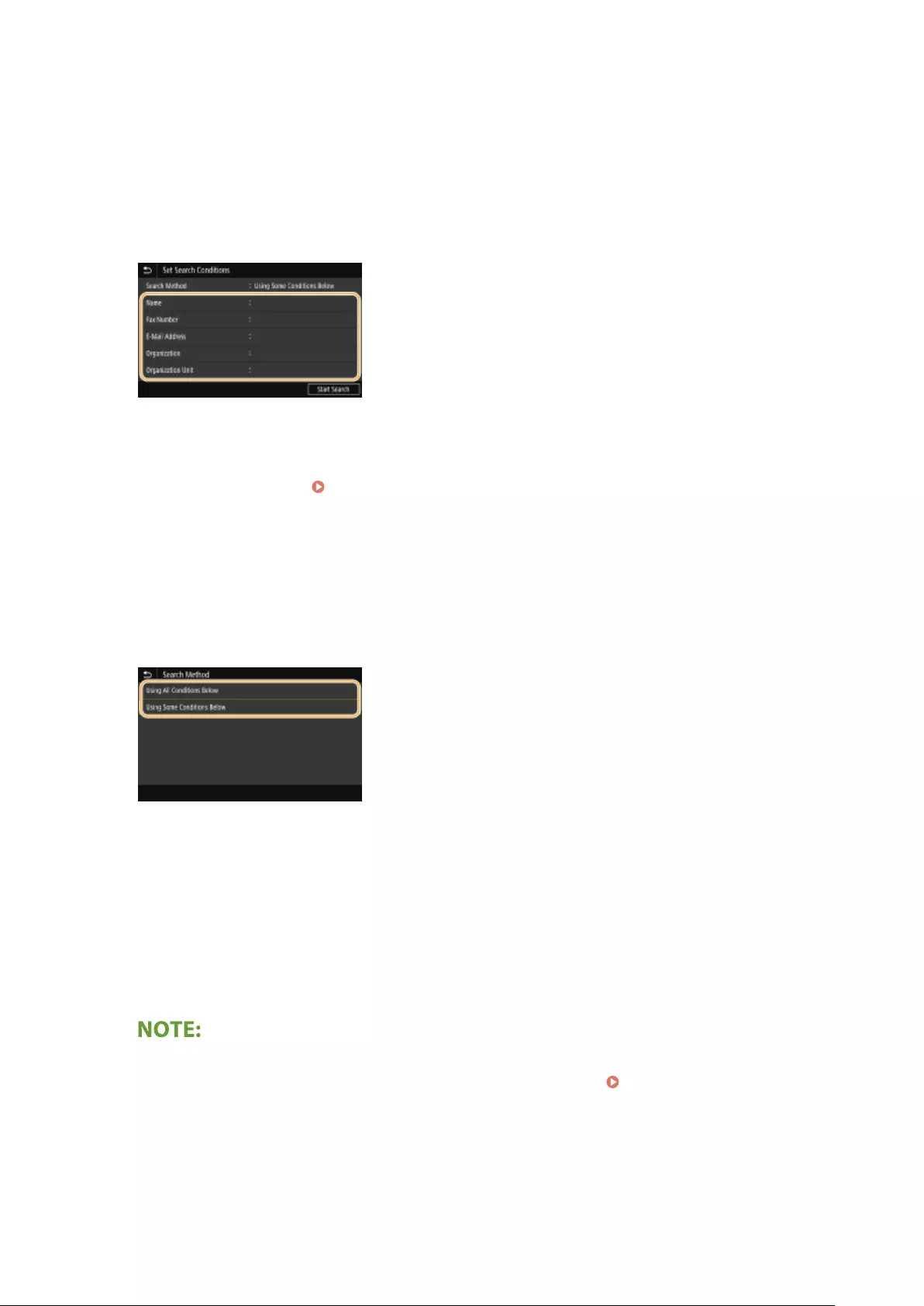
2Select the LDAP server you are using.
3Select conditions for user information to be searched.
●Name, fax numbers, e-mail addresses, organization names, and organization unit are available criteria for
searching destinations.
4Enter the search target character string, and select <Apply>.
●On how to enter text, see Entering Text(P. 133) .
●To specify multiple search criteria, repeat steps 3 and 4.
5Select <Search Method>.
6Select conditions to display the search result.
<Using All Conditions Below>
Searches and displays the users that meet all the search criteria specied in steps 3 and 4.
<Using Some Conditions Below>
If users that meet even one of the criteria specied in steps 3 and 4 are found, displays all those users.
7Select <Start Search>.
➠The users meeting your search criteria are displayed.
●If the authentication screen appears when you select <Start Search>, enter the user name of the machine
and the password registered in the LDAP server, and select <Apply>. Registering LDAP Servers(P. 64)
8Select the check box for the user that you want to specify as destination, and select
<Apply>.
Scanning
295
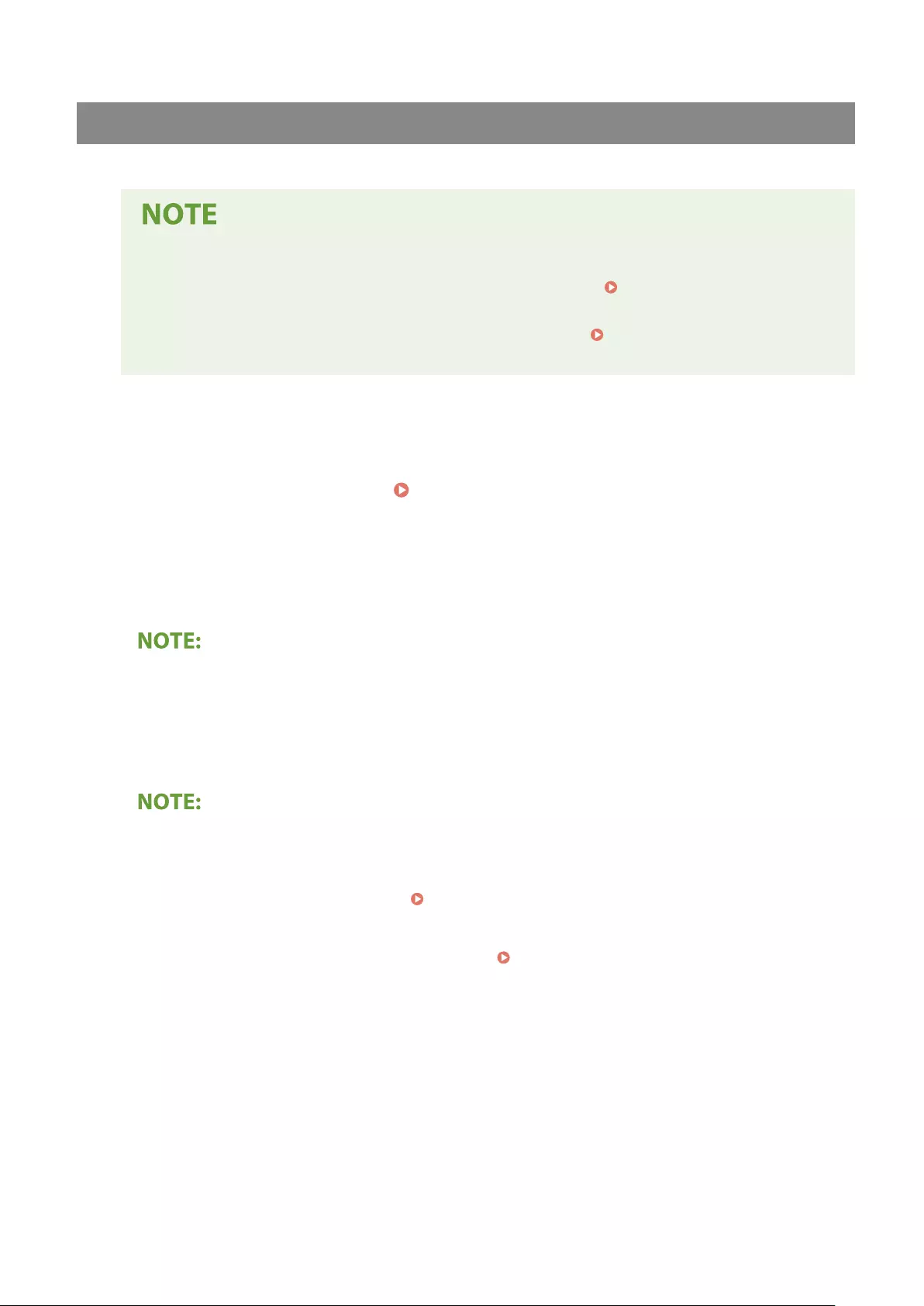
Specifying from the Address Book on a Mobile Device (E-Mail Sending)
You can specify destinations from the address book on your mobile device.
Before using this feature
●You need to install "Canon PRINT Business" on your mobile device. Utilizing the Machine through
Applications(P. 339)
●Set <Link Mobile Device Address Book> on the machine to <On>. <Link Mobile Device Addr.
Book>(P. 537)
1Select <Mobile Portal> in the <Specify Destination> tab.
2Connect to the mobile device. Connecting with Mobile Devices(P. 333)
3Send an address from the mobile device to the machine.
●On how to operate on the mobile device side, see "Canon PRINT Business Help."
●Information entered on the mobile device side such as subject, message and le name can also be sent to
the machine.
4When a message appears on the display of the machine, select <OK>.
If a screen on which a destination is already specied appears
●You can only send to destinations that are not restricted. To send to other destinations, you must
congure the send function authentication settings in such a way that transmission is not restricted.
Contact your administrator for details. LDAP Server Authentication(P. 373)
Specifying destinations from the transmission records
●You can also recall previously used destinations. Recalling Previously Used Settings for Sending/
Saving (Recall Settings)(P. 316)
Saving the data to a shared folder or FTP server
●Only one destination can be specied.
5When sending an e-mail, specify multiple destinations, including Cc/Bcc destinations,
as necessary.
●Select the method used to specify destinations in the <Specify Destination> tab, and then specify the
destination.
Scanning
296

●If you selected <LDAP Server> or <Specify Myself as Destination>, the destination is specied in the <To>
eld.
●<Cc> and <Bcc> addresses can only be selected using <Address Book> or <Coded Dial>.
To delete destinations
If you specied multiple destinations, you can delete destinations as necessary.
1Select <Conrm Destination>.
2Select the check box for the destination to be deleted, and select <Remove from Dest.>.
●If you select Group, select <Details> <Destination>; you can view the destinations registered in the
group.
3Select <Yes>.
6Specify the scanning settings as necessary.
Specifying the Scanning Size of the Original
Selecting a File Format
Specifying Orientation of Your Original
Scanning 2-Sided Originals
Specifying the Scanning Size of the Original
You can specify the scanning size of your original.
Select <Scan Size> in the <Send Settings> tab Select the original size
Scanning
297
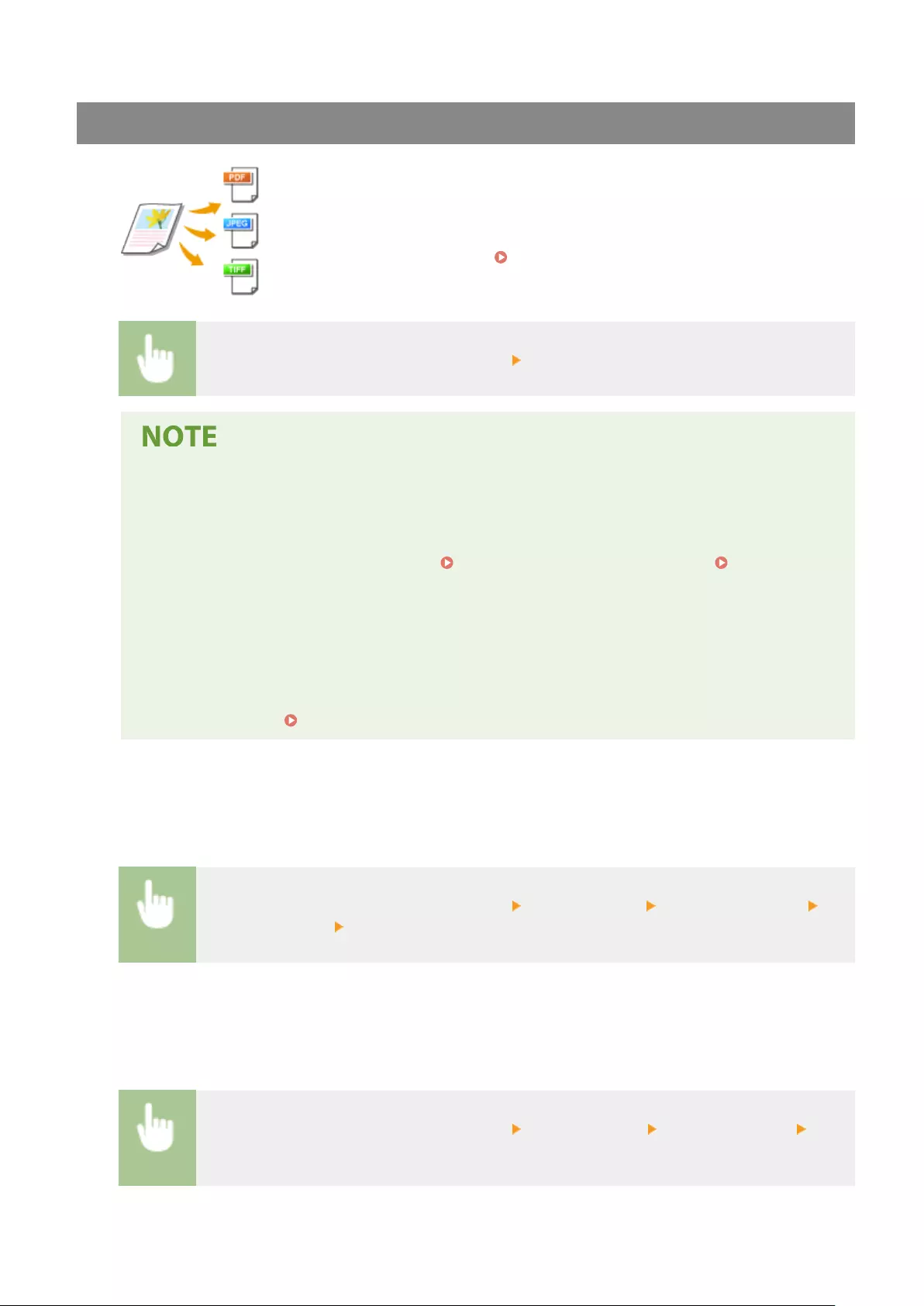
Selecting a File Format
You can select the le format to which originals are scanned from PDF/JPEG/TIFF. For
PDF, you can select Compact PDF that reduces the data size or the PDF format that
enables a text search by including text data scanned with OCR (optical character
recognition). You can also create a PDF le with enhanced security by encrypting
data or adding the signature. Enhancing the Security of Electronic Files(P. 311)
Select <File Format> in the <Send Settings> tab Select a le format
●If you select JPEG in <File Format> and try to scan an original from the platen glass, you can only scan
one page. To scan a multiple-page original all at once, use the feeder. Each page of the original is
saved as a separate le. If you select TIFF or PDF, you can scan multiple-page originals either from the
platen glass or from the feeder. In this case, whether the original is to be saved as a single le or each
page as a separate le can be specied in Dividing a PDF File by Page(P. 298) or Dividing a TIFF
File by Page(P. 298) .
●<PDF (Compact)> and <PDF (Compact/OCR)> compress photos and illustrations on originals more
than <PDF> and <PDF (OCR)>. The le will be smaller, but the image quality of some originals or the
number of originals that can be scanned at once may be lower.
●In <PDF (Compact/OCR)> and <PDF (OCR)> you can congure the settings so that the machine
automatically detects the original direction during scanning based on the direction of the text read by
the OCR function. <OCR (Text Searchable) Settings>(P. 505)
◼Dividing a PDF File by Page
Specify whether to convert the original with multiple pages into a single PDF le or create a separate PDF le for
each page. This setting can be congured for each PDF format.
Select <File Format> in the <Send Settings> tab <Set PDF Details> Select the PDF format
<Divide into Pages> Select <Off> or <On>
◼Dividing a TIFF File by Page
Specify whether to convert the original with multiple pages into a single TIFF le or create a separate TIFF le
for each page.
Select <File Format> in the <Send Settings> tab <Set TIFF Details> <Divide into Pages> Select
<Off> or <On>
Scanning
298
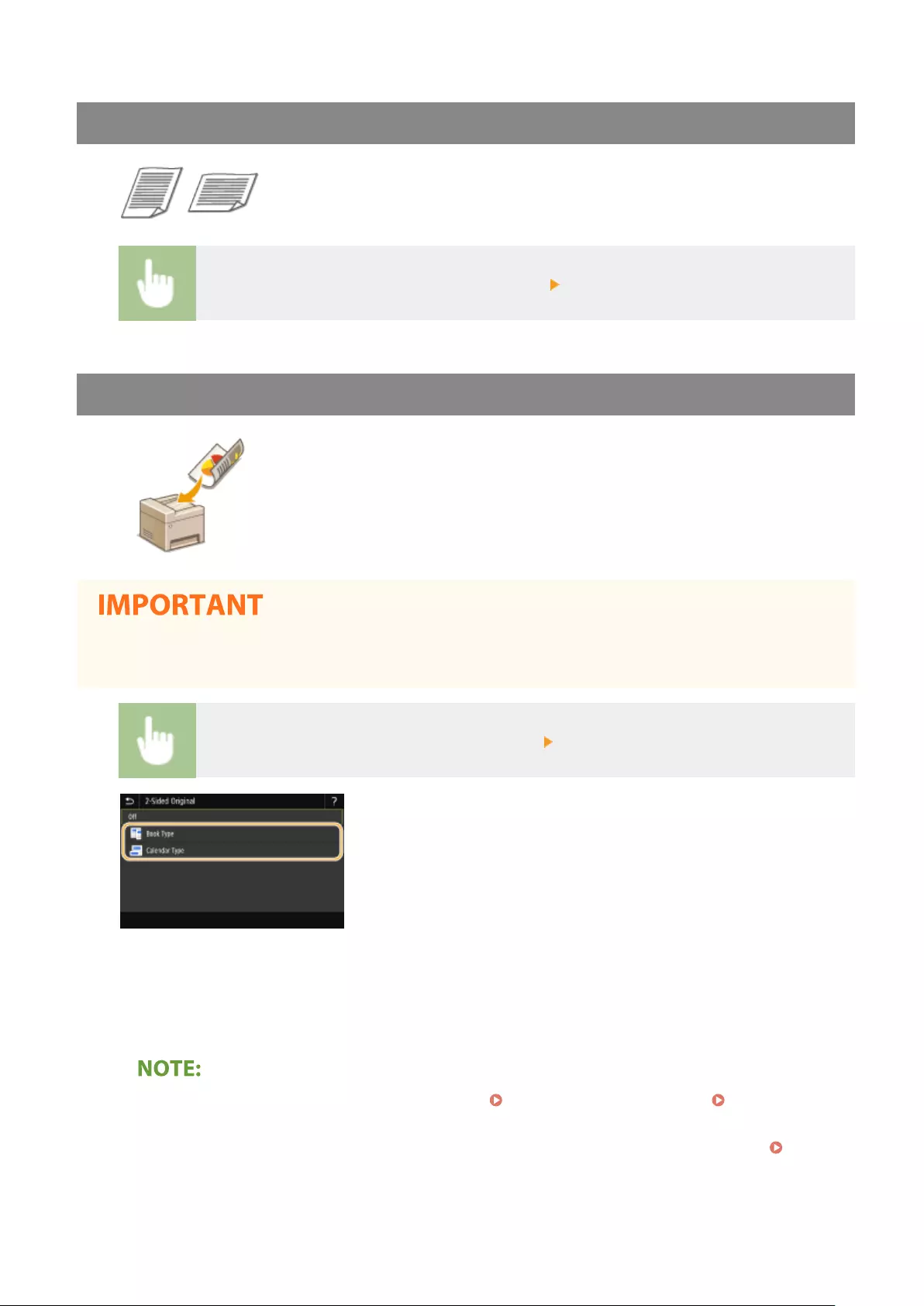
Specifying Orientation of Your Original
You can specify portrait or landscape orientation.
Select <Orig. Orientation> in the <Send Settings> tab Select the original orientation
Scanning 2-Sided Originals
The machine can automatically scan the front and back sides of originals in the
feeder.
●The machine cannot scan both sides of originals automatically when the originals are placed on the platen
glass.
Select <2-Sided Original> in the <Send Settings> tab Select <Book Type> or <Calendar Type>
<Book Type>
Select for originals whose images on the front and back sides face the same direction.
<Calendar Type>
Select for originals whose images on the front and back sides face in opposite directions.
●For information about other scan settings, see Scanning Clearly(P. 305) or Adjusting Balance
between File Size and Image Quality (Data Size)(P. 314) .
●For e-mail, you can specify the subject, message, reply-to address, and priority as necessary. Specifying
E-Mail Settings(P. 319)
Scanning
299
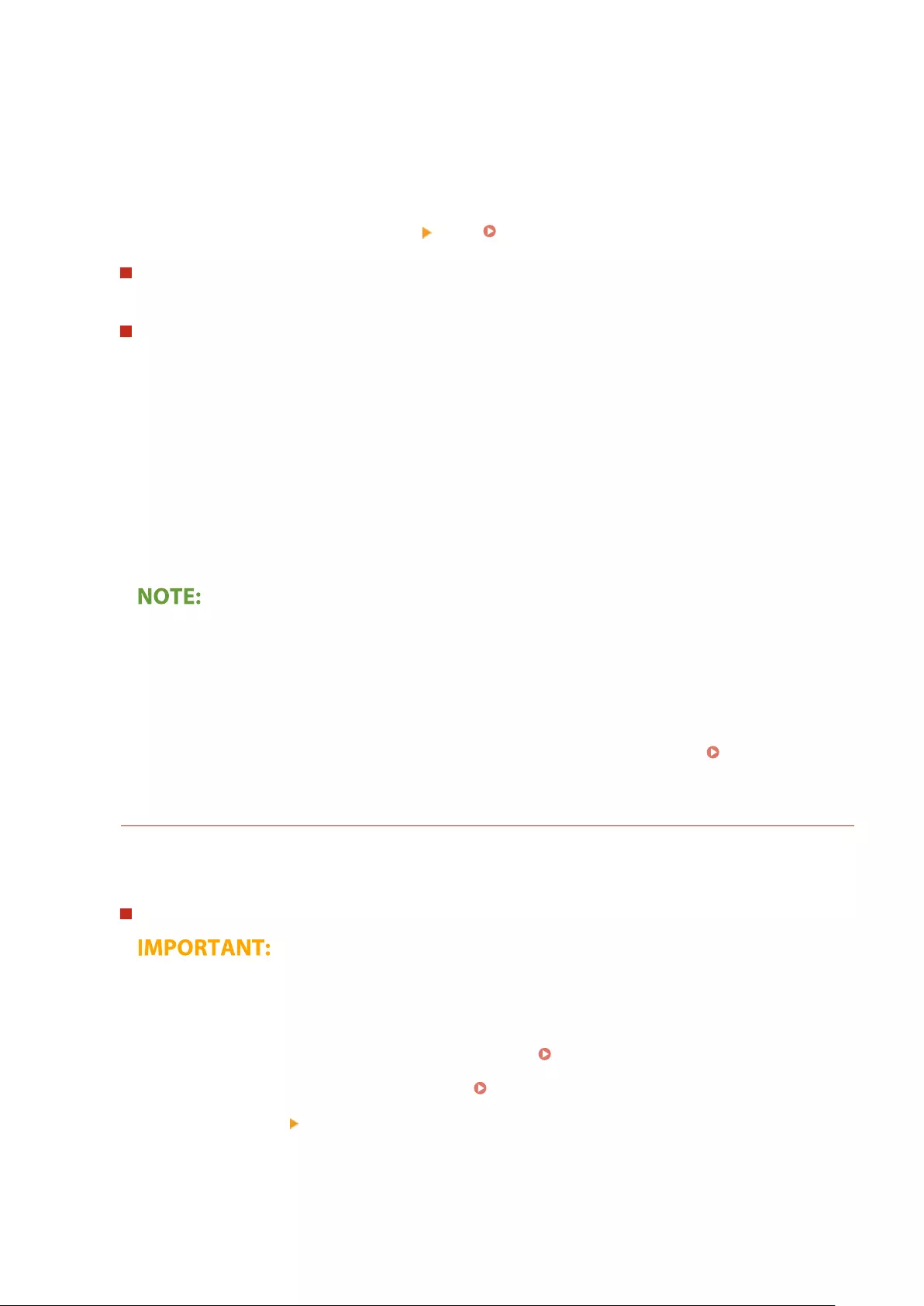
7Select <Start>.
●If the <Conrm Destination> screen is displayed, check whether the destination is correct, and then select
<Start Scanning>.
➠Scanning of the original starts.
●If you want to cancel, select <Cancel> <Yes>. Canceling Sending Documents(P. 302)
When placing originals in the feeder in step 1
When scanning is complete, the sending/saving process starts.
When placing originals on the platen glass in step 1
When scanning is complete, follow the procedure below (except if you selected JPEG as a le format).
1If there are additional pages of originals to be scanned, place the next original on the platen glass, and
select <Scan Next Original>.
●Repeat this step until you nish scanning all of the pages.
●When there is only one page to be scanned, proceed to the next step.
2Select <Start Sending>.
➠The sending/saving process starts.
If the <File Authentication> or <SMTP Authentication> screen appears
●Enter the user name and password, and select <Apply>.
File name of the sent document
●The le name of a sent document is automatically assigned based on the following format: communication
management number (four digits)_sent date and time_document number (three digits).le extension
name. An arbitrary character string can be added in front of le name ( Conguring a File
Name(P. 315) ).
If an E-Mail Send Error Occurs
Error notications are sometimes sent to the e-mail address set to the machine. If you leave it as-is, it may
result in an insucient remaining capacity of mailbox depending on your mail server. It is recommended that
you clear the mailbox periodically.
To clear the mailbox
●When the mailbox is cleared, all e-mail in the server mailbox is deleted. When you specify the e-mail
account that you use usually, you should rst check whether any e-mail in the mailbox needs to be kept.
1Start the Remote UI and log in to System Manager Mode. Starting Remote UI(P. 428)
2Click [Settings/Registration] on the Portal page. Remote UI Screen(P. 429)
3Select [TX Settings] [E-Mail/I-Fax Settings].
4Click [Clear] in [Clear Mail Box].
5Read the message that is displayed, and click [OK].
Scanning
300
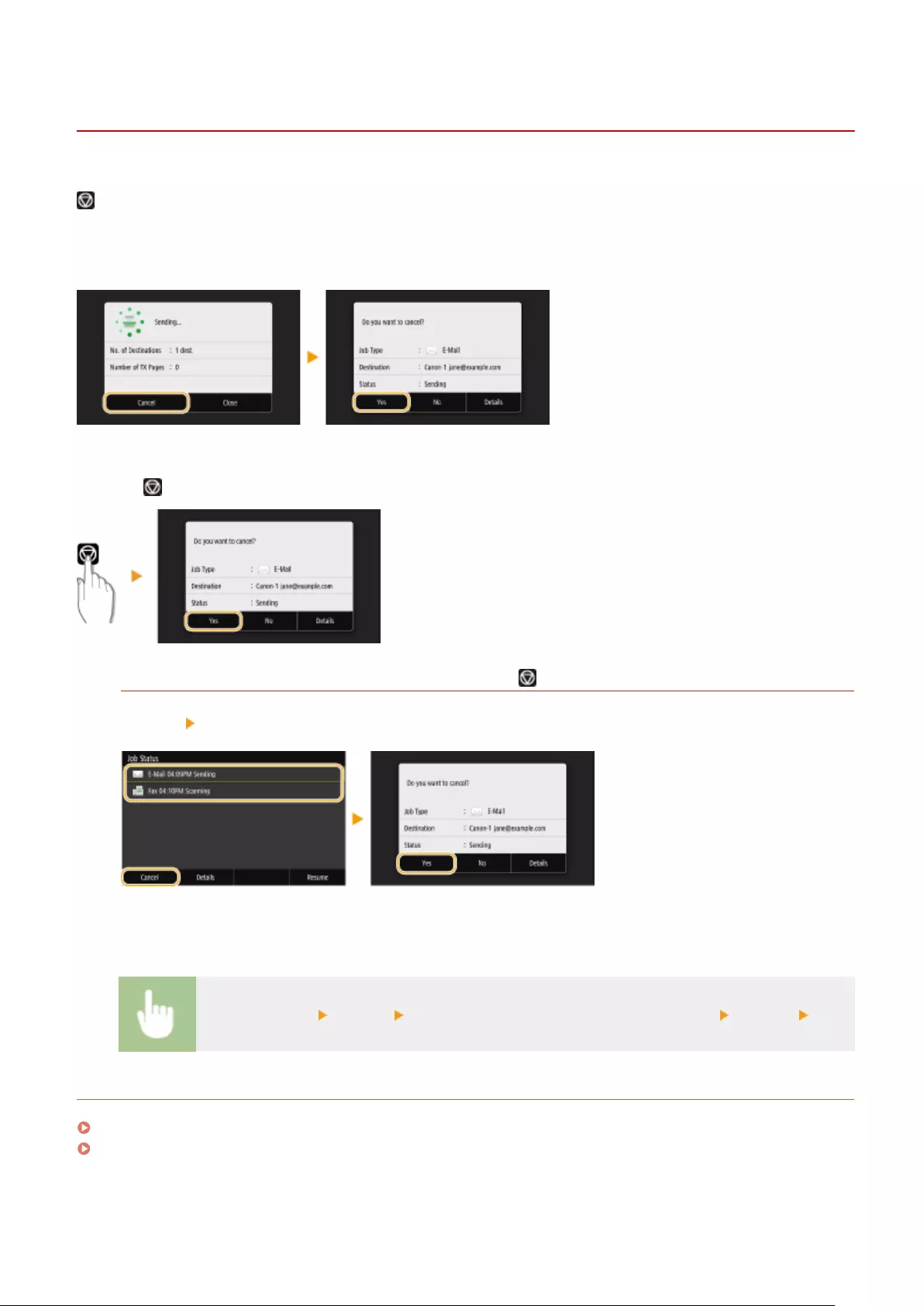
Canceling Sending Documents
6FR5-05S
If you want to cancel sending documents immediately after selecting <Start>, select <Cancel> on the display or press
. You can also cancel sending documents after checking the sending status.
◼Select <Cancel> to cancel
◼Press to cancel
If the screen displays a list of documents when is pressed
Originals have been scanned and are waiting to be processed. Select the document to cancel, and select
<Cancel> <Yes>.
◼Check the transmission status before canceling
<Status Monitor> <TX Job> Select the document in the <TX Job Status> tab <Cancel> <Yes>
LINKS
Basic Operations for Scanning Originals(P. 285)
Checking Status and Log for Scanned Originals(P. 303)
Scanning
302
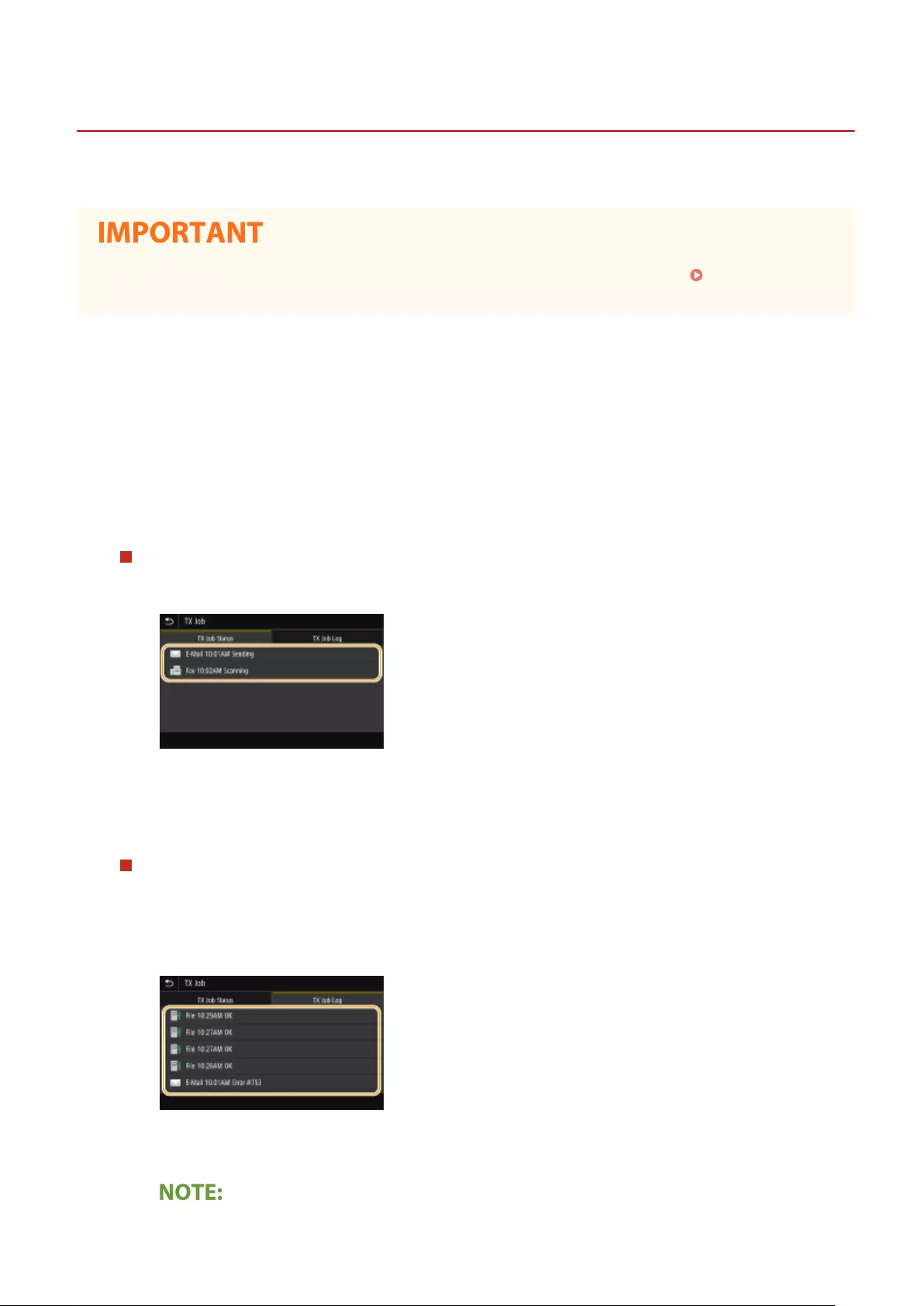
Checking Status and Log for Scanned Originals
6FR5-05U
You can check the status and log for scanned originals sent directly from the machine.
●When <Display Job Log> is set to <Off>, you cannot check the logs for sent documents. <Display Job
Log>(P. 565)
1Select <Status Monitor>.
2Select <TX Job>.
3Check the statuses and logs for sent documents.
To check the statuses for sent documents
1Select the document whose status you want to check in the <TX Job Status> tab.
➠Displays detailed information about the document.
●If you specied multiple destinations, the number of specied destinations is displayed on the
screen. To check the details of specied multiple destinations, select <Destination>.
To check the logs for sent documents
1Select the document whose log you want to check in the <TX Job Log> tab.
●<OK> is displayed when a document was sent successfully, and <Error> is displayed when a document
failed to be sent because it was canceled or there was some error.
➠Displays detailed information about the document.
When a three-digit number is shown in the case of <Error>
Scanning
303

●This number represents an error code. For more information, see "Troubleshooting (FAQ)" on the
online manual website.
Registering the destination of the sent document to the Address Book
●For a document sent to a destination not registered in the Address Book, you can register that
destination to the Address Book by selecting <Regst to Add Book> on the details screen.
LINKS
Basic Operations for Scanning Originals(P. 285)
Canceling Sending Documents(P. 302)
Printing Reports and Lists(P. 597)
Scanning
304
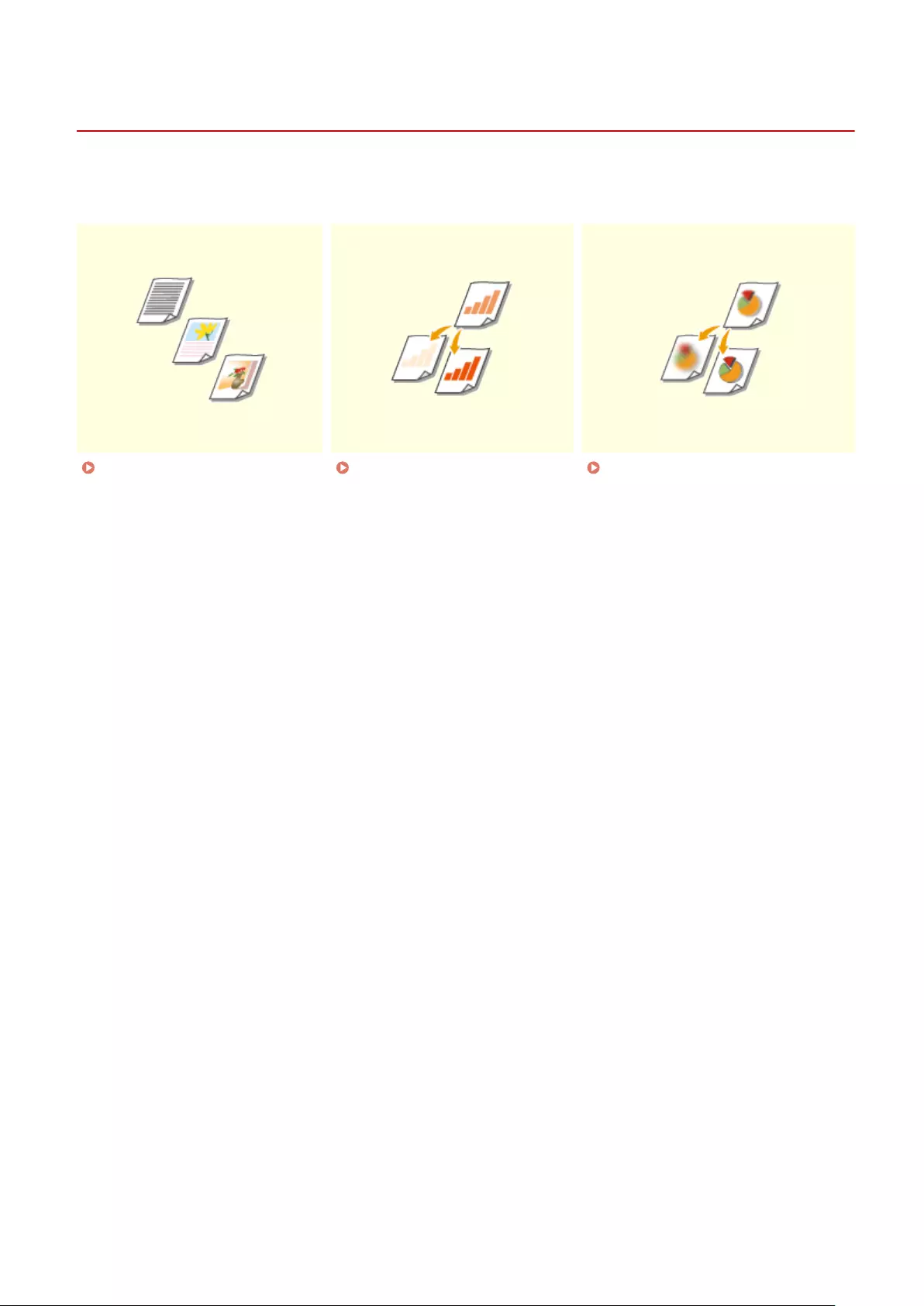
Scanning Clearly
6FR5-05W
When creating les for brochures that contain many pictures or reports written in pencil, you can adjust density and
brightness to achieve clearer image quality.
Adjusting Image Quality(P. 306) Adjusting Density(P. 307) Adjusting Sharpness When
Scanning (Sharpness)(P. 308)
Scanning
305
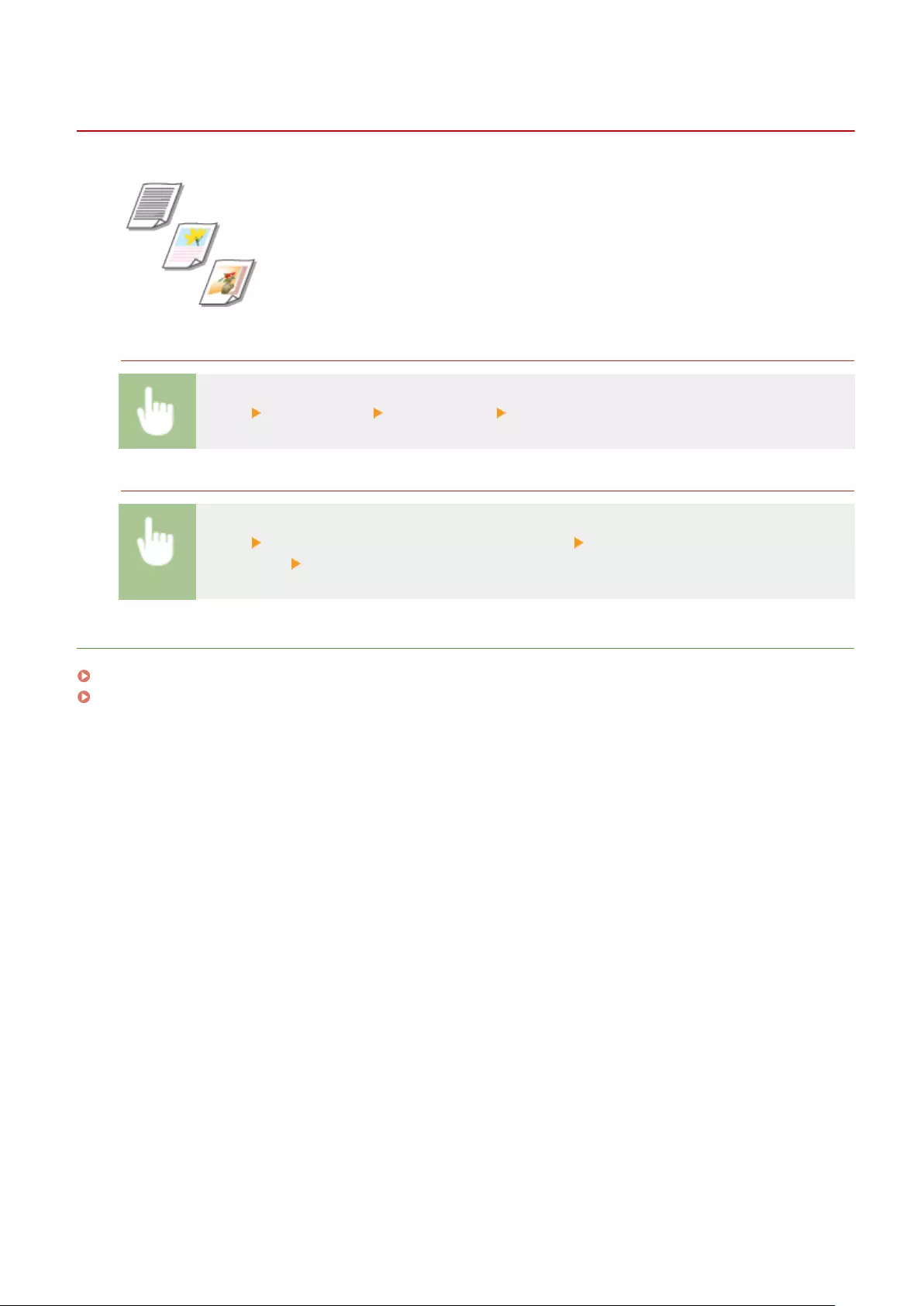
Adjusting Image Quality
6FR5-05X
You can select the image quality for the scan depending on the original type, such as
text-only originals, originals with charts and graphs, or magazine photos.
Saving Data to a USB Memory Device
<Scan> <USB Memory> <Original Type> Select the original type
Sending Data by E-Mail/I-Fax or Saving Data to the Server
<Scan> Specify destinations in <E-Mail>/<I-Fax>/<File> Select <Original Type> in the <Send
Settings> tab Select the original type
LINKS
Basic Operations for Scanning Originals(P. 285)
Sending I-Faxes(P. 250)
Scanning
306
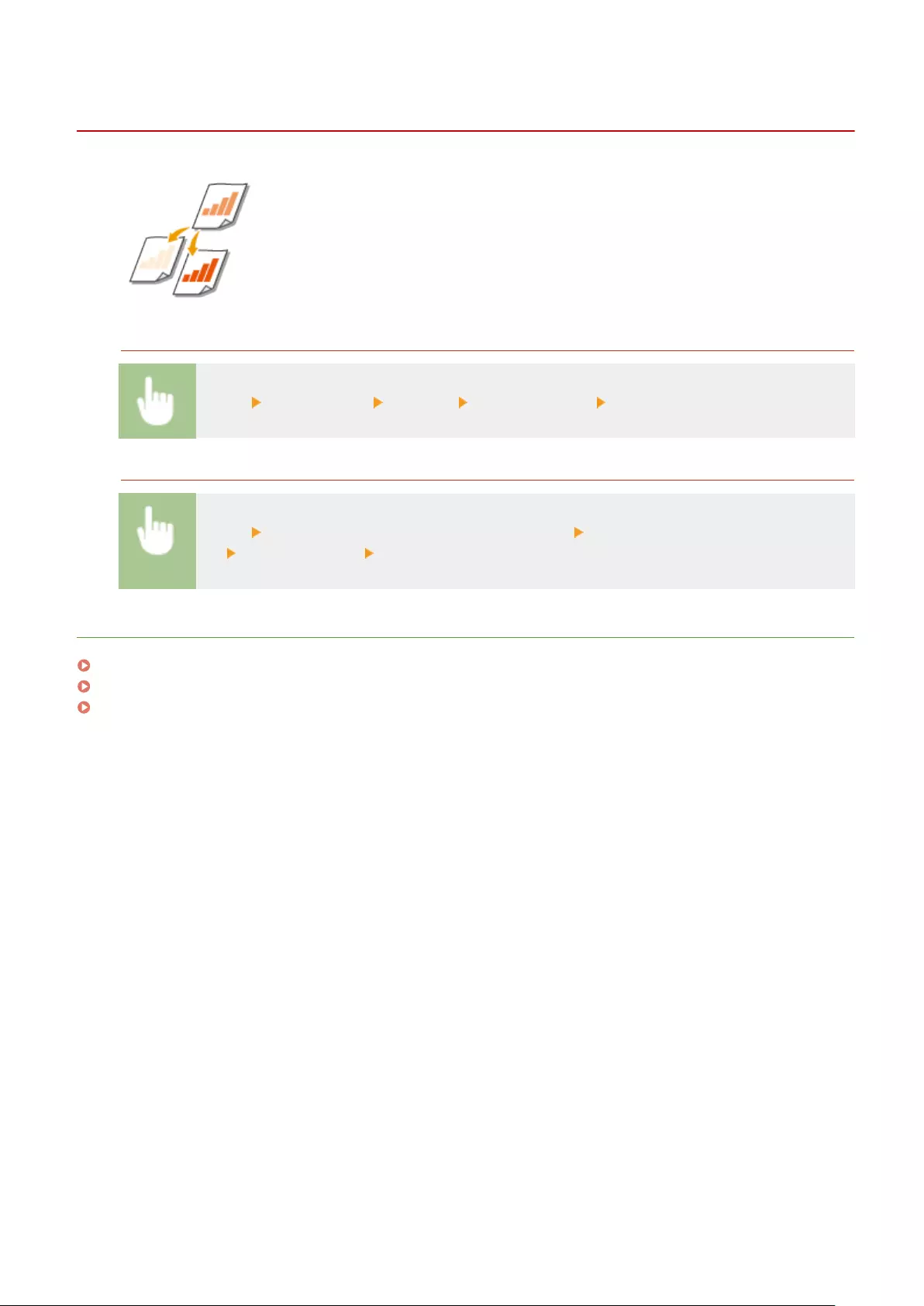
Adjusting Density
6FR5-05Y
You can adjust the density of the scan if the text or images in a original are too light
or dark.
Saving Data to a USB Memory Device
<Scan> <USB Memory> <Density> Adjust the density <Apply>
Sending Data by E-Mail/I-Fax or Saving Data to the Server
<Scan> Specify destinations in <E-Mail>/<I-Fax>/<File> Select <Density> in the <Send Settings>
tab Adjust the density <Apply>
LINKS
Basic Operations for Scanning Originals(P. 285)
Sending I-Faxes(P. 250)
Adjusting Sharpness When Scanning (Sharpness)(P. 308)
Scanning
307
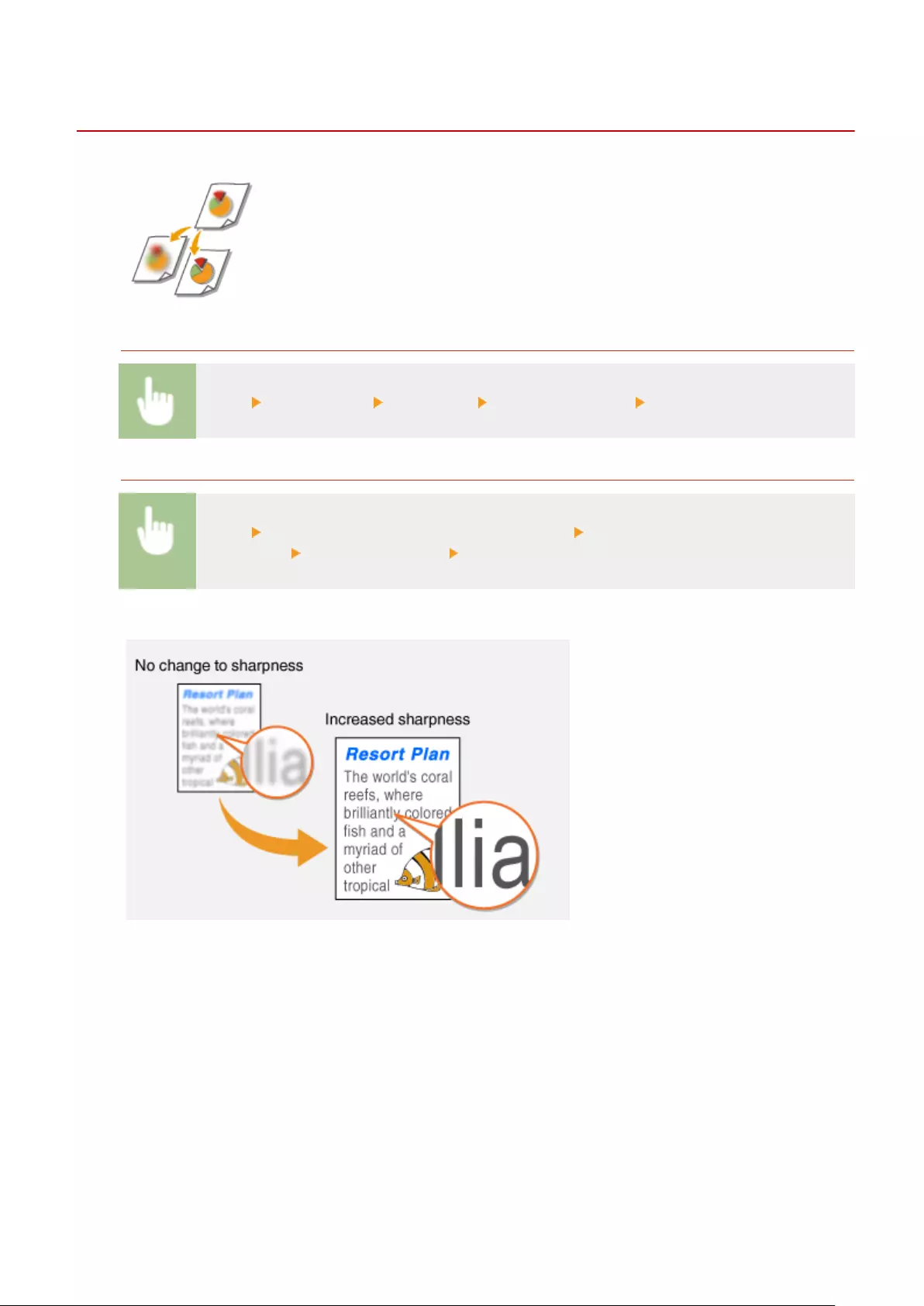
Adjusting Sharpness When Scanning (Sharpness)
6FR5-060
You can adjust the sharpness of the image. Increase the sharpness to sharpen
blurred text and lines, or decrease the sharpness to improve the appearance of
magazine photos.
Saving Data to a USB Memory Device
<Scan> <USB Memory> <Sharpness> Adjust the sharpness <Apply>
Sending Data by E-Mail/I-Fax or Saving Data to the Server
<Scan> Specify destinations in <E-Mail>/<I-Fax>/<File> Select <Sharpness> in the <Send
Settings> tab Adjust the sharpness <Apply>
Example: If you want to sharpen text and lines written in pencil
Example: If you want to improve the appearance of magazine photos
Scanning
308
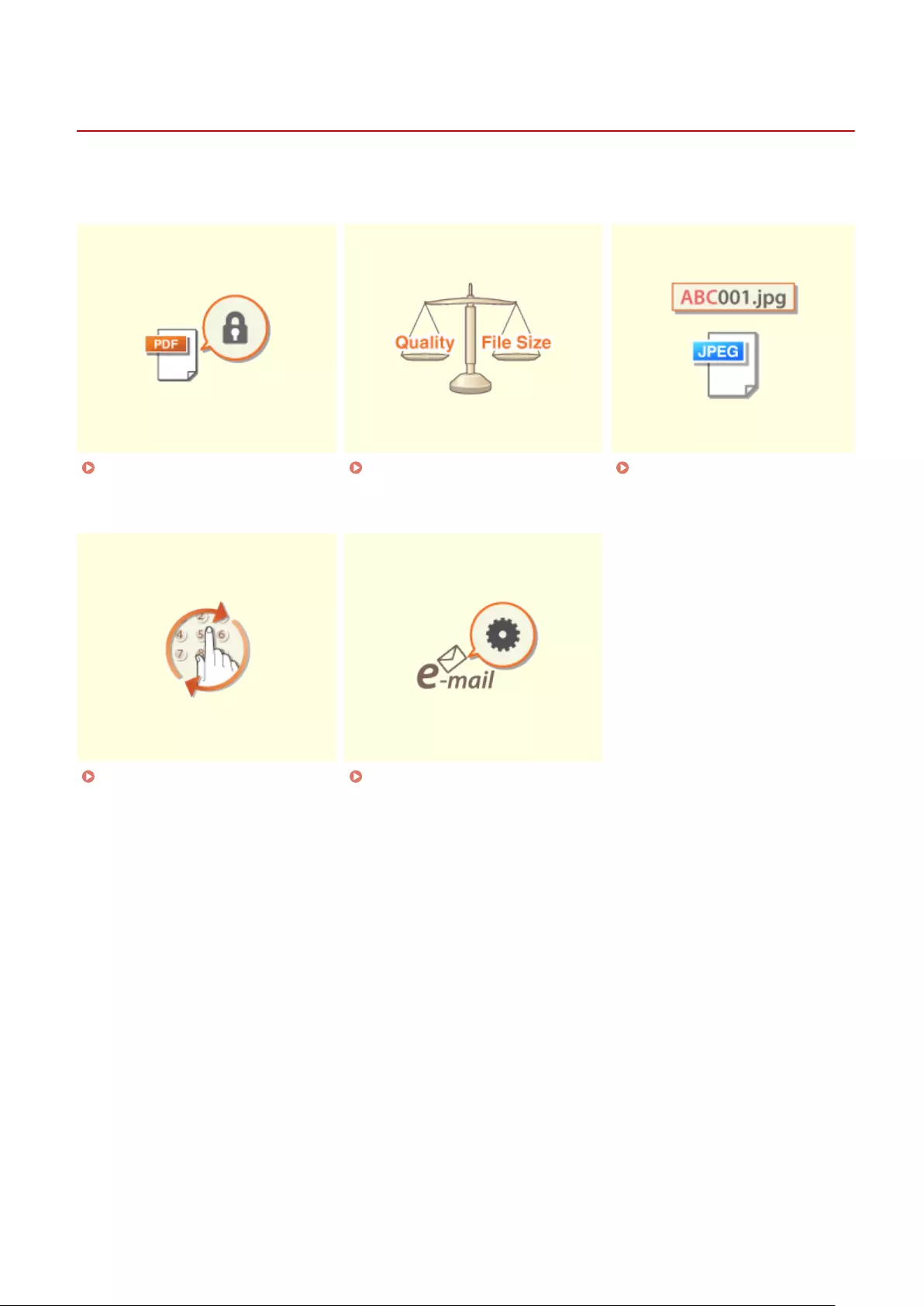
Useful Scanning Functions
6FR5-061
The machine is equipped with useful functions such as those that can create secure PDF les to prevent them from
being tampered with, and that can send data again to previously specied destinations.
Enhancing the Security of
Electronic Files(P. 311)
Adjusting Balance between File
Size and Image Quality (Data Size)
(P. 314)
Conguring a File Name(P. 315)
Recalling Previously Used
Settings for Sending/Saving (Recall
Settings)(P. 316)
Specifying E-Mail Settings(P. 319)
Scanning
310
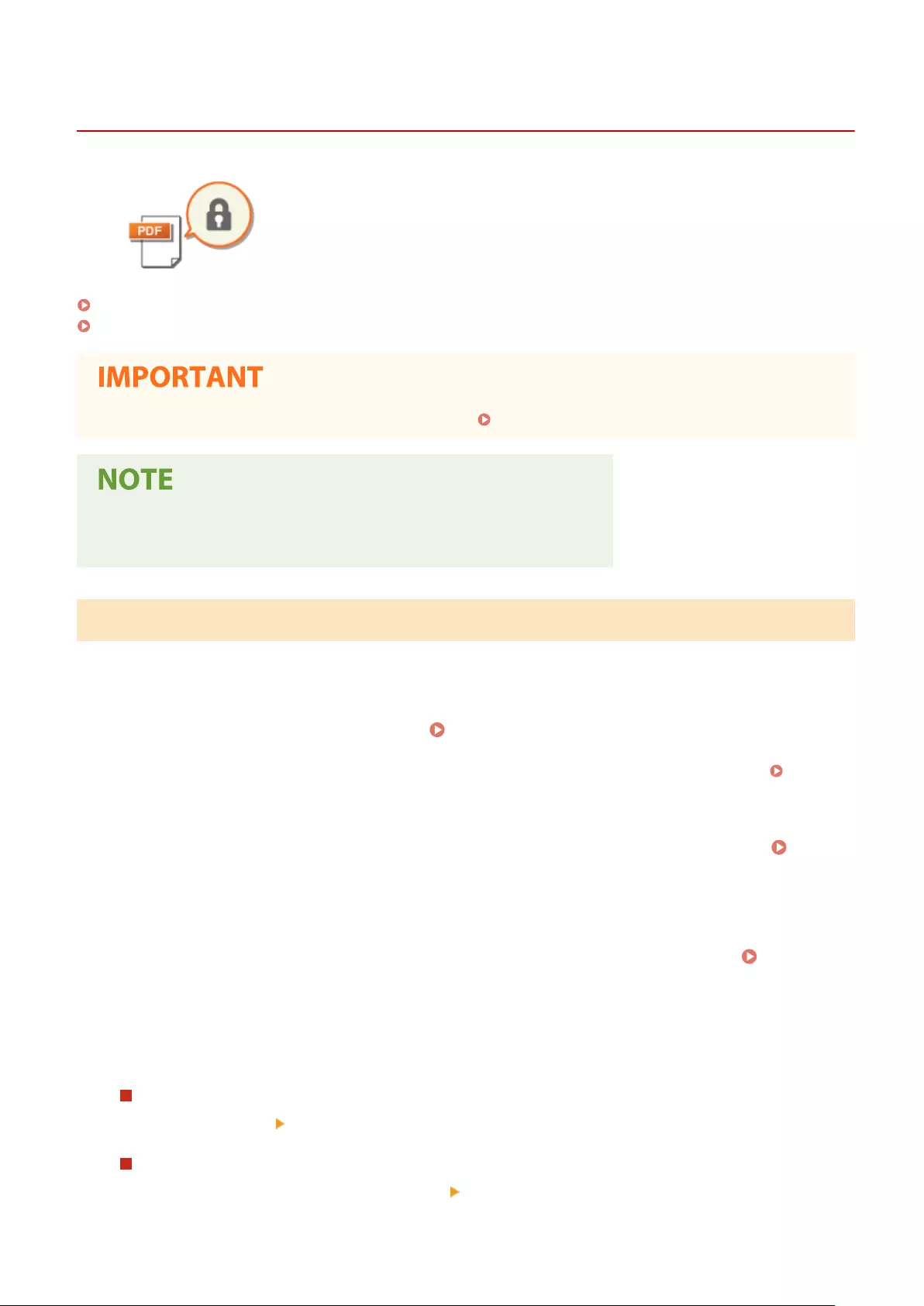
Enhancing the Security of Electronic Files
6FR5-062
Digital les are vulnerable in terms of security because they can be easily viewed or
tampered with leaving no trace. When scanning important documents, you can take
appropriate measures such as encrypting data and adding a device signature to
enhance security.
Encrypting a PDF File(P. 311)
Adding a Device Signature(P. 312)
●An optional Send PDF Security Feature Set is required. System Options(P. 641)
●Encryption and device signature are only available for PDF les.
●Both the encryption and device signature can be used at the same time.
Encrypting a PDF File
You can encrypt and send/save a PDF le by setting a password when scanning originals. The password setting helps
reduce the risk of the PDF le being viewed or edited by others.
1Select <Scan> in the Home screen. Home Screen(P. 124)
●If the login screen appears, specify the user name, the password, and the authentication server. Logging
in to Authorized Send(P. 135)
2Select <USB Memory>, <E-Mail>, or <File> in the Scan Basic Features screen. Scan
Basic Features Screen(P. 282)
●If you select <USB Memory>, proceed to step 4.
3Specify the destination, and specify the scanning settings as necessary. Basic
Operations for Scanning Originals(P. 285)
4Proceed to <Set PDF Details>.
Saving data to a USB memory device
●Select <File Format> <Set PDF Details>.
Sending e-mail/saving data to a shared folder or FTP server
●Select <File Format> in the <Send Settings> tab <Set PDF Details>.
Scanning
311
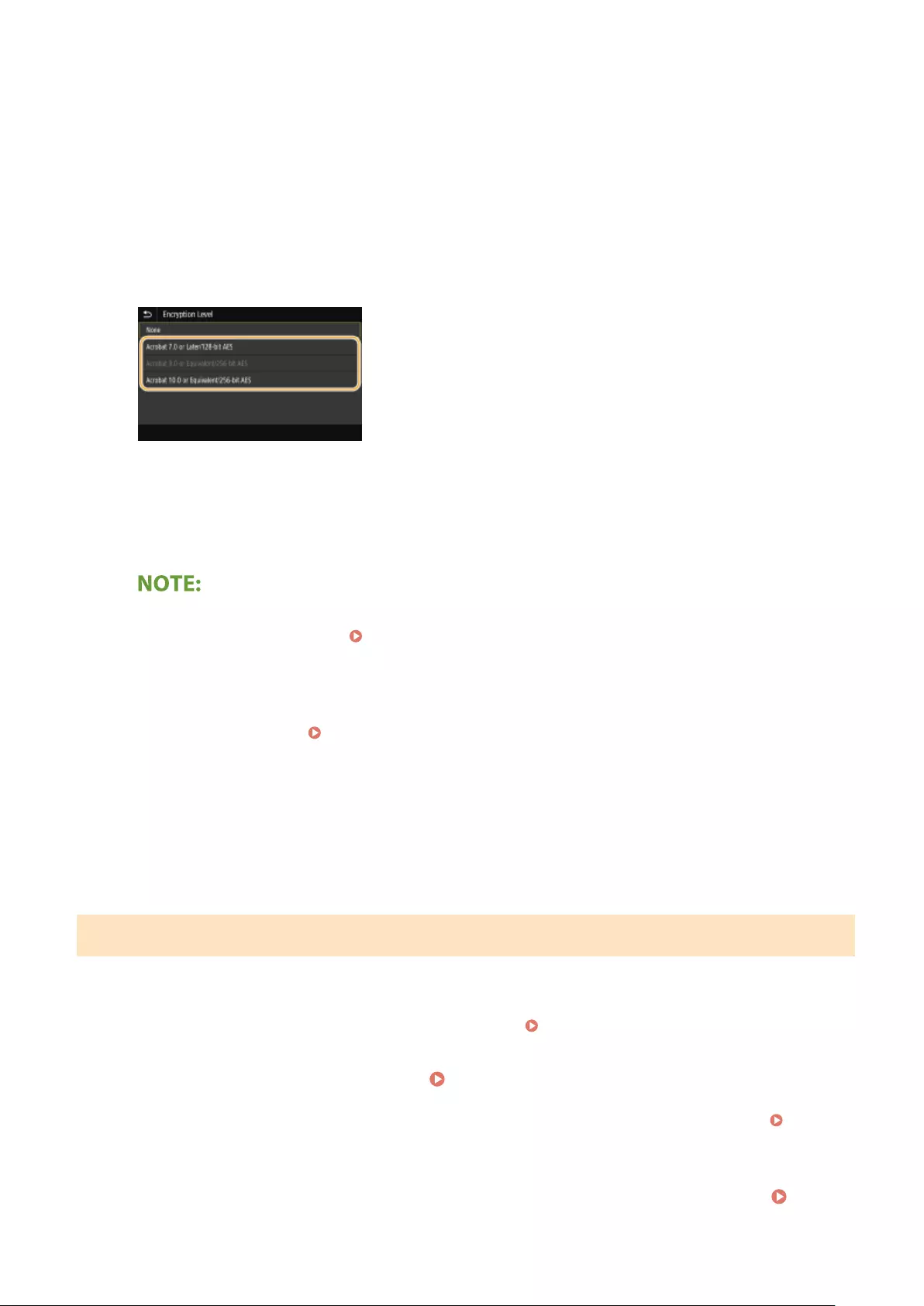
5Select the type of PDF format.
●You can specify whether to enable encryption for each PDF format.
6Select <Encryption>.
7Select the encryption level.
<Acrobat 7.0 or Later/128-bit AES>
Encrypt the le in the 128-bit environment, which can be opened by Adobe Acrobat 7.0 or later.
<Acrobat 10.0 or Equivalent/256-bit AES>
Encrypt the le in the 256-bit environment, which can be opened by Adobe Acrobat 10.0.
●<Acrobat 10.0 or Equivalent/256-bit AES> can be changed to <Acrobat 9.0 or Equivalent/256-bit AES> with a
different compatible version. <256-bit AES Set. (Encrypt. PDF)>(P. 505)
8Enter the encryption password, and select <Apply>.
●On how to enter text, see Entering Text(P. 133) .
9Enter the same password, and select <Apply>.
10 Select <Apply>.
Adding a Device Signature
Convert the scanned original into a PDF le with a device signature. The device signature serves the same purpose as
sealing or signing a document; it can be used to check where the le was created and whether the document has been
tampered with or falsied after the signature was appended. To assign the device signature to a PDF le, you need to
generate the key and certicate for the device signature in advance. Generating a Device Signature Key(P. 426)
1Select <Scan> in the Home screen. Home Screen(P. 124)
●If the login screen appears, specify the user name, the password, and the authentication server. Logging
in to Authorized Send(P. 135)
2Select <USB Memory>, <E-Mail>, or <File> in the Scan Basic Features screen. Scan
Basic Features Screen(P. 282)
Scanning
312

●If you select <USB Memory>, proceed to step 4.
3Specify the destination, and specify the scanning settings as necessary. Basic
Operations for Scanning Originals(P. 285)
4Proceed to <Set PDF Details>.
Saving data to a USB memory device
●Select <File Format> <Set PDF Details>.
Sending e-mail/saving data to a shared folder or FTP server
●Select <File Format> in the <Send Settings> tab <Set PDF Details>.
5Select the type of PDF format.
●You can specify whether to enable encryption for each PDF format.
6Select <Digital Signatures>.
7Select <Top Left>.
8Select <Apply>.
Scanning
313
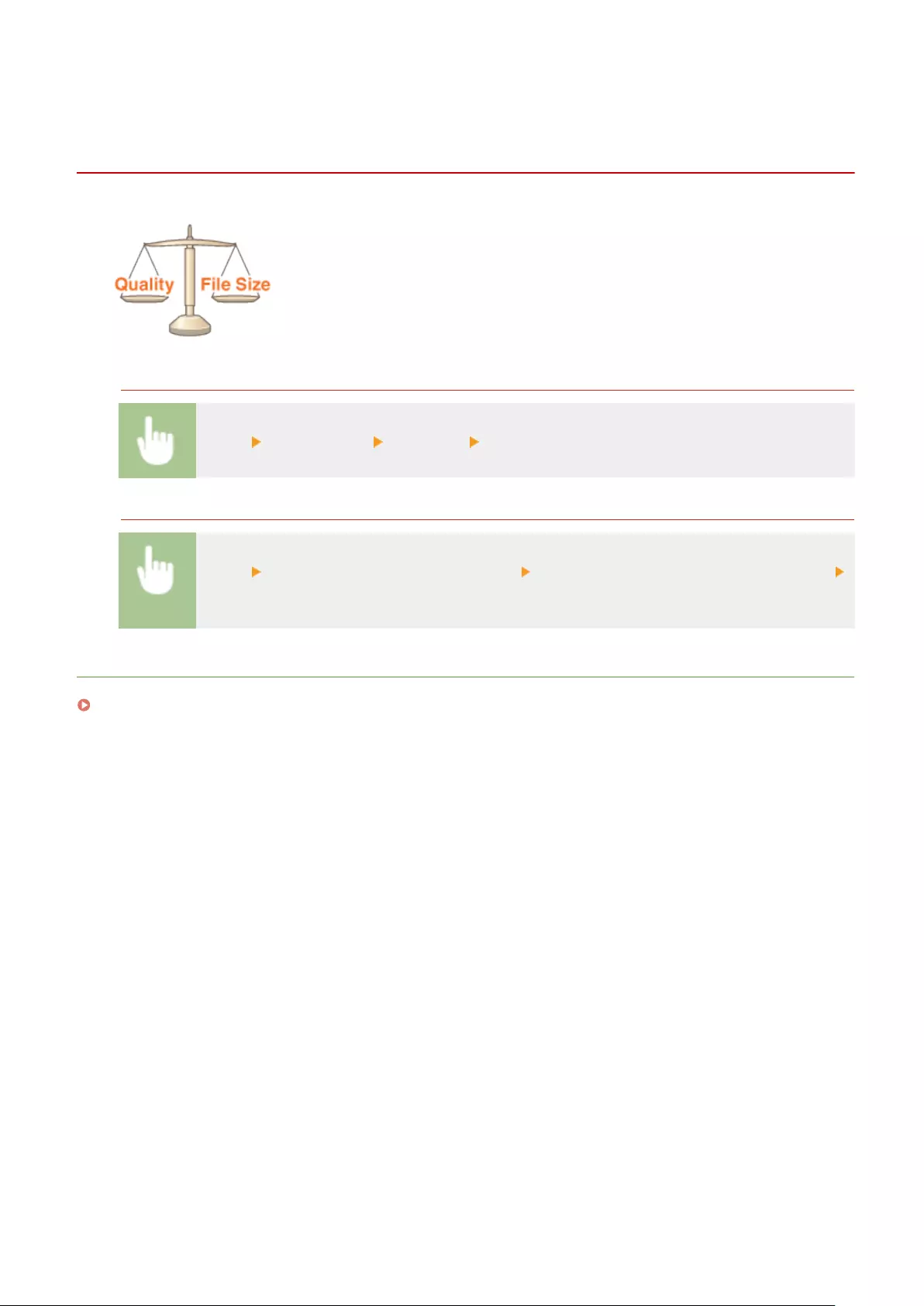
Adjusting Balance between File Size and Image Quality
(Data Size)
6FR5-063
You can specify the le compression ratio when converting scanned originals into
the JPEG format. <Small: Memory Priority> makes the compression ratio higher than
normal to create smaller les with lower image quality. On the other hand, <Large:
Image Quality Priority> makes the compression ratio lower than normal larger les
with higher image quality.
Saving Data to a USB Memory Device
<Scan> <USB Memory> <Data Size> Specify the setting
Sending Data by E-Mail or Saving Data to the Server
<Scan> Specify destinations in <E-Mail>/<File> Select <Data Size> in the <Send Settings> tab
Specify the setting
LINKS
Basic Operations for Scanning Originals(P. 285)
Scanning
314
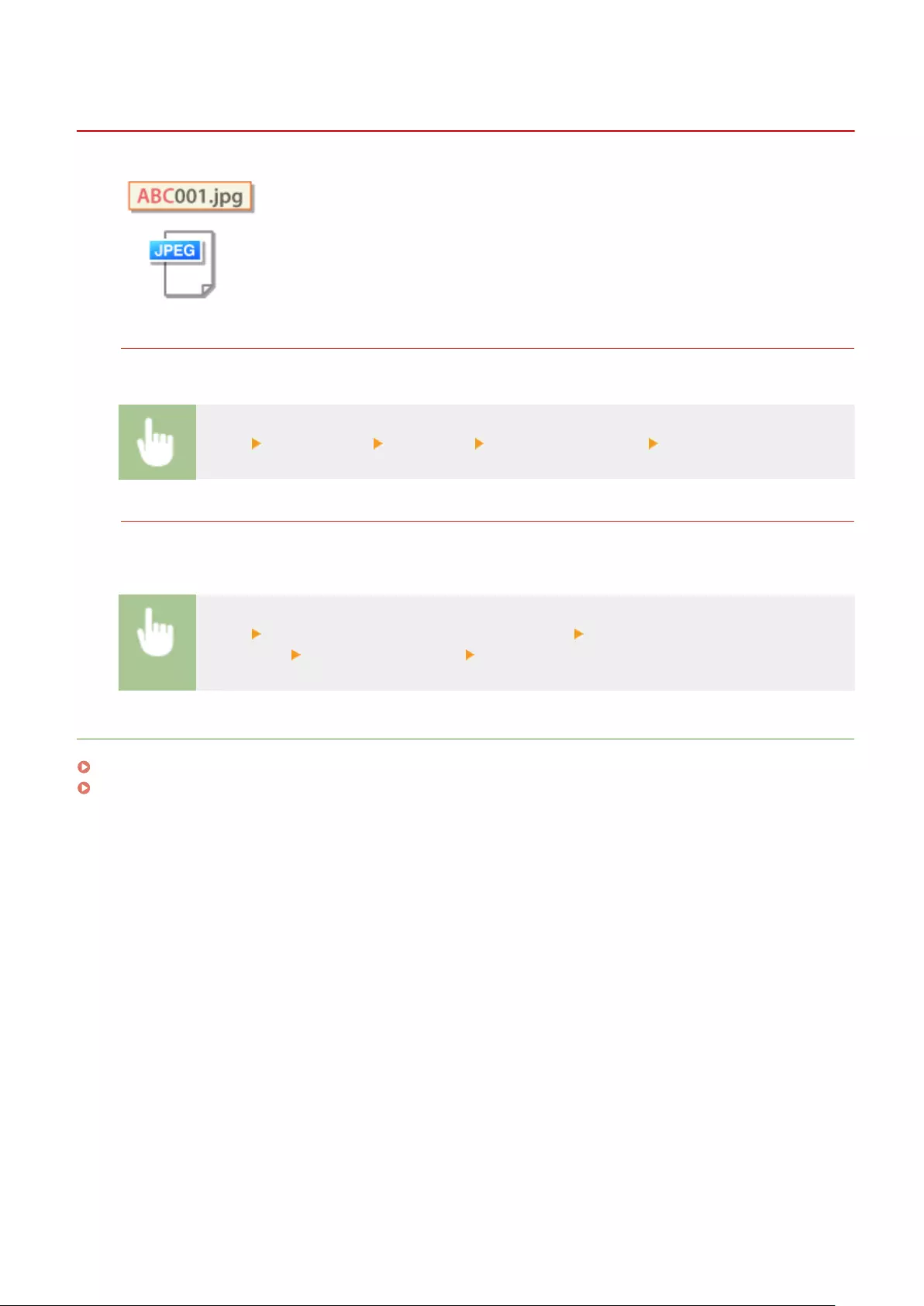
Conguring a File Name
6FR5-064
You can specify an arbitrary character string to be used in the le name of a scanned
document.
Saving Data to a USB Memory Device
The le name is automatically assigned based on the following format: arbitrary character string + four-digit
number.le extension name.
<Scan> <USB Memory> <File Name> Enter a character string <Apply>
Sending Data by E-Mail/I-Fax or Saving Data to the Server
The le name is automatically assigned based on the following format: arbitrary character
string_communication management number (four digits)_sent date and time_document number (three
digits).le extension name.
<Scan> Specify destinations in <E-Mail>/<I-Fax>/<File> Select <File Name> in the <Send
Settings> tab Enter a character string <Apply>
LINKS
Basic Operations for Scanning Originals(P. 285)
Sending I-Faxes(P. 250)
Scanning
315
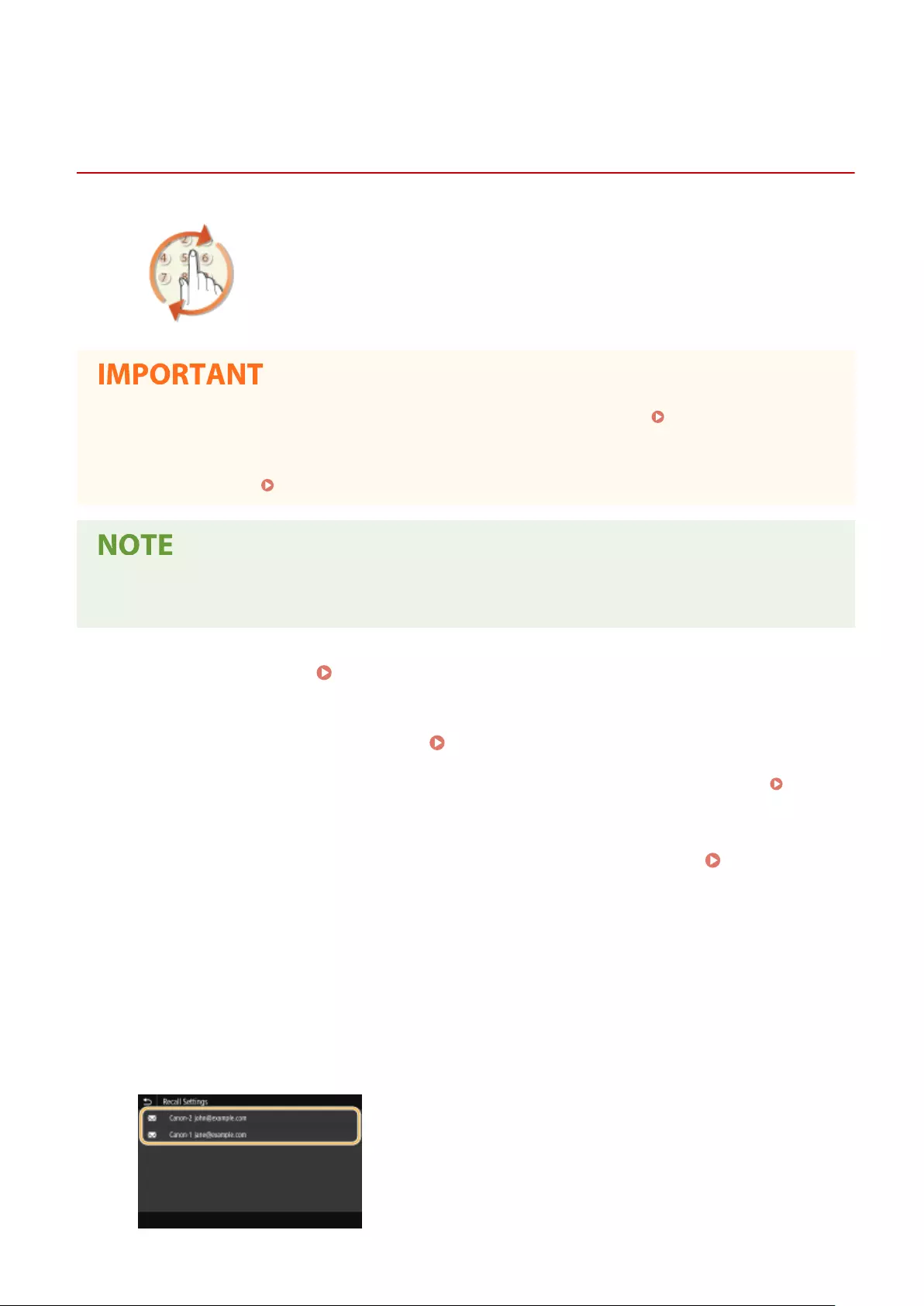
Recalling Previously Used Settings for Sending/Saving
(Recall Settings)
6FR5-065
You can select a destination from among the past destinations. When you specify a
previously used destination, the machine also sets the same scan settings such as
density you used the last time you sent documents to that destination.
●When <Restrict Resending from Log> is set to <On>, you cannot use this feature. Disabling Use of
Previously Used Destinations(P. 416)
●Turning OFF the machine or setting <Restrict New Destinations> to <On> deletes the past destinations, and
disables this feature. Restricting New Destinations that Can Be Specied(P. 416)
●When you specify a destination using this feature, any destinations that you have already specied are
deleted.
1Place the original(s). Placing Originals(P. 137)
2Select <Scan> in the Home screen. Home Screen(P. 124)
●If the login screen appears, specify the user name, the password, and the authentication server. Logging
in to Authorized Send(P. 135)
3Select <E-Mail>, <I-Fax>, or <File> in the Scan Basic Features screen. Scan Basic
Features Screen(P. 282)
4Select <Recall Settings> in the <Specify Destination> tab.
5Select the destination.
●When you transmit to multiple destinations, only the address specied for the rst transmission is displayed
in the log, but all the destinations are specied.
Scanning
316
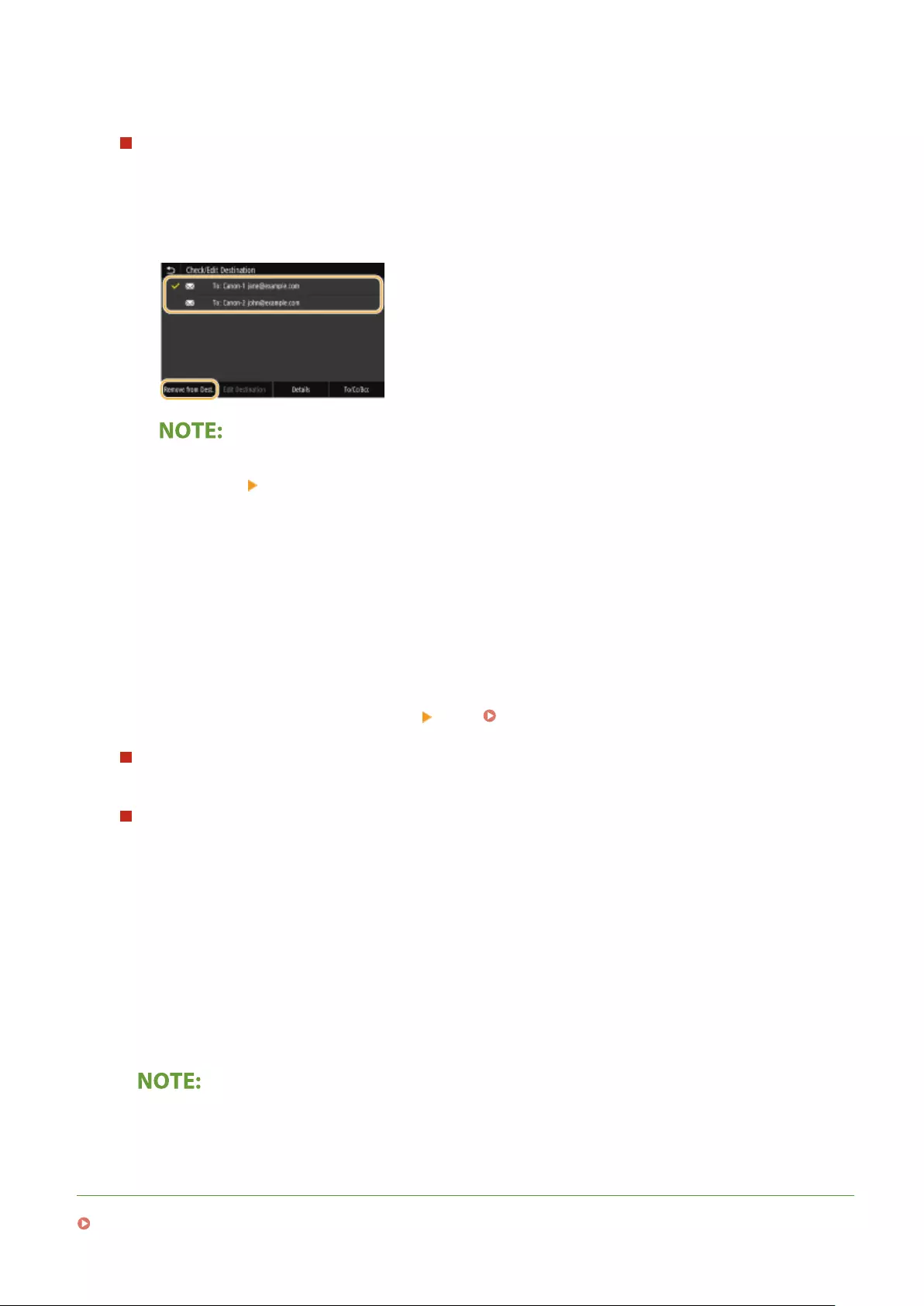
➠The selected destination and its scan settings are specied. You can also change the settings before
sending.
To delete destinations (e-mail/I-Fax)
If you specied multiple destinations, you can delete destinations as necessary.
1Select <Conrm Destination>.
2Select the check box for the destination to be deleted, and select <Remove from Dest.>.
●If you select the Group check box, you can view the destinations registered in the group by selecting
<Details> <Destination>.
3Select <Yes>.
6Select <Start>.
●If the <Conrm Destination> screen is displayed, check whether the destination is correct, and then select
<Start Scanning>.
➠Scanning of the original starts.
●If you want to cancel, select <Cancel> <Yes>. Canceling Sending Documents(P. 302)
When placing originals in the feeder in step 1
When scanning is complete, the sending/saving process starts.
When placing originals on the platen glass in step 1
When scanning is complete, follow the procedure below (except if you selected JPEG as a le format).
1If there are additional pages of originals to be scanned, place the next original on the platen glass, and
select <Scan Next Original>.
●Repeat this step until you nish scanning all of the pages.
●When there is only one page to be scanned, proceed to the next step.
2Select <Start Sending>.
➠The sending/saving process starts.
If the <File Authentication> or <SMTP Authentication> screen appears
●Enter the user name and password, and select <Apply>.
LINKS
Basic Operations for Scanning Originals(P. 285)
Scanning
317
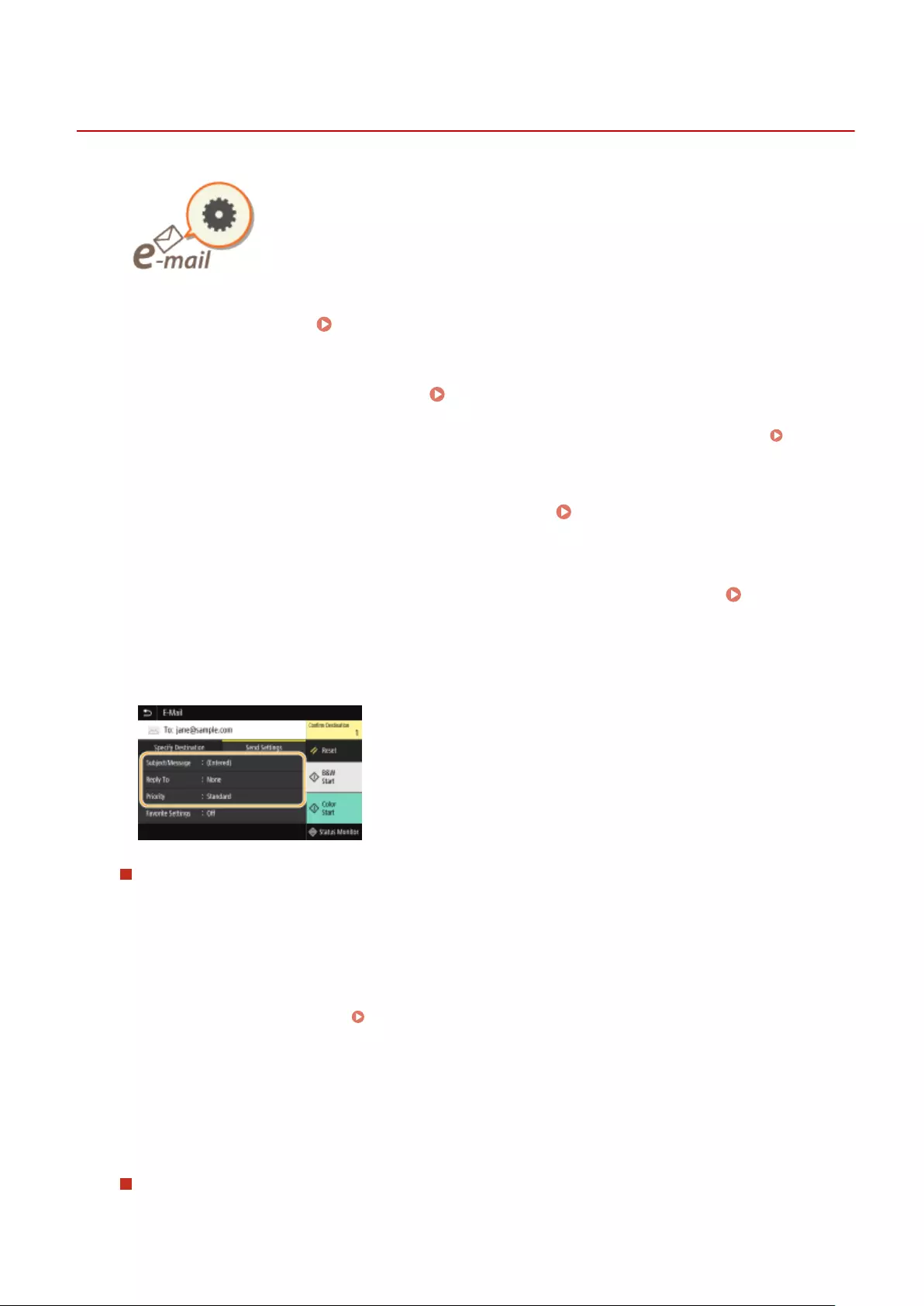
Specifying E-Mail Settings
6FR5-066
When attaching a scanned originals to an e-mail, you can specify the subject,
message, reply-to address, and priority for the e-mail before sending it.
1Place the original(s). Placing Originals(P. 137)
2Select <Scan> in the Home screen. Home Screen(P. 124)
●If the login screen appears, specify the user name, the password, and the authentication server. Logging
in to Authorized Send(P. 135) .
3Select <E-Mail> in the Scan Basic Features screen. Scan Basic Features
Screen(P. 282)
4Specify the destination, and congure the scan settings as necessary. Basic
Operations for Scanning Originals(P. 285)
5Specify the subject, message, reply-to address, and priority for the e-mail.
To specify subject/message
1Select <Subject/Message> in the <Send Settings> tab.
2Select <Subject>.
3Enter the subject, and select <Apply>.
●On how to enter text, see Entering Text(P. 133) .
4Select <Message>.
5Enter the message, and select <Apply>.
6Select <Apply>.
To specify reply-to address
Specify the reply-to address when you want to notify the recipient of an e-mail address different from that of
the machine as the reply-to address. Select the target reply-to address from the destinations registered in the
Scanning
319
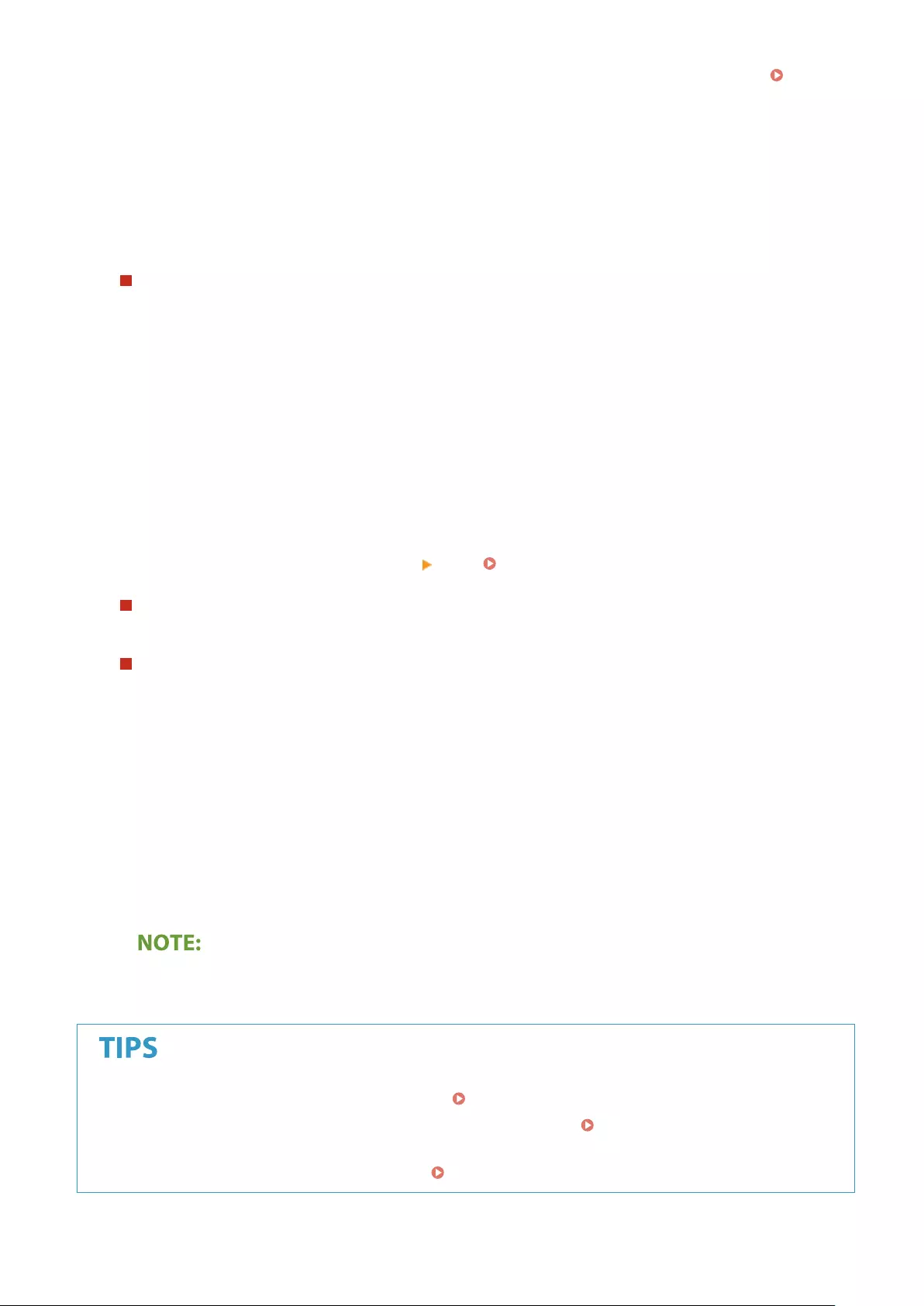
Address Book, and specify it. If the destination has not been registered in the Address Book, see
Registering Destinations(P. 180) .
1Select <Reply To> in the <Send Settings> tab.
2Select <Specify from Address Book>.
3Select the check box for the desired reply-to address, and select <Apply>.
To specify priority
1Select <Priority> in the <Send Settings> tab.
2Select a priority level.
6Select <Start>.
●If the <Conrm Destination> screen is displayed, check whether the destination is correct, and then select
<Start Scanning>.
➠Scanning of the original starts.
●If you want to cancel, select <Cancel> <Yes>. Canceling Sending Documents(P. 302)
When placing originals in the feeder in step 1
When scanning is complete, the e-mails are sent.
When placing originals on the platen glass in step 1
When scanning is complete, follow the procedure below (except if you selected JPEG as a le format).
1If there are additional pages of originals to be scanned, place the next original on the platen glass, and
select <Scan Next Original>.
●Repeat this step until you nish scanning all of the pages.
●When there is only one page to be scanned, proceed to the next step.
2Select <Start Sending>.
➠The e-mails are sent.
If the <SMTP Authentication> screen appears
●Enter the user name and password, and select <Apply>.
●If you always want to scan with the same settings: Changing the Default Settings for Functions(P. 174)
●If you want to register a combination of settings to use when needed: Registering Frequently Used
Settings(P. 172)
●If you want to specify the e-mail sender name: <Register Unit Name>(P. 535)
Scanning
320
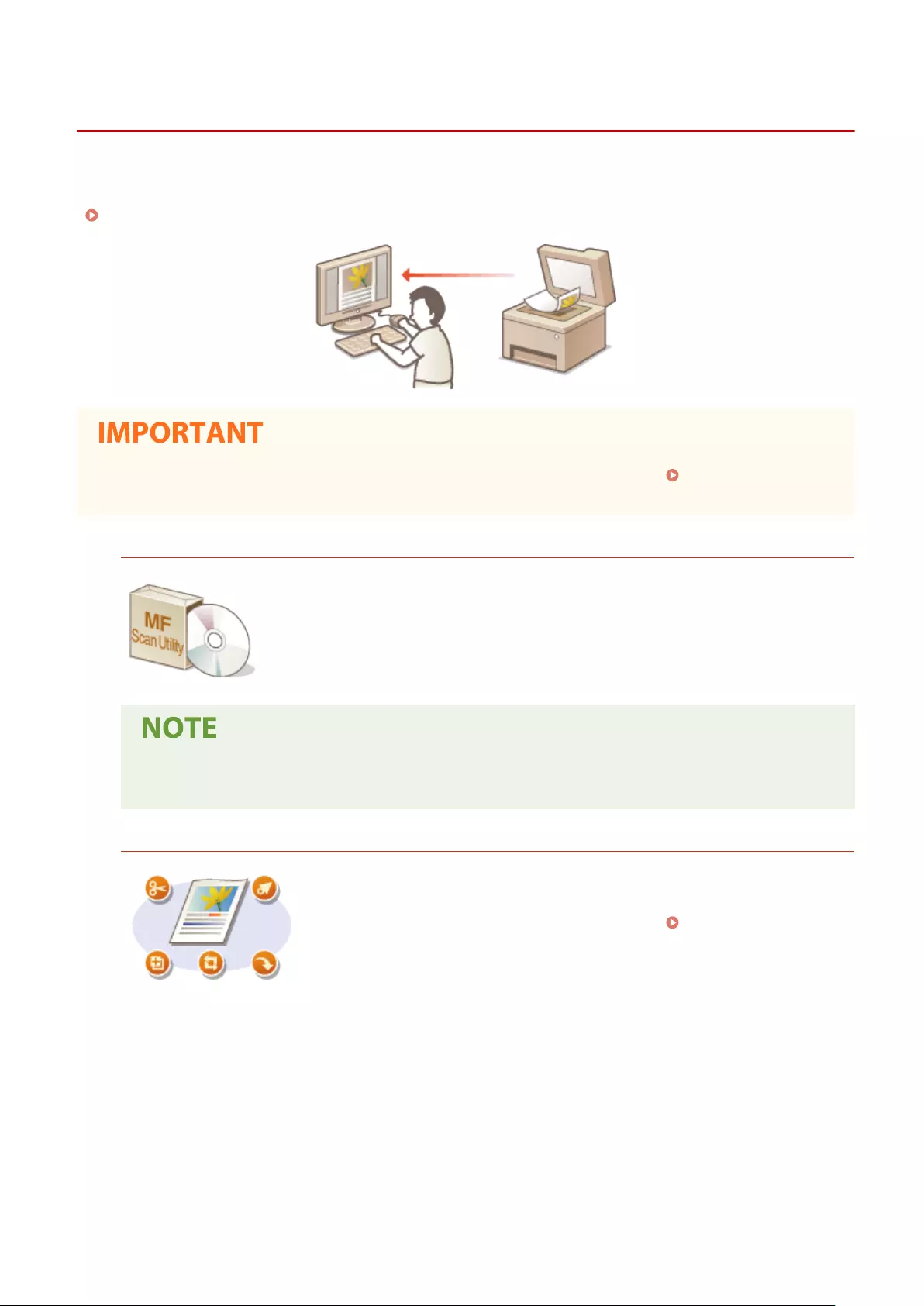
Using Your Computer to Scan (Remote Scan)
6FR5-067
To scan from a computer, you can use MF Scan Utility or an application such as an image processing or word
processing application. If you use ScanGear MF supplied with the machine, you can congure advanced scan settings
( Using ScanGear MF(P. 325) ).
●When using the machine with a USB connection, exit sleep mode before scanning. Entering Sleep
Mode(P. 178)
Scanning Using MF Scan Utility
MF Scan Utility is an application included with the machine that enables you to scan
documents or images to a computer. You can forward the scanned data to a specied
application, or attach it to an e-mail message. For more information, click [Instructions]
on MF Scan Utility.
●If you are a macOS user, see the manuals for the relevant drivers or software on the online manual
website.
Scanning Using an Application
You can scan images by using an application such as a word-processing or
image-processing application, and load the images directly into the application.
You do not need to start another application to scan. Scanning Documents
from an Application(P. 323)
Scanning
322

Scanning Documents from an Application
6FR5-068
You can scan originals from applications such as image-processing or word-
processing software. The scanned image is directly loaded in the application,
allowing you to edit or process the image immediately. The following procedure
varies depending on the application.
●The application must be compatible with TWAIN or WIA*. For more information, see the instruction manual
for your application.
*TWAIN is a standard for connecting image input devices, such as scanners, with computers. WIA is a function that is an
integrated standard in Windows.
1Place the original(s). Placing Originals(P. 137)
●The second or subsequent originals may not be scanned, or an error message may be displayed
depending on the application. In such a case, place and scan one original at a time.
●When <Auto Online> is set to <Off>, you must select <Scan> <Remote Scanner> in the Home screen to
bring the machine online. <Auto Online>(P. 504)
2From the application, select the start scan command.
●The procedure for selecting the start scan command varies depending on the application. For more
information, see the instruction manual for your application.
3Select the scanner driver for this machine.
●Select ScanGear MF or WIA. If you select ScanGear MF, you can congure advanced scan settings.
4Specify the scanning settings as necessary.
5Click [Scan].
➠Scanning of the original starts.
●When scanning is complete, the scanned image is forwarded to an application.
How to use ScanGear MF
●Click on the ScanGear MF screen, and see the Help.
Scanning
323
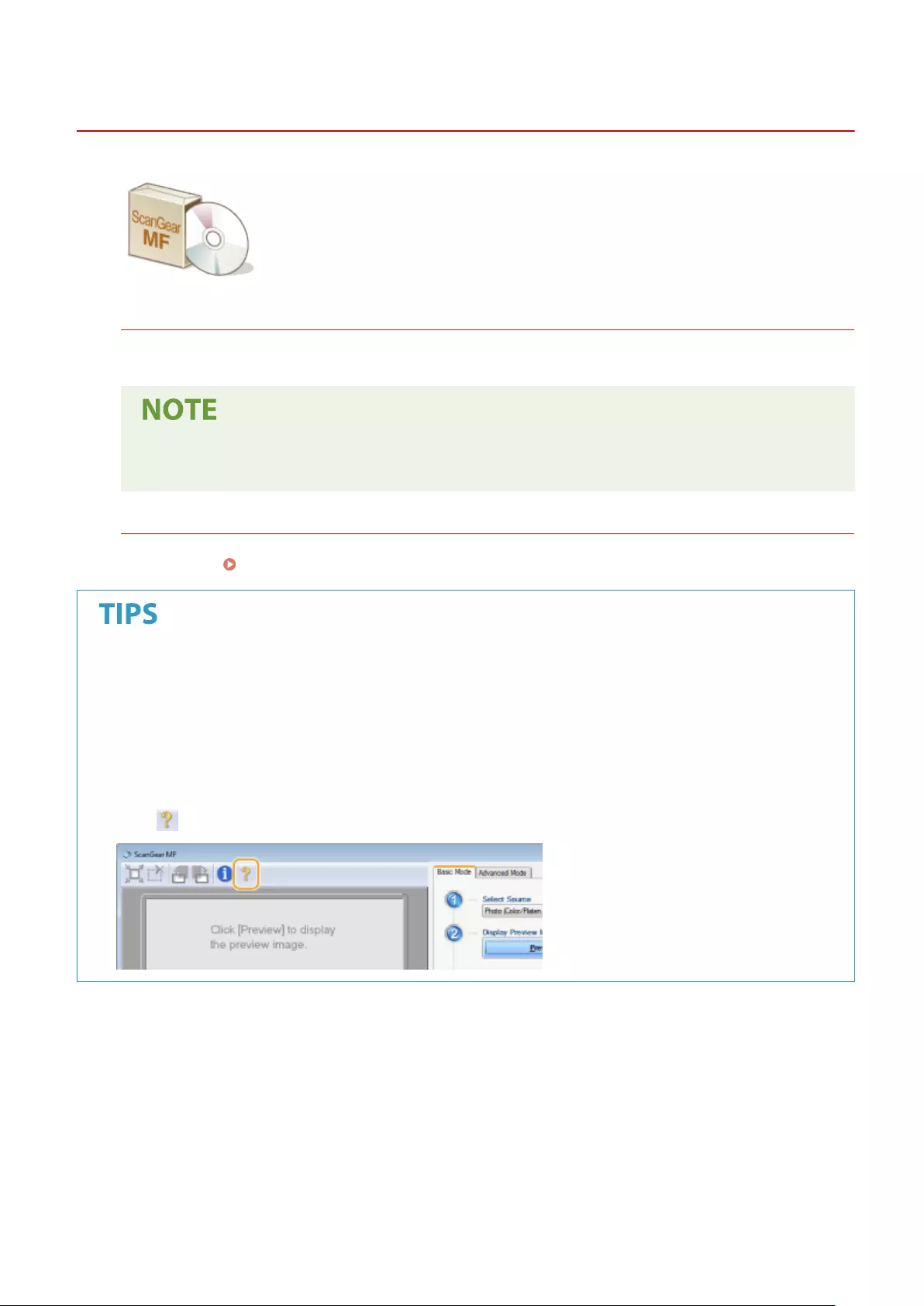
Using ScanGear MF
6FR5-069
ScanGear MF is a scanner driver included with the machine. You can use ScanGear
MF to congure advanced scan settings when you scan. The way of
starting ScanGear MF differs depending of the way of scanning from the computer.
Starting from MF Scan Utility
When scanning from MF Scan Utility, click [ScanGear] to start ScanGear MF. For more information, click
[Instructions] on MF Scan Utility.
●If you are a macOS user, see the manuals for the relevant drivers or software on the online manual
website.
Starting from an application
To scan from applications such as image-processing or word-processing software, select ScanGear MF as
scanner driver. Scanning Documents from an Application(P. 323)
Functions of ScanGear MF
●Previewing the image before scanning
●Specifying the scanning area
●Adjusting the detailed image quality
How to use ScanGear MF
●Click on the ScanGear MF screen, and see the Help.
Scanning
325

Using WSD
6FR5-06A
"WSD (Web Services on Devices)" is a function to search devices located on the network. Using WSD enables you to
automatically nd the machine on the network from a computer, and start scanning the original on the machine. This
function is called "WSD Scan." You need to complete some procedures before using WSD Scan. Preparing for WSD
Scan(P. 326)
◼Preparing for WSD Scan
From the control panel
1Select <Menu> in the Home screen. Home Screen(P. 124)
2Select <Preferences> <Network> <TCP/IP Settings> <WSD Settings>.
3Select <On> in <Use WSD Scanning> and then select <On> in <Use Computer
Scanning>.
4Select <Apply>.
5Select <OK>.
6Restart the machine. Restarting the Machine(P. 120)
From a computer
7Click [Start] [Devices and Printers].
8Click [Add a device].
Scanning
326
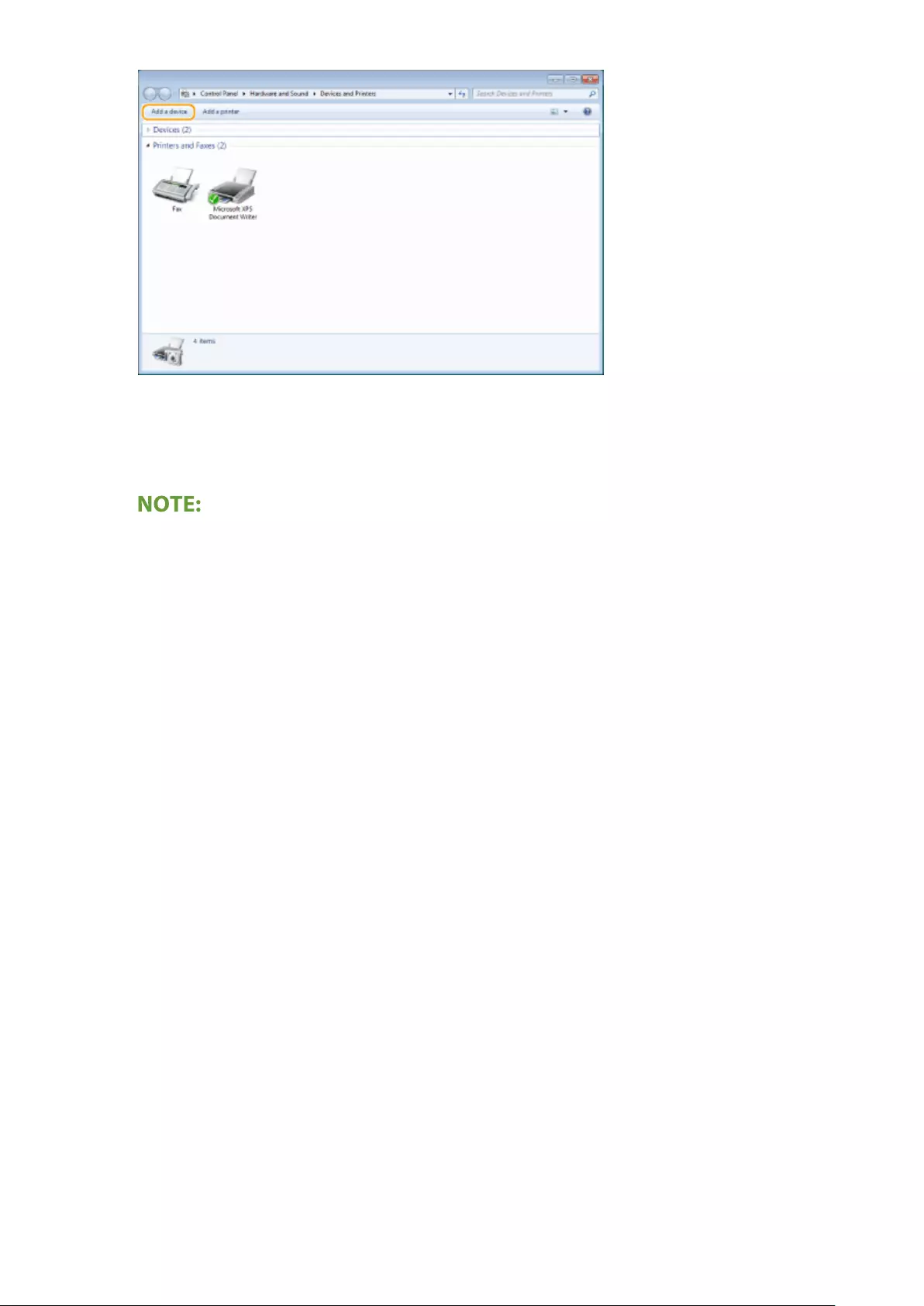
9Select this machine and click [Next].
●Follow the on-screen instructions to operate.
●If this machine is not displayed, a Firewall setting problem may exist. For more information, see the
instruction manual of the computer.
Scanning
327
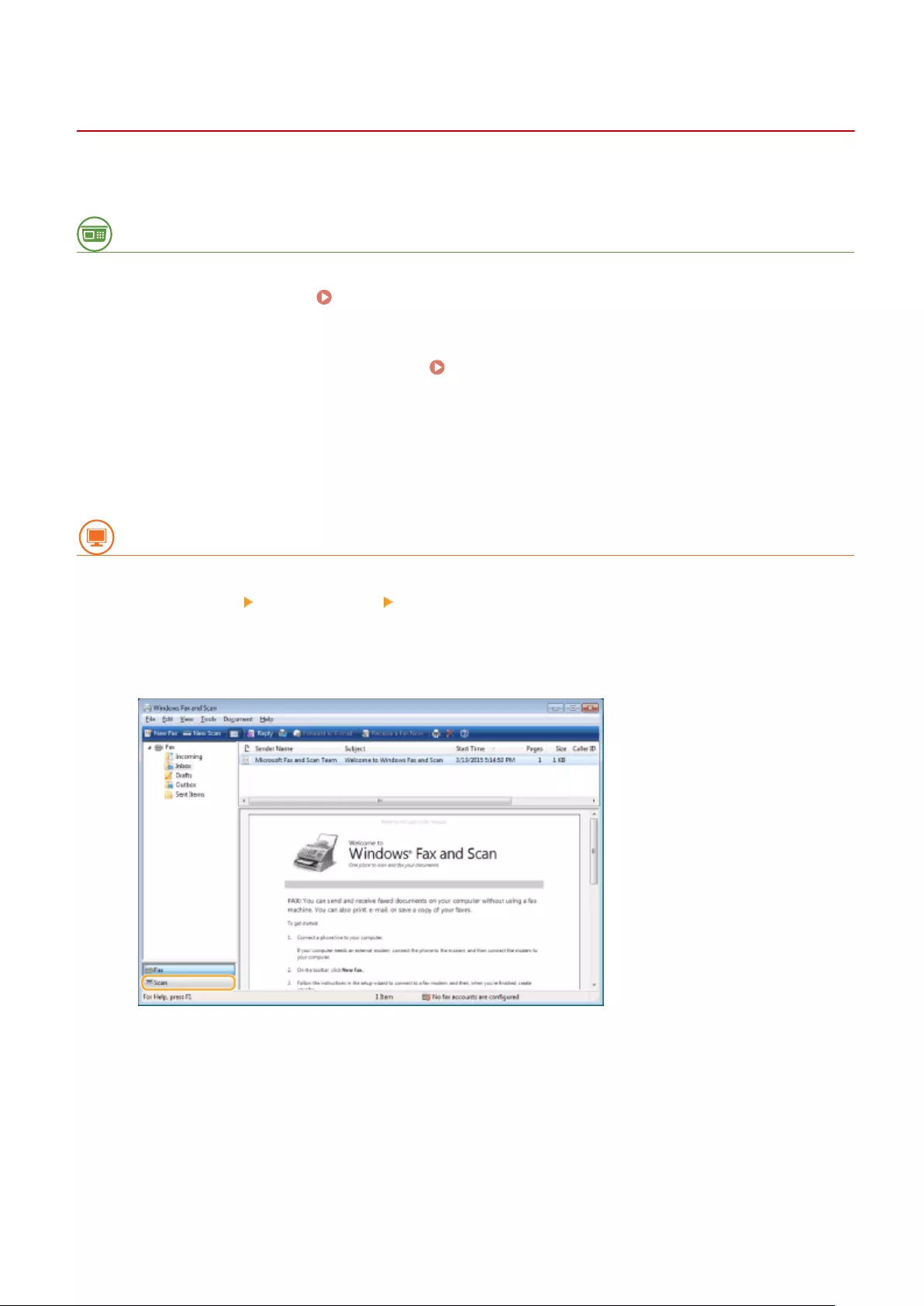
Scanning Originals Using WSD (WSD Scan)
6FR5-06C
This section describes how to scan originals from a computer using WSD.
From the control panel
1Place the original(s). Placing Originals(P. 137)
2Select <Scan> in the Home screen. Home Screen(P. 124)
3Select <Remote Scanner>.
➠Now you are ready for scanning from your computer.
From a computer
4Click [Start] [All Programs] [Windows Fax and Scan].
5Click [Scan].
6Click [New Scan].
Scanning
328
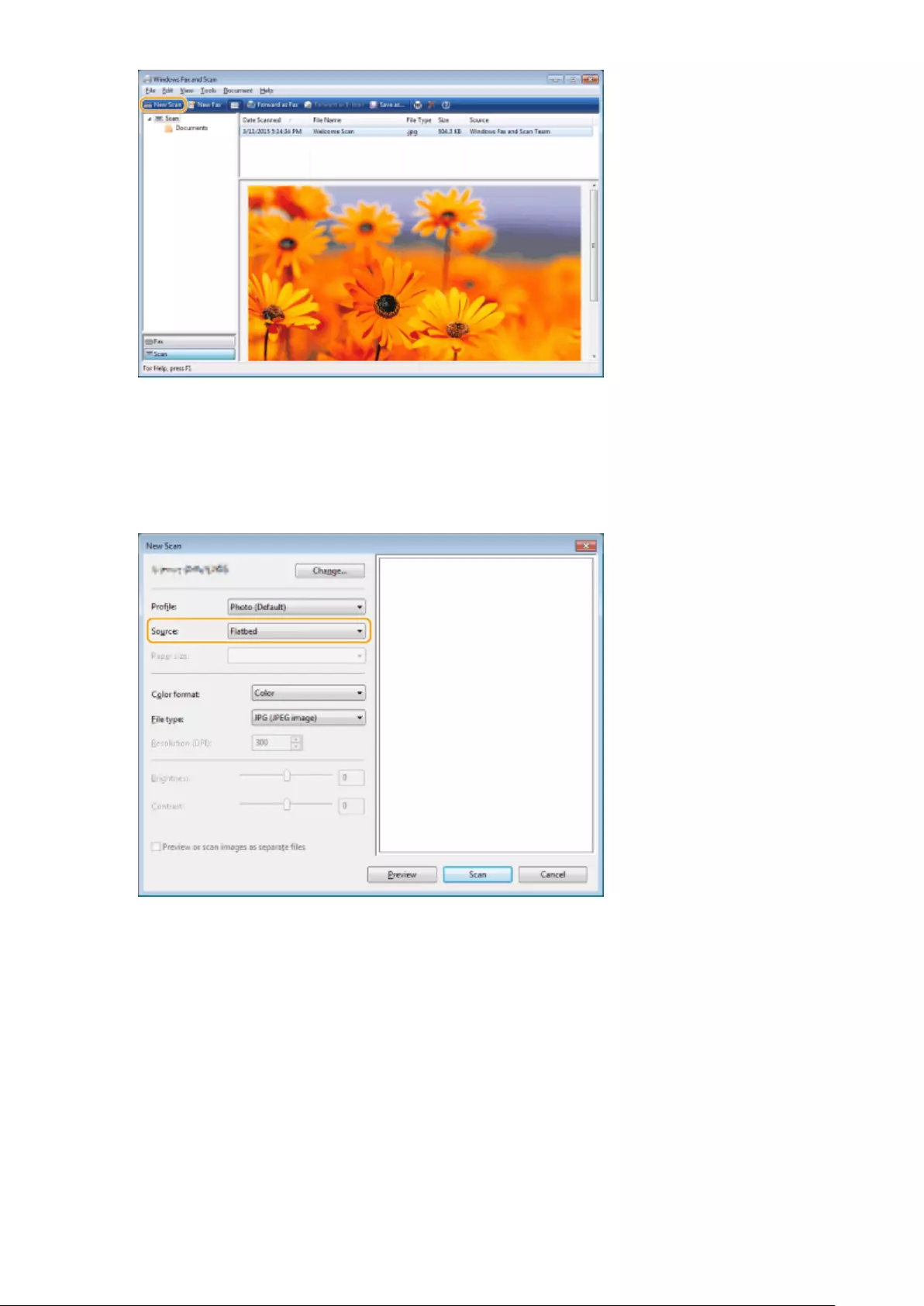
●When the [Select Device] dialog box is displayed, select the machine and click [OK].
7From the [Source] drop-down list, select the location where the original is placed.
●When placing the original on the platen glass, select [Flatbed]. When placing in the feeder, select [Feeder
(Scan one side)].
8Specify the scan settings as necessary.
●Selecting the type of original from the [Prole] drop-down list enables you to make adjustments for the
optimal image quality. For originals mainly consisting of text, select [Document]. For originals consisting of
photographs only, select [Photo (Default)].
●From the [File type] drop-down list, select the le format for the saved image of the scanned original.
●To check the scanned image with the specied settings reected, click [Preview].
9Click [Scan].
➠Scanning an original starts.
Scanning
329
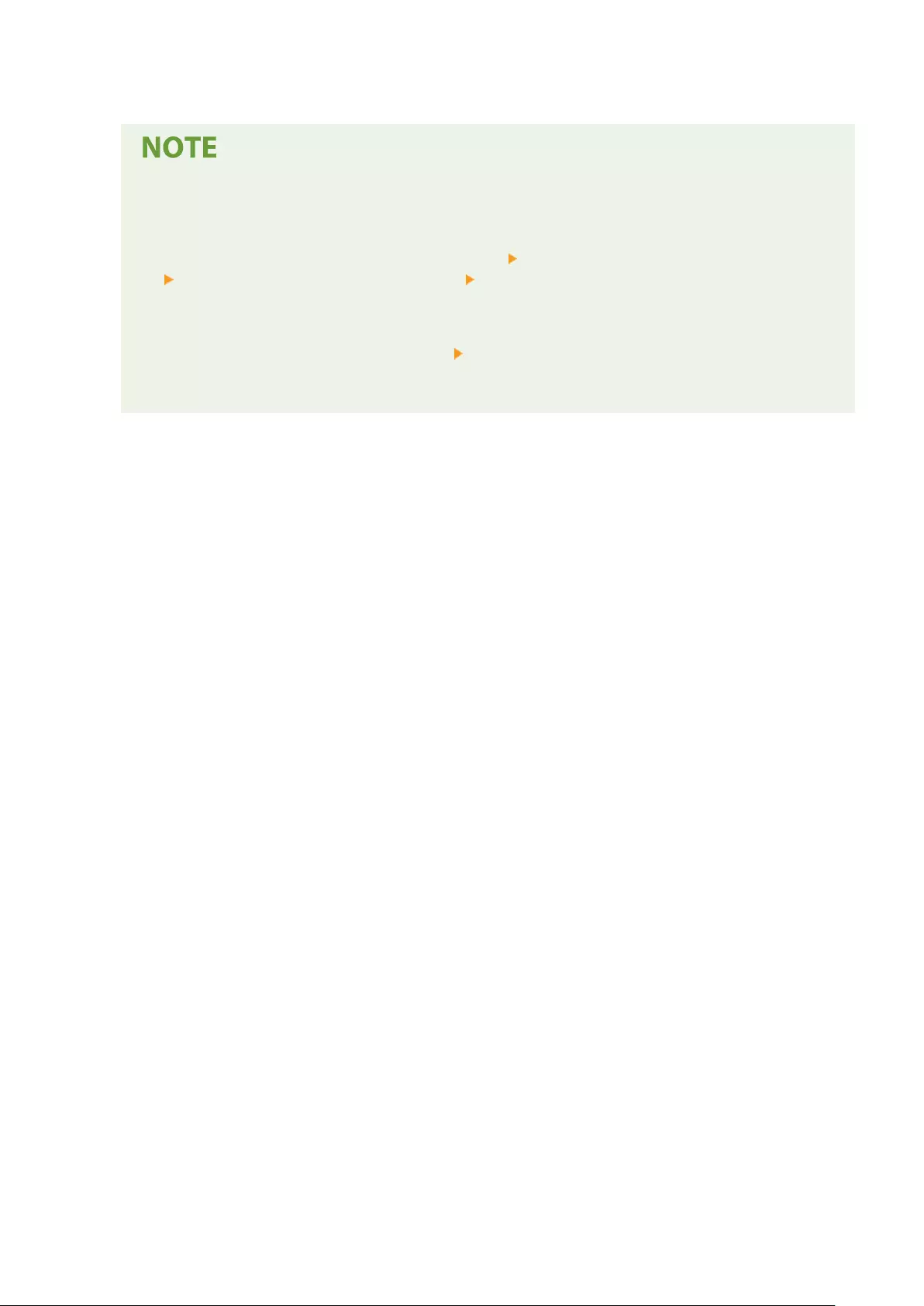
●When scanning is complete, the scanned document is displayed in the list of les on the [Windows Fax and
Scan] screen and saved in the [Scanned Documents] folder of [Documents].
Registering frequently used scan settings
●If you always scan with the same settings, follow the procedures below to register the settings. You
can easily and conveniently recall them when scanning.
Select [Add prole] from the [Prole] drop-down list Specify the scan settings you want to register
Enter a name in the [Prole name] text box Click [Save Prole]
Sending the document to a computer using WSD
●You can also send the scanned document to computers on the network that support WSD. In this
case, select <Computer> on the Main Menu select the computer you want to send.
The [Windows Fax and Scan] screen and the folder open in the computer, and the scanned document
is displayed.
Scanning
330

Linking with Mobile Devices
Linking with Mobile Devices .................................................................................................................... 332
Connecting with Mobile Devices ...................................................................................................................... 333
Connecting via a Wireless LAN Router (LAN Connection) .............................................................................. 334
Connecting Directly (Access Point Mode) ...................................................................................................... 336
Utilizing the Machine through Applications .................................................................................................... 339
Using AirPrint .................................................................................................................................................... 341
Printing with AirPrint .................................................................................................................................... 346
Scanning with AirPrint .................................................................................................................................. 349
Faxing with AirPrint ...................................................................................................................................... 351
If AirPrint Cannot Be Used ............................................................................................................................ 353
Using Google Cloud Print .................................................................................................................................. 354
Printing with Default Print Service (Android) .................................................................................................. 356
Managing the Machine by the Remote Control .............................................................................................. 357
Linking with Mobile Devices
331
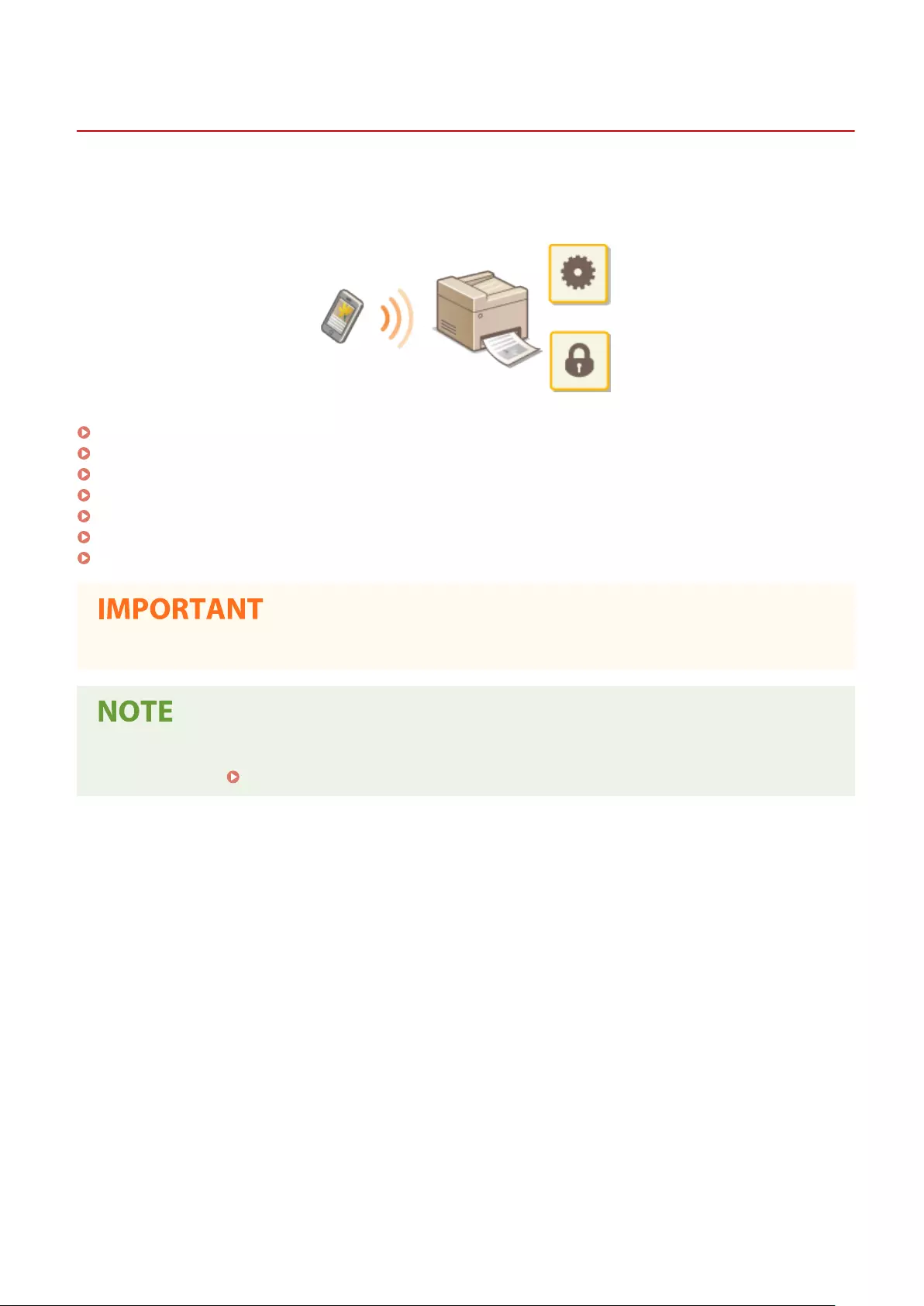
Linking with Mobile Devices
6FR5-06E
Linking the machine with mobile devices such as smart phones and tablets enables you to use an appropriate
application to perform printing, or other operation with ease. In addition, you can operate the machine from mobile
devices via remote control to conrm printing status and change the settings of the machine.
Connecting with Mobile Devices(P. 333)
Connecting Directly (Access Point Mode)(P. 336)
Utilizing the Machine through Applications(P. 339)
Using AirPrint(P. 341)
Using Google Cloud Print(P. 354)
Printing with Default Print Service (Android)(P. 356)
Managing the Machine by the Remote Control(P. 357)
●Depending on your mobile device, the machine may not operate correctly.
●When [Restrict IPP Port (Port Number: 631)] or [Restrict mDNS Port (Port Number: 5353)] is enabled in
Security Policy ( Security Policy(P. 444) ), you can use neither Mopria® or AirPrint.
Linking with Mobile Devices
332
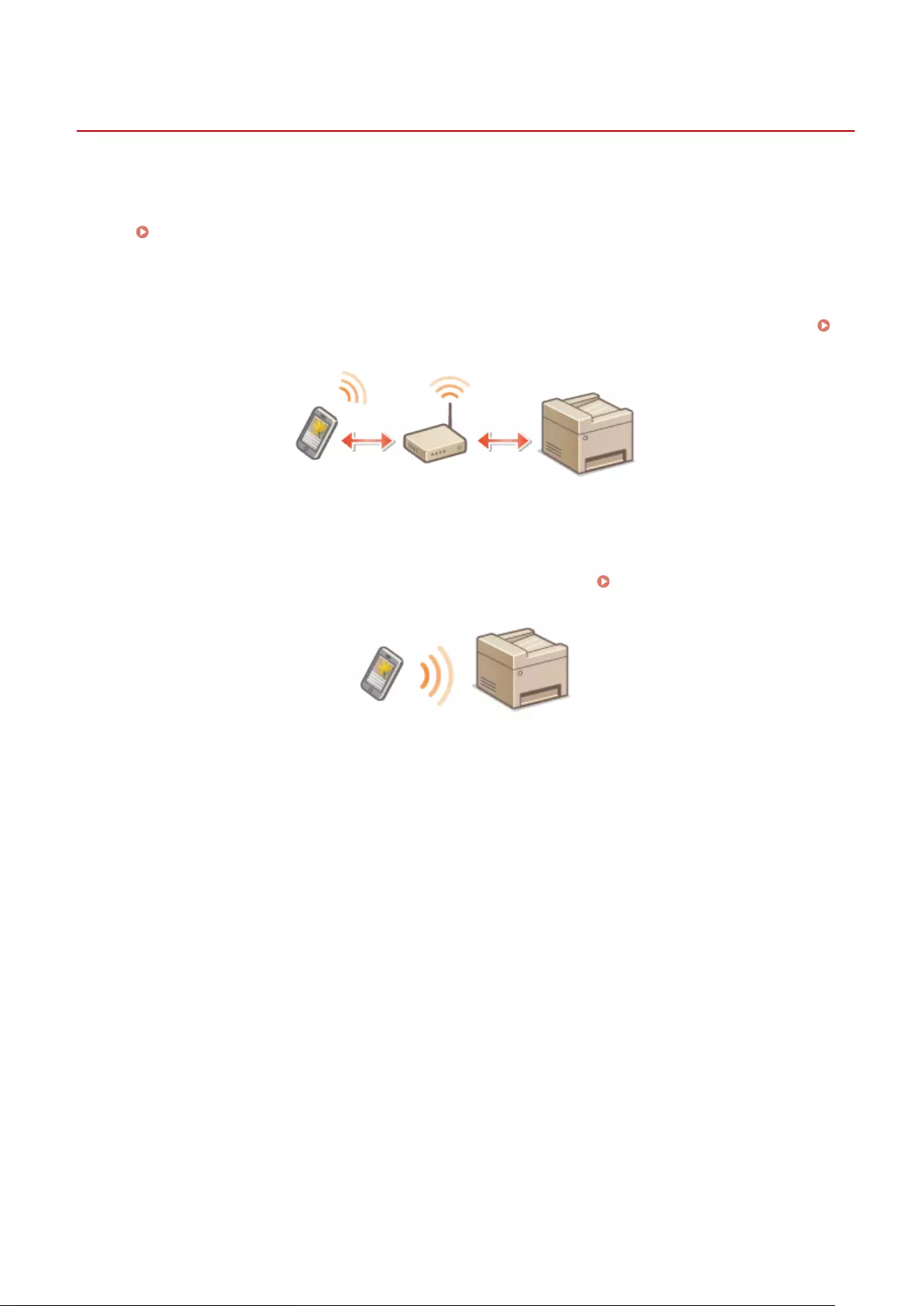
Connecting with Mobile Devices
6FR5-06F
There are two methods used to connect a mobile device with the machine: connecting via a wireless LAN router, and
communicating wirelessly and directly with the machine. Select a connection method in accordance with the
communication environment and the device you are using. Perform communication with mobile devices from <Mobile
Portal> ( Home Screen(P. 124) ).
◼Connecting via a Wireless LAN Router
Just as connecting a computer to the machine, connect a mobile device to the machine via a wireless LAN router.
Connecting via a Wireless LAN Router (LAN Connection)(P. 334)
◼Connecting Directly
Directly connect a mobile device to the machine wirelessly without using wireless LAN. It is possible to immediately
connect to the machine wirelessly even outside of a wireless LAN environment. Connecting Directly (Access Point
Mode)(P. 336)
Linking with Mobile Devices
333
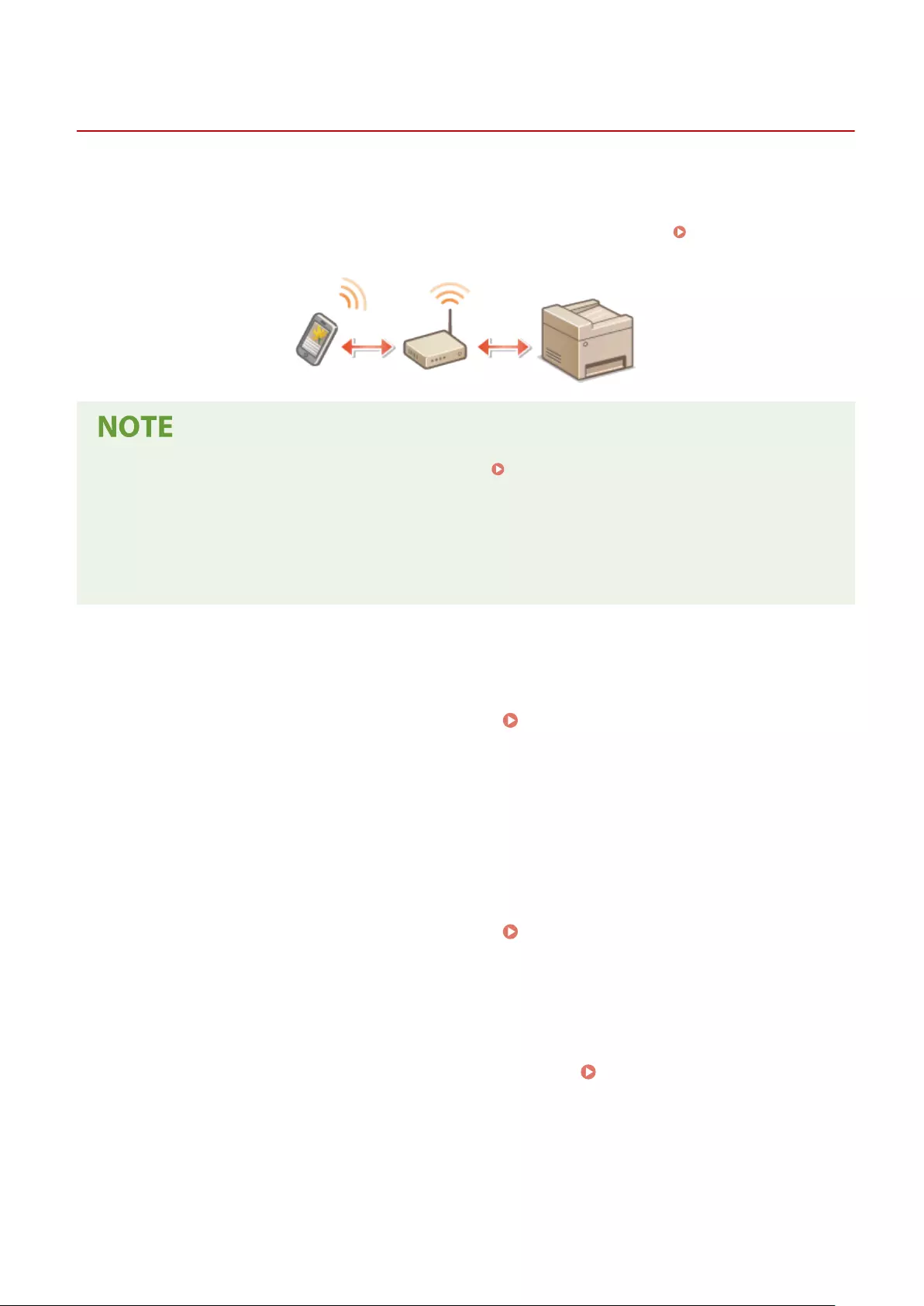
Connecting via a Wireless LAN Router (LAN Connection)
6FR5-06H
If a wireless LAN router is connected to the network connected to the machine, you can establish a communication
with a mobile device via the wireless LAN router in the same way for a computer. For information about how to
connect a mobile device to your wireless LAN router, see the instruction manuals for your networking devices or
contact your manufacturer. Connect the machine to a router via the wired or wireless LAN. Setting Up the Network
Environment(P. 14)
●To perform the procedures below, use the IPv4 address. Setting IPv4 Address(P. 32)
●Select <LAN Connection> and proceed with the procedure, if the <Direct Connection> screen is displayed
after <Mobile Portal> is selected in the procedure below.
●For information about the operating systems compatible with Canon PRINT Business, the detailed setting
procedure, and the operating procedure, please see the application's Help or the Canon website (https://
global.canon/gomp/).
◼Connecting Manually
1Select <Mobile Portal> in the Home screen. Home Screen(P. 124)
2Connect from the mobile device to the IP address that appears on the screen.
◼Connecting Using a QR Code
1Select <Mobile Portal> in the Home screen. Home Screen(P. 124)
2Select <QR Code>.
3Launch Canon PRINT Business on the mobile device. Utilizing the Machine through
Applications(P. 339)
4Read the QR code displayed on the screen using the mobile device.
Linking with Mobile Devices
334

Linking with Mobile Devices
335
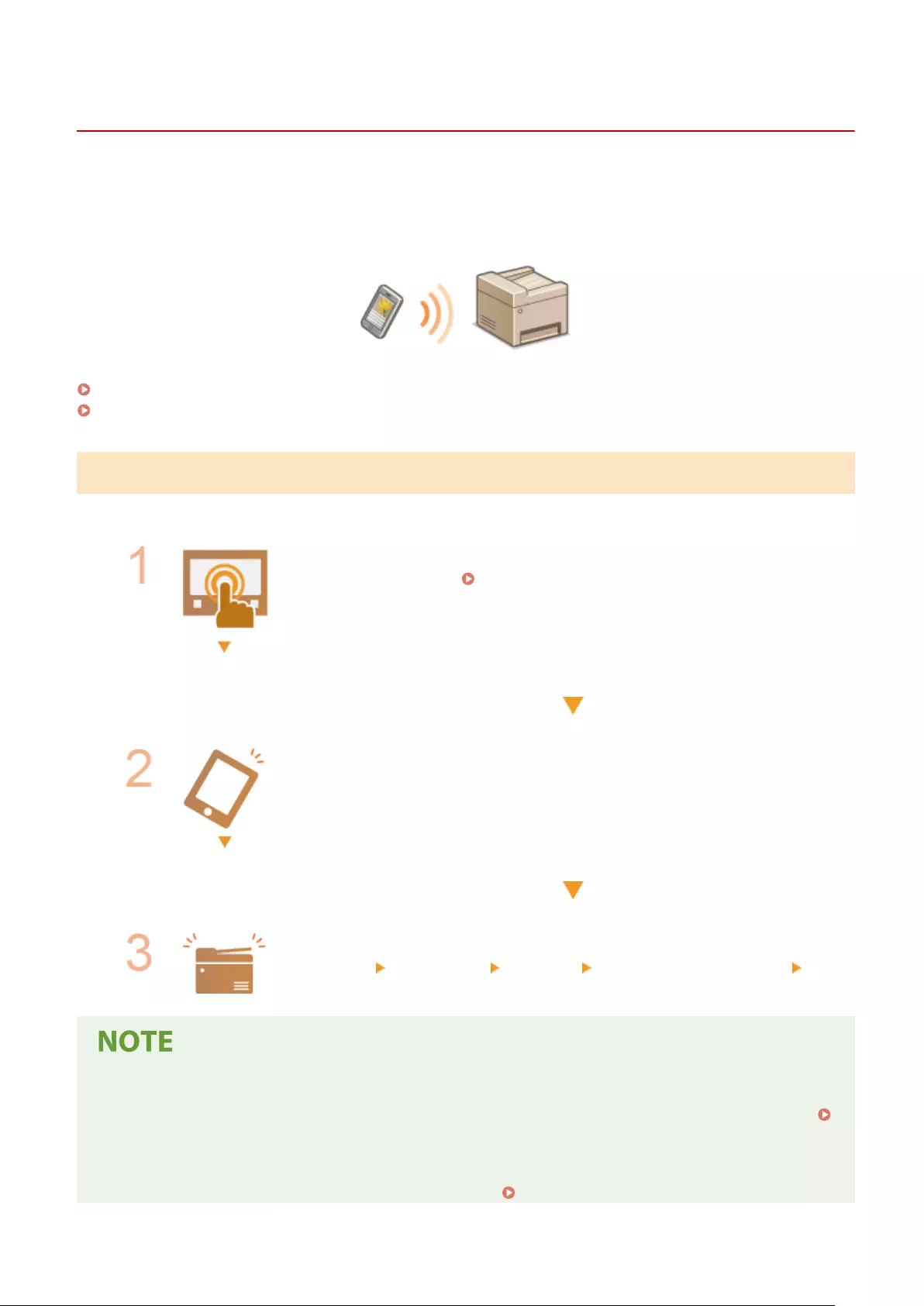
Connecting Directly (Access Point Mode)
6FR5-06J
1660-068
Even in an environment without a wireless LAN router, using "Access Point Mode," which can directly connect a mobile
device to the machine wirelessly, enables you to connect the mobile device on hand to the machine without dicult
settings.
Preparing for Direct Connection (Access Point Mode)(P. 336)
Connecting Directly(P. 337)
Preparing for Direct Connection (Access Point Mode)
Establish a connection by using Access Point Mode in the following order.
Check the network settings of the machine.
●Set the IPv4 address. Setting IPv4 Address(P. 32)
Preparing the mobile device
●Congure settings to connect the mobile device to Wi-Fi.
Put the machine into the connection standby status.
●<Menu> <Preferences> <Network> <Direct Connection Settings> set
<Use Direct Connection> to <On>.
Specifying the value for time until auto termination
●You can specify the time to automatically establish a disconnection when the direct connection is enabled.
<Direct Connection Termination>(P. 474)
Connecting multiple mobile devices at the same time
●Congure the machine's SSID and network key arbitrarily. <Access Point Mode Settings>(P. 474)
Linking with Mobile Devices
336

Canon PRINT Business
●For information about the operating systems compatible with Canon PRINT Business, the detailed setting
procedure, and the operating procedure, please see the application's Help or the Canon website (https://
global.canon/gomp/).
Connecting Directly
●It may take time until a connection of the machine and the mobile device is established.
◼Connecting Manually
1Select <Mobile Portal> in the Home screen. Home Screen(P. 124)
●When any mobile device is already connected, proceed to step 3.
2Select <Connect>.
3Congure the Wi-Fi settings from the mobile device using the SSID and network key
information that appear on the screen.
4When the target operation is completed, select <Disconnect>.
◼Connecting Using a QR Code
1Select <Mobile Portal> in the Home screen. Home Screen(P. 124)
●When any mobile device is already connected, proceed to step 3.
2Select <Connect>.
3Select <QR Code>.
4Launch Canon PRINT Business on the mobile device. Utilizing the Machine through
Applications(P. 339)
5Read the QR code displayed on the screen using the mobile device.
Linking with Mobile Devices
337
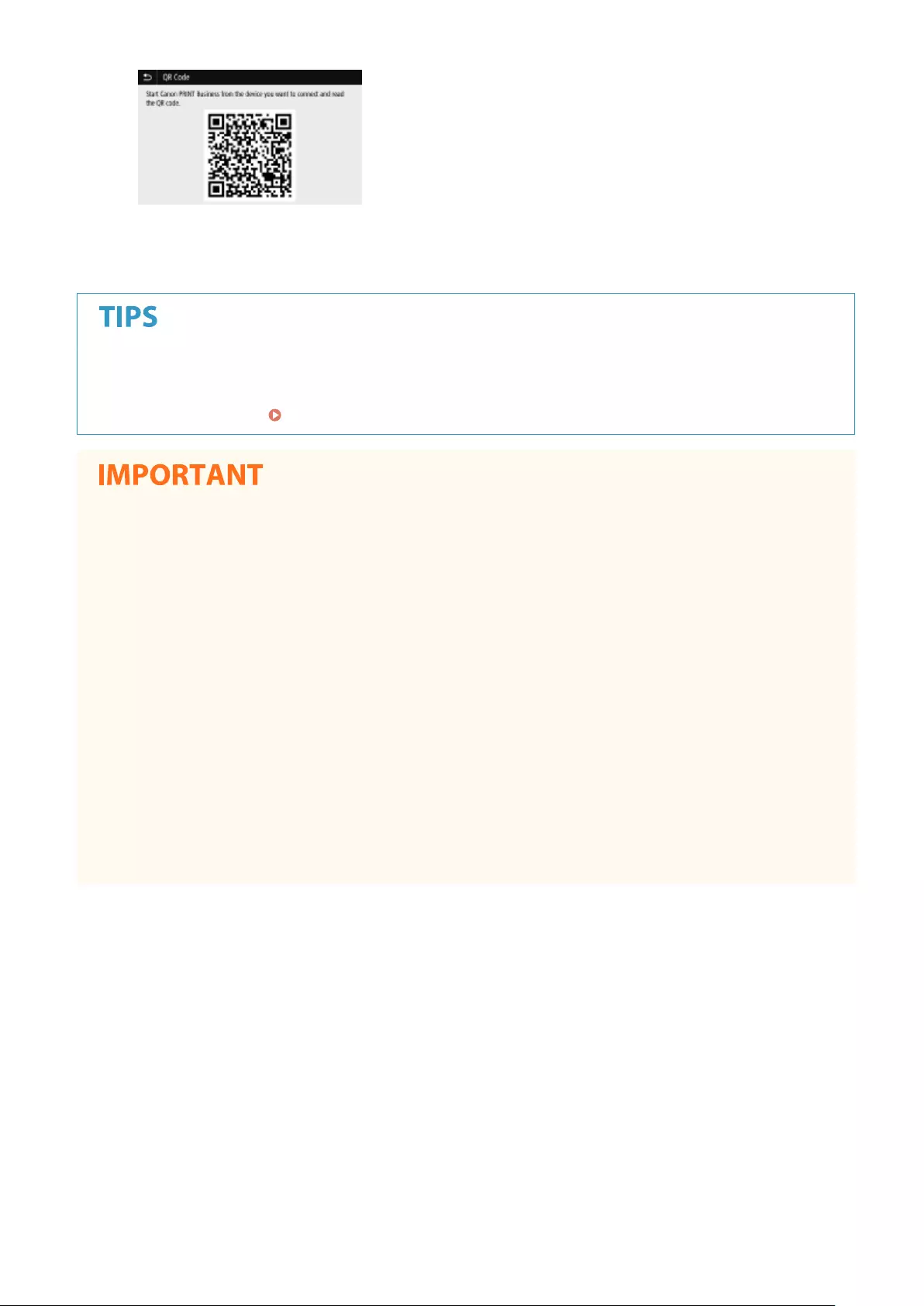
6When the target operation is completed, then select <Disconnect>.
●Select <Connection Information> on the <Direct Connection> screen to check the connected mobile device.
●When <Keep Enabled If SSID/Ntwk Key Spcfd> is set to <On>, it is not necessary to perform the operation of
selecting <Connect>. <Keep Enabled If SSID/Ntwk Key Spcfd>(P. 474)
●While connecting via direct connection, you may not be able to connect to the Internet depending on the
mobile device you are using.
●If a wireless connection from the mobile device is not performed within 5 minutes while the SSID and
network key are displayed, the connection waiting state terminates.
●If the status without data transmission between the mobile device and the machine continues during
communication by direct connection, the communication may end.
●Power saving performance of sleep mode degrades while connecting via direct connection.
●If the machine is used with a wireless LAN, you need to keep the machine connected to the wireless LAN
when using direct connection. When the machine is not connected to a wireless LAN or the connection
process is not complete yet, the direct connection process cannot begin. If the connection between the
machine and the wireless LAN is lost during communication through direct connection, the communication
may end.
●When you nish the desired operation, be sure to terminate the connection between the machine and the
mobile device. If they remain connected, power saving performance of sleep mode degrades.
●If you use the direct connection, do not set the IP address manually on the mobile device. Doing so may
prevent proper communication after using the direct connection.
Linking with Mobile Devices
338
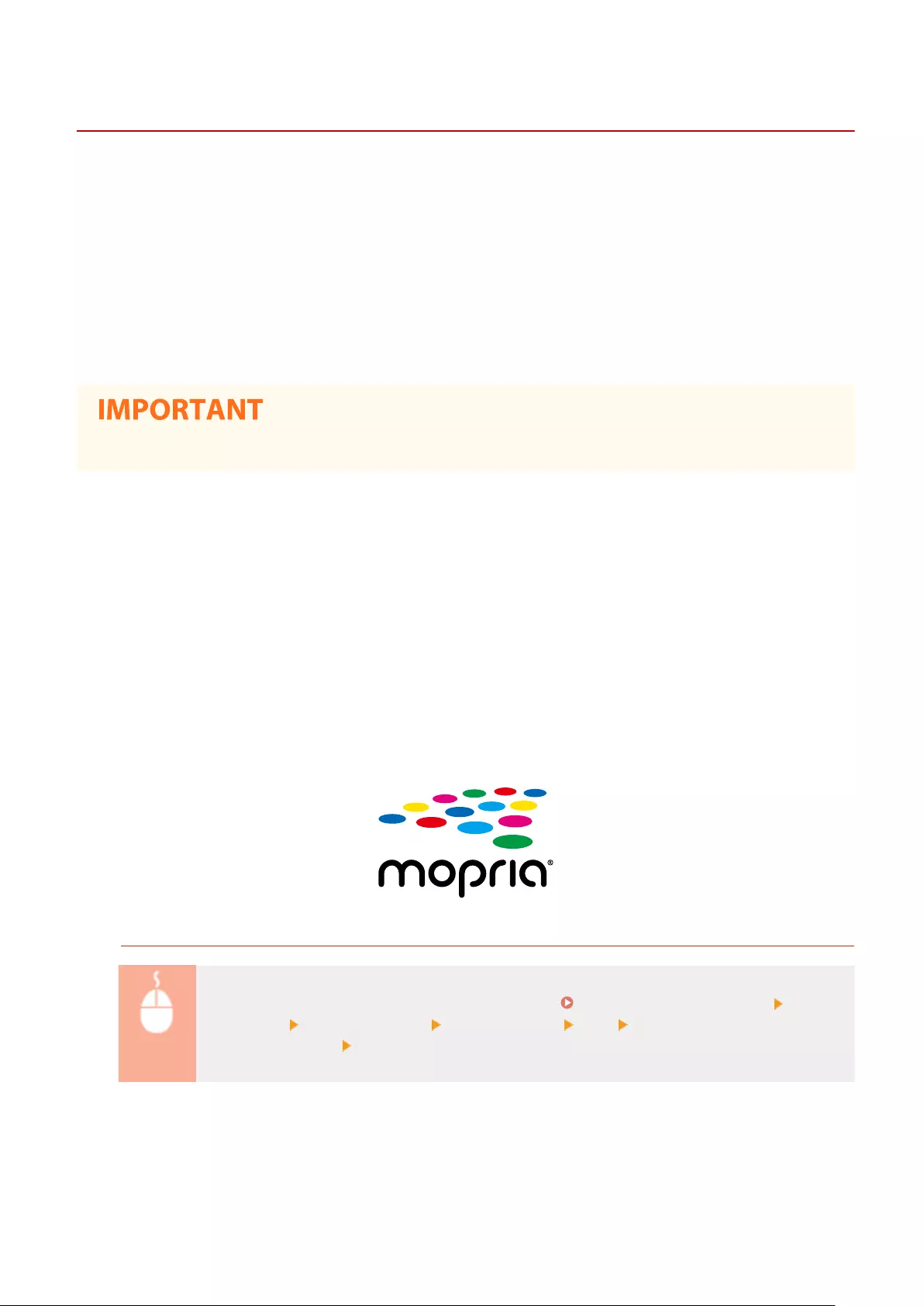
Utilizing the Machine through Applications
6FR5-06K
Perform printing and other operations from the mobile device connected to the machine using applications. Various
applications including those exclusive to Canon are supported. Use properly in accordance with your device, the
application, and the situation.
◼Using Canon PRINT Business
This application is used to perform printing and other operations from mobile devices that support iOS/Android. When
printing, it is not necessary to perform operations on the machine. For more information on supported operating
systems, detailed setting methods, and operations, see the application's Help or the Canon website (https://
global.canon/gomp/).
●You can download Canon PRINT Business for free, but you will be charged the Internet connection fee.
◼Printing with Canon Print Service
You can easily print from the menu of applications that support the Android print subsystem. For more information on
supported operating systems and detailed settings and procedures, see the Canon website (https://global.canon/).
◼Using Mopria®
The machine also supports Mopria®. Mopria® enables you to perform printing and other operations from a mobile
Android device using common operations and settings regardless of the manufacturer or model. For example,
businesses using multiple Mopria® compatible devices from different manufacturers can print from the same printer
and businesspeople on-the-go can use a Mopria® compatible device with a local certied printer without having to
install a separate application. For more information on supporting models or operation environments, see http://
www.mopria.org.
Conrming Mopria® Settings
Log in to the Remote UI with Administrator privileges ( Starting Remote UI(P. 428) ) [Settings/
Registration] [Network Settings] [Mopria Settings] [Edit] Check that the [Use Mopria]
check box is selected [OK]
Linking with Mobile Devices
339
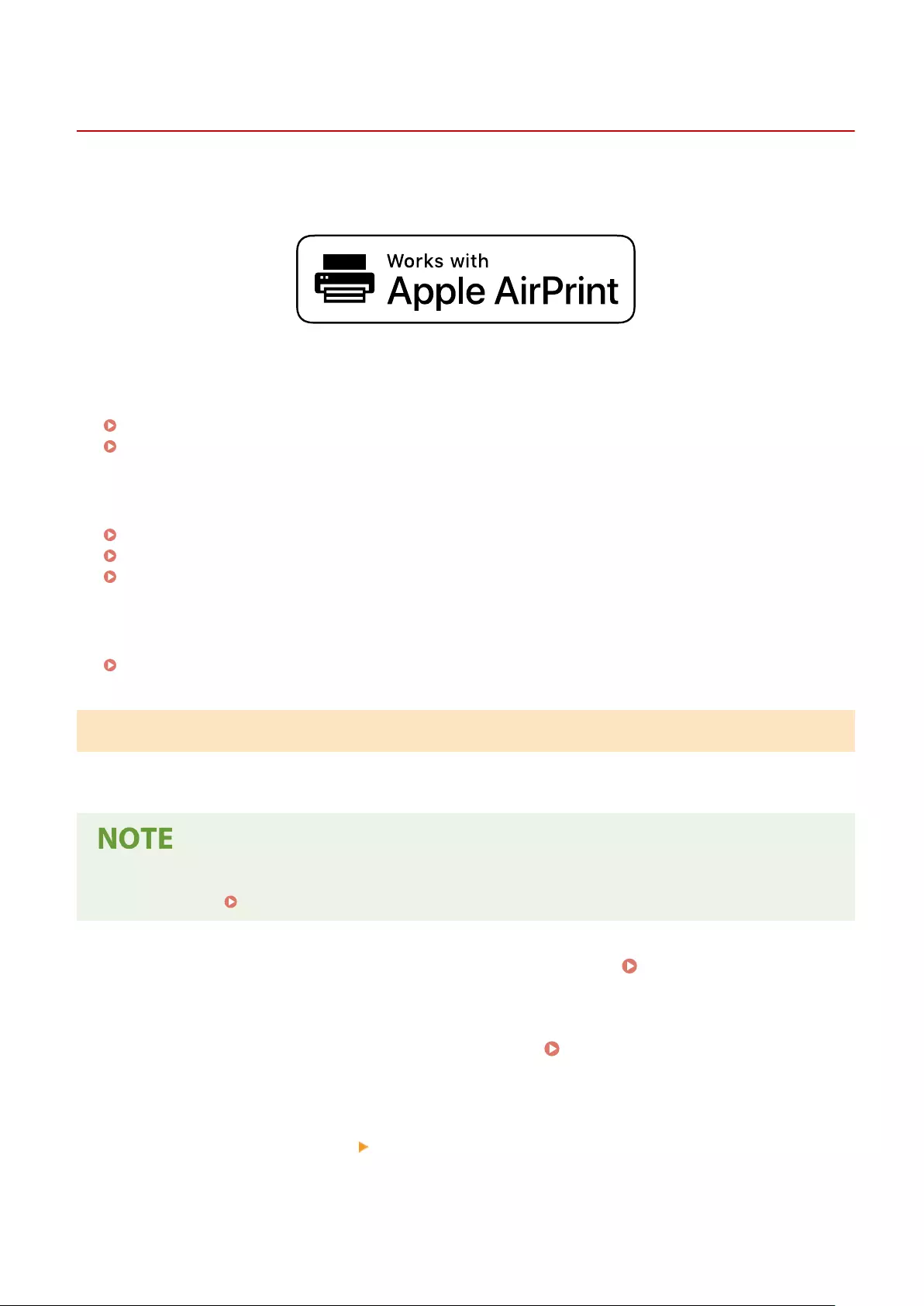
Using AirPrint
6FR5-06L
This section describes the settings required to use AirPrint and the procedures to be performed using Apple devices.
AirPrint Settings
Conguring AirPrint Settings(P. 341)
Displaying the Screen for AirPrint(P. 344)
Functions of the AirPrint
Printing with AirPrint(P. 346)
Scanning with AirPrint(P. 349)
Faxing with AirPrint(P. 351)
Troubleshooting
If AirPrint Cannot Be Used(P. 353)
Conguring AirPrint Settings
You can register information, including the name of the machine and installation location, that is used for identifying
the machine. You can also disable the AirPrint function of the machine. Use the Remote UI to change these settings.
●For more information about the basic operations to be performed when setting the machine from the
Remote UI, see Setting Up Menu Options from Remote UI(P. 437) .
1Start the Remote UI and log in to System Manager Mode. Starting Remote
UI(P. 428)
2Click [Settings/Registration] on the Portal page. Remote UI Screen(P. 429)
●If you are using a mobile device, such as an iPad, iPhone, or iPod touch, read "click" as "tap" in this section.
3Select [Network Settings] [AirPrint Settings].
Linking with Mobile Devices
341
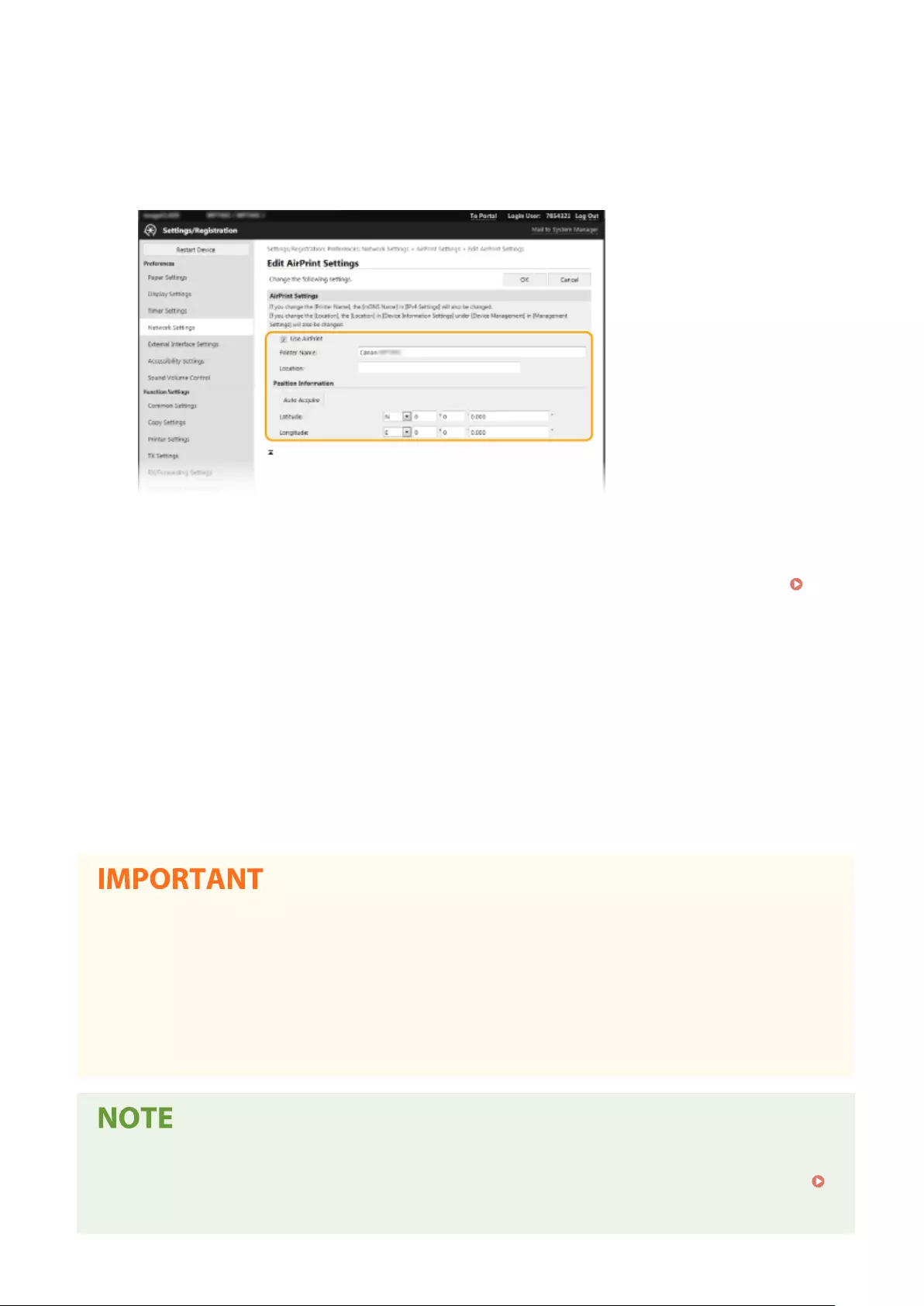
4Click [Edit].
5Specify the required settings.
[Use AirPrint]
Select the check box to enable AirPrint. To disable AirPrint, clear the check box.
[Printer Name]
Enter the name of the machine. If an mDNS name has already been registered in [mDNS Settings] (
Conguring DNS(P. 56) ), the registered name is displayed.
[Location]
Enter the location of the machine. If a location has already been registered in [Device Information Settings]
([Device Management] in [Management Settings] (Settings/Registration)), the registered name is displayed.
[Latitude]
Enter the latitude of the location where the machine is installed.
[Longitude]
Enter the longitude of the location where the machine is installed.
6Click [OK].
If you select [Use AirPrint], the following settings in <Network> are set to <On>.
●Use HTTP
●IPP Print Settings
●IPv4 Use mDNS
●IPv6 Use mDNS
●Use Network Link Scan
●If you change [Printer Name] that you have once specied, you may be unable to print any more from the
Mac that has been able to be used for printing so far. This phenomenon occurs because <mDNS Name> (
Conguring DNS(P. 56) ) of IPv4 is also changed automatically. In this case, add the machine to the Mac
again.
Linking with Mobile Devices
342
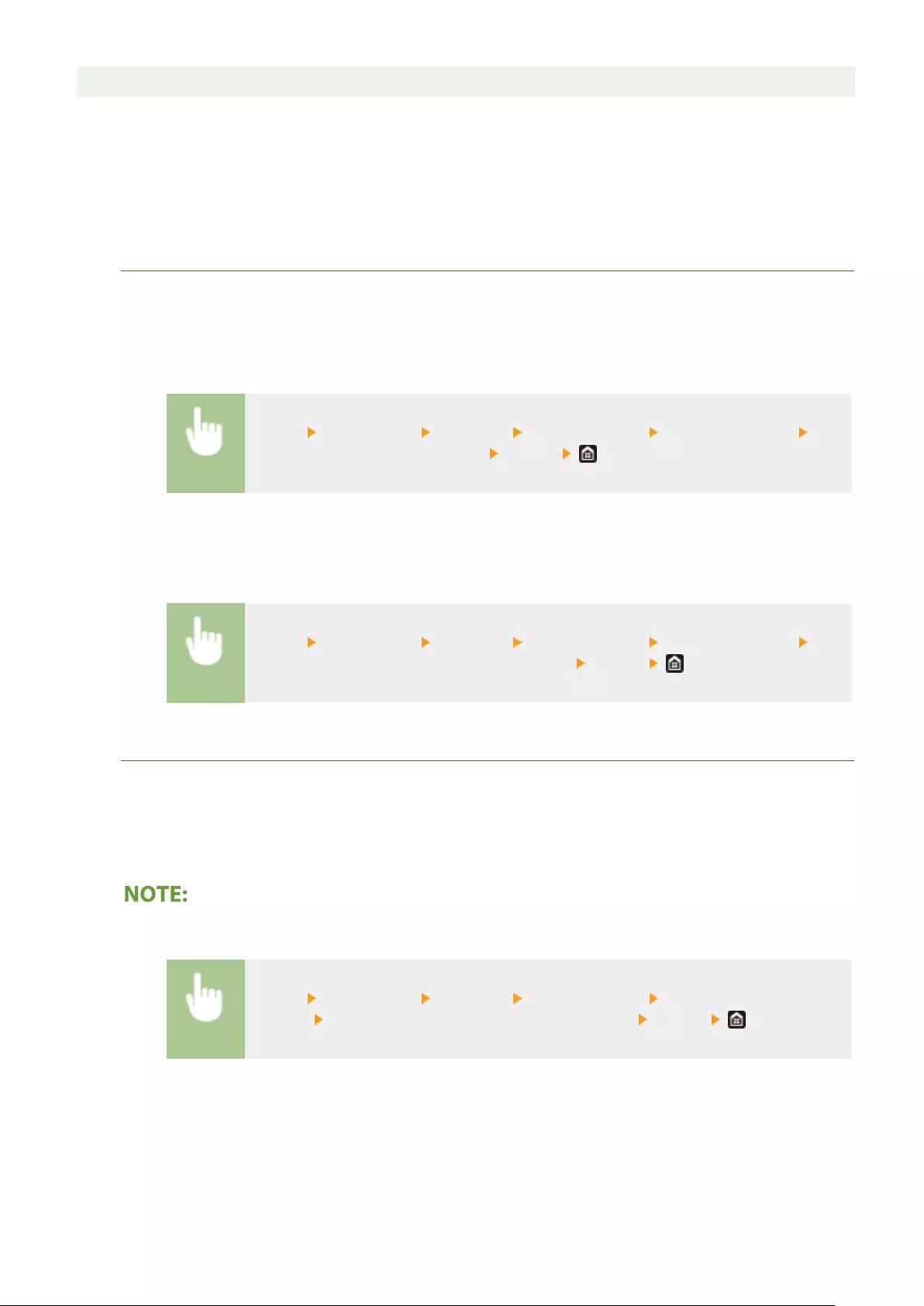
●Entering the printer name makes it easier to identify multiple printers that support AirPrint.
◼Changing the Setting of Functions Available with AirPrint
If you want to disable functions that you are not going to use with AirPrint or encrypt communications, congure the
necessary setting using the operation panel.
Changing Print and Fax Settings
To perform printing or fax sending with AirPrint, IPP protocol is used.
Turning the Function On/Off
You can specify whether to perform printing and fax sending with AirPrint. The factory default setting is <On>.
<Menu> <Preferences> <Network> <TCP/IP Settings> <IPP Print Settings> Set
<Use IPP Printing> to <Off> or <On> <Apply>
Changing the TLS Setting
You can specify whether to encrypt communications using TLS when performing printing or sending faxes with
AirPrint. The factory default setting is <Off>.
<Menu> <Preferences> <Network> <TCP/IP Settings> <IPP Print Settings> Set
<Allow IPP Printing Only w/TLS> to <Off> or <On> <Apply>
Changing the Scan Setting
Congure the scan setting using AirPrint.
Set the Function to Enable or Disable
You can turn on/off the scan function available with AirPrint. The factory default setting is <On>.
●If you set this item to <On>, <Use HTTP> under <Network> is set to <On>.
<Menu> <Preferences> <Network> <TCP/IP Settings> <Network Link Scan
Settings> Set <Use Network Link Scan> to <Off> or <On> <Apply>
Change TLS Settings
You can specify whether or not to encrypt TLS communications when scanning data using AirPrint. The factory
default setting is <Off>.
Linking with Mobile Devices
343
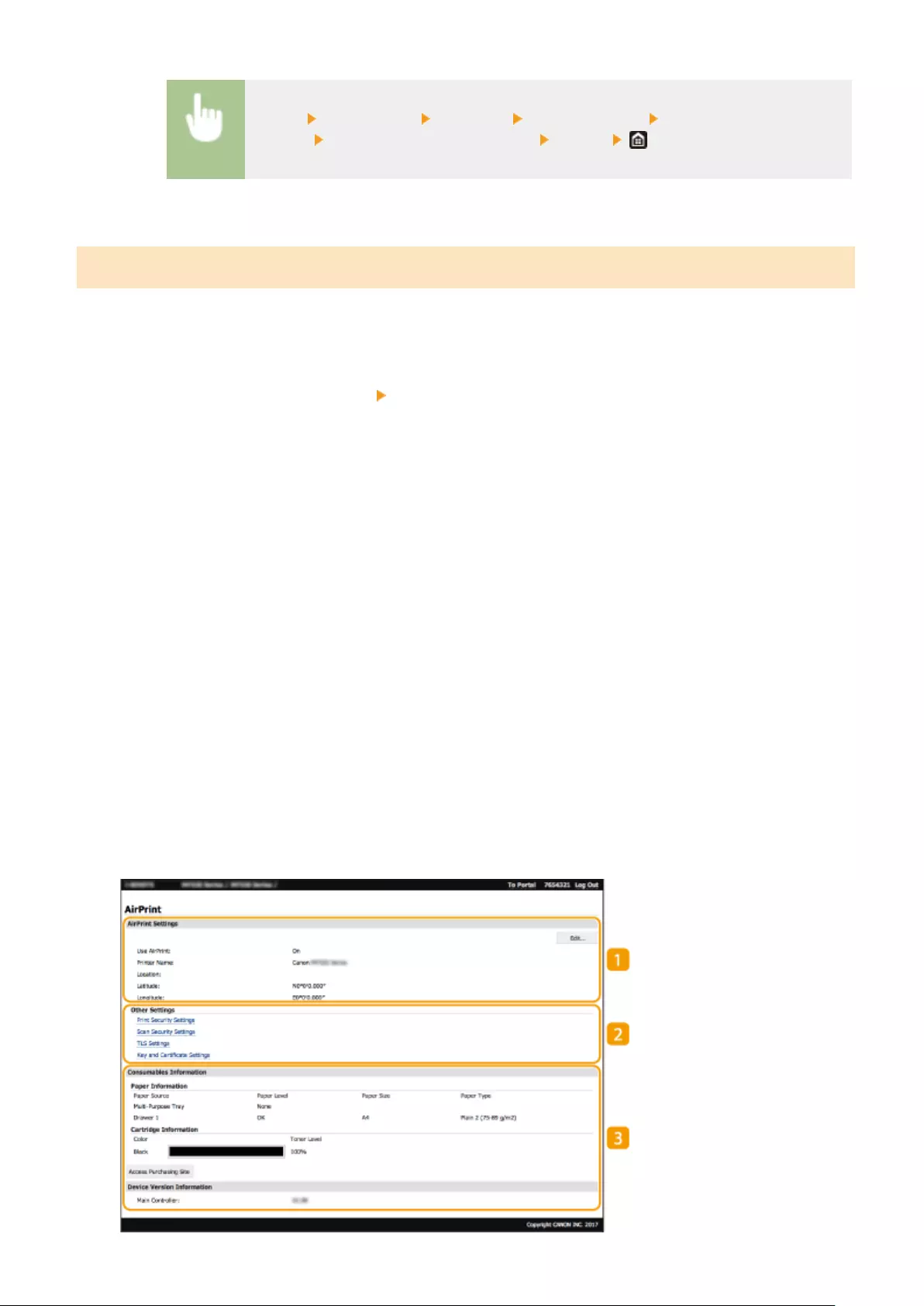
<Menu> <Preferences> <Network> <TCP/IP Settings> <Network Link Scan
Settings> Set <Use TLS> to <Off> or <On> <Apply>
Displaying the Screen for AirPrint
You can display the screen for AirPrint, on which you can not only access the AirPrint Settings but also view
information about consumables, such as paper and toner cartridge. Further, you can congure security function
settings.
1Select [System Preferences] [Printers & Scanners], then add the machine to the Mac
you are using.
●If the machine has already been added, this operation is not required.
2Select this machine from the list of printers in [Printers & Scanners].
3Click [Options & Supplies].
4Click [Show Printer Webpage].
5Log in to the Remote UI.
●To change the AirPrint settings, it is necessary to log in as an administrator.
◼AirPrint-Dedicated Page
When you log in with administrator privileges, the AirPrint-dedicated page is displayed as shown below.
Linking with Mobile Devices
344

[AirPrint Settings]
Enables you to check the values entered in the AirPrint settings, such as the name and location of the
machine. You can click [Edit] to change the settings.
[Other Settings]
[Print Security Settings]
Congure the print security settings using TLS or authentication.
[Scan Security Settings]
Congure the scan security settings using TLS.
[TLS Settings]
Enables you to change the key and certicate used for TLS. Conguring the Key and Certicate for
TLS(P. 389)
[Key and Certicate Settings]
Enables you to generate and install a key and certicate, or request a certicate to be issued.
Conguring the Key and Certicate for TLS(P. 389)
[Consumables Information]
Enables you to check the information of each paper source and consumables of the machine and the device
version.
Trademarks
Apple, Bonjour, iPad, iPhone, iPod touch, Mac, macOS, OS X and Safari are trademarks of Apple Inc., registered in the
U.S. and other countries. AirPrint and the AirPrint logo are trademarks of Apple Inc.
Linking with Mobile Devices
345
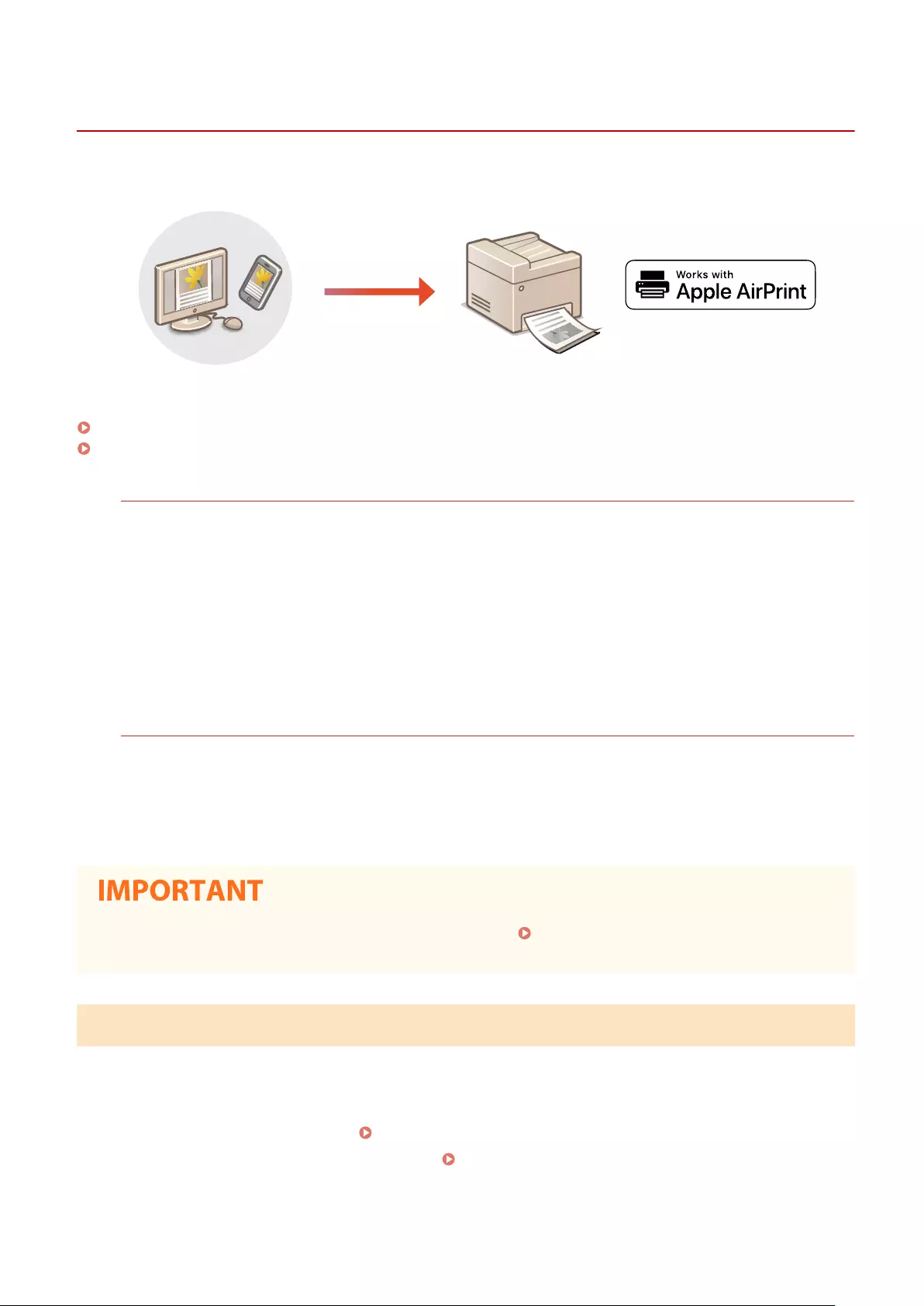
Printing with AirPrint
6FR5-06R
You can print from an iPad, iPhone, iPod touch, or Mac without using a printer driver.
Printing from an iPad, iPhone, or iPod touch(P. 346)
Printing from a Mac(P. 347)
System Requirements
One of the following Apple devices is required to print with AirPrint.
●iPad (all models)
●iPhone (3GS or later)
●iPod touch (3rd generation or later)
●Mac (Mac OS X 10.7 or later)*
*OS X v10.9 or later when using a USB connection
Network Environment
One of the following environments is required.
●An environment where an Apple device and the machine are connected to the same LAN
●An environment where an Apple device and the machine are connected directly
●An environment where a Mac is connected to the machine via USB
●For printing, it is required to set <Use IPP Printing> to <On>. Changing the Setting of Functions
Available with AirPrint(P. 343)
Printing from an iPad, iPhone, or iPod touch
1Make sure that the machine is turned ON and connected to the Apple device.
●For how to make sure of this, see Setting Up the Network Environment(P. 14) .
●For information on the Direct Connection, see Connecting Directly (Access Point Mode)(P. 336) .
Linking with Mobile Devices
346
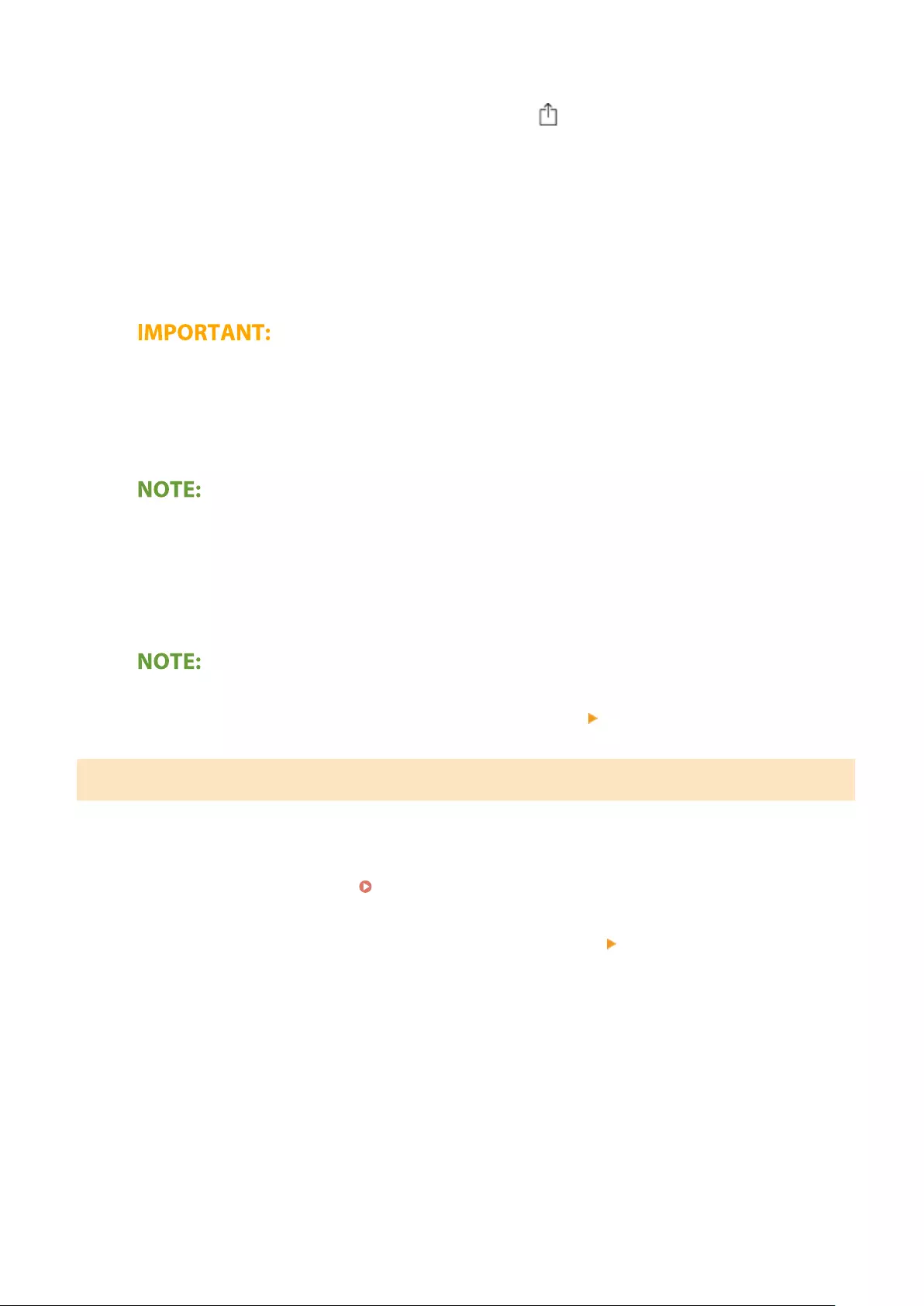
2From the application on your Apple device, tap to display the menu options.
3Tap [Print].
4Select this machine from [Printer].
●The printers connected to the network are displayed here. Select this machine in this step.
●The screen for selecting this machine in [Printer] is not displayed on applications that do not support
AirPrint. You cannot print by using those applications.
5Specify the print settings as necessary.
●The available settings and paper sizes differ depending on the application you are using.
6Tap [Print].
➠Printing starts.
Checking the print status
●During printing, press the Home button of the Apple device twice tap [Print].
Printing from a Mac
1Make sure that the machine is turned ON and connected to the Mac.
●For how to make sure of this, see Setting Up the Network Environment(P. 14) .
2Add the machine to the Mac from [System Preferences] [Printers & Scanners].
●If the machine has already been added, this operation is not required.
3Open a document in an application and display the print dialog box.
●How to display the print dialog box differs for each application. For more information, see the instruction
manual or Help for the application you are using.
4Select the machine in the print dialog box.
●The printers connected to the Mac are displayed. Select this machine in this step.
Linking with Mobile Devices
347

5Specify the print settings as necessary.
●The available settings and paper sizes differ depending on the application you are using.
6Click [Print].
➠Printing starts.
Linking with Mobile Devices
348
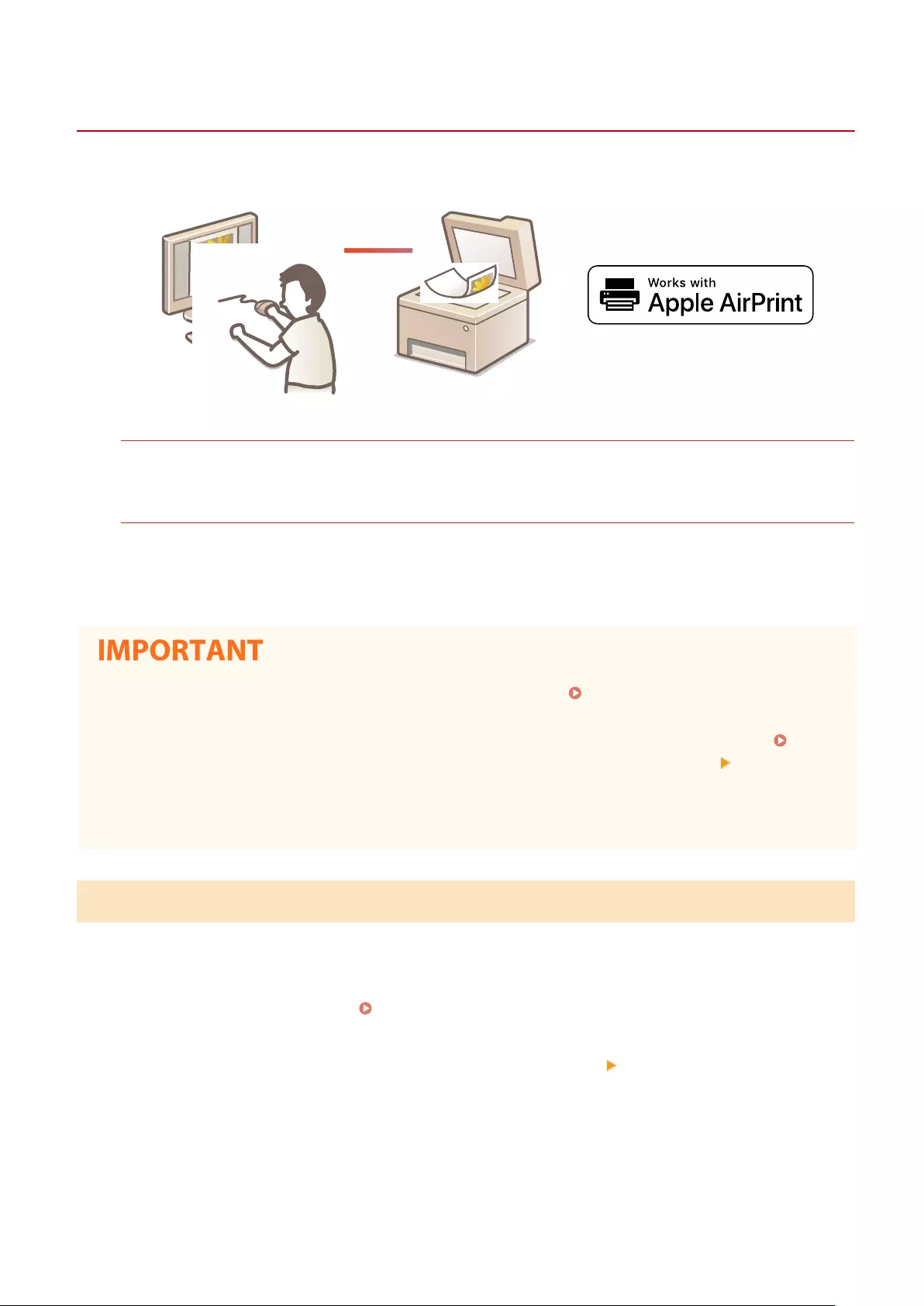
Scanning with AirPrint
6FR5-06S
You can use AirPrint to transfer the data scanned by the machine directly to a Mac.
System Requirements
To scan with AirPrint, you need a Mac with OS X 10.9 or later installed. To scan using TLS, you need a Mac with
OS X 10.11 or later installed.
Network Environment
One of the following environments is required.
●An environment where an Apple device and the machine are connected to the same LAN
●An environment where a Mac is connected to the machine via USB
●For scanning, it is required to set <Use Network Link Scan> to <On>. Changing the Setting of Functions
Available with AirPrint(P. 343)
●Before scanning, it is required to put the machine into online state. When the auto online function ( <Auto
Online>(P. 504) ) is set to <Off>, rst put the machine into online state by selecting <Scan> <Remote
Scanner>, then start the procedure for scanning.
●You cannot scan while settings for operations are being made, or while the machine is performing any
operation whatsoever.
Scanning from a Mac
1Make sure that the machine is turned ON and connected to the Mac.
●For how to make sure of this, see Setting Up the Network Environment(P. 14) .
2Add the machine to the Mac from [System Preferences] [Printers & Scanners].
●If the machine has already been added, this operation is not required.
3Select this machine from the list of printers in [Printers & Scanners].
Linking with Mobile Devices
349

4Click [Scan].
5Click [Open Scanner].
➠The [Scanner] screen is displayed.
6Congure the scan settings as necessary.
7Click [Scan].
➠The original is scanned, and the image is displayed.
Linking with Mobile Devices
350
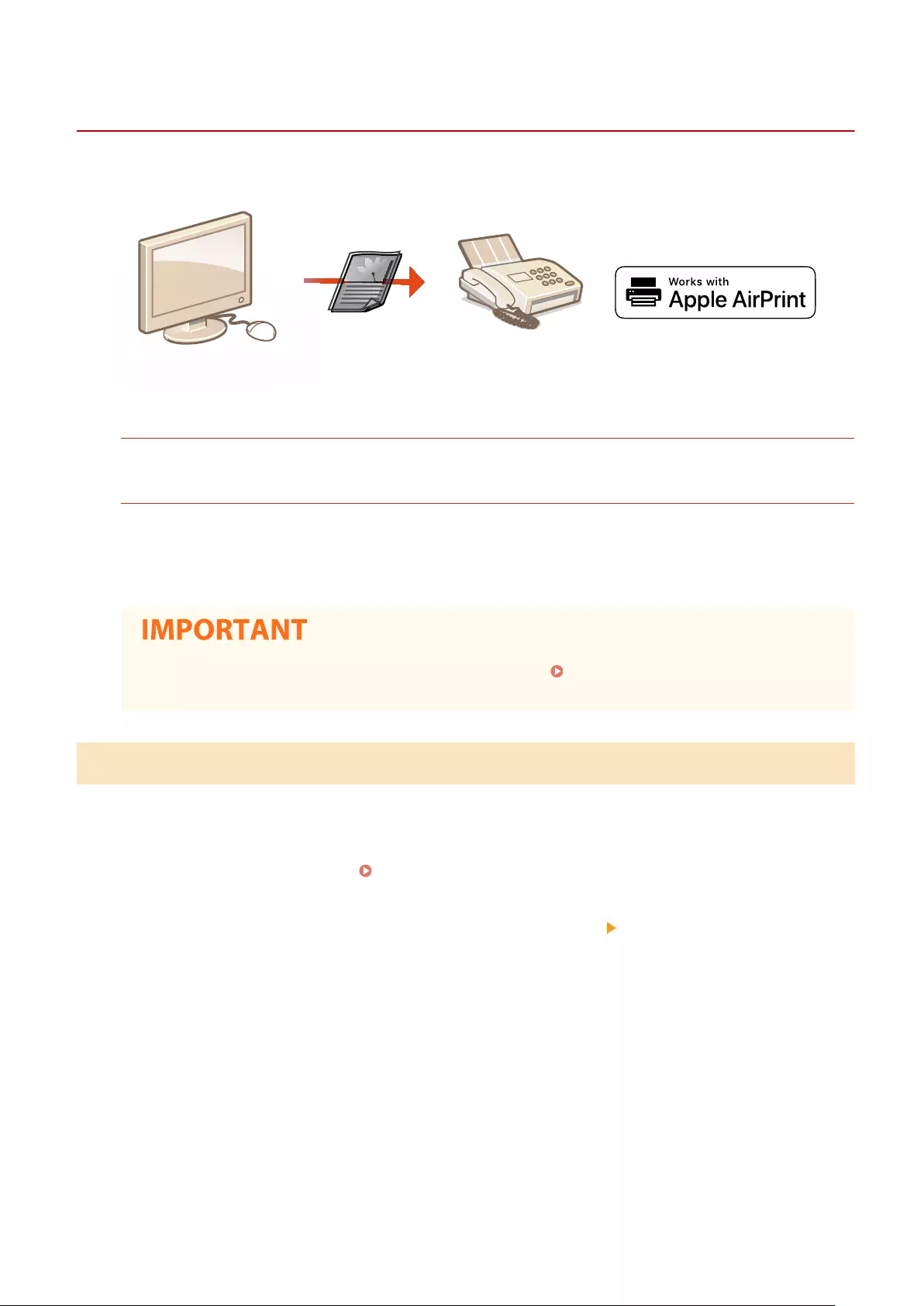
Faxing with AirPrint
6FR5-06U
You can send faxes from a Mac in almost the same way as when you print from a Mac.
System Requirements
To send faxes with AirPrint, you need a Mac with OS X 10.9 or later installed.
Network Environment
One of the following environments is required.
●An environment where an Apple device and the machine are connected to the same LAN
●An environment where a Mac is connected to the machine via USB
●For faxing, it is required to set <Use IPP Printing> to <On>. Changing the Setting of Functions
Available with AirPrint(P. 343)
Faxing from a Mac
1Make sure that the machine is turned ON and connected to the Mac.
●For how to make sure of this, see Setting Up the Network Environment(P. 14) .
2Add the machine to the Mac from [System Preferences] [Printers & Scanners].
●If the machine has already been added, this operation is not required.
3Open a document in an application and display the print dialog box.
●How to display the print dialog box differs for each application. For more information, see the instruction
manual for the application you are using.
4Select this machine in the print dialog box.
➠The printers connected to the Mac are displayed. Select the fax driver of this machine in this step.
Linking with Mobile Devices
351

5Specify the destination.
6Click [Fax].
➠Fax sending starts.
Linking with Mobile Devices
352

If AirPrint Cannot Be Used
6FR5-06W
If AirPrint cannot be used, try taking the following solutions.
●Make sure that the machine is turned ON. If the machine is turned ON, rst turn it OFF, then wait for at least 10
seconds and then turn it back ON to check if the problem is solved.
●Make sure that no error messages are displayed on the machine.
●Make sure that Apple devices and the machine are connected to the same LAN. If the machine is turned ON, it may
take several minutes before the machine is ready for communication.
●Make sure that Bonjour on your Apple device is enabled.
●Make sure that the machine is congured to enable execution of jobs from a computer even when no department
ID and password are entered. Blocking Jobs When Department ID Is Unknown(P. 369)
●For printing, make sure that the paper is loaded in the machine and that the machine contains a sucient amount
remaining in the toner cartridges. Displaying the Screen for AirPrint(P. 344)
●For scanning, make sure that the machine's setting for Network Link Scan is <On>. Changing the Setting of
Functions Available with AirPrint(P. 343)
Linking with Mobile Devices
353
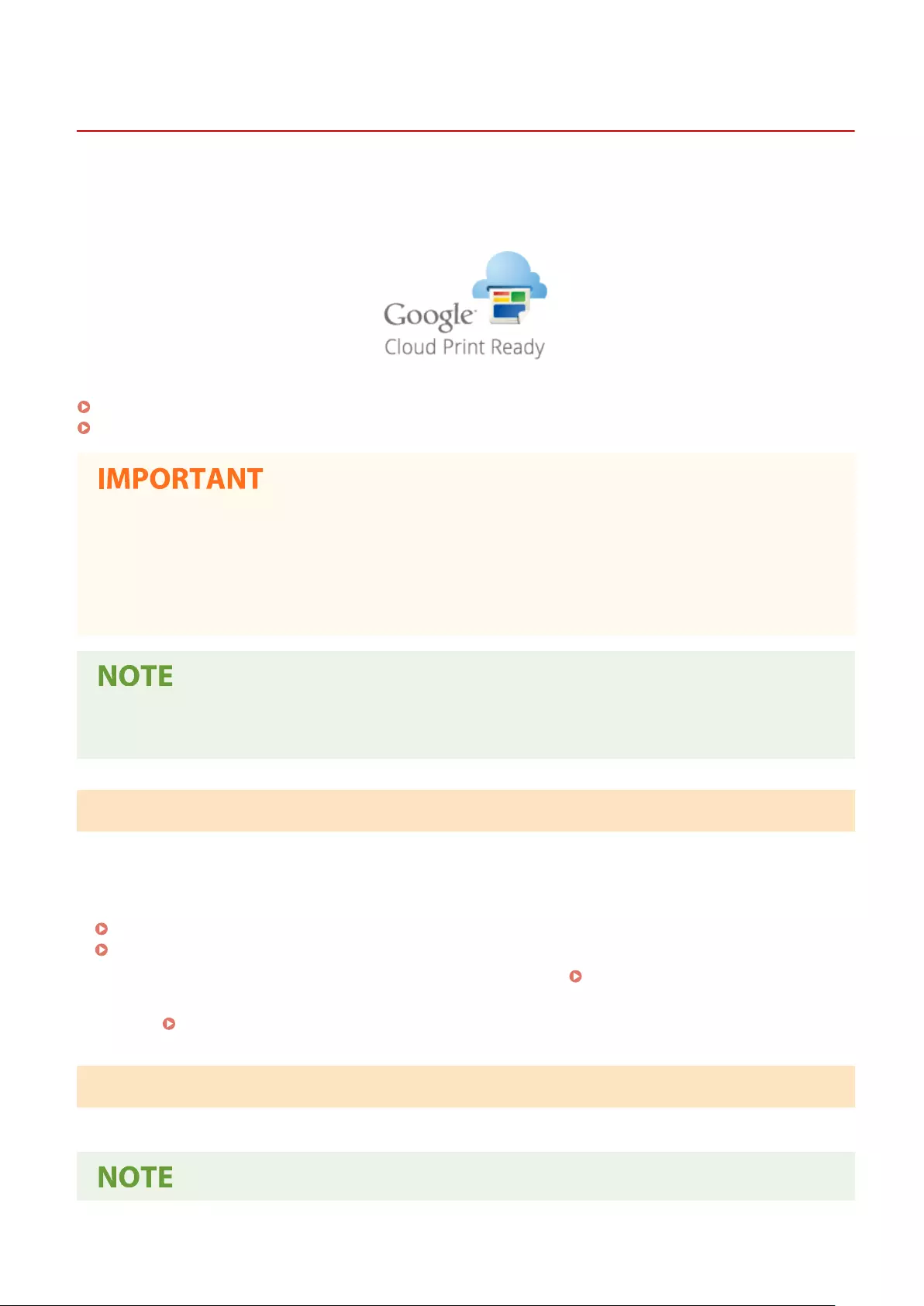
Using Google Cloud Print
6FR5-06X
Google Cloud Print is a service that enables a user with a Google account to print from a smartphone, tablet, or
computer connected to the Internet using applications compatible with Google Cloud Print. Unlike conventional
printing from a computer, it does not require a printer driver.
Checking the Settings of the Machine(P. 354)
Registering the Machine with Google Cloud Print(P. 354)
●An environment in which you can connect to the internet is required when registering the machine and
when printing using Google Cloud Print. In addition, the customer is responsible for any fees regarding
internet connection.
●Google Cloud Print may not be available, depending on your country or region.
●Google Cloud Print does not support printing from an IPv6 address.
●A Google account is required to use Google Cloud Print. If you do not have a Google account, create one on
the Google website.
Checking the Settings of the Machine
Check the following before conguring cloud printing.
●Make sure that the IPv4 address is specied for the machine, and that the machine is able to communicate with
computers on a network.
Connecting to a Wired LAN(P. 17)
Connecting to a Wireless LAN(P. 18)
●Check whether the date and time of the machine are specied correctly. Setting the Date/Time(P. 12)
●If Department ID Management is set, make sure that you can print from a computer without entering a Department
ID or PIN. Blocking Jobs When Department ID Is Unknown(P. 369)
Registering the Machine with Google Cloud Print
Registering the machine with Google Cloud Print enables you to print from anywhere using the service.
Linking with Mobile Devices
354
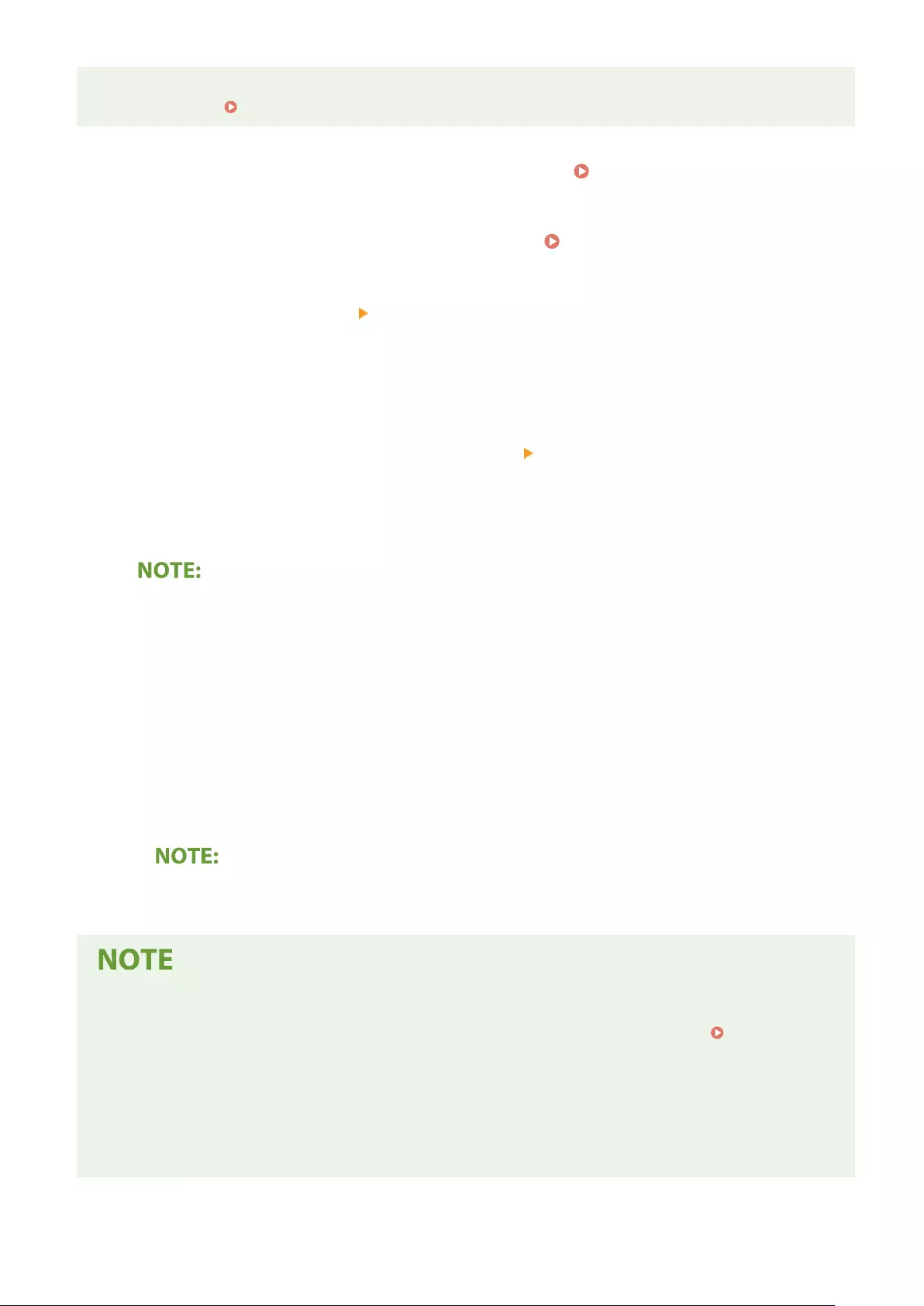
●For more information about the basic operations to be performed when setting the machine from the
Remote UI, see Setting Up Menu Options from Remote UI(P. 437) .
1Start the Remote UI and log in as an administrator. Starting Remote UI(P. 428)
2Click [Settings/Registration] on the Portal page. Remote UI Screen(P. 429)
3Select [Network Settings] [Google Cloud Print Settings].
4Click [Edit] for [Basic Settings].
5Select the [Use Google Cloud Print] check box [OK].
6Click [Register] in [Registration Status].
Re-Registering the Machine
●To re-register the machine, delete its registration before registering it again.
7Click the URL link displayed for [URL for Registration].
8Follow the instructions on the screen to register the machine.
➠Printing can now be performed from applications that support Google Cloud Print, such as Google
Chrome™.
●For information on the latest applications that support Google Cloud Print, check the Google Cloud
Print home page.
Conguring Settings on the Operation Panel
●You can also enable or disable the Cloud Print function from <Menu> in the Home screen. <Google Cloud
Print Settings>(P. 485)
Registering from a Mobile Device or Google Chrome
●You can register the machine from a mobile device or Google Chrome. The machine's display shows the
conrmation screen before completion of the registration. Press <Yes> to complete the registration.
●For information on registration methods, see the manual of your device or the Google Cloud Print website.
Linking with Mobile Devices
355
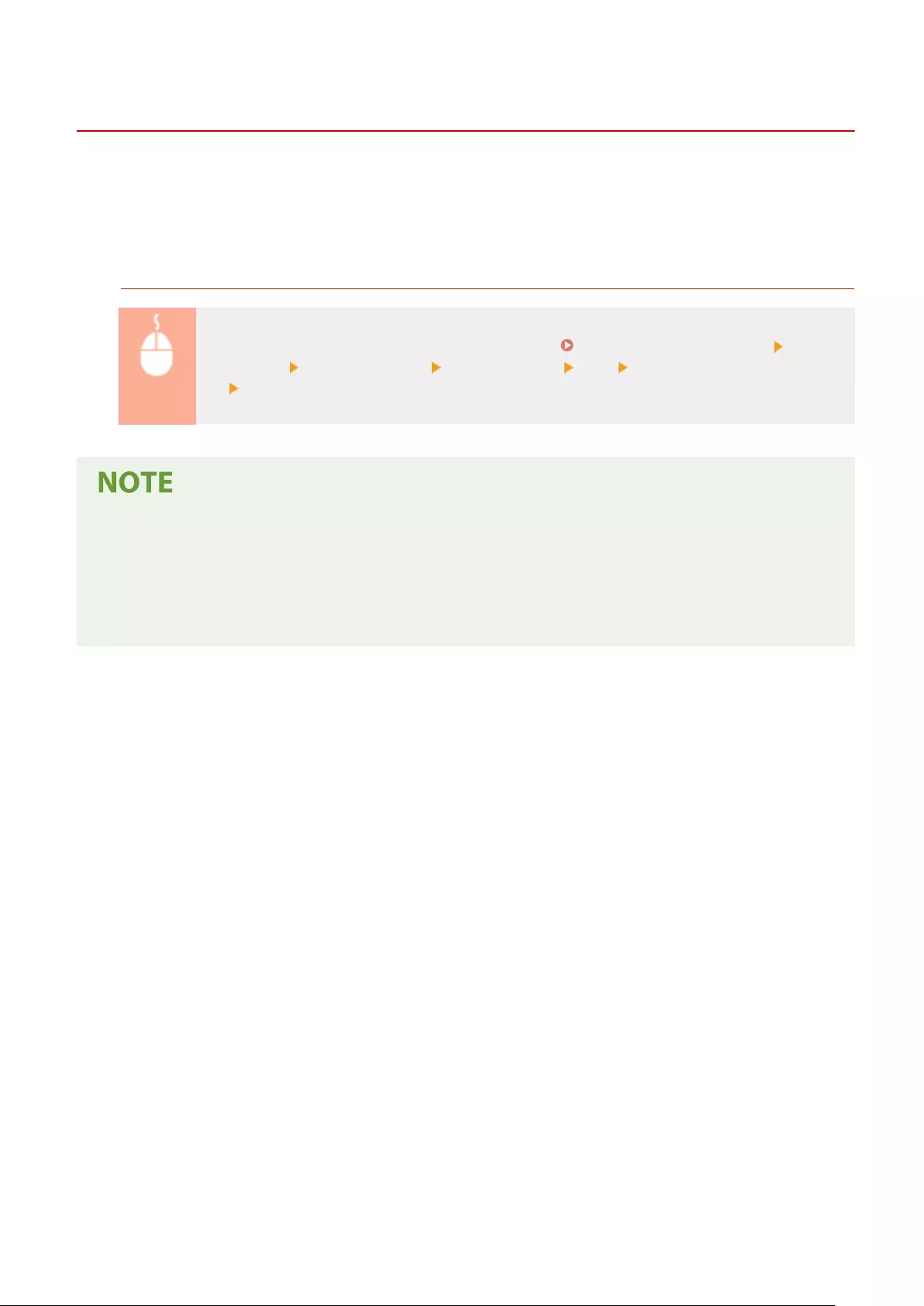
Printing with Default Print Service (Android)
6FR5-06Y
If your Android terminal supports Default Print Service, you can print from the Default Print Service of your Android
terminal.
To print on the machine using Default Print Service, it is necessary to enable Mopria® settings.
Conrming Mopria®settings
Log in to the Remote UI with Administrator privileges ( Starting Remote UI(P. 428) ) [Settings/
Registration] [Network Settings] [Mopria Settings] [Edit] select the [Use Mopria] check
box [OK]
●In order to use the Canon machine/printer from the Default Print Service of your Android terminal, you must
rst congure the following settings on your Android terminal.
●Enable Default Print Service.
●Disable or uninstall Mopria®.
●Disable or uninstall Canon Print Service.
Linking with Mobile Devices
356
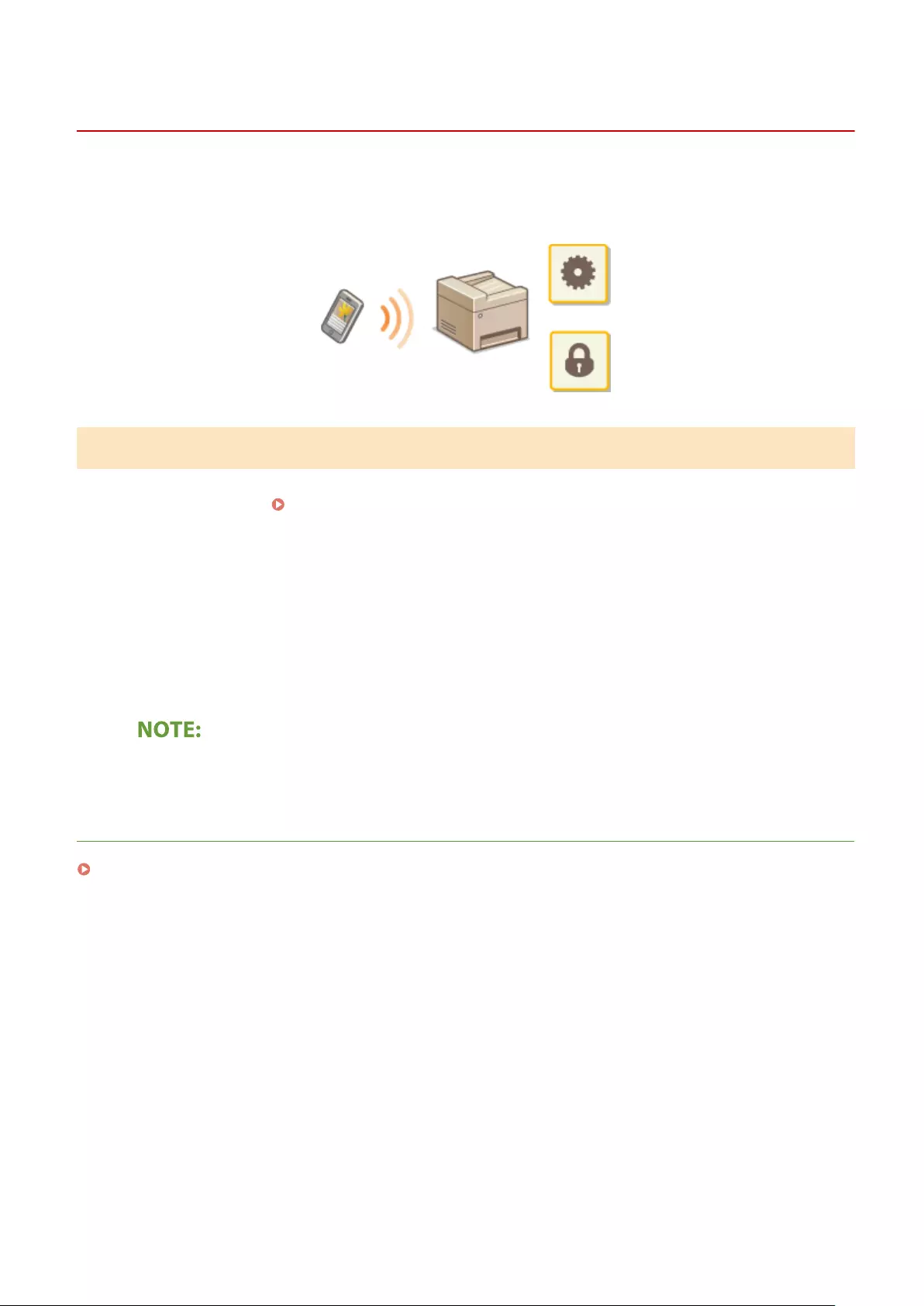
Managing the Machine by the Remote Control
6FR5-070
You can use the Remote UI from a smart phone or tablet Web browser. You can conrm the machine status or
perform various settings from a mobile device. Note that the Remote UI screen may not be displayed properly for
some devices and environments.
Starting the Remote UI from Mobile Devices
Enter the IP address of the machine on the Web browser to start the Remote UI. Prior to operation, conrm the IP
address set for the machine ( Viewing Network Settings(P. 38) ). If it is unknown, ask your network administrator.
1Start the Web browser of the mobile device.
2Enter "http://<the IP address of the machine>/" in the address entry column.
●If you want to use an IPv6 address, enclose the IPv6 address with brackets.
Example: http://[fe80:2e9e:fcff:fe4e:dbce]/
●For a "Smartphone Version" of the Remote UI, a portion of items displayed are omitted. If you want to
conrm all of the items, see the "PC Version."
LINKS
Managing the Machine from a Computer (Remote UI)(P. 427)
Linking with Mobile Devices
357

Managing the Machine
Managing the Machine ............................................................................................................................... 360
Setting Access Privileges .................................................................................................................................. 362
Setting the System Manager ID and PIN ...................................................................................................... 363
Setting the Department ID Management ..................................................................................................... 365
Setting a Remote UI PIN ............................................................................................................................... 371
LDAP Server Authentication .......................................................................................................................... 373
Conguring the Network Security Settings .................................................................................................... 377
Restricting Communication by Using Firewalls ............................................................................................. 379
Specifying IP Addresses for Firewall Settings ......................................................................................... 380
Specifying MAC Addresses for Firewall Settings ..................................................................................... 383
Changing Port Numbers ............................................................................................................................... 386
Setting a Proxy ............................................................................................................................................. 387
Conguring the Key and Certicate for TLS .................................................................................................. 389
Generating the Key and Certicate for Network Communication .......................................................... 392
Generating a Key and Certicate Signing Request (CSR) ........................................................................ 395
Registering the Key and Certicate for Network Communication .......................................................... 398
Conguring IPSec Settings ........................................................................................................................... 400
Conguring IEEE 802.1X Authentication Settings ......................................................................................... 407
Restricting the Machine's Functions ................................................................................................................ 411
Restricting Access to Address Book and Sending Functions ......................................................................... 413
Restricting Use of the Address Book ...................................................................................................... 414
Limiting Available Destinations .............................................................................................................. 416
Restricting the Fax Sending Functions ................................................................................................... 418
Restricting Printing from a Computer ........................................................................................................... 420
Restricting USB Functions ............................................................................................................................. 421
Disabling HTTP Communication ................................................................................................................... 423
Disabling Remote UI ..................................................................................................................................... 424
Increasing the Security of Documents ............................................................................................................. 425
Generating a Device Signature Key ............................................................................................................... 426
Managing the Machine from a Computer (Remote UI) ................................................................................... 427
Starting Remote UI ....................................................................................................................................... 428
Checking the Status and Logs ....................................................................................................................... 431
Setting Up Menu Options from Remote UI ................................................................................................... 437
Registering Destinations from Remote UI .................................................................................................... 440
Security Policy .............................................................................................................................................. 444
Managing the Machine
358

Importing/Exporting the Setting Data .......................................................................................................... 450
Updating the Firmware ..................................................................................................................................... 453
Initializing Settings ........................................................................................................................................... 455
Managing the Machine
359
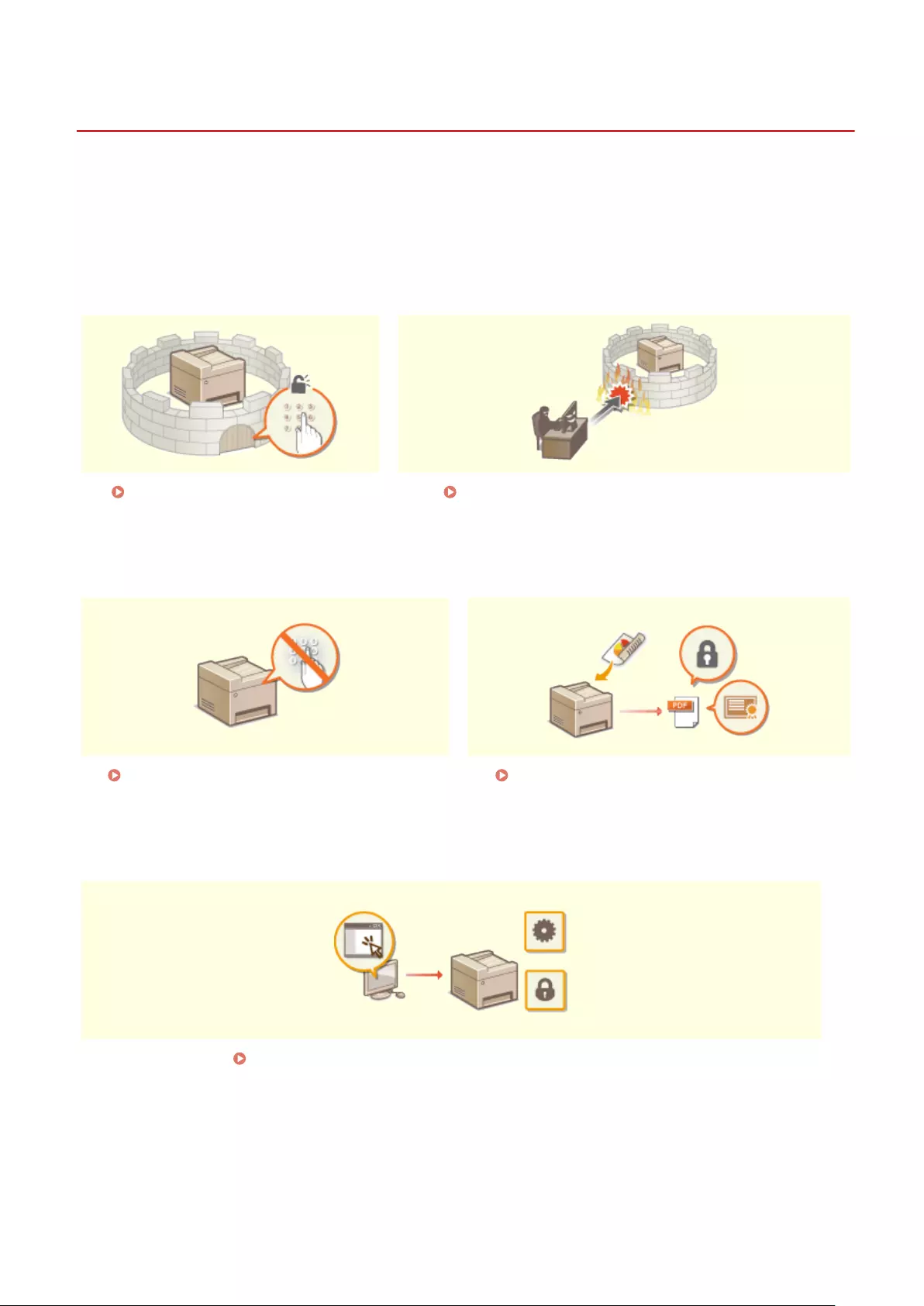
Managing the Machine
6FR5-071
To reduce the various risks associated with the use of this machine, such as leaks of personal information or
unauthorized use by third parties, constant and effective security measures are required. An administrator should
manage important settings, such as access privileges and security settings, to ensure that the machine is used safely.
◼Conguring the Basic Management System
Setting Access Privileges(P. 362) Conguring the Network Security Settings(P. 377)
◼Preparing for Risks from Negligence or Misuse
Restricting the Machine's Functions(P. 411) Increasing the Security of Documents(P. 425)
◼Ensuring Effective Management
Managing the Machine from a Computer (Remote UI)(P. 427)
Managing the Machine
360
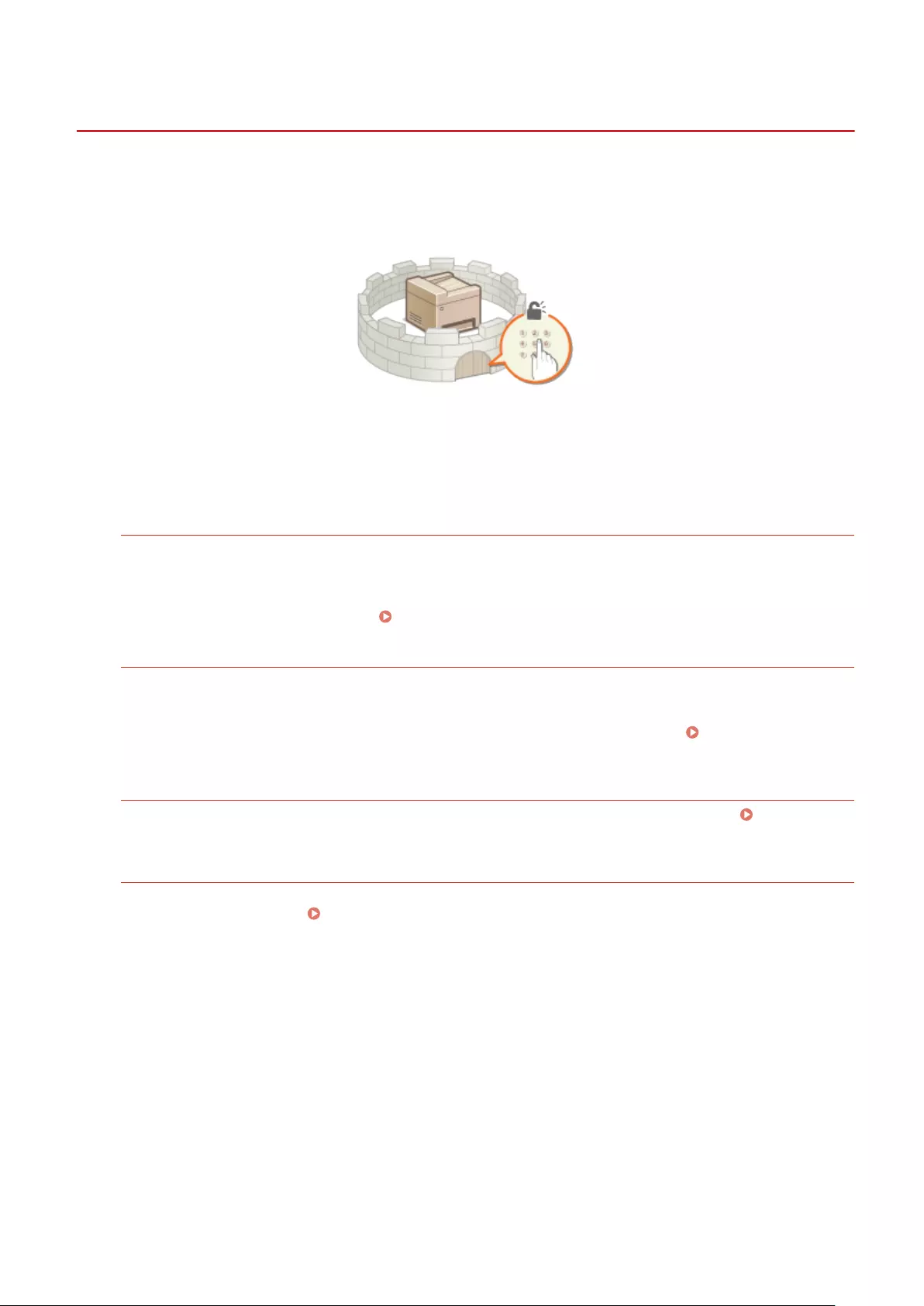
Setting Access Privileges
6FR5-072
Protect the machine from unauthorized access by only allowing users with access privileges to use the machine.
Access privileges are set separately for system administrators, general users, and the Remote UI. When privileges are
set, the user must enter an ID and PIN to print or change settings.
Set up an account with full access privileges called "System Manager ID" for a system manager. Registering an account
called "Department ID" allows you to manage general users. Using a Department ID, you can set a PIN for using this
machine as well as keep track of the number of pages printed for each department ID. And by setting a Remote UI
Access PIN, you can restrict use of the Remote UI.
System Manager ID
System Manager ID is an account with full access privileges. If you specify a System Manager ID, you need to
log on to the machine using the System Manager ID information in order to access items that requires
administrator privileges such as <Network> and <Management Settings>. We recommend that you set and
register the System Manager ID. Otherwise, anyone will be able to change the machine settings. Only one
System Manager ID can be registered. Setting the System Manager ID and PIN(P. 363)
Department ID (Department ID Management)
You can specify access privileges for a user (or group of users) by registering a Department ID. You can register
multiple Department IDs. If a user tries to operate the machine when Department IDs are enabled, a login
screen is displayed, and the user must enter their own Department ID and PIN to use the machine. Information
such as how many pages have been printed for each Department ID can be compiled. Setting the
Department ID Management(P. 365)
Remote UI PIN (Remote UI Access PIN)
This is a PIN for using the Remote UI. Only users who know the PIN can access the Remote UI. Setting a
Remote UI PIN(P. 371)
Authentication Settings for Send Function (Authorized Send)
If your system has an LDAP server installed, you can set LDAP server authentication to be carried out when the
fax or scan function is used. LDAP Server Authentication(P. 373)
Managing the Machine
362
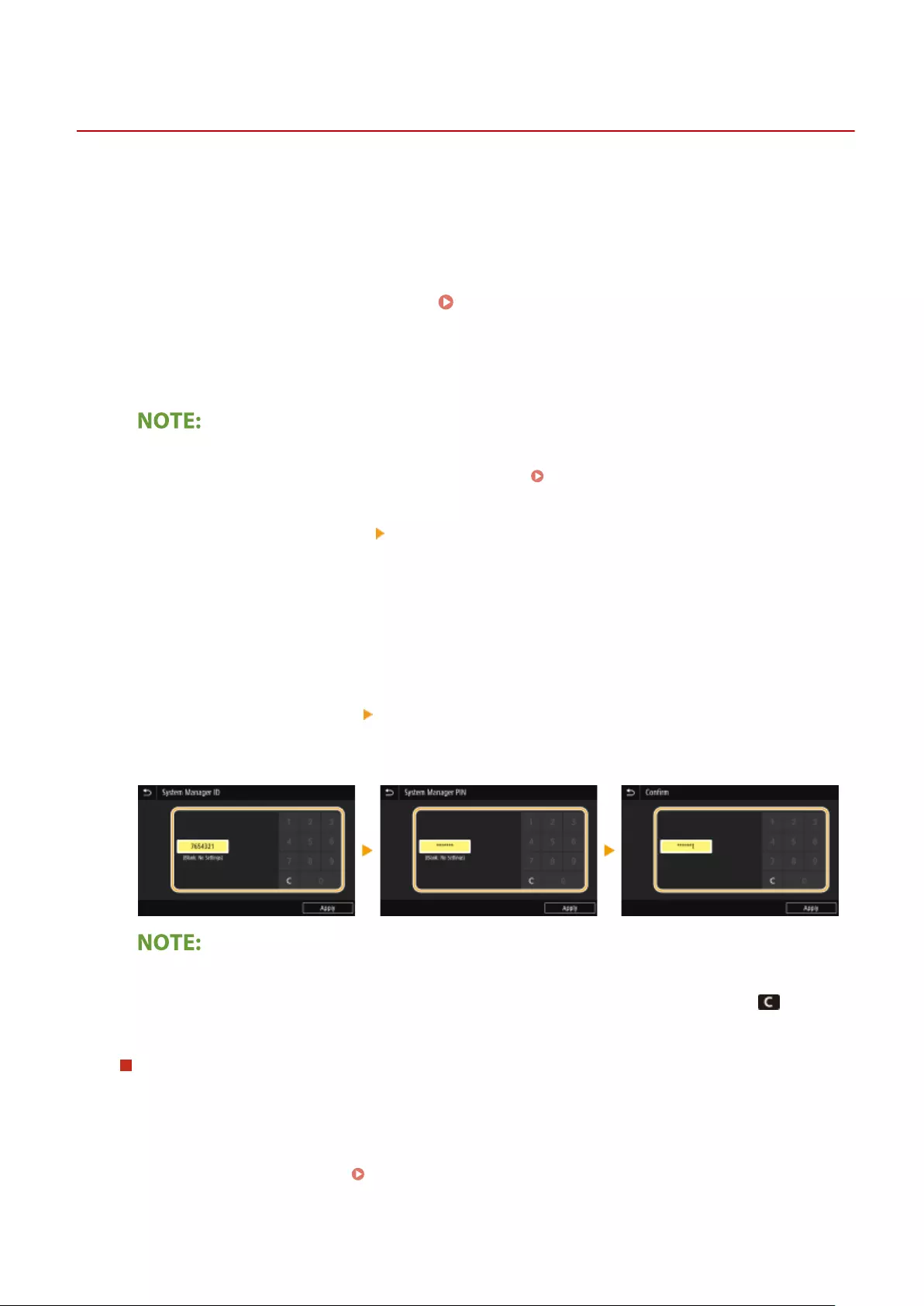
Setting the System Manager ID and PIN
6FR5-073
Set the system manager account, "System Manager ID." You can also set a PIN for the System Manager ID. If the
System Manager ID is specied, you can access items that require administrator privileges, for example, <Network>
and <Management Settings>, only when the System Manager ID and PIN have been entered correctly. The System
Manager ID settings information is critical to the security of the machine, so make sure that only Administrators know
the System Manager ID and PIN.
1Select <Menu> in the Home screen. Home Screen(P. 124)
2Select <Management Settings>.
If the System Manager ID has already been set
●If the login screen appears, enter the correct ID and PIN. Logging in to the Machine(P. 135)
3Select <User Management> <System Manager Information Settings>.
4Select <System Manager ID and PIN>.
5Specify the System Manager ID and PIN.
●Specify the <System Manager ID> <System Manager PIN>.
●Enter numbers for each item, and select <Apply>.
●The Conrm screen is displayed. Enter the PIN once again to conrm.
●You cannot register an ID or PIN that consists only of zeros, such as "00" or "0000000."
●To cancel the System Manager ID and PIN settings, clear the information you entered in and select
<Apply> with the elds blank.
Setting the System Manager Name
1Select <System Manager Name>.
2Enter the System Manager Name, and select <Apply>.
●On how to enter text, see Entering Text(P. 133) .
Managing the Machine
363
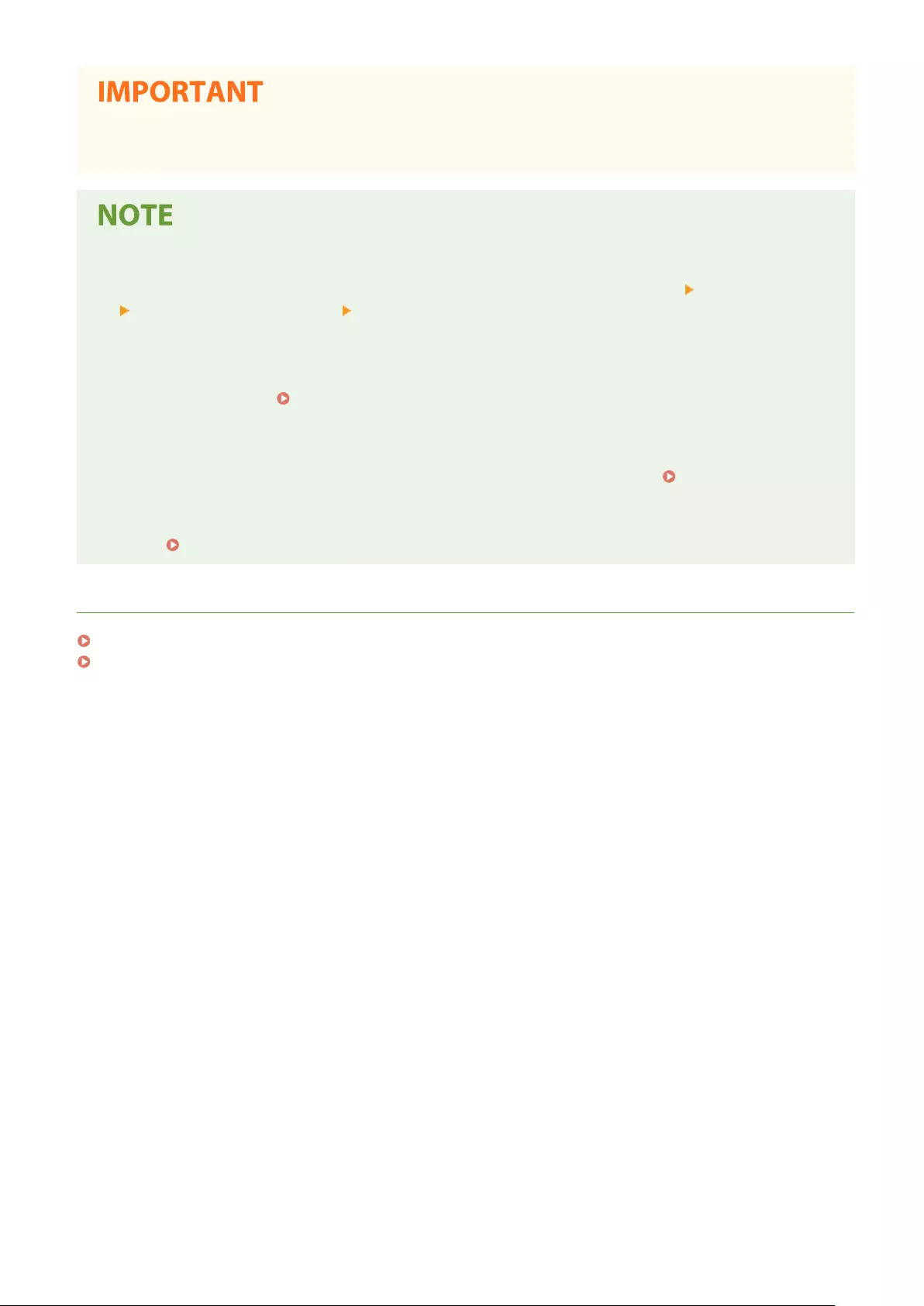
●Do not forget your PIN. If you forget your PIN, contact your local authorized Canon dealer or the Canon help
line.
Conguring settings via the Remote UI
●Start the Remote UI and log in to System Manager Mode. Click [Settings/Registration] [User Management]
[System Manager Information] [Edit] and specify the necessary settings on the displayed screen.
●By using the Remote UI, you can register a variety of information, including contact information,
Administrator comments, the installation location of the machine, as well as the settings that you can
register by using the operation panel. The registered information can be viewed on the [Device Information]
page of the Remote UI. Checking System Manager Information(P. 434)
Logging in to the machine
●If you try to access items that require administrator privileges, for example, <Network> and <Management
Settings>, when the System Manager ID is specied, the Login screen is displayed. Logging in to the
Machine(P. 135)
●You must also enter the System Manager ID and PIN to log in using the Remote UI in System Manager
Mode. Starting Remote UI(P. 428)
LINKS
Setting Access Privileges(P. 362)
Setting the Department ID Management(P. 365)
Managing the Machine
364
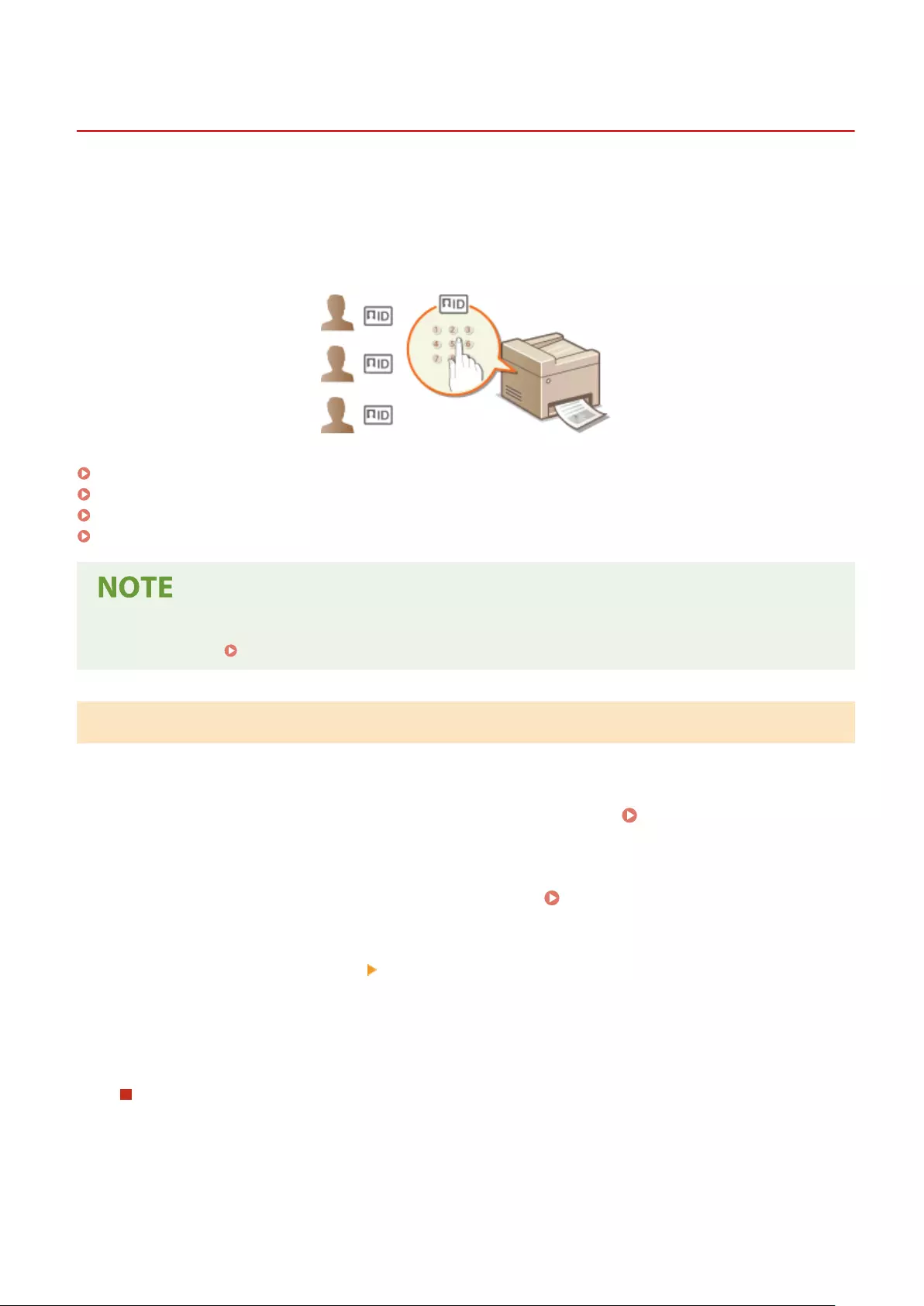
Setting the Department ID Management
6FR5-074
You can control access to the machine by using multiple IDs for multiple users or groups. If a user tries to operate the
machine when Department ID Management is enabled, a login screen is displayed, and the user must enter their own
Department ID and PIN to use the machine. When Department ID Management is enabled, usage of functions, such as
printing, is recorded for each Department ID. To congure Department ID Management, register department IDs as
necessary and then enable Department ID Management function. When you want to enable Department ID
Management for jobs from a computer, you need to congure additional settings on the computer side.
Registering/Editing Department ID and PIN(P. 365)
Enabling the Department ID Management(P. 367)
Enabling the Department ID Management for Jobs from a Computer(P. 368)
Blocking Jobs When Department ID Is Unknown(P. 369)
●For more information about the basic operations to be performed when setting the machine from the
Remote UI, see Setting Up Menu Options from Remote UI(P. 437) .
Registering/Editing Department ID and PIN
Register a Department ID and set a PIN for it. Register all the department IDs to be managed.
1Start the Remote UI and log in to System Manager Mode. Starting Remote
UI(P. 428)
2Click [Settings/Registration] on the Portal page. Remote UI Screen(P. 429)
3Select [User Management] [Department ID Management].
4Register or edit Department IDs.
Registering a Department ID
1Click [Register New Department].
2Specify the required settings.
Managing the Machine
365
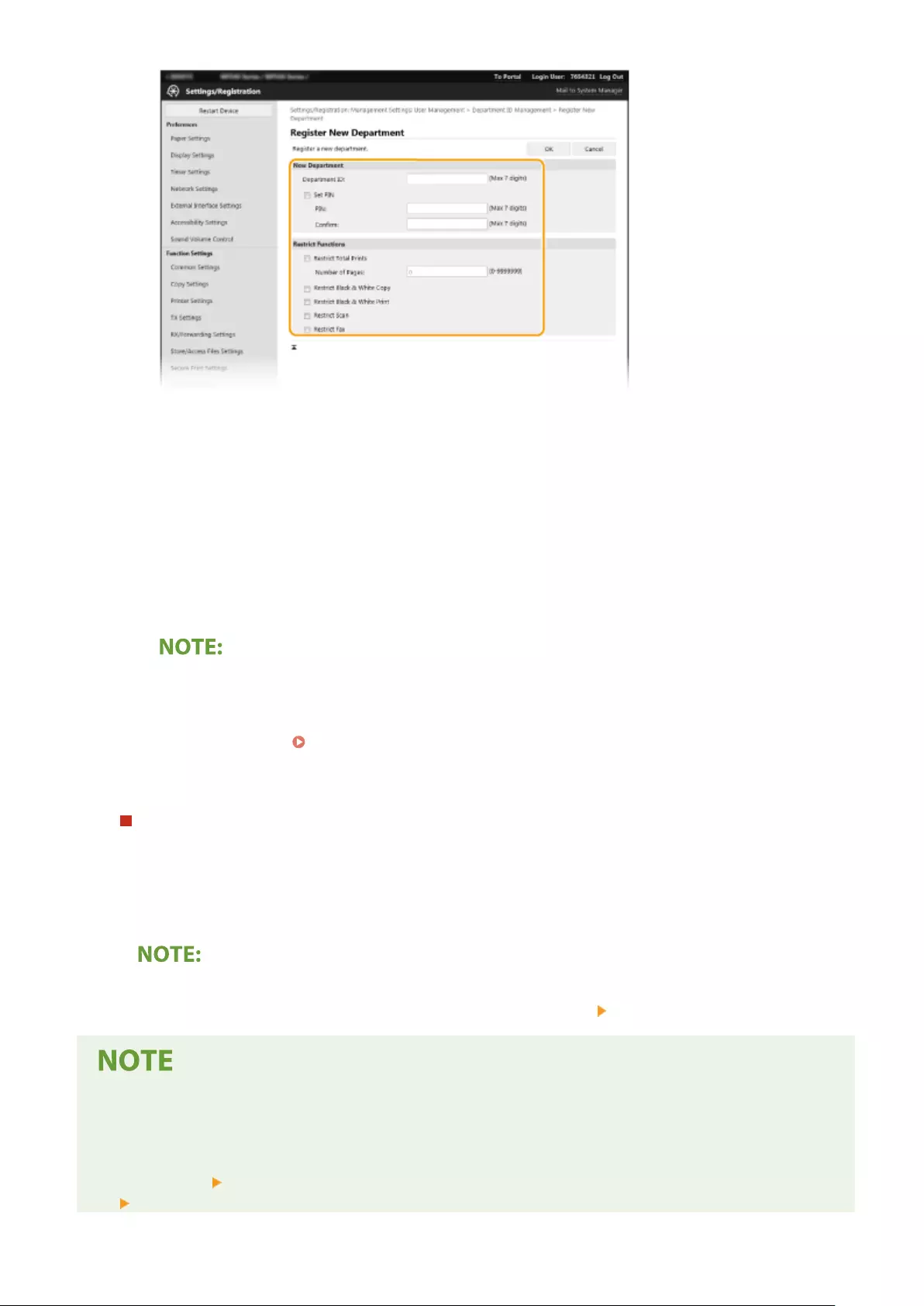
[Department ID]
Enter the Department ID number to be registered.
[Set PIN]
To set a PIN, select the check box and enter the same number both in the [PIN] and [Conrm] text boxes.
[Restrict Functions]
You can restrict the number of pages to print and the available functions for departments to be
registered. To restrict the number of pages to print, select the check box for the target type, and enter
the appropriate number of pages in [Number of Pages]. Select the check box for the target functions to
restrict functions.
●If the [Restrict Scan] check box is selected, the Save to USB Memory Device, Send E-mail, and Save to
Shared Folder or FTP Server functions are all restricted. You can also restrict other methods that scan
documents by importing them to a computer, but in that case you cannot block access for each
Department ID ( Blocking Jobs When Department ID Is Unknown(P. 369) ).
3Click [OK].
Editing the settings of the registered Department ID
1Click the corresponding text link under [Department ID] to edit.
2Change the settings as necessary and click [OK].
Deleting a Department ID
●Click [Delete] on the right of the Department ID you want to delete click [OK].
[Department ID Page Total]
●You can check the total number of pages for jobs that have been executed to date on a department ID basis.
●If you want to return the counts to zero, click the corresponding text link under [Department ID] and click
[Clear Count] [OK]. If you want to return the counts of all Department IDs to zero, click [Clear All Counts]
[OK].
Managing the Machine
366
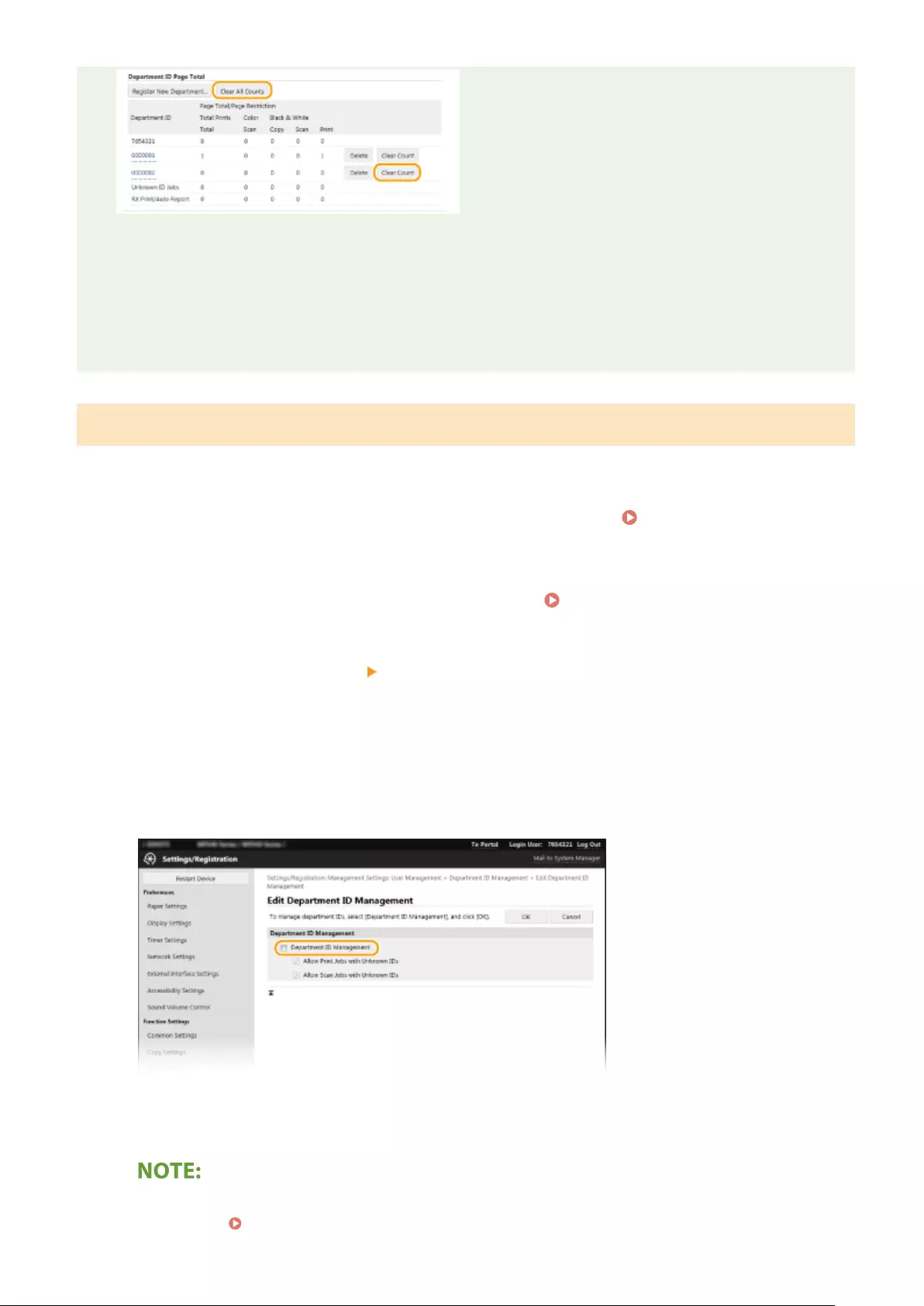
Using control cards
●When the optional Copy Card Reader-F is attached to the machine, Department IDs will be registered
automatically.
●Do not delete the registered department IDs. The control cards that correspond to the deleted department
IDs will become unavailable.
●You cannot use [Restrict Functions] to restrict the allowable number of pages to print.
Enabling the Department ID Management
After you register as many Department IDs as necessary, enable Department ID Management.
1Start the Remote UI and log in to System Manager Mode. Starting Remote
UI(P. 428)
2Click [Settings/Registration] on the Portal page. Remote UI Screen(P. 429)
3Select [User Management] [Department ID Management].
4Click [Edit].
5Select the [Department ID Management] check box.
[Department ID Management]
Select the check box to enable Department ID Management. If you do not want to use Department ID
Management, clear the check box.
●For information about the [Allow Print Jobs with Unknown IDs]/[Allow Scan Jobs with Unknown IDs] check
boxes, see Blocking Jobs When Department ID Is Unknown(P. 369) .
Managing the Machine
367
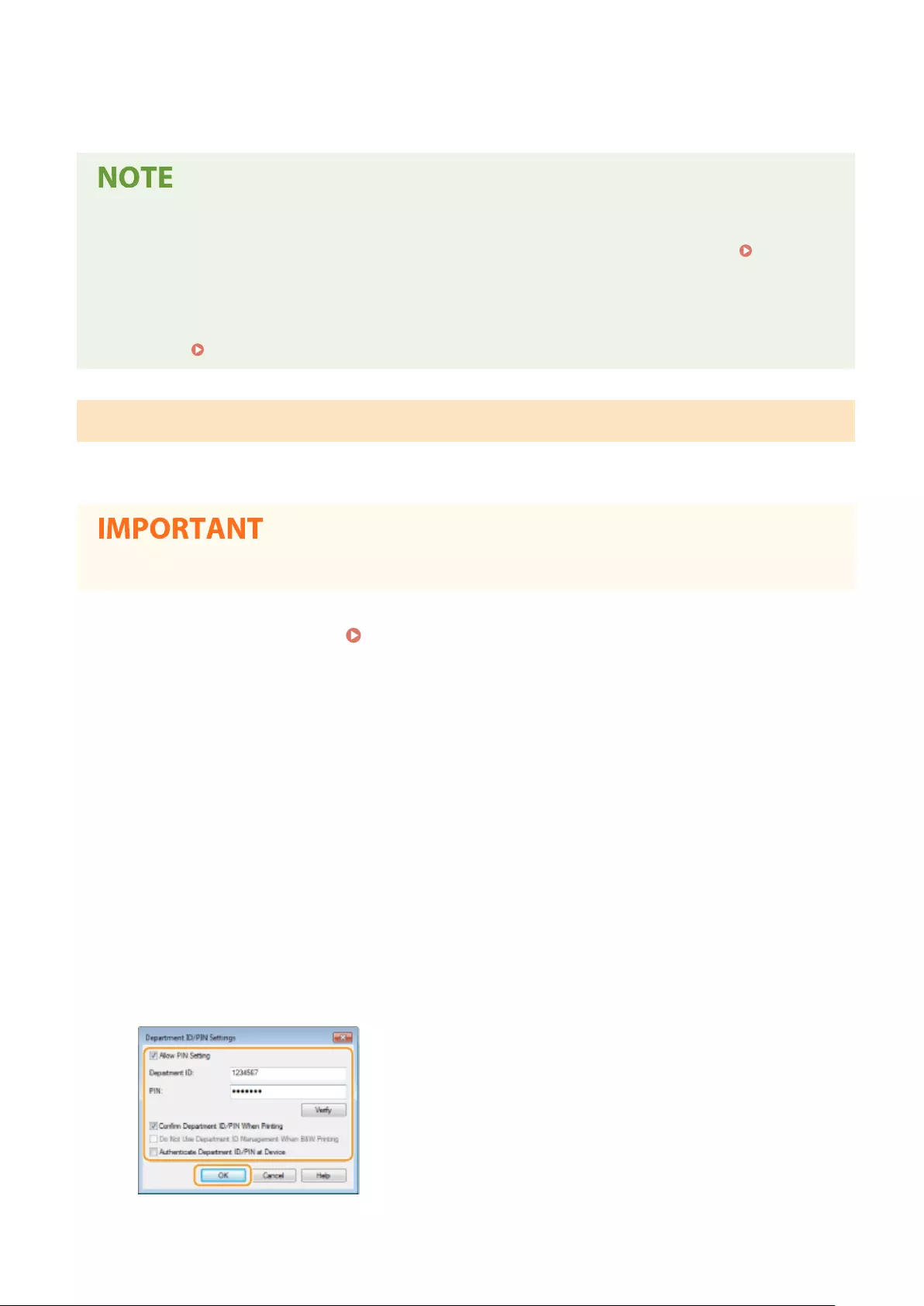
6Click [OK].
Using the operation panel
●Department ID Management settings can also be accessed from <Menu> in the Home Screen.
<Department ID Management>(P. 563)
Logging in to the machine
●When you try to operate the machine when Department ID Management is enabled, the login screen is
displayed. Logging in to the Machine(P. 135)
Enabling the Department ID Management for Jobs from a Computer
When you want to enable Department ID Management for jobs from a computer, you need to specify the department
ID and PIN using the driver pre-installed on each computer.
●To perform the following procedure, log in to your computer with an administrator account.
1Open the printer folder. Displaying the Printer Folder(P. 649)
2Right-click the driver icon for this machine, and click [Printer properties] or
[Properties].
3Click the [Device Settings] tab.
4Select [Department ID Management] under [User Management].
5Click [Settings] found to the right.
6Specify the settings as necessary and click [OK].
[Allow PIN Setting]
Managing the Machine
368
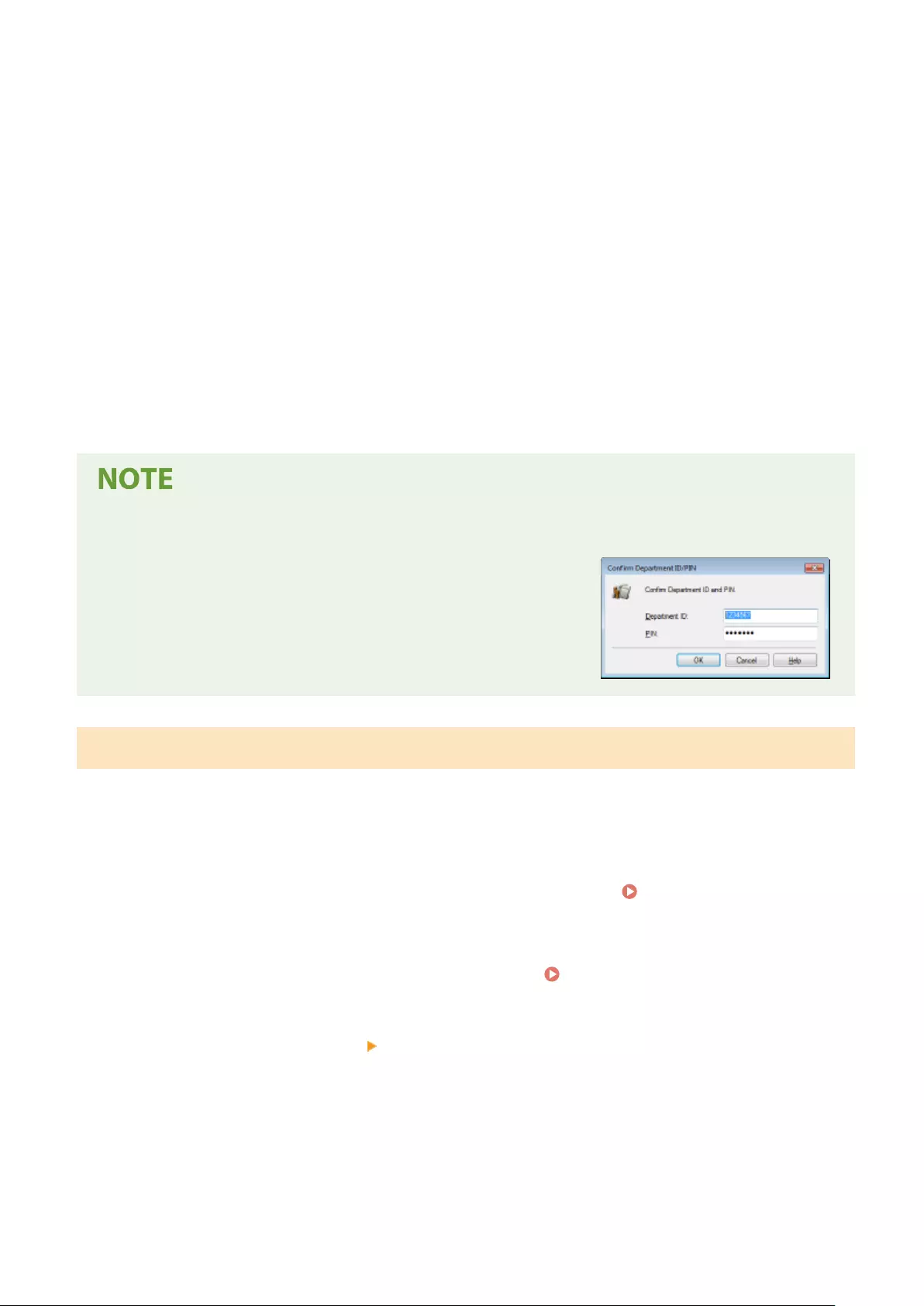
Select the check box to enable the PIN setting.
[Department ID]
Enter the Department ID number.
[PIN]
Enter the PIN corresponding to the Department ID as necessary.
[Verify]
Click to verify that the correct ID and PIN are entered. This function is not available if the machine and the
computer are connected via a USB or WSD (Web Services on Devices) port.
[Conrm Department ID/PIN When Printing]/[Conrm Department ID/PIN When Sending Faxes]
Select the check box to display the [Conrm Department ID/PIN] pop-up screen each time you send job from
a computer.
[Authenticate Department ID/PIN at Device]
Select the check box if the machine and the computer are connected via a USB or WSD port.
7Click [OK].
Logging in to the machine
●When you try to send job from a computer when Department ID
Management is enabled, the following pop-up screen is displayed
(unless the [Conrm Department ID/PIN When Printing]/[Conrm
Department ID/PIN When Sending Faxes] check box is cleared):
Blocking Jobs When Department ID Is Unknown
If you do not change the default settings, any user can print from a computer, scan (via <Computer> and <Remote
Scanner>) or send a PC fax from a computer without entering an ID and PIN even when Department ID Management
is enabled for the machine. You can change the default settings so that the machine cannot be used for these
functions without a correct ID and PIN.
1Start the Remote UI and log in to System Manager Mode. Starting Remote
UI(P. 428)
2Click [Settings/Registration] on the Portal page. Remote UI Screen(P. 429)
3Select [User Management] [Department ID Management].
4Click [Edit].
5Clear the check boxes as necessary.
Managing the Machine
369
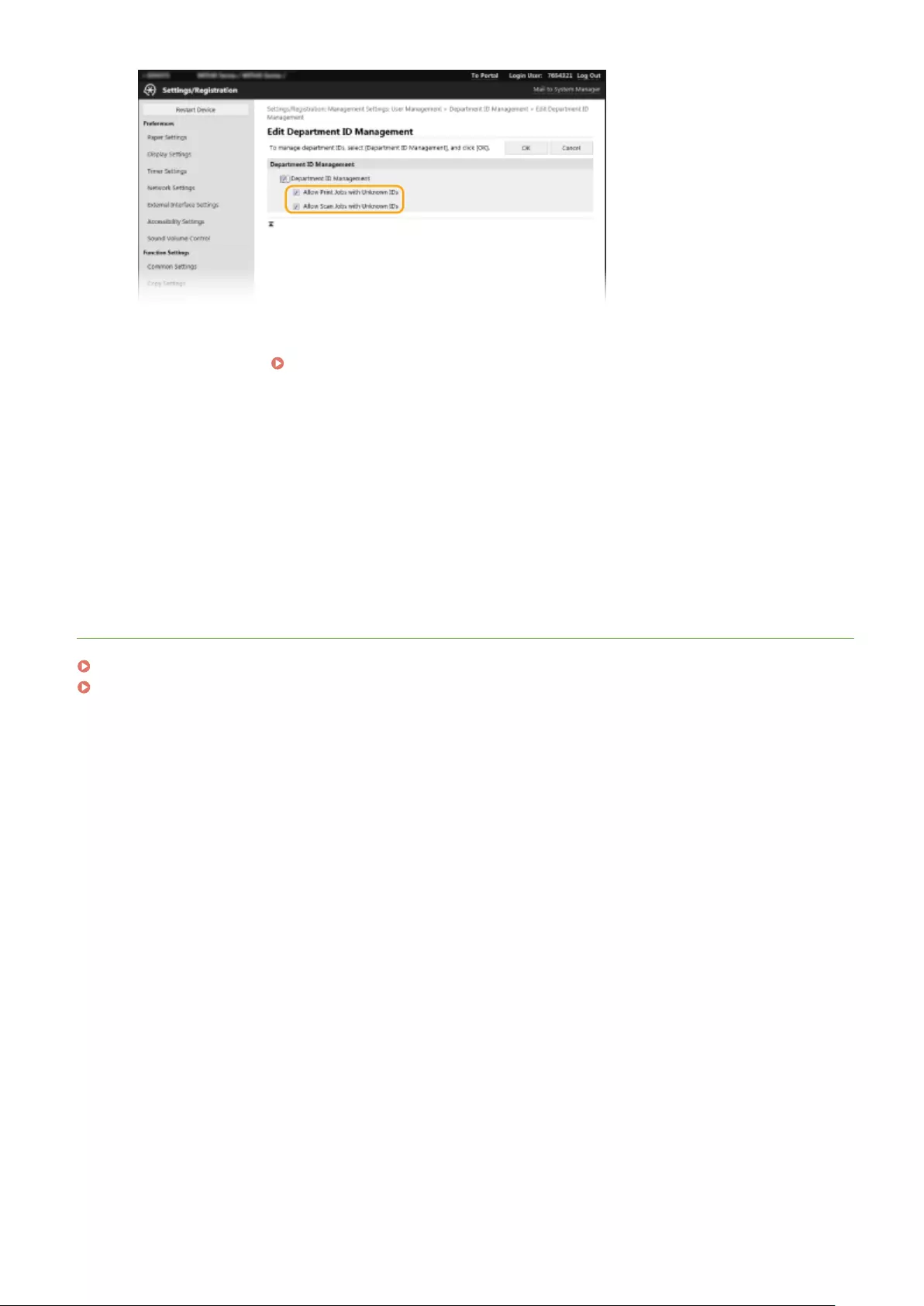
[Allow Print Jobs with Unknown IDs]
In order to send job from a computer when Department ID Management is enabled, you need to enter the
correct ID and PIN ( Enabling the Department ID Management for Jobs from a Computer(P. 368) ).
However, if the check box is selected for this setting, jobs are executed even when the ID and PIN are not
entered. When you want to congure a setting so that no jobs are executed unless the correct department ID
and PIN are entered, clear the check box.
[Allow Scan Jobs with Unknown IDs]
If the check box is selected, you can select <Computer> or <Remote Scanner> on the main screen and scan
documents into a computer anytime. If the check box is cleared, you cannot scan documents into a computer
if Department ID Management is enabled. It is not possible to restrict scanning of documents into a
computer for individual department IDs.
6Click [OK].
LINKS
Setting Access Privileges(P. 362)
Setting the System Manager ID and PIN(P. 363)
Managing the Machine
370
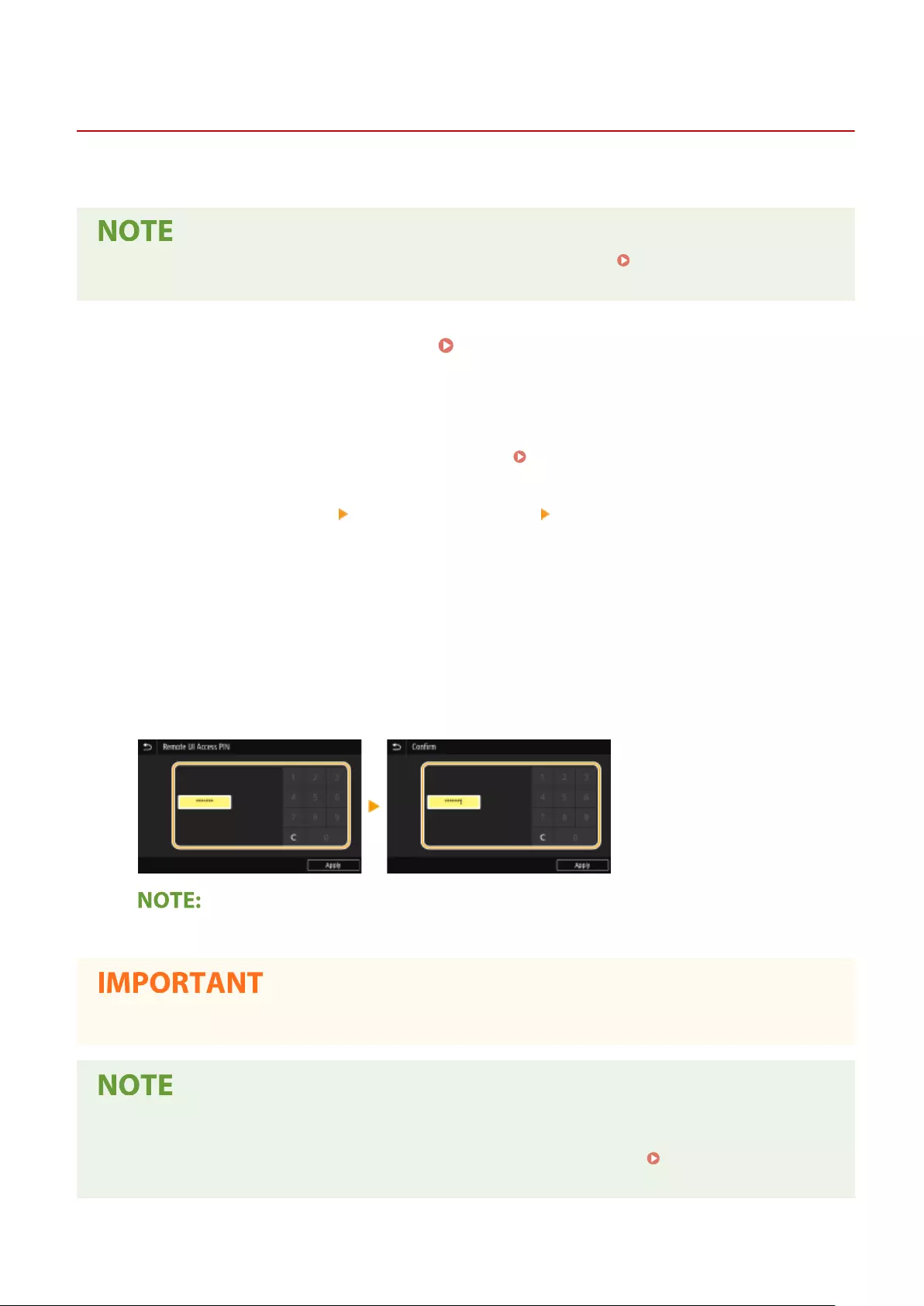
Setting a Remote UI PIN
6FR5-075
You can set a PIN for access to the Remote UI. All users use a common PIN.
●When Department ID Management is enabled, setting here is not required. Setting the Department ID
Management(P. 365)
1Select <Menu> in the Home screen. Home Screen(P. 124)
2Select <Management Settings>.
●If the login screen appears, enter the correct ID and PIN. Logging in to the Machine(P. 135)
3Select <License/Other> <Remote UI Settings> <Restrict Access>.
4Select <On>.
5Specify the Remote UI Access PIN.
●Enter a PIN, and select <Apply>.
●The Conrm screen is displayed. Enter the PIN once again to conrm.
●You cannot register a PIN that consists only of zeros, such as "00" or "0000000."
●Do not forget your PIN. If you forget your PIN, use the procedure above to set a new PIN.
If <Management Settings> are initialized
●The Remote UI Access PIN is also initialized. After an initialization, reset the PIN. <Initialize
Menu>(P. 570)
Managing the Machine
371
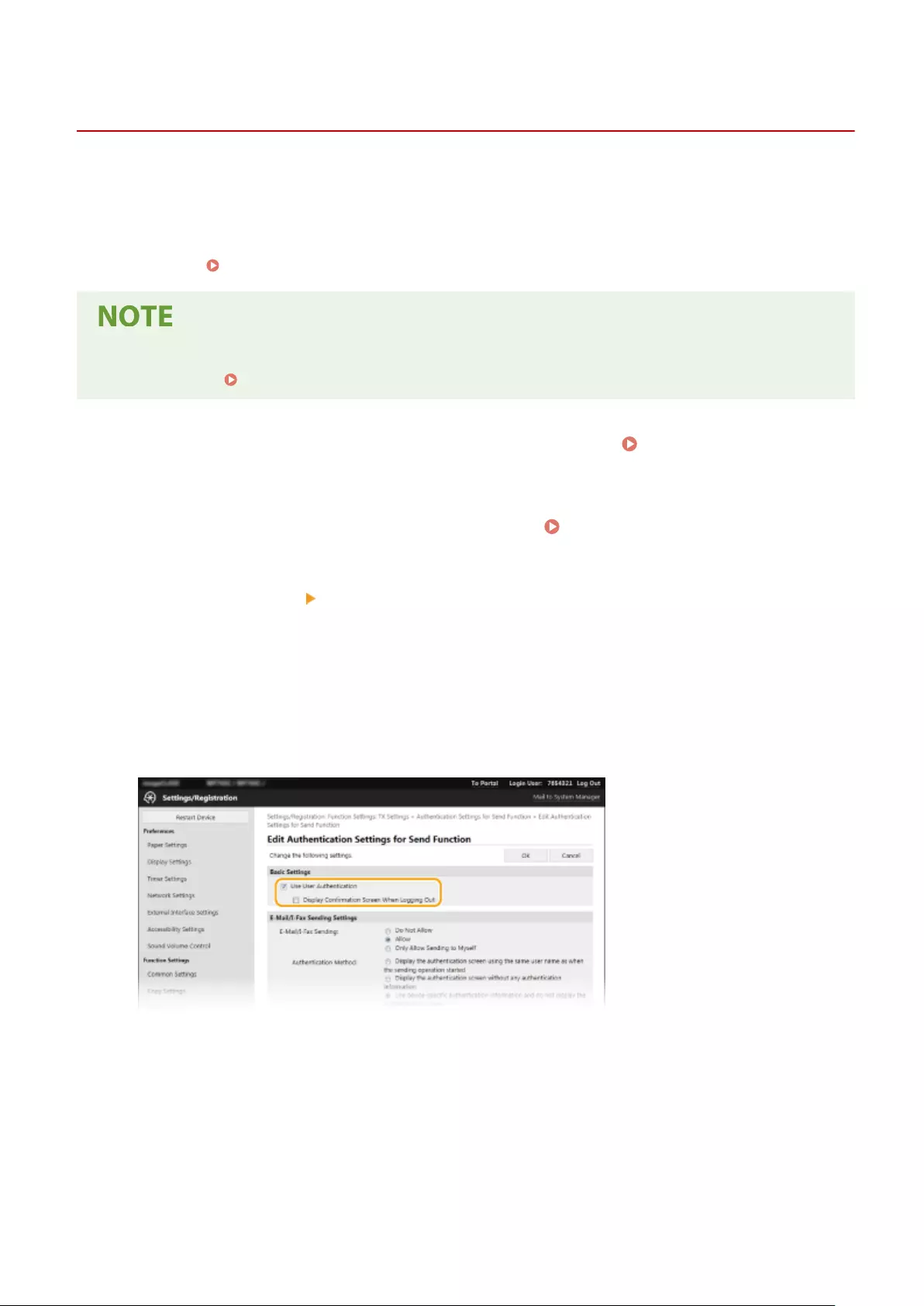
LDAP Server Authentication
6FR5-076
If your system has an LDAP server installed, you can ensure that LDAP server authentication is carried out when the
send function is used. This enables you to prevent unauthorized use by third parties and information disclosure. Once
the authorization settings are enabled, the Authorized Send screen appears when the fax or scan function is used and
operation can only continue if it is correctly authorized by the LDAP server. Use the settings described here to
congure LDAP server authentication. For more information about registering the server to be used for
authentication, see Registering LDAP Servers(P. 64) .
●For more information about the basic operations to be performed when setting the machine from the
Remote UI, see Setting Up Menu Options from Remote UI(P. 437) .
1Start the Remote UI and log in to System Manager Mode. Starting Remote
UI(P. 428)
2Click [Settings/Registration] on the Portal page. Remote UI Screen(P. 429)
3Select [TX Settings] [Authentication Settings for Send Function].
4Click [Edit].
5Select the [Use User Authentication] check box and select whether a conrmation
screen is displayed at logout.
[Use User Authentication]
Select the check box to display the Authorized Send login screen when the fax or scan function is used (LDAP
server authentication).
[Display Conrmation Screen When Logging Out]
Select the check box to display a screen that allows you to selectively log out when you are logged on for
both Authorized Send and Department ID Management. If you clear this check box, no selection screen is
displayed when you log out and you are logged out from both Authorized Send and Department ID
Management.
Managing the Machine
373
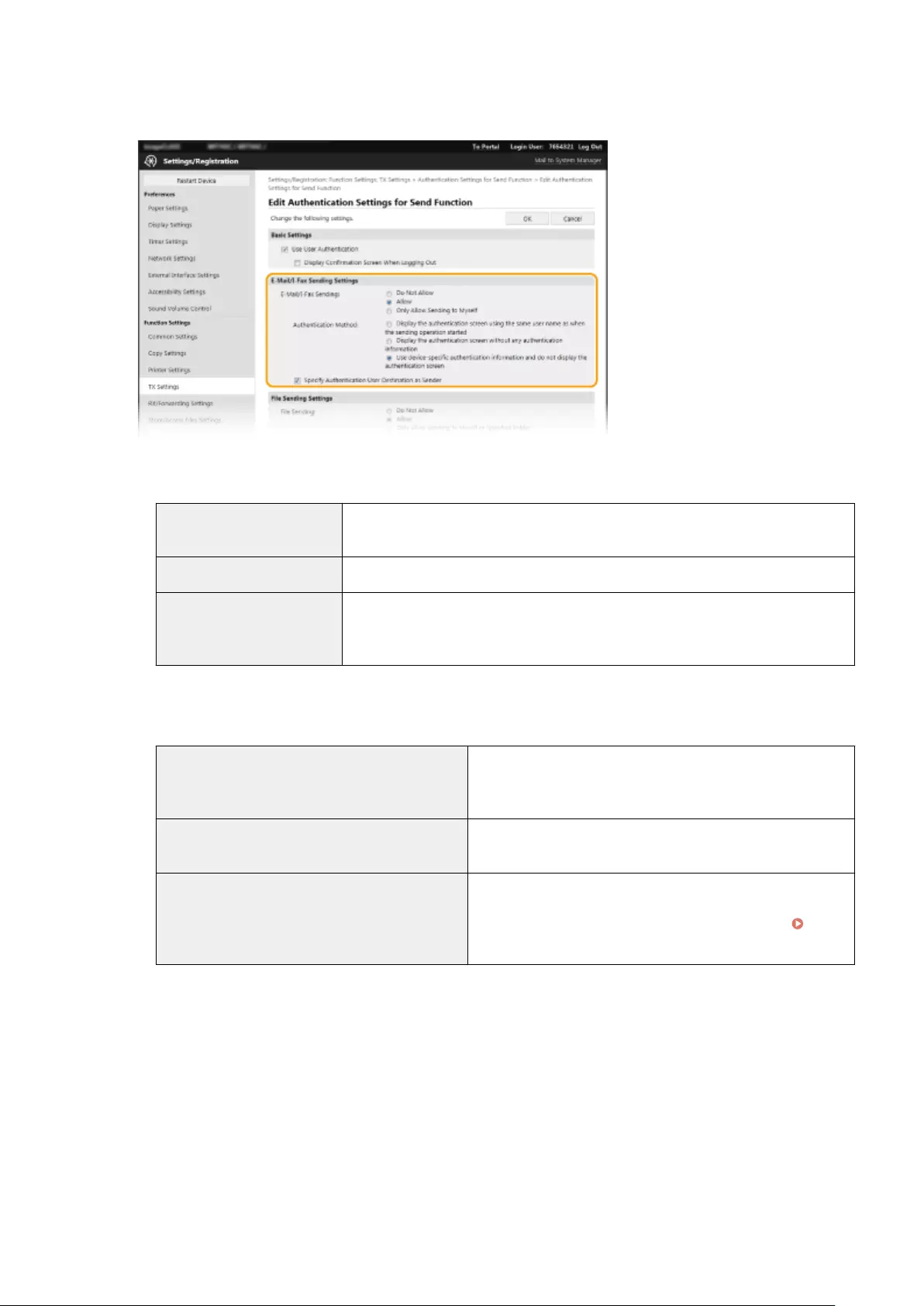
6Congure the settings for sending e-mail/I-Faxes.
[E-Mail/I-Fax Sending]
Select whether to allow sending e-mail and I-Faxes.
[Do Not Allow] Blocks sending e-mail and I-Faxes. <E-Mail> and <I-Fax> in the scan function can no
longer be used.
[Allow] Permits outgoing e-mail and I-Faxes.
[Only Allow Sending to Myself] Blocks all outgoing e-mail and I-Faxes other than those to users with authorized e-
mail addresses. The e-mail addresses of authorized users must be registered on the
LDAP server.
[Authentication Method]
When [Allow] or [Only Allow Sending to Myself] is selected in [E-Mail/I-Fax Sending], this allows you to specify
whether an authentication screen is shown on the SMTP server when e-mail is sent.
[Display the authentication screen using the same
user name as when the sending operation started]
Displays the authentication screen showing the same user
name and password entered in the Authorized Send login
screen.
[Display the authentication screen without any
authentication information]
Displays the authentication screen with the user name and
password elds blank.
[Use device-specic authentication information and
do not display the authentication screen]
No authentication screen is displayed when e-mail or I-Faxes are
sent. Authorization on the SMTP server is carried out using the
user name and password set in [E-Mail/I-Fax Settings]
Conguring E-Mail/I-Fax Communication Settings(P. 89) .
[Specify Authentication User Destination as Sender]
Select the check box when the e-mail address of an authorized user will be set as the sender. The e-mail
addresses of authorized users must be registered on the LDAP server. If you clear this check box, the e-mail
address set in the [E-Mail/I-Fax Settings] is set as the sender.
7Congure the le transfer settings (for saving to shared folders and FTP servers).
Managing the Machine
374
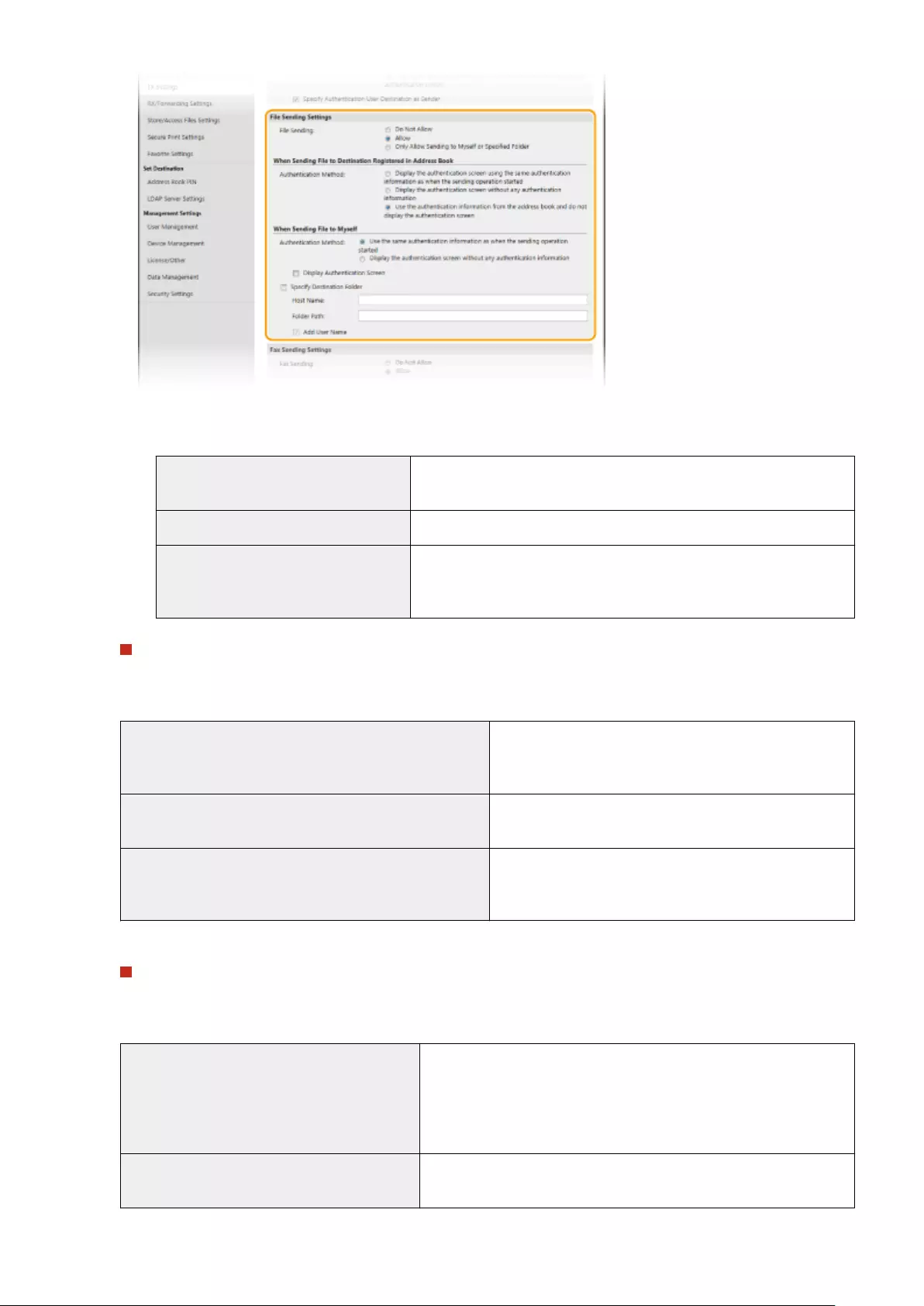
[File Sending]
Select whether to allow saving to shared folders and FTP servers.
[Do Not Allow] Blocks saving to shared folders and FTP servers. <File> in the scan
function can no longer be used.
[Allow] Saving to shared folders and FTP servers is not blocked.
[Only Allow Sending to Myself or
Specied Folder]
Blocks all saving to shared folders and FTP servers other than specied
folders. The data is saved to folders registered on the LDAP server or to
the folder specied in [Specify Destination Folder].
When [Allow] is specied in [File Sending]
[Authentication Method]
Allows you to specify whether an authentication screen is shown on the server when sending.
[Display the authentication screen using the same
authentication information as when the sending operation
started]
Displays the authentication screen showing the same user
name and password entered in the Authorized Send login
screen.
[Display the authentication screen without any
authentication information]
Displays the authentication screen with the user name and
password elds blank.
[Use the authentication information from the address book
and do not display the authentication screen]
No authentication screen is displayed when sending.
Authentication is carried out on the server using the user
name and password set in the Address Book.
When [Only Allow Sending to Myself or Specied Folder] is specied in [File Sending]
[Authentication Method]
Allows you to specify whether an authentication screen is shown on the server when sending.
[Use the same authentication information as
when the sending operation started]
Carries out authorization on the server using the user name and
password entered in the Authorized Send login screen. Selecting the
[Display Authentication Screen] check box displays the authentication
screen with this user name and password already entered when you
send the data.
[Display the authentication screen without any
authentication information]
Displays the authentication screen with the user name and password
elds blank.
Managing the Machine
375
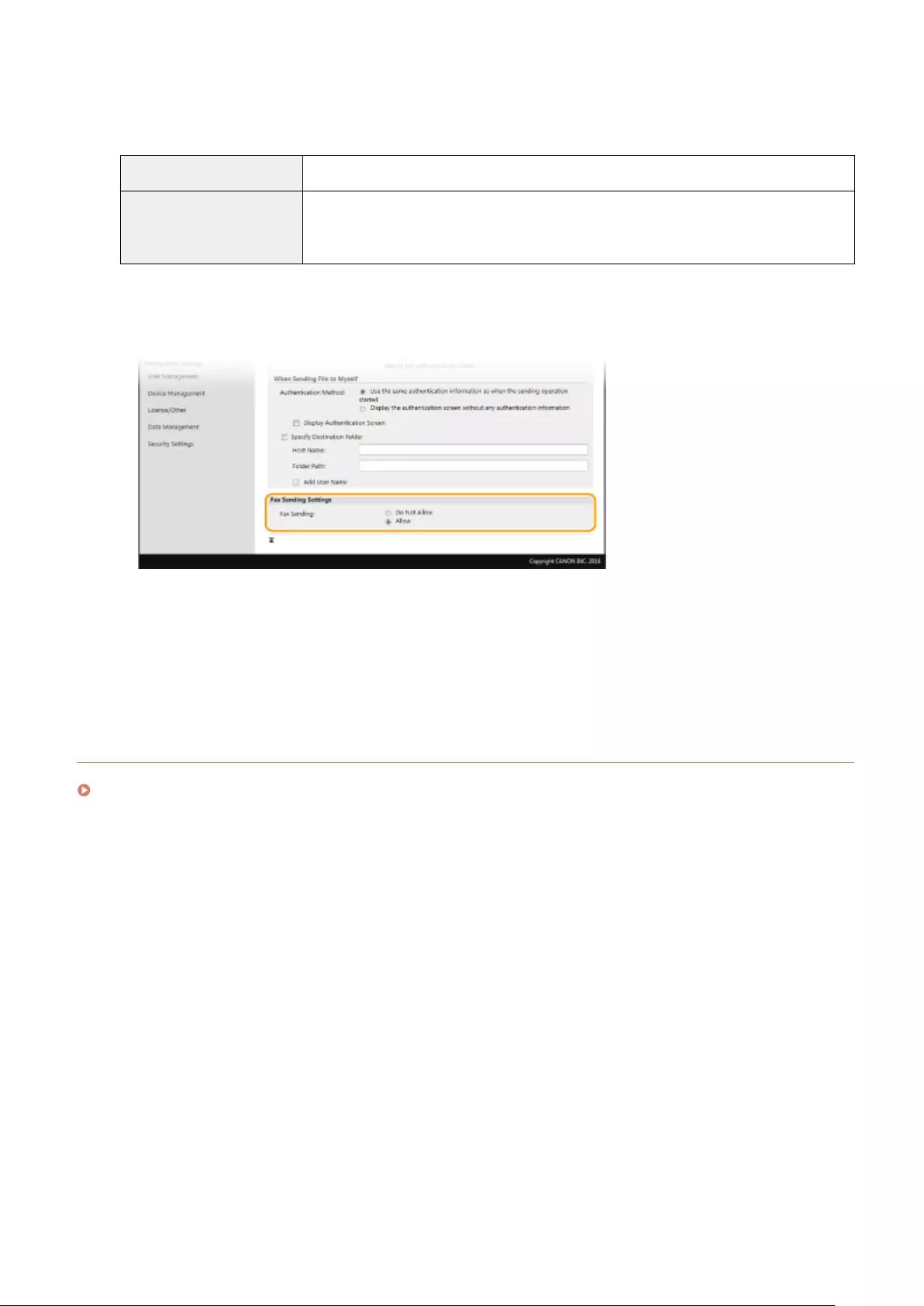
[Specify Destination Folder]
Selecting this check box allows you to specify the folder where the data is saved. If the check box is not selected,
the save destination is set based on authorized user information registered on the LDAP server.
[Host Name] Enter a host name for the shared folder or FTP server.
[Folder Path]
Enter a path name for the save destination folder (excluding the host name). When the [Add
User Name] check box is selected, the user name used for authentication on the LDAP
server is added to the path.
8Congure the settings for sending faxes.
[Fax Sending]
Select whether to allow sending faxes. [Do Not Allow] prevents the user from sending faxes from the
machine.
9Click [OK].
LINKS
Registering LDAP Servers(P. 64)
Managing the Machine
376
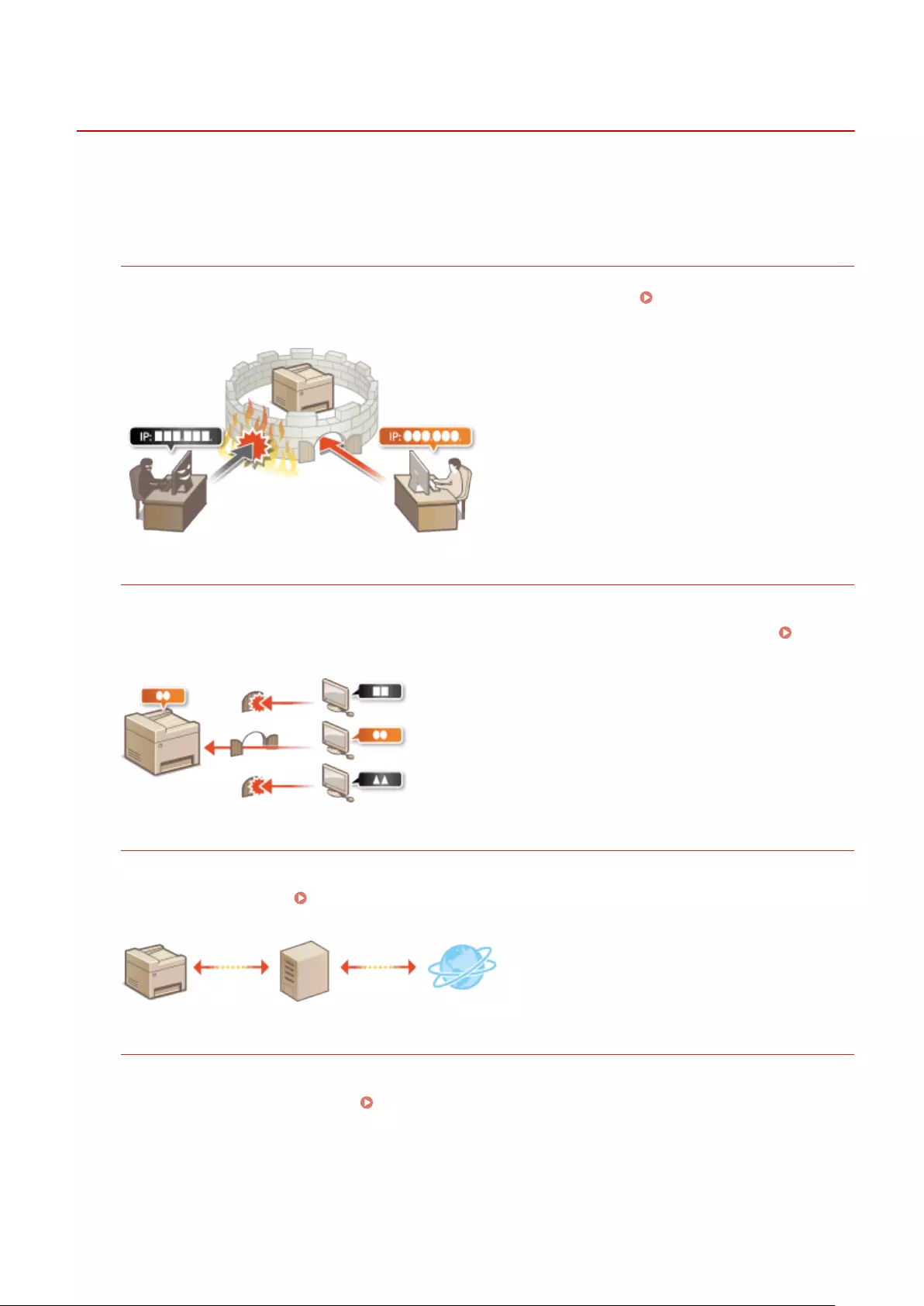
Conguring the Network Security Settings
6FR5-077
Authorized users may incur unanticipated losses from attacks by malicious third parties, such as sning, spoong,
and tampering of data as it ows over a network. To protect your important and valuable information from these
attacks, the machine supports the following features to enhance security and secrecy.
Firewall Settings
Unauthorized access by third parties, as well as network attacks and intrusions, can be blocked by limiting
communication only to devices that have a specic IP address or MAC address. Restricting Communication
by Using Firewalls(P. 379)
Changing Port Numbers
A protocol that is used to exchange information with other devices is assigned port numbers that are
predetermined according to the type of protocol. The port number must be the same for all communication
devices; therefore, changing it to an arbitrary number is important to prevent hacking from outside.
Changing Port Numbers(P. 386)
Proxy Settings
When the client devices are connected to an external network, communication is established through the proxy
server. When the proxy server is used, websites can be browsed more safely, therefore, security can be
expected to be enhanced. Setting a Proxy(P. 387)
TLS Encrypted Communication
TLS is a protocol for encryption for data sent over a network and is often used for communication via a Web
browser or an e-mail application. TLS enables secure network communication when you access the machine
from a computer via the Remote UI. Conguring the Key and Certicate for TLS(P. 389)
Managing the Machine
377
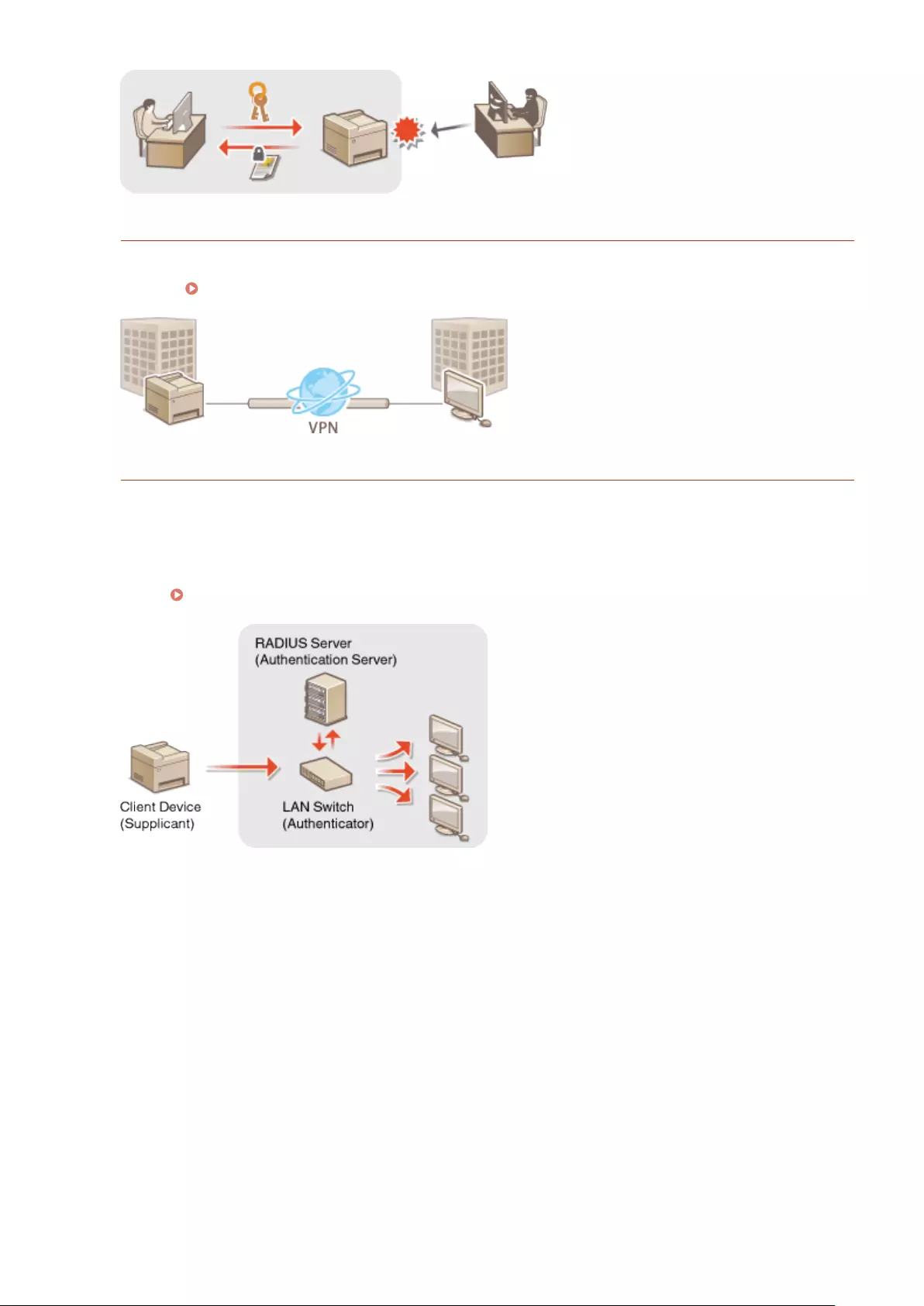
IPSec Communication
While TLS only encrypts data used on a specic application, such as a Web browser or an e-mail application,
IPSec encrypts the whole (or payloads of) IP packets. This enables IPSec to offer a more versatile security system
than TLS. Conguring IPSec Settings(P. 400)
IEEE 802.1X Authentication
IEEE 802.1X is a standard and mechanism for blocking unauthorized access to the network by collectively
managing user authentication information. If a device tries to connect to the 802.1X network, the device must
go through user authentication in order to prove that the connection is made by an authorized user.
Authentication information is sent to and checked by a RADIUS server, which permits or rejects communication
to the network depending on the authentication result. If authentication fails, a LAN switch (or an access point)
blocks access from the outside of the network. The machine can connect to an 802.1X network as a client
device. Conguring IEEE 802.1X Authentication Settings(P. 407)
Managing the Machine
378
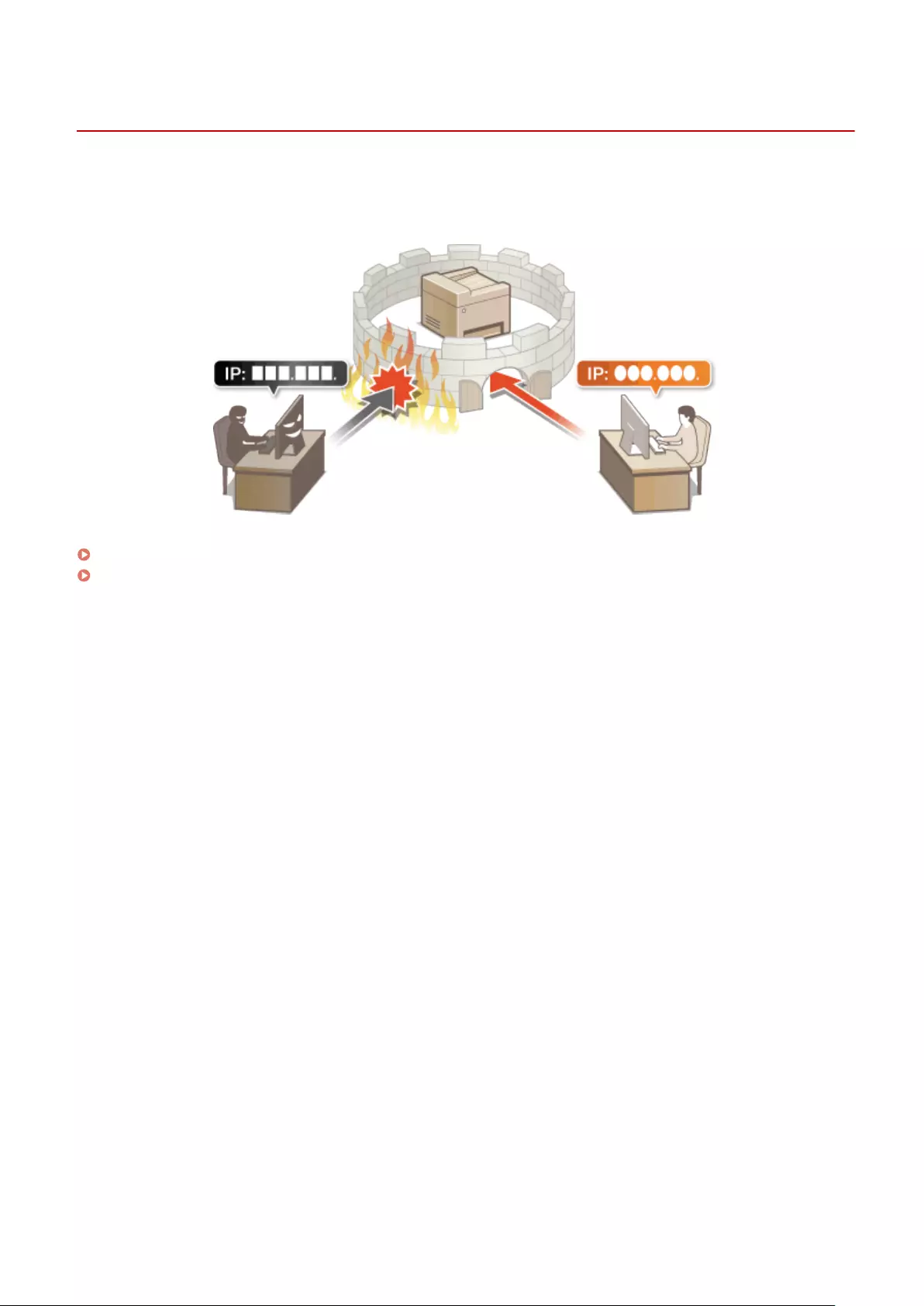
Restricting Communication by Using Firewalls
6FR5-078
Without proper security, unauthorized third parties can access computers and other communication devices that are
connected to a network. To prevent this unauthorized access, specify the settings for packet lter, a feature that
restricts communication to devices with specied IP addresses or MAC addresses.
Specifying IP Addresses for Firewall Settings(P. 380)
Specifying MAC Addresses for Firewall Settings(P. 383)
Managing the Machine
379
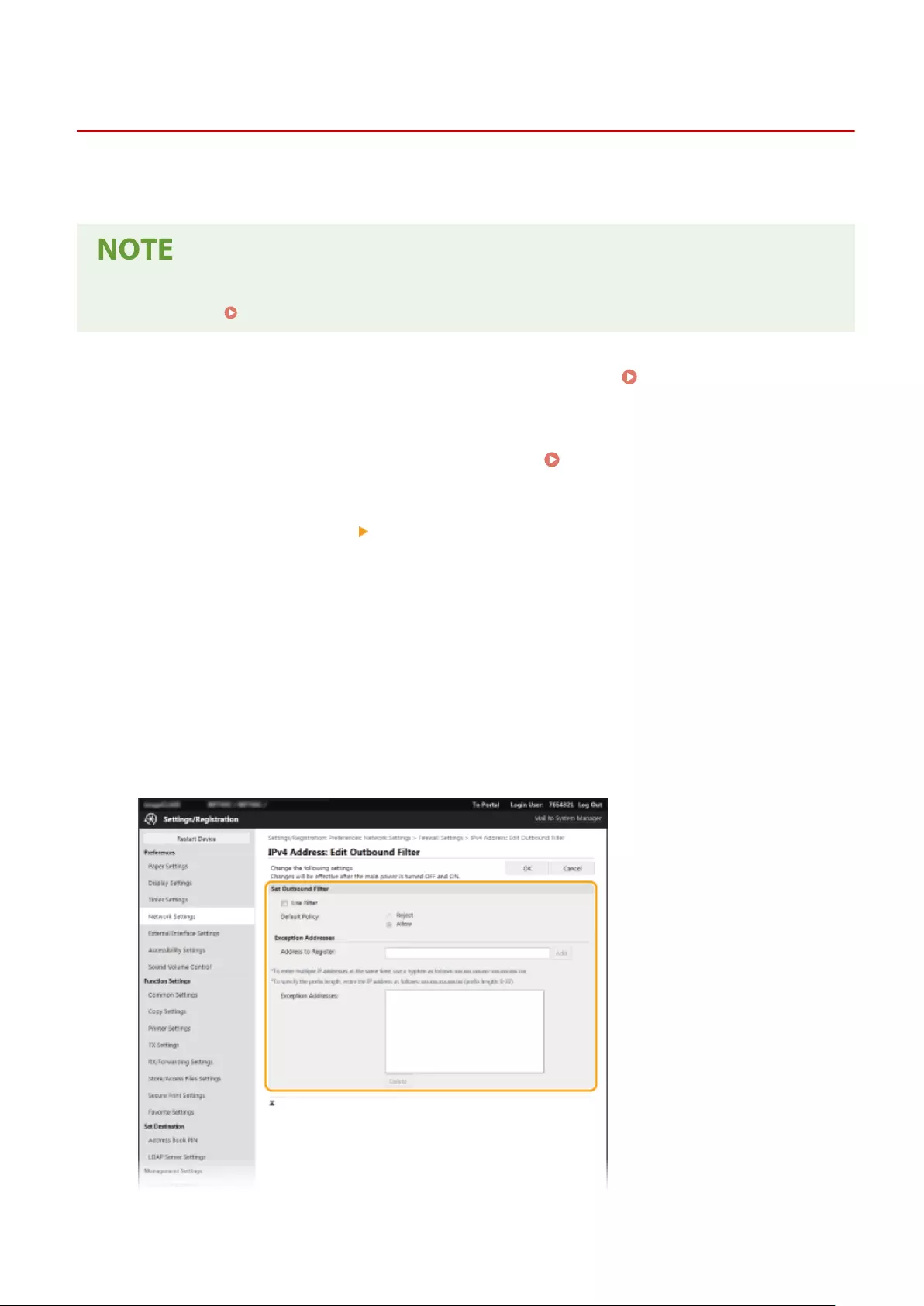
Specifying IP Addresses for Firewall Settings
6FR5-079
You can either limit communication to only devices with specied IP addresses, or block devices with specied IP
addresses but permit other communications. You can specify a single IP address or a range of IP addresses.
●For more information about the basic operations to be performed when setting the machine from the
Remote UI, see Setting Up Menu Options from Remote UI(P. 437) .
1Start the Remote UI and log in to System Manager Mode. Starting Remote
UI(P. 428)
2Click [Settings/Registration] on the Portal page. Remote UI Screen(P. 429)
3Select [Network Settings] [Firewall Settings].
4Click [Edit] for the target IP address lter.
●Select the lter that matches the target IP address. To restrict data sent from the machine to a computer,
select [Outbound Filter]. To restrict data received from a computer, select [Inbound Filter].
5Specify the settings for packet ltering.
●Select the default policy to allow or reject the communication of other devices with the machine, and then
specify IP addresses for exceptions.
Managing the Machine
380
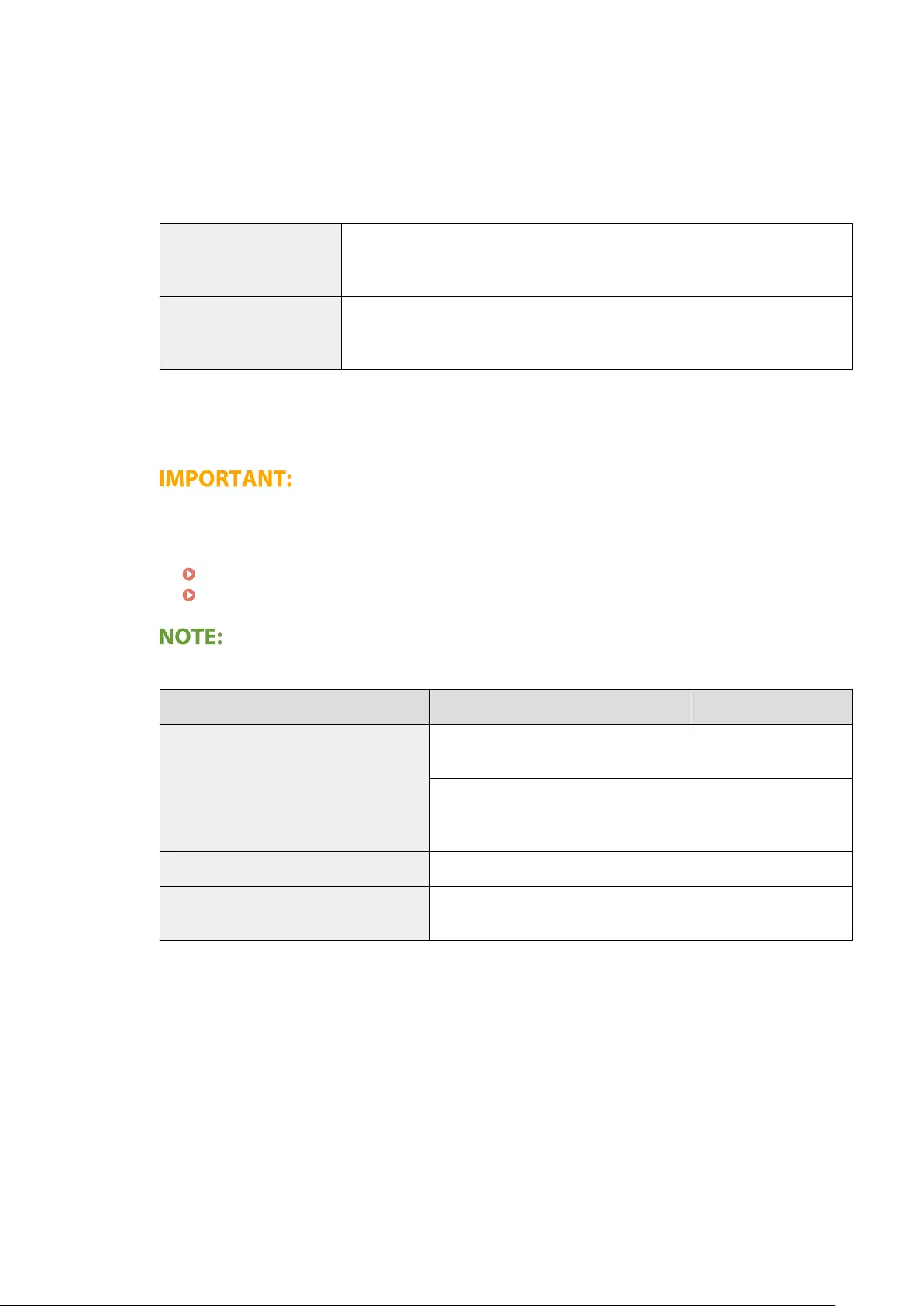
1Select the [Use Filter] check box and click the [Reject] or [Allow] radio button for the [Default Policy].
[Use Filter]
Select the check box to restrict communication. Clear the check box to disable the restriction.
[Default Policy]
Select the precondition to allow or reject the communication of other devices with the machine.
[Reject]
Select to pass communication packets only when they are sent to or received from
devices whose IP addresses are entered in [Exception Addresses]. Communications
with other devices are prohibited.
[Allow]
Select to block communication packets when they are sent to or received from
devices whose IP addresses are entered in [Exception Addresses]. Communications
with other devices are permitted.
2Specify address exceptions.
●Enter the IP address (or the range of IP addresses) in the [Address to Register] text box and click
[Add].
Check for entry errors
●If IP addresses are incorrectly entered, you may be unable to access the machine from the Remote UI,
in which case you need to set <IPv4 Address Filter> or <IPv6 Address Filter> to <Off>.
<IPv4 Address Filter>(P. 484)
<IPv6 Address Filter>(P. 484)
Entry form for IP addresses
Description Example
Entering a single address
IPv4:
Delimit numbers with periods. 192.168.0.10
IPv6:
Delimit alphanumeric characters with
colons.
fe80::10
Specifying a range of addresses Insert a hyphen between the addresses. 192.168.0.10-192.168.0.20
Specifying a range of addresses with a prex Enter the address, followed by a slash and
a number indicating the prex length.
192.168.0.32/27
fe80::1234/64
When [Reject] is selected for an outbound lter
●Outgoing multicast and broadcast packets cannot be ltered.
Deleting an IP address from exceptions
●Select an IP address and click [Delete].
Managing the Machine
381
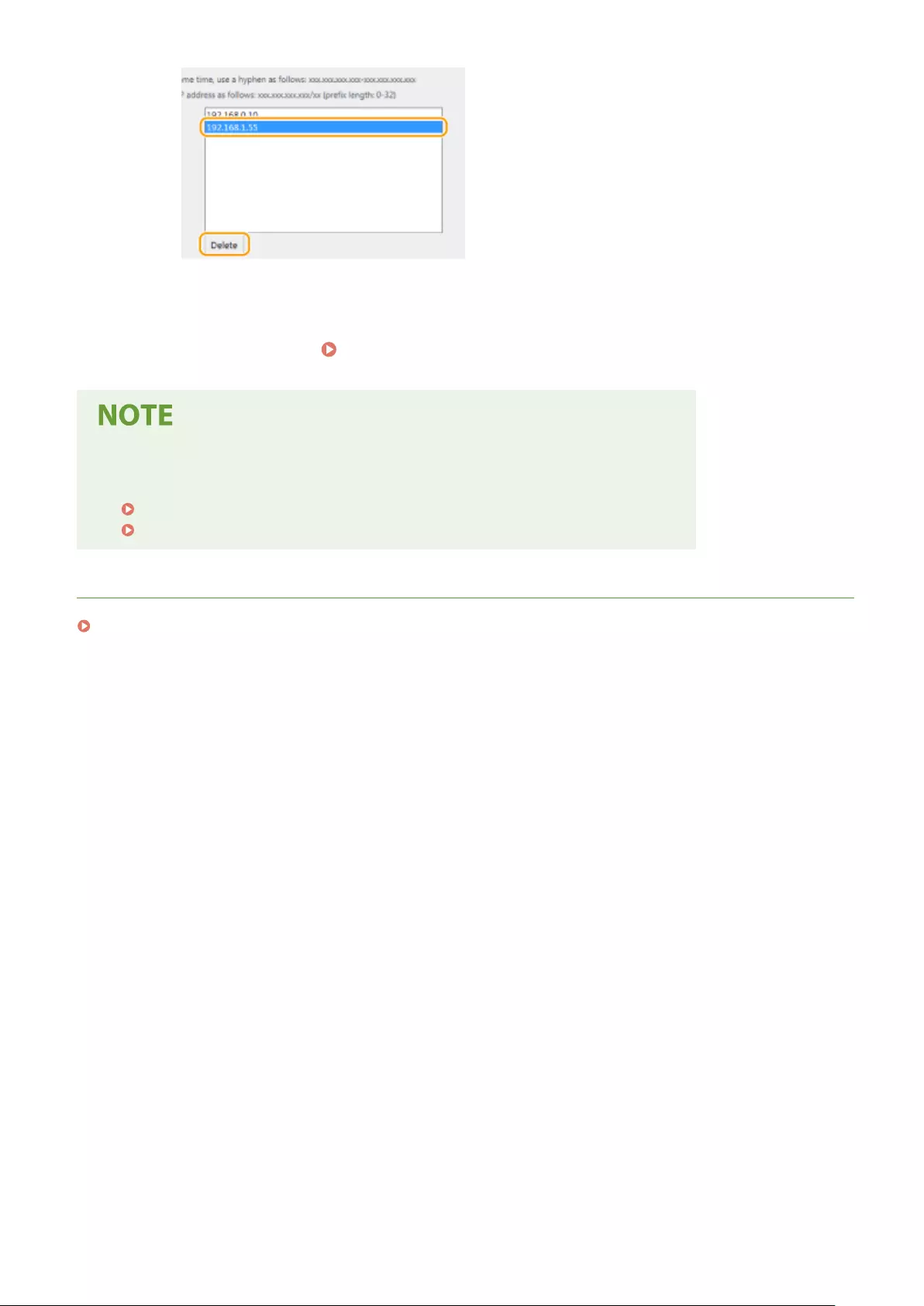
3Click [OK].
6Restart the machine. Restarting the Machine(P. 120)
Using the operation panel
●You can also enable or disable IP address ltering from <Menu> in the Home screen.
<IPv4 Address Filter>(P. 484)
<IPv6 Address Filter>(P. 484)
LINKS
Specifying MAC Addresses for Firewall Settings(P. 383)
Managing the Machine
382
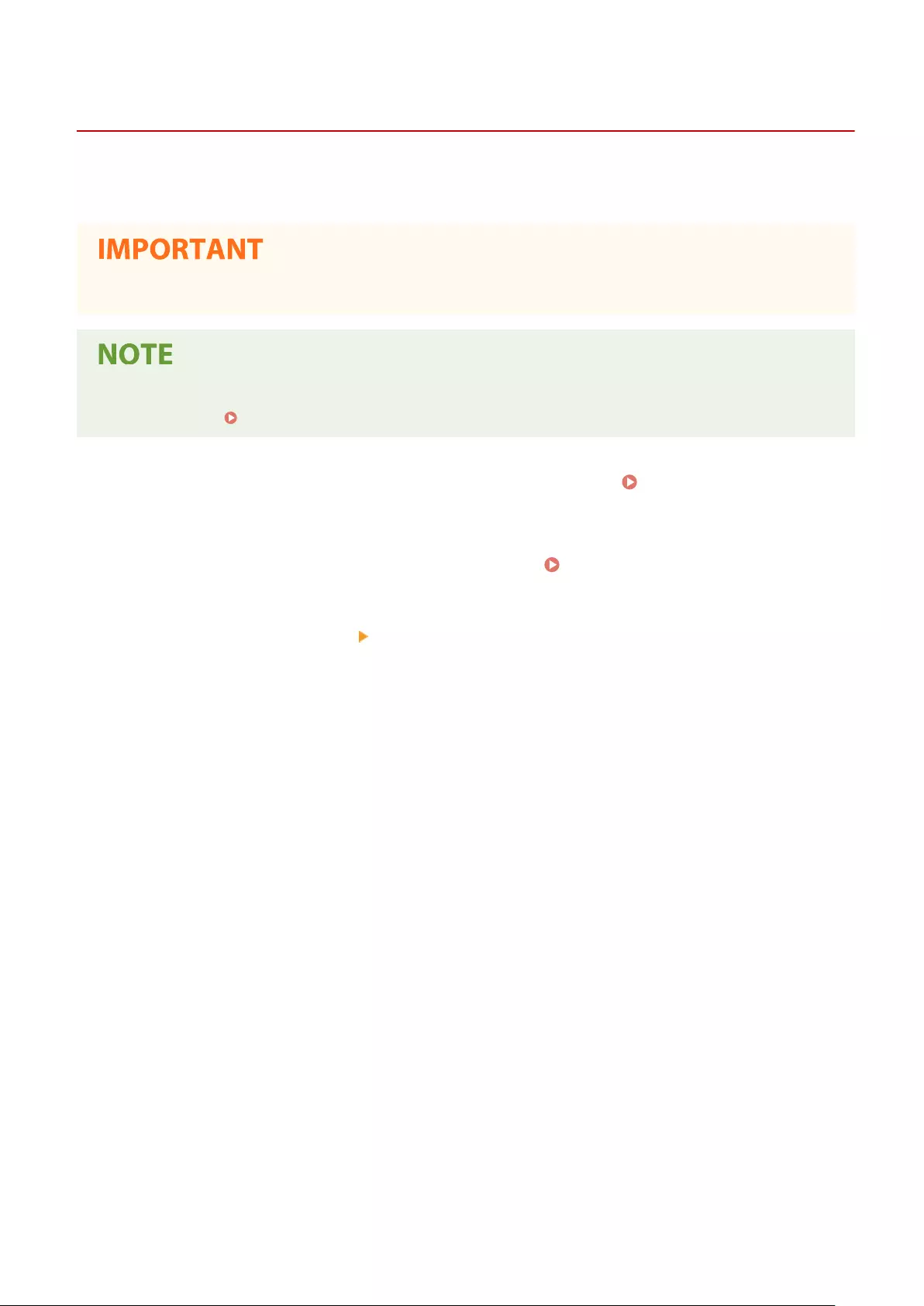
Specifying MAC Addresses for Firewall Settings
6FR5-07A
You can limit communication to only devices with specied MAC addresses, or block devices with specied MAC
addresses but permit other communications.
This function is unavailable when the machine is connected to a wireless LAN.
●For more information about the basic operations to be performed when setting the machine from the
Remote UI, see Setting Up Menu Options from Remote UI(P. 437) .
1Start the Remote UI and log in to System Manager Mode. Starting Remote
UI(P. 428)
2Click [Settings/Registration] on the Portal page. Remote UI Screen(P. 429)
3Select [Network Settings] [Firewall Settings].
4Click [Edit] for the target MAC address lter.
●To restrict data sent from the machine to a computer, select [Outbound Filter]. To restrict data received from
a computer, select [Inbound Filter].
5Specify the settings for packet ltering.
●Select the precondition (default policy) to allow or reject the communication of other devices with the
machine, and then specify MAC addresses for exceptions.
Managing the Machine
383
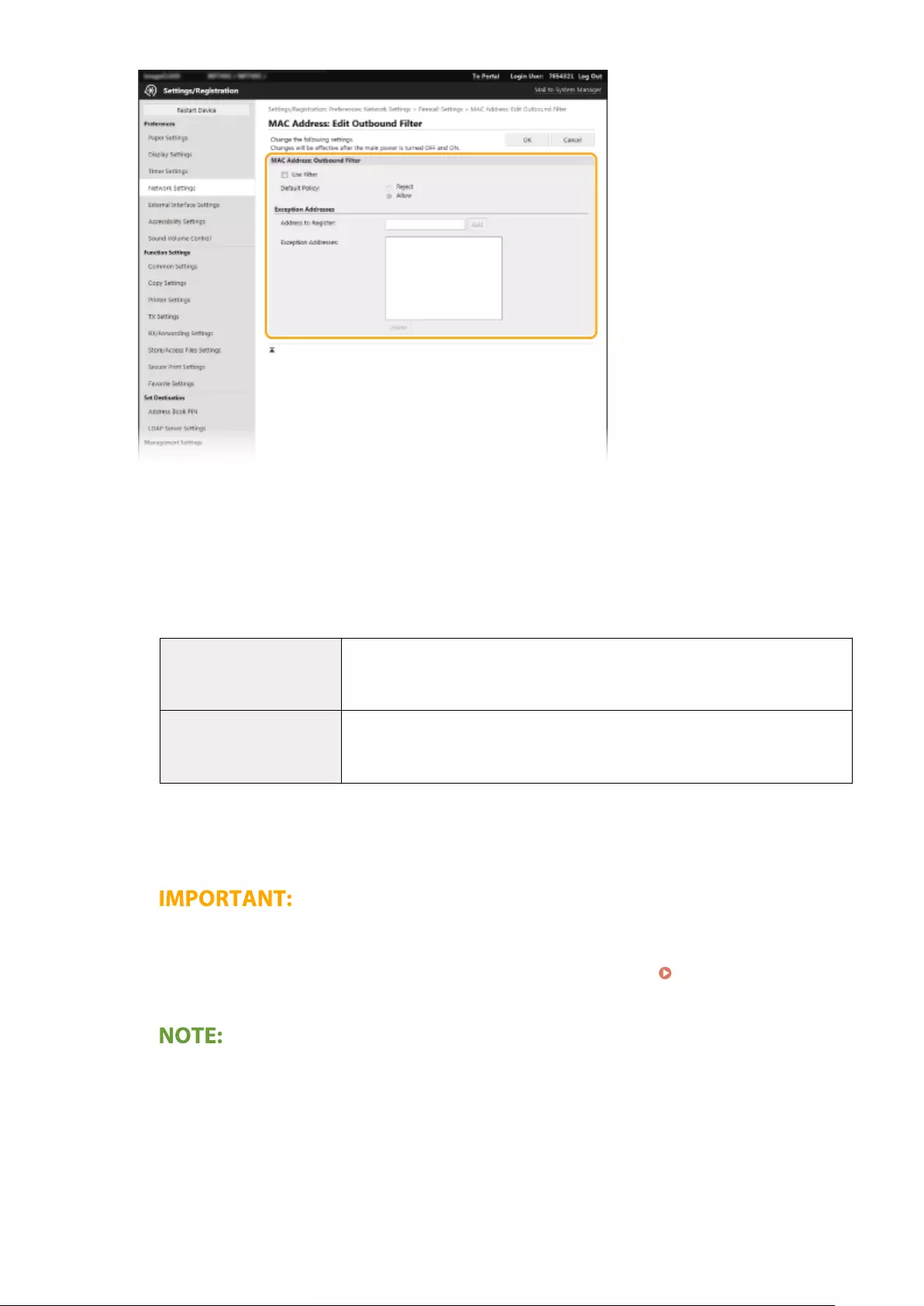
1Select the [Use Filter] check box and click the [Reject] or [Allow] radio button for the [Default Policy].
[Use Filter]
Select the check box to restrict communication. Clear the check box to disable the restriction.
[Default Policy]
Select the precondition to allow or reject other devices to communicate with the machine.
[Reject]
Select to pass communication packets only when they are sent to or received from
devices whose MAC addresses are entered in [Exception Addresses].
Communications with other devices are prohibited.
[Allow]
Select to block communication packets when they are sent to or received from
devices whose MAC addresses are entered in [Exception Addresses].
Communications with other devices are permitted.
2Specify address exceptions.
●Enter the MAC address in the [Address to Register] text box and click [Add].
●You do not need to delimit the address with hyphens or colons.
Check for entry errors
●If MAC addresses are incorrectly entered, you may become unable to access the machine from the
Remote UI, in which case you need to set <MAC Address Filter> to <Off>. <MAC Address
Filter>(P. 485)
When [Reject] is selected for an outbound lter
●Outgoing multicast and broadcast packets cannot be ltered.
Deleting a MAC address from exceptions
●Select a MAC address and click [Delete].
Managing the Machine
384
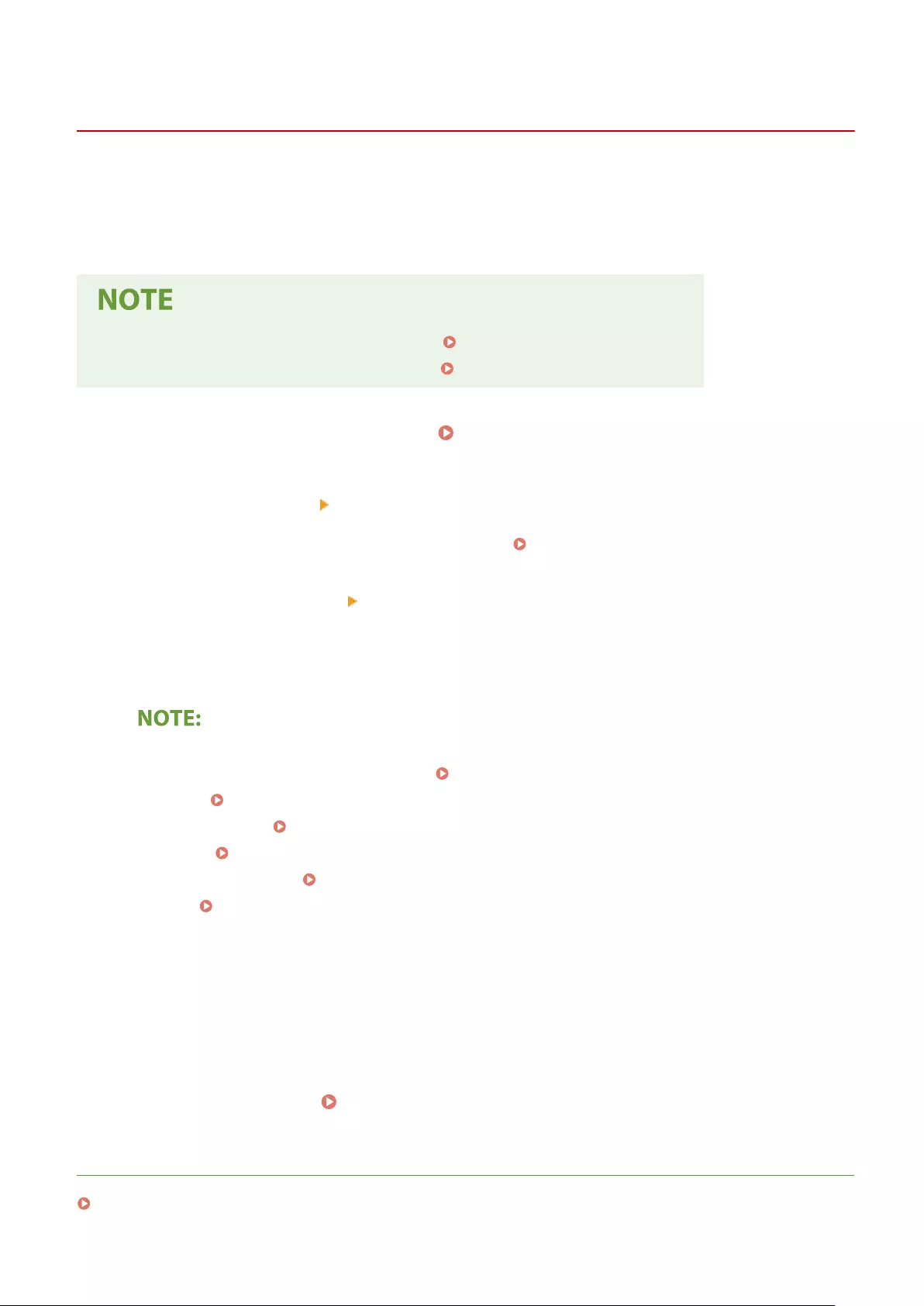
Changing Port Numbers
6FR5-07C
Ports serve as endpoints for communicating with other devices. Typically, conventional port numbers are used for
major protocols, but devices that use these port numbers are vulnerable to attacks because these port numbers are
well-known. To enhance security, your Network Administrator may change the port numbers. When a port number has
been changed, the new number must be shared with the communicating devices, such as computers and servers.
Specify the port number settings depending on the network environment.
●To change the port number for proxy server, see Setting a Proxy(P. 387) .
●To change the port number for LDAP server, see Registering LDAP Servers(P. 64) .
1Select <Menu> in the Home screen. Home Screen(P. 124)
2Select <Preferences> <Network>.
●If the login screen appears, enter the correct ID and PIN. Logging in to the Machine(P. 135)
3Select <TCP/IP Settings> <Port Number Settings>.
4Selecting the protocol of which you want to change the port number.
Learning more about the protocols
●<LPD>/<RAW>/<WSD Multicast Discovery> Conguring Printing Protocols and WSD Functions(P. 41)
●<HTTP> Disabling HTTP Communication(P. 423)
●<POP3>/<SMTP> Conguring E-Mail/I-Fax Communication Settings(P. 89)
●<SNMP> Monitoring and Controlling the Machine with SNMP(P. 69)
●<Multicast Discovery> Monitoring the Machine from the Device Management Systems(P. 74)
●<FTP> Procedure for Setting a FTP Server as a Save Location(P. 97)
5Enter the port number, and select <Apply>.
6Select <OK>.
7Restart the machine. Restarting the Machine(P. 120)
LINKS
Conguring Printer Ports(P. 44)
Managing the Machine
386
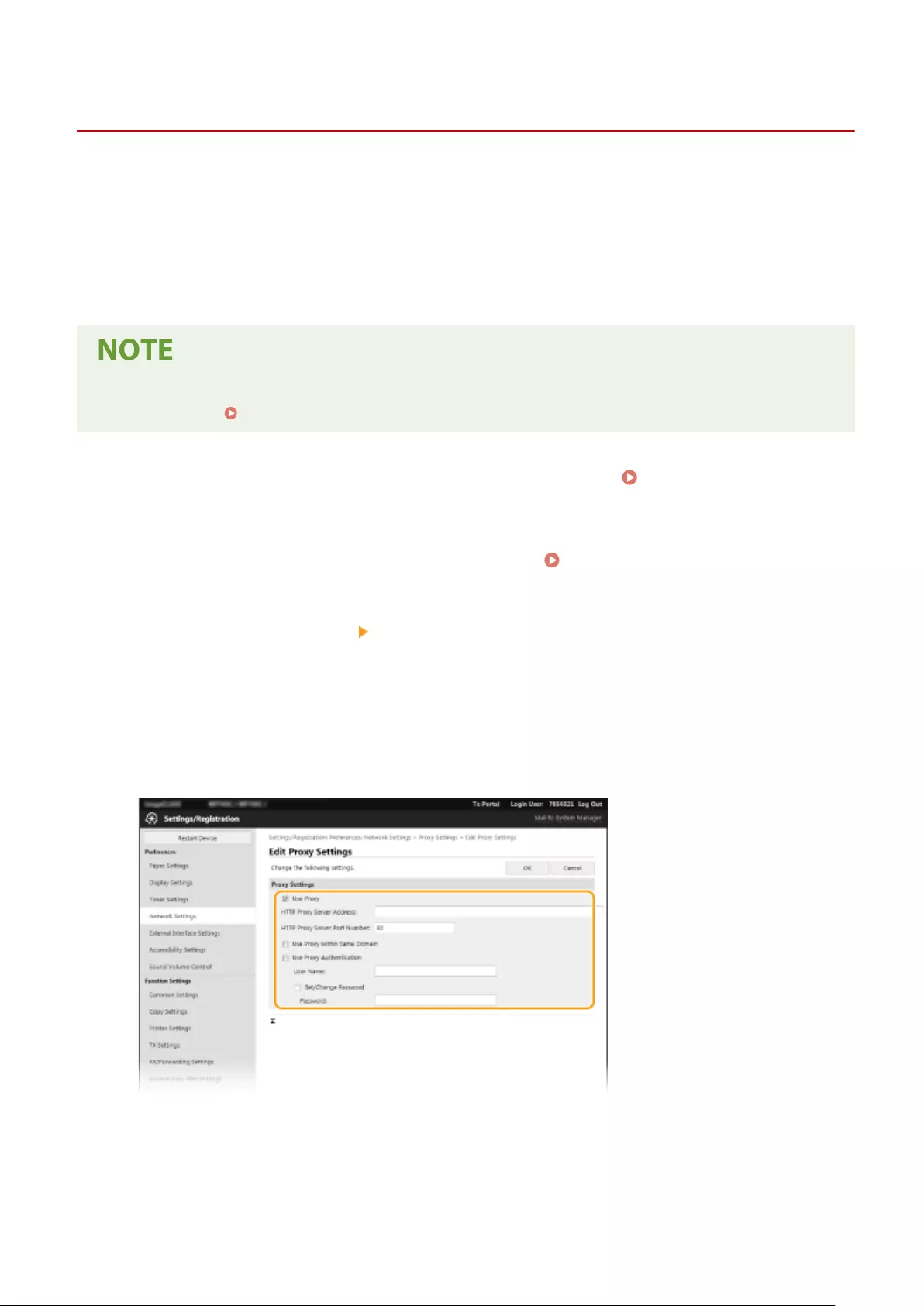
Setting a Proxy
6FR5-07E
A proxy (or HTTP proxy server) refers to a computer or software that carries out HTTP communication for other
devices, especially when communicating with resources outside the network, such as when browsing Web sites. The
client devices connect to the outside network through the proxy server, and do not communicate directly to the
resources outside. Setting a proxy not only facilitates management of trac between in-house and outside networks
but also blocks unauthorized access and consolidates anti-virus protection for enhanced security. When you use
Google Cloud Print to print over the Internet, you can enhance security by setting a proxy. When setting a proxy, make
sure that you have the necessary proxy information, including the IP address, port number, and a user name and
password for authentication.
●For more information about the basic operations to be performed when setting the machine from the
Remote UI, see Setting Up Menu Options from Remote UI(P. 437) .
1Start the Remote UI and log in to System Manager Mode. Starting Remote
UI(P. 428)
2Click [Settings/Registration] on the Portal page. Remote UI Screen(P. 429)
3Select [Network Settings] [Proxy Settings].
4Click [Edit].
5Select the [Use Proxy] check box and specify the required settings.
[Use Proxy]
Select the check box to use the specied proxy server when communicating with an HTTP server.
[HTTP Proxy Server Address]
Enter the address of the proxy server. Specify the IP address or host name depending on the environment.
[HTTP Proxy Server Port Number]
Managing the Machine
387

Change the port number as necessary.
[Use Proxy within Same Domain]
Select the check box to also use the specied proxy server for communication with devices in the same
domain.
[Use Proxy Authentication]
To enable authentication by the proxy server, select the check box and enter alphanumeric characters for the
user name in the [User Name] text box.
[Set/Change Password]
To set or change the password for the proxy authentication, when it is enabled, select the check box and
enter alphanumeric characters for the new password in the [Password] text box.
6Click [OK].
LINKS
Using Google Cloud Print(P. 354)
Managing the Machine
388
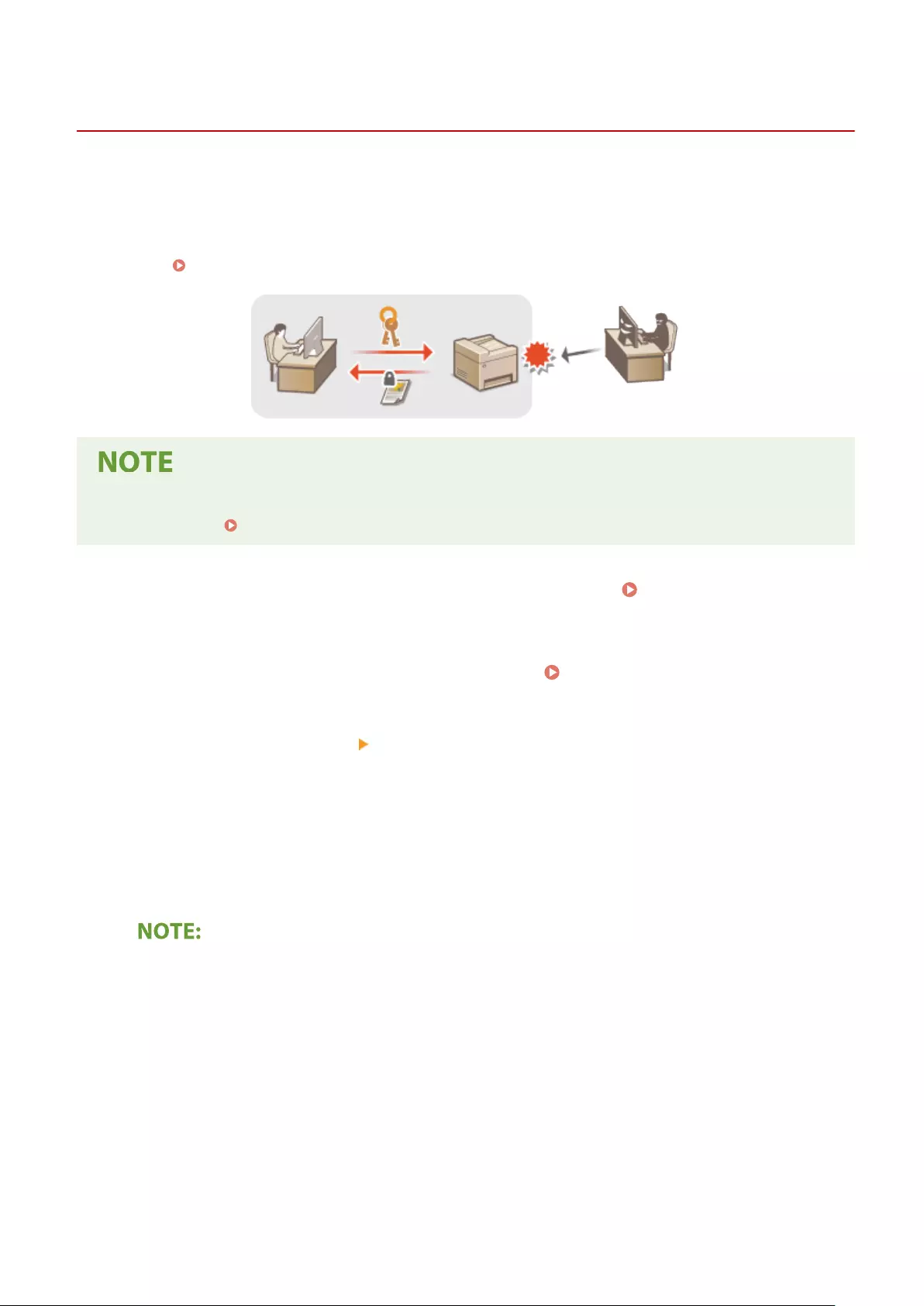
Conguring the Key and Certicate for TLS
6FR5-07F
You can encrypt communication between the machine and a Web browser on the computer by using Transport Layer
Security (TLS). TLS is a mechanism for encrypting data sent or received over the network. TLS must be enabled when
the Remote UI is used for specifying settings for IPSec (Pre-Shared Key Method), IEEE 802.1X authentication (TTLS/
PEAP), or SNMPv3. To use TLS encrypted communication for the Remote UI, you need to specify a "key and certicate"
(server certicate) you want to use before enabling TLS. Generate or install the key and certicate for TLS before
enabling TLS ( Management Functions(P. 633) ).
●For more information about the basic operations to be performed when setting the machine from the
Remote UI, see Setting Up Menu Options from Remote UI(P. 437) .
1Start the Remote UI and log in to System Manager Mode. Starting Remote
UI(P. 428)
2Click [Settings/Registration] on the Portal page. Remote UI Screen(P. 429)
3Select [Network Settings] [TLS Settings].
4Click [Key and Certicate].
5Click [Register Default Key] on the right of the key and certicate you want to use.
Viewing details of a certicate
●You can check the details of the certicate or verify the certicate by clicking the corresponding text link
under [Key Name], or the certicate icon.
6Click [Edit].
7Congure detailed TLS settings.
Managing the Machine
389
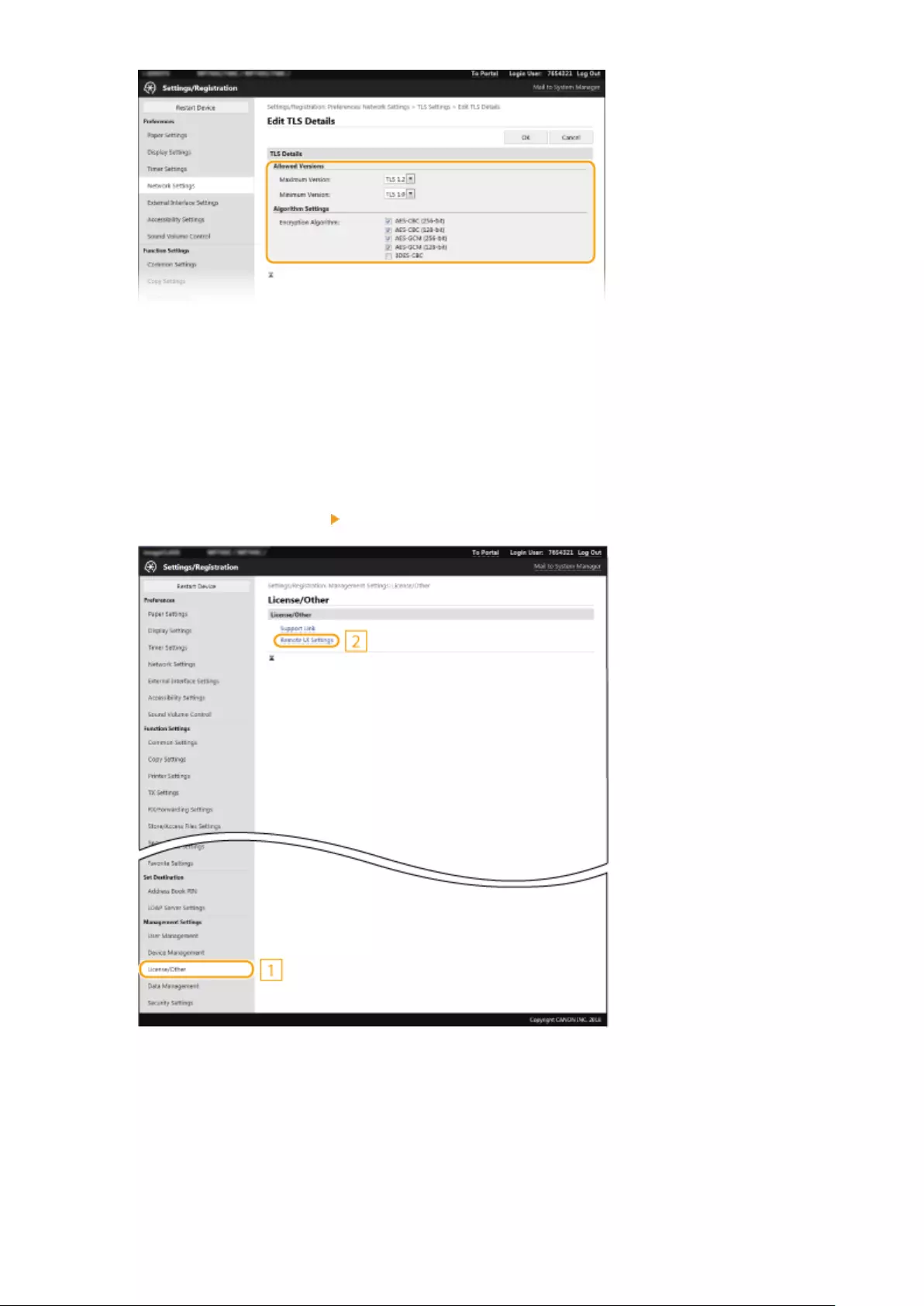
[Allowed Versions]
Specify [Maximum Version] and [Minimum Version] of TLS.
[Algorithm Settings]
Select the check box for the encryption algorithm to use for TLS.
8Click [OK].
9Select [License/Other] [Remote UI Settings].
10 Click [Edit].
11 Select the [Use TLS] check box and click [OK].
Managing the Machine
390
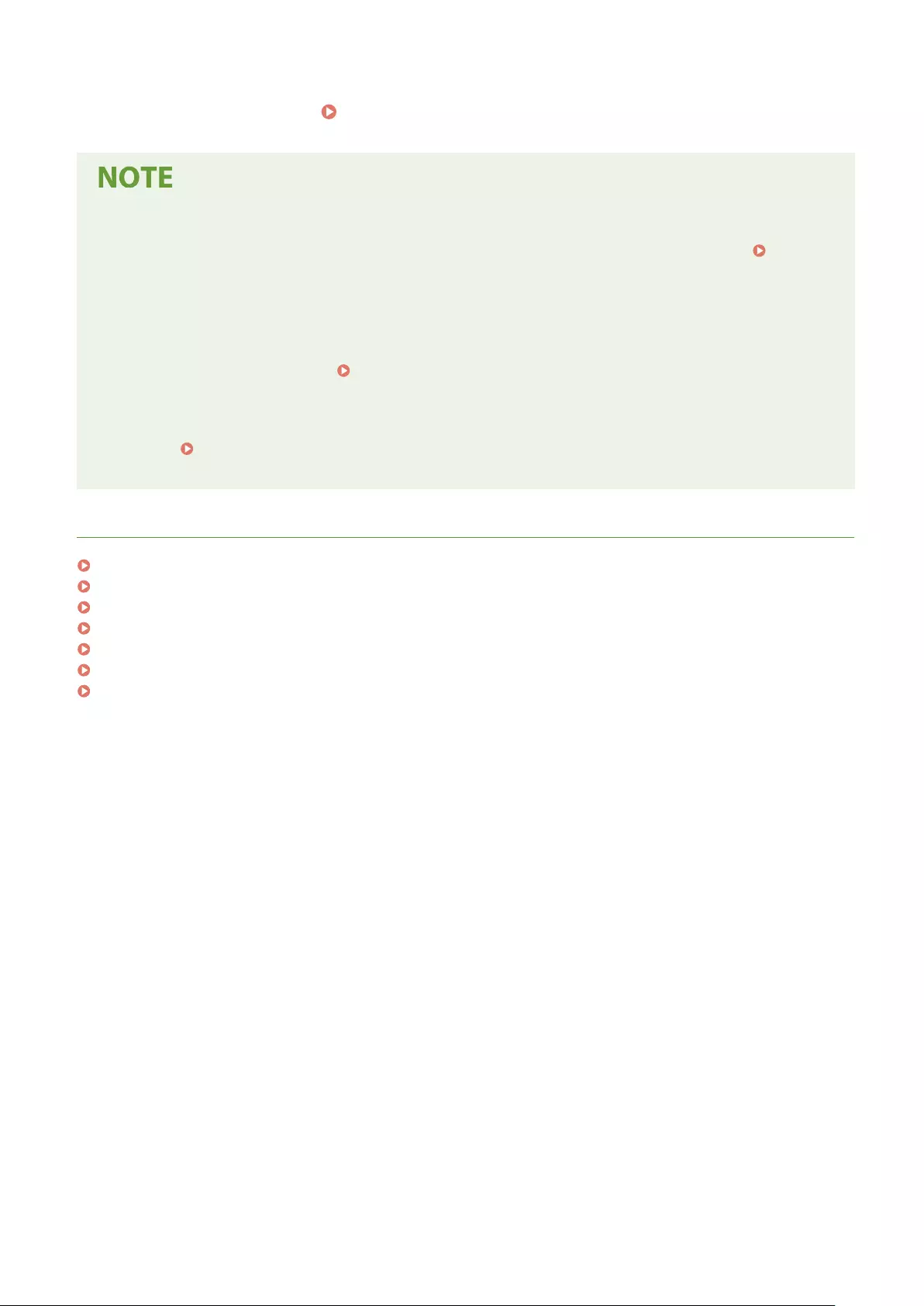
12 Restart the machine. Restarting the Machine(P. 120)
Using the operation panel
●You can also enable or disable TLS encrypted communication from <Menu> in the Home screen. <Remote
UI>(P. 567)
Starting the Remote UI with TLS
●If you try to start the Remote UI when TLS is enabled, a security alert may be displayed regarding the
security certicate. In this case, check that the correct URL is entered in the address eld, and then proceed
to display the Remote UI screen. Starting Remote UI(P. 428)
Using TLS to encrypt e-mail/I-Fax communication
●If the SMTP server and the POP3 server support TLS, you can enable TLS for communication with these
servers ( Conguring E-Mail/I-Fax Communication Settings(P. 89) ). For more information about the
SMTP server and the POP3 server, contact your Internet service provider or Network Administrator.
LINKS
Generating the Key and Certicate for Network Communication(P. 392)
Generating a Key and Certicate Signing Request (CSR)(P. 395)
Registering the Key and Certicate for Network Communication(P. 398)
Conguring IPSec Settings(P. 400)
Conguring IEEE 802.1X Authentication Settings(P. 407)
Monitoring and Controlling the Machine with SNMP(P. 69)
Registering LDAP Servers(P. 64)
Managing the Machine
391
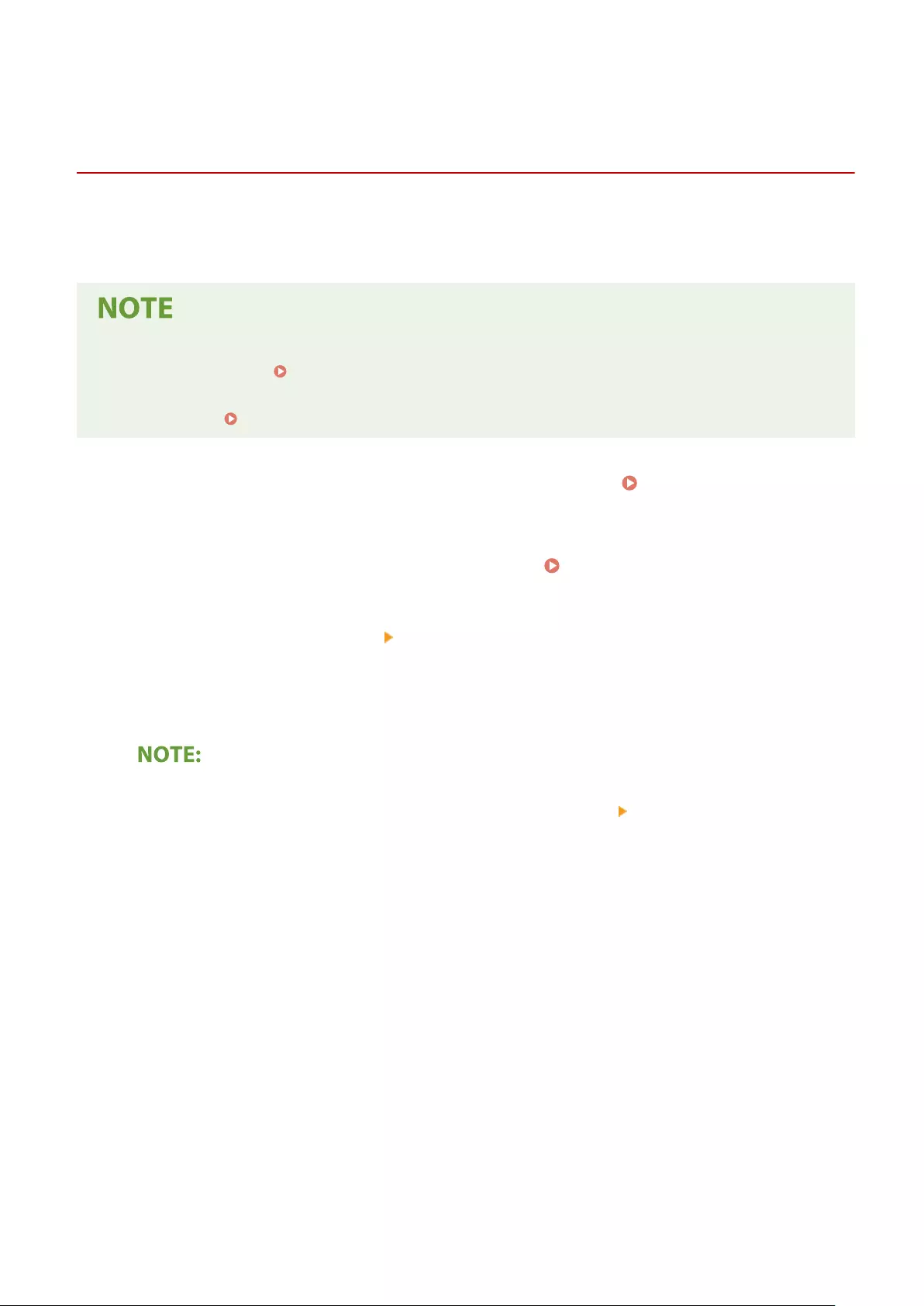
Generating the Key and Certicate for Network
Communication
6FR5-07H
A key and certicate can be generated with the machine when it is required for encrypted communication via
Transport Layer Security (TLS). You can use TLS when accessing the machine via the Remote UI. Self-signed certicates
are used with the key and certicate generated in "Network Communication."
●If you want to use a server certicate that has a CA signature, you can generate a CSR together with a key
instead of a certicate. Generating a Key and Certicate Signing Request (CSR)(P. 395)
●For more information about the basic operations to be performed when setting the machine from the
Remote UI, see Setting Up Menu Options from Remote UI(P. 437) .
1Start the Remote UI and log in to System Manager Mode. Starting Remote
UI(P. 428)
2Click [Settings/Registration] on the Portal page. Remote UI Screen(P. 429)
3Select [Device Management] [Key and Certicate Settings].
4Click [Generate Key].
Deleting a registered key and certicate
●Click [Delete] on the right of the key and certicate you want to delete click [OK].
●A key and certicate cannot be deleted if it is currently used for some purpose, such as when "[TLS]" or
"[IEEE 802.1X]" is displayed under [Key Usage]. In this case, disable the function or replace the other key
and certicate before deleting it.
5Select [Network Communication] and click [OK].
6Specify settings for the key and certicate.
Managing the Machine
392
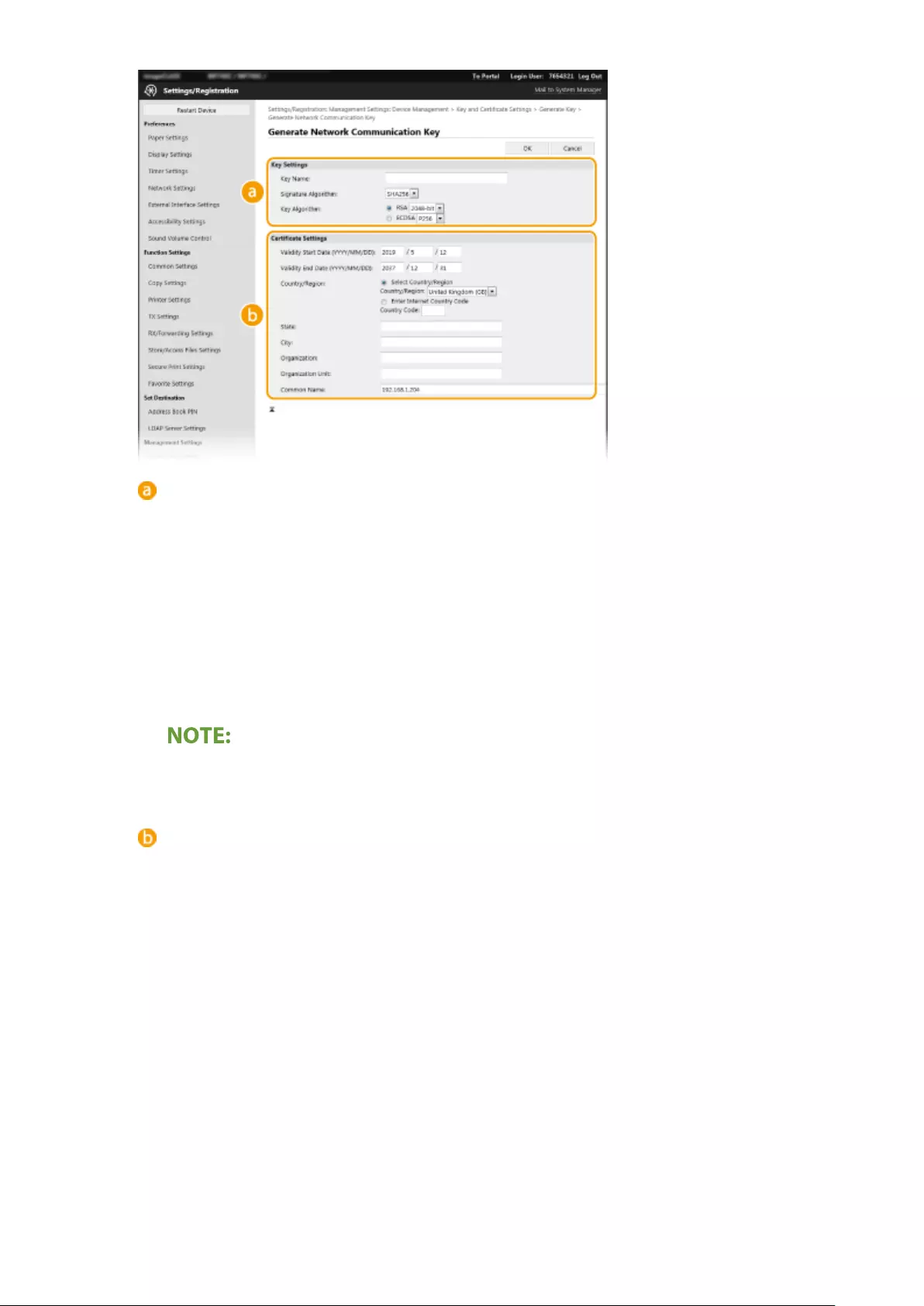
[Key Settings]
[Key Name]
Enter alphanumeric characters for naming the key. Set a name that will be easy for you to nd later in a
list.
[Signature Algorithm]
Select the signature algorithm from the drop-down list.
[Key Algorithm]
Select the key generation algorithm from [RSA] or [ECDSA], then select the key length from the drop-
down list. In either case, the larger the number for the key length is, the higher the security level
becomes. However, the communication speed becomes slower.
●When [SHA384] or [SHA512] is selected in [Signature Algorithm], [512-bit] cannot be selected as the
key length when [RSA] is selected in [Key Algorithm].
[Certicate Settings]
[Validity Start Date (YYYY/MM/DD)]
Enter the validity start date of the certicate, in the order of: year, month, day.
[Validity End Date (YYYY/MM/DD)]
Enter the validity end date of the certicate, in the order of: year, month, day. A date earlier than
[Validity Start Date (YYYY/MM/DD)] cannot be set.
[Country/Region]
Click the [Select Country/Region] radio button and select the country/region from the drop-down list.
You can also click the [Enter Internet Country Code] radio button and enter a country code, such as "US"
for the United States.
[State]/[City]
Enter alphanumeric characters for the location as necessary.
[Organization]/[Organization Unit]
Enter alphanumeric characters for the organization name as necessary.
[Common Name]
Enter alphanumeric characters for the common name of the certicate as necessary. "Common Name"
is often abbreviated as "CN."
Managing the Machine
393

7Click [OK].
●Generating a key and certicate may take some time.
●After the key and certicate is generated, it is automatically registered to the machine.
LINKS
Registering the Key and Certicate for Network Communication(P. 398)
Conguring the Key and Certicate for TLS(P. 389)
Conguring IPSec Settings(P. 400)
Managing the Machine
394
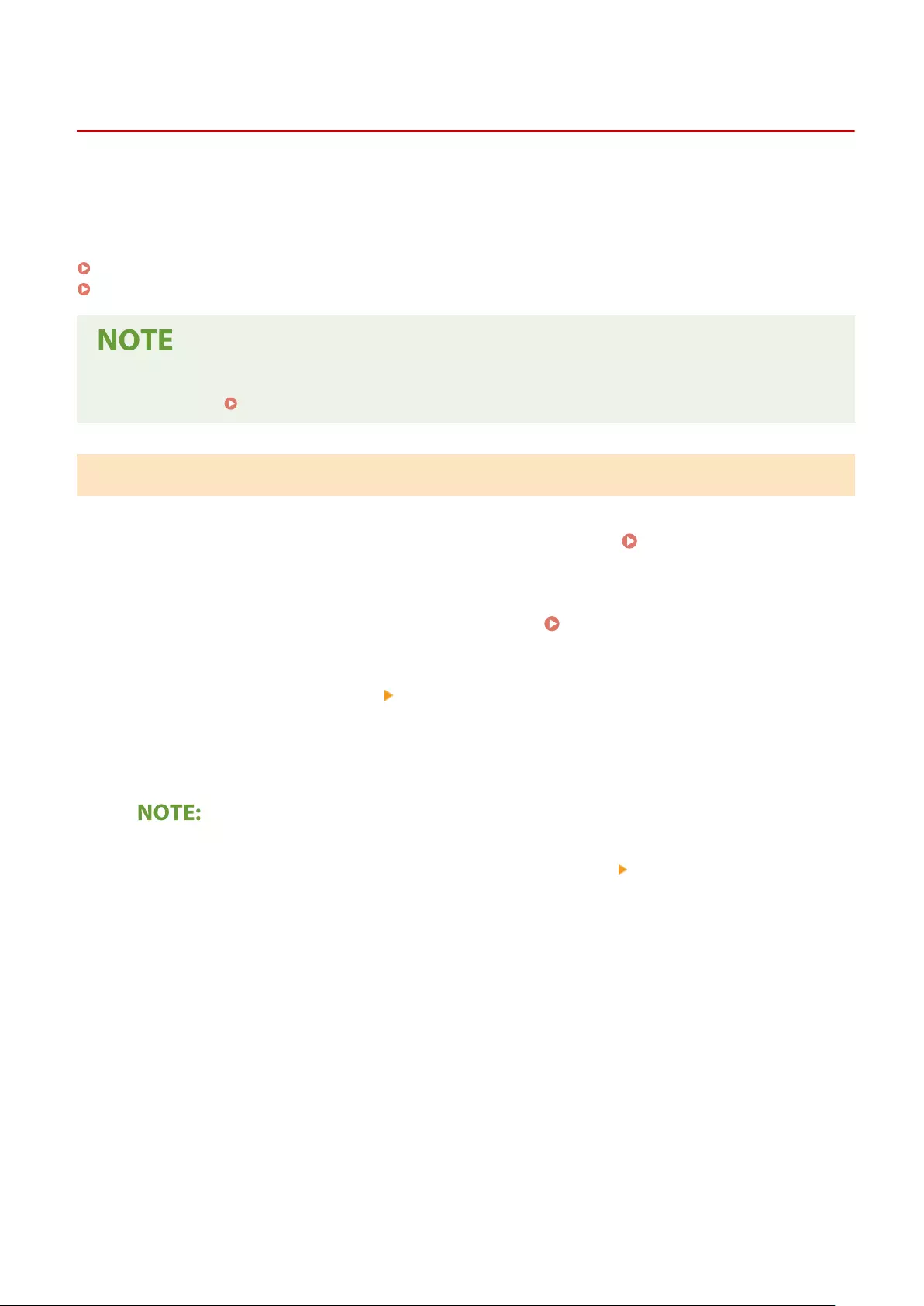
Generating a Key and Certicate Signing Request (CSR)
6FR5-07J
Because certicates generated on the machine do not have a CA signature, a communication error may result
depending on devices it communicates with. To have the certicate authority issue the certicate with the CA
signature, you need to obtain data of CSR (Certicate Signing Request), which the administrator can generate from
Remote UI. When the certicate is issued, register it in the key with the CSR generated.
Generating a Key and CSR(P. 395)
Registering a Certicate to a Key(P. 397)
●For more information about the basic operations to be performed when setting the machine from the
Remote UI, see Setting Up Menu Options from Remote UI(P. 437) .
Generating a Key and CSR
1Start the Remote UI and log in to System Manager Mode. Starting Remote
UI(P. 428)
2Click [Settings/Registration] on the Portal page. Remote UI Screen(P. 429)
3Select [Device Management] [Key and Certicate Settings].
4Click [Generate Key].
Deleting a registered key and certicate
●Click [Delete] on the right of the key and certicate you want to delete click [OK].
●A key and certicate cannot be deleted if it is currently used for some purpose, such as when "[TLS]" or
"[IEEE 802.1X]" is displayed under [Key Usage]. In this case, disable the function or replace the key and
certicate before deleting it.
5Select [Key and Certicate Signing Request (CSR)] and click [OK].
6Specify settings for the key and CSR.
Managing the Machine
395
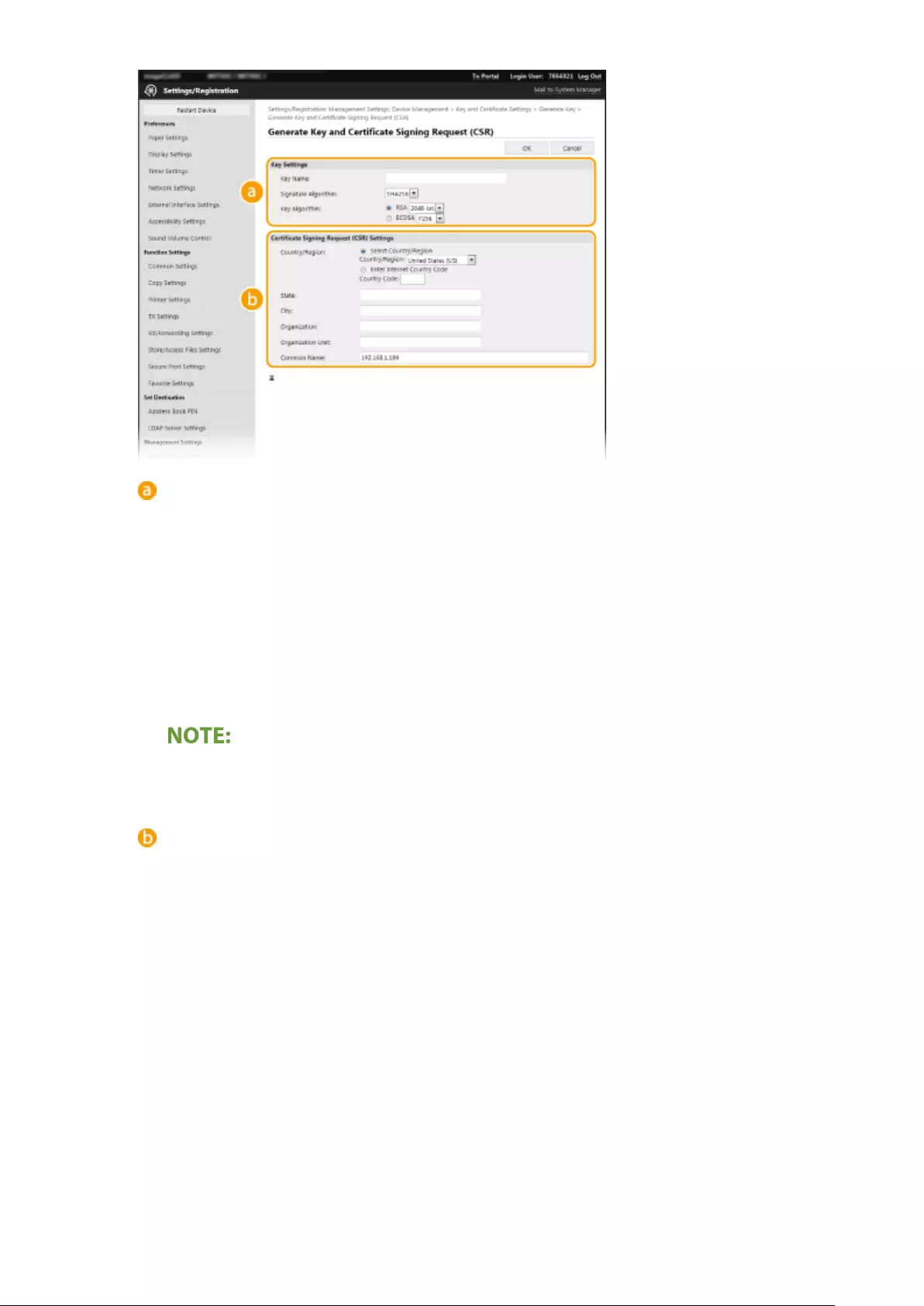
[Key Settings]
[Key Name]
Enter alphanumeric characters for naming the key. Set a name that will be easy for you to nd later in a
list.
[Signature Algorithm]
Select the signature algorithm from the drop-down list.
[Key Algorithm]
Select the key generation algorithm from [RSA] or [ECDSA], then select the key length from the drop-
down list. In any case, the larger the number for the key length, the slower the communication.
However, the security is tighter.
●When [SHA384] or [SHA512] is selected in [Signature Algorithm], [512-bit] cannot be selected as the
key length when [RSA] is selected in [Key Algorithm].
[Certicate Signing Request (CSR) Settings]
[Country/Region]
Click the [Select Country/Region] radio button and select the country/region from the drop-down list.
You can also click the [Enter Internet Country Code] radio button and enter a country code, such as "US"
for the United States.
[State]/[City]
Enter alphanumeric characters for the location as necessary.
[Organization]/[Organization Unit]
Enter alphanumeric characters for the organization name as necessary.
[Common Name]
Enter alphanumeric characters for the common name of the certicate as necessary. "Common Name"
is often abbreviated as "CN."
7Click [OK].
●Generating a key and CSR may take some time.
Managing the Machine
396
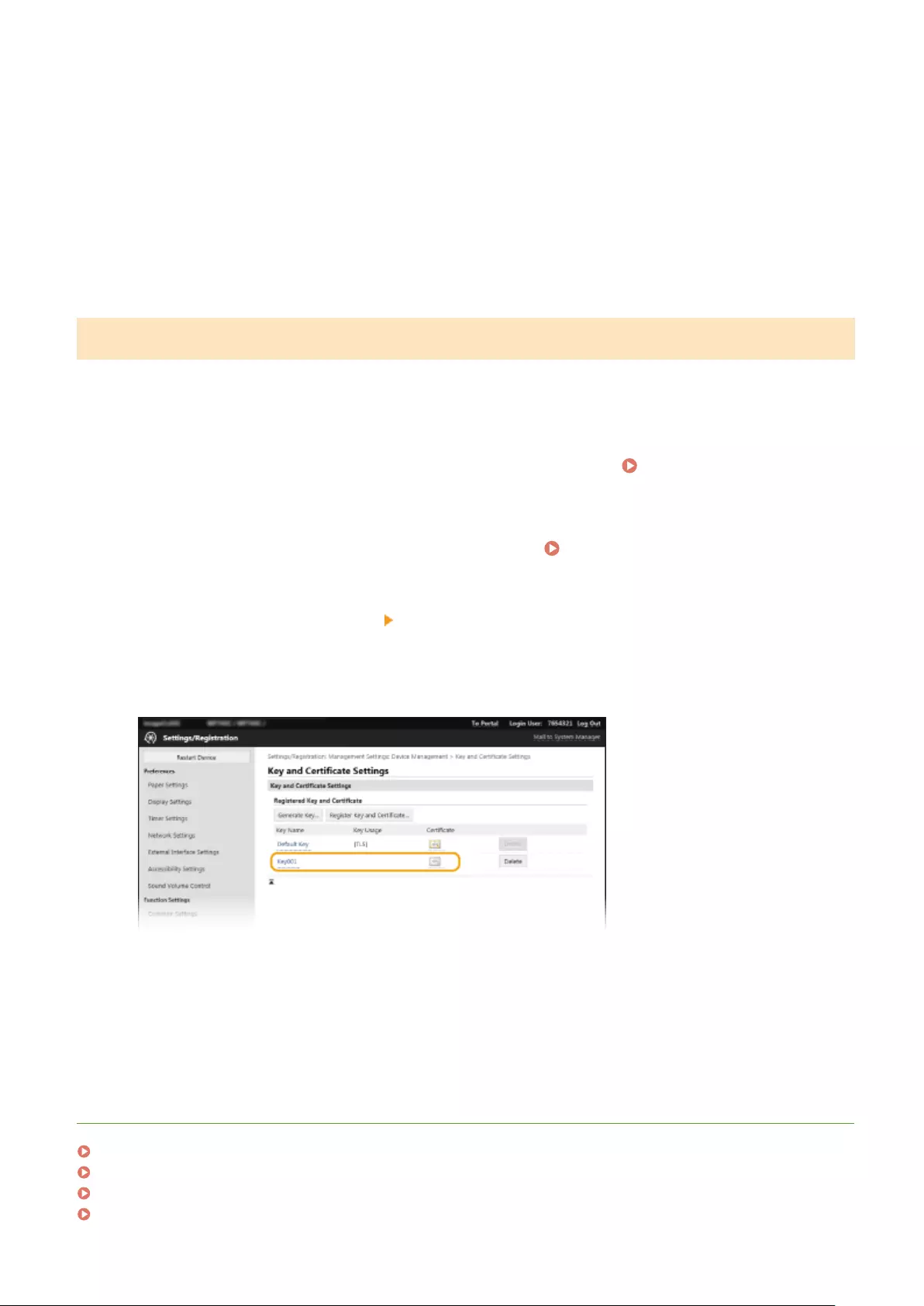
8Click [Store in File].
●A dialog box for storing the le appears. Choose where to store the le and click [Save].
➠The CSR le is stored on the computer.
9Attach the stored le and submit the application to the certication authority.
Registering a Certicate to a Key
The key with the CSR generated cannot be used until the certicate issued from the certicate authority based on the
CSR is registered in the key. Once the certication authority has issued the certicate, register it using the procedure
below.
1Start the Remote UI and log in to System Manager Mode. Starting Remote
UI(P. 428)
2Click [Settings/Registration] on the Portal page. Remote UI Screen(P. 429)
3Select [Device Management] [Key and Certicate Settings].
4Click [Key Name] or [Certicate] required to register the certicate.
5Click [Register Certicate].
6Click [Browse], specify the le for the certicate signing request, and click [Register].
LINKS
Conguring the Key and Certicate for TLS(P. 389)
Generating the Key and Certicate for Network Communication(P. 392)
Registering the Key and Certicate for Network Communication(P. 398)
Conguring IPSec Settings(P. 400)
Managing the Machine
397
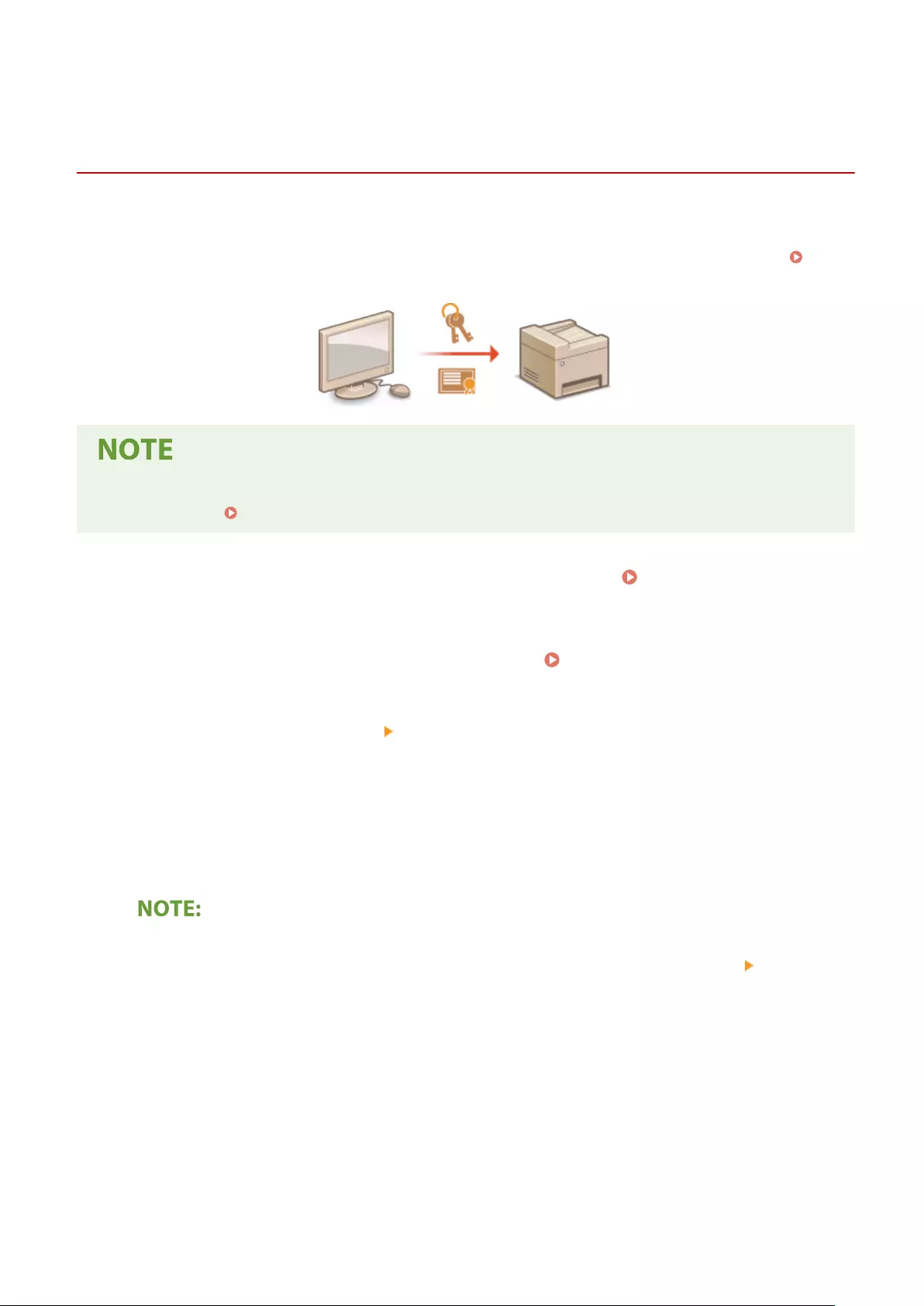
Registering the Key and Certicate for Network
Communication
6FR5-07K
You can obtain the key and certicate, and the CA certicate from a certication authority (CA) for use with the
machine. Install and register the obtained key and certicate le and CA certicate le in this machine using Remote
UI. Check the key and certicate, and CA certicate conditions that are required for the machine in advance (
Management Functions(P. 633) ).
●For more information about the basic operations to be performed when setting the machine from the
Remote UI, see Setting Up Menu Options from Remote UI(P. 437) .
1Start the Remote UI and log in to System Manager Mode. Starting Remote
UI(P. 428)
2Click [Settings/Registration] on the Portal page. Remote UI Screen(P. 429)
3Select [Device Management] [Key and Certicate Settings] or [CA Certicate
Settings].
●Click [Key and Certicate Settings] to install a key and certicate, or [CA Certicate Settings] to install a CA
certicate.
4Click [Register Key and Certicate] or [Register CA Certicate].
Deleting a registered key and certicate or CA certicate
●Click [Delete] on the right of the key and certicate or CA certicate you want to delete click [OK]. You
cannot delete the preinstalled CA certicates.
●A key and certicate cannot be deleted if it is currently used for some purpose, such as when "[TLS]" or
"[IEEE 802.1X]" is displayed under [Key Usage]. In this case, disable the function or replace the key and
certicate before deleting it.
Disabling or enabling the preinstalled CA certicates
●Click [Disable] on the right of the preinstalled CA certicate you want to disable. To enable the certicate
again, click [Enable] on the right of the certicate.
5Click [Install].
Managing the Machine
398
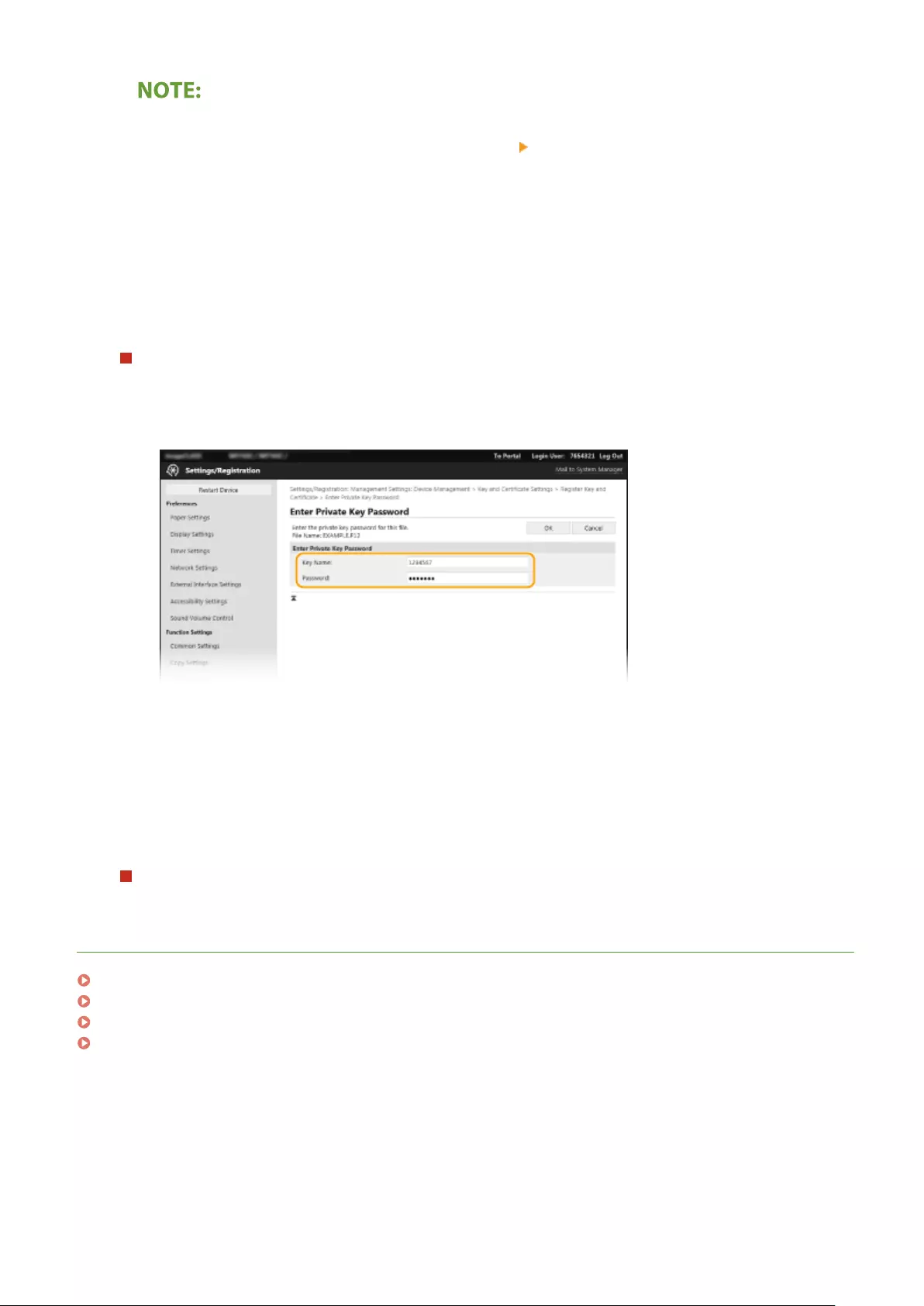
Deleting the key and certicate le or CA certicate le
●Click [Delete] on the right of the le you want to delete click [OK].
6Click [Browse], specify the le to install, and click [Start Installation].
➠The key and certicate le or the CA certicate le is installed on the machine from a computer.
7Register the key and certicate or CA certicate.
Registering a key and certicate
1Click [Register] on the right of the key and certicate le you want to register.
2Enter the name of the key and password.
[Key Name]
Enter alphanumeric characters for the name of the key to be registered.
[Password]
Enter alphanumeric characters for the password of the private key set for the le to be registered.
3Click [OK].
Registering a CA certicate
Click [Register] on the right of the CA certicate le you want to register.
LINKS
Generating the Key and Certicate for Network Communication(P. 392)
Conguring the Key and Certicate for TLS(P. 389)
Conguring IPSec Settings(P. 400)
Conguring IEEE 802.1X Authentication Settings(P. 407)
Managing the Machine
399
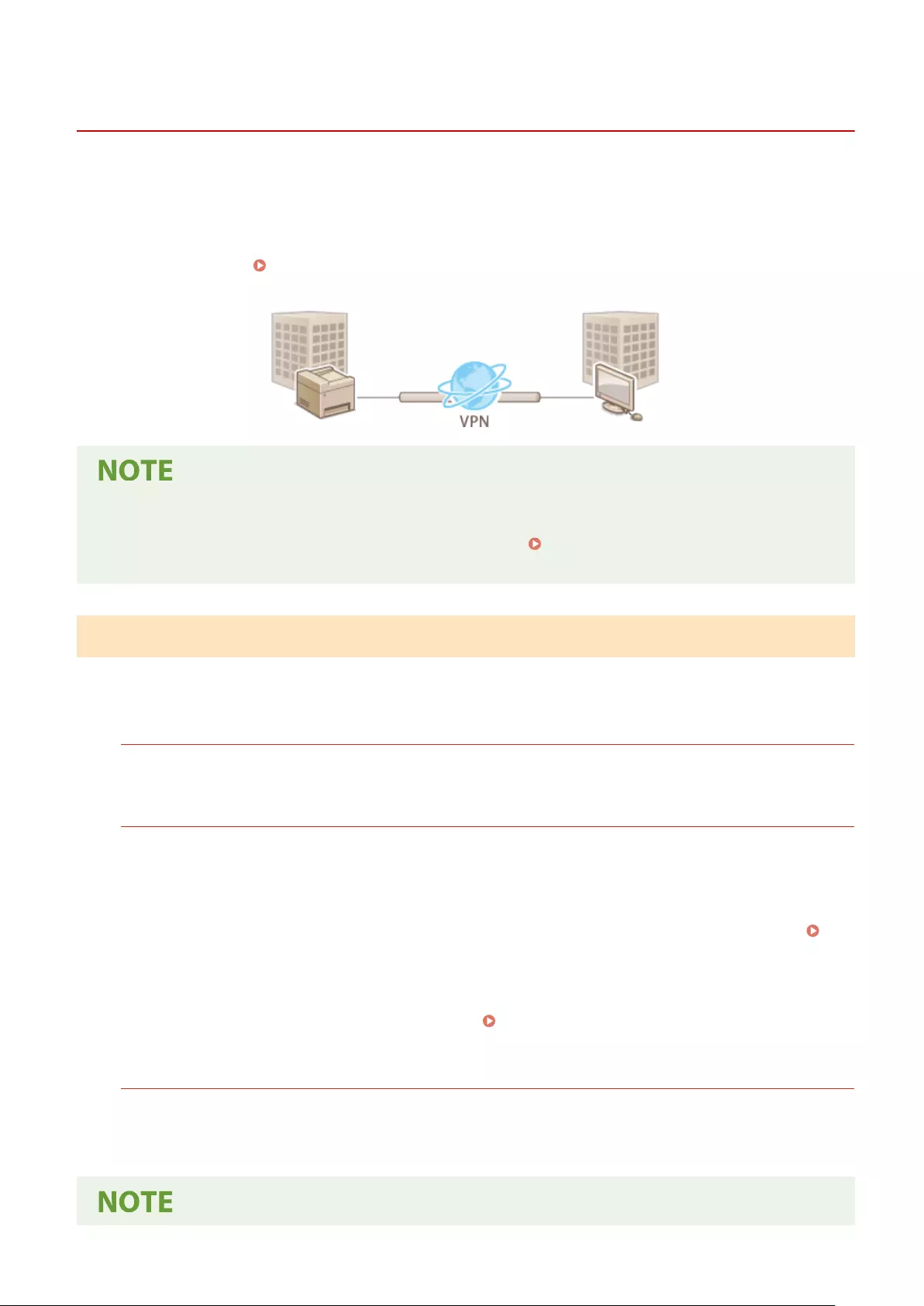
Conguring IPSec Settings
6FR5-07L
Internet Protocol Security (IPSec or IPsec) is a protocol suite for encrypting data transported over a network, including
Internet networks. While TLS only encrypts data used on a specic application, such as a Web browser or an e-mail
application, IPSec encrypts either whole IP packets or the payloads of IP packets, offering a more versatile security
system. The IPSec of the machine works in transport mode, in which the payloads of IP packets are encrypted. With
this feature, the machine can connect directly to a computer that is in the same virtual private network (VPN). Check
the system requirements ( Management Functions(P. 633) ) and set the necessary conguration on the computer
before you congure the machine.
Using IPSec with IP address lter
●IP address lter settings are applied before the IPSec policies. Specifying IP Addresses for Firewall
Settings(P. 380)
Conguring IPSec Settings
Before using IPSec for encrypted communication, you need to register security policies (SP). A security policy consists
of the groups of settings described below. After registering policies, specify the order in which they are applied.
Selector
Selector denes conditions for IP packets to apply IPSec communication. Selectable conditions include IP
addresses and port numbers of the machine and the devices to communicate with.
IKE
IKE congures the IKEv1 that is used for key exchange protocol. Note that instructions vary depending on the
authentication method selected.
[Pre-Shared Key Method]
This authentication method uses a common key word, called Shared Key, for communication between the
machine and other devices. Enable TLS for the Remote UI before specifying this authentication method (
Conguring the Key and Certicate for TLS(P. 389) ).
[Digital Signature Method]
The machine and the other devices authenticate each other by mutually verifying their digital signatures.
Generate or install the key and certicate beforehand ( Registering the Key and Certicate for Network
Communication(P. 398) ).
AH/ESP
Specify the settings for AH/ESP, which is added to packets during IPSec communication. AH and ESP can be used
at the same time. You can also select whether or not to enable PFS for tighter security.
Managing the Machine
400
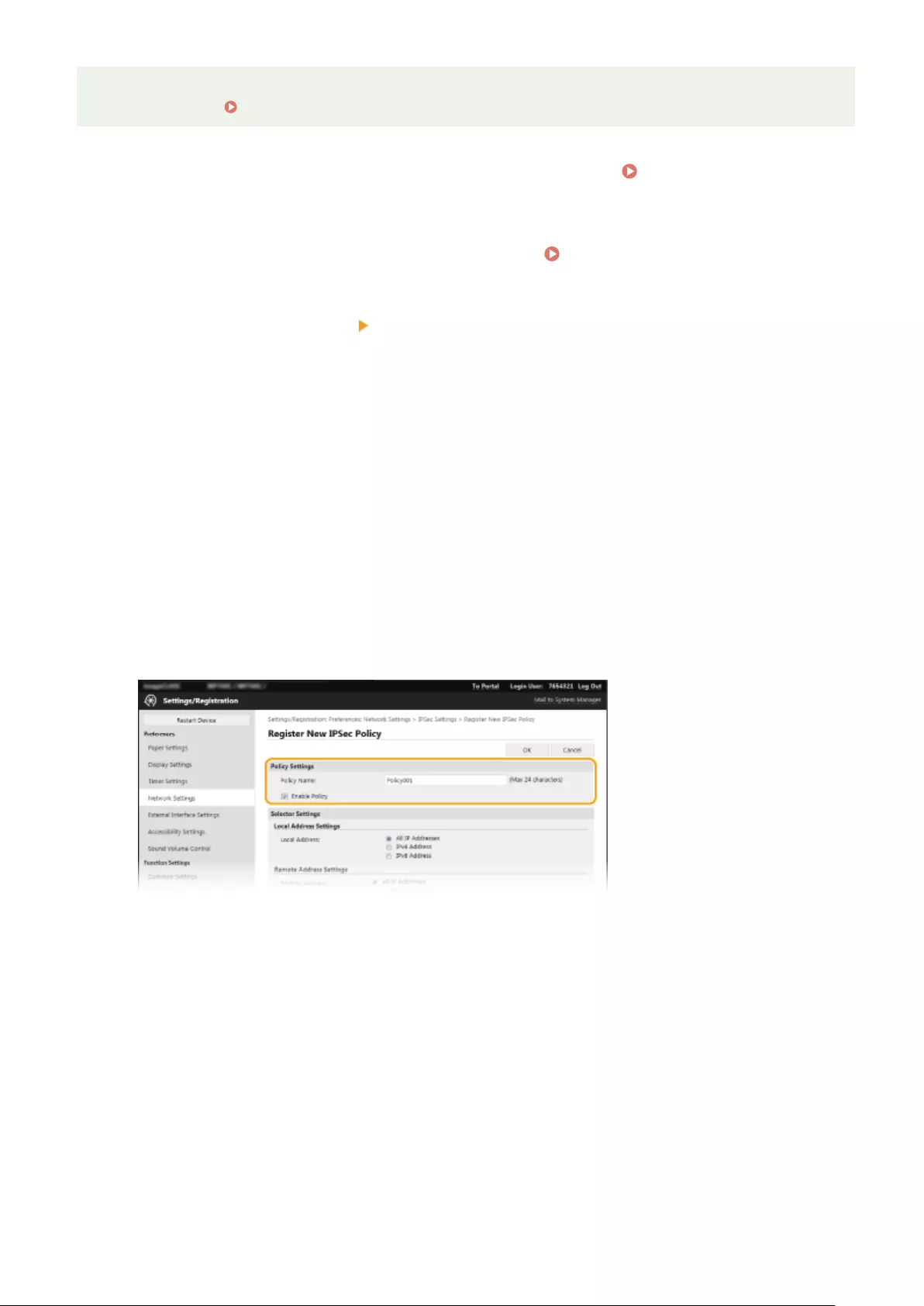
●For more information about the basic operations to be performed when setting the machine from the
Remote UI, see Setting Up Menu Options from Remote UI(P. 437) .
1Start the Remote UI and log in to System Manager Mode. Starting Remote
UI(P. 428)
2Click [Settings/Registration] on the Portal page. Remote UI Screen(P. 429)
3Select [Network Settings] [IPSec Settings].
4Click [Edit].
5Select the [Use IPSec] check box and click [OK].
●If you want the machine to only receive packets that match one of the security policies that you dene in the
steps below, clear the [Receive Non-Policy Packets] check box.
6Click [Register New Policy].
7Specify the Policy Settings.
1In the [Policy Name] text box, enter alphanumeric characters for a name that is used for identifying the
policy.
2Select the [Enable Policy] check box.
8Specify the Selector Settings.
Managing the Machine
401
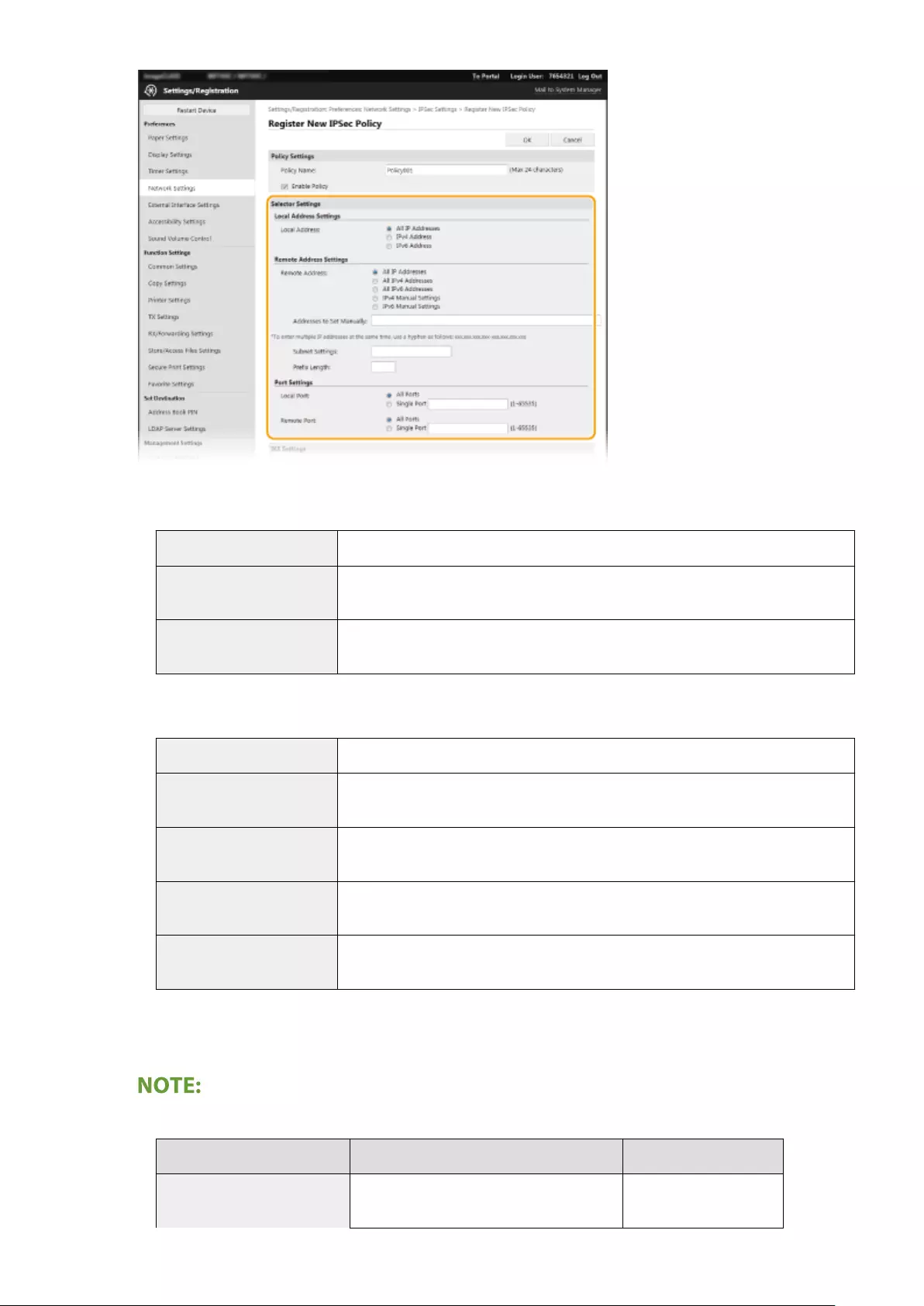
[Local Address]
Click the radio button for the type of IP address of the machine to apply the policy.
[All IP Addresses] Select to use IPSec for all IP packets.
[IPv4 Address] Select to use IPSec for all IP packets that are sent to or from the IPv4 address of the
machine.
[IPv6 Address] Select to use IPSec for all IP packets that are sent to or from an IPv6 address of the
machine.
[Remote Address]
Click the radio button for the type of IP address of the other devices to apply the policy.
[All IP Addresses] Select to use IPSec for all IP packets.
[All IPv4 Addresses] Select to use IPSec for all IP packets that are sent to or from IPv4 addresses of the
other devices.
[All IPv6 Addresses] Select to use IPSec for all IP packets that are sent to or from IPv6 addresses of the
other devices.
[IPv4 Manual Settings] Select to specify a single IPv4 address or a range of IPv4 addresses to apply IPSec.
Enter the IPv4 address (or the range) in the [Addresses to Set Manually] text box.
[IPv6 Manual Settings] Select to specify a single IPv6 address or a range of IPv6 addresses to apply IPSec.
Enter the IPv6 address (or the range) in the [Addresses to Set Manually] text box.
[Addresses to Set Manually]
If [IPv4 Manual Settings] or [IPv6 Manual Settings] is selected for [Remote Address], enter the IP address to
apply the policy. You can also enter a range of addresses by inserting a hyphen between the addresses.
Entering IP addresses
Description Example
Entering a single address IPv4:
Delimit numbers with periods.
192.168.0.10
Managing the Machine
402
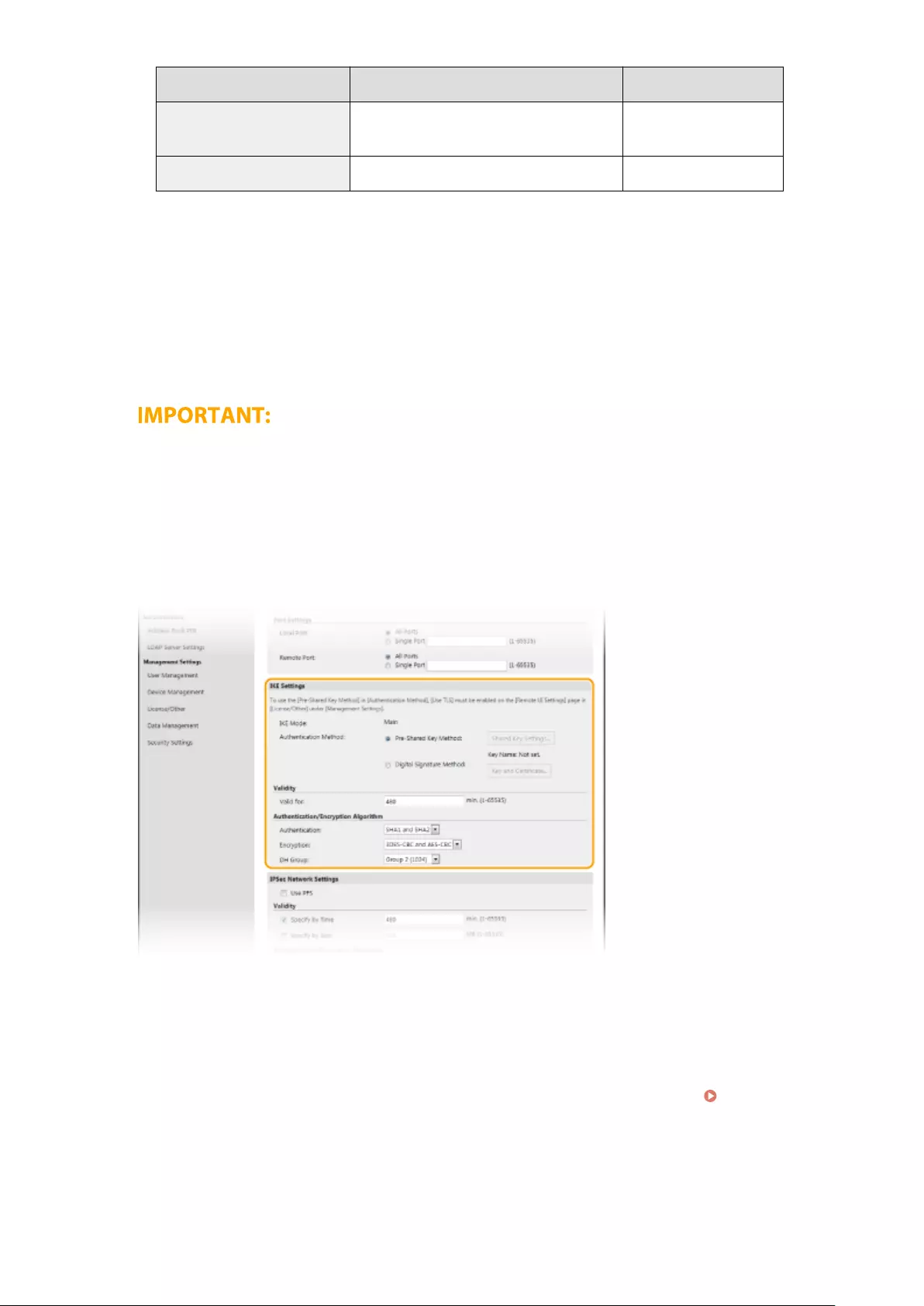
Description Example
IPv6:
Delimit alphanumeric characters with colons.
fe80::10
Specifying a range of addresses Insert a hyphen between the addresses. 192.168.0.10-192.168.0.20
[Subnet Settings]
When manually specifying IPv4 address, you can express the range by using the subnet mask. Enter the
subnet mask using periods to delimit numbers (example:"255.255.255.240").
[Prex Length]
Specifying the range of IPv6 addresses manually also allows you to specify the range using prexes. Enter a
range between 0 and 128 as the prex length.
[Local Port]/[Remote Port]
If you want to create separate policies for each protocol, such as HTTP or WSD, click the [Single Port] radio
button and enter the appropriate port number for the protocol to determine whether to use IPSec.
IPSec is not applied to the following packets
●Loopback, multicast, and broadcast packets
●IKE packets (using UDP on port 500)
●ICMPv6 neighbor solicitation and neighbor advertisement packets
9Specify the IKE Settings.
[IKE Mode]
The mode used for the key exchange protocol is displayed. The machine supports the main mode, not the
aggressive mode.
[Authentication Method]
Select [Pre-Shared Key Method] or [Digital Signature Method] for the method used when authenticating the
machine. You need to enable TLS for the Remote UI before selecting [Pre-Shared Key Method]. You need to
generate or install the key and certicate before selecting [Digital Signature Method]. Conguring the
Key and Certicate for TLS(P. 389)
[Valid for]
Specify how long a session lasts for IKE SA (ISAKMP SA). Enter the time in minutes.
[Authentication]/[Encryption]/[DH Group]
Select an algorithm from the drop-down list. Each algorithm is used in the key exchange.
Managing the Machine
403
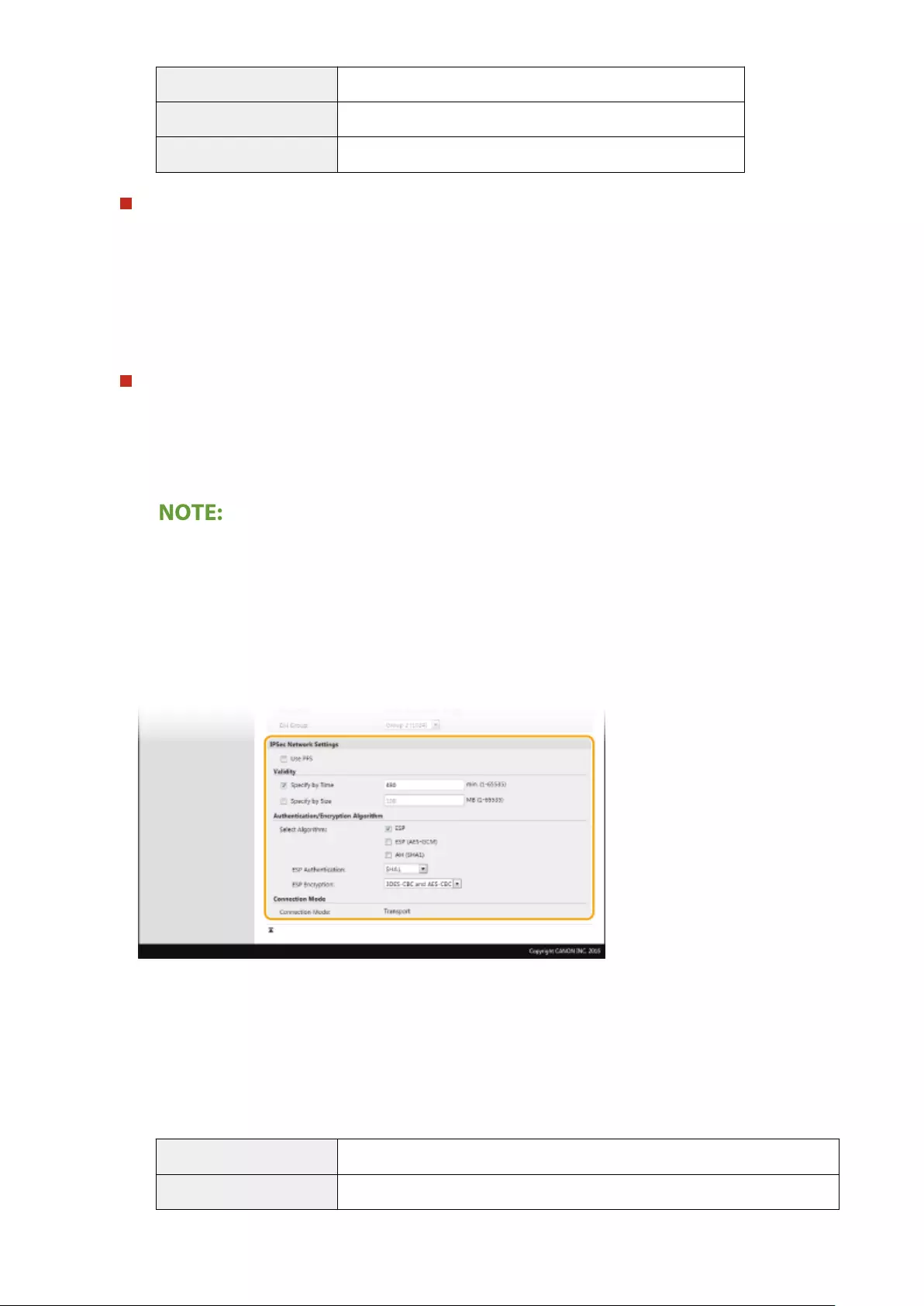
[Authentication] Select the hash algorithm.
[Encryption] Select the encryption algorithm.
[DH Group] Select the Die-Hellman group, which determines the key strength.
Authenticating a machine using a pre-shared key
1Click the [Pre-Shared Key Method] radio button for [Authentication Method] and then click [Shared Key
Settings].
2Enter alphanumeric characters for the pre-shared key and click [OK].
3Specify the [Valid for] and [Authentication]/[Encryption]/[DH Group] settings.
Authenticating a machine using digital signature method
1Click the [Digital Signature Method] radio button for [Authentication Method] and then click [Key and
Certicate].
2Click [Register Default Key] on the right of the key and certicate you want to use.
Viewing details of a certicate
●You can check the details of the certicate or verify the certicate by clicking the corresponding text
link under [Key Name], or the certicate icon.
3Specify the [Valid for] and [Authentication]/[Encryption]/[DH Group] settings.
10 Specify the IPSec Network Settings.
[Use PFS]
Select the check box to enable Perfect Forward Secrecy (PFS) for IPSec session keys. Enabling PFS enhances
the security while increasing the load on the communication. Make sure that PFS is also enabled for the other
devices.
[Specify by Time]/[Specify by Size]
Set the conditions for terminating a session for IPSec SA. IPSec SA is used as a communication tunnel. Select
either or both of the check boxes as necessary. If both check boxes are selected, the IPSec SA session is
terminated when either of the conditions has been satised.
[Specify by Time] Enter a time in minutes to specify how long a session lasts.
[Specify by Size] Enter a size in megabytes to specify how much data can be transported in a session.
Managing the Machine
404
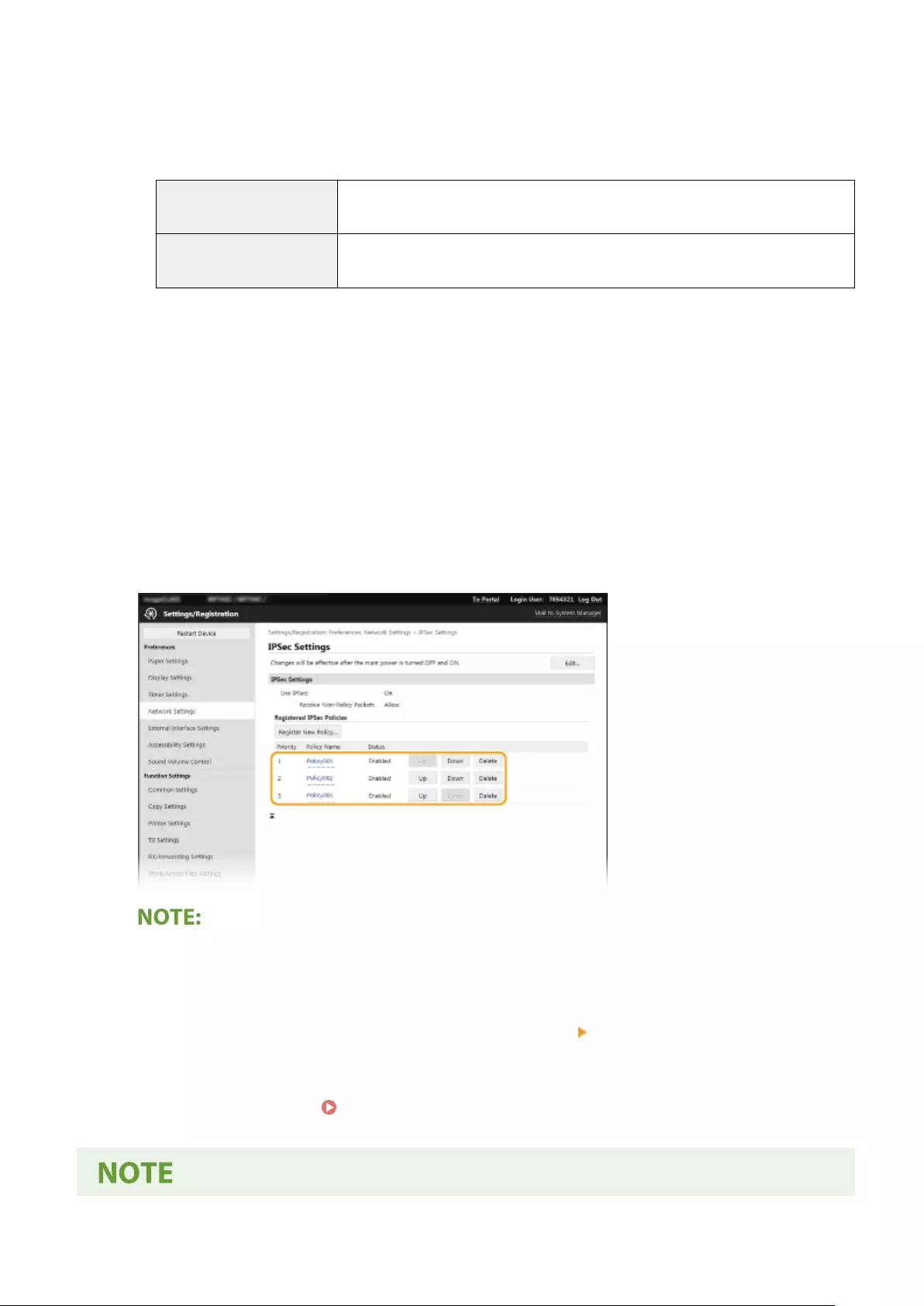
[Select Algorithm]
Select the [ESP], [ESP (AES-GCM)], or [AH (SHA1)] check box(es) depending on the IPSec header and the
algorithm used. AES-GCM is an algorithm for both authentication and encryption. If [ESP] is selected, also
select algorithms for authentication and encryption from the [ESP Authentication] and [ESP Encryption] drop-
down lists.
[ESP Authentication] To enable the ESP authentication, select [SHA1] for the hash algorithm. Select [Do Not
Use] if you want to disable the ESP authentication.
[ESP Encryption] Select the encryption algorithm for ESP. You can select [NULL] if you do not want to
specify the algorithm, or select [Do Not Use] if you want to disable the ESP encryption.
[Connection Mode]
The connection mode of IPSec is displayed. The machine supports transport mode, in which the payloads of
IP packets are encrypted. Tunnel mode, in which whole IP packets (headers and payloads) are encapsulated
is not available.
11 Click [OK].
●If you need to register an additional security policy, return to step 6.
12 Arrange the order of policies listed under [Registered IPSec Policies].
●Policies are applied from one at the highest position to the lowest. Click [Up] or [Down] to move a policy up or
down the order.
Editing a policy
●Click the corresponding text link under [Policy Name] for the edit screen.
Deleting a policy
●Click [Delete] on the right of the policy name you want to delete click [OK].
13 Restart the machine. Restarting the Machine(P. 120)
Managing the Machine
405
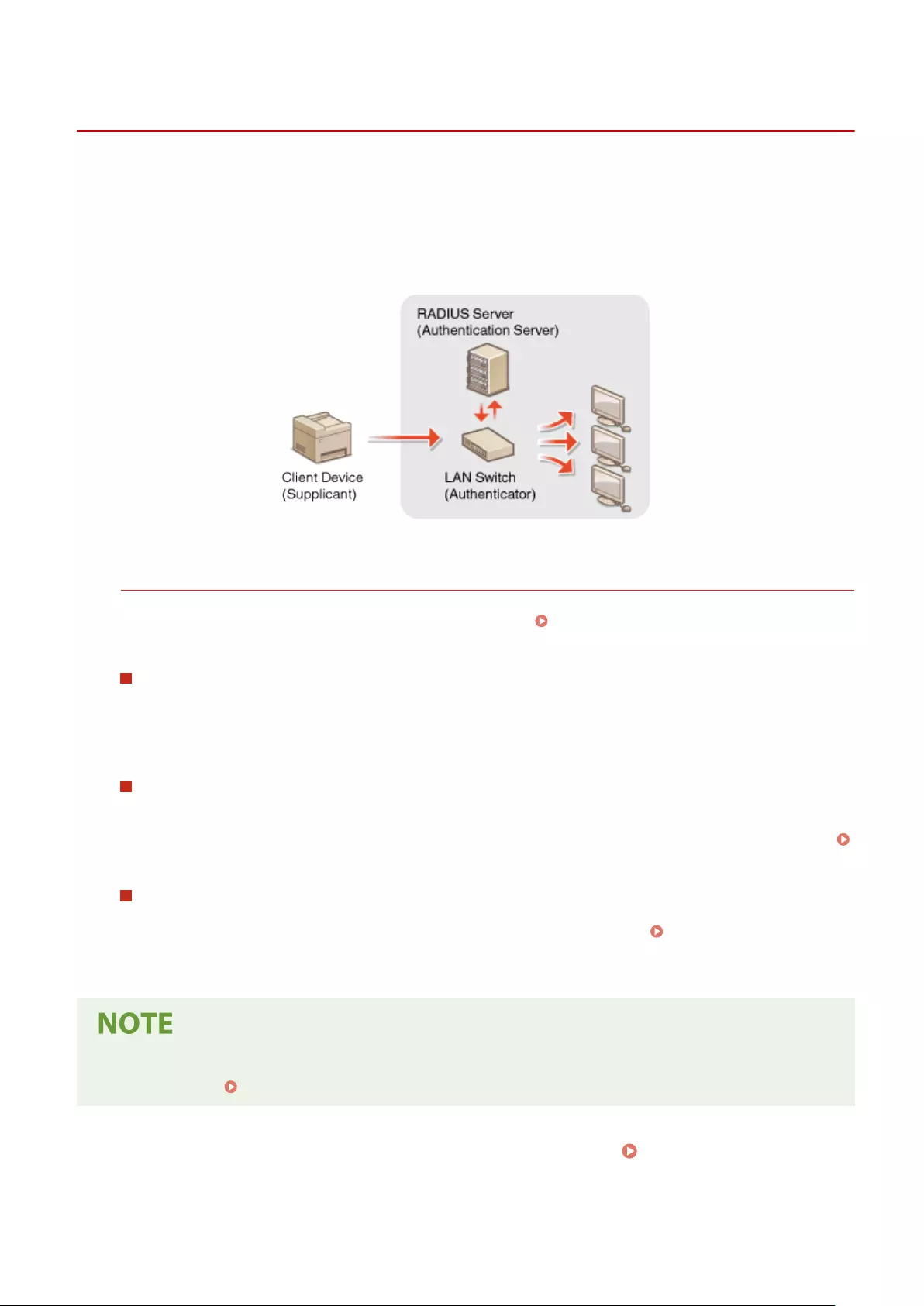
Conguring IEEE 802.1X Authentication Settings
6FR5-07R
The machine can connect to an 802.1X network as a client device. A typical 802.1X network consists of a RADIUS server
(authentication server), LAN switch (authenticator), and client devices with authentication software (supplicants). If a
device tries to connect to the 802.1X network, the device must go through user authentication in order to prove that
the connection is made by an authorized user. Authentication information is sent to and checked by a RADIUS server,
which permits or rejects communication to the network depending on the authentication result. If authentication fails,
a LAN switch (or an access point) blocks access from the outside of the network.
IEEE 802.1X Authentication Method
Select the authentication method from the options below. If necessary, install or register a key and certicate or
a CA certicate before conguring IEEE 802.1X authentication ( Registering the Key and Certicate for
Network Communication(P. 398) ).
TLS
The machine and the authentication server authenticate each other by mutually verifying their certicates. A
key and certicate issued by a certication authority (CA) is required for the client authentication (when
authenticating the machine). For the server authentication, a CA certicate installed via the Remote UI can be
used in addition to a CA certicate preinstalled in the machine.
TTLS
This authentication method uses a user name and password for the client authentication and a CA certicate
for the server authentication. MSCHAPv2 or PAP can be selected as the internal protocol. TTLS can be used
with PEAP at the same time. Enable TLS for the Remote UI before conguring this authentication method (
Conguring the Key and Certicate for TLS(P. 389) ).
PEAP
The required settings are almost the same as those of TTLS. MSCHAPv2 is used as the internal protocol.
Enable TLS for the Remote UI before conguring this authentication method ( Conguring the Key and
Certicate for TLS(P. 389) ).
●For more information about the basic operations to be performed when setting the machine from the
Remote UI, see Setting Up Menu Options from Remote UI(P. 437) .
1Start the Remote UI and log in to System Manager Mode. Starting Remote
UI(P. 428)
Managing the Machine
407
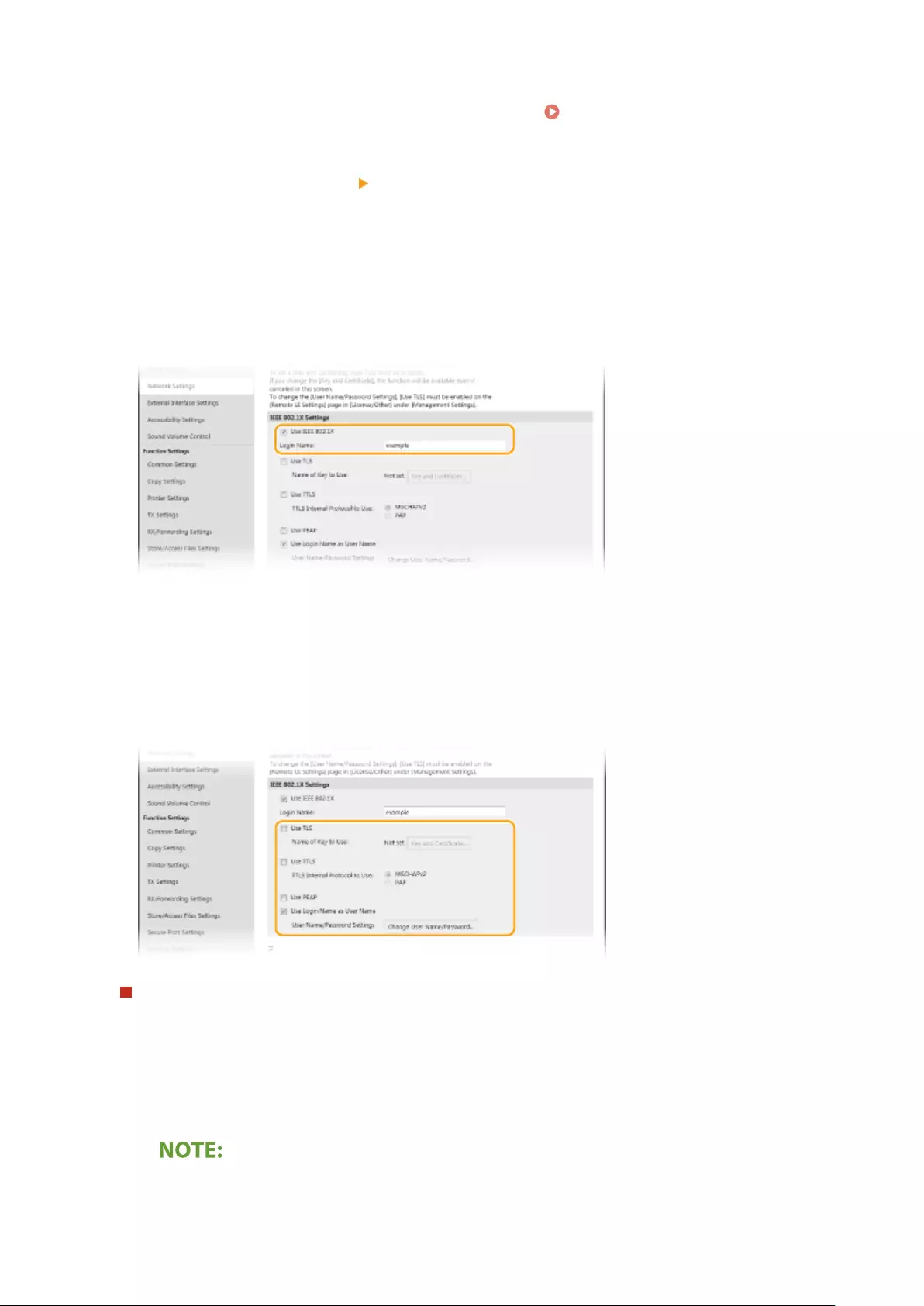
2Click [Settings/Registration] on the Portal page. Remote UI Screen(P. 429)
3Select [Network Settings] [IEEE 802.1X Settings].
4Click [Edit].
5Select the [Use IEEE 802.1X] check box, and enter the login name in the [Login Name]
text box.
[Use IEEE 802.1X]
Select the check box to enable IEEE 802.1X authentication.
[Login Name]
Enter alphanumeric characters for a name (EAP identity) that is used for identifying the user.
6Congure the required settings according to the specied authentication method.
Setting TLS
1Select the [Use TLS] check box and click [Key and Certicate].
●You cannot use TLS with TTLS or PEAP.
2Click [Register Default Key] on the right of the key and certicate you want to use for the client
authentication.
Viewing details of a certicate
●You can check the details of the certicate or verify the certicate by clicking the corresponding text
link under [Key Name], or the certicate icon.
Managing the Machine
408
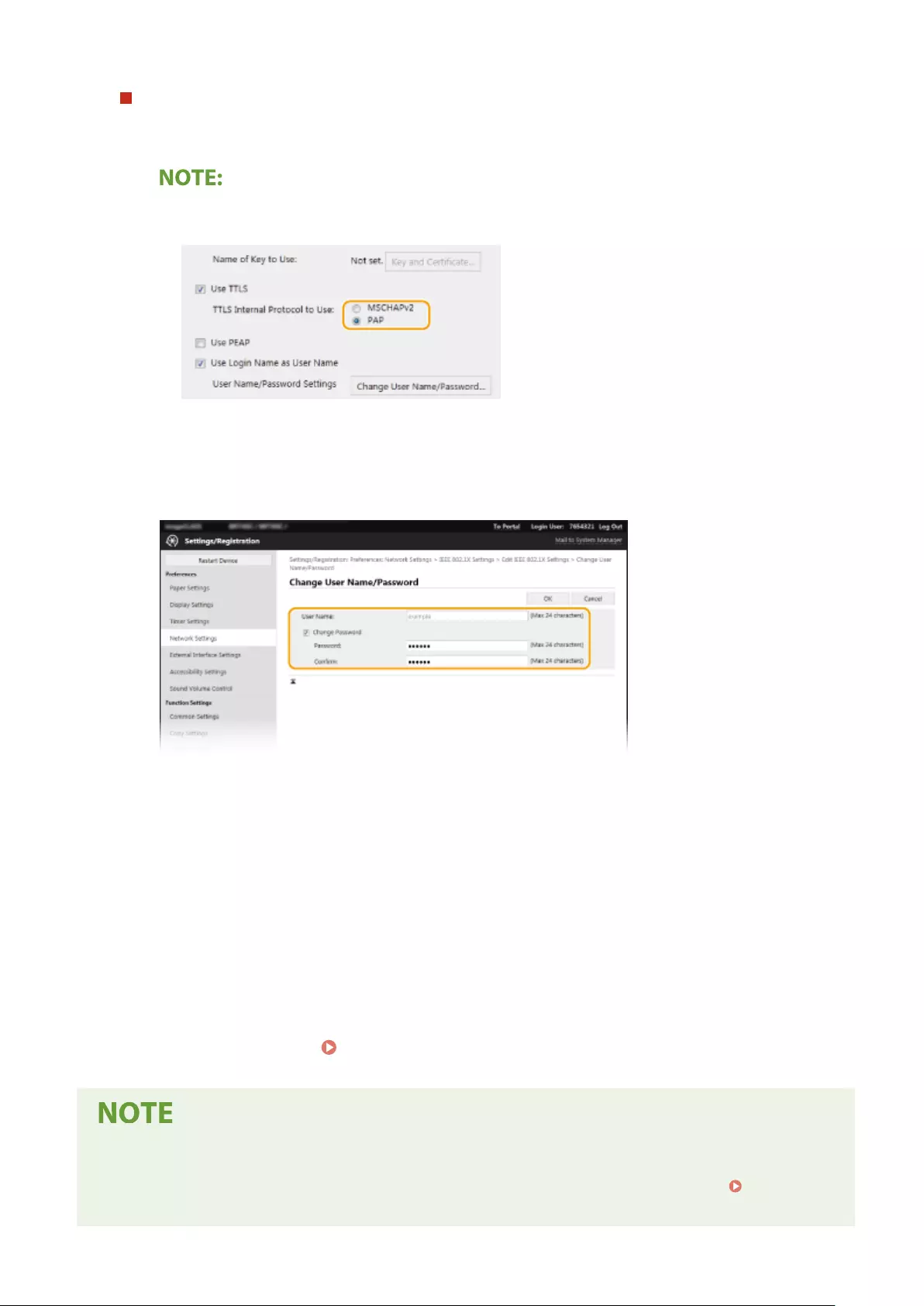
Setting TTLS/PEAP
1Select the [Use TTLS] or [Use PEAP] check box.
Internal protocol for TTLS
●You can select MSCHAPv2 or PAP.
2Click [Change User Name/Password].
●To specify a user name other than the login name, clear the [Use Login Name as User Name] check
box. Select the check box if you want to use the login name as the user name.
3Set the user name/password.
[User Name]
Enter alphanumeric characters for the user name.
[Change Password]
To set or change the password, select the check box and enter alphanumeric characters for the new
password both in the [Password] and [Conrm] text boxes.
4Click [OK].
7Click [OK].
8Restart the machine. Restarting the Machine(P. 120)
Using the operation panel
●You can also enable or disable IEEE 802.1X authentication from <Menu> in the Home screen. <Use IEEE
802.1X>(P. 484)
Managing the Machine
409
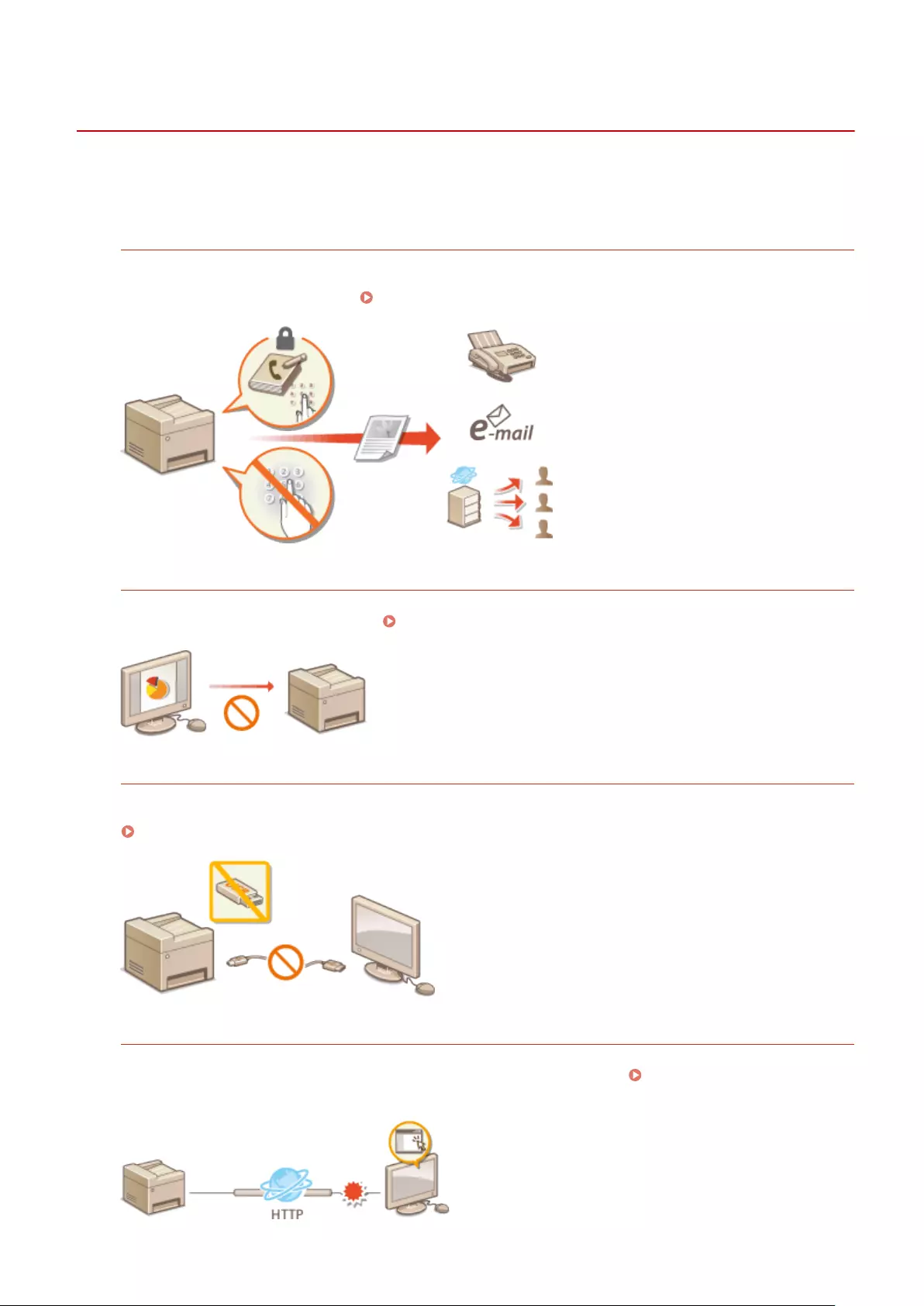
Restricting the Machine's Functions
6FR5-07S
Some of the functions of the machine may rarely be used or provide opportunities for misuse. For security purposes,
the machine can be set to limit its capabilities by partially or completely disabling these functions.
Restricting Access to Address Book and Sending Functions
You can specify the PIN in the Address Book to disable a general user from modifying data or limit destinations
that can be specied for fax sending. You can also disable a user from collectively sending a fax to multiple
destinations (Sequential Broadcast). Restricting Access to Address Book and Sending Functions(P. 413)
Restricting Printing from a Computer
You can limit "printing from computer" only to secure documents so that no print jobs can be executed unless
the PIN is entered on the machine side. Restricting Printing from a Computer(P. 420)
Restricting USB Functions
The USB connection allows an easy connection with peripheral devices, but it may cause a security risk such as
an information leakage. You can restrict a USB connection with a computer or saving to a USB memory device.
Restricting USB Functions(P. 421)
Disabling HTTP Communication
When not performing operations via the network, for example, when using the machine via USB connection,
you can disable HTTP communication to prevent a hacking via the HTTP port. Disabling HTTP
Communication(P. 423)
Managing the Machine
411
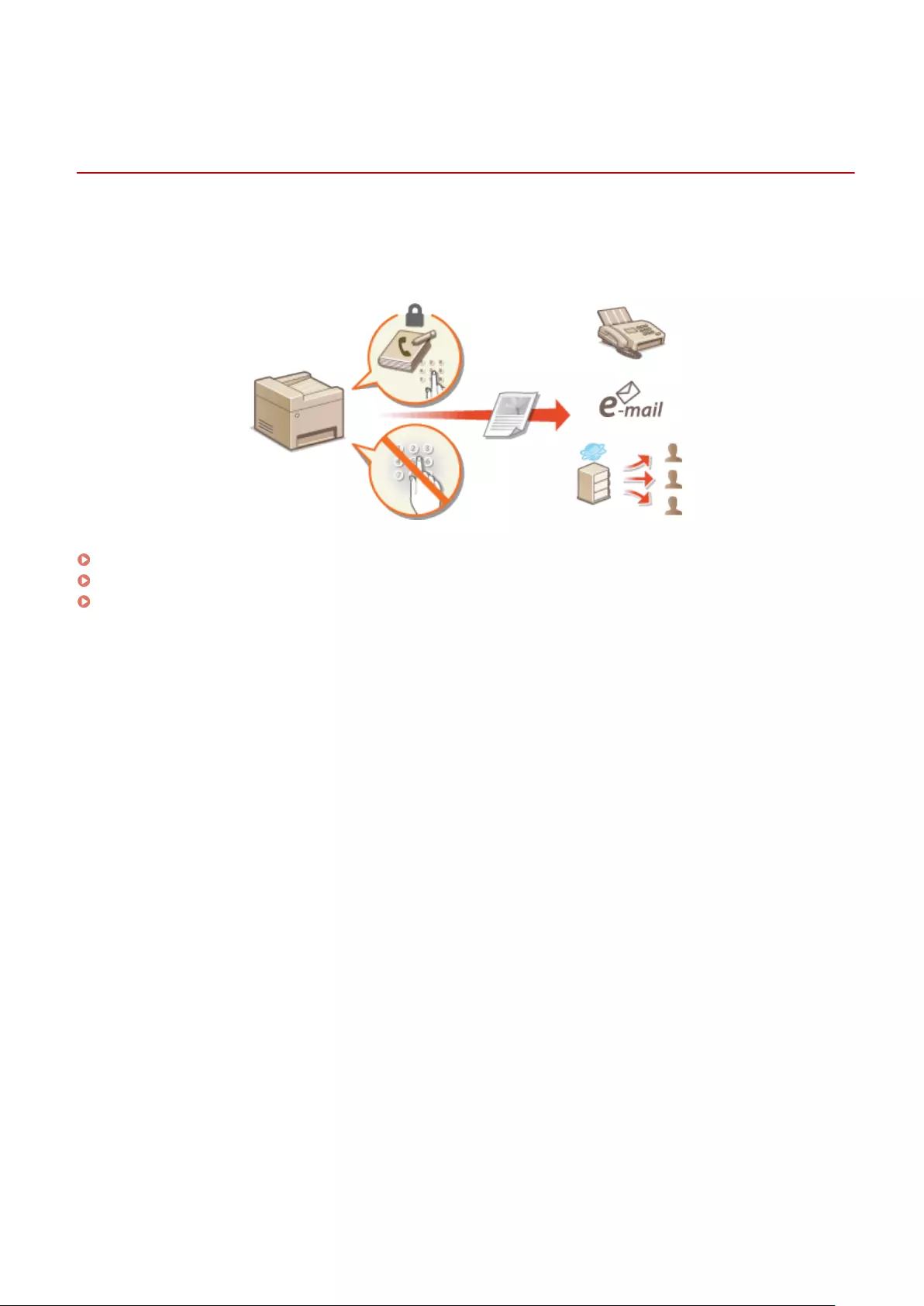
Restricting Access to Address Book and Sending
Functions
6FR5-07U
Some cases of information leakage can be prevented by limiting the available fax and e-mail destinations to those
registered in the Address Book or LDAP servers, or by setting a PIN for the Address Book so that unauthorized users
cannot add or edit Address Book entries. You can also avoid sending documents to unintended recipients if the
machine is set to ask you to enter the fax number twice for conrmation.
Restricting Use of the Address Book(P. 414)
Limiting Available Destinations(P. 416)
Restricting the Fax Sending Functions(P. 418)
Managing the Machine
413
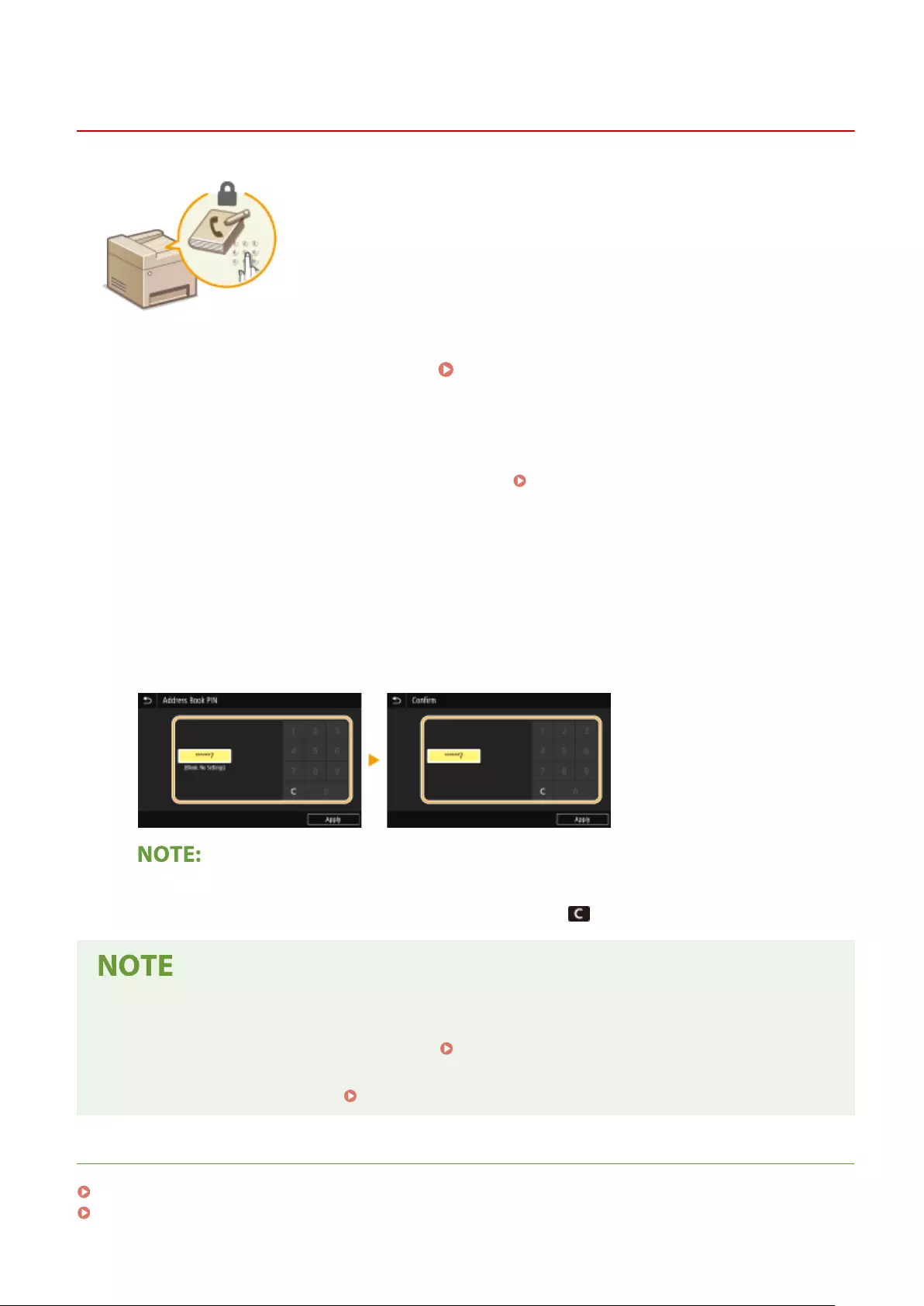
Restricting Use of the Address Book
6FR5-07W
The Address Book can be set to require users to enter a PIN in order to add new
entries to the Address Book or edit existing entries. Setting a PIN to the Address
Book can reduce the risk of documents being sent to unintended recipients because
changes to the Address Book can only be made by users who know the PIN.
1Select <Menu> in the Home screen. Home Screen(P. 124)
2Select <Set Destination>.
●If the login screen appears, enter the correct ID and PIN. Logging in to the Machine(P. 135)
3Select <Address Book PIN>.
4Specify the PIN.
●Enter the number, and select <Apply>.
●The Conrm screen is displayed. Enter the PIN once again to conrm.
●You cannot set a PIN that consists only of zeros, such as "00" or "0000000".
●To cancel the PIN setting, clear the information you entered in and select <Apply> with the eld blank.
In addition to setting the Address Book PIN, you can further enhance security by performing the following
operations:
●Restricting the addition of new destinations, see Restricting New Destinations that Can Be
Specied(P. 416) .
●Disabling the PC fax function, see Restricting Fax Sending from a Computer(P. 418) .
LINKS
Registering Destinations(P. 180)
Registering Destinations from Remote UI(P. 440)
Managing the Machine
414
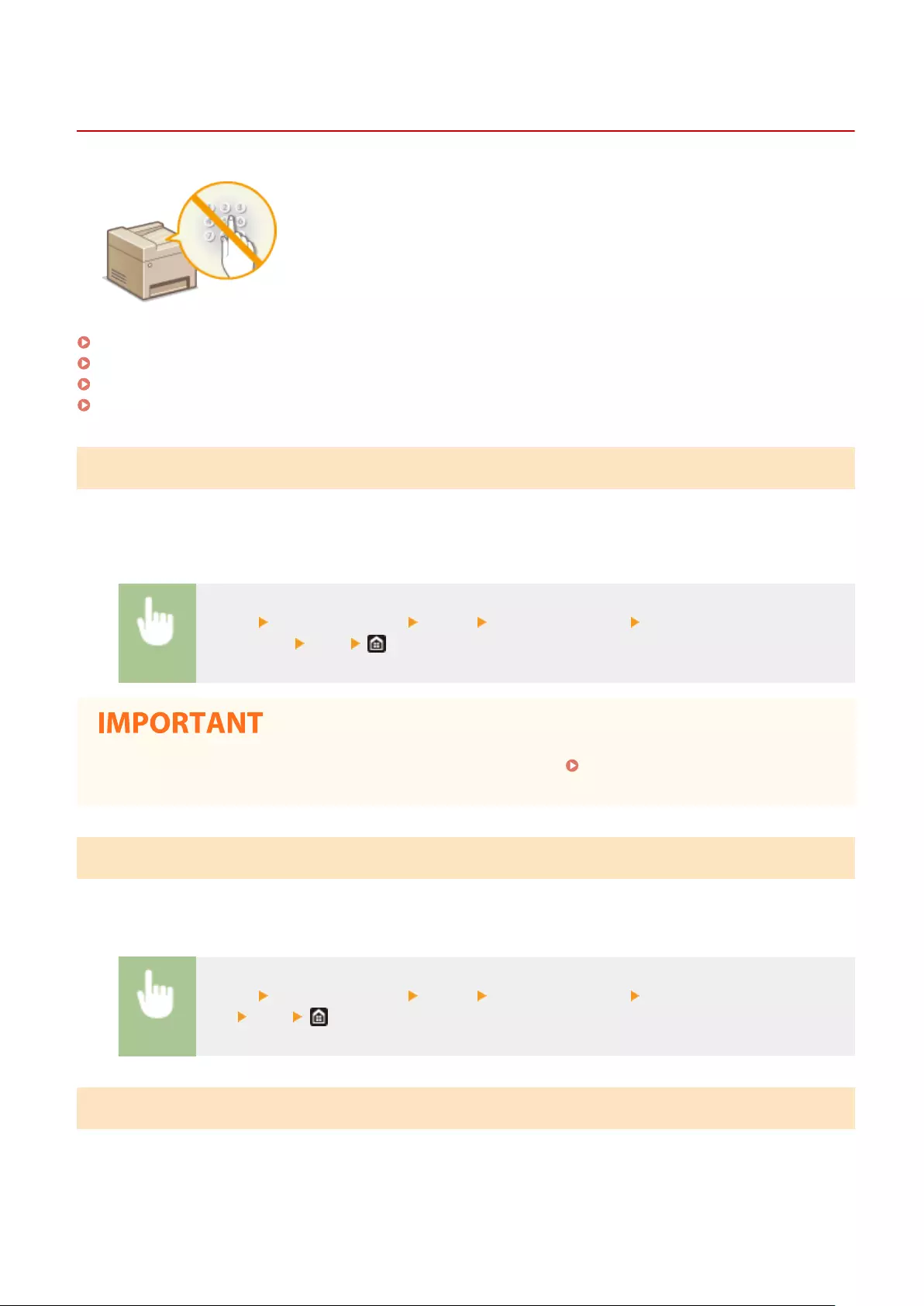
Limiting Available Destinations
6FR5-07X
By limiting destinations that can be specied to those registered in the Address Book
or LDAP servers, you can reduce the possibility of specifying unintended destinations
and prevent users from leaking information. You can congure the setting to display
the conrmation screen to prevent the user from misdialing when specifying a coded
dial number in the Address Book.
Restricting New Destinations that Can Be Specied(P. 416)
Disabling Use of Previously Used Destinations(P. 416)
Displaying Destinations in Address Book(P. 416)
Checking Destinations when Sending Data(P. 417)
Restricting New Destinations that Can Be Specied
Restrict destinations that can be specied when sending faxes or scanned documents to "those already registered in
the Address Book," "those previously used," or "those searchable from the LDAP servers." When this function is
enabled, the machine prohibits users from entering destinations using the numeric keys, adding new entries to the
Address Book, and editing the existing Address Book entries.
<Menu> <Function Settings> <Send> <Common Settings> <Restrict New
Destinations> <On>
●This function does not limit the available destinations for PC faxing. Restricting Fax Sending from a
Computer(P. 418)
Disabling Use of Previously Used Destinations
Prohibits the specication of destinations from the transmission records. Using this restriction prevents destinations
being selected from the transmission records for "Send Fax," "Scan and Send as E-mail" and "Scan and Save to Shared
Folder or FTP Server."
<Menu> <Function Settings> <Send> <Common Settings> <Restrict Resending from
Log> <On>
Displaying Destinations in Address Book
When using coded dial numbers to specify destinations, you need to precisely remember whose destination (or what
group) is registered in what coded dial number. If you do not remember all these numbers accurately, you may send
your documents to unintended destinations. You can avoid sending data to unintended recipients by conguring the
Managing the Machine
416
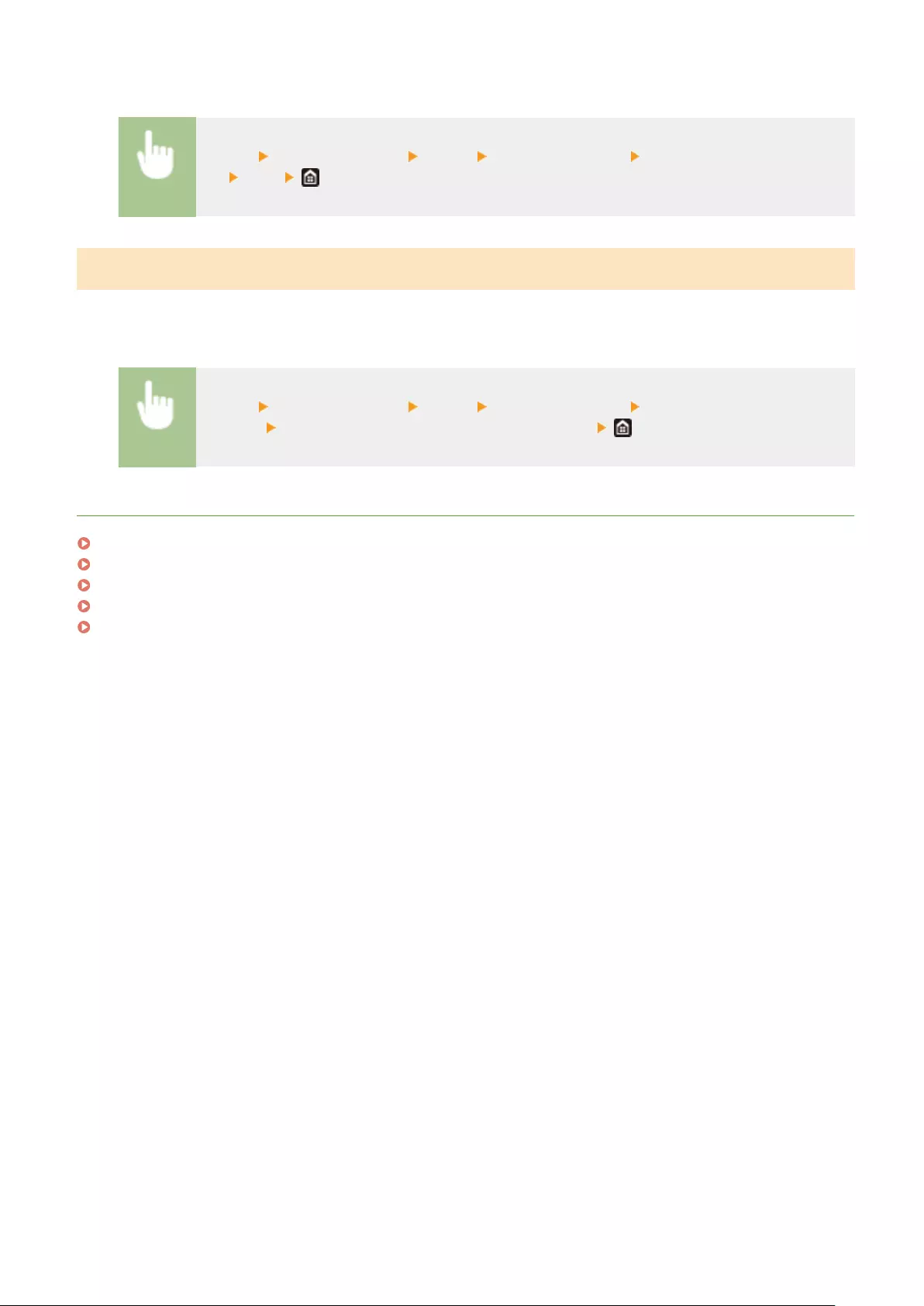
machine to display the details of the coded dial number you selected/entered as a sending destination on the screen
before you send documents to that destination.
<Menu> <Function Settings> <Send> <Common Settings> <Conrm When Coded Dial
TX> <On>
Checking Destinations when Sending Data
You can congure a setting so that the destination conrmation screen is displayed when fax, e-mail, or I-Fax sending
starts. If <Only for Sequential Broadcast> is selected, the conrmation screen is displayed only when multiple
destinations are specied.
<Menu> <Function Settings> <Send> <Common Settings> <Conrm Dest. Before
Sending> Select <On> or <Only for Sequential Broadcast>
LINKS
Sending I-Faxes(P. 250)
Sending Data by E-Mail/Saving Data to a Shared Folder or FTP Server(P. 292)
Recalling Previously Used Settings for Sending/Saving (Recall Settings)(P. 316)
Restricting Use of the Address Book(P. 414)
Restricting the Fax Sending Functions(P. 418)
Managing the Machine
417
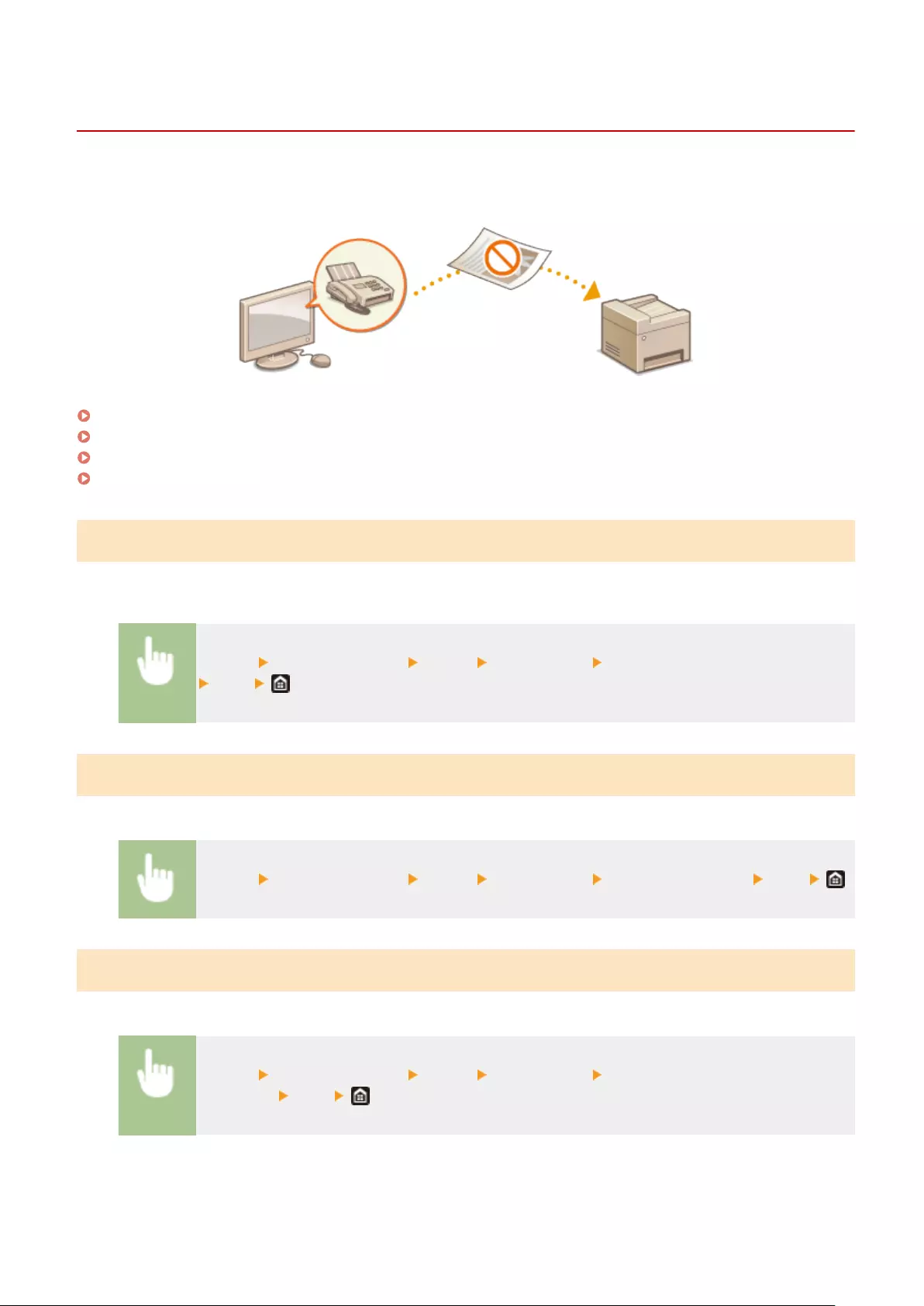
Restricting the Fax Sending Functions
6FR5-07Y
You can set various restrictions for sending faxes, which can prevent information leakage to third parties or sending
documents to unintended destinations.
Conrming the Entered Fax Number(P. 418)
Restricting Fax Sending from a Computer(P. 418)
Restricting Sequential Broadcasts(P. 418)
Disabling Destination Registration from Logs to the Address Book(P. 419)
Conrming the Entered Fax Number
You can congure the setting to display the conrmation screen to prevent the user from misdialing when entering a
destination fax number using the numeric keys.
<Menu> <Function Settings> <Send> <Fax Settings> <Conrm Entered Fax Number>
<On>
Restricting Fax Sending from a Computer
You can prohibit users from PC faxing (faxing from a computer).
<Menu> <Function Settings> <Send> <Fax Settings> <Allow Fax Driver TX> <Off>
Restricting Sequential Broadcasts
You can prohibit a function that collectively sends a fax to multiple destinations (Sequential Broadcast).
<Menu> <Function Settings> <Send> <Fax Settings> <Restrict Sequential
Broadcast> <On>
Managing the Machine
418

Disabling Destination Registration from Logs to the Address Book
You can congure to disable registering destinations from fax send logs to the Address Book.
<Menu> <Function Settings> <Send> <Fax Settings> <Register Log Dest to Addr
Book> <Do Not Allow>
LINKS
Basic Operations for Sending Faxes(P. 218)
Recalling Previously Used Settings for Sending (Recall Settings)(P. 231)
Sending Faxes from Your Computer (PC Fax)(P. 246)
Enabling the Department ID Management for Jobs from a Computer(P. 368)
Restricting Use of the Address Book(P. 414)
Limiting Available Destinations(P. 416)
Managing the Machine
419

Restricting Printing from a Computer
6FR5-080
You can drastically reduce information leakage risks by limiting the documents printable from a computer to the
Secure Print documents ( Printing a Document Secured by a PIN (Secure Print)(P. 267) ).
<Menu> <Function Settings> <Secure Print> <Restrict Printer Jobs> <On>
<Apply> <OK> Restart the machine
Managing the Machine
420
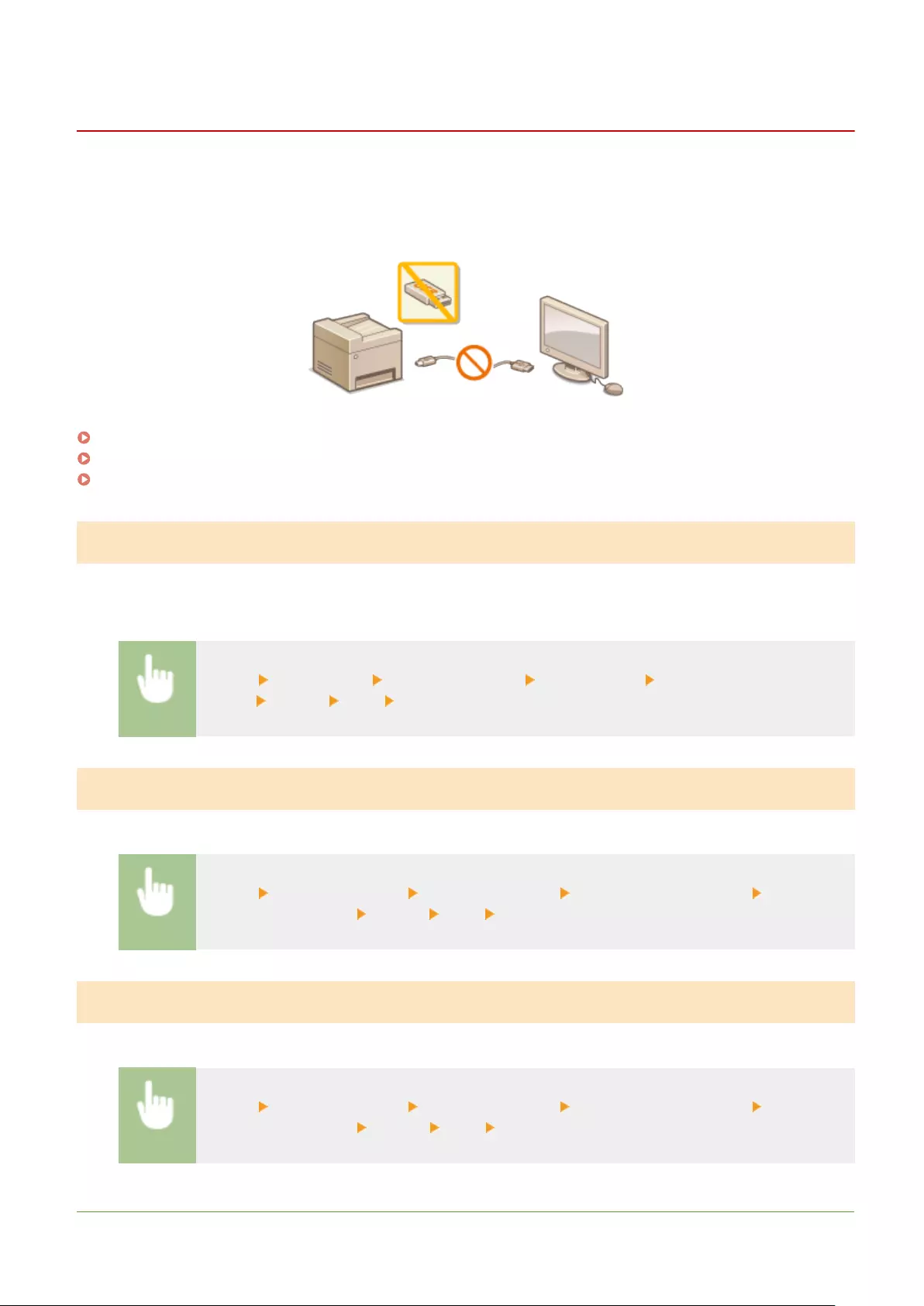
Restricting USB Functions
6FR5-081
USB is a convenient way of connecting peripheral devices and storing or relocating data, but USB can also be a source
of information leakage if it is not properly managed. Be especially careful when handling USB memory devices. This
section describes how to restrict connection via the USB port of the machine and how to prohibit use of USB memory
devices.
Restricting the USB Connection with a Computer(P. 421)
Restricting the Scan to USB Function(P. 421)
Restricting the USB Print Function(P. 421)
Restricting the USB Connection with a Computer
You can disable the computer connection USB port located on the back side of the machine. If this port is disabled, the
machine cannot communicate with a computer via USB. This setting does not affect the front USB port, which is for
attaching USB memory devices.
<Menu> <Preferences> <External Interface> <USB Settings> Select <Off> in <Use as USB
Device> <Apply> <OK> Restart the machine
Restricting the Scan to USB Function
You can disable storing scanned original data into a USB memory device.
<Menu> <Function Settings> <Store/Access Files> <Memory Media Settings> Select <Off>
in <Use Scan Function> <Apply> <OK> Restart the machine
Restricting the USB Print Function
You can disable printing data from a USB memory device. The data in the USB memory device cannot be printed.
<Menu> <Function Settings> <Store/Access Files> <Memory Media Settings> Select <Off>
in <Use Print Function> <Apply> <OK> Restart the machine
LINKS
Managing the Machine
421
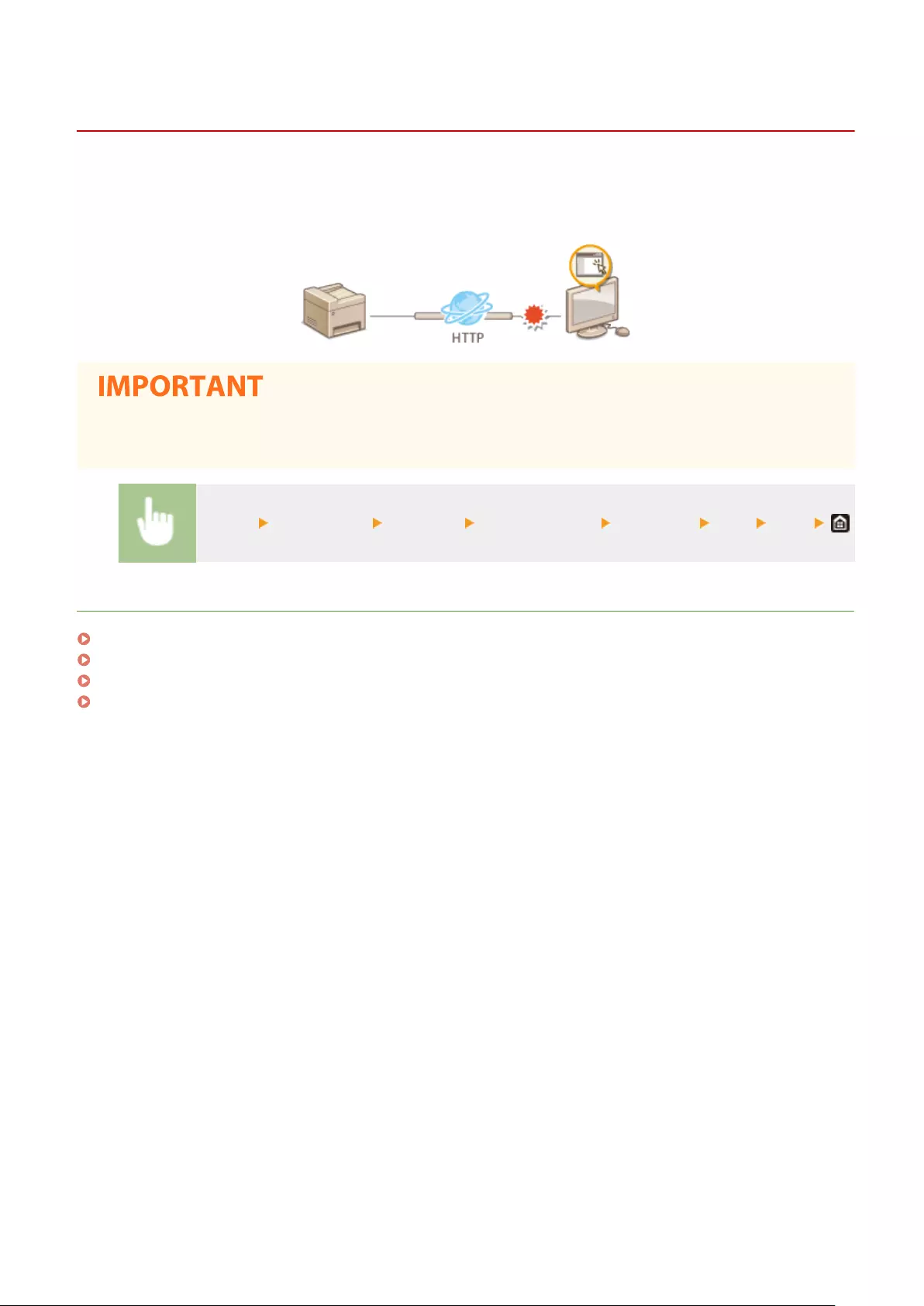
Disabling HTTP Communication
6FR5-082
HTTP is used for communications over the network, such as when you access the machine via the Remote UI. If you
are using a USB connection or are otherwise not using HTTP, you can disable HTTP to block malicious third-party
intrusions via the unused HTTP port.
●Disabling HTTP disables some of the network capabilities, such as the Remote UI, WSD printing, and printing
with Google Cloud Print.
<Menu> <Preferences> <Network> <TCP/IP Settings> <Use HTTP> <Off> <Yes>
LINKS
Managing the Machine from a Computer (Remote UI)(P. 427)
Changing Port Numbers(P. 386)
Conguring Printing Protocols and WSD Functions(P. 41)
Using Google Cloud Print(P. 354)
Managing the Machine
423
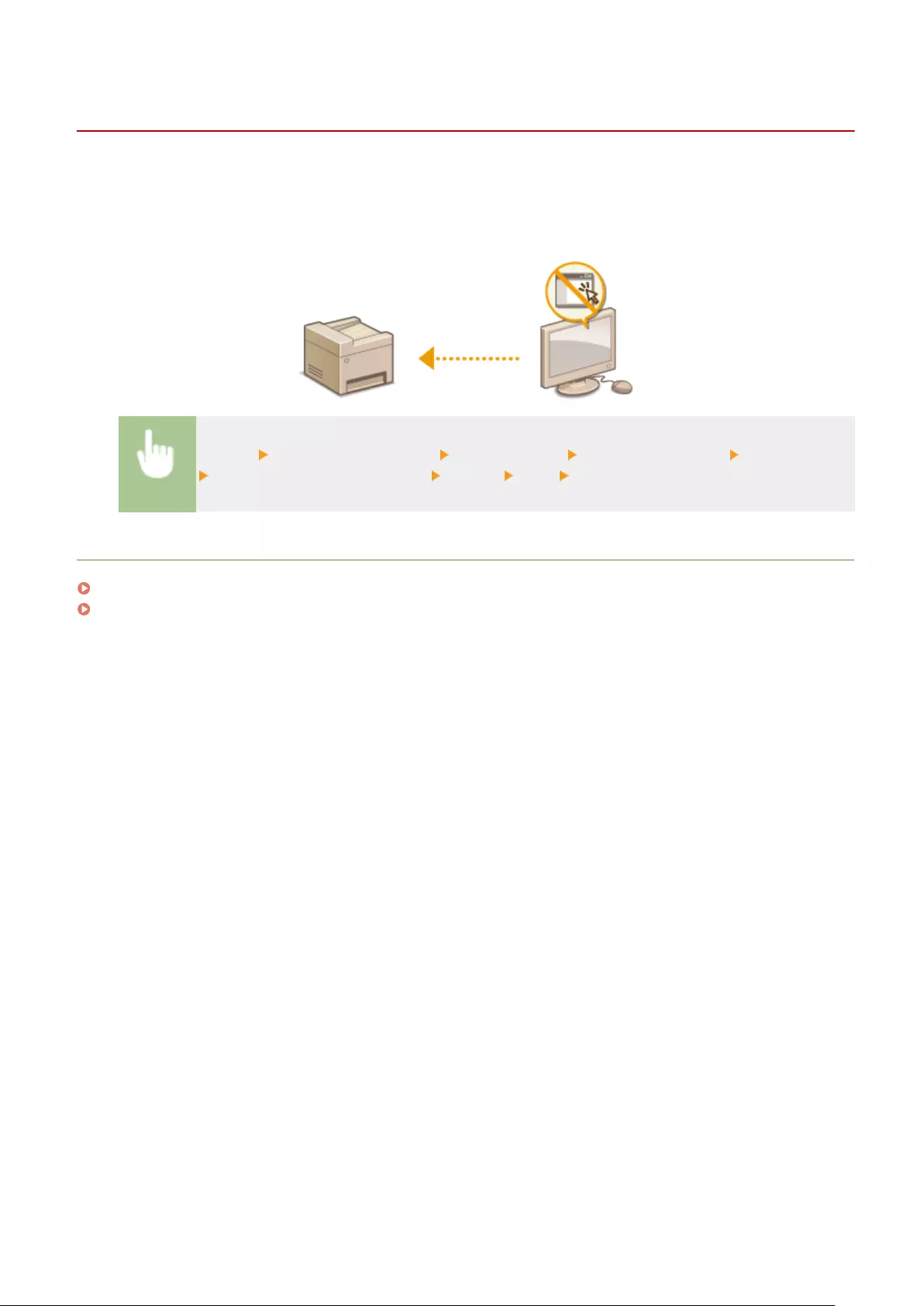
Disabling Remote UI
6FR5-083
The Remote UI is useful because the machine settings can be specied by using a Web browser on a computer. To use
the Remote UI, the machine must be connected to a computer over the network. If the machine is connected to a
computer via USB, or if you do not need to use the Remote UI, you might want to disable the Remote UI to reduce the
risk of having your machine controlled remotely over the network by malicious third parties.
<Menu> <Management Settings> <License/Other> <Remote UI Settings> <Remote UI>
Select <Off> in <Use Remote UI> <Apply> <OK> Restart the machine
LINKS
Managing the Machine from a Computer (Remote UI)(P. 427)
Disabling HTTP Communication(P. 423)
Managing the Machine
424
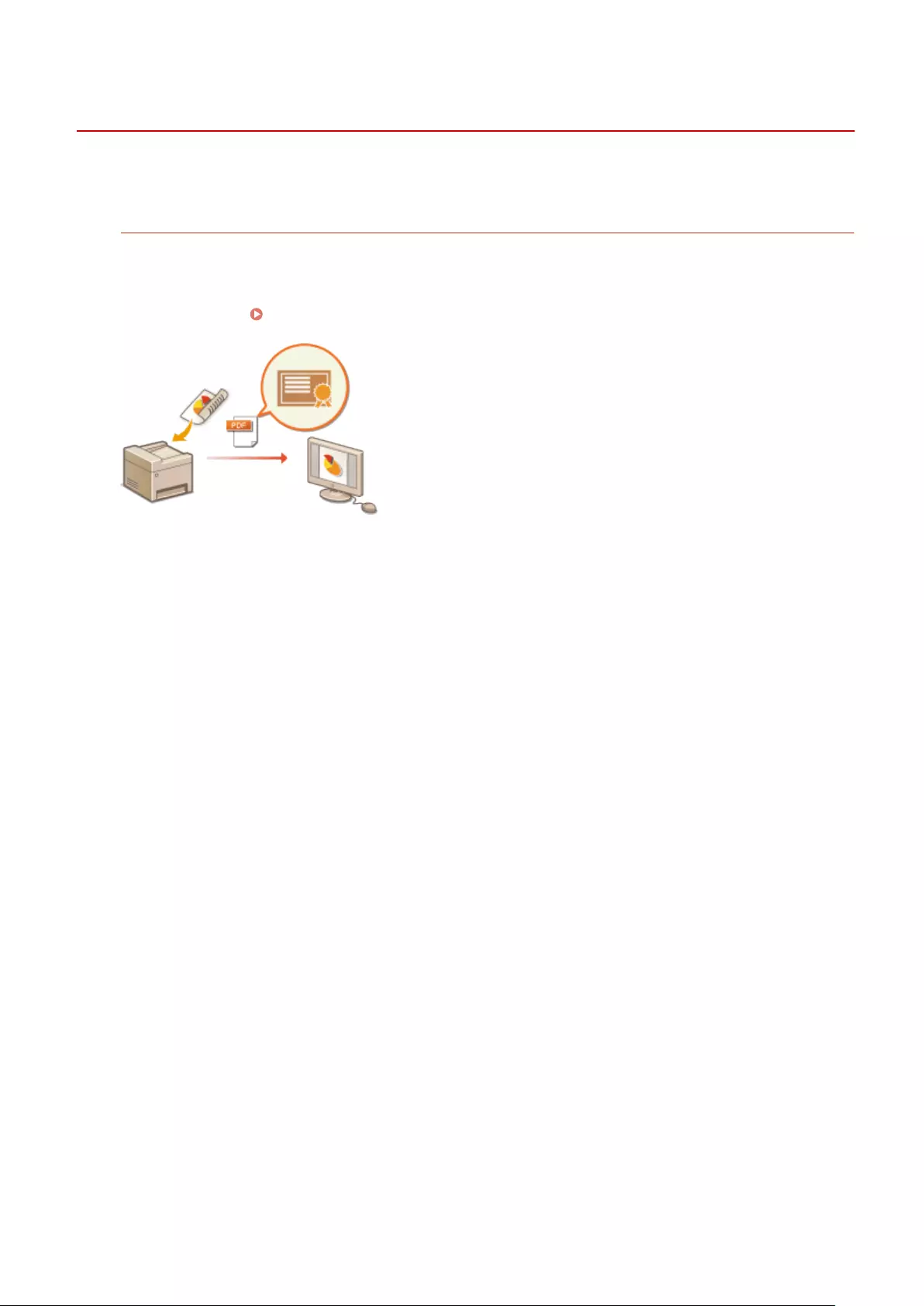
Increasing the Security of Documents
6FR5-084
The machine is equipped with security functions designed to prevent documents from being leaked or tampered with.
Device Signature
The digital signature is added to scanned documents using a key and certicate mechanism in order to prove to
the recipient that the document has been created on the machine. The recipient can verify "the device that
created the document" and "whether the document has been tampered with." Before adding a device
signature, you need to generate a key and certicate (device certicate) that is used for the device signature
using the machine. Generating a Device Signature Key(P. 426)
Managing the Machine
425
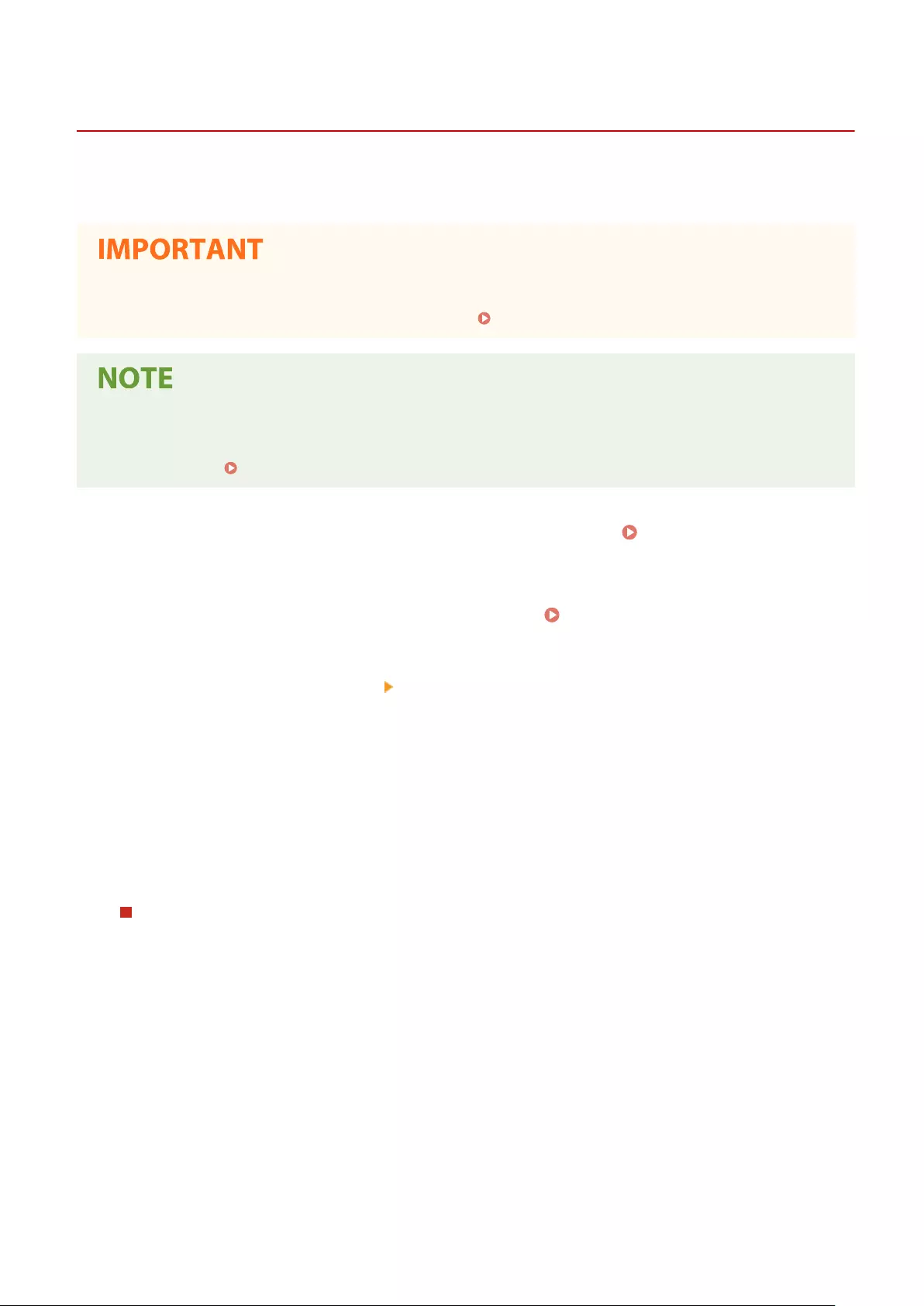
Generating a Device Signature Key
6FR5-085
You can generate a key and certicate for the device signature that show a document was scanned on the machine.
The certicate is appended when an document is scanned and converted into a PDF le.
●Only one key and certicate for the device signature can be generated. It cannot be deleted.
●An optional Send PDF Security Feature Set is required. System Options(P. 641)
●Key and certicate for the device signature are valid for ve years. Renew them when required.
●For more information about the basic operations to be performed when setting the machine from the
Remote UI, see Setting Up Menu Options from Remote UI(P. 437) .
1Start the Remote UI and log in to System Manager Mode. Starting Remote
UI(P. 428)
2Click [Settings/Registration] on the Portal page. Remote UI Screen(P. 429)
3Select [Device Management] [Key and Certicate Settings].
4Click [Generate Key].
5Select the [Device Signature] check box, and click [OK].
➠A key and certicate for the device signature is generated.
Renewing the Device Signature Key and the Key and Certicate
1Click [Update] at the right of the key and certicate for the device signature.
2Click [OK].
Managing the Machine
426

Managing the Machine from a Computer (Remote UI)
6FR5-086
Using a Web browser to operate the machine remotely, you can check the documents waiting to be printed or the
status of the machine. You can also make various settings. You can do this without leaving your desk, making system
management easier. For more information about the system requirements for the Remote UI, see System
Environment(P. 635) .
Functions of the Remote UI
Checking the Status and Logs(P. 431)
Setting Up Menu Options from Remote UI(P. 437)
Registering Destinations from Remote UI(P. 440)
Security Policy(P. 444)
Importing/Exporting the Setting Data(P. 450)
Basics of the Remote UI
Starting Remote UI(P. 428)
Managing the Machine
427
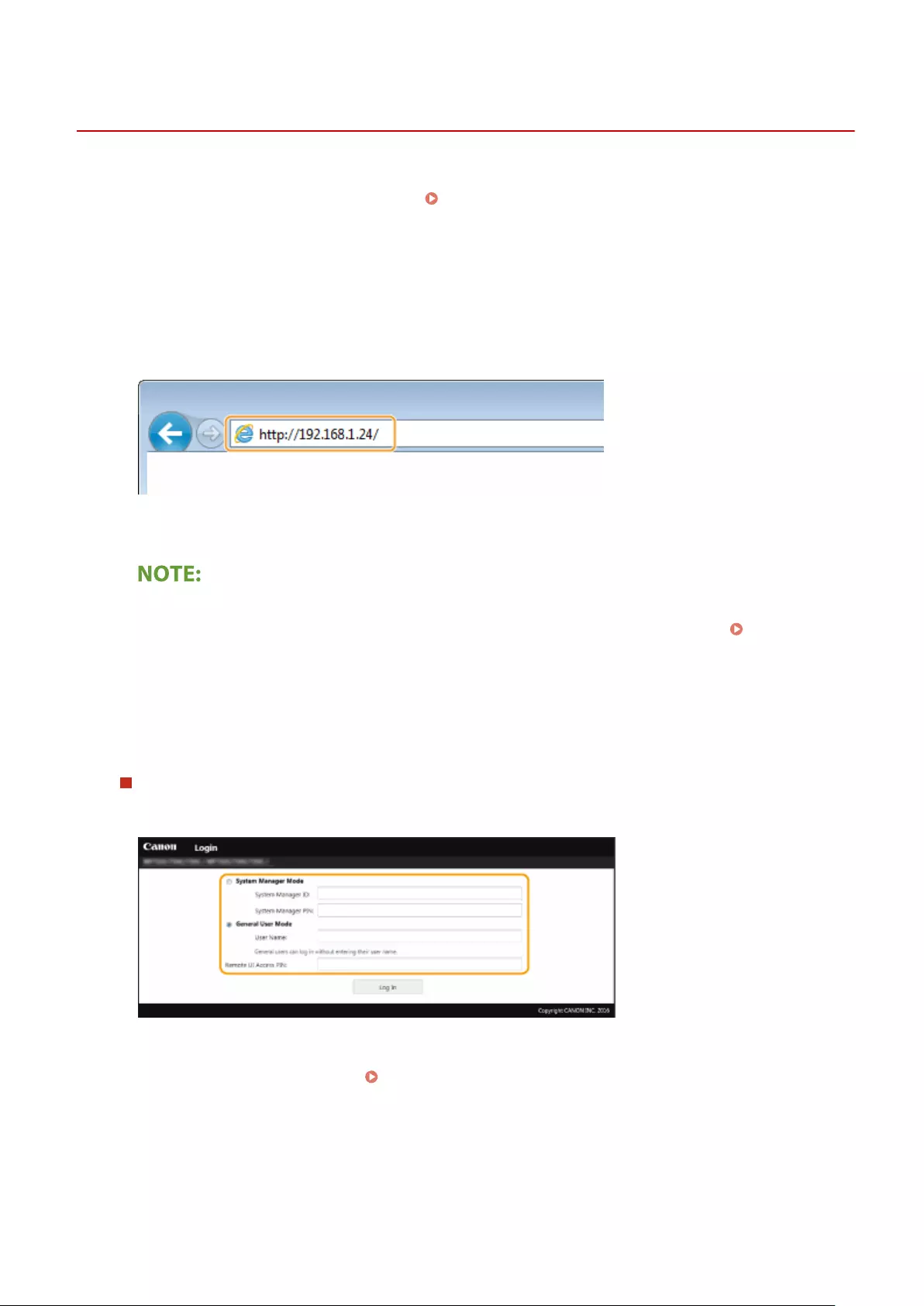
Starting Remote UI
6FR5-087
To operate remotely, you need to input the IP address of the machine into a Web browser and start the Remote UI.
Check the IP address set to the machine in advance ( Viewing Network Settings(P. 38) ). If you have any questions,
ask your Network Administrator.
1Start the Web browser.
2Enter "http://<the IP address of the machine>/" in the address eld, and press the
[ENTER] key.
●If you want to use an IPv6 address, enclose the IPv6 address with brackets (example: http://
[fe80::2e9e:fcff:fe4e:dbce]/).
If a security alert is displayed
●A security alert may be displayed when the Remote UI communication is encrypted ( Conguring the
Key and Certicate for TLS(P. 389) ). When certicate settings or TLS settings have no errors, continue
browsing the Web site.
3Log in to the Remote UI.
When the Department ID Management is disabled
Select [System Manager Mode] or [General User Mode], and enter a value in [Remote UI Access PIN] as
necessary.
[System Manager Mode]
You can perform all the Remote UI operations and settings. Enter the appropriate ID in [System Manager ID]
and PIN in [System Manager PIN]. Setting the System Manager ID and PIN(P. 363)
[General User Mode]
You can check the status of documents or the machine, and you can also change some of the settings. When
you want to check if a specic document of yours is in the print queue or cancel the printing of a document
of yours in the print queue, enter the user name of the document in [User Name]. The user name is
automatically set to print documents based on information such as your computer name or computer login
name.
[Remote UI Access PIN]
Managing the Machine
428
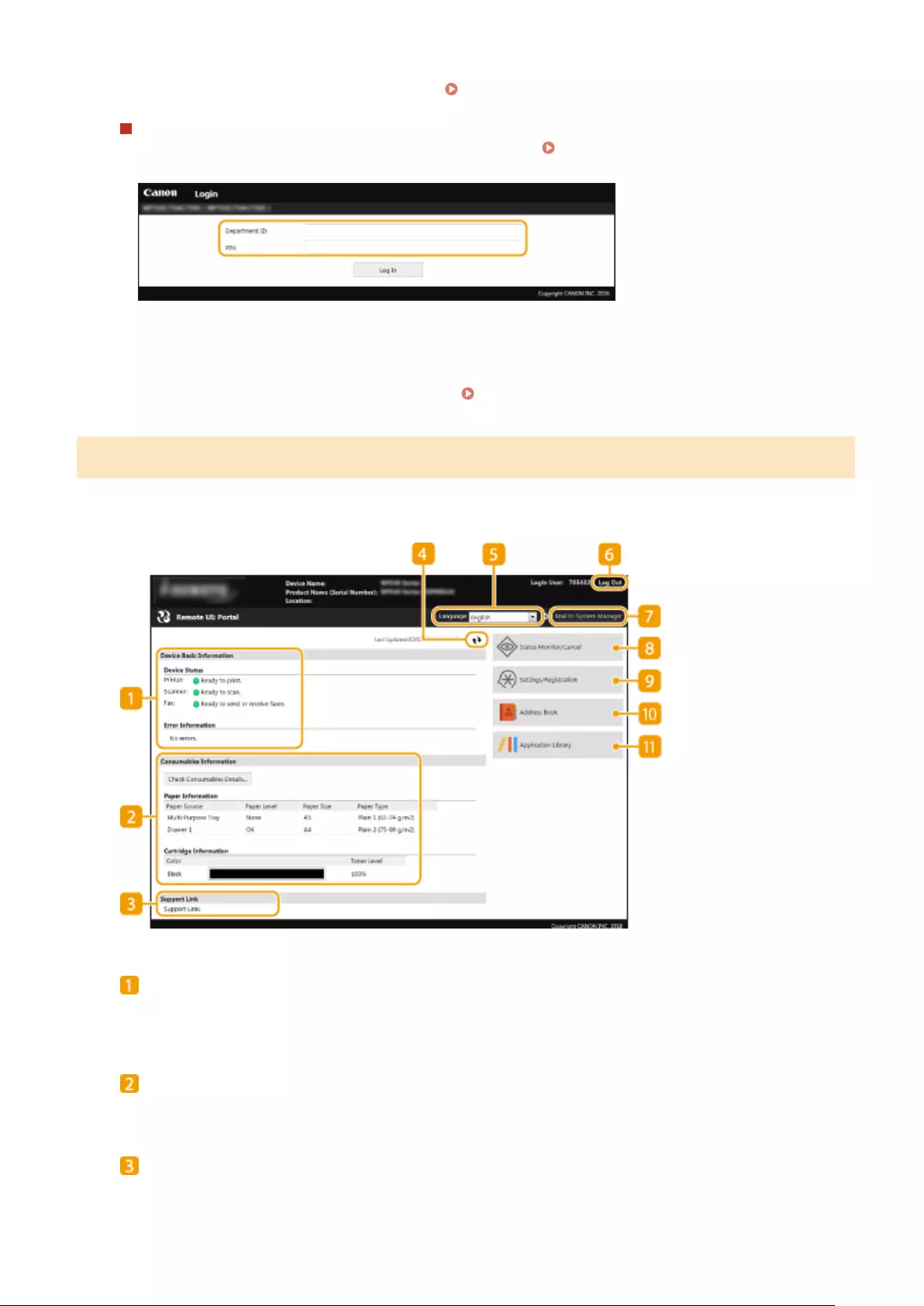
If [Remote UI Access PIN] is set, enter the PIN. Setting a Remote UI PIN(P. 371)
When the Department ID Management is enabled
Enter the appropriate ID in [Department ID] and PIN in [PIN]. Setting the Department ID
Management(P. 365)
4Click [Log In].
➠The Portal page (main page) will be displayed. Remote UI Screen(P. 429)
Remote UI Screen
When you log in to the Remote UI, the following Portal page appears. This section describes the items displayed on
the Portal page and the basic operations.
[Device Basic Information]
Displays the current status of the machine and error information. If an error has occurred, the link to the
Error Information page will be displayed.
[Consumables Information]
Displays paper information and the amount remaining in the toner cartridges.
[Support Link]
Displays the support link specied in [Support Link] under [License/Other].
Managing the Machine
429

Refresh Icon
Refreshes the currently displayed page.
[Language]
Selects the display language used for the Remote UI screens.
[Log Out]
Logs off from the Remote UI. The Login page will be displayed.
[Mail to System Manager]
Displays a window for creating an e-mail to the system manager specied in [System Manager Information]
under [User Management].
[Status Monitor/Cancel]
Displays the [Status Monitor/Cancel] page. For any of the waiting documents, you can check the status/
history or cancel the processing.
[Settings/Registration]
Displays [Settings/Registration] page. When you have logged in to System Manager Mode, you can change
the settings items and save/load the registered data. Setting Up Menu Options from Remote UI(P. 437)
[Address Book]
Displays the coded dial numbers and the Favorites list registered in the Address Book. You can also register
or edit the Address Book when you have logged in to System Manager Mode. Registering Destinations
from Remote UI(P. 440)
[Application Library]
Displays the Application Library setting page.
Managing the Machine
430
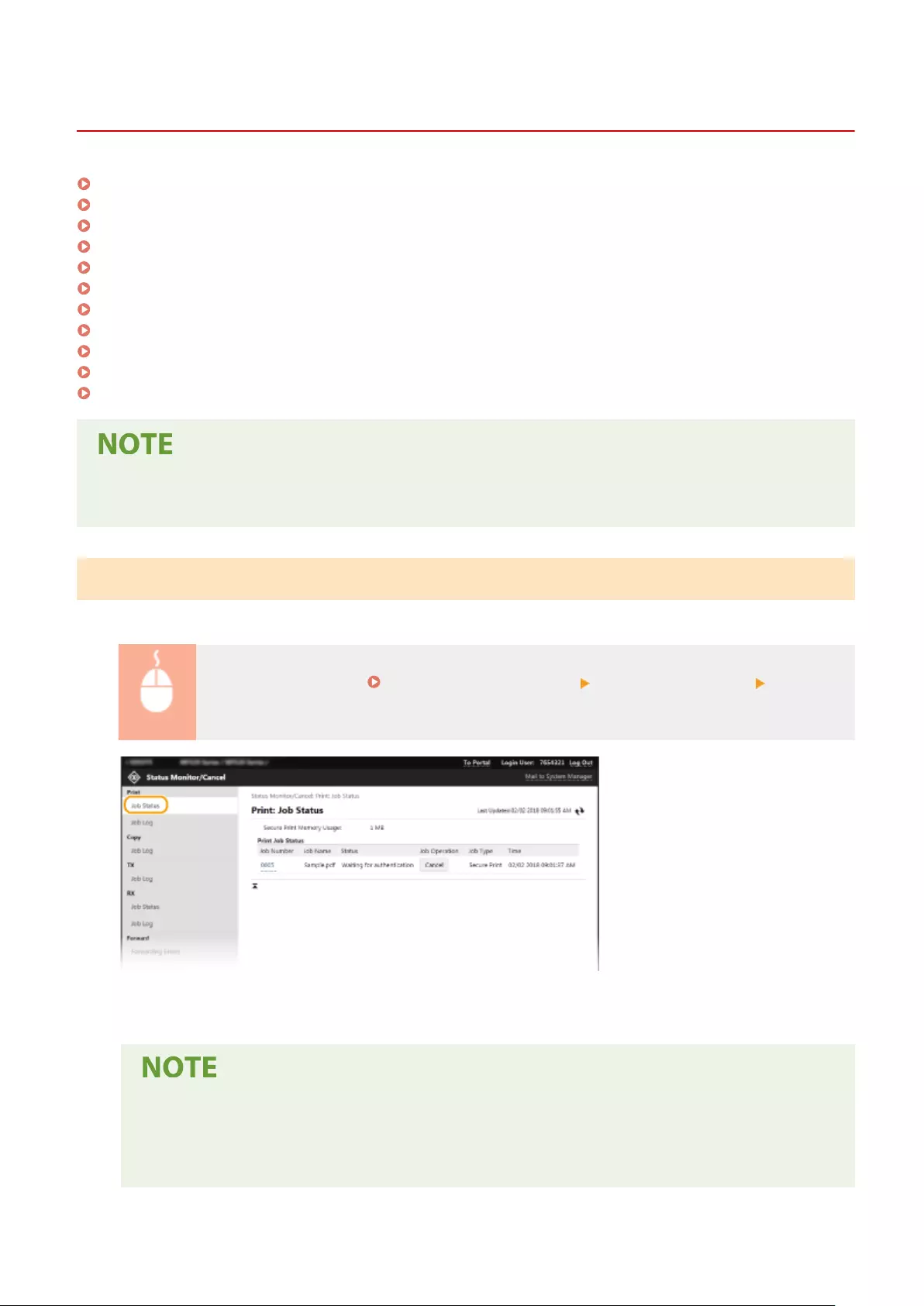
Checking the Status and Logs
6FR5-088
Checking Current Status of Print Documents(P. 431)
Checking Current Status of Received Documents(P. 432)
Checking History of Documents(P. 432)
Checking Information of Documents That Failed To Be Forwarded(P. 432)
Checking Error Information(P. 433)
Checking Consumables(P. 433)
Checking Device Specications(P. 434)
Checking System Manager Information(P. 434)
Checking Print Total Counter(P. 435)
Checking History of Toner Cartridges(P. 435)
Checking Usage Status of the Machine(P. 436)
●A le name of a document may not be displayed in full. The printed application name may be added to the
le name.
Checking Current Status of Print Documents
The list of the documents currently printing or waiting to be printed is displayed.
Log in to the Remote UI ( Starting Remote UI(P. 428) ) [Status Monitor/Cancel] [Job Status]
in [Print]
●You can delete a document job by clicking [Cancel].
●Regardless of the Department ID Management setting, all the print documents currently printing and
waiting to be printed will be listed.
●If you entered your user name when you logged on in General User Mode, your user name will only
be displayed on the documents that you printed.
Managing the Machine
431
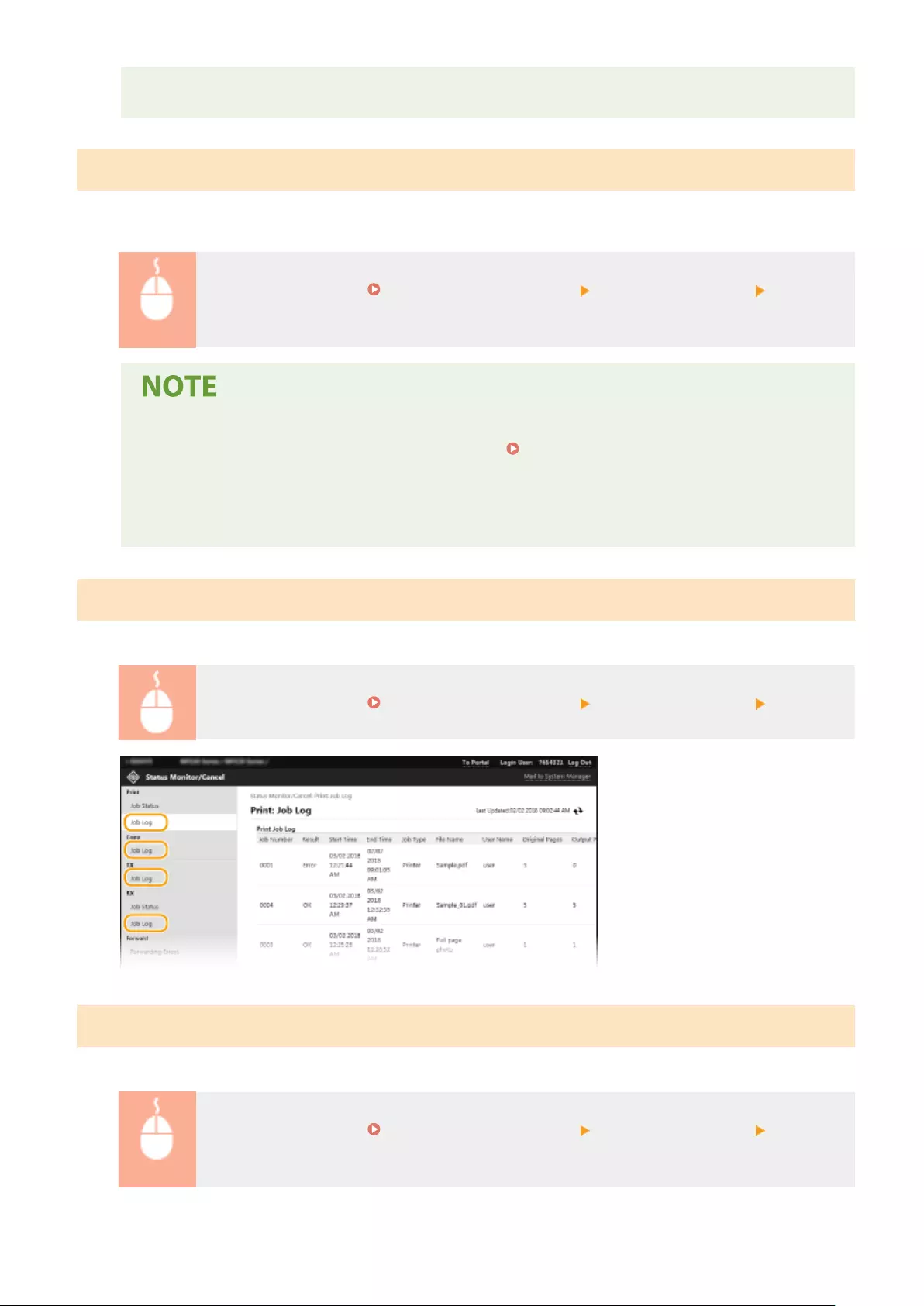
●Click [Job Number] on the paused documents and secure documents to display detailed information.
You can check the user name and the page count of the printed document.
Checking Current Status of Received Documents
You can check the logs of received fax and I-Fax documents. You can also click [Delete] for a received fax document to
delete it.
Log in to the Remote UI ( Starting Remote UI(P. 428) ) [Status Monitor/Cancel] [Job Status]
in [RX]
●To perform the following operations for a received fax document, you need to log on in System
Manager Mode and set <Use Fax Preview> to <On>. <Fax Memory Lock Settings>(P. 547)
-Click [Print All] to print all received documents.
- Click [Print] to print a document waiting to be printed.
- Click [Job Number] to display detailed information and preview of a document waiting to be printed.
Checking History of Documents
The job logs of print, copy, sending (TX), and receiving (RX) are displayed.
Log in to the Remote UI ( Starting Remote UI(P. 428) ) [Status Monitor/Cancel] [Job Log]
Checking Information of Documents That Failed To Be Forwarded
Information of documents that failed to be forwarded is displayed.
Log in to the Remote UI ( Starting Remote UI(P. 428) ) [Status Monitor/Cancel] [Forwarding
Errors]
Managing the Machine
432
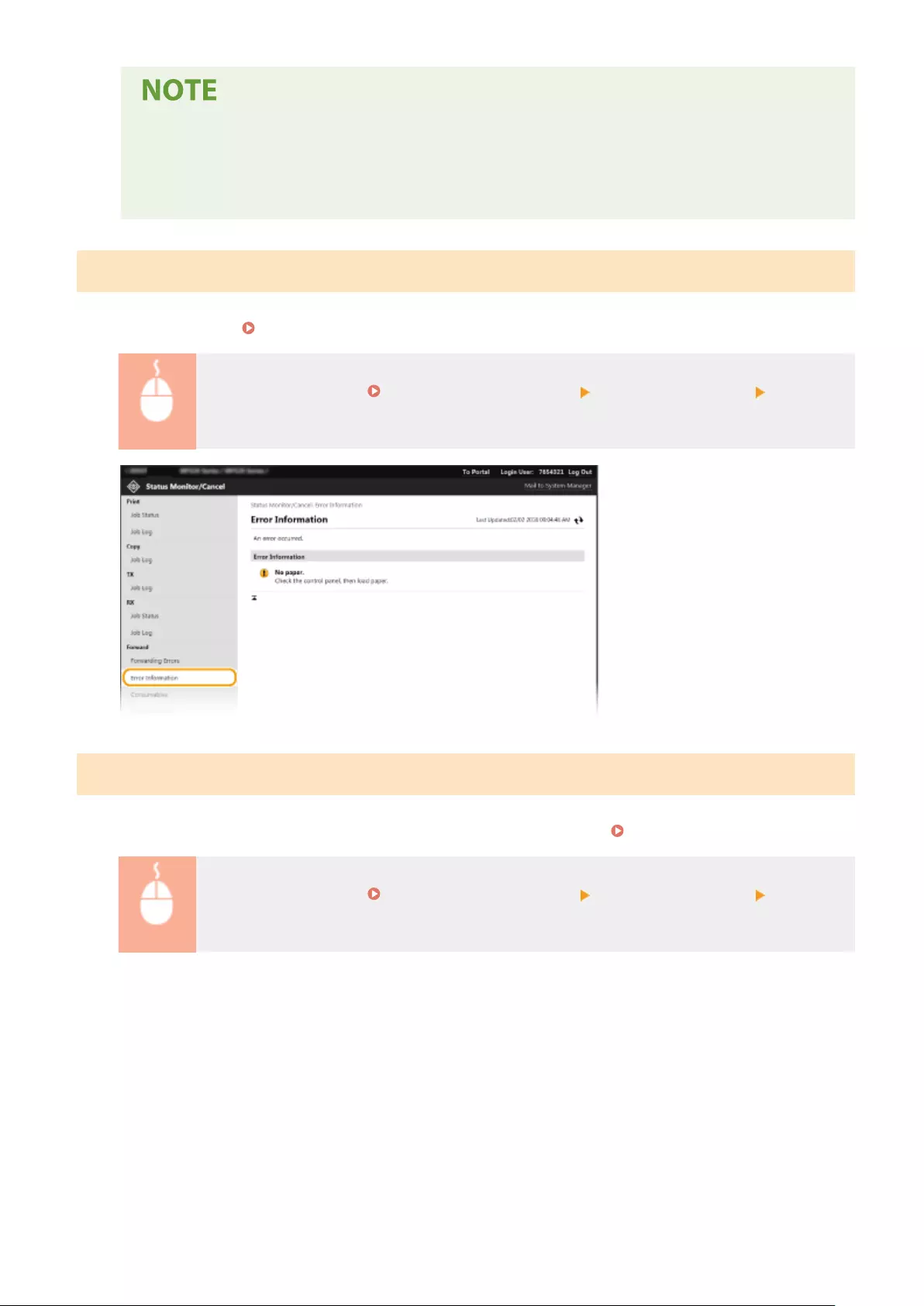
●When you have logged on in System Manager Mode, you can click [Delete] to delete documents that
failed to be forwarded.
●When you have logged on in System Manager Mode, you can click [Job Number] to display detailed
information or preview of the document that failed to be forwarded.
Checking Error Information
When an error occurs, this page will be displayed by clicking the message displayed under [Error Information] on the
Portal page (main page). Remote UI Screen(P. 429)
Log in to the Remote UI ( Starting Remote UI(P. 428) ) [Status Monitor/Cancel] [Error
Information]
Checking Consumables
Paper size and paper type for the paper source, toner cartridge model number, etc. are displayed. You can also click
[Check Consumables Details] in the Portal page (main page) to display this page ( Remote UI Screen(P. 429) ).
Log in to the Remote UI ( Starting Remote UI(P. 428) ) [Status Monitor/Cancel]
[Consumables]
Managing the Machine
433
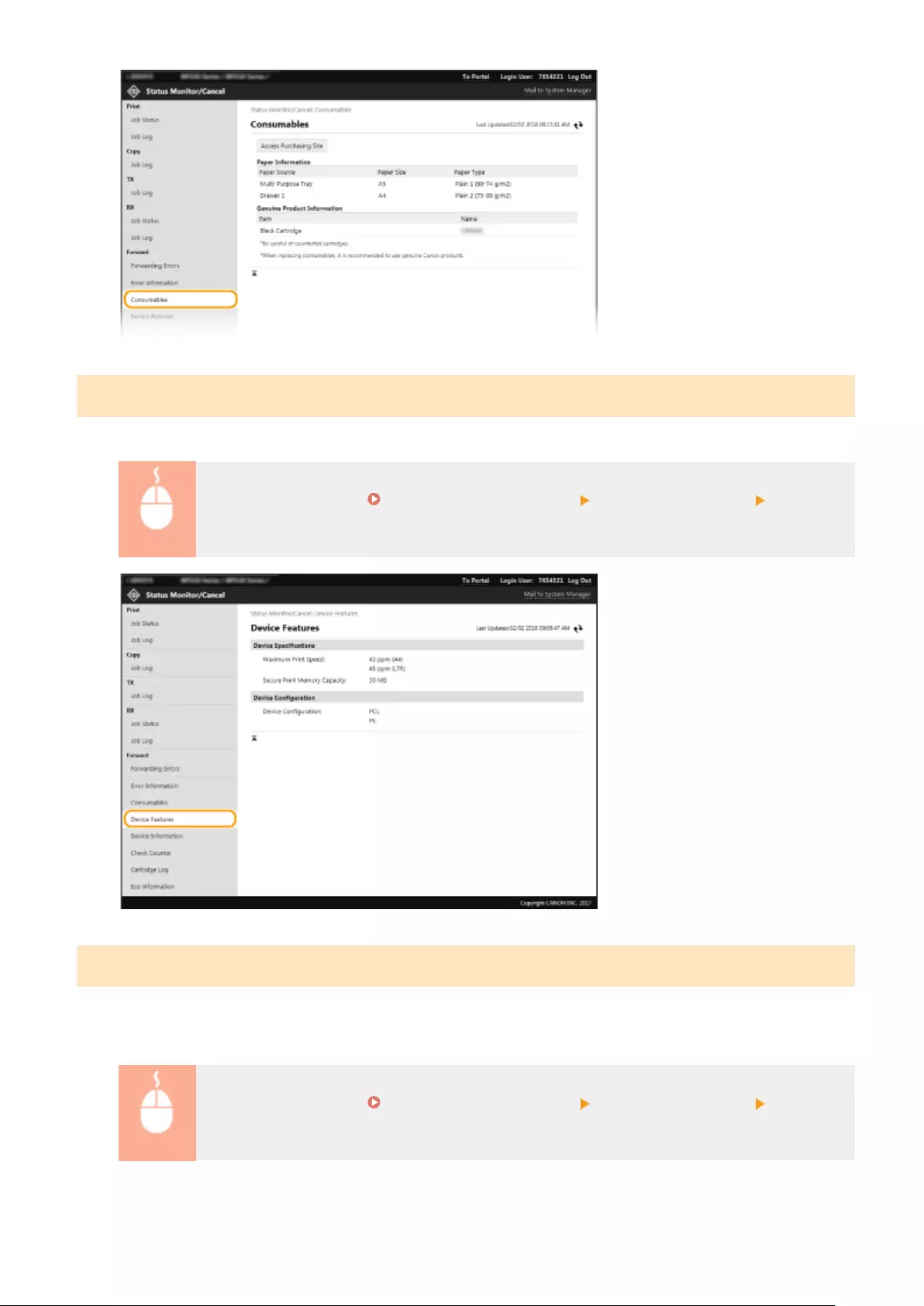
Checking Device Specications
The maximum print speed and machine features are displayed.
Log in to the Remote UI ( Starting Remote UI(P. 428) ) [Status Monitor/Cancel] [Device
Features]
Checking System Manager Information
Information about the machine and the system manager is displayed. The device name and other system manager
information displayed here correspond to the settings in [System Manager Information] on the [User Management]
page or in [Device Information Settings] on the [Device Management] page.
Log in to the Remote UI ( Starting Remote UI(P. 428) ) [Status Monitor/Cancel] [Device
Information]
Managing the Machine
434
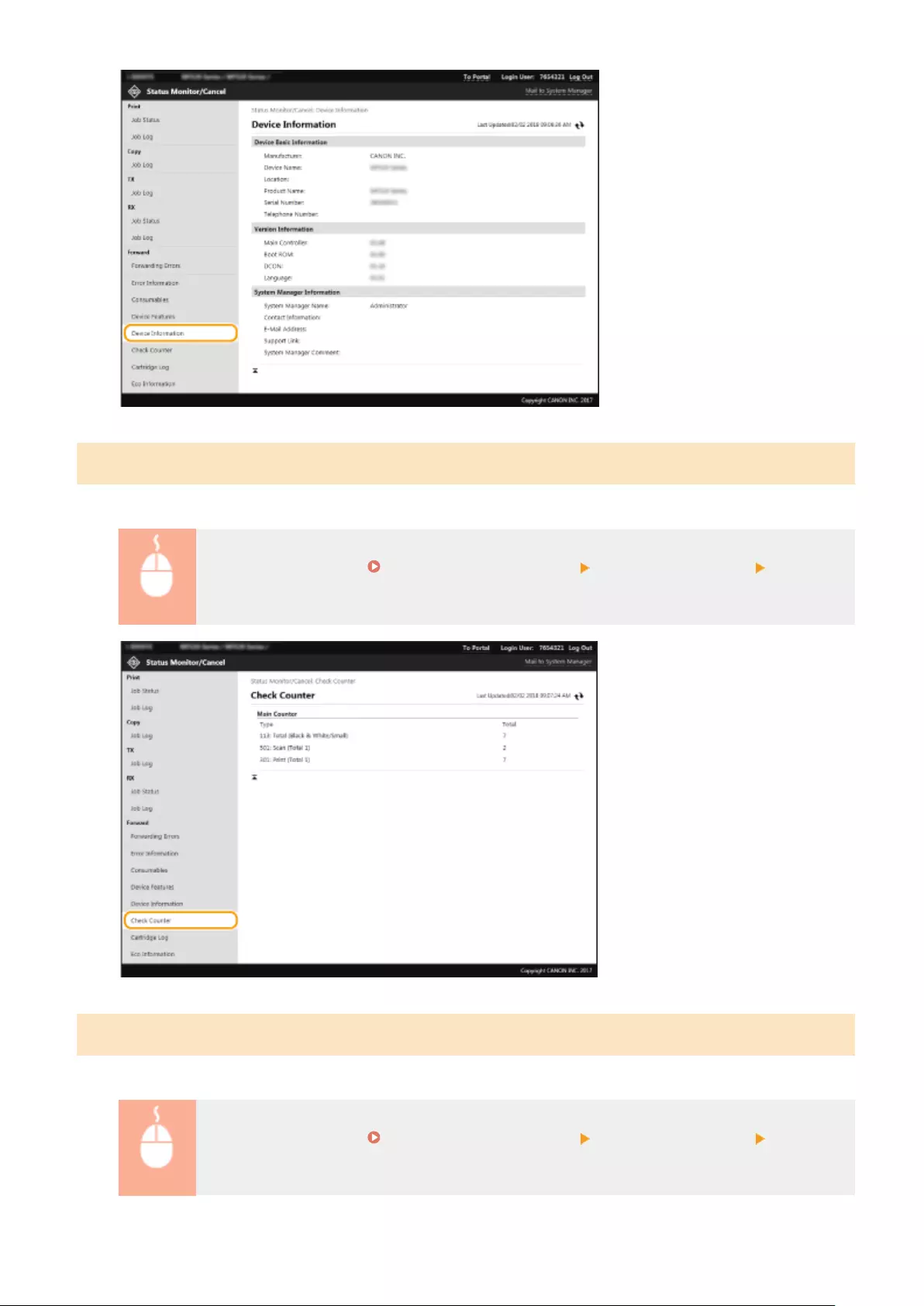
Checking Print Total Counter
The total number of pages that have been printed by the copy, print, and fax functions is displayed.
Log in to the Remote UI ( Starting Remote UI(P. 428) ) [Status Monitor/Cancel] [Check
Counter]
Checking History of Toner Cartridges
You can check the usage logs of toner cartridges and other logs.
Log in to the Remote UI ( Starting Remote UI(P. 428) ) [Status Monitor/Cancel] [Cartridge
Log]
Managing the Machine
435
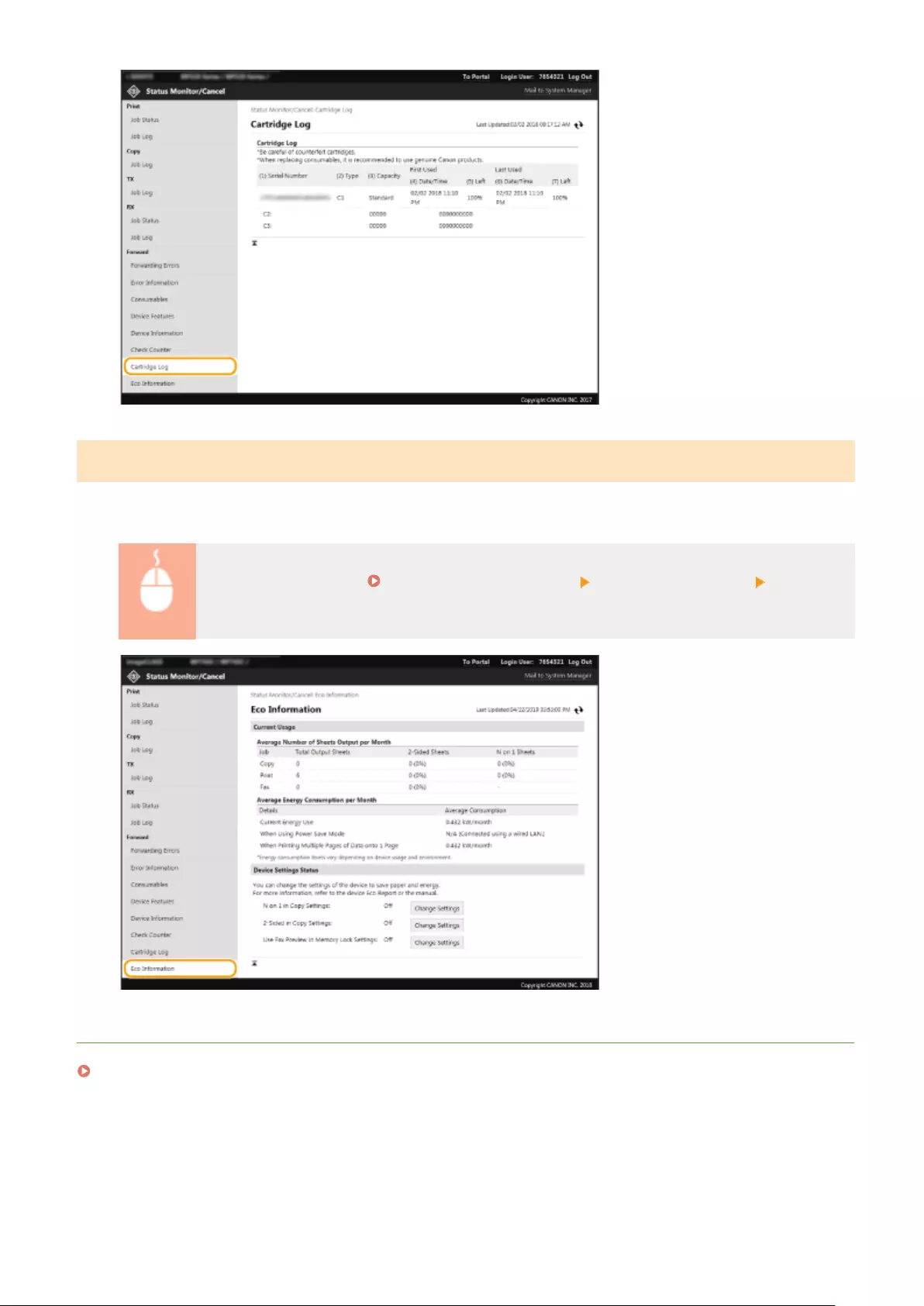
Checking Usage Status of the Machine
The monthly total volume of printouts and monthly total power consumption are displayed. You can display the Eco
Information screen and change the settings to save paper and power consumption.
Log in to the Remote UI ( Starting Remote UI(P. 428) ) [Status Monitor/Cancel] [Eco
Information]
LINKS
Remote UI Screen(P. 429)
Managing the Machine
436
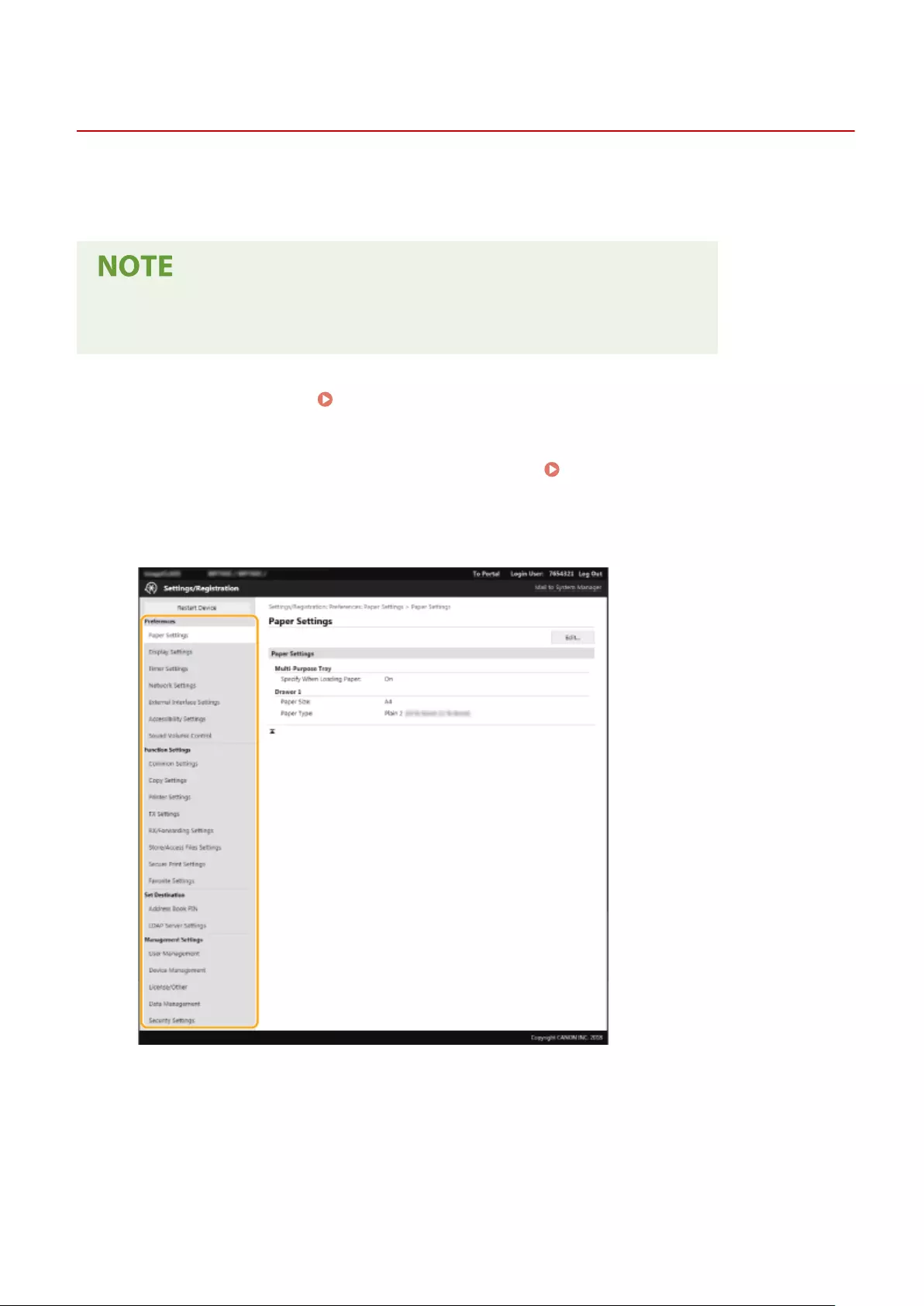
Setting Up Menu Options from Remote UI
6FR5-089
You can change the various machine settings by using the Remote UI. Most of the settings can be set also on the
machine, but some settings can only be set using the Remote UI. This section describes the basic ow of changing the
settings of the machine using the Remote UI.
●Some settings can only be changed when you have logged in to System Manager Mode.
●Some settings may require operations that differ from the procedure described here.
1Start the Remote UI. Starting Remote UI(P. 428)
2Click [Settings/Registration] on the Portal page. Remote UI Screen(P. 429)
3Click the setting you want to congure in the menu on the left side of the screen.
4Click the link to display the desired page as necessary.
Managing the Machine
437
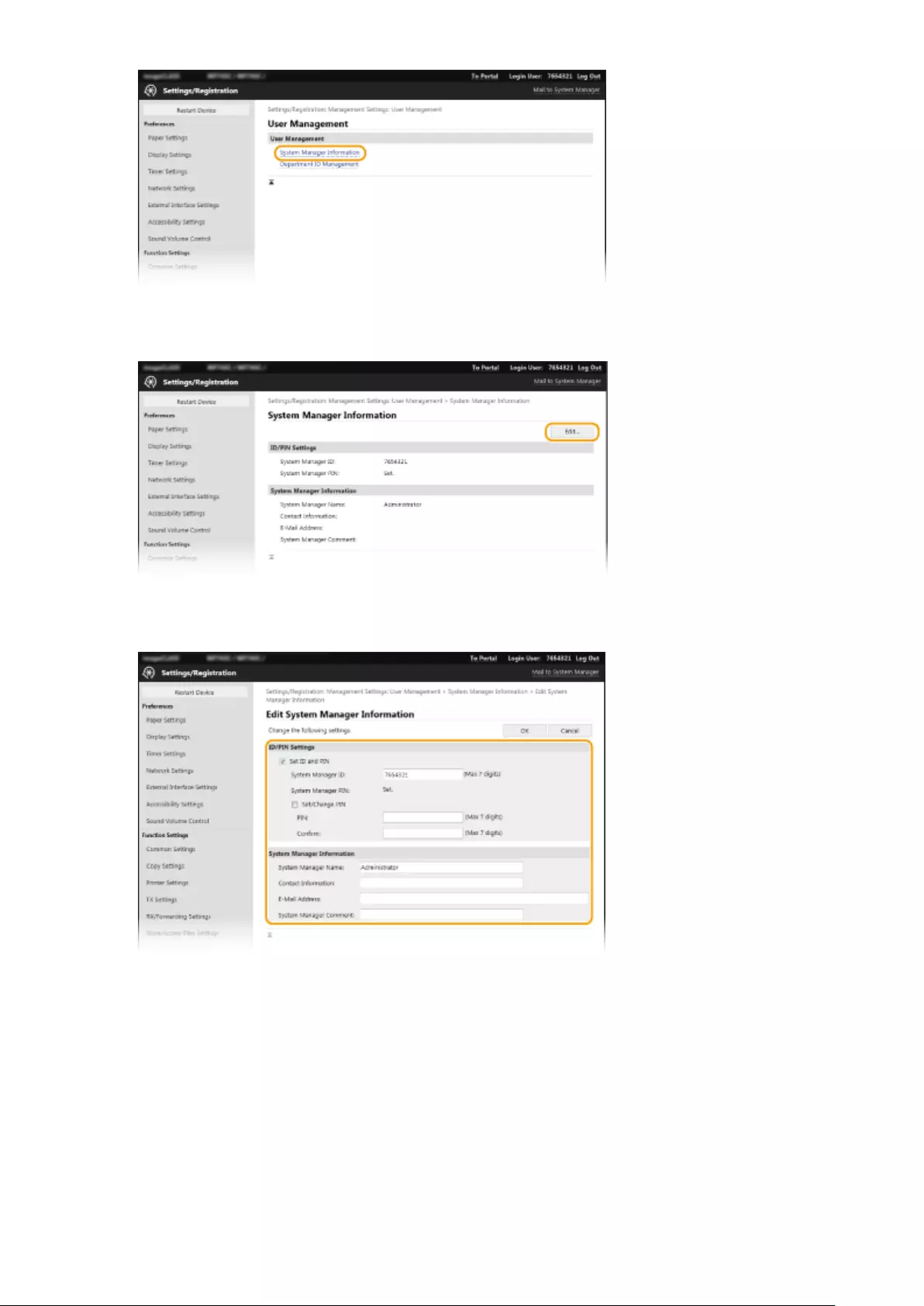
5Click [Edit].
6Specify the required settings.
7Click [OK].
Managing the Machine
438
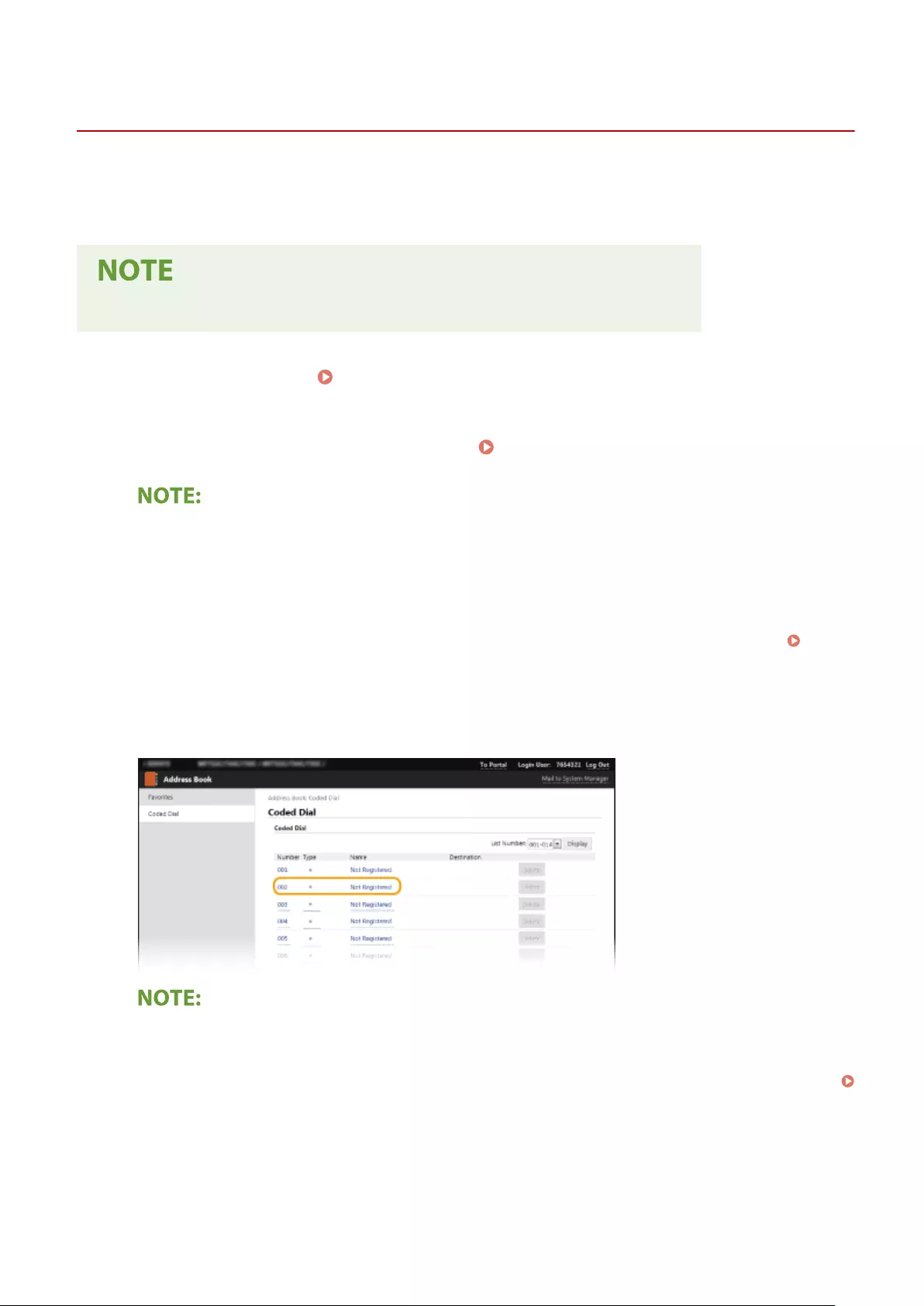
Registering Destinations from Remote UI
6FR5-08A
1660-083
You can use the computer to register destinations in the Address Book of the machine and edit information of
registered destinations. Specify the shared folder or FTP server destination here.
●You can change the settings only when you have logged in to System Manager Mode.
1Start the Remote UI. Starting Remote UI(P. 428)
2Click [Address Book] on the Portal page. Remote UI Screen(P. 429)
If the enter PIN page is displayed
●The Address Book is protected by a PIN. Enter the [PIN] and click [OK].
3Click [Coded Dial].
●You can also register destinations in Favorites. In this case, click [Favorites] instead of [Coded Dial].
Favorites(P. 180)
4Click the text link under [Number], [Type], or [Name] for an item named "Not
Registered."
●You can edit a registered item by clicking the corresponding text link under [Number], [Type] or [Name].
●You can delete a registered destination by clicking the corresponding [Delete] button.
●If you delete a destination from the Address Book, it is also deleted from the favorite settings.
Registering Frequently Used Settings(P. 172)
5Select the type of the destination to register, and click [OK].
●To register the shared folder or FTP server destination, select [File].
Managing the Machine
440
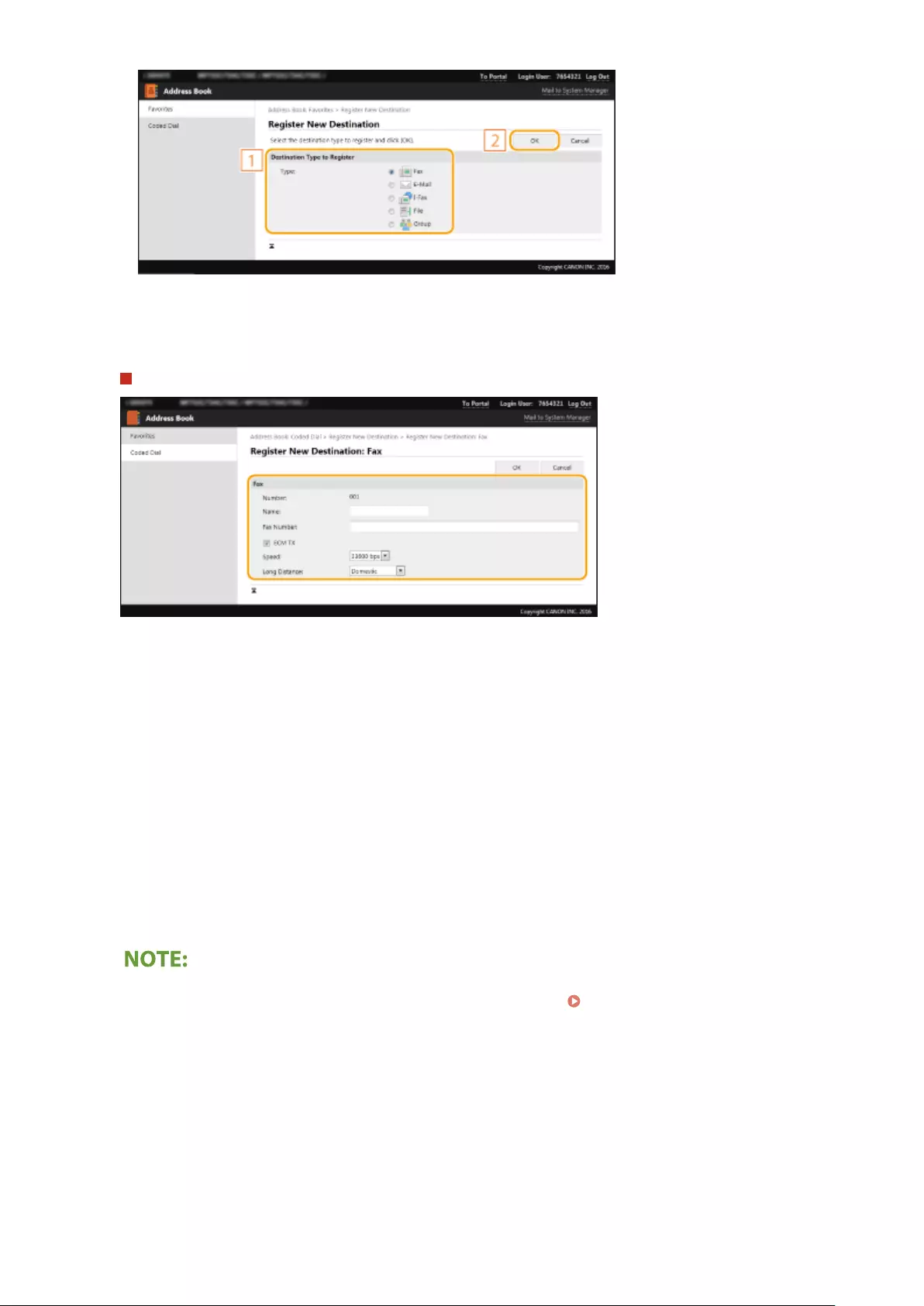
6Specify the destination.
To register the fax destination
[Name]
Enter the name of the destination.
[Fax Number]
Enter the fax number of the destination.
[ECM TX]
Select the check box to make the following possible: if an error occurs in an image that is being sent, the error is
checked and corrected to prevent an improper image from being sent.
[Speed]
If it takes time for transmissions to start, such as when there is a poor telephone connection, you can adjust the
transmission start speed downward.
[Long Distance]
Specify [International (1)] to [International (3)] according to the transmission conditions when registering
overseas fax numbers.
●You can also specify [ECM TX] and [Speed] from <Fax Settings> ( <Send>(P. 534) ) on the operation panel.
However, settings made from <Address Book> are enabled for the detailed settings of destinations
registered in the Address Book.
Managing the Machine
441
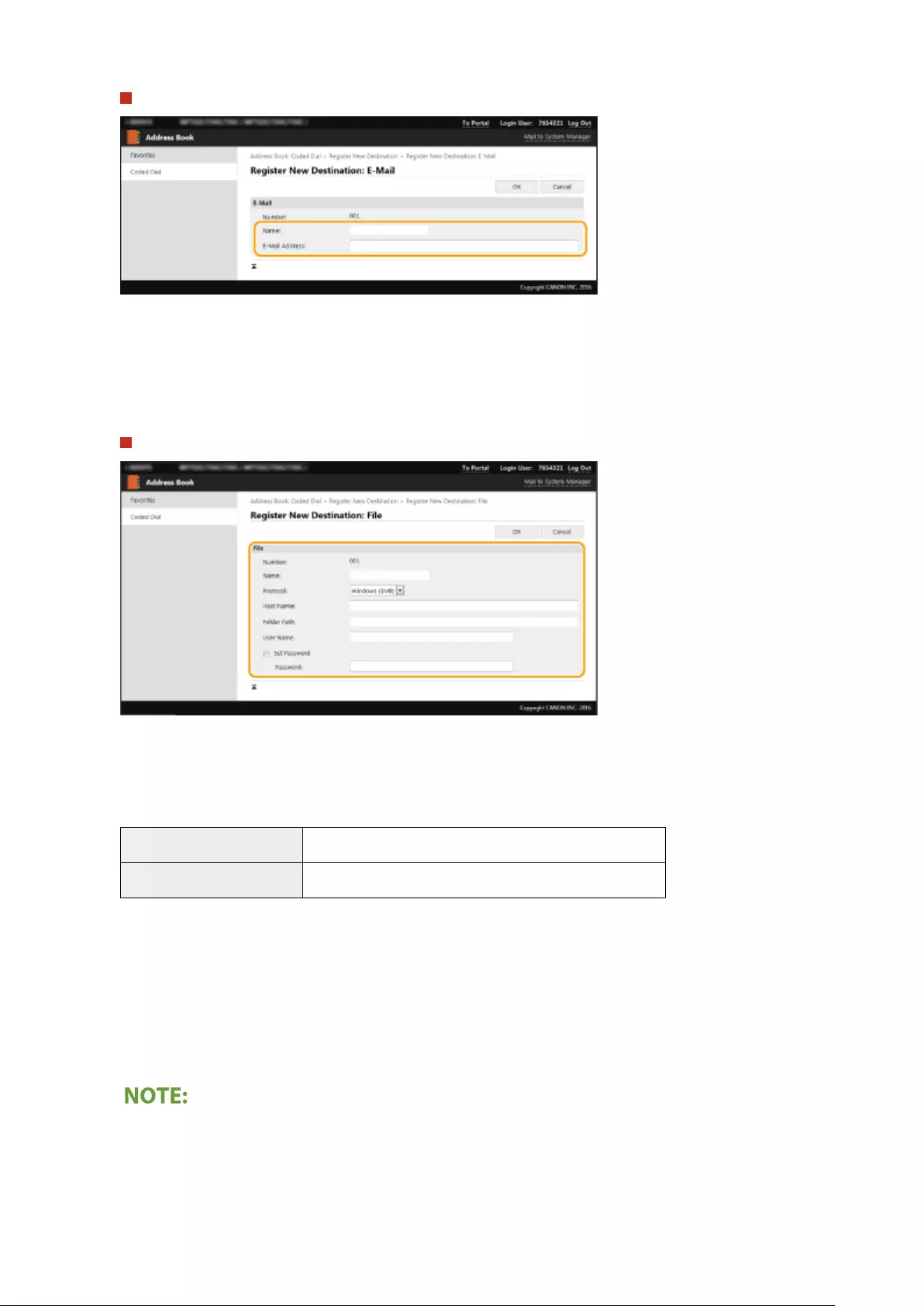
To register the e-mail or I-Fax destination
[Name]
Enter the name of the destination.
[E-Mail Address]/[I-Fax Address]
Enter the e-mail address of the destination.
To register the shared folder or FTP server destination
[Name]
Enter the name for the destination.
[Protocol]
Select the protocol for the destination.
[Windows (SMB)] Select this when registering a shared folder as a destination.
[FTP] Select this when registering an FTP server as a destination.
[Host Name]
●For a shared folder
Enter the computer name or IP address. You can include a path to the shared folder with the computer
name or IP address (e.g. "\\swan\share" or "\\192.168.2.100\share").
●For an FTP server
Enter the IP address of the FTP server (e.g. "192.168.2.100").
Using a DNS server
●You can also enter the host name (or FQDN) instead of the computer name or IP address (e.g. for a shared
folder: "\\swan.organization.company.com\share").
Managing the Machine
442

[Folder Path]
Enter the location of the folder to which the data will be sent.
●For a shared folder
Use "\" as a separator. Specify the level that follows the path specied in [Host Name].
●For an FTP server
Use "/" as a separator. The path is an absolute path when a "/" is placed at its top, otherwise a relative path
with respective to the current directory of the user who has logged in.
●If there is no folder in which the data will be stored, a folder with the specied name is automatically
created when sending is performed. However, if the specied path includes two or more non-existent
folder levels or if the user does not have a write privilege for the parent folder, no folder is created and the
process ends in a send error.
[User Name]
Enter the user name set for the shared folder or FTP server.
[Set Password]
To set a password for the shared folder or FTP server, select the check box and enter a [Password].
Ensure that the same display language is selected on both the computer and the
Remote UI.
●[Host Name] and [Folder Path] may not be displayed correctly or may not be referenceable.
7Click [OK].
LINKS
Remote UI Screen(P. 429)
Importing/Exporting the Setting Data(P. 450)
Address Book List(P. 599)
Managing the Machine
443
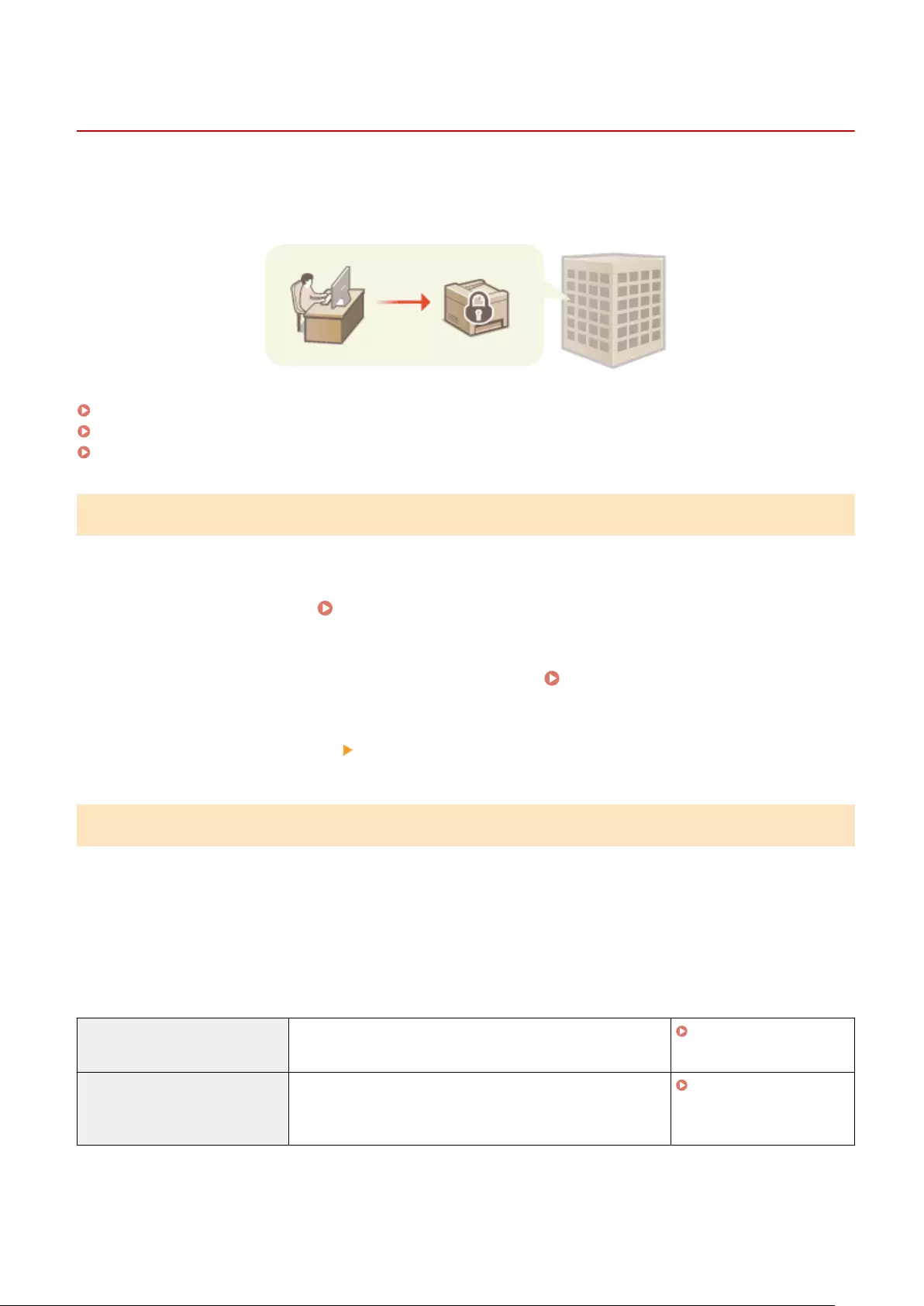
Security Policy
6FR5-08C
It is a common practice for organizations to adopt a security policy that denes basic information security objectives
and standards, which requires information devices such as computers and multifunctional printers to be operated
accordingly. If you have a security policy to be applied in your organization, apply it to this machine as well.
Viewing the Security Policy(P. 444)
Security Policy Items(P. 444)
To Apply the Security Policy to the Machine(P. 448)
Viewing the Security Policy
You can view the security policy set in the machine using the Remote UI.
1Start the Remote UI. Starting Remote UI(P. 428)
2Click [Settings/Registration] on the Portal page. Remote UI Screen(P. 429)
3Click [Security Settings] [Conrm Security Policy].
Security Policy Items
The following items are displayed by the Remote UI. The items for functions unavailable on this machine are also
displayed, but do not affect the machine operation.
◼[Interface]
[Wireless Connection Policy]
Prevent unauthorized access by prohibiting wireless connections.
[Prohibit Use of Direct Connection] <Use Direct Connection> is set to <Off>. It is not possible to
access the machine from mobile devices.
<Direct Connection
Settings>(P. 473)
[Prohibit Use of Wireless LAN] <Select Wired/Wireless LAN> is set to <Wired LAN>. It is not
possible to establish a wireless connection with the machine via
a wireless LAN router or access point.
<Select Wired/Wireless
LAN>(P. 472)
[USB Policy]
Prevent unauthorized access and data breaches by prohibiting USB connection.
Managing the Machine
444
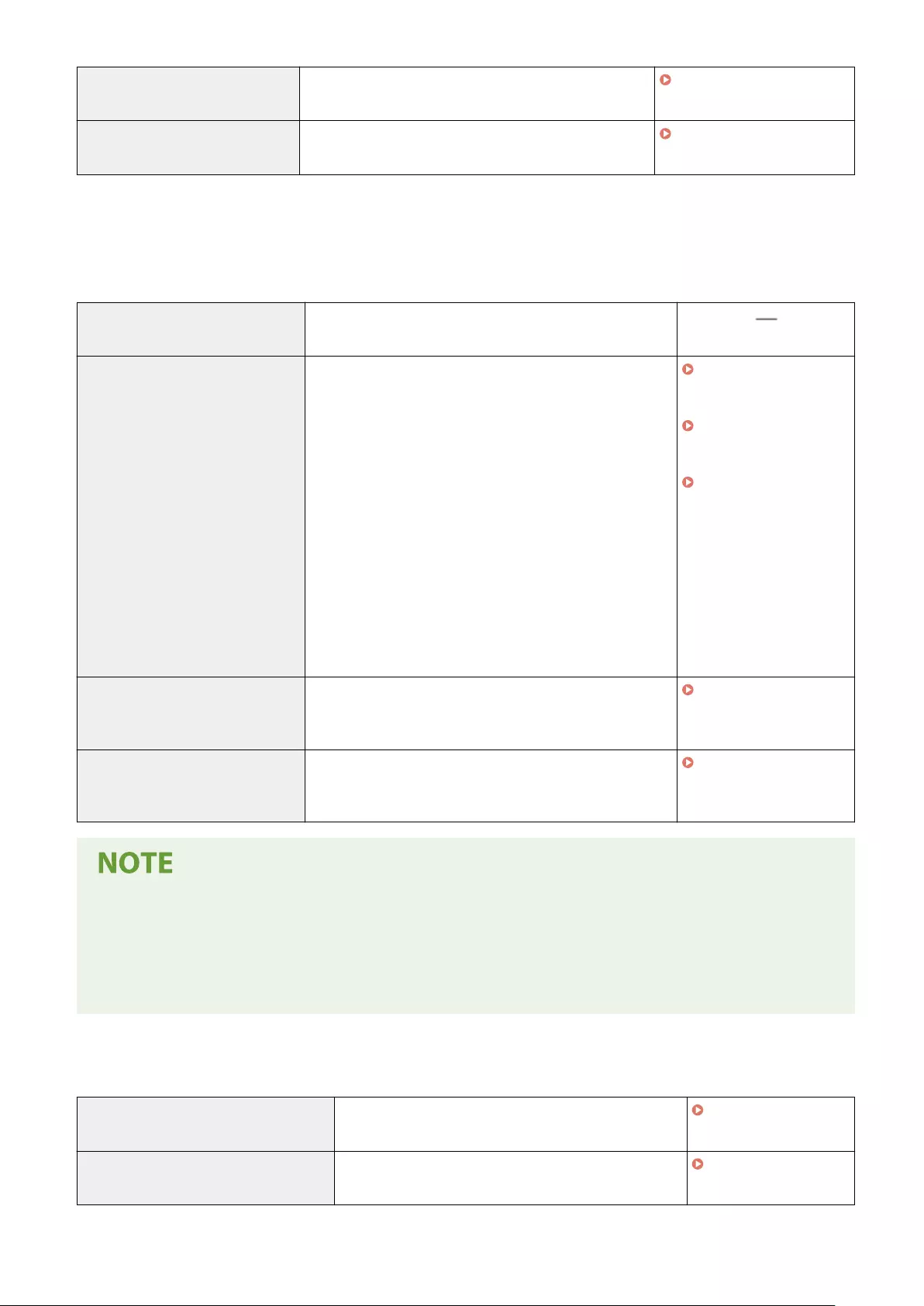
[Prohibit Use as USB Device] <Use as USB Device> is set to <Off>. It is not possible to
connect to a computer via USB.
<Use as USB Device>(P. 487)
[Prohibit Use as USB Storage Device] <Use USB Storage Device> is set to <Off>. It is not possible
to use USB memory devices.
<Use USB Storage
Device>(P. 487)
◼[Network]
[Communication Operational Policy]
Increase the security of communications by requiring the verication of signatures and certicates.
[Always Verify Signatures for SMS/
WebDAV Server Functions]
This function is not available on this machine, giving no
change to the security level.
[Always Verify Server Certicate
When Using TLS]
The following settings in [Use TLS for SMTP] and [Use TLS for
POP] are set to [On].
●[Verify Certicate]
●[Add CN to Verication Items]
The following settings in [Use Google Cloud Print] are set to
[On].
●[Verify Server Certicate]
●[Add CN to Verication Items]
The following settings in [Conrm TLS Certicate for LDAP
Server Access] of [LDAP Server (For Search)] and [LDAP Server
(For Authentication)] are set to [On].
●[Conrm TLS Certicate for LDAP Server Access]
●[Add CN to Verication Items]
Conguring E-Mail/I-Fax
Communication
Settings(P. 89)
Registering the Machine
with Google Cloud
Print(P. 354)
Registering LDAP
Servers(P. 64)
[Prohibit Cleartext Authentication for
Server Functions]
<Dedicated Port Auth. Method> is set to <Mode 2>. When
using the machine as a server, plain text authentication and
functions that use plain text authentication are not available.
<Dedicated Port Auth.
Method>(P. 483)
[Prohibit Use of SNMPv1] In <SNMP Settings>, <SNMPv1 Settings> is set to <Off>. It is
not possible to use SNMPv1 when obtaining device
information from the computer.
<SNMP Settings>(P. 481)
●This setting does not apply to communication with IEEE 802.1X networks, even if [Always Verify Server
Certicate When Using TLS] is set to [On].
●If [Prohibit Cleartext Authentication for Server Functions] is set to [On] and your device management
software or driver version is old, it may not be possible to connect to the machine. Ensure that you are using
the latest versions.
[Port Usage Policy]
Prevent external breaches by closing unused ports.
[Restrict LPD Port (Port Number: 515)] In <LPD Settings>, <Use LPD Printing> is set to <Off>. It is
not possible to perform LPD printing.
<LPD Settings>(P. 479)
[Restrict RAW Port (Port Number: 9100)] In <RAW Settings>, <Use RAW Printing> is set to <Off>. It is
not possible to perform RAW printing.
<RAW Settings>(P. 479)
Managing the Machine
445

[Restrict FTP Port (Port Number: 21)] This function is not available on this machine, giving no
change to the security level.
[Restrict WSD Port (Port Number: 3702,
60000)]
The following settings in <WSD Settings> are set to <Off>.
It is not possible to use WSD functions.
●<Use WSD Printing>
●<Use WSD Browsing>
●<Use WSD Scanning>
●<Use Computer Scanning>
●<Use Multicast Discovery>
<WSD Settings>(P. 479)
[Restrict BMLinkS Port (Port Number:
1900)]
This function is not available on this machine, giving no
change to the security level.
[Restrict IPP Port (Port Number: 631)] Part of the settings to enable printing from mobile devices
using applications will be turned <Off>, disabling part of
printing from mobile devices using applications.
Linking with Mobile
Devices(P. 332)
[Restrict SMB Port (Port Number: 137, 138,
139, 445)]
This function is not available on this machine, giving no
change to the security level.
[Restrict SMTP Port (Port Number: 25)] This function is not available on this machine, giving no
change to the security level.
[Restrict Dedicated Port (Port Number:
9002, 9006, 9007, 9011-9015, 9017-9019,
9022, 9023, 9025, 20317, 47545-47547)]
<Use Dedicated Port> is set to <Off>. It is not possible to
use dedicated ports.
<Use Dedicated
Port>(P. 482)
[Restrict Remote Operator's Software Port
(Port Number: 5900)]
This function is not available on this machine, giving no
change to the security level.
[Restrict SIP (IP Fax) Port (Port Number:
5004, 5005, 5060, 5061, 49152)]
This function is not available on this machine, giving no
change to the security level.
[Restrict mDNS Port (Port Number: 5353)] The following settings will be turned <Off>, and part of the
settings to enable printing from mobile devices using
applications will also be turned <Off>. It will be disabled to
search the network or perform automatic settings using
mDNS. In addition, part of printing from mobile devices
using applications will be disabled as well.
●<mDNS Settings> (IPv4)
●<mDNS Settings> (IPv6)
●[Use Google Cloud Print] [Local Print]
<mDNS
Settings>(P. 478)
Registering the
Machine with Google
Cloud Print(P. 354)
Linking with Mobile
Devices(P. 332)
[Restrict SLP Port (Port Number: 427)] In [Multicast Discovery Settings], [Discovery Response] is
set to [Off]. It is not possible to search the network or
perform automatic settings using SLP.
Conguring SLP
Communication with
Device Management
Software(P. 75)
[Restrict SNMP Port (Port Number: 161)] In <SNMP Settings>, the <SNMPv1 Settings> and <SNMPv3
Settings> are set to <Off>, and <Scan w/Canon PRINT
Business> is set to <Off>. It is not possible to obtain device
information from the computer or congure settings
using SNMP.
<SNMP
Settings>(P. 481)
<Scan w/Canon PRINT
Business>(P. 565)
◼[Authentication]
[Authentication Operational Policy]
Managing the Machine
446

[Prohibit Guest Users to Use Device] This function is not available on this machine, giving no change to the security level.
[Force Setting of Auto Logout] This function is not available on this machine, giving no change to the security level.
[Password Operational Policy]
[Prohibit Caching of Password for External Servers] This function is not available on this machine, giving no change to the
security level.
[Display Warning When Default Password Is in Use] This function is not available on this machine, giving no change to the
security level.
[Prohibit Use of Default Password for Remote Access] This function is not available on this machine, giving no change to the
security level.
[Password Settings Policy]
[Minimum Number of Characters for Password] This function is not available on this machine, giving no change to
the security level.
[Password Validity Period] This function is not available on this machine, giving no change to
the security level.
[Prohibit Use of 3 or More Identical Consecutive
Characters]
This function is not available on this machine, giving no change to
the security level.
[Force Use of at Least 1 Uppercase Character] This function is not available on this machine, giving no change to
the security level.
[Force Use of at Least 1 Lowercase Character] This function is not available on this machine, giving no change to
the security level.
[Force Use of at Least 1 Digit] This function is not available on this machine, giving no change to
the security level.
[Force Use of at Least 1 Symbol] This function is not available on this machine, giving no change to
the security level.
[Lockout Policy]
Block users from logging in for a specied period of time after a certain number of consecutive invalid login attempts.
[Enable Lockout] In <Lockout>, <Enable Lockout> is set to <On>. Specify the values for
<Lockout Threshold> and <Lockout Period>.
<Lockout>(P. 571)
◼[Key/Certicate]
Protect important data by preventing the use of weak encryption, or by saving encrypted user passwords and keys in a
designated hardware component.
[Prohibit Use of Weak Encryption] <Prohibit Use of Weak Encrypt.> is set to <On>. It is not
possible to use weak encryption.
<Encryption
Settings>(P. 571)
[Prohibit Use of Key/Certicate with Weak
Encryption]
In <Prohibit Use of Weak Encrypt.>, <Prohibit Weak
Encryp. Key/Cert.> is set to <On>. It is not possible to use
a key or certicate with weak encryption.
<Encryption
Settings>(P. 571)
Managing the Machine
447
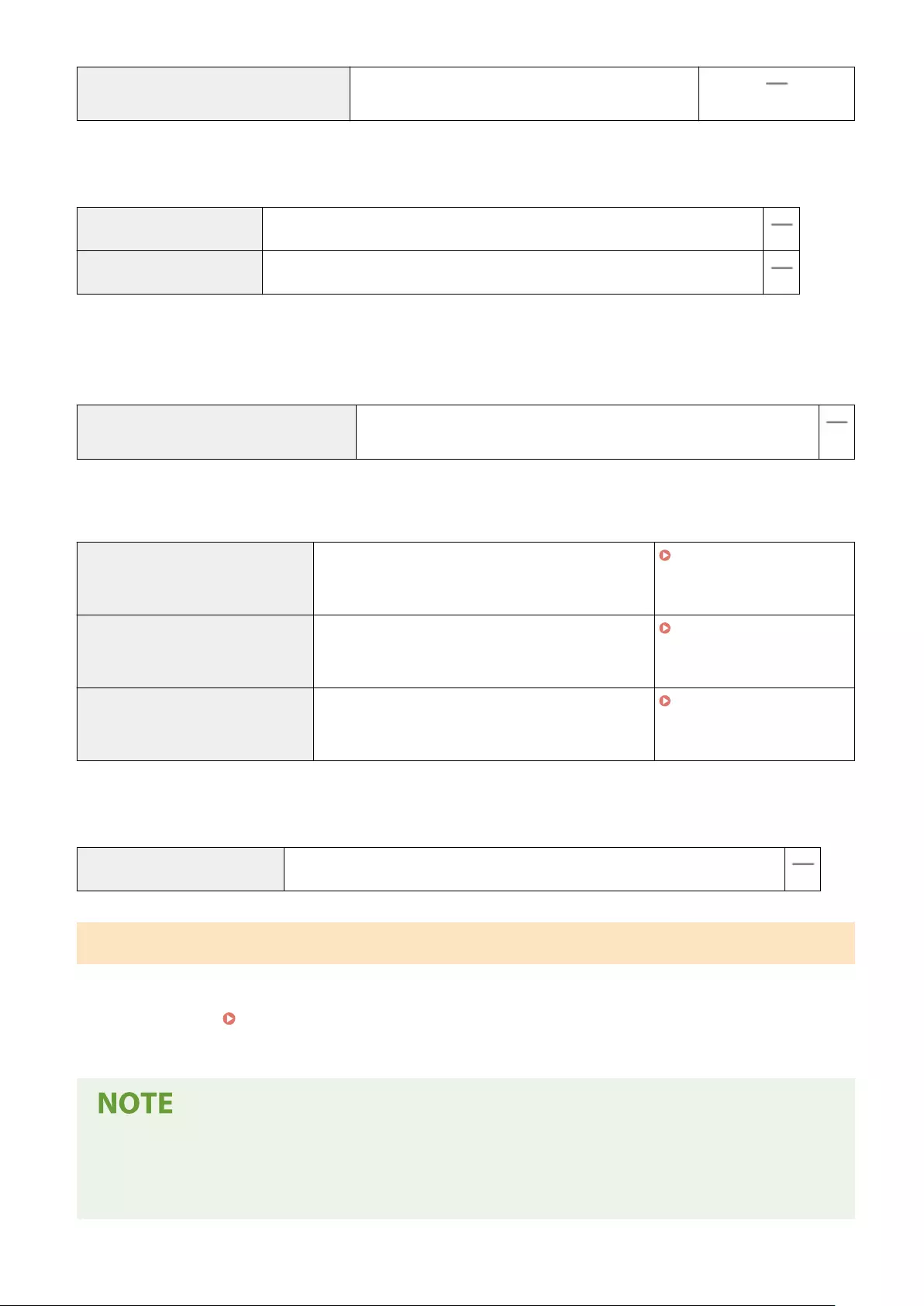
[Use TPM to Store Password and Key] This function is not available on this machine, giving no
change to the security level.
◼[Log]
[Force Recording of Audit Log] This function is not available on this machine, giving no change to the security level.
[Force SNTP Settings] This function is not available on this machine, giving no change to the security level.
◼[Job]
[Printing Policy]
[Prohibit Immediate Printing of Received Jobs] This function is not available on this machine, giving no change to the
security level.
[Sending/Receiving Policy]
Limit the sending operations for destinations, and limit how received data is processed.
[Allow Sending Only to Registered
Addresses]
<Restrict New Destinations> is set to <On>. It is only
possible to send to destinations that are registered in
the Address Book.
<Restrict New
Destinations>(P. 534)
[Force Conrmation of Fax Number] <Conrm Entered Fax Number> is set to <On>. Users
are required to enter a fax number again for
conrmation when sending a fax.
<Conrm Entered Fax
Number>(P. 544)
[Prohibit Auto Forwarding] In <Forwarding Function>, the <Use Forwarding
Function> is set to <Off>. It is not possible to
automatically forward faxes.
<Forwarding
Settings>(P. 552)
◼[Storage]
[Force Complete Deletion of Data] This function is not available on this machine, giving no change to the security level.
To Apply the Security Policy to the Machine
You can import the security policy edited on the imageRUNNER ADVANCE Series or using Device Management
Software to apply it to this machine. In addition, you can export the security policy as applied to this machine to apply
it to other machines*. Importing/Exporting the Setting Data(P. 450)
*Only Canon devices that are compatible with security policy settings
●The security policy settings can only be imported if the security policy setting password on the exporting
machine matches that of the importing machine, or if no password has been set for the importing machine.
If no password has been set for the importing machine, the password congured for the exporting machine
is set to the importing machine.
Managing the Machine
448

●You cannot set or change the security policy on this machine.
Managing the Machine
449

Importing/Exporting the Setting Data
6FR5-08E
Address Book and machine settings data can be saved on your computer (export). Data that is saved on your
computer can also be registered in the machine (import). You can easily copy the destinations in the Address Book
to multiple machines.* To use these features, it is required that you have logged in to System Manager Mode.
*If using the same model, you can import/export machine settings data.
Exporting the Setting Data(P. 450)
Importing the Setting Data(P. 451)
Do not turn OFF the machine until the import or export process is complete
●It may take a few minutes to complete the process. If the machine is turned OFF during the process, it may
result in damage to data or the machine.
Do not operate the machine during the import or export process
●Before importing/exporting, check that no operation such as printing documents is currently proceeding.
●For the settings that cannot be imported/exported, see Setting Menu List(P. 458) .
●You can also import/export settings data via a USB memory device by using the operation panel of the
machine. <Import/Export>(P. 569)
●For more information about the basic operations to be performed when setting the machine from the
Remote UI, see Setting Up Menu Options from Remote UI(P. 437) .
Exporting the Setting Data
You can export Address Book and machine settings data, and save them on a computer. You can export Address Book
data as a device conguration information le (*.dcm) or Canon Address Book le (*.abk). Select the device
conguration information le type to save the data as a backup copy or copy the Address Book data to the same
machine model. Select the Canon Address Book le type to copy the Address Book data to the fax driver or a different
machine model. It is recommended that you regularly back up important settings.
1Start the Remote UI and log in to System Manager Mode. Starting Remote
UI(P. 428)
2Click [Settings/Registration] on the Portal page. Remote UI Screen(P. 429)
3Select [Data Management] [Export].
4Select the settings to export, and specify the encryption password.
Managing the Machine
450
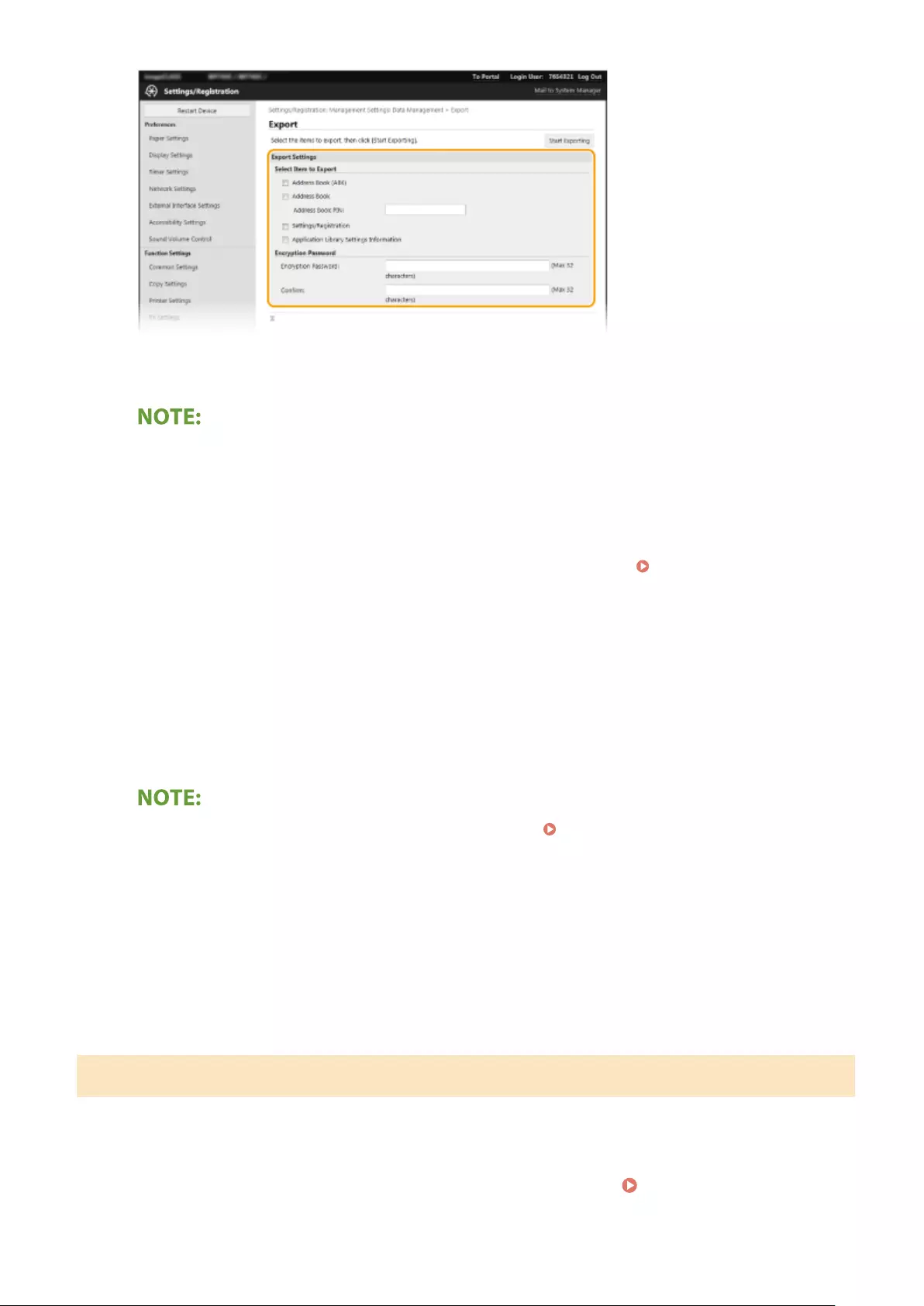
[Address Book (ABK)]
Select the check box to export the Address Book data as a Canon Address Book le (*.abk).
●If the [Address Book (ABK)] check box is selected, you cannot export the settings of the machine at the
same time with the Address Book data.
[Address Book]
Select the check box to export the Address Book data as a device conguration information le (*.dcm).
[Address Book PIN]
If the Address Book is code-protected, enter the code for the Address Book. Restricting Use of the
Address Book(P. 414)
[Settings/Registration]
Select the check box to export machine settings data.
[Application Library Settings Information]
Select the check box to export the Application Library settings data.
[Encryption Password]
Enter a password to encrypt the export data using alphanumeric characters. Enter the same password in
[Conrm]. If the [Address Book] or [Settings/Registration] check box is selected, the data cannot be exported
without an encryption password set.
●The password is required when exported data is imported. Importing the Setting Data(P. 451)
5Click [Start Exporting].
6Follow the on-screen instructions to specify the location where to save the exported
data.
➠The setting data will be saved.
Importing the Setting Data
Load (import) data that was exported from the machine. You can also import machine settings data from another
machine to your machine if the models are the same.
1Start the Remote UI and log in to System Manager Mode. Starting Remote
UI(P. 428)
Managing the Machine
451
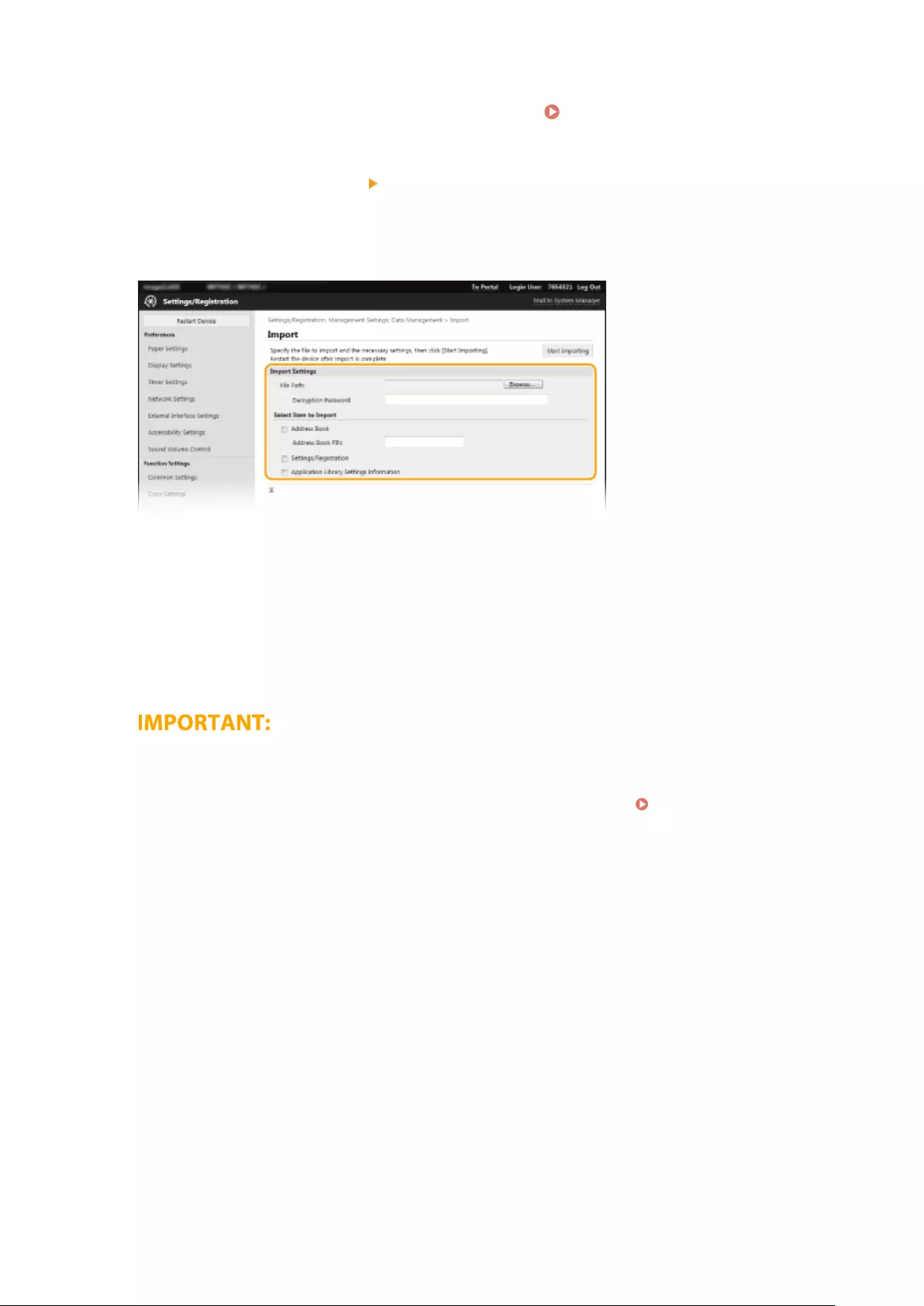
2Click [Settings/Registration] on the Portal page. Remote UI Screen(P. 429)
3Select [Data Management] [Import].
4Specify the le, enter the password, and select the settings to import.
[File Path]
Click [Browse] and select the le. You can only import a device conguration information le (*.dcm) and a
Canon Address Book le (*.abk). If you select the Canon Address Book le type, you do not need to set any
other items.
[Decryption Password]
Enter the password set when the settings were exported.
[Address Book]
Select the check box to import Address Book data.
●Importing Address Book data will overwrite the Address Book entries currently registered on the machine.
[Address Book PIN]
If the Address Book is code protected, enter the code for the Address Book. Restricting Use of the
Address Book(P. 414)
[Settings/Registration]
Select the check box to import machine settings data.
[Application Library Settings Information]
Select the check box to import the Application Library settings data.
5Click [Start Importing].
6Click [OK].
➠The selected settings data is loaded into the machine.
7Click [OK].
➠If the [Settings/Registration] check box is selected in step 4, the machine automatically restarts.
Managing the Machine
452
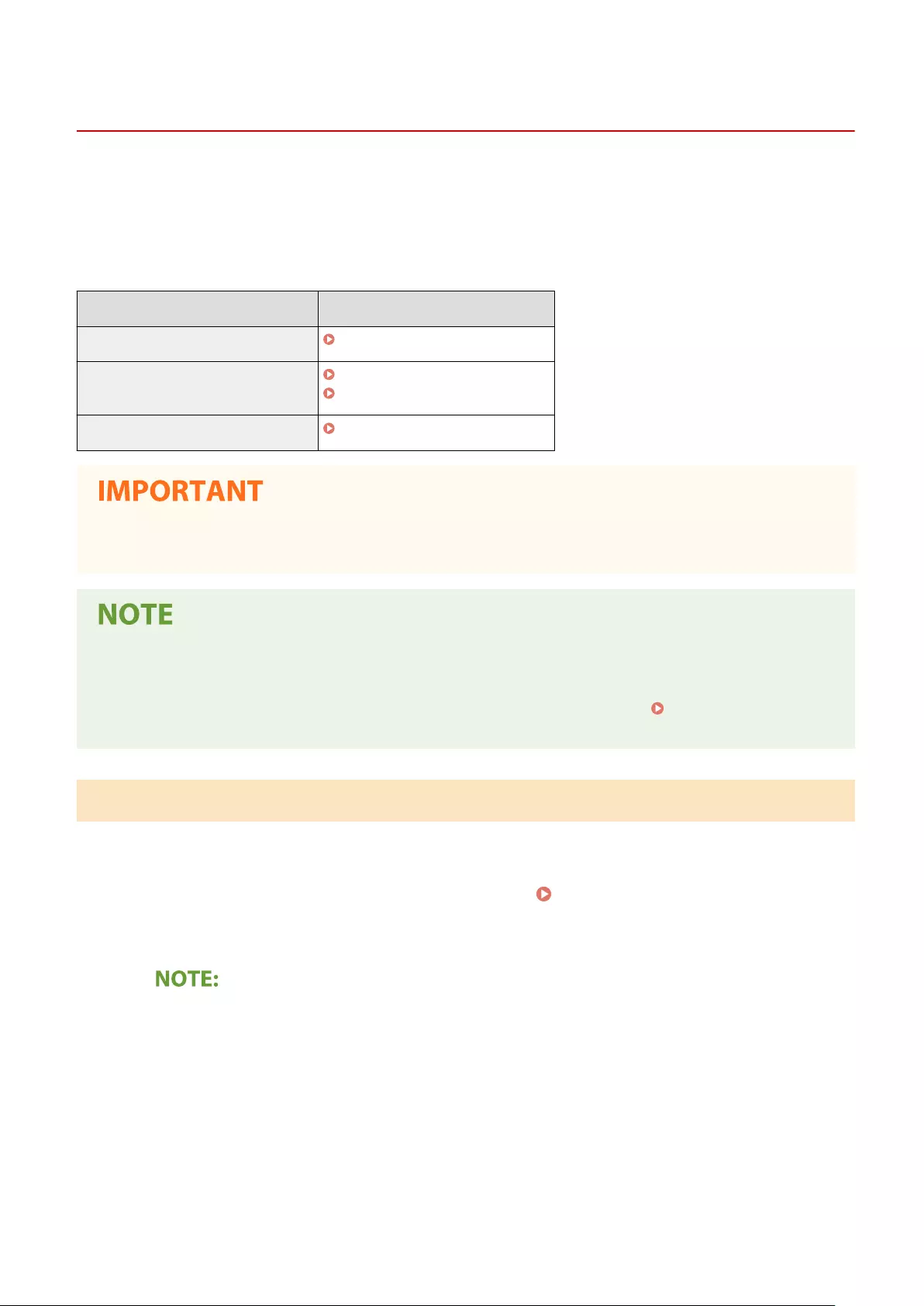
Updating the Firmware
6FR5-08F
For the rmware, select the method of update depending on the installation condition of the machine. There are two
methods of update: the one is to access the latest rmware version on the Internet from the machine and perform the
update if the version currently installed in the machine is not the latest, and the other is to access the latest rmware
version on the Internet from a computer and perform the update from the computer if the version currently installed
in the machine is not the latest. In an environment where connection to the Internet cannot be established via a
wireless LAN, establish connection via a wired LAN or USB and perform the update from the computer.
Installation Condition of the Machine How to Install the Update
Wireless LAN connection Updating via the Internet(P. 453)
Wired LAN connection Updating via the Internet(P. 453)
Updating from a Computer(P. 454)
USB connection Updating from a Computer(P. 454)
●If you are in an IPv6 environment, you cannot perform rmware update. Use USB to re-establish connection,
and perform the update from the computer.
Checking the rmware version
●You can check the rmware version from the operation panel of the machine. After completion of the
rmware update operation, make sure that the update was performed correctly. Checking the Firmware
Version(P. 454)
Updating via the Internet
You can access the Canon server from the machine to update the rmware to the latest version.
1Select <Update Firmware> in the Home screen. Home Screen(P. 124)
➠A check for existence of the latest rmware is performed.
●If the <This is the latest rmware version.> message is displayed, there is no need to update the
rmware.
2When a license screen appears, select <Accept>.
3Select <OK>.
➠When the rmware update is complete, the machine restarts automatically.
Managing the Machine
453
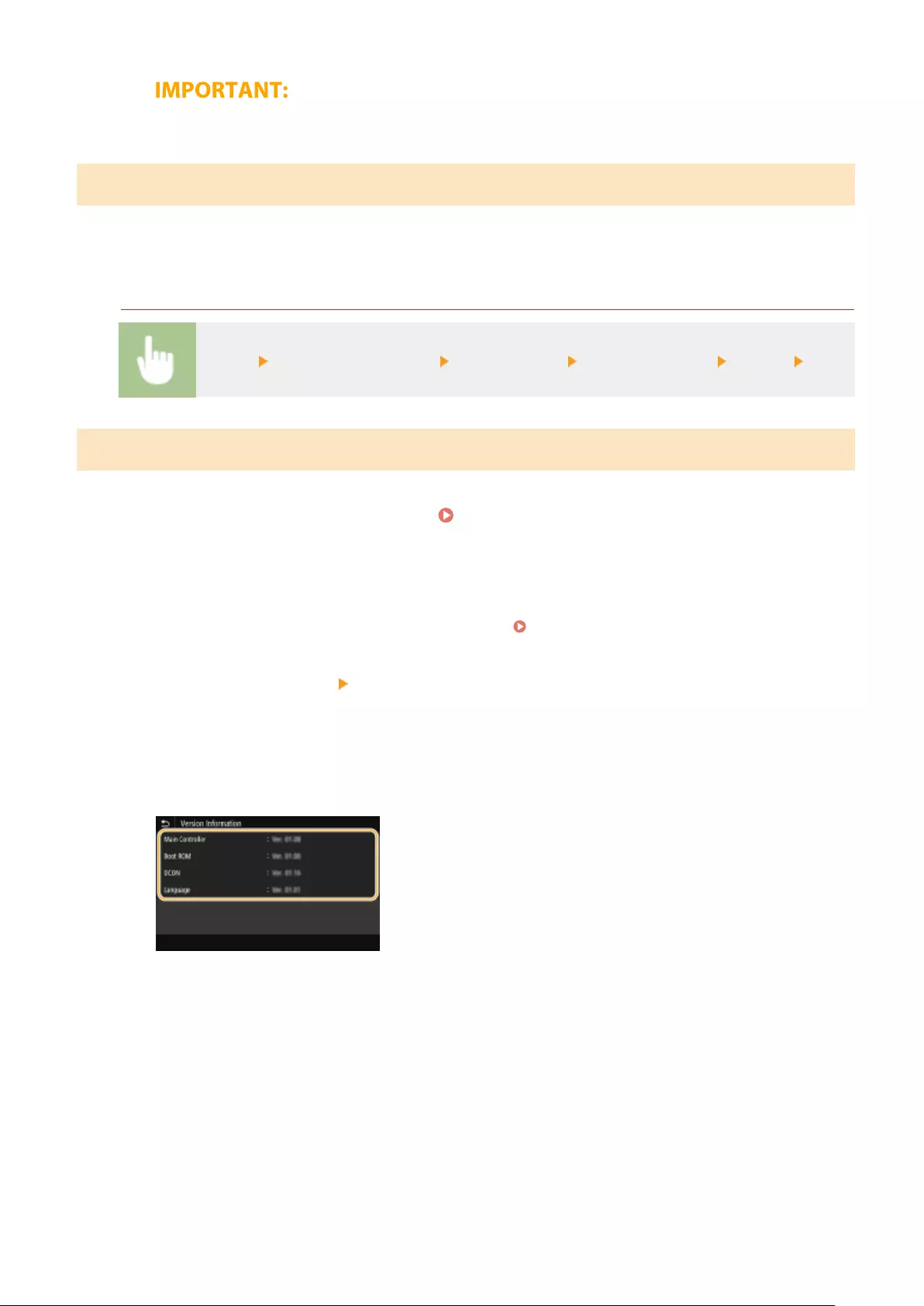
●Do not turn OFF the machine while the restart is in progress.
Updating from a Computer
When you have downloaded the latest rmware version from the Canon website, use "User Support Tool" utility
software to update the rmware from a computer. For how to perform rmware update from a computer, see the
"User Support Tool Operation Guide" included with the rmware.
To Put the Machine into a Firmware Update Waiting State
<Menu> <Management Settings> <License/Other> <Update Firmware> <Via PC> <Yes>
Checking the Firmware Version
1Select <Menu> in the Home screen. Home Screen(P. 124)
2Select <Management Settings>.
●If the login screen appears, enter the correct ID and PIN. Logging in to the Machine(P. 135)
3Select <License/Other> <Update Firmware>.
4Select <Version Information>.
➠The current rmware version is displayed.
Managing the Machine
454
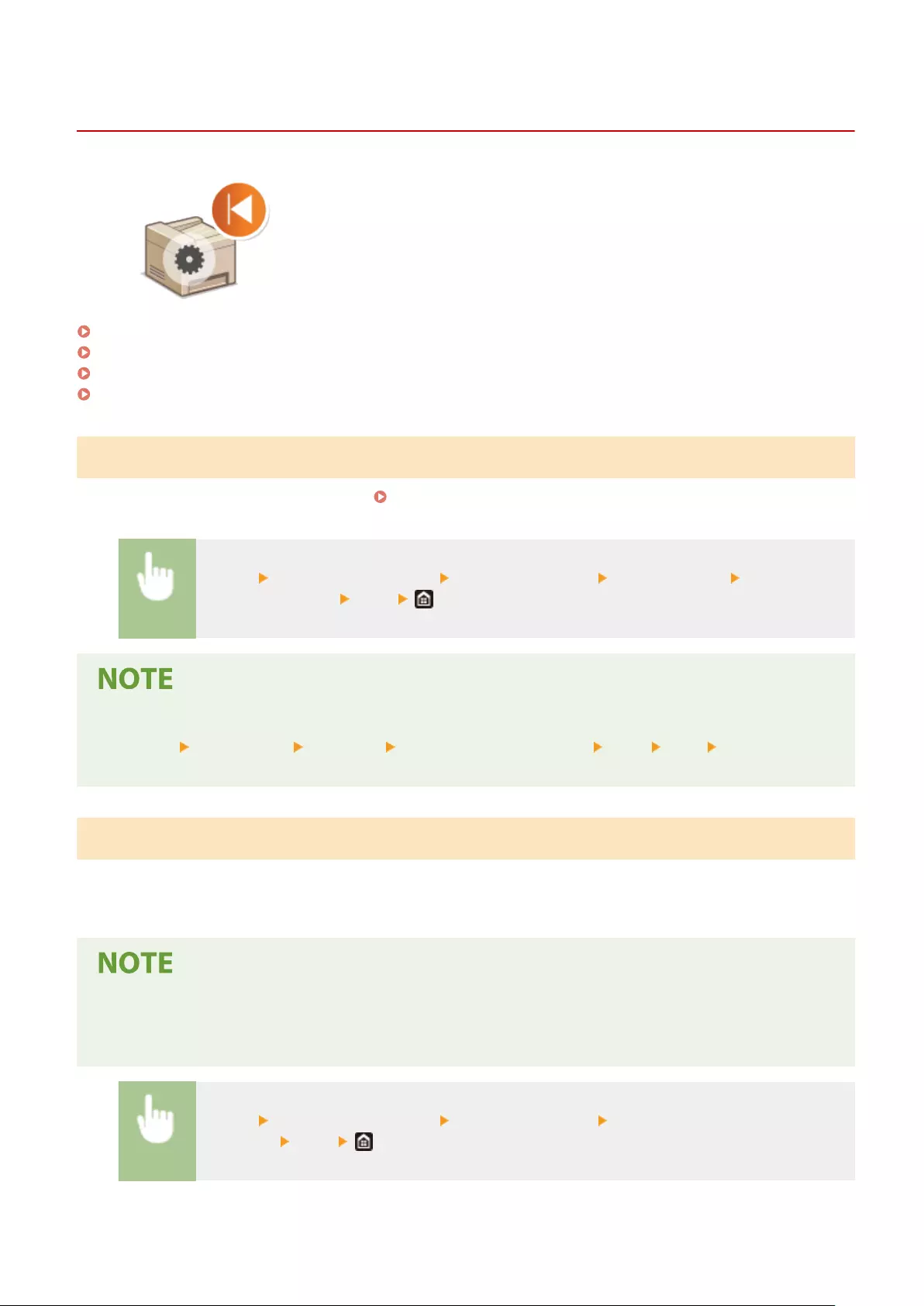
Initializing Settings
6FR5-08H
You can restore the following settings:
Initializing Menu(P. 455)
Initializing Key and Certicate(P. 455)
Initializing Address Book(P. 456)
Initializing All Data/Settings(P. 456)
Initializing Menu
You can restore the settings of the machine ( Setting Menu List(P. 458) ). Depending on the settings selected, you
may need to restart the machine after initialization.
<Menu> <Management Settings> <Data Management> <Initialize Menu> Select the item
you want to initialize <Yes> (Restart the machine if necessary)
●You can restore the settings only for <Network> in <Preferences>.
<Menu> <Preferences> <Network> <Initialize Network Settings> <Yes> <OK> Restart the
machine
Initializing Key and Certicate
You can restore the settings of the key and certicate and the CA certicate. Note that all the keys and certicates and
CA certicates that you registered in the machine (except the preinstalled keys and CA certicates) will be deleted after
initializing.
●After initializing, functions that require a key and certicate such as TLS encrypted communication and IKE
of IPSec communication are not available. To use these functions, congure the settings for the key and
certicate and activate the functions again.
<Menu> <Management Settings> <Data Management> <Initialize Key and
Certicate> <Yes>
Managing the Machine
455

Initializing Address Book
You can restore the settings of the Address Book. Note that all the information registered in the Address Book will be
deleted after initializing.
<Menu> <Management Settings> <Data Management> <Initialize Address
Book> <Yes>
Initializing All Data/Settings
This enables restoration of all data and machine settings, including logs, to the factory default values. This prevents
sensitive data from being leaked when replacing or disposing of the machine. When the initialization process nishes,
the machine automatically restarts.
●Before initializing, make sure that there are no documents being processed or waiting to be processed.
These documents will be deleted when initialization is performed.
●To use the machine after initializing it, you need to congure all settings from the beginning.
<Menu> <Management Settings> <Initialize All Data/Settings> <Yes> <Yes>
LINKS
Conguring the Key and Certicate for TLS(P. 389)
Registering Destinations(P. 180)
Registering Destinations from Remote UI(P. 440)
Managing the Machine
456

Setting Menu List
Setting Menu List ........................................................................................................................................... 458
<Preferences> .................................................................................................................................................... 459
<Display Settings> ........................................................................................................................................ 460
<English Keyboard Layout> .......................................................................................................................... 466
<Timer/Energy Settings> .............................................................................................................................. 467
<Network> .................................................................................................................................................... 472
<External Interface> ..................................................................................................................................... 487
<Accessibility> .............................................................................................................................................. 488
<Adjustment/Maintenance> ............................................................................................................................. 489
<Adjust Image Quality> ................................................................................................................................ 490
<Maintenance> ............................................................................................................................................. 499
<Function Settings> .......................................................................................................................................... 500
<Common> ................................................................................................................................................... 501
<Copy> ......................................................................................................................................................... 507
<Printer> ...................................................................................................................................................... 509
<Send> ......................................................................................................................................................... 534
<Receive/Forward> ....................................................................................................................................... 547
<Store/Access Files> ..................................................................................................................................... 554
<Secure Print> .............................................................................................................................................. 560
<Set Destination> .............................................................................................................................................. 561
<Management Settings> ................................................................................................................................... 562
<User Management> .................................................................................................................................... 563
<Device Management> ................................................................................................................................. 564
<License/Other> ........................................................................................................................................... 567
<Data Management> .................................................................................................................................... 569
<Security Settings> ....................................................................................................................................... 571
Setting Menu List
457
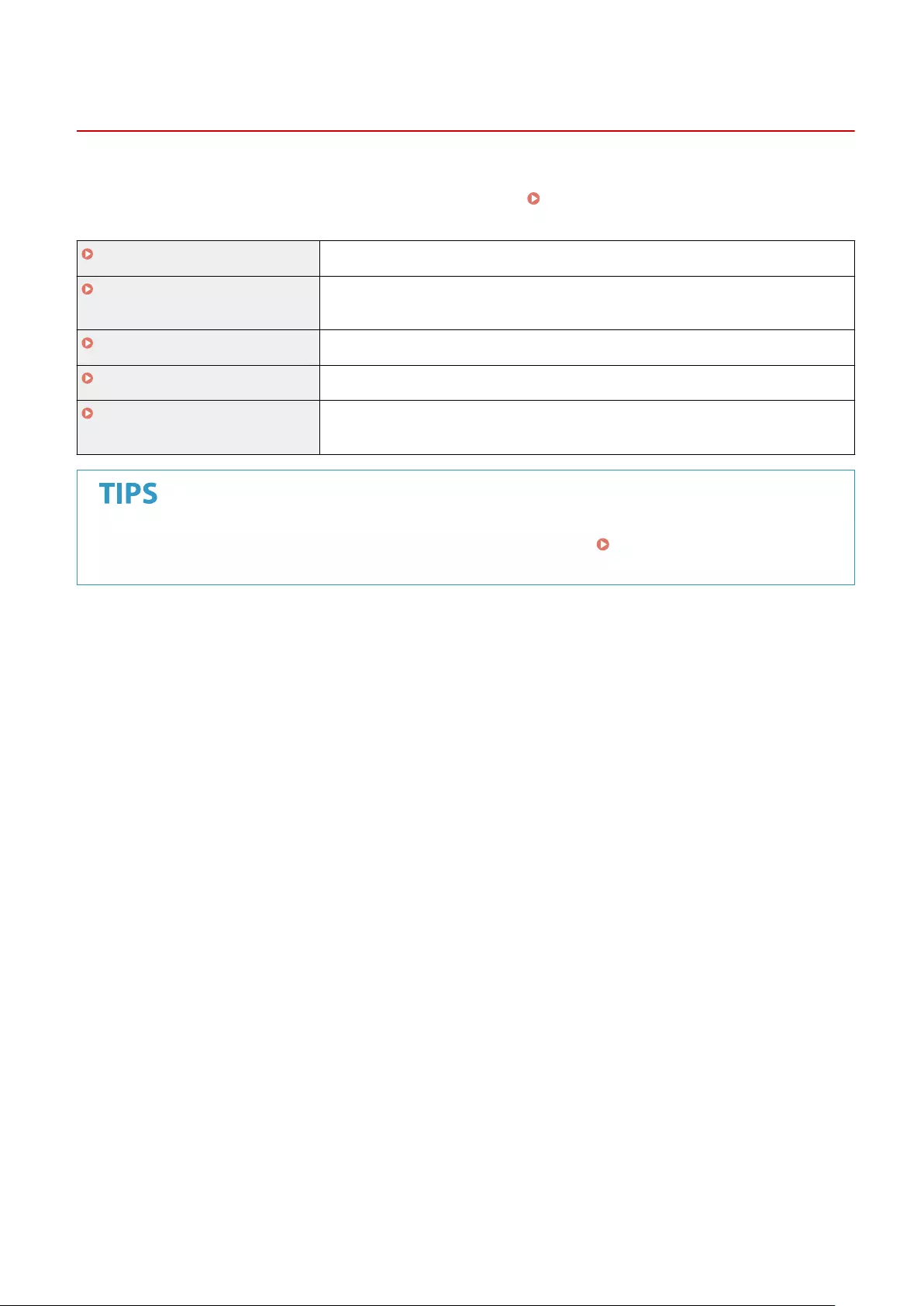
Setting Menu List
6FR5-08J
You can customize the machine based on your environment and needs by conguring settings described in this
chapter. To start conguration, select <Menu> on the Home screen ( Home Screen(P. 124) ). This section describes
what each item in the setting menu can congure.
<Preferences>(P. 459) This section describes the display and network settings.
<Adjustment/Maintenance>(P. 489) This section describes how to adjust print image quality and the cleaning functions of the
machine.
<Function Settings>(P. 500) This section describes the settings for the individual functions.
<Set Destination>(P. 561) This section describes the Address Book settings.
<Management Settings>(P. 562) This section describes the user and hardware information management, security
settings, etc.
●You can print the setting menu in list form to check the current settings: Printing Lists of
Settings(P. 599)
Setting Menu List
458
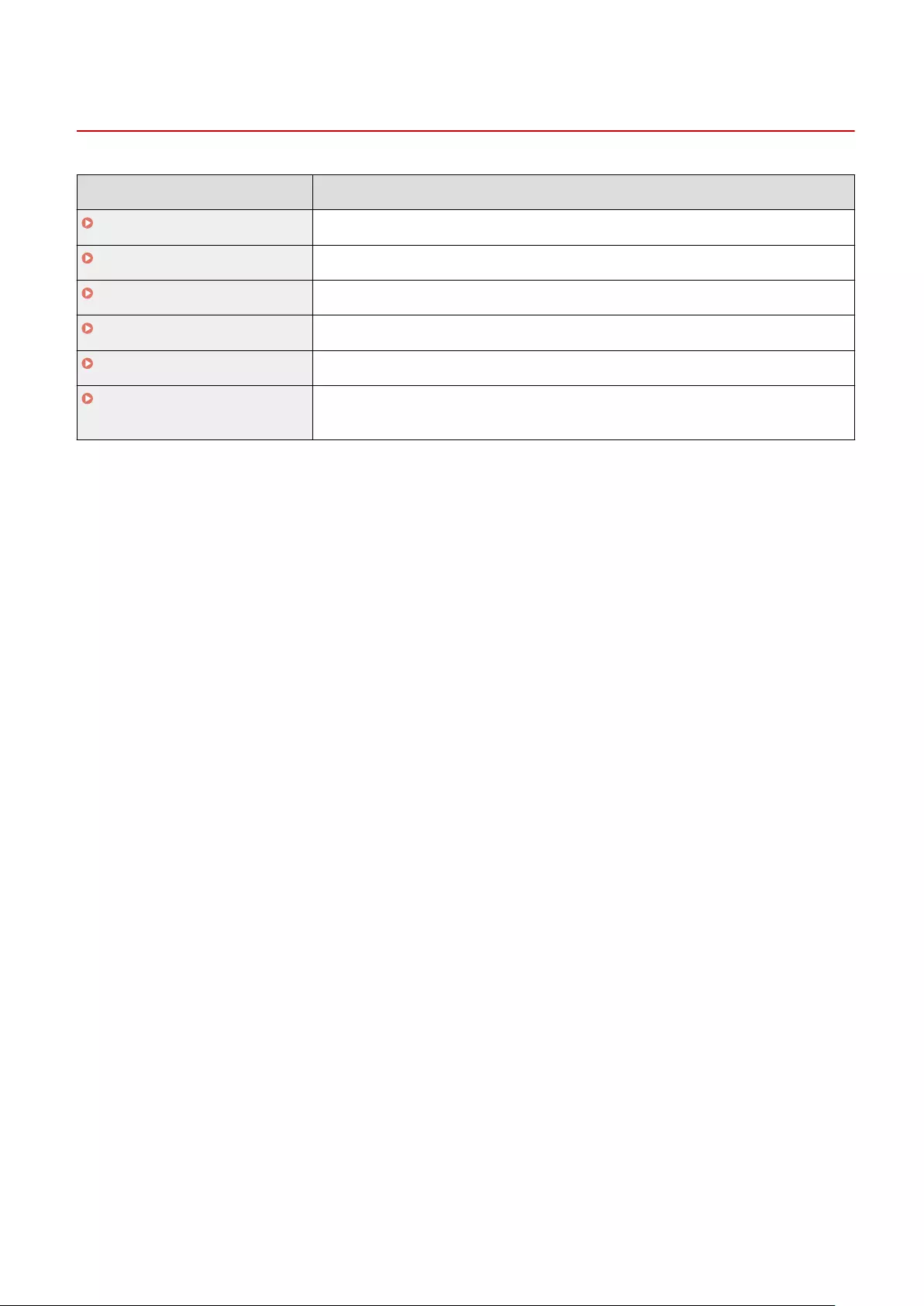
<Preferences>
6FR5-08K
Item Description
<Display Settings>(P. 460) This section describes the settings related to viewing of the display.
<English Keyboard Layout>(P. 466) This section describes the USB keyboard settings.
<Timer/Energy Settings>(P. 467) This section describes the timer settings and energy settings.
<Network>(P. 472) This section describes the network settings.
<External Interface>(P. 487) This section describes the USB settings and other relevant settings.
<Accessibility>(P. 488) This section describes settings for improving accessibility, such as inverting the screen
colors and setting the message display time.
Setting Menu List
459
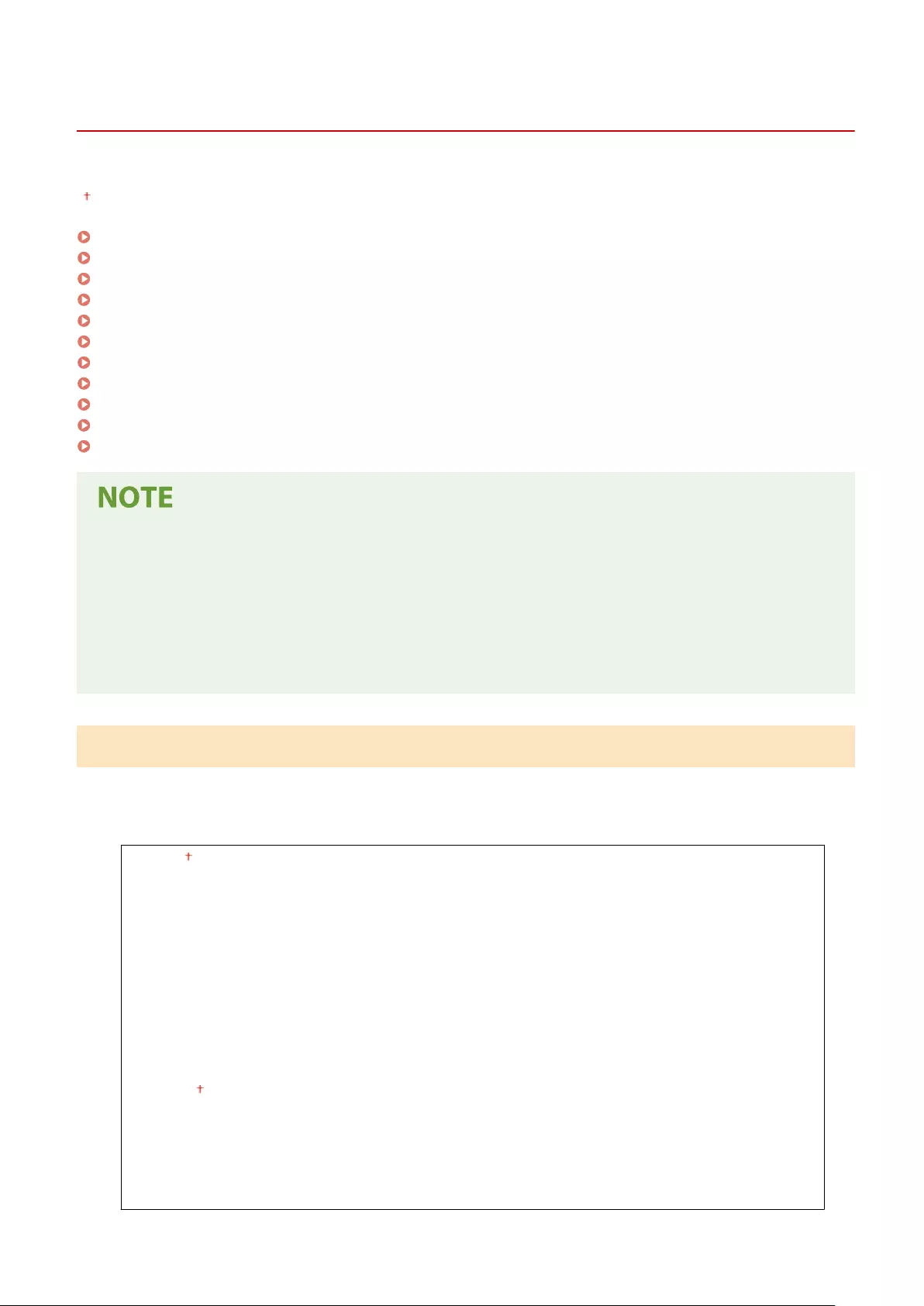
<Display Settings>
6FR5-08L
All the settings related to viewing of the display are listed with descriptions. Default settings are marked with a dagger
().
<Default Screen After Startup/Restoration>(P. 460)
<Home Screen Button Display Settings>(P. 461)
<Language>(P. 461)
<Remote UI Language>(P. 462)
<Notify to Clean Orig. Scan Area>(P. 462)
<Millimeter/Inch Entry Switch>(P. 463)
<Display Timing for Cart. Prep.>(P. 463)
<Display Notif. to Clean Fixing Assembly>(P. 463)
<Show Warnings>(P. 464)
<Action When Warning>(P. 464)
<Display IP Address>(P. 465)
Asterisks (*)
●Settings marked with "*1" may not be displayed depending on the model you are using, options, or other
setting items.
●Settings marked with "*2" cannot be imported or exported.
●Settings marked with "*3" may be unavailable or vary or have different defaults depending on your country
or region.
<Default Screen After Startup/Restoration>
By default, the Home screen is displayed immediately after the machine is turned ON or when the Auto Reset function
is performed. Specify the setting to change the default screen and display the main screen of a different function. If
you specify <Status Monitor>, also specify the screen to display after exiting the <Status Monitor> screen.
<Home>
<Copy>
<Fax> *1
<Scan>
<Secure Print>
<Status Monitor>
<Home>
<Copy>
<Fax>*1
<Scan>
<Secure Print>
Setting Menu List
460

<Menu> <Preferences> <Display Settings> <Default Screen After Startup/
Restoration> Select a function to display the desired screen
<Home Screen Button Display Settings> *2
Congure the settings for the buttons displayed in the Home screen. You can select the settings that will be displayed
as shortcut buttons, rearrange the order in which the buttons appear, and insert or remove spaces. Customizing
the Home Screen(P. 169)
<Select Button to Display>
<Favorite Copy Settings>
<Favorite Fax Settings>*1
<Favorite Scan Settings>
<Set Display Order>
<Language> *3
Select the display language used for the display, reports, and lists.
<Català>
<Čeština>
<Dansk>
<Deutsch>
<Eesti>
<English>
<Español>
<Euskara>
<Français>
<Hrvatski>
<Italiano>
<Latviešu>
<Lietuvių>
<Magyar>
<Nederlands>
<Norsk>
<Polski>
<Português>
<Română>
<Slovenčina>
<Slovenščina>
<Suomi>
<Svenska>
<Türkçe>
<Ελληνικά>
<Български>
<Русский>
<ةيبرعلا>
<日本語>
Setting Menu List
461
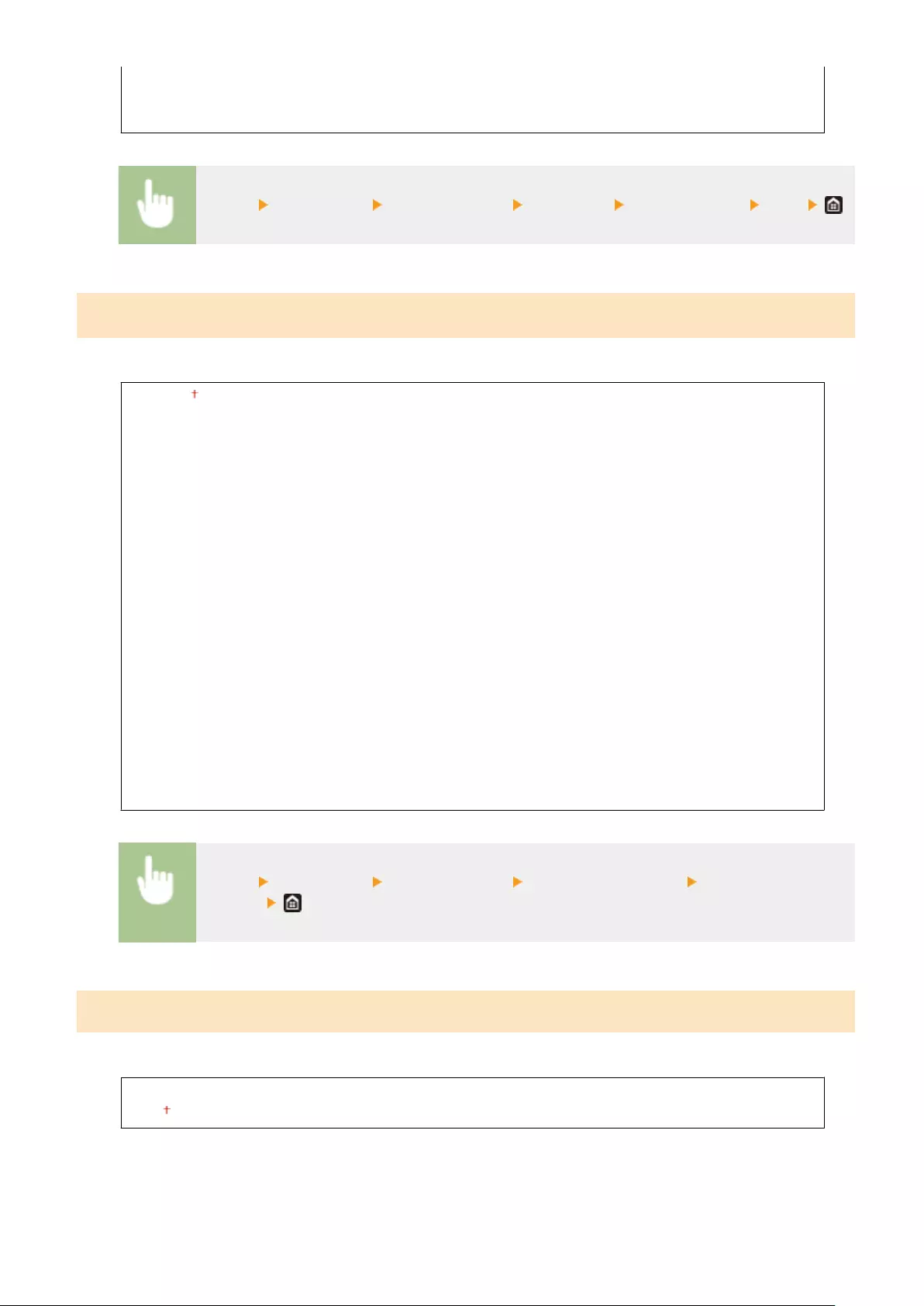
<中文(繁體)>
<中文(简体)>
<한국어>
<Menu> <Preferences> <Display Settings> <Language> Select a language <Yes>
<Remote UI Language> *3
Select the display language used for the Remote UI screens.
<English>
<Japanese>
<French>
<Spanish>
<German>
<Italian>
<Dutch>
<Finnish>
<Portuguese>
<Norwegian>
<Swedish>
<Danish>
<Czech>
<Hungarian>
<Russian>
<Turkish>
<Polish>
<Chinese (Simplied)>
<Chinese (Traditional)>
<Korean>
<Menu> <Preferences> <Display Settings> <Remote UI Language> Select a
language
<Notify to Clean Orig. Scan Area>
Specify whether to display a message when stains are detected in the document feed scanning area.
<Off>
<On>
Setting Menu List
462
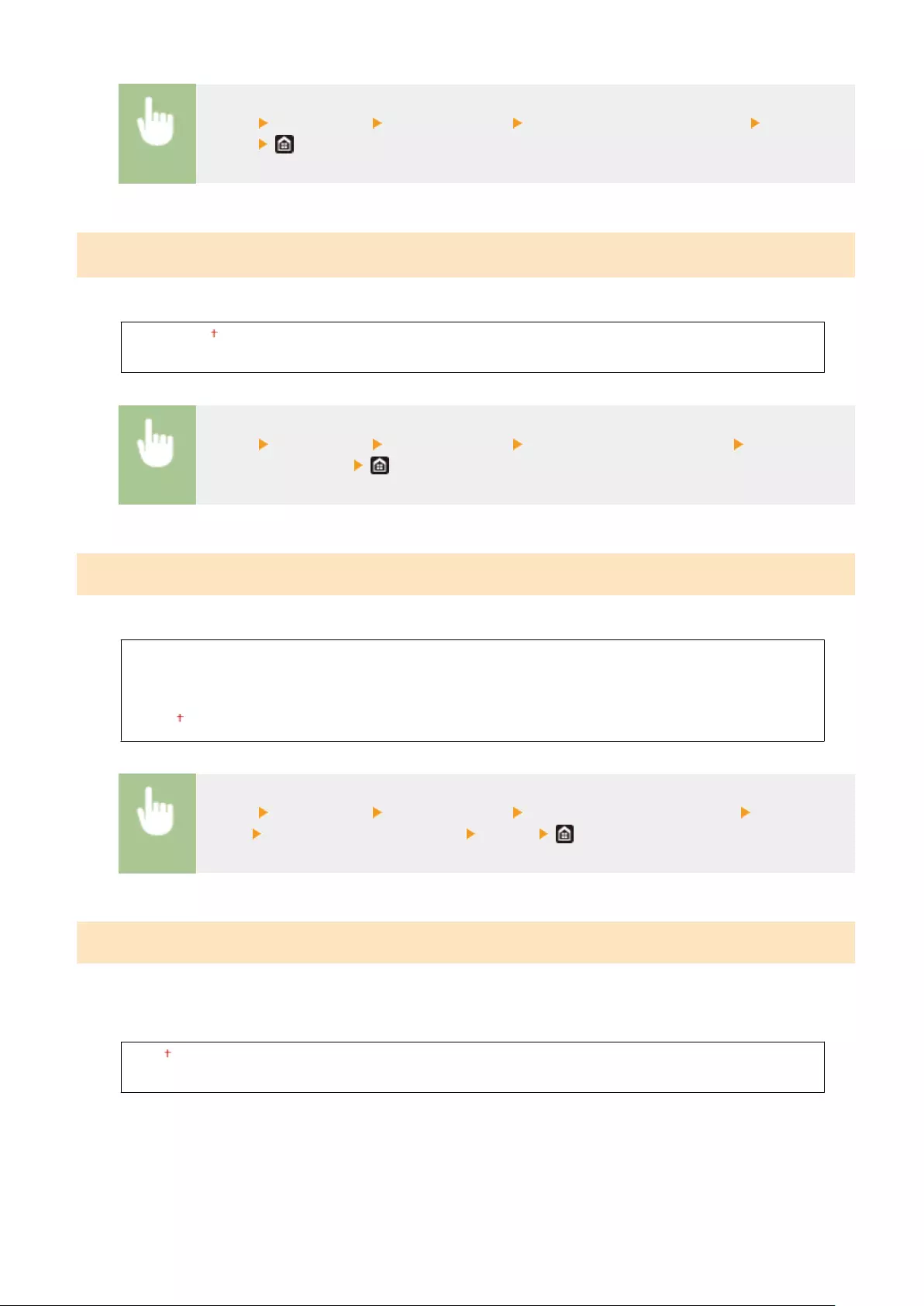
<Menu> <Preferences> <Display Settings> <Notify to Clean Orig. Scan Area> Select <Off>
or <On>
<Millimeter/Inch Entry Switch>
Select the unit of measurement.
<Millimeter>
<Inch>
<Menu> <Preferences> <Display Settings> <Millimeter/Inch Entry Switch> Select
<Millimeter> or <Inch>
<Display Timing for Cart. Prep.>
Set the display timing for the message notifying you that the amount remaining in the toner cartridges is low.
<Auto>
<Off>
<Custom>
<On>
<Menu> <Preferences> <Display Settings> <Display Timing for Cart. Prep.> Select <Off> in
<Auto> Enter toner level in <Custom> <Apply>
<Display Notif. to Clean Fixing Assembly>
Select whether to display a message that prompts you to clean the xing unit. If you set to <On>, you can specify the
timing to display a prompt message for cleaning the xing unit, in terms of the number of printed pages and in units
of 1,000.
<Off>
<On>
Setting Menu List
463
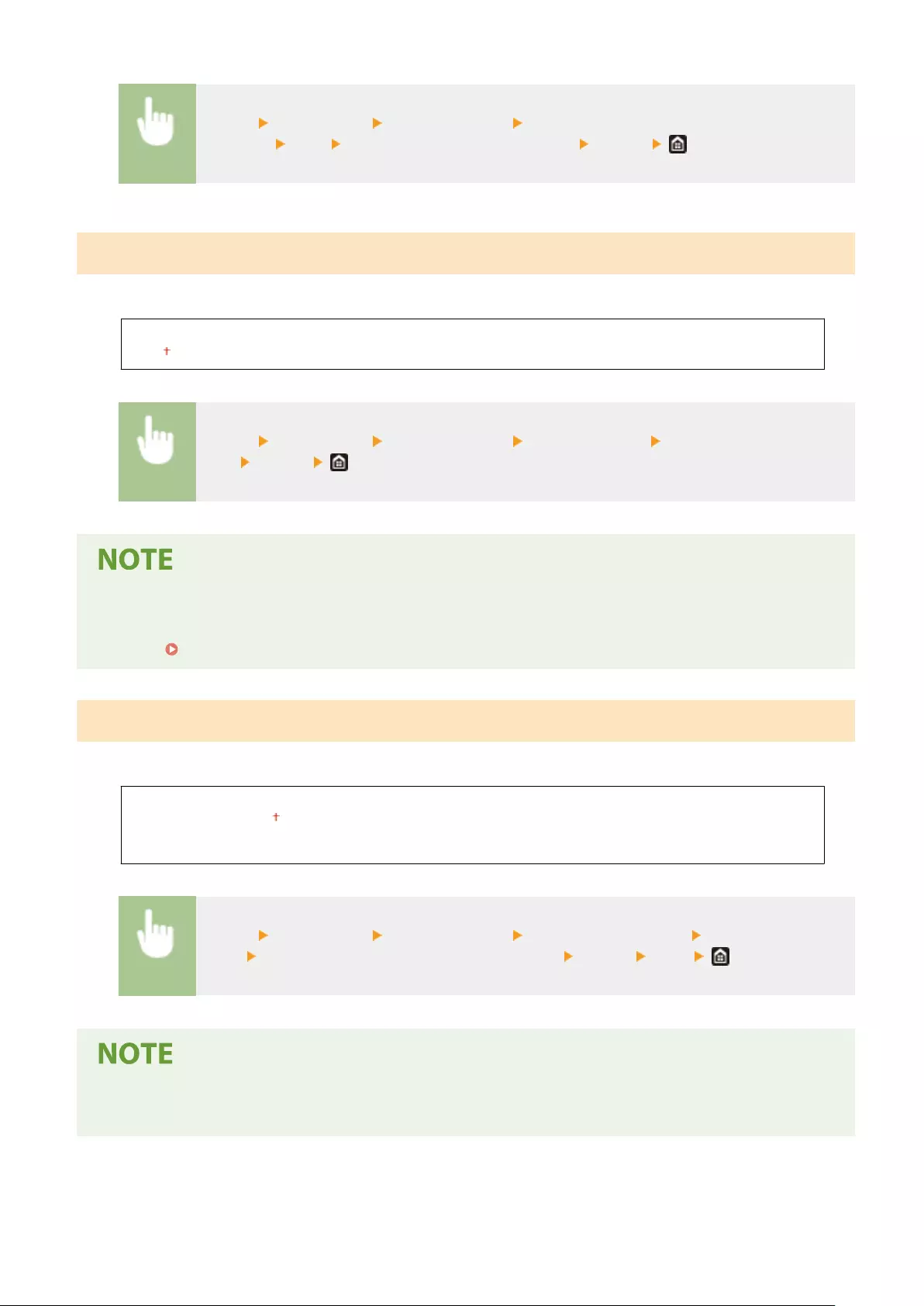
<Menu> <Preferences> <Display Settings> <Display Notif. to Clean Fixing
Assembly> <On> Enter the number of printed pages <Apply>
<Show Warnings>
Specify whether to display a message telling that the amount remaining in the toner cartridges is low.
<Off>
<On>
<Menu> <Preferences> <Display Settings> <Show Warnings> Select <Off> or
<On> <Apply>
●When <Action When Warning> is set to <Stop Printing>, you cannot set this item to <Off>.
●When <Continue Print. When Cart. Low> is set to <Off>, the message will appear even if you set this item to
<Off>. <Continue Print. When Cart. Low>(P. 548)
<Action When Warning>
Specify whether to continue printing when the amount remaining in the toner cartridges is low.
<Low Cartridge Level>
<Continue Printing>
<Stop Printing>
<Menu> <Preferences> <Display Settings> <Action When Warning> <Low Cartridge
Level> Select <Continue Printing> or <Stop Printing> <Apply> <Yes>
●If you change the setting of this item from <Continue Printing> to <Stop Printing>, <Show Warnings> is set
to <On>.
Setting Menu List
464

<English Keyboard Layout>
6FR5-08R
Specify the layout of an USB keyboard if connected to the machine. The default setting is marked with a dagger ( ).
<USA Layout>
<UK Layout>
<Menu> <Preferences> <English Keyboard Layout> Select <USA Layout> or <UK Layout>
Setting Menu List
466
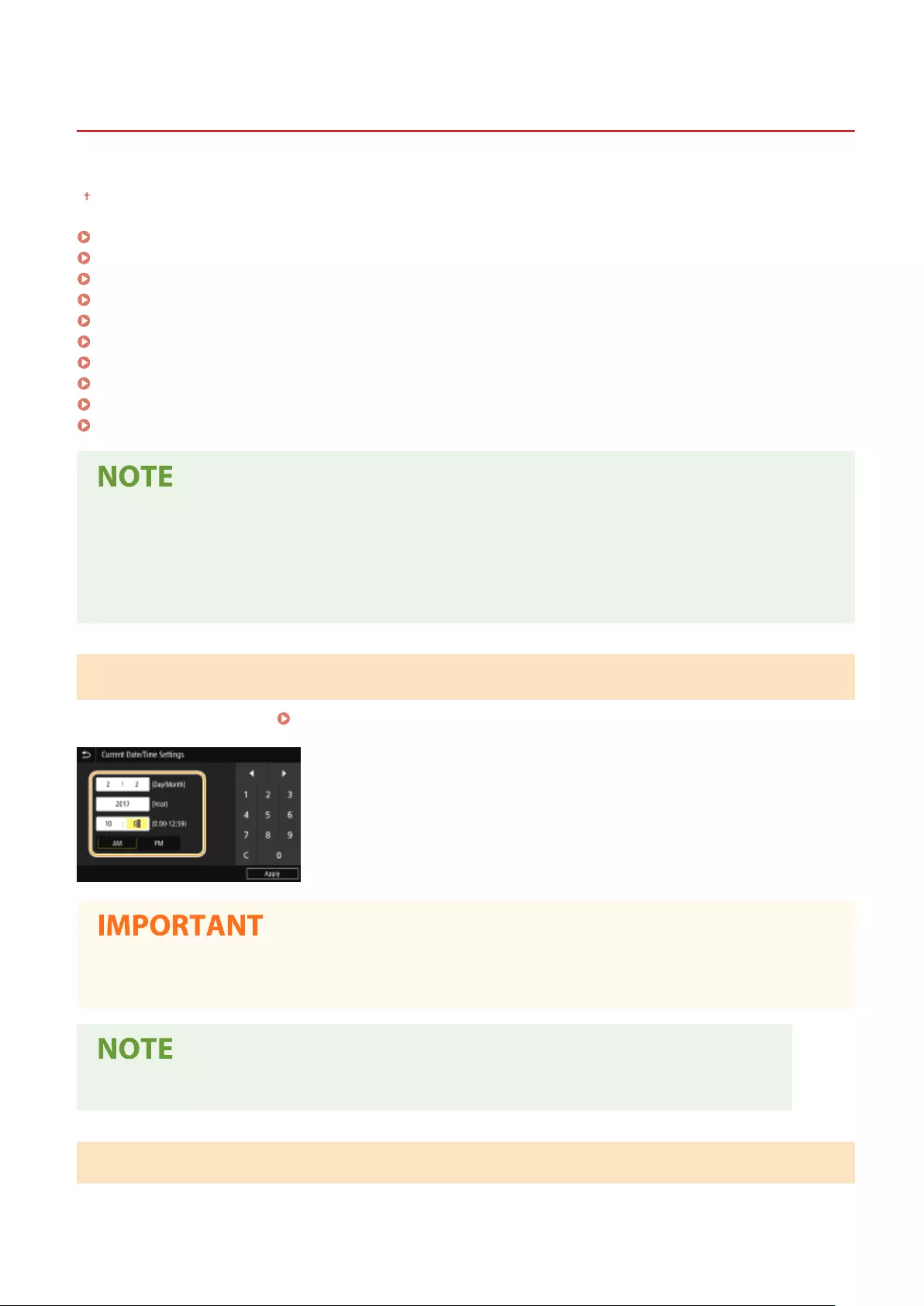
<Timer/Energy Settings>
6FR5-08S
All the settings related to the timer and energy are listed with descriptions. Default settings are marked with a dagger
().
<Current Date/Time Settings>(P. 467)
<Date/Time Settings>(P. 467)
<Date Format>(P. 468)
<Time Format>(P. 468)
<Auto Reset Time>(P. 469)
<Function After Auto Reset>(P. 469)
<Auto Shutdown Time>(P. 470)
<Auto Sleep Time>(P. 470)
<Auto Sleep Daily Timer>(P. 471)
<Sleep Mode Exit Time Settings>(P. 471)
Asterisks (*)
●Settings marked with "*1" cannot be imported or exported.
●Settings marked with "*2" may be unavailable or vary or have different defaults depending on your country
or region.
<Current Date/Time Settings> *1
Set the current date and time. Setting the Date/Time(P. 12)
●Set <Time Zone> before setting the current date and time. If the <Time Zone> setting is changed, the current
date and time are also changed accordingly.
●The current date and time cannot be changed for 1 hour after daylight saving time goes into effect.
<Date/Time Settings>
Specify the date and time standard of the region in which the machine is to be installed.
Setting Menu List
467
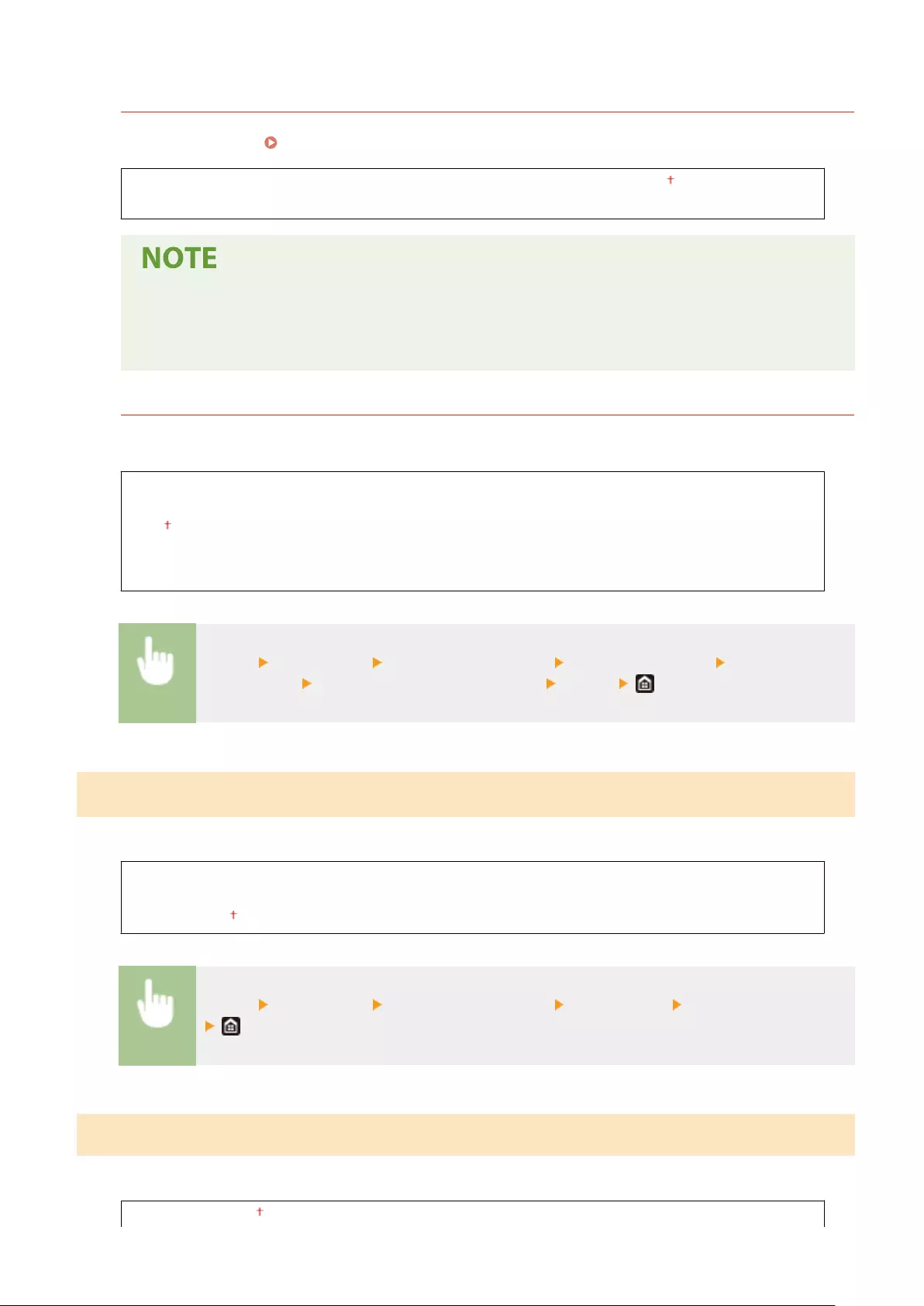
<Time Zone>
Select the time zone. If the time zone setting is changed, the values set in <Current Date/Time Settings> are also
changed accordingly. Setting the Date/Time(P. 12)
<(UTC-12:00) International Date Line West> to <(UTC) Coordinated Universal Time> to <(UTC+14:00)
Kiritimati Island>
UTC
●Coordinated Universal Time (UTC) is the primary time standard by which the world regulates clocks
and time. The correct UTC time zone setting is required for Internet communications.
<Daylight Saving Time Settings> *2
Enable or disable daylight saving time. If daylight saving time is enabled, specify the dates from which and to
which daylight saving time is in effect.
<Off>
<On>
Start: Month, Week, Day
End: Month, Week, Day
<Menu> <Preferences> <Timer/Energy Settings> <Date/Time Settings> <Daylight Saving
Time Settings> Select <On>, and specify the dates <Apply>
<Date Format> *2
Select the date format (order of year, month, and day).
<YYYY MM/DD>
<MM/DD/YYYY>
<DD/MM YYYY>
<Menu> <Preferences> <Timer/Energy Settings> <Date Format> Select the date format
<Time Format>
Select the 12- or 24-hour clock display setting.
<12 Hour (AM/PM)>
Setting Menu List
468
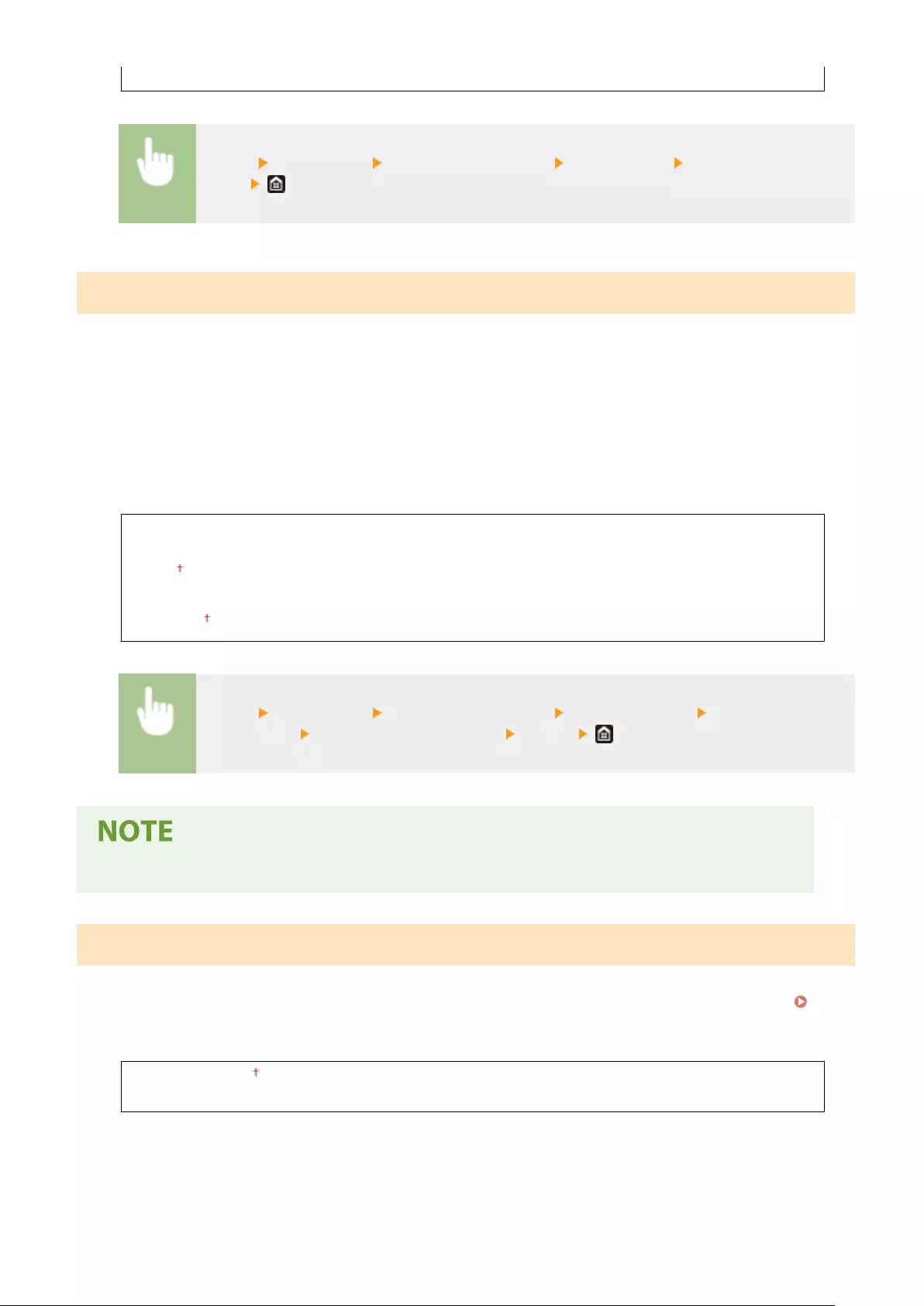
<24 Hour>
<Menu> <Preferences> <Timer/Energy Settings> <Time Format> Select the display
setting
<Auto Reset Time>
If a key is not pressed for a specied period of time, the screen and the settings are initialized to display the
default screen (Auto Reset). Specify the interval at which the Auto Reset is performed. The Auto Reset is not
performed in the following cases:
●The setting menu is displayed.
●The machine is processing data, such as when printing documents or sending or receiving faxes.
●An error message is displayed and the Error indicator is blinking (However, Auto Reset is performed when the
error does not prevent the user from continuing to use a function.)
<Set This Function>
<Off>
<On>
<Set Time>
1 to 2 to 9 (min.)
<Menu> <Preferences> <Timer/Energy Settings> <Auto Reset Time> Select <On> in <Set
This Function> Enter the time in <Set Time> <Apply>
●The screen displayed after the Auto Reset is performed can be selected in <Function After Auto Reset>.
<Function After Auto Reset>
Select whether to return the display to the default screen after the Auto Reset is performed. If <Default Function> is
selected, the main screen of the function selected in <Default Screen After Startup/Restoration> is displayed (
<Default Screen After Startup/Restoration>(P. 460) ). If <Selected Function> is selected, the display returns to the
main screen of the function that was selected.
<Default Function>
<Selected Function>
Setting Menu List
469
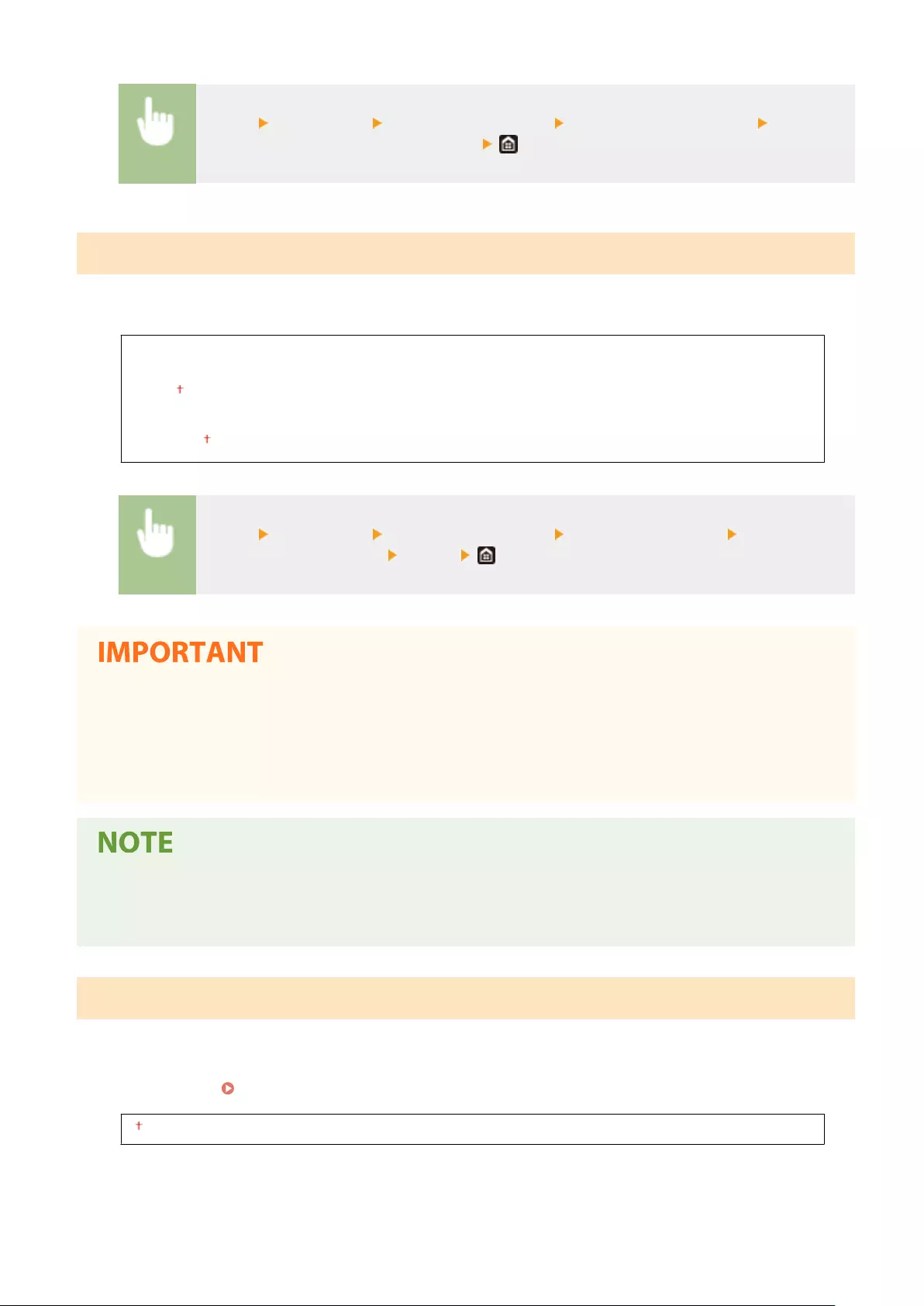
<Menu> <Preferences> <Timer/Energy Settings> <Function After Auto Reset> Select
<Default Function> or <Selected Function>
<Auto Shutdown Time>
Set a timer to automatically shut down the machine after a specied period of idle time has elapsed since the machine
entered the sleep mode.
<Set This Function>
<Off>
<On>
<Set Time>
1 to 4 to 8 (hr.)
<Menu> <Preferences> <Timer/Energy Settings> <Auto Shutdown Time> Select <On>, and
set the Auto Shutdown time <Apply>
Before setting <Auto Shutdown Time>
●When the <Auto Shutdown Time> setting is enabled, the machine may automatically shut down even if you
are operating the machine from the Remote UI or from the Send Function Setting Tool. A malfunction may
occur, particularly if the machine shuts down while data is being imported. When you import data using the
Remote UI or use the Send Function Setting Tool, set <Auto Shutdown Time> to <Off> in advance.
●If any settings of the [Timer Settings] are changed from the Remote UI while the machine is in the sleep
mode, the timer for the <Auto Shutdown Time> setting is reset to the beginning. The machine automatically
shuts down after a specied period of idle time has elapsed since the timer was reset.
<Auto Sleep Time>
If the machine has not been operated or has had no data to process for a specied period of time, the machine enters
sleep mode to save energy consumption (Auto Sleep). Specify the period of time after which auto sleep is performed.
Auto Sleep is not performed when the setting menu is displayed. We recommend using the factory default settings to
save the most power. Entering Sleep Mode(P. 178)
1 to 60 (min.)
Setting Menu List
470
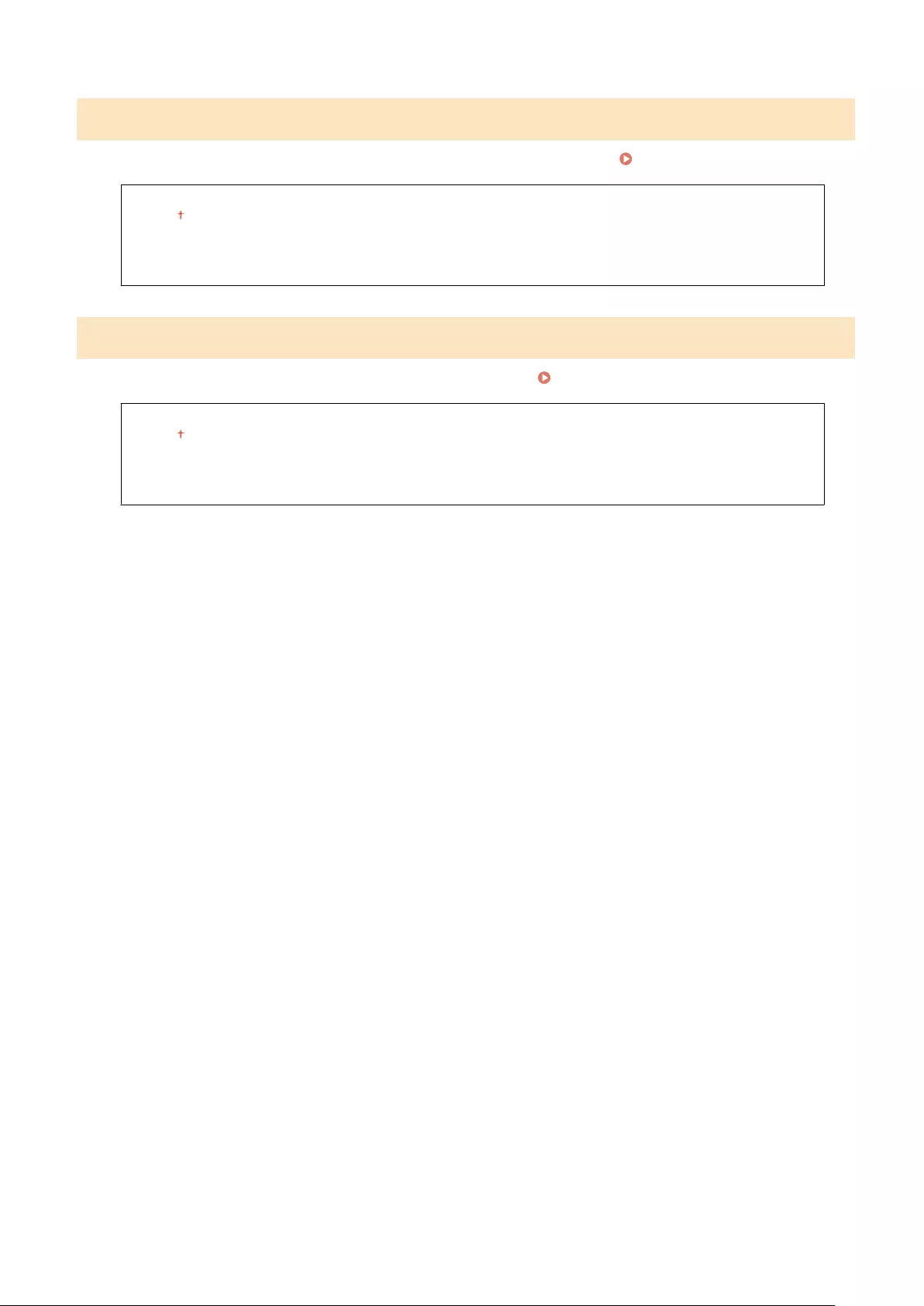
<Auto Sleep Daily Timer>
You can specify the time when the machine is automatically set to the sleep mode. Entering Sleep Mode(P. 178)
<Set This Function>
<Off>
<On>
(0:00 to 12:59 AM/PM)
<Sleep Mode Exit Time Settings>
Specify the time when the machine is recovered from the sleep mode. Entering Sleep Mode(P. 178)
<Set This Function>
<Off>
<On>
(0:00 to 12:59 AM/PM)
Setting Menu List
471
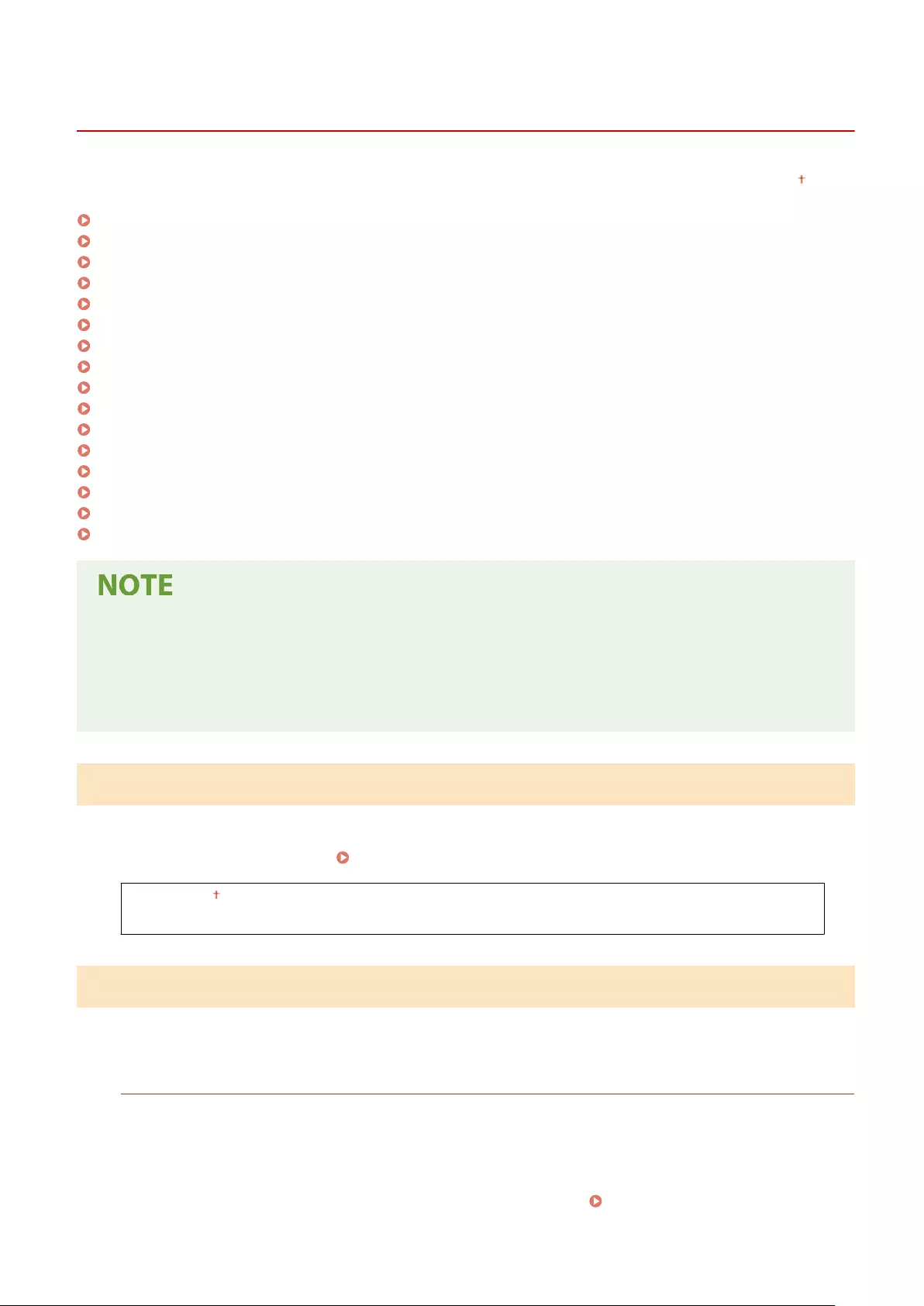
<Network>
6FR5-08U
All the settings related to the network are listed with descriptions. Default settings are marked with a dagger ( ).
<Select Wired/Wireless LAN>(P. 472)
<Wireless LAN Settings>(P. 472)
<Direct Connection Settings>(P. 473)
<Easy Connection via PC>(P. 475)
<TCP/IP Settings>(P. 475)
<SNMP Settings>(P. 481)
<Use Dedicated Port>(P. 482)
<Dedicated Port Auth. Method>(P. 483)
<Wait Time for Conn. at Startup>(P. 483)
<Ethernet Driver Settings>(P. 483)
<Use IEEE 802.1X>(P. 484)
<Firewall Settings>(P. 484)
<Google Cloud Print Settings>(P. 485)
<Device Settings Management>(P. 485)
<RMT-SW>(P. 486)
<Initialize Network Settings>(P. 486)
Asterisks (*)
●Settings marked with "*1" cannot be imported or exported.
●Settings marked with "*2" may not be displayed depending on the model you are using, options, or other
setting items.
<Select Wired/Wireless LAN>
When switching the machine from Wireless LAN to Wired LAN, you need to specify the setting. Conversely, when
switching the machine from Wired LAN to Wireless LAN, you do not need to specify this setting (You can switch using
the following <Wireless LAN Settings>). Selecting Wired LAN or Wireless LAN(P. 16)
<Wired LAN>
<Wireless LAN>
<Wireless LAN Settings>
Specify settings for connecting the machine to a wireless LAN. You can also view the current settings or specify the
setting for saving power consumption.
<SSID Settings>
Select to congure a wireless connection by specifying information including an SSID or a network key by
inputting manually from the operation panel.
<Select Access Point>
Wireless LAN routers that can access the machine are automatically located, so you can select from the list.
You must manually enter a network key, such as a WEP key or a PSK. Setting Up Connection by Selecting
a Wireless Router(P. 24)
Setting Menu List
472

<Enter Manually>
Select to congure a wireless connection by manually entering an SSID. By using this method, you can specify
authentication and encryption settings in detail. Setting Up Connection by Specifying Detailed
Settings(P. 27)
<Security Settings>
<None>
<WEP>
<Open System>
WEP Key 1 to 4
<Shared Key>
WEP Key 1 to 4
<WPA/WPA2-PSK>
<Auto>
<AES-CCMP>
<WPS Push Button Mode>
Select to automatically congure a wireless connection by using the button on a WPS wireless router. Setting
Up Connection Using WPS Push Button Mode(P. 20)
<WPS PIN Code Mode>
Select to congure a wireless connection by entering a PIN code for a WPS wireless router. Setting Up
Connection Using WPS PIN Code Mode(P. 22)
<Power Save Mode>
Select whether or not the machine enters Power Save Mode based on signals emitted from the wireless router.
<Off>
<On>
<Menu> <Preferences> <Network> <Wireless LAN Settings> Read the displayed
message <OK> <Power Save Mode> Select <Off> or <On>
<Connection Information> *1
Select to view the current wireless LAN settings. Viewing Network Settings(P. 38)
<MAC Address>
<Wireless LAN Status>
<Latest Error Information>
<Channel>
<SSID Settings>
<Security Settings>
<Power Save Mode>
<Direct Connection Settings>
Set whether to connect directly. By enabling this function, connecting directly with the machine is possible even in an
environment without an access point or wireless LAN router. Connecting Directly (Access Point Mode)(P. 336)
Setting Menu List
473
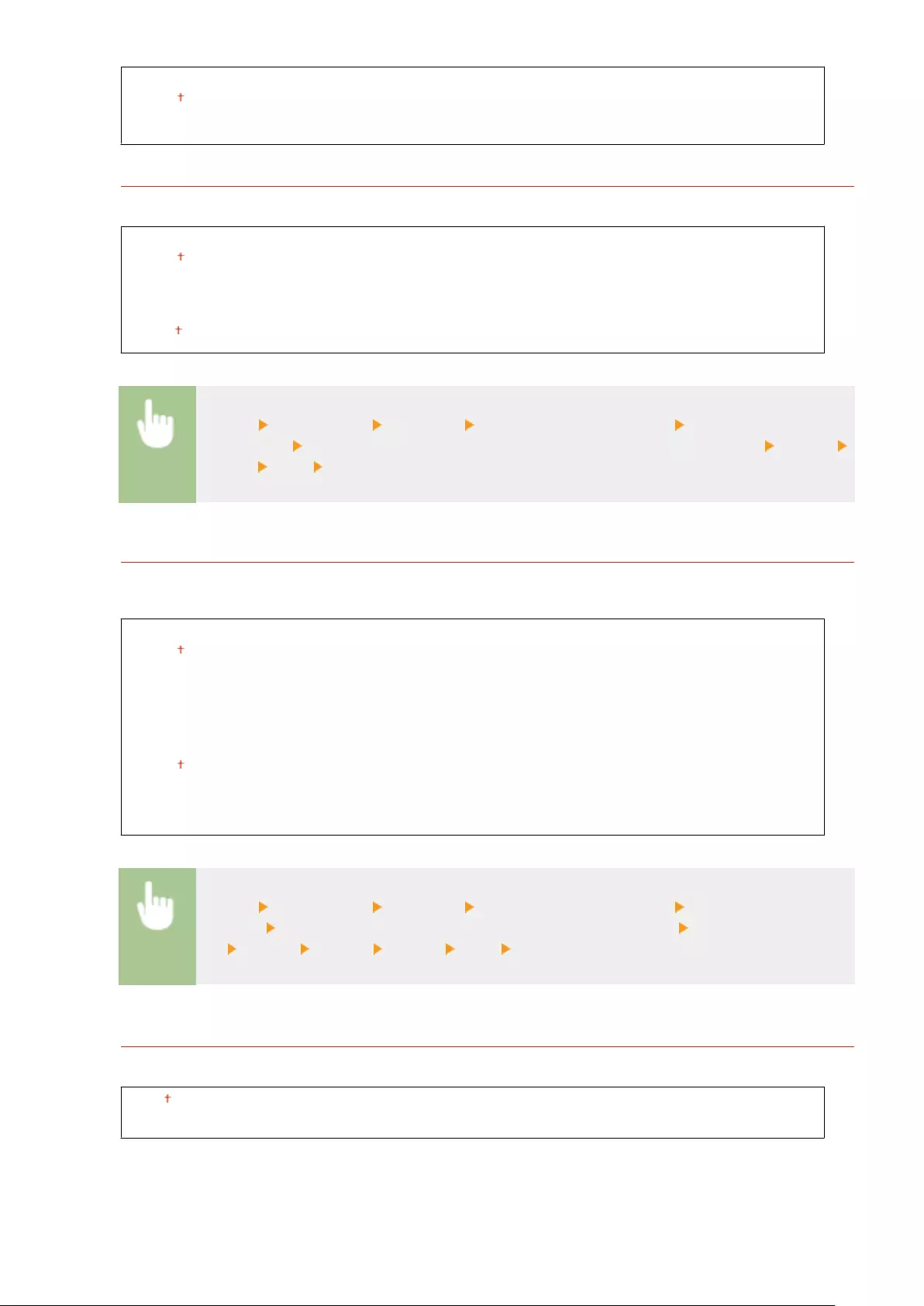
<Use Direct Connection>
<Off>
<On>
<Direct Connection Termination>
Specify the time to automatically disconnect after Direct Connection is established.
<Automatically Terminate Session>
<Off>
<On>
<Time Until Session Terminates>
1 to 60 (min.)
<Menu> <Preferences> <Network> <Direct Connection Settings> <Direct Connection
Termination> Select <On> in <Automatically Terminate Session> and enter the time <Apply>
<Apply> <OK> Restart the machine
<Access Point Mode Settings>
Congure the SSID/network key arbitrarily. If you want to connect multiple mobile devices to the machine at the
same time, you need to congure both SSID and network key arbitrarily.
<Use Custom SSID>
<Off>
<On>
<SSID>
<Use Custom Network Key>
<Off>
<On>
<Network Key>
<Menu> <Preferences> <Network> <Direct Connection Settings> <Access Point Mode
Settings> Select <On> for each item and select <SSID>/<Network Key> Enter the SSID/network
key <Apply> <Apply> <Apply> <OK> Restart the machine
<Keep Enabled If SSID/Ntwk Key Spcfd> *2
Specify whether to keep the machine waiting for Direct Connection.
<Off>
<On>
Setting Menu List
474
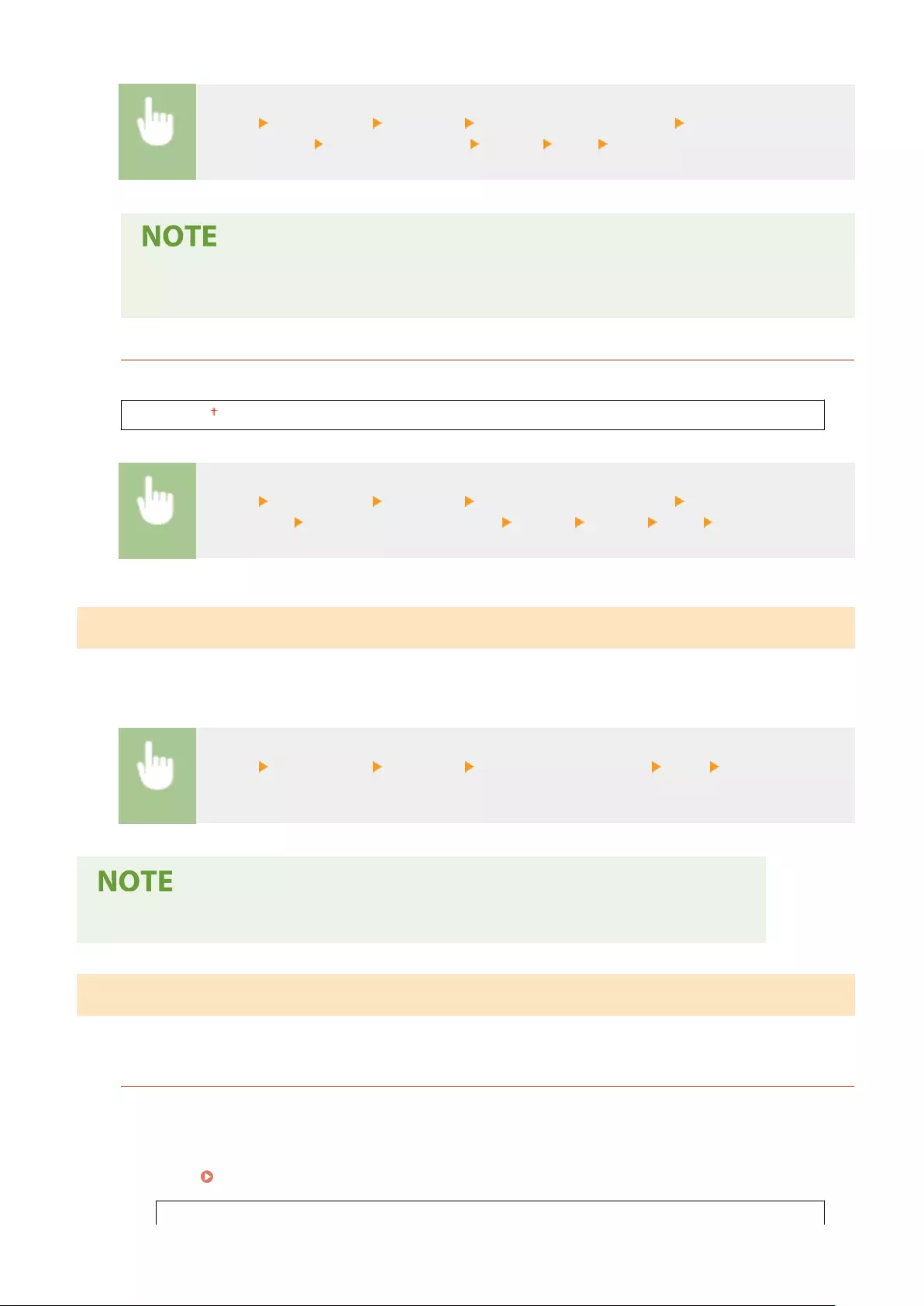
<Menu> <Preferences> <Network> <Direct Connection Settings> <Keep Enabled If SSID/
Ntwk Key Spcfd> Select <Off> or <On> <Apply> <OK> Restart the machine
●When setting this item to <On>, congure in advance a custom SSID or network key using <Access
Point Mode Settings>.
<Cong. IP Address For Direct Conn.>
Manually enter the machine's IP address at the time of Direct Connection.
192.168.22.1
<Menu> <Preferences> <Network> <Direct Connection Settings> <Cong. IP Address For
Direct Conn.> Enter an arbitrary IP address <Apply> <Apply> <OK> Restart the machine
<Easy Connection via PC>
Start the procedure for Easy Connection via PC (cableless setup mode). You can use Canon Laser NW Device Setup
Utility to congure network settings via a computer.
<Menu> <Preferences> <Network> <Easy Connection via PC> <Yes> The connection
process starts
●Download Canon Laser NW Device Setup Utility from the Canon website (https://global.canon/).
<TCP/IP Settings>
Specify settings for using the machine in a TCP/IP network, such as IP address settings.
<IPv4 Settings>
Specify settings for using the machine in an IPv4 network.
<IP Address Settings>
Congure the IP address, which is used for identifying devices, such as computers and printers, on a TCP/IP
network. Setting IPv4 Address(P. 32)
<Auto Acquire>
Setting Menu List
475
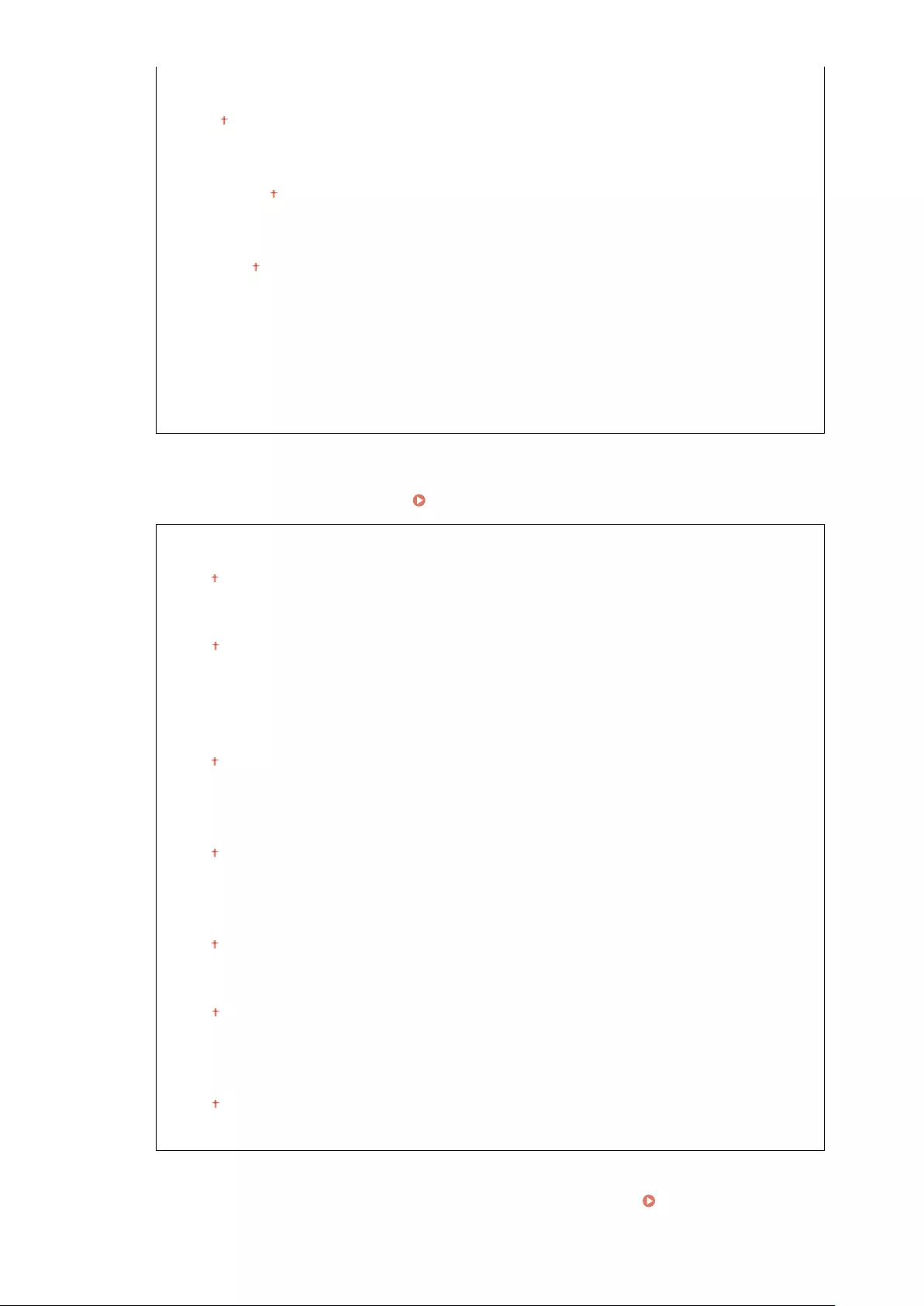
<Auto Acquire>
<Off>
<On>
<Select Protocol>
<Off>
<DHCP>
<Auto IP>
<Off>
<On>
<Manually Acquire> *2
<IP Address>: 0.0.0.0
<Subnet Mask>: 0.0.0.0
<Gateway Address>: 0.0.0.0
<Check Settings>
<DHCP Option Settings>
If DHCP is enabled, use these settings to select whether to use the DHCP optional functions to acquire the
DNS server address or the domain name. Conguring DNS(P. 56)
<Acquire Host Name>
<Off>
<On>
<DNS Dynamic Update>
<Off>
<On>
<Acquire DNS Server Address>
<Off>
<On>
<Acquire Domain Name>
<Off>
<On>
<Acquire WINS Server Address>
<Off>
<On>
<Acquire SMTP Server Address>
<Off>
<On>
<Acquire POP Server Address>
<Off>
<On>
<PING Command>
Select to check that the machine is connected to a computer over a network. Testing the Network
Connection(P. 33)
Setting Menu List
476
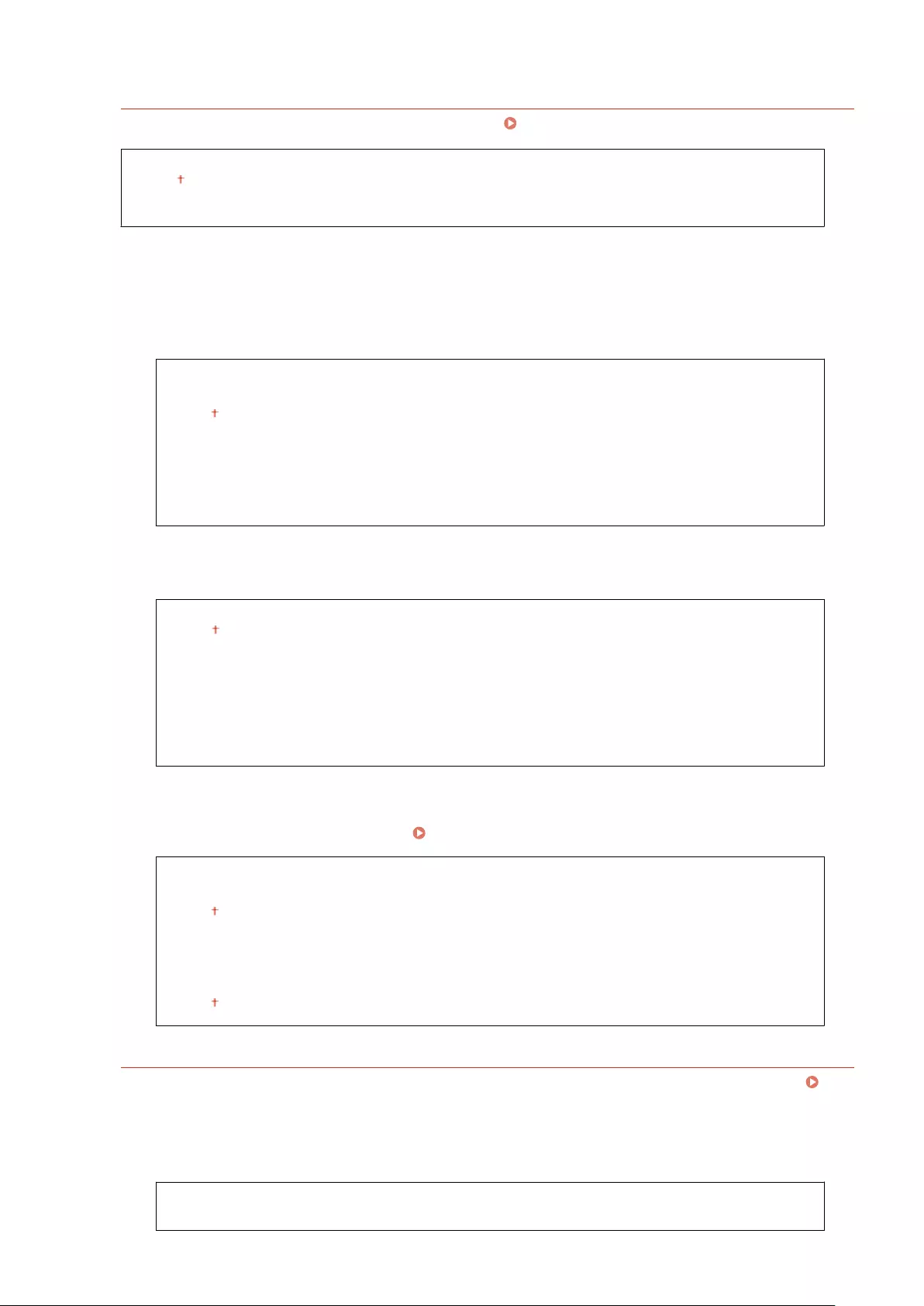
<IPv6 Settings>
Specify settings for using the machine in an IPv6 network. Setting IPv6 Addresses(P. 35)
<Use IPv6>
<Off>
<On>
<Check IPv6 Settings>
You can check the link-local address that is automatically acquired.
<Stateless Address Settings>
Enable or disable stateless addresses.
<Stateless Address Settings>
<Off>
<On>
<Check Settings>
<Stateless Address>
<Prex Length>
<DHCPv6 Settings>
Enable or disable the stateful address that is acquired via DHCPv6.
<Use DHCPv6>
<Off>
<On>
<Check Settings>
<Stateful Address>
<Prex Length>
<DHCP Option Settings>
If DHCP is enabled, use these settings to select whether to use the DHCP optional functions to acquire the
DNS server address or the domain name. Conguring DNS(P. 56)
<Acquire DNS Server Address>
<Off>
<On>
<Acquire Domain Name>
<Off>
<On>
<DNS Settings>
Specify settings for Domain Name System (DNS), which provides a host name for IP address resolutions.
Conguring DNS(P. 56)
<IPv4 DNS Server Address Settings>
Specify the IP address of the DNS server in the IPv4 environment.
<Primary DNS Server>: 0.0.0.0
<Secondary DNS Server>: 0.0.0.0
Setting Menu List
477

<DNS Host Name/Domain Name Settings>
Specify the host name of the machine to be registered in the DNS server as well as the name of the domain
to which the machine belongs.
<IPv4>
<Host Name>
<Domain Name>
<IPv6>
<Use IPv4 Host/Domain>
<Off>
<Host Name>
<Domain Name>
<On>
<DNS Dynamic Update Settings>
Select whether to dynamically update the DNS records whenever the machine's IP address is changed.
<IPv4>
<DNS Dynamic Update>
<Off>
<On>
<DNS Dynamic Update Interval>
0 to 24 to 48 (hr.)
<IPv6>
<DNS Dynamic Update>
<Off>
<On>
<Register Manual Address>
<Off>
<On>
<Register Stateful Address>
<Off>
<On>
<Register Stateless Address>
<Off>
<On>
<DNS Dynamic Update Interval>
0 to 24 to 48 (hr.)
<mDNS Settings>
Specify settings for using DNS functions without DNS servers.
<IPv4>
<Use mDNS>
<Off>
<On>
<mDNS Name>
Setting Menu List
478
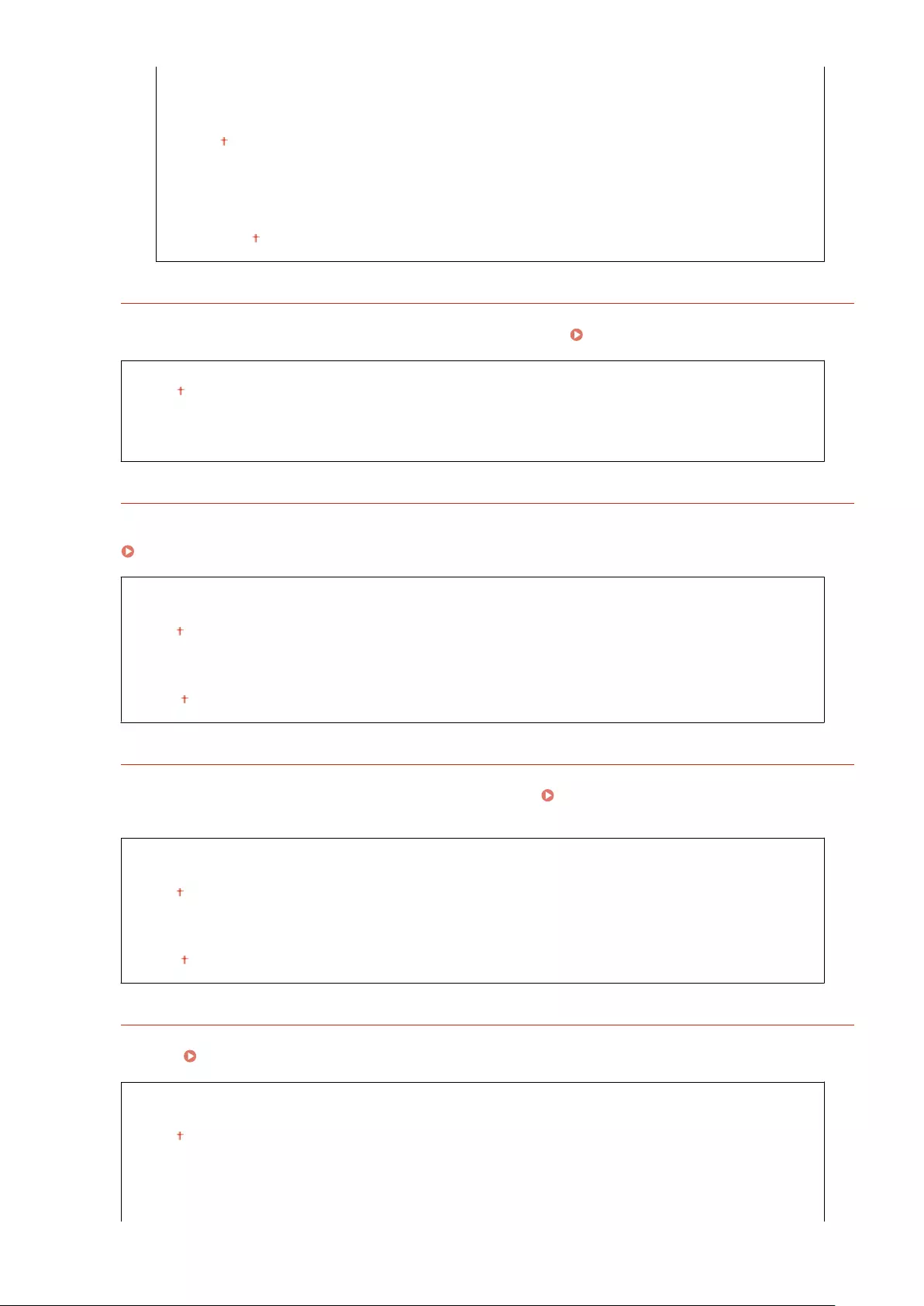
<IPv6>
<Use mDNS>
<Off>
<On>
<Use Same mDNS Name as IPv4>
<Off>
<mDNS Name>
<On>
<WINS Settings>
Specify settings for Windows Internet Name Service (WINS), which provides a NetBIOS name for IP address
resolutions in a mixed network environment of NetBIOS and TCP/IP. Conguring WINS(P. 62)
<WINS Resolution>
<Off>
<On>
<WINS Server Address>: 0.0.0.0
<LPD Settings>
Enable or disable LPD, a printing protocol that can be used on any hardware platform or operating system. You
can also set the reception timeout period after which printing is canceled if print data reception is interrupted.
Conguring Printing Protocols and WSD Functions(P. 41)
<Use LPD Printing>
<Off>
<On>
<RX Timeout>
1 to 5 to 60 (min.)
<RAW Settings>
Enable or disable RAW, a Windows specic printing protocol. You can also set the reception timeout period after
which printing is canceled if print data reception is interrupted. Conguring Printing Protocols and WSD
Functions(P. 41)
<Use RAW Printing>
<Off>
<On>
<RX Timeout>
1 to 5 to 60 (min.)
<WSD Settings>
Enable or disable automatic browsing and acquiring information for the printer or scanner by using the WSD
protocol. Conguring Printing Protocols and WSD Functions(P. 41)
<Use WSD Printing>
<Off>
<On>
<Use WSD Browsing>
<Off>
Setting Menu List
479
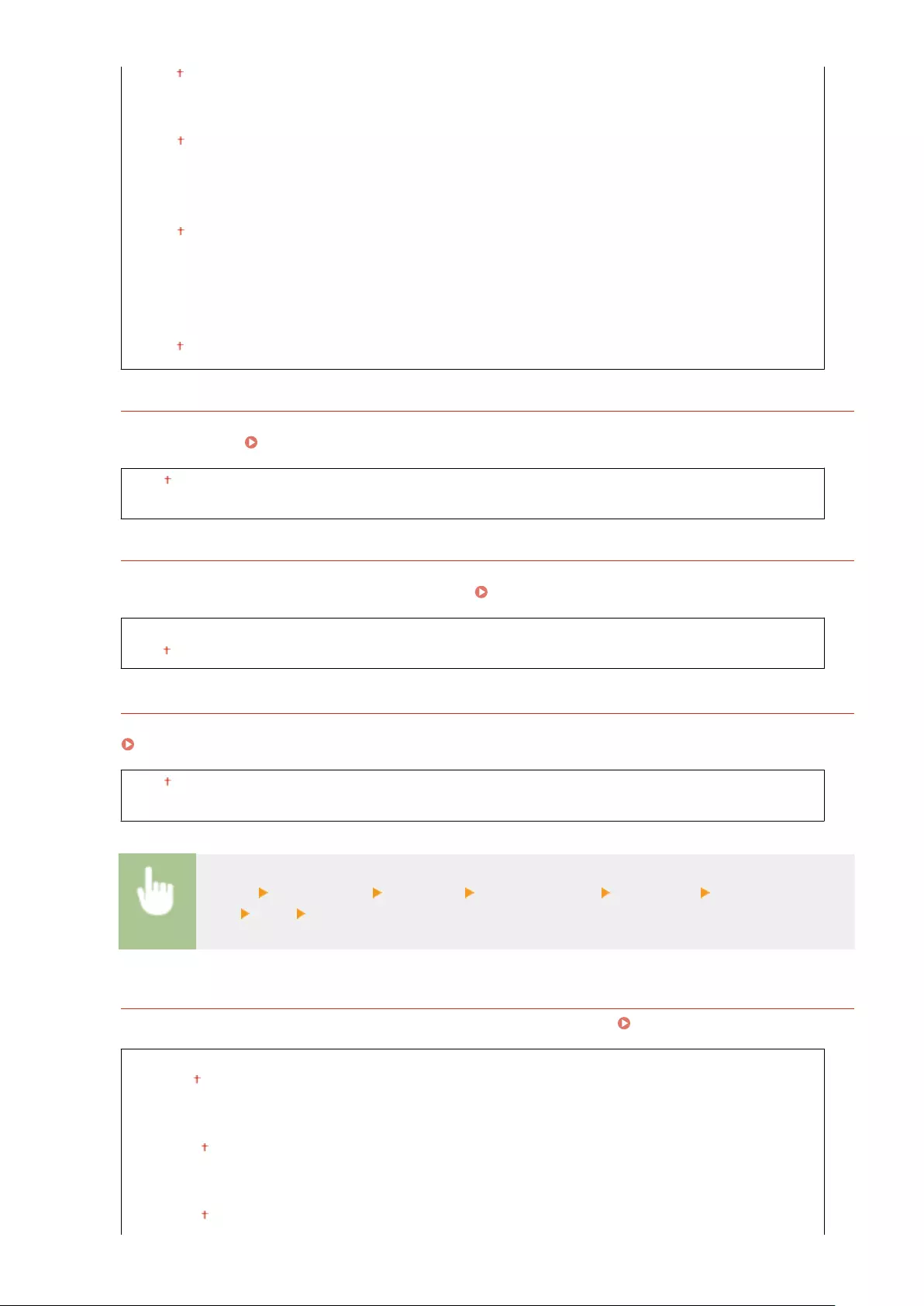
<On>
<Use WSD Scanning>
<Off>
<On>
<Use Computer Scanning>
<Off>
<On>
<Use Multicast Discovery>
<Off>
<On>
<Use FTP PASV Mode>
Specify whether to use PASV mode for FTP. If you are connecting to an FTP server through a rewall, you must
select PASV mode. Conguring FTP PASV Mode(P. 73)
<Off>
<On>
<Use HTTP>
Enable or disable HTTP, which is required for communications with a computer, such as when using the Remote
UI, WSD printing, or printing with Google Cloud Print. Disabling HTTP Communication(P. 423)
<Off>
<On>
<Use IPSec> *1
Select whether to perform encrypted communication by establishing a virtual private network (VPN) via IPSec.
Conguring IPSec Settings(P. 400)
<Off>
<On>
<Menu> <Preferences> <Network> <TCP/IP Settings> <Use IPSec> Select <Off> or
<On> <OK> Restart the machine
<Port Number Settings>
Change port numbers for protocols according to the network environment. Changing Port Numbers(P. 386)
<LPD>
1 to 515 to 65535
<RAW>
1 to 9100 to 65535
<WSD Multicast Discovery>
1 to 3702 to 65535
Setting Menu List
480
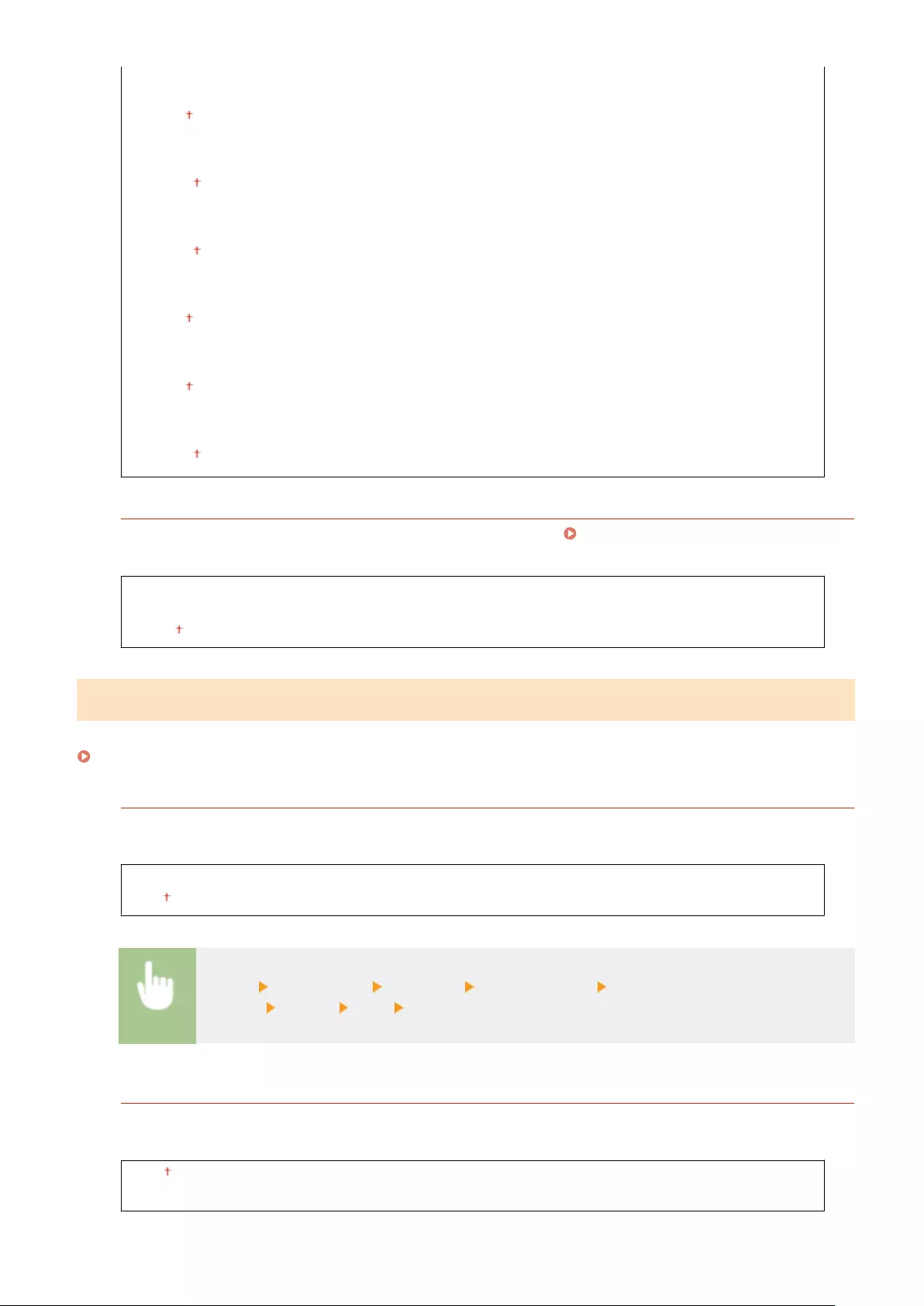
<HTTP>
1 to 80 to 65535
<Multicast Discovery>
1 to 427 to 65535
<POP3>
1 to 110 to 65535
<SMTP>
1 to 25 to 65535
<FTP>
1 to 21 to 65535
<SNMP>
1 to 161 to 65535
<MTU Size>
Select the maximum size of packets the machine sends or receives. Changing the Maximum Transmission
Unit(P. 54)
<1300>
<1400>
<1500>
<SNMP Settings>
Specify the settings for monitoring and controlling the machine from a computer running SNMP-compatible software.
Monitoring and Controlling the Machine with SNMP(P. 69)
<SNMPv1 Settings>
Enable or disable SNMPv1. When enabling SNMPv1, specify a community name and access privileges to
Management Information Base (MIB) objects.
<Off>
<On>
<Menu> <Preferences> <Network> <SNMP Settings> Select <Off> or <On> in <SNMPv1
Settings> <Apply> <OK> Restart the machine
<SNMPv3 Settings>
Enable or disable SNMPv3. Use the Remote UI to specify detailed settings that are applied when SNMPv3 is
enabled.
<Off>
<On>
Setting Menu List
481
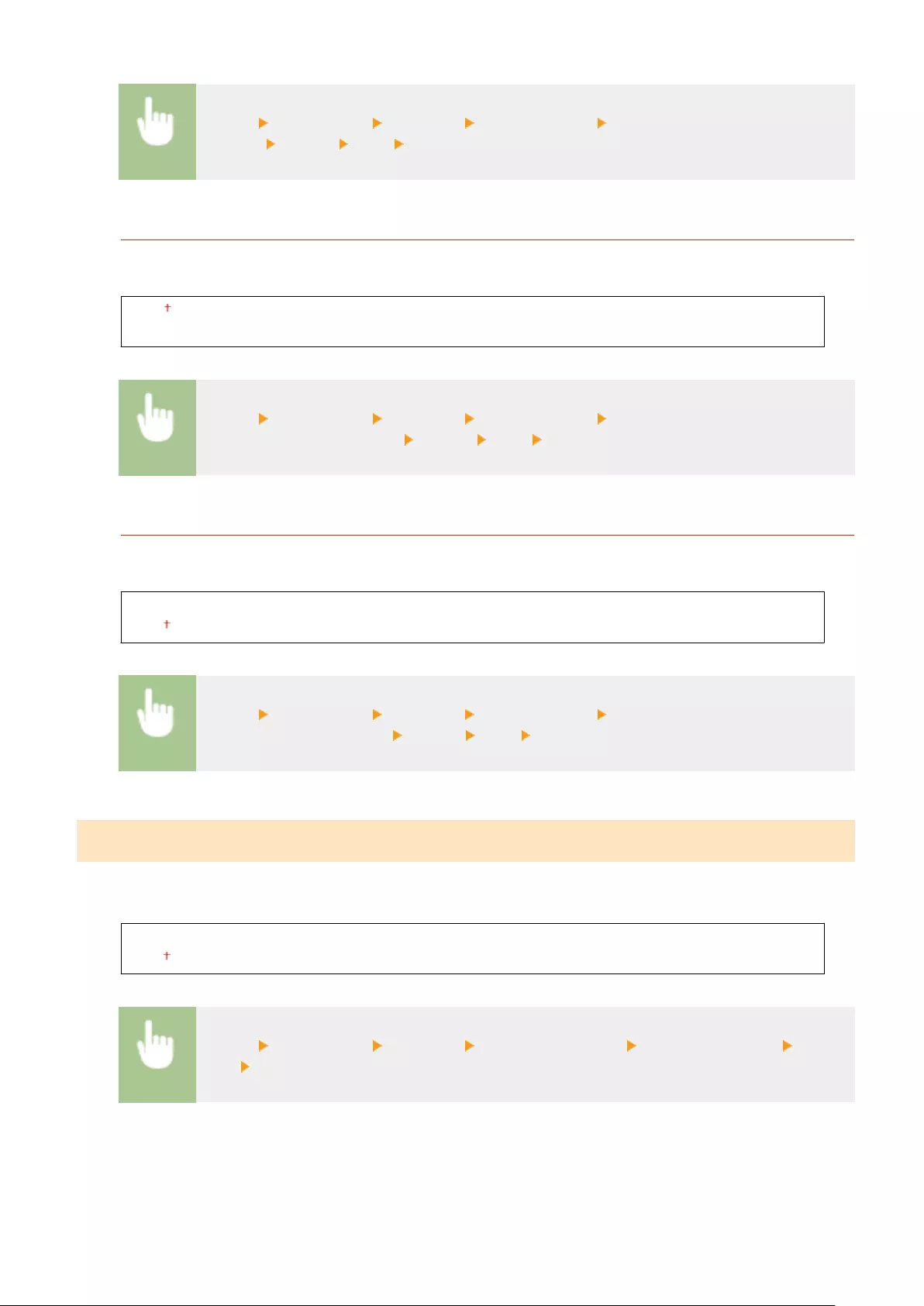
<Menu> <Preferences> <Network> <SNMP Settings> Select <Off> or <On> in <SNMPv3
Settings> <Apply> <OK> Restart the machine
<Acquire Printer Mngt. Info. from Host>
Enable or disable the monitoring of printer management information from a networked computer running
SNMP-compatible software.
<Off>
<On>
<Menu> <Preferences> <Network> <SNMP Settings> Select <Off> or <On> in <Acquire
Printer Mngt. Info. from Host> <Apply> <OK> Restart the machine
<Format Host Rsrcs. MIB to RFC2790>
Specify whether to conform to the advanced specications (RFC2790) of the protocol when monitoring the
machine status from the SNMP-compatible software.
<Off>
<On>
<Menu> <Preferences> <Network> <SNMP Settings> Select <Off> or <On> in <Format
Host Rsrcs. MIB to RFC2790> <Apply> <OK> Restart the machine
<Use Dedicated Port>
Enable or disable the dedicated port. The dedicated port is used when printing, faxing, or scanning uses MF Scan
Utility and when browsing or specifying the machine settings over the network.
<Off>
<On>
<Menu> <Preferences> <Network> <Use Dedicated Port> Select <Off> or <On>
<OK> Restart the machine
Setting Menu List
482
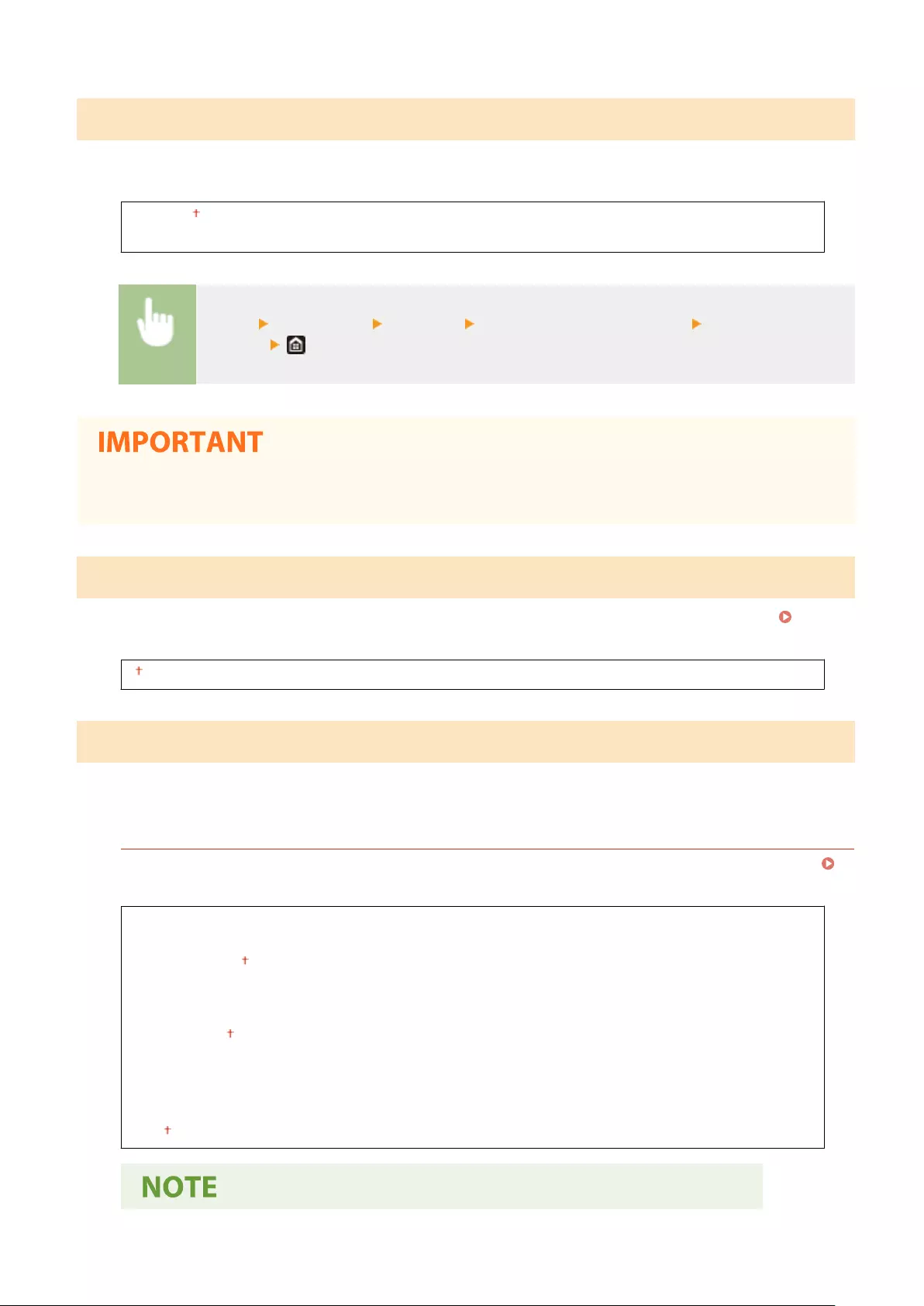
<Dedicated Port Auth. Method>
Specify whether to limit the authentication method specically to the secure one when using the dedicated port. If
<Mode 2> is selected, the authentication method is limited specically to the secure one.
<Mode 1>
<Mode 2>
<Menu> <Preferences> <Network> <Dedicated Port Auth. Method> Select <Mode 1> or
<Mode 2>
●If <Mode 2> is selected, you cannot establish a connection from the device management software or driver
in some cases.
<Wait Time for Conn. at Startup>
Specify a wait time for connecting to a network. Select the setting depending on the network environment. Setting a
Wait Time for Connecting to a Network(P. 55)
0 to 300 (sec.)
<Ethernet Driver Settings>
Select the Ethernet type (10BASE-T/100BASE-TX/1000BASE-T) and the communication mode of Ethernet (half-duplex/
full-duplex). You can also view the MAC address for wired LAN.
<Auto Detect>
Select whether to automatically detect or manually select the communication mode and the Ethernet type.
Conguring Ethernet Settings(P. 52)
<Off>
<Communication Mode>
<Half Duplex>
<Full Duplex>
<Ethernet Type>
<10BASE-T>
<100BASE-TX>
<1000BASE-T>
<On>
Setting Menu List
483
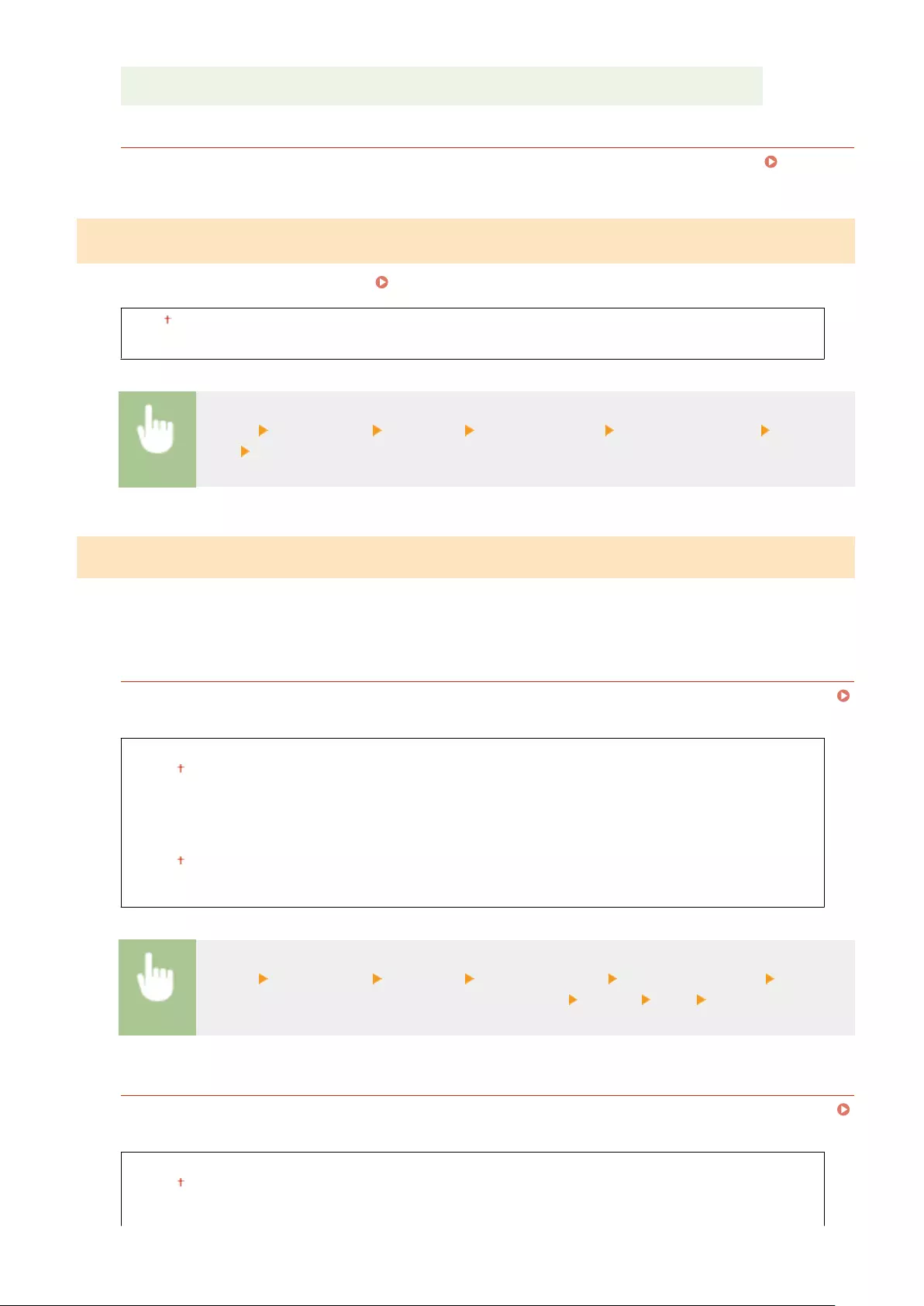
●When <Communication Mode> is set to <Half Duplex>, you cannot select <1000BASE-T>.
<MAC Address>
Check the MAC address of the machine, which is a number unique to each communication device. Viewing
the MAC Address for Wired LAN(P. 38)
<Use IEEE 802.1X> *1*2
Enable or disable IEEE 802.1X authentication. Conguring IEEE 802.1X Authentication Settings(P. 407)
<Off>
<On>
<Menu> <Preferences> <Network> <Use IEEE 802.1X> Select <Off> or <On>
<OK> Restart the machine
<Firewall Settings>
Without proper security, unauthorized third parties can access computers and other communication devices that are
connected to a network. To prevent this unauthorized access, specify the settings for packet lter, a feature that
restricts communication to devices with specied IP addresses or MAC addresses.
<IPv4 Address Filter>
Enable or disable settings for ltering packets sent to or received from devices with specied IPv4 addresses.
Specifying IP Addresses for Firewall Settings(P. 380)
<Outbound Filter>
<Off>
<On>
<Inbound Filter>
<Off>
<On>
<Menu> <Preferences> <Network> <Firewall Settings> <IPv4 Address Filter> Select
<Off> or <On> in <Outbound Filter> or <Inbound Filter> <Apply> <OK> Restart the machine
<IPv6 Address Filter>
Enable or disable settings for ltering packets sent to or received from devices with specied IPv6 addresses.
Specifying IP Addresses for Firewall Settings(P. 380)
<Outbound Filter>
<Off>
<On>
Setting Menu List
484
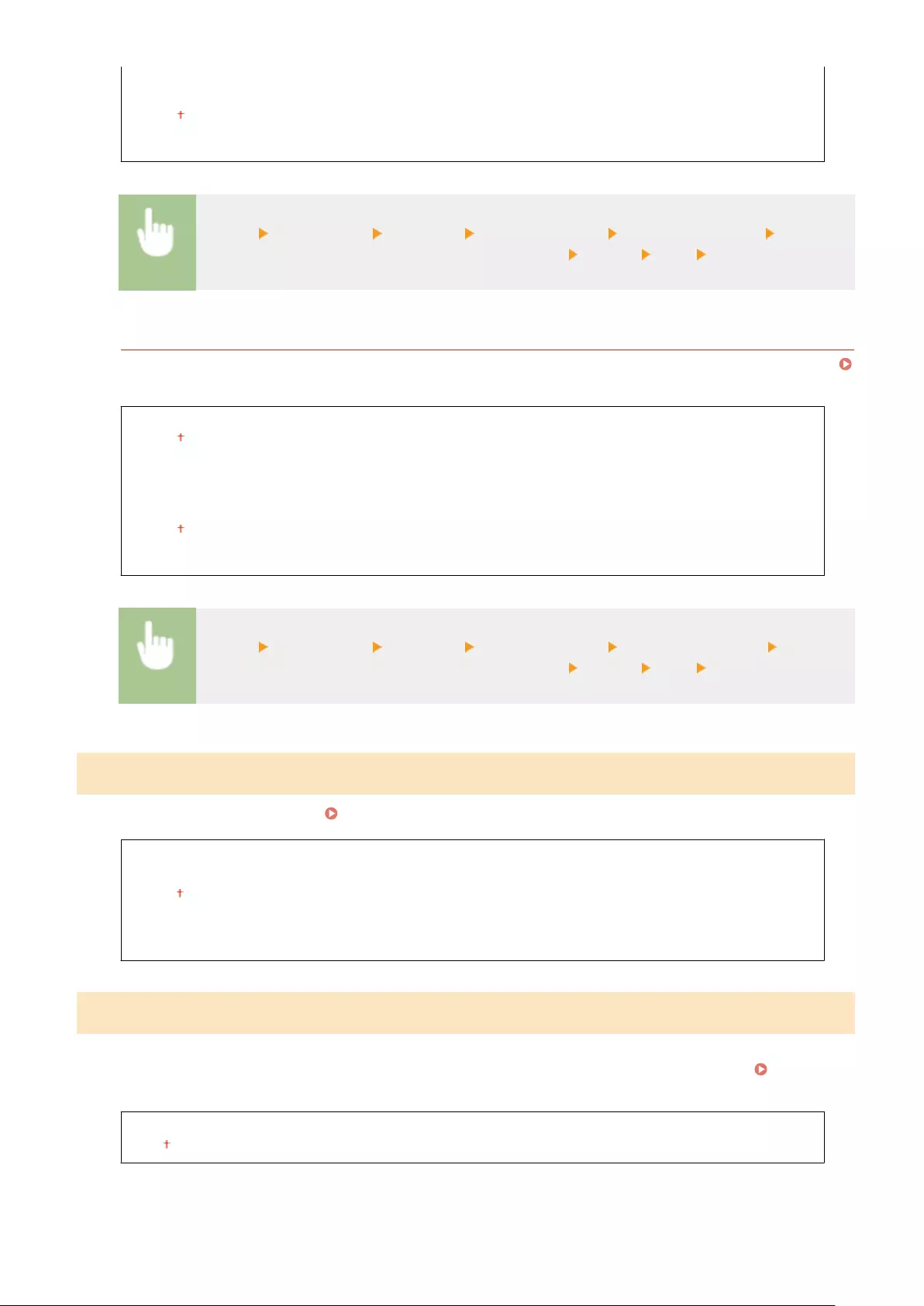
<Inbound Filter>
<Off>
<On>
<Menu> <Preferences> <Network> <Firewall Settings> <IPv6 Address Filter> Select
<Off> or <On> in <Outbound Filter> or <Inbound Filter> <Apply> <OK> Restart the machine
<MAC Address Filter>
Enable or disable settings for ltering packets sent to or received from devices with specied MAC addresses.
Specifying MAC Addresses for Firewall Settings(P. 383)
<Outbound Filter>
<Off>
<On>
<Inbound Filter>
<Off>
<On>
<Menu> <Preferences> <Network> <Firewall Settings> <MAC Address Filter> Select
<Off> or <On> in <Outbound Filter> or <Inbound Filter> <Apply> <OK> Restart the machine
<Google Cloud Print Settings>
Enable or disable Google Cloud Print. Registering the Machine with Google Cloud Print(P. 354)
<Use Google Cloud Print>
<Off>
<On>
<Google Cloud Print Regist. Status> *1
<Device Settings Management>
Specify whether to use iW Management Console plug-ins to manage machine data such as settings and Address Book
destinations. For detailed information on iW Management Console, contact your nearest Canon dealer. Conguring
Settings for Communication between the Machine and Plug-ins(P. 76)
<Off>
<On>
Setting Menu List
485

<RMT-SW>
Leave this switch set to <Off>. When the service representative remotely performs device maintenance, you may be
asked to set the switch to <On>.
<Off>
<On>
<Menu> <Preferences> <Network> <RMT-SW> Select <Off> or <On> <OK> Restart the
machine
<Initialize Network Settings>
Select to return the Network Settings to the factory defaults. <Initialize Menu>(P. 570)
Setting Menu List
486
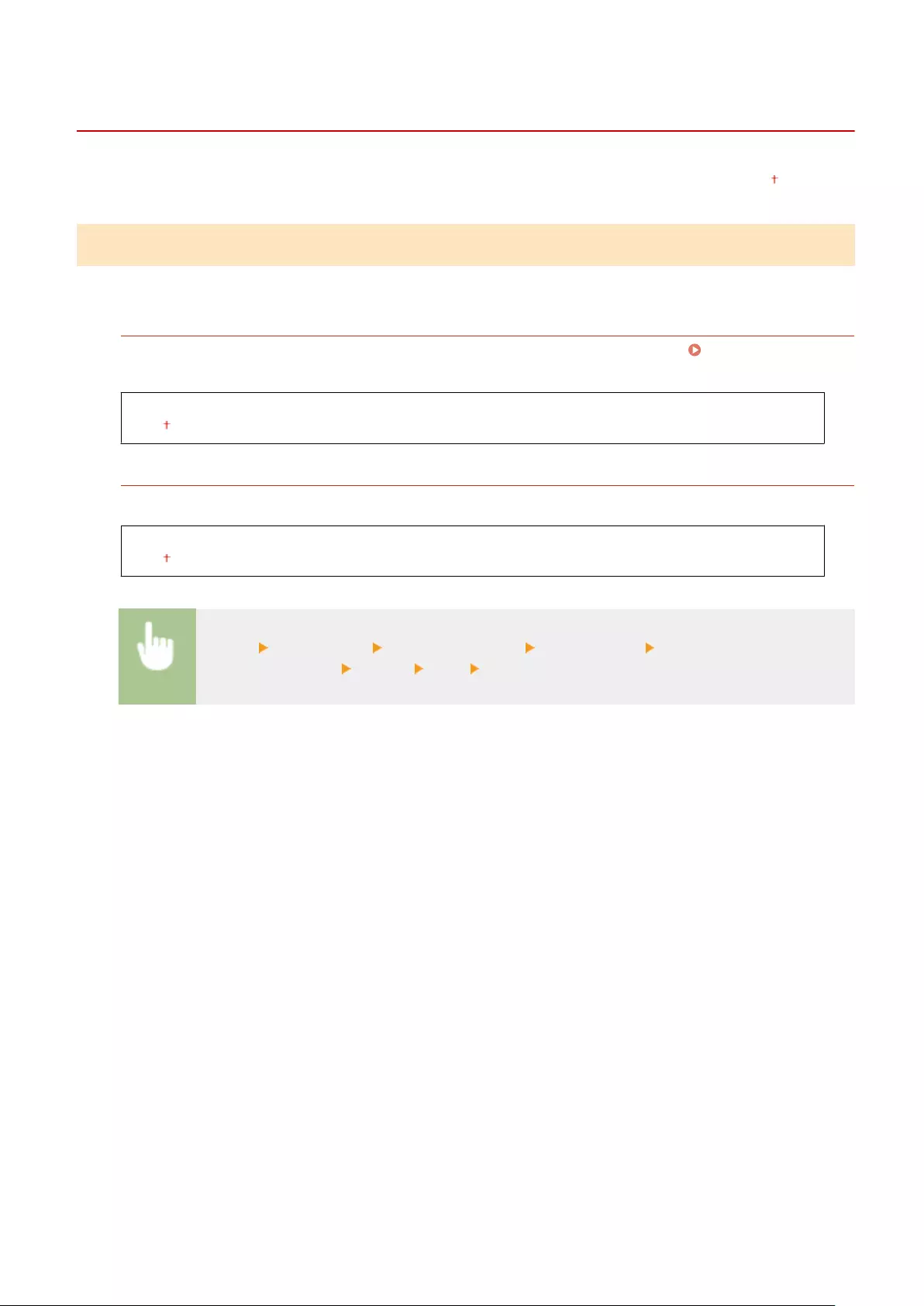
<External Interface>
6FR5-08W
All the settings related to the USB are listed with descriptions. Default settings are marked with a dagger ( ).
<USB Settings>
Specify whether to enable or disable use of the USB port or a USB memory device.
<Use as USB Device>
Enable or disable the USB port that is used for connecting the machine to a computer. Restricting the USB
Connection with a Computer(P. 421)
<Off>
<On>
<Use USB Storage Device>
Specify whether to use a USB memory device.
<Off>
<On>
<Menu> <Preferences> <External Interface> <USB Settings> Select <Off> or <On> in <Use
USB Storage Device> <Apply> <OK> Restart the machine
Setting Menu List
487
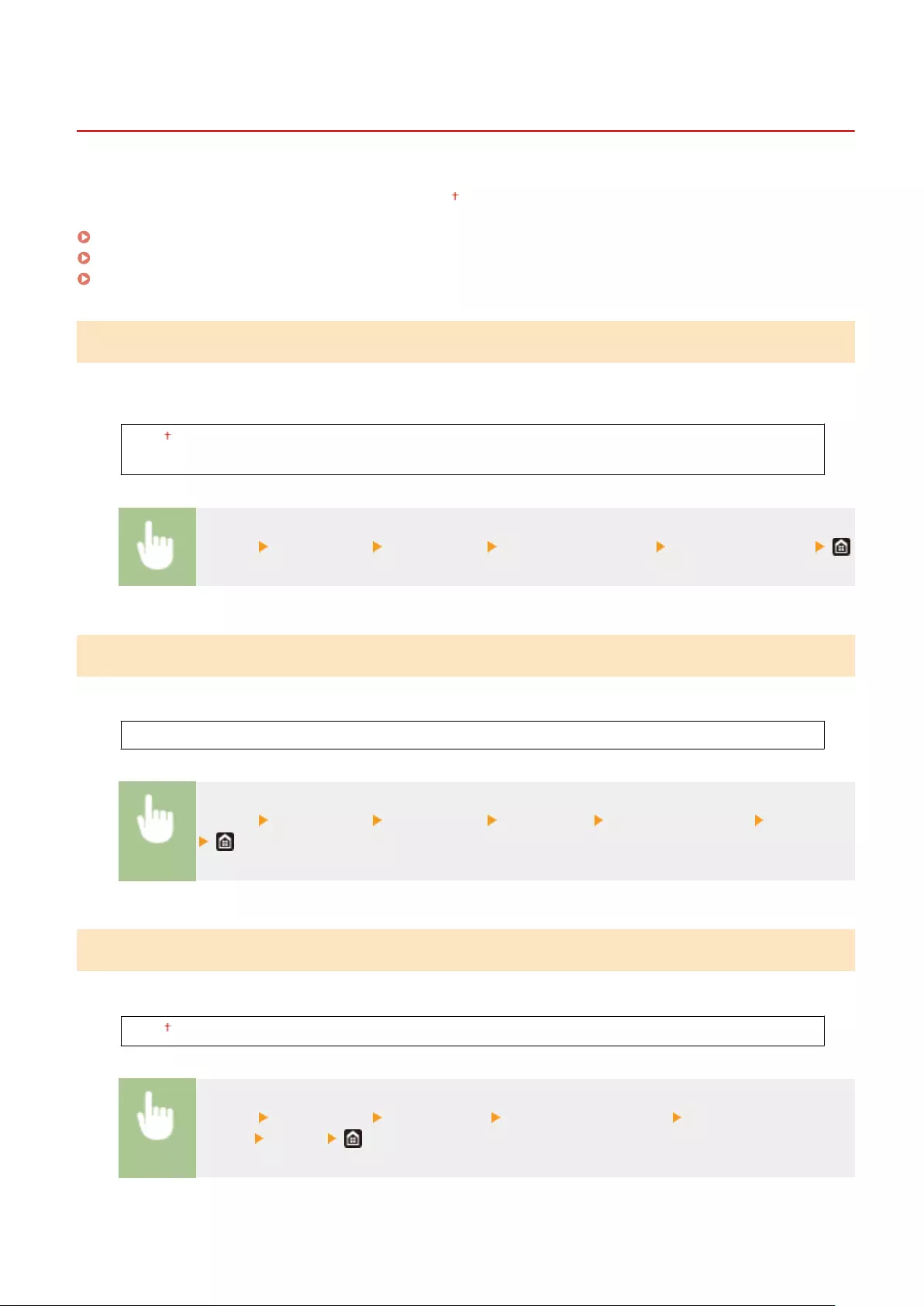
<Accessibility>
6FR5-08X
All the settings related to accessibility, such as inverting the screen colors and message display time, are listed with
descriptions. Default settings are marked with a dagger ( ).
<Invert Screen Colors>(P. 488)
<Brightness>(P. 488)
<Message Display Time>(P. 488)
<Invert Screen Colors>
Select <On> to invert the display colors. Select <On> if the display is hard to view even after the brightness was
adjusted in <Brightness>.
<Off>
<On>
<Menu> <Preferences> <Accessibility> <Invert Screen Colors> Select <Off> or <On>
<Brightness>
Adjust the brightness of the display to suit the installation location of the machine.
Five Levels
<Menu> <Preferences> <Accessibility> <Brightness> Adjust the brightness <Apply>
<Message Display Time>
Specify the interval in seconds at which two different messages are alternately displayed.
1 to 2 to 5 (sec.)
<Menu> <Preferences> <Accessibility> <Message Display Time> Enter a number for the
interval <Apply>
Setting Menu List
488
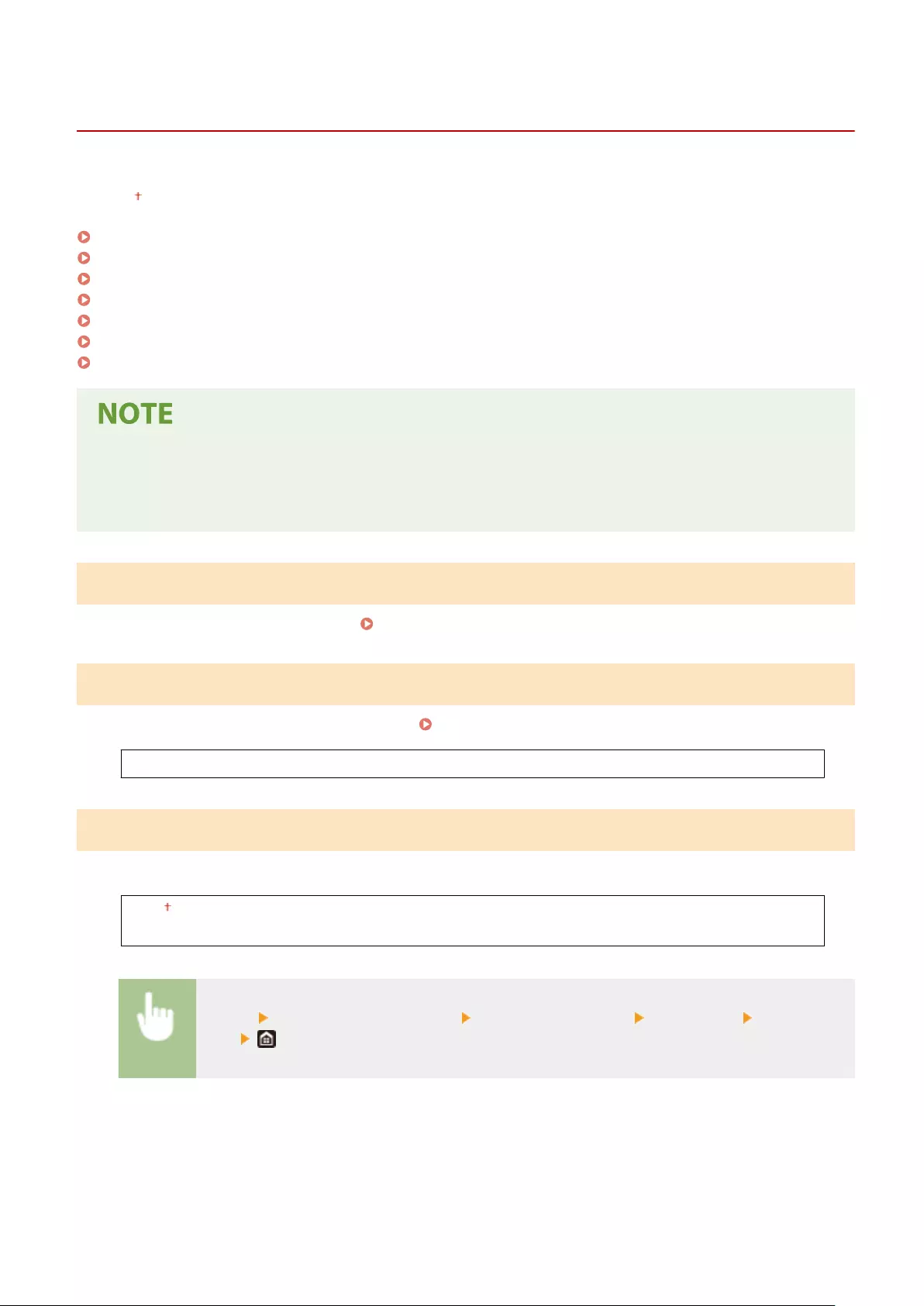
<Adjust Image Quality>
6FR5-090
All the settings related to image quality adjustment are listed with descriptions. Default settings are marked with a
dagger ( ).
<Adjust Copy Image>(P. 490)
<Printer Density>(P. 490)
<Toner Save>(P. 490)
<Black Text Processing for Color>(P. 491)
<Adjust Print Position>(P. 491)
<Special Processing>(P. 492)
<Remove Streaks from Scan Area>(P. 498)
Asterisks (*)
●Settings marked with an asterisk (*) may not be displayed depending on the model you are using, options, or
other setting items.
<Adjust Copy Image>
Adjust the gradation and density in copies. Adjusting the Gradation and Density for Copy Jobs(P. 589)
<Printer Density>
Adjust this if the printed text or thin lines are faded. Adjusting Print Density(P. 593)
Nine Levels
<Toner Save>
You can save toner when performing: copying, printing of received faxes, or report printing.
<Off>
<On>
<Menu> <Adjustment/Maintenance> <Adjust Image Quality> <Toner Save> Select <Off> or
<On>
Setting Menu List
490

<Black Text Processing for Color>
Select whether the color of black or blackish text in color documents should be reproduced as true black or as a color
more or less close to that of the original. For each option, you can adjust the degree of effect. You can set values for
the feeder and the platen glass separately. Adjusting Values for Text Color Reproducibility(P. 591)
<Feeder>
Seven Levels
<Platen Glass>
Seven Levels
<Adjust Print Position>
Adjust the print position for each paper source. The print position can be adjusted in the range from -5.0 mm to +5.0
mm in increments of 0.1 mm. Adjusting Print Position(P. 594)
<Multi-Purpose Tray>
<Adjust Vertically (Front Side)>
-5.0 to 0.0 to + 5.0 (mm)
<Adjust Horizontally (Front Side)>
-5.0 to 0.0 to + 5.0 (mm)
<Adjust Vertically (Back Side)>
-5.0 to 0.0 to + 5.0 (mm)
<Adjust Horizontally (Back Side)>
-5.0 to 0.0 to + 5.0 (mm)
<Drawer 1>
<Adjust Vertically (Front Side)>
-5.0 to 0.0 to + 5.0 (mm)
<Adjust Horizontally (Front Side)>
-5.0 to 0.0 to + 5.0 (mm)
<Adjust Vertically (Back Side)>
-5.0 to 0.0 to + 5.0 (mm)
<Adjust Horizontally (Back Side)>
-5.0 to 0.0 to + 5.0 (mm)
<Drawer 2> *
<Adjust Vertically (Front Side)>
-5.0 to 0.0 to + 5.0 (mm)
<Adjust Horizontally (Front Side)>
-5.0 to 0.0 to + 5.0 (mm)
<Adjust Vertically (Back Side)>
-5.0 to 0.0 to + 5.0 (mm)
<Adjust Horizontally (Back Side)>
-5.0 to 0.0 to + 5.0 (mm)
Setting Menu List
491
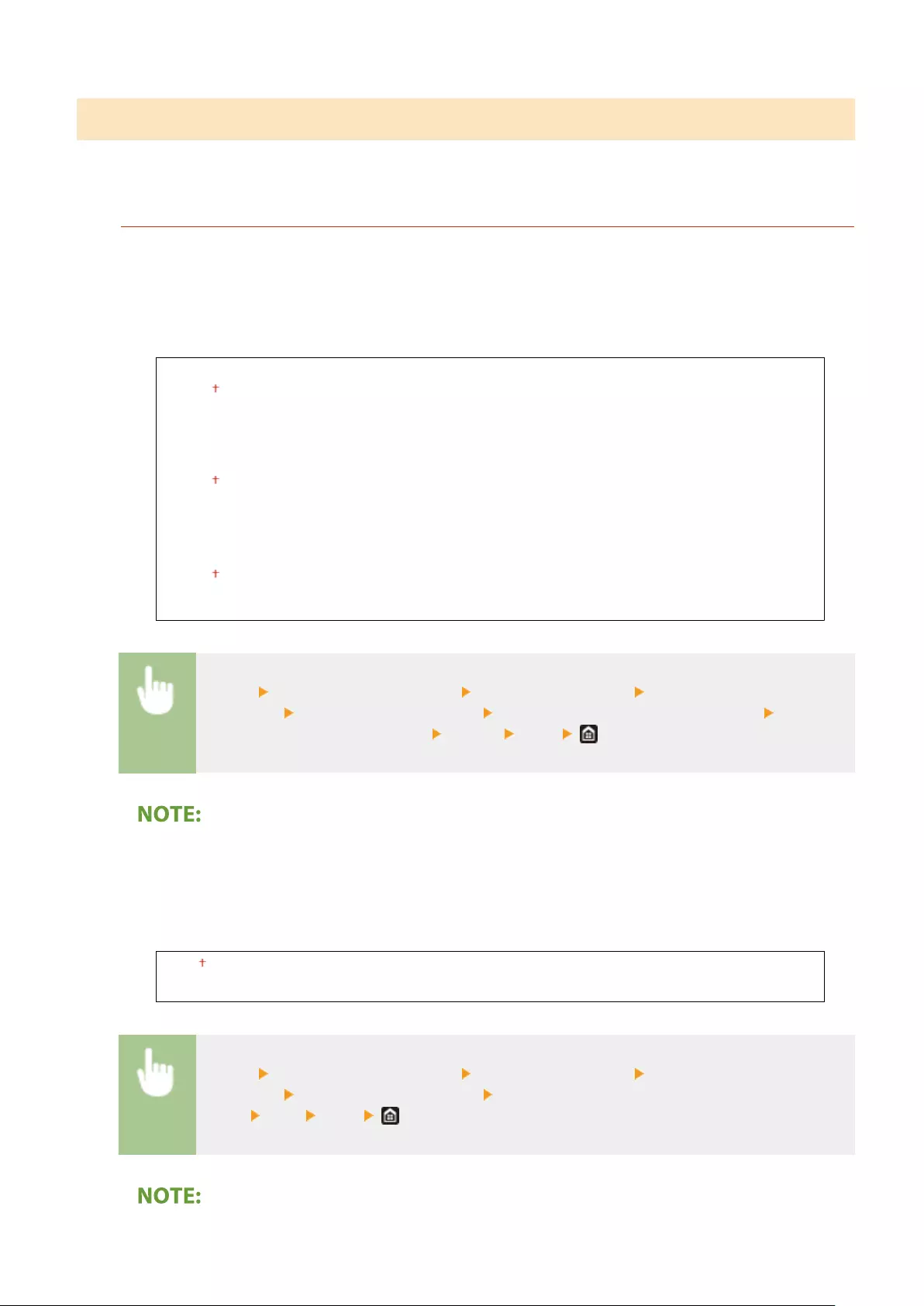
<Special Processing>
If the print results on special types of paper are not satisfactory, the following settings may improve the quality of the
printouts.
<Special Paper Processing>
When printing on the back side of printed paper, rough paper, or envelopes, the print results may be improved
by adjusting the following settings.
<Manual Back Side Print (2-Sided Only)>
If printouts on the back side of printed paper are too light, select <On>. You can specify this setting
separately for each paper source.
<Multi-Purpose Tray>
<Off>
<On>
<Drawer 1>
<Off>
<On>
<Drawer 2> *
<Off>
<On>
<Menu> <Adjustment/Maintenance> <Adjust Image Quality> <Special
Processing> <Special Paper Processing> <Manual Back Side Print (2-Sided Only)> Select
<On> in the paper source to be set <Apply> <Yes>
●If you set to <On>, image quality may be affected when a certain length of time elapses after printing on
the front side or depending on the ambient humidity.
<Rough Surface Envelope Mode>
When printing on envelopes with rough surfaces, select <On>. However, the printing speed may be slower.
<Off>
<On>
<Menu> <Adjustment/Maintenance> <Adjust Image Quality> <Special
Processing> <Special Paper Processing> <Rough Surface Envelope
Mode> <On> <Yes>
Setting Menu List
492
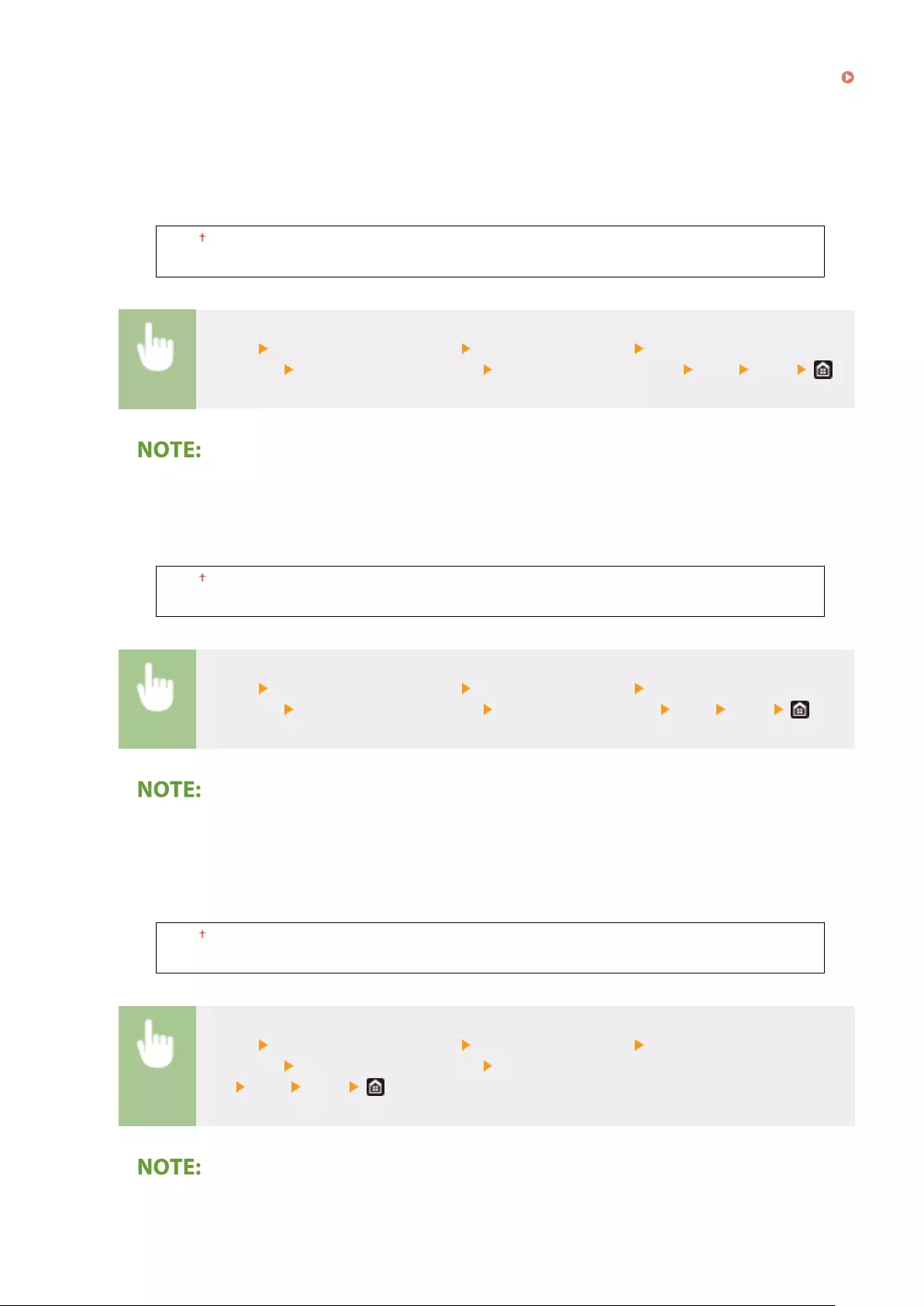
●<Rough Surface Envelope Mode> functions only when the paper type setting is <Envelope 2>.
Specifying Paper Size and Type(P. 157)
●If you set to <On>, the <Paper Curl Correction> setting will be disabled.
<Paper Wrinkle Correction>
Printouts may wrinkle depending on the paper to use. In this case, setting this item to <On> may solve the
problem.
<Off>
<On>
<Menu> <Adjustment/Maintenance> <Adjust Image Quality> <Special
Processing> <Special Paper Processing> <Paper Wrinkle Correction> <On> <Yes>
●If you set to <On>, the print may be faded or the printing speed may be slower.
<Paper Curl Correction>
If the printed paper curls, set this item to <On>.
<Off>
<On>
<Menu> <Adjustment/Maintenance> <Adjust Image Quality> <Special
Processing> <Special Paper Processing> <Paper Curl Correction> <On> <Yes>
●If you set to <On>, the printing speed may be slower.
<Rdc. Tnr Flaking from Heavy Sml. Ppr>
When a halftone image such as a photograph is printed on a small size piece of heavy paper, streaks may
appear on the back side of the paper. In this case, setting this item to <On> may solve the problem.
<Off>
<On>
<Menu> <Adjustment/Maintenance> <Adjust Image Quality> <Special
Processing> <Special Paper Processing> <Rdc. Tnr Flaking from Heavy Sml.
Ppr> <On> <Yes>
●If you set to <On>, the printing speed may be slower.
Setting Menu List
493
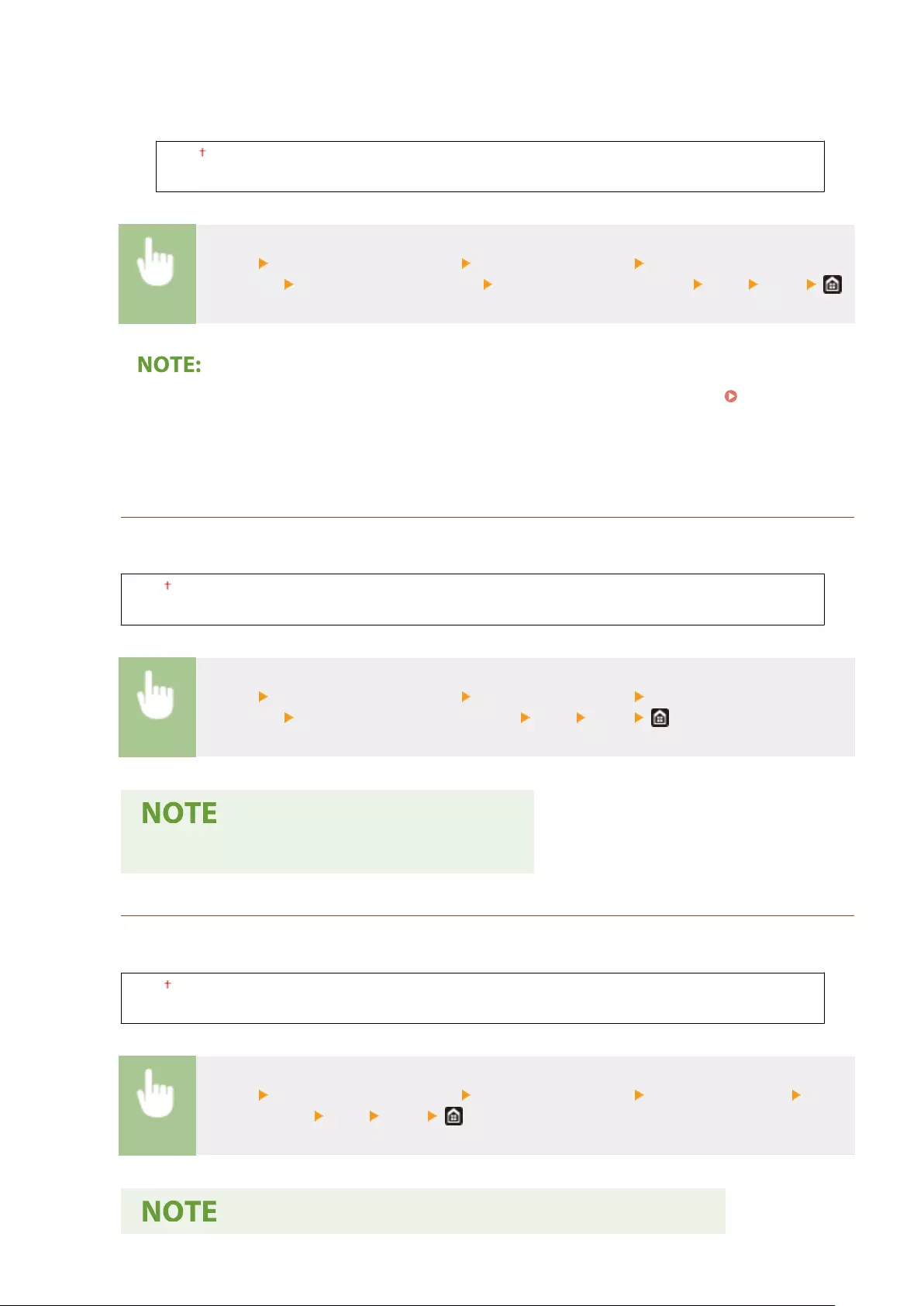
<Reduce Thin Paper Curling>
If printing on thin paper produces curled printouts, setting this item to <On> may solve the problem.
<Off>
<On>
<Menu> <Adjustment/Maintenance> <Adjust Image Quality> <Special
Processing> <Special Paper Processing> <Reduce Thin Paper Curling> <On> <Yes>
●<Reduce Thin Paper Curling> functions only when the paper type setting is <Thin 1>. Specifying Paper
Size and Type(P. 157)
●If you set to <On>, automatic 2-sided printing with <Thin 1> is disabled. Further, printouts may be faded
due to poor xing of toner.
<Reduce Ppr. Sticking at Output>
In 2-sided printing, printed paper may stick to each other depending on the image density of print data. In this
case, setting this item to <On> may solve the problem.
<Off>
<On>
<Menu> <Adjustment/Maintenance> <Adjust Image Quality> <Special
Processing> <Reduce Ppr. Sticking at Output> <On> <Yes>
●If you set to <On>, the printing speed may be slower.
<High Humidity Mode>
Print density may be uneven when the machine is used in an environment with high humidity. In this case,
setting this item to <On> may solve the problem.
<Off>
<On>
<Menu> <Adjustment/Maintenance> <Adjust Image Quality> <Special Processing> <High
Humidity Mode> <On> <Yes>
Setting Menu List
494
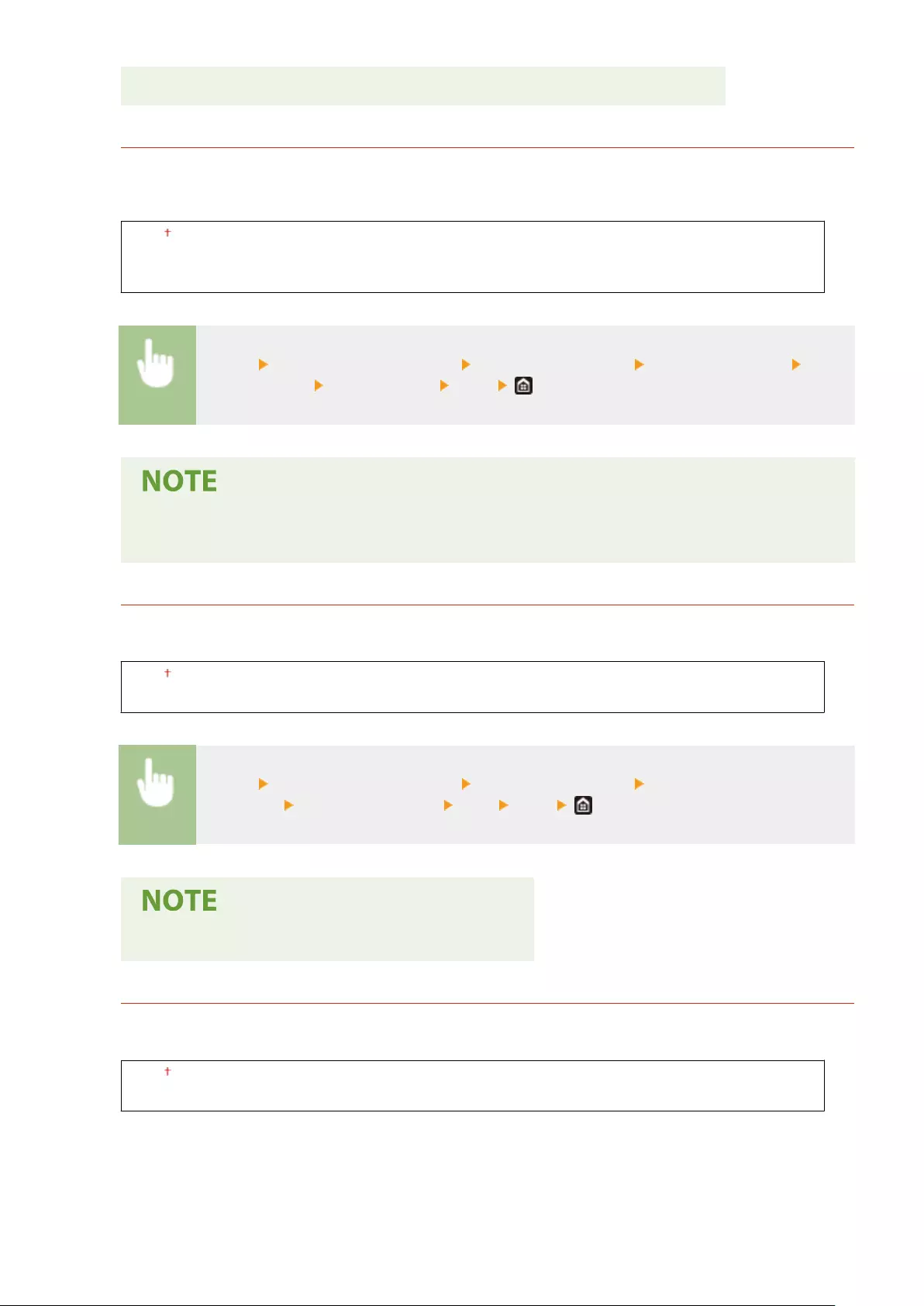
●If you set to <On>, the print density may vary depending on the ambient humidity.
<Low Humidity Mode>
When using the machine in an environment with low humidity, printed images and text may be blurry. In this
case, set this item. The improvement effect is stronger with <Mode 2> than with <Mode 1>. First try the
adjustment with <Mode 1>.
<Off>
<Mode 1>
<Mode 2>
<Menu> <Adjustment/Maintenance> <Adjust Image Quality> <Special Processing> <Low
Humidity Mode> Select the mode <Yes>
●If <Low Humidity Mode> is specied, print density may be lower or uneven when the machine is used
in an environment with high humidity.
<Reduce Ghosting 1>
When you print on large size paper after printing on small size paper, afterimages may appear in blank areas.
In this case, setting this item to <On> may solve the problem.
<Off>
<On>
<Menu> <Adjustment/Maintenance> <Adjust Image Quality> <Special
Processing> <Reduce Ghosting 1> <On> <Yes>
●If you set to <On>, the printing speed may be slower.
<Rdc Condens. (Consec 2-Sd Prt)>
If the printed images are faint due to moisture condensation when performing 2-sided printing, setting to other
than <Off> may solve the problem.
<Off>
<On>
Setting Menu List
495
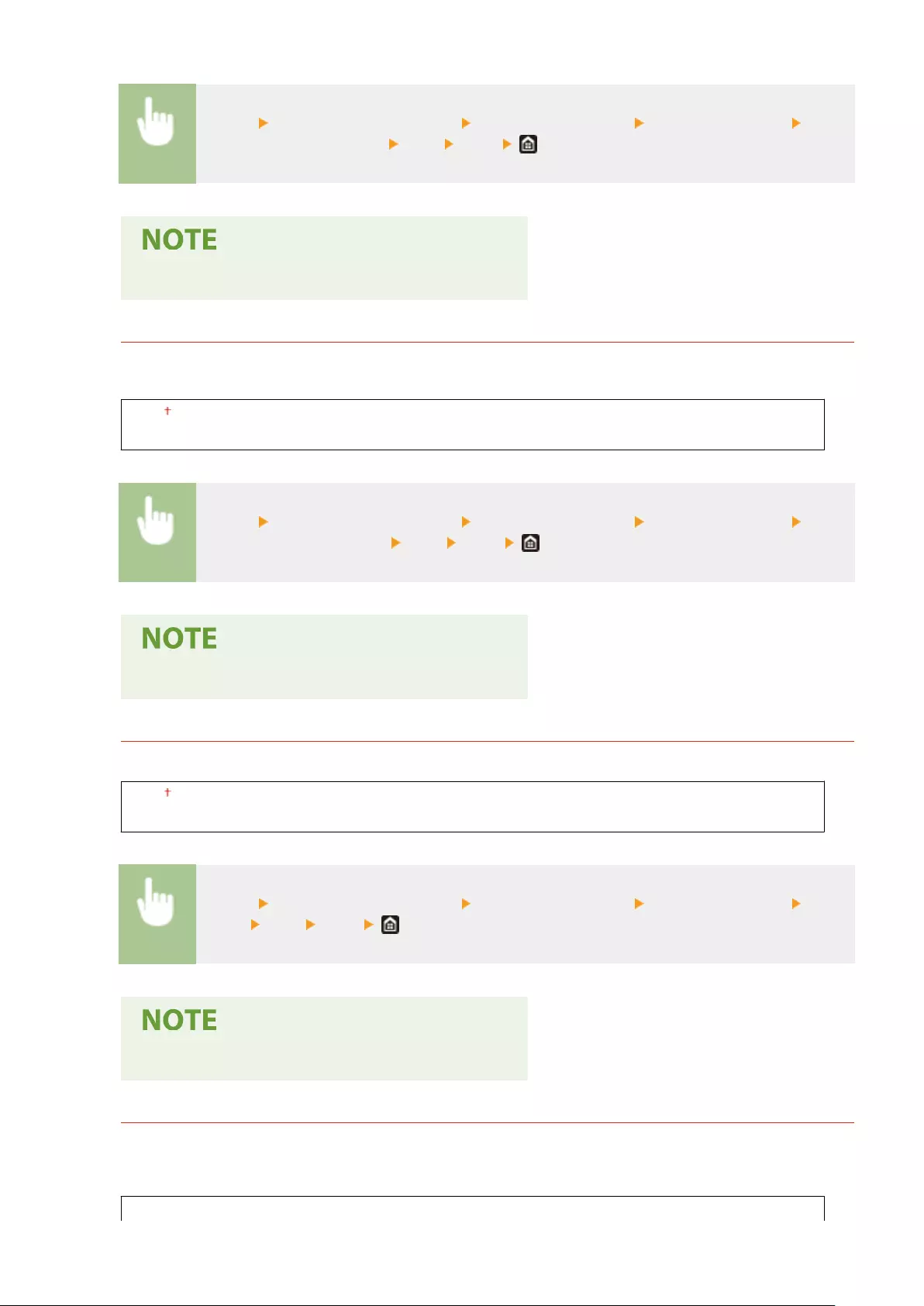
<Menu> <Adjustment/Maintenance> <Adjust Image Quality> <Special Processing> <Rdc
Condens. (Consec 2-Sd Prt)> <On> <Yes>
●If you set to <On>, the printing speed will be slower.
<Rdc. Wrinkles(Humidity)/Streaks>
If printouts have creases when damp paper is used or if streaks appear in the leading edge of paper when
images with halftones such as photos are printed, setting to <On> may solve the problem.
<Off>
<On>
<Menu> <Adjustment/Maintenance> <Adjust Image Quality> <Special Processing> <Rdc.
Wrinkles(Humidity)/Streaks> <On> <Yes>
●If you set to <On>, the printing speed will be slower.
<Quiet Mode>
When printing sounds bother you, set this item to <On>.
<Off>
<On>
<Menu> <Adjustment/Maintenance> <Adjust Image Quality> <Special Processing> <Quiet
Mode> <On> <Yes>
●If you set to <On>, the printing speed will be slower.
<Correct Blurry Image>
Streaks may appear on printouts depending on the paper type or the environmental conditions. In this case,
setting this item may solve the problem. The improvement effect is weakest with <Mode 1> and strongest with
<Mode 4>.
<Off>
Setting Menu List
496
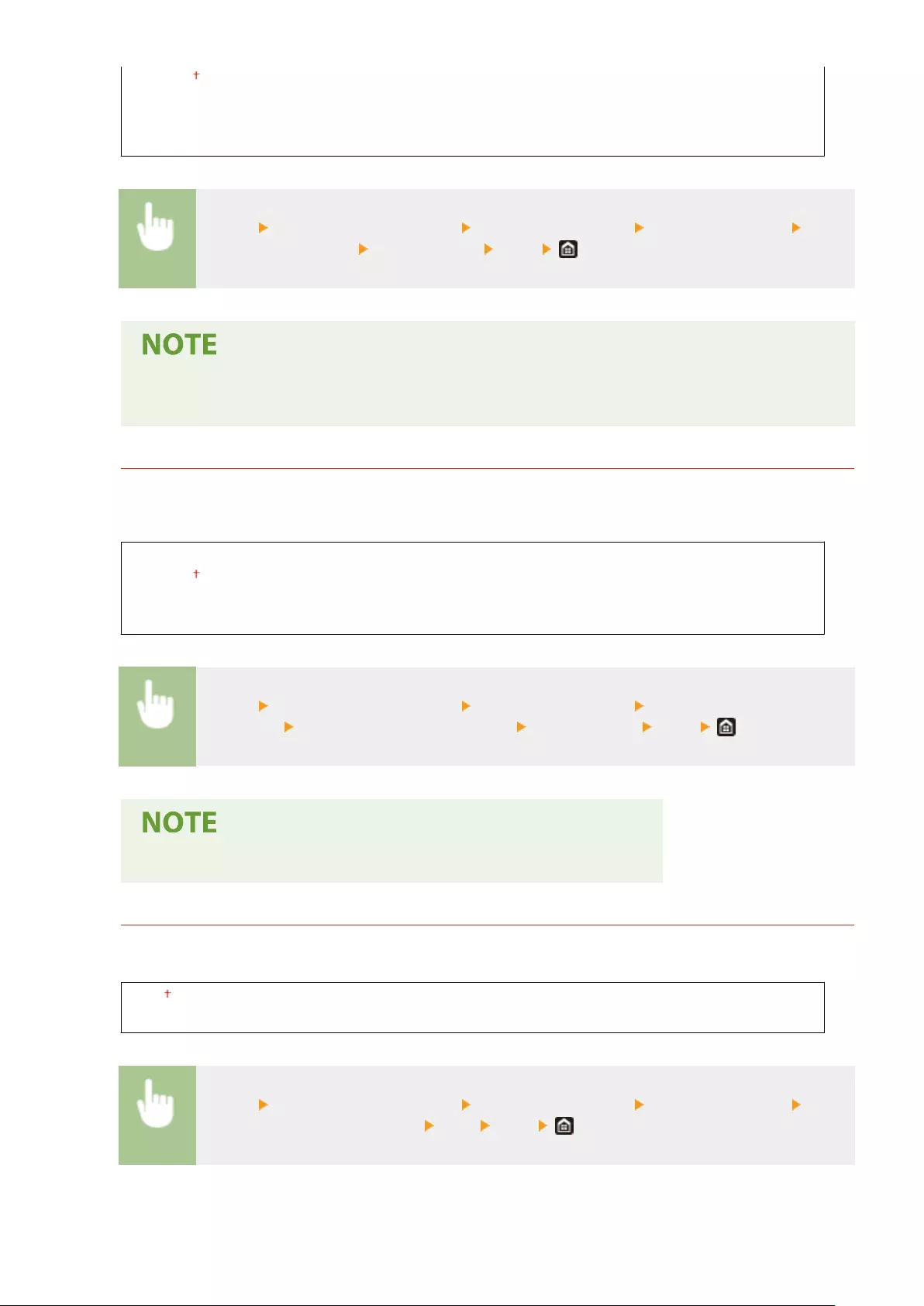
<Mode 1>
<Mode 2>
<Mode 3>
<Mode 4>
<Menu> <Adjustment/Maintenance> <Adjust Image Quality> <Special Processing>
<Correct Blurry Image> Select the mode <Yes>
●Setting a stronger improvement effect may result in lighter print density or slower printing speed. It
may also result in less sharp edges and rougher details.
<Correct Blurry Image for Copy>
Smudges may appear on copies depending on the paper type or the environmental conditions. In this case,
setting this item may solve the problem. The improvement effect is strongest with <Mode 3> and weakest with
<Mode 1>.
<Off>
<Mode 1>
<Mode 2>
<Mode 3>
<Menu> <Adjustment/Maintenance> <Adjust Image Quality> <Special
Processing> <Correct Blurry Image for Copy> Select the mode <Yes>
●Setting a stronger improvement effect may result in lighter print density.
<Rdc Blnk Space Dark. After Rplc Cart.>
Immediately after replacing toner cartridges with new ones, black streaks may appear on printouts or printing
on heavy paper may result in grayish printouts. In this case, setting this item to <On> may solve the problem.
<Off>
<On>
<Menu> <Adjustment/Maintenance> <Adjust Image Quality> <Special Processing> <Rdc
Blnk Space Dark. After Rplc Cart.> <On> <Yes>
Setting Menu List
497
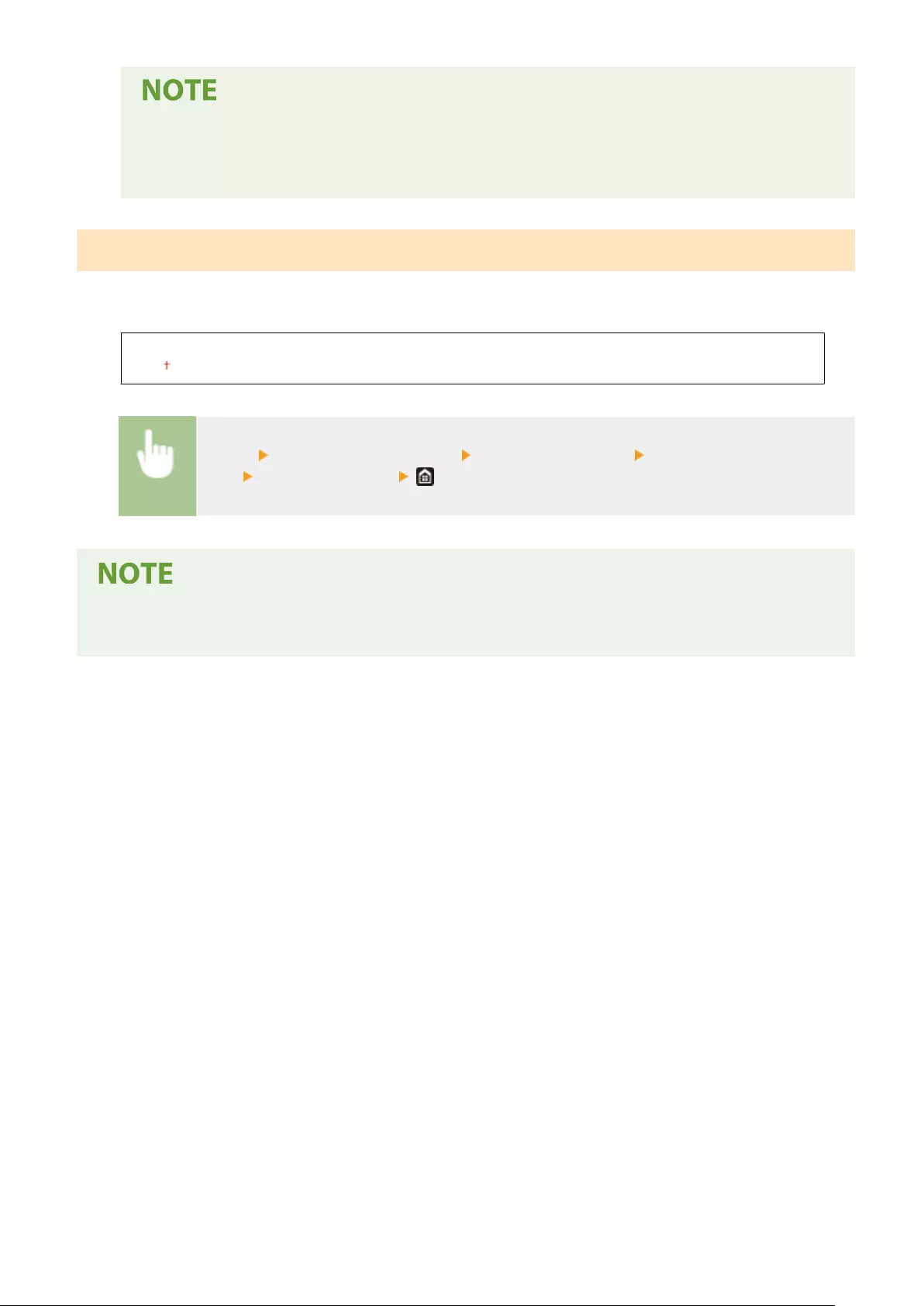
●If you set to <On>, the setting will become effective with next replacement of toner cartridges.
●Immediately after cartridge replacement, a certain amount of time is required for toner to be evenly
distributed inside the cartridge.
<Remove Streaks from Scan Area>
You can congure a setting to prevent stains from being scanned when they are detected in the document feed
scanning area. Selecting <On> removes streaks generated by the edge of the original.
<Off>
<On>
<Menu> <Adjustment/Maintenance> <Adjust Image Quality> <Remove Streaks from Scan
Area> Select <Off> or <On>
●When streaks are removed, areas with stains are not scanned. Clean the original scanning area so that the
original is scanned satisfactorily.
Setting Menu List
498

<Maintenance>
6FR5-091
The cleaning functions are listed with descriptions. Default settings are marked with a dagger ( ).
<Clean Fixing Assembly>(P. 499)
<Clean Feeder>(P. 499)
<Control Condensation>(P. 499)
<Clean Fixing Assembly>
Clean the xing assembly after a toner cartridge is replaced or if black streaks appear on printouts. Cleaning the
Fixing Assembly(P. 582)
<Clean Feeder>
Clean the feeder rollers if originals become dirty after being fed through the feeder. Cleaning the Feeder(P. 579)
<Control Condensation>
When the temperature changes rapidly in the environment where the machine is installed, condensation occurs, which
may cause fading or bleeding in images and text. Select <On> to remove dew condensation in the machine. When
selecting <On>, specify whether to restrict jobs.
<Off>
<On>
<Use Fax Memory Lock> /<Allow Job Printing During Process>
<Use Fax Memory Lock + Do Not Allow Job Printing During Process>/<Do Not Allow Job Printing During
Process>
<Menu> <Adjustment/Maintenance> <Maintenance> <Control Condensation> <On>
Check the message <OK> Select the item <Yes>
●While condensation removal is being performed, printing may not be performed properly and blank paper
may be output.
●If you set to <On>, you need to keep the machine turned ON to maintain the effect of condensation removal.
●If you set to <On>, the setting of Auto Shutdown Time is disabled. Powering OFF at a Fixed Time(P. 118)
Setting Menu List
499
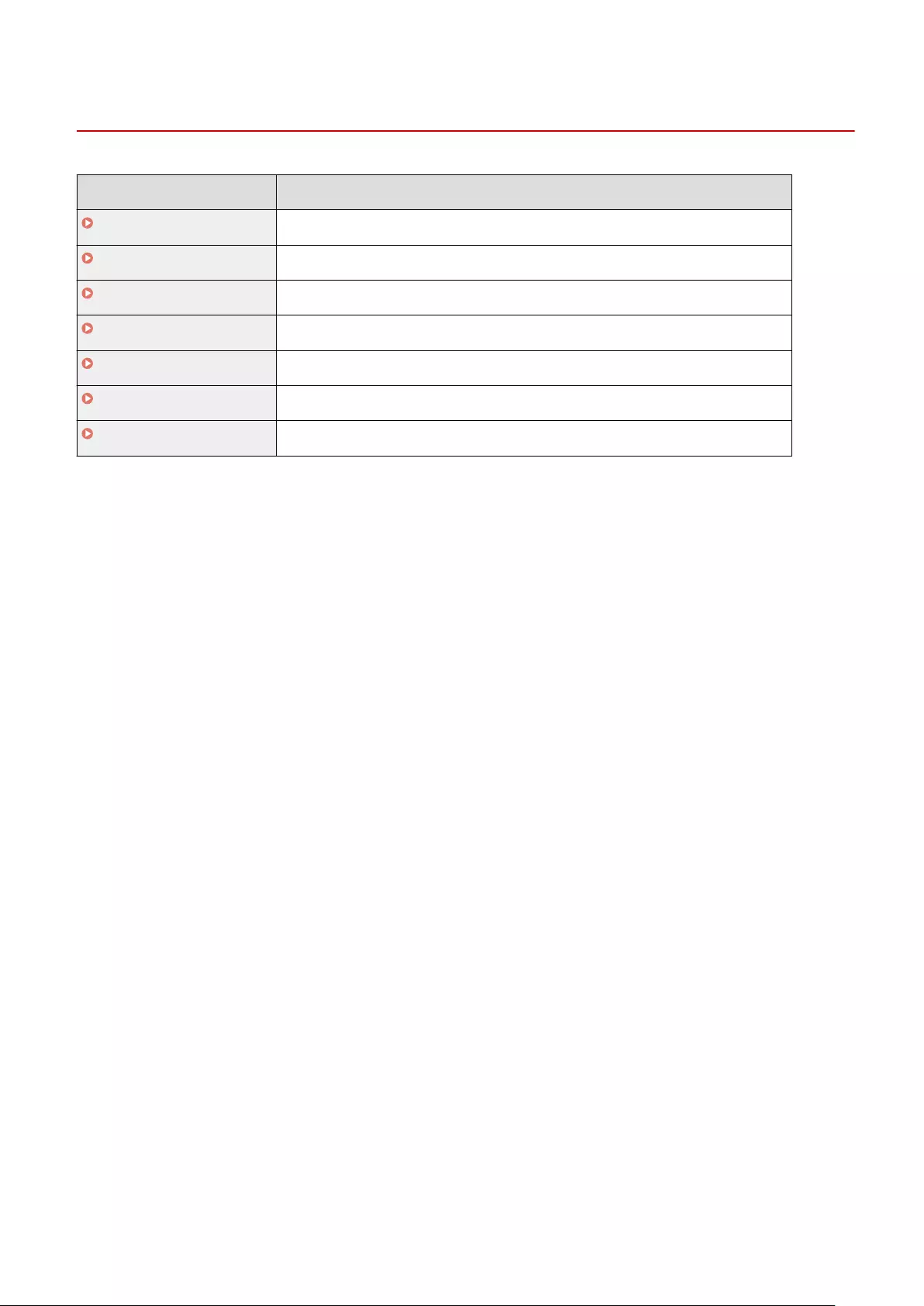
<Function Settings>
6FR5-092
Item Description
<Common>(P. 501) This section describes settings common to each function.
<Copy>(P. 507) This section describes how to specify the copy settings.
<Printer>(P. 509) This section describes how to specify printer settings.
<Send>(P. 534) This section describes how to specify settings for sending faxes and scanned originals.
<Receive/Forward>(P. 547) This section describes how to specify settings for receiving faxes and e-mails.
<Store/Access Files>(P. 554) This section describes the settings for scanning originals and printing stored les.
<Secure Print>(P. 560) This section describes the settings for the Secure Print.
Setting Menu List
500

<Common>
6FR5-093
All the items related to settings common to each function are listed with descriptions. Default settings are marked with
a dagger ( ).
<Paper Feed Settings>(P. 501)
<Print Settings>(P. 503)
<Scan Settings>(P. 504)
<Generate File>(P. 505)
<Fax Setup Guide>(P. 506)
Asterisks (*)
●Settings marked with "*1" may not be displayed depending on the model you are using, options, or other
setting items.
●Settings marked with "*2" cannot be imported or exported.
<Paper Feed Settings>
Congure paper feed settings.
<Paper Source Auto Selection>
Enable or disable the automatic drawer selection feature for the paper sources. If automatic drawer selection is
set to <On> when printing documents, the machine automatically selects a paper source that is loaded with the
appropriate paper size. Also, when the paper runs out, this setting enables continuous printing by switching
from one paper source to another that is loaded with the same paper size. Automatically Selecting an
Appropriate Paper Source for Each Function(P. 167)
<Copy>
<Multi-Purpose Tray>
<Off>
<On>
<Drawer 1>
<Off>
<On>
<Drawer 2>*1
<Off>
<On>
<Printer>
<Multi-Purpose Tray>
<Off>
<On>
<Drawer 1>
<Off>
<On>
<Drawer 2>*1
Setting Menu List
501

<Off>
<On>
<Receive/Fax >/<Receive>
<Multi-Purpose Tray>
<Off>
<On>
<Drawer 1>
<Off>
<On>
<Drawer 2>*1
<Off>
<On>
<Other>
<Multi-Purpose Tray>
<Off>
<On>
<Drawer 1>
<Off>
<On>
<Drawer 2>*1
<Off>
<On>
<Switch Paper Feed Method>
Specify this setting when you print a document on paper with logos. In general use, to print on paper with
logos, you need to change how the paper loaded in the paper source is facing depending on whether you are
performing 1- or 2-sided printing. However, if you change the setting to <Print Side Priority>, you can just load
the paper with the logo side facing down for 1-sided printing in the same way as for 2-sided printing. For more
information, see Loading Preprinted Paper(P. 153) .
<Multi-Purpose Tray>
<Speed Priority>
<Print Side Priority>
<Drawer 1>
<Speed Priority>
<Print Side Priority>
<Drawer 2> *1
<Speed Priority>
<Print Side Priority>
<Menu> <Function Settings> <Common> <Paper Feed Settings> <Switch Paper Feed
Method> Select the paper source Select <Speed Priority> or <Print Side Priority>
Setting Menu List
502
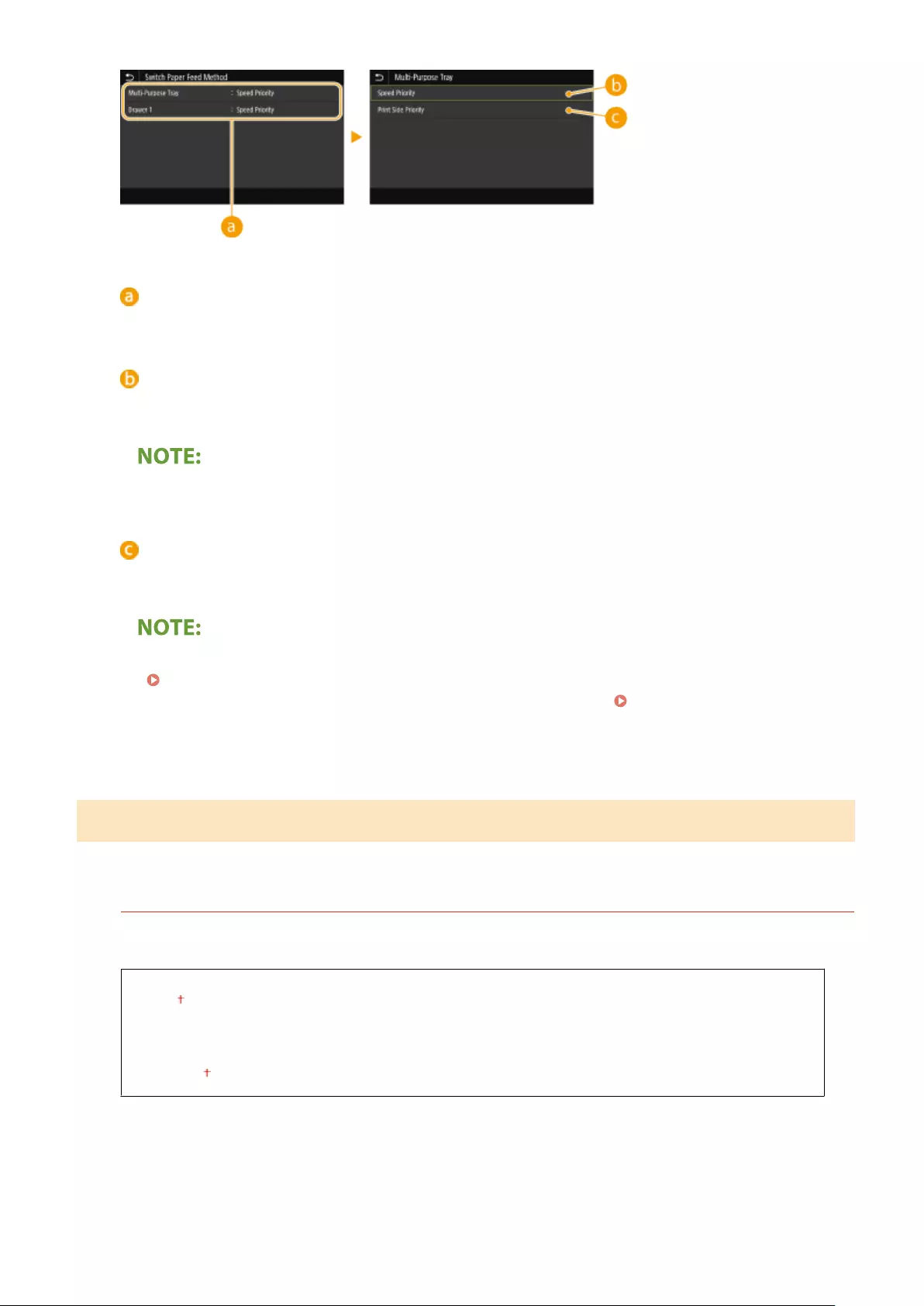
Paper Sources
Select the paper source that you want to change the setting for.
<Speed Priority>
When using paper that has been preprinted with a logo, you need to change how it is facing when you
perform 1-sided and 2-sided printing.
●We recommend selecting <Speed Priority> if you do not need to consider which side to print on.
<Print Side Priority>
To print on a specic side of paper, you do not need to ip over paper in the paper source whether 1- or 2-
sided printing is selected.
●If <Print Side Priority> is set for a paper source that is loaded with paper you cannot use for 2-sided printing
( Available Paper(P. 624) ), <Speed Priority> is applied to the paper source instead. In this case, you need
to load the paper in the same way as when <Speed Priority> is selected ( Loading Preprinted
Paper(P. 153) ).
●1-sided printing speed may be slower when <Print Side Priority> is selected.
<Print Settings>
Congure printing operation settings.
<Auto Delete Suspended Jobs>
You can congure so that if the machine stops printing a job due to an error, the job will be automatically
deleted after a specied period of time.
<Set This Function>
<Off>
<On>
<Set Time>
0 to 5 to 240 (min.)
Setting Menu List
503
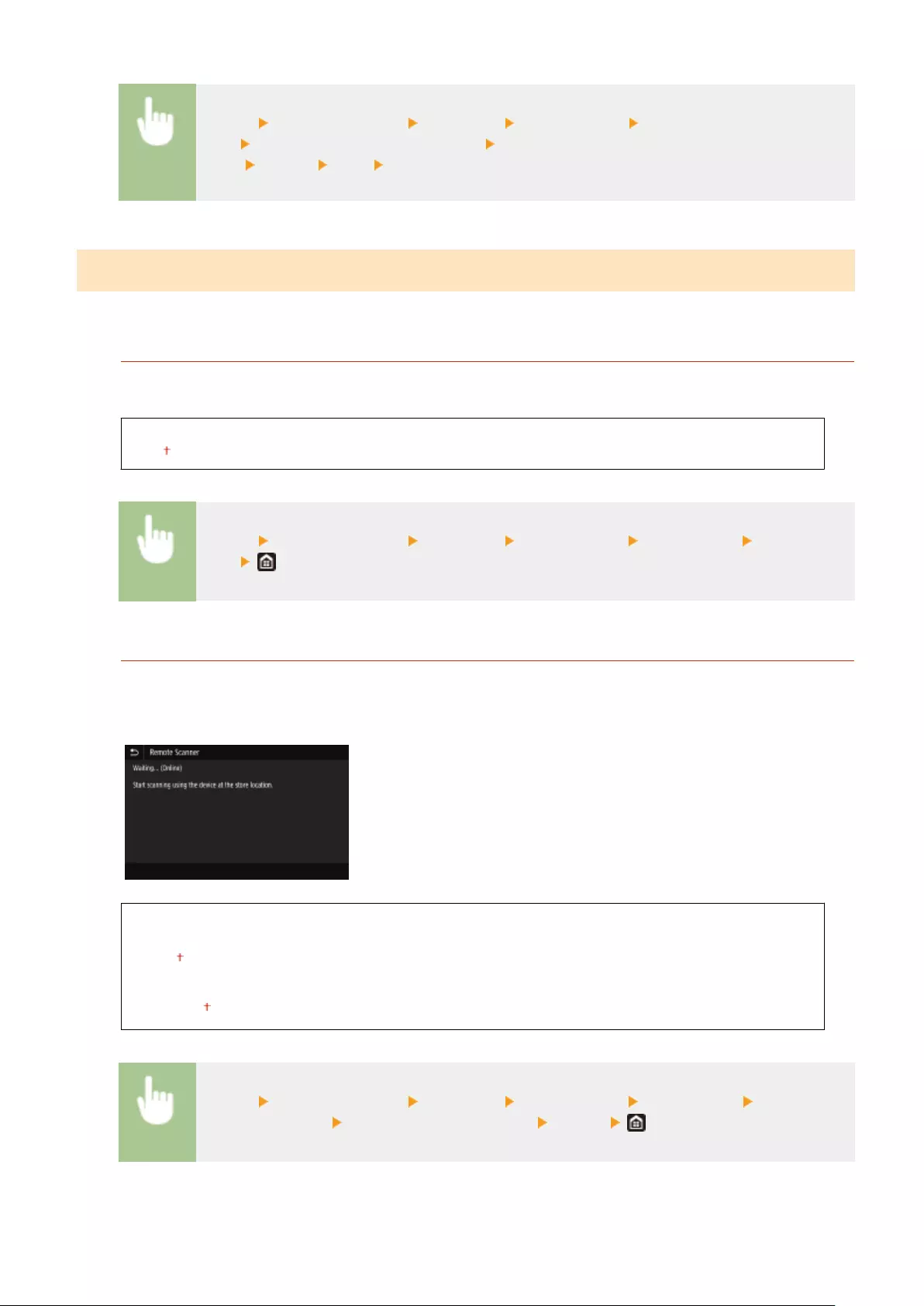
<Menu> <Function Settings> <Common> <Print Settings> <Auto Delete Suspended
Jobs> Select <On> in <Set This Function> Enter the time in <Set
Time> <Apply> <OK> Restart the machine
<Scan Settings>
Congure scan settings.
<Auto Online>
When scanning from the computer, use this to specify whether to automatically go online for remote scanning
(scan standby mode) without using the operation panel.
<Off>
<On>
<Menu> <Function Settings> <Common> <Scan Settings> <Auto Online> Select <Off> or
<On>
<Auto Oine>
If scan is not performed within a specied period of time after the screen below is displayed (the machine is
set online for scanning), the machine automatically becomes oine. Specify the time period at which the
machine becomes oine.
<Set This Function>
<Off>
<On>
<Set Time>
1 to 5 to 60 (min.)
<Menu> <Function Settings> <Common> <Scan Settings> <Auto Oine> Select <On> in
<Set This Function> Enter the time in <Set Time> <Apply>
Setting Menu List
504
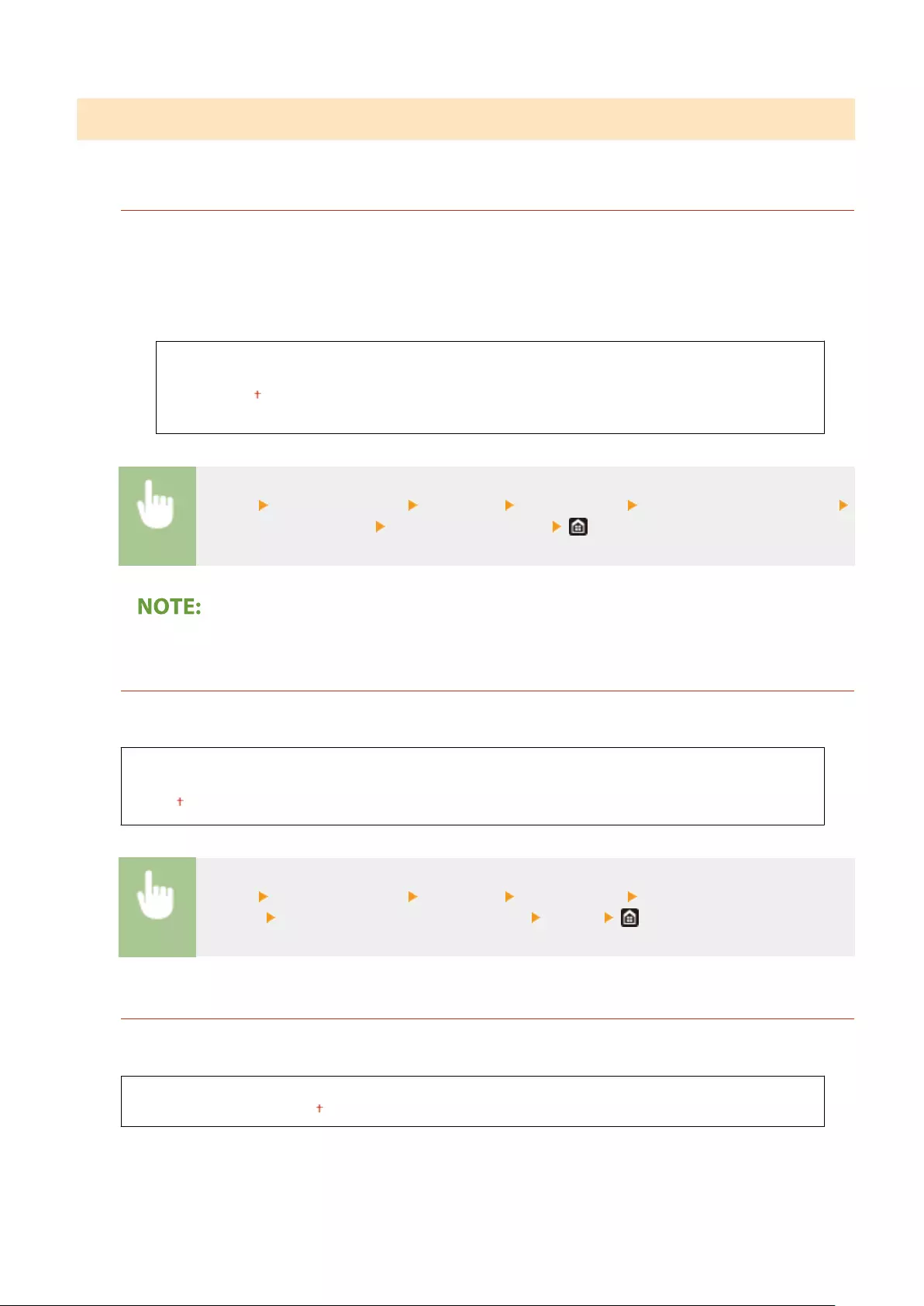
<Generate File>
Congure le generation settings.
<Output File Image Settings>
Specify settings for the gamma value for converting scanned originals into les.
<YCbCr TX Gamma Value>
Select the gamma value used when converting scanned color originals into the specied le format. You can
specify the same gamma value as that of the monitor which is to be used for viewing the converted les. The
les are displayed with brightness that is true to the original documents.
<Gamma 1.0>
<Gamma 1.4>
<Gamma 1.8>
<Gamma 2.2>
<Menu> <Function Settings> <Common> <Generate File> <Output File Image Settings>
<YCbCr TX Gamma Value> Select the gamma value
●For the gamma value of a monitor display, see the instruction manual included with the display.
<OCR (Text Searchable) Settings>
To run OCR (Optical Character Recognition) on a text original to create a "searchable PDF," specify whether the
machine determines the original's text direction and detects the original direction.
<Smart Scan>
<Off>
<On>
<Menu> <Function Settings> <Common> <Generate File> <OCR (Text Searchable)
Settings> Select <Off> or <On> in <Smart Scan> <Apply>
<256-bit AES Set. (Encrypt. PDF)> *1
When generating an encrypted PDF, the PDF encryption level can be set to "128-bit" or "256-bit." If "256-bit" is
selected, the version compatible with Acrobat can be changed.
<Acrobat 9.0 or Equivalent>
<Acrobat 10.0 or Equivalent>
Setting Menu List
505

<Menu> <Function Settings> <Common> <Generate File> <256-bit AES Set. (Encrypt.
PDF)> Select <Acrobat 9.0 or Equivalent> or <Acrobat 10.0 or Equivalent>
<Fax Setup Guide> *1*2
Select to display on-screen instructions for specifying settings, including the fax number and the RX mode.
Conguring Initial Settings for Fax Functions(P. 78)
Setting Menu List
506

<Copy>
6FR5-094
All the settings related to the copy are listed with descriptions. Default settings are marked with a dagger ( ).
Asterisks (*)
●Settings marked with an asterisk (*) may not be displayed depending on the model you are using, options, or
other setting items.
<Change Default Settings (Copy)>
You can change the default settings about copy. The selected settings are used as the default settings of the copy
function. Changing the Default Settings for Functions(P. 174)
<Number of Copies>
1 to 999
<Paper Source>
<Multi-Purpose Tray>
<Drawer 1>
<Drawer 2>*
<Density>
Nine Levels
<Adjust Background Density>
<Auto>
<Adjust (Manual)>
Nine Levels
<Copy Ratio>
Custom Ratio
<100% 1:1>
<Auto>
<400% Max>
<200%>
<141% A5->A4>
<70% A4->A5>
<50%>
<25% Min>
<2-Sided Printing>
<Off>
<1-Sided->2-Sided>
<2-Sided->2-Sided>
<2-Sided->1-Sided>
<Orig./Fin. Type>
Setting Menu List
507

<N on 1>
<Off>
<2 on 1>
<4 on 1>
<Layout>
<Original Type>
<Text>
<Text/Photo>
<Text/Photo (High Quality)>
<Photo>
<Collate>
<Off>
<On>
<Erase Frame>
<Off>
<On>
<Sharpness>
Seven Levels
Setting Menu List
508
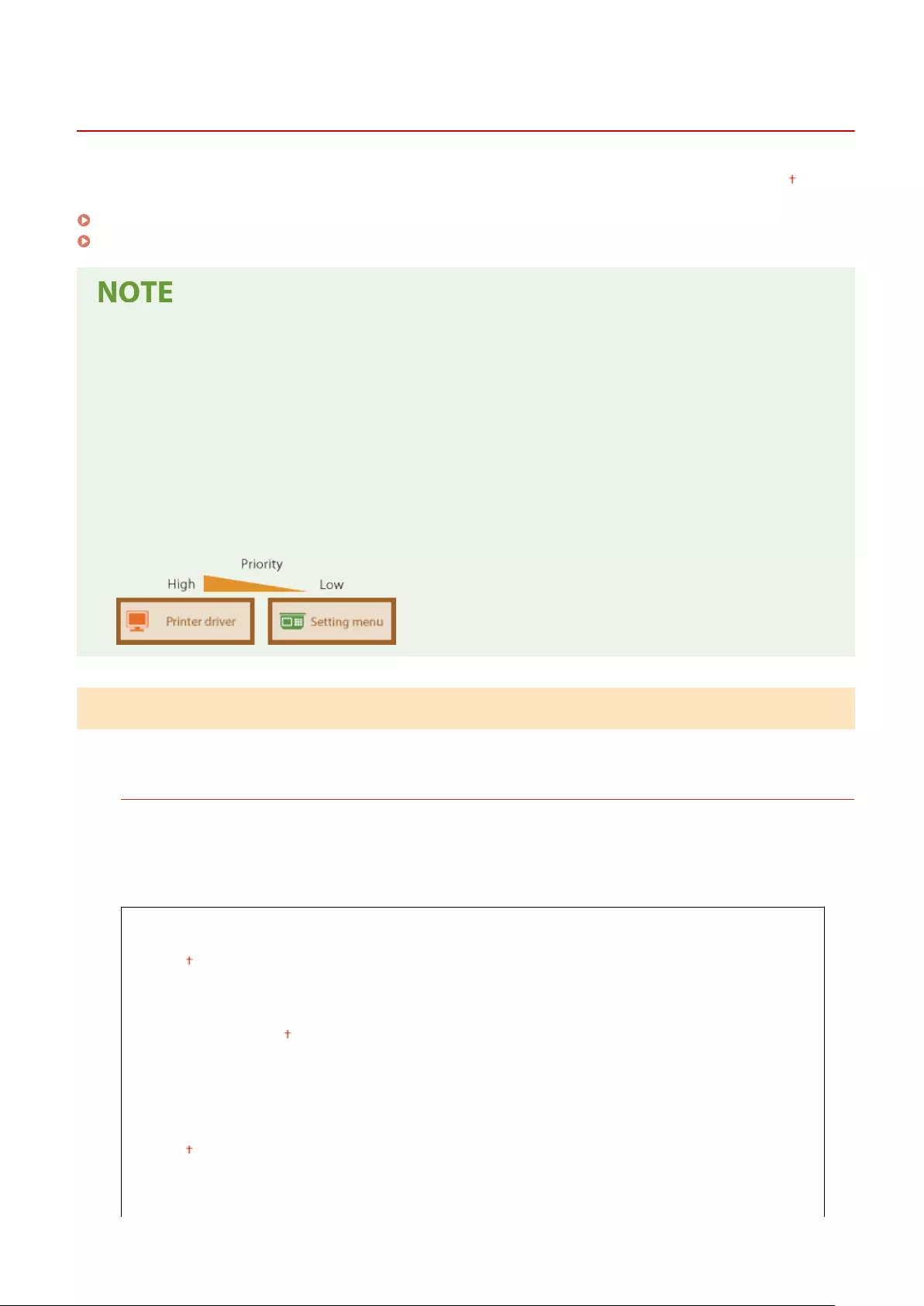
<Printer>
6FR5-095
All the settings related to the printer are listed with descriptions. Default settings are marked with a dagger ( ).
<Printer Settings>(P. 509)
<PDL Selection (Plug and Play)>(P. 533)
Asterisks (*)
●Settings marked with "*1" may not be displayed depending on the model you are using, options, or other
setting items.
●Settings marked with "*2" cannot be imported or exported.
Priority of settings
●If a print setting is specied both from the printer driver and the operation panel of the machine, the
specication from the printer driver overrides that from the operation panel. The specication from the
operation panel becomes effective in some specic cases, such as when performing PS/PCL printing and
printing from UNIX or other operating system that does not support printer drivers.
<Printer Settings>
Congure settings about printing and printer operations.
<Prioritize Driver Settings When Printing>
Select whether printing is performed in accordance with the printer driver's settings for paper size and type
taking priority over the settings made for each paper source under <Paper Settings> in the Home screen. By
selecting <On>, you can print from the paper source specied in the printer driver, regardless of the paper
settings on the machine. An error message can be set to display if the loaded paper size is largely different from
that set in the printer driver.
<Multi-Purpose Tray>
<Prioritize Driver Settings>
<Off>
<On>
<Action When Size Mismatch>
<Force Output>
<Display Error>
<Drawer 1>
<Prioritize Driver Settings>
<Off>
<On>
<Action When Size Mismatch>
Setting Menu List
509
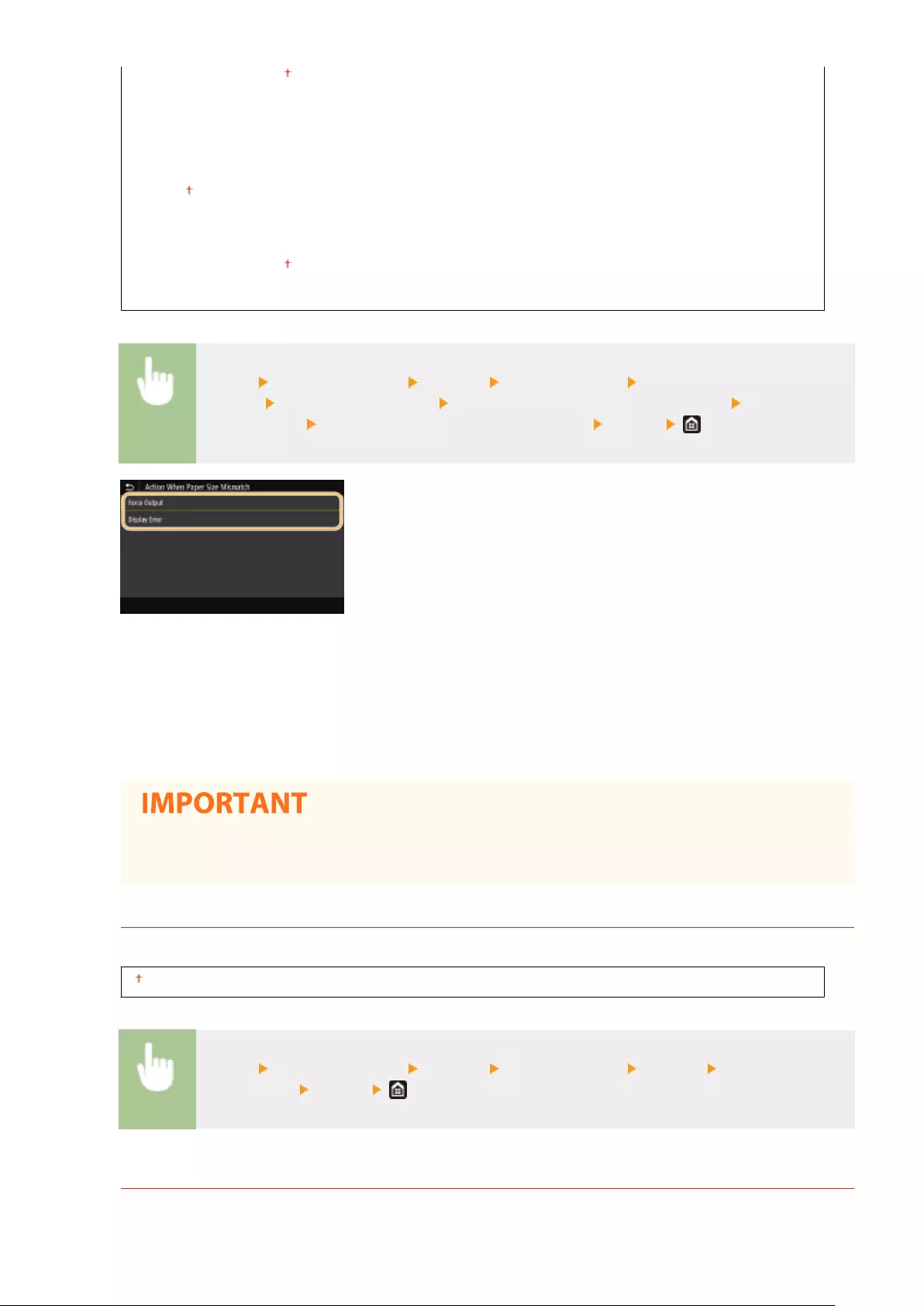
<Force Output>
<Display Error>
<Drawer 2> *1
<Prioritize Driver Settings>
<Off>
<On>
<Action When Size Mismatch>
<Force Output>
<Display Error>
<Menu> <Function Settings> <Printer> <Printer Settings> <Prioritize Driver Settings When
Printing> Select the paper source Select <On> in <Prioritize Driver Settings> <Action When
Size Mismatch> Select <Force Output> or <Display Error> <Apply>
<Force Output>
Continue printing even when the paper size setting in the printer driver and the loaded paper are largely
different.
<Display Error>
When the paper size setting in the printer driver and the loaded paper are largely different, an error message is
displayed and printing is stopped.
●If the printer driver's settings do not match the size and type of loaded paper with <On> selected, a
paper jam or printing error may occur.
<Copies>
Set the number of copies to print.
1 to 999
<Menu> <Function Settings> <Printer> <Printer Settings> <Copies> Set the number of
copies to print <Apply>
<2-Sided Printing>
Select whether to make 2-sided printouts.
Setting Menu List
510
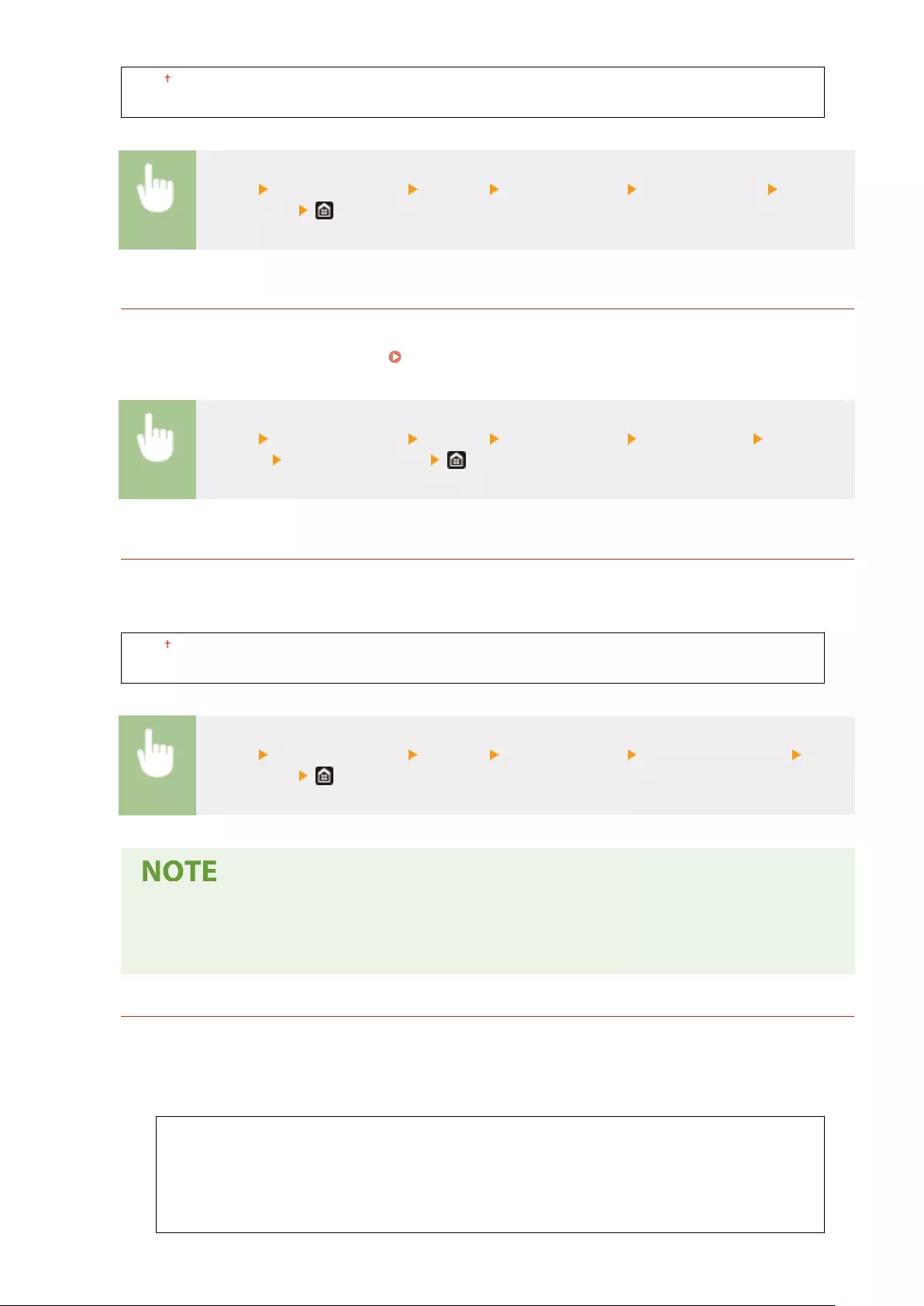
<Off>
<On>
<Menu> <Function Settings> <Printer> <Printer Settings> <2-Sided Printing> Select
<Off> or <On>
<Default Paper>
Set the default paper size and type. Printing will be performed with paper of the size and type set here when
you want to print from an OS not supporting printer drivers or from a mobile device or other device not
supporting paper size and type settings. Available Paper(P. 624)
<Menu> <Function Settings> <Printer> <Printer Settings> <Default Paper> Select the
paper size Select the paper type
<Paper Size Override>
Select whether to switch between printing on A4 and Letter size paper if one of these paper sizes is loaded but
the other is not. When you select <On>, if you specify A4 size paper to print from the computer but A4 size
paper is not loaded in the machine, it will print your document on Letter size paper.
<Off>
<On>
<Menu> <Function Settings> <Printer> <Printer Settings> <Paper Size Override> Select
<Off> or <On>
●You can specify print settings, such as the number of copies or 1-sided/2-sided printing, from an
application or the printer driver. However, the <Paper Size Override> setting can only be specied on
the machine.
<Print Quality>
You can change settings related to print quality.
<Density> *1
Adjust the toner density.
17 Levels
<Fine Adjust>
<High>/<Medium>/<Low>
17 Levels
Setting Menu List
511
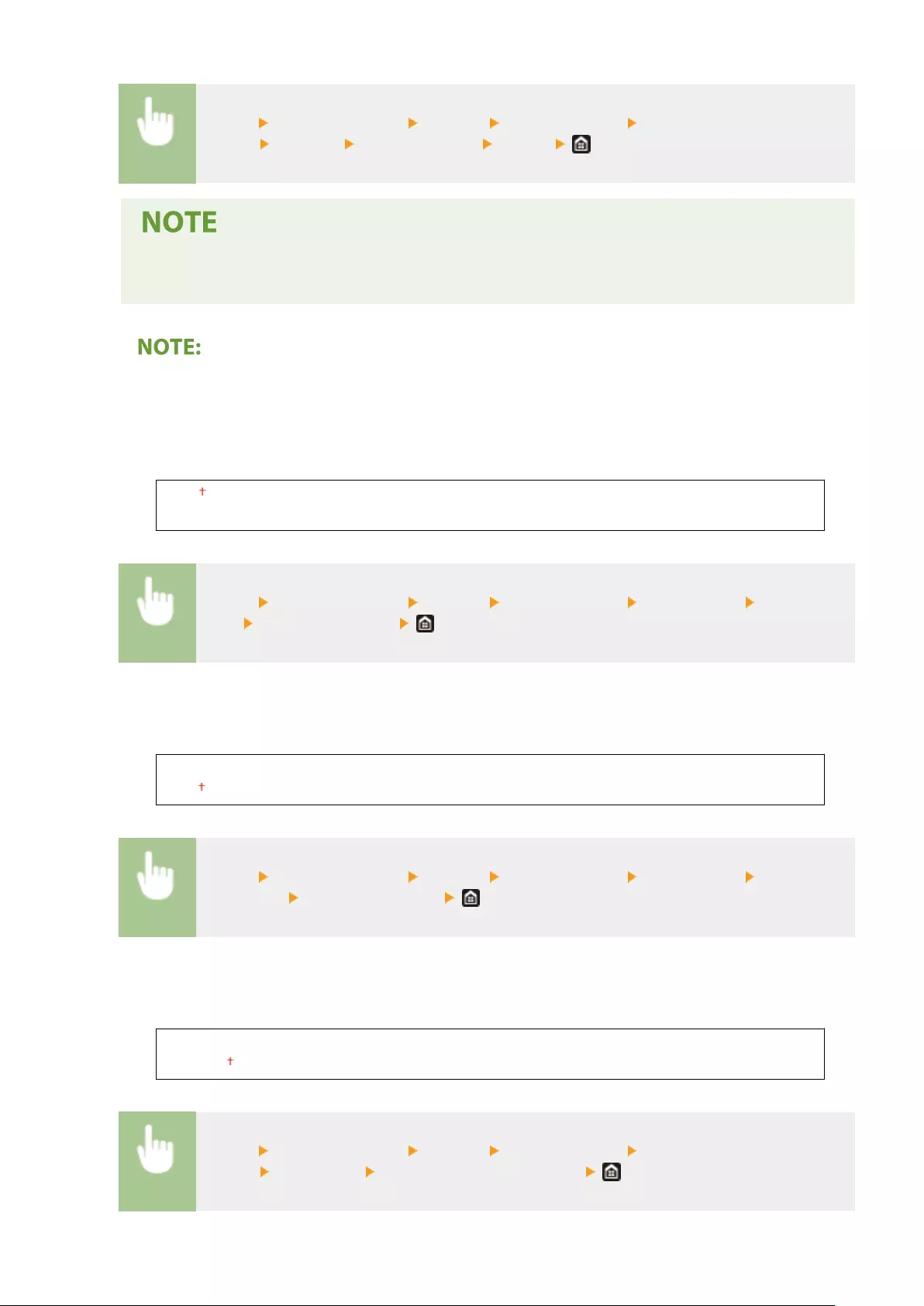
<Menu> <Function Settings> <Printer> <Printer Settings> <Print
Quality> <Density> Adjust the density <Apply>
●You can use <Fine Adjust> to adjust the toner density to three density levels: high density, medium
density, and low density.
●When <Toner Save> is set to <On>, you cannot set this item.
<Toner Save>
You can save toner consumption. Select <On> when you want to check the layout or other appearance
characteristics before proceeding to nal printing of a large job.
<Off>
<On>
<Menu> <Function Settings> <Printer> <Printer Settings> <Print Quality> <Toner
Save> Select <Off> or <On>
<Image Renement>
Enable or disable the smoothing mode in which the edges of characters and graphics are smoothly printed.
<Off>
<On>
<Menu> <Function Settings> <Printer> <Printer Settings> <Print Quality> <Image
Renement> Select <Off> or <On>
<Resolution>
Specify the resolution to be used for print data processing.
<1200 dpi>
<600 dpi>
<Menu> <Function Settings> <Printer> <Printer Settings> <Print
Quality> <Resolution> Select <1200 dpi> or <600 dpi>
Setting Menu List
512
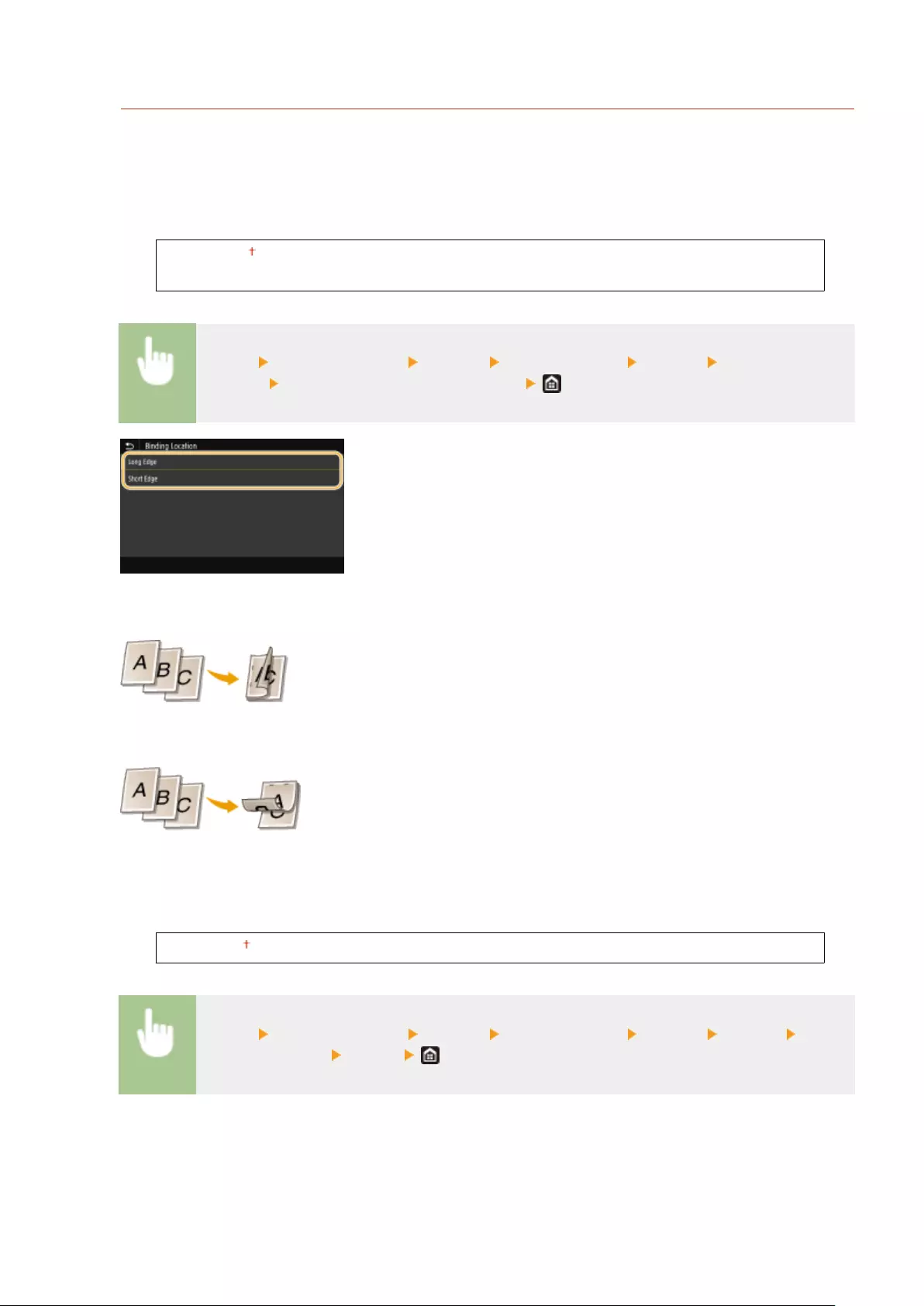
<Layout>
Specify the page layout settings such as binding position and margin values.
<Binding Location>
If you are binding the printouts with a binding tool such as a stapler, use this item to specify whether to bind
on the long or short edge. Specify the setting of this item in combination with <Gutter>, which species the
binding margin to apply to the binding position.
<Long Edge>
<Short Edge>
<Menu> <Function Settings> <Printer> <Printer Settings> <Layout> <Binding
Location> Select <Long Edge> or <Short Edge>
<Long Edge>
Specify this to bind on the long edge of paper.
<Short Edge>
Specify this to bind on the short edge of paper.
<Gutter>
Shift the print position to adjust the binding margin to apply to the binding edge specied by <Binding
Location>. The value "00.0" exerts no effect on the binding margin.
-50.0 to 00.0 to +50.0 (mm)
<Menu> <Function Settings> <Printer> <Printer Settings> <Layout> <Gutter> Specify
the binding margin <Apply>
Setting Menu List
513
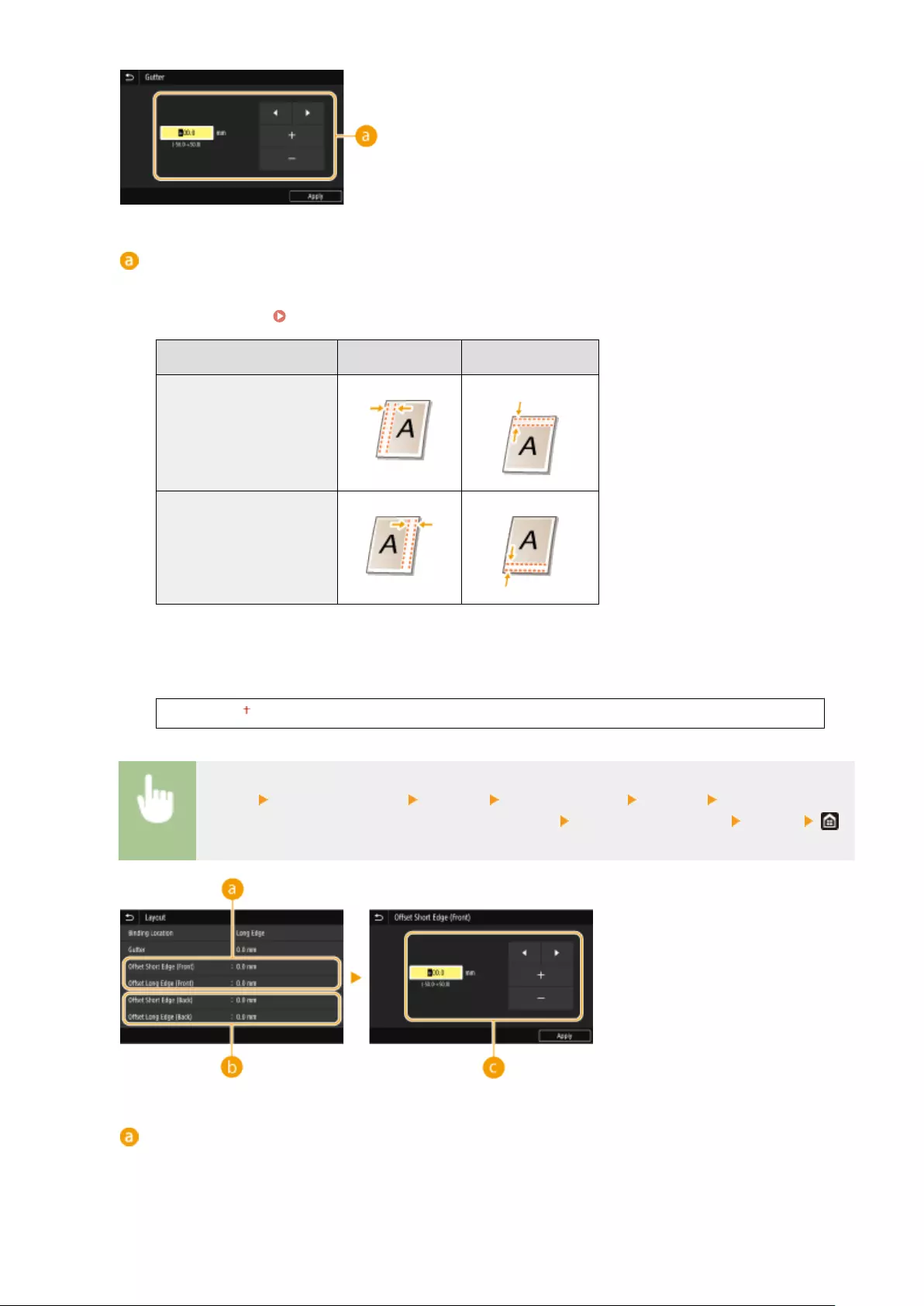
Entering the setting value
Specify the print position shift direction and shift width. Whether the setting value is a "+" or "-" value
determines the binding edge along which to adjust the binding margin. The margin width can be adjusted in
0.5 mm increments. Basic Operation(P. 130)
Setting Value Long Edge Short Edge
A value with a "+" sign Left edge of paper Top edge of paper
A value with a "-" sign Right edge of paper Bottom edge of paper
<Offset Short Edge/Offset Long Edge>
Irrespective of the paper source, you can shift the print position in units of "0.5 mm" for all print jobs.
-50.0 to 00.0 to +50.0 (mm)
<Menu> <Function Settings> <Printer> <Printer Settings> <Layout> Select the
combination of adjustment direction and printing side Specify the offset value <Apply>
<Offset Short Edge (Front)>/<Offset Long Edge (Front)>
Shifts the print position on the side of paper facing up.
Setting Menu List
514
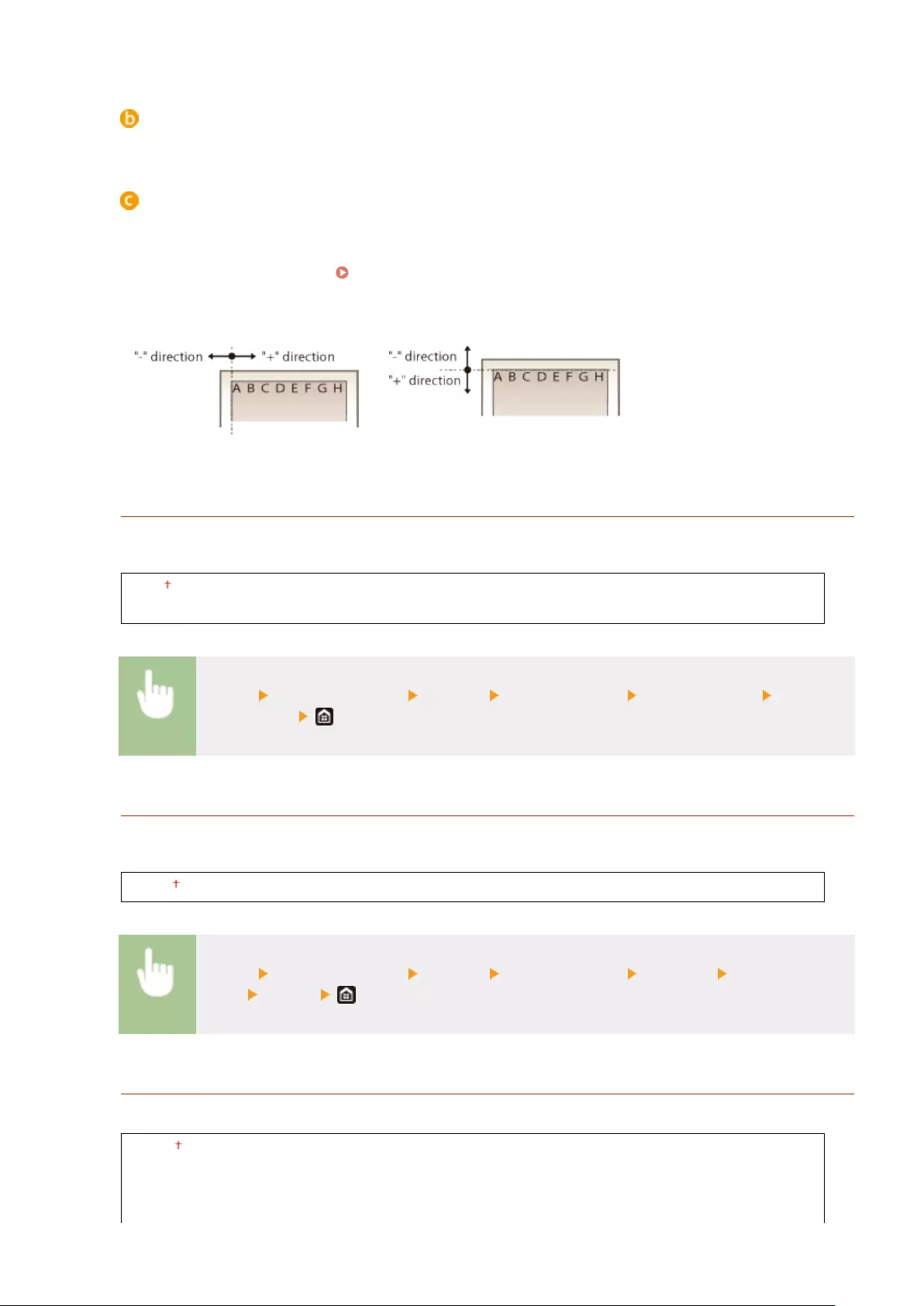
<Offset Short Edge (Back)>/<Offset Long Edge (Back)>
Shifts the print position on the side of paper facing down.
Entering the setting value
For <Offset Short Edge (Front)>/<Offset Short Edge (Back)>, specify a value with a "+" sign to shift the print
position in the left-to-right direction. For <Offset Long Edge (Front)>/<Offset Long Edge (Back)>, specify a
value with a "+" sign to shift the print position in the up-to-down direction. To shift in the reverse direction,
specify a value with a "-" sign. Basic Operation(P. 130)
<Offset Short Edge (Front)>
<Offset Short Edge (Back)>
<Offset Long Edge (Front)>
<Offset Long Edge (Back)>
<Auto Skip Error>
Printing stops if a certain error occurs in the process. However, if you set this item to <On>, the certain error will
be skipped and printing can continue. Normally, set this item to <Off>.
<Off>
<On>
<Menu> <Function Settings> <Printer> <Printer Settings> <Auto Skip Error> Select
<Off> or <On>
<Timeout>
Set the time period after which the current print job is automatically canceled in the case of a print data
reception interruption.
5 to 15 to 300 (sec.)
<Menu> <Function Settings> <Printer> <Printer Settings> <Timeout> Set the time
period <Apply>
<Personality>
Specify the mode in which the machine should operate when the format of document data is unknown.
<Auto>
<PS>
<PCL>
<PDF>
Setting Menu List
515
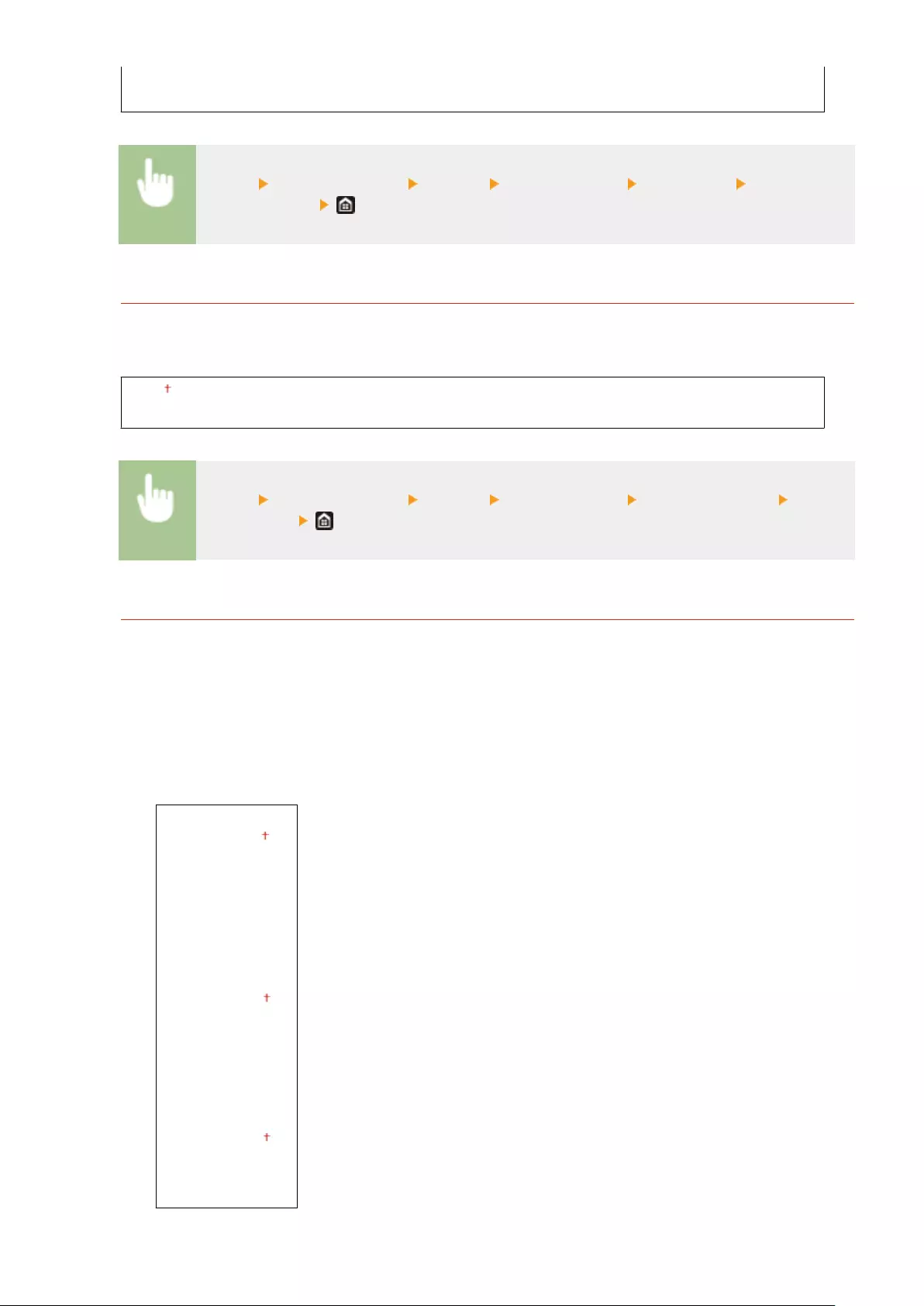
<XPS>
<Imaging>
<Menu> <Function Settings> <Printer> <Printer Settings> <Personality> Select the
Personality mode
<Prioritize MP Tray>
Specify whether to feed paper from the multi-purpose tray when Auto Select Paper is enabled. If <On> is
selected, paper is fed from the multi-purpose tray when paper of the same size and same type is loaded in both
the multi-purpose tray and paper drawer.
<Off>
<On>
<Menu> <Function Settings> <Printer> <Printer Settings> <Prioritize MP Tray> Select
<Off> or <On>
<UFR II>
You can change the settings that become effective when printing from the UFR II printer driver.
<Halftones>
You can select the printing method used to reproduce halftones (the intermediate range between the lighter
and darker areas of an image) for optimal image quality.
<Resolution/Gradation>
Select a method used to reproduce halftones. This option can be specied for each image type in any one
document.
<Text>
<Resolution>
<Color Tone>
<Gradation>
<High Resolution>
<Graphics>
<Resolution>
<Color Tone>
<Gradation>
<High Resolution>
<Image>
<Resolution>
<Color Tone>
<Gradation>
<High Resolution>
Setting Menu List
516
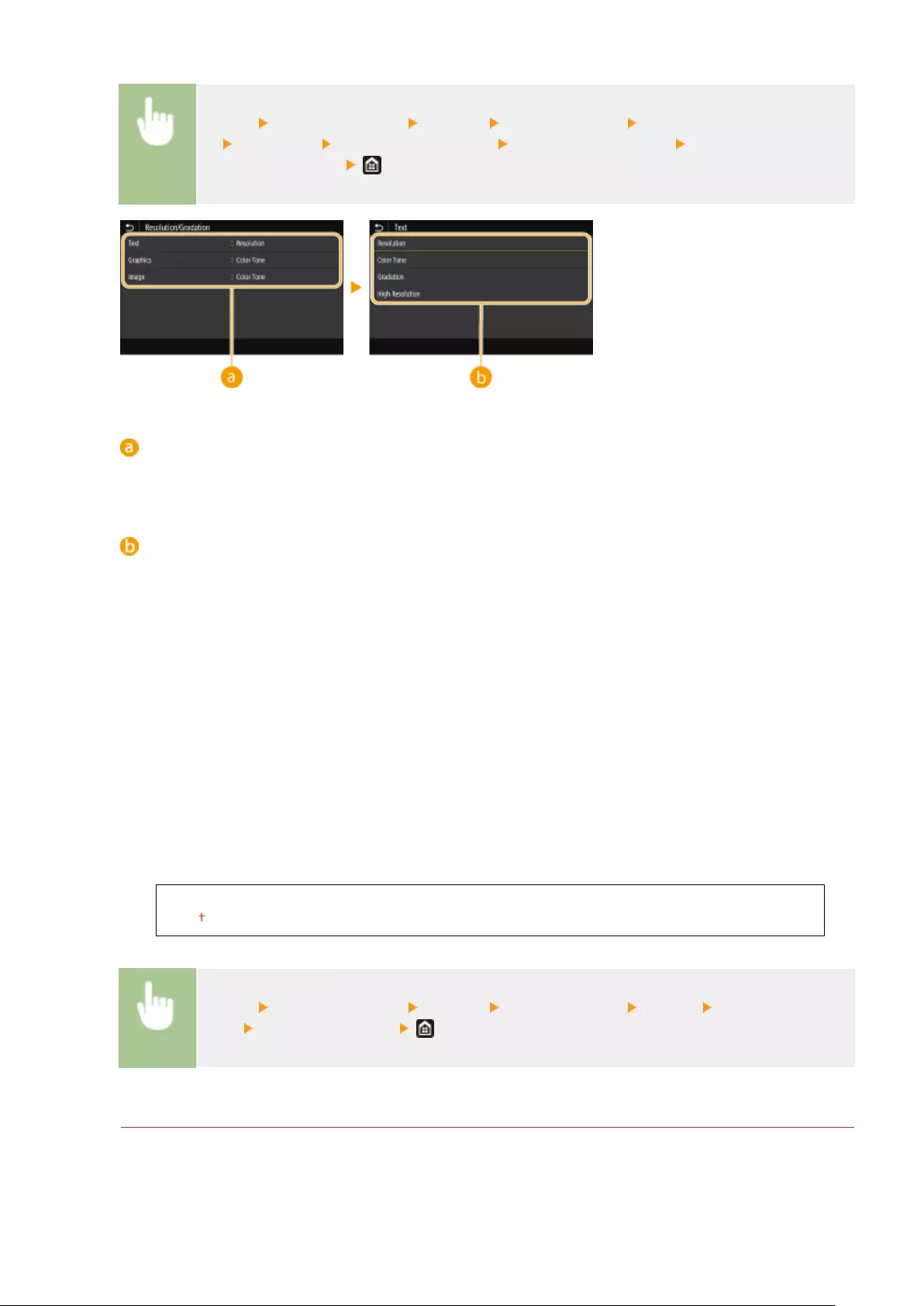
<Menu> <Function Settings> <Printer> <Printer Settings> <UFR
II> <Halftones> <Resolution/Gradation> Select the type of image Select the halftone
reproduction method
Type of image
Select the object for which to change the setting. <Text> represents letters and characters, <Graphics>
represents lines and gures, and <Image> represents photos and images.
Setting value
<Resolution>
Produces a ne print with clear edges of text. It is suitable for printing characters and ne lines.
<Color Tone>
Produces a sharp print with strong contrast of lightness and darkness. It is suitable for printing image data
such as photo image data.
<Gradation>
Produces a print with smooth gradation or smooth edges. It is suitable for printing gures or graphs
containing gradation areas.
<High Resolution>
As compared to <Resolution>, this produces a ner print but quality stability is slightly lower. It is suitable to
obtain a print of character data or ne line data or CAD data with sharp edges.
<Paper Save>
Specify whether to disable a blank page in print data from being output.
<Off>
<On>
<Menu> <Function Settings> <Printer> <Printer Settings> <UFR II> <Paper
Save> Select <Off> or <On>
<PCL>
Specify the PCL printing settings such as page layout and print quality.
<Paper Save>
Specify whether to disable a blank page in print data from being output.
Setting Menu List
517
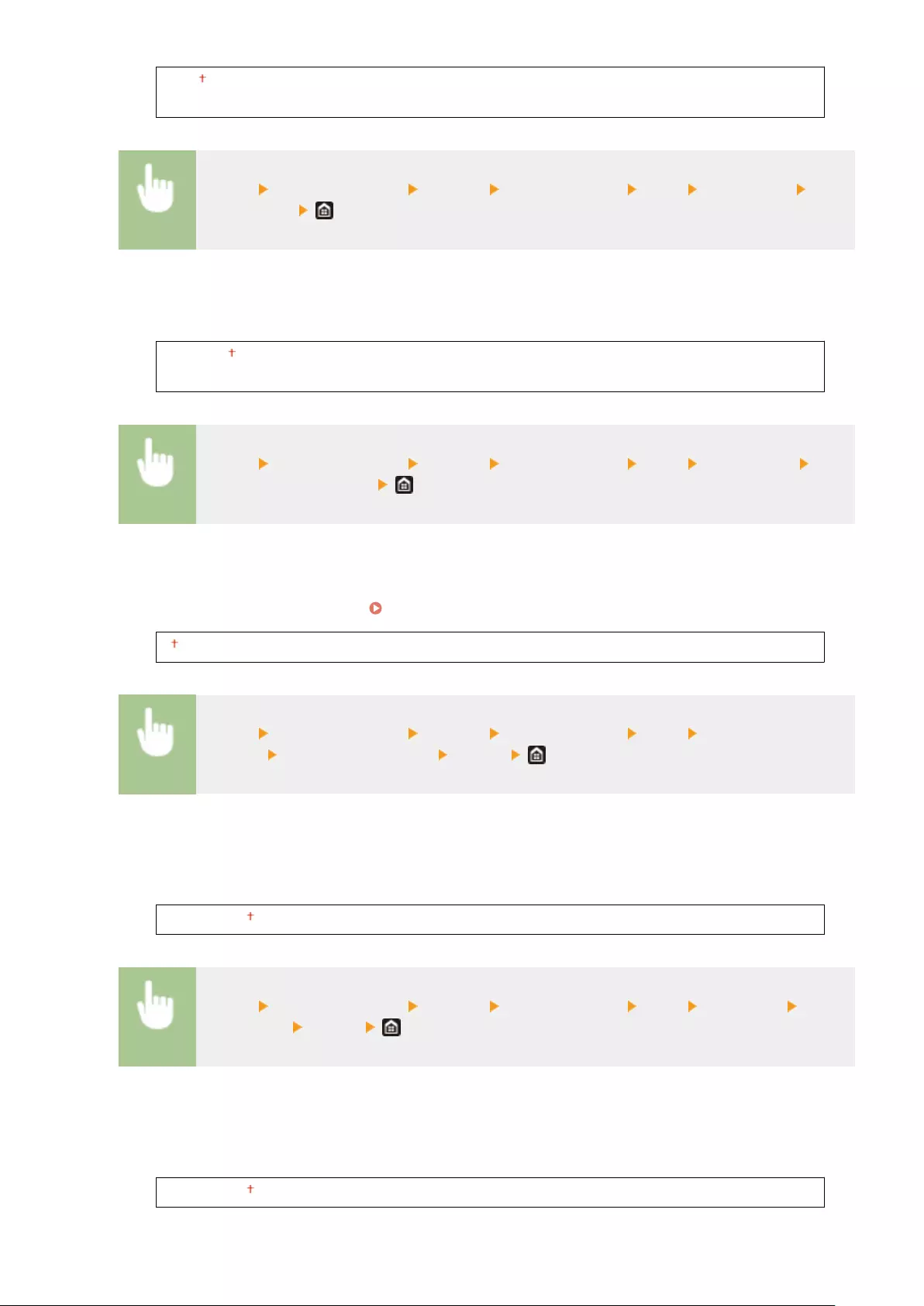
<Off>
<On>
<Menu> <Function Settings> <Printer> <Printer Settings> <PCL> <Paper Save> Select
<Off> or <On>
<Orientation>
Select <Portrait> (vertical orientation) or <Landscape> (horizontal orientation) for the page orientation.
<Portrait>
<Landscape>
<Menu> <Function Settings> <Printer> <Printer Settings> <PCL> <Orientation> Select
<Portrait> or <Landscape>
<Font Number>
Specify the font to use by selecting a corresponding font ID number. You can print the PCL font list with font
samples from the operation panel. PCL Font List(P. 601)
0 to 104
<Menu> <Function Settings> <Printer> <Printer Settings> <PCL> <Font
Number> Select the font number <Apply>
<Point Size> *1
Set the font size in points, adjustable in 0.25 increments. You can specify this setting only when a
proportionally-spaced scalable font is selected in <Font Number>.
4.00 to 12.00 to 999.75 (point)
<Menu> <Function Settings> <Printer> <Printer Settings> <PCL> <Point Size> Specify
the point size <Apply>
<Pitch> *1
Set the font pitch, or cpi (characters per inch), adjustable in 0.01 increments. You can specify this setting only
when a xed-pitch scalable font or a bitmap font is selected in <Font Number>.
0.44 to 10.00 to 99.99 (cpi)
Setting Menu List
518
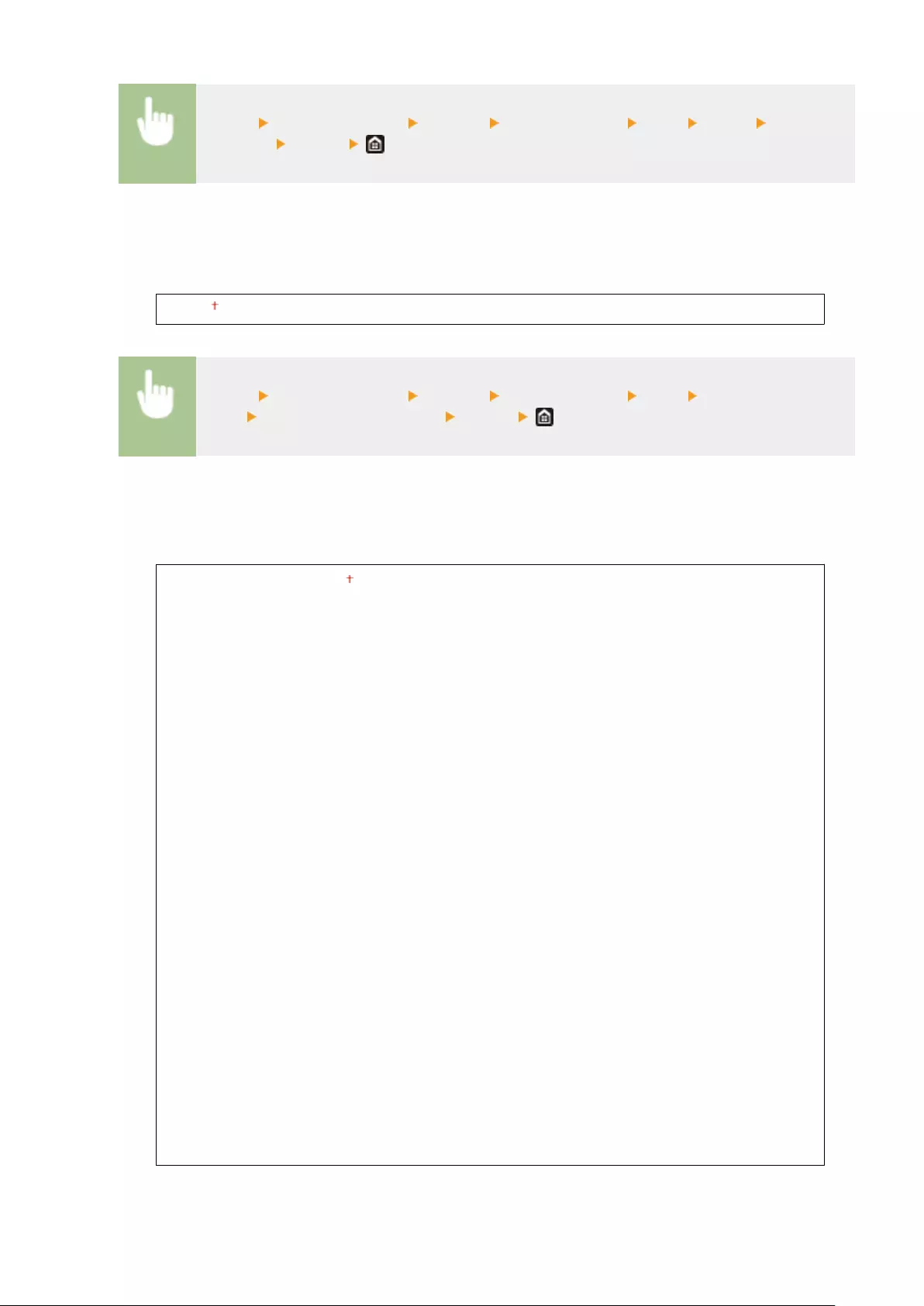
<Menu> <Function Settings> <Printer> <Printer Settings> <PCL> <Pitch> Specify the
pitch value <Apply>
<Form Lines>
Set the number of lines printed on one page from 5 to 128. This setting is automatically changed according
to the settings specied in <Default Paper Size> and <Orientation>.
5 to 64 to 128 (lines)
<Menu> <Function Settings> <Printer> <Printer Settings> <PCL> <Form
Lines> Specify the number of lines <Apply>
<Character Code>
Select the character code that is most suited for the computer you send print data from. The specied setting
is ignored when the character code is controlled by the font specied in <Font Number>.
<ARABIC8>
<DESKTOP>
<GREEK8>
<HEBREW7>
<HEBREW8>
<ISO4>
<ISO6>
<ISO11>
<ISO15>
<ISO17>
<ISO21>
<ISO60>
<ISO69>
<ISOCYR>
<ISOGRK>
<ISOHEB>
<ISOL1>
<ISOL2>
<ISOL5>
<ISOL6>
<ISOL9>
<LEGAL>
<MATH8>
<MCTEXT>
<MSPUBL>
<PC775>
<PC8>
<PC850>
<PC851>
<PC852>
<PC858>
<PC862>
<PC864>
<PC866>
<PC8DN>
<PC8GRK>
<PC8TK>
<PC1004>
<PIFONT>
<PSMATH>
<PSTEXT>
<ROMAN8>
<ROMAN9>
<VNINTL>
<VNMATH>
<VNUS>
<WIN30>
<WINARB>
<WINBALT>
<WINCYR>
<WINGRK>
<WINL1>
<WINL2>
<WINL5>
Setting Menu List
519
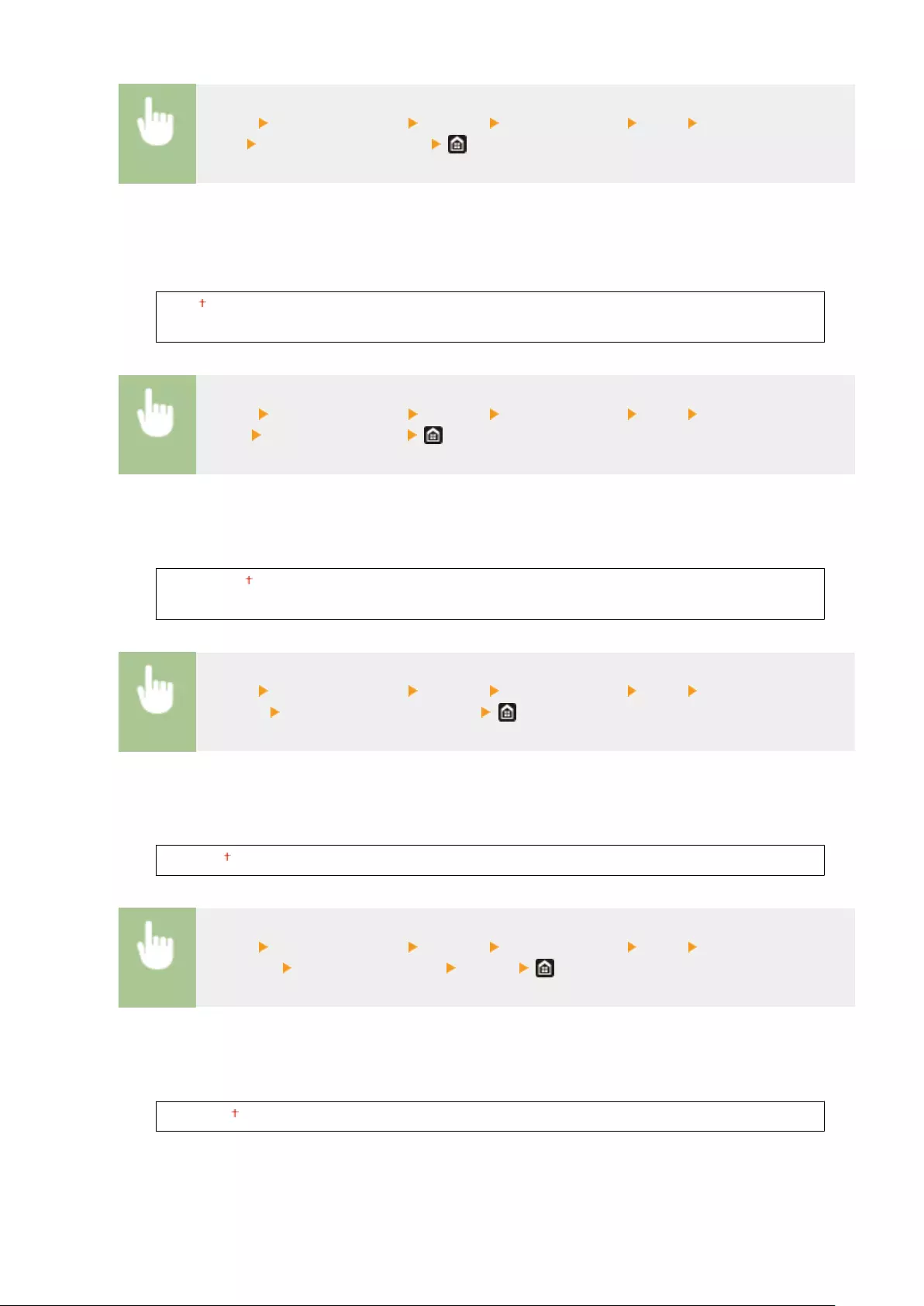
<Menu> <Function Settings> <Printer> <Printer Settings> <PCL> <Character
Code> Select the character code
<Custom Paper>
Select whether to set a custom paper size. Select <On> to set the dimensions of the paper in <X dimension>
and <Y dimension>.
<Off>
<On>
<Menu> <Function Settings> <Printer> <Printer Settings> <PCL> <Custom
Paper> Select <Off> or <On>
<Unit of Measure> *1
Select the unit of measurement to use to set a custom paper size.
<Millimeter>
<Inch>
<Menu> <Function Settings> <Printer> <Printer Settings> <PCL> <Unit of
Measure> Select <Millimeter> or <Inch>
<X dimension> *1
Specify the horizontal dimension (short edge) of the custom paper.
77 to 216 (mm)
<Menu> <Function Settings> <Printer> <Printer Settings> <PCL> <X
dimension> Specify the dimension <Apply>
<Y dimension> *1
Specify the vertical dimension (long edge) of the custom paper.
127 to 355 (mm)
Setting Menu List
520
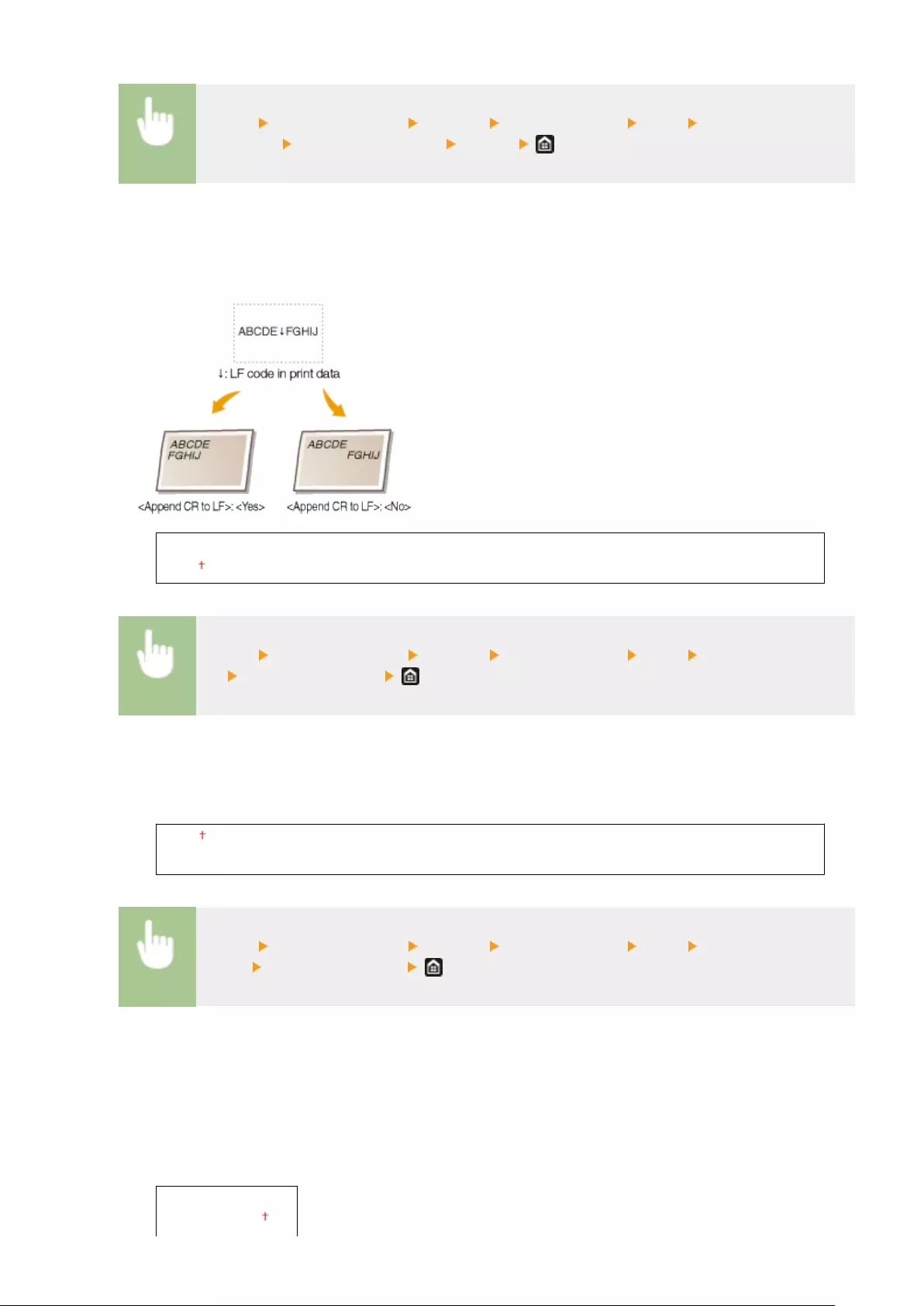
<Menu> <Function Settings> <Printer> <Printer Settings> <PCL> <Y
dimension> Specify the dimension <Apply>
<Append CR to LF>
Select whether to append a carriage return (CR) when the machine receives a line feed code (LF). If <Yes> is
selected, the print position moves to the beginning of the next line when the machine receives an LF code. If
<No> is selected, the print position moves to the next line, just under the received LF code.
<Yes>
<No>
<Menu> <Function Settings> <Printer> <Printer Settings> <PCL> <Append CR to
LF> Select <Yes> or <No>
<Enlarge A4 Print Width>
Select whether to expand the width of the printable area of A4 size paper in portrait orientation to that of
Letter size.
<Off>
<On>
<Menu> <Function Settings> <Printer> <Printer Settings> <PCL> <Enlarge A4 Print
Width> Select <Off> or <On>
<Halftones>
You can select the printing method used to reproduce halftones (the intermediate range between the lighter
and darker areas of an image) for optimal image quality.
<Resolution/Gradation>
Select a method used to reproduce halftones. This option can be specied for each image type in any one
document.
<Text>
<Resolution>
Setting Menu List
521
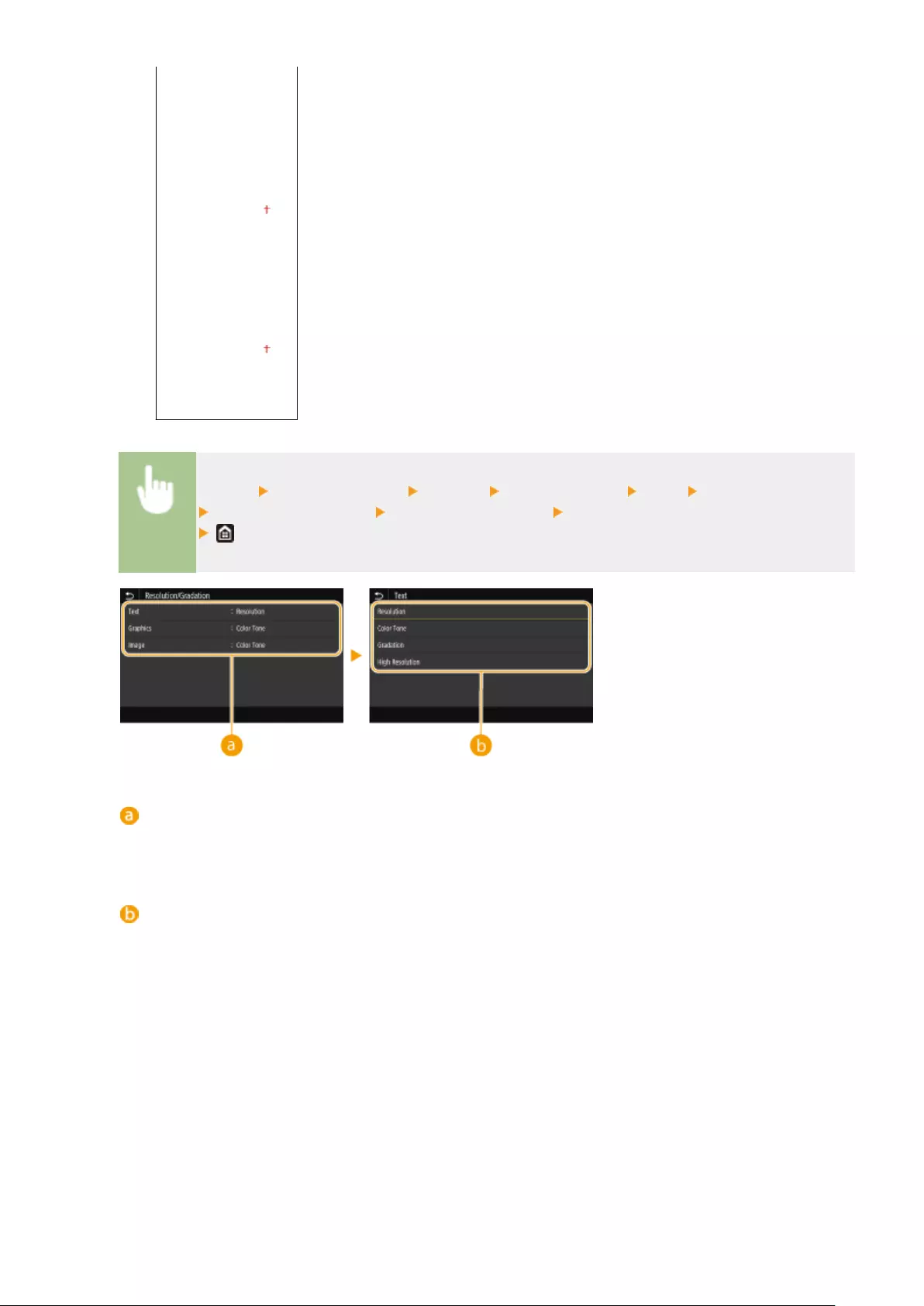
<Color Tone>
<Gradation>
<High Resolution>
<Graphics>
<Resolution>
<Color Tone>
<Gradation>
<High Resolution>
<Image>
<Resolution>
<Color Tone>
<Gradation>
<High Resolution>
<Menu> <Function Settings> <Printer> <Printer Settings> <PCL> <Halftones>
<Resolution/Gradation> Select the type of image Select the halftone reproduction method
Type of image
Select the object for which to change the setting. <Text> represents letters and characters, <Graphics>
represents lines and gures, and <Image> represents photos and images.
Setting value
<Resolution>
Produces a ne print with clear edges of text. It is suitable for printing characters and ne lines.
<Color Tone>
Produces a sharp print with strong contrast of lightness and darkness. It is suitable for printing image data
such as photo image data.
<Gradation>
Produces a print with smooth gradation or smooth edges. It is suitable for printing gures or graphs
containing gradation areas.
<High Resolution>
As compared to <Resolution>, this produces a ner print but quality stability is slightly lower. It is suitable to
obtain a print of character data or ne line data or CAD data with sharp edges.
Setting Menu List
522
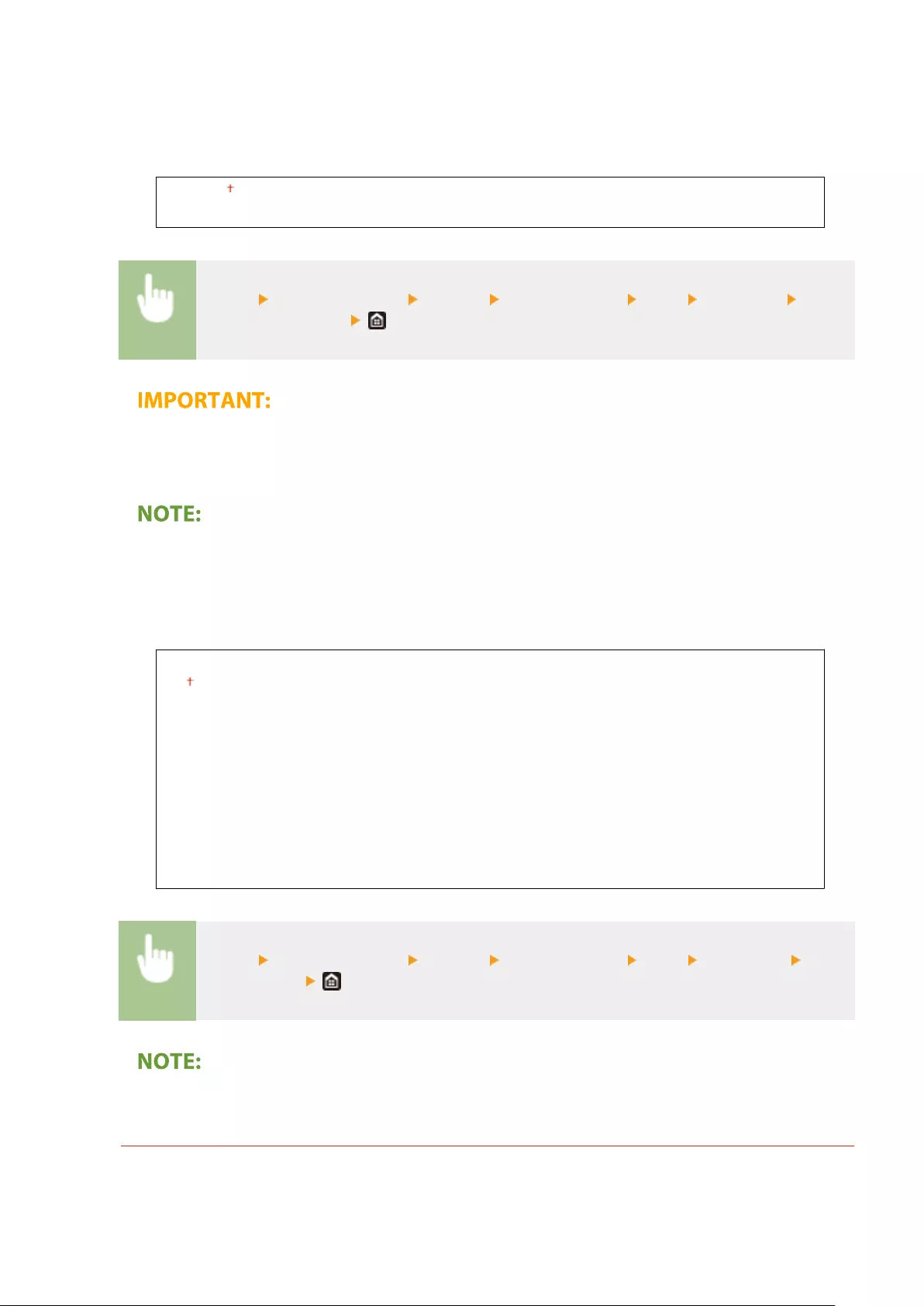
<BarDIMM> *1
This setting enables you to print bar codes supported by the Barcode Printing Kit. If <Enable> is selected, the
machine will generate bar codes when it receives bar code commands from the host computer. If <Disable>
is selected, bar codes will not be generated, even if bar code commands are sent from the host computer.
<Disable>
<Enable>
<Menu> <Function Settings> <Printer> <Printer Settings> <PCL> <BarDIMM> Select
<Disable> or <Enable>
●To enable the BarDIMM menu, it is necessary to activate the Barcode Printing Kit. When you are not
printing bar codes, make sure to disable the BarDIMM menu. Otherwise, the processing speed of regular
print jobs may be reduced.
●The default setting is <Disable>. If you activate the Barcode Printing Kit, it changes to <Enable>.
<FreeScape> *1
Specify the AEC (Alternate Escape Code) to be used for bar code commands when the host computer does
not support the standard Escape Code.
<Off>
<~>
<">
<#>
<$>
</>
<\>
<?>
<{>
<}>
<|>
<Menu> <Function Settings> <Printer> <Printer Settings> <PCL> <FreeScape> Select
an escape code
●This setting is available only when <BarDIMM> is enabled.
<PS>
Specify the PS printing settings such as page layout and print quality.
Setting Menu List
523
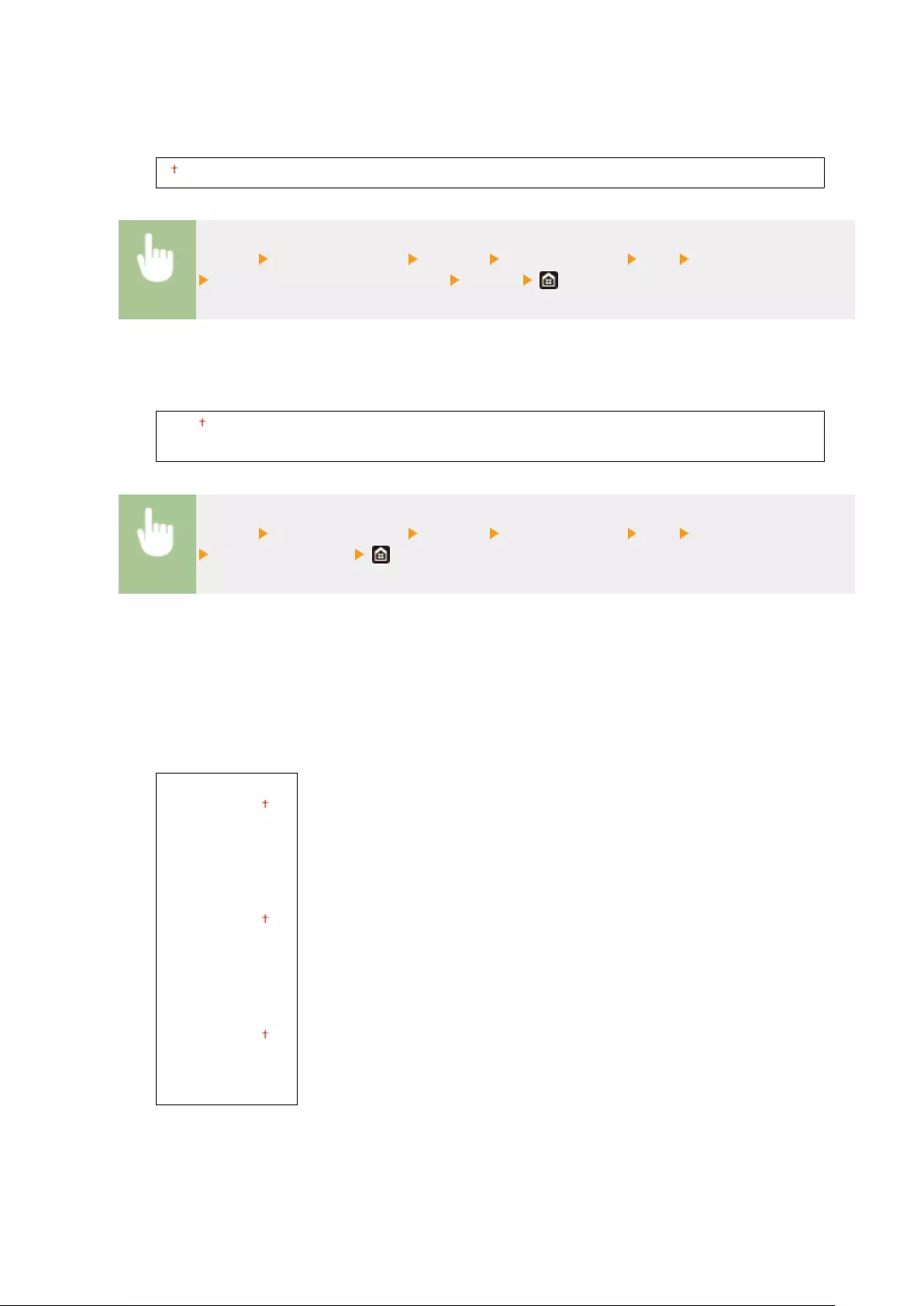
<Job Timeout>
This setting enables you to specify the amount of time before a job times out. If a job has not nished within
the set time limit, the job automatically cancels.
0 to 3600 (sec.)
<Menu> <Function Settings> <Printer> <Printer Settings> <PS> <Job Timeout>
Specify the seconds for job timeout <Apply>
<Print PS Errors>
This setting determines whether an error page is printed when an error is encountered.
<Off>
<On>
<Menu> <Function Settings> <Printer> <Printer Settings> <PS> <Print PS Errors>
Select <Off> or <On>
<Halftones>
You can select the printing method used to reproduce halftones (the intermediate range between the lighter
and darker areas of an image) for optimal image quality.
<Resolution/Gradation>
Select a method used to reproduce halftones. This option can be specied for each image type in any one
document.
<Text>
<Resolution>
<Gradation>
<High Resolution>
<Graphics>
<Resolution>
<Gradation>
<High Resolution>
<Image>
<Resolution>
<Gradation>
<High Resolution>
Setting Menu List
524
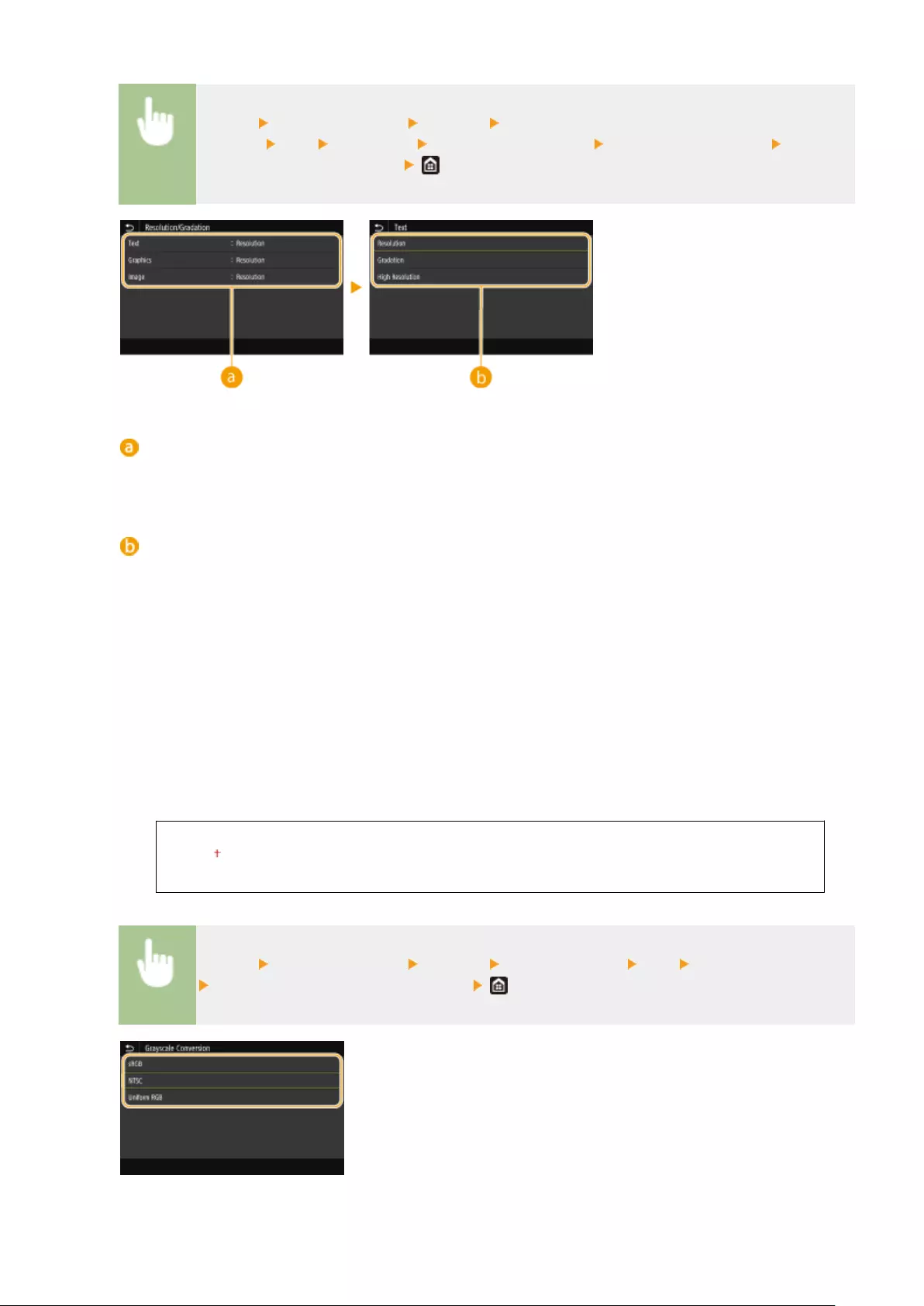
<Menu> <Function Settings> <Printer> <Printer
Settings> <PS> <Halftones> <Resolution/Gradation> Select the type of image Select the
halftone reproduction method
Type of image
Select the object for which to change the setting. <Text> represents letters and characters, <Graphics>
represents lines and gures, and <Image> represents photos and images.
Setting value
<Resolution>
Produces a print with smooth gradation or smooth edges. It is suitable for printing gures or graphs
containing gradation areas.
<Gradation>
Produces a sharp print with strong contrast of lightness and darkness. It is suitable for printing image data
such as photo image data.
<High Resolution>
Produces a ne print with clear edges of text. It is suitable for printing characters and ne lines.
<Grayscale Conversion>
Specify the way of printing color data in black and white.
<sRGB>
<NTSC>
<Uniform RGB>
<Menu> <Function Settings> <Printer> <Printer Settings> <PS> <Grayscale Conversion>
Select the type of grayscale conversion
<sRGB>
Setting Menu List
525
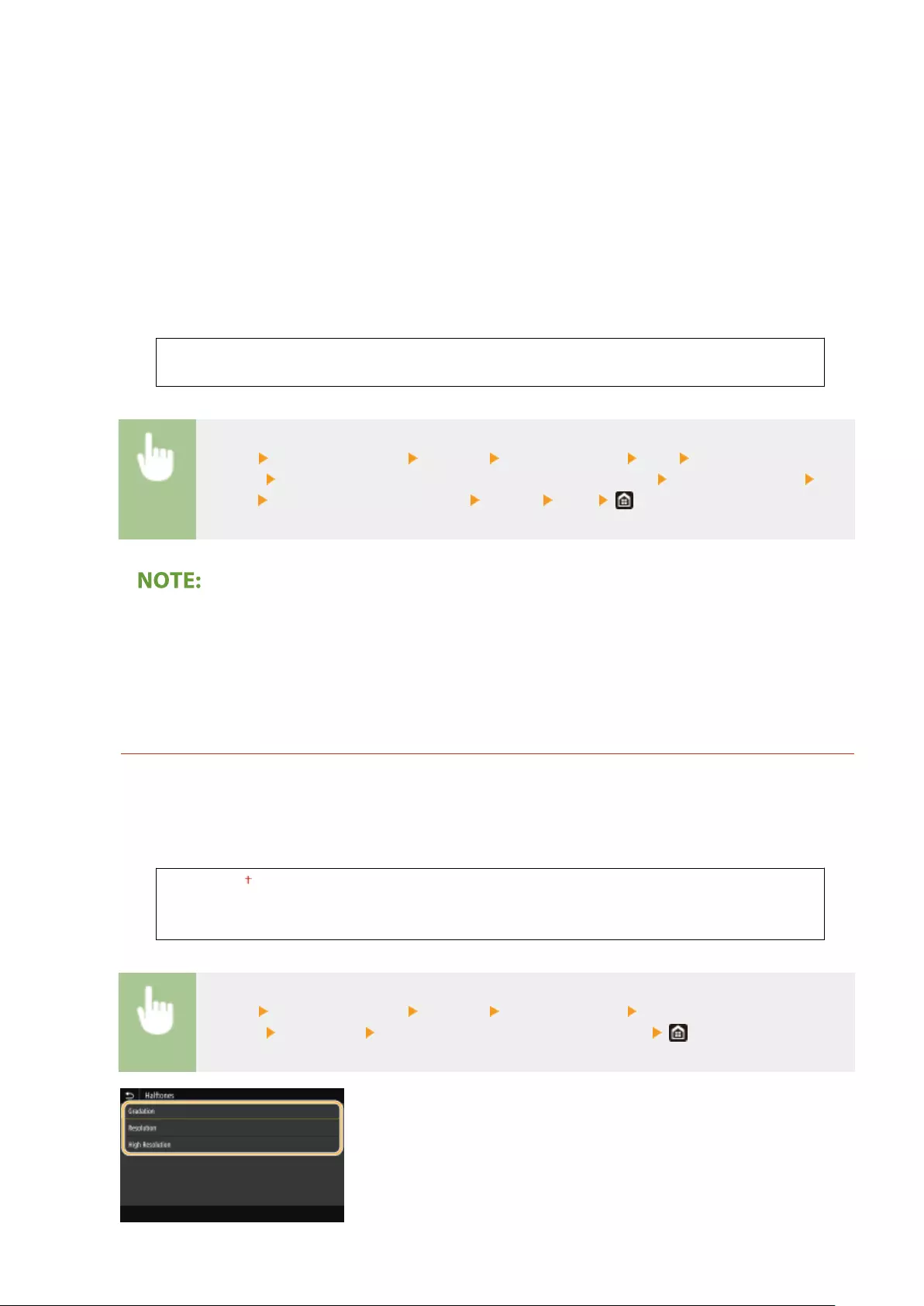
Prints in black and white with emphasis on color differences so that a smooth gradation is achieved.
<NTSC>
Prints in black and white so that the resulting image looks like a black and white television picture (of the NTSC
system).
<Uniform RGB>
Prints in black and white so that R, G, and B are uniformly converted to the same gray level by using only
brightness as the reference.
<PS Password Settings>
You can specify the password that restricts the use of the control command prepared by the PS printer.
<SystemParamsPassword>
<StartJobPassword>
<Menu> <Function Settings> <Printer> <Printer Settings> <PS> <PS Password
Settings> Select <SystemParamsPassword> or <StartJobPassword> Enter the password
<Apply> Enter the password (Conrm) <Apply> <OK>
●<SystemParamsPassword> is a password that allows changes to the system parameter, and
<StartJobPassword> is a password that allows startjob, exitserver operator to perform. For more
information, check PostScript language specications.
●If <StartJobPassword> is set but <SystemParamsPassword> is not set, password check will not be
performed while performing startjob, exitserver operator.
<Imaging Settings>
You can change the print settings that will apply when printing image les (JPEG/TIFF).
<Halftones>
You can change the printing method used to reproduce halftones (the intermediate range between the
lighter and darker areas of an image) for optimal image quality.
<Gradation>
<Resolution>
<High Resolution>
<Menu> <Function Settings> <Printer> <Printer Settings> <Imaging
Settings> <Halftones> Select the halftone reproduction method
Setting Menu List
526
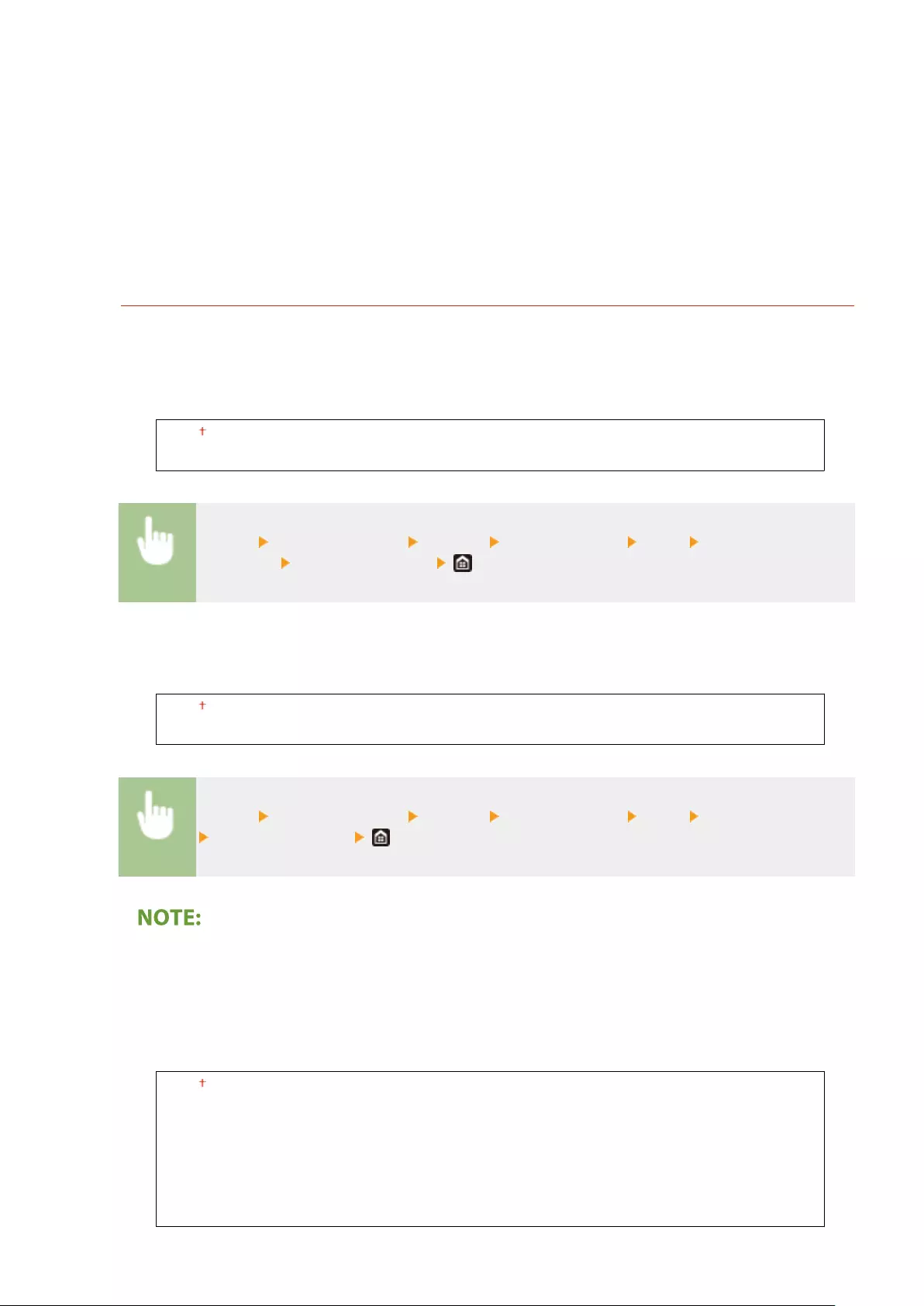
<Gradation>
Produces a sharp print with strong contrast of lightness and darkness. It is suitable for printing image data such
as photo image data.
<Resolution>
Produces a print with smooth gradation or smooth edges. It is suitable for printing gures or graphs containing
gradation areas.
<High Resolution>
Produces a ne print with clear edges of text. It is suitable for printing characters and ne lines.
<PDF>
You can change settings for PDF les.
<Enlarge/Reduce to Fit Paper Size>
Specify whether to enlarge or reduce the original according to the print range of paper. Note that size
enlargement/reduction will not affect the aspect ratio of the original.
<Off>
<On>
<Menu> <Function Settings> <Printer> <Printer Settings> <PDF> <Enlarge/Reduce to Fit
Paper Size> Select <Off> or <On>
<Enlarge Print Area>
Specify whether to extend the print range to the paper size.
<Off>
<On>
<Menu> <Function Settings> <Printer> <Printer Settings> <PDF> <Enlarge Print Area>
Select <Off> or <On>
●If you specify <On>, it may occur that edge-adjacent portions of page are not printed or that printouts
come out partially smudged depending on the original.
<N on 1>
Specify whether to shrink multiple pages and print them on one page in such arrangement that the rst
page is positioned at top left. For example, to print 4 pages onto a single sheet, select <4 on 1>.
<Off>
<2 on 1>
<4 on 1>
<6 on 1>
<8 on 1>
<9 on 1>
<16 on 1>
Setting Menu List
527
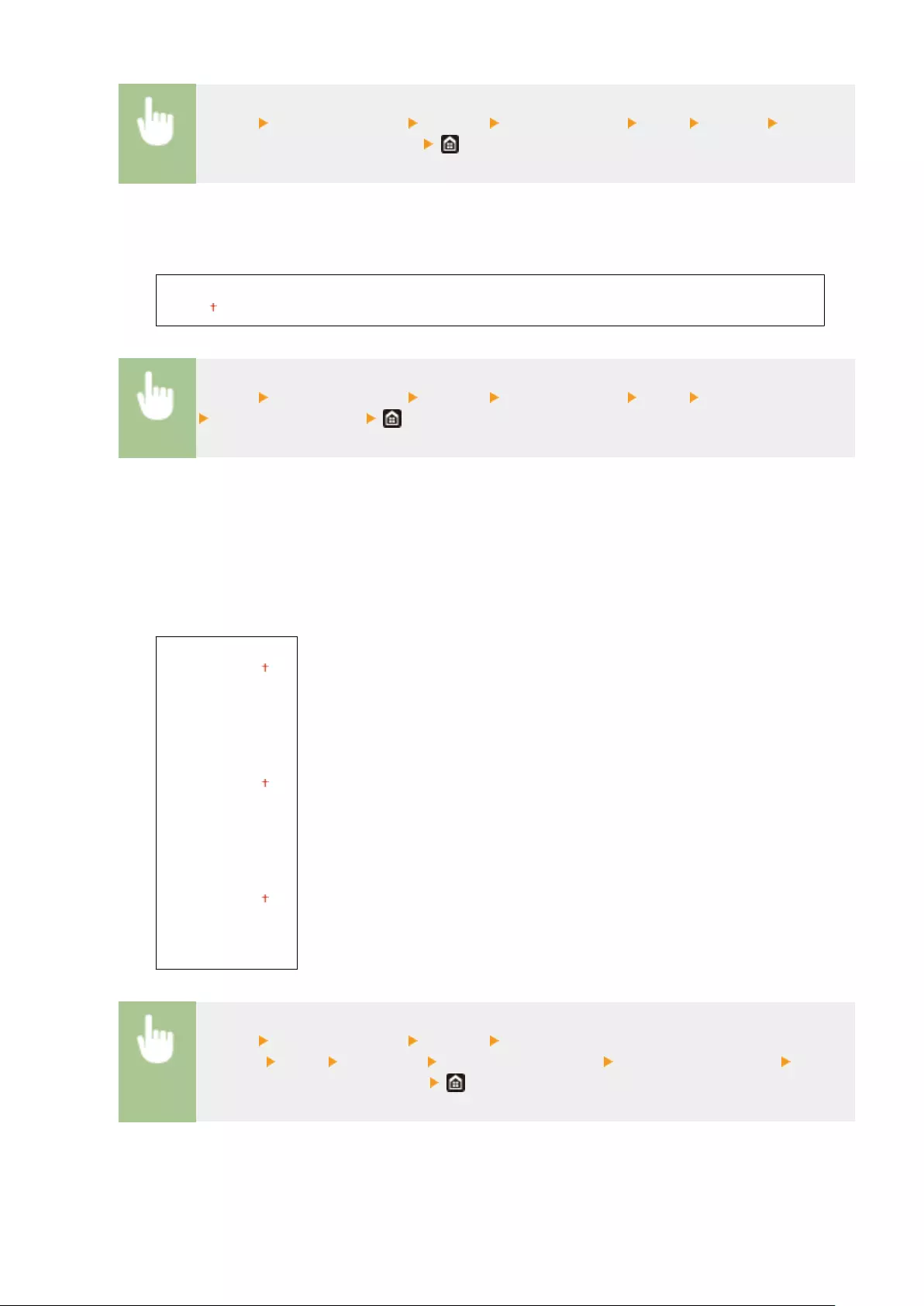
<Menu> <Function Settings> <Printer> <Printer Settings> <PDF> <N on 1> Select the
number of pages to be combined
<Print Comments>
Specify whether to print comments. If you specify <Auto>, comments in PDF les will be printed.
<Off>
<Auto>
<Menu> <Function Settings> <Printer> <Printer Settings> <PDF> <Print Comments>
Select <Off> or <Auto>
<Halftones>
You can select the printing method used to reproduce halftones (the intermediate range between the lighter
and darker areas of an image) for optimal image quality.
<Resolution/Gradation>
Select a method used to reproduce halftones. This option can be specied for each image type in any one
document.
<Text>
<Resolution>
<Gradation>
<High Resolution>
<Graphics>
<Resolution>
<Gradation>
<High Resolution>
<Image>
<Resolution>
<Gradation>
<High Resolution>
<Menu> <Function Settings> <Printer> <Printer
Settings> <PDF> <Halftones> <Resolution/Gradation> Select the type of image Select
the halftone reproduction method
Setting Menu List
528
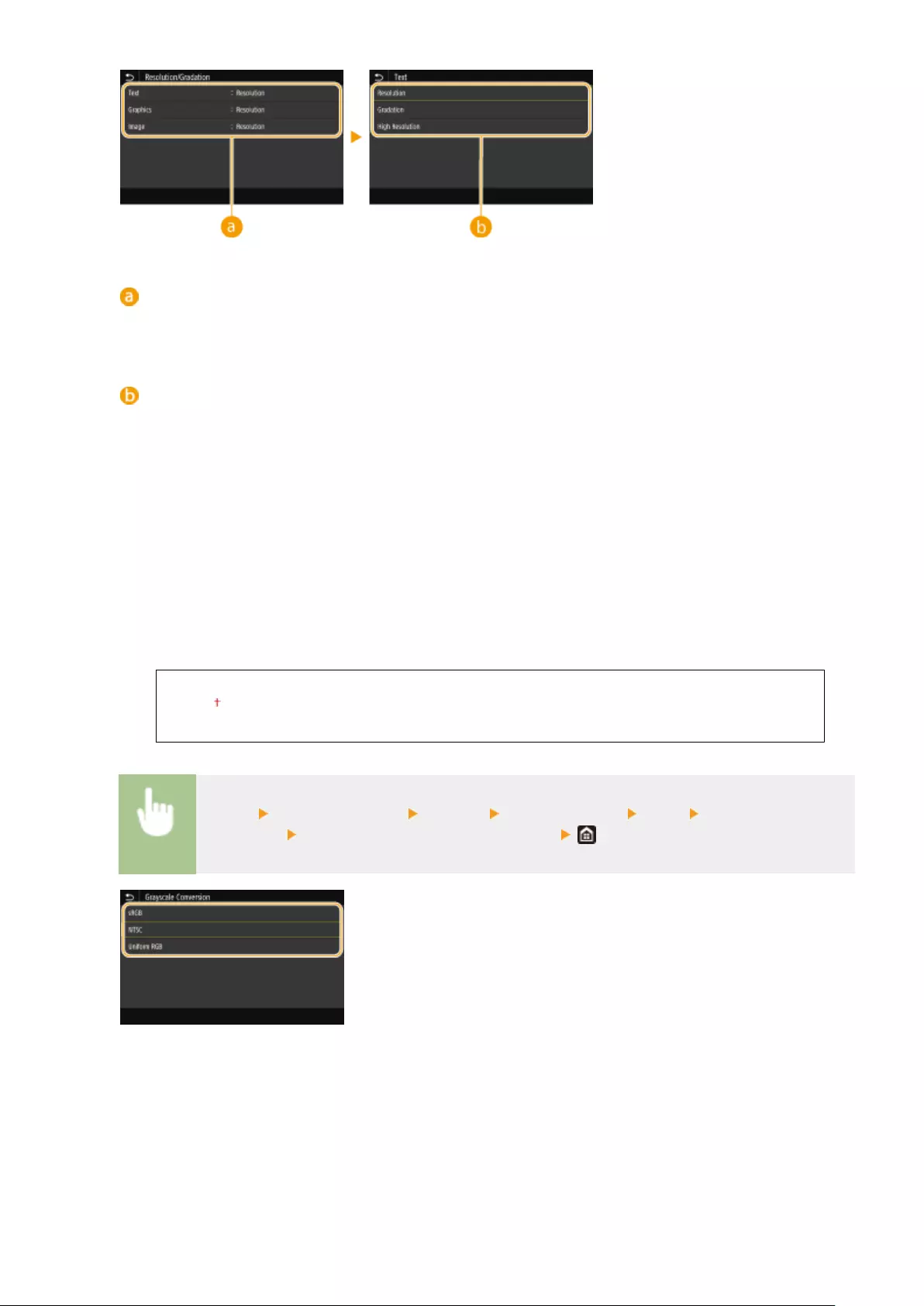
Type of image
Select the object for which to change the setting. <Text> represents letters and characters, <Graphics>
represents lines and gures, and <Image> represents photos and images.
Setting value
<Resolution>
Produces a print with smooth gradation or smooth edges. It is suitable for printing gures or graphs
containing gradation areas.
<Gradation>
Produces a sharp print with strong contrast of lightness and darkness. It is suitable for printing image data
such as photo image data.
<High Resolution>
Produces a ne print with clear edges of text. It is suitable for printing characters and ne lines.
<Grayscale Conversion>
Specify the way of printing color data in black and white.
<sRGB>
<NTSC>
<Uniform RGB>
<Menu> <Function Settings> <Printer> <Printer Settings> <PDF> <Grayscale
Conversion> Select the type of grayscale conversion
<sRGB>
Prints in black and white with emphasis on color differences so that a smooth gradation is achieved.
<NTSC>
Prints in black and white so that the resulting image looks like a black and white television picture (of the NTSC
system).
<Uniform RGB>
Setting Menu List
529
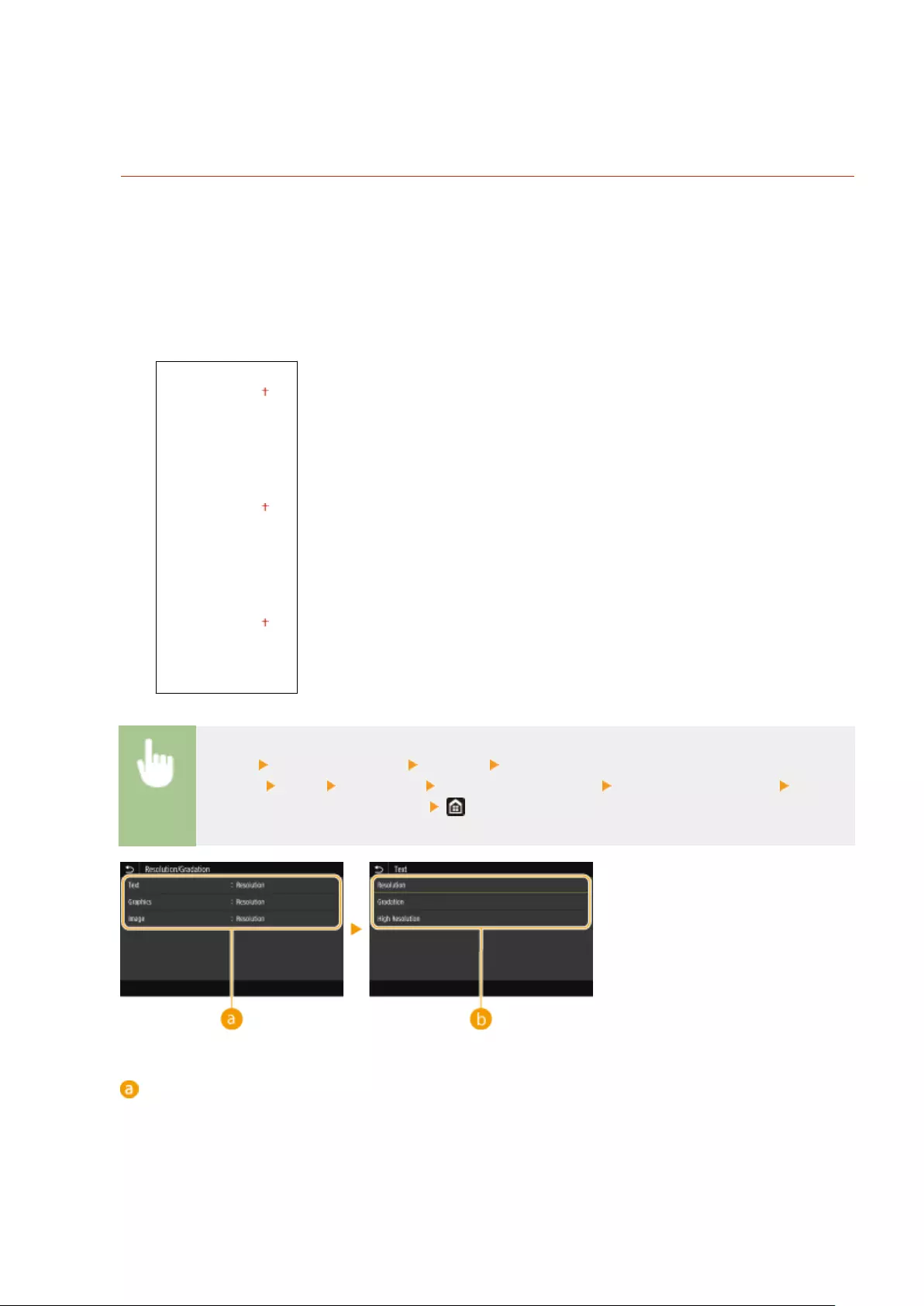
Prints in black and white so that R, G, and B are uniformly converted to the same gray level by using only
brightness as the reference.
<XPS>
You can change settings for XPS les.
<Halftones>
You can select the printing method used to reproduce halftones (the intermediate range between the lighter
and darker areas of an image) for optimal image quality.
<Resolution/Gradation>
Select a method used to reproduce halftones. This option can be specied for each image type in any one
document.
<Text>
<Resolution>
<Gradation>
<High Resolution>
<Graphics>
<Resolution>
<Gradation>
<High Resolution>
<Image>
<Resolution>
<Gradation>
<High Resolution>
<Menu> <Function Settings> <Printer> <Printer
Settings> <XPS> <Halftones> <Resolution/Gradation> Select the type of image Select
the halftone reproduction method
Type of image
Select the object for which to change the setting. <Text> represents letters and characters, <Graphics>
represents lines and gures, and <Image> represents photos and images.
Setting Menu List
530
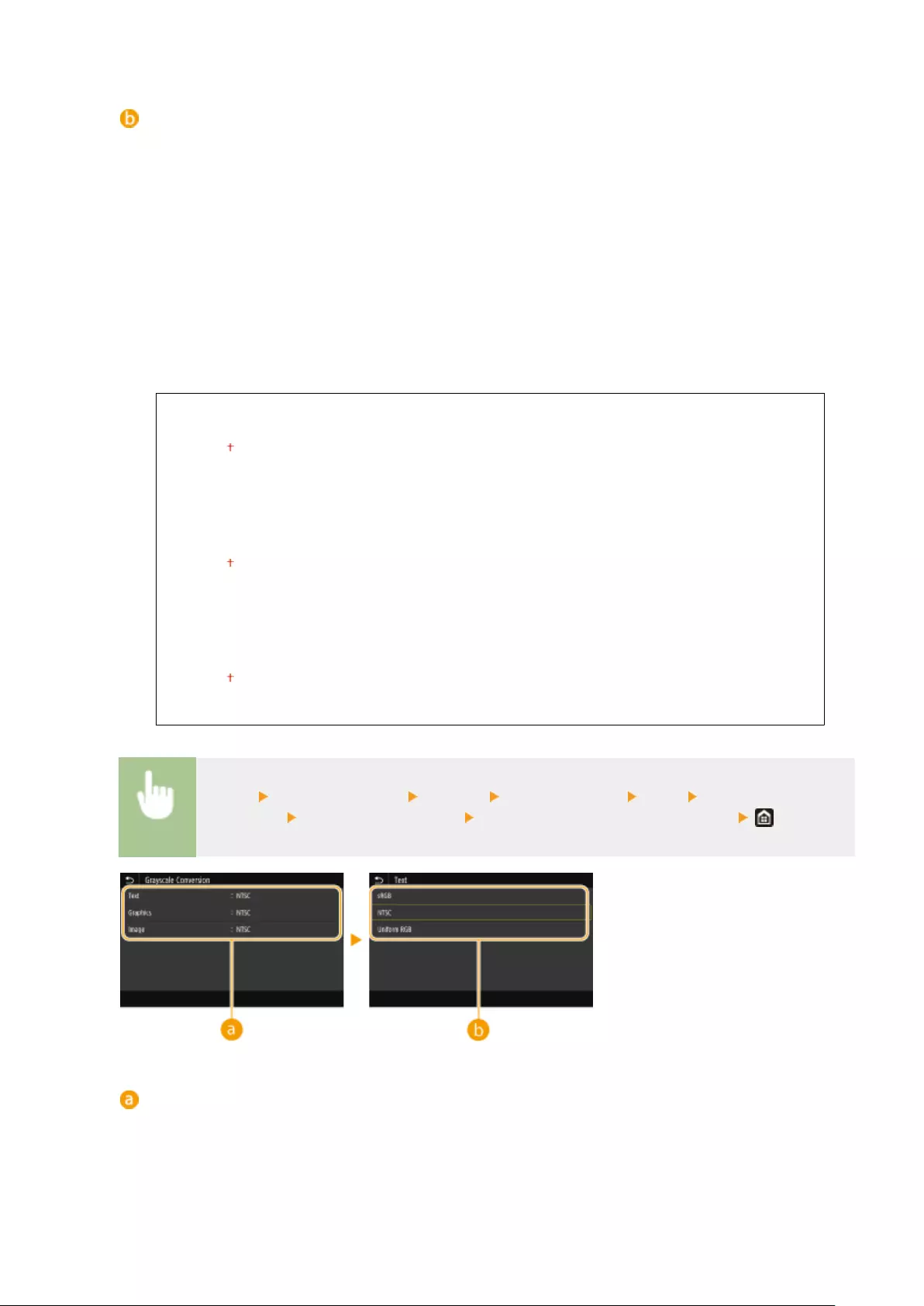
Setting value
<Resolution>
Produces a print with smooth gradation or smooth edges. It is suitable for printing gures or graphs
containing gradation areas.
<Gradation>
Produces a sharp print with strong contrast of lightness and darkness. It is suitable for printing image data
such as photo image data.
<High Resolution>
Produces a ne print with clear edges of text. It is suitable for printing characters and ne lines.
<Grayscale Conversion>
Specify the way of printing color data in black and white.
<Text>
<sRGB>
<NTSC>
<Uniform RGB>
<Graphics>
<sRGB>
<NTSC>
<Uniform RGB>
<Image>
<sRGB>
<NTSC>
<Uniform RGB>
<Menu> <Function Settings> <Printer> <Printer Settings> <XPS> <Grayscale
Conversion> Select the type of image Select the type of grayscale conversion
Type of image
Select the object for which to change the setting. <Text> represents letters and characters, <Graphics>
represents lines and gures, and <Image> represents photos and images.
Setting Menu List
531
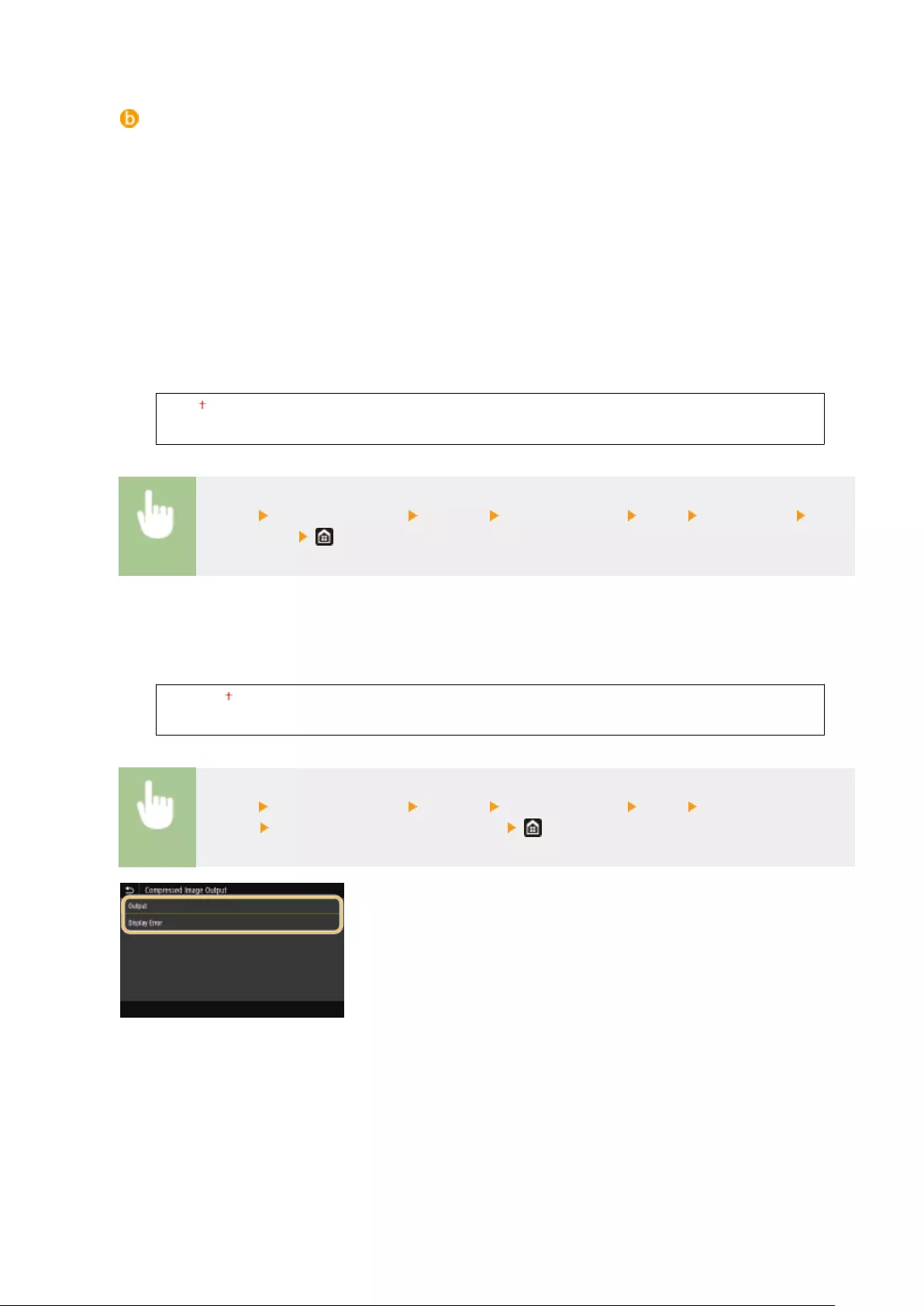
Type of grayscale conversion
<sRGB>
Prints in black and white with emphasis on color differences so that a smooth gradation is achieved.
<NTSC>
Prints in black and white so that the resulting image looks like a black and white television picture (of the
NTSC system).
<Uniform RGB>
Prints in black and white so that R, G, and B are uniformly converted to the same gray level by using only
brightness as the reference.
<Paper Save>
Specify whether to disable a blank page in print data from being output.
<Off>
<On>
<Menu> <Function Settings> <Printer> <Printer Settings> <XPS> <Paper Save> Select
<Off> or <On>
<Compressed Image Output>
Specify the operation that is to be performed when the image quality has degraded due to insucient
memory during printing.
<Output>
<Display Error>
<Menu> <Function Settings> <Printer> <Printer Settings> <XPS> <Compressed Image
Output> Select <Output> or <Display Error>
<Output>
Continues printing regardless of how much the image quality has degraded.
<Display Error>
If the image quality has degraded signicantly, an error message is displayed, and printing is stopped.
Setting Menu List
532
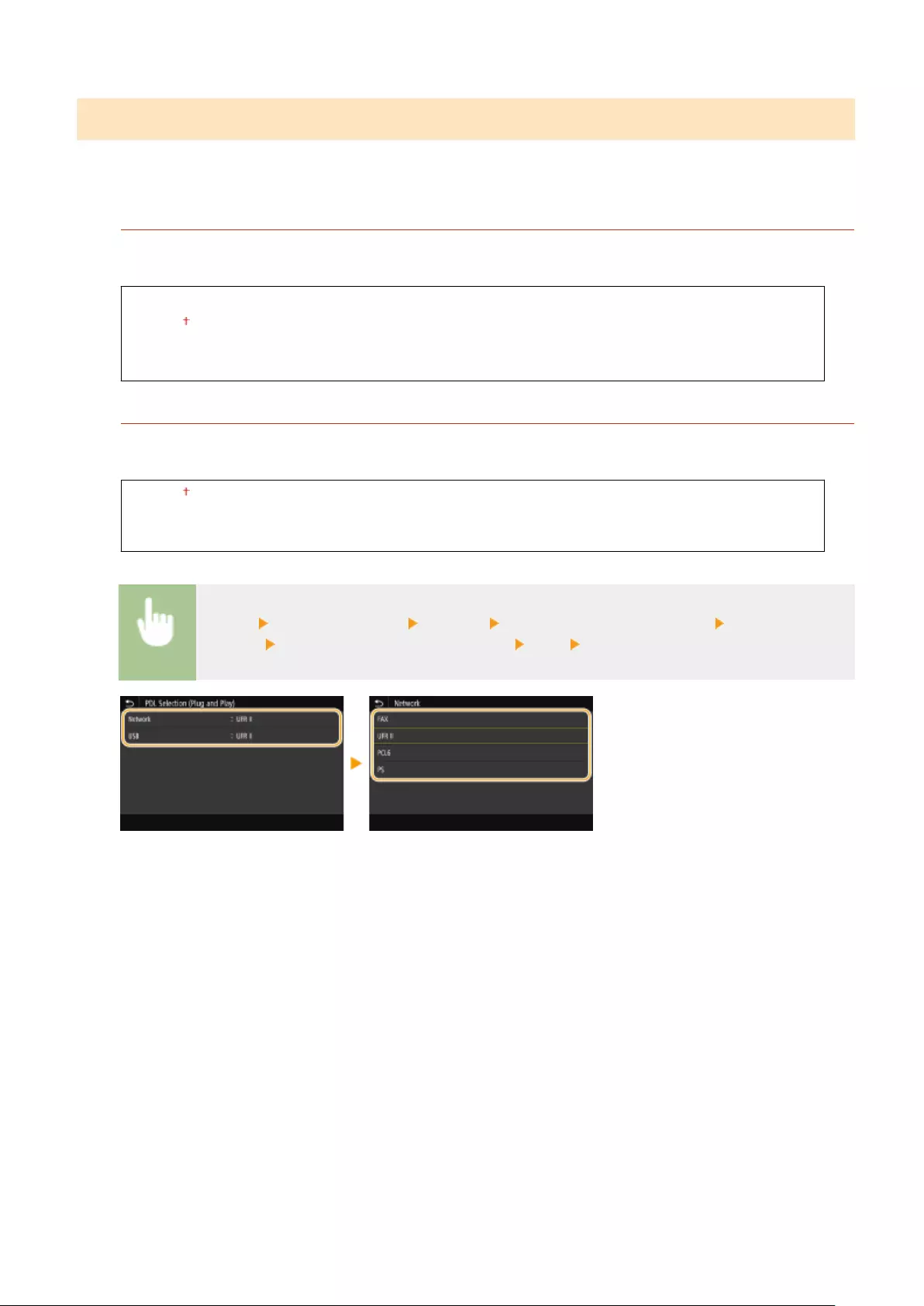
<PDL Selection (Plug and Play)>
Select a page description language so that the machine is detected as a printer that is compatible with that language
when it is connected to a computer by using Plug and Play.
<Network> *2
Select a page description language so that the machine is detected as a printer that is compatible with that
language when it is detected over the network.
<FAX>*1
<UFR II>
<PCL6>
<PS>
<USB>
Select a page description language so that the machine is detected as a printer that is compatible with that
language when it is connected to a computer via USB.
<UFR II>
<PCL6>
<PS>
<Menu> <Function Settings> <Printer> <PDL Selection (Plug and Play)> Select <Network>
or <USB> Select a page description language <OK> Restart the machine
<FAX> *1
Detects and connects the machine as a fax device.
<UFR II>
Detects and connects the machine as a UFR II printer.
<PCL6>
Detects and connects the machine as a PCL6 printer.
<PS>
Detects and connects the machine as a PS printer.
Setting Menu List
533
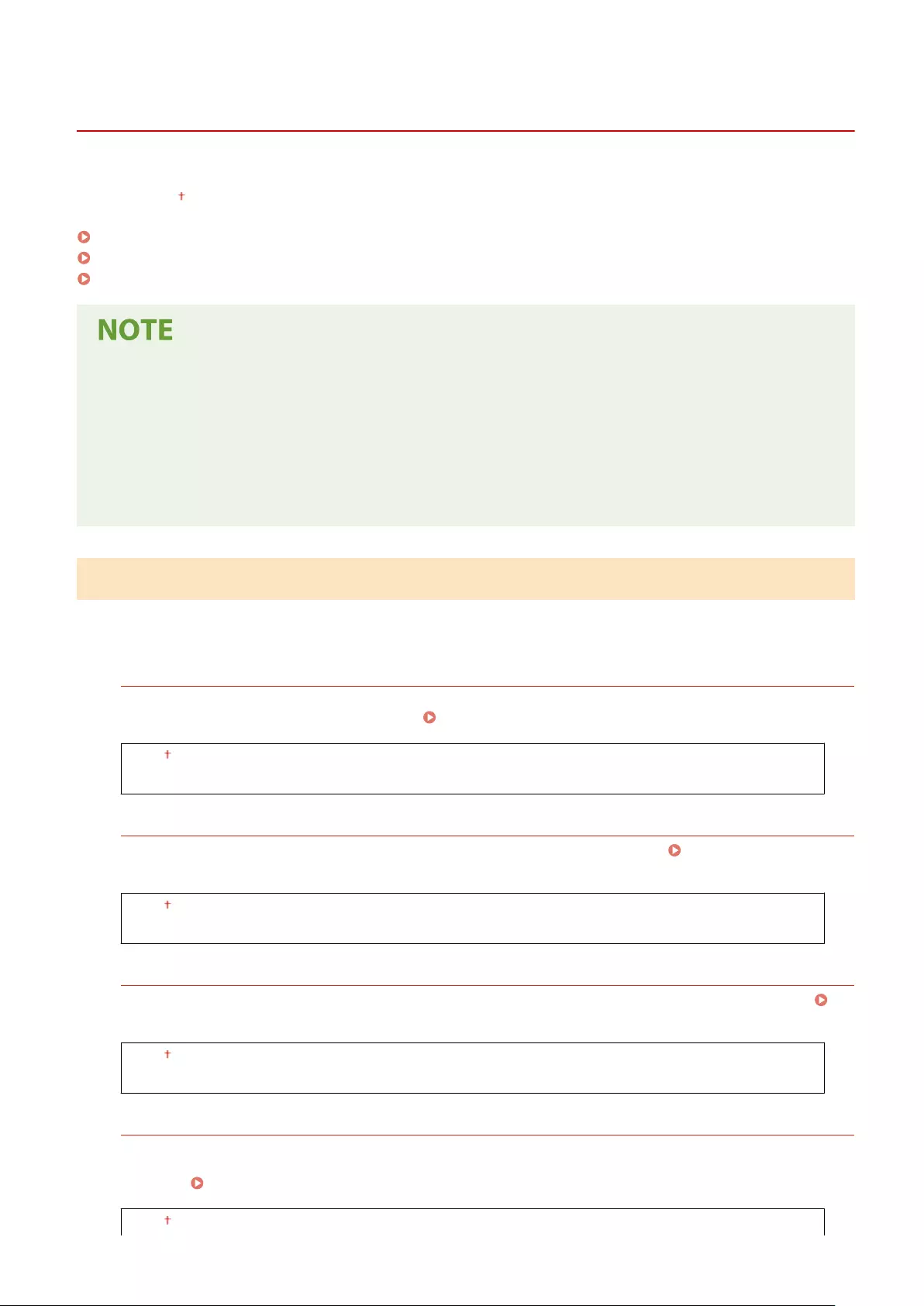
<Send>
6FR5-096
All the settings related to sending faxes and scanned originals are listed with descriptions. Default settings are marked
with a dagger ( ).
<Common Settings>(P. 534)
<Scan and Send Settings>(P. 535)
<Fax Settings>(P. 540)
Asterisks (*)
●Settings marked with "*1" may not be displayed depending on the model you are using, options, or other
setting items.
●Settings marked with "*2" may be unavailable or vary or have different defaults depending on your country
or region.
●Settings marked with "*3" cannot be imported or exported.
<Common Settings>
Congure the settings to restrict destinations at the time of sending faxes, e-mails, or I-Faxes, and specify the
conrmation method to prevent transmission to wrong destinations.
<Restrict New Destinations>
Select whether to limit the fax numbers and e-mail/I-Fax addresses that can be specied as destinations to
those already registered in the Address Book. Restricting New Destinations that Can Be Specied(P. 416)
<Off>
<On>
<Restrict Resending from Log>
Select whether to prevent a destination from being selected from the sent job logs. Disabling Use of
Previously Used Destinations(P. 416)
<Off>
<On>
<Conrm When Coded Dial TX>
Select whether to display the details of an entered coded dial number when it is selected as a destination.
Displaying Destinations in Address Book(P. 416)
<Off>
<On>
<Conrm Dest. Before Sending>
Specify whether to display the destination conrmation screen when sending faxes, e-mails, or I-Faxes. If <Only
for Sequential Broadcast> is selected, the conrmation screen is displayed only when multiple destinations are
specied. Checking Destinations when Sending Data(P. 417)
<Off>
Setting Menu List
534
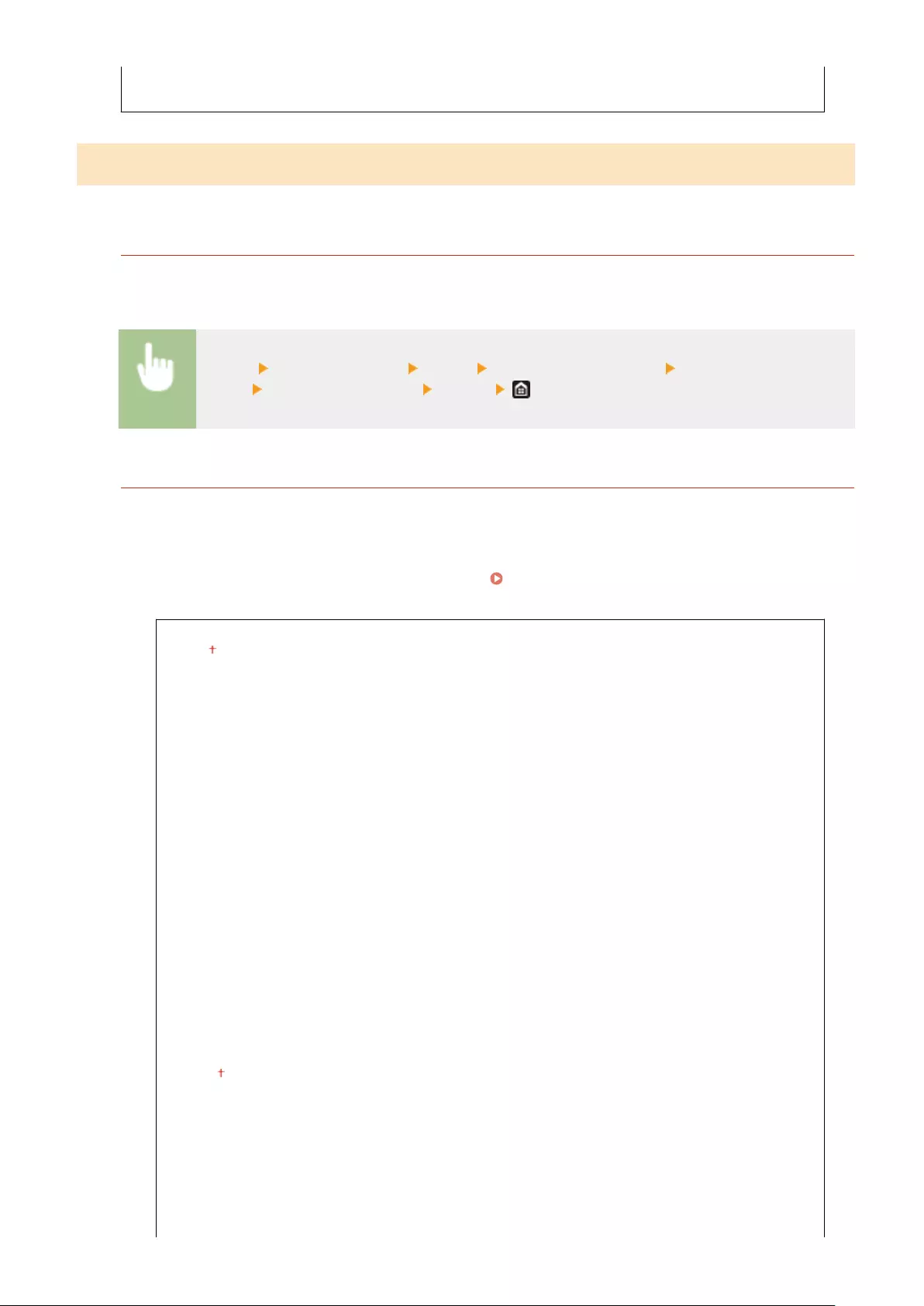
<On>
<Only for Sequential Broadcast>
<Scan and Send Settings>
You can change and register the settings for sending faxes or scanned documents.
<Register Unit Name>
Register the sender name for e-mails and I-Faxes. The registered name is displayed in e-mails, along with the e-
mail address. If the sender name is not registered, only the e-mail address is displayed.
<Menu> <Function Settings> <Send> <Scan and Send Settings> <Register Unit
Name> Enter the sender name <Apply>
<E-Mail Settings>
Change the default settings used for scanning originals to send as e-mails.
<Change Default Settings (E-Mail)>
You can change the default settings used for scanning originals to send as e-mails. The selected settings are
used as the default settings when scanning originals. Changing the Default Settings for
Functions(P. 174)
<Scan Size>
<A4>
<A5R>
<A6>
<B5>
<LTR>
<LGL>
<STMT>
<EXEC>
<FOOLSCAP/FOLIO>
<OFICIO>
<LETTER (Government)>
<LEGAL (Government)>
<LEGAL (India)>
<FOOLSCAP (Australia)>
<OFICIO (Brazil)>
<OFICIO (Mexico)>
<File Format>
<PDF>
<PDF (Compact)>
<PDF (Compact/OCR)>
<PDF (OCR)>
<Set PDF Details>
<PDF>/<PDF (Compact)>/<PDF (Compact/OCR)>/<PDF (OCR)>
<Encryption>*1
Setting Menu List
535

<None>
<Acrobat 7.0 or Later/128-bit AES>
<Acrobat 9.0 or Equivalent/256-bit AES>*1
<Acrobat 10.0 or Equivalent/256-bit AES>*1
<Digital Signatures>*1
<None>
<Top Left>
<Divide into Pages>
<Off>
<On>
<JPEG>
<TIFF>
<Set TIFF Details>
<Divide into Pages>
<Off>
<On>
<Density>
Nine Levels
<Original Orientation>
<Portrait>
<Landscape>
<Original Type>
<Text>
<Text/Photo>
<Photo>
<2-Sided Original >
<Off>
<Book Type>
<Calendar Type>
<Sharpness>
Seven Levels
<Data Size>
<Small: Memory Priority>
<Standard>
<Large: Image Quality Priority>
<Subject/Message>
<Subject>
<Message>
<Reply To>
<None>
<Specify from Address Book>
Setting Menu List
536
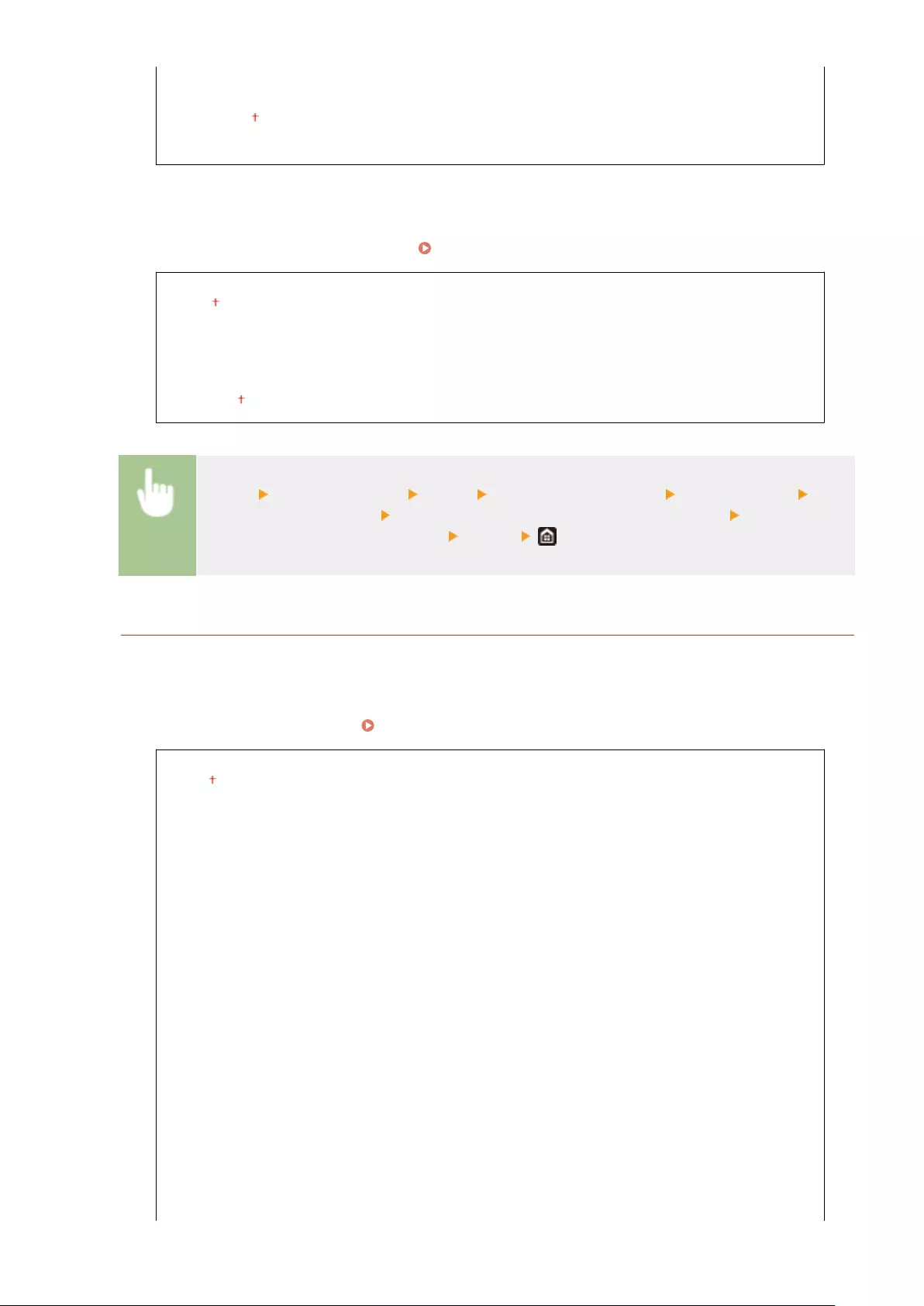
<Priority>
<Low>
<Standard>
<High>
<Link Mobile Device Addr. Book>
Congure so that destinations registered in the address book of mobile devices can be specied as send
destinations. When <Use Remote UI Access PIN> is set to <On>, a PIN is required for access to the machine.
To set a PIN, use <Remote UI Access PIN>. <Remote UI Settings>(P. 567)
<Link Mobile Device Address Book>
<Off>
<On>
<Use Remote UI Access PIN>
<Off>
<On>
<Menu> <Function Settings> <Send> <Scan and Send Settings> <E-Mail Settings> <Link
Mobile Device Addr. Book> Select <On> in <Link Mobile Device Address Book> Select <Off> or
<On> in <Use Remote UI Access PIN> <Apply>
<I-Fax Settings>
Specify the basic settings for using the machine as an I-Fax device.
<Change Default Settings (I-Fax)>
You can change the default settings used for sending I-Fax. The selected settings are used as the default
settings when scanning originals. Changing the Default Settings for Functions(P. 174)
<Scan Size>
<A4>
<A5R>
<A6>
<B5>
<LTR>
<LGL>
<STMT>
<EXEC>
<FOOLSCAP/FOLIO>
<OFICIO>
<LETTER (Government)>
<LEGAL (Government)>
<LEGAL (India)>
<FOOLSCAP (Australia)>
<OFICIO (Brazil)>
<OFICIO (Mexico)>
<Density>
Nine Levels
Setting Menu List
537
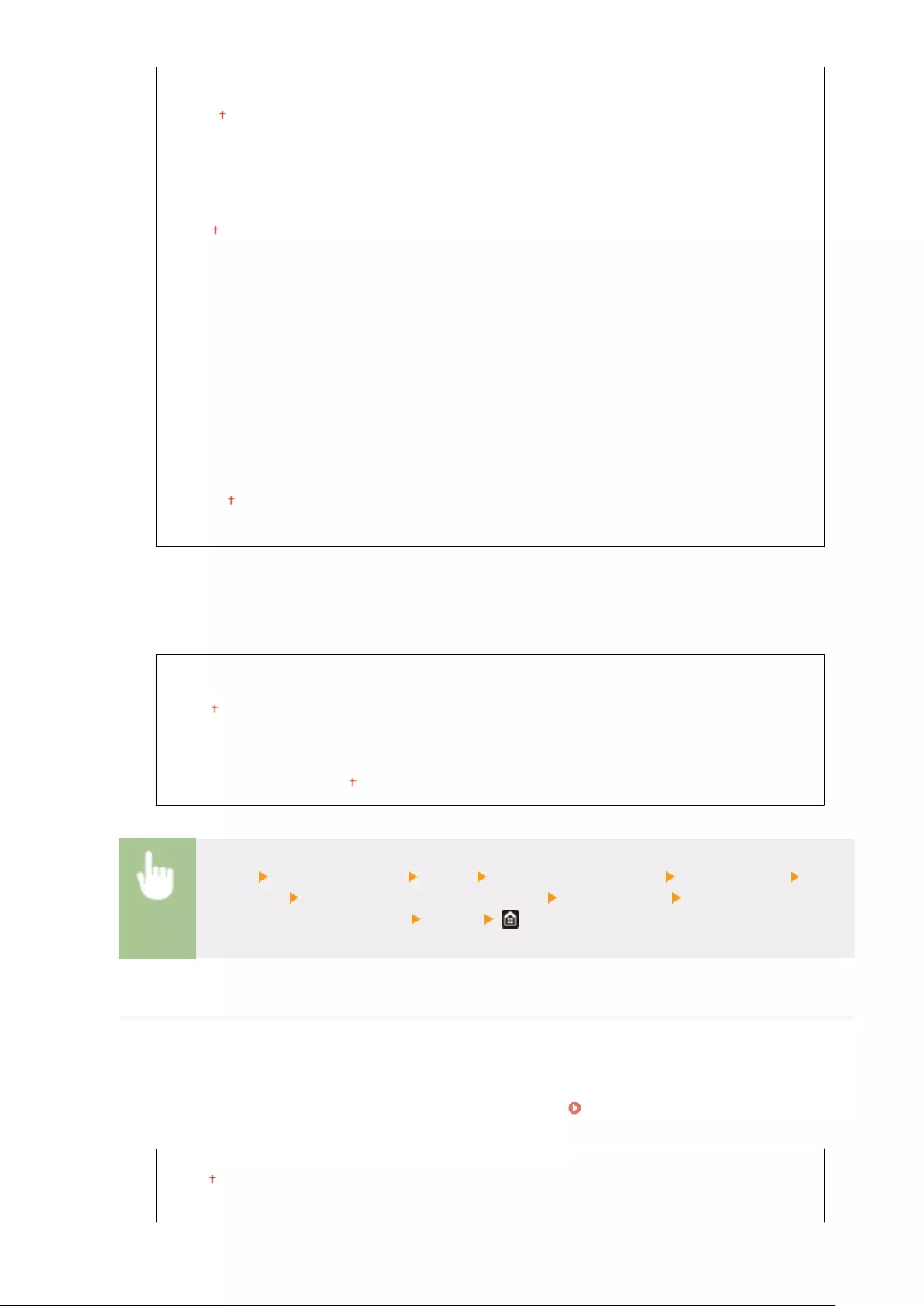
<Original Type>
<Text>
<Text/Photo>
<Photo>
<2-Sided Original >
<Off>
<Book Type>
<Calendar Type>
<Sharpness>
Seven Levels
<Subject/Message>
<Subject>
<Message>
<Reply To>
<None>
<Specify from Address Book>
<TX Terminal ID>
Information such as the date and time of transmission and the e-mail address of the machine (sender
information) can be added as a header in transmitted documents. This information tells the recipient when
the I-Fax was sent and who sent it.
<Add TX Terminal ID>
<Off>
<On>
<Print Position>
<Inside Image Area>
<Outside Image Area>
<Menu> <Function Settings> <Send> <Scan and Send Settings> <I-Fax Settings> <TX
Terminal ID> Select <On> in <Add TX Terminal ID> <Print Position> Select <Inside Image
Area> or <Outside Image Area> <Apply>
<File Settings>
Change the default settings used when originals are saved to a shared folder or FTP server.
<Change Default Settings (File)>
You can change the default settings used when originals are saved to a shared folder or FTP server. The
selected settings are used as the default settings when scanning. Changing the Default Settings for
Functions(P. 174)
<Scan Size>
<A4>
<A5R>
Setting Menu List
538

<A6>
<B5>
<LTR>
<LGL>
<STMT>
<EXEC>
<FOOLSCAP/FOLIO>
<OFICIO>
<LETTER (Government)>
<LEGAL (Government)>
<LEGAL (India)>
<FOOLSCAP (Australia)>
<OFICIO (Brazil)>
<OFICIO (Mexico)>
<File Format>
<PDF>
<PDF (Compact)>
<PDF (Compact/OCR)>
<PDF (OCR)>
<Set PDF Details>
<PDF>/<PDF (Compact)>/<PDF (Compact/OCR)>/<PDF (OCR)>
<Encryption>*1
<None>
<Acrobat 7.0 or Later/128-bit AES>
<Acrobat 9.0 or Equivalent/256-bit AES>*1
<Acrobat 10.0 or Equivalent/256-bit AES>*1
<Digital Signatures>*1
<None>
<Top Left>
<Divide into Pages>
<Off>
<On>
<JPEG>
<TIFF>
<Set TIFF Details>
<Divide into Pages>
<Off>
<On>
<Density>
Nine Levels
<Original Orientation>
<Portrait>
<Landscape>
<Original Type>
<Text>
Setting Menu List
539

<Text/Photo>
<Photo>
<2-Sided Original>
<Off>
<Book Type>
<Calendar Type>
<Sharpness>
Seven Levels
<Data Size>
<Small: Memory Priority>
<Standard>
<Large: Image Quality Priority>
<Fax Settings> *1
Specify the basic settings for using the machine as a fax device.
<Change Default Settings (Fax)>
You can change the default settings used for sending faxes. The selected settings are used as the default
settings when scanning originals. Changing the Default Settings for Functions(P. 174)
<Resolution>
<200 x 100 dpi (Normal)>
<200 x 200 dpi (Fine)>
<200 x 200 dpi (Photo)>
<200 x 400 dpi (Superne)>
<400 x 400 dpi (Ultrane)>
<Density>
Nine Levels
<2-Sided Original >
<Off>
<Book Type>
<Calendar Type>
<Sharpness>
Seven Levels
<Off-Hook Alarm>
Select whether the machine makes an alert sound when the handset of a telephone or the optional handset
connected to the machine is not properly set on the cradle. You can also adjust the volume of the alert sound.
0 to 3
Setting Menu List
540
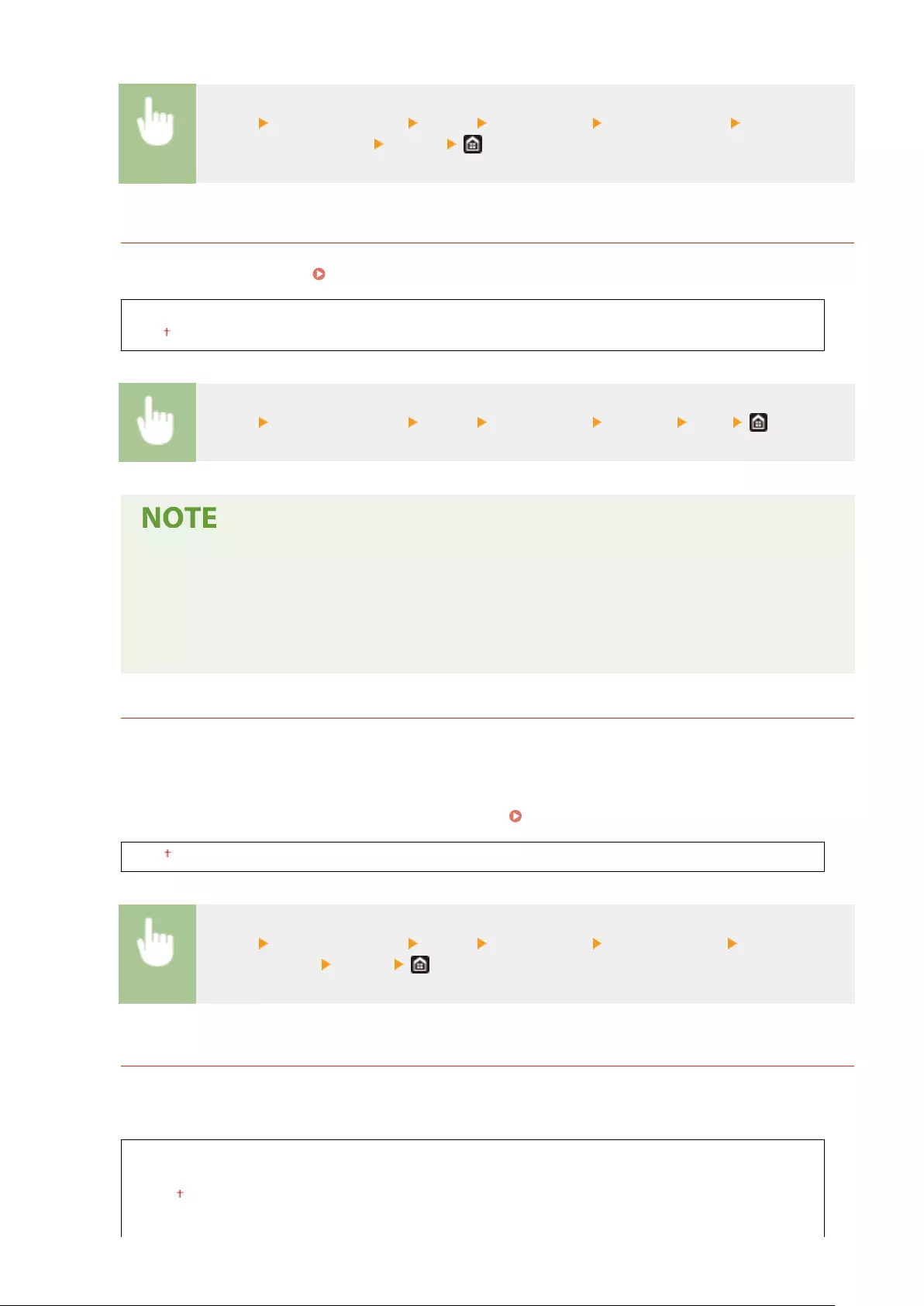
<Menu> <Function Settings> <Send> <Fax Settings> <Off-Hook Alarm> Select the
volume of the alert sound <Apply>
<ECM TX>
Enable or disable error correction mode (ECM). ECM checks for fax data errors and corrects them. To reduce
errors on received faxes, see <ECM RX>(P. 549) .
<Off>
<On>
<Menu> <Function Settings> <Send> <Fax Settings> <ECM TX> <On>
●ECM must be enabled on both the machine and the other fax device because error checks are
performed on both the sending and receiving devices.
●Even when ECM is enabled, errors may occur due to telephone line conditions.
●It may take a longer time than usual to process data when ECM is enabled because the error checks
and corrections are performed while the data is transmitted.
<Set Pause Time> *2
For example, when you make calls by dialing "0 - (pause) - (telephone number)," 0 is dialed rst and then a few
seconds later, the telephone number. When sending faxes overseas, you need to specify destinations by dialing
"(international access code) - (country code) - (area code) - (fax number)" but consecutive numbers that are
input without pauses may not be recognized correctly. In this case, try adding a pause after the international
access code or the fax number. If the code or the number is still not recognized correctly, change the duration
of the pause. For instructions on how to enter a pause, see Basic Operations for Sending Faxes(P. 218) .
1 to 4 to 15 (sec.)
<Menu> <Function Settings> <Send> <Fax Settings> <Set Pause Time> Specify the
duration of pause <Apply>
<Auto Redial> *2
Specify settings for Auto Redial, a function that automatically redials the fax number after several minutes if the
rst attempt fails because the line is busy. You can specify how many times the machine redials and the interval
between redials.
<Use Auto Redial>
<Off>
<On>
<Number of Times to Redial>
Setting Menu List
541
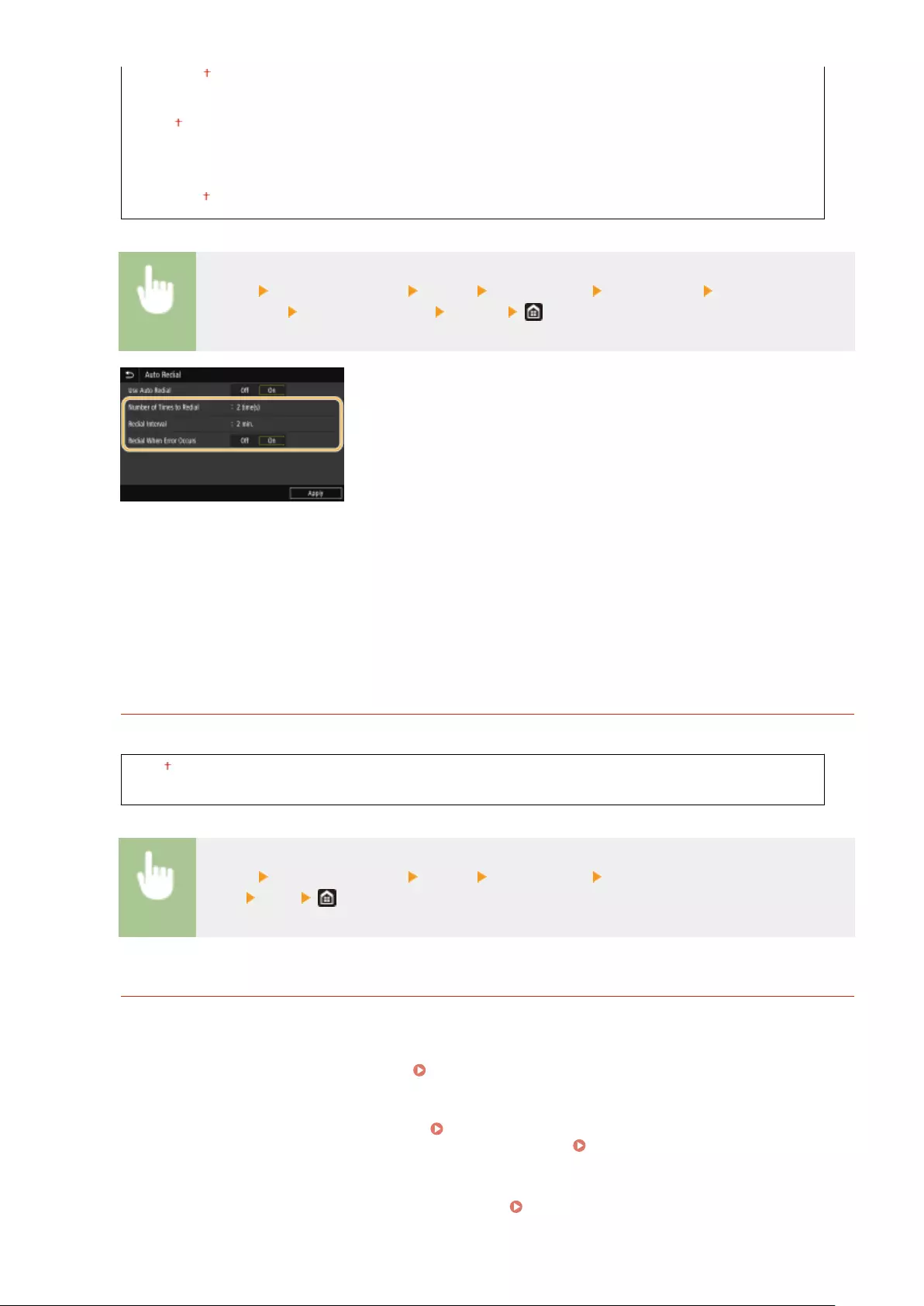
1 to 2 to 10 (time(s))
<Redial Interval>
2 to 99 (min.)
<Redial When Error Occurs>
<Off>
<On>
<Menu> <Function Settings> <Send> <Fax Settings> <Auto Redial> Select <On> in <Use
Auto Redial> Specify the settings <Apply>
<Number of Times to Redial>
Species how many times the machine redials. Enter a number, and select <Apply>.
<Redial Interval>
Species the interval between redials. Enter a number for the interval, and select <Apply>.
<Redial When Error Occurs>
When set to <On>, species to redial when a transmission error occurs.
<Check Dial Tone Before Send> *2
Select whether to check the dial tone before a fax number is dialed.
<Off>
<On>
<Menu> <Function Settings> <Send> <Fax Settings> <Check Dial Tone Before
Send> <On>
<Set Line>
Specify a fax number, unit name, and line type.
<Register Unit Tel. Number>
Register the fax number for the machine. Registering the Fax Number and Unit Name(P. 80)
<Register Unit Name>
Register the name of a company or person ( Registering the Fax Number and Unit Name(P. 80) ). The
registered name is sent as sender information to the destination ( <TX Terminal ID>(P. 545) ).
<Select Line Type> *2
Select the telephone line type used for fax transmission. Connecting the Telephone Line(P. 82)
Setting Menu List
542
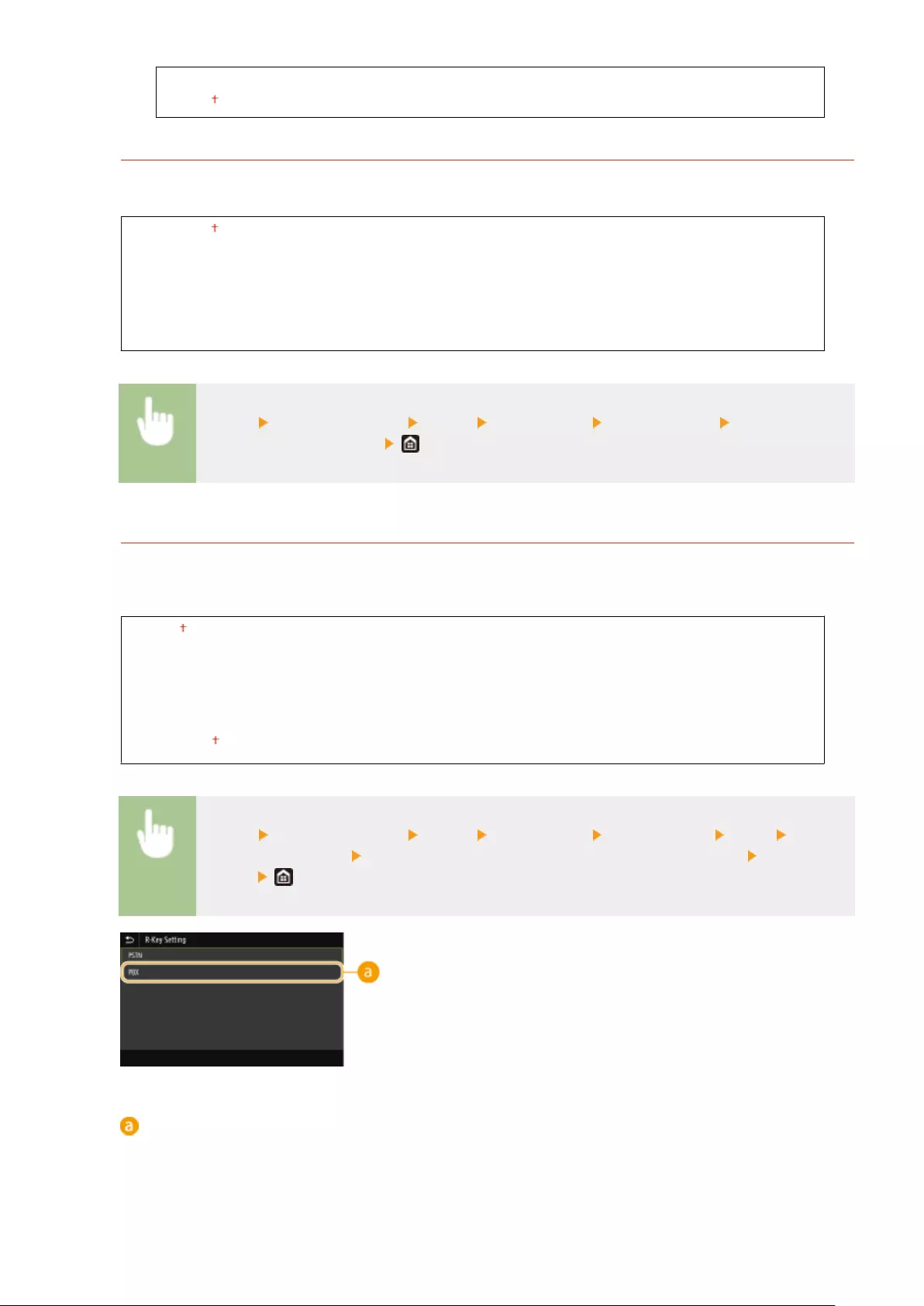
<Pulse>
<Tone>
<TX Start Speed>
If it takes a long time to start sending a fax, such as when there is a poor connection, you can adjust the
communication start speed downward incrementally.
<33600 bps>
<14400 bps>
<9600 bps>
<7200 bps>
<4800 bps>
<2400 bps>
<Menu> <Function Settings> <Send> <Fax Settings> <TX Start Speed> Select the
communication start speed
<R-Key Setting>
If your machine is connected through a PBX (Private Branch Exchange), it is necessary to set the access method.
If you set it to <PBX>, the <R> key will be displayed on the Fax Basic Features screen. If you assign an outside
line access number to the <R> key, you can easily access the outside line.
<PSTN>
<PBX> *2
<Prex>
Prex Code
<Hooking>
<Menu> <Function Settings> <Send> <Fax Settings> <R-Key Setting> <PBX> Select
<Prex> or <Hooking> Enter an outside line access number if you select <Prex>
<Apply>
<PBX>*2
Select <PBX> when you want the machine to be connected through a PBX (Private Branch Exchange). Set the
function of the <R> key displayed on the Fax Basic Features screen to <Prex> or <Hooking>. If you select
<Prex>, register the prex code on the next screen. Enter the prex code using the numeric keys, select
<Pause>, and then select <Apply>. If you do not insert a pause, the prex code is not registered.
Setting Menu List
543
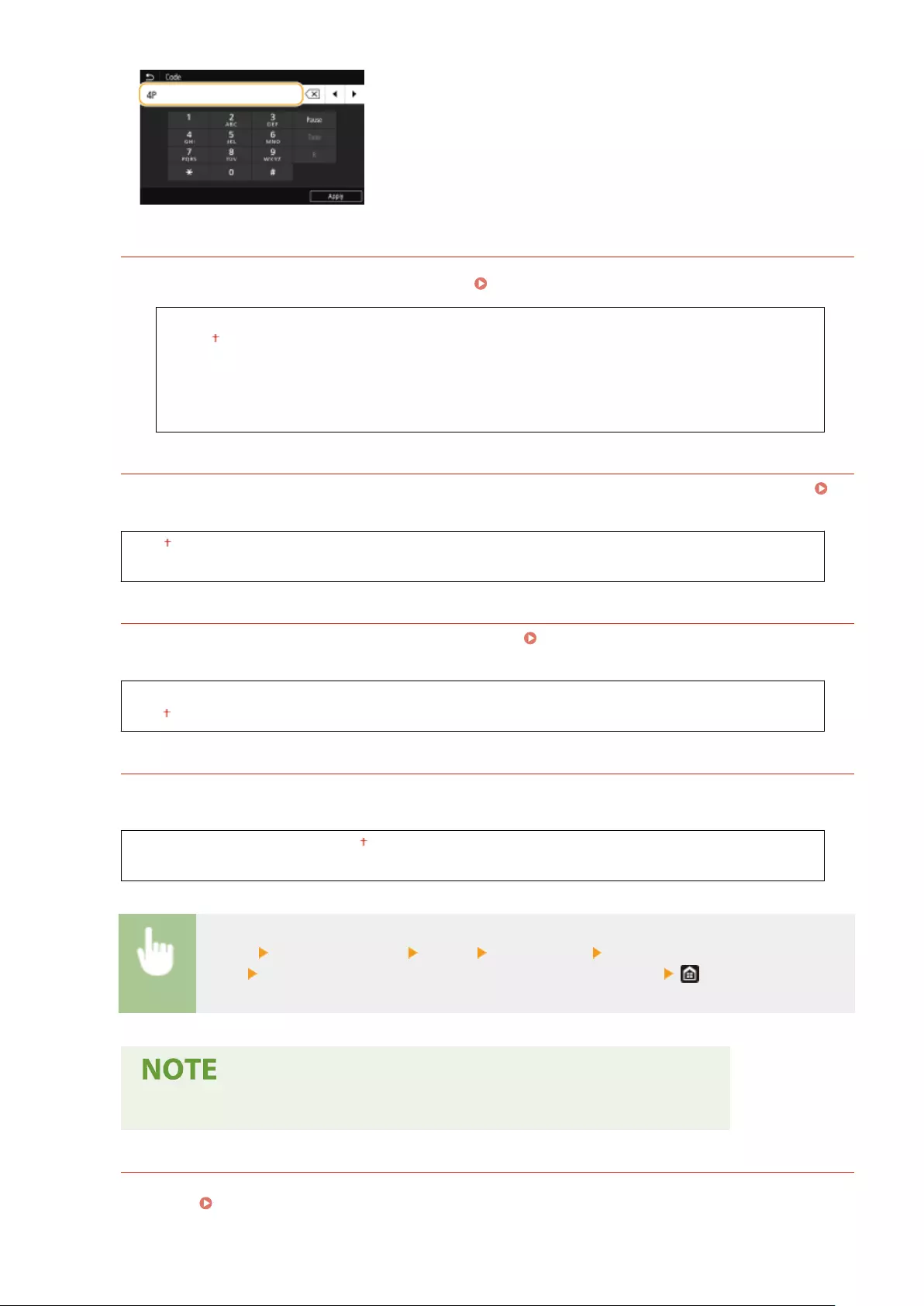
<Archive TX Document> *3
In addition to the destination specied when the fax is sent, you can specify whether faxed documents are
also sent to a preset storage address for archiving. Saving a Copy of a Sent Original(P. 236)
<Archive TX Document>
<Off>
<On>
<Archive Address>
<File Name>
<Conrm Entered Fax Number>
Select whether to display the details of an entered coded dial number when it is selected as a destination.
Conrming the Entered Fax Number(P. 418)
<Off>
<On>
<Allow Fax Driver TX>
Enable or disable PC faxing (sending faxes from a computer). Restricting Fax Sending from a
Computer(P. 418)
<Off>
<On>
<Use Addr. Book When On-Hook>
Make a setting so that you can perform fax transmission by entering a specic number before specifying a
coded dial number or specifying a destination from the Address Book.
<Do Not Allow After Num. Key Use>
<Always Allow>
<Menu> <Function Settings> <Send> <Fax Settings> <Use Addr. Book When On-
Hook> Select <Do Not Allow After Num. Key Use> or <Always Allow>
●Transmission may be impossible if the entered number consists of too many digits.
<Restrict Sequential Broadcast>
Select whether to prohibit sequential broadcasting, a feature that sends faxes to multiple destinations in
succession. Restricting Sequential Broadcasts(P. 418)
Setting Menu List
544
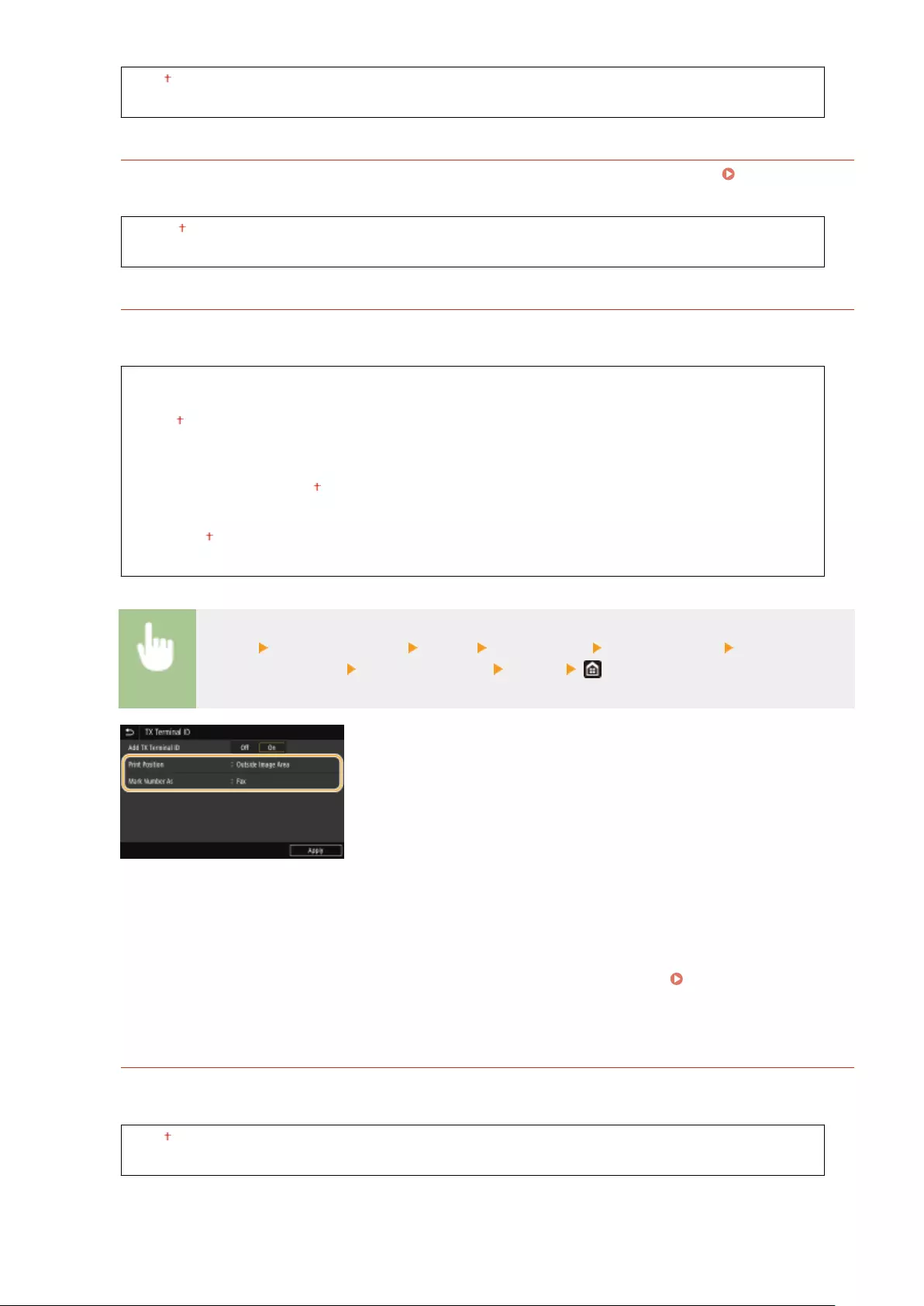
<Off>
<On>
<Register Log Dest to Addr Book>
Specify whether to disable registering destinations from fax send logs to the Address Book. Disabling
Destination Registration from Logs to the Address Book(P. 419)
<Allow>
<Do Not Allow>
<TX Terminal ID>
Specify settings for adding the sender information, including the fax number and the name of the machine, to
the fax header. The recipient can check who sent the fax by looking at the added information.
<Add TX Terminal ID>
<Off>
<On>
<Print Position>
<Inside Image Area>
<Outside Image Area>
<Mark Number As>
<Fax>
<Tel>
<Menu> <Function Settings> <Send> <Fax Settings> <TX Terminal ID> Select <On> in
<Add TX Terminal ID> Specify the settings <Apply>
<Print Position>
Species the position to print the terminal ID information in the sent fax. Select <Inside Image Area> to print
the information inside the image area, or <Outside Image Area> to print the information outside the image
area.
<Mark Number As>
Adds the "Fax" or "Tel" mark in front of the fax number registered for the machine ( Registering the Fax
Number and Unit Name(P. 80) ). Select <Tel> to indicate that the notied number is a telephone number.
<Auto Adjust VoIP Comm. Speed>
When you want to perform a successful fax communication with a partner device or on a line with which errors
tend to occur easily, you can use this function to reduce communication errors.
<Off>
<On>
Setting Menu List
545

<Menu> <Function Settings> <Send> <Fax Settings> <Auto Adjust VoIP Comm.
Speed> Select <Off> or <On>
●If you set the function to <On>, the communication speed may be slower.
Setting Menu List
546

<Receive/Forward>
6FR5-097
All the settings related to receiving faxes and e-mails are listed with descriptions. Default settings are marked with a
dagger ( ).
<Common Settings>(P. 547)
<I-Fax Settings>(P. 548)
<Fax Settings>(P. 549)
Asterisks (*)
●Settings marked with "*1" may not be displayed depending on the model you are using, options, or other
setting items.
●Settings marked with "*2" may be unavailable or vary or have different defaults depending on your country
or region.
●Settings marked with "*3" cannot be imported or exported.
<Common Settings>
Specify operations that are to be performed when faxes are received in memory and when the amount remaining in
the toner cartridge is low.
<Set Fax/I-Fax Inbox> *1
Congure settings for receiving faxes in memory.
<Fax Memory Lock Settings>
Select whether to store received faxes without immediately printing them. Stored fax documents can be
printed at any time by changing the setting to <Off>. Saving Received Documents into the Machine
(Memory Reception)(P. 239)
<Use Memory Lock>
<Off>
<On>
<Use Fax Preview>
<Off>
<On>
<Report Print>
<Off>
<On>
<Set Memory Lock Time>
<Off>
<On>
<Memory Lock Time>
<Memory Lock Start Time>
<Memory Lock End Time>
Setting Menu List
547
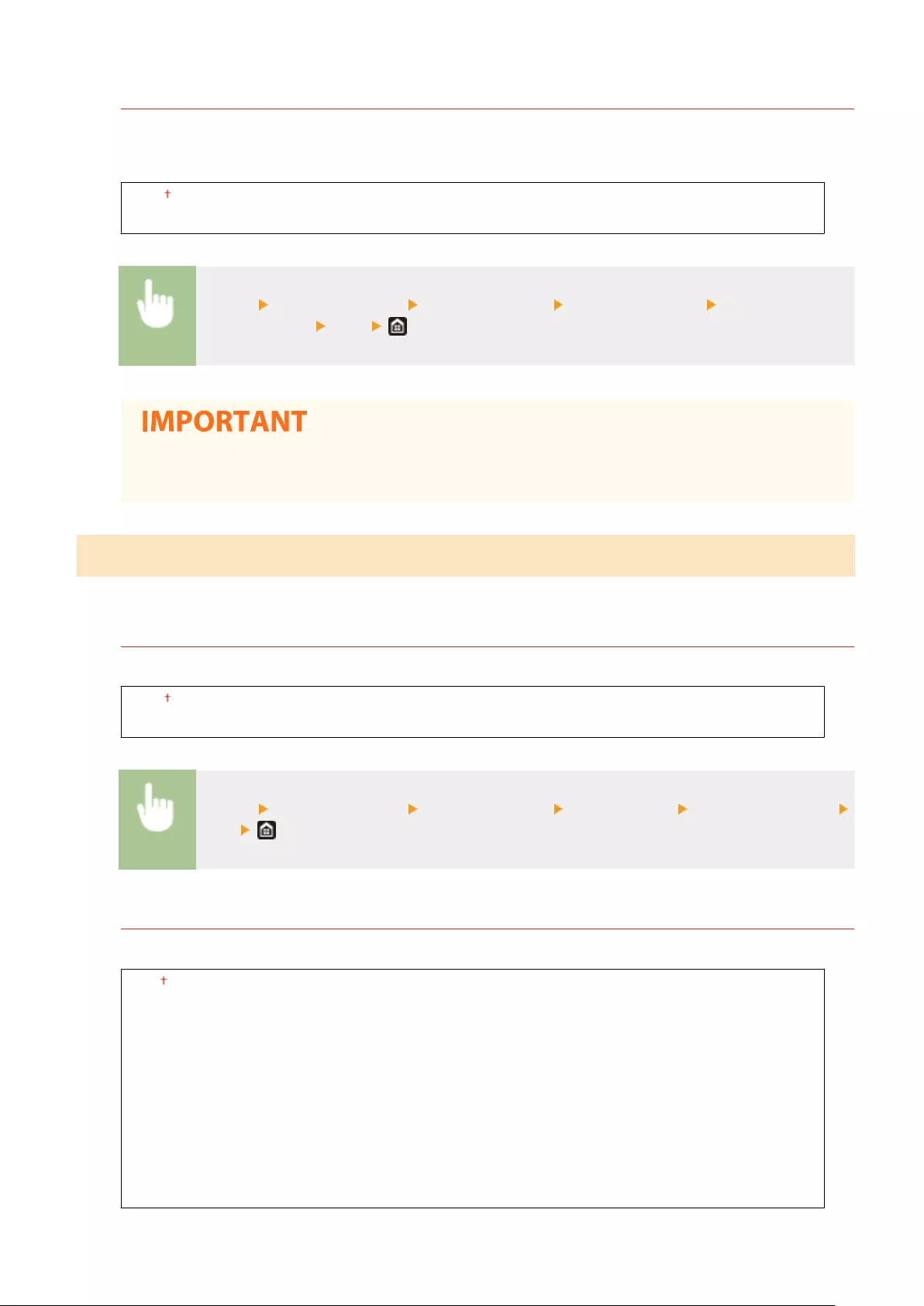
<Continue Print. When Cart. Low>
If receiving faxes when the amount remaining in the toner cartridges is low, the machine holds them in memory
instead of printing. However, if this function is enabled, the machine continues printing. In addition to fax
reception, this is true with I-Fax reception.
<Off>
<On>
<Menu> <Function Settings> <Receive/Forward> <Common Settings> <Continue Print.
When Cart. Low> <On>
●When this function is enabled, faxes may fade or blur. Because received documents are not stored,
you need to ask the sender to resend the document.
<I-Fax Settings>
Congure settings to print received I-Fax documents.
<Print on Both Sides>
Specify settings for printing received documents on both sides of paper.
<Off>
<On>
<Menu> <Function Settings> <Receive/Forward> <I-Fax Settings> <Print on Both Sides>
<On>
<RX Print Size>
Specify the paper size to be used for printing.
<A4>
<LTR>
<LGL>
<FOOLSCAP/FOLIO>
<OFICIO>
<LETTER (Government)>
<LEGAL (Government)>
<LEGAL (India)>
<FOOLSCAP (Australia)>
<OFICIO (Brazil)>
<OFICIO (Mexico)>
Setting Menu List
548
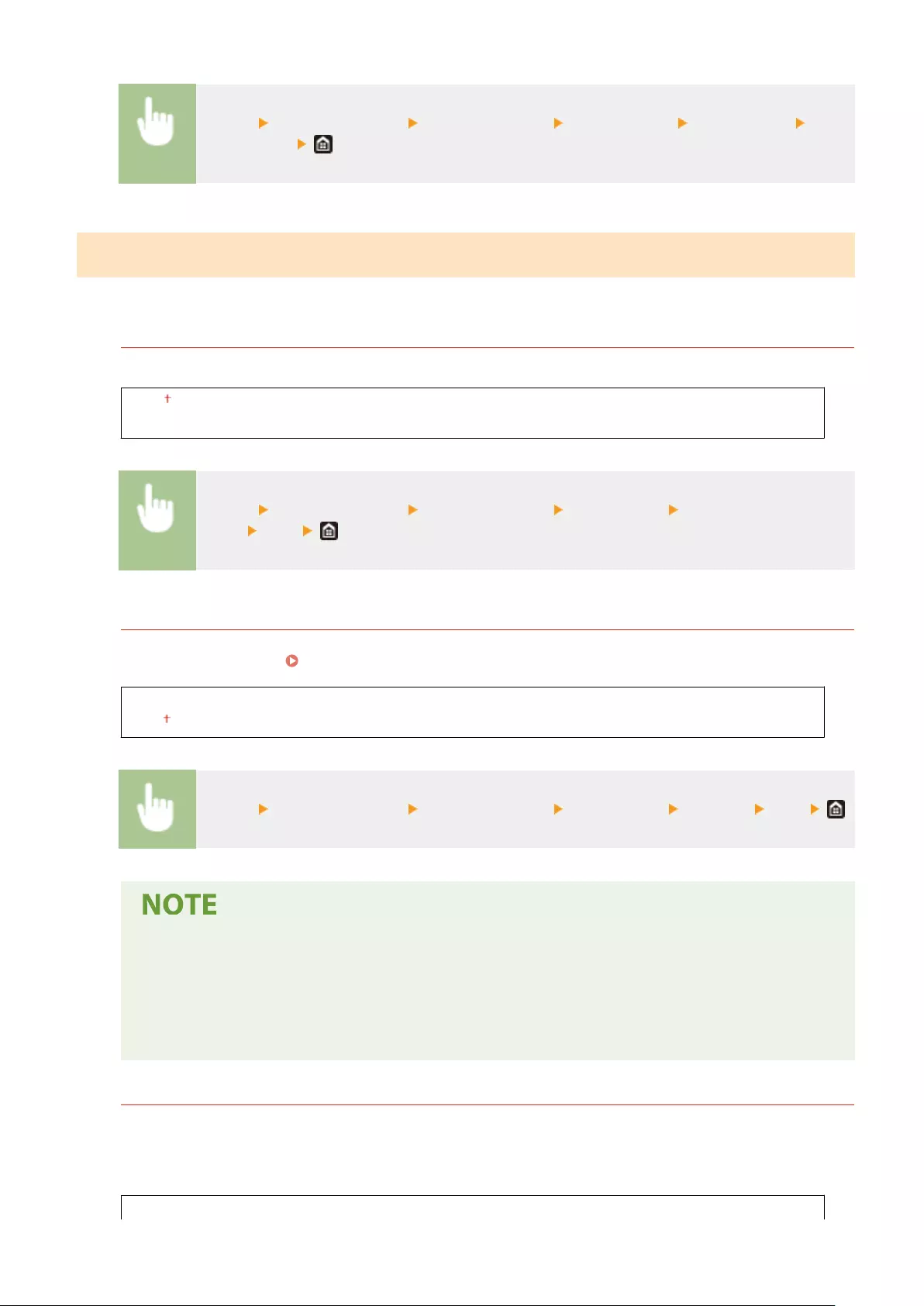
<Menu> <Function Settings> <Receive/Forward> <I-Fax Settings> <RX Print Size> Select
the paper size
<Fax Settings> *1
Congure settings for receiving and forwarding faxes.
<Print on Both Sides>
Specify settings for printing received documents on both sides of paper.
<Off>
<On>
<Menu> <Function Settings> <Receive/Forward> <Fax Settings> <Print on Both
Sides> <On>
<ECM RX>
Enable or disable error correction mode (ECM). ECM checks for fax data errors and corrects them. To reduce
errors on sent faxes, see <ECM TX>(P. 541) .
<Off>
<On>
<Menu> <Function Settings> <Receive/Forward> <Fax Settings> <ECM RX> <On>
●ECM must be enabled on both the machine and the other fax device because error check is
performed on both the sending and receiving devices.
●Even when ECM is enabled, errors may occur due to telephone line conditions.
●It may take a longer time than usual to process data when ECM is enabled because the error check
and corrections are performed while the data is transmitted.
<Incoming Ring> *2
Specify settings for sounding a ring to notify you of incoming faxes. This feature is only available when <Auto>
or <Fax/Tel (Auto Switch)> is selected for the receive mode. Specify how many times the incoming call rings
when the machine receives a fax call. You can also disable the settings to prevent the incoming call from
ringing.
<Use Incoming Ring>
Setting Menu List
549
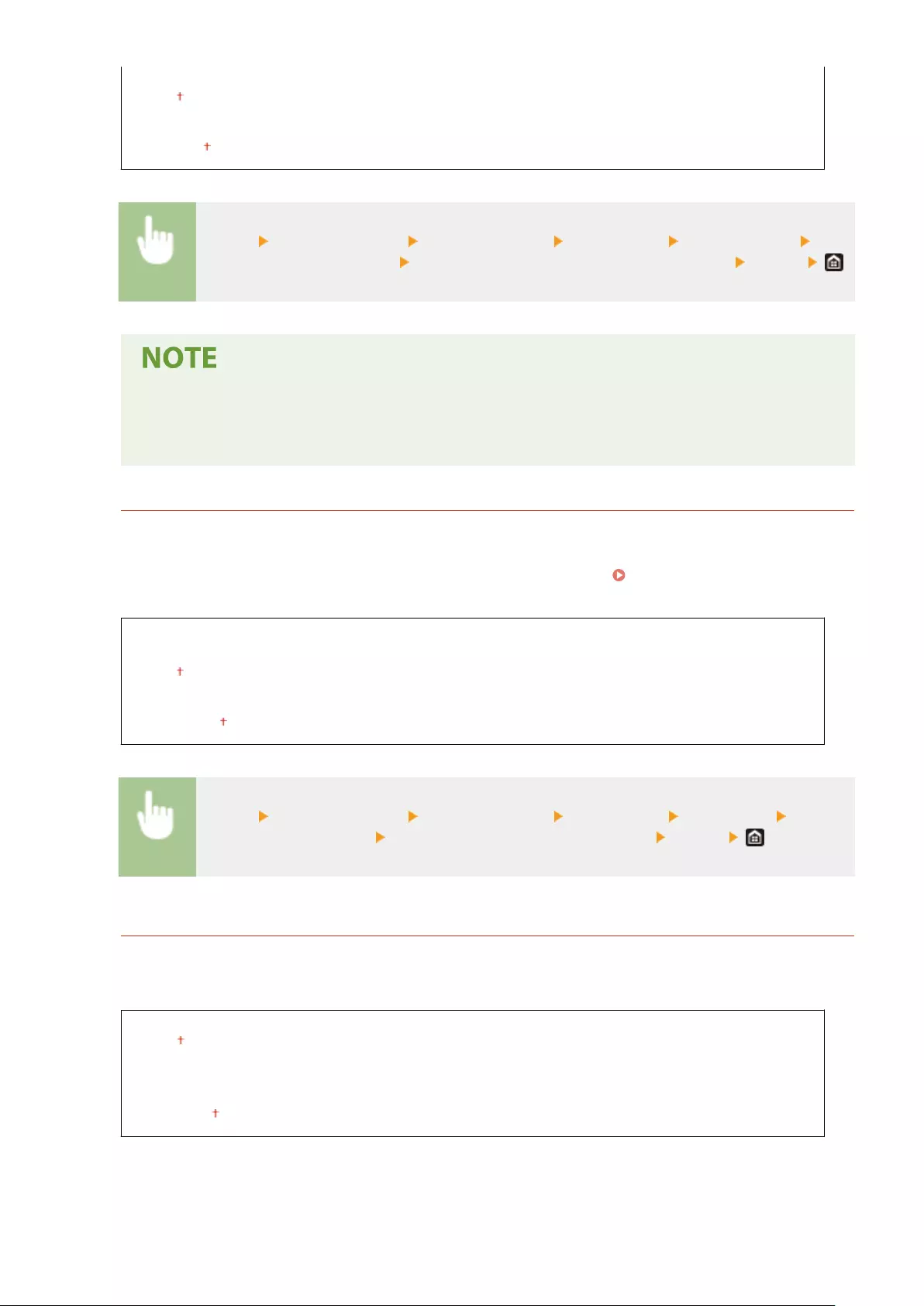
<Off>
<On>
<Number of Rings>
1 to 2 to 99 (time(s))
<Menu> <Function Settings> <Receive/Forward> <Fax Settings> <Incoming Ring> Select
<On> in <Use Incoming Ring> Enter the desired number in <Number of Rings> <Apply>
●When <On> is specied, you need to connect your telephone or the optional handset to the machine
beforehand.
●When <Off> is specied, the machine does not enter sleep mode.
<Remote RX> *2
Specify settings for receiving a fax by operating a telephone that is connected to the machine (Remote
Reception). When a fax is sent to the machine, you can receive it just by picking up the handset of the telephone
and entering a specic ID number by using the telephone. This feature can save you the trouble of going all the
way to the machine. For instructions on how to use Remote Reception, see Using a Telephone to Receive
Faxes (Remote Reception)(P. 229) .
<Use Remote RX>
<Off>
<On>
<Remote RX ID>
00 to 25 to 99
<Menu> <Function Settings> <Receive/Forward> <Fax Settings> <Remote RX> Select
<On> in <Use Remote RX> Enter the ID number in <Remote RX ID> <Apply>
<Switch to Auto RX>
Specify settings for automatically receiving a fax after the machine has rung for a specied time period. This
feature is only available when <Manual> is selected for the receive mode. By using this feature, faxes can be
received even when no one is available to pick up the handset.
<Use Switch to Auto RX>
<Off>
<On>
<Ring Time Until Auto RX>
1 to 15 to 99 (sec.)
Setting Menu List
550
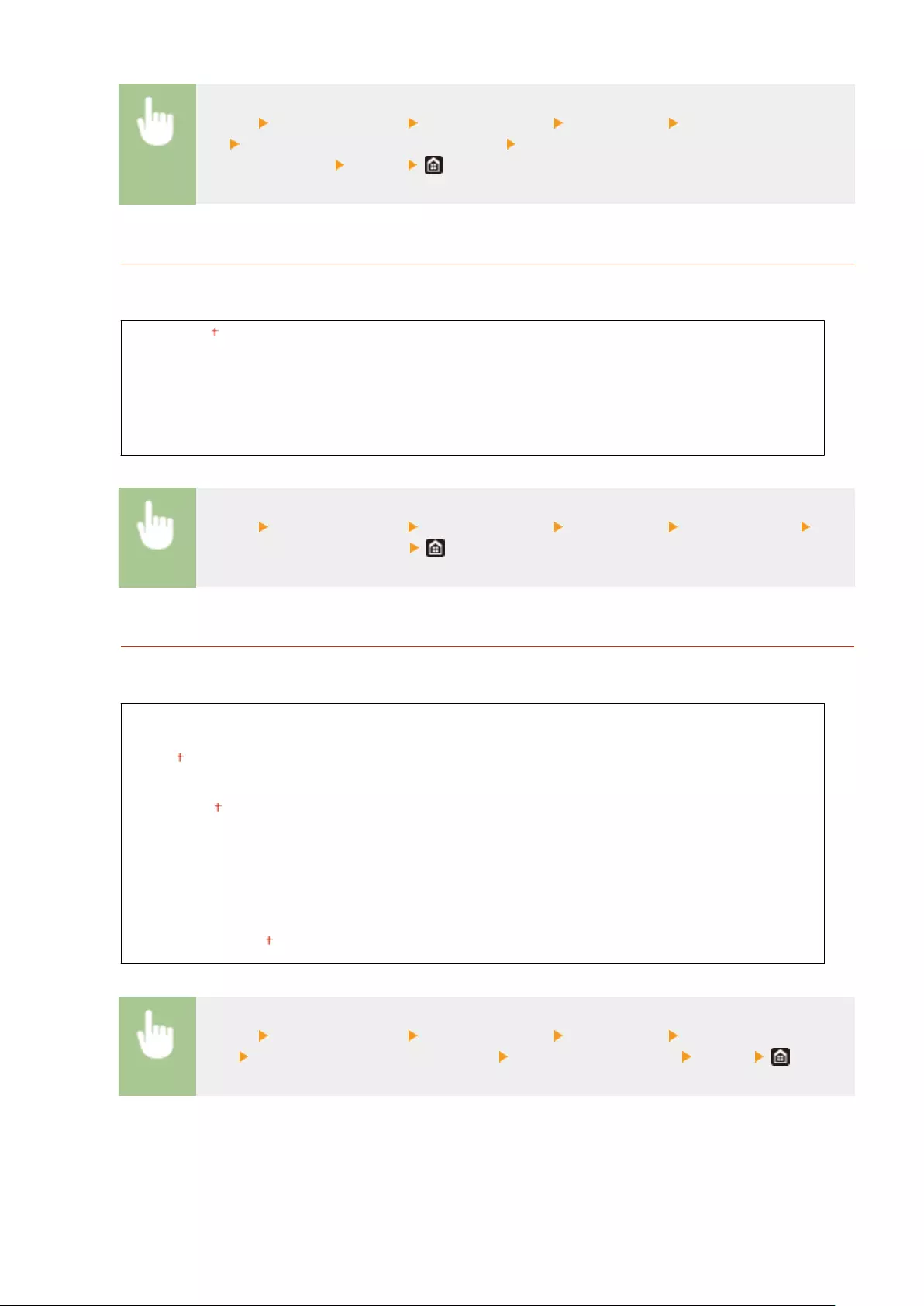
<Menu> <Function Settings> <Receive/Forward> <Fax Settings> <Switch to Auto
RX> Select <On> in <Use Switch to Auto RX> Enter the desired number of seconds in <Ring
Time Until Auto RX> <Apply>
<RX Start Speed>
If it takes a long time to start receiving a fax, such as when there is a poor connection, you can adjust the
communication start speed downward incrementally.
<33600 bps>
<14400 bps>
<9600 bps>
<7200 bps>
<4800 bps>
<2400 bps>
<Menu> <Function Settings> <Receive/Forward> <Fax Settings> <RX Start Speed> Select
the communication start speed
<Use Reduce RX Size>
Specify settings for reducing the image size of a received document. You can select an automatic reduction ratio
that reduces the received document to size of the loaded paper. You can also select a ratio from a list.
<Use Reduce RX Size>
<Off>
<On>
<Reduction Ratio>
<Auto>
<97%>
<95%>
<90%>
<75%>
<Reduction Direction>
<Vertical/Horizontal>
<Vertical Only>
<Menu> <Function Settings> <Receive/Forward> <Fax Settings> <Use Reduce RX
Size> Select <On> in <Use Reduce RX Size> Specify each setting item <Apply>
Setting Menu List
551
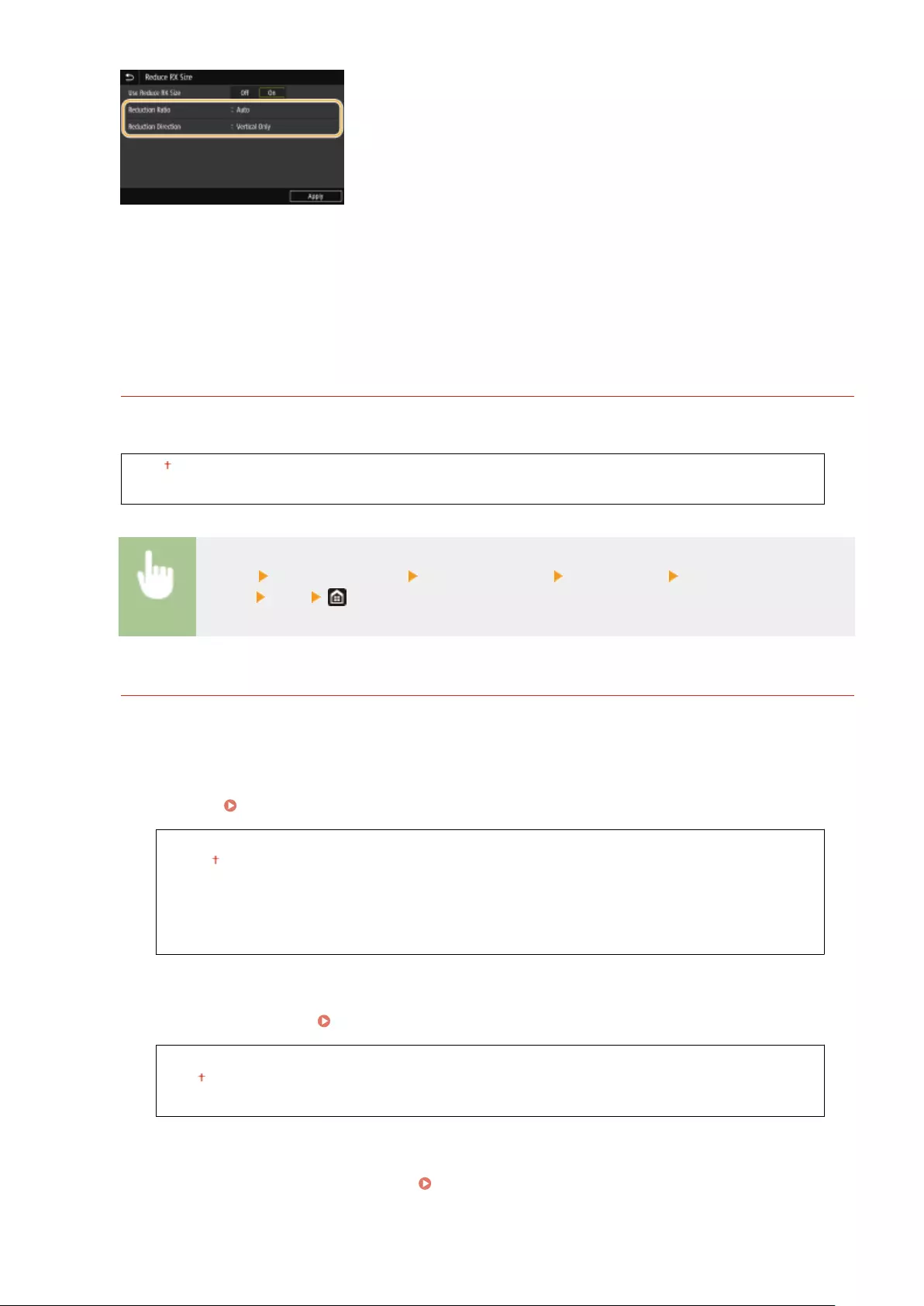
<Reduction Ratio>
<Auto> reduces the image by a ratio that is based on the size of the loaded paper. <97%>, <95%>, <90%>, or
<75%> reduces the image by the corresponding ratio.
<Reduction Direction>
Select <Vertical/Horizontal> to reduce the image both vertically and horizontally. Select <Vertical Only> to
reduce only vertically.
<Print RX Page Footer>
Select whether to print information, including date and time of reception and page numbers, on the bottom of
received faxes.
<Off>
<On>
<Menu> <Function Settings> <Receive/Forward> <Fax Settings> <Print RX Page
Footer> <On>
<Forwarding Settings>
Specify settings for forwarding faxes.
<Forwarding Function> *3
Select whether to forward all the received fax documents to a specied destination. In addition to a fax
number, you can also specify an e-mail address or a shared folder in a computer, etc. as the forwarding
destination. Forwarding the Received Documents Automatically(P. 241)
<Use Forwarding Function>
<Off>
<On>
<Forwarding Destination>
<File Name>
<Print Images>
Select whether to print forwarded fax documents. You can set the machine to print forwarded documents
only when an error occurs. Printing Documents to be Forwarded(P. 242)
<Off>
<On>
<Only When Error Occurs>
<Store Images in Memory>
Select whether to store fax documents in memory when they are not successfully forwarded. You can resend
or print the documents later as necessary. Printing/Resending/Deleting Documents that Failed to be
Forwarded(P. 242)
Setting Menu List
552

<Off>
<Only When Error Occurs>
Setting Menu List
553

<Store/Access Files>
6FR5-098
All the settings related to saving the scanned document to a USB memory device or printing stored les are listed with
descriptions. Default settings are marked with a dagger ( ).
<Common Settings>(P. 554)
<Memory Media Settings>(P. 559)
Asterisks (*)
●Settings marked with an asterisk (*) may not be displayed depending on the model you are using, options, or
other setting items.
<Common Settings>
Change the settings for le saving or memory media print.
<Scan and Store Settings>
Congure settings for saving the scanned document to a USB memory device.
<USB Memory Settings>
You can change the settings used when data is saved to a USB memory device.
<Change Default Settings (USB Memory)>
You can change the default settings used for saving scanned originals to a USB memory device. The
selected settings are used as the default settings when scanning originals. Changing the Default
Settings for Functions(P. 174)
<Scan Size>
<A4>
<A5R>
<A6>
<B5>
<LTR>
<LGL>
<STMT>
<EXEC>
<FOOLSCAP/FOLIO>
<OFICIO>
<LETTER (Government)>
<LEGAL (Government)>
<LEGAL (India)>
<FOOLSCAP (Australia)>
<OFICIO (Brazil)>
<OFICIO (Mexico)>
<File Format>
<PDF>
Setting Menu List
554

<PDF (Compact)>
<PDF (Compact/OCR)>
<PDF (OCR)>
<Set PDF Details>
<PDF>/<PDF (Compact)>/<PDF (Compact/OCR)>/<PDF (OCR)>
<Encryption>*
<None>
<Acrobat 7.0 or Later/128-bit AES>
<Acrobat 9.0 or Equivalent/256-bit AES>*
<Acrobat 10.0 or Equivalent/256-bit AES>*
<Digital Signatures>*
<None>
<Top Left>
<Divide into Pages>
<Off>
<On>
<JPEG>
<TIFF>
<Set TIFF Details>
<Divide into Pages>
<Off>
<On>
<Density>
Nine Levels
<Original Orientation>
<Portrait>
<Landscape>
<Original Type>
<Text>
<Text/Photo>
<Photo>
<2-Sided Original>
<Off>
<Book Type>
<Calendar Type>
<Sharpness>
Seven Levels
<Data Size>
<Small: Memory Priority>
<Standard>
<Large: Image Quality Priority>
Setting Menu List
555

<Access Stored Files Settings>
You can change the settings to print les in a USB memory device and the method for displaying them.
<Change Default Settings (Memory Media Print)>
You can change the default settings associated with memory media print. The settings congured here are
used as the default settings of the memory media print function. Changing the Default Settings for
Functions(P. 174)
<Paper>
<Multi-Purpose Tray>
<Drawer 1>
<Drawer 2>*
<Number of Copies>
1 to 999
<2-Sided Printing>
<Off>
<Book Type>
<Calendar Type>
<Print Quality>
<Density>*
17 Levels
<Fine Adjust>
<High>/<Medium>/<Low>
17 levels
<Toner Save>
<Off>
<On>
<Image Renement>
<Off>
<On>
<Resolution>
<1200 dpi>
<600 dpi>
<Set JPEG/TIFF Details>
<Brightness>
Five Levels
<N on 1>
<Off>
<2 on 1>
<4 on 1>
<Original Type>
<Photo Priority>
<Text Priority>
<Halftones>
<Gradation>
<Error Diffusion>
Setting Menu List
556
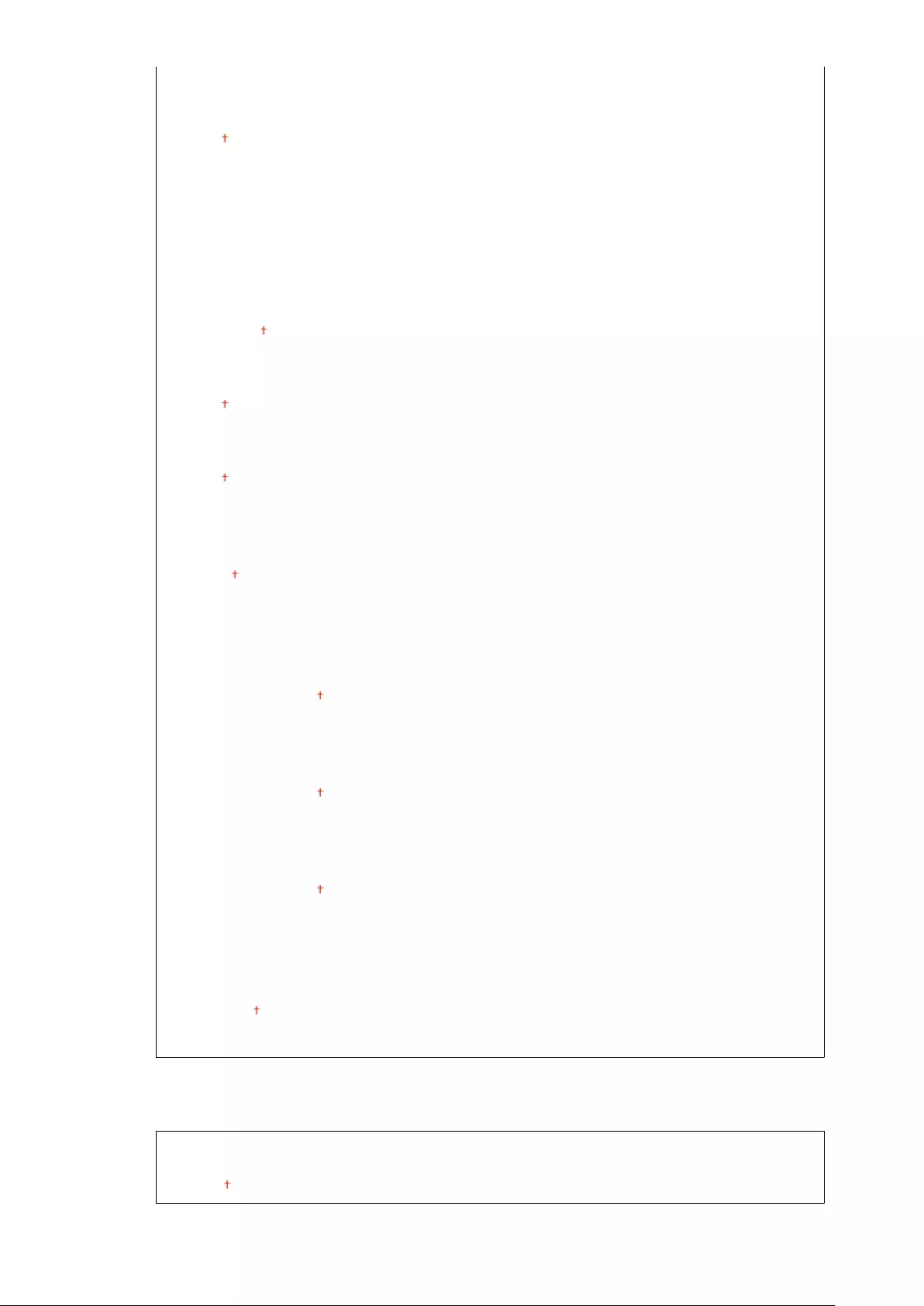
< Set PDF Details>
<N on 1>
<Off>
<2 on 1>
<4 on 1>
<6 on 1>
<8 on 1>
<9 on 1>
<16 on 1>
<Print Range>
<All Pages>
<Specied Pages>
<Enlarge/Reduce to Fit Paper Size>
<Off>
<On>
<Enlarge Print Area>
<Off>
<On>
<Print Comments>
<Off>
<Auto>
<Other Settings>
<Halftones>
<Resolution/Gradation>
<Text>
<Resolution>
<Gradation>
<High Resolution>
<Graphics>
<Resolution>
<Gradation>
<High Resolution>
<Image>
<Resolution>
<Gradation>
<High Resolution>
<Grayscale Conversion>
<sRGB>
<NTSC>
<Uniform RGB>
<Default Display Settings>
Select Preview/Thumbnail/Details as the method for displaying les in a USB memory device.
<Preview>
<Thumbnail>
<Details>
Setting Menu List
557

<Menu> <Function Settings> <Store/Access Files> <Common Settings> <Access Stored
Files Settings> <Default Display Settings> Select the method for displaying
<Preview>
Displays a preview image.
<Thumbnail>
Displays thumbnail images.
<Details>
Displays le names and dates in list form.
<File Sort Default Settings>
Select whether to display les in a USB memory device in ascending or descending order of le name or date.
<Name (Ascending)>
<Name (Descending)>
<Date/Time (Ascending)>
<Date/Time (Descending)>
<Menu> <Function Settings> <Store/Access Files> <Common Settings> <Access Stored
Files Settings> <File Sort Default Settings> Select the order of les that are displayed
<File Name Display Format>
Select whether to display short or long text for le names that are stored in a USB memory device.
<Short File Name>
<Long File Name>
<Menu> <Function Settings> <Store/Access Files> <Common Settings> <Access Stored
Files Settings> <File Name Display Format> Select <Short File Name> or <Long File Name>
Setting Menu List
558
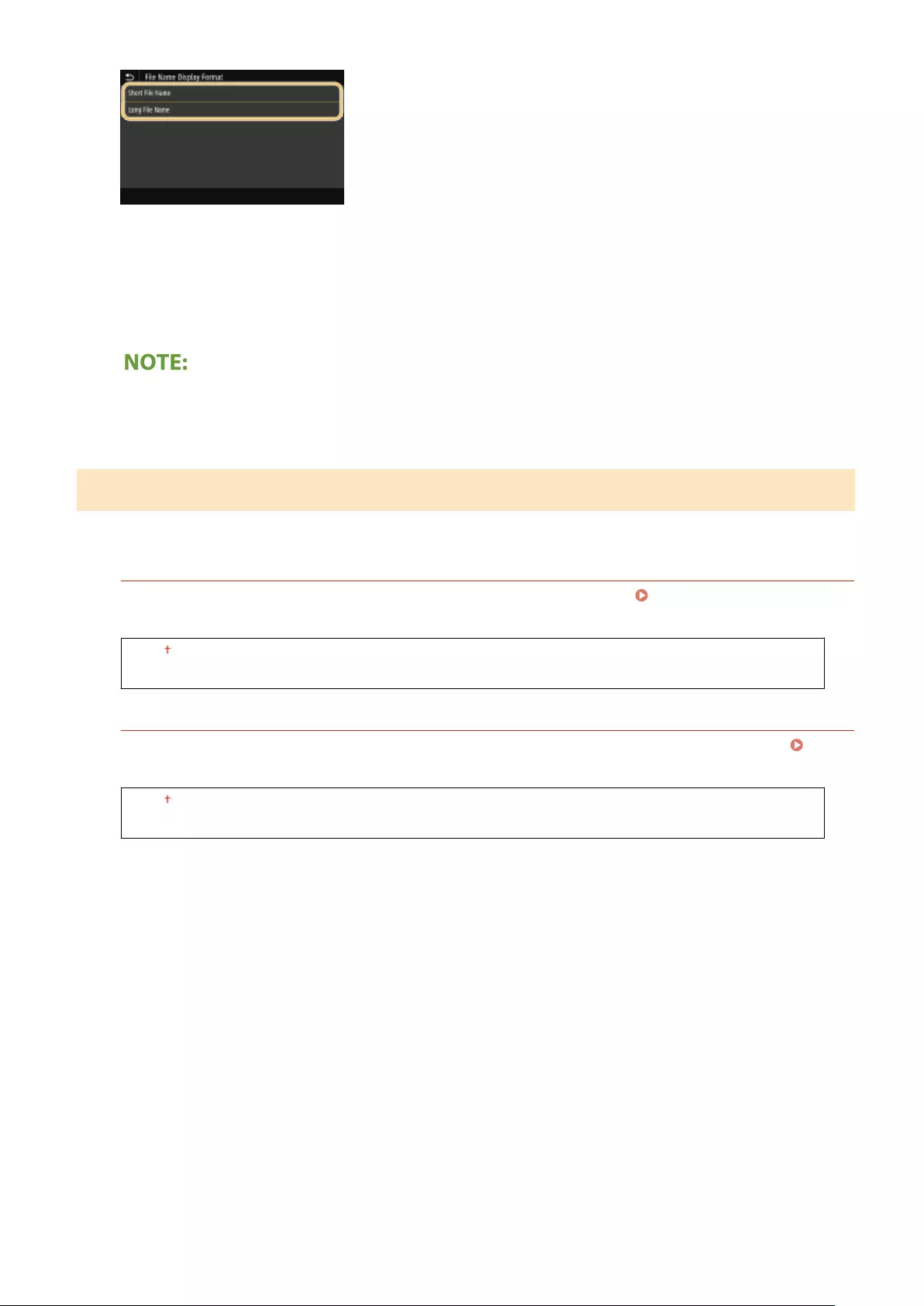
<Short File Name>
Shortens a le name to as few as eight characters. To distinguish les that have similar names, numbers such as
"~1" or "~2" are added at the end of the le names.
<Long File Name>
Displays a le name up to 40 characters.
●The number of characters described above does not include the characters in le extensions, such as ".jpg."
<Memory Media Settings>
Specify whether to enable or disable the functions of a USB memory device.
<Use Scan Function>
Select whether to permit storing scanned originals into a USB memory device. Restricting the Scan to USB
Function(P. 421)
<Off>
<On>
<Use Print Function>
Select whether to permit printing data from a USB memory device when it is attached to the machine.
Restricting the USB Print Function(P. 421)
<Off>
<On>
Setting Menu List
559
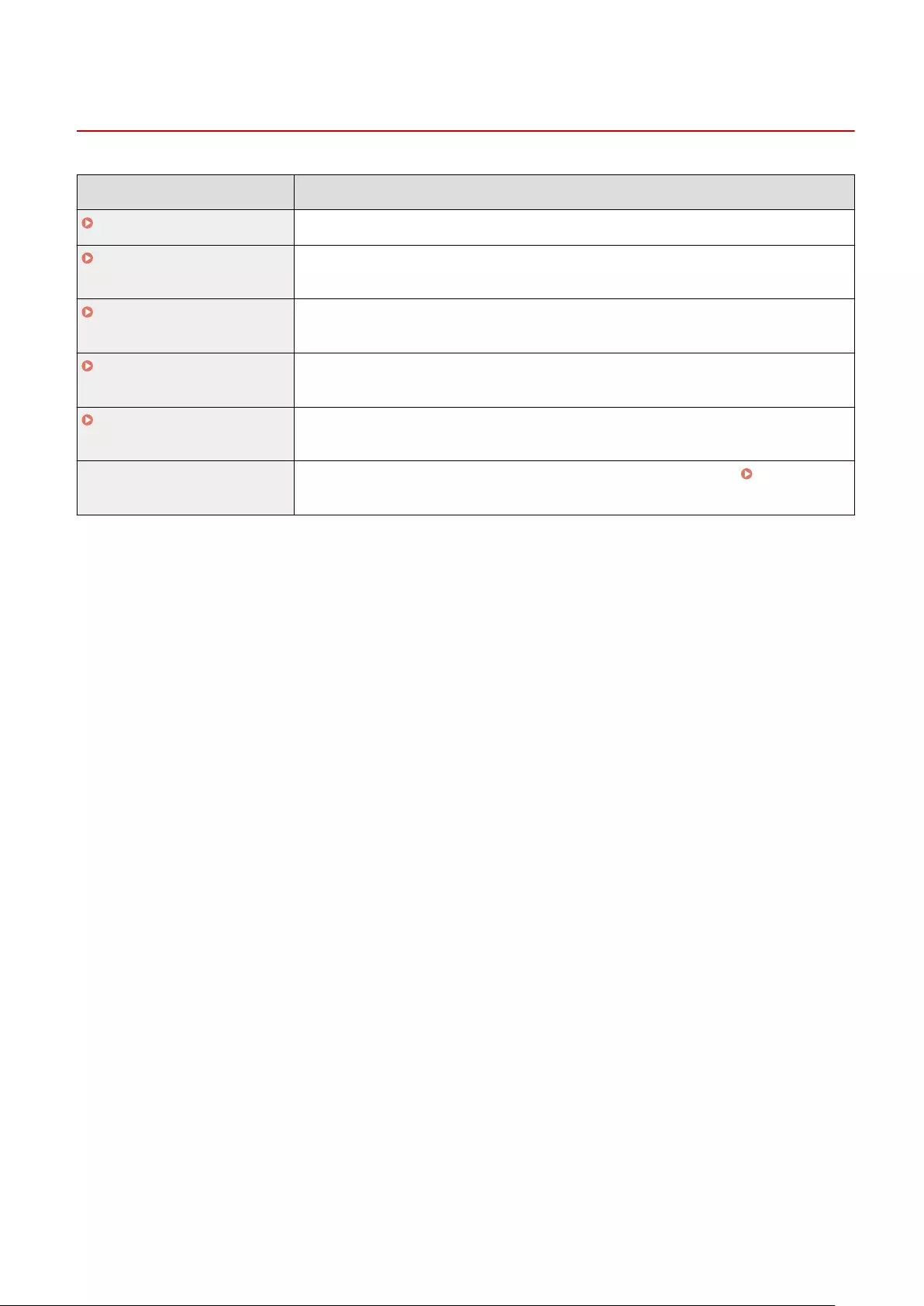
<Management Settings>
6FR5-09C
Item Description
<User Management>(P. 563) You can congure the settings for managing users of the machine.
<Device Management>(P. 564) You can manage information about the hardware and operations, as well as various data
required when using the machine functions.
<License/Other>(P. 567) You can congure the settings related to the Remote UI and software available for the
machine.
<Data Management>(P. 569) You can congure settings to utilize data such as machine settings data or perform data
initialization.
<Security Settings>(P. 571) You can congure the settings related to the user authentication function, password, and
encryption.
<Initialize All Data/Settings> Restores all data including logs and setting values to their default settings. Initializing All
Data/Settings(P. 456)
Setting Menu List
562
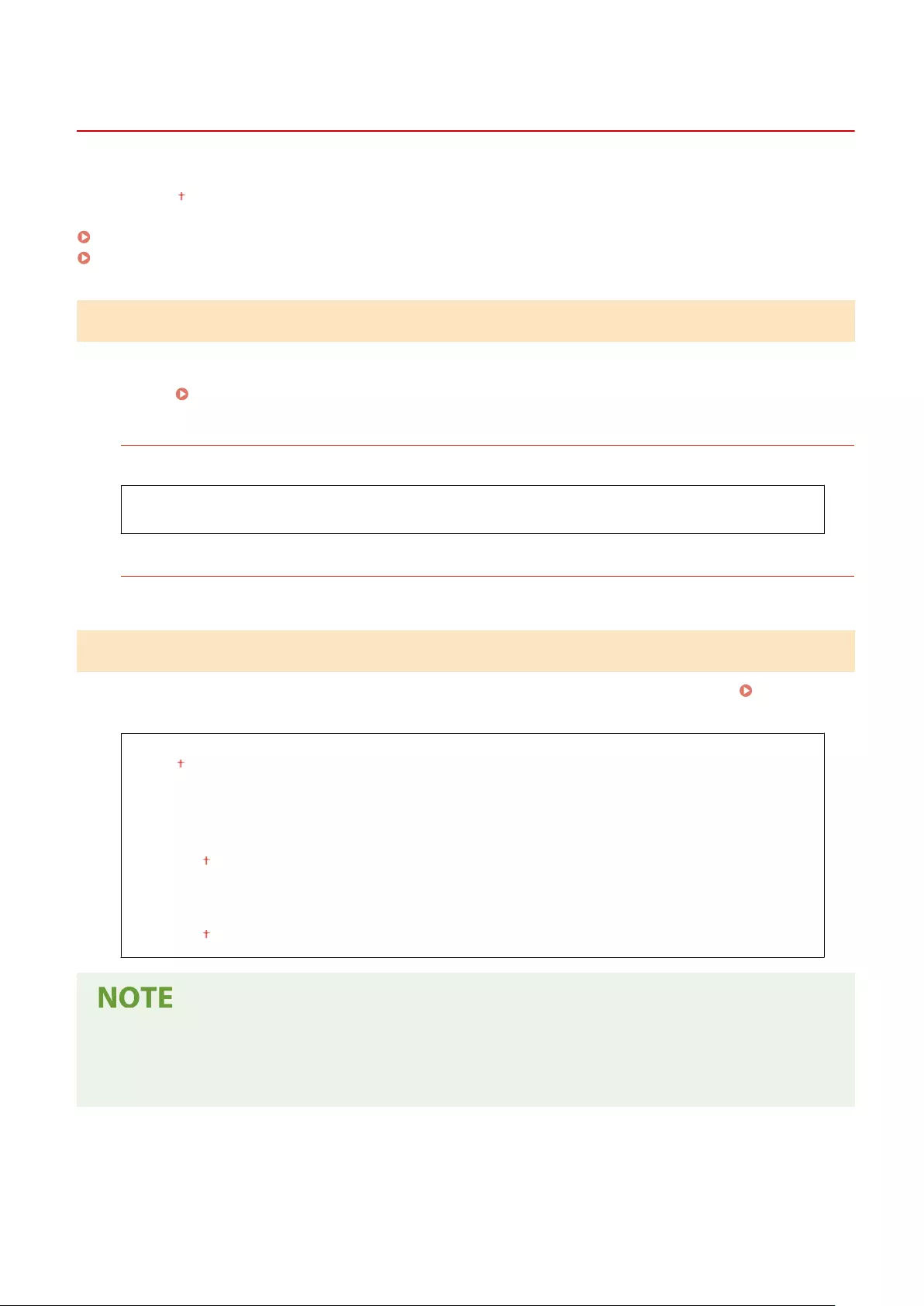
<User Management>
6FR5-09E
All the settings related to user management of the machine are listed with descriptions. Default settings are marked
with a dagger ( ).
<System Manager Information Settings>(P. 563)
<Department ID Management>(P. 563)
<System Manager Information Settings>
Specify the ID or PIN exclusively for Administrators who have access privileges to <Network> and <Management
Settings>. ID is <System Manager ID> and PIN is <System Manager PIN>. You can also register the name of an
Administrator. Setting the System Manager ID and PIN(P. 363)
<System Manager ID and PIN>
Enter a number for the System Manager ID and PIN.
<System Manager ID>
<System Manager PIN>
<System Manager Name>
Enter alphanumeric characters for the name of an Administrator.
<Department ID Management>
Set the Department ID Management function to control access to the machine by using multiple IDs. Setting the
Department ID Management(P. 365)
<Department ID Management>
<Off>
<On>
<Allow Print Jobs (Unknown IDs)>
<Off>
<On>
<Allow Scan Jobs (Unknown IDs)>
<Off>
<On>
●You can select <Register/Edit> to register department IDs and edit the settings of the registered IDs.
●You can select <Count Mngt.> to check the total number of pages for jobs that have been executed to date
on a department ID basis.
Setting Menu List
563
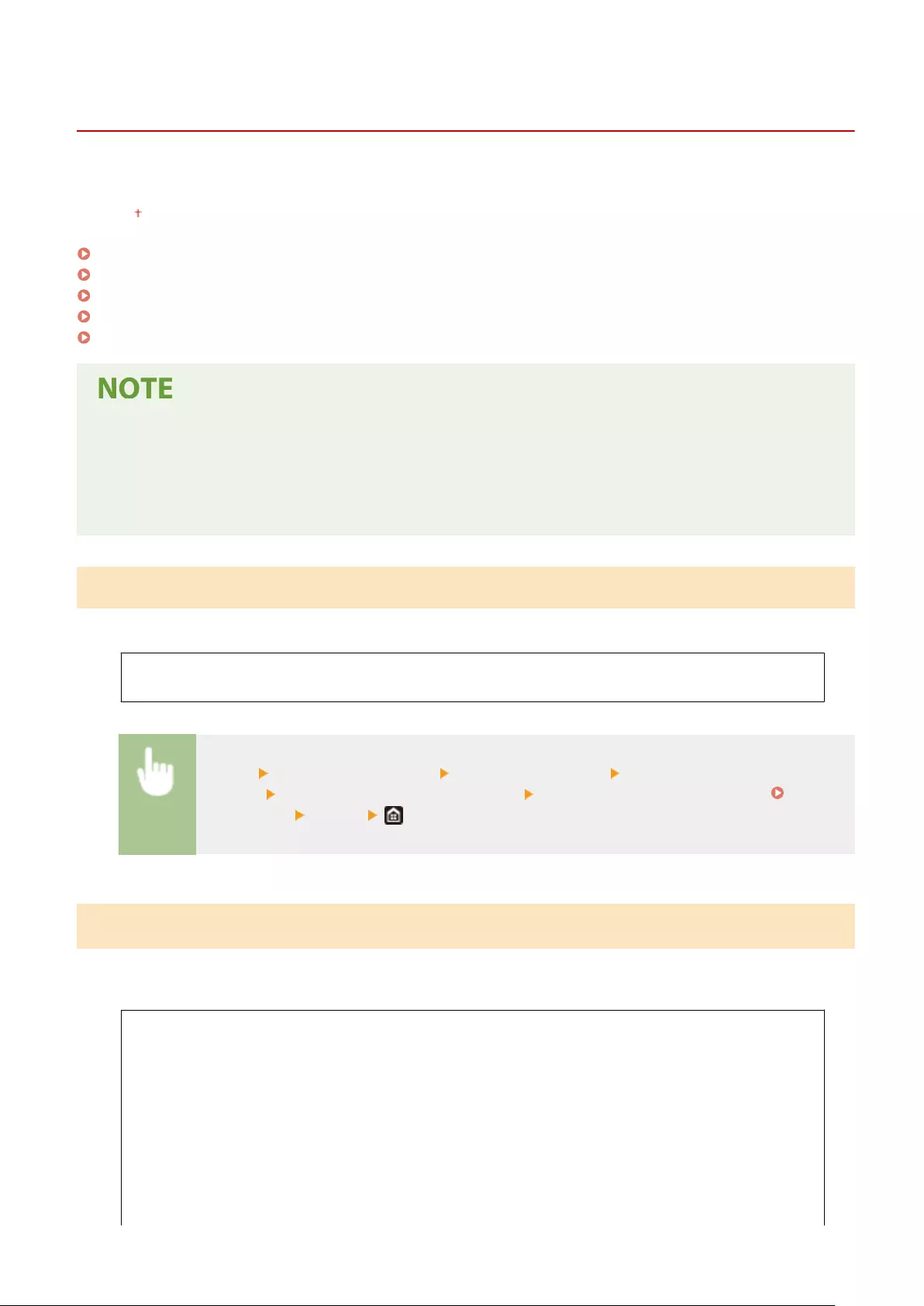
<Device Management>
6FR5-09F
All the settings related to management of information for the hardware and operations, as well as about management
of data required when using the machine functions are listed with descriptions. Default settings are marked with a
dagger ( ).
<Device Information Settings>(P. 564)
<Select Country/Region>(P. 564)
<Display Job Log>(P. 565)
<Scan w/Canon PRINT Business>(P. 565)
<Notify to Check Paper Settings>(P. 565)
Asterisks (*)
●Settings marked with "*1" cannot be imported or exported.
●Settings marked with "*2" may be unavailable or vary or have different defaults depending on your country
or region.
<Device Information Settings>
Enter alphanumeric characters for the name and the installation location to identify the machine.
<Device Name>
<Location>
<Menu> <Management Settings> <Device Management> <Device Information
Settings> Select <Device Name> or <Location> Enter the device name or location ( Entering
Text(P. 133) ) <Apply>
<Select Country/Region> *1 *2
Specify the country or region where the machine is used. The default setting may vary depending on the setting
selected at initial power-on.
<Austria (AT)>
<Belarus (BY)>
<Belgium (BE)>
<Czech Republic (CZ)>
<Denmark (DK)>
<Egypt (EG)>
<Finland (FI)>
<France (FR)>
<Germany (DE)>
<Greece (GR)>
<Netherlands (NL)>
<Norway (NO)>
<Poland (PL)>
<Portugal (PT)>
<Russia (RU)>
<Saudi Arabia (SA)>
<Slovenia (SI)>
<South Africa (ZA)>
<Spain (ES)>
<Sweden (SE)>
Setting Menu List
564
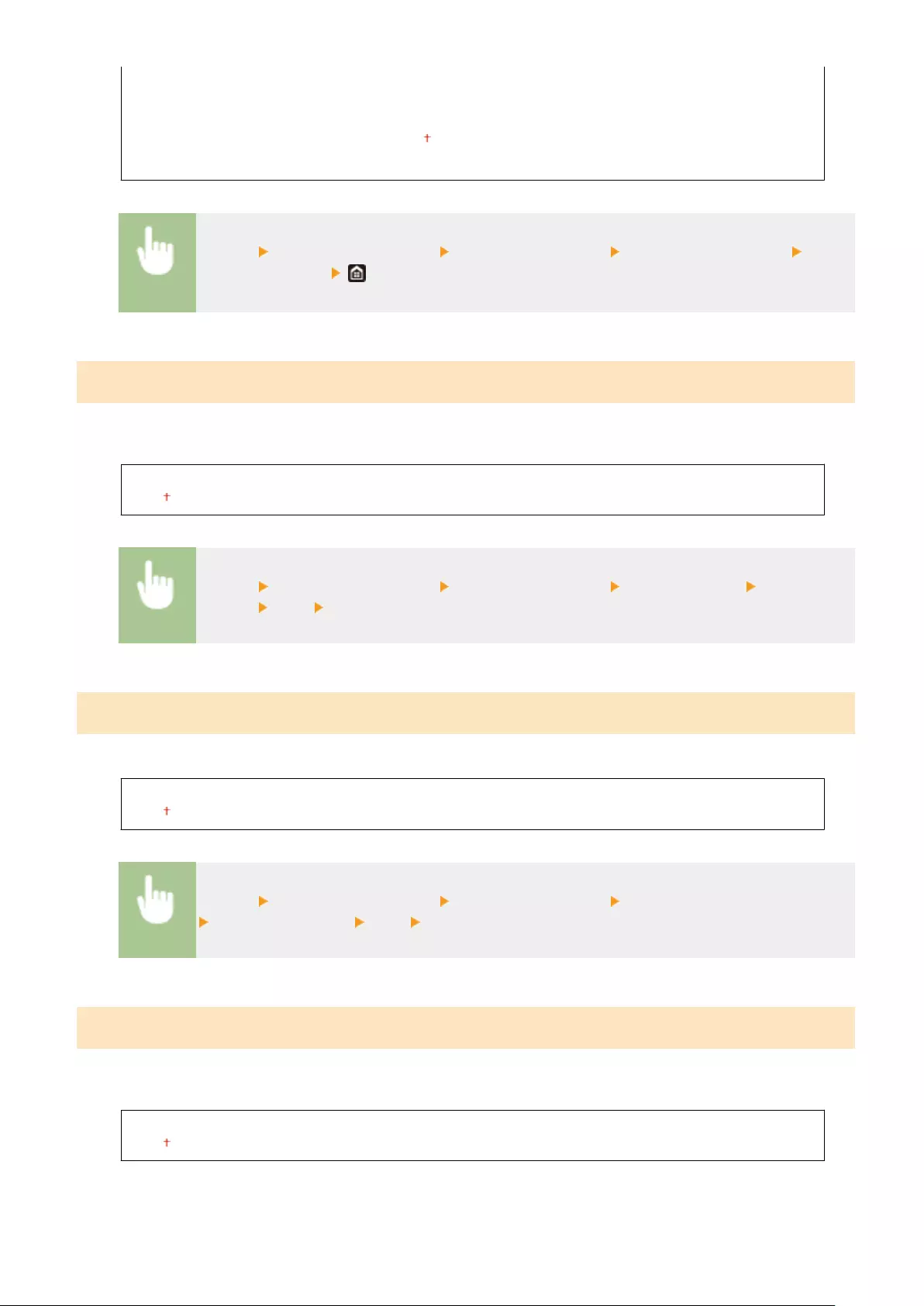
<Hungary (HU)>
<Ireland (IE)>
<Italy (IT)>
<Jordan (JO)>
<Luxembourg (LU)>
<Switzerland (CH)>
<United Arab Emirates (AE)>
<Ukraine (UA)>
<Great Britain (GB)>
<Other>
<Menu> <Management Settings> <Device Management> <Select Country/Region> Select
a country or region
<Display Job Log>
Select whether to display the copying, printing, faxing, and scanning logs on the display of the machine and in the
Communication Management Report.
<Off>
<On>
<Menu> <Management Settings> <Device Management> <Display Job Log> Select <Off>
or <On> <OK> Restart the machine
<Scan w/Canon PRINT Business>
Select whether to allow scanning from a mobile device using the Canon PRINT Business application.
<Off>
<On>
<Menu> <Management Settings> <Device Management> <Scan w/Canon PRINT Business>
Select <Off> or <On> <OK> Restart the machine
<Notify to Check Paper Settings>
Specify whether to display a message prompting you to check paper settings when loading the paper drawer into the
machine.
<Off>
<On>
Setting Menu List
565

<Menu> <Management Settings> <Device Management> <Notify to Check Paper Settings>
Select <Off> or <On> <OK> Restart the machine
Setting Menu List
566
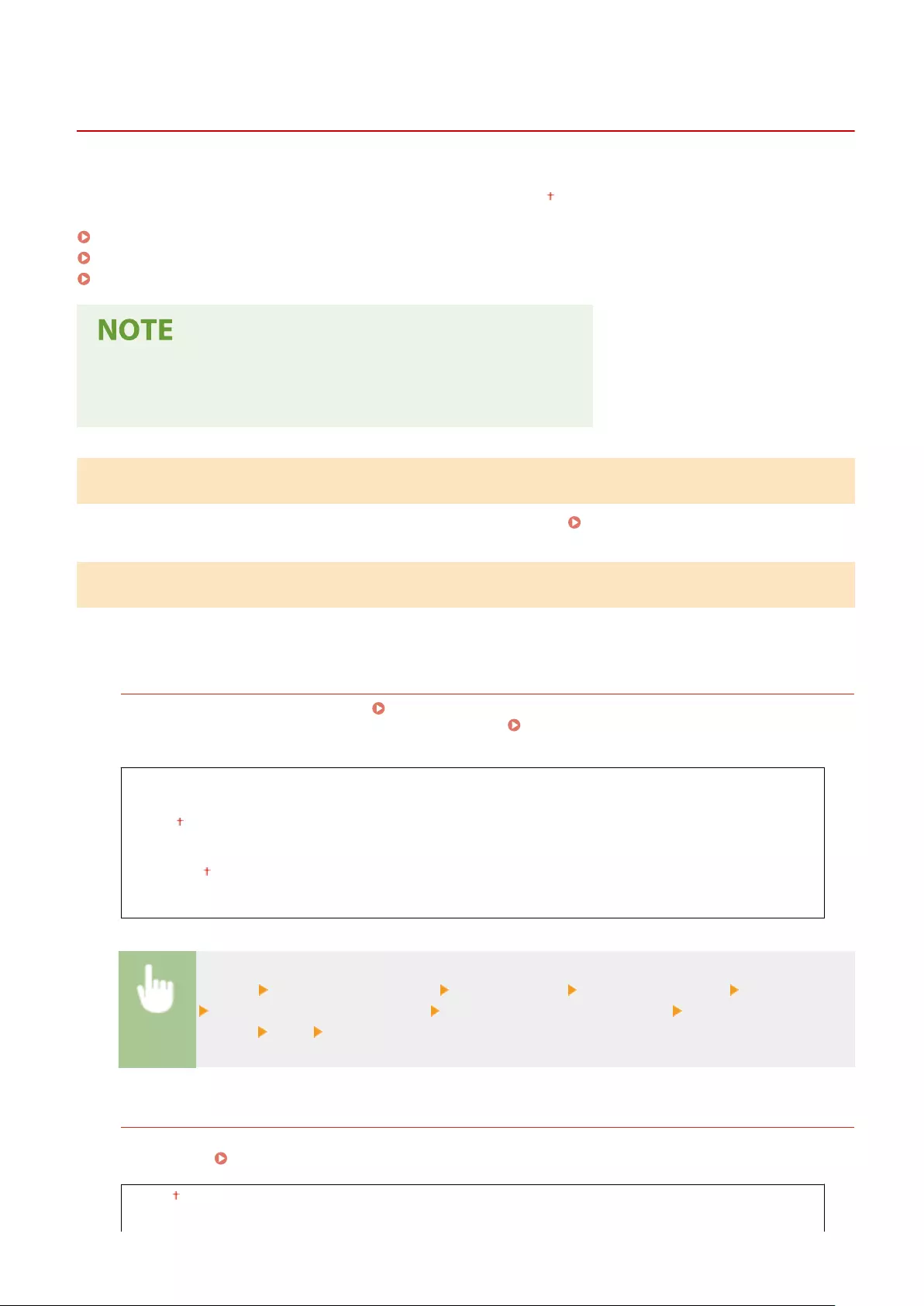
<License/Other>
6FR5-09H
All the settings related to the software and system options available for the machine as well as about Register License
are listed with descriptions. Default settings are marked with a dagger ( ).
<Register License>(P. 567)
<Remote UI Settings>(P. 567)
<Update Firmware>(P. 568)
Asterisks (*)
●Settings marked with an asterisk (*) cannot be imported or exported.
<Register License> *
Enter the license key for a system option that can be used on the machine. License Registration(P. 641)
<Remote UI Settings> *
Congure settings for using the Remote UI. Using the Remote UI allows you to congure machine settings from a Web
browser.
<Remote UI>
Select whether to use the Remote UI ( Disabling Remote UI(P. 424) ). When using Remote UI, you can also
specify whether to use the TLS encrypted communication ( Conguring the Key and Certicate for
TLS(P. 389) ).
<Use Remote UI>
<Off>
<On>
<Use TLS>
<Off>
<On>
<Menu> <Management Settings> <License/Other> <Remote UI Settings> <Remote UI>
Select <On> in <Use Remote UI> Select <Off> or <On> in <Use TLS>
<Apply> <OK> Restart the machine
<Restrict Access>
Specify so that entry of a PIN is required for access to the Remote UI. Set a PIN of up to 7 digits. All users use a
common PIN. Setting a Remote UI PIN(P. 371)
<Off >
Setting Menu List
567
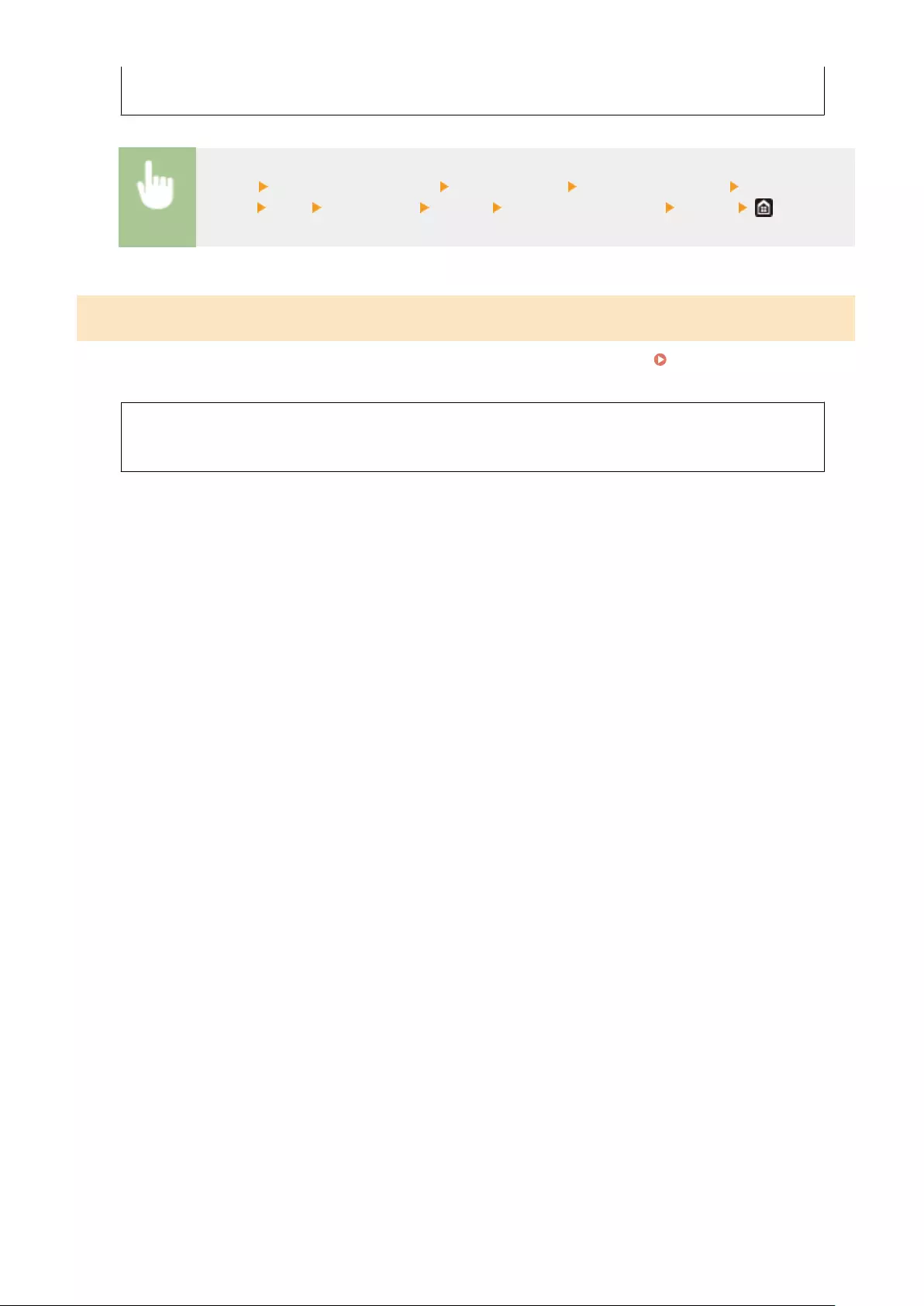
<On>
<Remote UI Access PIN>
<Menu> <Management Settings> <License/Other> <Remote UI Settings> <Restrict
Access> <On> Enter the PIN <Apply> Enter the PIN (Conrm) <Apply>
<Update Firmware> *
Select how to install the rmware update according to the environment of the machine. Updating the
Firmware(P. 453)
<Via PC>
<Via Internet>
<Version Information>
Setting Menu List
568
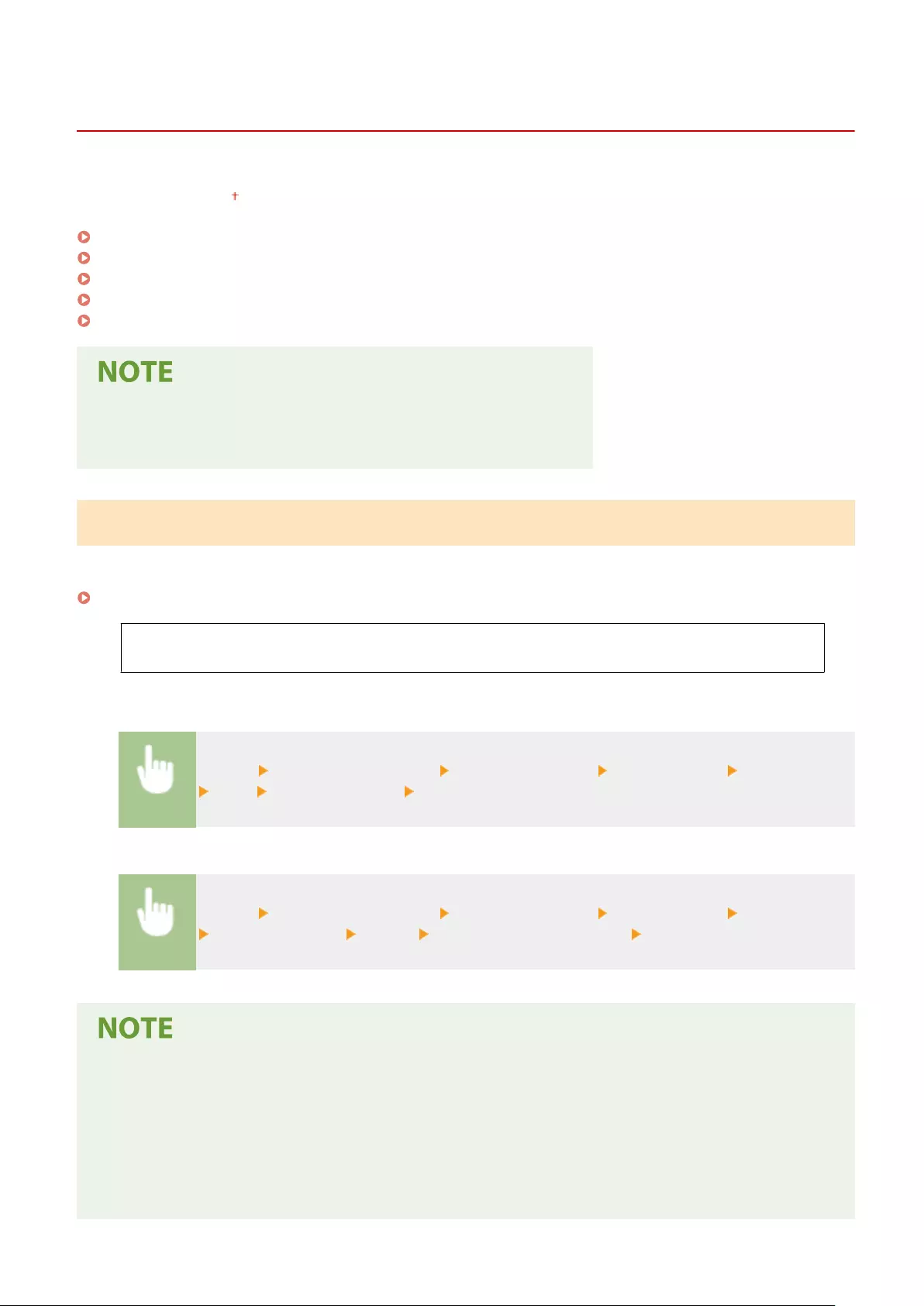
<Data Management>
6FR5-09J
The settings for utilizing the machine settings and for initializing data are listed with descriptions. Default settings are
marked with a dagger ( ).
<Import/Export>(P. 569)
<Enable Prod. Ext'd Survey Prog.>(P. 570)
<Initialize Key and Certicate>(P. 570)
<Initialize Address Book>(P. 570)
<Initialize Menu>(P. 570)
Asterisks (*)
●Settings marked with an asterisk (*) cannot be imported or exported.
<Import/Export> *
You can use a USB memory device to import and export data in the Address Book and various settings of the machine.
For more information about the available USB memory devices and how to insert/remove the USB memory device, see
Using a USB Memory Device(P. 188) .
<Import>
<Export>
Import
<Menu> <Management Settings> <Data Management> <Import/Export> <Import>
<Yes> Enter the password <Apply>
Export
<Menu> <Management Settings> <Data Management> <Import/Export> <Export>
Enter the password <Apply> Enter the password (Conrm) <Apply>
If the <Address Book PIN> screen appears
●If a PIN has been set for the Address Book, the <Address Book PIN> screen appears during importing/
exporting. Enter the Address Book PIN and select <Apply>. Select <Skip> to cancel Address Book data
importing/exporting.
When import is executed
●The machine automatically restarts after the import process has nished.
Setting Menu List
569
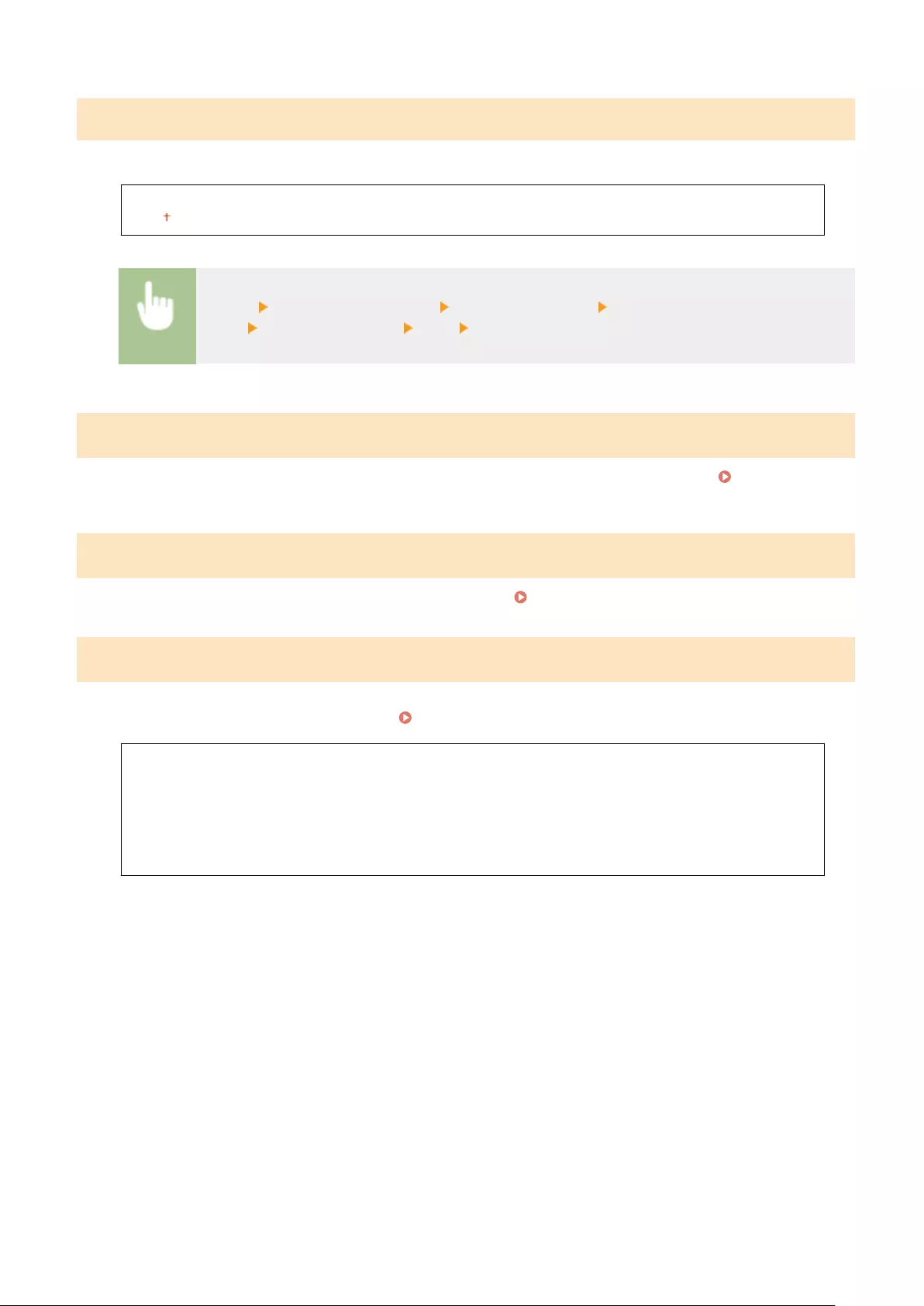
<Enable Prod. Ext'd Survey Prog.>
Enable or disable the Product Extended Survey Program (a program for the machine usage survey).
<Off>
<On>
<Menu> <Management Settings> <Data Management> <Enable Prod. Ext'd Survey
Prog.> Select <Off> or <On> <OK> Restart the machine
<Initialize Key and Certicate> *
Select to restore [Key and Certicate Settings] and [CA Certicate Settings] to the factory defaults. Initializing Key
and Certicate(P. 455)
<Initialize Address Book> *
Select to restore the Address Book settings to the factory defaults. Initializing Address Book(P. 456)
<Initialize Menu> *
Select to restore the settings listed below to the factory defaults. You can restore all the settings listed below at once,
or you can restore individual settings separately. Initializing Menu(P. 455)
<Preferences>
<Adjustment/Maintenance>
<Function Settings>
<Set Destination>
<Management Settings>
<Initialize All>
Setting Menu List
570
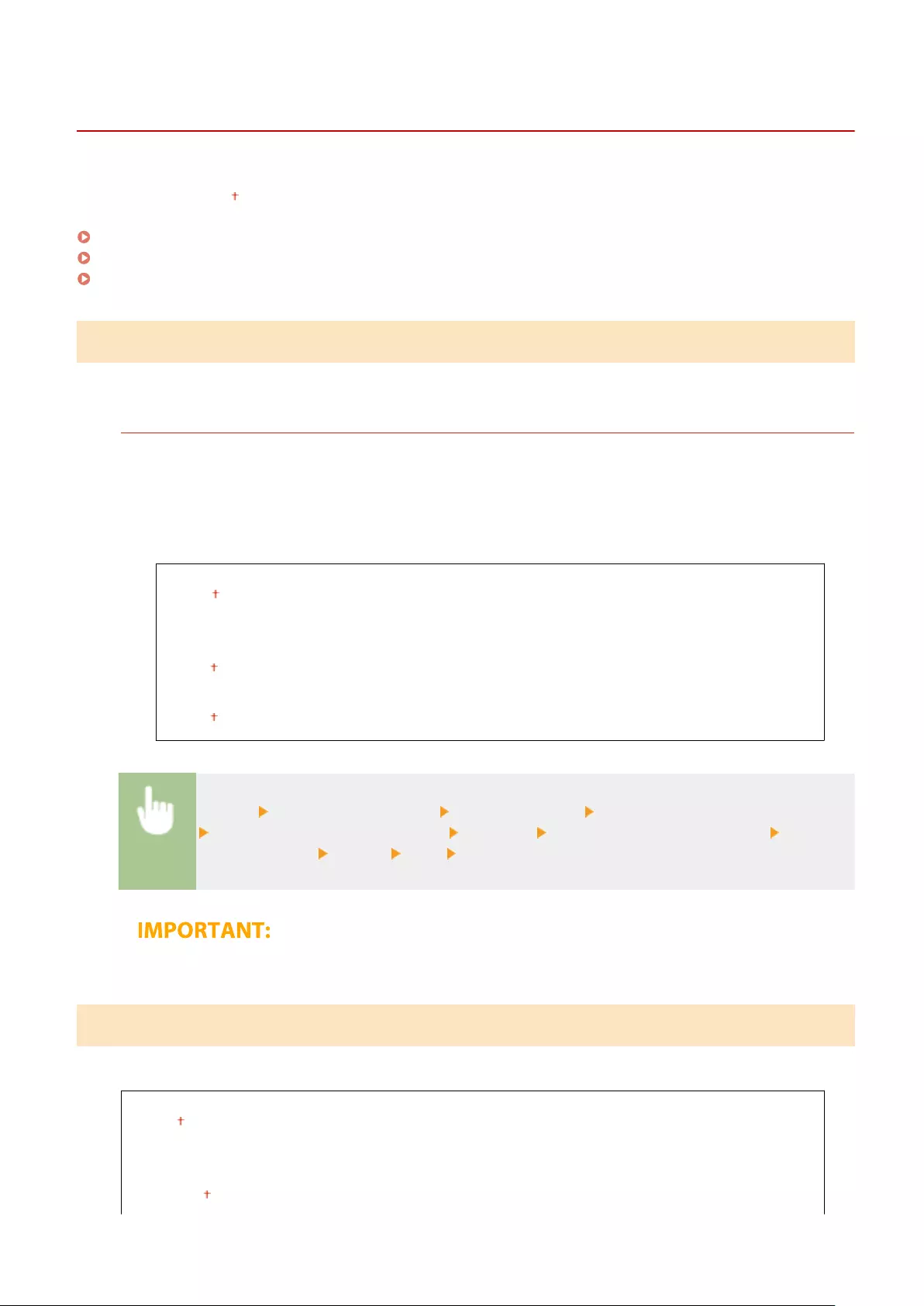
<Security Settings>
6FR5-09K
All the settings related to the authentication function and encryption are listed with descriptions. Default Settings are
marked with a dagger ( ).
<Authentication/Password Settings>(P. 571)
<Encryption Settings>(P. 571)
<Verify System at Startup>(P. 572)
<Authentication/Password Settings>
You can reinforce the security of the authentication function.
<Authentication Function Settings>
Congure the security functions for user authentication.
<Lockout>
When a user has failed user authentication, specify whether to disable the user from temporarily logging in
to the machine (lockout). When <On> is selected, specify how many consecutive times failures are permitted
before lockout is activated and also the time required before a user can log in again after lockout.
<Enable Lockout>
<Off>
<On>
<Lockout Threshold>
1 to 10 (time(s))
<Lockout Period>
1 to 60 (min.)
<Menu> <Management Settings> <Security Settings> <Authentication/Password Settings>
<Authentication Function Settings> <Lockout> Select <On> in <Enable Lockout> Specify
each setting item <Apply> <OK> Restart the machine
●This option is not applied to login using the department ID.
<Encryption Settings>
Congure a setting for disabling a weak encryption or the key and certication using a weak encryption.
<Prohibit Use of Weak Encrypt.>
<Off>
<On>
<Prohibit Weak Encryp. Key/Cert.>
<Off>
Setting Menu List
571
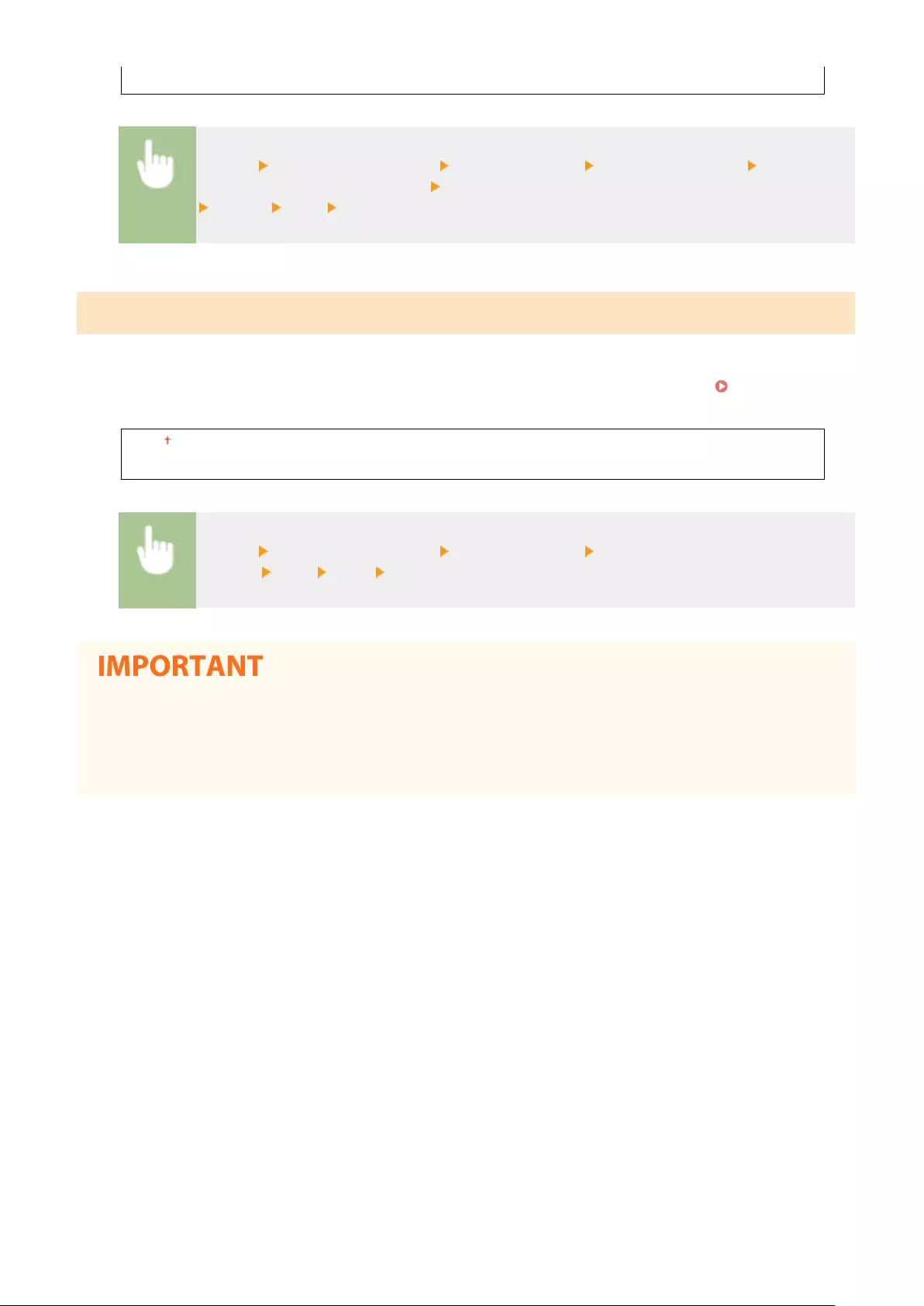
<On>
<Menu> <Management Settings> <Security Settings> <Encryption Settings> Select <On>
in <Prohibit Use of Weak Encrypt.> Select <Off> or <On> in <Prohibit Weak Encryp. Key/Cert.>
<Apply> <OK> Restart the machine
<Verify System at Startup>
When the machine starts or when an application (in Application Library) is executed, verication is performed to
determine that the system or application has not been tampered. If tampering is detected, the machine enters a state
to wait for rmware update. In this case, perform a rmware update operation from a computer. Updating the
Firmware(P. 453)
<Off>
<On>
<Menu> <Management Settings> <Security Settings> <Verify System at
Startup> <On> <Yes> Restart the machine automatically
●If nothing is displayed even after a while, system recovery may be impossible. In this case, contact your local
authorized Canon dealer or the Canon help line.
●If an application installed after shipping of the machine from the factory has been tampered, it needs to be
reinstalled on the machine.
Setting Menu List
572

Maintenance
Maintenance ..................................................................................................................................................... 574
Regular Cleaning ............................................................................................................................................... 576
Cleaning the Exterior .................................................................................................................................... 577
Cleaning the Platen Glass ............................................................................................................................. 578
Cleaning the Feeder ..................................................................................................................................... 579
Cleaning the Fixing Assembly ....................................................................................................................... 582
Replacing the Toner Cartridge ......................................................................................................................... 583
Checking the Remaining Amount of Consumables ......................................................................................... 587
Adjusting Image Quality ................................................................................................................................... 588
Adjusting the Gradation and Density for Copy Jobs ...................................................................................... 589
Adjusting Values for Text Color Reproducibility ............................................................................................ 591
Adjusting Print Density ................................................................................................................................. 593
Adjusting Print Position ................................................................................................................................ 594
Viewing the Counter Value ............................................................................................................................... 596
Printing Reports and Lists ................................................................................................................................ 597
Replacement Parts ............................................................................................................................................ 602
Maintenance
573
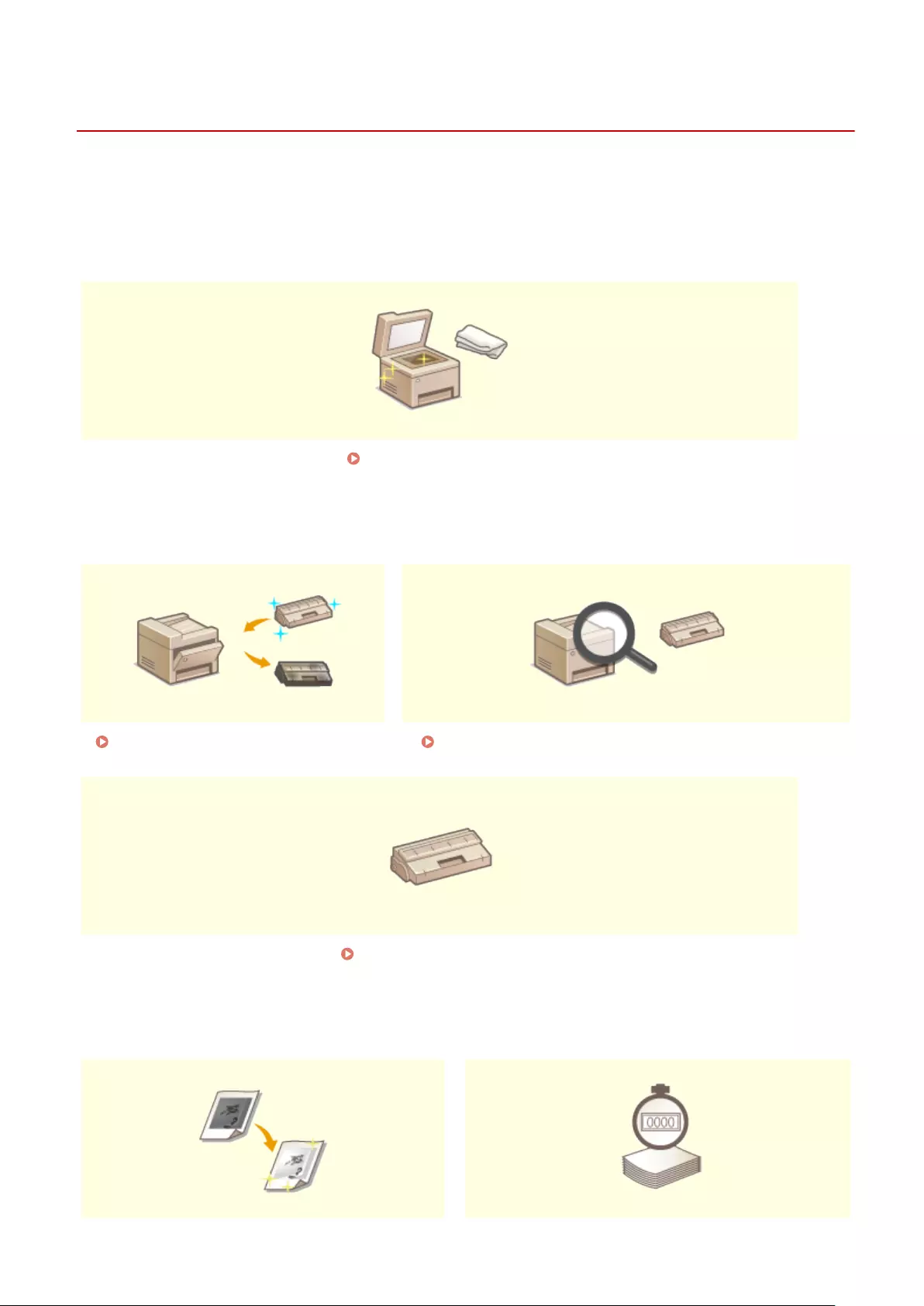
Maintenance
6FR5-09L
This chapter describes upkeep of the machine, including how to clean the machine and adjustment of print quality.
◼Basic Cleaning
Regular Cleaning(P. 576)
◼Replacing Consumables
Replacing the Toner Cartridge(P. 583) Checking the Remaining Amount of Consumables(P. 587)
Replacement Parts(P. 602)
◼Adjusting and Managing the Machine
Maintenance
574
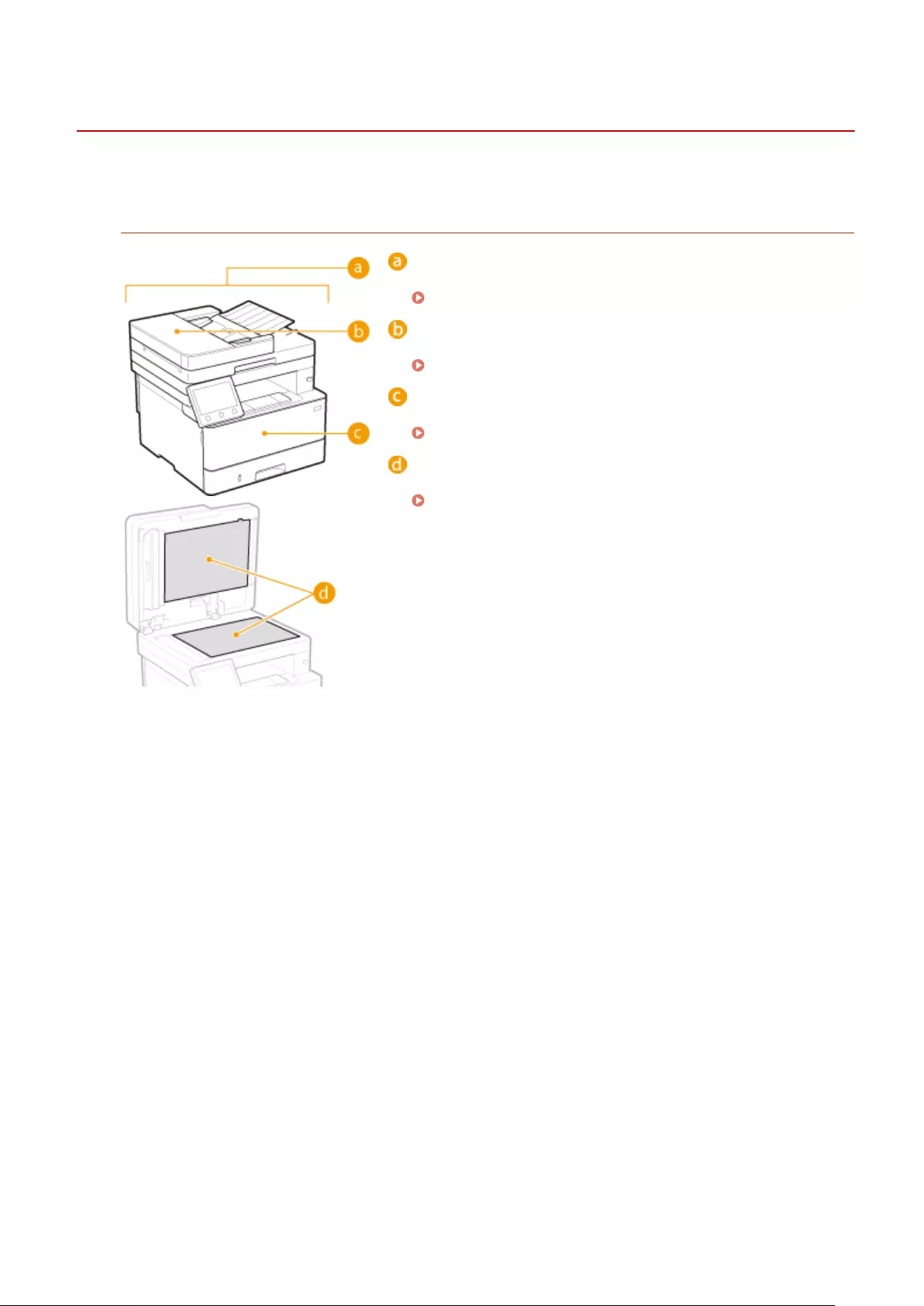
Regular Cleaning
6FR5-09R
Regularly clean the machine to prevent deterioration in printing quality and to ensure that you use it safely and easily.
Where to Clean
Exterior of the machine and ventilation slots
Cleaning the Exterior(P. 577)
Feeder
Cleaning the Feeder(P. 579)
Internal xing assembly
Cleaning the Fixing Assembly(P. 582)
Platen glass and the underside of the feeder
Cleaning the Platen Glass(P. 578)
Maintenance
576
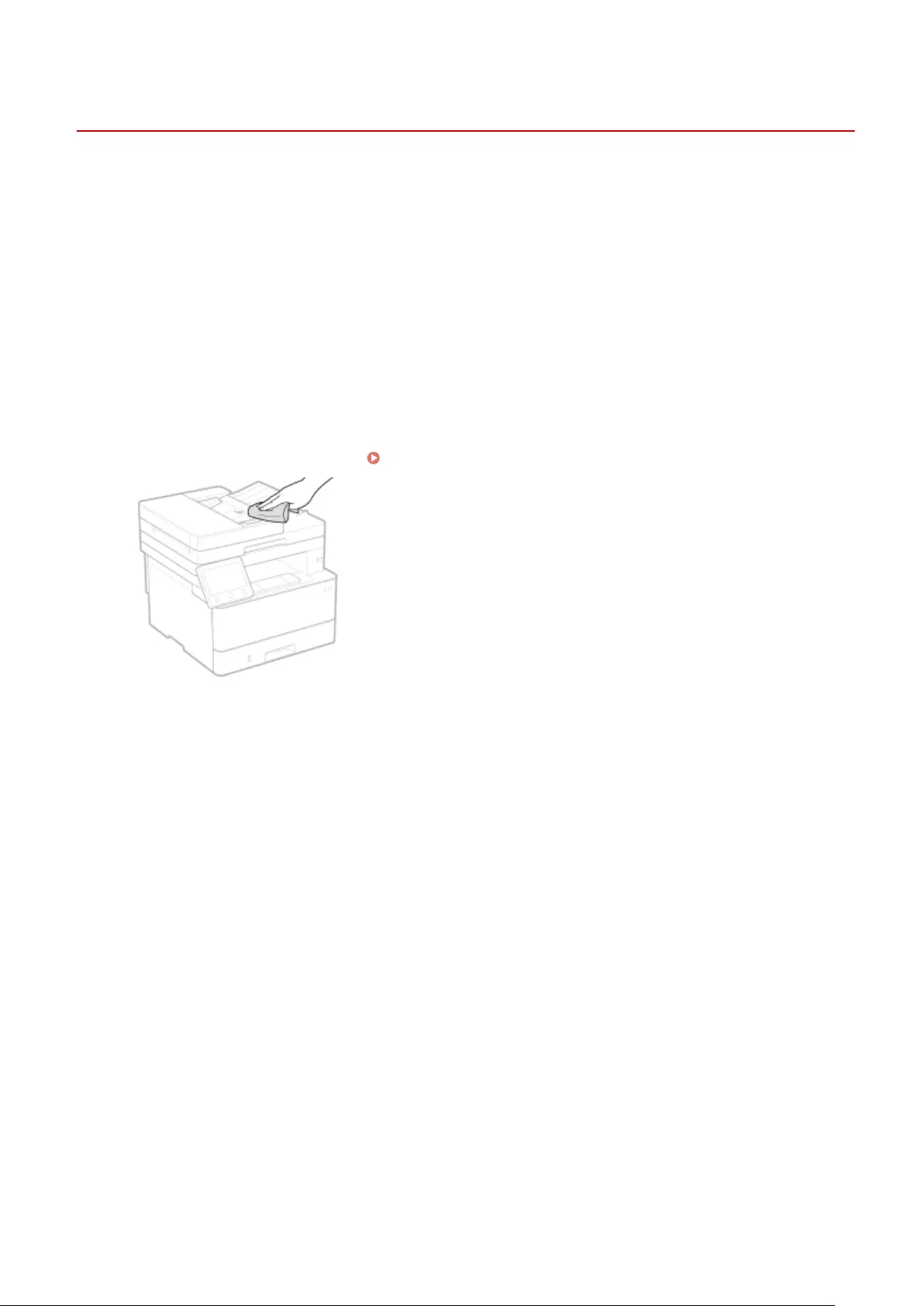
Cleaning the Exterior
6FR5-09S
Regularly wipe the exterior of the machine, especially around the ventilation slots, to keep the machine in good
condition.
1Turn OFF the machine, and unplug the power cord from the AC power outlet.
●When you turn OFF the machine, data that is waiting to be printed is deleted. Fax documents that were
received by using the Memory Reception function, faxes that are waiting to be sent, and reports that are
automatically printed after sending and receiving faxes are not deleted.
2Clean the exterior of the machine and the ventilation slots.
●Use a soft, well-wrung-out cloth dampened with water or a mild detergent diluted with water.
●To locate the ventilation slots, see Front Side(P. 105) .
3Wait for the exterior of machine to dry completely.
4Reconnect the power cord and turn ON the machine.
Maintenance
577
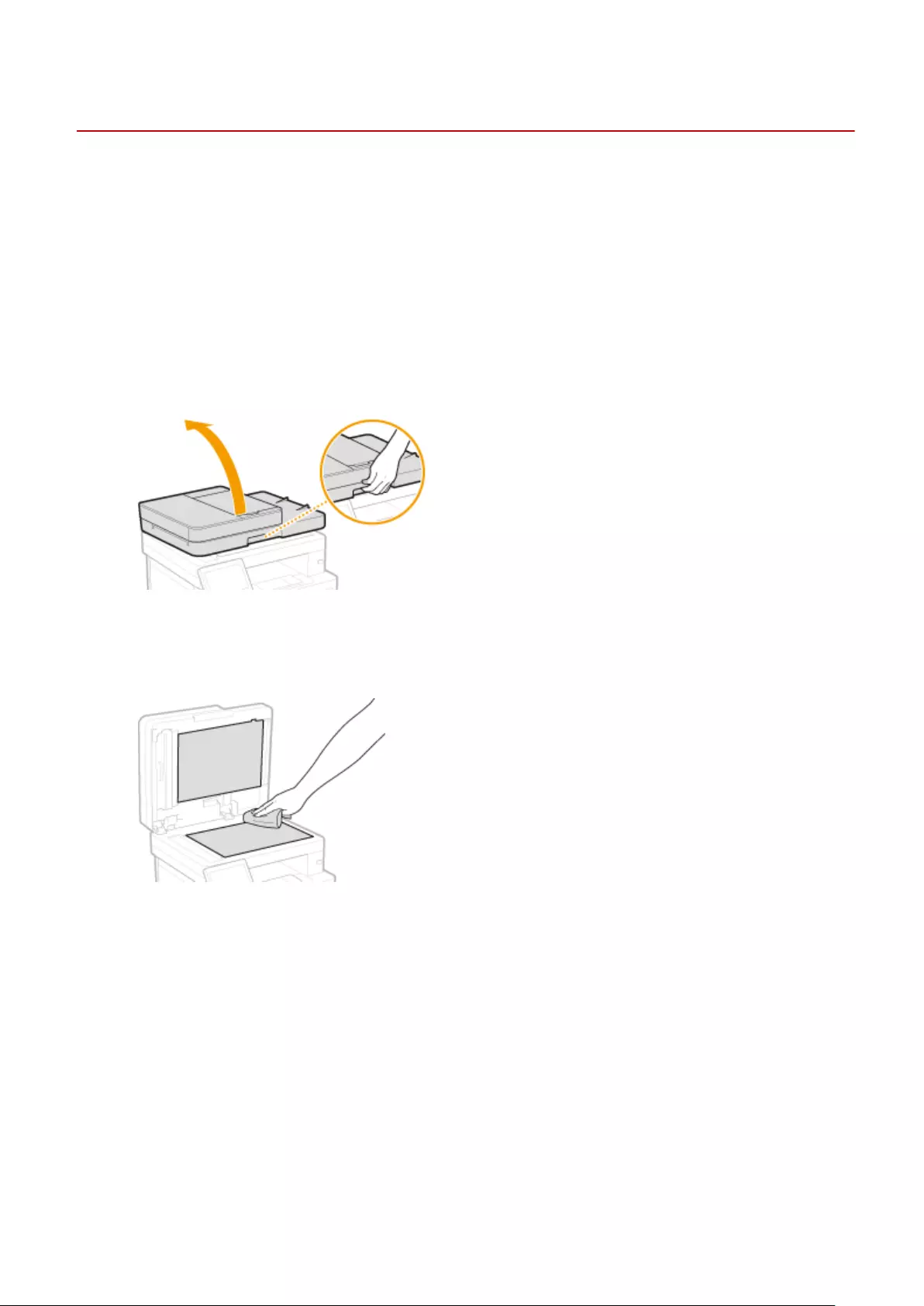
Cleaning the Platen Glass
6FR5-09U
Regularly wipe off the dust from the platen glass and the underside of the feeder to prevent smudges to be printed on
originals or printouts.
1Turn OFF the machine, and unplug the power cord from the AC power outlet.
●Turning the printer OFF erases any queued print data. Data such as documents received and held in memory,
documents waiting to be sent, and reports that are automatically printed after sending or receiving faxes are
not deleted.
2Open the feeder.
3Clean the platen glass and the underside of the feeder.
●Clean the areas with a cloth dampened with water. Then, wipe the area with a soft, dry cloth.
4Wait for the cleaned area to dry completely.
5Gently close the feeder.
6Reconnect the power cord and turn ON the machine.
Maintenance
578
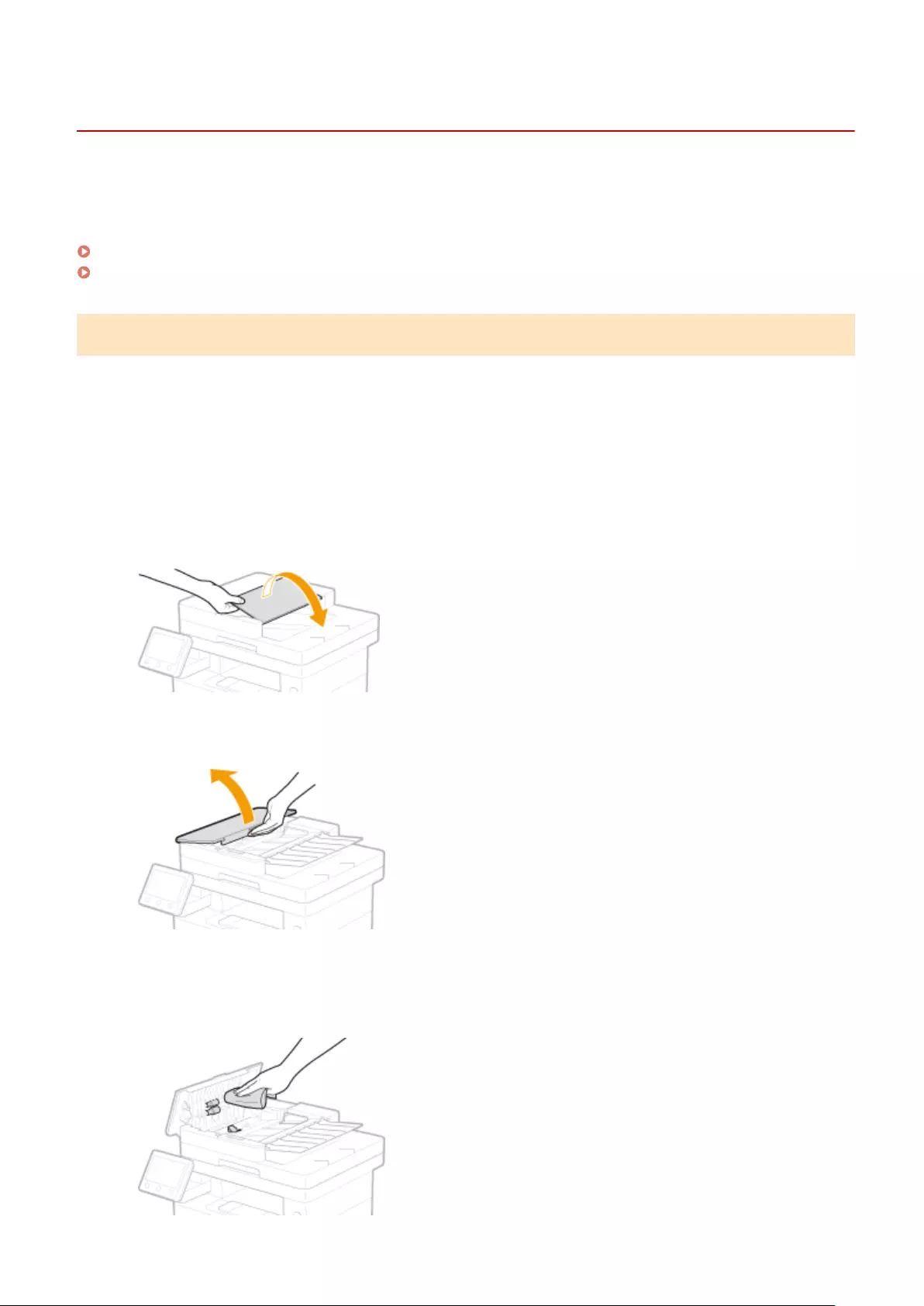
Cleaning the Feeder
6FR5-09W
Graphite powder or dust on the rollers inside the feeder or on the document feed scanning area may cause smudges
to appear on printouts. If this occurs or if a paper jam occurs frequently, clean the feeder. If the problem persists after
cleaning the feeder, perform automatic feeder cleaning.
Cleaning the Feeder(P. 579)
Automatic Feeder Cleaning(P. 581)
Cleaning the Feeder
1Turn off the machine and unplug it from the power outlet.
●Turning the printer OFF erases any queued print data. Data such as documents received and held in memory,
documents waiting to be sent, and reports that are automatically printed after sending or receiving faxes are
not deleted.
2Open the original supply tray.
3Open the feeder cover.
4Wipe the rollers in the feeder.
●Wipe the rollers with a cloth that has been moistened with water and wrung out. Then wipe with a dry cloth.
Maintenance
579
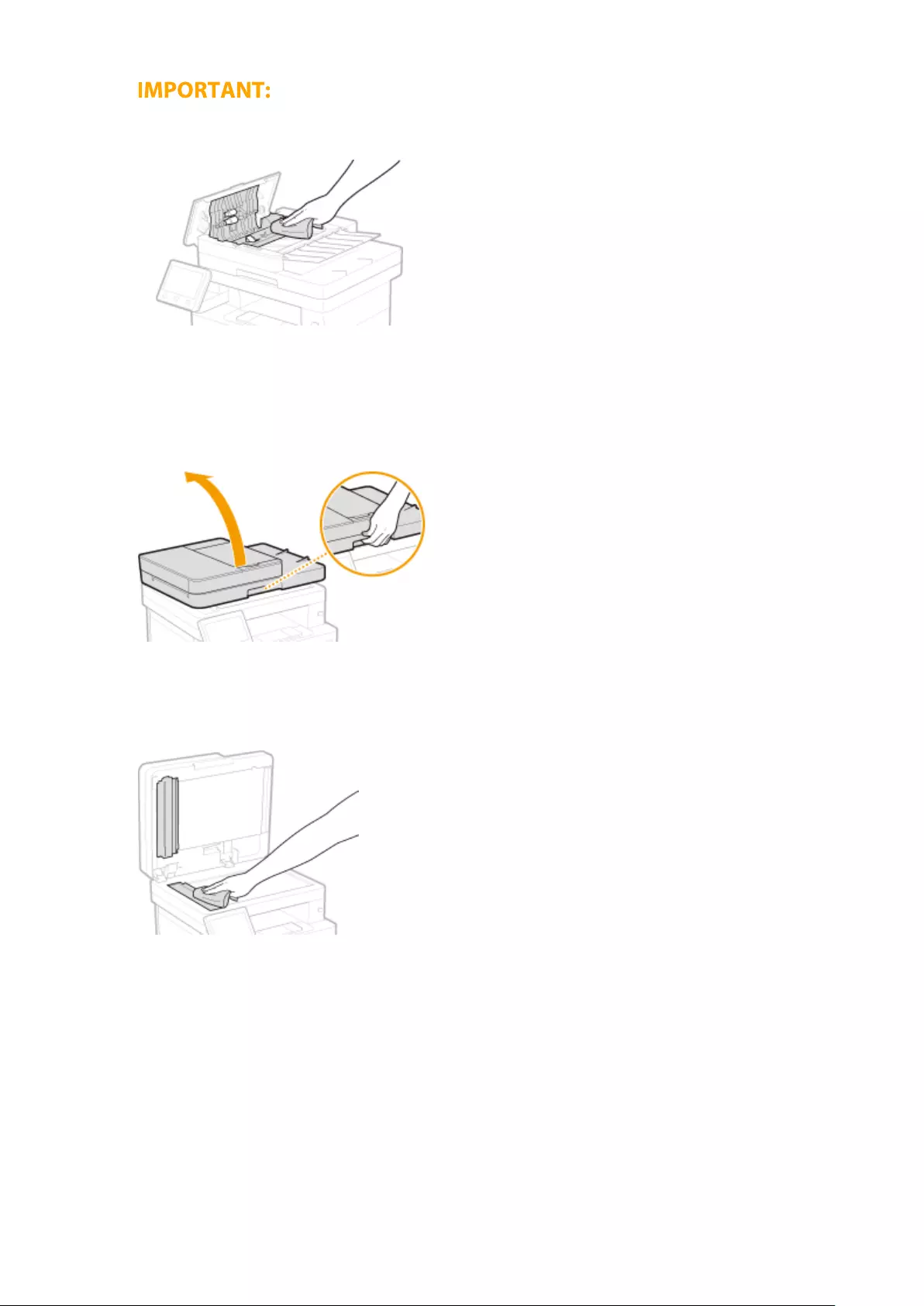
●If the rollers and surrounding areas are very dirty, clean them out. To do this, wet a cloth with water and
wring it out well, then wipe the dirty areas. Afterwards, wipe the areas with a soft and dry cloth.
5Close the feeder cover and original supply tray.
6Open the feeder.
7Wipe the document feed scanning area.
●Wipe with a cloth that has been moistened with water and wrung out, and then wipe with a dry cloth.
8Wait for the cleaned area to dry completely.
9Gently close the feeder.
10 Plug the machine back into the power outlet and switch it on.
Maintenance
580
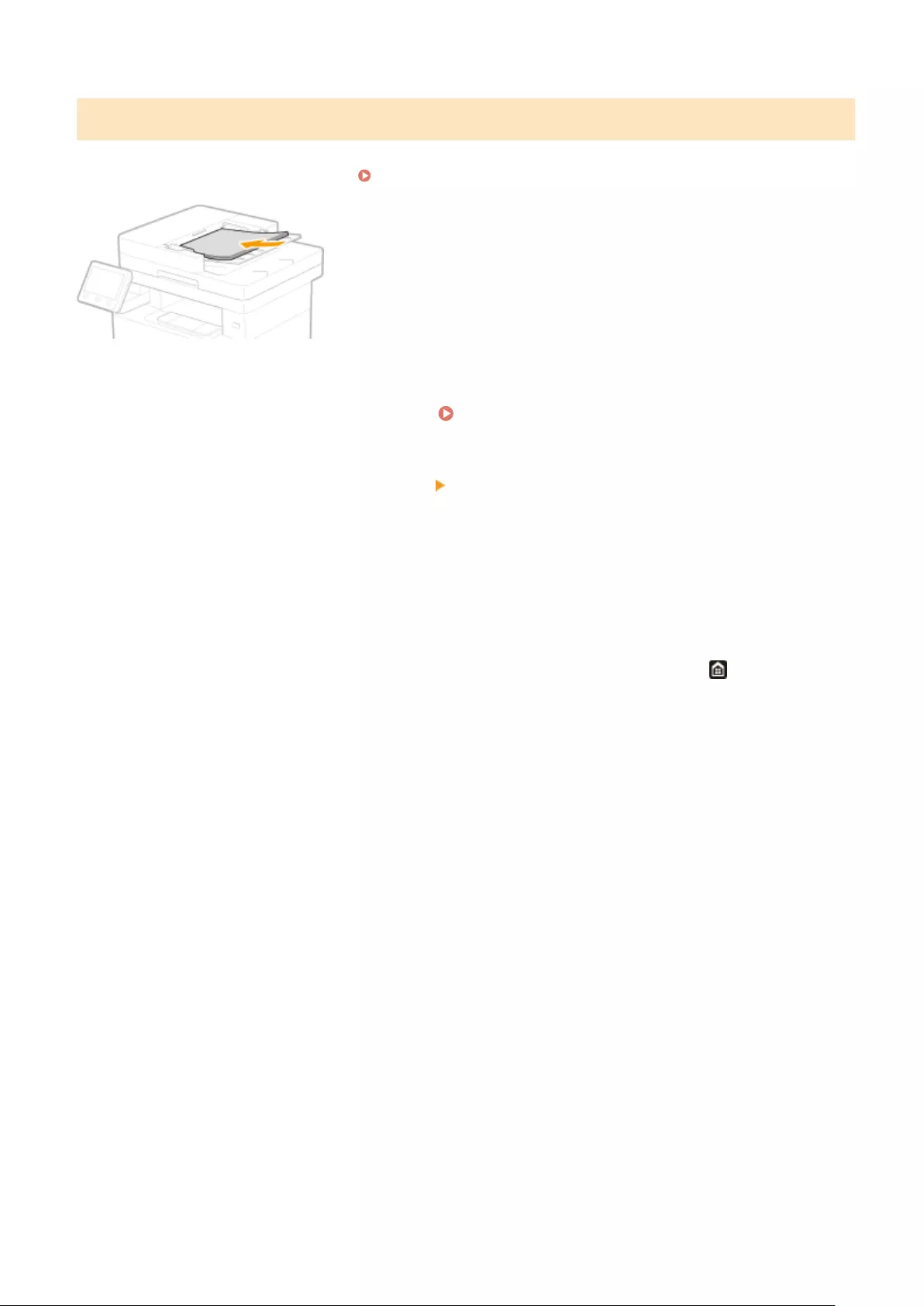
Automatic Feeder Cleaning
Automatic feeder cleaning uses paper loaded in the feeder. Set 10 sheets of plain A4 or US Letter size paper in the
feeder before starting automatic cleaning. Placing Originals(P. 137)
1Select <Menu> in the Home screen. Home Screen(P. 124)
2Select <Adjustment/Maintenance> <Maintenance>.
3Select <Clean Feeder>.
4Select <Start>.
➠Cleaning starts. When a message appears notifying that cleaning is complete, press to return to the
Home screen.
Maintenance
581

Cleaning the Fixing Assembly
6FR5-09X
Dirt may adhere to the xing assembly inside the machine and cause black streaks to appear on printouts. To clean
the xing assembly, perform the following procedure. Note that you cannot clean the xing assembly when the
machine has documents waiting to be printed. To clean the xing assembly, you need plain A4 or Letter size paper. Set
the paper in the paper drawer or multi-purpose tray before performing the following procedure. Loading
Paper(P. 141)
●Cleaning consumes the toner cartridge. Make sure that there is sucient toner cartridge remaining
beforehand. Checking the Remaining Amount of Consumables(P. 587)
1Select <Menu> in the Home screen. Home Screen(P. 124)
2Select <Adjustment/Maintenance> <Maintenance>.
3Select <Clean Fixing Assembly>.
4Check that the size and type of paper displayed on the screen is loaded in the
machine, and select <OK>.
5Select <Start>.
➠Cleaning starts. When a message appears notifying that cleaning is complete, press to return to the
Home screen.
Maintenance
582
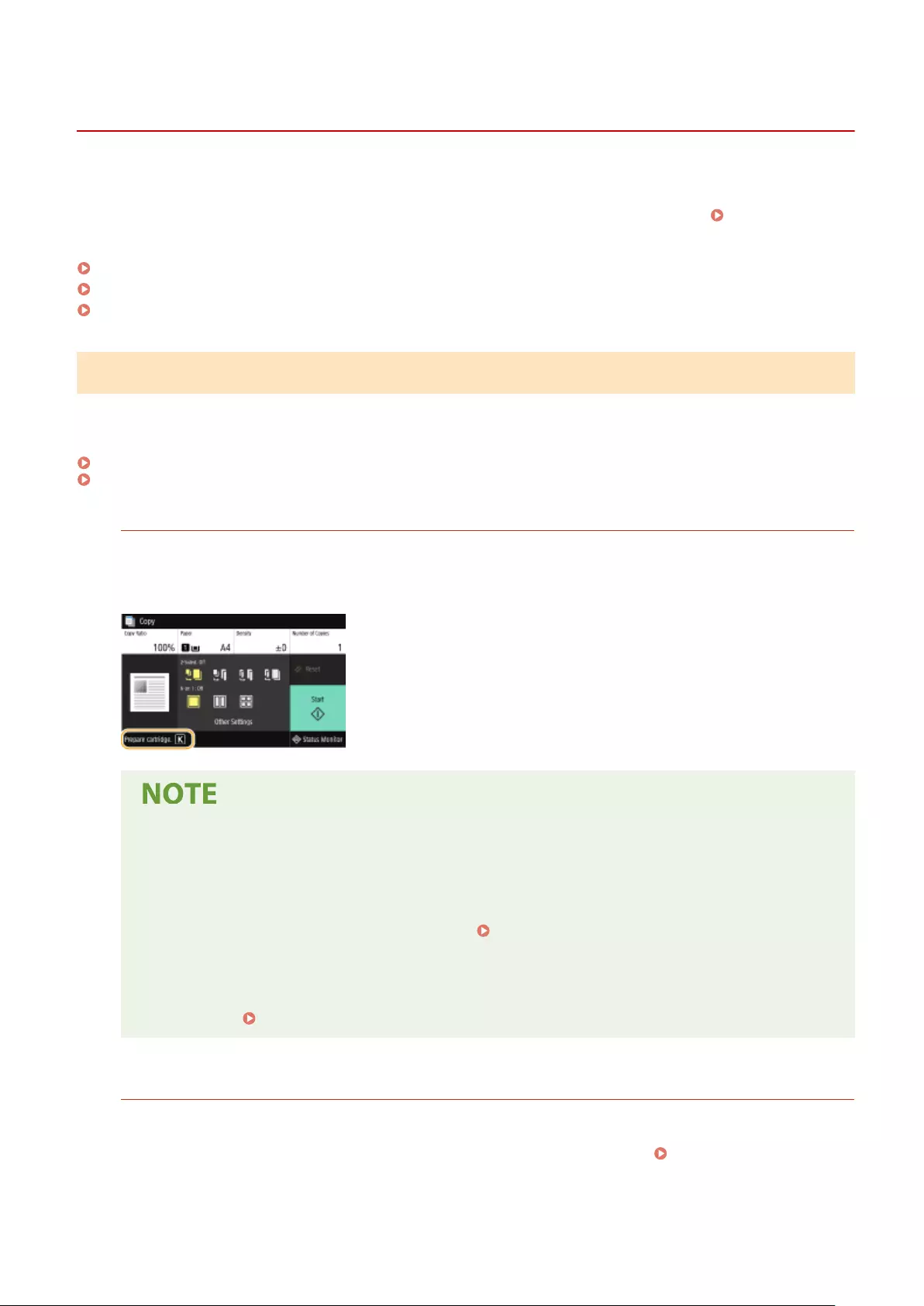
Replacing the Toner Cartridge
6FR5-09Y
A warning message appears in the display when the amount remaining in the toner cartridge is low or when printing
is no longer possible because of toner depletion. Note that the print quality may suffer if you continue printing without
resolving this issue. You can check the amount remaining in the toner cartridges on the display ( Checking the
Remaining Amount of Consumables(P. 587) ).
When a Message Appear(P. 583)
When Printouts are Poor in Quality(P. 584)
Procedure for Replacing the Toner Cartridge(P. 585)
When a Message Appear
The message that is displayed depends on the amount remaining in the toner cartridges. Depending on which
message is displayed, you will need to make sure that you have a replacement toner cartridge ready or replace the
toner cartridge.
Procedure for Replacing the Toner Cartridge(P. 585)
Replacement Parts(P. 602)
<Prepare cartridge.>
This message noties you that a toner cartridge needs to be replaced soon. Make sure that you have a
replacement toner cartridge ready. Replace the toner cartridge if you see this message before you start to print
a large job.
When a message is displayed
●When copying or printing, you can continue printing the original.
●If a message is displayed when the machine is receiving a fax/I-Fax or automatic report output is set,
received faxes/I-Faxes and reports will be stored in memory so that they do not appear faded after
they are printed. To continue printing even if the amount remaining in toner cartridge is running low,
set <Continue Print. When Cart. Low> to <On>. <Continue Print. When Cart. Low>(P. 548)
Specify when a message is displayed
●You can set any value as the percentage of the amount remaining in the toner cartridge that triggers
a message. <Display Timing for Cart. Prep.>(P. 463)
<Low Cartridge Level>
This message noties you that a toner cartridge needs to be replaced soon. Make sure that you have a
replacement toner cartridge ready. Replace the toner cartridge if you see this message before you start to print
a large job. This appears when <Action When Warning> is set to <Stop Printing> ( <Action When
Warning>(P. 464) ).
Maintenance
583
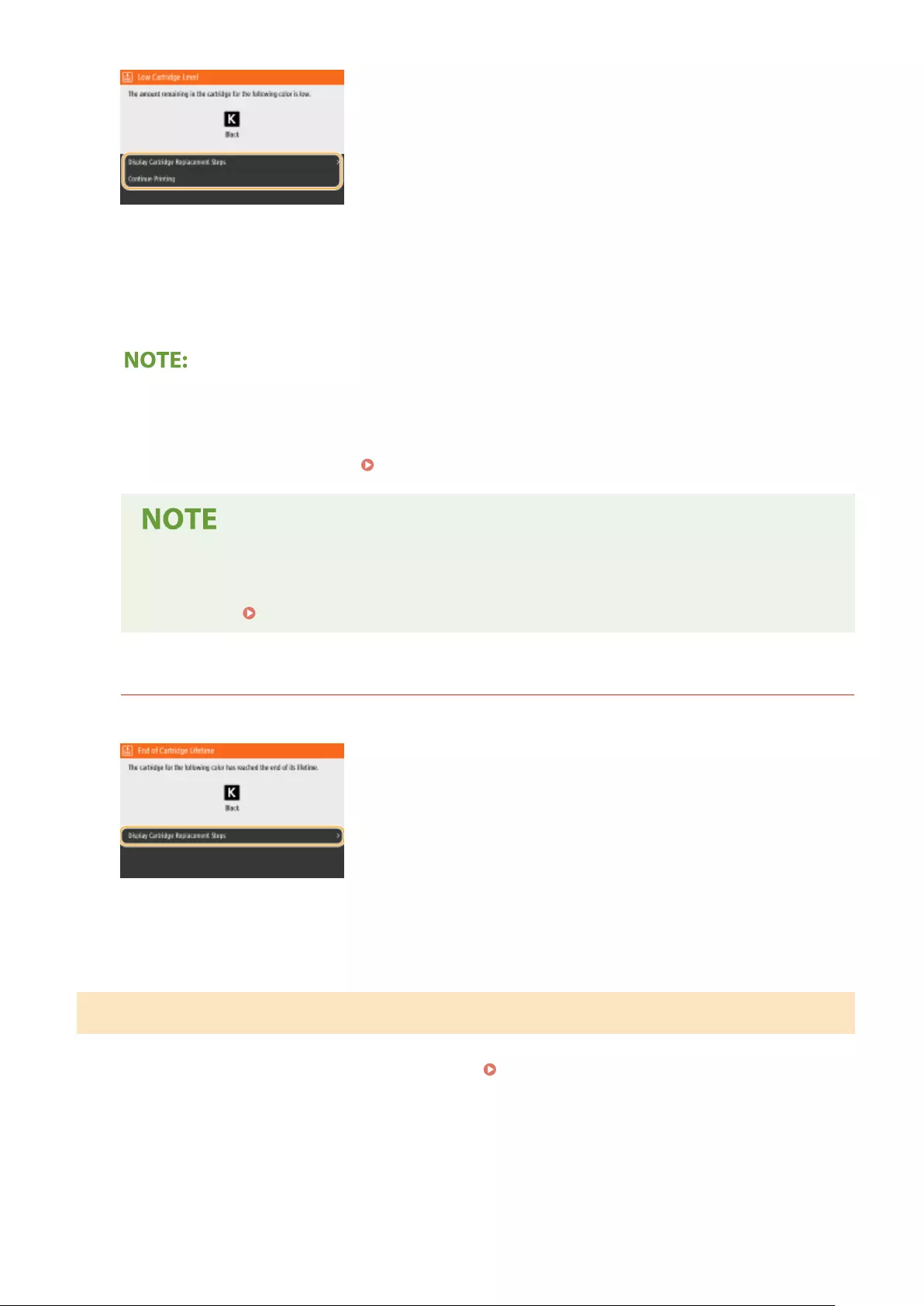
<Display Cartridge Replacement Steps>
Displays the procedure for replacing a toner cartridge. Follow the on-screen instructions to replace the toner
cartridge.
<Continue Printing>
You can end a printing stoppage state and continue copying/printing.
●If a message is displayed when the machine is receiving a fax/I-Fax or automatic report output is set,
received faxes/I-Faxes and reports will be stored in memory so that they do not appear faded after they are
printed. To continue printing even if the amount remaining in toner cartridge is running low, set <Continue
Print. When Cart. Low> to <On>. <Continue Print. When Cart. Low>(P. 548)
Specify when a message is displayed
●You can set any value as the percentage of the amount remaining in the toner cartridge that triggers
a message. <Display Timing for Cart. Prep.>(P. 463)
<End of Cartridge Lifetime>
A toner cartridge has reached the end of its lifetime, so printing cannot be performed.
<Display Cartridge Replacement Steps>
Displays the procedure for replacing a toner cartridge. Follow the on-screen instructions to replace the toner
cartridge.
When Printouts are Poor in Quality
If your printouts begin to show any of the following features, one of your toner cartridges is consumed. Replace the
nearly empty toner cartridge even if no message is displayed. Procedure for Replacing the Toner
Cartridge(P. 585)
Streaks Appear/Printing is
Uneven
Partially faded Uneven density White Spots Appear
Maintenance
584
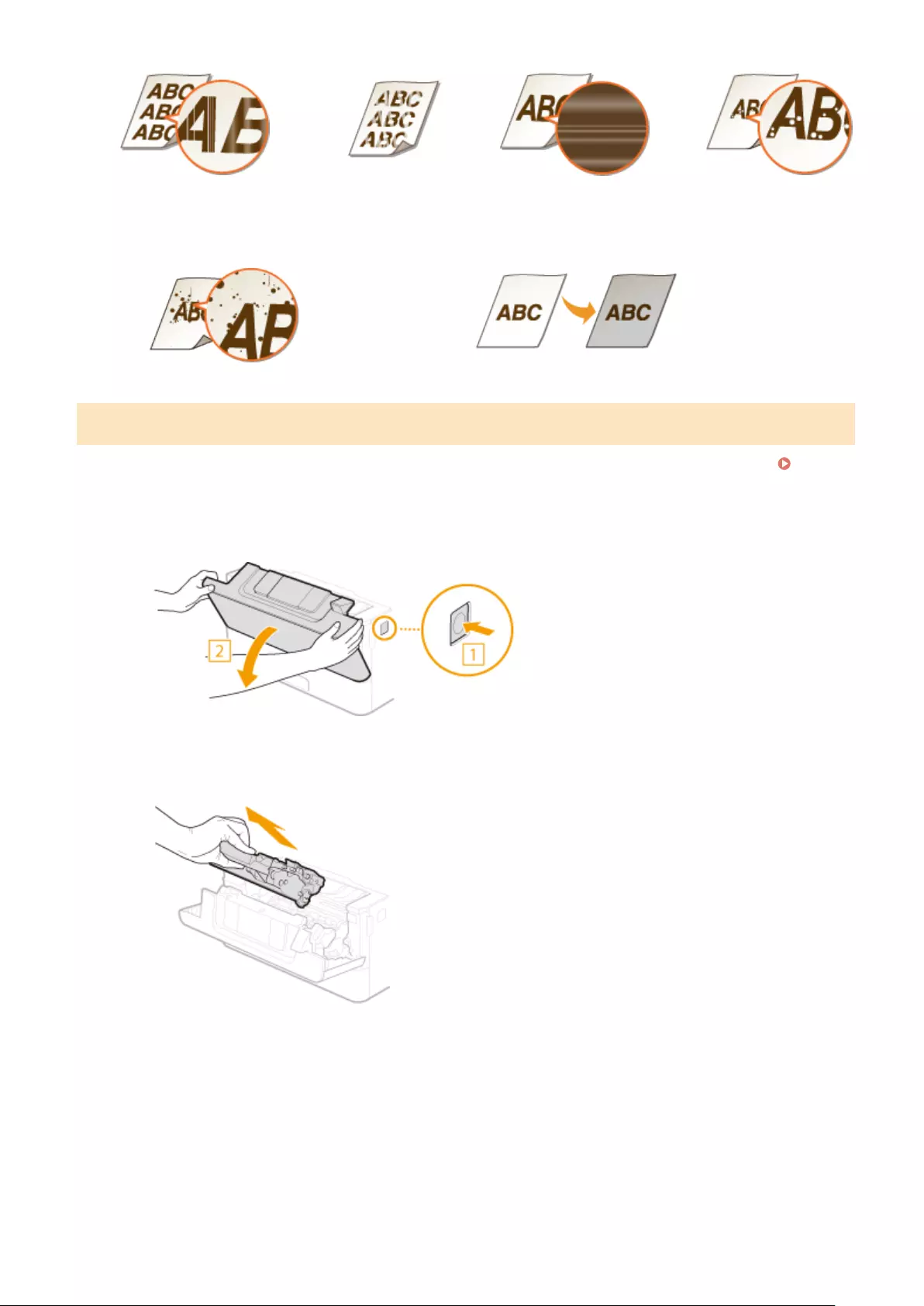
Toner smudges and splatters appear Blank space of originals becomes grayish in printouts
Procedure for Replacing the Toner Cartridge
Read the precautions in "Getting Started" provided with this product before replacing the toner cartridges. Manuals
and Their Contents(P. 643)
1Open the front cover.
2Remove the toner cartridge.
3Remove the replacement toner cartridge from the protective case.
Maintenance
585
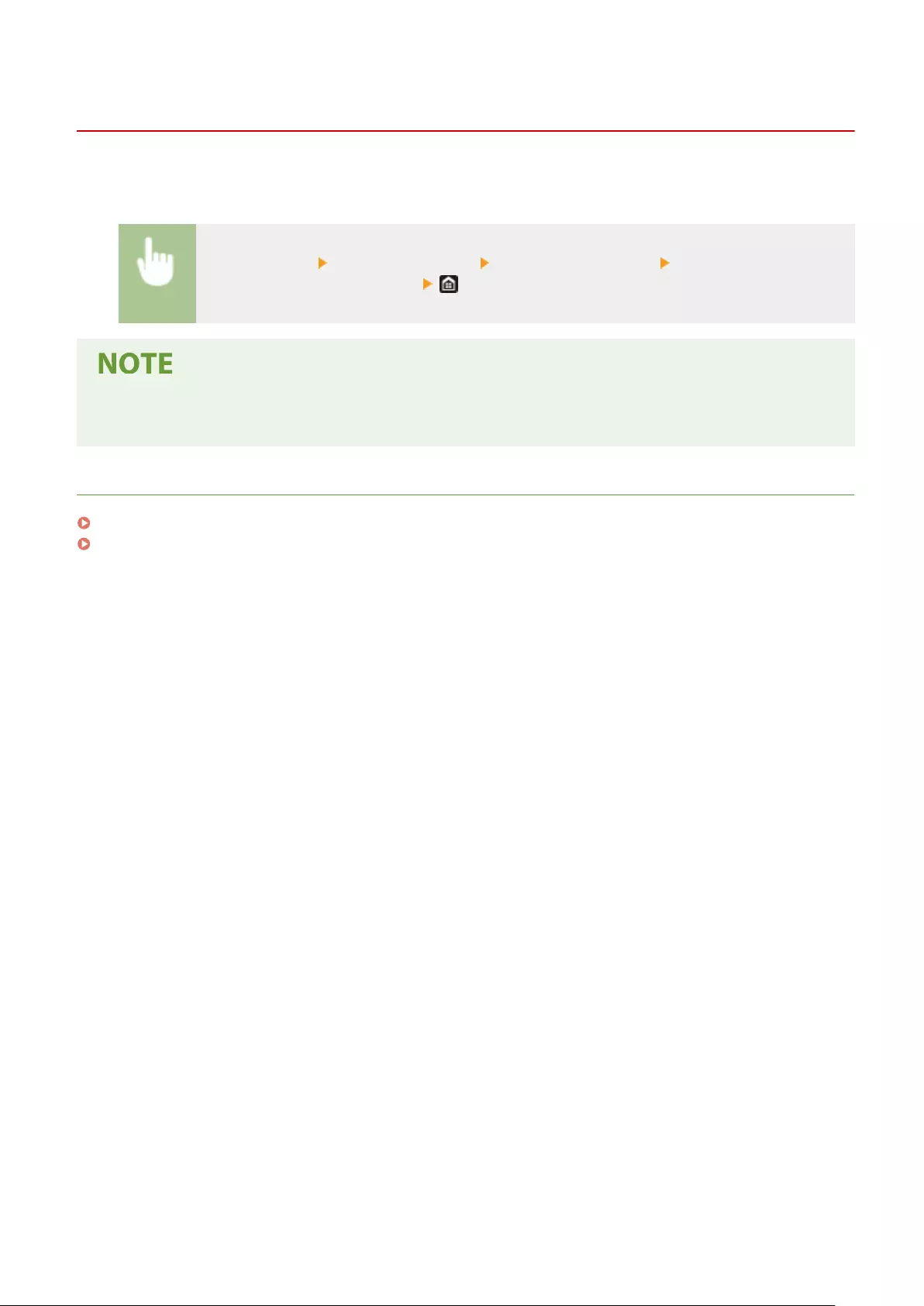
Checking the Remaining Amount of Consumables
6FR5-0A0
Use the procedure below to check the amount remaining in the toner cartridges. It is particularly important to check
whether you need to have a new toner cartridge ready before starting a large print job.
<Status Monitor> <Device Information> <Cartridge Information> Checking the amount
remaining in the toner cartridges
●The displayed amount remaining in a toner cartridge can be used only as a guide and may differ from the
actual amount.
LINKS
Replacing the Toner Cartridge(P. 583)
Replacement Parts(P. 602)
Maintenance
587

Adjusting Image Quality
6FR5-0A2
If the print results or scanned images are not satisfactory such as low image quality, poor reproducibility, or skewed
printouts, try the adjustments below.
◼Adjust Copy Image
If the density or brightness of copies and memory media print differs markedly from the originals, use this function so
that the appearance of the printing results becomes closer to that of the originals. Adjusting the Gradation and
Density for Copy Jobs(P. 589)
◼Black Text Processing for Color
You can make an adjustment such that black or nearly black text is reproduced in a color closely matching with the
original that was scanned in color. Adjusting Values for Text Color Reproducibility(P. 591)
◼Density Adjustment
When the print results are too dark or too light, you can adjust the density. Adjusting Print Density(P. 593)
◼Adjust Print Position
You can adjust the print position when the printed image is skewed or part of the image is outside the print range.
Adjusting Print Position(P. 594)
Maintenance
588
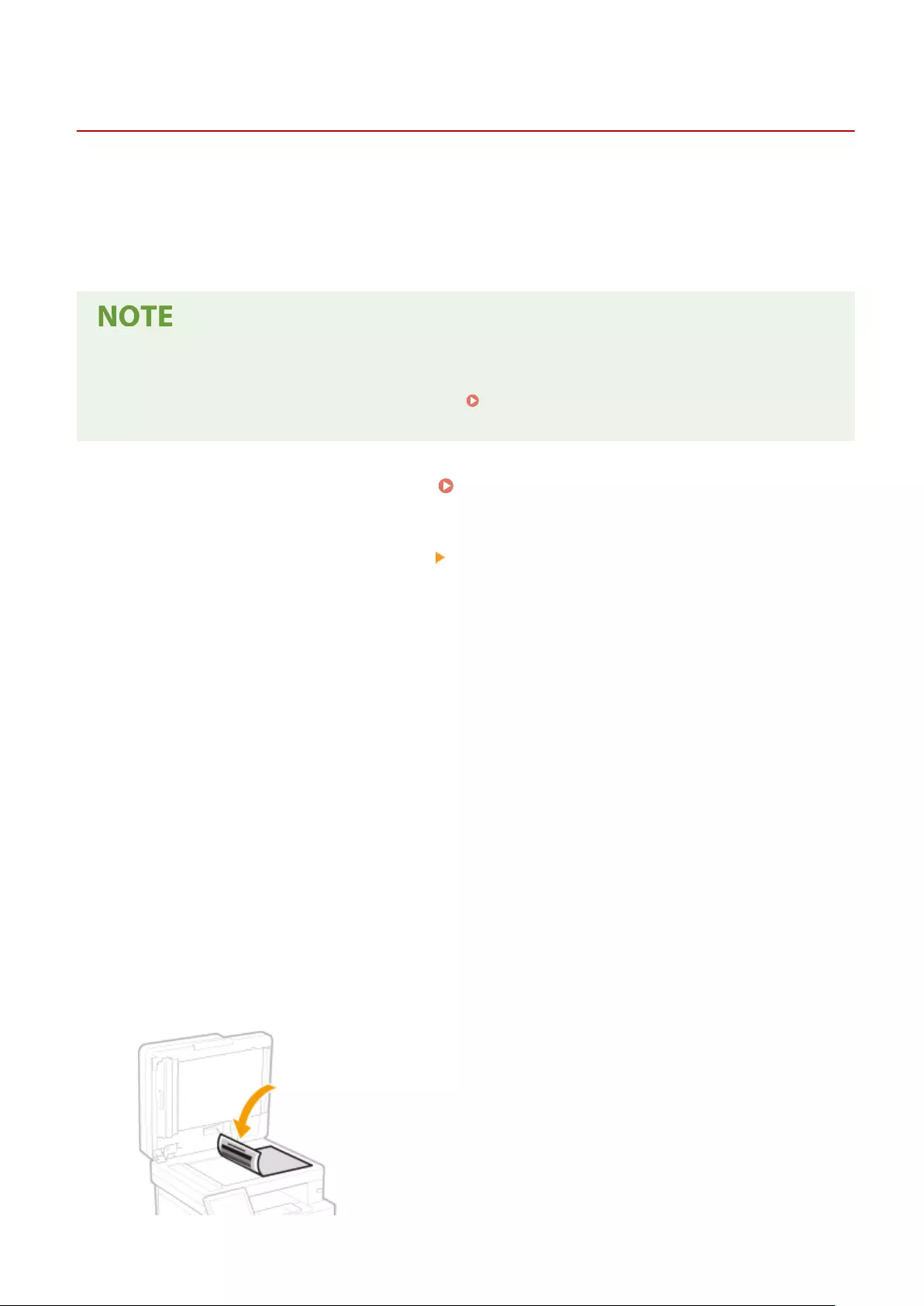
Adjusting the Gradation and Density for Copy Jobs
6FR5-0A3
Gradation refers to the dark to light continuum of shades of a color. The more shades in the gradations of colors that
are printed, the more natural printouts seem. If color reproducibility becomes poor and the density and brightness of
printouts differs markedly from the originals, perform the appropriate auto adjustment. This adjustment improves the
results of copies and memory media print. For correcting copy images, an adjustment image will be printed and
scanned. Note that you cannot perform this adjustment while performing some functions, including, scanning, and
printing.
●Adjustments may not be performed effectively if there is not sucient toner cartridge remaining. Check the
amount remaining in the toner cartridges. If the amount remaining in the toner cartridge is low, it is
recommended that you replace the toner cartridge. Checking the Remaining Amount of
Consumables(P. 587)
1Select <Menu> in the Home screen. Home Screen(P. 124)
2Select <Adjustment/Maintenance> <Adjust Image Quality>.
3Select <Adjust Copy Image>.
4Check that the size and type of paper displayed on the screen is loaded in the
machine, and select <OK>.
5Conrm the procedure, and select <Start>.
➠An adjustment image is printed.
6Open the feeder after the screen displayed during printing disappears.
7Place the adjustment image on the platen glass.
●Place the adjustment image printed paper with the print side facing down and with the thin black line on the
left.
Maintenance
589

8Gently close the feeder.
9Select <Start Scanning>.
➠The adjustment image is scanned and adjustment starts.
10 When a message appears notifying that adjustment is complete, open the feeder,
and remove the adjustment image.
11 Gently close the feeder.
If the <Could not perform correction.> message is displayed
●Did you load the paper displayed in step 4 into the paper source?
●Did you place the adjustment image printed paper on the platen glass with the print side facing down and
with the thin black line on the left?
●Has a paper jam occurred? For more information, see "Troubleshooting (FAQ)" on the online manual
website.
●Is the amount remaining in toner cartridge sucient? If the amount remaining in the toner cartridge is low,
it is recommended that you replace the toner cartridge. Checking the Remaining Amount of
Consumables(P. 587)
Maintenance
590
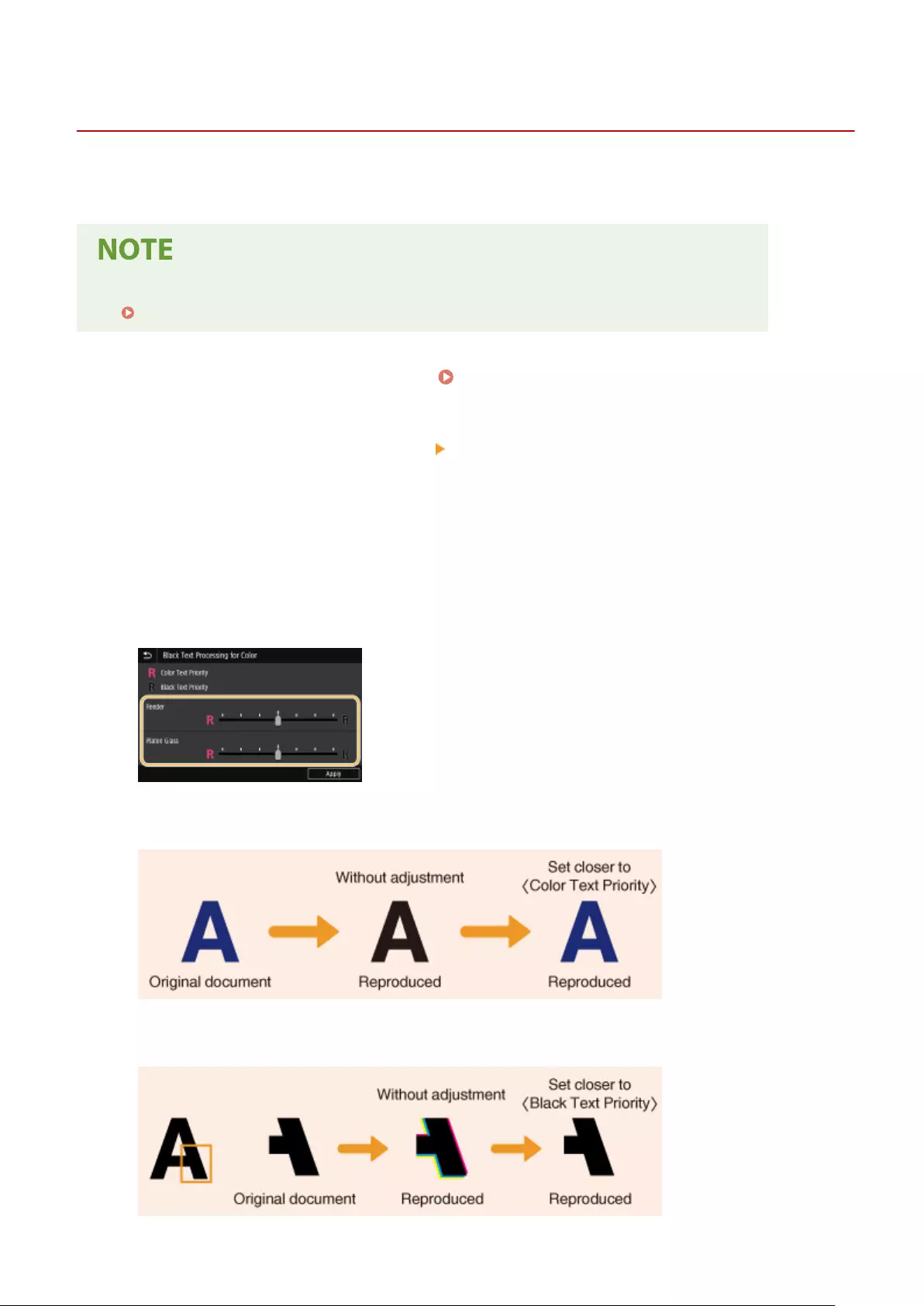
Adjusting Values for Text Color Reproducibility
6FR5-0A4
You can make an adjustment such that black or nearly black text is reproduced in a color closely matching with the
original that was scanned in color.
●This function will apply when scan is performed with <Original Type> set to other than <Photo>.
Adjusting Image Quality(P. 306)
1Select <Menu> in the Home screen. Home Screen(P. 124)
2Select <Adjustment/Maintenance> <Adjust Image Quality>.
3Select <Black Text Processing for Color>.
4Adjust the value.
●This adjustment value can be set independently in the feeder and platen glass.
<Color Text Priority>
Reproduces black or nearly black text in a color closely matching with the original.
<Black Text Priority>
Reproduces black text with enhanced clarity.
Maintenance
591

5Select <Apply>.
Maintenance
592
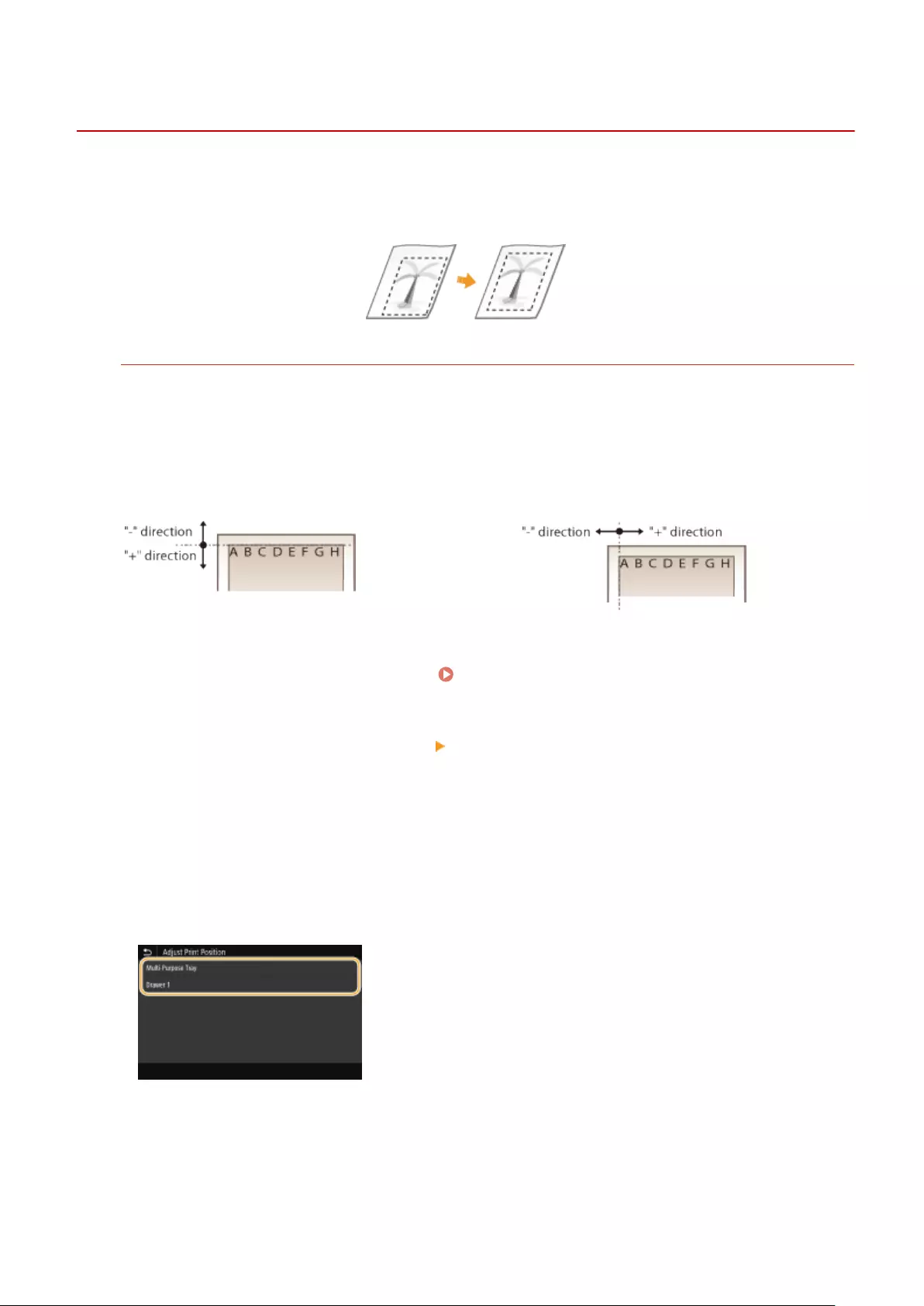
Adjusting Print Position
6FR5-0A6
If a document is printed off-center or out of the printable range, adjust the print position. You can adjust the print
position for each paper source. You can adjust the print position in the range -5.0 mm to +5.0 mm in increments of 0.1
mm.
Checking the Direction and Distance to Adjust
When you adjust the print position, specify the direction using "+" and "-" and the distance using "mm." For
<Adjust Vertically (Front Side)>/<Adjust Vertically (Back Side)>, specify a value with a "+" sign to shift the print
position in the up-to-down direction. For <Adjust Horizontally (Front Side)>/<Adjust Horizontally (Back Side)>,
specify a value with a "+" sign to shift the print position in the left-to-right direction. To shift in the reverse
direction, specify a value with a "-" sign.
<Adjust Vertically (Front Side)>/<Adjust Vertically
(Back Side)>
<Adjust Horizontally (Front Side)>/<Adjust
Horizontally (Back Side)>
1Select <Menu> in the Home screen. Home Screen(P. 124)
2Select <Adjustment/Maintenance> <Adjust Image Quality>.
3Select <Adjust Print Position>.
4Select the paper source.
●When the optional cassette feeding module is installed, its paper drawer is also displayed.
5Select the combination of adjustment direction and printing side.
Maintenance
594
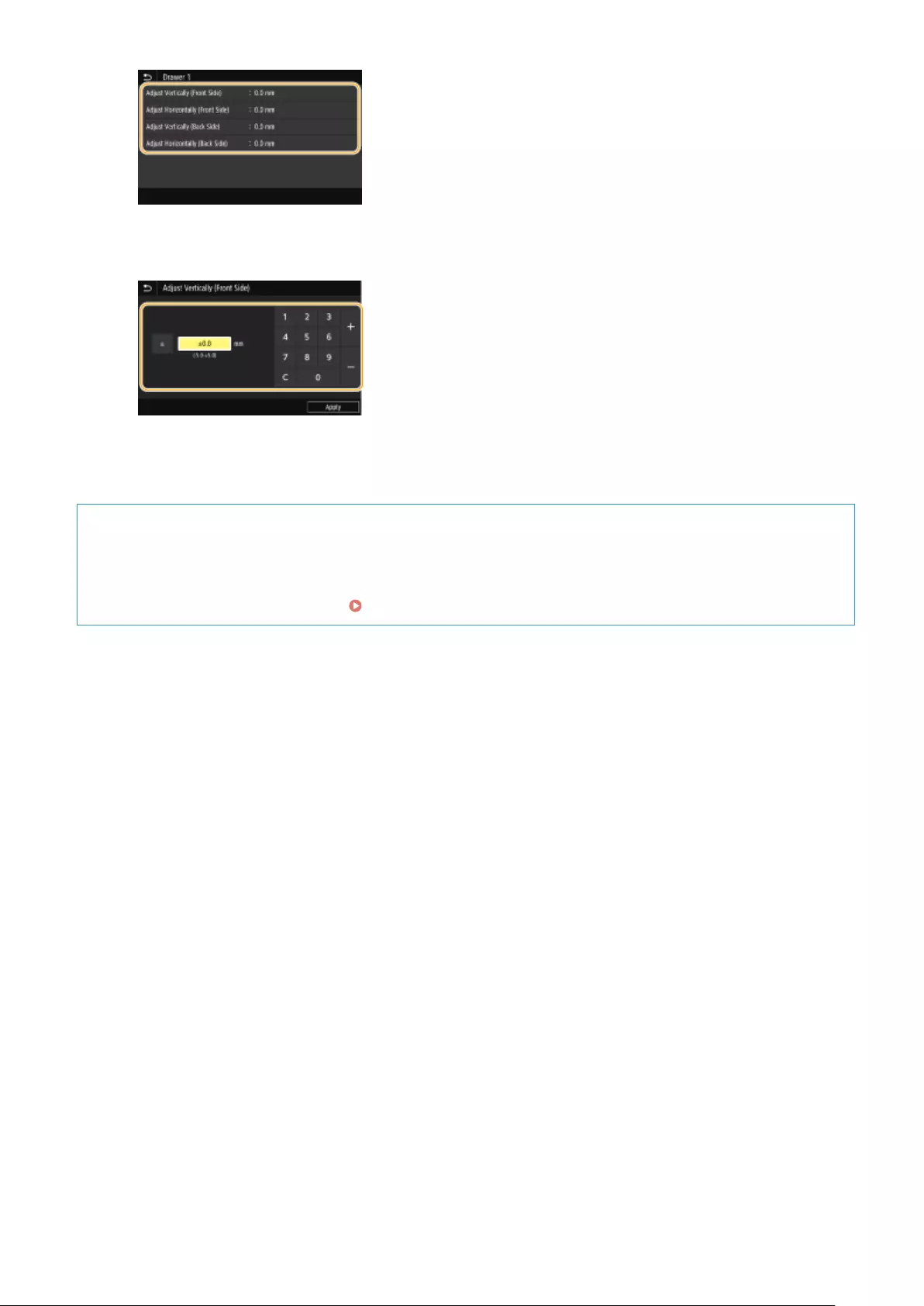
6Set an adjustment value.
7Select <Apply>.
Adjusting the Print Position for All Print Jobs
●You can use <Function Settings> in the setting menu of the operation panel to adjust the print position for
all print jobs, irrespective of the paper source. The print position can be adjusted in 0.5 mm increments
between -50.0 mm and +50.0 mm. <Offset Short Edge/Offset Long Edge>(P. 514)
Maintenance
595
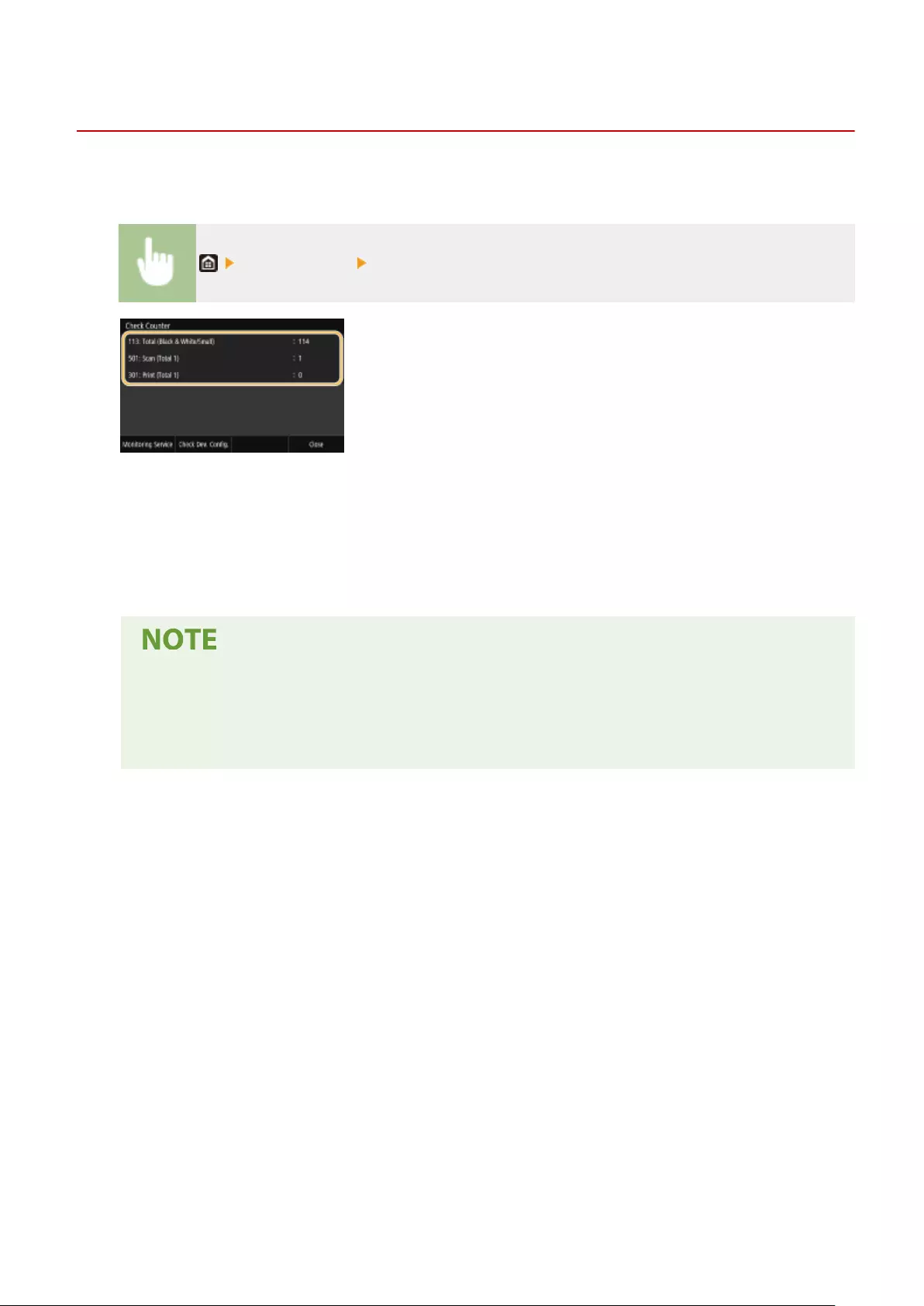
Viewing the Counter Value
6FR5-0A7
You can check the total number of pages printed by the machine. These totals include faxes, reports, and lists, in
addition to copies and printouts of data from computers.
<Check Counter> Check the number of pages printed
<113: Total (Black & White/Small)>
Displays the total number of pages copied and printed in black and white.
<501: Scan (Total 1)>
Displays the total number of pages scanned.
<301: Print (Total 1)>
Displays the total number of pages printed.
●<Monitoring Service> enables communication with a remote monitoring server. Execution of this item
enables information about the machine to be periodically sent to the remote monitoring server
connected to the machine.
●<Check Dev. Cong.> enables you to check the optional units installed on the machine.
Maintenance
596
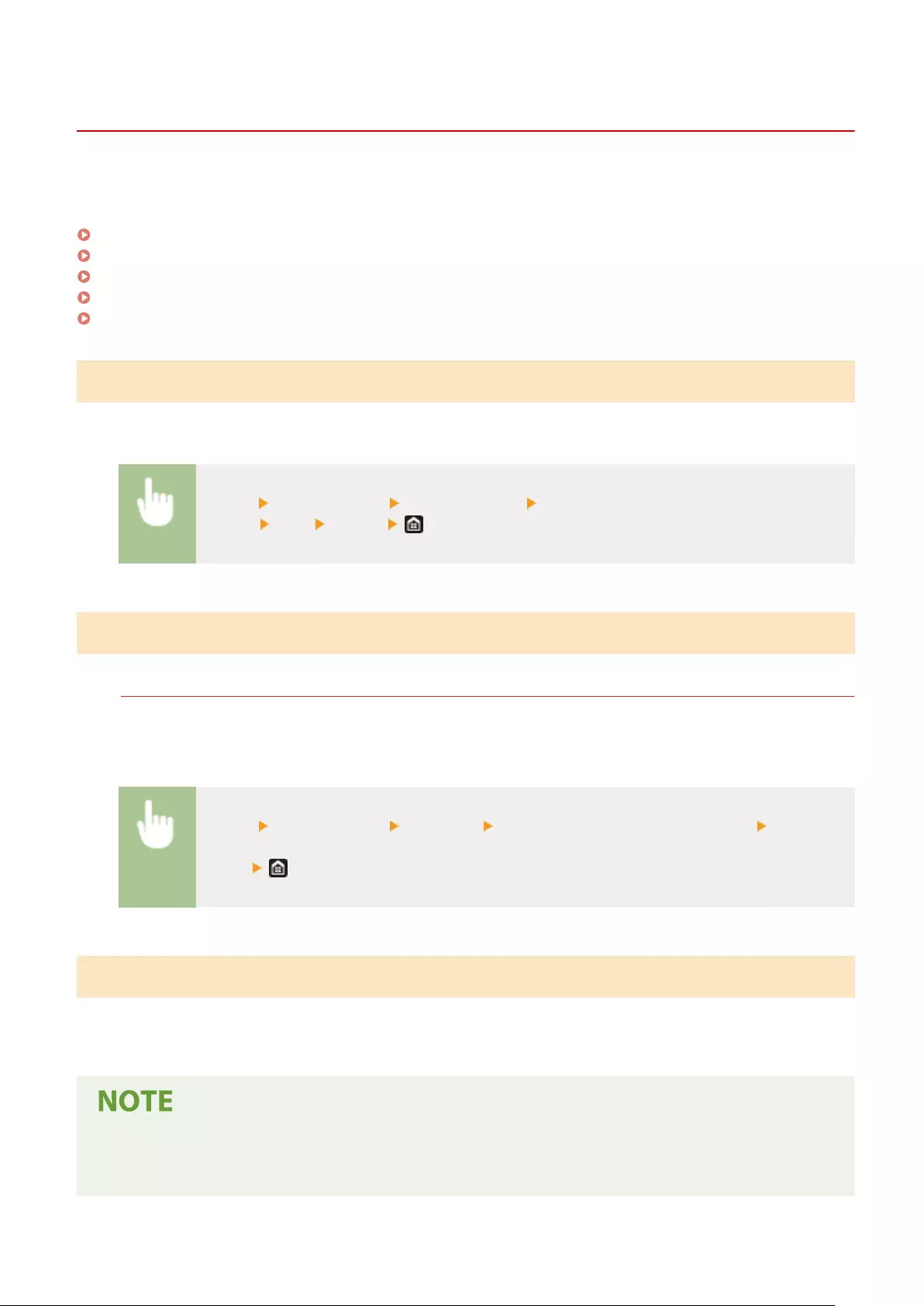
Printing Reports and Lists
6FR5-0A8
You can print reports and lists to check information such as the total volume of printouts for each <Department ID>
and machine settings.
Conguring the Print Settings for Reports and Lists(P. 597)
Printing a Report on the Total Volume of Printouts by Department ID(P. 597)
Setting Reports on the Communication Results(P. 597)
Printing Lists of Settings(P. 599)
Printing Reports and Lists on the Usage Status of the Machine(P. 600)
Conguring the Print Settings for Reports and Lists
You can perform 2-sided printing of reports and lists.
<Menu> <Output Report> <Report Settings> <Default Settings for Report
Output> <On> <Apply>
Printing a Report on the Total Volume of Printouts by Department ID
Department ID Management Report
When Department ID Management is enabled, you can check the total volume of printouts for each
<Department ID> by printing a Department ID Management Report. By checking the printout totals, you can
better manage your paper and toner cartridge supplies.
<Menu> <Output Report> <Print List> <Department ID Management Report> Check that
the size and type of paper displayed on the screen is loaded in the machine, and select
<Start>
Setting Reports on the Communication Results
You can print reports on the results of sending/receiving by e-mail, fax, and I-Fax, as well as results of saving to a
shared folder or FTP server. Some reports can be printed automatically while others are only printed when an error
occurs.
●If "Result" in a printed list contains "NG," you can check details of the error from a three-digit number
prexed with "#" displayed in the next to the result. For more information, see "Troubleshooting (FAQ)" on
the online manual website.
Maintenance
597

●Reports printed for e-mail/I-Fax indicate the transmission result between the machine and the mail server,
not between the machine and the destination address.
Communication Management Report
You can check the fax and e-mail logs of sent and received documents by printing a Communication
Management Report. The report can be printed automatically after every 40 transmissions, or you can print it
manually.
<Menu> <Output Report> <Report Settings> <Communication Management
Report> Congure report settings <Apply>
<Auto Print (40 Transmissions)>
Select <On> to print the report automatically after every 40 transmissions, or <Off> if you do not want to print
the report automatically.
<Separate TX/RX>
Select <On> to print sent and received reports separately, or <Off> to print both reports on one sheet.
Print the report manually
<Menu> <Output Report> <Print List> <Communication Management Report> Check that
the size and type of paper displayed on the screen is loaded in the machine, and select
<Start>
Fax TX Result Report
You can check the fax logs of sent documents by printing a Fax TX Result Report. The report can be printed
either every time a transmission is completed or only when a sending error occurs.
<Menu> <Output Report> <Report Settings> <Fax TX Result Report> Select <On> or <Only
When Error Occurs> Select <Off> or <On> <Apply>
Maintenance
598
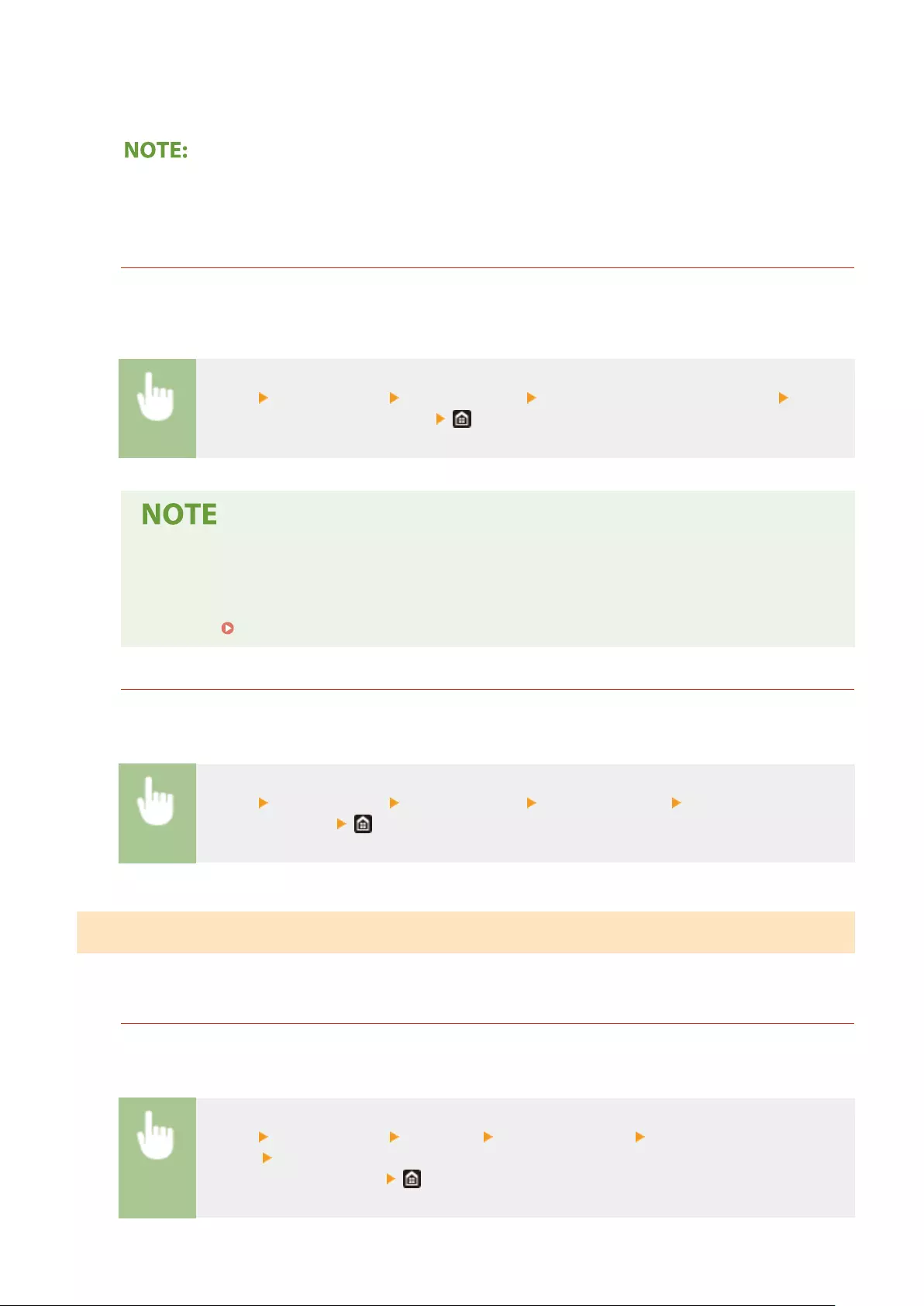
<Include TX Image>
When you select <On>, a part of a sent document can be included in the TX Result Report.
●Send jobs originating from the fax driver are omitted from this report.
E-Mail/I-Fax/File TX Result Report
You can check the e-mail and I-Fax logs of sent documents as well as documents saved to a shared folder or FTP
server by printing an E-Mail/I-Fax/File TX Result Report. The report can be printed either every time a
transmission is completed or only when a sending error occurs.
<Menu> <Output Report> <Report Settings> <E-Mail/I-Fax/File TX Result Report> Select
<On> or <Only When Error Occurs>
Communication result
●If an error occurs during transmission by e-mail/I-Fax or saving to a shared folder/FTP server, the
report does not show the error code. To check the error code, print a Communication Management
Report ( Communication Management Report(P. 598) ).
RX Result Report
You can check the logs of received fax and I-Fax documents by printing an RX Result Report. The report can be
printed either every time a transmission is completed or only when a receiving error occurs.
<Menu> <Output Report> <Report Settings> <RX Result Report> Select <On> or <Only
When Error Occurs>
Printing Lists of Settings
You can print information and settings registered in the machine as a list.
Address Book List
You can check the list of destinations registered in the Address Book as <Coded Dial>, <Favorites>, and <Group>
by printing an Address Book List.
<Menu> <Output Report> <Print List> <Address Book List> Select the setting you want to
print out Check that the size and type of paper displayed on the screen is loaded in the
machine, and select <Start>
Maintenance
599
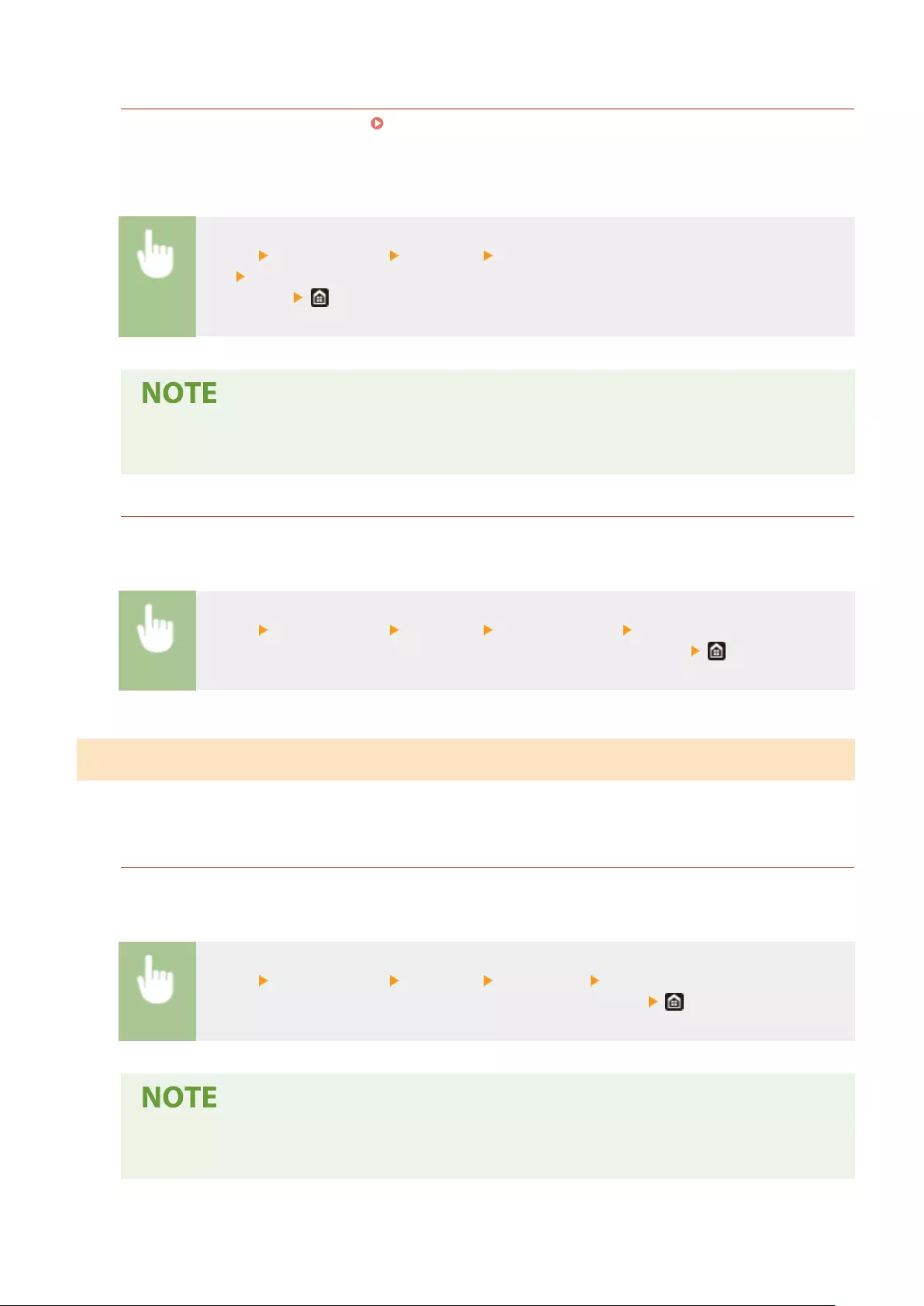
User Data List/System Manager Data List
You can check the list of the settings ( Setting Menu List(P. 458) ) as well as the content that has been
registered in the machine by printing a User Data List or a System Manager Data List. Both lists include the
rmware version, the paper size and type registered in the machine, and the print settings of Communication
Management Report, TX Result Report, and RX Result Report.
<Menu> <Output Report> <Print List> Select <User Data List> or <System Manager Data
List> Check that the size and type of paper displayed on the screen is loaded in the machine, and
select <Start>
●The User Data List does not include certain settings such as Network Settings and Management
Settings. To check all the settings items, print the System Manager Data List.
IPSec Policy List
You can check the list of policy names and the IPSec settings registered in the machine by printing an IPSec
Policy List.
<Menu> <Output Report> <Print List> <IPSec Policy List> Check that the size and type of
paper displayed on the screen is loaded in the machine, and select <Start>
Printing Reports and Lists on the Usage Status of the Machine
You can print the machine status report, the usage log of toner cartridges, and the list of fonts available in PCL or PS
mode.
Eco Report
You can check the monthly total volume of printouts and the power consumption with a report. This report
includes tips that are useful for saving paper and power consumption based on the usage status.
<Menu> <Output Report> <Print List> <Eco Report> Check that the size and type of paper
displayed on the screen is loaded in the machine, and select <Start>
●The amount of power consumption may vary depending on the environment and conditions where
the machine is used.
Maintenance
600
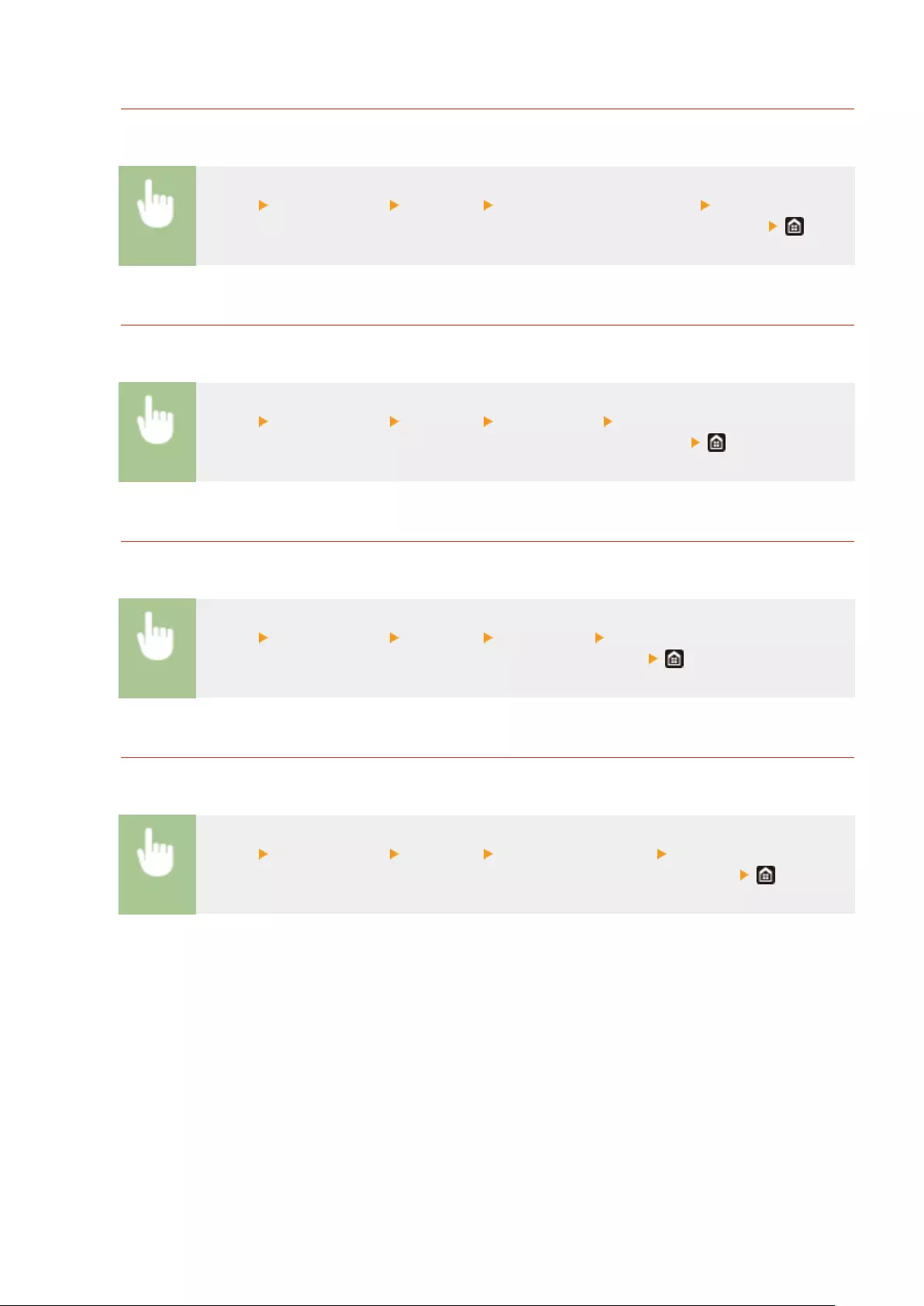
Consumables Status Report
You can check the consumables status installed in the machine with a report.
<Menu> <Output Report> <Print List> <Consumables Status Report> Check that the size
and type of paper displayed on the screen is loaded in the machine, and select <Start>
PCL Font List
You can check the list of fonts available in PCL mode with a report.
<Menu> <Output Report> <Print List> <PCL Font List> Check that the size and type of
paper displayed on the screen is loaded in the machine, and select <Start>
PS Font List
You can check the list of fonts available in PS mode with a report.
<Menu> <Output Report> <Print List> <PS Font List> Check that the size and type of paper
displayed on the screen is loaded in the machine, and select <Start>
Cartridge Log Report
You can check the usage logs of toner cartridges with a report.
<Menu> <Output Report> <Print List> <Cartridge Log Report> Check that the size and
type of paper displayed on the screen is loaded in the machine, and select <Start>
Maintenance
601
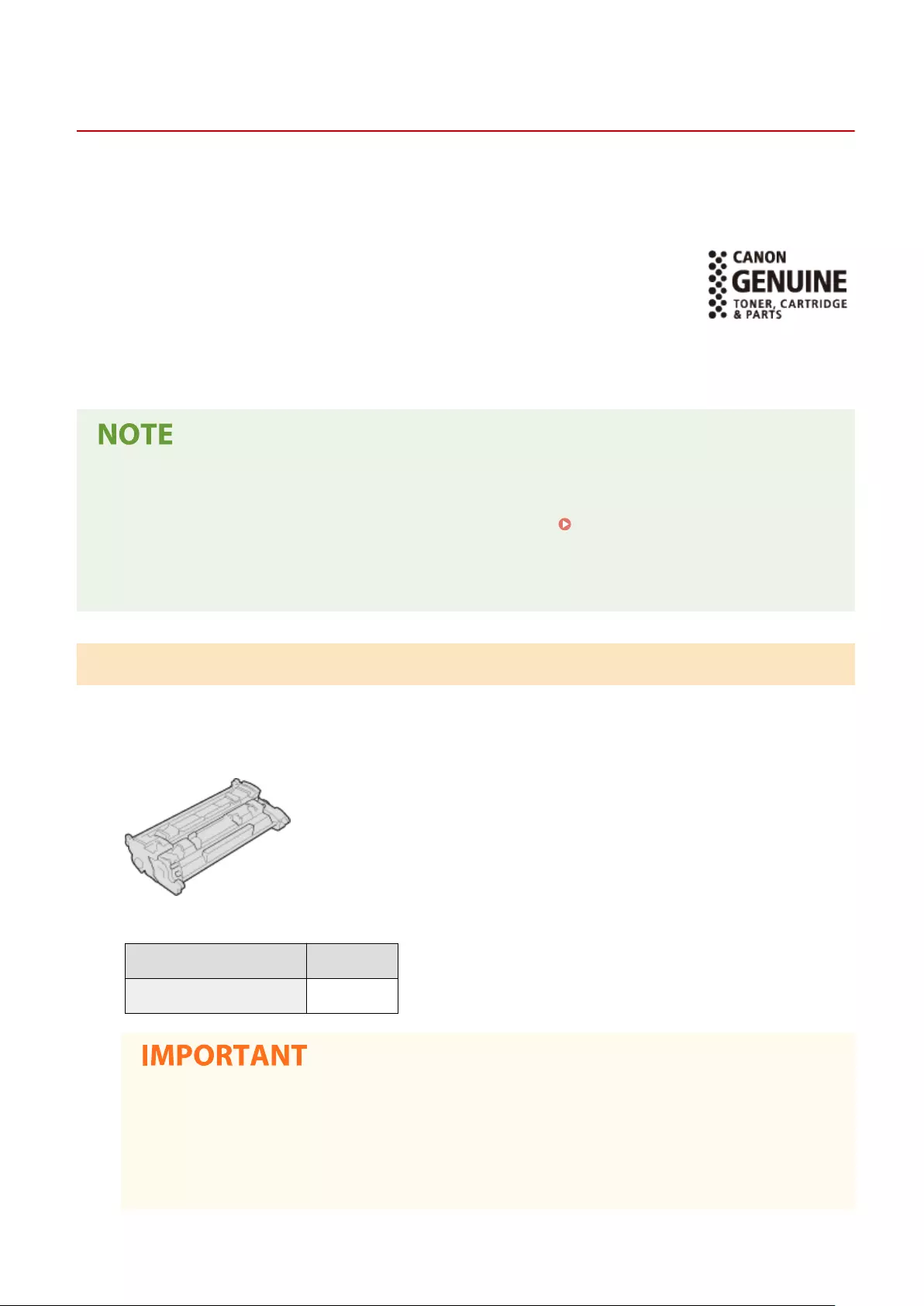
Replacement Parts
6FR5-0A9
This section describes the replacement parts (consumables) used by the machine. Purchase the replacement parts
from the authorized Canon dealer that you purchased the machine from. Follow the precautions when handling and
storing the replacement parts.
Genuine Consumables
Canon continuously develops technology innovations in Canon manufactured Toner,
Cartridge, and Parts, specically designed for use in Canon Multi-Functional machines.
Experience the benets of optimal print performance, print volume and high quality
outputs, achieved through Canon's new advanced technologies. Therefore, the use of
Canon genuine consumables is recommended for your Canon Multi-Functional
machines.
●To handle and store the replacement parts, observe precautions in "Getting Started" provided with this
product.
●You can check the current amount of replaceable parts remaining. Checking the Remaining Amount of
Consumables(P. 587)
●Specifying an auto shutdown time shorter than the default setting (4 hours) may shorten the life of the toner
cartridges.
Consumables
◼Toner Cartridge for Replacement
For optimum print quality, using Canon genuine toner is recommended.
Canon Genuine Toner Weight
Canon Toner T08 Black Approx. 0.7 kg
Be careful of counterfeit toners
●Please be aware that there are counterfeit Canon toners in the marketplace. Use of counterfeit toner
may result in poor print quality or machine performance. Canon is not responsible for any
malfunction, accident or damage caused by the use of counterfeit toner.
For more information, see global.canon/ctc.
Maintenance
602

Troubleshooting (FAQ)
6FR5-0AA
When a problem occurs, check this chapter to nd out solutions before contacting Canon.
Troubleshooting (FAQ)
605

Appendix
Appendix ............................................................................................................................................................. 607
Third Party Software ......................................................................................................................................... 609
Feature Highlights ............................................................................................................................................ 610
Going Green and Saving Money ................................................................................................................... 611
Improving Eciency ..................................................................................................................................... 613
Going Digital ................................................................................................................................................ 615
So Much More .............................................................................................................................................. 617
Specications .................................................................................................................................................... 619
Main Unit ...................................................................................................................................................... 620
Feeder .......................................................................................................................................................... 623
Available Paper ............................................................................................................................................. 624
Cassette Feeding Module-AH ........................................................................................................................ 627
Copy Card Reader-F ...................................................................................................................................... 628
Fax Function ................................................................................................................................................. 629
Scan Function ............................................................................................................................................... 630
Printer Functions .......................................................................................................................................... 631
Management Functions ................................................................................................................................ 633
System Environment .................................................................................................................................... 635
Network Environment .................................................................................................................................. 637
Options .............................................................................................................................................................. 638
Optional Equipment ..................................................................................................................................... 639
System Options ............................................................................................................................................ 641
Manuals and Their Contents ............................................................................................................................. 643
Using User's Guide ............................................................................................................................................ 644
Screen Layout of User's Guide ...................................................................................................................... 645
Viewing User's Guide .................................................................................................................................... 648
Basic Windows Operations ............................................................................................................................... 649
Notice ................................................................................................................................................................. 657
Appendix
606
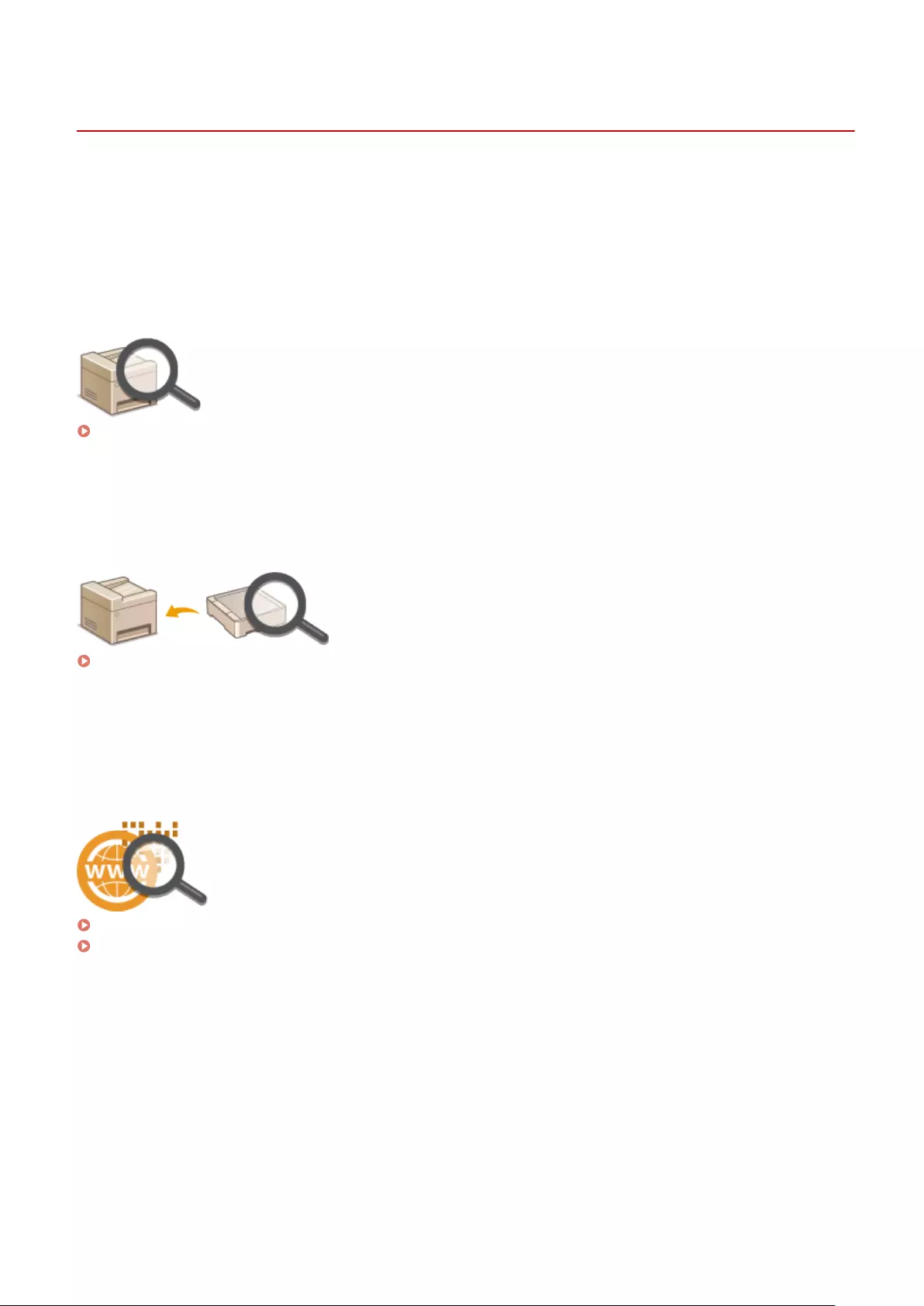
Appendix
6FR5-0AC
This chapter contains technical specications of this machine, instructions on how to use the User's Guide, disclaimers,
copyright information, and other important information for customers.
◼Machine Specications
See the following section(s) when you want to check the specications of the main unit and optional equipment,
network environment, print function, and so on.
Specications(P. 619)
◼Using Optional Equipment
See the following section(s) when you want to check what options are available to use this machine more conveniently
and more effectively.
Options(P. 638)
◼Referencing the Manual of This Machine
See the rst of the following sections when you want to be sure of the kinds of the manuals describing the functions of
the machine and how to operate the machine. When you want to know how to read and use the User's Guide (this
manual), see the second section.
Manuals and Their Contents(P. 643)
Using User's Guide(P. 644)
◼Others
See the following section(s) when you want to get useful information, and check the disclaimers and copyright
information.
Appendix
607

Third Party Software
6FR5-0AE
For information related to third-party software, click the following icon(s).
Appendix
609

Feature Highlights
6FR5-0AF
This section describes tips for leveraging the features of the machine by category. You can make use of the features
according to your intended purposes and operating environment.
Going Green and Saving Money(P. 611)
Improving Eciency(P. 613)
Going Digital(P. 615)
So Much More(P. 617)
Appendix
610
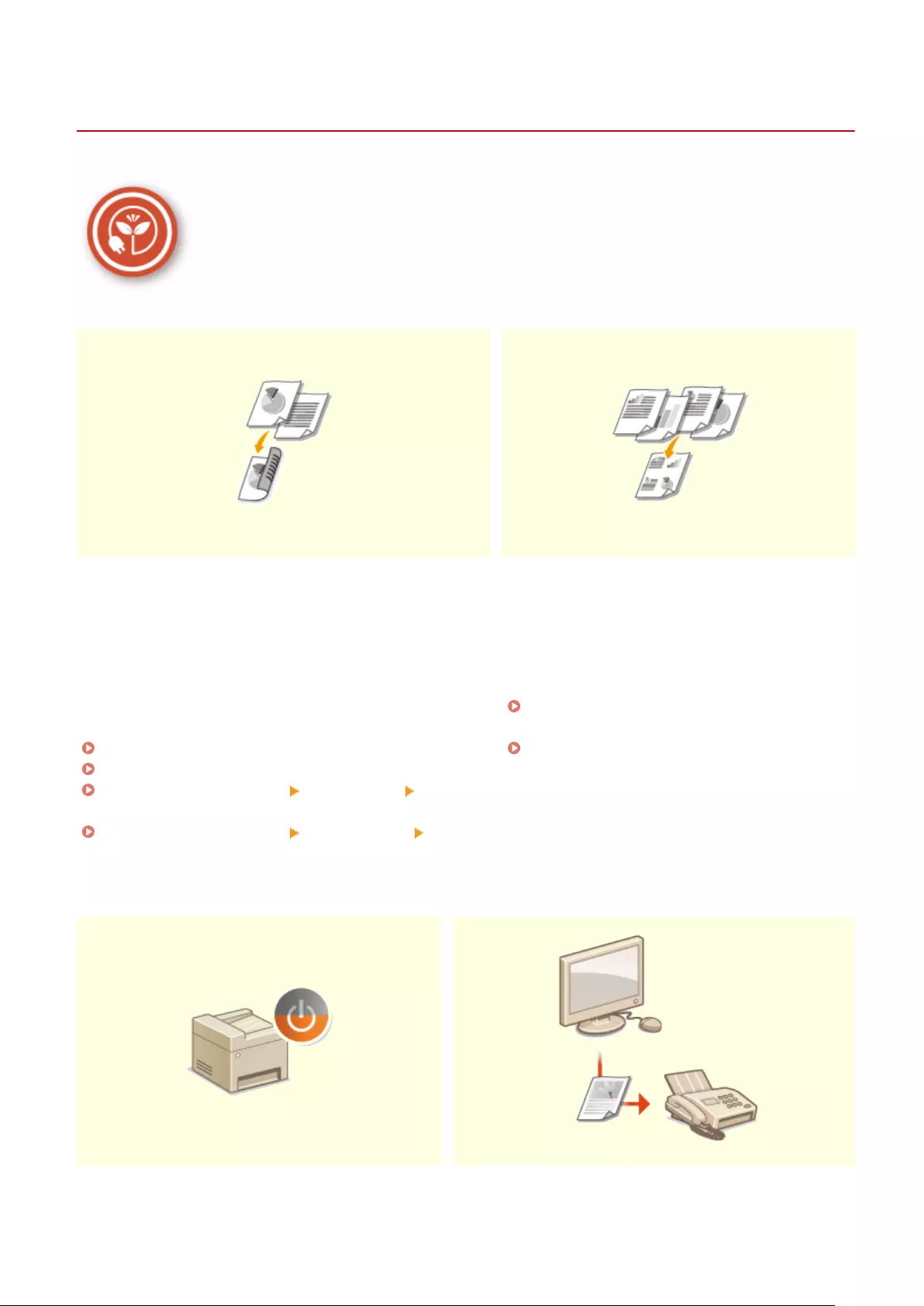
Going Green and Saving Money
6FR5-0AH
There are lots of ways to cut back on paper, toner, power, and expenses.
2-Sided Printing Print Multiple Pages on a Single Sheet
You can use 2-sided printing for copies, print jobs sent from
your computer, and even incoming faxes. Because you'll only
be using half the paper you would otherwise, you can cut
your paper costs in half. To save even more, combine 2-sided
printing with N on 1 printing of multiple pages on one sheet
of paper. You can print up to 32 pages on a single sheet,
which is both economical and environmentally friendly.
Basic Copy Operations(P. 195)
Printing from a Computer(P. 260)
<Receive/Forward>(P. 547) <Fax Settings> <Print on
Both Sides>
<Receive/Forward>(P. 547) <I-Fax Settings> <Print
on Both Sides>
To really start saving paper, shrink multiple pages
onto one side of a sheet - 2 or 4 pages for copies,
and up to 16 pages for print jobs sent from your
computer. This is even more effective when used
together with 2-sided printing.
Copying Multiple Documents onto One Sheet
(N on 1)(P. 208)
Printing from a Computer(P. 260)
Sleep Mode Paperless Faxing
Appendix
611

For saving energy and money, a sleep mode that
powers down a machine when nobody is using it has
become an essential feature. This machine will enter
sleep mode automatically, and can also be put to
sleep whenever you want. Press once to put the
machine to sleep. Press it again to instantly wake the
machine back into action.
Entering Sleep Mode(P. 178)
Assume you need paper to fax? Those old paper printouts
you always make are a thing of the past. Send documents
by fax just as they are, created on your computer. It's
paperless, so it's fast. And, received documents are rst
stored in memory, allowing you to print out only those
needed and eliminating worry about paper getting used on
direct mailings, etc.
Sending Faxes from Your Computer (PC Fax)(P. 246)
Saving Received Documents into the Machine
(Memory Reception)(P. 239)
Appendix
612
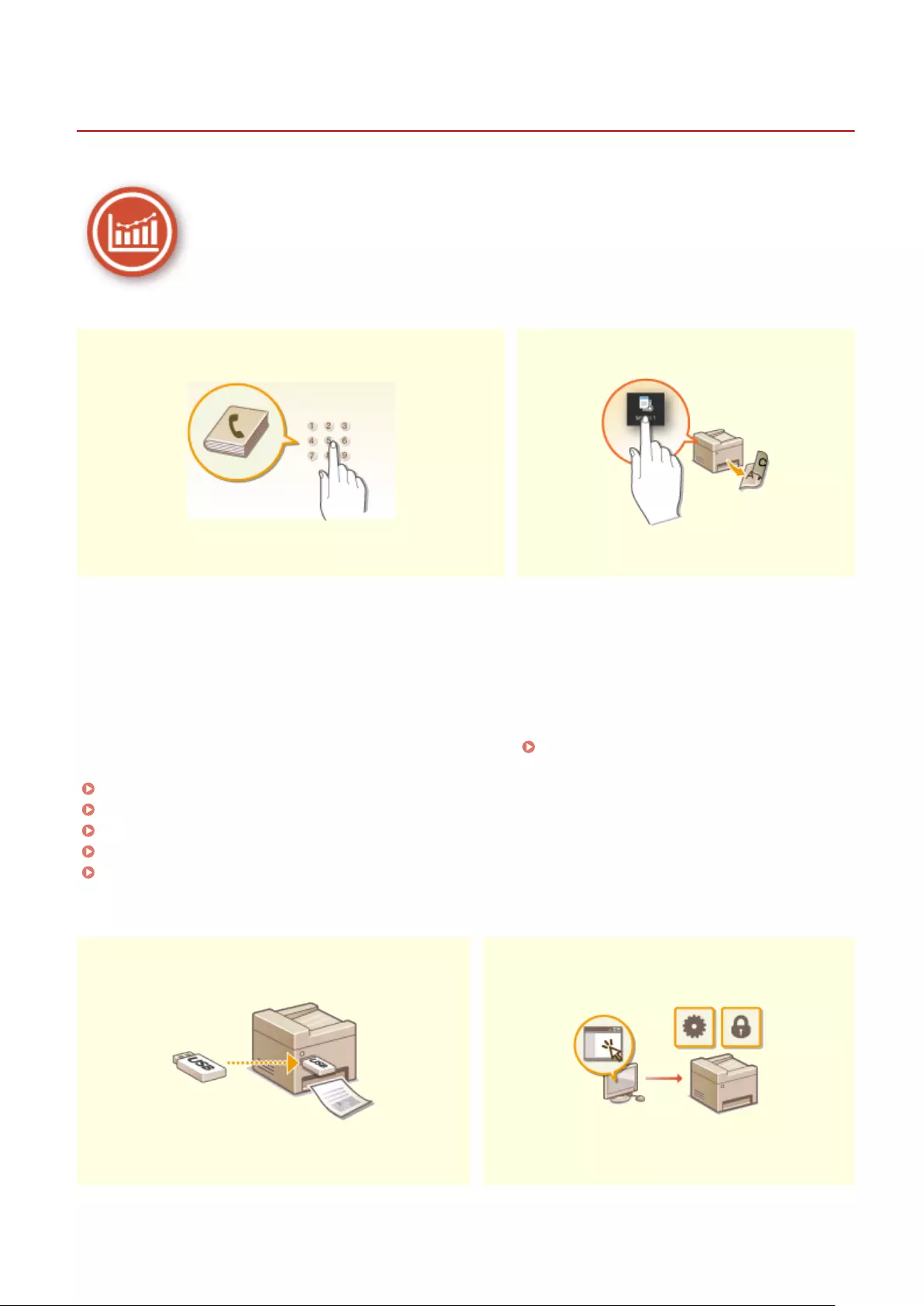
Improving Eciency
6FR5-0AJ
Here are some simple operations that can make complicated tasks more ecient.
Address Book Frequently Used Settings in One Touch
Entering fax and e-mail addresses in the Address Book saves
you the inconvenience of entering them number-by-number,
letter-by-letter every time you have something to send. Display
the addresses you use most frequently with the <Favorites>
feature to quickly and easily send what you need to the people
who need it. You can save your Address Book data on your
computer and feel secure knowing that your important contact
information is backed up.
Registering Destinations(P. 180)
Registering Destinations from Remote UI(P. 440)
Basic Operations for Sending Faxes(P. 218)
Basic Operations for Scanning Originals(P. 285)
Importing/Exporting the Setting Data(P. 450)
Always making 2-sided copies. Always scanning in
the same format and to the same save
destination. Frequently used settings like these
can be registered to a single shortcut button. This
is convenient by allowing you to specify involved
operations all in a single touch.
Registering Frequently Used Settings(P. 172)
Print Images Right Off Your USB Memory Device Remote Management with Remote UI
Appendix
613
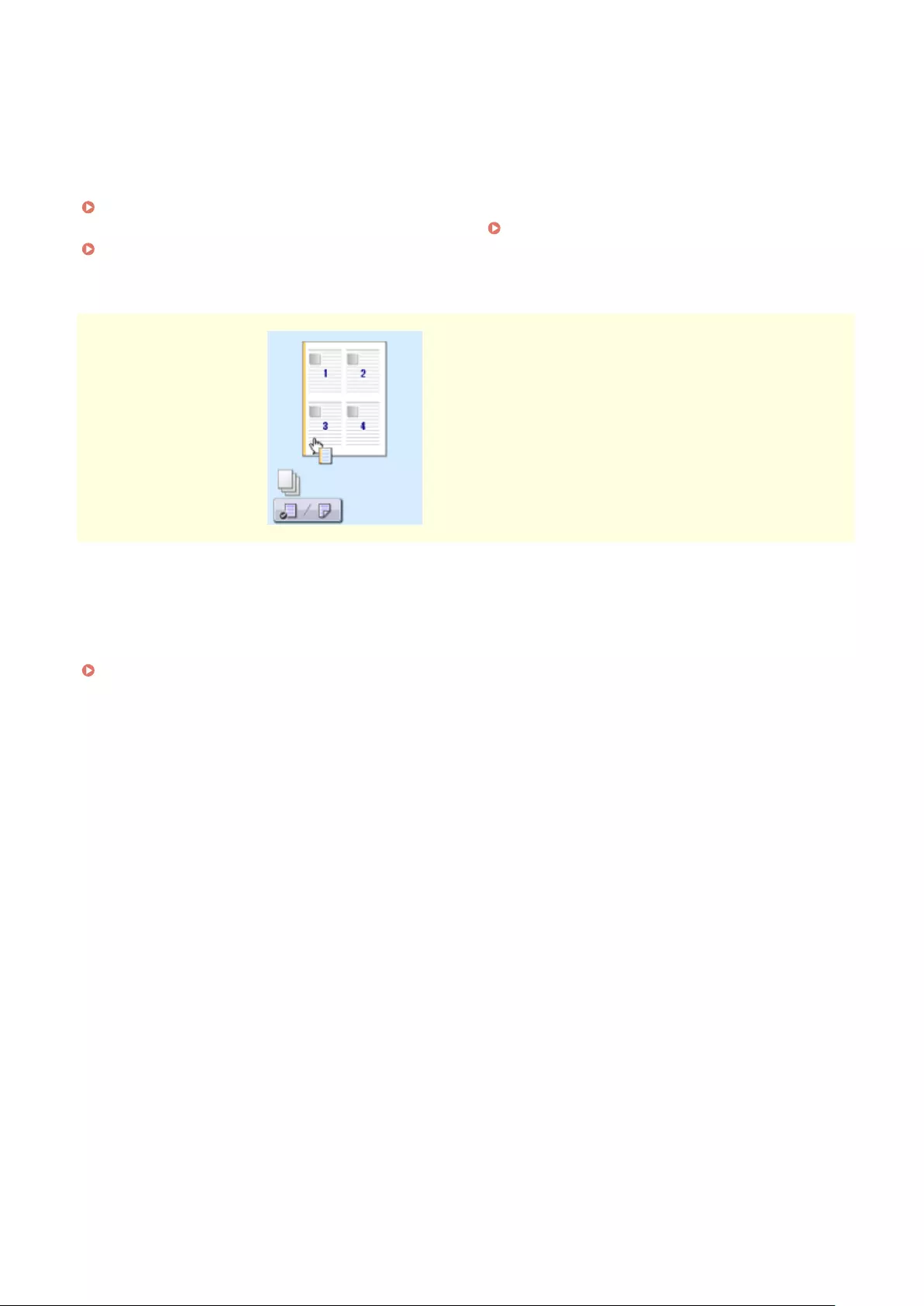
Plug a USB memory device into the machine and you can
print images and documents directly, without using a
computer. You can even preview JPEG and other images
before you print, so there is no wasted paper. You can also
scan handwritten memos, etc. and save them directly to a
USB memory device. Convenient for carrying about.
Printing from a USB Memory Device (Memory Media
Print)(P. 271)
Basic Operations for Scanning Originals(P. 285)
Remote UI lets you manage a lot from your computer,
all without having to go over to the machine. Congure
settings and keep an eye on the machine's status with
an intuitive, easy-to-understand Web browser interface
that you'll master immediately. Save your time and
energy for things other than taking care of the
machine.
Managing the Machine from a Computer (Remote
UI)(P. 427)
Make Print Settings Quickly with Intuitive Operation
You can easily specify the page layout as well as binding position, switching
between 1-sided and 2-sided printing, etc. intuitively on the preview image in
the printer driver. The simple click-operation allows you to conveniently make
settings while viewing how settings are applied.
Printing from a Computer(P. 260)
Appendix
614
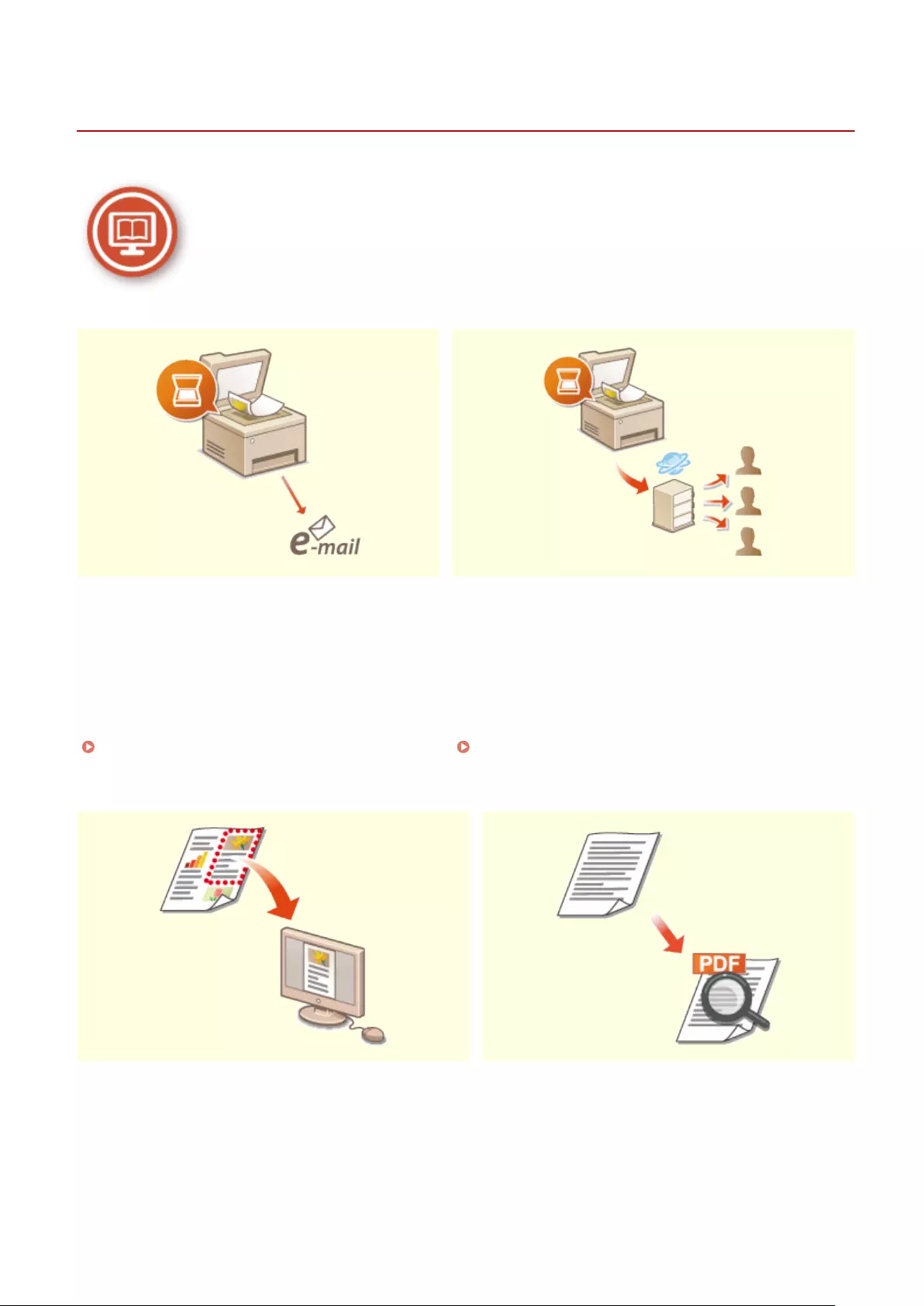
Going Digital
6FR5-0AK
Digitalizing a document enables editing using a computer as well as reducing cost and time by using e-mail.
Scan and E-Mail Scan and Share
E-mail scanned originals without even turning on
your computer. Just convert your scanned original
into an e-mail attachment right from the machine. If
you're one of those people who'd rather send a fax
than mess around with a computer, this feature is for
you.
Basic Operations for Scanning Originals(P. 285)
Say you've got a paper copy of a report for a company-wide
meeting. Scan it, convert it, and now everyone can see it.
It's saved directly in a shared folder on your network, so
there's no need to print out copies and pass them out. Once
you start talking about hundreds of pages of documents
that everyone needs, there's just no other way to go.
Basic Operations for Scanning Originals(P. 285)
Scan Only What You Need Searchable PDFs
Appendix
615
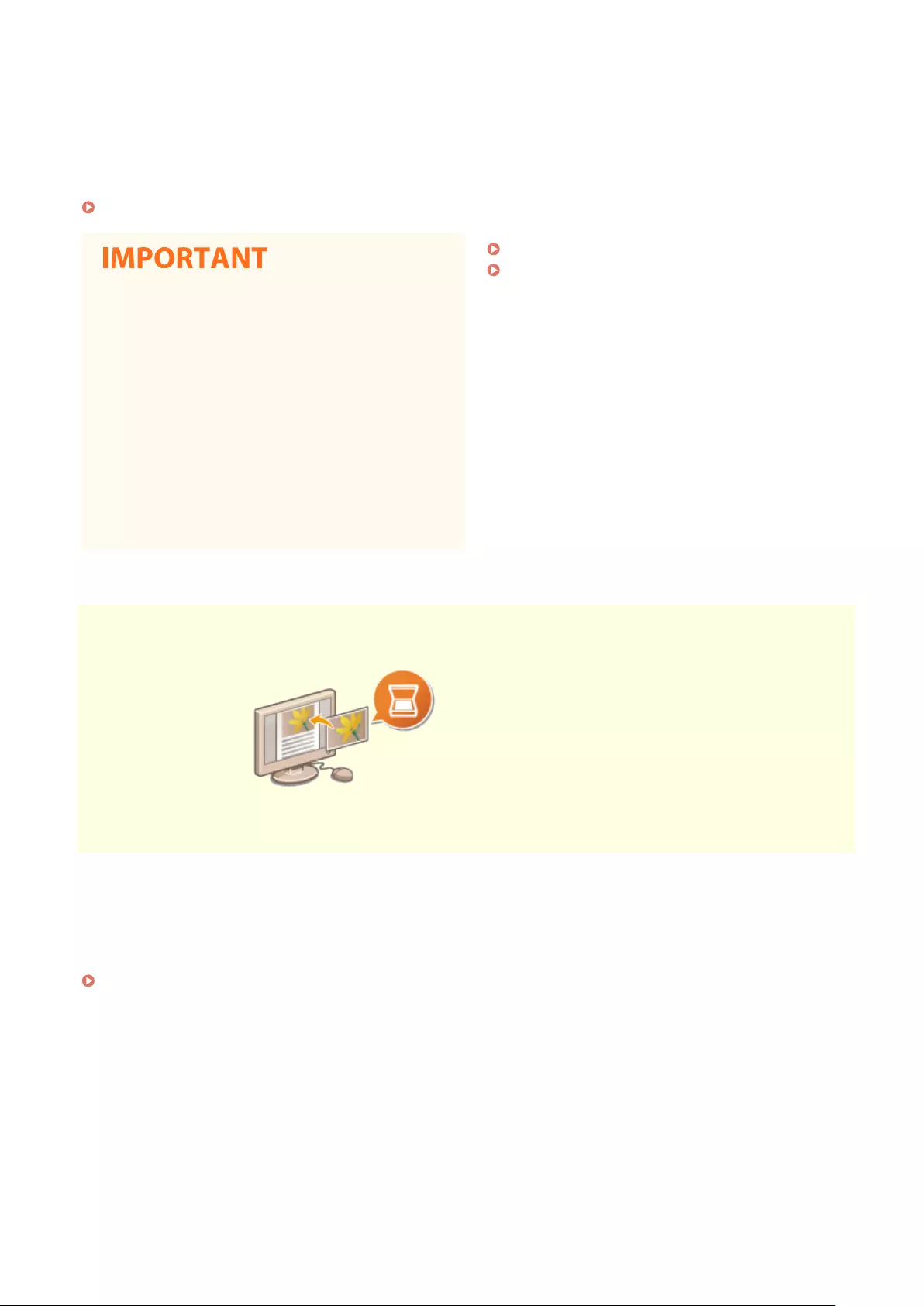
What if you're scanning a whole page of a newspaper but
all you're really interested in is a headline and a photo?
Use ScanGear MF. You can select what you want from a
preview, and then have the scanner disregard the rest.
Otherwise you'll have to use an editing program to crop
out everything you don't need.
Using ScanGear MF(P. 325)
●Using your product to scan, print or otherwise
reproduce certain documents, and the use of
such images as scanned, printed or otherwise
reproduced by your product, may be
prohibited by law and may result in criminal
and/or civil liability. If you are uncertain about
the legality of using your product to scan,
print or otherwise reproduce any particular
document, and/or of the use of the images
scanned, printed or otherwise reproduced,
you should consult in advance with your legal
advisor for guidance.
Searching of text in a PDF can be done with a
"searchable PDF." By scanning an original with both
text and images, text portions are converted by OCR
into text data. In addition to being able to search for
text information, you can also copy required portions
into an Excel spreadsheet or Word document in
Microsoft Oce. Eliminate the need to type in
customer data, addresses, etc. from scratch.
Basic Operations for Scanning Originals(P. 285)
Using Your Computer to Scan (Remote Scan)
(P. 322)
Add Images to a Work in Progress
Some applications work with the machine to let you easily import scanned
images directly into documents you're working on. This way you can skip the
steps of opening a separate application just for receiving the scanned images
and then exporting them to the application you're really using.
Scanning Documents from an Application(P. 323)
Appendix
616
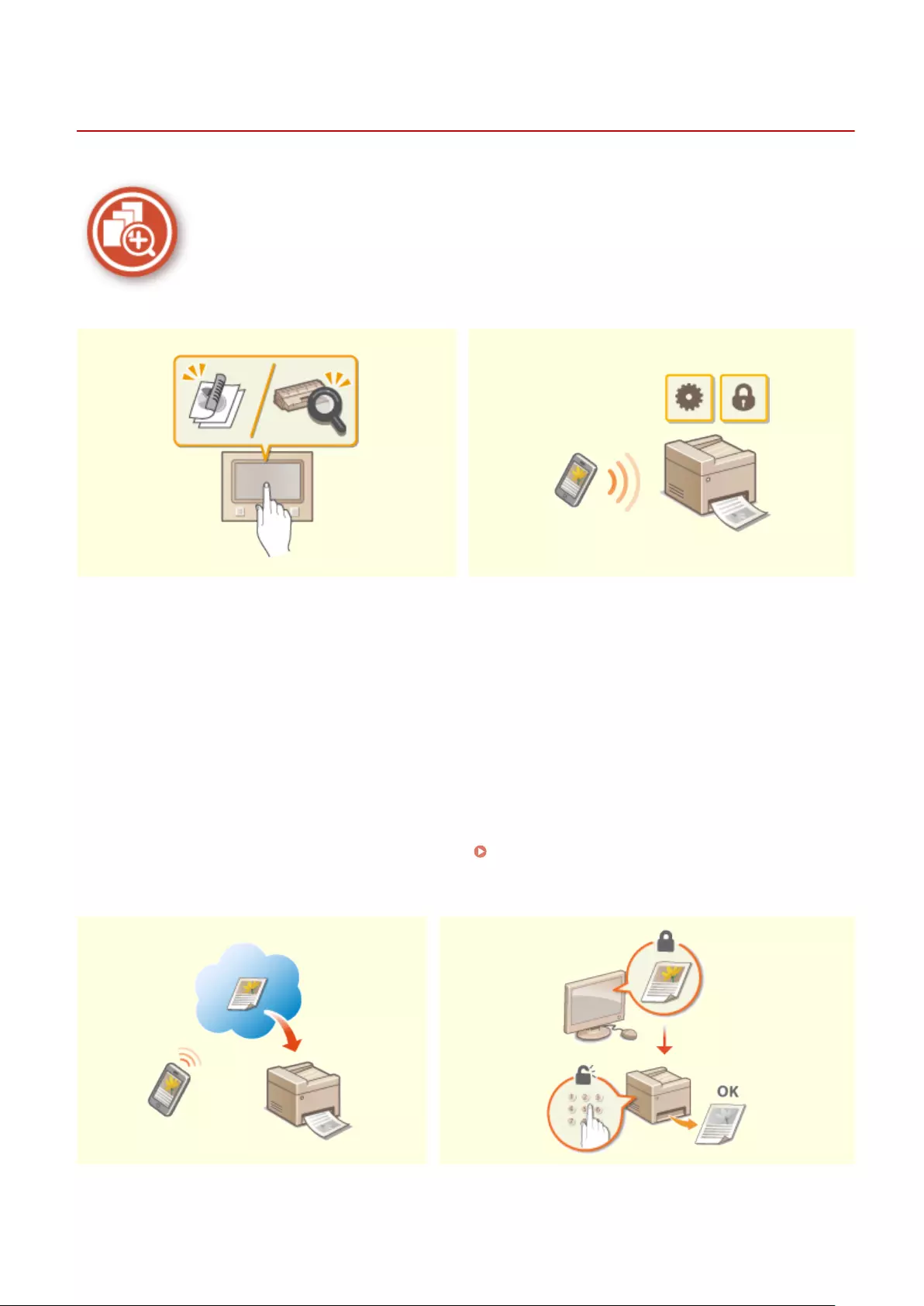
So Much More
6FR5-0AL
There are a variety of features for whatever you need to do - at home, in the oce, or even on the road.
Application Library to execute useful functions in
one-touch button operation
Using a smartphone/tablet
Application Library is a facility that makes it possible that
frequently used operations such as printing a usual
document and checking the consumables information
as well as convenient functions are registered in the
form of applications. You can execute these applications
in one-touch button operation from the Home screen.
Make the best use of Application Library for time
reduction and operational accuracy enhancement. For
more information, see the manual on Application
Library on the online manual website.
At times such as when you want to quickly print out a
proposal you completed on a tablet while travelling to a
business destination, or scan materials handed out at a
meeting using a smartphone, Canon PRINT Business
comes in handy. Even in environments without a wireless
LAN router, you can connect to the machine with a
mobile device wirelessly and directly.
PCless, quick, and easy! An even broader range of
possibilities for work/play with functionality made for this
age of speed.
Linking with Mobile Devices(P. 332)
Easy Printing with Google Cloud Print Keep Your Printouts Private
Appendix
617
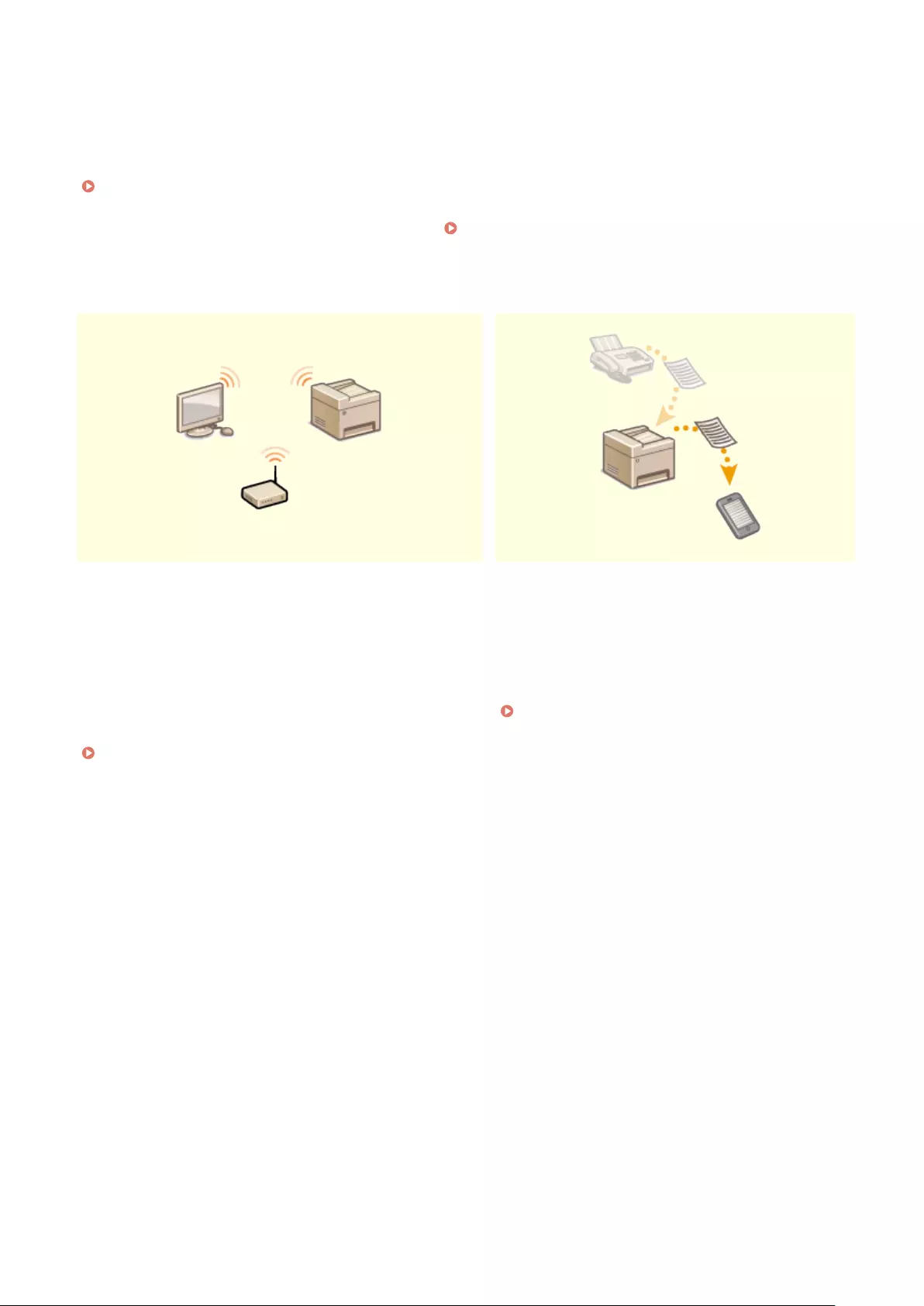
Hook up to Google Cloud Print with your laptop or
cell phone, send your data, and out come your
printed documents. With this machine, Google
Cloud Print, and your mobile device, print whenever
you want from wherever you want.
Using Google Cloud Print(P. 354)
Normally, when you print something from your computer, it
comes out of the printer right away. However, if you have
sensitive documents, this may not be what you want. Just use
secure printing and no one will be able to print your
documents without entering your password on the machine's
operation panel. Don't let your condential documents lie
exposed on the tray for everyone to see.
Printing a Document Secured by a PIN (Secure Print)
(P. 267)
Go Wireless Get Faxes Wherever You Go
No cables, easy installation, simple maintenance. If you've
got a WPS wireless LAN router, bypass the settings process
altogether and be ready to go before you know it. Enjoy the
kind of clutter-free and easy to use document system that
you can only get from wireless. Compatible with IEEE
802.11b/g/n for stress-free wireless, and also supports WEP
and WPA/WPA2-PSK (TKIP/AES-CCMP) for tighter security.
Connecting to a Wireless LAN(P. 18)
Never worry about missing a fax when you're out of
the oce. Set a forwarding destination and any fax
that comes in on the machine will go right to you.
Better yet, make the forwarding destination the e-
mail address for your tablet or mobile.
Forwarding the Received Documents
Automatically(P. 241)
Appendix
618

Specications
6FR5-0AR
Specications are subject to change without notice for product improvement or future release.
◼Machine Specications
Main Unit(P. 620)
Feeder(P. 623)
Available Paper(P. 624)
◼Specications of Optional Equipment
Cassette Feeding Module-AH(P. 627)
Copy Card Reader-F(P. 628)
◼Functional Specications
Fax Function(P. 629)
Scan Function(P. 630)
Printer Functions(P. 631)
Management Functions(P. 633)
◼Environment To Use the Machine
System Environment(P. 635)
Network Environment(P. 637)
Appendix
619
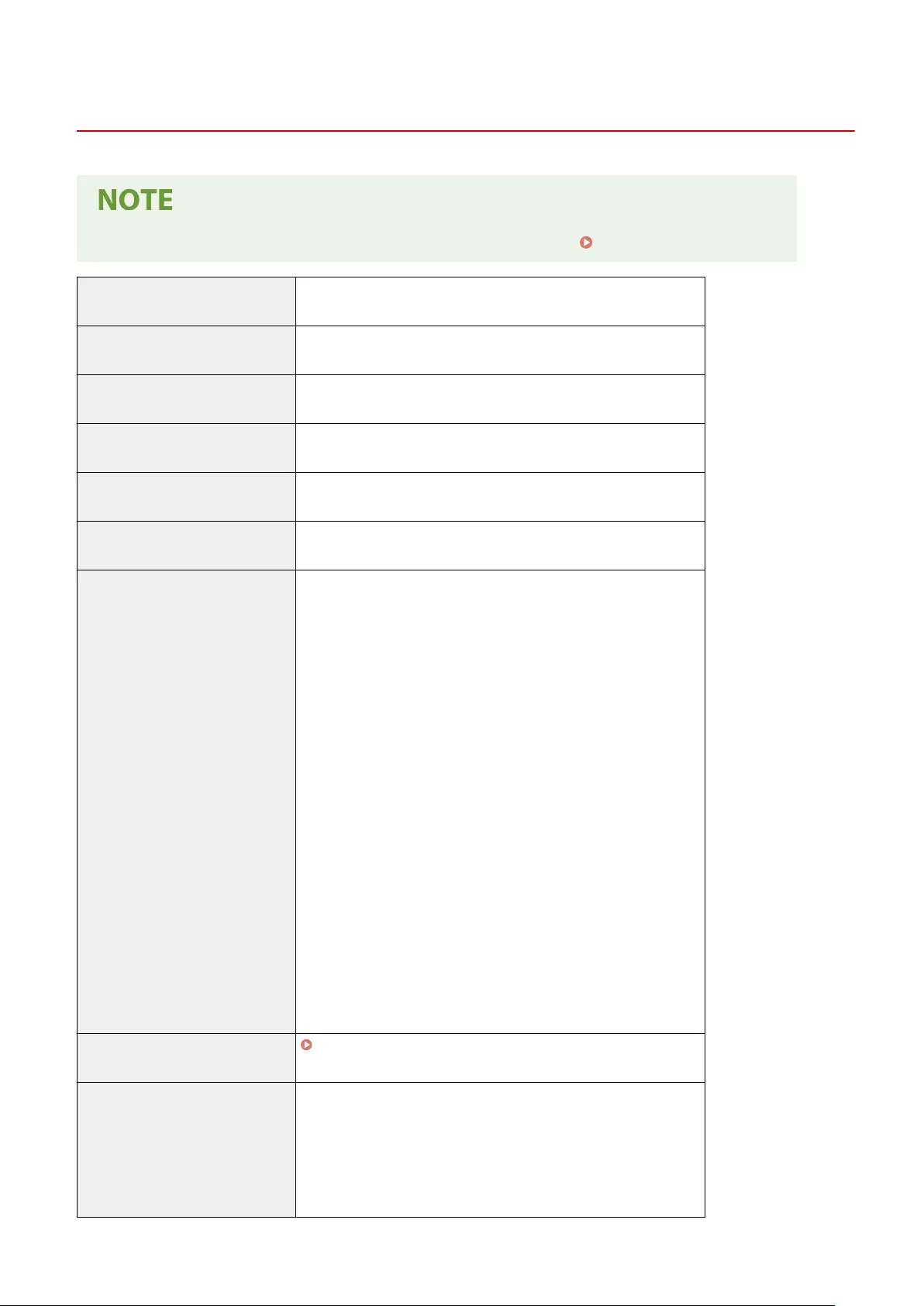
Main Unit
6FR5-0AS
●For information on paper sizes and types for each paper source, see " Available Paper(P. 624) ."
Type Desktop
Color Supported Black and White
Resolution for Reading 600 dpi x 600 dpi
Resolution for Writing 600 dpi x 600 dpi
Number of Tones 256
Acceptable Originals Up to 215.9 mm x 297.0 mm: Sheet, book, three dimensional objects
Copy Size/Copy Paper Paper Sizes
●Max: 216.0 mm x 355.6 mm
●Min (Paper Drawer): 105.0 mm x 148.0 mm
●Min (Multi-Purpose Tray): 76.2 mm x 127.0 mm
Margin
Top:
●When copying via the platen glass
5 mm ± 2.0 mm
●When copying via the feeder
5 mm ± 3.0 mm
Left or Right:
●When copying via the platen glass
5 mm ± 2.0 mm
●When copying via the feeder
5 mm ± 3.0 mm
Paper Weight
●Paper Drawer: 60 g/m² to 120 g/m²
●Multi-Purpose Tray: 60 g/m² to 163 g/m²
Paper Type Available Paper(P. 624)
Warm-Up Time *1 After Powering ON
14.0 seconds or less
Returning from the Sleep Mode
4.0 seconds or less
Appendix
620
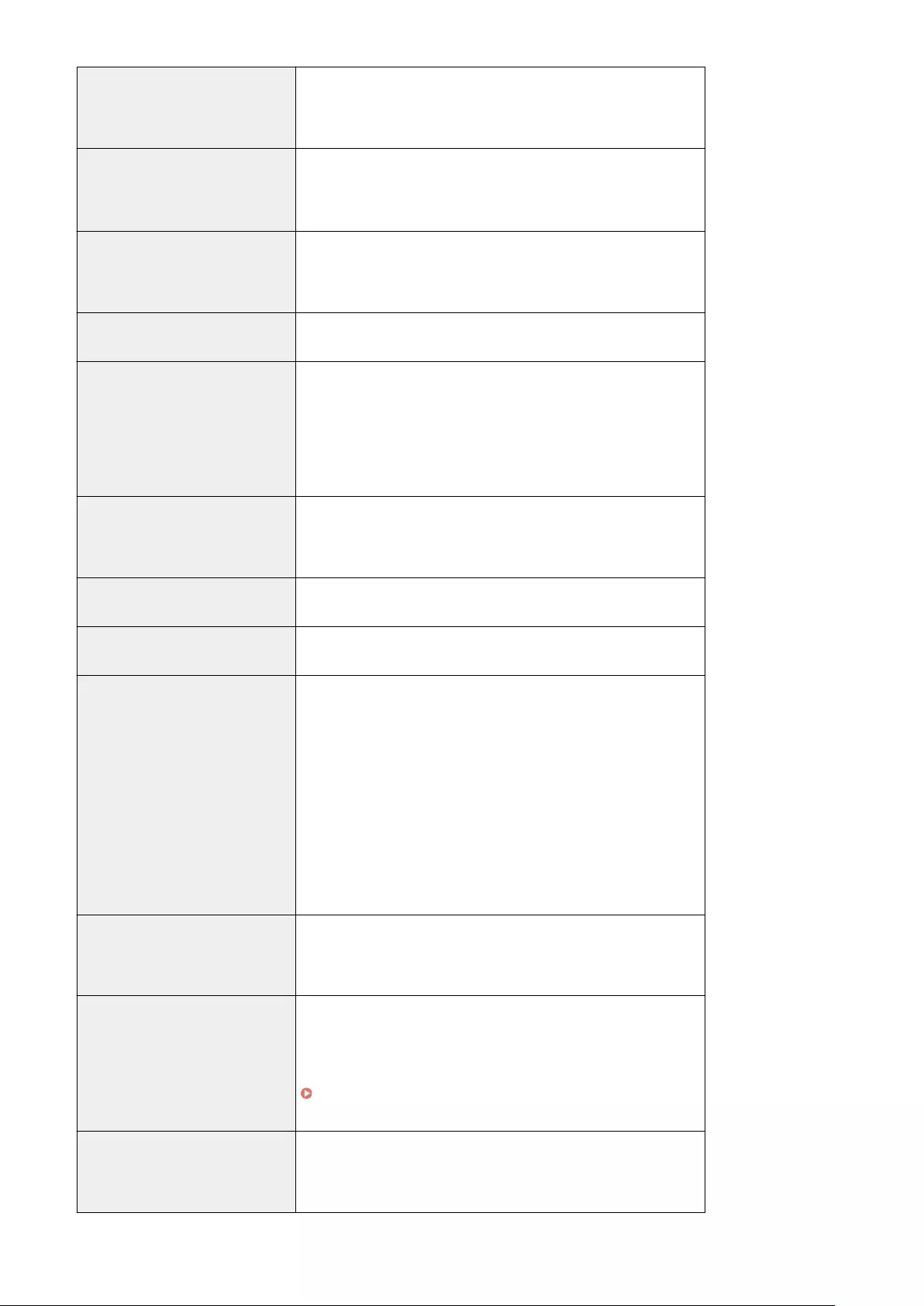
First Copy Time
(A4)
Approx. 6.4 seconds
Copy Speed *2
(A4)
38.0 sheets/minute
Scanning Speed
(A4)
Approx. 1.7 seconds
Magnication 25 % to 400 % (in 1 % increments)
Paper Feeding System/Capacity *3 Paper Drawer
250 sheets (80 g/m²)/250 sheets (64 g/m²) x 1
Multi-Purpose Tray
100 sheets (80 g/m²)/100 sheets (64 g/m²) x 1
Paper Output System/Capacity *3 Output Tray
150 sheets (68 g/m²)
Multiple Copies 999 sheets
Power Source AC 220 V - 240 V, 3.2 A, 50 Hz/60 Hz
Power Consumption *1 Maximum Power Consumption
1,350 W or less
During Sleep Mode
●Approx. 0.9 W (USB connection)
●Approx. 0.9 W (wired LAN connection)
●Approx. 0.9 W (wireless LAN connection)
With the Main Power Turned OFF
0.1 W or less
Dimensions
(W x D x H)
453 mm x 464 mm x 392 mm
Weight Main Unit *4
Approx. 16.2 kg
Consumables
Replacement Parts(P. 602)
Maximum Occupancy Space
(W x D x H)
482 mm x 883 mm x 795 mm
Appendix
621

Memory Capacity RAM: 1 GB
Environmental Conditions ●Temperature: 10 °C to 30 °C
●Humidity: 20 % to 80 % RH (no condensation)
*1May vary depending on the environment and conditions under which the machine is being used.
*2Copy/print speeds are measured based on internal testing using A4 size paper copied/printed with 100% copy/print
ratio to original on one-sided paper. Internal testing involved continuously copying/printing the same one page of
content on plain paper (copy speed is tested by copying on the platen glass). Copy/print speeds may vary depending on
paper type, paper size or paper feeding direction.
The device may automatically pause or slow down in order to adjust printer condition such as controlling temperature of
a certain unit or limiting impact to image quality during continuous copying/printing.
*3May vary depending on the installation environment and paper to use.
*4The toner cartridge is not included.
Appendix
622

Feeder
6FR5-0AU
Original Feeding Mechanism Automatic 2-Sided Document Feeder
Original Size /Type Size of Originals *1
●Max : 215.9 mm x 355.6 mm
●Min : 105.0 mm x 128.0 mm
Weight of Originals
50 g/m² to 105 g/m²
Original Tray Capacity
(A4)
50 sheets (80 g/m²)
Original Scanning Speed
(A4)
Copying (600 dpi)
1-Sided Scanning:
●20.0 pages/minute
2-Sided Scanning:
●34.0 pages/minute
Scanning (300 dpi) *2
1-Sided Scanning:
●Full Color: 13.0 pages/minute
●Black and White: 38.0 pages/minute
2-Sided Scanning:
●Full Color: 26.0 pages/minute
●Black and White: 70.0 pages/minute
*1To maintain the optimum image quality, it is recommended to scan A6 size original(s) from the platen glass.
*2May vary depending on the environment and conditions under which the machine is being used.
Appendix
623
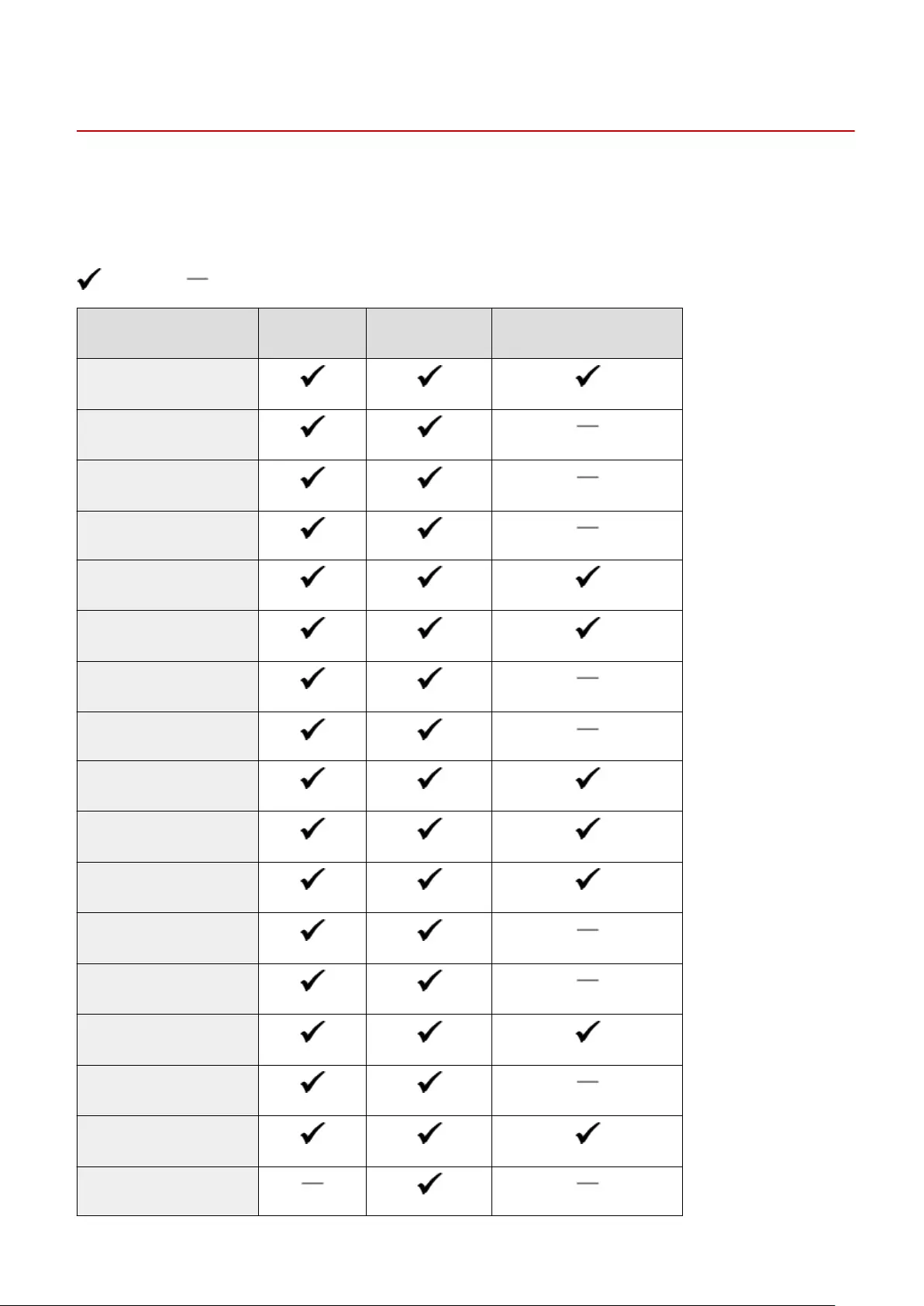
Available Paper
6FR5-0AW
The paper types that can be used with this machine are shown in the following table.
◼Supported Paper Sizes
: Available : Unavailable
Paper Sizes Paper Drawer *1 Multi-Purpose Tray Automatic 2-Sided Printing *2
A4 *3*4*5
B5 *3
A5 *3*6
A6
Legal (LGL) *3*4
Letter (LTR) *3*4*5
Statement (STMT) *3
Executive (EXEC)
Ocio *3*4
Ocio (Brazil) *3*4
Ocio (Mexico) *3*4
Letter (Government) *3*4
Legal (Government) *3*4
Foolscap/Folio *3*4
Foolscap (Australia) *3*4
Legal (India) *4
3x5inch
Appendix
624
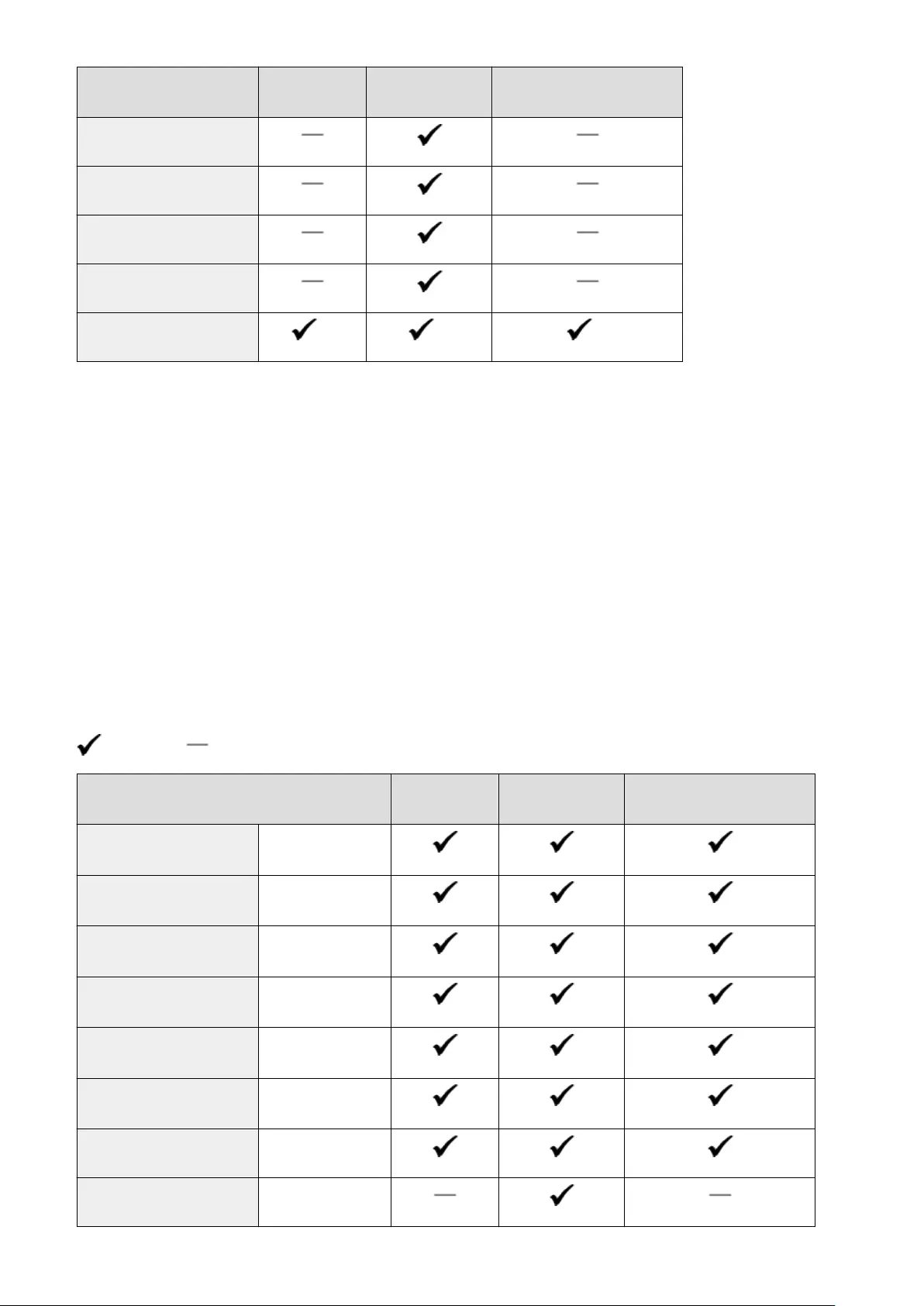
Paper Sizes Paper Drawer *1 Multi-Purpose Tray Automatic 2-Sided Printing *2
Envelope No.10 (COM10)
Envelope Monarch
Envelope C5
Envelope DL
Custom Paper Size *7 *8 *9
*1Includes the optional Cassette Feeding Module-AH.
*2Automatic 2-sided printing is available without replacing paper.
*3Allows you to print received fax documents.
*4Allows you to print received I-Fax documents.
*5Allows you to print reports or lists.
*6Landscape or portrait orientation is available.
*7The custom size ranging from 105.0 mm x 148.0 mm to 216.0 mm x 355.6 mm is available.
*8The custom size ranging from 76.2 mm x 127.0 mm to 216.0 mm x 355.6 mm is available.
*9The custom size ranging from 210.0 mm x 279.4 mm to 216.0 mm x 355.6 mm is available.
◼Supported Paper Types
Chlorine-free paper can be used with this machine.
: Available : Unavailable
Paper Type Paper Drawer *1 Multi-Purpose Tray Automatic 2-Sided Printing *2
Plain 1 *3*4 61 g/m² to 74 g/m²
Plain 2 *3*4 75 g/m² to 89 g/m²
Plain 3 *4 90 g/m² to 105 g/m²
Recycled 1 *3*4 61 g/m² to 74 g/m²
Recycled 2 *3*4 75 g/m² to 89 g/m²
Color *3*4 61 g/m² to 74 g/m²
Heavy 1 106 g/m² to 120 g/m²
Heavy 2 121 g/m² to 149 g/m²
Appendix
625
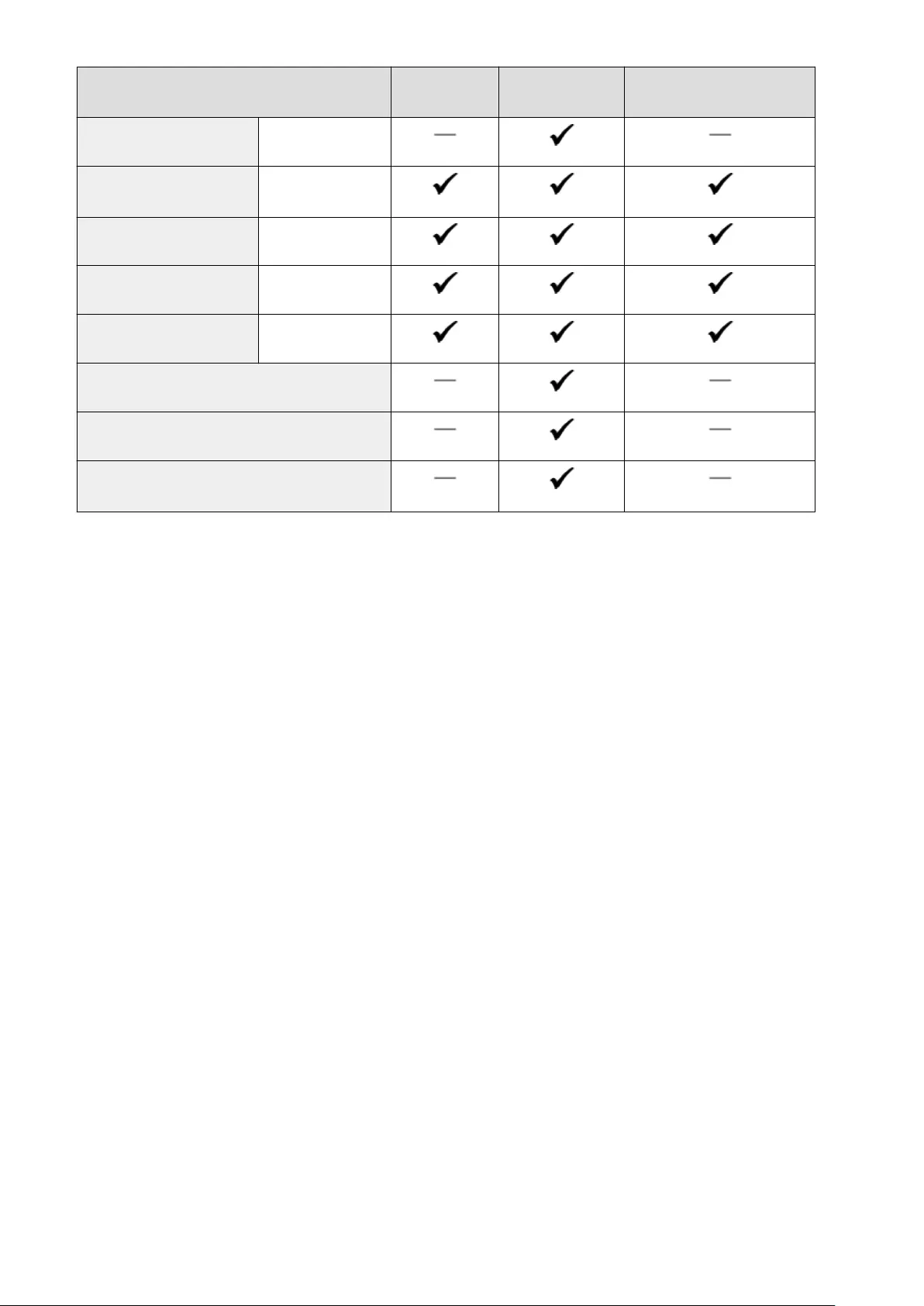
Paper Type Paper Drawer *1 Multi-Purpose Tray Automatic 2-Sided Printing *2
Heavy 3 150 g/m² to 163 g/m²
Thin 1 *3 60 g/m²
Bond 1 60 g/m² to 74 g/m²
Bond 2 75 g/m² to 104 g/m²
Bond 3 105 g/m² to 120 g/m²
Labels
Envelope 1
Envelope 2 *5
*1Includes the optional Cassette Feeding Module-AH.
*2Automatic 2-sided printing is available without replacing paper.
*3Allows you to print received fax/I-Fax documents.
*4Allows you to print reports or lists.
*5If printing cannot be performed properly with <Envelope 1> selected, change the selection to <Envelope 2>.
Appendix
626
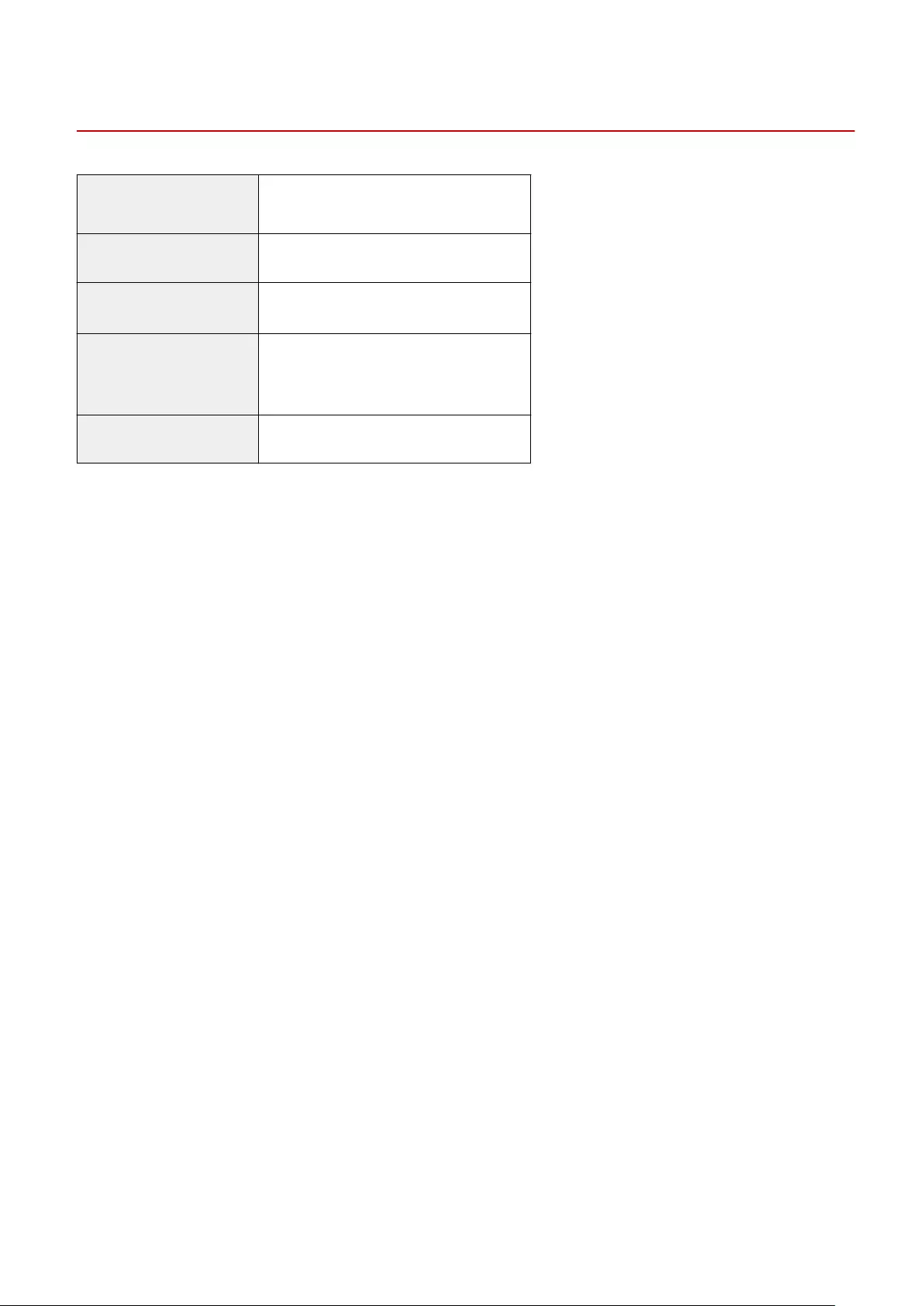
Cassette Feeding Module-AH
6FR5-0AX
Paper Sizes ●Max: 216.0 mm x 355.6 mm
●Min: 105.0 mm x 148.0 mm
Paper Weight 60 g/m² to 120 g/m²
Paper Drawers Capacity *550 sheets (80 g/m²)/640 sheets (64 g/m²) x 1
Dimensions
(W x D x H)
399 mm x 373 mm x 156 mm
Weight Approx. 3.8 kg
*May vary depending on the installation environment and paper to use.
Appendix
627
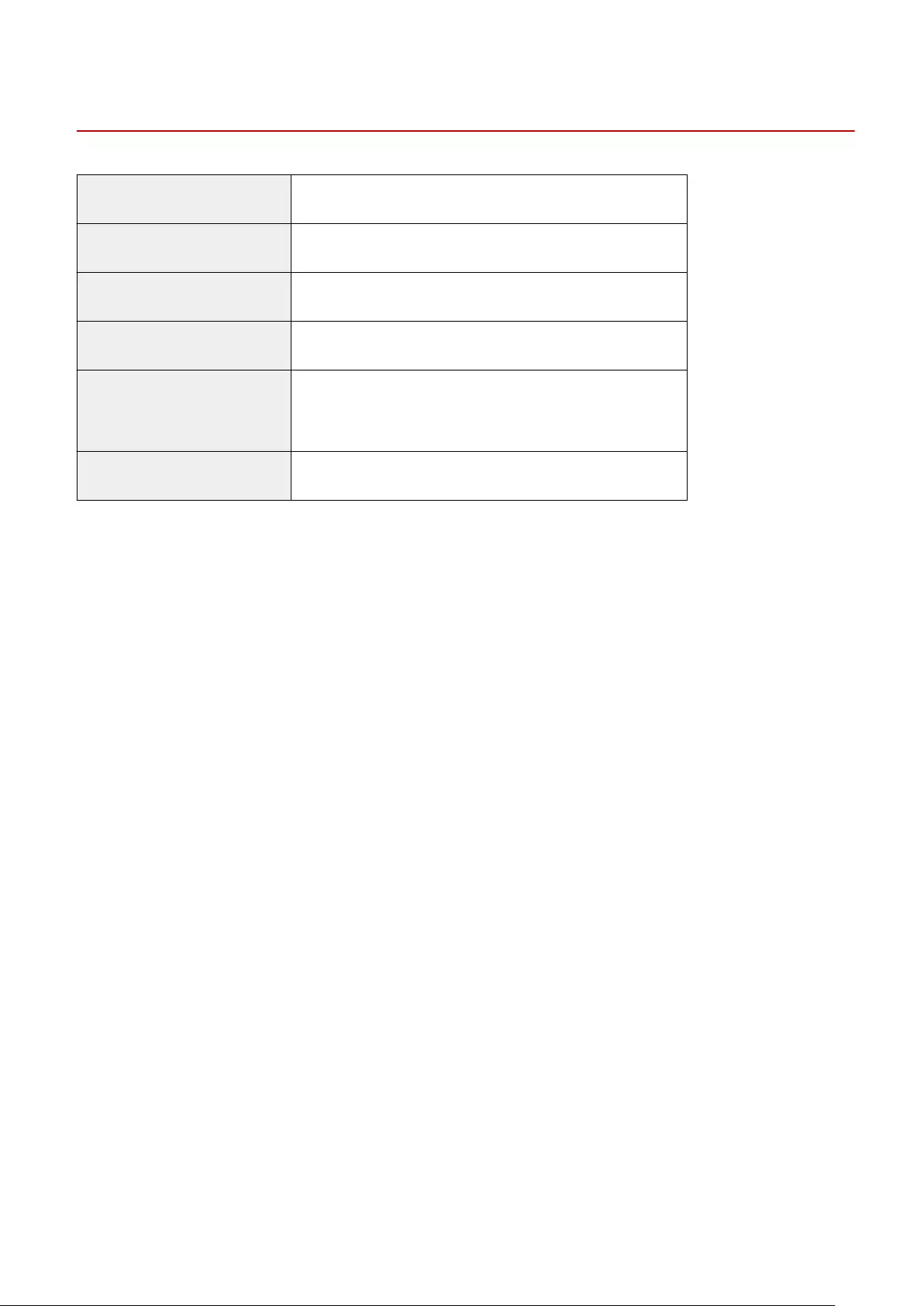
Copy Card Reader-F
6FR5-0AY
Available Cards Magnetic
Card Readout Method Magnetic readout
Magnetic Card Reading Direction Face up
Store/Replay Replay
Dimensions
(W x D x H)
88 mm x 96 mm x 40 mm (excluding the attachment kit and cable)
Weight Approx. 200 g (including the attachment kit and cable)
Appendix
628
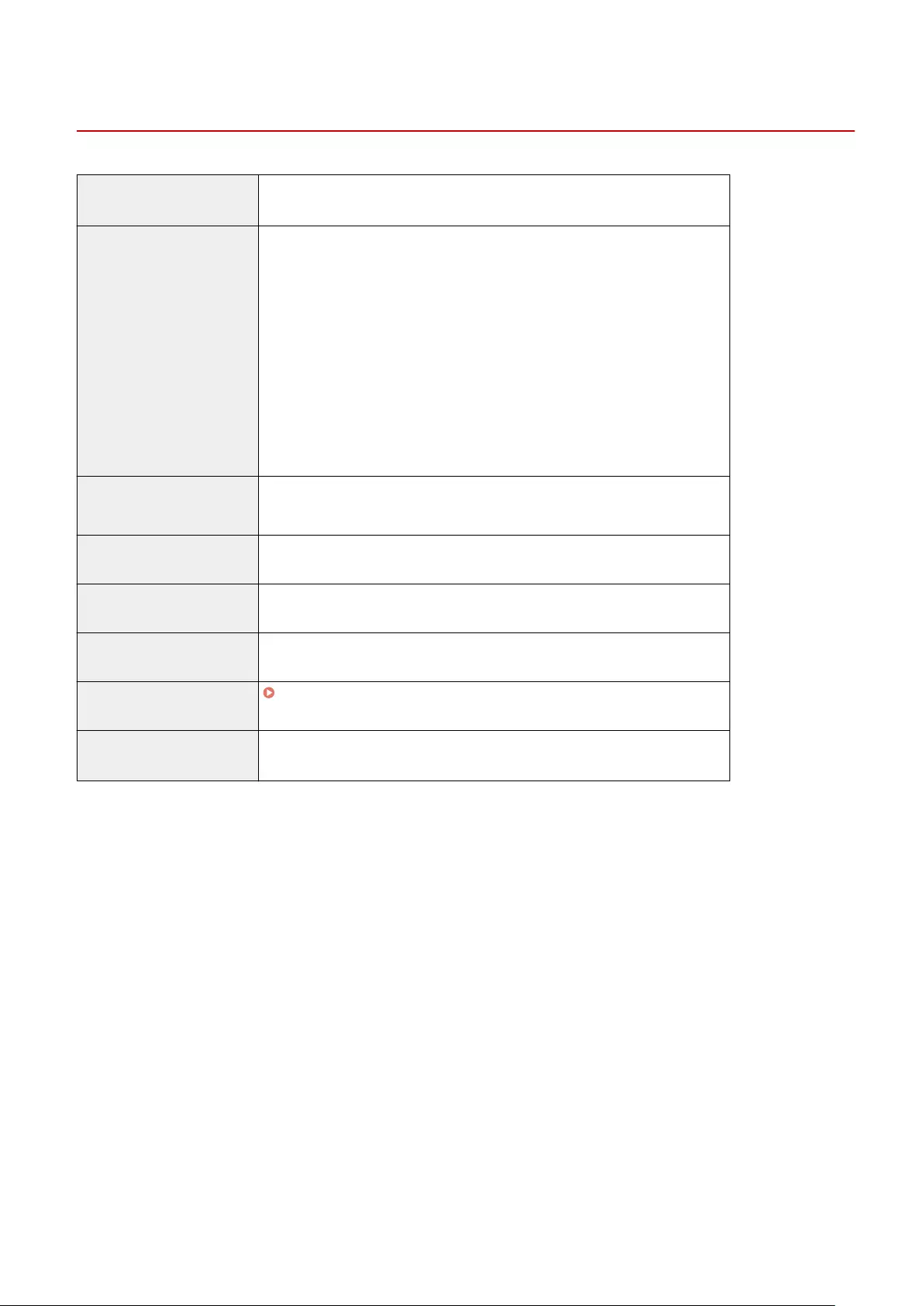
Fax Function
6FR5-0C0
Telephone Line Used *1 Public Switched Telephone Network, Facsimile Communication Network (PSTN)
Scan Line Density Normal
G3: 8 pels*2/mm x 3.85 line/mm
Fine
G3: 8 pels*2/mm x 7.7 line/mm
Superne
G3: 8 pels*2/mm x 15.4 line/mm
Ultrane
G3: 16 pels*2/mm x 15.4 line/mm
Transmission Speed *3 ●SuperG3: 33.6 kbps
●G3: 14.4 kbps
Compression Method MH, MR, MMR, JBIG
Transmission Type SuperG3, G3
Max. Sending Original Sizes A4
Receiving Paper Sizes Available Paper(P. 624)
Transmission Times Approx. 2.6 seconds*4
*1Depending on your locale or your telephone connection, you may be unable to perform data communication. In this
case, contact your local authorized Canon dealer or the Canon help line.
*2Pels stands for picture elements (pixels).
*3With the Automatic Fallback function.
*4Value obtained with Canon original test sheet of A4 size, standard ECM (JBIG) transmission.
Appendix
629
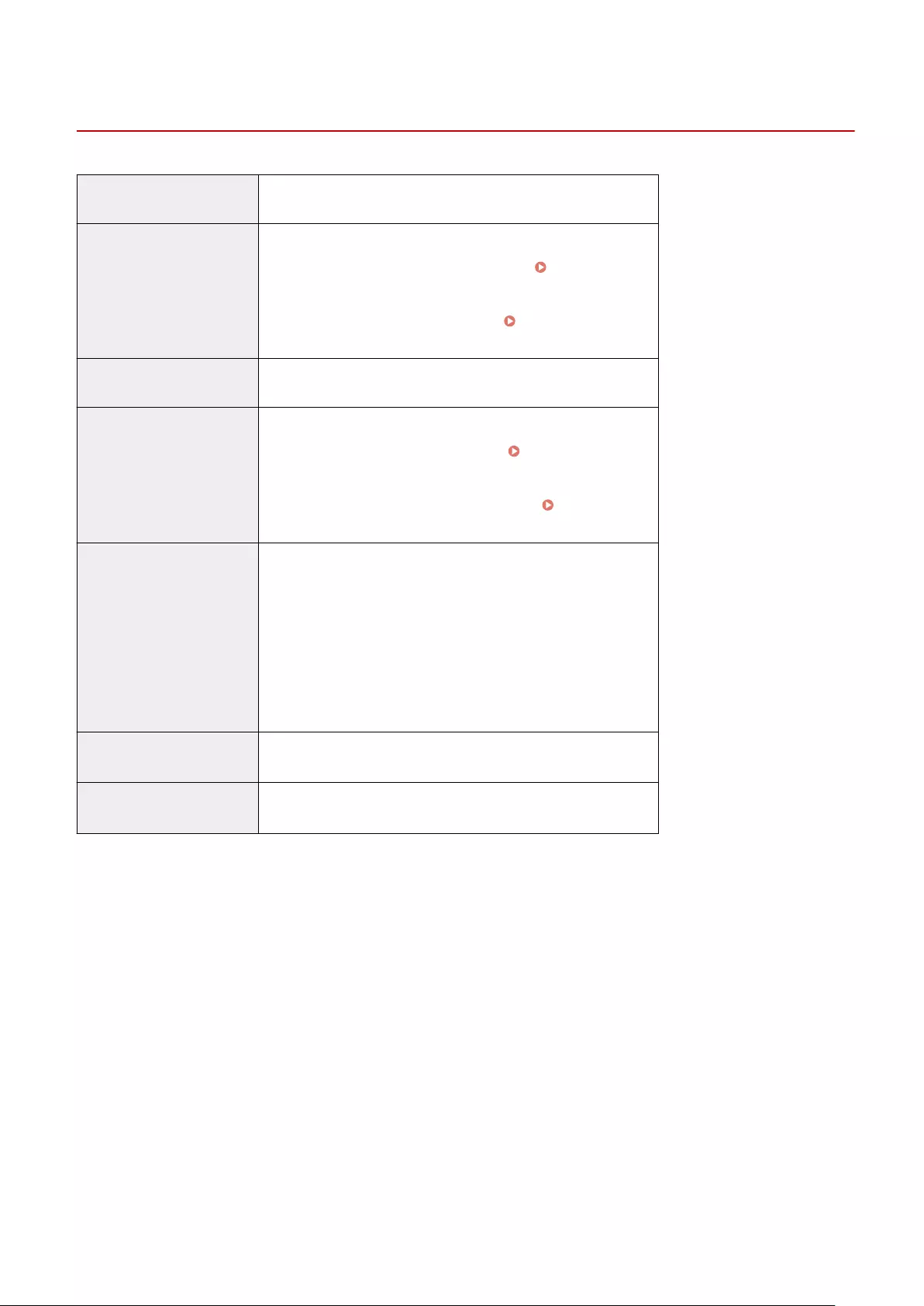
Scan Function
6FR5-0C1
Type Color Scanner
Original Scanning Size Scanning from Platen Glass
Same as "Acceptable Originals" in "Main Unit" Main Unit(P. 620)
Scanning from Feeder
Same as "Original Size/Type" in "Feeder" Feeder(P. 623)
Resolution (Max) 600 dpi x 600 dpi
Scanning Speed Scanning from Platen Glass
Same as "Scanning Speed" in "Main Unit" Main Unit(P. 620)
Scanning from Feeder
Same as "Original Scanning Speed" in "Feeder" Feeder(P. 623)
Interface USB
USB2.0 High-Speed
Wired LAN
10Base-T, 100Base-TX, 1000Base-T (IEEE 802.3 compliant)
Wireless LAN
IEEE 802.11b, IEEE 802.11g, IEEE 802.11n
Protocol Supported *FTP (TCP/IP), SMB (TCP/IP), SMTP, TCP/IP, USB
Output Format *TIFF (MMR), JPEG (Single-Page), PDF
*Some formats are not supported depending on the function.
Appendix
630
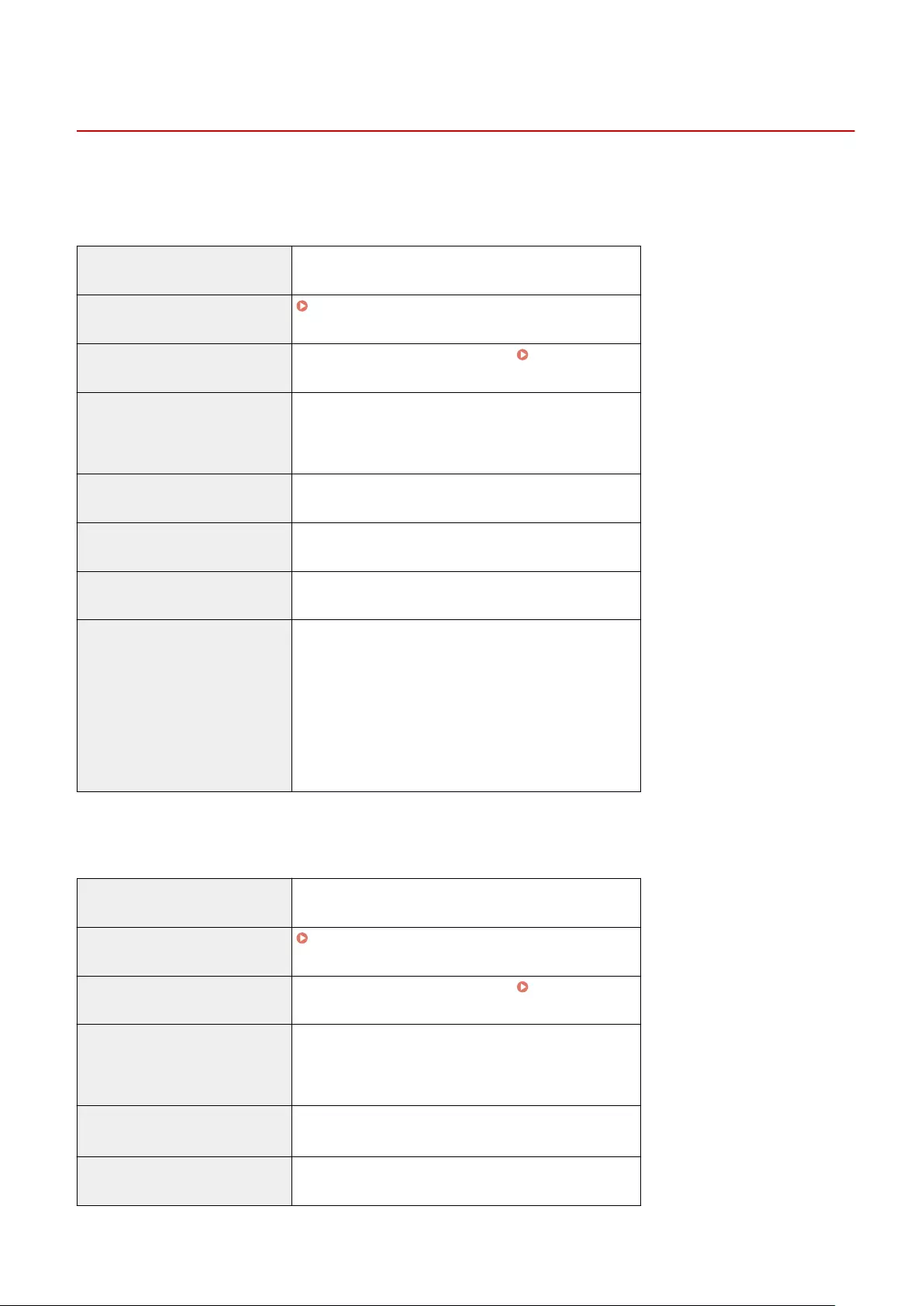
Printer Functions
6FR5-0C2
◼UFR II Printer Function
Type Internal
Print Size Available Paper(P. 624)
Print Speed Same as "Copy Speed" in "Main Unit" Main Unit(P. 620)
Resolution Data Processing
1200 dpi x 1200 dpi, 600 dpi x 600 dpi
Page Description Language (PDL) UFR II
Protocol Supported TCP/IP: LPD, Port9100, WSD
Resident Fonts None
Interface USB
USB2.0 High-Speed
Wired LAN
10Base-T, 100Base-TX, 1000Base-T (IEEE 802.3 compliant)
Wireless LAN
IEEE 802.11b, IEEE 802.11g, IEEE 802.11n
◼PS Printer Function
Type Internal
Print Size Available Paper(P. 624)
Print Speed Same as "Copy Speed" in "Main Unit" Main Unit(P. 620)
Resolution Data Processing
1200 dpi x 1200 dpi, 600 dpi x 600 dpi
Page Description Language (PDL) Adobe®PostScript®3TM
Protocol Supported TCP/IP: LPD, Port9100, WSD
Appendix
631
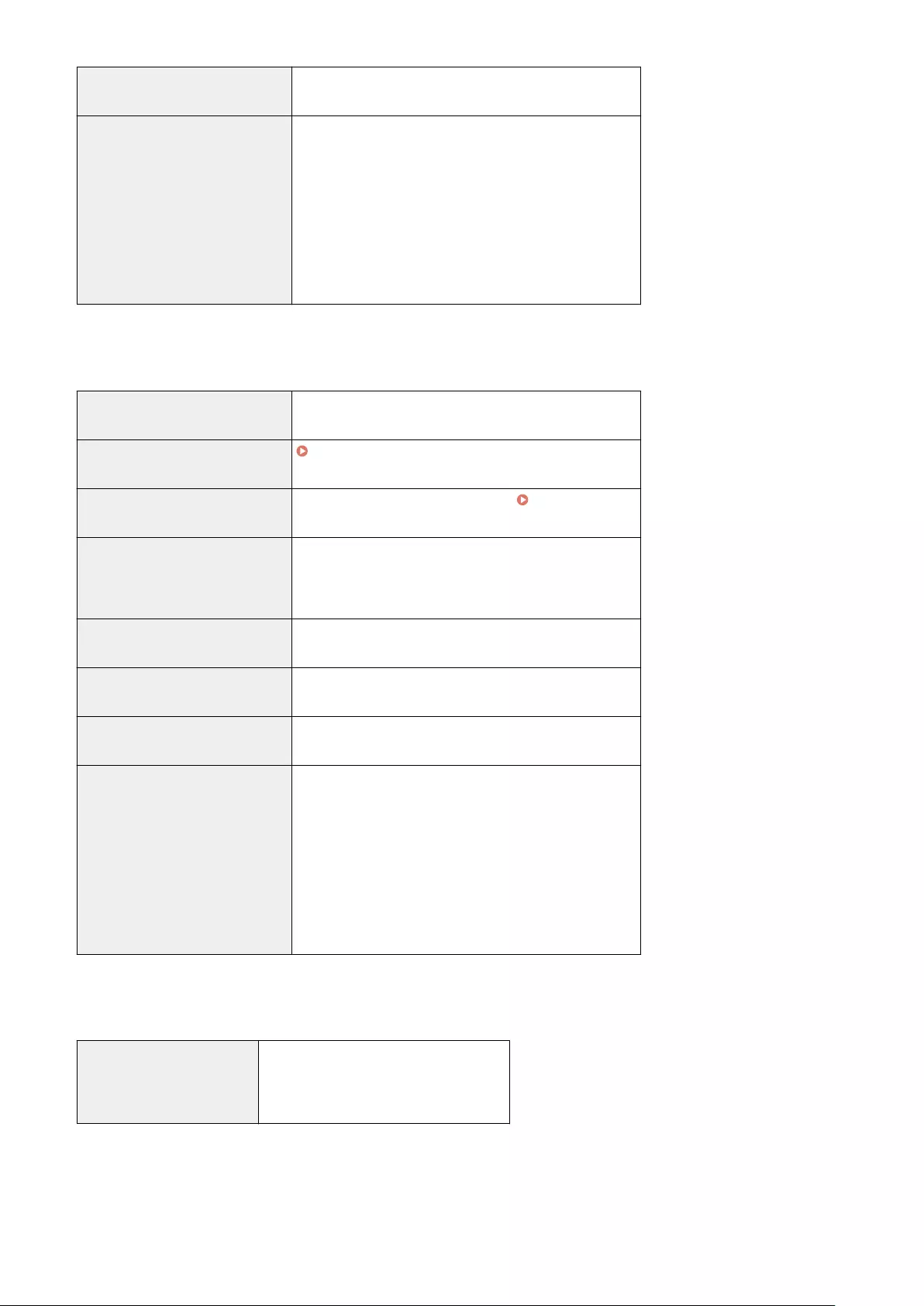
Resident Fonts 136 Roman
Interface USB
USB2.0 High-Speed
Wired LAN
10Base-T, 100Base-TX, 1000Base-T (IEEE 802.3 compliant)
Wireless LAN
IEEE 802.11b, IEEE 802.11g, IEEE 802.11n
◼PCL Printer Function
Type Internal
Print Size Available Paper(P. 624)
Print Speed Same as "Copy Speed" in "Main Unit" Main Unit(P. 620)
Resolution Data Processing
1200 dpi x 1200 dpi (only for PCL6), 600 dpi x 600 dpi
Page Description Language (PDL) PCL6, PCL5
Protocol Supported TCP/IP: LPD, Port9100, WSD
Resident Fonts 93 Roman
Interface USB
USB2.0 High-Speed
Wired LAN
10Base-T, 100Base-TX, 1000Base-T (IEEE 802.3 compliant)
Wireless LAN
IEEE 802.11b, IEEE 802.11g, IEEE 802.11n
◼Memory Media Print Function
Printable File Formats ●JPEG (DCF/Exif 2.21 or earlier/JFIF)
●TIFF (JPEG/MH/MR/MMR compression)
●PDF
Appendix
632
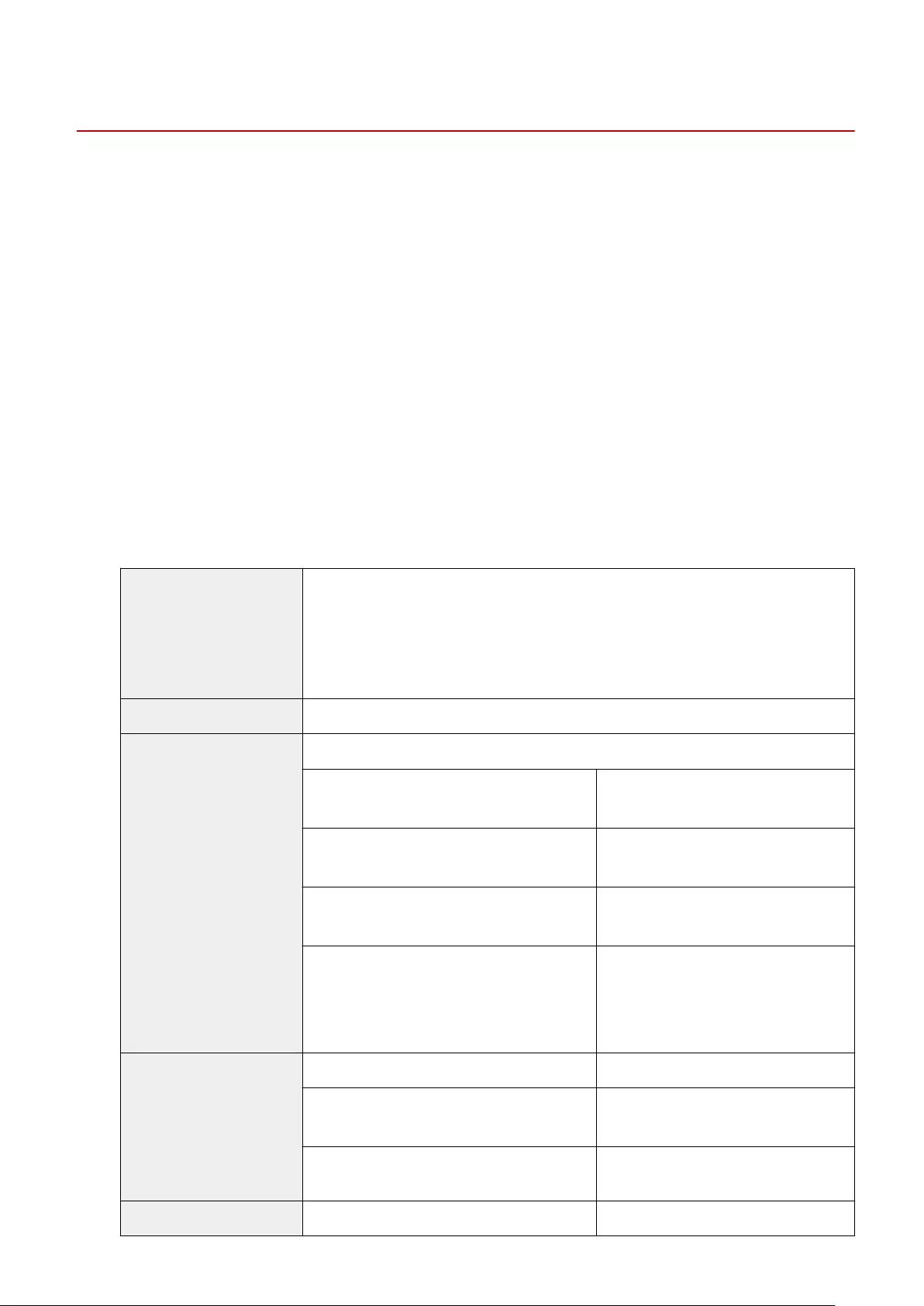
Management Functions
6FR5-0C3
◼Authentication Functions
●The machine communicates with LDAP servers using LDAPv3.
●UTF-8 is the supported character encoding used when the text data is transmitted between the machine and an
LDAP server.
◼Firewall Settings
●Up to 16 IP addresses (or ranges of IP addresses) can be specied for both IPv4 and IPv6.
●The packet lters described in this section control communications over TCP, UDP, and ICMP.
●Up to 32 MAC addresses can be specied.
◼IPSec
●IPSec that is supported by the machine conforms to RFC2401, RFC2402, RFC2406, and RFC4305.
Operating system
●Windows Vista
●Windows 7
●Windows 8
●Windows 8.1
●Windows 10
Connection mode Transport mode
Key exchange protocol
IKEv1 (main mode)
Authentication method
●Pre-shared key
●Digital signature
Hash algorithm (and key length)
●HMAC-SHA1-96
●HMAC-SHA2 (256 bits or 384 bits)
Encryption algorithm (and key length)
●3DES-CBC
●AES-CBC (128 bits, 192 bits, or 256 bits)
Key exchange algorithm/group (and key length)
Die-Hellman (DH)
●Group 1 (768 bits)
●Group 2 (1024 bits)
●Group 14 (2048 bits)
ESP
Hash algorithm HMAC-SHA1-96
Encryption algorithm (and key length)
●3DES-CBC
●AES-CBC (128 bits, 192 bits, or 256 bits)
Hash algorithm/encryption algorithm (and key
length) AES-GCM (128 bits, 192 bits, or 256 bits)
AH Hash algorithm HMAC-SHA1-96
Appendix
633
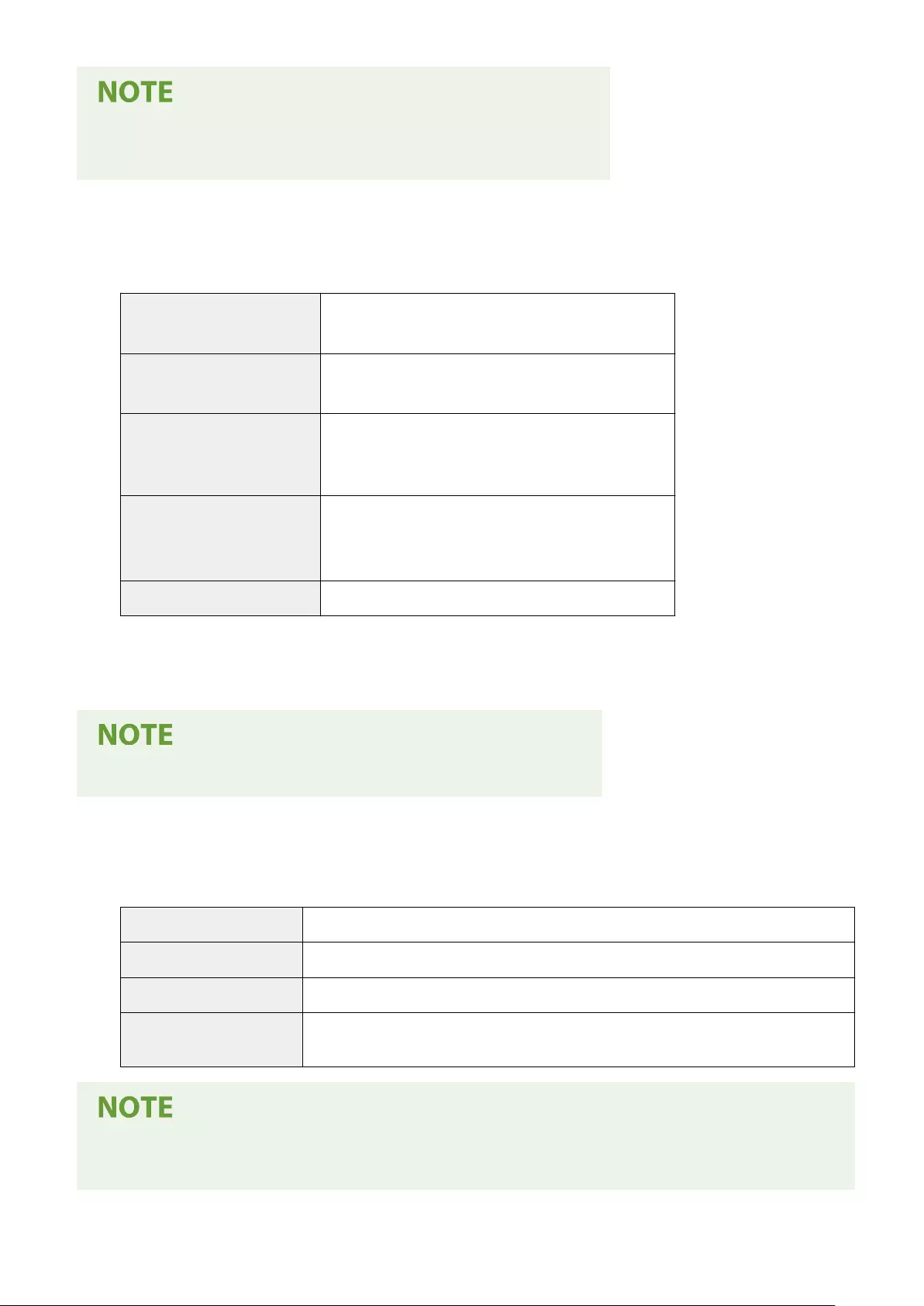
●IPSec supports communication to a unicast address (or a single device).
●The machine cannot use both IPSec and DHCPv6 at the same time.
◼Registration of Keys and Certicates
●If you install a key or CA certicate from a computer, make sure that they meet the following requirements:
Format ●Key: PKCS#12*1
●CA certicate: X.509 DER/PEM
File extension
●Key: ".p12" or ".pfx"
●CA certicate: ".cer" or ".pem"
Public key algorithm
(and key length)
●RSA (512 bits, 1024 bits, 2048 bits, 4096 bits)
●DSA (1024 bits, 2048 bits, 3072 bits)
●ECDSA (P256, P384, P521)
Certicate signature algorithm
●RSA: SHA-1, SHA-256, SHA-384*2, SHA-512*2, MD2, MD5
●DSA: SHA-1
●ECDSA: SHA-1, SHA-256, SHA-384, SHA-512
Certicate thumbprint algorithm SHA1
*1Requirements for the certicate contained in a key are pursuant to CA certicates.
*2RSA-SHA-384 and RSA-SHA-512 are available only when the RSA key length is 1024 bits or more.
●The machine does not support use of a certicate revocation list (CRL).
◼Denition of "Weak Encryption"
When <Prohibit Use of Weak Encrypt.> is set to <On>, the use of the following algorithms is prohibited.
Hash MD4, MD5, SHA-1
HMAC HMAC-MD5
Common key cryptosystem RC2, RC4, DES
Public key cryptosystem RSA encryption (512 bits/1024 bits), RSA signature (512 bits/1024 bits), DSA (512 bits/1024
bits), DH (512 bits/1024 bits)
●Even when <Prohibit Weak Encryp. Key/Cert.> is set to <On>, the hash algorithm SHA-1, which is used for
signing a root certicate, can be used.
Appendix
634

System Environment
6FR5-0C4
System Environment for WSD Scan ●Windows 8.1
●Windows 10
System Requirements for the Remote
UI *1
Windows
●Windows 7 / 8.1 / 10: Internet Explorer 11 and later
●Windows 10: Microsoft Edge
Mac OS
●Mac OS X 10.5 and later: Safari 5.0.6 and later
Android
●Chrome
●UC Browser
iOS
●Safari
●UC Browser
E-mail/I-Fax Forwarding Server
Software
●Microsoft Exchange Server 2007 SP3
●Microsoft Exchange Server 2010
●Microsoft Exchange Server 2013
●Microsoft Exchange Server 2016
●Lotus DomiNo R7.0
●Sendmail 8.14.4
E-mail/I-Fax Receiving Server Software ●Microsoft Exchange Server 2007 SP3
●Microsoft Exchange Server 2010
●Microsoft Exchange Server 2013
●Microsoft Exchange Server 2016
●Lotus DomiNo R7.0
●Qpopper 4.0.19
File Servers Available as Destinations
for File Transmission
SMB
●Windows Vista SP2 / 7 / 8 / 8.1 / 10
●Windows Server 2003 R2 SP2 / Server 2008 / Server 2008 R2 SP1 / Server 2012 /
Server 2012 R2 / Server 2016
●Red Hat Linux 9
●Mac OS X 10.9 / 10.10 / 10.11 / 10.12 / 10.13 / 10.14
FTP
●Windows Vista SP2 / 7 / Server 2008 SP2 / Server 2008 R2 SP1: Internet Information
Services 7.5
●Windows 8 / 10 / Server 2012: Internet Information Services 8.0
●Windows 8.1 / Server 2012 R2: Internet Information Services 8.5
●Windows 10 / Server 2016: Internet Information Services 10.0
●Mac OS X 10.9 / 10.10 / 10.11 / 10.12 / 10.13 / 10.14
●Solaris 10
●Red Hat Linux 9
Appendix
635

Types of LDAP servers ●Windows Server 2003 R2 SP2 with Active Directory
●Windows Server 2008 SP2 with Active Directory
●Windows Server 2012 with Active Directory
●Windows Server 2012 R2 with Active Directory
●Windows Server 2016 with Active Directory
●Lotus Notes DomiNo R7 and later
●eDirectory V8.8 SP7 and later
●Lotus DomiNo R8.5 and later
System Requirements for the Send
Function Setting Tool
●Windows 7 / 8.1 / 10: Internet Explorer 11 and later
●Windows 10: Microsoft Edge
System Requirements for the User's
Guide
Windows
●Internet Explorer 9 and later
●Microsoft Edge
●Firefox
●Firefox ESR
●Chrome*2
macOS
●Safari
●Firefox
●Chrome*2
Linux
●Firefox
iOS
●Safari*2
Android
●Chrome*2
*1Before changing the settings of the machine, set your Web browser to enable all cookies and use JavaScript.
*2Only when browsing the manual on the Internet.
Appendix
636
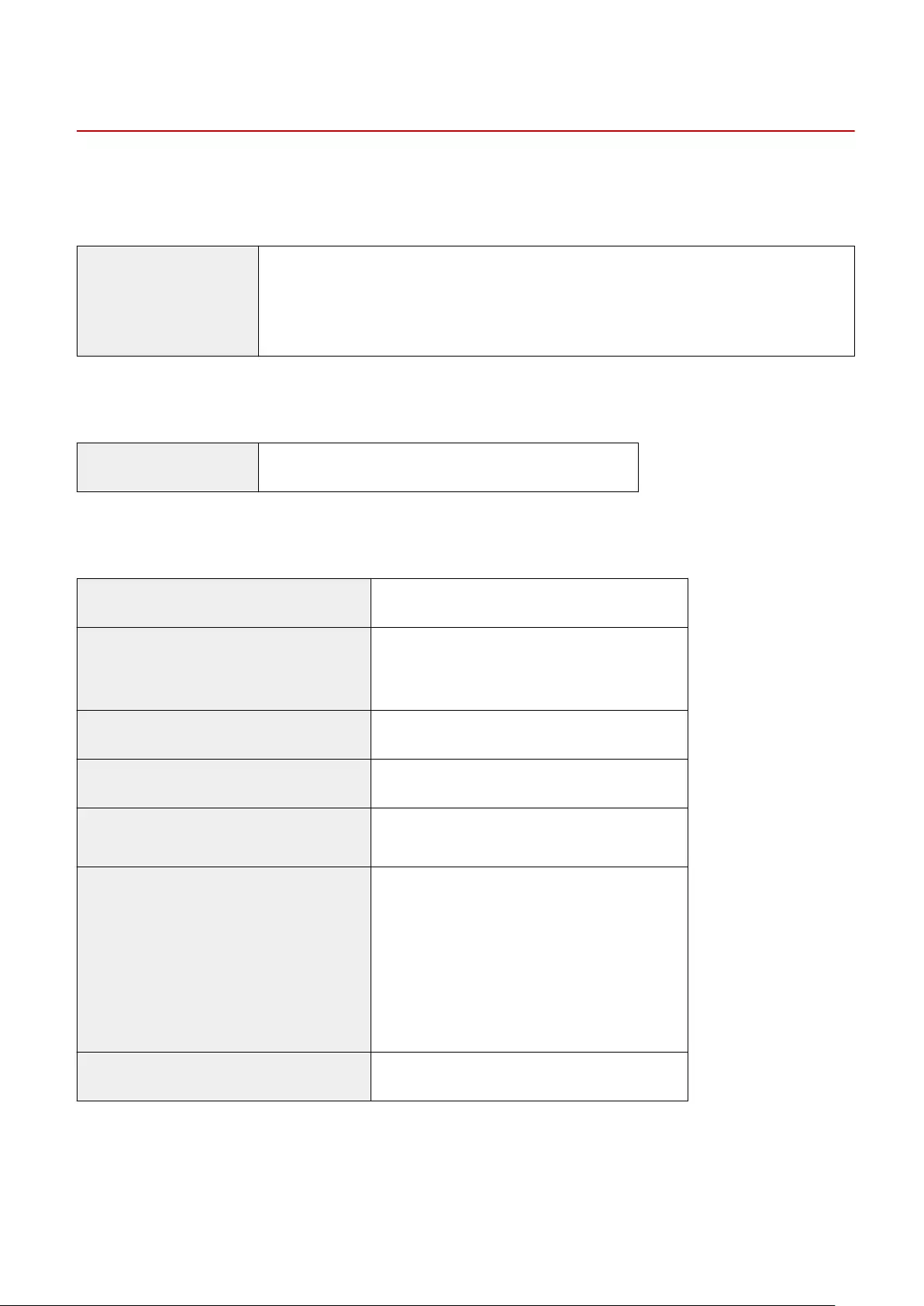
Network Environment
6FR5-0C5
◼Common Specications
Protocol Supported TCP/IP
●Frame type: Ethernet II
●Print applications: LPD, Raw, IPP, IPPS, WSD, Mopria, Google Cloud Print, AirPrint, Windows10
Mobile Print
◼Wired LAN Specications
Interface Interface supporting 10BASE-T, 100BASE-TX, 1000BASE-T (RJ-45)
◼Wireless LAN Specications
Standard IEEE 802.11b, IEEE 802.11g, IEEE 802.11n
Transmission Scheme ●IEEE 802.11b (Modulation system: DS-SS)
●IEEE 802.11g (Modulation system: OFDM method)
●IEEE 802.11n (Modulation system: OFDM method)
Frequency Range 2.412 GHz to 2.472 GHz
Maximum Radio-Frequency Power Transmitte 16.5 dBm
Communication Mode ●Infrastructure Mode
●Access Point Mode
Security (encryption method) Infrastructure Mode
●128 (104)/64 (40) bit WEP
●WPA-PSK (TKIP/AES-CCMP)
●WPA2-PSK (TKIP/AES-CCMP)
Access Point Mode
WPA2-PSK (AES-CCMP)
Connection Method WPS (Wi-Fi Protected Setup), Manual setup
Appendix
637

Options
6FR5-0C6
Installing options on the machine enables you to use more features.
◼Knowing What Types of Options are Available
Optional Equipment(P. 639)
System Options(P. 641)
◼Looking for Optional Equipment by Purpose
Adding a Paper Drawer
Cassette Feeding Module-AH(P. 639)
Sending Faxes Manually, Making or Receiving Phone Calls
TELEPHONE 6 KIT(P. 639)
Using the Authentication Function to Manage Users by Department
Copy Card Reader-F(P. 639)
Appendix
638
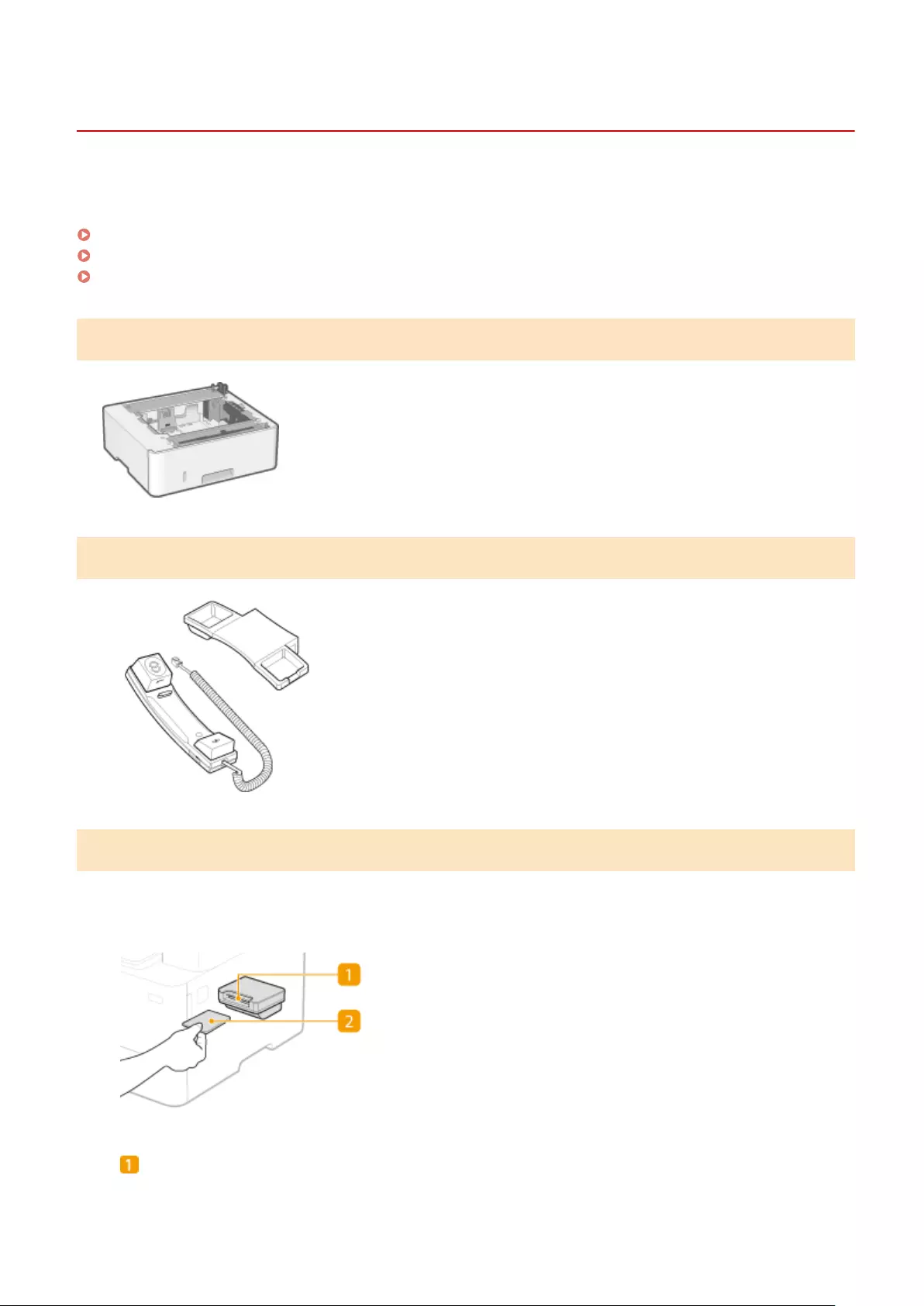
Optional Equipment
6FR5-0C7
The functionality of the machine can be fully utilized by using the optional equipment described below. Optional
equipment can be purchased from the retail outlet where you purchased the machine or from your local Canon dealer.
Cassette Feeding Module-AH(P. 639)
TELEPHONE 6 KIT(P. 639)
Copy Card Reader-F(P. 639)
Cassette Feeding Module-AH
Installing this cassette feeding module enables you to load paper of a different size
than that of paper loaded in the standard paper drawer. This surely reduces the time
and labor for paper replacement.
TELEPHONE 6 KIT
This is a handset that can be connected to the machine. Use the handset when
you use the machine as a telephone. Also, use the handset when you send or
receive faxes manually.
Copy Card Reader-F
This is a card authentication system that enables you to perform the login process of Department ID Management by
using a control card instead of entering a department ID. You can log in to the machine by inserting a control card and
log off by removing it.
Card slot
Insert the control card into the card slot when the login screen is displayed. Remove the control card from
the card slot after using the machine.
Appendix
639
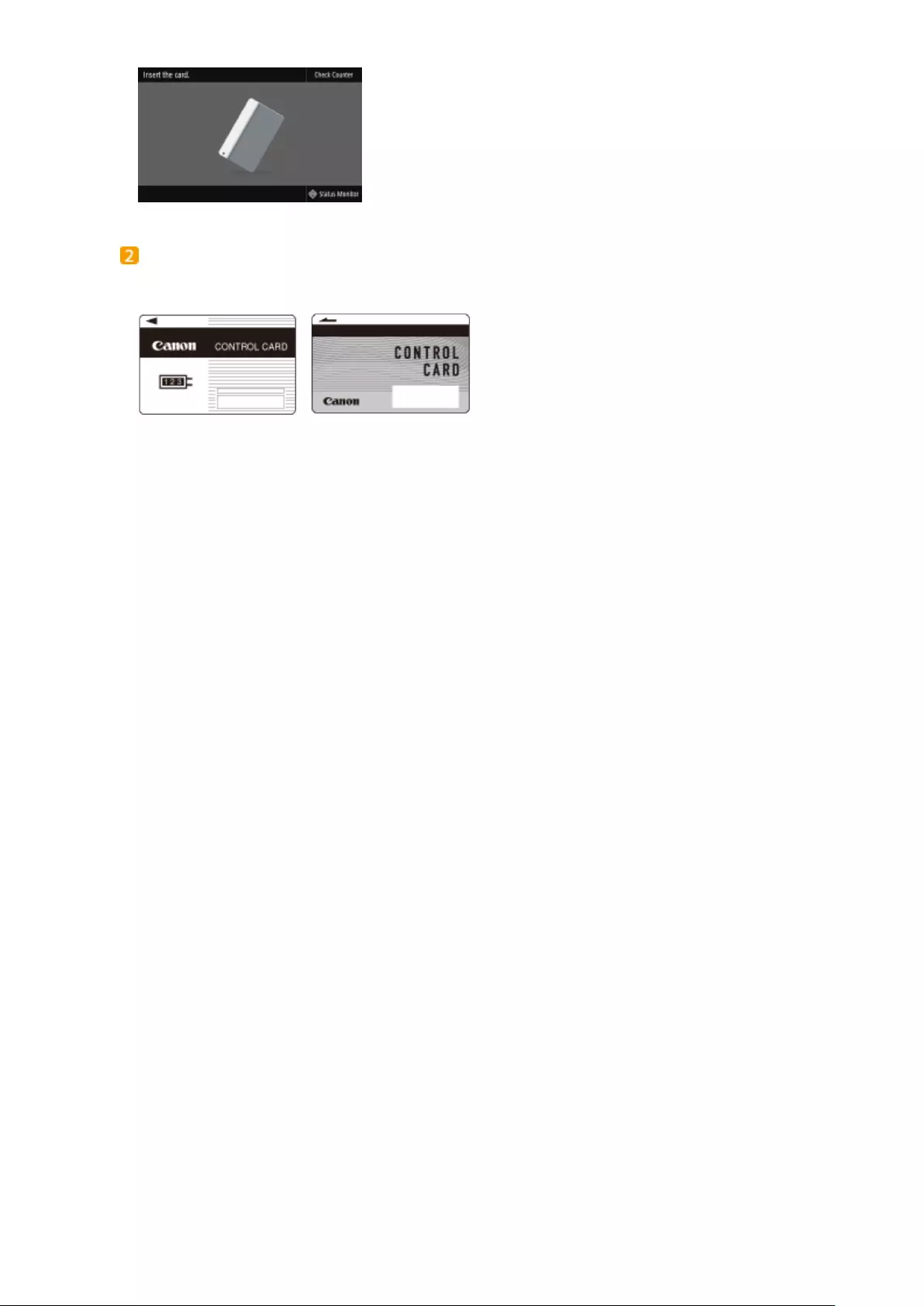
Control card
You can use the control card shown below. Hold the card the front side up and insert in the direction
indicated on the card.
Appendix
640

System Options
6FR5-0C8
The machine performance can be enhanced even more by installing system options.
Barcode Printing Kit(P. 641)
Send PDF Security Feature Set(P. 641)
License Registration(P. 641)
Barcode Printing Kit
This option enables you to generate barcodes in various formats. Note that if you want to print barcodes, PCL must be
enabled. For information on using the Barcode Printing Kit, see the Barcode Printing Guide (PDF manual).
Send PDF Security Feature Set
You can enhance the security of PDF les with the Send PDF Security Feature Set. This option enables you to add a
digital signature to PDF les or to create encrypted PDF les when scanning originals.
License Registration
To activate certain system options, you need to obtain a license key and register the key to the machine.
◼Obtaining a License Key
You can obtain a license key by using a web browser. Access the License Management System (http://
www.canon.com/lms/license) and follow the procedure. As a part of the procedure, you are required to enter the
following numbers.
License Access Number
Check the license access number provided on the License Access Number Certicate that is included in the
package of the option.
Serial Number of the Machine
Check the serial number of the machine from the operation panel.
<Status Monitor> <Device Information> <Serial Number>
◼Registering a License Key
1Select <Menu> in the Home screen. Home Screen(P. 124)
2Select <Management Settings>.
●If the login screen appears, enter the correct ID and PIN. Logging in to the Machine(P. 135)
Appendix
641
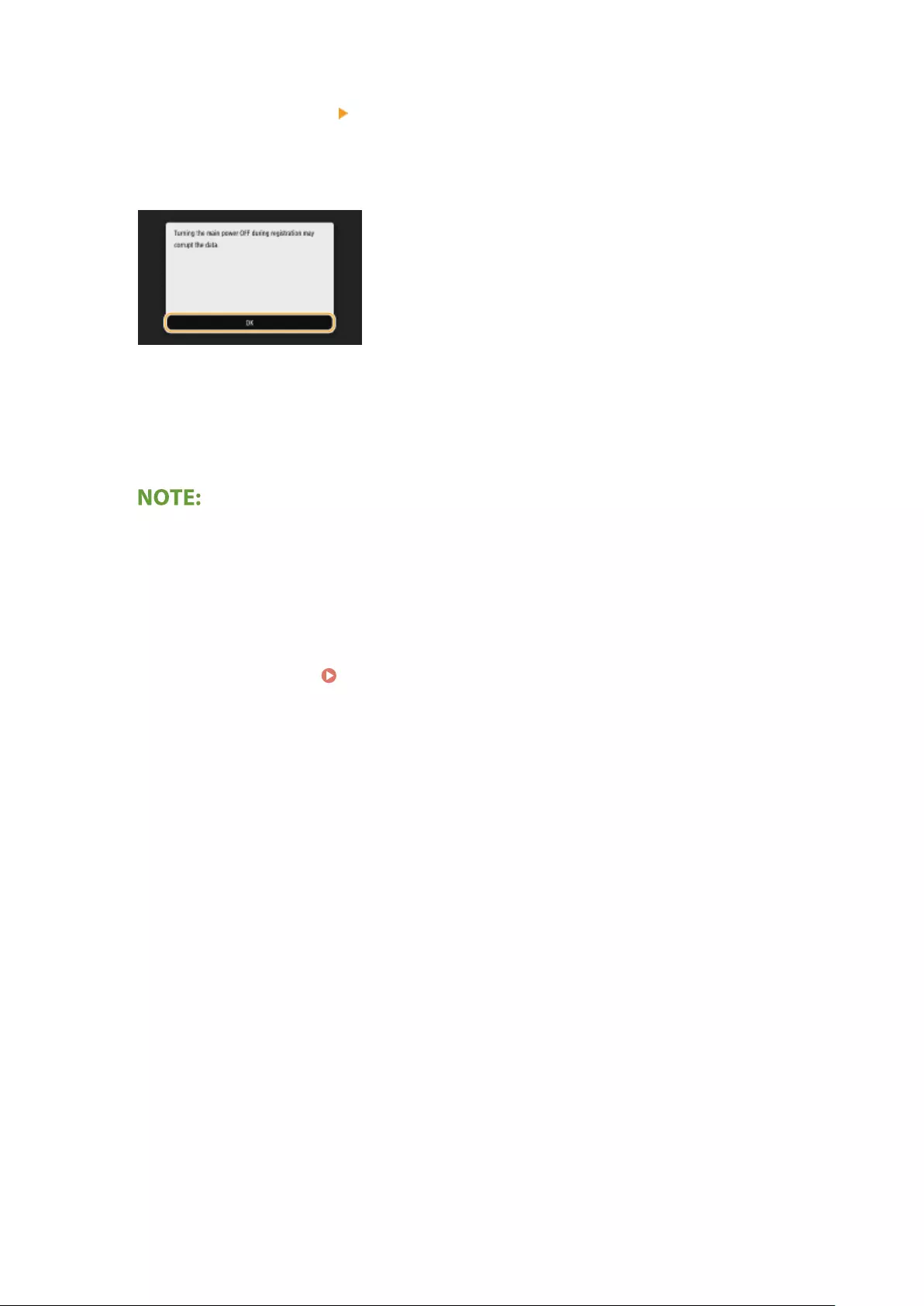
3Select <License/Other> <Register License>.
4Conrm the message on the screen, and select <OK>.
5Enter the license key using the numeric keys, and select <Apply>.
➠Registration starts. Wait until the <Installation is complete. Changes will be effective after the main power
is turned OFF and ON.> message is displayed.
●If the <The feature required for installation is not present.> message is displayed, enable the functions
that are required to activate the option and register the license key again.
6Select <Close>.
7Restart the machine. Restarting the Machine(P. 120)
Appendix
642
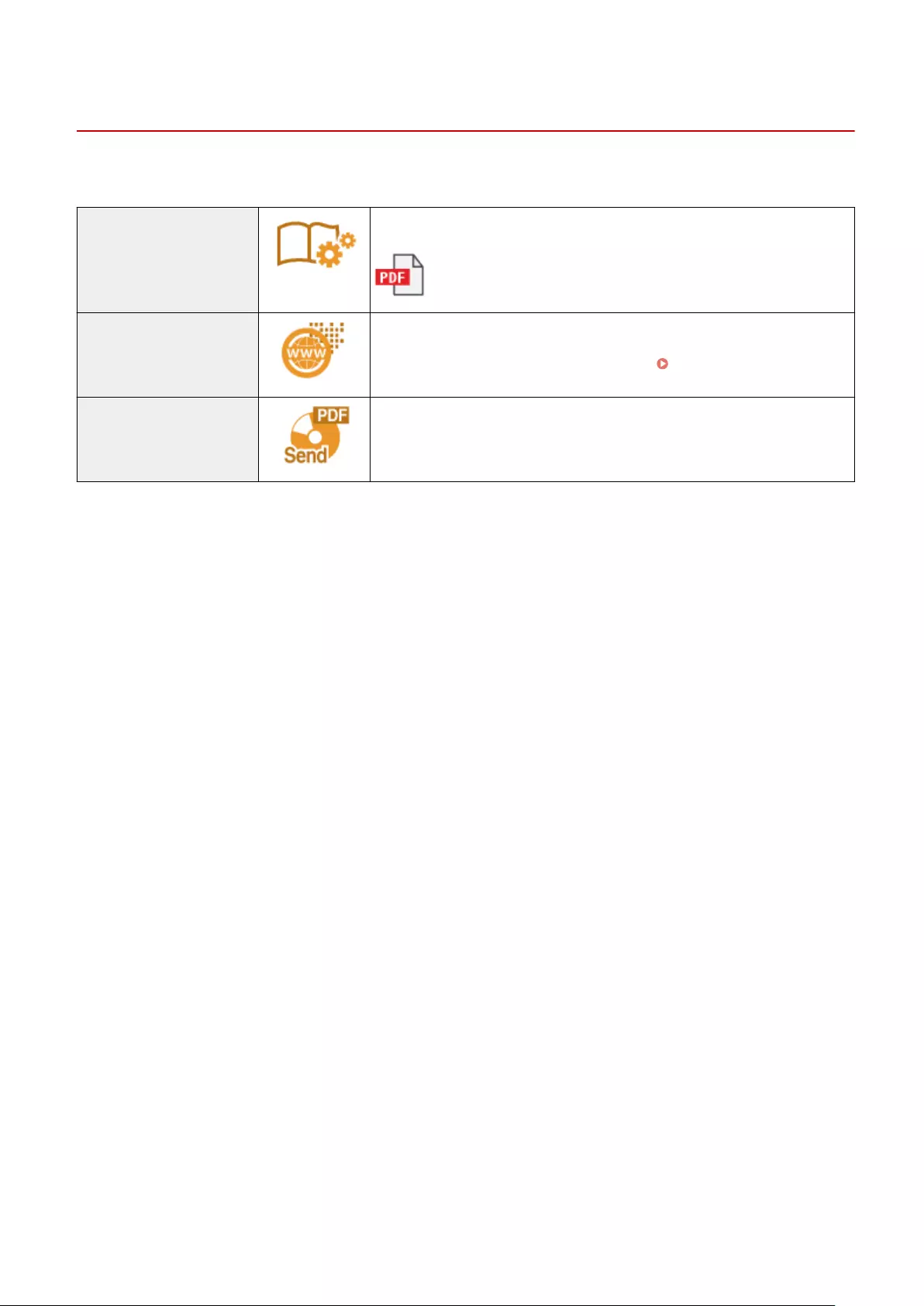
Manuals and Their Contents
6FR5-0C9
The manuals listed below are included with the machine. Refer to them as necessary.
Getting Started Read this manual rst. This manual describes basic operations in an easy-to-
understand manner.
User's Guide (This Manual) This manual describes all the functions of the machine in a manual that is viewed
using a Web browser. You can browse information by category or enter a
keyword to search for pages on a specic topic. Using User's Guide(P. 644)
Send Setting Guide This manual describes how to congure settings and prepare for sending
scanned images by e-mail and saving scanned images to shared folders.
Appendix
643

Using User's Guide
6FR5-0CA
The User's Guide is a manual that can be viewed on your computer or mobile device and it describes all of the
functions of the machine. You can search from your intended use or enter a keyword to quickly nd the page you are
looking for. The section describes the screen layout of the User's Guide and how to read the Guide. You can specify
how the appearance of the User's Guide looks.
◼Screen Layout of User's Guide
This section describes the screens conguring the User's Guide and how to use the on-screen buttons. Screen
Layout of User's Guide(P. 645)
◼Viewing User's Guide
This section describes the meaning of the marks used in the User's Guide, how the keys on the operation panel and
the buttons on the computer display are represented, and other matters that help you understand the information
contained in the User's Guide. Viewing User's Guide(P. 648)
◼Specifying How the Appearance of the User's Guide Looks
You can change the character size used in the User's Guide, and switch the screen layout to t to the device you use to
view the User's Guide.
How to Find the Topic You Are Looking for
Search the contents
●You can nd the page you are looking for by selecting the topic from the "Contents" on the left side of the
screen.
Search by keyword
●Perform a search by entering a keyword, such as "envelope" or "toner cartridge," and the pages containing
the keyword are displayed. You can nd the page you are looking for from those results. You can also enter
phrases such as "connecting to a network." The keyword search also supports the AND Boolean to search for
multiple keywords. For the organization of the search screen and how to operate the search screen, see
Search(P. 647) .
Appendix
644
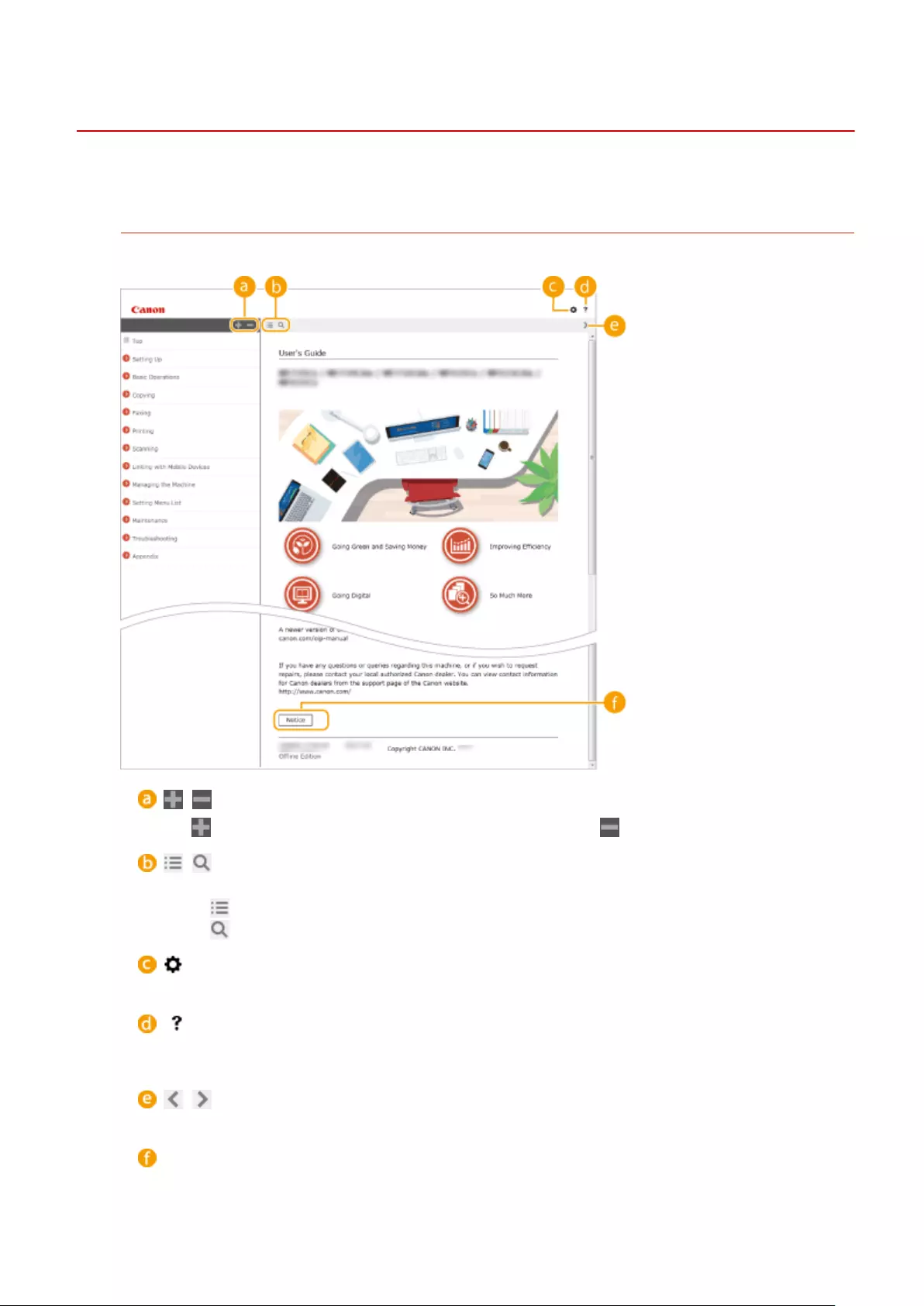
Screen Layout of User's Guide
6FR5-0CC
The User's Guide is divided into different screens, and the content of each screen varies.
Top Page
Appears when User's Guide is started.
/
Click to also display all of the sections under the chapters. Click to return to the previous display.
/
Click to toggle the display between the contents and search. When the table of contents is displayed, each
click on switches between hiding and showing the display. When the search display is shown, each
click on switches between hiding and showing the display.
Click to set parameters to determine how the User's Guide is displayed, such as character size or layout.
Click to display information on how to view the User's Guide, how to perform a search, and other
information.
/
Click to display the previous or following topic.
[Notice]
Click to view important information you should know when using the machine.
Appendix
645
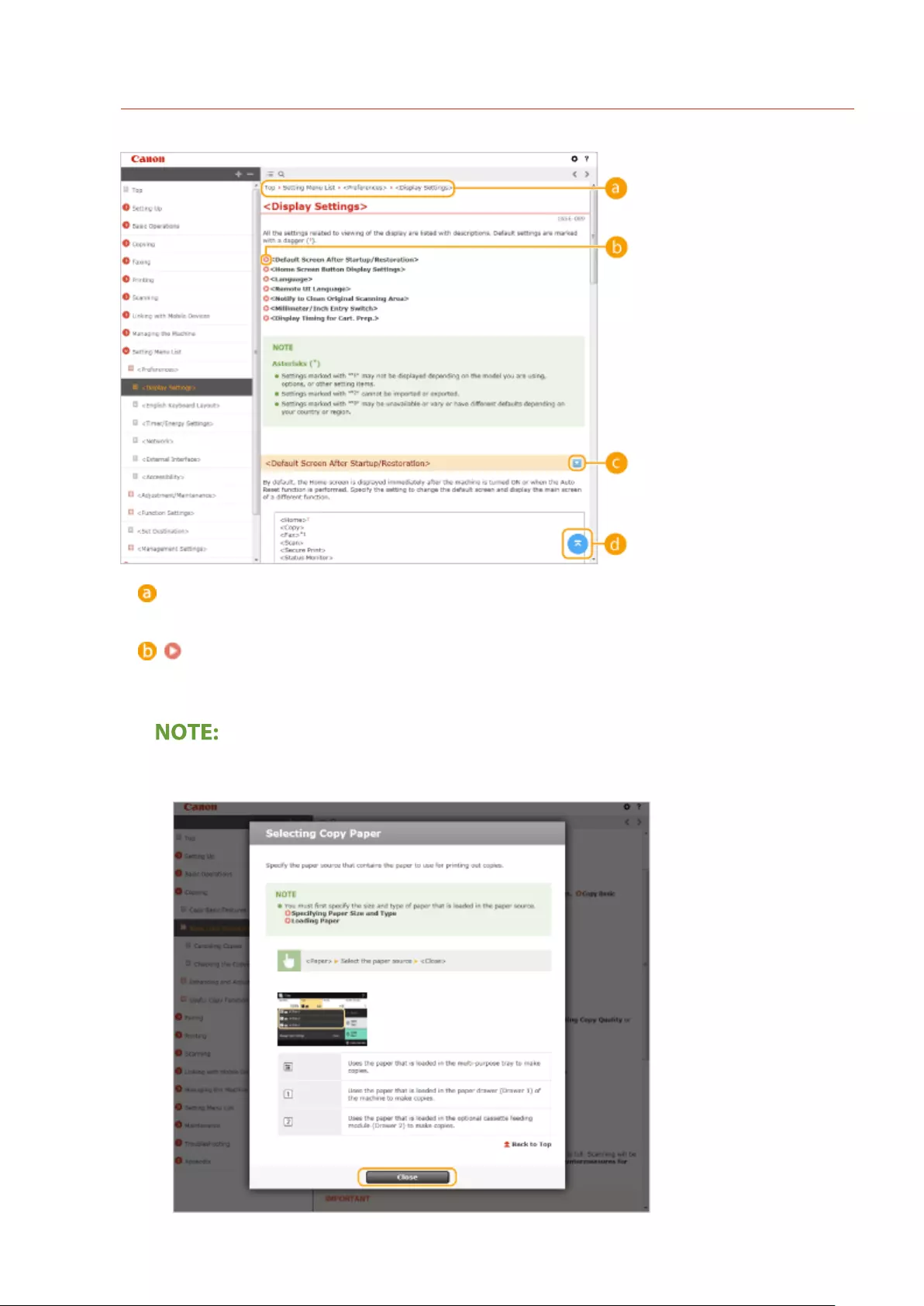
Topic Page
Contains information about how to congure and use the machine.
Navigation
See what chapter topic you are currently viewing.
Click to jump to the corresponding page. To return to the previous page, click "Back" on your Web
browser.
●When you click the icon, the current page may go dark and a pop-up window may appear. To return to
the page, click [Close] in the pop-up window.
Appendix
646
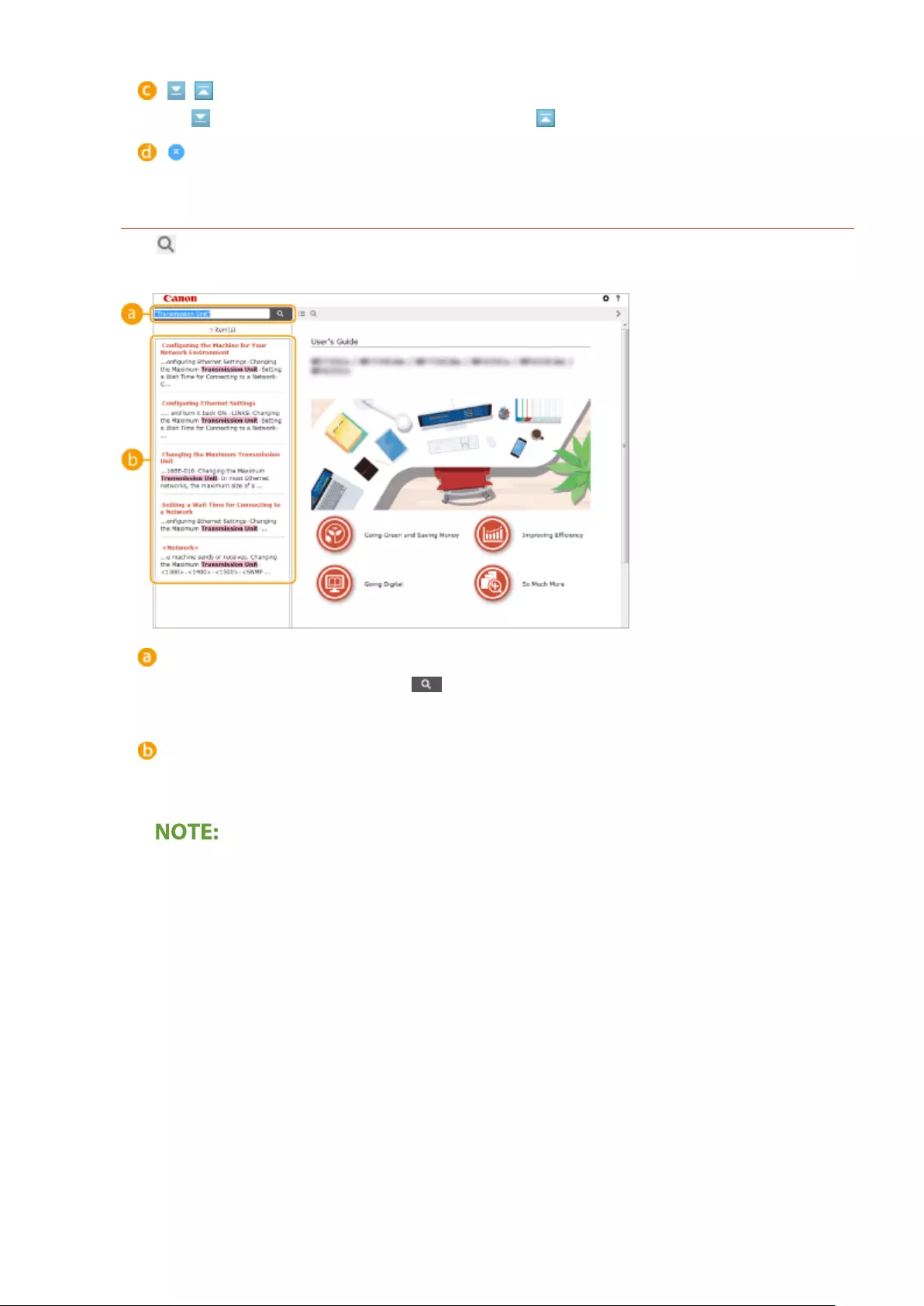
/
Click to display the hidden detailed descriptions. Click to close the detailed descriptions.
Click to return to the page top.
Search
Click to display the search window. Contains a text box to perform a search by keyword and nd the page
you are looking for.
[Enter keyword(s) here]
Enter a keyword or keywords and click to display the search results. You can search for pages
containing all the keywords by separating the keywords by a space (blank). Also you can only search for
pages containing an exact phrase by enclosing the keywords in double quotation marks.
Search result
Displays the search results of the pages that contain the specied keywords. From the results, locate the
page you are looking for and click the topic title of the page.
●The specied keyword(s) are shown in bold in the search results.
Appendix
647
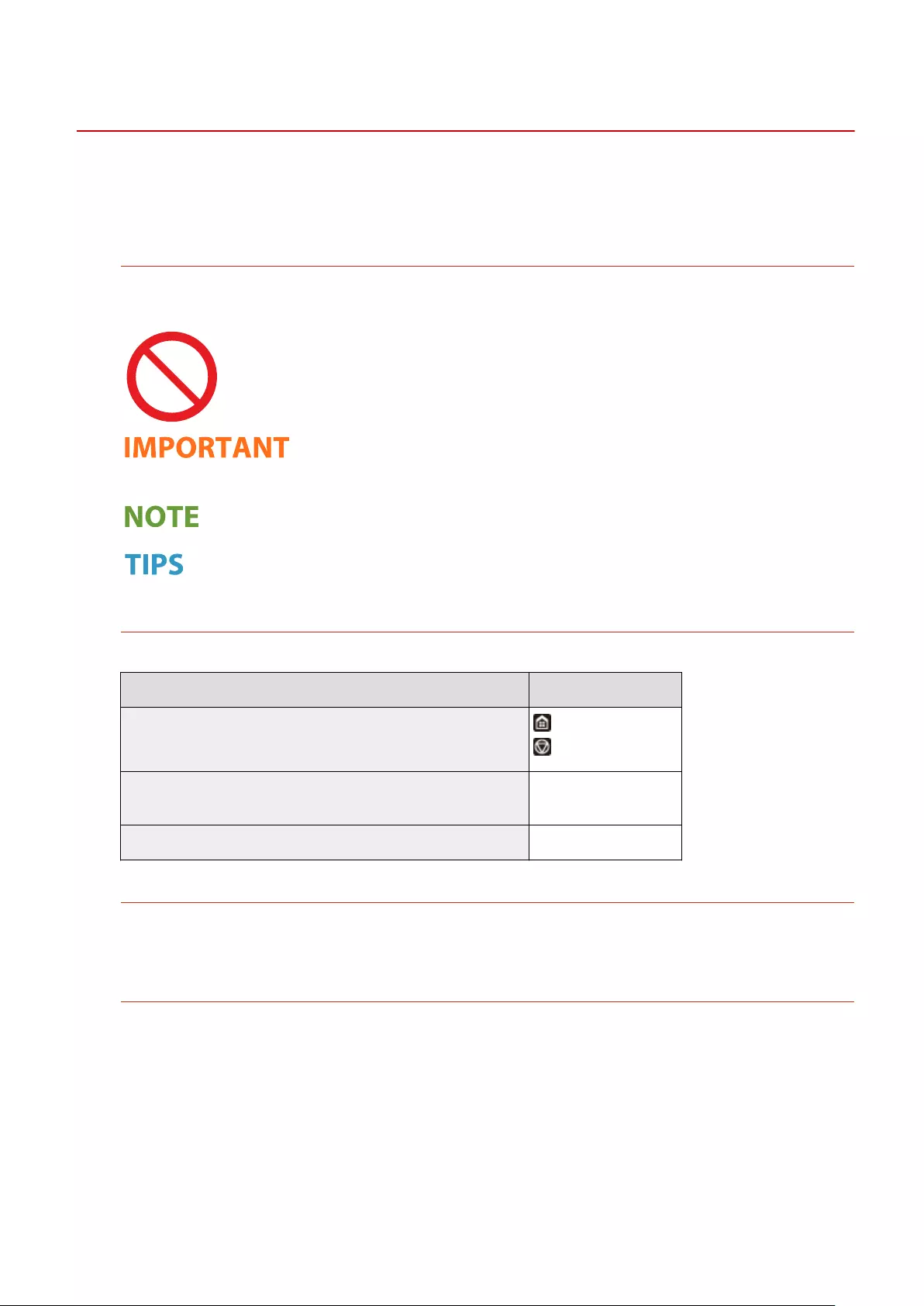
Viewing User's Guide
6FR5-0CE
This section describes the marks, buttons, screens, and other items used in the User's Guide. The warnings and
cautions are also given in the "Important Safety Instructions" in the "Getting Started" included with the machine. See
also these instructions.
Marks
Cautions regarding safety, restrictions and cautions regarding the handling of the machine, useful tips, and
other information are indicated using the marks below.
Indicates an operation that must not be performed. Read these items carefully,
and make sure not to perform the described operations.
Indicates operational requirements and restrictions. Be sure to read these items
carefully to operate the machine correctly, and avoid damage to the machine or
property.
Indicates a clarication of an operation, or contains additional explanations for a
procedure.
Indicates useful functions or tips for using the machine.
Keys and Buttons Used in this Manual
Keys on the operation panel and buttons on the computer display appear in the following notation:
Type Example
Keys on the operation panel
Settings displayed on the operation panel <Timer/Energy Settings>
<Paper jammed.>
Buttons and other text interfaces displayed on the computer display [Preferences]
Computer Screens Used in This Manual
Unless otherwise noted, displays used in the User's Guide are those for the 1238iF. Depending on the model or
operating system you are using, the appearance of the displays used in this manual may slightly differ from the
actual displays. Also, the appearance of drivers and software may differ depending on their version.
Illustrations Used in This Manual
Unless otherwise noted, illustrations used in the User's Guide are those for the 1238iF. The illustrations of the
toner cartridge are those for the Canon Toner T08 Black.
Appendix
648
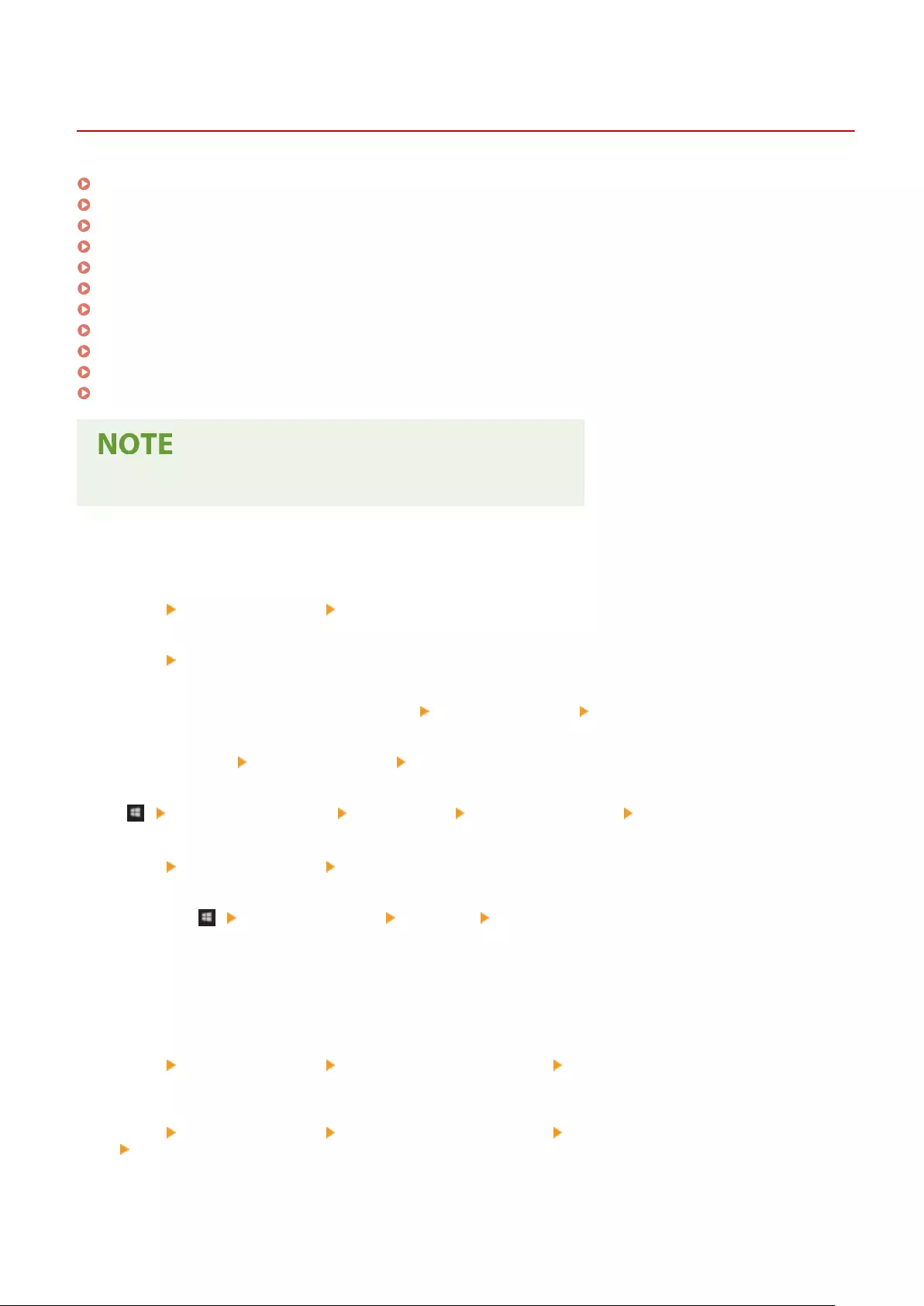
Basic Windows Operations
6FR5-0CH
Displaying the Printer Folder(P. 649)
Enabling [Network discovery](P. 649)
Displaying Shared Printers in the Print Server(P. 650)
Displaying the [Software Programs/Manuals Setup] Screen(P. 651)
Printing a Test Page in Windows(P. 651)
Checking the Bit Architecture(P. 652)
Checking the Computer Name(P. 653)
Checking the Printer Port(P. 654)
Checking Bidirectional Communication(P. 655)
Checking the SSID to Which Your Computer is Connected(P. 656)
When Printing or Sending from the Windows Store App(P. 656)
●Depending on the computer that you use, the operation may differ.
◼Displaying the Printer Folder
Windows Vista
[Start] select [Control Panel] [Printer].
Windows 7/Server 2008 R2
[Start] select [Devices and Printers].
Windows 8/Server 2012
Right-click the lower-left corner of the screen select [Control Panel] [View devices and printers].
Windows 8.1/Server 2012 R2
Right-click [Start] select [Control Panel] [View devices and printers].
Windows 10
[] select [Windows System] [Control Panel] [Hardware and Sound] [Devices and Printers].
Windows Server 2008
[Start] select [Control Panel] double-click [Printers].
Windows Server 2016
Right-click [ ] select [Control Panel] [Hardware] [Devices and Printers].
◼Enabling [Network discovery]
Enable [Network discovery] to view the computers on your network.
Windows Vista
[Start] select [Control Panel] [View network status and tasks] select [Turn on network discovery] under
[Network discovery].
Windows 7/Server 2008 R2
[Start] select [Control Panel] [View network status and tasks] [Change advanced sharing settings]
select [Turn on network discovery] under [Network discovery].
Windows 8/Server 2012
Appendix
649
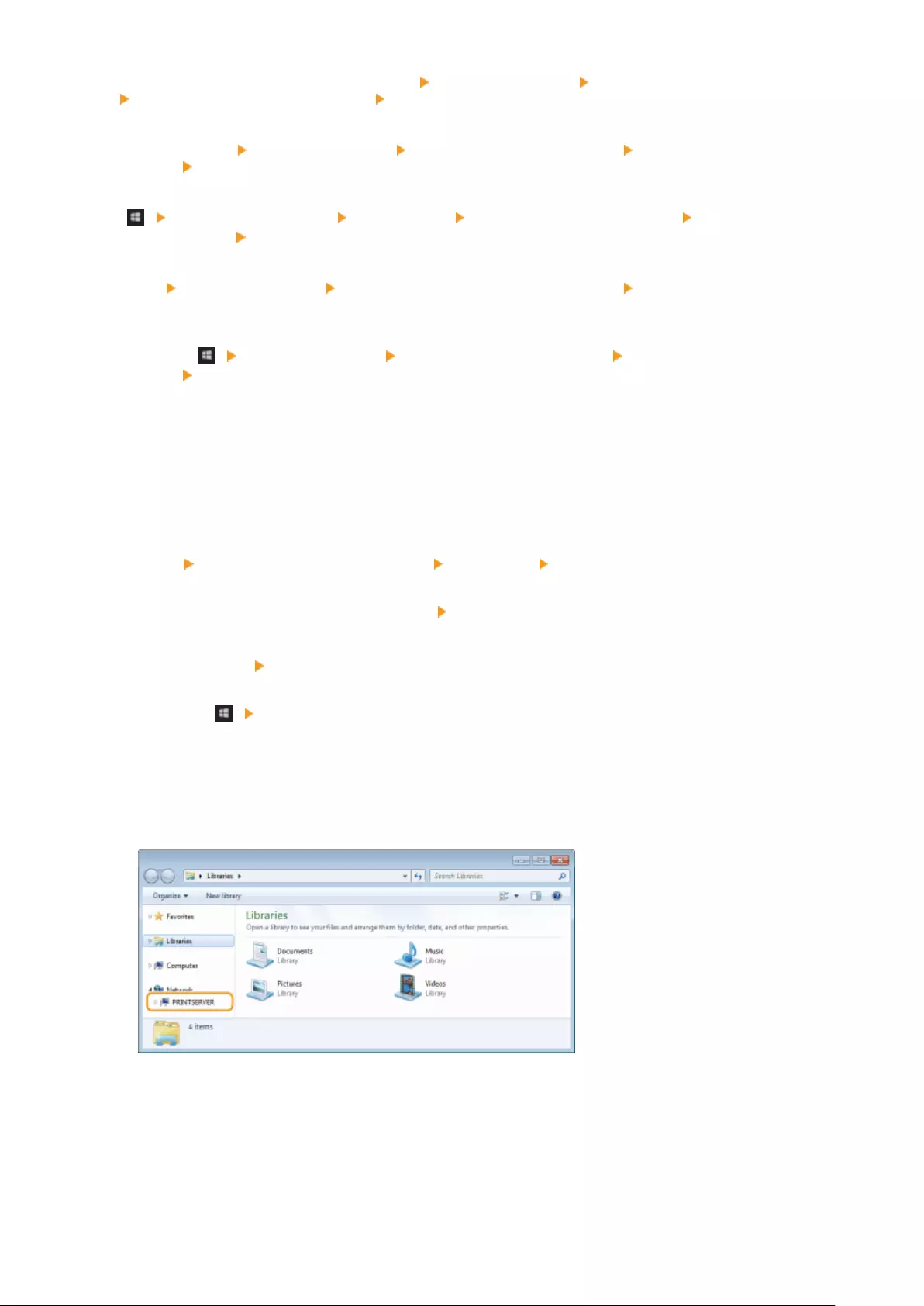
Right-click the lower-left corner of the screen select [Control Panel] [View network status and tasks]
[Change advanced sharing settings] select [Turn on network discovery] under [Network discovery].
Windows 8.1/Server 2012 R2
Right-click [Start] select [Control Panel] [View network status and tasks] [Change advanced sharing
settings] select [Turn on network discovery] under [Network discovery].
Windows 10
[] select [Windows System] [Control Panel] [View network status and tasks] [Change advanced
sharing settings] select [Turn on network discovery] under [Network discovery].
Windows Server 2008
[Start] select [Control Panel] double-click [Network and Sharing Center] select [Turn on network
discovery] under [Network discovery].
Windows Server 2016
Right-click [ ] select [Control Panel] [View network status and tasks] [Change advanced sharing
settings] select [Turn on network discovery] under [Network discovery].
◼Displaying Shared Printers in the Print Server
1Open Windows Explorer.
Windows Vista/7/Server 2008
[Start] select [All Programs] or [Programs] [Accessories] [Windows Explorer].
Windows 8/Server 2012
Right-click the lower-left corner of the screen select [File Explorer].
Windows 8.1/Server 2012 R2
Right-click [Start] select [File Explorer].
Windows 10/Server 2016
Right-click [ ] select [File Explorer].
2Select the printer server in [Network] or [My Network Places].
●To view computers on the network, you may need to turn on network discovery or search the network for
computers.
➠Shared printers are displayed.
Appendix
650
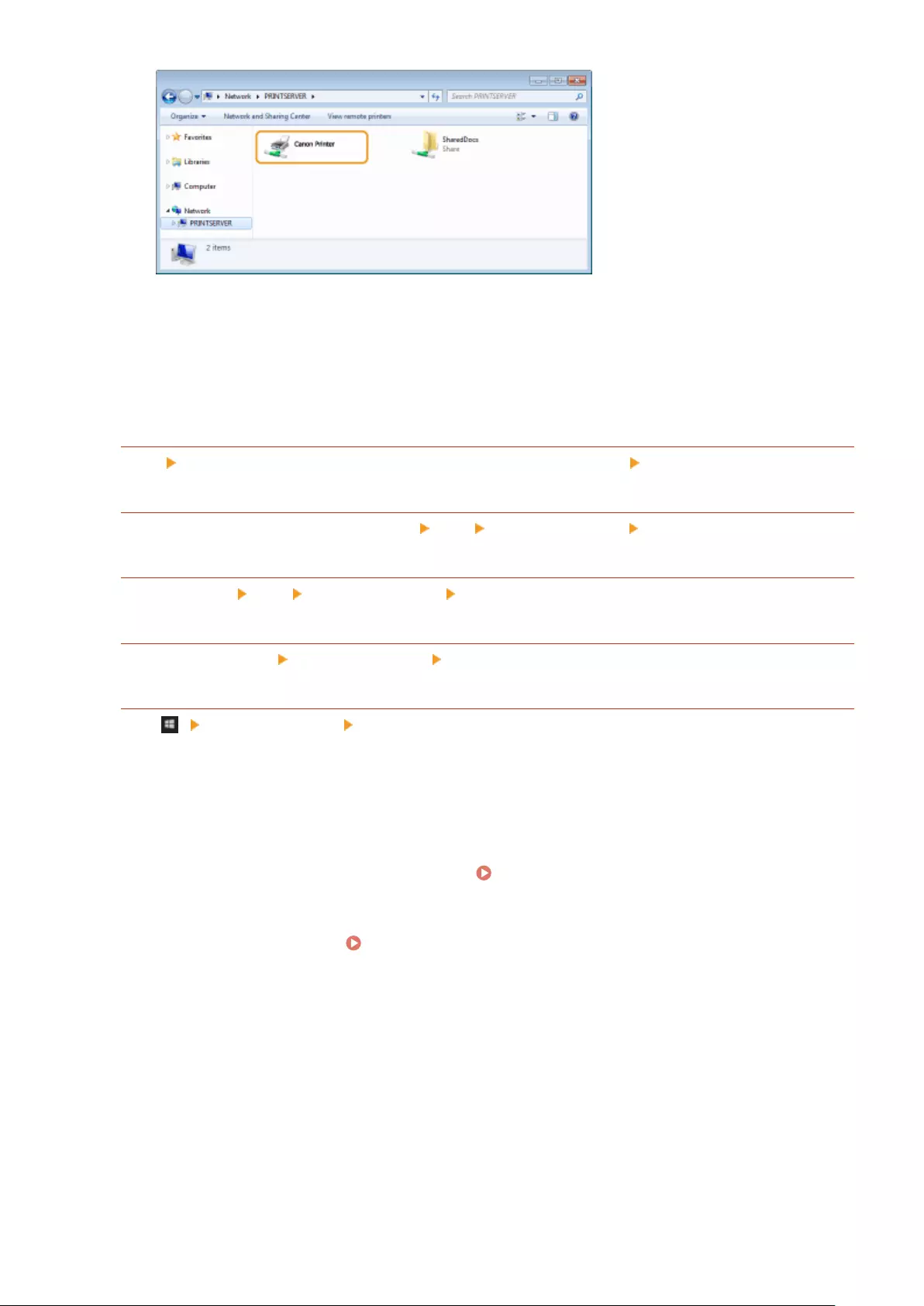
◼Displaying the [Software Programs/Manuals Setup] Screen
If your computer does not display the [Software Programs/Manuals Setup] screen after inserting the provided CD-
ROM/DVD-ROM, follow the procedure below. The CD-ROM/DVD-ROM drive name is indicated as "D:" in this manual.
The CD-ROM/DVD-ROM drive name may differ depending on the computer you are using.
Windows Vista/7/Server 2008
[Start] enter "D:\MInst.exe" in [Search programs and les] or [Start Search] press the [ENTER] key.
Windows 8/Server 2012
Right-click the lower-left corner of the screen [Run] enter "D:\MInst.exe" click [OK]
Windows 8.1/Server 2012 R2
Right-click [Start] [Run] enter "D:\MInst.exe" click [OK]
Windows 10
Click [Ask me anything] enter "D:\MInst.exe" click [D:\MInst.exe] displayed as the search result.
Windows Server 2016
Click [ ] enter "D:\MInst.exe" click [D:\MInst.exe] displayed as the search result.
◼Printing a Test Page in Windows
You can check whether the printer driver is operational by printing a test page in Windows.
1Load A4 size paper in the paper drawer. Loading Paper in the Paper Drawer(P. 143)
2Open the printer folder. Displaying the Printer Folder(P. 649)
3Right-click the printer driver icon for this machine, and click [Printer properties] or
[Properties].
Appendix
651
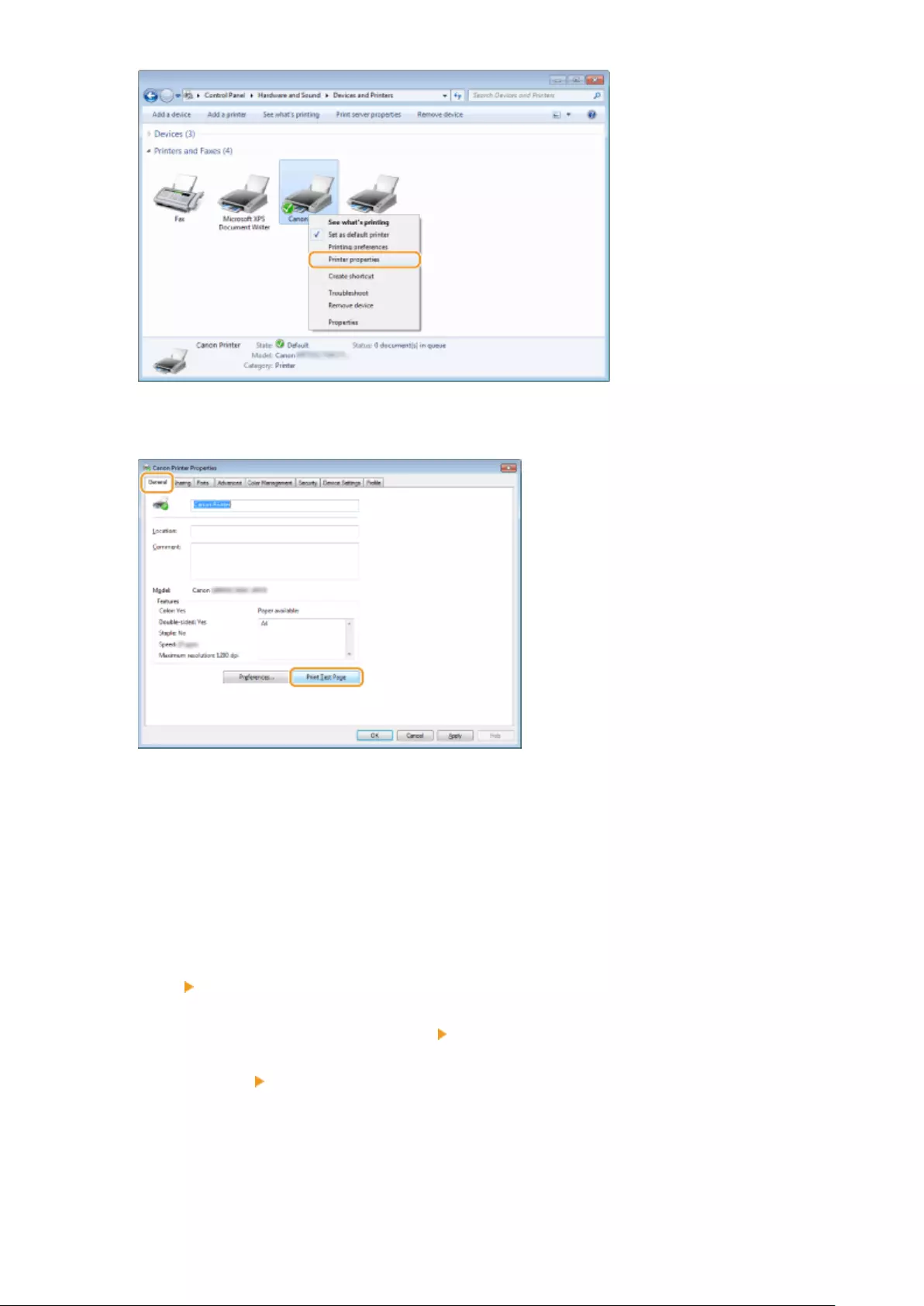
4Click [Print Test Page] in [General] tab.
➠The test page is printed.
◼Checking the Bit Architecture
If you are not sure whether your computer is running 32-bit or 64-bit Windows follow the procedure below.
1Display [Control Panel].
Windows Vista/7/Server 2008
[Start] select [Control Panel].
Windows 8/Server 2012
Right-click the lower-left corner of the screen select [Control Panel].
Windows 8.1/Server 2012 R2
Right-click [Start] select [Control Panel].
Windows 10/Server 2016
Proceed to step 2.
2Display [System].
Appendix
652
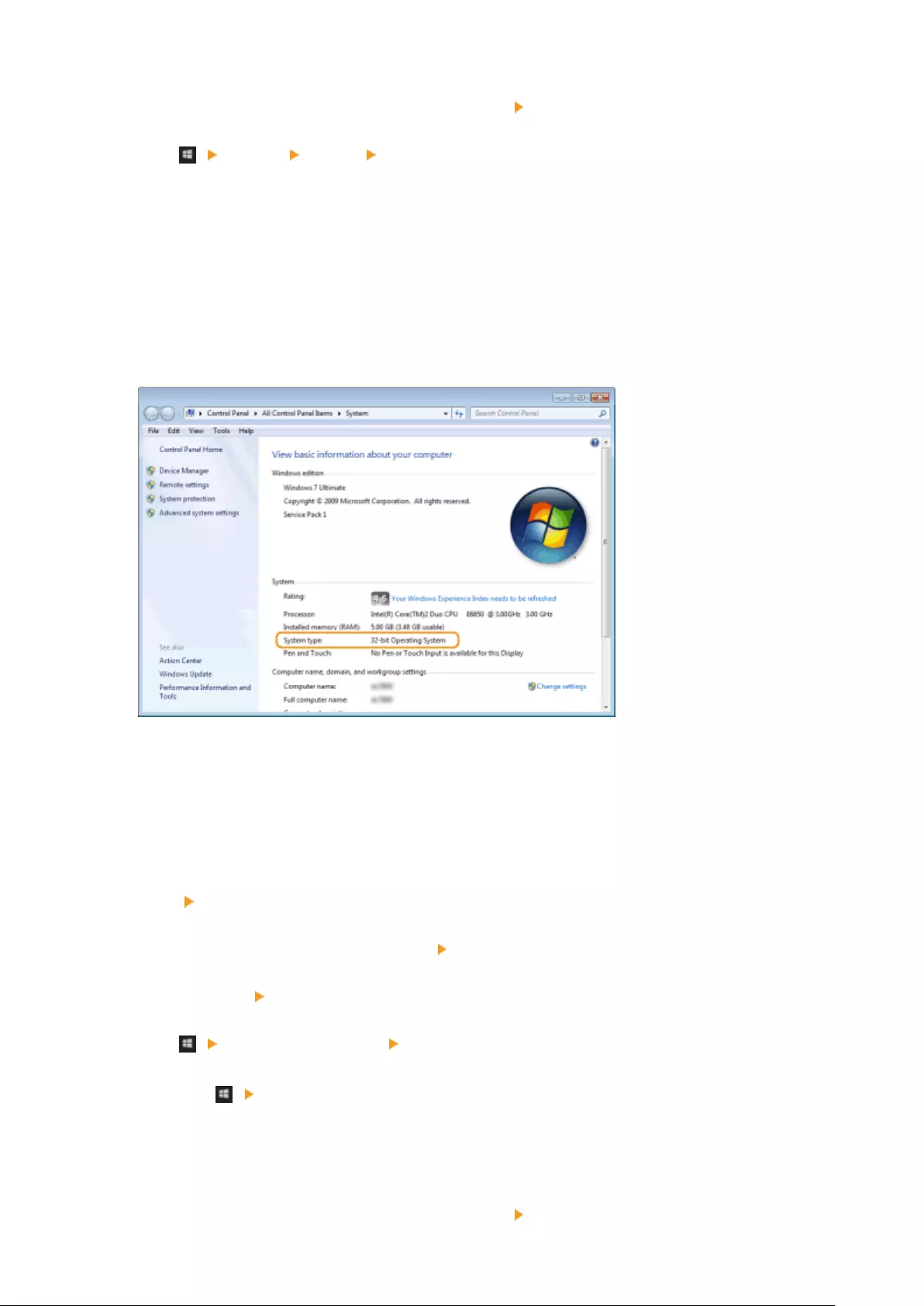
Windows Vista/7/8/Server 2008 R2/Server 2012
Click [System and Maintenance] or [System and Security] [System].
Windows 10/Server 2016
Click [ ] [Settings] [System] select [About].
Windows Server 2008
Double-click [System].
3Check the bit architecture.
For 32-bit versions
[32-bit Operating System] is displayed.
For 64-bit versions
[64-bit Operating System] is displayed.
◼Checking the Computer Name
1Display [Control Panel].
Windows Vista/7/Server 2008
[Start] select [Control Panel].
Windows 8/Server 2012
Right-click the lower-left corner of the screen select [Control Panel].
Windows 8.1/Server 2012 R2
Right-click [Start] select [Control Panel].
Windows 10
Click [ ] select [Windows System] [Control Panel].
Windows Server 2016
Right-click [ ] select [Control Panel].
2Display [System].
Windows Vista/7/8/10/Server 2008 R2/Server 2012/Server 2016
Click [System and Maintenance] or [System and Security] [System].
Appendix
653
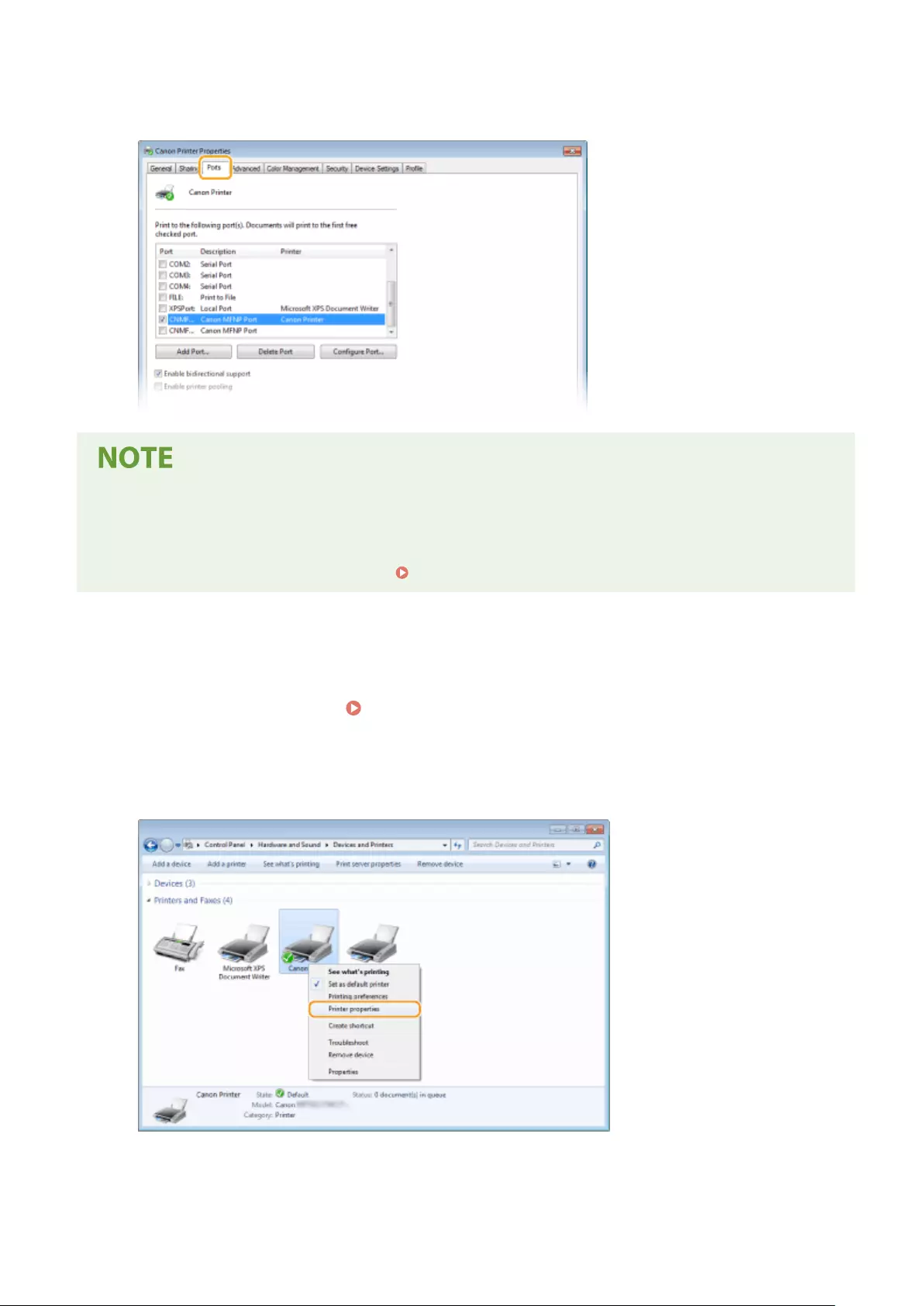
3In the [Ports] tab, check that the port is selected correctly.
If you are using a network connection and have changed the machine's IP address
●If [Description] for the selected port is [Canon MFNP Port], and the machine and the computer are on the
same subnet, then the connection will be maintained. You do not need to add a new port. If it is [Standard
TCP/IP Port], you need to add a new port. Conguring Printer Ports(P. 44)
◼Checking Bidirectional Communication
1Open the printer folder. Displaying the Printer Folder(P. 649)
2Right-click the printer driver icon for this machine, and click [Printer properties] or
[Properties].
3In the [Ports] tab, make sure that the [Enable bidirectional support] check box is
selected.
Appendix
655
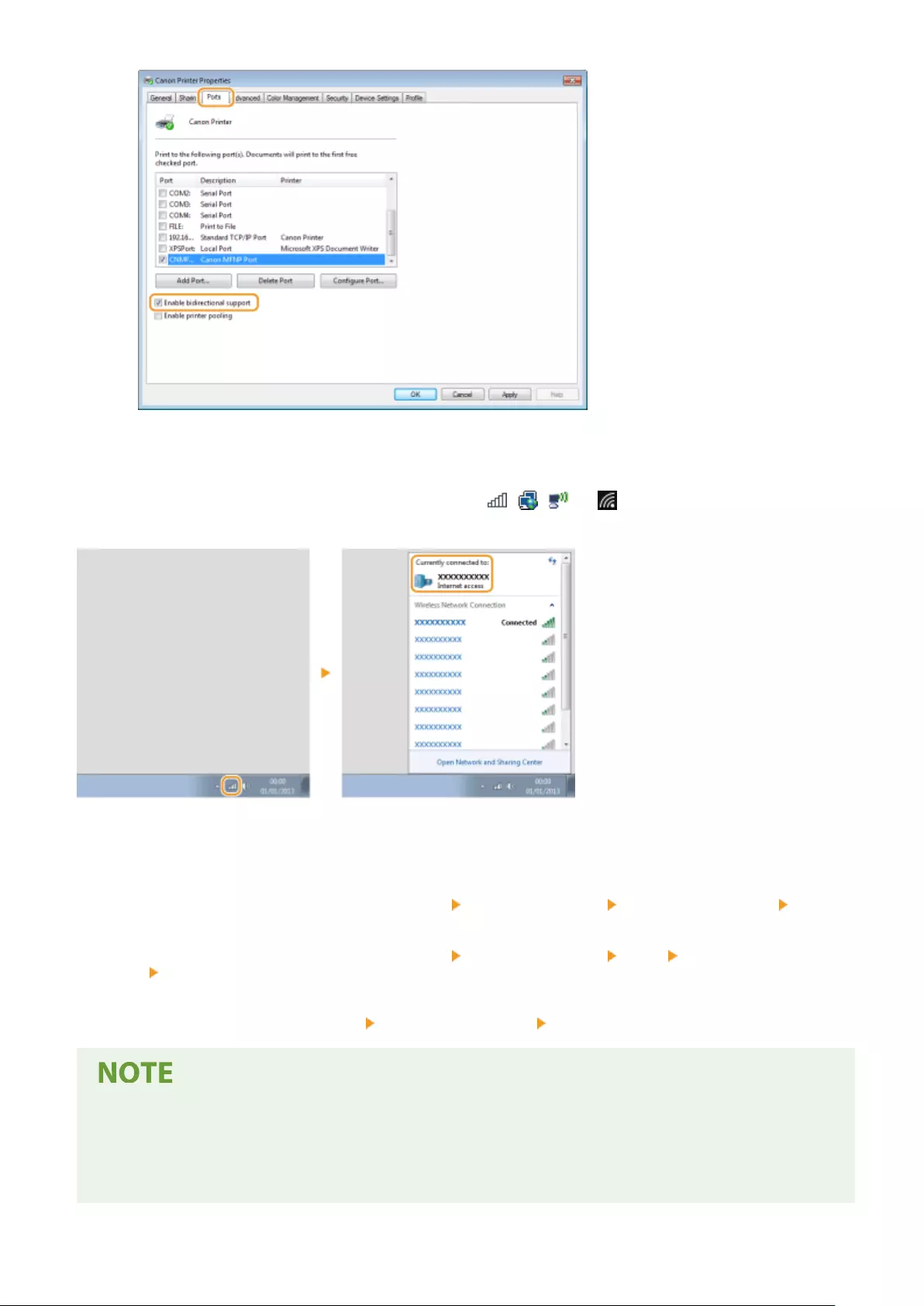
◼Checking the SSID to Which Your Computer is Connected
If your computer is connected to a wireless LAN network, click , , , or in the system tray to display the
SSID of the connected wireless LAN router.
◼When Printing or Sending from the Windows Store App
Windows 8/Server 2012
Display the charms on the right side of the screen Tap or click [Devices] The driver that you use [Print].
Windows 8.1/Server 2012 R2
Display the charms on the right side of the screen Tap or click [Devices] [Print] The driver that you
use [Print].
Windows 10
Tap or click [Print] on the application The driver that you use [Print].
●If you print a document or send a fax using this method, only a limited number of functions are available.
●If the message [The printer requires your attention. Go to the desktop to take care of it.] is displayed, go to
the desktop and perform the required operations. This message appears when the machine is set to display
the user name when printing documents, sending faxes or similar instances.
Appendix
656
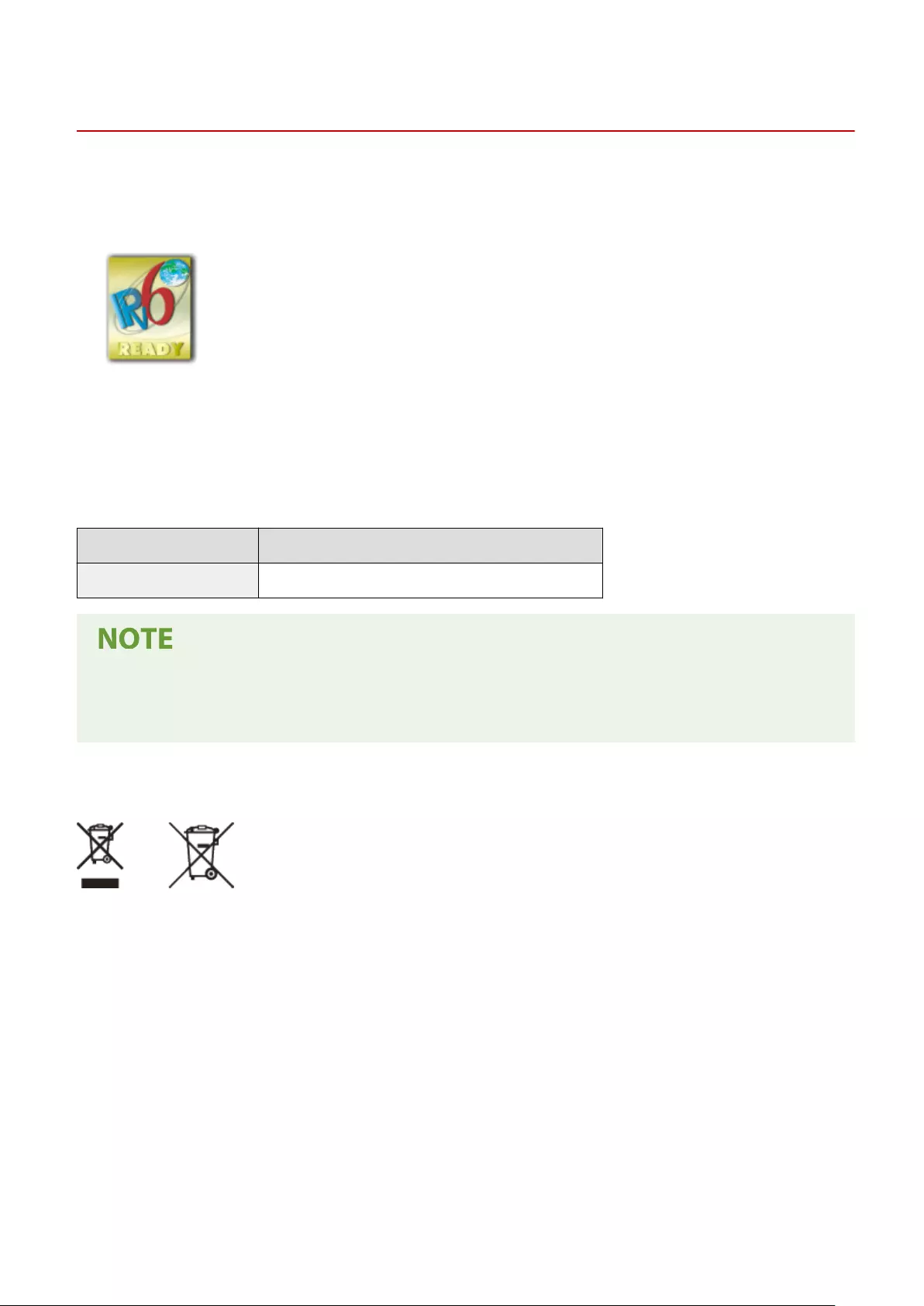
Notice
6FR5-0CJ
◼IPv6 Ready Logo
The protocol stack included in this machine has obtained the IPv6 Ready Logo Phase-2
established by the IPv6 Forum.
◼Product Information required by COMMISSION REGULATION (EU) No 801/2013 amending
Regulation (EC) No 1275/2008
Power consumption of the product in networked standby if wired network ports are connected and all wireless
network ports are activated (if they are available at the same time).
Model Name Power consumption of the product in networked standby
1238iF / 1238i 3.0 W or less
●The above value(s) are the actual values for single machine, chosen arbitrarily, and may therefore vary from
the value of the machine in use. Optional network ports are not connected and/or activated in the
measurement.
◼WEEE and Battery Directives
Only for European Union and EEA (Norway, Iceland and Liechtenstein)
These symbols indicate that this product is not to be disposed of with your household waste, according to the WEEE
Directive (2012/19/EU), the Battery Directive (2006/66/EC) and/or national legislation implementing those Directives.
If a chemical symbol is printed beneath the symbol shown above, in accordance with the Battery Directive, this
indicates that a heavy metal (Hg = Mercury, Cd = Cadmium, Pb = Lead) is present in this battery or accumulator at a
concentration above an applicable threshold specied in the Battery Directive.
This product should be handed over to a designated collection point, e.g., on an authorized one-for-one basis when
you buy a new similar product or to an authorized collection site for recycling waste electrical and electronic
equipment (EEE) and batteries and accumulators. Improper handling of this type of waste could have a possible
impact on the environment and human health due to potentially hazardous substances that are generally associated
with EEE. Your cooperation in the correct disposal of this product will contribute to the effective usage of natural
resources.
For more information about the recycling of this product, please contact your local city oce, waste authority,
approved scheme or your household waste disposal service or visit www.canon-europe.com/weee, or www.canon-
europe.com/battery.
Appendix
657

◼Environmental Information
Reducing your environmental impact while saving money
Power Consumption and Activation Time
The amount of electricity a device consumes depends on the way the device is used. This product is designed and set
in a way to allow you to reduce your electricity costs. After the last print it switches to Ready Mode. In this mode it can
print again immediately if required. If the product is not used for a time, the device switches to its Power Save Mode.
The devices consume less power (Watt) in these modes.
If you wish to set a longer Activation Time or would like to completely deactivate the Power Save Mode, please
consider that this device may then only switch to a lower energy level after a longer period of time or not at all.
Canon does not recommend extending the Activation Times from the optimum ones set as default.
Energy Star ®
The Energy Star® programme is a voluntary scheme to promote the development and purchase of energy ecient
models, which help to minimise environmental impact.
Products which meet the stringent requirements of the Energy Star® programme for both environmental benets and
the amount of energy consumption will carry the Energy Star® logo accordingly.
Paper types
This product can be used to print on both recycled and virgin paper (certied to an environmental stewardship
scheme), which complies with EN12281 or a similar quality standard. In addition it can support printing on media
down to a weight of 64g/m².
Lighter paper means less resources used and a lower environmental footprint for your printing needs.
Duplex printing (Standard duplex printing products only)
Duplex printing capability enables you to print on both sides automatically, and therefore helps to reduce the use of
valuable resources by reducing your paper consumption.
The duplex function has been auto enabled during the set up and driver installation and Canon strongly recommends
that you do not disable this function. You should continue to use the duplex function to reduce the environmental
impact of your work with this product at all times.
◼Disclaimers
●The information in this document is subject to change without notice.
●CANON INC. MAKES NO WARRANTY OF ANY KIND WITH REGARD TO THIS MATERIAL, EITHER EXPRESS OR IMPLIED,
EXCEPT AS PROVIDED HEREIN, INCLUDING WITHOUT LIMITATION, THEREOF, WARRANTIES AS TO MARKETABILITY,
MERCHANTABILITY, FITNESS FOR A PARTICULAR PURPOSE OF USE, OR NON-INFRINGEMENT. CANON INC. SHALL
NOT BE LIABLE FOR ANY DIRECT, INCIDENTAL, OR CONSEQUENTIAL DAMAGES OF ANY NATURE, OR LOSSES OR
EXPENSES RESULTING FROM THE USE OF THIS MATERIAL.
●If you are unable to view the manual in PDF format, download Adobe Acrobat Reader from the Adobe Systems
website (https://get.adobe.com/reader/).
◼Copyright
Reproduction of the contents of this document in whole or in part without prior permission is prohibited.
◼Trademarks
Adobe, Acrobat and Reader are registered trademarks of Adobe Systems Incorporated in the United States and/or
other countries.
Apple, Bonjour, iPad, iPhone, iPod touch, Safari, Mac, macOS and OS X are trademarks of Apple Inc.
Microsoft, Windows, Windows Vista, Windows Server, Internet Explorer, Microsoft Edge and Excel are either registered
trademarks or trademarks of Microsoft Corporation in the United States and/or other countries.
iOS is a trademark or registered trademark of Cisco in the U.S. and other countries and is used under license.
Mopria®, the Mopria® Logo and the Mopria® Alliance logo are registered trademarks and service marks of Mopria
Alliance, Inc. in the United States and other countries. Unauthorized use is strictly prohibited.
Google Cloud Print, Google Chrome and Android are either registered trademarks or trademarks of Google Inc.
UFST: Copyright © 1989 - 1996, 1997, 2003, 2004, 2008, 2014 all rights reserved, by Monotype Imaging Inc.
Appendix
658
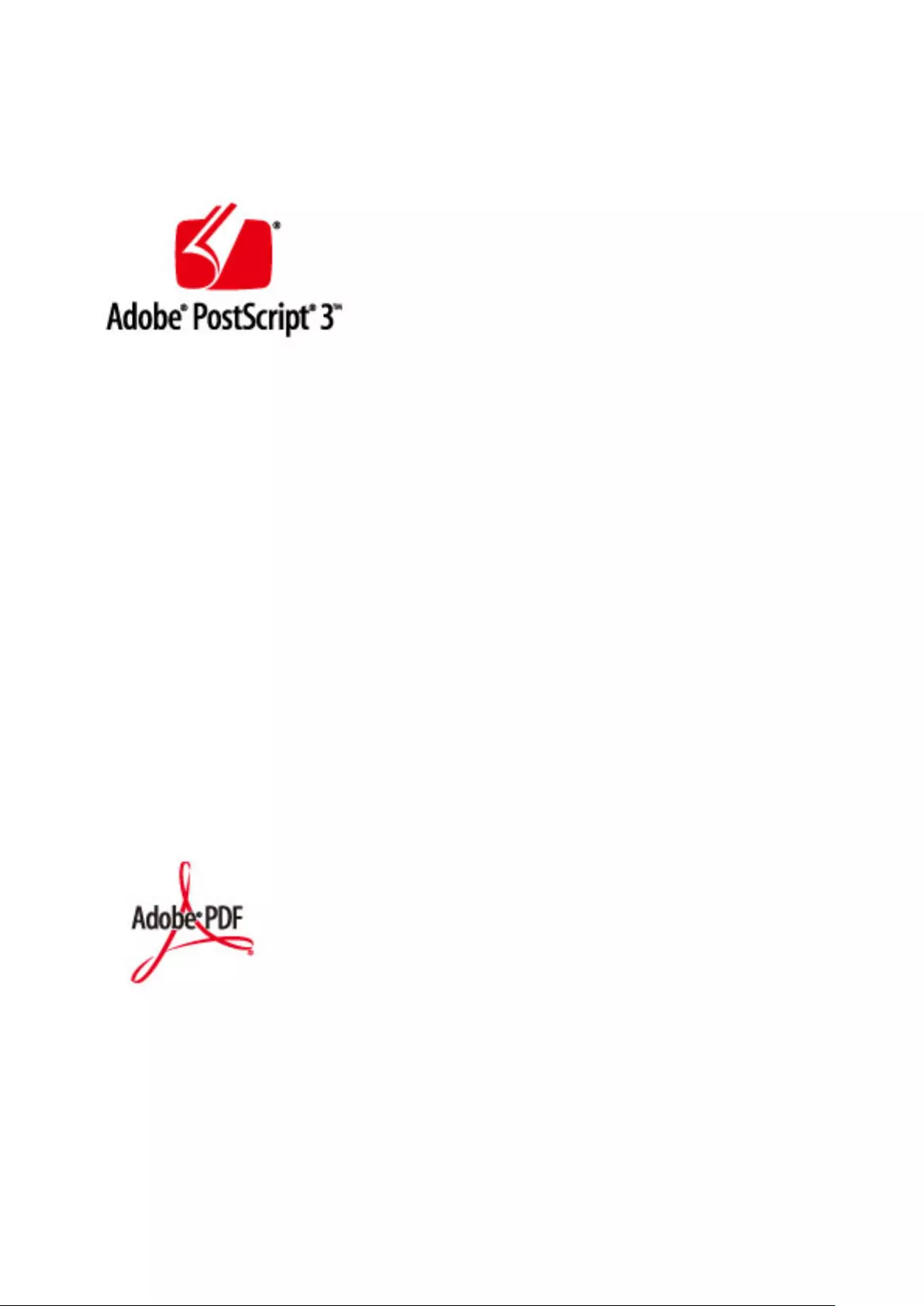
This product contains the Universal Font Scaling Technology or UFST® under license from Monotype Imaging, Inc.
UFST® is a trademark of Monotype Imaging, Inc. registered in the United States Patent and Trademark Oce and may
be registered in certain jurisdictions.
Copyright © 2007 -08 Adobe Systems Incorporated. All rights reserved.
Protected by U.S. Patents 5,737,599; 5,781,785; 5,819,301; 5,929,866; 5,943,063; 6,073,148; 6,515,763; 6,639,593;
6,754,382; 7,046,403; 7,213,269; 7,242,415; Patents pending in the U.S. and other countries.
All instances of the name PostScript in the text are references to the PostScript language as dened by Adobe Systems
Incorporated unless otherwise stated. The name PostScript also is used as a product trademark for Adobe Systems'
implementation of the PostScript language interpreter.
Except as otherwise stated, any reference to a "PostScript printing device," "PostScript display device," or similar item
refers to a printing device, display device or item (respectively) that contains PostScript technology created or licensed
by Adobe Systems Incorporated and not to devices or items that purport to be merely compatible with the PostScript
language.
Adobe, the Adobe logo, PostScript, the PostScript logo, and PostScript 3 are either registered trademarks or
trademarks of Adobe Systems Incorporated in the United States and/or other countries.
Linux is a registered trademark of Linus Torvalds. Microsoft and Windows are either registered trademarks or
trademarks of Microsoft Corporation in the United States and/or other countries.
All other trademarks are the property of their respective owners.
Copyright © 2008 Adobe Systems Incorporated. All rights reserved.
Protected by U.S. Patents 6,185,684; 6,205,549; 7,213,269; 7,272,628; 7,278,168; Patents pending in the U.S. and other
countries.
All instances of the name PostScript in the text are references to the PostScript language as dened by Adobe Systems
Incorporated unless otherwise stated. The name PostScript also is used as a product trademark for Adobe Systems'
implementation of the PostScript language interpreter.
Appendix
659

Except as otherwise stated, any reference to a "PostScript printing device," "PostScript display device," or similar item
refers to a printing device, display device or item (respectively) that contains PostScript technology created or licensed
by Adobe Systems Incorporated and not to devices or items that purport to be merely compatible with the PostScript
language.
Adobe, the Adobe logo, PostScript, the PostScript Logo, and PostScript 3 are either registered trademarks or
trademarks of Adobe Systems Incorporated in the United States and/or other countries.
All other trademarks are the property of their respective owners.
All brand names and product names appearing on this manual are registered trademarks or trademarks of their
respective owners.
V_191204
Appendix
660

This Font Software is licensed under the SIL Open Font License,
Version 1.1.
This license is copied below, and is also available with a FAQ at:
http://scripts.sil.org/OFL
-----------------------------------------------------------
SIL OPEN FONT LICENSE Version 1.1 - 26 February 2007
-----------------------------------------------------------
PREAMBLE
The goals of the Open Font License (OFL) are to stimulate worldwide
development of collaborative font projects, to support the font
creation efforts of academic and linguistic communities, and to
provide a free and open framework in which fonts may be shared and
improved in partnership with others.
The OFL allows the licensed fonts to be used, studied, modied and
redistributed freely as long as they are not sold by themselves. The
fonts, including any derivative works, can be bundled, embedded,
redistributed and/or sold with any software provided that any reserved
names are not used by derivative works. The fonts and derivatives,
however, cannot be released under any other type of license. The
requirement for fonts to remain under this license does not apply to
any document created using the fonts or their derivatives.
DEFINITIONS
"Font Software" refers to the set of les released by the Copyright
Holder(s) under this license and clearly marked as such. This may
include source les, build scripts and documentation.
"Reserved Font Name" refers to any names specied as such after the
copyright statement(s).
"Original Version" refers to the collection of Font Software
components as distributed by the Copyright Holder(s).
"Modied Version" refers to any derivative made by adding to,
deleting, or substituting -- in part or in whole -- any of the
components of the Original Version, by changing formats or by porting
the Font Software to a new environment.
"Author" refers to any designer, engineer, programmer, technical
writer or other person who contributed to the Font Software.
PERMISSION & CONDITIONS
Permission is hereby granted, free of charge, to any person obtaining
a copy of the Font Software, to use, study, copy, merge, embed,
modify, redistribute, and sell modied and unmodied copies of the
Font Software, subject to the following conditions:
SIL OPEN FONT LICENSE
661

1) Neither the Font Software nor any of its individual components, in
Original or Modied Versions, may be sold by itself.
2) Original or Modied Versions of the Font Software may be bundled,
redistributed and/or sold with any software, provided that each copy
contains the above copyright notice and this license. These can be
included either as stand-alone text les, human-readable headers or
in the appropriate machine-readable metadata elds within text or
binary les as long as those elds can be easily viewed by the user.
3) No Modied Version of the Font Software may use the Reserved Font
Name(s) unless explicit written permission is granted by the
corresponding Copyright Holder. This restriction only applies to the
primary font name as presented to the users.
4) The name(s) of the Copyright Holder(s) or the Author(s) of the Font
Software shall not be used to promote, endorse or advertise any
Modied Version, except to acknowledge the contribution(s) of the
Copyright Holder(s) and the Author(s) or with their explicit written
permission.
5) The Font Software, modied or unmodied, in part or in whole,
must be distributed entirely under this license, and must not be
distributed under any other license. The requirement for fonts to
remain under this license does not apply to any document created using
the Font Software.
TERMINATION
This license becomes null and void if any of the above conditions are
not met.
DISCLAIMER
THE FONT SOFTWARE IS PROVIDED "AS IS", WITHOUT WARRANTY OF ANY KIND,
EXPRESS OR IMPLIED, INCLUDING BUT NOT LIMITED TO ANY WARRANTIES OF
MERCHANTABILITY, FITNESS FOR A PARTICULAR PURPOSE AND NONINFRINGEMENT
OF COPYRIGHT, PATENT, TRADEMARK, OR OTHER RIGHT. IN NO EVENT SHALL THE
COPYRIGHT HOLDER BE LIABLE FOR ANY CLAIM, DAMAGES OR OTHER LIABILITY,
INCLUDING ANY GENERAL, SPECIAL, INDIRECT, INCIDENTAL, OR CONSEQUENTIAL
DAMAGES, WHETHER IN AN ACTION OF CONTRACT, TORT OR OTHERWISE, ARISING
FROM, OUT OF THE USE OR INABILITY TO USE THE FONT SOFTWARE OR FROM
OTHER DEALINGS IN THE FONT SOFTWARE.
SIL OPEN FONT LICENSE
662

- 1 -
Third-Party Services
If you use third-party services through the PRODUCT, use of the services are subjected the conditions below.
When you access and/or obtain some third party content (such as text, images, videos, audios, or software)
through the SOFTWARE, except as expressly permitted by the content owner or by applicable law, you may
not (a) scrape, build databases or otherwise create permanent copies of such content, or keep cached copies
longer than permitted by the cache header; (b) copy, translate, modify, create a derivative work of, sell, lease,
lend, convey, distribute, publicly display or sublicense to any third party; (c) misrepresent the source or
ownership; and (d) remove, obscure, or alter any copyright, trademark or other proprietary rights notices, falsify
or delete any author attributions, legal notices or other labels of the origin or source of material.

- 2 -
The Software Subjected to the Other License Conditions
Please refer to Table of Software and respective License terms below, for more detail and corresponding
license conditions.
Table of Software
Names of Software Terms and Conditions of the
License:
See Page
Adobe PostScript 3 3
Adobe PDF Scan Library 10
expat 13
HarfBuzz 14
libjingle 15
Lua 16
LuaSocket 17
MD4 18
Net-SNMP 19
OpenSSL 27

- 3 -
Adobe PostScript 3
Copyright 2007-2008 Adobe Systems Incorporated and its licensors. All rights reserved.
Portions include software under the following terms:
______________________________________________________________________________________
This product contains either BSAFE and/or TIPEM software by RSA Security Inc.
______________________________________________________________________________________
Portions of Pool.c_Copyright 1987 - NeXT, Inc., and portions of Graphics.c_Copyright 1988 NeXT, Inc. as an
unpublished work. All Rights Reserved.
______________________________________________________________________________________
The Apache Software License, Version 1.1
This product includes software developed by the Apache Software Foundation (http://www.apache.org/).
Portions Copyright (c) 1998-2000 The Apache Software Foundation. All rights reserved.
Redistribution and use in source and binary forms, with or without modification, are permitted provided that the
following conditions are met:
1. Redistributions of source code must retain the above copyright notice, this list of conditions and the following
disclaimer.
2. Redistributions in binary form must reproduce the above copyright notice, this list of conditions and the
following disclaimer in the documentation and/or other materials provided with the distribution.
3. The end-user documentation included with the redistribution, if any, must include the following
acknowledgment:
"This product includes software developed by the Apache Software Foundation (http://www.apache.org/)."
Alternately, this acknowledgment may appear in the software itself, if and wherever such third-party
acknowledgments normally appear.
4. The names "Xerces" and "Apache Software Foundation" must not be used to endorse or promote products
derived from this software without prior written permission. For written permission, please contact
apache@apache.org.
5. Products derived from this software may not be called "Apache", nor may "Apache" appear in their name,
without prior written permission of the Apache Software Foundation.
THIS SOFTWARE IS PROVIDED ``AS IS'' AND ANY EXPRESSED OR IMPLIED WARRANTIES, INCLUDING,
BUT NOT LIMITED TO, THE IMPLIED WARRANTIES OF MERCHANTABILITY AND FITNESS FOR A
PARTICULAR PURPOSE ARE DISCLAIMED. IN NO EVENT SHALL THE APACHE SOFTWARE
FOUNDATION OR ITS CONTRIBUTORS BE LIABLE FOR ANY DIRECT, INDIRECT, INCIDENTAL,
SPECIAL, EXEMPLARY, OR CONSEQUENTIAL DAMAGES (INCLUDING, BUT NOT LIMITED TO,

- 4 -
PROCUREMENT OF SUBSTITUTE GOODS OR SERVICES; LOSS OF USE, DATA, OR PROFITS; OR
BUSINESS INTERRUPTION) HOWEVER CAUSED AND ON ANY THEORY OF LIABILITY, WHETHER IN
CONTRACT, STRICT LIABILITY, OR TORT (INCLUDING NEGLIGENCE OR OTHERWISE) ARISING IN ANY
WAY OUT OF THE USE OF THIS SOFTWARE, EVEN IF ADVISED OF THE POSSIBILITY OF SUCH
DAMAGE.
This software consists of voluntary contributions made by many individuals on behalf of the Apache Software
Foundation and was originally based on software copyright (c) 1999, International Business Machines, Inc.,
http://www.ibm.com. For more information on the Apache Software Foundation, please see
<http://www.apache.org/>.
______________________________________________________________________________________
This product includes software developed by the University of California, Berkeley and its contributors.
Portions Copyright (c) 1990 The Regents of the University of California. All rights reserved.
Redistribution and use in source and binary forms, with or without modification, are permitted provided that the
following conditions are met:
1. Redistributions of source code must retain the above copyright notice, this list of conditions and the following
disclaimer.
2. Redistributions in binary form must reproduce the above copyright notice, this list of conditions and the
following disclaimer in the documentation and/or other materials provided with the distribution.
3. All advertising materials mentioning features or use of this software must display the following
acknowledgement:
This product includes software developed by the University of California, Berkeley and its contributors.
4. Neither the name of the University nor the names of its contributors may be used to endorse or promote
products derived from this software without specific prior written permission.
THIS SOFTWARE IS PROVIDED BY THE REGENTS AND CONTRIBUTORS "AS IS" AND ANY EXPRESS
OR IMPLIED WARRANTIES, INCLUDING, BUT NOT LIMITED TO, THE IMPLIED WARRANTIES OF
MERCHANTABILITY AND FITNESS FOR A PARTICULAR PURPOSE ARE DISCLAIMED. IN NO EVENT
SHALL THE REGENTS OR CONTRIBUTORS BE LIABLE FOR ANY DIRECT, INDIRECT, INCIDENTAL,
SPECIAL, EXEMPLARY, OR CONSEQUENTIAL DAMAGES (INCLUDING, BUT NOT LIMITED TO,
PROCUREMENT OF SUBSTITUTE GOODS OR SERVICES; LOSS OF USE, DATA, OR PROFITS; OR
BUSINESS INTERRUPTION) HOWEVER CAUSED AND ON ANY THEORY OF LIABILITY, WHETHER IN
CONTRACT, STRICT LIABILITY, OR TORT (INCLUDING NEGLIGENCE OR OTHERWISE) ARISING IN ANY
WAY OUT OF THE USE OF THIS SOFTWARE, EVEN IF ADVISED OF THE POSSIBILITY OF SUCH
DAMAGE.
______________________________________________________________________________________

- 5 -
Portions Copyright (c) 1985, 1986 The Regents of the University of California. All rights reserved.
This code is derived from software contributed to Berkeley by James A. Woods, derived from original work by
Spencer Thomas and Joseph Orost.
Redistribution and use in source and binary forms are permitted provided that the above copyright notice and
this paragraph are duplicated in all such forms and that any documentation, advertising materials, and other
materials related to such distribution and use acknowledge that the software was developed by the University
of California, Berkeley. The name of the University may not be used to endorse or promote products derived
from this software without specific prior written permission.
THIS SOFTWARE IS PROVIDED ``AS IS'' AND WITHOUT ANY EXPRESS OR IMPLIED WARRANTIES,
INCLUDING, WITHOUT LIMITATION, THE IMPLIED WARRANTIES OF MERCHANTIBILITY AND FITNESS
FOR A PARTICULAR PURPOSE.
Portions Copyright (c) 1993 X Consortium
Permission is hereby granted, free of charge, to any person obtaining a copy of this software and associated
documentation files (the "Software"), to deal in the Software without restriction, including without limitation the
rights to use, copy, modify, merge, publish, distribute, sublicense, and/or sell copies of the Software, and to
permit persons to whom the Software is furnished to do so, subject to the following conditions:
The above copyright notice and this permission notice shall be included in all copies or substantial portions of
the Software.
THE SOFTWARE IS PROVIDED "AS IS", WITHOUT WARRANTY OF ANY KIND, EXPRESS ORIMPLIED,
INCLUDING BUT NOT LIMITED TO THE WARRANTIES OF MERCHANTABILITY,FITNESS FOR A
PARTICULAR PURPOSE AND NONINFRINGEMENT. IN NO EVENT SHALL THEX CONSORTIUM BE
LIABLE FOR ANY CLAIM, DAMAGES OR OTHER LIABILITY, WHETHER INAN ACTION OF CONTRACT,
TORT OR OTHERWISE, ARISING FROM, OUT OF OR INCONNECTION WITH THE SOFTWARE OR THE
USE OR OTHER DEALINGS IN THE SOFTWARE.
Except as contained in this notice, the name of the X Consortium shall not be used in advertising or otherwise
to promote the sale, use or other dealings in this Software without prior written authorization from the X
Consortium.
______________________________________________________________________________________
NOTICE REGARDING SABLOTRON

- 6 -
March 27, 2003
Portions of this product are based on Modifications created from the Original Code known as the "Sablotron
XSLT Processor". The Sablotron XSLT Processor is subject to the Mozilla Public License Version 1.1 (the
"License"). You may obtain a copy of
the License at http://www.mozilla.org/MPL/
Software distributed under the License is distributed on an "AS IS" basis, WITHOUT WARRANTY OF ANY
KIND, either express or implied. See the License for the specific language governing rights and limitations
under the License.
The Original Code is the Sablotron XSLT Processor.
The Initial Developer of the Original Code is Ginger Alliance Ltd. Portions created by Ginger Alliance are
Copyright (C) 2000 Ginger Alliance Ltd. All Rights Reserved.
Pursuant to sections 3.2 and 3.6 of the License, the Modifications created by Adobe Systems Incorporated are
available as Source Code. The Modifications may be downloaded via the Internet from:
http://partners.adobe.com/asn/tech/xml/sablotron/index.jsp
The Original Code may be downloaded via the Internet from:
https://sourceforge.net/projects/sablotron/
______________________________________________________________________________________
This product includes software developed by the University of California, Berkeley and its contributors.
Portions Copyright (c) 1982, 1986, 1987, 1988, 1989, 1990, 1991, 1992, 1993, 1994 The Regents of the
University of California. All rights reserved.
Redistribution and use in source and binary forms, with or without modification, are permitted provided that the
following conditions are met:
1. Redistributions of source code must retain the above copyright notice, this list of conditions and the following
disclaimer.
2. Redistributions in binary form must reproduce the above copyright notice, this list of conditions and the
following disclaimer in the documentation and/or other materials provided with the distribution.
3. All advertising materials mentioning features or use of this software must display the following
acknowledgement: This product includes software developed by the University of California, Berkeley and its
contributors.

- 7 -
4. Neither the name of the University nor the names of its contributors may be used to endorse or promote
products derived from this software without specific prior written permission.
THIS SOFTWARE IS PROVIDED BY THE REGENTS AND CONTRIBUTORS "AS IS" AND ANY EXPRESS
OR IMPLIED WARRANTIES, INCLUDING, BUT NOT LIMITED TO, THE IMPLIED WARRANTIES OF
MERCHANTABILITY AND FITNESS FOR A PARTICULAR PURPOSE ARE DISCLAIMED. IN NO EVENT
SHALL THE REGENTS OR CONTRIBUTORS BE LIABLE FOR ANY DIRECT, INDIRECT, INCIDENTAL,
SPECIAL, EXEMPLARY, OR CONSEQUENTIAL DAMAGES (INCLUDING, BUT NOT LIMITED TO,
PROCUREMENT OF SUBSTITUTE GOODS OR SERVICES; LOSS OF USE, DATA, OR PROFITS; OR
BUSINESS INTERRUPTION) HOWEVER CAUSED AND ON ANY THEORY OF LIABILITY, WHETHER IN
CONTRACT, STRICT LIABILITY, OR TORT (INCLUDING NEGLIGENCE OR OTHERWISE) ARISING IN ANY
WAY OUT OF THE USE OF THIS SOFTWARE, EVEN IF ADVISED OF THE POSSIBILITY OF SUCH
DAMAGE.
______________________________________________________________________________________
Portions Copyright (c) 2001 by Andrei Alexandrescu. This code accompanies the book:
Alexandrescu, Andrei. "Modern C++ Design: Generic Programming and Design Patterns Applied". Copyright
(c) 2001. Addison-Wesley.
Permission to use, copy, modify, distribute and sell this software for any purpose is hereby granted without fee,
provided that the above copyright notice appear in all copies and that both that copyright notice and this
permission notice appear in supporting documentation. The author or Addison-Welsey Longman make no
representations about the suitability of this software for any purpose. It is provided "as is" without express or
implied warranty.
______________________________________________________________________________________
Portions developed by the University of California, Berkeley.
______________________________________________________________________________________
Portions Copyright © 1991-2005 Unicode, Inc. All rights reserved. Distributed under the Terms of Use in
http://www.unicode.org/copyright.html.
Permission is hereby granted, free of charge, to any person obtaining a copy of the Unicode data files and
associated documentation (the "Data Files") or Unicode software and associated documentation (the
"Software") to deal in the Data Files or Software without restriction, including without limitation the rights to use,
copy, modify, merge, publish, distribute, and/or sell copies of the Data Files or Software, and to permit persons
to whom the Data Files or Software are furnished to do so, provided that (a) the above copyright notice(s) and
this permission notice appear in all copies of the Data Files or Software, (b) both the above copyright notice(s)
and this permission notice appear in associated documentation, and (c) there is clear notice in each modified
Data File or in the Software as well as in the documentation associated with the Data File(s) or Software that
the data or software has been modified.

- 8 -
THE DATA FILES AND SOFTWARE ARE PROVIDED "AS IS", WITHOUT WARRANTY OF ANY KIND,
EXPRESS OR IMPLIED, INCLUDING BUT NOT LIMITED TO THE WARRANTIES OF MERCHANTABILITY,
FITNESS FOR A PARTICULAR PURPOSE AND NONINFRINGEMENT OF THIRD PARTY RIGHTS. IN NO
EVENT SHALL THE COPYRIGHT HOLDER OR HOLDERS INCLUDED IN THIS NOTICE BE LIABLE FOR
ANY CLAIM, OR ANY SPECIAL INDIRECT OR CONSEQUENTIAL DAMAGES, OR ANY DAMAGES
WHATSOEVER RESULTING FROM LOSS OF USE, DATA OR PROFITS, WHETHER IN AN ACTION OF
CONTRACT, NEGLIGENCE OR OTHER TORTIOUS ACTION, ARISING OUT OF OR IN CONNECTION
WITH THE USE OR PERFORMANCE OF THE DATA FILES OR SOFTWARE.
Except as contained in this notice, the name of a copyright holder shall not be used in advertising or otherwise
to promote the sale, use or other dealings in these Data Files or Software without prior written authorization of
the copyright holder.
Unicode and the Unicode logo are trademarks of Unicode, Inc., and may be registered in some jurisdictions. All
other trademarks and registered trademarks mentioned herein are the property of their respective owners.
______________________________________________________________________________________
Adobe shall retain and reproduce, and require its Sublicensees to retain and reproduce JIM's following
copyright notice within each copy of the licensed programs in any form, in whole or in part: "© 1981, 1990 JMI
Consultants, Inc. All rights reserved."
______________________________________________________________________________________
This product includes software developed by the University of California, Berkeley and its contributors.
Portions Copyright (c) 1990, 1993 The Regents of the University of California. All rights reserved.
This code is derived from software contributed to Berkeley by Chris Torek.
Redistribution and use in source and binary forms, with or without modification, are permitted provided that the
following conditions are met:
1. Redistributions of source code must retain the above copyright notice, this list of conditions and the following
disclaimer.
2. Redistributions in binary form must reproduce the above copyright notice, this list of conditions and the
following disclaimer in the documentation and/or other materials provided with the distribution.
3. All advertising materials mentioning features or use of this software must display the following
acknowledgement:
This product includes software developed by the University of California, Berkeley and its contributors.
4. Neither the name of the University nor the names of its contributors may be used to endorse or promote
products derived from this software without specific prior written permission.

- 9 -
THIS SOFTWARE IS PROVIDED BY THE REGENTS AND CONTRIBUTORS "AS IS" AND ANY EXPRESS
OR IMPLIED WARRANTIES, INCLUDING, BUT NOT LIMITED TO, THE IMPLIED WARRANTIES OF
MERCHANTABILITY AND FITNESS FOR A PARTICULAR PURPOSE ARE DISCLAIMED. IN NO EVENT
SHALL THE REGENTS OR CONTRIBUTORS BE LIABLE FOR ANY DIRECT, INDIRECT, INCIDENTAL,
SPECIAL, EXEMPLARY, OR CONSEQUENTIAL DAMAGES (INCLUDING, BUT NOT LIMITED TO,
PROCUREMENT OF SUBSTITUTE GOODS OR SERVICES; LOSS OF USE, DATA, OR PROFITS; OR
BUSINESS INTERRUPTION) HOWEVER CAUSED AND ON ANY THEORY OF LIABILITY, WHETHER IN
CONTRACT, STRICT LIABILITY, OR TORT (INCLUDING NEGLIGENCE OR OTHERWISE) ARISING IN ANY
WAY OUT OF THE USE OF THIS SOFTWARE, EVEN IF ADVISED OF THE POSSIBILITY OF SUCH
DAMAGE.
______________________________________________________________________________________
The Loki Library
Portions Copyright (c) 2001 by Andrei Alexandrescu // This code accompanies the book: Alexandrescu,
Andrei. "Modern C++ Design: Generic Programming and Design Patterns Applied". Copyright (c) 2001.
Addison-Wesley.
Permission to use, copy, modify, distribute and sell this software for any purpose is hereby granted without fee,
provided that the above copyright notice appear in all copies and that both that copyright notice and this
permission notice appear in supporting documentation. The author or Addison-Wesley Longman make no
representations about the suitability of this software for any purpose. It is provided "as is" without express or
implied warranty.
______________________________________________________________________________________
Updated Information/Additional Third Party Code Information available at http://www.adobe.com/go/thirdparty .
______________________________________________________________________________________

- 10 -
Adobe PDF Scan Library
Portions use software under the following terms:
______________________________________________________________________________________
This product contains either BSAFE and/or TIPEM software by RSA Security Inc.
______________________________________________________________________________________
This product includes software developed by the Apache Software Foundation (http://www.apache.org/).
Copyright (c) 1998-2000 The Apache Software Foundation. All rights reserved.
Redistribution and use in source and binary forms, with or without modification, are permitted provided that the
following conditions are met:
1. Redistributions of source code must retain the above copyright notice, this list of conditions and the
following disclaimer.
2. Redistributions in binary form must reproduce the above copyright notice, this list of conditions and the
following disclaimer in the documentation and/or other materials provided with the distribution.
3. The end-user documentation included with the redistribution, if any, must include the following
acknowledgment:
"This product includes software developed by the Apache Software Foundation (http://www.apache.org/)."
Alternately, this acknowledgment may appear in the software itself, if and wherever such third-party
acknowledgments normally appear.
4. The names "Xerces" and "Apache Software Foundation" must not be used to endorse or promote products
derived from this software without prior written permission. For written permission, please contact
apache@apache.org.
5. Products derived from this software may not be called "Apache", nor may "Apache" appear in their name,
without prior written permission of the Apache Software Foundation.
THIS SOFTWARE IS PROVIDED ``AS IS'' AND ANY EXPRESSED OR IMPLIED WARRANTIES, INCLUDING,
BUT NOT LIMITED TO, THE IMPLIED WARRANTIES OF MERCHANTABILITY AND FITNESS FOR A
PARTICULAR PURPOSE ARE DISCLAIMED. IN NO EVENT SHALL THE APACHE SOFTWARE
FOUNDATION OR ITS CONTRIBUTORS BE LIABLE FOR ANY DIRECT, INDIRECT, INCIDENTAL,
SPECIAL, EXEMPLARY, OR CONSEQUENTIAL DAMAGES (INCLUDING, BUT NOT LIMITED TO,
PROCUREMENT OF SUBSTITUTE GOODS OR SERVICES; LOSS OF USE, DATA, OR PROFITS; OR
BUSINESS INTERRUPTION) HOWEVER CAUSED AND ON ANY THEORY OF LIABILITY, WHETHER IN
CONTRACT, STRICT LIABILITY, OR TORT (INCLUDING NEGLIGENCE OR OTHERWISE) ARISING IN ANY
WAY OUT OF THE USE OF THIS SOFTWARE, EVEN IF ADVISED OF THE POSSIBILITY OF SUCH
DAMAGE.

- 11 -
This software consists of voluntary contributions made by many individuals on behalf of the Apache Software
Foundation and was originally based on software copyright (c) 1999, International Business Machines, Inc.,
http://www.ibm.com. For more information on the Apache Software Foundation, please see
<http://www.apache.org/>.
______________________________________________________________________________________
March 27, 2003
Portions of this product are based on Modifications created from the Original Code known as the "Sablotron
XSLT Processor". The Sablotron XSLT Processor is subject to the Mozilla Public License Version 1.1 (the
"License"). You may obtain a copy of
the License at http://www.mozilla.org/MPL/
Software distributed under the License is distributed on an "AS IS" basis, WITHOUT WARRANTY OF ANY
KIND, either express or implied. See the License for the specific language governing rights and limitations
under the License.
The Original Code is the Sablotron XSLT Processor.
The Initial Developer of the Original Code is Ginger Alliance Ltd. Portions created by Ginger Alliance are
Copyright (C) 2000 Ginger Alliance Ltd. All Rights Reserved.
Pursuant to sections 3.2 and 3.6 of the License, the Modifications created by Adobe Systems Incorporated are
available as Source Code. The Modifications may be downloaded via the Internet from:
http://partners.adobe.com/asn/tech/xml/sablotron/index.jsp
The Original Code may be downloaded via the Internet from:
https://sourceforge.net/projects/sablotron/
______________________________________________________________________________________
Portions Copyright (c) 1997-1999 Silicon Graphics Computer Systems, Inc.
Permission to use, copy, modify, distribute and sell this software and its documentation for any purpose is
hereby granted without fee, provided that the above copyright notice appear in all copies and that both that
copyright notice and this permission notice appear in supporting documentation. Silicon Graphics makes no
representations about the suitability of this software for any purpose. It is provided "as is" without express or
implied warranty.
______________________________________________________________________________________

- 12 -
The Loki Library
Portions Copyright (c) 2001 by Andrei Alexandrescu . This code accompanies the book: Alexandrescu,
Andrei. "Modern C++ Design: Generic Programming and Design Patterns Applied".
Portions Copyright (c) 2001. Addison-Wesley. Permission to use, copy, modify, distribute and sell this software
for any purpose is hereby granted without fee, provided that the above copyright notice appear in all copies and
that both that copyright notice and this permission notice appear in supporting documentation. The author or
Addison-Wesley Longman make no representations about the suitability of this software for any purpose. It is
provided "as is" without express or implied warranty.
______________________________________________________________________________________
Updated Information/Additional Third Party Code Information available at http://www.adobe.com/go/thirdparty .
______________________________________________________________________________________

- 13 -
expat
Copyright (c) 1998, 1999, 2000 Thai Open Source Software Center Ltd
and Clark Cooper
Copyright (c) 2001, 2002, 2003, 2004, 2005, 2006 Expat maintainers.
Permission is hereby granted, free of charge, to any person obtaining a copy of this software and associated
documentation files (the "Software"), to deal in the Software without restriction, including without limitation the
rights to use, copy, modify, merge, publish, distribute, sublicense, and/or sell copies of the Software, and to
permit persons to whom the Software is furnished to do so, subject to the following conditions:
The above copyright notice and this permission notice shall be included in all copies or substantial portions of
the Software.
THE SOFTWARE IS PROVIDED "AS IS", WITHOUT WARRANTY OF ANY KIND, EXPRESS OR IMPLIED,
INCLUDING BUT NOT LIMITED TO THE WARRANTIES OF MERCHANTABILITY, FITNESS FOR A
PARTICULAR PURPOSE AND NONINFRINGEMENT. IN NO EVENT SHALL THE AUTHORS OR
COPYRIGHT HOLDERS BE LIABLE FOR ANY CLAIM, DAMAGES OR OTHER LIABILITY, WHETHER IN AN
ACTION OF CONTRACT, TORT OR OTHERWISE, ARISING FROM, OUT OF OR IN CONNECTION WITH
THE SOFTWARE OR THE USE OR OTHER DEALINGS IN THE SOFTWARE.

- 14 -
HarfBuzz
Copyright (C) 2006 Behdad Esfahbod
Copyright (C) 1998-2004 David Turner and Werner Lemberg
Copyright (C) 2008 Nokia Corporation and/or its subsidiary(-ies)
Copyright (C) 2004,2007 Red Hat, Inc.
Permission is hereby granted, without written agreement and without license or royalty fees, to use, copy,
modify, and distribute this software and its documentation for any purpose, provided that the above copyright
notice and the following two paragraphs appear in all copies of this software.
IN NO EVENT SHALL THE COPYRIGHT HOLDER BE LIABLE TO ANY PARTY FOR DIRECT, INDIRECT,
SPECIAL, INCIDENTAL, OR CONSEQUENTIAL DAMAGES ARISING OUT OF THE USE OF THIS
SOFTWARE AND ITS DOCUMENTATION, EVEN IF THE COPYRIGHT HOLDER HAS BEEN ADVISED OF
THE POSSIBILITY OF SUCH DAMAGE.
THE COPYRIGHT HOLDER SPECIFICALLY DISCLAIMS ANY WARRANTIES, INCLUDING, BUT NOT
LIMITED TO, THE IMPLIED WARRANTIES OF MERCHANTABILITY AND FITNESS FOR A PARTICULAR
PURPOSE. THE SOFTWARE PROVIDED HEREUNDER IS ON AN "AS IS" BASIS, AND THE COPYRIGHT
HOLDER HAS NO OBLIGATION TO PROVIDE MAINTENANCE, SUPPORT, UPDATES, ENHANCEMENTS,
OR MODIFICATIONS.

- 15 -
libjingle
Copyright 2004--2007, Google Inc.
Redistribution and use in source and binary forms, with or without modification, are permitted provided that the
following conditions are met:
1. Redistributions of source code must retain the above copyright notice, this list of conditions and the following
disclaimer.
2. Redistributions in binary form must reproduce the above copyright notice, this list of conditions and the
following disclaimer in the documentation and/or other materials provided with the distribution.
3. The name of the author may not be used to endorse or promote products derived from this software without
specific prior written permission.
THIS SOFTWARE IS PROVIDED BY THE AUTHOR ``AS IS'' AND ANY EXPRESS OR IMPLIED
WARRANTIES, INCLUDING, BUT NOT LIMITED TO, THE IMPLIED WARRANTIES OF MERCHANTABILITY
AND FITNESS FOR A PARTICULAR PURPOSE ARE DISCLAIMED. IN NO EVENT SHALL THE AUTHOR
BE LIABLE FOR ANY DIRECT, INDIRECT, INCIDENTAL, SPECIAL, EXEMPLARY, OR CONSEQUENTIAL
DAMAGES (INCLUDING, BUT NOT LIMITED TO, PROCUREMENT OF SUBSTITUTE GOODS OR
SERVICES; LOSS OF USE, DATA, OR PROFITS; OR BUSINESS INTERRUPTION) HOWEVER CAUSED
AND ON ANY THEORY OF LIABILITY, WHETHER IN CONTRACT, STRICT LIABILITY, OR TORT
(INCLUDING NEGLIGENCE OR OTHERWISE) ARISING IN ANY WAY OUT OF THE USE OF THIS
SOFTWARE, EVEN IF ADVISED OF THE POSSIBILITY OF SUCH DAMAGE.

- 16 -
Lua
Copyright © 1994–2014 Lua.org, PUC-Rio.
Permission is hereby granted, free of charge, to any person obtaining a copy of this software and associated
documentation files (the "Software"), to deal in the Software without restriction, including without limitation the
rights to use, copy, modify, merge, publish, distribute, sublicense, and/or sell copies of the Software, and to
permit persons to whom the Software is furnished to do so, subject to the following conditions:
The above copyright notice and this permission notice shall be included in all copies or substantial portions of
the Software.
THE SOFTWARE IS PROVIDED "AS IS", WITHOUT WARRANTY OF ANY KIND, EXPRESS OR IMPLIED,
INCLUDING BUT NOT LIMITED TO THE WARRANTIES OF MERCHANTABILITY, FITNESS FOR A
PARTICULAR PURPOSE AND NONINFRINGEMENT. IN NO EVENT SHALL THE AUTHORS OR
COPYRIGHT HOLDERS BE LIABLE FOR ANY CLAIM, DAMAGES OR OTHER LIABILITY, WHETHER IN AN
ACTION OF CONTRACT, TORT OR OTHERWISE, ARISING FROM, OUT OF OR IN CONNECTION WITH
THE SOFTWARE OR THE USE OR OTHER DEALINGS IN THE SOFTWARE.

- 17 -
LuaSocket
LuaSocket 2.0.2 license
Copyright © 2004-2007 Diego Nehab
Permission is hereby granted, free of charge, to any person obtaining a
copy of this software and associated documentation files (the "Software"),
to deal in the Software without restriction, including without limitation
the rights to use, copy, modify, merge, publish, distribute, sublicense,
and/or sell copies of the Software, and to permit persons to whom the
Software is furnished to do so, subject to the following conditions:
The above copyright notice and this permission notice shall be included in
all copies or substantial portions of the Software.
THE SOFTWARE IS PROVIDED "AS IS", WITHOUT WARRANTY OF ANY KIND, EXPRESS OR
IMPLIED, INCLUDING BUT NOT LIMITED TO THE WARRANTIES OF MERCHANTABILITY,
FITNESS FOR A PARTICULAR PURPOSE AND NONINFRINGEMENT. IN NO EVENT SHALL THE
AUTHORS OR COPYRIGHT HOLDERS BE LIABLE FOR ANY CLAIM, DAMAGES OR OTHER
LIABILITY, WHETHER IN AN ACTION OF CONTRACT, TORT OR OTHERWISE, ARISING
FROM, OUT OF OR IN CONNECTION WITH THE SOFTWARE OR THE USE OR OTHER
DEALINGS IN THE SOFTWARE.

- 18 -
MD4
"RSA Data Security, Inc. MD4 Message-Digest Algorithm"

- 19 -
Net-SNMP
Various copyrights apply to this package, listed in various separate
parts below. Please make sure that you read all the parts.
---- Part 1: CMU/UCD copyright notice: (BSD like) -----
Copyright 1989, 1991, 1992 by Carnegie Mellon University
Derivative Work - 1996, 1998-2000
Copyright 1996, 1998-2000 The Regents of the University of California
All Rights Reserved
Permission to use, copy, modify and distribute this software and its
documentation for any purpose and without fee is hereby granted,
provided that the above copyright notice appears in all copies and
that both that copyright notice and this permission notice appear in
supporting documentation, and that the name of CMU and The Regents of
the University of California not be used in advertising or publicity
pertaining to distribution of the software without specific written
permission.
CMU AND THE REGENTS OF THE UNIVERSITY OF CALIFORNIA DISCLAIM ALL
WARRANTIES WITH REGARD TO THIS SOFTWARE, INCLUDING ALL IMPLIED
WARRANTIES OF MERCHANTABILITY AND FITNESS. IN NO EVENT SHALL CMU OR
THE REGENTS OF THE UNIVERSITY OF CALIFORNIA BE LIABLE FOR ANY SPECIAL,
INDIRECT OR CONSEQUENTIAL DAMAGES OR ANY DAMAGES WHATSOEVER RESULTING
FROM THE LOSS OF USE, DATA OR PROFITS, WHETHER IN AN ACTION OF
CONTRACT, NEGLIGENCE OR OTHER TORTIOUS ACTION, ARISING OUT OF OR IN
CONNECTION WITH THE USE OR PERFORMANCE OF THIS SOFTWARE.
---- Part 2: Networks Associates Technology, Inc copyright notice (BSD) -----
Copyright (c) 2001-2003, Networks Associates Technology, Inc
All rights reserved.

- 20 -
Redistribution and use in source and binary forms, with or without
modification, are permitted provided that the following conditions are met:
* Redistributions of source code must retain the above copyright notice,
this list of conditions and the following disclaimer.
* Redistributions in binary form must reproduce the above copyright
notice, this list of conditions and the following disclaimer in the
documentation and/or other materials provided with the distribution.
* Neither the name of the Networks Associates Technology, Inc nor the
names of its contributors may be used to endorse or promote
products derived from this software without specific prior written
permission.
THIS SOFTWARE IS PROVIDED BY THE COPYRIGHT HOLDERS AND CONTRIBUTORS ``AS
IS'' AND ANY EXPRESS OR IMPLIED WARRANTIES, INCLUDING, BUT NOT LIMITED TO,
THE IMPLIED WARRANTIES OF MERCHANTABILITY AND FITNESS FOR A PARTICULAR
PURPOSE ARE DISCLAIMED. IN NO EVENT SHALL THE COPYRIGHT HOLDERS OR
CONTRIBUTORS BE LIABLE FOR ANY DIRECT, INDIRECT, INCIDENTAL, SPECIAL,
EXEMPLARY, OR CONSEQUENTIAL DAMAGES (INCLUDING, BUT NOT LIMITED TO,
PROCUREMENT OF SUBSTITUTE GOODS OR SERVICES; LOSS OF USE, DATA, OR PROFITS;
OR BUSINESS INTERRUPTION) HOWEVER CAUSED AND ON ANY THEORY OF LIABILITY,
WHETHER IN CONTRACT, STRICT LIABILITY, OR TORT (INCLUDING NEGLIGENCE OR
OTHERWISE) ARISING IN ANY WAY OUT OF THE USE OF THIS SOFTWARE, EVEN IF
ADVISED OF THE POSSIBILITY OF SUCH DAMAGE.
---- Part 3: Cambridge Broadband Ltd. copyright notice (BSD) -----
Portions of this code are copyright (c) 2001-2003, Cambridge Broadband Ltd.
All rights reserved.
Redistribution and use in source and binary forms, with or without
modification, are permitted provided that the following conditions are met:
* Redistributions of source code must retain the above copyright notice,
this list of conditions and the following disclaimer.

- 21 -
* Redistributions in binary form must reproduce the above copyright
notice, this list of conditions and the following disclaimer in the
documentation and/or other materials provided with the distribution.
* The name of Cambridge Broadband Ltd. may not be used to endorse or
promote products derived from this software without specific prior
written permission.
THIS SOFTWARE IS PROVIDED BY THE COPYRIGHT HOLDER ``AS IS'' AND ANY
EXPRESS OR IMPLIED WARRANTIES, INCLUDING, BUT NOT LIMITED TO, THE
IMPLIED WARRANTIES OF MERCHANTABILITY AND FITNESS FOR A PARTICULAR
PURPOSE ARE DISCLAIMED. IN NO EVENT SHALL THE COPYRIGHT HOLDER BE
LIABLE FOR ANY DIRECT, INDIRECT, INCIDENTAL, SPECIAL, EXEMPLARY, OR
CONSEQUENTIAL DAMAGES (INCLUDING, BUT NOT LIMITED TO, PROCUREMENT OF
SUBSTITUTE GOODS OR SERVICES; LOSS OF USE, DATA, OR PROFITS; OR
BUSINESS INTERRUPTION) HOWEVER CAUSED AND ON ANY THEORY OF LIABILITY,
WHETHER IN CONTRACT, STRICT LIABILITY, OR TORT (INCLUDING NEGLIGENCE
OR OTHERWISE) ARISING IN ANY WAY OUT OF THE USE OF THIS SOFTWARE, EVEN
IF ADVISED OF THE POSSIBILITY OF SUCH DAMAGE.
---- Part 4: Sun Microsystems, Inc. copyright notice (BSD) -----
Copyright © 2003 Sun Microsystems, Inc., 4150 Network Circle, Santa Clara,
California 95054, U.S.A. All rights reserved.
Use is subject to license terms below.
This distribution may include materials developed by third parties.
Sun, Sun Microsystems, the Sun logo and Solaris are trademarks or registered
trademarks of Sun Microsystems, Inc. in the U.S. and other countries.
Redistribution and use in source and binary forms, with or without
modification, are permitted provided that the following conditions are met:
* Redistributions of source code must retain the above copyright notice,

- 22 -
this list of conditions and the following disclaimer.
* Redistributions in binary form must reproduce the above copyright
notice, this list of conditions and the following disclaimer in the
documentation and/or other materials provided with the distribution.
* Neither the name of the Sun Microsystems, Inc. nor the
names of its contributors may be used to endorse or promote
products derived from this software without specific prior written
permission.
THIS SOFTWARE IS PROVIDED BY THE COPYRIGHT HOLDERS AND CONTRIBUTORS ``AS
IS'' AND ANY EXPRESS OR IMPLIED WARRANTIES, INCLUDING, BUT NOT LIMITED TO,
THE IMPLIED WARRANTIES OF MERCHANTABILITY AND FITNESS FOR A PARTICULAR
PURPOSE ARE DISCLAIMED. IN NO EVENT SHALL THE COPYRIGHT HOLDERS OR
CONTRIBUTORS BE LIABLE FOR ANY DIRECT, INDIRECT, INCIDENTAL, SPECIAL,
EXEMPLARY, OR CONSEQUENTIAL DAMAGES (INCLUDING, BUT NOT LIMITED TO,
PROCUREMENT OF SUBSTITUTE GOODS OR SERVICES; LOSS OF USE, DATA, OR PROFITS;
OR BUSINESS INTERRUPTION) HOWEVER CAUSED AND ON ANY THEORY OF LIABILITY,
WHETHER IN CONTRACT, STRICT LIABILITY, OR TORT (INCLUDING NEGLIGENCE OR
OTHERWISE) ARISING IN ANY WAY OUT OF THE USE OF THIS SOFTWARE, EVEN IF
ADVISED OF THE POSSIBILITY OF SUCH DAMAGE.
---- Part 5: Sparta, Inc copyright notice (BSD) -----
Copyright (c) 2003-2012, Sparta, Inc
All rights reserved.
Redistribution and use in source and binary forms, with or without
modification, are permitted provided that the following conditions are met:
* Redistributions of source code must retain the above copyright notice,
this list of conditions and the following disclaimer.
* Redistributions in binary form must reproduce the above copyright
notice, this list of conditions and the following disclaimer in the
documentation and/or other materials provided with the distribution.

- 23 -
* Neither the name of Sparta, Inc nor the names of its contributors may
be used to endorse or promote products derived from this software
without specific prior written permission.
THIS SOFTWARE IS PROVIDED BY THE COPYRIGHT HOLDERS AND CONTRIBUTORS ``AS
IS'' AND ANY EXPRESS OR IMPLIED WARRANTIES, INCLUDING, BUT NOT LIMITED TO,
THE IMPLIED WARRANTIES OF MERCHANTABILITY AND FITNESS FOR A PARTICULAR
PURPOSE ARE DISCLAIMED. IN NO EVENT SHALL THE COPYRIGHT HOLDERS OR
CONTRIBUTORS BE LIABLE FOR ANY DIRECT, INDIRECT, INCIDENTAL, SPECIAL,
EXEMPLARY, OR CONSEQUENTIAL DAMAGES (INCLUDING, BUT NOT LIMITED TO,
PROCUREMENT OF SUBSTITUTE GOODS OR SERVICES; LOSS OF USE, DATA, OR PROFITS;
OR BUSINESS INTERRUPTION) HOWEVER CAUSED AND ON ANY THEORY OF LIABILITY,
WHETHER IN CONTRACT, STRICT LIABILITY, OR TORT (INCLUDING NEGLIGENCE OR
OTHERWISE) ARISING IN ANY WAY OUT OF THE USE OF THIS SOFTWARE, EVEN IF
ADVISED OF THE POSSIBILITY OF SUCH DAMAGE.
---- Part 6: Cisco/BUPTNIC copyright notice (BSD) -----
Copyright (c) 2004, Cisco, Inc and Information Network
Center of Beijing University of Posts and Telecommunications.
All rights reserved.
Redistribution and use in source and binary forms, with or without
modification, are permitted provided that the following conditions are met:
* Redistributions of source code must retain the above copyright notice,
this list of conditions and the following disclaimer.
* Redistributions in binary form must reproduce the above copyright
notice, this list of conditions and the following disclaimer in the
documentation and/or other materials provided with the distribution.
* Neither the name of Cisco, Inc, Beijing University of Posts and
Telecommunications, nor the names of their contributors may
be used to endorse or promote products derived from this software
without specific prior written permission.
THIS SOFTWARE IS PROVIDED BY THE COPYRIGHT HOLDERS AND CONTRIBUTORS ``AS

- 24 -
IS'' AND ANY EXPRESS OR IMPLIED WARRANTIES, INCLUDING, BUT NOT LIMITED TO,
THE IMPLIED WARRANTIES OF MERCHANTABILITY AND FITNESS FOR A PARTICULAR
PURPOSE ARE DISCLAIMED. IN NO EVENT SHALL THE COPYRIGHT HOLDERS OR
CONTRIBUTORS BE LIABLE FOR ANY DIRECT, INDIRECT, INCIDENTAL, SPECIAL,
EXEMPLARY, OR CONSEQUENTIAL DAMAGES (INCLUDING, BUT NOT LIMITED TO,
PROCUREMENT OF SUBSTITUTE GOODS OR SERVICES; LOSS OF USE, DATA, OR PROFITS;
OR BUSINESS INTERRUPTION) HOWEVER CAUSED AND ON ANY THEORY OF LIABILITY,
WHETHER IN CONTRACT, STRICT LIABILITY, OR TORT (INCLUDING NEGLIGENCE OR
OTHERWISE) ARISING IN ANY WAY OUT OF THE USE OF THIS SOFTWARE, EVEN IF
ADVISED OF THE POSSIBILITY OF SUCH DAMAGE.
---- Part 7: Fabasoft R&D Software GmbH & Co KG copyright notice (BSD) -----
Copyright (c) Fabasoft R&D Software GmbH & Co KG, 2003
oss@fabasoft.com
Author: Bernhard Penz <bernhard.penz@fabasoft.com>
Redistribution and use in source and binary forms, with or without
modification, are permitted provided that the following conditions are met:
* Redistributions of source code must retain the above copyright notice,
this list of conditions and the following disclaimer.
* Redistributions in binary form must reproduce the above copyright
notice, this list of conditions and the following disclaimer in the
documentation and/or other materials provided with the distribution.
* The name of Fabasoft R&D Software GmbH & Co KG or any of its subsidiaries,
brand or product names may not be used to endorse or promote products
derived from this software without specific prior written permission.
THIS SOFTWARE IS PROVIDED BY THE COPYRIGHT HOLDER ``AS IS'' AND ANY
EXPRESS OR IMPLIED WARRANTIES, INCLUDING, BUT NOT LIMITED TO, THE
IMPLIED WARRANTIES OF MERCHANTABILITY AND FITNESS FOR A PARTICULAR
PURPOSE ARE DISCLAIMED. IN NO EVENT SHALL THE COPYRIGHT HOLDER BE
LIABLE FOR ANY DIRECT, INDIRECT, INCIDENTAL, SPECIAL, EXEMPLARY, OR
CONSEQUENTIAL DAMAGES (INCLUDING, BUT NOT LIMITED TO, PROCUREMENT OF
SUBSTITUTE GOODS OR SERVICES; LOSS OF USE, DATA, OR PROFITS; OR

- 25 -
BUSINESS INTERRUPTION) HOWEVER CAUSED AND ON ANY THEORY OF LIABILITY,
WHETHER IN CONTRACT, STRICT LIABILITY, OR TORT (INCLUDING NEGLIGENCE
OR OTHERWISE) ARISING IN ANY WAY OUT OF THE USE OF THIS SOFTWARE, EVEN
IF ADVISED OF THE POSSIBILITY OF SUCH DAMAGE.
---- Part 8: Apple Inc. copyright notice (BSD) -----
Copyright (c) 2007 Apple Inc. All rights reserved.
Redistribution and use in source and binary forms, with or without
modification, are permitted provided that the following conditions
are met:
1. Redistributions of source code must retain the above copyright
notice, this list of conditions and the following disclaimer.
2. Redistributions in binary form must reproduce the above
copyright notice, this list of conditions and the following
disclaimer in the documentation and/or other materials provided
with the distribution.
3. Neither the name of Apple Inc. ("Apple") nor the names of its
contributors may be used to endorse or promote products derived
from this software without specific prior written permission.
THIS SOFTWARE IS PROVIDED BY APPLE AND ITS CONTRIBUTORS "AS IS" AND
ANY EXPRESS OR IMPLIED WARRANTIES, INCLUDING, BUT NOT LIMITED TO,
THE IMPLIED WARRANTIES OF MERCHANTABILITY AND FITNESS FOR A
PARTICULAR PURPOSE ARE DISCLAIMED. IN NO EVENT SHALL APPLE OR ITS
CONTRIBUTORS BE LIABLE FOR ANY DIRECT, INDIRECT, INCIDENTAL,
SPECIAL, EXEMPLARY, OR CONSEQUENTIAL DAMAGES (INCLUDING, BUT NOT
LIMITED TO, PROCUREMENT OF SUBSTITUTE GOODS OR SERVICES; LOSS OF
USE, DATA, OR PROFITS; OR BUSINESS INTERRUPTION) HOWEVER CAUSED AND
ON ANY THEORY OF LIABILITY, WHETHER IN CONTRACT, STRICT LIABILITY,
OR TORT (INCLUDING NEGLIGENCE OR OTHERWISE) ARISING IN ANY WAY OUT
OF THE USE OF THIS SOFTWARE, EVEN IF ADVISED OF THE POSSIBILITY OF
SUCH DAMAGE.
---- Part 9: ScienceLogic, LLC copyright notice (BSD) -----

- 26 -
Copyright (c) 2009, ScienceLogic, LLC
All rights reserved.
Redistribution and use in source and binary forms, with or without
modification, are permitted provided that the following conditions are
met:
* Redistributions of source code must retain the above copyright notice,
this list of conditions and the following disclaimer.
* Redistributions in binary form must reproduce the above copyright
notice, this list of conditions and the following disclaimer in the
documentation and/or other materials provided with the distribution.
* Neither the name of ScienceLogic, LLC nor the names of its
contributors may be used to endorse or promote products derived
from this software without specific prior written permission.
THIS SOFTWARE IS PROVIDED BY THE COPYRIGHT HOLDERS AND CONTRIBUTORS
``AS IS'' AND ANY EXPRESS OR IMPLIED WARRANTIES, INCLUDING, BUT NOT
LIMITED TO, THE IMPLIED WARRANTIES OF MERCHANTABILITY AND FITNESS FOR
A PARTICULAR PURPOSE ARE DISCLAIMED. IN NO EVENT SHALL THE COPYRIGHT
HOLDERS OR CONTRIBUTORS BE LIABLE FOR ANY DIRECT, INDIRECT,
INCIDENTAL, SPECIAL, EXEMPLARY, OR CONSEQUENTIAL DAMAGES (INCLUDING,
BUT NOT LIMITED TO, PROCUREMENT OF SUBSTITUTE GOODS OR SERVICES; LOSS
OF USE, DATA, OR PROFITS; OR BUSINESS INTERRUPTION) HOWEVER CAUSED AND
ON ANY THEORY OF LIABILITY, WHETHER IN CONTRACT, STRICT LIABILITY, OR
TORT (INCLUDING NEGLIGENCE OR OTHERWISE) ARISING IN ANY WAY OUT OF THE
USE OF THIS SOFTWARE, EVEN IF ADVISED OF THE POSSIBILITY OF SUCH
DAMAGE.

- 27 -
OpenSSL
OpenSSL License
---------------
/* ====================================================================
* Copyright (c) 1998-2011 The OpenSSL Project. All rights reserved.
*
* Redistribution and use in source and binary forms, with or without
* modification, are permitted provided that the following conditions
* are met:
*
* 1. Redistributions of source code must retain the above copyright
* notice, this list of conditions and the following disclaimer.
*
* 2. Redistributions in binary form must reproduce the above copyright
* notice, this list of conditions and the following disclaimer in
* the documentation and/or other materials provided with the
* distribution.
*
* 3. All advertising materials mentioning features or use of this
* software must display the following acknowledgment:
* "This product includes software developed by the OpenSSL Project
* for use in the OpenSSL Toolkit. (http://www.openssl.org/)"
*
* 4. The names "OpenSSL Toolkit" and "OpenSSL Project" must not be used to
* endorse or promote products derived from this software without
* prior written permission. For written permission, please contact
* openssl-core@openssl.org.
*
* 5. Products derived from this software may not be called "OpenSSL"
* nor may "OpenSSL" appear in their names without prior written
* permission of the OpenSSL Project.
*
* 6. Redistributions of any form whatsoever must retain the following
* acknowledgment:
* "This product includes software developed by the OpenSSL Project
* for use in the OpenSSL Toolkit (http://www.openssl.org/)"

- 28 -
*
* THIS SOFTWARE IS PROVIDED BY THE OpenSSL PROJECT ``AS IS'' AND ANY
* EXPRESSED OR IMPLIED WARRANTIES, INCLUDING, BUT NOT LIMITED TO, THE
* IMPLIED WARRANTIES OF MERCHANTABILITY AND FITNESS FOR A PARTICULAR
* PURPOSE ARE DISCLAIMED. IN NO EVENT SHALL THE OpenSSL PROJECT OR
* ITS CONTRIBUTORS BE LIABLE FOR ANY DIRECT, INDIRECT, INCIDENTAL,
* SPECIAL, EXEMPLARY, OR CONSEQUENTIAL DAMAGES (INCLUDING, BUT
* NOT LIMITED TO, PROCUREMENT OF SUBSTITUTE GOODS OR SERVICES;
* LOSS OF USE, DATA, OR PROFITS; OR BUSINESS INTERRUPTION)
* HOWEVER CAUSED AND ON ANY THEORY OF LIABILITY, WHETHER IN CONTRACT,
* STRICT LIABILITY, OR TORT (INCLUDING NEGLIGENCE OR OTHERWISE)
* ARISING IN ANY WAY OUT OF THE USE OF THIS SOFTWARE, EVEN IF ADVISED
* OF THE POSSIBILITY OF SUCH DAMAGE.
* ====================================================================
*
* This product includes cryptographic software written by Eric Young
* (eay@cryptsoft.com). This product includes software written by Tim
* Hudson (tjh@cryptsoft.com).
*
*/
Original SSLeay License
-----------------------
/* Copyright (C) 1995-1998 Eric Young (eay@cryptsoft.com)
* All rights reserved.
*
* This package is an SSL implementation written
* by Eric Young (eay@cryptsoft.com).
* The implementation was written so as to conform with Netscapes SSL.
*
* This library is free for commercial and non-commercial use as long as
* the following conditions are aheared to. The following conditions
* apply to all code found in this distribution, be it the RC4, RSA,
* lhash, DES, etc., code; not just the SSL code. The SSL documentation
* included with this distribution is covered by the same copyright terms
* except that the holder is Tim Hudson (tjh@cryptsoft.com).
*

- 29 -
* Copyright remains Eric Young's, and as such any Copyright notices in
* the code are not to be removed.
* If this package is used in a product, Eric Young should be given attribution
* as the author of the parts of the library used.
* This can be in the form of a textual message at program startup or
* in documentation (online or textual) provided with the package.
*
* Redistribution and use in source and binary forms, with or without
* modification, are permitted provided that the following conditions
* are met:
* 1. Redistributions of source code must retain the copyright
* notice, this list of conditions and the following disclaimer.
* 2. Redistributions in binary form must reproduce the above copyright
* notice, this list of conditions and the following disclaimer in the
* documentation and/or other materials provided with the distribution.
* 3. All advertising materials mentioning features or use of this software
* must display the following acknowledgement:
* "This product includes cryptographic software written by
* Eric Young (eay@cryptsoft.com)"
* The word 'cryptographic' can be left out if the rouines from the library
* being used are not cryptographic related :-).
* 4. If you include any Windows specific code (or a derivative thereof) from
* the apps directory (application code) you must include an acknowledgement:
* "This product includes software written by Tim Hudson (tjh@cryptsoft.com)"
*
* THIS SOFTWARE IS PROVIDED BY ERIC YOUNG ``AS IS'' AND
* ANY EXPRESS OR IMPLIED WARRANTIES, INCLUDING, BUT NOT LIMITED TO, THE
* IMPLIED WARRANTIES OF MERCHANTABILITY AND FITNESS FOR A PARTICULAR PURPOSE
* ARE DISCLAIMED. IN NO EVENT SHALL THE AUTHOR OR CONTRIBUTORS BE LIABLE
* FOR ANY DIRECT, INDIRECT, INCIDENTAL, SPECIAL, EXEMPLARY, OR CONSEQUENTIAL
* DAMAGES (INCLUDING, BUT NOT LIMITED TO, PROCUREMENT OF SUBSTITUTE GOODS
* OR SERVICES; LOSS OF USE, DATA, OR PROFITS; OR BUSINESS INTERRUPTION)
* HOWEVER CAUSED AND ON ANY THEORY OF LIABILITY, WHETHER IN CONTRACT, STRICT
* LIABILITY, OR TORT (INCLUDING NEGLIGENCE OR OTHERWISE) ARISING IN ANY WAY
* OUT OF THE USE OF THIS SOFTWARE, EVEN IF ADVISED OF THE POSSIBILITY OF
* SUCH DAMAGE.
*
* The licence and distribution terms for any publically available version or

- 30 -
* derivative of this code cannot be changed. i.e. this code cannot simply be
* copied and put under another distribution licence
* [including the GNU Public Licence.]
*/










